We started to build this garden fifteen years ago , the first sod was turned in January 2006 and although a garden is never standing still …or shouldn’t …. this essay , book , call it what you like , is to docuement the developement of the garden and grew out of a presentation I was asked to give to the Clonmel Horticultural Society about the creation of the garden in January 2016 .
We bought this house with almost eight acres of land at Old Spa Road in 2000 having decided to return to Clonmel , my home town after 40 years working both in Ireland and abroad with the last 15 years spent working in the Balkans mainly Bosnia , Croatia , Macedonia, Serbia and Kosovo with two years in the Seychelles thrown in at the end …. contrast huh ?!
Contrast is the term which also could be applied to the land we bought . We didn’t need or indeed want such a large garden but the house came with an acre of ground but also with a laneway leading down past the house to an optional section containing nearly seven acres and for privacy sake in the future we took the extra land .
I call it land but it was next to useless at that stage and certainly could not be used for building purposes as it was totally water logged and accessible on foot only in summer ….. local people on the road knew it and always referred to it as “ the swamp “ which gives you a good idea of what it was composed of … yes .. wet watery ground full of rushes and reeds and certainly not a place fit for gardening but and here’s the thing , it also had a wild beauty and an almost wilderness isolation about it that attracted us .
The house and lower field as it looked in 2004
We had been working and living in the Balkans for six years when we decided to buy a base in Ireland , Snezana had been born in the Former Yugoslavia in Macedonia but while brought up and educated from an early age in Copenhagen yet had no strong desire to live there again so Ireland was an easy mutual choice . As I was born and brought up in Clonmel , Co. Tipperary I knew the town and countryside well and knew the areas I would like to live in and we had narrowed down the search for a house to three locations and as Snezana was the stranger to the area I decided she should choose which of the three prospective houses we should buy and with that in mind we walked the areas and left this house and land to the last so that in April 2000 we battled our way down the swamp ground through waist high grass, crossed the stream to the pine woods and suddenly she said “you can’t see another house or building from here lets go for this one” … contracts were signed and we had a garden to build !
Marking out the immediate back garden with a spade in January 2006
How the view from the window looks nine years later in 2015
We moved in and took possession of the house in November 2000 during a week’s leave from the EU in Bosnia but it would be a further eight years before I returned to live in Ireland permanently in the summer of 2008 . For the next few years while working in Bosnia the future creation of the garden back on Old Spa Road was just a dream to work on , plans were made , designs worked out and discarded until finally after many visits home and walking the land on a regular basis in all seasons we got a feel both for what was needed and what we could achieve .
The first planting was of 500 rooted slips of golden willow ordered from Terry Hanna of Clonmel Garden Centre and delivered when we arrived home on leave from Bosnia for Christmas in December 2001 and just recently I came across the original invoice !

First purchase of plants for the new garden , November 2001
Sometimes in Bosnia the locals were not friendly as in this photo when driving through Trebinje , a Bosnian Serb town just after the NATO bombings of Serbia in 1999 !
In this period before getting down to an outline design I used the opportunity on every visit home which was about twice a year usually at Christmas and Easter , to plant some trees and shrubs at the edges of the land which would be growing away in our absence but which would not interfere with any future overall design and in the meantime we felt good that something was growing which would leave us in a few years time with the outline of a skeleton design .
Finally in January 2006 six years after the original purchase I was home full time from Sarajevo and back at work at the day job with the Revenue Commissioners in Rosslare Harbour and ready to garden every hour of my spare time ! Snezana by now was working with the EU in Kiev , a good job and being younger than me was still keen on working abroad while I had had my fill of foreign postings and had been increasingly looking forward to coming home and setting down roots again in Ireland and especially in my home town . My dream job as Head of Office with the EU Fiscal Mission in the Brcko District , North Eastern Bosnia , had ended after seven years in December 2004 and I had spent my final year in Bosnia working in Sarajevo , it had become just a job and not the all consuming project Brcko had been and I was in effect going through the motions for that last year so I was ready for a new challenge in December 2005 , packed up and drove back to Ireland with some serious gardening on my mind !
At this stage a lot of this has been about me and the word ” I ” has been used a lot so a bit of background about our different gardening skills might be relevant at the start of our process of making a garden . Snezana had not been a gardener but had a feeling for nature and an instinctive flair for wild gardening so was content to leave the design and planting to me and while I had been a gardener for a long time having worked a large acre of garden for almost twenty years in Rosslare Strand but it was an established garden I took over there in 1978 , not one I created from scratch so in a sense with this project we were both going into uncharted territory .
We both had a strong love of wilderness even of isolation and a dislike of formality in gardens and were also agreed that the garden was for our enjoyment primarily not to please anyone else or to conform to any norms , a place to go to relax …. so in the first few years I took the lead in plant selection and the initial layout of the garden .
Man know thyself was reputedly carved over the entrance to the fifth century BC Greek Temple at Delphi and one thing I knew about myself was that while I knew about gardening and could plant and get things to grow but in DIY terms I was the original Mr. Bean and couldn’t put a nail in a wall…. so was in urgent need of a Man Friday who could do all the construction and hard landscaping !
I asked about among the Garden Centres in the Clonmel area as to who would be a good garden landscaper / contractor and was given a list of names and started ringing them . Three nicely dressed chaps with varying sizes of clip boards turned up at the door at intervals for interview and I outlined to each of them what I had in mind for the front and back immediate areas surrounding the house … they could all do part of the work , the heavy shifting of earth , the building of retaining walls , excavation for garden ponds etc. and they all in turn took copious notes , had reliable people they would hire in to do various aspects of the work , hire machinery and promised to get back to me with prices .
The last guy on the list I had been told was the best but difficult to get hold of but eventually he turned up for a chat dressed a bit better than your average tramp with hair in a pony tail down to his ass ….. no shiny suit or fancy clip board in evidence and that was my first introduction to Peter Cullen , owner of Longfield Landscapes , garden landscaper extraordinaire , who would become my partner in crime to this day !
We hit it off immediately on a personal level as my normal gardening attire was even scruffier than his but more importantly Peter never saw problems only solutions , had a machine for everything and was a complete one man show in that he could operate a digger , do brick work, plaster , lay paths , wire for electricity , you name it Peter could do it .. the perfect man for what turned out to be almost continous garden projects over the next ten years .
Over the years we never had a falling out over a plan or a disagreement about prices and neither of us had an ego problem over whose idea was best , I would come up with the initial idea and design which Peter would look at and comment on and if Peter could improve it or supply an alternative idea we would go with which was the best plan .
I had been planning the design on paper for about five years while working abroad for the immediate front and back garden and in those years had planted a few specimen trees and shrubs inside the front wall where the previous owner had planted a few cherry trees which over the years had grown lanky and I immediately cut these to the ground and repeated the process every year until eventually the trees took on a multi stemmed shape . We were lucky in that native ash trees, ash and holly had colonised the boundary hedges and ash is one of my favourite trees and that gave us natural cover along both sides of the front garden .
My idea for the immediate garden front and back was for a cosmetic pretty look , designed to show off and present the house and with this in mind I set out a pool along with grass on both sides of the entrance drive way , silver birch jaquemontii inside the front wall with a weeping willow near the house .
This design was accomplished quite quickly , and in a matter of weeks the pool was dug out , lined and filled with water and planted up with water lilies and a small lawn on either side of the driveway basically completed the work which over the next few years would see more trees added and a small bog garden established beside the pool and lots …. lots of pots added !
The work on the garden design begins March 2006
Front Garden thirteen years later in June 2019
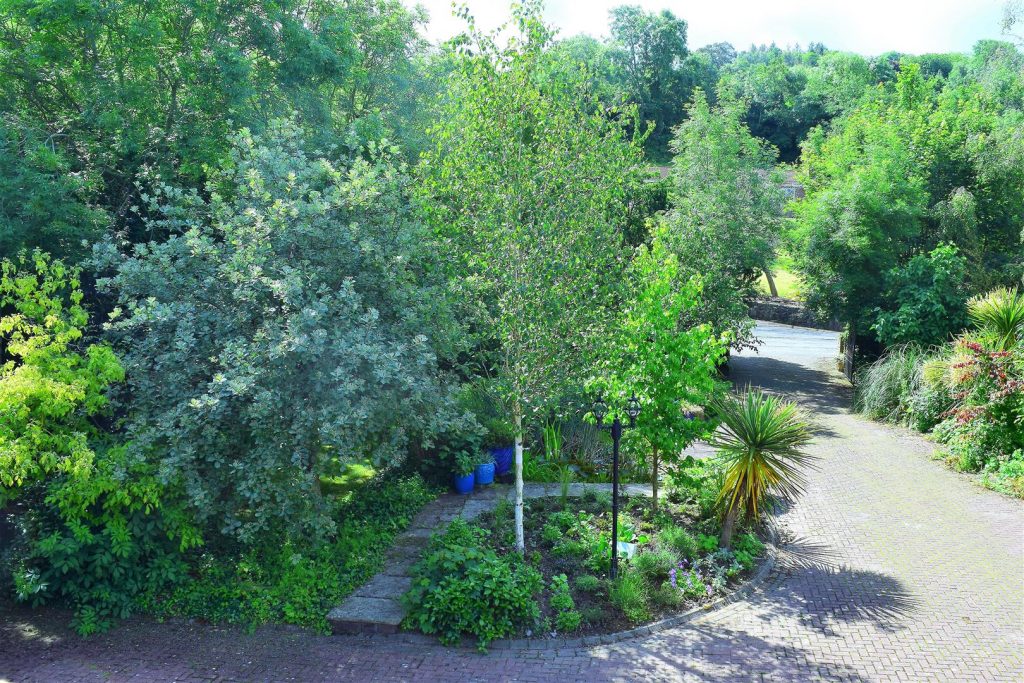
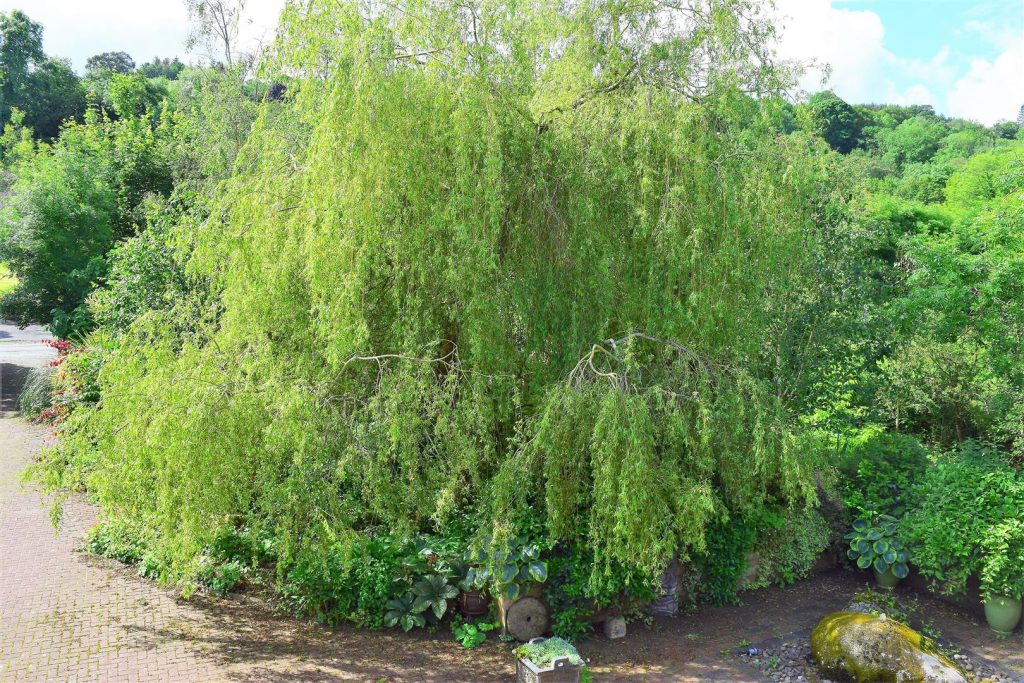
The pool eight years later in July 2014
Front Garden May 2021
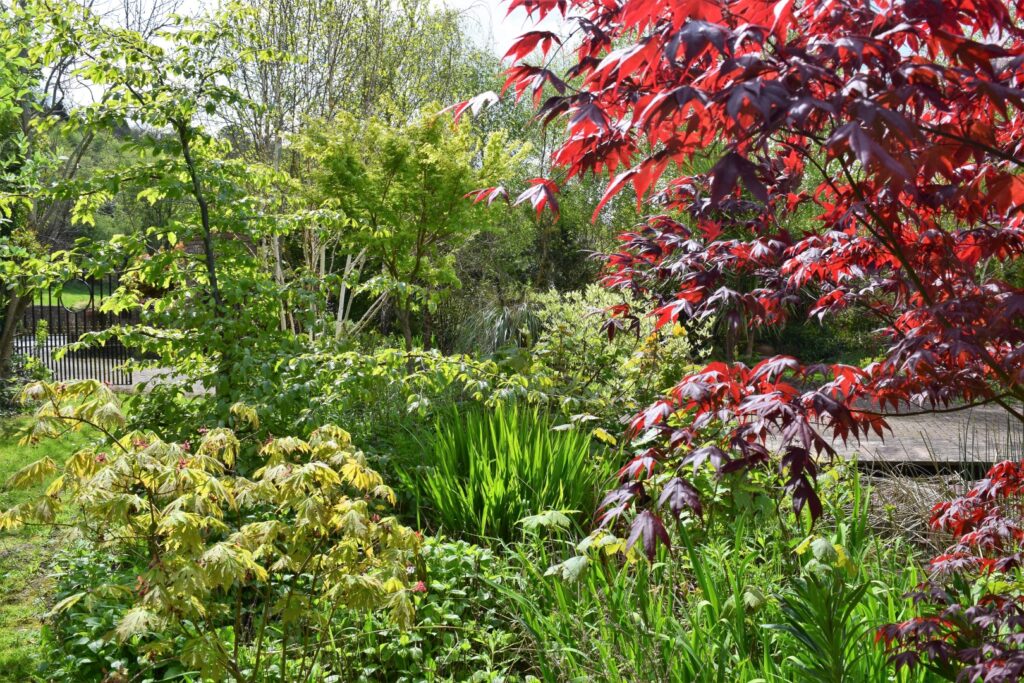 The next step was the immediate back garden which presented a problem in that the land sloped away into the lower field and my design was for a step down from the house into a private area for relaxation , eating etc, plus a nice assortment of trees , to do this I needed a more level platform to work with so the first step was to level the playing field so to speak by building a wall of concrete blocks over two metres in height on three sides and then back filling with earth to create a level area for grass …. in the end it took over 700 tons of top soil to get the level platform needed for the design and finally I was left with a plain rectangular shape into which with the help of a hose pipe for shaping the planting beds and regular trips to the top floor window to check how the finished shape was coming along and eventually I got the shape I wanted which was for a broad grass path to snake its way through the space available .
The next step was the immediate back garden which presented a problem in that the land sloped away into the lower field and my design was for a step down from the house into a private area for relaxation , eating etc, plus a nice assortment of trees , to do this I needed a more level platform to work with so the first step was to level the playing field so to speak by building a wall of concrete blocks over two metres in height on three sides and then back filling with earth to create a level area for grass …. in the end it took over 700 tons of top soil to get the level platform needed for the design and finally I was left with a plain rectangular shape into which with the help of a hose pipe for shaping the planting beds and regular trips to the top floor window to check how the finished shape was coming along and eventually I got the shape I wanted which was for a broad grass path to snake its way through the space available .
I took out almost 70 % of the space available for a wrap around shrubbery and outside the finished shape I sprayed off the ground with round up and eventually planted the wide variety of trees and shrubs that make up the back garden today .
The Back Garden 28th March 2006
Gradually the back garden began to take shape , a large rock that was found on the land became a feature and we added a seating area in the next three months and of course sitting there for our first cups of tea I saw that we could incorporate a small pool as a feature to take the eye .
The intention with the back garden was to provide a peaceful oasis , a private space out of view from the house yet close enough to be used for eating out , an area that was sheltered in all weathers yet a space that would also take advantage of being in full sun throughout the day . The trees in particular were chosen for their exceptional shape and leaf colour and in fact each plant used in this area had to earn it’s keep be they big grey leafed hostas , bamboo or specimen cornus ‘s .
To shield the garden from the house and give privacy to the seating area within the garden I planted a line of trees , a tilia ( lime tree ) , sorbus moonbeam var. lutescens ( mountain ash ), a purple leaf false cherry tree and my favourite tree of all , two groves of five and three pure white jacquemontii silver birch underplanted with heathers , WT Radcliffe , which mound nicely so have good structure even when not in flower . I placed a black painted pergola at the entrance for a focal point and have trained two wisteria over the wooden structure … wisteria is one of the great climbers , slowish to flower and can take up to five years after planting but its golden foliage provides interest for eight months of the year . I have added a purple leafed rhus cotinus which romps along the side of the structure .
The plan was to create an athmosphere of calm where there was only one entry point and no exit and as you enter the garden from right to left there is golden cornus , a pyrus lacrifolia with its grey leaf ( fake pear tree ), miniature variegated bamboo, purple corylus trees ( hazel nut ) , melianthus major with a glaucus green leaf , lime green eucalyptus trees, cornus elegantissimus with silver / white variegation – all cornus’s used in this planting have scarlet bark in winter , with perennials such as euphorbia , hostas sibildiana Francis Williams and purple fennel, used in the foreground .
On the left side as you enter I have planted box balls around the silver birch and underplanted with one variety of daffodil , Winston Churchill , which has a beautiful pink head while closer to the grass edge I have planted silver leaf plants , a row of catmint nepeta and english lavender with some perennial geraniums sprawling on to the grass .
This is how the back garden looked four months after initial planting in July 2006
And after the small seating area and pool was added in December 2007
The small garden pool four years later in June 2012
We spent the first eight months of 2006 setting up the front and back garden and Peter had assembled a great team with the two Michaels and his 17 year old son , Mark , who worked full time here on a five day week basis , it was an exciting time seeing the garden take shape and being here myself beside the team meant that we could change and tweak things as we went along as until now I had been away when work which we had commissioned was completed . The front garden was relatively simple at this stage as only the pond was added but the immediate back garden had to be laid out in detail with a rockery constructed to the side . I sat in on numerous cups of teas with the team during those months and a lot of design work got dissected and aired around and many a good idea was born during these sessions which with Peter being so flexible we were able to toss around and include in the final design .
One lesson I have always held to is that everyone has an opinion and if it is better than yours then don’t have an ego which is not prepared to accept such input .
All the while I was home in that initial period the Seychelles Government had been in touch with me to assist with a plan to revamp their customs service and I had been out there twice for field trips throughout 2006 but even though the Seychelles is like the original Garden of Eden , 7 degrees south of the equator with flora and exotic plant life to die for , each return to Old Spa Road was exciting to see what the team had achieved in my absence .
I know that when I returned to Ireland after fifteen years in the Balkans only six months earlier I felt it was for good but sometimes in life an offer comes along that as Don Corleone in the Godfather says is “ an offer you can’t refuse “ so when I was offered a two year contract as Head of the Seychelles Customs Service in the Indian Ocean I saddled up for one last hurrah and reluctantly left a garden project which was just beginning to get exciting and the garden basically stood still until in October 2008 I finally retired and became a full time gardener.
The contrast between the photo of the back garden as it was in 2006 and as it became in six years is illustrated by the next photo taken from the same position upstairs .
As it was two years after the initial planting in March 2008
As it was seven years later in July 2015
This photo of the immediate back garden from July 2011 illustrates the concept of relying on bark and leaf for colour … no flowers here !
Well no flowers except of the metal variety !
Visiting Blooms in the Phoenix Park in 2012 I fell in love with the giant galvanised flower heads designed by Joe Harte of Wild Metal , New Ross and three of them have found a place in a corner of the back garden and Joe has used a photo of the installation on his web page . I also fell for the iconic wooden Adirondack chairs first patented in upstate New York in 1900 … painting them Majorelle blue was Snezana’s idea !
Here you can see an example of great colour achieved without flowers , golden wisteria climbs along the pergola with the purple leafed rhus cotinus , the smoke bush in support .
Having raised and levelled the area which was to become the immediate back garden , I put in the initial planting of trees , mainly two groups of silver birch jacquemontii , I saw that the entrance to the garden needed a pergola to set it off ….. originally before we laid the gravel there was going to be three steps up into the garden but in laying the gravel and the paving slabs we lost the height and were left with just one step which had no impact . The back garden needed the right proportions so we set it back a generous width from the steps down from the house and this also allowed space later for the gravel garden .
Band of Brothers take a break April 2006 !
During my two years absence from Ireland I had regular trips home on leave from the Seychelles where I could monitor progress of the new plantings at the front and rear of the house , do some maintenance and add some new plants and it was all knitting together nicely . The Seychelles is one of the most beautiful places on earth , a tropical paradise where everything blooms every six weeks , where there is no real change in seasons , my house was in the middle of a rain forest and looked out over breadfruit trees to the Indian Ocean and my garden had a forest of banana trees , coconut trees , papaya … you name it , it had it and bird of paradise plants that grew forty feet , constant blue skies and white beaches … quite a contrast in say February when I arrived back at Old Spa Road !
A different type of plant grew in the Seychelles !
Nice to have one of these wondering through the lower wood … a bit big for hand luggage though !
Back in Ireland full time in summer 2008
But I loved being back in Ireland from previously the Balkans and now the Indian Ocean and I formed a fierce attachment to our quite horrible climate and the garden here became an escape … if you can call leaving both the Indian Ocean and the Mediterranean an escape !!
I left all this in the Seychelles in 2008
For this in Ireland in 2009 !
During this two year gap in the the construction of the garden it gave breathing space over where to go next with the design if any of the lower swampy fields and I had plenty of time especially at the weekends while lying on a sun lounger sipping cold drinks beside the pool at the Banyan Tree Hotel on Mahe Island in the Seychelles ( such is the life of an international customs consultant !) to make plans for a possible expansion into the 7 acres of swamp and wilderness . Initially we had thought that it was too big a job , virtually an impossible task and were satisfied to strim a two metre path each summer down to the stream and leave it at that with the occaisional strimming in really fine weather of a path across to the woods and just leave the area as a natural wild life reserve . Snezana was now in Kiev with the EU and also had lots of time to hone her gardening knowledge and bring her own ideas on the future garden design to the table .
With hindsight and as they say “ if I knew then what I know now “ there is no way we would have attempted what proved to be a massive project to reclaim almost seven acres of swamp from the wilderness and most people would have shouted RUN !! It was madness but looking back now eight later it was worth it and it gave me a second career which I walked straight into after 40 years as a civil servant !
I had never gardened or designed on such a large scale previously and I suppose a naievity on both our parts also helped mask the enormity of the task in that there never was an overall plan just a series of projects tackling various areas with one leading incrementally to the next so we never woke up in the morning thinking there was a mountain out there to be climbed … rather every few months there was another exciting project beckoning to get started on .
As with all garden projects there were mistakes as I got to know the ground, the condition of the soil, the prevailing wind factor etc. but by and large with the front and immediate back garden , because the soil was bought in and was good , I managed to keep plant fatalities to a minimum and with its southern aspect most of what I planted originally thrived and the back garden evolved into what it is today with a secluded seating area , a restful palette of trees and shrubs with nine months interest while in the darkest bleak winter months of January to March the beautiful bark of the white silver birch light up the area until the spring bulbs and leaf comes back .
The right hand side of the front garden in July 2014 , a large pampas grass , the summer flowering variety , Rickardii , originally from New Zealand , there is a mulberry tree at the back peeping through and some silver birch underplanted with the big grey leafed hosta sieboldiana variety Francis Williams .
The entrance to the immediate back garden , wisteria and the smoke bush rhus cotinus frame the view to the majorelle blue painted adirondack seats .
The lower fields was a different matter with really wet ground so the first decision which we had been putting off for the six years since we first bought the site , was to decide whether we just left it to nature as it always had been or at least make access easier in all weather to the entire seven acre area so we opted as a first step until we were finally ready to commit to a possible major garden crusade !
We designed and laid out hard core gravelled paths through the middle of the top field to the stream and from there on around the entire perimeter of the seven acres but not entering the confifer wood as the boundaries were still not clear here … so Peter parked his digger at the house throughout October / November/ December 2008 … we used the opportunity to bulk up low lying areas with the excavated soil , created small dams along the natural stream which then allowed us to dredge out a small pond which in turn gave me the idea to create a small island in the middle of the new water area by digging out a channel around a planted up area into which the water found its own level .
Digging out the stream to surround a new island October 2008
Which in turn led to a small bridge ( japanese in style and painted red … naturally !) and of course a bridge needs to lead somewhere so that led to a wooden walkway through the wilderness area which allowed up close and personal contact with the most wonderful series of Scottish thussock grass hummocks growing wild in the deepest swamp area hidden amongst the wild iris’s and reeds and inaccessible normally unless in wellie boots on 5 foot stilts !
These unusual almost primeval thussock grasse’s are very rare and are created by nature as towers of earth that raise themselves about a metre above the surrounding water in order to provide a platform for grass hummocks to grow … we were lucky to find them buried in among deep water areas and the new wooden walk way was designed to weave through them and allow an up close look at them .
As you can guess from reading these words the bug had bit and we were off on the big adventure which was to last another eight years !
March 14th 2006 , damming the stream waters which will allow the island to be carved out .
And how it looked nine years later in June 2015
From the first excavation by the digger in those early days we were excited by what lay ahead and thought it was all lovely when in fact looking back now at photos of the mud , the water, it was positively awful and visitors must have been looking at our enthusiasm and wondering when the men in white coats would be arriving to take us away !!
October 2008 Mud mud and more … mud !
But you need a sense of wonderment and total naievity to tackle such a project and of course the vision thing is important so that you can see where it will all lead to and like the ugly duckling hope that someday you will end up with a swan !
You can see how it all happened now ,,, .. and that’s how we continued , one idea would lead into another , each piece of ground reclaimed , each turn of the path would open new possiblities – Snezana would come back on leave every six weeks from Kiev and look at what was being done with fresh eyes which would lead to further tweaking of the plan .
A wall built of salvaged railway sleepers built to shut off one “room” of the lower wood from the next section .
There was one narrow stretch of land in the lower fields with dry reasonable soil which in the 1950’s and early 60’s as my neighbour John Lawliss , who grew up on the laneway , tells me he remembers as a teenager that the then owner , a local small farmer known as Gilligan , had grown wheat and potatoes and which the next owner had planted with conifers in 1985 with a view to their eventual harvest and sale … but for some reason this area was never properly controlled or thinned out and at the time of this planting which was done professionally by the Forestry Board under a free scheme , a series of open water channels were cut to run off excess rain water and prevent leakage from the swampy ground all around the area . The conifer wood when we first stumbled in there twenty five years later in 2000 was now totally overgrown with brambles and interlocking branches and you couldn’t get through it without multiple cuts and grazes unless wearing a suit of chain mail and the old water channels were all choked with leaf mould and fallen branches .
The rest of the land was swampy , full of rushes and wild gorse , typical of West of Ireland bog land , the type of dreary land Oliver Cromwell said the native irish being expelled could go to in the 1640’s with his famous statement when asked where the dispossessed catholic irish could go “ To hell or Connaught “ . It looked very unpromising and daunting however I felt nothing can be all bad and perhaps something can be salvaged by either a drainage system or importing better soil so with that in mind I commissioned an ecological survey of the entire site in 2002 while still away in Bosnia .
I commissioned an expert , Mr. Gregory J. Roche , with a BSc in Forestry and Conservation to survey the land and in September 2004 he produced an “ Aquatic and Woodland Habitat Development Plan “ which was followed in December 2004 with a Woodland Development & Improvement Plan .
Both of these reports were exhaustive and provided food for thought at our fifth floor apartment in Ritzia Street , Sarajevo during the cold Bosnian winter months of 2004 / 2005 !
The aquatic analysis showed a stream running from west to east with the best soil at the western end where the conifer wood now stood and a variety of wet loving plants already growing wild such as downey birch , salix cuprea ( goat willow ) and purple , grey and white willow with an amount of wild wet loving plants such as yellow iris , purple loosestrife , hemp , knapweed and ragged robin . The report detailed soil samples taken at three different locations throughout the land and although basically wettish especially as you moved eastwards the results showed “ a high organic content and would be suitable for growing broadleaf species indigenous to Ireland “ .
Local legend has it that in the 1500’s the river Suir which now runs a Km. away to the north actually originally ran through the bottom of our land and certainly this is the lowest area of the garden and the wettest .
The Woodland plan states that any tree planted en masse “ will provide a hunting ground for local sparrow hawks and kestrels which are already residing in the area which also holds a healthy population of pheasants “ . The report recommended native oak and larch as good strong trees for planting along with willow .
The report stated that the site was wetland on the east side and should be planted predominantly with willows and this was the first thing we did which would provide a habitat for the huge amount of duck that over winter there to this day and at night the place sounds like Duck Central !
I was delighted with the reports because it confirmed what we already knew that the area was wetland but it added that the land was organic and good land apart from the wet unlike the land I had gardened in Rosslare for many years which was both wet and full of marl and the only way to grow anything was to import huge amounts of top soil …. feasible with the acre in Rosslare but impossible with the almost eight acres here .
The lower wood area in December 2008 just after the paths went in .
How this section of the Lower Wood looks seven years later in 2015
We worked away throughout 2009 at bringing a bit of tameness to the areas the new paths gave access to and strimmed any grass available into passable lawns and kept adding oak and willow in pockets and when Sanna’s seconded position with EUBAM in Kiev came to an end she took a year’s leave of absence from her custom’s officer post at Copenhagen Airport and devoted herself to full time gardening duties here .
Sanna could never work to instructions from me in the garden as she maintained I was (a) dictatorial and (b) gave her all the shit jobs so for a while she pottered away on her own until she found her niche which turned out to be the conifer wood where she disappeared for up to six hours daily as she hacked away at the brambles and cut away branches .
This suited me and if you have heard the old irish saying about donkeys or horses that will neither lead nor drive i.e. downright stubborn then you will know this sums her up BUT and I have to acknowledge this here , she worked hard ” like a liddle donkey ” as she says herself and achieved a huge amount to bring the wood under a semblance of control and this work which she started seven years ago continues to this day to the extent that no one apart from Sanna is allowed work or cut in the conifer wood !
The next project was in January 2010 when Sanna after one of her usual rambles off on her own came into the house to announce that there was a stream deep among the brambles in the lower field …. oh no there’s not says I .. oh yes there is she says …. and there was a stream exactly where she said it was !
I found it , I found it ! Our equivalent of finding the North West Passage January 2010 !
With enough to be doing trying to get to grips with the rest of the garden wilderness areas I just had never tried to penetrate deeper through the 5 metre high brambles which in that area of the garden presented a solid wall of forty metres wide inpenetrable bramble, thinking it was just an inaccessible and unviable corner of the garden . We made our way in carefully along the route Sanna had just cut through fallen trees , deep vicious brambles which had twined themselves thirty feet into the thick conifers and about thirty metres in sure enough we heard running water and there was the stream about a meter wide and totally overgrown but a valuable asset and one we needed to exploit …. It was a real eureka moment almost like coming across the source of the Amazon !
Strange as it seems now but back then there were several areas of the garden which were totally overgrown and covered in thorny brambles up to twenty metres high and as I was only living full time in the house just over a year since my retirement from Bosnia and the Seychelles , I concentrated on reclaiming the more easily accessible areas and skipped what looked like a total jungle placing all the rest on a to do list at some point in the future however Sanna pushed ahead into the unknown in her bid to lay claim to what would be her personal project .
There always was a source of water feeding the stream running across the land at the bottom of the lower field but I had thought that it came directly across under the road from the mountain and had never got around to trying to get into an area of the garden I had written off as just full of huge brambles and the stream actually came through the centre of this mass of briars about 50 metres thick .
We got Peter in with his diggers and ripped a path through the briars to a stream which linked in to our main stream and three weeks later we had a path linking both top and lower areas of the garden and now it is the nicest part of the garden as we were able to develop the stream with water side planting of gunnera, darmera , rodgersia, hostas and ferns to make a lovely woodland walk , we created three dams along the stream using railway sleepers which raised the water levels and gave the lovely sound of running water and an added bonus was that the new walk way connected two parts of the garden and provided an extra entrance from the lower field to the area we called the secret garden and we also added a bridge which gave a focal point to new opening .
Eventually we got a pathway cleared enough to get a digger in and then widened the stream to two meters and I spent the next six weeks sourcing stone all over the garden and eventually built a small stone edging the entire length of the newly discovered stream .
How easy those words describe what was a horribly choked up briar jungle that we had to reclaim almost inch by inch and by the end of a five day marathon with the digger we ended up with a pile of brambles , tree branches , tree roots which easily reached ten metres high and which burned continuously for three days !!
Three years later in 2013
Ripping out the new path beside the stream had meant cutting down a lot of scrub willows plus some conifers and we made a policy decision not to cut up the wood for firewood instead we stacked it in piles with the view of creating homes for beetles and eventually the wood will go back into nature and we have continued this ever since with the trees we are thinning on a regular basis from the conifer plantation. This area was planted by the previous owner in 1985 as a cash crop but it was never thinned or managed with the result that there was overcrowding and quite a lot of trees never matured properly . An ongoing project has been to thin out the spindly weak trees in the conifer area , cut out all branches at a lower level to allow easier walking through the trees and this in turn has allowed more light to filter through which has encouraged wild elder to seed and bring more life back into the area .
We had designed the newly laid paths to finish as I have said earlier at the entrance to the conifer wood and to cut across in front of the conifer area for two reasons …. although I knew from the site maps that we owned at least part of the wood I had no idea how we could bring the forest into the overall design due to the deep swamp water on one side and secondly I was not sure where our boundary line was and how much of the forest we actually owned which meant waiting until John Lawless who owned the adjoining land returned for his annual trip home from the UK .
I had ventured with great difficulty into the swamp once just after we bought the land and tried to balance what the site map said with the reality on the ground but had written the whole area off in my mind , however much we owned , as there was no way I thought the area could have been of use garden wise apart from being like the Florida everglades albeit without the alligators !
In April 2010 John whose family has owned the neighbouring land since the 1930’s arrived and I arranged to walk the area around the forest with him and John very kindly advised that we owned all the wood and even about 25 metres past it which in July 2010 allowed us to drive a wooden walkway through the swampy edge of the land and link up 185 metres later with the land on the north side of the wood where we laid a gravel path of 180 metres to take us back to the main garden … mostly the swamp took wooden stakes 2 meters long to support the walkway but at the far end the swamp was so deep we ended up using telegraph poles to support the walkway over the last 20 metres … if either of us ever goes missing … check this area first !
Operationally as I have said this involved driving in two metre length larch poles at a metre interval to support the wooden pathway but the ground is treacherous here so every step had to be cautious as a step sideways from OK dryish ground can without warning plunge down through swamp to three metres and while basically we designed the path to curve , it really was all driven by the state of the ground underneath. The final stretch opened out into a wider more dangerous total swamp area and this we widened and lengthened to allow a bigger expanse of water and which was also the deepest and took the four metre long telegraph poles .
What the same deep swamp area looked like five years later in July 2015
Where the path met up again with the dry land of the conifer wood I felt we needed a statement piece to link the two together and while lining the bank with half size railway sleepers was an option we decided to go with the more formal granite stone cut into irregular size blocks , a seat and some pots were added to the bank and the look hasen’t changed in six years …. a good sign that the design works !
Five months later on December 2nd 2010 , the bad winter of that year
Five years later in July 2015
This new series of paths allowed access to a hitherto impenetrable swamp on one side of the conifer wood and thorn infested woodland on the other side and added a very interesting semi circular woodland walk of over 400 metres to the garden which seems almost primeval especially if down there on your own as you are totally surrounded by wild nature . We added very little to this area apart from the paths , I put a few silver birch in , added an old bicycle and a milk churn and then threw in divisions of drum stick primulas which over time will colonise and spread throughout the area and then added some water lilies to the deep swamp where there is open well lit water . This swamp area has never been in use and has been left to nature for thousands of years and now with the wooden walkways we get to share it without intruding too much on nature .
Since we bought the property Snezana had spent a lot of time cutting away at the brambles and undergrowth on the dry land boundary to the right of the conifer wood even though I could not see the point of it as it seemed a dead end , a cul de sac area ending abruptly at the swamp water’s edge with nowhere else to go … and I hate walking to a point and then having to retrace your steps … but she still hammered away at it year after year but then we ( notice it was Snezana up to this point and then became WE ?!! ) got the eureka moment of continuing across the water and round to the other side of the wood ….. you can see why she is proprietorial to this day about the conifer wood !
This walk around the conifer wood is for me the most natural and spiritual part of the garden and the area where we have intruded least into the natural environment . The wooden path winds it’s way through wetland and willow trees that have existed untouched and unwalked for centuries and you feel miles away from civilisation down here .
The swamp area five years later in June 2015
New woodland planting five years later in 2015
This area was not planted but as soon as the conditions were provided by widening the swamp area , nature moved in and colonised it with self seeded wild iris and caltha , marsh marigold … sometimes less is best and we have not added much more to this area apart from some big grey leafed hostas , sieboldiana Elegans … grey leaf rather than the variegated type Francis Williams which although beautiful in most areas but here I feel the variegation would look artificial and contrived .
Of course there have been a few disasters in the water area where I unfortunately added the lovely looking but hugely invasive parrot feather and it quickly took over within two years and it took another two years to eradicate it and even now several years later I am continually fishing it out before it can take over again .
Over the next few years we gradually thinned out the wood , cut back the brambles and cut all side branches of conifers up to a height of two metres so that you can now walk through the forest without getting scratched or losing an eye plus the thinning has allowed light to flow into the shaded areas and promoted all sorts of self seeded plants . I say “ we “ but in reality as I have said previously this is Sanna’s domain and she guards it jealously and rightly so as it was her perseverence that drove it’s reclamation .
When thinning the conifers we continue to cut and stack the logs in situ which apart from being pretty and organic looking allows a home for frogs and insects and once when lifting a log that had fallen off a pile I came across a very surprised looking frog who looked up at me as if to say “ dude where’s my roof gone “ !
Gradually over the next two years having seen what can be accomplished with wooden walkways over water we laid paths through all the forgotten wetland corners of the garden so now all areas are accessible . We naturalized and planted along these paths and every year nature has further colonized these areas with the damp loving wild astilbe known as meadow sweet together with purple loosestrife , wild water mint and with wild iris which thrives in this garden . From the very beginning we saw that the area at the bottom of a natural slope in the garden , an acre in size , was impossibly wet so rather than fight it we decided to emphasize and turn it into a complete nature wetland area by damming the stream and flooding the area even more and in the very first planting in December 2000 I planted 500 rooted specialist golden willows and each February I cut these hard back to encourage young fresh growth and better bark colour and with the cuttings I plant hundreds of “ slips “ back in the ground and this gives great winter colour . This first planting quickly grew and within two years was providing winter shelter and cover for our small population of resident water hens and the hundred’s of ducks which return every year and a pair of herons have taken up permanent residence at the bottom of the area while a pair of snowy egrets , a small white heron , arrive from North Africa every November and stays until February … the old adage “ build it and they will come “ so true with the wild life and native plants that self seed together with the oak and silver birch and in a short ten years the lower areas of the garden have been transformed completely .
Over the years we have liked to add quirky items throughout the garden , be they old farm equipment or as in this case a large rock sourced on the Comeragh mountains in early 2010 which was just the right height and shape look like a bronze age standing stone or ogham stone as they are called in Ireland so it went in as a focal point at the bend of the wood beside the path . The fresh earth in the background is the area cleared of brambles in linking the two areas of the garden via the stream and the tree house is located there now .
I came across this stone Mother & Child figure in Glenconnor Garden Centre in 2010 , in poor condition with it’s base broken from when it had fallen over in a storm …. it reminded me of my own Mother and how good she was to me … I was an only boy with three sisters but ” the Irish Mammy ” treats her son as the greatest gift to mankind …. my own three boys clubbed together to buy it .
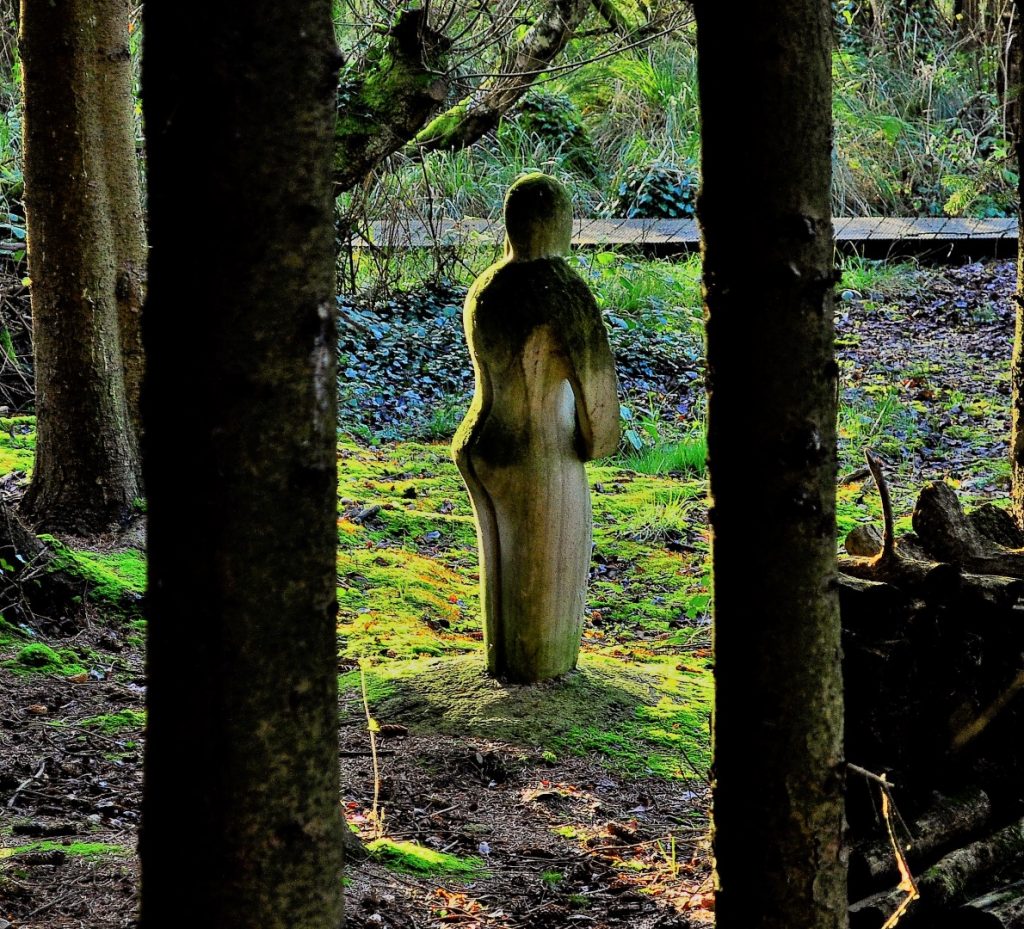
November 2016
After we opened up the path by the stream in 2010 and linked both sides of the garden in the lower fields our favourite walk in the garden had become the stroll across the wooden bridge and up along the stream into what we called the secret garden as it was a small oasis of lawn surrounded by trees. I loved the view up the stream now bordered by lush plantings of architectural foliage plants such as giant gunnera , dermara , hostas and rodgersias and realized that by adding an extra support to the existing three large conifers where the paths met that we could build a structure suspended above the ground and still preserve the view .
Peter Cullen was called into action in May 2011 and the tree house project was initiated and built …. A beautiful place to sit , just a wooden platform with railings but without a roof and facing south west so gets the sun all day and if the weather is right the sun sets directly opposite and as you are surrounded by trees at what is roof top level you really do have the feeling of being away from it all !
Viewing a garden from above gives a different perspective and an opportunity to observe the passing wild life and OK while it is not set in Kenya and there are no giraffes or elephants we enjoy the odd deer and fox strolling past !
The tree house blended in from the beginning and this is how it looked four years later in July 2015 with virginia creeper growing up both front columns which I hope eventually will swarm and give the impression the tree house is floating and growing out of pure vegetation .
My first grandchild was born on December 23rd 2010 six months before we built the tree house so it seemed appropriate that we name it Marko’s Tree house but as he lives with his Mam & Dad in Montenegro he didn’t finally get to see it until this time in August 2013 ,
By 2012 the only boundary line section of the garden we hadn’t touched was what we called the wilderness area where the ground was full of water as the drainage in this the lowest part of the garden had clogged up over 50 years ago when the original stone drains had silted up through lack of maintenance since they were laid by the Quaker Family who owned all the land in this area in the mid 1800’s and as I have mentioned we had added to this by damming the stream .
The family had been very ecologically minded and two spinster Quaker sisters had made it their life’s work to propagate oak trees which they planted as acorns all along the hedgerows leading from our valley right up to the mountain road and theses are the very oak trees you can now see today one hundred years later . Our eastern boundary looks right at these original oak trees where a long line of them runs along my neighbour’s fields and Sebastian has very kindly cut down our boundary hedge in this area where we can “ borrow ” the view of these lovely trees while sons and daughters of the original oaks have self seeded into our surrounding ditchs .
The plan originally for this entire water meadow south of the stream as I have mentioned was to leave it to nature as a wet land habitat for the ducks , water hens and herons and we set about providing shelter and seclusion so that they could breed and feel at home there and for the first few years I added to the original planting of over 500 willow trees as rooted cuttings and a few silver birch whips and quite soon the entire area was covered in trees that don’t mind the damp and to this mix nature contributed self seeded iris and wild astilbe and we forgot about the whole area as it was too wet to venture into but we were satisfied from the noise each night that entire colonies of ducks and frogs had made it their own !
Thanks to the original planting of willows this area was now full of wet loving trees , a real delta type wetland only missing a crocodile or two to give it a steamy Florida look !
However in March 2012 we decided that the watery wilderness area should be accessible in a limited way and we designed a series of wooden walkways and stone paths that allowed us to walk through the area without any major impact on the wild life ,
Peter Cullen did his magic again and we were able to use some left over sandstone slabs for a small seating area which faces the morning sun and looks out on the ancient line of oaks .
With a digger we also opened up a 30 meter natural canal beside the new seating area which immediately flooded with water from the wetland and I planted up some water lilies, hostas , rodgersia , gunnera (giant rhubarb) , marsh marigold ( caltha ) and papyrus reed and within a year nature has self seeded wild iris and meadow sweet .
This was one messy project , mud and water everywhere and I really had little hope for it and it was the one garden project that was seriously underestimated in the amount of filling that was needed to lay stone paths across the marshy swamp … I had decided we would go for stone here rather than wooden boardwalk as the continuation path from here would have to be wooden on deep supports as it was out over five feet of water .
We deliberately don’t enter this wet land very often but when we do it is lovely to see the winter ducks , the water hens , herons and every winter we get a magical visit for a few weeks of a pair of snowy egrets from North African shores and as long as you keep quiet you won’t spook them … an unexpected bonus of the wilderness project .
Flossie and Toby wondered where to now ?
A change of plan for the back of the house … but first a clear out of plants killed in the great frosts of the 2009 & 2010 winters
Originally when we didn’t have a back garden in 2002 I planted the raised area running along the rear of the house , 2 meters wide by 20 meters long , with dramatic foliage plants such as phormiums which would at least give us something to look out the window at but more to the point would conceal the eyesore of a wasteland that lay beyond !
Later from 2007 onwards when a back garden was beginning to take shape out across the gravel area I often regretted planting up the area outside the back windows as it now concealed the real garden and wished I had gone for a more pared back zen like style which would not be so dominating but I lacked the ruthless gardening streak required to dump well established plants and hesitated to take out and replant the by now well established phormiums et al …. nature in the shape of the horrible winters of 2009 and 2010 solved the problem as most of the planting was lost in those two artic type winters with – 15 deg conditions lasting up to eight weeks at a time .
Peter arrived with his diggers and we cleared out what was left of the planting – over 50 beautiful foliage plants had been casualties of the frost of those two terrible winters and it was pretty traumatic to see their remains being dug out . I was able to save three small trees , a salix kilmarnock willow , a weeping purple willow and a catalpa ( indian bean tree ) which we successfully transplanted down in the secret garden where I am delighted to say they have thrived in their new locations .
The immediate back of house planting 2009
Sanna of course has never let me forget that she was opposed to this planting and preferred a cleaner look from the beginning but back then ten years ago she bowed to my superior knowledge of gardening design but sadly she is less inclined to bow these days and has become annoyingly vocal !!
Gardeners who experienced those two awful winters of 2009 / 2010 will never forget the loss of greatly loved established plants and the gaps they left in shrubberies across Ireland and the UK and we have never regained confidence in New Zealand plants such as phormiums and cordyline trees .
Those two had an exotic look and were the first plants I drafted into every planting scheme … never again sadly as the memory of dead plants being pulled out is one that lasts .
Newly cleared area at back of house Feb. 2010
We replanted with four brilliant white stemmed Silver Birch Jacquemontii and underplanted with white gravel into which was sunk small LED lights which illuminate the trees at night .
September 2011 … a year later going for broke … the final solution for the back of house design
The other problem with the immediate back of house was with the original indian sandstone slabs we had laid on the patio outside the window looking into the back garden from the sun room but which despite our best efforts had always managed to look untidy no matter what I put out there and of course everything was highly visible from inside the round picture window which was a feature of the room both inside and out and was a constant reminder to us that we had got it wrong .
We couldn’t put patio furniture out there as it would block the view from inside and anyway it was quite exposed so not a particularly nice place to sit and while I experimented with various garden pots and cottage garden type planting between the sandstone slabs , nothing really worked and it looked awful so what to do ?
When we bought the house the entire back of the house outside the back door was built as raised decking which apart from being lethal in wet weather was in bad repair and needed to be replaced which we had carried out in brick . We were still working abroad at the time and had the work carried out in our absence which is never a good idea with the result there was no tweaking with the plans as there would normally be if living here full time and we ended up with just an adequate design which didn’t really gel and the indian sandstone never worked nor did the too narrow set of steps leading down into the garden .
We lived with it for a few years , unhappy but unable to design a replacement until eventually in August 2011 on holidays we had a eureka moment when we saw wide old granite stone steps running up to a different level outside a local church in Croatia and thought we can adapt this to our own more humble location !
The steps really were a eureka moment and the key to the new design which would see us remove the entire area , dig down to ground level and install a centre piece water feature outside the round window and a terrace patio .
Snezana’s only stipulation was that the new set of steps leading down to the garden should be wide enough to allow people to sit , chat and have a cup of tea or coffee in comfort … and then jetted back to work in Kosovo leaving me to come up with a plan that would work , probably our most detailed design project to date , with her usual statement if I don’t like it I won’t pay ringing in my ears – no pressure then !
Pascal Mansfield made a reality of our outlined plans and was the major contributor of ideas and tweaks to what turned out to be a great build . Pascal did all the initial construction work of dismantling the existing patio and project managed the reconstructive brick laying and construction of the new set of steps .
A really messy job of over five weeks in October 2011 involving diggers , burst pipes , sweat and tears , mini nervous break downs and a construction site resembling the immediate post war Berlin !
As I have said the steps , their width and position were the key to the overall design from ground level but the key detail looking out from inside the house was the water feature , too big and it would distract from the garden below and the view from inside the round window and too small and it would be insignificant … my first thought was a rectangular formal pool but Sanna felt we had enough pools around the house so while retaining the rectangular shape of the pool I came up with the idea of a floating block of granite which almost covered the surface area of the pool and from which water would pour in sheets back into the pool .
A large hole appeared outside the back door and the immediate back garden became a major construction site over the five weeks while I took a back seat to Pascal with my major role being that of supplier of cups of tea !
Gradually The new steps took shape
The centre piece of the new design on which the success of the entire project would rest was always going to be the water feature which had to be exactly the right height so as to lead the eye from inside the window to the garden without distracting …. but what was the right height ?
At this stage with the brick work almost completed Peter Cullen took up his role in the project which was to install the water feature and lay the floor tiles .
I spent a lot of time agonising with Pascal and Peter over the height of the limestone slab and how it would be supported , the ratio of granite slab to water and the depth and width of the water around the slab and to make things even more difficult I had no photo or example from the usual sources such as gardening books or magazines to go on … this would be a one off design … so again …. no pressure !!
I had found and selected the stone with Peter just after it came out of the ground at the quarry in Killenaule , discussed and drew up its dimensions and dressed finish design with the Quarry Manager … who either hadn’t listened or just didn’t bother or the original stone mason was blind drunk … take your pick but either way the finished stone was delivered in a horrible condition with scratches all over the surface , the eight openings for water were all out of kilter and left in a totally unfinished condition … very disappointing however some harsh words were delivered to the effect that we wanted a product finished to the same level as Coolmore Stud would demand or else the stone would be winging it’s way back to Killenaule Stone Quarries .
To be fair to them , Killeanaule Stone Quarries rose to the occaision , acknowledged that they had misread the brief and not realising it wasen’t just a a big ornament to be sited deep in a garden but was intended to be the focal point of a hard landscape design feature to be viewed up close and they sent over a stone mason who spent two days on site leaving us a beautiful finished stone centre piece .
When the granite slab was delivered the lorry blocked traffic on the road for nearly an hour trying to get in the gate but then as now over the years of garden construction our neighbours , bless them , were forgiving .
Getting there
Steady steady ! Back at the Garden the stone is winched onto the patio Sept 2011
Right up to the final moments of laying down the piece into its rectangular base of water I had nagging doubts that the overall design would work or that it might dominate the view across to the garden from inside the room but fitting the huge granite slab into its new home and installing the water system flowing across the face of the granite was Peter’s finest moment . I have to admit I did not design the water flow and the concentric design flow was all Peter’s and it worked beautifully .
The water system was connected
But it felt right immediately and suddenly like U2 we had found what we were looking for !
But final approval was still to come as Snezana arrived on site November 2011
Johnny was finally happy with the new steps Nov 2011
Two years on we are delighted with our new feature October 2013
And our neighbour’s pets have also taken to the new steps !
Front Garden Sun Room Project December 2012
Like the back patio we had got a bit fed up with the view into the front garden from the sunroom and although the rock sculpture with it’s built in water feature was a good focal point yet behind it the background of yellow stemmed cornus looked tired and shapeless and tended to blend into the huge weeping willow at the edge of the front lawn and the overall effect just didn’t work .
I take the blame as I had selected the planting and then allowed it to grow out of control when in hindsight clipped formality would have been better for that location . I am a great believer in the room outside concept popularized by the English garden designer , John Brooke , and definitely our room outside was lacking something .
We got the idea of where to go to next design wise from an old Ottoman house converted to a guest house where we stayed during a visit to Antalyia on the mediterranean coast of Turkey in May 2011 , the upstairs had a huge ceiling to floor window where we use to sit in the evening looking out over the garden and wondered could we achieve the same look at home ?
The obvious place was our garden room and the first step was to install floor to ceiling patio doors in place of the three windows in the original extension we had added to the house in 2004 and of course this was just the first step and once completed the next challenge was to bring the garden closer in a wrap around in your face way .
We wanted a more intimate relationship with the garden directly outside the front windows and the solution seemed to be raised beds of mixed planting but how to create this without the end result looking boxy or cutting off access to the back garden on that side and what material to use to build the raised beds ie. wood , stone or brick . Wood seemed a better choice and my favourite wood for a raised bed has been always to use railway sleepers which I like for their organic antique appearance however in this area I felt a more modern clean look was needed so we settled on a larch wood cut to the same thickness as railway sleepers but with a more subdued neutral wood colour which would fade over time to a nice silvery grey and with the added bonus later if I missed the railway sleeper effect I could always blacken the wood with a blow torch as demonstrated recently on Grand Designs by Kevin McCloud – not me personally with a blow torch I hasten to add as anyone who knows me knows that I would be likely to either set fire to myself or the house being as I am the Mr. Bean of the DIY world !
Plans stalled over a design problem as raised beds would cut off access to the back garden at that side which would mean the only access was on one side of the house to the entire back garden which with the garden open to the public would be limiting then John Lawless , our neighbour , over for a cup of coffee one afternoon and sitting outside the new front sliding doors , came up with the simple solution which was to cut out a new pathway through the lawn from the front driveway out onto the laneway and by pass the proposed new raised beds … simple …. but brilliant idea John !
In December 2012 Peter Cullen built and installed the new larch wood raised beds which were filled with earth and I planted up with a selection of mid high shrubs and perennials with all year round colour leaf or bark and throughout each season I add seasonal bedding plants for variety and colour plus nasturtium to trail out over the beds for a more natural overflowing look .
Construction of the new raised planting beds December December 2012
The original plan for the outside patio floor was to use wooden decking however Irish winters mean that this can be lethal underfoot so we decided to match the brick work at the back patio which was laid the year previously .
Moving the stone centre piece
The previous central stone water feature which had been installed in the original 2006 front garden as a centre piece to the front three windows now was now off centre in the new design by half a metre and had to be repositioned so as to take centre stage again .
In April 2006 Peter and I had found the large granite stone in a quarry at Manor Stone in Littleton , Co. Laois along with a similar smaller stone and the two positioned together always was for me a reminder of a Henry Moore type Mother & Child .
The look had to be just right and I am sure I broke Peter;s heart trying to get the position of the child to the mother at exactly the right angle !
And also I am sure by the end he was going to tell me that anymore moving of the rock would be by myself !
By removing an old leylandi from the hedge we were out in the laneway beside the house ….
We were able to reuse some old bricks from the original front paving for the new pathway
A pergola then suggested itself into the new opening which was planted with some climbers , wisteria , clematis , chilean potato plant (solanum ) and we were in business !
The pergola two years later in July 2014
Don’t get me wrong about new ideas suggesting themselves as if it is an easy natural process … sometimes it can be what I call a eureka moment and you know it is right but also there can be quite a bit of angst involved and we take a lot of time deciding what goes best for each particular location and then kick it around a bit more , chat with other gardeners and go through all possible angles before the final decision .
Mildred Stokes , a great gardener , arrived to cast a beady eye over the new project and her immediate comment was “lose the cornus‘s” which I had close planted under the the golden weeping willow and although I liked close planting I could see that the willow needed space to come into its own so we lost the cornus’s with much sobbing from me and now the weeping willow has the wow factor !
Over the years this area under the willow tree has become home to spring flowering bulbs such as daffs and crocus together with hellebores and basically anything low growing I get as gifts from fellow gardeners and for all year round structure I also slip lots of my geranium biokovo and they have romped happily in the semi shaded area .
I felt the area to the left needed something to break the view to the entrance a bit and my first thought was to plant a group of three silver birch directly into the paving but was weaned off this idea by Snezana’s downright opposition .. apart from breaking the view a solid stucture of sorts was needed to stop someone driving directly onto the water feature and then I remembered two Japanese style pots in the Clonmel Garden Centre that seemed to have been there forever like two guard dogs leading into their Japanese section of plants and planters . I had first seen these back in 1999 when they first came on sale at 1200 pounds for the pair and while at the time I had no garden I still thought they would be unusual in the right setting and over the years had seen a sold sign on them at least three times , yet they were still there in December 2012 ?
I asked Chris Hanna , owner of Clonmel Garden Centre about the pots and he confirmed that they had never sold for a variety of reasons over the fifteen years and yes they were now for sale at a reduced price and we did a deal of buy one at 300 euros and get one free !!
The pair are a patented numbered design based on 16th century pots from the Emperor’s Palace in Kyoto and the slots at the top were for thick bamboo branches for ease of transportation .
As soon as they were placed in position it was as if they had been there forever and yes the thought did strike me they were waiting like King Arthur’s Excalibur for the right garden to come along !
Just to illustrate that suggestions in the garden are always welcome , an architect friend was visiting a week later , admired the two pots but added they would look better if supported on bricks …. and so they were and a week later another friend suggested they would add impact if closer together .. and again we tried the new position and yes it worked !! Yet another friend suggested three of the same pots would fill the space better but this was a pot too far as the Garden Centre tried to source a third , fourteen years after the original order but the suppliers , a US company , were no longer in business but the moral of the story illustrating just two pots is everyone ‘s suggestion is valid and nobody has the monopoly on the complete design …. and one should never be afraid to listen !
And how it looked three years later in October 2016
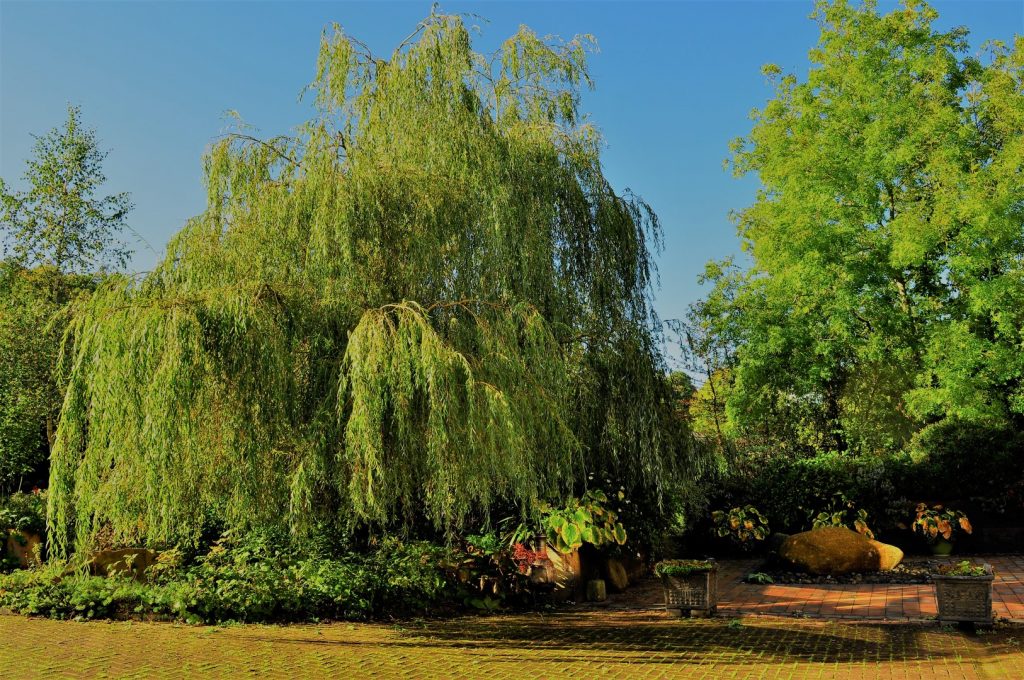
Of course the proof of any design is does it work and do what it says on the tin and here we have no doubts and every time I sit inside the garden room looking out at this patio I remain delighted with it .
Opening the Garden to the Public for the first time June 2012
In January 2012 Mildred Stokes had contacted me to say that she heard we were creating a woodland garden and asked if we were prepared to have it join the Tipperary Garden Trail and open the garden to the public. I had never met Mildred , a former winner of Tipperary garden of the year , Munster Garden of the Year and Irish Gardener of the Year , but had heard for many years about her famous garden at Killurney . I said that I would not presume that our garden was good enough and which at six years in existence was a very young garden and very much a work in progress but would be happy if she vetted it herself and then make up her mind if it was ready .
Mildred arrived for an initial visit a few days later accompanied by Pauline Hegarty , another well known Clonmel gardener of Kilmacomma Garden . It is always nice to accompany other gardeners around your own garden and have them pass a critical but friendly eye on your efforts and both Mildred and Pauline came up with some good suggestions which I was delighted to implement and the end result was that we were invited to become part of the Tipperary Garden Trail in late June 2012 .
Pascal Mansfield, a friend , who had built the new back patio and steps was also Secretary of the Clonmel Lions Club and we decided to donate the garden open weekend collection proceeds to the charity as I have always been impressed by their low key non religious approach to fund raising especially at Christmas with their practical contribution of tins of food campaign .
The Lions Club , led by its then President , Patricia Mathews , were initially slow to commit to the open weekend concept never having dealt with an open garden weekend before but quickly warmed to the task and publicized the event by word of mouth throughout the local membership and the response over the two days of the open weekend was magnificent .
Lions Club members took it in turns to man the gate over the 29th June weekend 2012 , collected admission fees and without them we wouldn’t have had a quarter of the turn out and in the end over one hundred people visited the garden over the two days and as a result raised 500 euros for the charity .
In 2013 , the Lions Club , with Noelene Bergin as President , having the experience of the previous year’s year’s event and learnt from it were committed from the beginning and by April 2013 had a working group committee planning the open weekend over the 5th and 6th July . The Lions Club garden committee publicised the event on twitter , Facebook and on local radio , had signs printed and put up on roads around Clonmel , rotated members for collection and gate duties , baked cakes … and its members turned out in great numbers to help swell the visitors to over 200 people and raised 1000 euros for charity .
We enjoyed the visitors , it was hectic and exhausting and we were on our feet constantly from 11am to 7 pm each day giving guided tours and answering questions on everything from plants to the garden design timeline but everyone we met was positive and we were left with only good memories .
You certainly learn a lot from opening your garden to visitors and you get everyone from the family wanting a day out and a good walk for the kids to committed gardeners and I can honestly say hand on heart that everyone we encountered were nice people and at the end of each open weekend there was not so much as a sweet paper or wrapper left to pick up …. but you do need to be able to answer questions about almost every plant in the garden …. and as Snezana found out early on calling rhus cotinus “red bush” doesen’t quite cut it for your dedicated garden visitor and a little more detail is called for !
We have continued opening the garden each year for the Lions Club Charity and numbers visiting have increased from year to year and this year over the weekend of June 27th /28th 2016 we again enjoyed good attendance and very importantly good weather on this the fifth consecutive year .
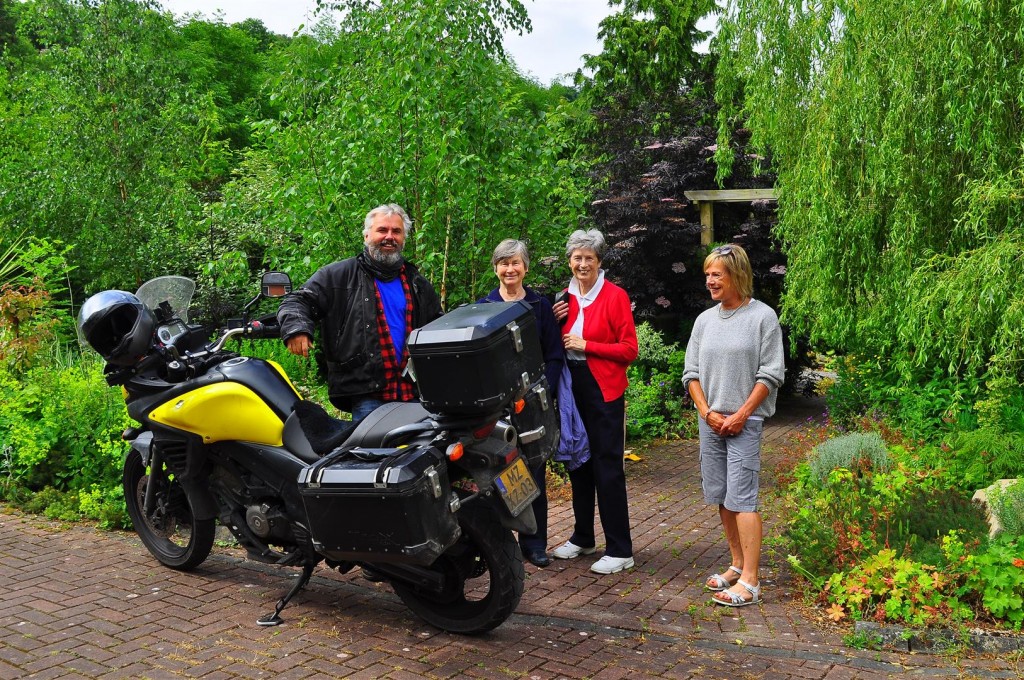
Biker Phil from Holland an early morning visitor Open Weekend June 2015 with Janet , Line and Noelle
So a big thank you to the Clonmel Lions Club for such support .
Gradually garden clubs throughout the country became aware that the garden was open for visitors and throughout the summer months we have welcomed a wide variety of people , many of whom give us not only good feed back but sound advice from their own experience in gardening .
And sometimes the visitors are not so welcome …. some tend to eat the trees and shrubs !
And a visiting landscape artist , Mary Brigid Mackey , paints a picture in July 2014
Our neighbours and how important they have been to the garden
Constructing a garden like building a house can be an inconvenience to neighbours with all the going and coming of trucks and building materials but at least a house takes only a few months whereas my neighbours have had to put up with it for the past eight years with diggers, dump trucks, land rovers parked on the laneway along with loads of top soil, stone filling , piles of blocks & bricks ….at various intervals .
So a big thank you to Irene & Liam , Phillip & Margaret , Geoffrey & Bernie , Michelle & Sebastian .
Shared hedges and boundary lines can also be a problem and a bone of contention for the neighbour involved but we were lucky to have John Lawliss and Sebastian Boisson with land on our boundaries both of whom could not have been more helpful and who took an active interest in every new project .
The accompanying photo of the road way during a typical project illustrates …so a big thank you to you all !
Evolution of a garden
Nothing stands still and gardens certainly don’t nor should they and of course our thoughts on gardens and even on favourite plants evolve and no guarantee that what we liked yesterday will still be a favourite in a few years time . If a garden is not maintained nature will reclaim it within a year so it is a constant battle especially in our case here where wild gardening is the thing and the line between ” wild ” and out of control is a very thin one !
Nature also has a way of altering the garden and in the big storm of February 2014 we lost quite a few of the trees in the conifer wood along with the very first eucalyptus tree I planted back in February 2006 .. sad to see it go but I planted three new small eucalyptus trees about a metre high in the new border so life goes on .
At this stage in the garden narrative I feel it is time to introduce ourselves and set out our “ mission statement ” as all the best introductory leaflets do !
The other half of Petrovska Garden and my own better half is Snezana Petrovska also known as Sanna … the name of the garden will be explained later but suffice to say at this stage I had no objection to it being known as the Michael O’Riordan Garden !
Snezana is a working customs officer from Copenhagen but who for the past 23 years has been seconded by the Danish Foreign Ministry to the EU , UN , OSCE , as a customs consultant working throughout the Balkans and Ukraine and was until May 2014 working with EULEX in Kosovo , she is currently working on peace keeping duties with OSCE in Eastern Ukraine based on the front line in Mariopol . Sanna loves gardening but refuses to learn anything formal about plants , trees or shrubs but has a mystical love of communing with nature . She currently is Head Designer Petrovska Garden , self appointed I might add and her one regret is that I won’t allow her to buy a chain saw as she loves to cut trees , branches etc.
PS She selected this photo for the garden blog which I took of her in New York about to go into the famous Tiffany’s on Fifth Avenue …. my daughter Claire immediately commented on Facebook to the effect never mind about Snezana but WHO is the cool dude in the front of the photo and Snezana later fessed up that she picked this photo that because of her own unusual name people would assume the cool dude was my partner ?!!
When stationed in Northern Kosovo at Mitrovica in 2013 , the frontier post was under regular grenade attack from Serbs objecting to an independent Kosovo .
Daily Black Hawk helicopter patrols with NATO over the Kosovo border with Serbia in 2014
I am Michael O’Riordan also known as Eamonn when I was working with the Irish Revenue Commissioners . I am a retired customs officer who spent 20 years based at Rosslare Harbour and 15 years abroad working with the EU , UN , OSCE , as a customs consultant in Macedonia , Bosnia, Serbia , Montenegro , Croatia and the Seychelles Islands . I have been a gardener for almost 40 years now and my new title ( I always love a title ) is Head Gardener , Petrovska Garden .
Head Gardener Petrovska Garden in 2015
With the Seychelles Customs Service in 2008
In my big hair days with EU CAFAO , in Bosnia 2003
While seconded to the EU in Bosnia for ten years from 1996 I was assigned to the Brcko District in North Eastern Bosnia from 1998 to 2005 where the US State Department administered the region under the command of Ambassador Bill Farrand … Bill has Irish roots and we stayed in touch over the years and during his visit to Ireland in October 2016 with his wife Pam , sisters Beth and Nancy he stayed with us here and it was a great pleasure to meet him again .

Bill Farrand with Pam , Nancy and Beth , October 2016 , Lower Garden
How the garden got it’s name
Snezana and I could never agree on a name for the garden over the years as it took shape . At various times I suggested Willow Farm ..Olive Farm … Oakwood House … all equally pretentious … she never suggested a name of her own just kept vetoing my suggestions so we decided not to have a name . However after Mildred Stokes asked me to consider opening the garden to the public as part of the Tipperary Garden Trail in January 2011 I was contacted by Gerry Daly’s gardening website Garden,ie who asked to list the garden in their guide . Filling out the details for Garden .ie on the internet I entered the names of the owners as Michael O’Riordan and Snezana Petrovska – O’Riordan but left the garden name section blank and heard no more until back comes the listing as .. you’ve guessed it .. Petrovska Garden !
I could have edited the entry but decided that the computer knew something I didn’t know and had to acknowledge that she always supported the money going into the garden , tolerated listening to me prattling on about gardening all these years , japonica this japonica that without complaint …. so Petrovska Garden it is ….. she has earned it !
Sometimes though when on my own in the quietest part of the lower wood I have been known to sob quietly …. like Marlon Brando in On the Waterfront … I coudda been a contender … it shoudda been me !!
My favourite gardening books
These days google search has taken the place of gardening books and one can find details of a plant or solve a gardening problem at the touch of a button but there are writers and gardening books that the internet can never replace .
This is a list of books written by gardeners that I was both influenced and inspired by to become a better gardener . These are books that I reread on a regular basis and am constantly learning from as the writers are also inspirational gardeners who are in turn outspoken and not afraid to go against the trend and another word to describe them might be mavericks !
-
- The Well Tempered Garden – Christopher Llyod This was the book published in 1976 just when I got my first garden which opened my eyes to gardening and showed me that gardening was a passion and one that could not be part time , all or nothing and a total lifetime commitment . Llyod took me away from pretty pretty style gardening of regimentalised summer flowers of blue lobelia alternated with white allysum and the odd rose to give height and where gardening began on May 1st and ended in October ! Christopher Llyod was cantankerous and at first did not fit into the established Royal Horticultural Society way of thinking but pursued his own vision of what HE wanted from his garden and I have every book he wrote , The Foliage Garden, The Adventurous Gardener , Succession planting for adventurous gardeners, Exotic plants for adventurous gardeners, Colour for adventurous gardeners etc. Llyod also loved what he called gardening thugs , plants that self seed prolifically like alchemis mollis which for a lot of gardeners are a pest but Llyod loved the fact that nature should be encouraged not managed or curtailed in his garden at Great Dixter in East Sussex and I have followed his philosophy for the past almost 40 years .
-
- Better Gardening – Robin Lane Fox A slim book published in 1986 with each chapter devoted to a series of plants and trees and I have used it ever since to check plants and plan purchases . I like a writer to be definite about his / her plant preferences and also their dislikes and Lane Fox nails his colours to the mast each time and takes no hostages where popular garden tastes are concerned . An interesting man , Lane Fox is an Oxford University Classics Professor who is the leading world expert on Alexander the Great , writes a weekly gardening column in the Observer but who regards his real love as his appointment as the Head Gardener in charge of the college gardens . I met and spoke to Lane Fox in July 2014 at the Carlow Garden Festival … they say you should never meet your heroes but this was one who did not disappoint .
-
- The Damp Garden , The Dry Garden , The Gravel Garden – Beth Chatto The plants person’s gardener whose books are like the bible for any gardener be they beginner or otherwise and who comes across as a lovely understated person without any axe to grind unlike Llyod who tended to take on the world . Essential to anyone’s collection of gardening books and I refer to her books on a regular basis and her book the Gravel Garden has become a classic.
- Real Gardening – Stephen Lacey This book by a Daily Telegraph Gardening writer has no special theme but his absolute love of gardening comes through on every page and after every reading his enthusiasm makes you want to rush out and start digging ! A pure joy to read .
-
- The Complete Book of Gardening – Dan Pearson This book is co – authored by Terence Conran the designer but his name is on the cover mainly because he commissioned and paid for the book . Dan Pearson is probably the best garden writer of today and there is an elegance about his writing but above all his sheer love of gardening comes through . Again he is a writer of definite tastes and not at all structured about his planting schemes always following a naturalistic theme . Other books of his worth having are Home Front in the Garden about his own garden and its development , Spirit … which is a bit airy fairy but worth reading just to see where an obsession with plants takes you but no matter how airy fairy Pearson’s passion for gardening comes through .Dan Pearson also writes a weekly gardening column for the Daily Telegraph and I buy all of his books as they come out .
-
- Helen Dillon- Gardening Book … divided into chapters covering all aspects of gardening . What makes this book different from many others offering similar advice is Dillon’s down to earth no nonsense advice . There is also another book of her collected articles she wrote for the Sunday Tribune which I use constantly . I have met her several times , the first time in August 2014 when I visited her own famous garden in Dublin and she very kindly gave me a shovel to dig up as much of her tetraplanax rex seedlings as I wanted and in person she is as enthusiastic and warm as her writing .
-
- The RHS Gardening Encyclopaedia …. Indispensable for every gardener’s book shelf and here you can look up every plant , tree or shrub … a huge book but definitely one to have … I inherited mine from the late Betty Walsh , a great gardener and friend .
-
- Monty Don – the Complete Garden Book …. If you go for just one book to cover all aspects of gardening from organic vegetable growing to flowers and shrubs then this book is probably the best . Don who presents Gardener’s World on the BBC is considered a TV gardener by many in the British gardening establishment but not by me and of course he is posh totty for lady gardeners of a certain age ! He is a complex individual and a brilliant TV presenter who manages to convey his total enthusiasm for gardening in a believable way .
- John Brooke –The Small Garden was published in the 196o’s and still in print today , a testimony to the generation of gardeners who came to rely on his design ideas which are laid out in easy to understand text accompanied by marvelous photos . John Brooke is the gardeners garden designer and was the designer to coin the phrase “a room outside ” when describing the garden . His book Garden Masterclass was given to me by my son , Kevin, in 2004 and is the source I return to on a regular basis for ideas . If it is to check on the height of stone walls, type of path surfaces , garden containers and furniture this is the book for you and the photographs are sumptous .
Favourite plants
Bear in mind that my personal style of gardening is “ wild “ gardening and that I like to maintain the garden just at the edge of going over into wildness and my choice of plants , shrubs and trees reflect this . I am not into flowers or flowering shrubs as such as I find them too limited in what you get back over a long period and my view is that if my chosen tree or shrub flowers then that is an added bonus but it will not be selected on that basis .
In the antique trade they talk about an item having to ” wash it’s face ” which is to earn enough when selling on to cover the cost of all expenses in acquiring the piece in the first place and for me a shrub or tree has to perform throughout the year with good leaf and foliage in the growing season coupled with strong bark colour in the winter which is why I am not a big fan of one trick ponies that flower for a limited period and then nada for the rest of the year .
I love big leaved dramatic foliage plants such as gunneras , hostas and rodgersias as they add structure and interest to the garden while giving that wild exotic look .
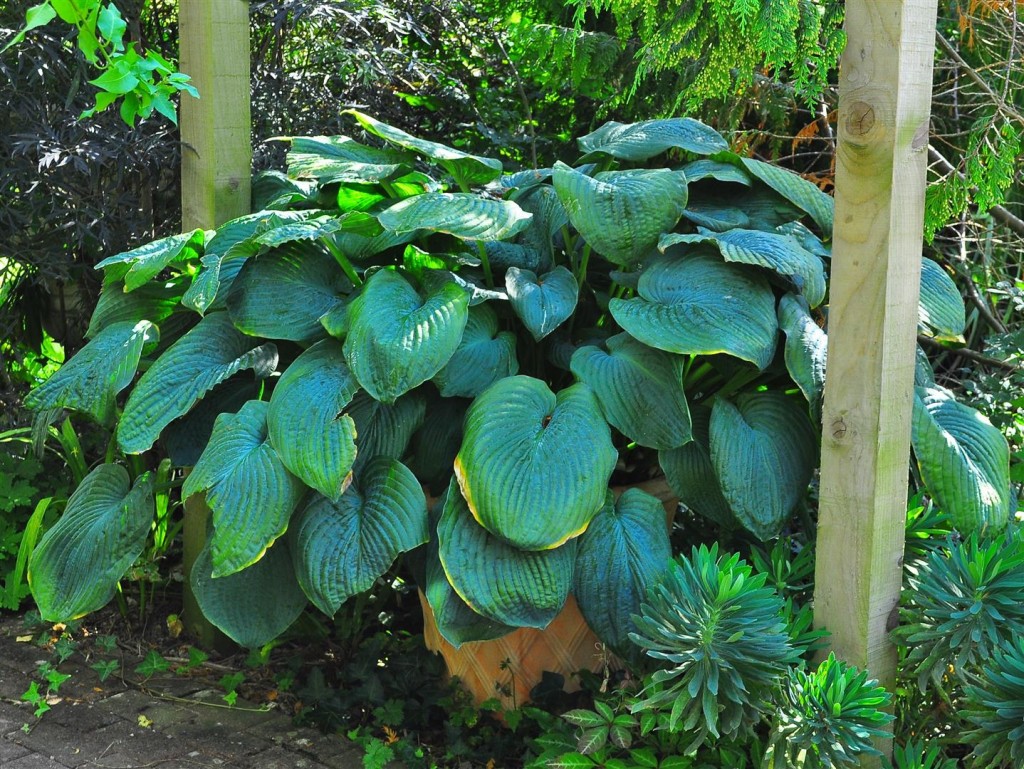
Hosta sieboldiane var. Francis Williams in the front garden August 2015 …. plenty of water and shade but remember slugs love hostas !
Gunnera is the plant you want for that dramatic WOW factor !
Gunnera likes to be beside water but not in water … somewhere moist where the roots can seek out water but the plant itself likes to have dry feet …. a little shade or at least not full sun is best …. find those conditions and the gunnera will reward you with leaves a metre across . Even if you have a dryish garden don’t give up on the idea of having gunnera … I grew them successfully in my Rosslare Strand garden for over fifteen years as you can see from the photo taken in 1990 with my kids in the foreground but it meant putting a hose on them for an hour every few days throughout the summer months … the hose was put on the gunnera not on Claire , Kev, Dave & Diarm I hasten to add !!
I used to love New Zealand phormiums and cordyline trees and they were the first plants in almost every planting scheme of mine over the years but like everyone else I lost most of them ( over 50 phormiums alone ) in the two hard winters of 2010 / 2011 and would never trust their hardiness again .
Three of mine survived those awful winters and if you have a sheltered sunny spot in your garden ( sheltered is a necessity ) phormiums are absolutely gorgeous throughout the year .
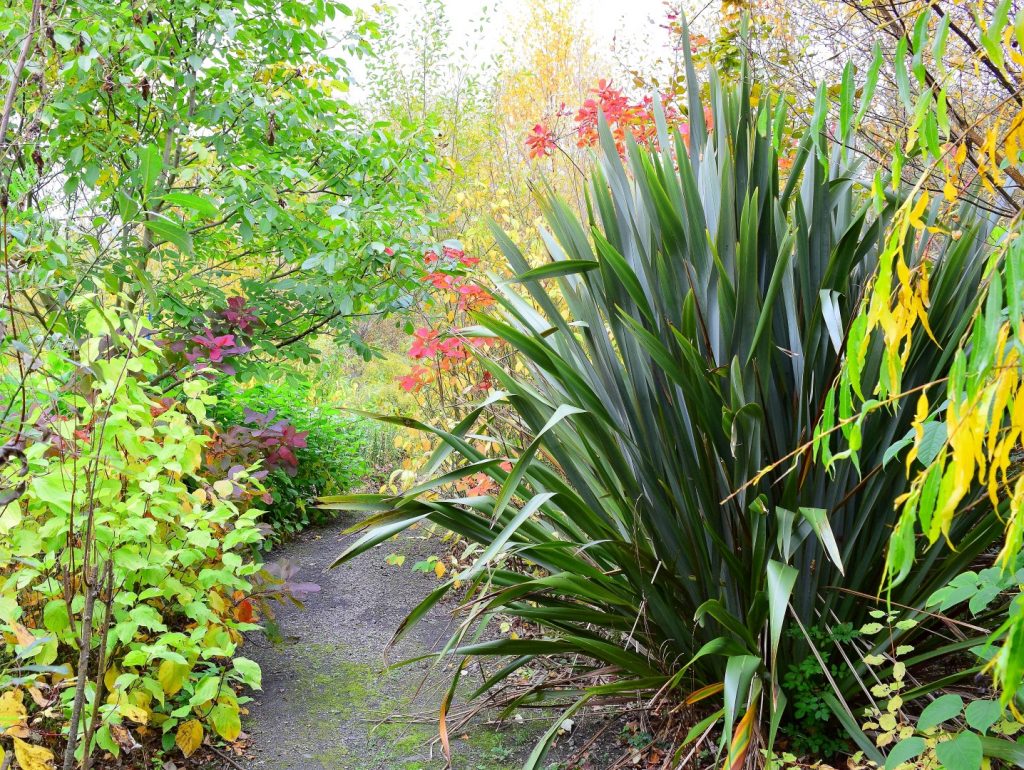
One of my three surviving phormiums , October 2016
Perennials — big leaved grey/ green hostas ( siboldiana Elegans & Francis Williams variety ), Darmera ( chinese rhubarb or umbrella plant ) , rodgersia , crocosima aka montebretia , heleborus corsicus but the olive green leaf colour variety as it looks great throughout much of the year , euphorbias particlulary the variety characais which is almost a weed in its native Mediterranean but is a fabulous all year round foliage plant with our climate , any mischantus grass but the variety Gracelissimus I recommend , giant purple fennel, acanthus both the spiky spinosa variety and the normal leaf .
One of my favourite plants for all year round display is euphorbia wulfeni which is the largest of the euphorbias . The first time I saw this plant was in the 1970’s when I read my first serious gardening book , the Reader’s Digest Gardening Year and saw a photo of a grand big house garden and there growing out of the middle of some granite slabs on a patio was this glaucus green leafed plant with golden bracts which was described as a statuesque foliage plant and I was hooked immediately . Had no clue what it was and any garden centre I asked had no clue either but a few years later at a garden plant sale for a local charity sitting on a trestle table was a 5 inch seedling planted up in a paper cup and the old lady who had donated it from her garden told me it was euphorbia wulfeni !
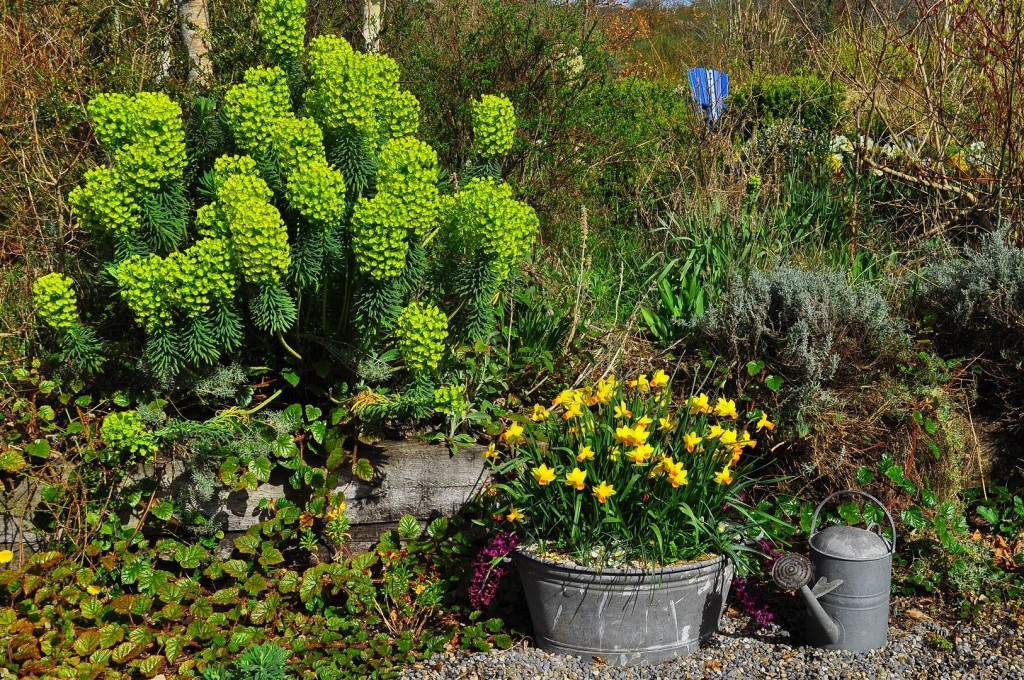
Euphorbia Wulfeni likes shade and dry stoney conditions … thrives here in the grarvel garden , April 2014
From that one seedling I populated my then garden in Rosslare and it now self seeds itself everywhere in this garden particularly into gravel and indeed a feature of euphorbia is that like buddleias it prefers to grow in cracks of walls and paving and does not like a rich diet . In the wild it grows all over the Mediterranean especially along the Adriatic coast of Croatia where locals regard it as a weed and wouldn’t have it in their gardens which just proves the old gardening saying that a weed is just a plant growing in the wrong place . There are all sorts of cultivated euphorbias for sale now in garden centres and gardeners are spoiled for choice with dwarf ones and even variegated versions with the trend for smaller plants as people don’t have space in their gardens but for me the large green euphorbia wulfeni is still the best .
Trees & shrubs — Silver birch jaquemonti , sorbus moonbeam var. lutescens ( mountain ash ) , cornus elegantissimus ( silver/ cream variegated dogwood ) , cornus controversa ( layer cake tree ) , Tillia ( lime /linden tree ), melianthus major , pampas grass var. christophe (which flowers in July August ) , salix purpurea ( a grafted weeping purple willow ), all bamboos but black stemmed if possible , rhus cotinus var. Grace ( aka the burning bush ) , sambucus nigra ( black elder ) .

Melianthus Major … difficult to source so if you see it buy it !
Latin names of plants ?
It is worth getting to know the latin names of plants , not just the common names , as all over the world from the US to China and Japan a plant is known firstly by its latin name which is the linqua franca ( OK the common world wide language !) of the plant world . It may sound pretentious and a little intimidating and I know it did to me when I was starting out in gardening and while local names are fine the problem is that every country has its own local name so it can be tricky to identify a plant you fall in love with abroad and want to try and source at home . Of course there are the snobs of the garden world that like to intimidate and show off but by and large real gardeners are helpful and will go out of their way to assist and even share plants and slips . My assistant here in the garden ( aka Sanna ) resolutely refuses to learn the latin names and maintains that it is a load of pretentious crap and maintains that you can get away with calling a plant uxi / cuxi/ coxi ( the a b c of the Finnish alphabet ) by adding the word japonica after it … you have been warned so if you meet her in the garden ……
Gardening Philosophy
To maintain a life long interest in gardening you need a philosophy , a theme if you like , that you work towards , not a topical trend as for example heathers … who plants the 1970’s big expanses of heathers coupled with tall slim line conifers now ?
You start out like every budding gardener with annuals and build up to perennials and basically you learn about plants , what they like and dislike , soil conditions and how not to fight nature and try to force plants to grow in impossible locations but then you begin to learn that on the right plant right place principle there is a plant for every location . You get and read a few self help garden books or look up a few gardening sites on the internet , start watching TV Garden programmes like Monty Don on Gardener’s World every Friday night at 8 pm on BBC Two .
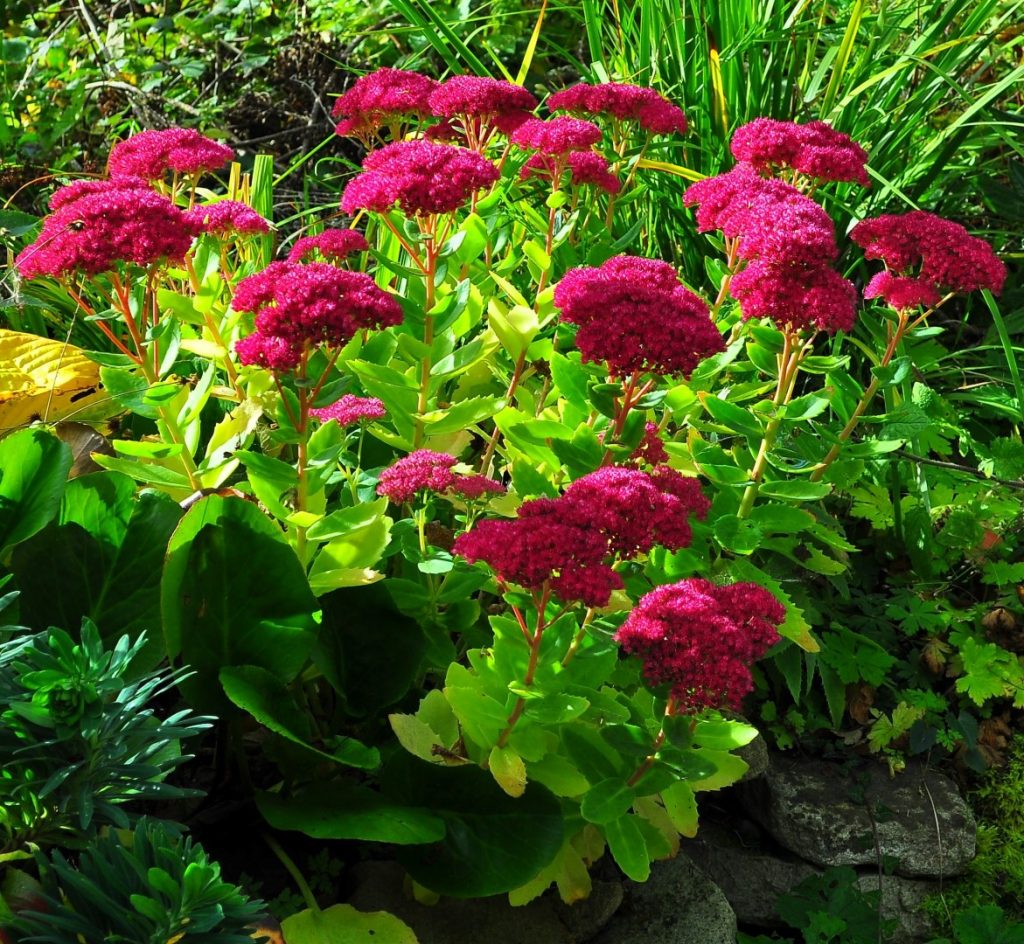
Sedum spectabile , the stonecrop , a fabulous perennial , October 2016
You experiment with cottage garden , perennial beds , invest in a few trees for structure etc. and in the process lose a few plants and trees and suddenly it all clicks together … you are now ready for your future interest in gardening … if you are lucky by which I mean a lot of people get stuck at this stage in that they have reached an acceptable level of knowledge where your garden thrives and you don’t lose anymore plants , you keep the lawn mowed regularly on a Saturday morning , dead head a few roses every now and then , have a few insightful garden phrases and complain about black spot and green fly … but that’s it for the next 40 years , you don’t progress …. to the end of his life my Father was a white alyssum/ blue lobelia in strict rotation man and was appalled at my wild gardening efforts which he found very untidy and messy …. to each his/her own !
The next level is to develope your own personal philosophy and your gardening theme … mine is unashamedly naturalistic wild gardening , no regimented wide expanses of perennial planting with each dead headed regularly or succession planting up to October and definitely no roses !
I let my plants fight it out for space as in nature and only prune back if there is serious overflowing onto the paths that make it difficult to push through . Vita Sackville West , the creator of what is England’s greatest garden , Sissinghurst , once said that her gardening philosophy could be summed up as ” cram , cram , cram ” and while I also follow that principle I like to feel that I keep the garden on the edge of wildness … as Dolly Parton once said ” to get this trashy look ain’t cheap ” nor is gardening my dear !!
I said no roses and that is because I got fed up in the early years losing the battle against black spot which disfigures roses in this country and I tried everything from Jeyes Fluid without success and as for dead heading , this was a real pain in the ass as I had over 200 roses at one time … and then there was the green fly and there is nothing more disgusting in my view than a beautiful rose crawling with green fly … not worth the hardship involved so no roses !
That said there are exceptions and I grow one variety of rose here and I love it … the old fashioned rosa rugosa with its white and pink flower varieties followed by beautiful rose hips . This is a serious foliage plant with its beautiful glaucus green leaf and easy forgiving nature , you can cut it to the ground every spring with a chain saw and back it comes by July as beautiful as ever … and NO black spot or green fly !
An important element in every gardener’s progression is to visit other gardens and learn from their owners . I don’t mean the large Mount Cosgrave type of estate but the smaller private gardens where you pick up great tips about planting combinations and the likes and dislikes of various plants which you can then put into practice in your own garden .
And along the way you need to get used to being wet, muddy , tired and cold , fingers numb ……it is not all sunshine out there !
My gardening style
I always use trees and shrubs that contribute a combination of good leaf colour and bark so you get a plant of year round interest and I use the immediate back garden area to demonstrate to visitors how colour and interest can be achieved without a slavish devotion to flowering trees , shrubs etc.
I do admire and love nice flowering shrubs such as magnolia or rhododendron when in bloom but generally I am not a great lover of flowers or flowering shrubs or trees as I find the return disappointing as you normally get only three weeks in flower and then you are stuck with this drab looking plant for the rest of the summer such as the flowering cherry trees which are great in bloom but one burst of wind or frost and you can lose all the flowers for another year .
There are exceptions of course with plants that are so spectacular in flower however fleeting that they are worth their place in the garden not that I have any of them ! For me a plant has to perform for nine months and for that flowering takes second place .. I have a gardening friend who rings and says come over quickly so and so is in bloom and by the time you get there the thing has either been knocked over by the wind or the rain and is disappointing … not for me and give me interesting leaf and bark colour any day !
Likewise I don’t invest in trees or shrubs that are sold mainly for autumnal colours as again you have to live with a drab tree for eight months waiting for that magical burst of leaf colour in November when the weather may be too bad to go out to admire it anyway . … if a tree or shrub has great autumnal colour well that’s a bonus for me but it is not my primary reason in selecting it .
One tree that should be in every garden is the red oak leaf acer , a maple that is no trouble to grow , has a great shape , is not tender like the dwarf purple varieties and the leaf colour in autumn is to die for .

An acer in autumn , the gardener also ! Lower Garden , November 2015
The other principle I garden with is right plant right place and while you will get away with a certain amount of breaking the rules … generally never try and squeeze a plant into a location ( windy , deep shade etc.) or type of soil ( too dry, wet or boggy ) that it doesen’t like as it will be unhappy , won’t thrive and ultimately will die on you .
Generally if a plant hasen’t thrived or put on growth after a year in its first position I dig it out and move it to another location as my experience has been that an unhappy tree or shrub will soldier on for a few years never putting on any growth , looking miserable and then give up .
Sometimes inexplicably moving a plant even a short space of a metre will do the trick and the plant will take off .
Now having said that I don’t bother with flowering plants , I do admire them in other people’s garden and the work that goes in to their maintenance , the weeding and hard work that goes into maintaining beds of perennials etc. I would love to have the type of soil to grow perennials , nice crumbly soil but I have had two gardens in my life , Clonmel and Rosslare and in both I have had poor quality wet ground where it was like cutting turf when planting but you get on with what you have and my natural preference has from the beginning been foliage plants planted in a naturalistic style .
My top five trees or shrubs for impact over a long period would be the Silver Birch jaquemontii , Black Elder ( Sambucus nigra ) , Red Dogwood ( cornus elegantissimus ) , Rhus Cotinus Grace and Melianthus Major . I have left out the gorgeous Japanese Maple Acer Griseum ( paper bark maple ) as I have had no luck growing it on our heavy soil .
My gardening style here in Clonmel is also governed by the fact that the garden is visited regularly by deer from the mountain particularly in the lower fields away from the house and I often come across up to five young doe at a time grazing away and unfortunately at various times of the year they eat away at trees particularly young trees which has limited me in that I no longer plant specimen trees in those areas … and you never know what they will eat as I have had trees they have left alone for years and you think you have got away with it and then come out some morning and the tree is eaten down to a stump .
Deer never just eat the leaves which I wouldn’t mind but they can attack the base of a young tree and strip away the bark ( for the sugar content in the sap ) and the tree dies . The problem here is that the garden has been a wilderness for centuries and the deer roam over it as part of their natural habitat and while I do love to see them when I walk around but I wish they would go somewhere else for their take aways !
Sometimes they get very brazen and I have seen them outside the back window and I gather they regard me as a pussy cat with my ineffectual shouting shoo , shoo !
I took this photo from the kitchen window when five young deer were in the gravel garden snacking on alpines … brazen or what !
Photography in the garden
You don’t need to be a photographer to be a good gardener in fact you don’t need to even have a camera but it helps enormously to display your garden at its best moments throughout the seasons if you can take some nice photos and it is also a great record to keep as the garden developes … for me gardening and photography go hand in hand .
My second hobby after gardening has been photography and I quickly progressed from my first instamatic kodak camera to a compact canon back in the early 1970’s until I made the step up to 35 mm with my first SLR which was a Pentax . Back then there were five major camera systems, Canon, Minolta , Pentax , Nikon and Olympus but really then as now you were in one of two camps i.e. Canon or Nikon and I have been a Nikon man since I bought my first Nikon SLR in 1976 and currently I have an SLR Nikon 5300 which I use at different times depending on the situation with a 50 mm , 28 to 80 mm zoom or an 80 to 200 mm zoom .
The introduction of digital photography has transformed how we use cameras since 2005 and you can shoot as much as you like then edit down to few photos you might want to retain . I carry the camera with me each day in the garden as the light changes constantly and of course in your own garden you have all the best camera angles worked out in your mind .
I used to also carry a compact camera with me and occaisionally still do for snap shots of animals in the garden where you don’t get a second chance of that special moment when a deer or badger might wander into view but I prefer the quality I get with an SLR for all serious photographs where I can capture the exact lighting and composition and even though it is heavier and more bulky to carry around than a compact I prefer the extra quality over portability every time .
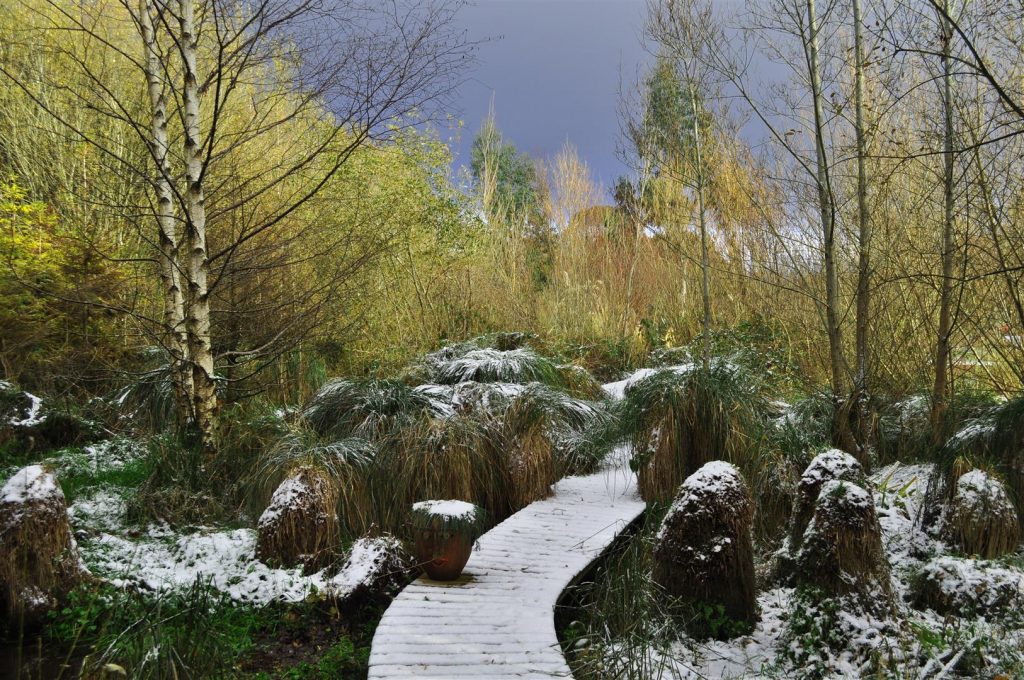
A dull winter morning in the water garden December 2009
Sometimes of course you just get lucky when the controls are set wrongly or as in this case you accidently kick the tripod just as you press the shutter and the general blurriness makes for an atmospheric photo in the water garden !
A good camera with a long lens also allows up close and personal photos of flowers with detail and colour you don’t always see with the normal eye but the long lens will isolate and highlight these and you realise the beauty you might not always be aware of .
The camera also allows you to highlight smaller flowers whose beauty sometimes goes unnoticed such as this close up of a helleborus from the back garden .
When Flossie , our dog , by a miracle actually caught a rabbit , my compact recorded the moment in a shot you couldn’t stage as she walked past me smirking triumphantly as if to say when did you ever chase down one of these ?!!
Flossie , a stray of 57 varieties , adopted us twelve years ago when she followed Snezana home from outside Superquinn in Clonmel the first weekend after we moved into the house in November 2000 …. I protested that it was unfair to give a stray the hope of a permanent home as we were leaving again for Bosnia in two days but Snezana thought we would give her some love and affection for at least two days …. we left early on the Monday morning and I thought well that’s that for the dog .
Our next visit back to Ireland was in six months time and when we pulled up outside the house Flossie was waiting for us ! She had moved up to Irene & Liam , our neighbours when we had left but obviously didn’t forget us and then came back to stay with us every time we came home over the next eight years until finally I came home for good and Flossie moved in permanently .
She came everywhere with us and we loved her to bits
Slept in the bedroom
Was naturally vigilant … as can be seen from her normal fearsome defensive position !
She tolerated me but Snezana was her pet
Sadly Flossie passed away five years ago and is buried in the garden … we miss her a lot .
After that diversion into biographies , gardening likes and dislikes , themes and philosophies etc. we can now resume the Petrovska Garden narrative !
September 2013 New Borders in the top field
Although I was never interested in having long borders of flowers in my own gardens I always admired the tapestry of colour and shape of perennial beds in other people’s gardens plus the intensive work needed to maintain a large perennial bed but then I never had suitable soil in my previous gardens for such perennial beds .
However in September / October 2013 I opened up two new long borders by the path in the top field as I had by accident discovered that the soil seemed perfect for a wide variety of plants and I set out one border as more or less tall grass perennials ( miscanthus ) and a selection of pampas grass , the normal type and the variety Ricardii , some specimen bamboo while in the opposite border a selection of eleagnus and hydrangea and other woody type plants went in but then we had almost three months of rain where the new borders were permanently water logged with the result that I had underestimated how water retentive the new area was and lost a large amount of the new planting .
To be honest it was pure luck that I discovered that the soil although wet was really good at this top end of the field as I had more or less written it off as too wet and had planted a group of three silver birch originally in the corner which never did much apart from looking miserable for a few years and then popped their clogs entirely in the winter of 2012 . On digging them out I discovered that the problem with the silver birch was not water logged conditions but just that they were bad specimens from the grower in the first place who had chopped back their roots to almost nothing to keep the trees compact for repotting …. this is the major problem with buying root balled trees direct from a nursery as the growers prune ruthlessly and as in my case leave almost nothing for the plant to take off from and this was not an isolated case for me as I have had several “ bad “ trees over the years , always direct from growers and in one case seven silver birch died and I have had three lime trees planted for eight years and it is only last year they started to put on some growth ….. same problem as when moving them on a few years back I saw the tiny root base left on the trees and as a result I rarely buy root balled trees now .
This photo of the initial planting does prove that you have to be an eternal optimist to be a gardener ….. or as I prefer to put it It’s da vision thang my Dear !!
But hope springs eternal for the gardener and real growth started throughout 2014
I started cautiously on the plant selection in the new beds staying safe with plants that like heavy soil but then as growth started to bulk up and the soil dried out I went for the Vita Sackville West advice of cram cram cram and now there is a huge selection of iris , bamboo , gunnera , hostas along with most of the plant donations I regularly receive from gardener friends found a home there …. but the backbone planting here has been the grasses , miscanthus , pampas and they are thriving and all along the borders I have added eucalyptus trees which I pollard each year to keep the juvenile foliage and their strong green leaves go very well among the grasses and perennials .
We added structure to the new beds in July 2014 by designing three pergolas and this gave a real shape to the new area …. mind you the path through the pergolas led nowhere but we solved this in May 2015 with a ” new vision thang !
How it looks two years after planting in July 2015
And a year later in October 2016
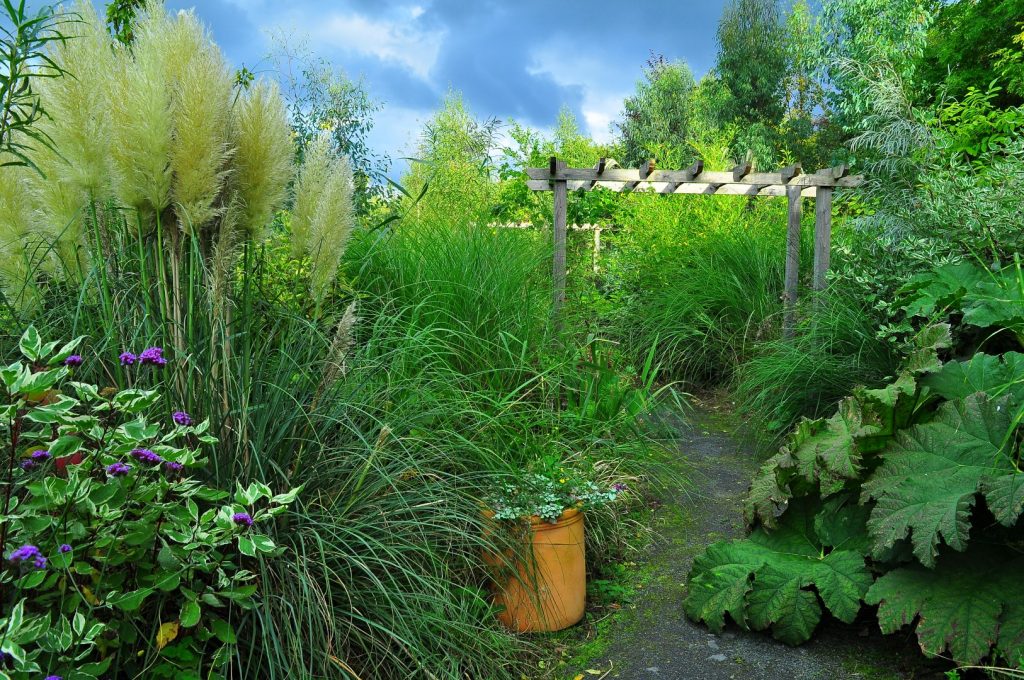
October 2016 in the grass border area
New paths in a design update in the Lower Field May 2015
As I said previously a garden is evolving constantly and here at Old Spa Road one project suggested another and as you can see in this narrative things happened incrementally and one idea sparked another. I was never happy with the design of the lower field area and I felt that nothing really came together design wise and it really was just a big park with paths around it’s edge which I planted with the usual mix that works well in the conditions here i.e. wet so lots of cornus’, silver birch , rugosa roses , eucalyptus which have grown away steadily over the last seven years .
My original plan for this area back in 2006 when we first cleared it was to fill the space with an orchard and I planted 36 apple trees in 2007 on home leave from the Seychelles but the deer ate most of the trees while I was away and the wet ground did for the rest … back to the drawing board for a suitable design in the Lower Field but a project kept on the back burner for the next seven years .
However one morning in January of 2015 while planting some dog woods in the field and at the same time trying to avoid walking on it as little as possible due to the water logged state I got the idea that as it was a park and one which due to the wet conditions in the winter months was unwalkable so why not accept this and put an all weather path through it to be able to at least use it in the winter and the obvious route was down to the focal point of the red bridge so I cut an outline out with the lawn mower and invited some design input from friends and fellow gardeners .
Mildred Stokes walked the area in February 2015 and said if it was her garden she would run the path through the pergolas and down into the garden that way …. which at first I didn’t like but gradually saw that by combining her path and my own more direct one that it could work and besides the pergola grass walk led nowhere but ended rather aimlessly in the field … a nice walk nonetheless but practical ?
I had huge doubts over this project which is unusual for me as I am normally pretty definite once I get the initial idea but here the potential new paths were over 400 metres long … was it a path too far , would it be disastrous and f..k up the top field and I mulled over a decision for two months and finally decided this was the way to go … two paths joining up … but still not fully sure that it wasen’t a gigantic mistake and with Snezana’s usual ” wait until I come home ” ringing in my ears and along with her usual “ if I dont ’t like it I won’t pay for it ” which is her default reaction if a decision is taken while she is abroad but ominously for the first time also adding “ if I don’t like it I want you to put it back the way it was ” … no pressure then and with all this hanging over my head I gave Peter the go ahead and in came the diggers and as I wrote in my blog at the time ” the diggers are back in town ” .. and even throughout the first day as the diggers were tearing up the field I was wondering should we stop !
However by the end of the first day with the outline of the two paths I knew it was the right decision ….. squeaky bum time as Alex Ferguson was fond of saying as this was the first time for me that paths were a design feature in their own right rather than just connecting A to B with a bit of a curve thrown in for the aesthetic look of it .
My neighbours have a look !
Sometimes when a neighbour stops to chat he gets a job !
Day by day as the work progressed I could see that the path design had added something to the top field and now it had a designed look and I was happy with it for the first time in eight years since we began the design and construction of the lower garden area .
And how it looked three years later in August 2018
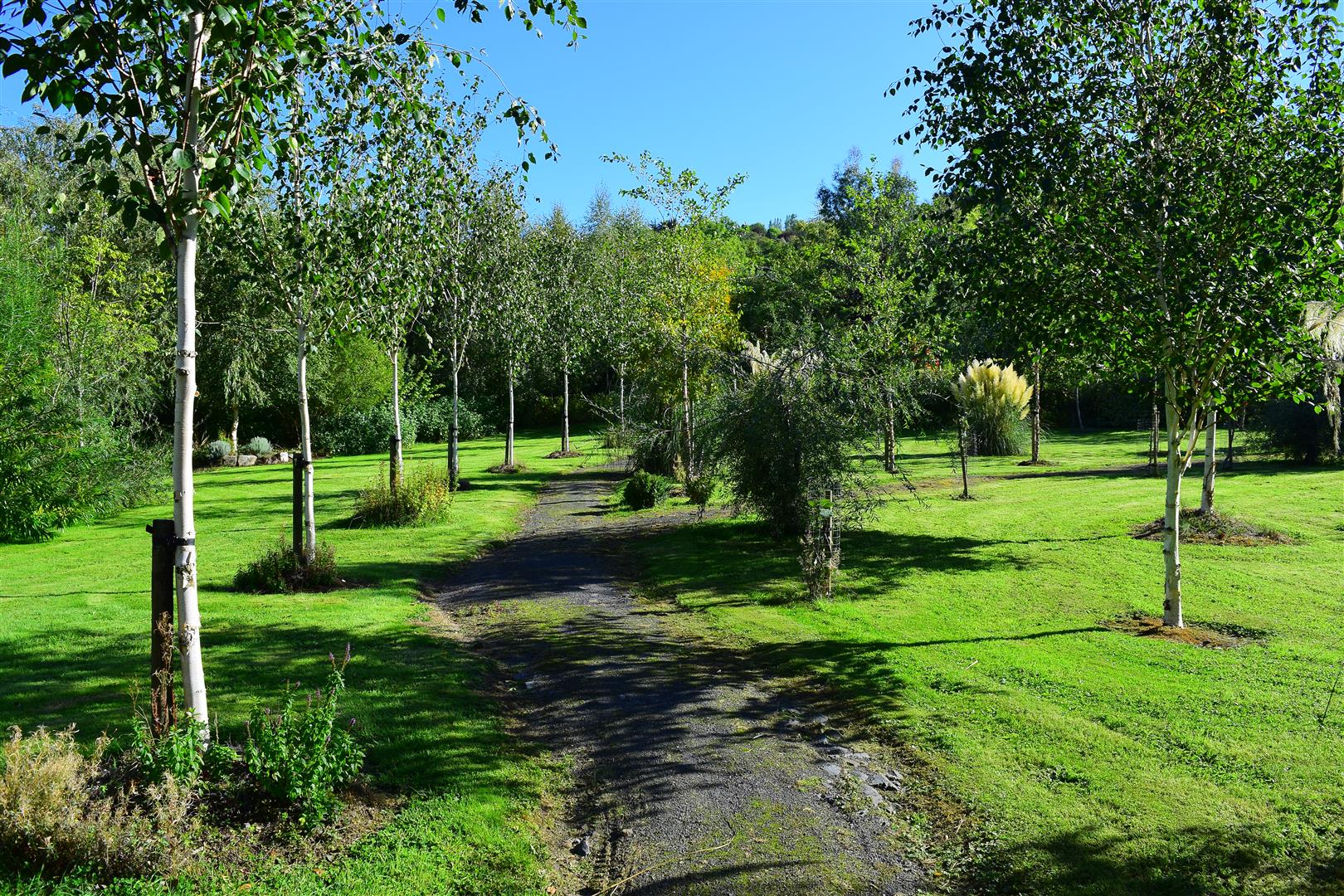
The path through the lower filed in August 2018
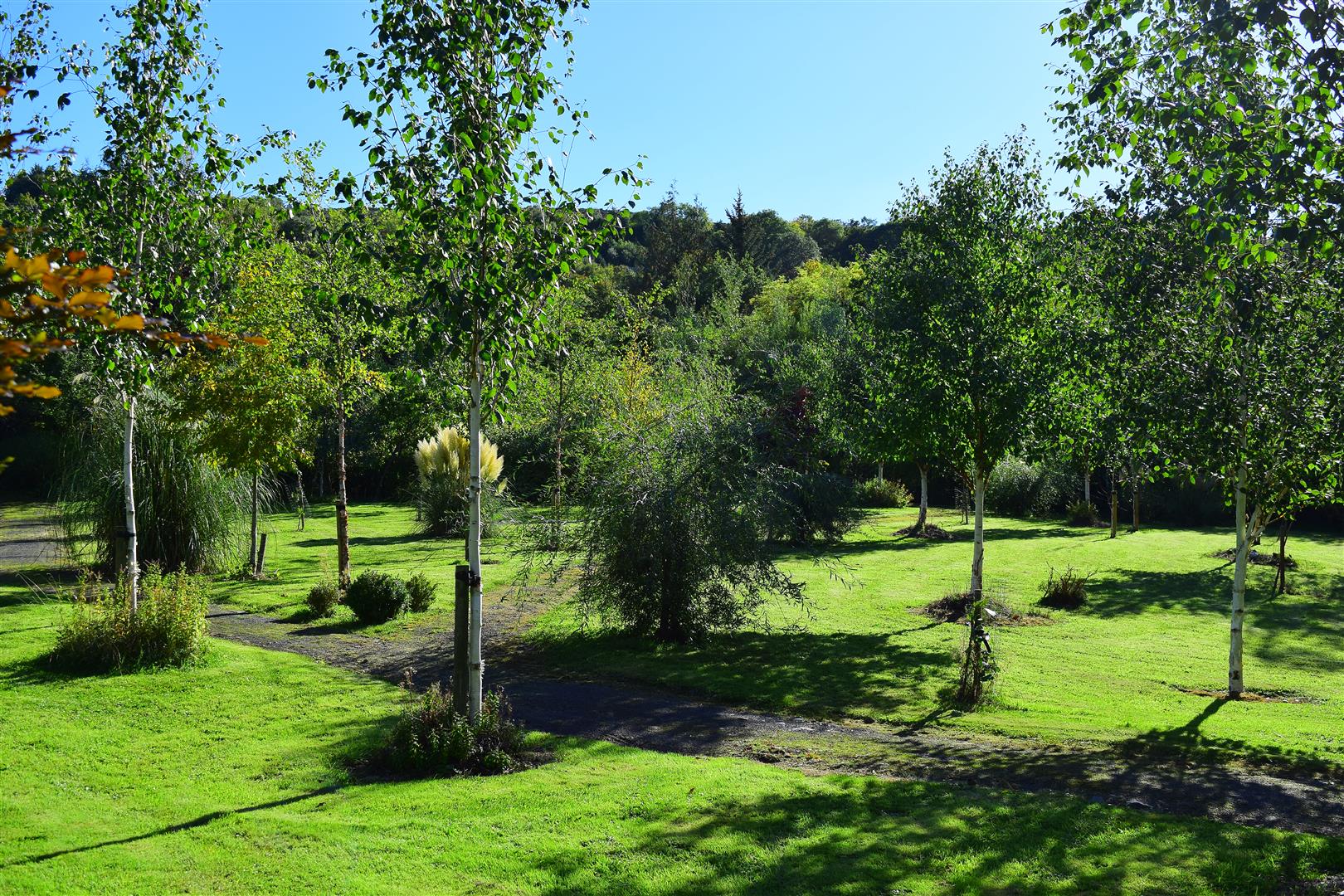
The addition of twwo lines of silver birch makes a difference , August 2018
A by product of the work was the creation of a small pond when digging out a small channel to take away excess water from an underground spring that had come to the surface two winters ago , leaked out onto the main path down to the garden and made it virtually impassable during December to March . I had earlier dug a make shift channel with the spade and even this greatly relieved the water leaking out to the path so with Peter here with the digger decided to do a proper job … we had been in Petra in March 2015 and saw the way the ancient Nabataens had channelled run off water throughout the city with above ground open stone culverts about a ten inches wide so why not use it beside our path ?
Again with the principle of one thing evolving into another I could see there was scope for something extra along with the concrete culverts and with a few scoops of the digger’s shovel we were able to make a holding pool out of which the culverts would run the excess water across to the natural pond and we then dug out a few willows to give a new view out onto the new paths and a new feature was born !
We were able to get away without the expense of adding a pond liner as the earth retained the water which was constant now from the underground source and even in summer when the water slowed to a trickle the pond level has held and over the summer months I lined the new pond’s edge with natural stone from a wall my neighbour , Sebastian Boisson , had knocked down and then added some marginal water plants such as caltha , marsh marigold and some calla lilies and even a small gunnera and then tossed in some iris divisions to give some structure to the planting and then a pot for extra height with some lamium chablis variety for all year round colour .
The path project started with great reservations but it was a great success and I can’t imagine the Lower Field now without these new paths .
Post script and just to show you that taste can change … a year later I changed my mind about the natural stone on the grass edge as I began to see it as too prettyish and not in keeping with the natural wild look and too small in scale for the large grass area it led on to so in October 2016 I took it out and left the grass run right up to the edge of the pond and rebuilt the stone along the side .
The revamped pool in October 2016

Less pretty and more in keeping with the natural look, the new pool in October 2016
And as we mentioned Petra I ‘ll stay on that theme for the next photos !
Petrovska Garden is advertised in Petra March 2015
Sometimes I needed a little help in Petra … I know I look a right wimp but it was high … honest !
Snezana feels this is the macho ideal I must aim for … at Kerak Crusader Castle in Jordan
And we took the Petrovska t shirt on holidays
Petrovska Garden does Croatia !
Amman , Jordan , February 2014
The Chain Saw Gang , Christian, Peter and Snezana , a wet July day 2015
As I have said many times a garden never stops evolving and even if you are just into a maintenance free garden and little else or have the smallest of patches , trees , plants , shrubs , all grow …. or should grow ( ! ) and in a few years the garden will have changed naturally .
In which case you need to hard prune as the shade from quick growing trees can dramatically alter the landscape without you noticing it and with that in mind about twice a year we get Peter in for a few days just to wield the chain saw … Snezana regards all such operations in the woodland , which tree to thin out etc. are her exclusive domain and I am relegated to the clean up afterwards … one such day was July 15th 2015 the team embarked on one of their periodical tree felling operations with Peter as usual wielding the chain saw and Snezana as Officer in Charge !
At times like this when Snezana is fully in charge of operations I almost feel sorry for Peter as the easy going relaxed atmosphere we have built up in working together over ten years with regular breaks for tea and chat goes out the window as Snezana does things in an almost Teutonic regimented manner , well she is part Danish (!) and as Peter gets out of the landrover at the agreed time she is waiting impatiently to start work …. JA ?!!
No cups of tea then but off immediately and few if any breaks throughout the day with the chain gang and tea is served only if I bring it down to them and reluctantly she allows a break of a few minutes ….. once during this particular session I visited the work and asked Peter if he’d like a cup of tea …. Jesus I ‘d love a cup was the fevered reply !!
As always we never use wood cut from the garden for the fire and instead stack it into housing projects for the wild life which is great from an eco point of view but also looks good in a wild environment .
Along with the piles of stacked wood throughout the garden we are constantly adding pots etc. and any other quirky items we can lay our hands on as we have a lot of space and little nooks and crannies which can be added to with focal points of interest and over the years have gathered items we feel add to the atmosphere and ambience of a wild garden and I particularly love these agricultural wheels and milk churns donated by my neighbours .
Michael and Marta Hryshyshyn , friends from our days together in Bosnia when Michael and I worked with the Bosnian State Border Commission , visited and stayed with us in April 2012 and on their return to Washington sent us this piece of artwork for the wood .
Our neighbour from the laneway , Sebastian Boisson , donated this old farm wheel from his farm , in 2014
And I particularly love this old stone quern sourced in Clare for us by Pauline Hegarty in July 2014
My particular pride and joy is an old ancient stone trough which I found in the Architectural Salvage Yard in Kilkenny in 2009 .
A memory from my time in Sarajevo , Bosnian car registration plates
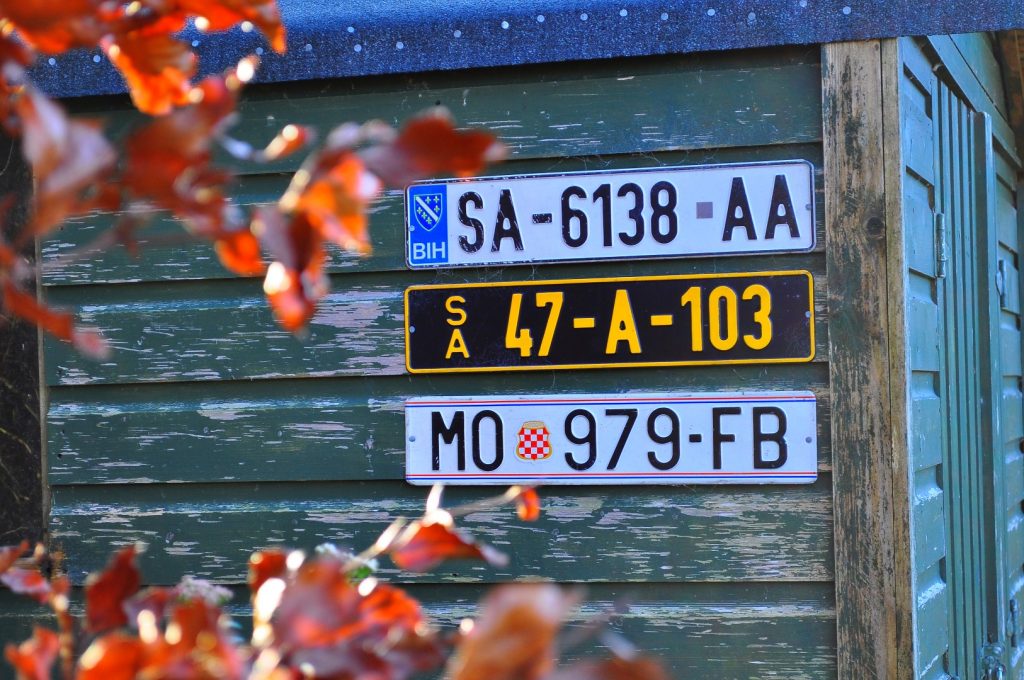
Immediate post war Bosnian car registration plates 1996
Pots also evolve , get broken and are replaced as was the case here with a lovely one off pot bought at the Kiltrea Pottery closing down sale and which was burst apart by the rampant growth of a hosta that was left too long before dividing .
New pots arrive
And garden seats give up the ghost also
Work in the garden continues on a daily basis no matter what the weather
Media interest in Petrovska Garden
From the beginning I had photographed each stage of the garden developement and kept an electronic file of each project and as I was always interested in making a permanent record it seemed a natural progression to set up a web site for Petrovska Garden and to write a gardening blog for anyone out there who might be interested … enter Liam Burke with his IT skills who we contacted to design a web site and one evening in October 2013 Liam sat down with Snezana and myself , we told him what we wanted and he showed us what could be done and within a few days we were up and running at www.petrovskagarden.com … Liam has been a godsend with advice and technical know how and we are delighted with the design and lay out of the site .
Visit of Gerry Daly , the Editor of The Irish Garden July 2014
When I first started writing the gardening blog in November 2013 I sent it to Gerry Daly , Editor of the Irish GardenMagazine and he got in touch to say he would like to visit the garden … Gerry arrived in July 2014 and spent a day with us ….. he came , saw , took over 400 photos and left without saying anything at all about the garden itself … not even a mildly enthusiastic or even luke warm comment which I understand is typical Gerry as in a long career as garden writer , TV presenter , Gerry has seen it all , met all the gardening greats , visited the great gardens of Europe etc. but we had a great day with him and chatted about all things gardening
Snezana before he left , unable to restrain herself had asked him if the garden was what he expected and his reply was non commital ” yeah I had looked at the photos beforehand on the web site so had an idea what to expect ” ……. not exactly over the moon !!
After he left I never heard a word from Gerry … nada …. until exactly a year later in mid July 2015 I got a phone call from him out of the blue saying he’s be sending the writer , Shirley Lannigan down to Clonmel to do an interview with us with a view to an article in the Irish Garden magazine !!!
Great excitement of course and Shirley arrived a week later to walk the garden and get as Gerry Daly put it ” the human interest story ” .
Shirley , an established author with two books on irish gardens , published in 2003 and 2007 , was an excellent interviewer who seemingly without any effort got all the facts and narrative of the garden from it’s beginning .
The September 2015 issue of Irish Garden Magazine gave six pages to Petrovska Garden !
Interestingly both Gerry and Shirley saw the value of not being afraid of Japanese knotweed and if you have it use it for height and design … a point Gerry had made with his photo of the arched tunnel of Knotweed linking the back garden to the lower area and which Shirley also highlighted in her article …. and yes she was more than fair to both of us in the article although my son , Kevin , summed it up by saying “ Dad we thought you might get carried away with your usual plant bull shit but who would have thought Sanna would be the one to come across as the tree hugger of all time ” !!
We had set out to build a garden and this media recognition by the Irish Garden magazine seemed to be the culmination of all our work since we first put a spade into the soil on January 6th 2006 ……. little did we know how much work we were chewing off !!
I designed a new label in September 2015 for Snezana’s self seeding plants potted up as gifts .
The October 2015 edition of Munster Interiors , a quarterly House & Home magazine featured the garden in a beautiful spread .. the Editor , Ruth had contacted me two days after the Gerry Daly feature in The Irish Gardener was published in late August and said the magazine would like to feature the garden in their October issue … we were delighted and even more so that my own photographs were used throughout the article .. with respect to Gerry Daly’s photos which were lovely , nobody knows your own garden like yourself and of course I have the entire year and all lighting variations to capture the various areas at their best .
After the excitement of two magazine articles within a month it was back to earth with a bang in the garden with the nasty job of bramble clearance !
October 2015 … the last remaining area of brambles in the garden was just inside the lower garden
It was the last remaining area in the garden covered in brambles which we had not reclaimed and I had convinced myself that the wild life needed this wilderness patch but of course it was pure laziness on my part as it is a nasty job clearing brambles especially when they are three metres high and spread out over a 20 square metre area but in late August 2015 I bit the bullet and set off with my trusty strimmer and cut and burnt the bejazus out of them !
What to do ?
Starting the clean up I had no idea what we could do with the new area and had vaque ideas of perhaps a vegetable patch ?
Standing in the newly cleared area which was now cleaned down to the soil and realising how full of light it was and what a lovely view was now available looking down the woodland garden the solution was obvious … a paved seating area which would allow the sunlit area to be enjoyed for relaxed outdoor living , throw in some nice garden furniture while paving with rough indian sandstone would add to the natural look .
The story of the garden , one thing leads to another and a pergola is added December 2015
And how it looks a year later in September 2016
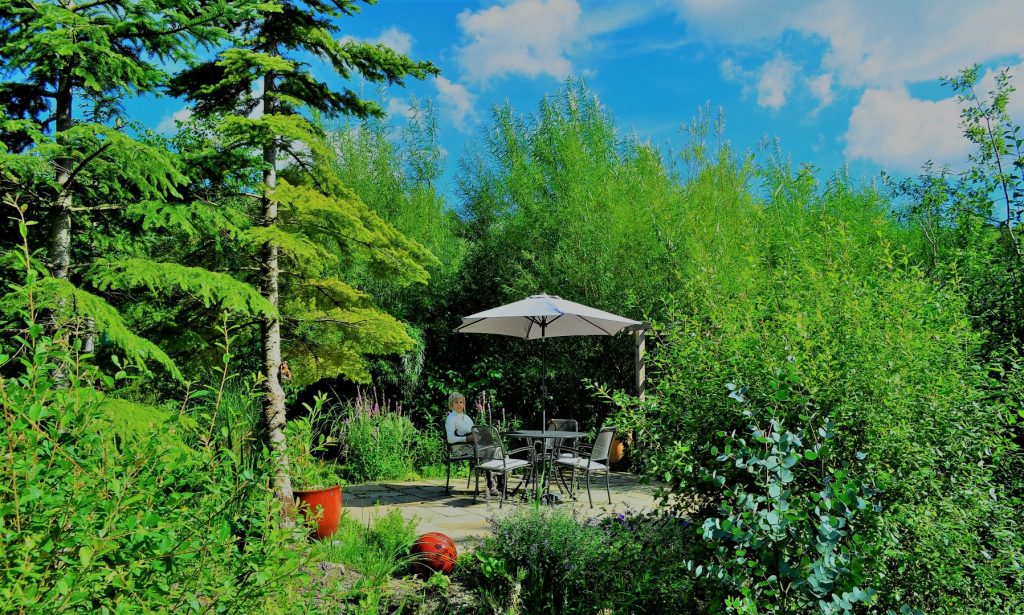
The Clonmel Nationalist features the garden in it’s December 3rd 2015 weekly newspaper
2015 was a good year for media features on Petrovska Garden
There is one area of the garden I haven’t mentioned so far and that is the long narrow stretch behind the house which leads across to the back garden , a service area really as here we have the washing line and two garden sheds and which has been gravelled from the beginning in March 2006 . Over the years this area has attracted self seedings of alchemis Mollis and euphorbia which I transplanted to other sections of the garden but gradually I saw that the area had possibilities other than just a walkway as it enjoyed full sun and because of the gravel base had good drainage …… I planted up some old tin baths , gradually built up a small collection of one of one off pots and added various alpines and sedums and the Gravel Garden hasen’t looked back since and in May 2015 the antique stone trough bought years ago at the Kilkenny Salvage Yard and which has been moving unsatisfactorily around various locations in the garden finally found it’s real home in the Gravel Garden .
An exotic ethiopian banana tree arrives
And old enemies relax here !
Location , location , location … it helps that our garden is set in a most beautiful area of Co. Tipperary , at the foot of the Comeragh mountains in the valley of the Suir just outside Clonmel looking across at Slievenamon .
Just to remind you and ourselves what we started with in March 2006
Photo from the same position nine years later in July 2015
Probably the photograph we both feel represents the garden best is the view from the round window in the Garden Room , the design of which our architect , Anne Berney , took from her studies in Japan where a large round window is known as the Mother window .
The view in early March 2006
Ten year’s later
A familiar theme … a garden is constantly evolving February 2016
I was walking down the path in the top field on a cold bleak January morning when I realised we needed some impact in late winter and also some additional height for structure as the garden is sloping slightly downwards here and needed a row of tall trees and what better impact plant in all seasons but especially in winter , silver birch was the only choice and in February 2016 we installed a line of nine fairly mature silver birch jacquemontii along the new path in the top field as I felt that they would lift the area especially in Winter where the white bark would be a striking feature .
I continued the planting in November 2016 by adding a further seven silver along the other path as the two paths lined with silver birch would complement each other .
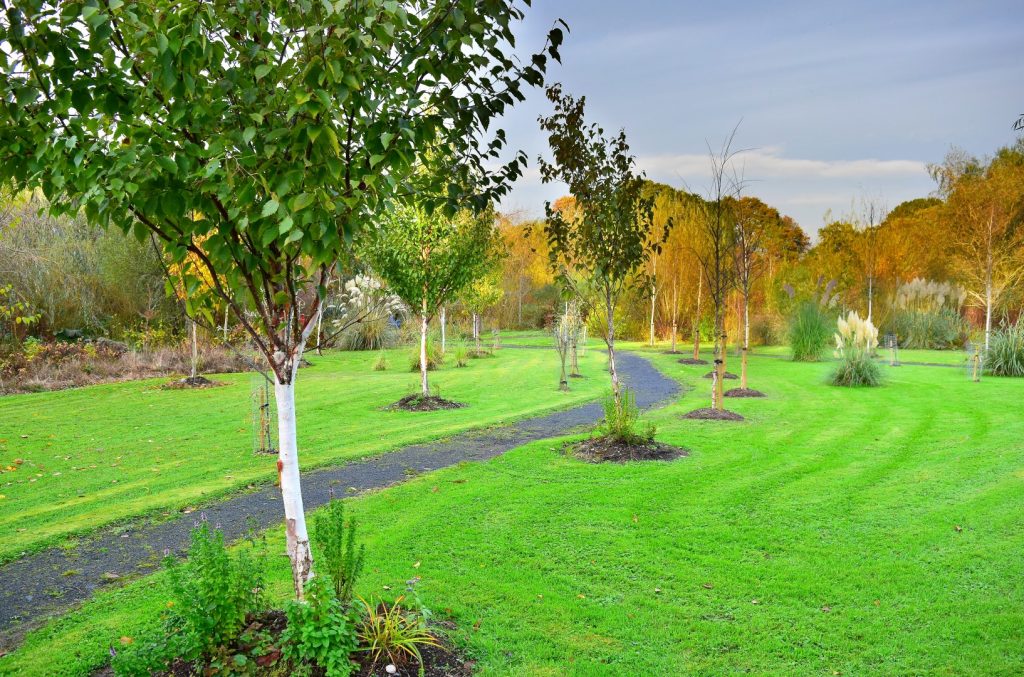
A line of seven water birch added to the path November 2016
Shay Healy visited the garden with his family in April 2016 and wrote about it in his weekly column in the Irish Daily Mail under the heading “ Garden shelter from the storms of life ”. Shay is a legend of Irish show business over the past forty years and wrote the winning song in the Eurovision Song Contest in 1980 with “ What’s another Year ” and his interviews in Nashville with such country stars as Tammy Wynette are available on YouTube .
I grew up watching Shay Healy on Irish television and in 1990 his TV show , Night Hawks , broke a political story about phone tapping political journalists which brought down the government at the time and precipitated a General Election … so it is fair to say that Shay has been there , done that and it was a real treat to host him here . I was delighted at the way he used his description of the garden in his subsequent column in the national press to weave a personal story … and as someone commented to me on reading the story he really caught the spirit of what we have set out to achieve here in the creation of the garden .
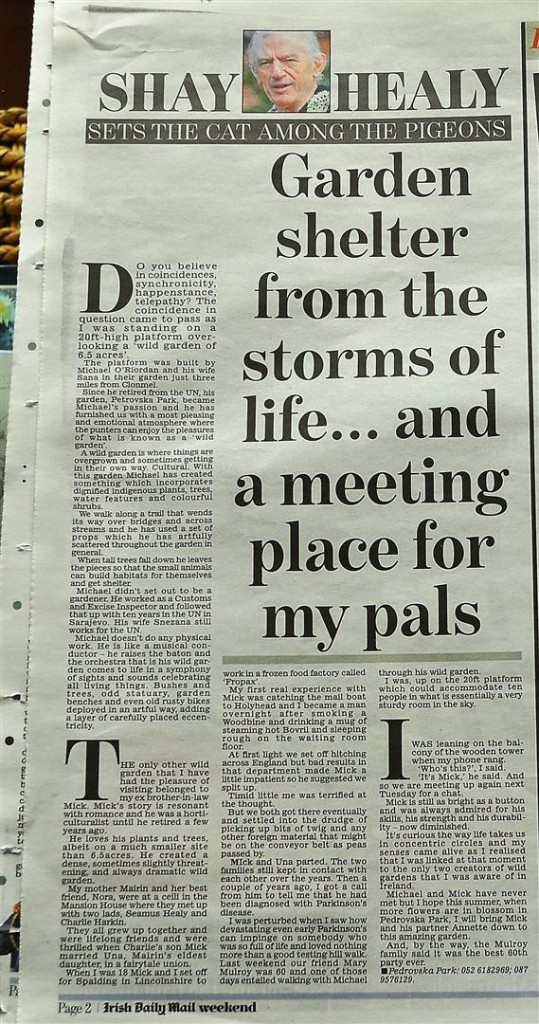
Daily Mail article on Shay Healy’s visit to the garden , April 2016
Shay let fly with some purple prose in the article “ Michael doesen’t do any physical work . He is like a musical conductor – he raises the baton and the orchestra which is his wild garden comes to life in a symphony of sights and sounds celebrating all living things . Bushes and trees , odd statuary , garden benches and even old rusty bikes deployed in an artful way , adding a layer of carefully placed eccentricity ” …. kind words but would that it were true that I don’t have do any physical work Shay !!
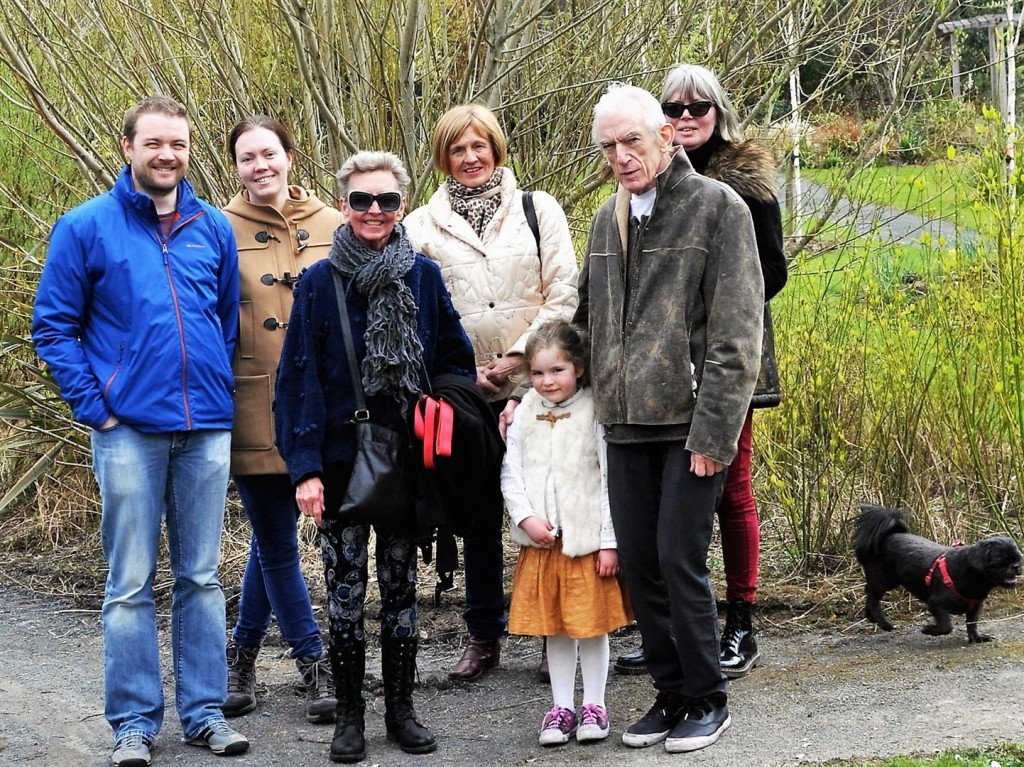
Shay Healy visits with his family , April 2016
End of major garden projects ?
I hesitate to say it but as I write in late November 2016 we seem to have reached the stage where the last of the major garden construction projects has finally finished but of course there are ongoing tweaks here and there where we can improve areas and in May 2016 I redesigned the rock garden area importing some large stones that were previously in other locations .
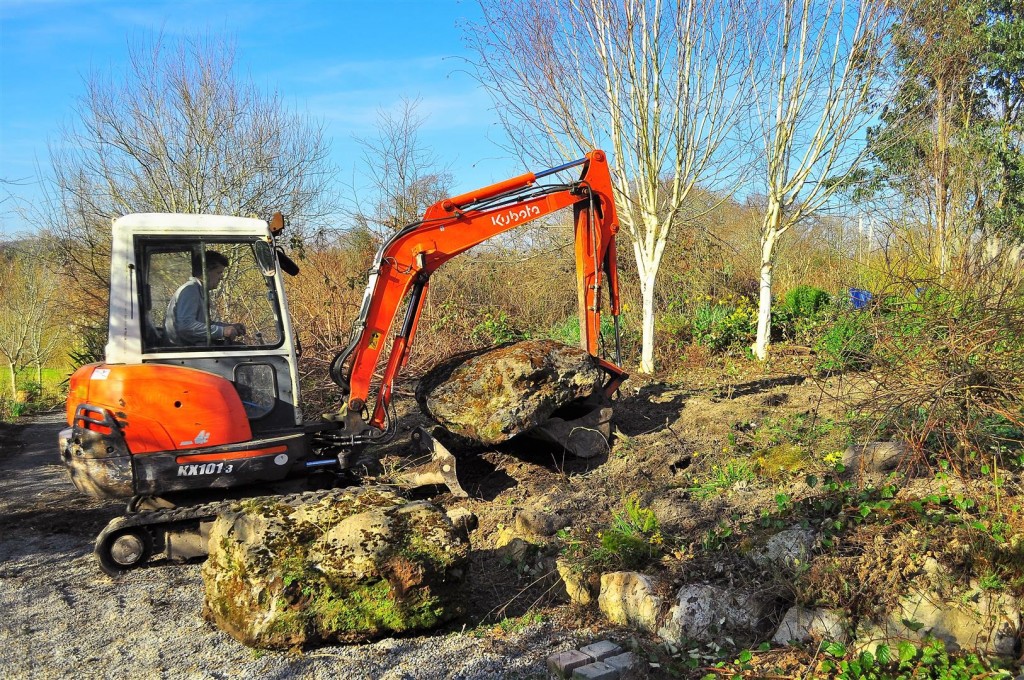
Redesigning the rock garden March 2016

April 2016
The final touches added in July 2016
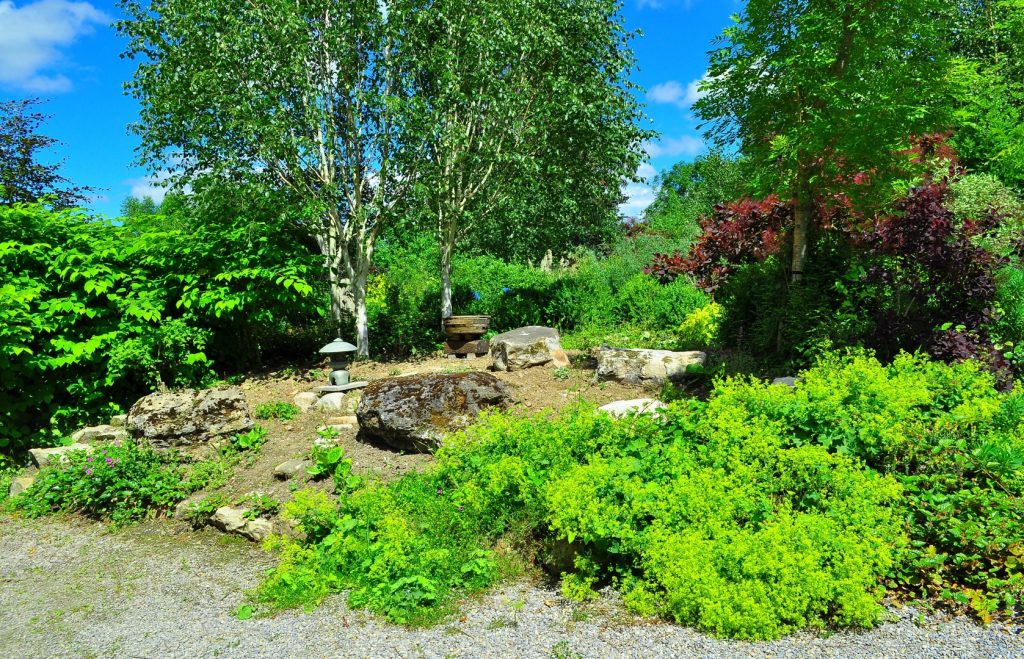
The revamped rockery in July 2016
I am always on the search for antique or unusual items for the gardenand 2016 saw some new additions

An Edwin Luytens inspired garden seat July 2016
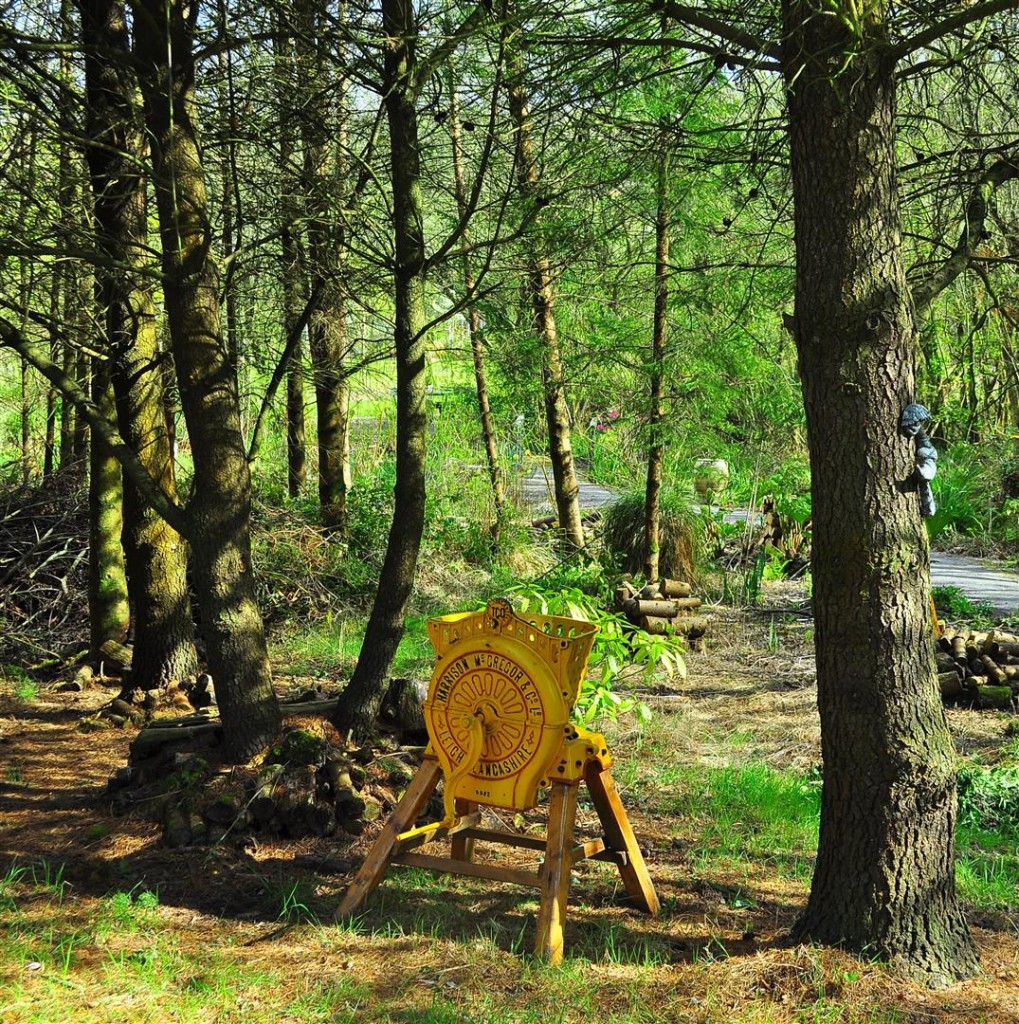
An old mangle grinder bought at a farm equipment auction May 2016
The cannon ball I sourced at the Kilkenny Architectural Salvage Yard , it was found on the sea bed by a diver in 2016 at Rosslare Fort in Wexford Harbour where it had lain undisturbed for over 350 years and was fired by a British Navy ship during Cromwell’s invasion of Ireland in October 1649 .

A cannon ball from Cromwell’s navy 1647 … August 2016
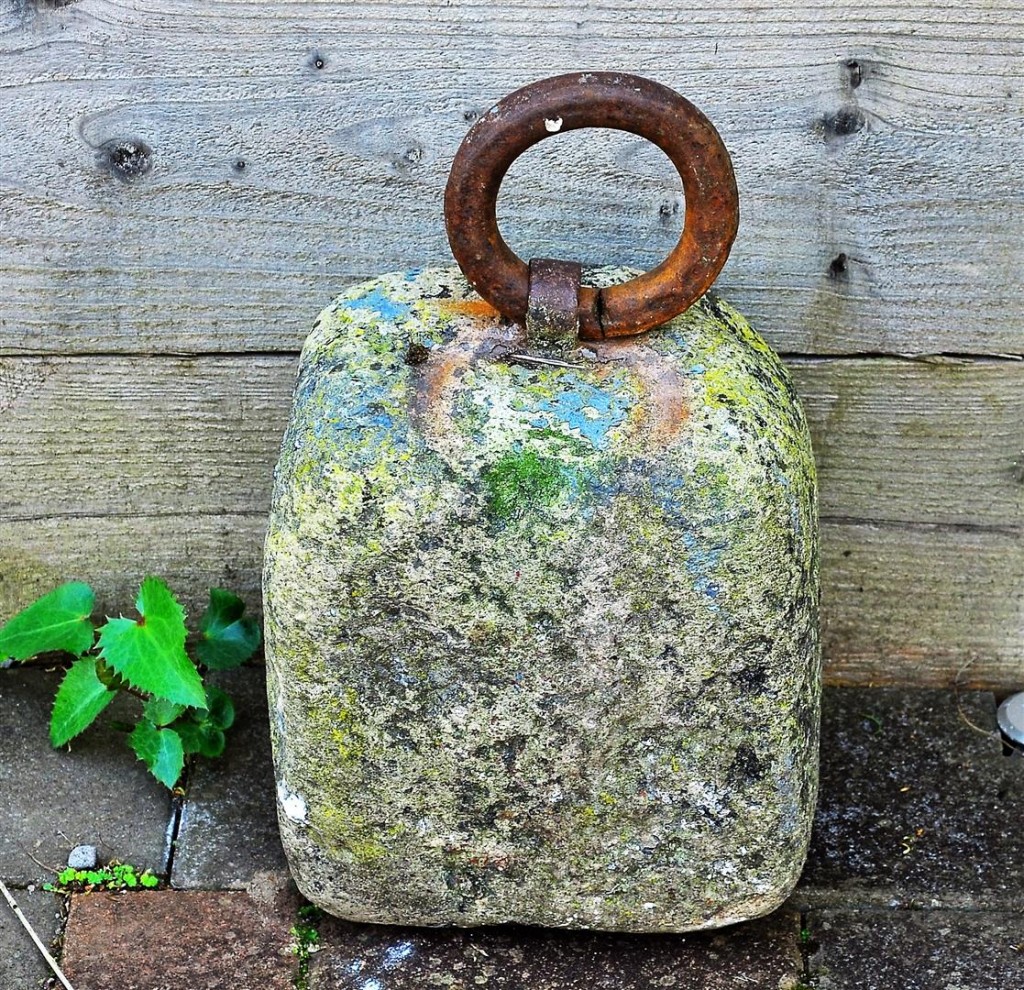
An antique stone horse tether bought at auction in June 2016
This huge piece of pitch pine was under water in the river Liffey at the Dublin Dock wharf for over 150 years and was part of a batch offerred for sale during renovation works and now sits in the Lower Garden .
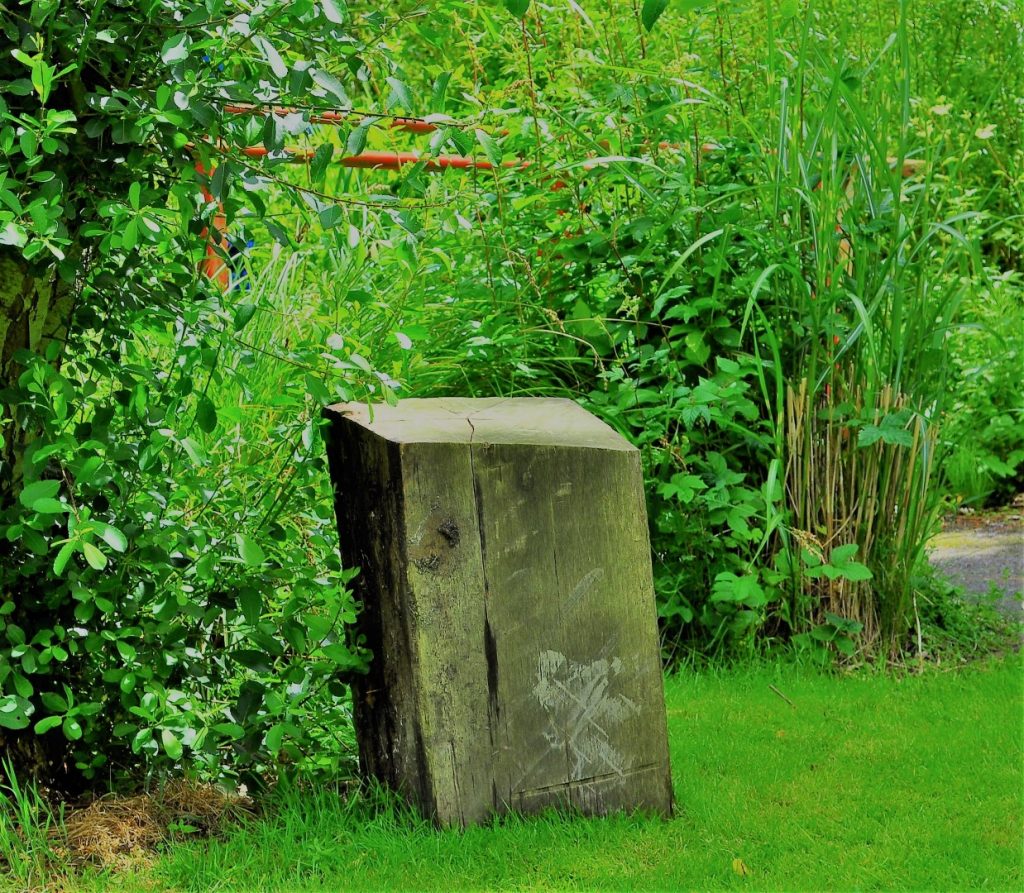
From Dublin Docks in 1850’s to the Lower Garden in 2016
In February 2016 Pascal Mansfield was reconstructing the old Bianconi House in Clonmel ‘s Main Guard and donated two trailer loads of stone from the 200 year old chimney which otherwise was being thrown out and which I was able to use to build five raised beds in the Lower Garden … contrary to my usual inept building skills I can actually build dry stone walls and this is my own work !
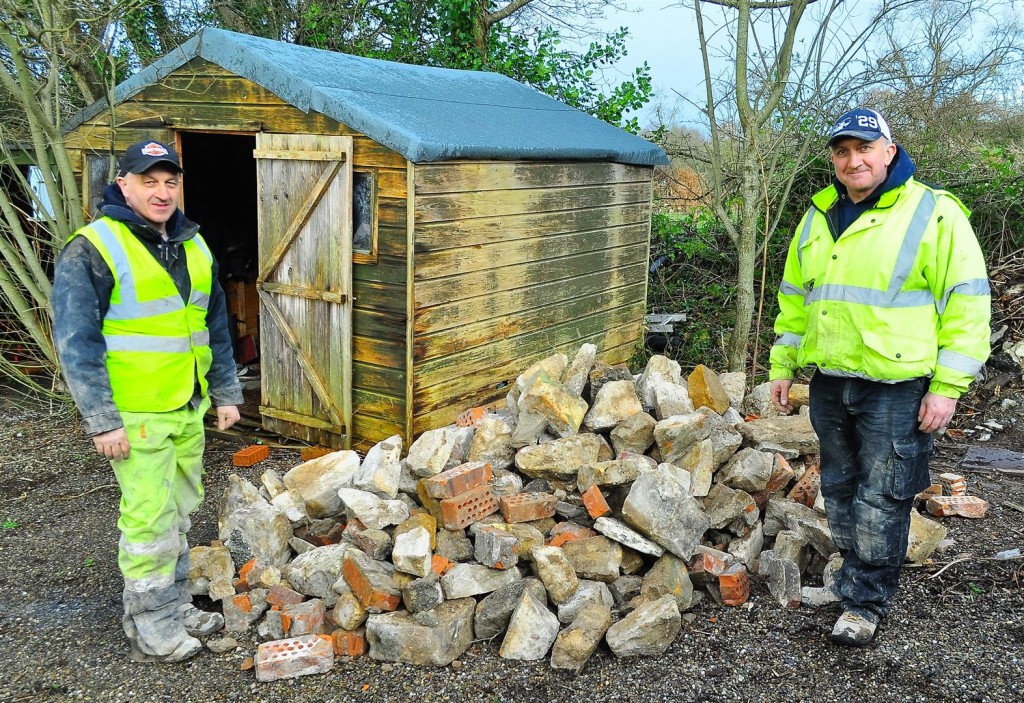
Pascal and Dermot Mansfield deliver the Bianconi stone February 2016
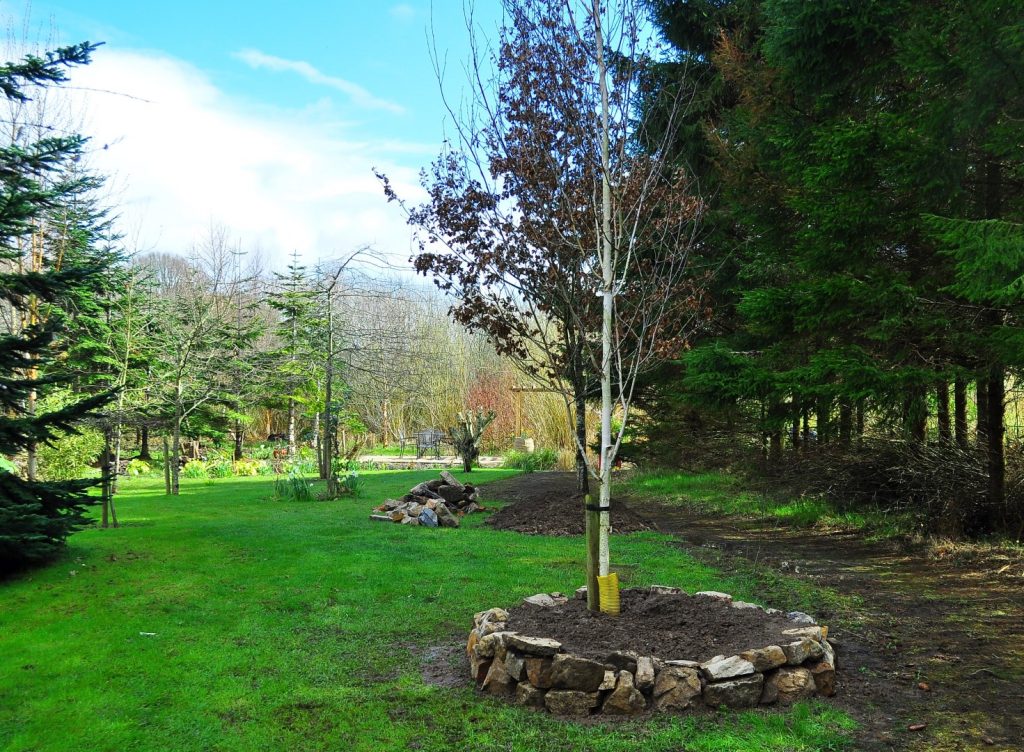
Building two raised stone beds in the Lower Garden March 2016
One of the new raised stone beds planted up July 2016
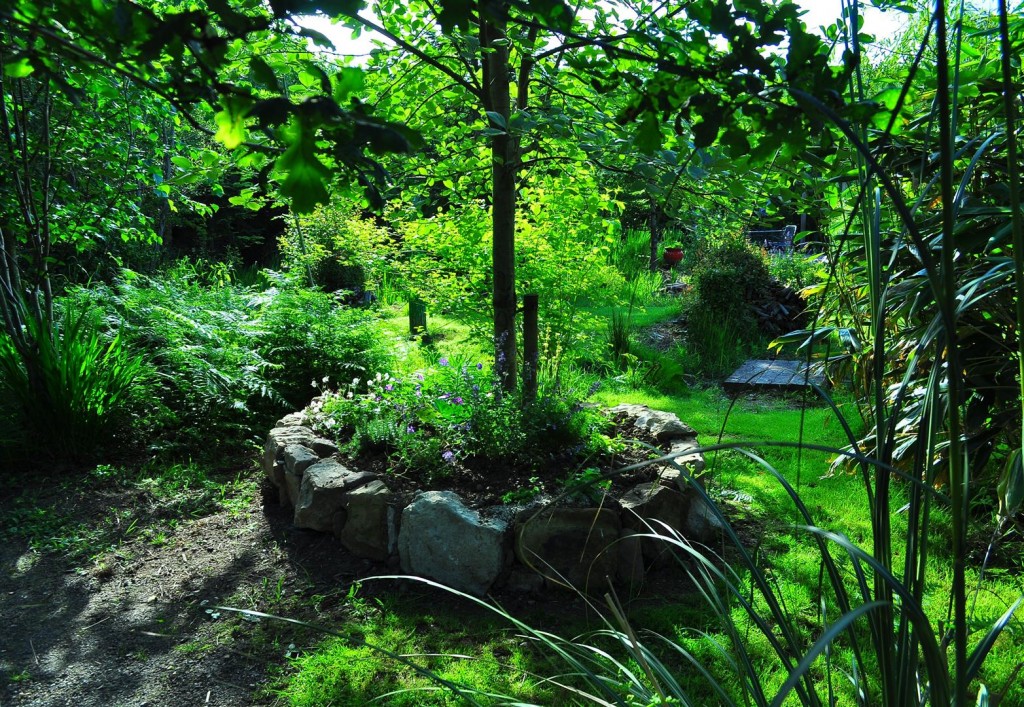
But for the more intricate skilled work in the garden Peter Cullen is always the main man … as when building a stone circle around a red oak tree in the Lower Garden in November 2016 .
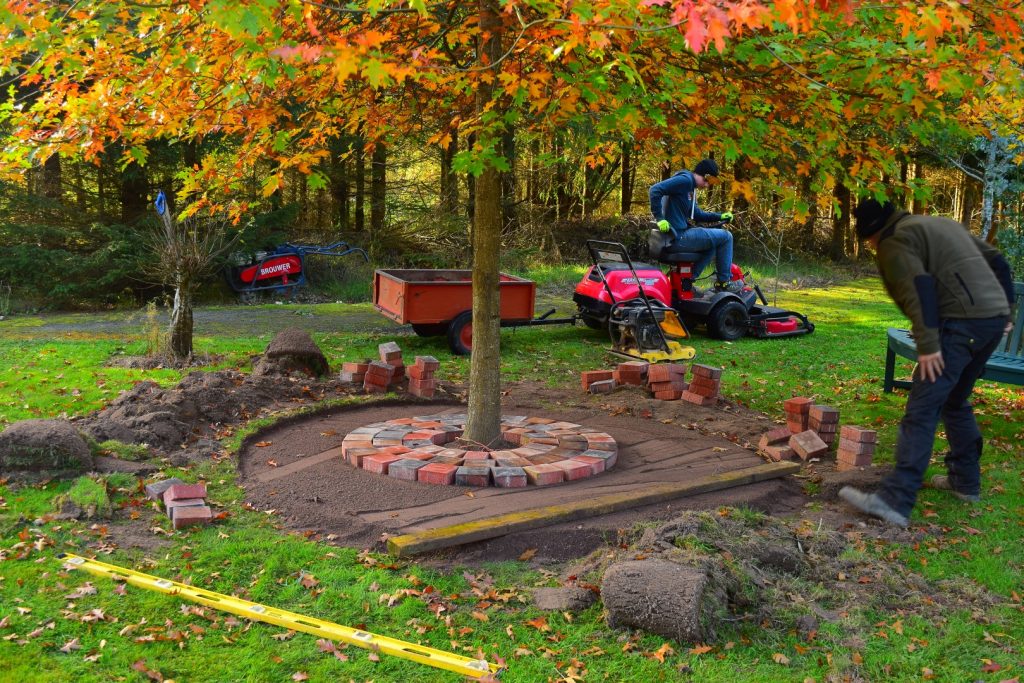
Peter and his son , Mathew , building the new seating area in the Lower Field , November 2016
The final product November 2016 !

The finished product November 2016
The work to keep the garden in shape never ends nor would we want it to and while it is a daily grind to maintain grass , keep weeds down in the borders and along over a kilometre of gravel paths, thin and prune on a regular basis , we both love it and get huge enjoyment from it .
And Toby does help out with the watering in summer .
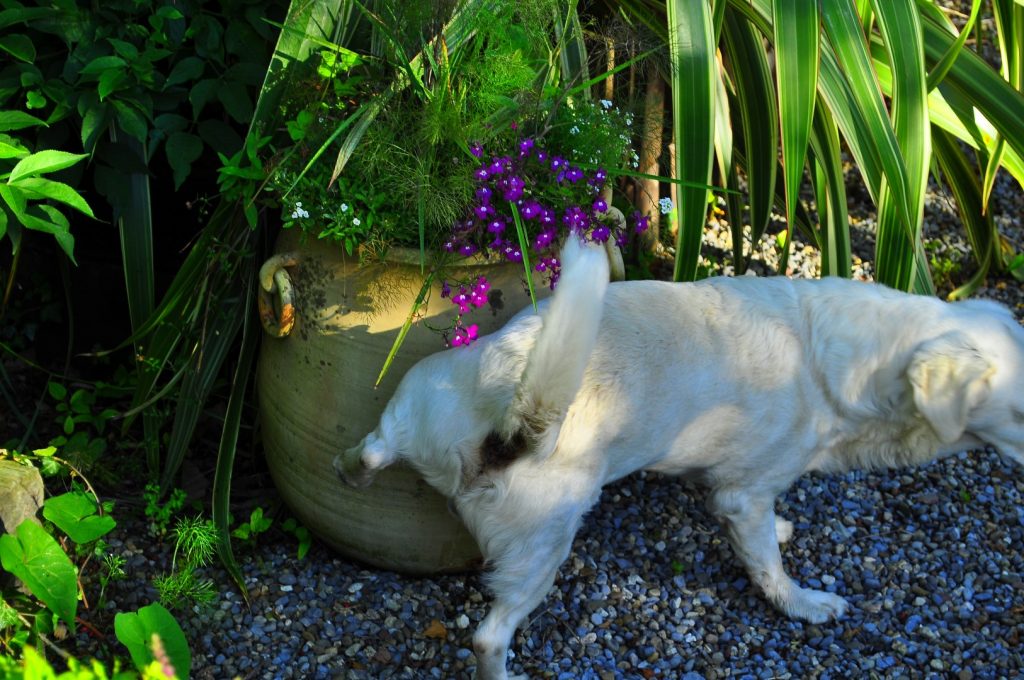
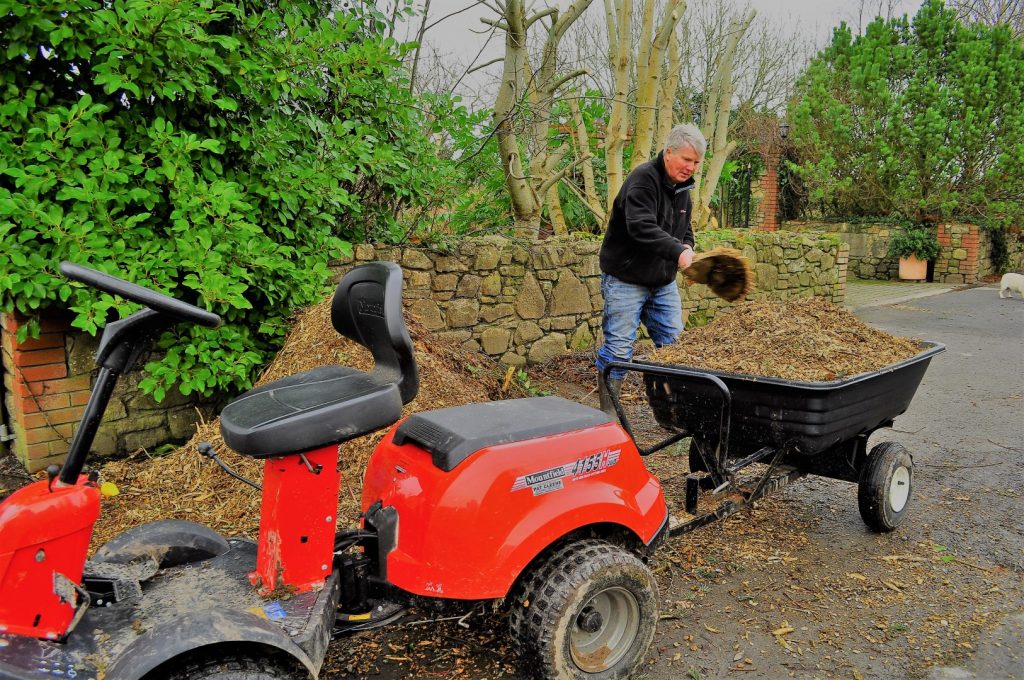
January 2015
While reading through the narrative of the garden you will have noticed that blue is a colour we like to use on garden furniture and pots and even dead trees get painted with it !
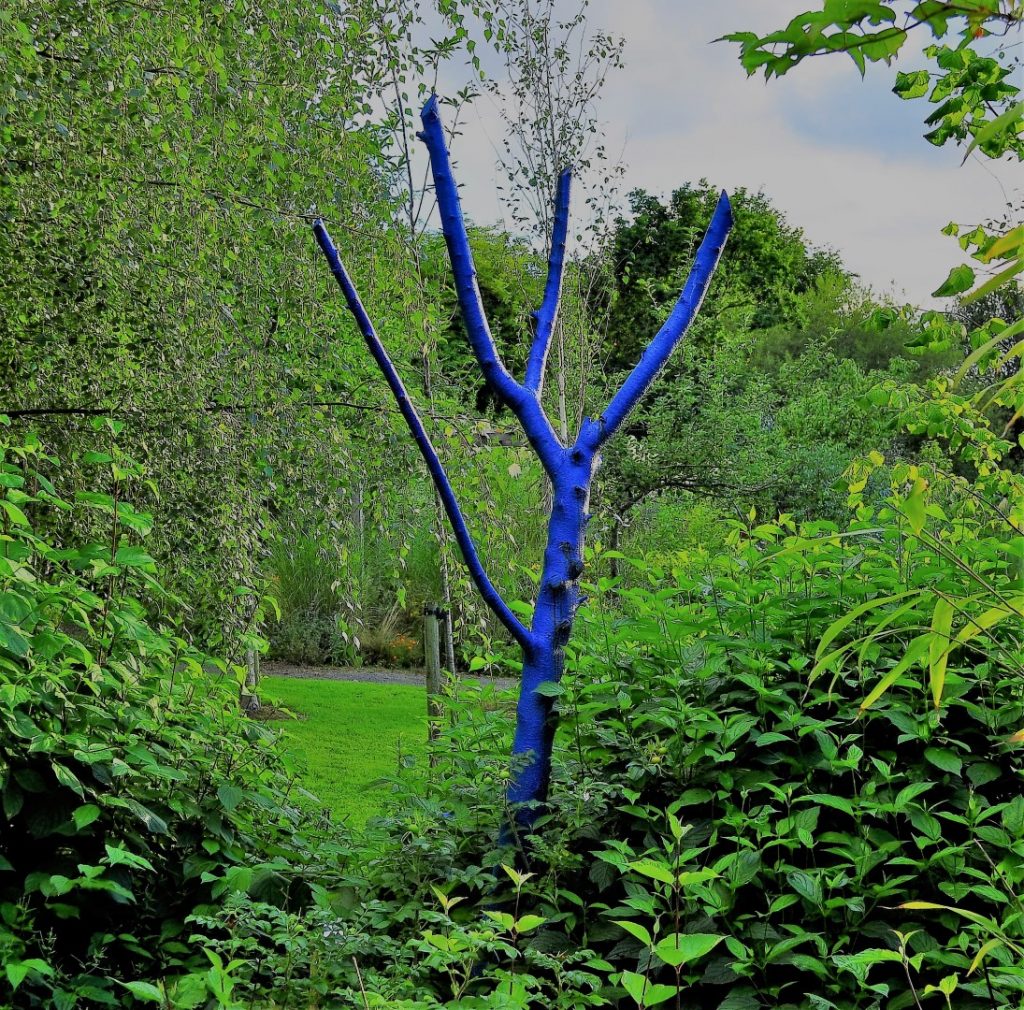
Tree in the top garden July 2016
And that ….. dear readers is the journey we took to build the Garden over the past ten years , that journey continues and already the next chapter is being written !!
You can keep up to date with future progress by reading the regular blogs at www.petrovskagarden.com
The story continues , new trees are planted in the top field as I try to make it more intimate following the building of new paths through it in May 2015 and in the months October 2016 to February 2017 I planted seventeen park land trees such as oak and various beech which will add a canopy of cover as they mature and all the trees were selected on the basis that they will do well in the wet soil of an area which is fed by underground springs , good soil but definitely not dry so right plant right place principle at work here .

Three multi stemmed silver birch are planted January 2017
In Spring 2017 I realised that the banks of cornus planted nine years ago needed some drastic cutting back as I had allowed them to become old and knarly , some with stems as thick as my wrist and they had outlived their purpose and although I loved the leaf colour particularly that of cornus elegantissimus , their winter bark a major part of the attraction of dog woods generally had lost their vibrancy and were no longer their youthful snappy colours … none of us do ! However unlike with getting old ourselves dog woods and most shrubs can be rejuvenated by cuting down to the base so I bit the bullet and cut back severely … not to be recommended as a general rule and it should be done gradually by removing a third of the growth on a yearly basis but these had got out of hand or more to the point I had allowed myself to be distracted … the end result was a general massacre of the dog woods … and it worked as by August 2017 they had put on over a metre of young growth and are looking great again .
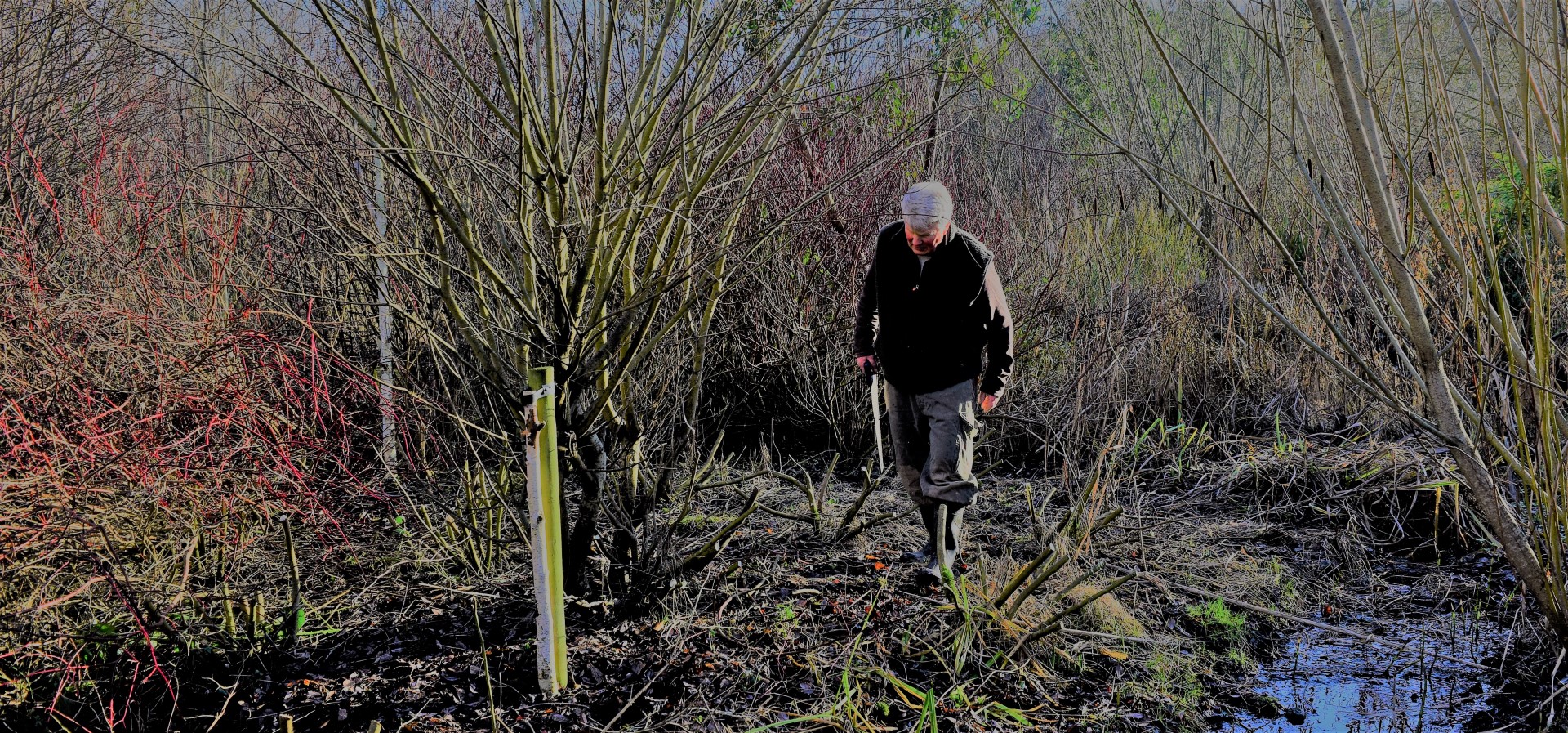
Massacre of the dog woods in the Lower Garden January 2017
July 2017 a new book , The Open Gardens of Ireland
Shirley Lannigan who has written several gardening books and who is a regular contributer to The Irish Garden magazine published a new book in July 2017 , The Open Gardens of Ireland and included Petrovska Garden
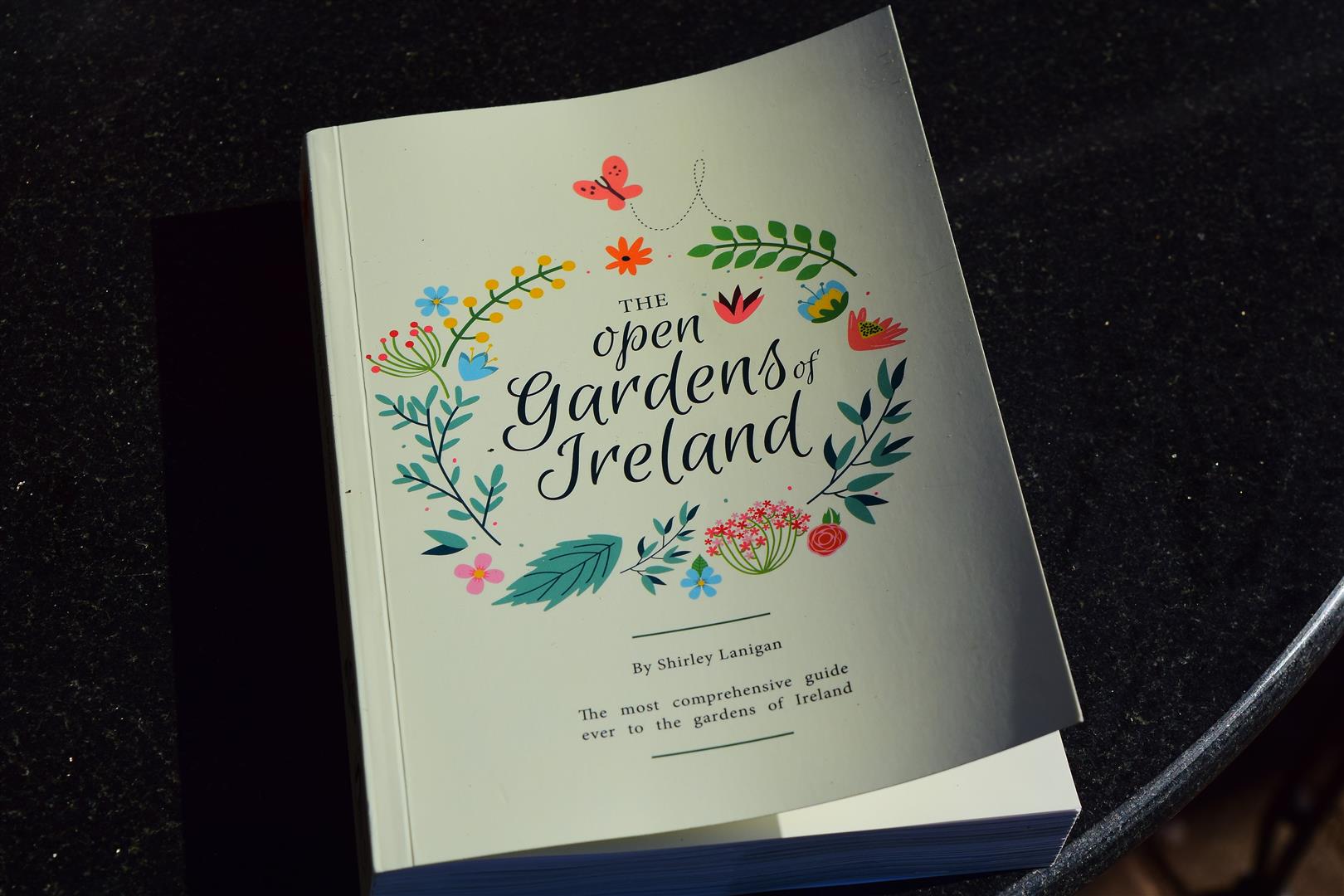

Garden Charity Open Day for Clonmel Lion’s Club , July 24th 2017
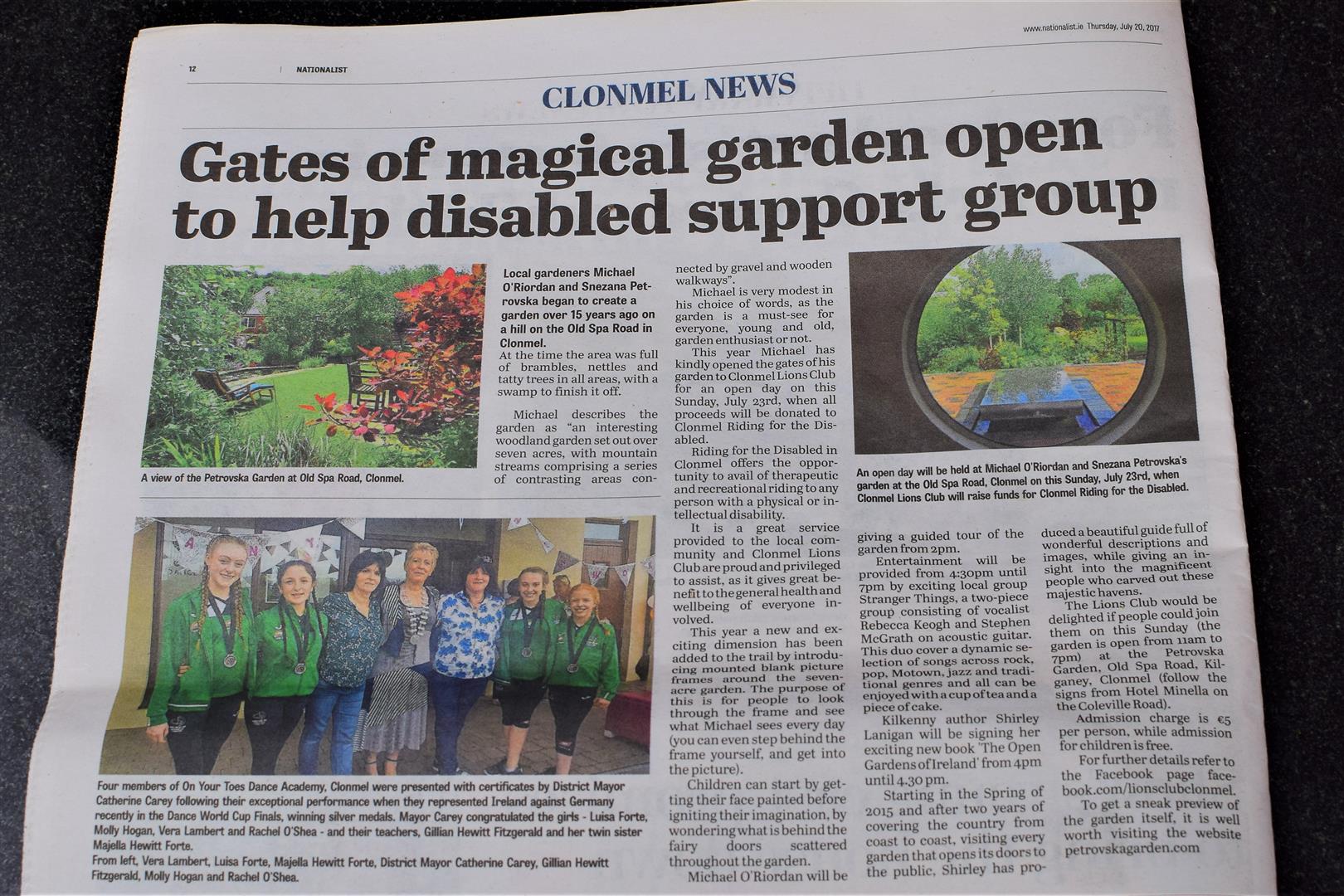
The Clonmel Nationalist , our local paper , have always been supportive , July 2917
Since first opening the garden to the public in 2012 we have been part of the Tipperary Garden Trail which coordinates all seven participating gardens to open for charity for two days on the last weekend in June and delighted we were to be asked to take part however over the years the fixed June weekend did not suit our particular schedules so this year we decided to leave the Garden Trail and hold the annual fund raising event for the Lion’s Club as a pop up event on one day instead of over two days as in previous years , we were lucky with the weather and the people of Clonmel came out in droves with over 300 people visiting the garden and 2000 euros was collected for the very worthy local Clonmel charity , Riding for the Disabled .
Snezana and I prepared the garden but the real work was done by the two fabulous committees who set up a marquee , organised face painting and Fairy doors , baked cakes ,scones and buns , made tea and coffee on a scale not seen since the loaves and fishes back in biblical times
The local Clonmel group Strange Things and Twiggy who sang their hearts out for free and the well known Kilkenny gardening writer , Shirley Lannigan, introduced her new book The Open Gardens of Ireland and made herself available for questions on gardening throughout the afternoon .
There was a terrific ambience and laid back feeling about the day , everybody enjoyed themselves and providing our garden as a back drop for such an event and for such a worthy cause confirmed all our feelings about why we created the garden in the first place back in 2006 .
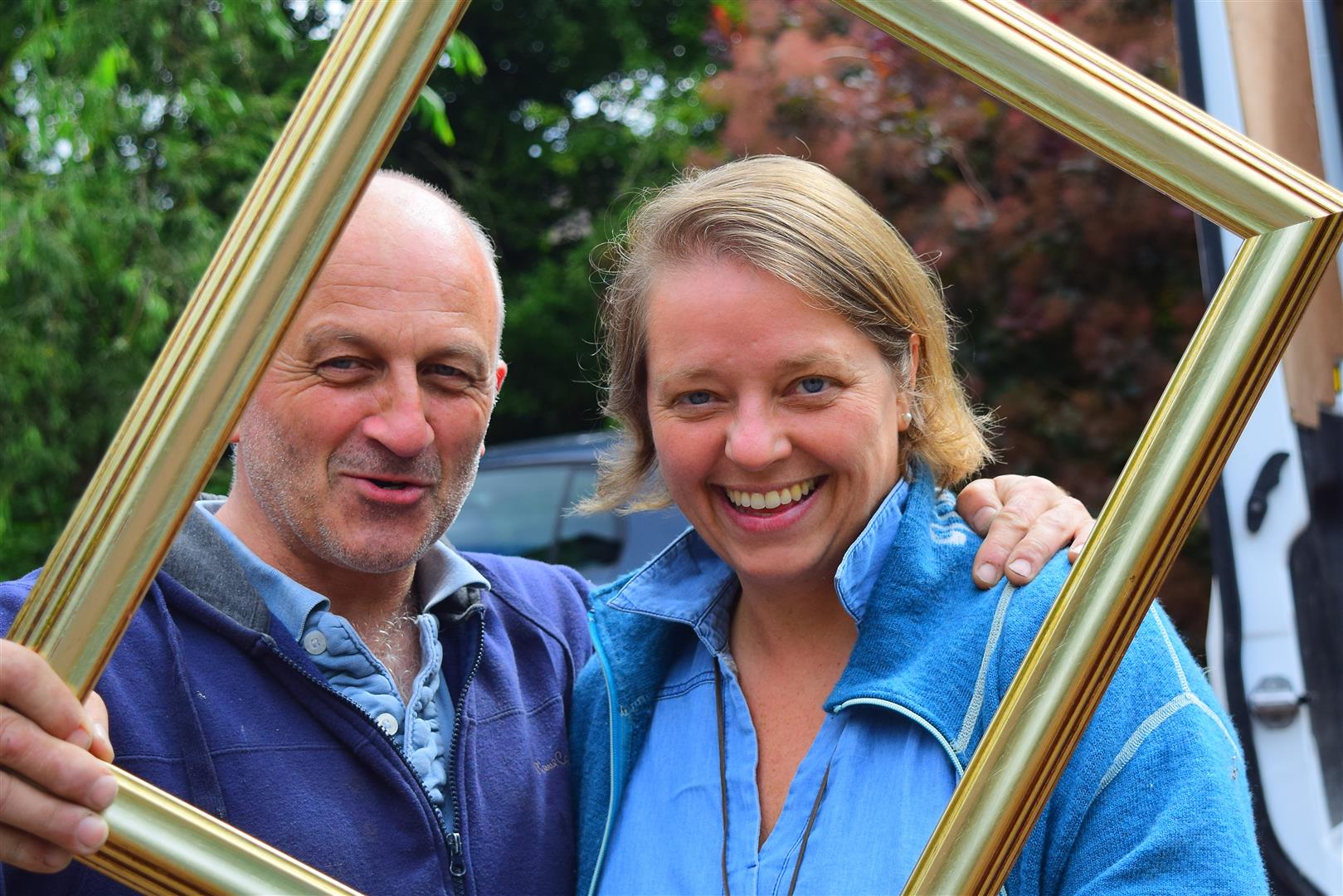
Pascal Manfield of Clonmel Lion’s Club and Caecilia van Peski , from Holland get into the frame , July 24th 2017
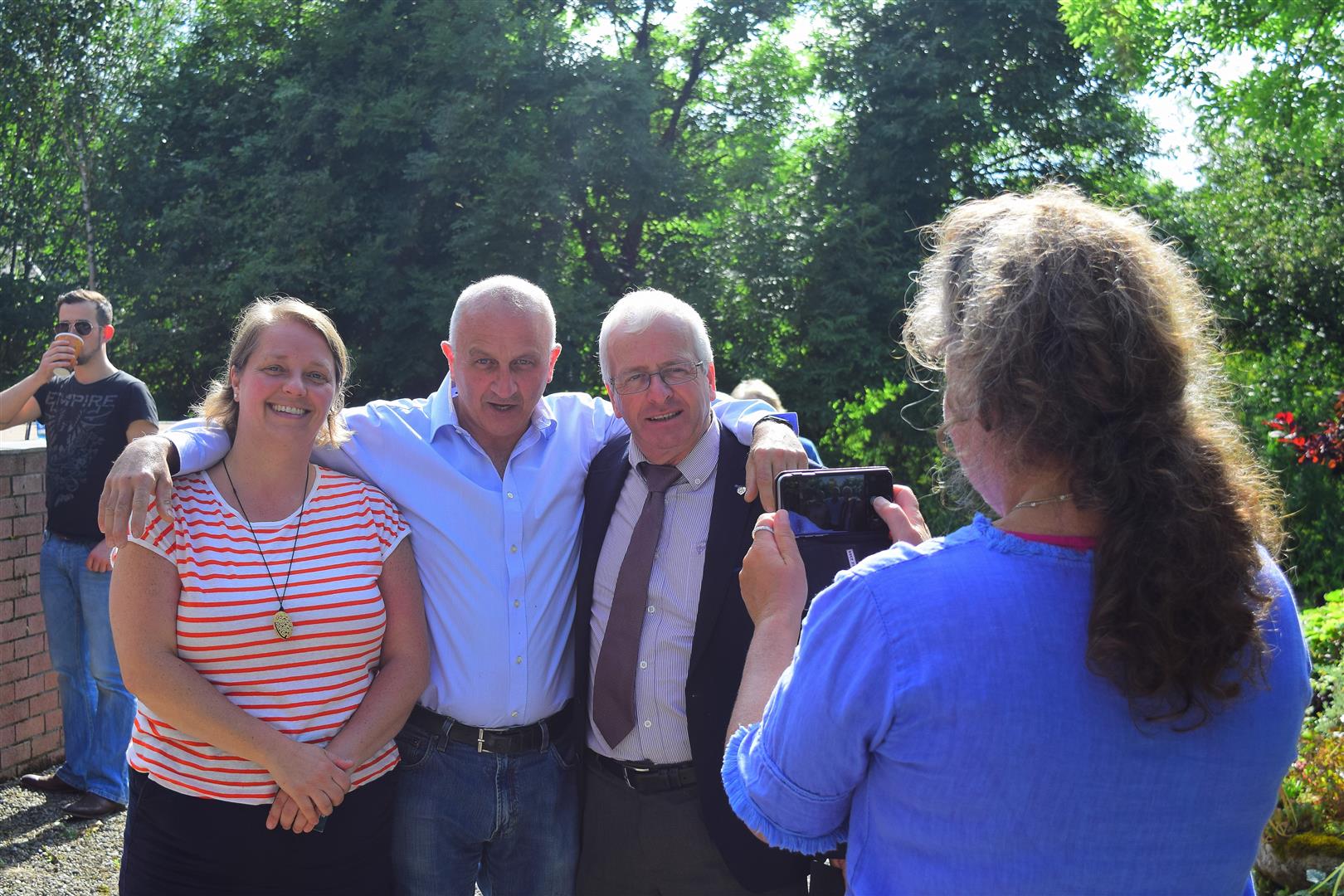
Local TD , Mattie McGrath , lends his support at the Garden Open Day , July 24th 2017
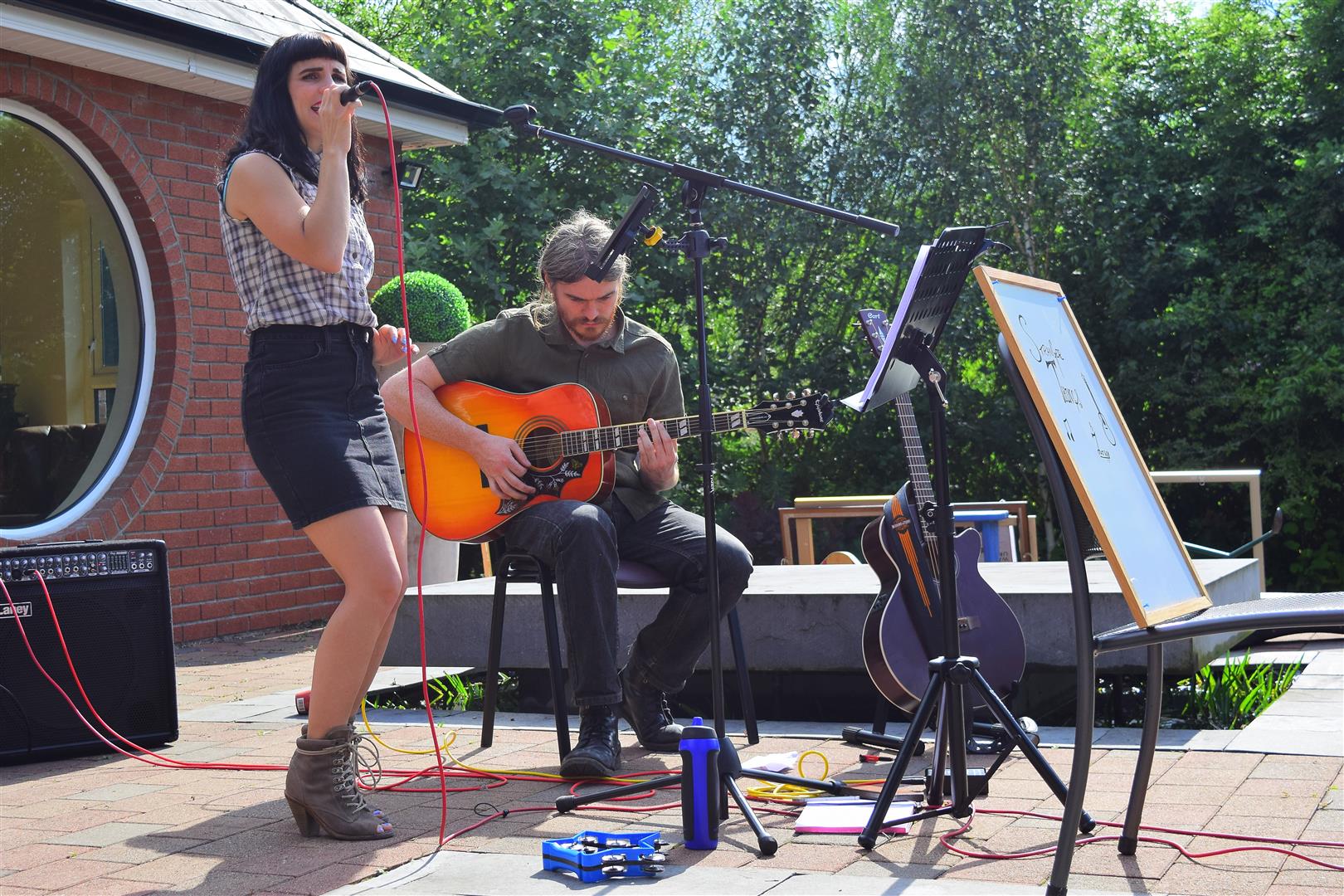
Local group , Strange Things , give it a go for charity , Garden Open Day July 24th 2017
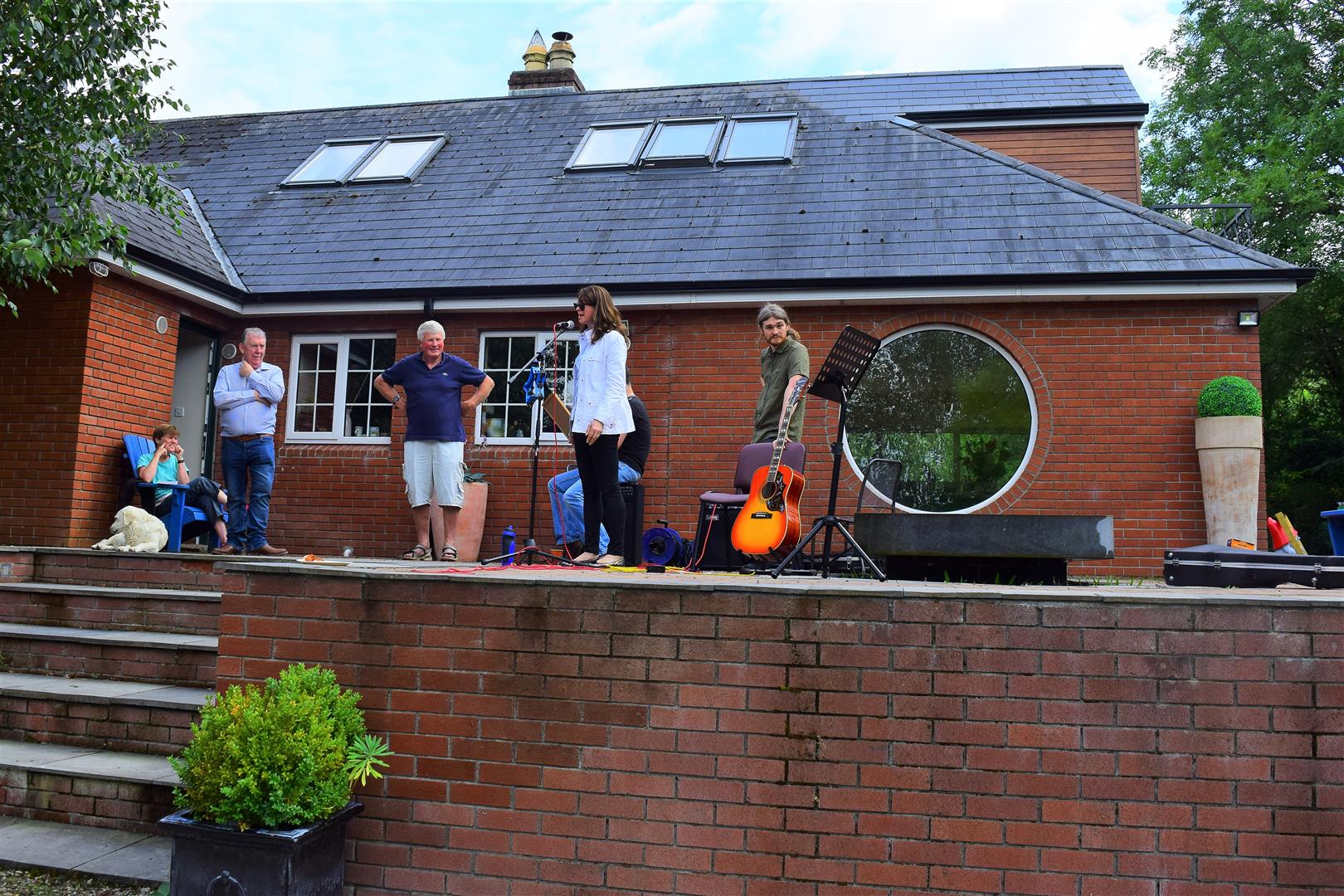
Shirley Lannigan , author of the Open Gardens of Ireland , launches the book in the Tipperary area , Garden Open July 24th 2017

Faces were painted at the Garden Open July 24th 2017
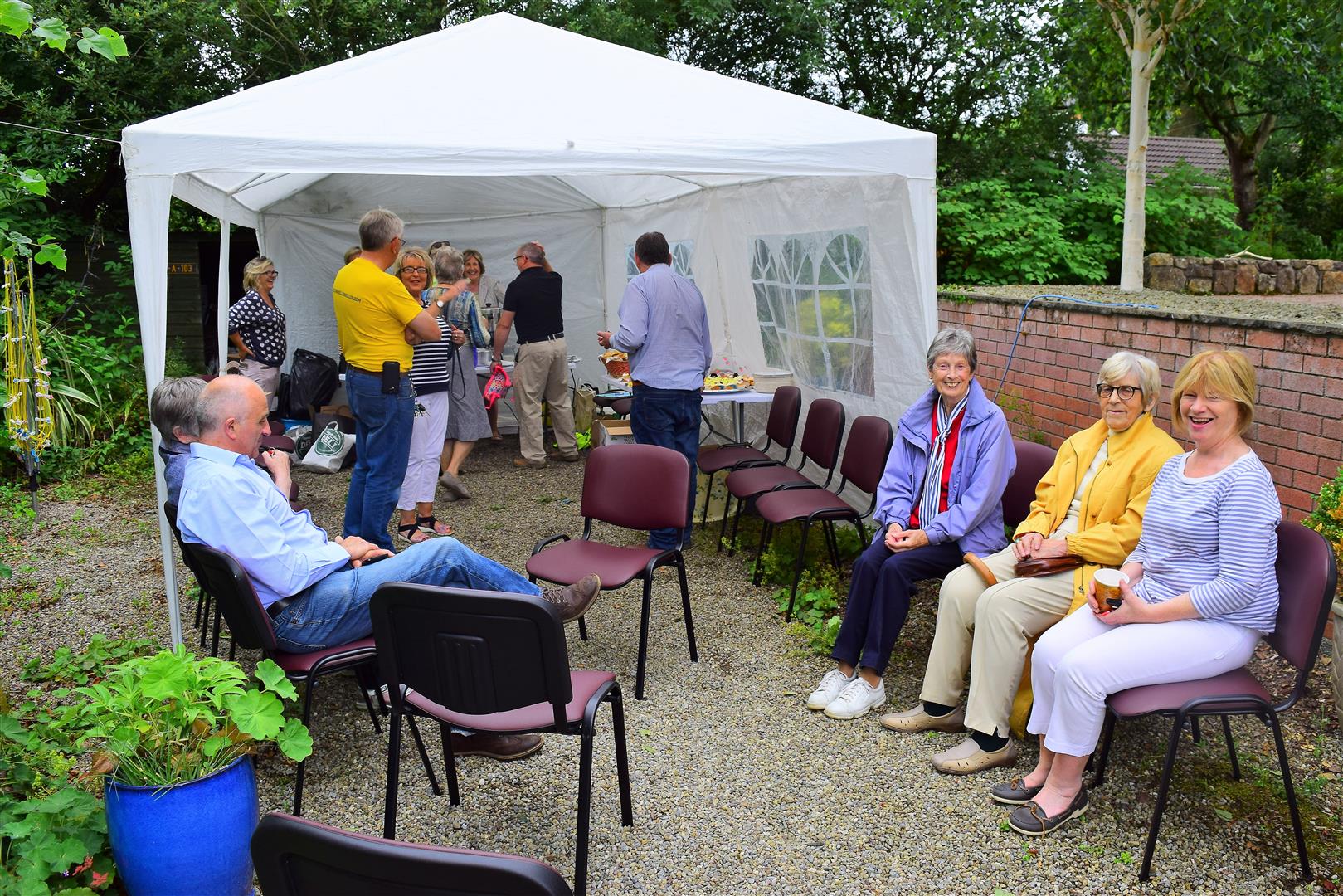
Noted Clonmel gardeners such as Janet Shiels , Mary O’Donovan and Mary Feeney gave their support

Aishling and Keeling brought their Dad , Conrad’s home baked cakes to the Garden Open Day July 24th 2017
And a cheque for 2000 euros was presented by the Lions Club to the local Clonmel charity , Riding for the disabled on August 8th 2017 .
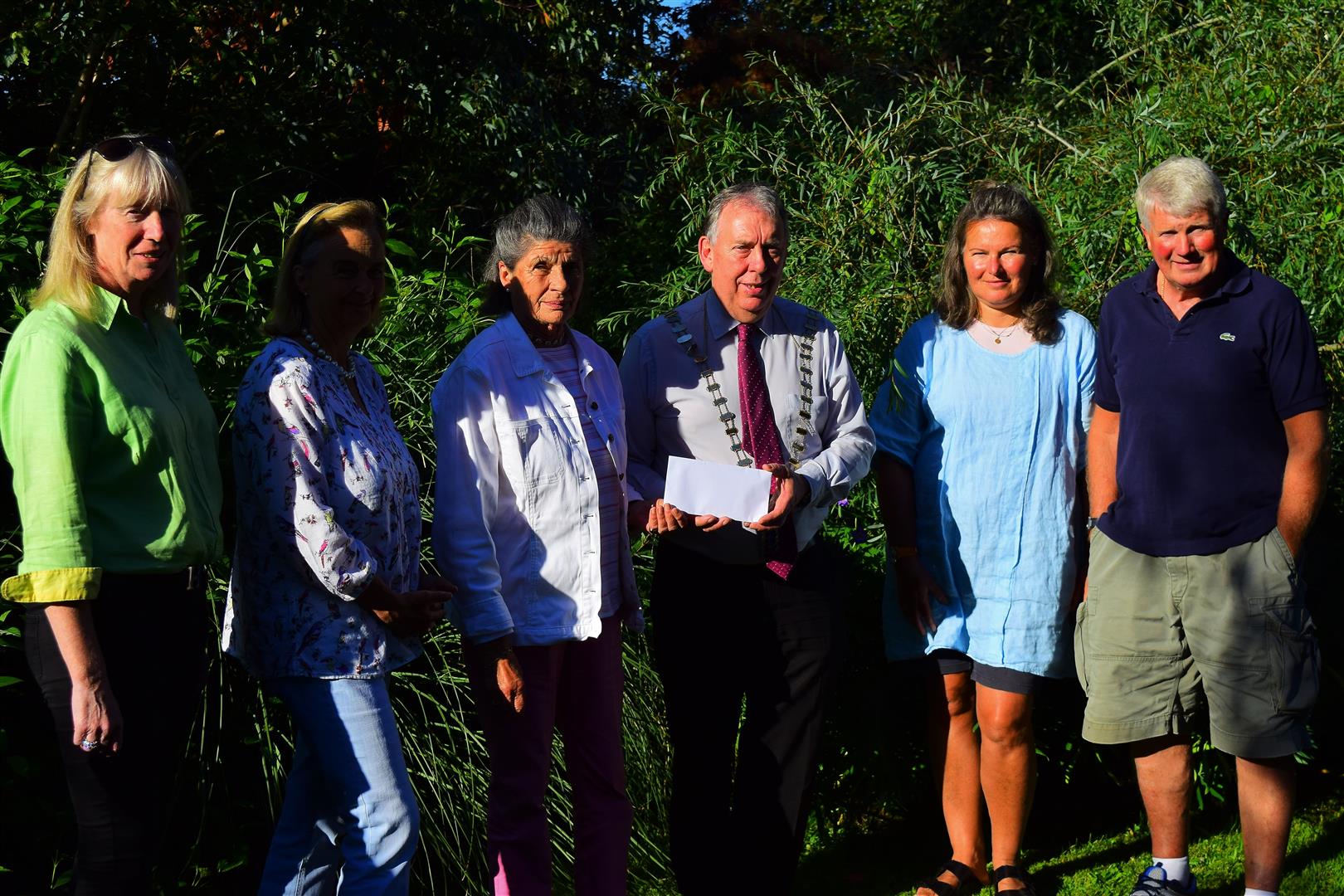
Michael Fennessy , President of the Clonmel Lion’s Club , presenting the Garden Open Day collection to the RDA committee August 8th 2017
Part of the attraction of opening a garden to the public is that you meet fellow gardeners and share experiences in growing different plants and shrubs and while we get most of our visitors in the months of June to August we also get a number of people right up to November and the only months we regard as closed would be December , January and February .
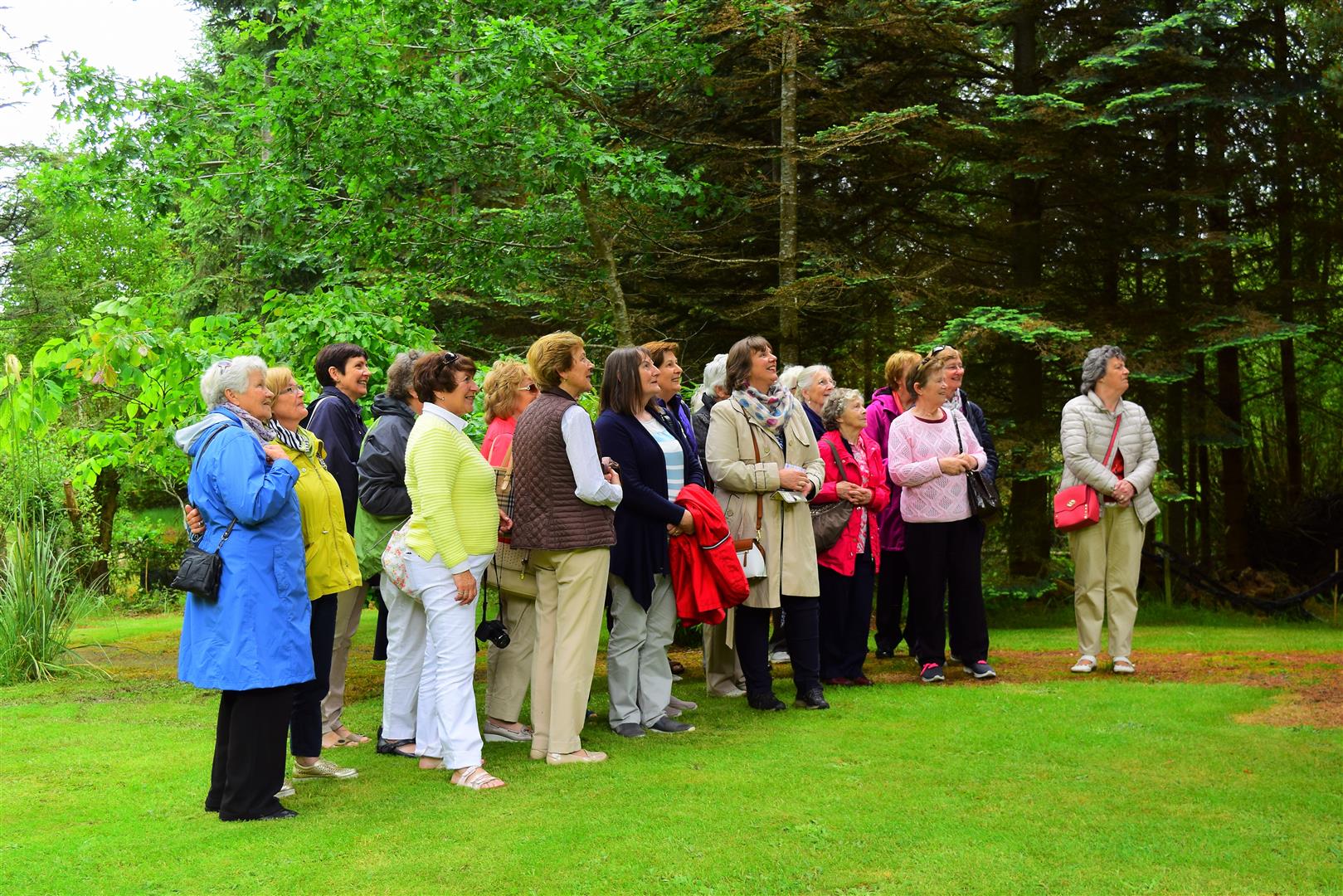
Fethard on Sea & New Ross Mother’s Union group June 2017
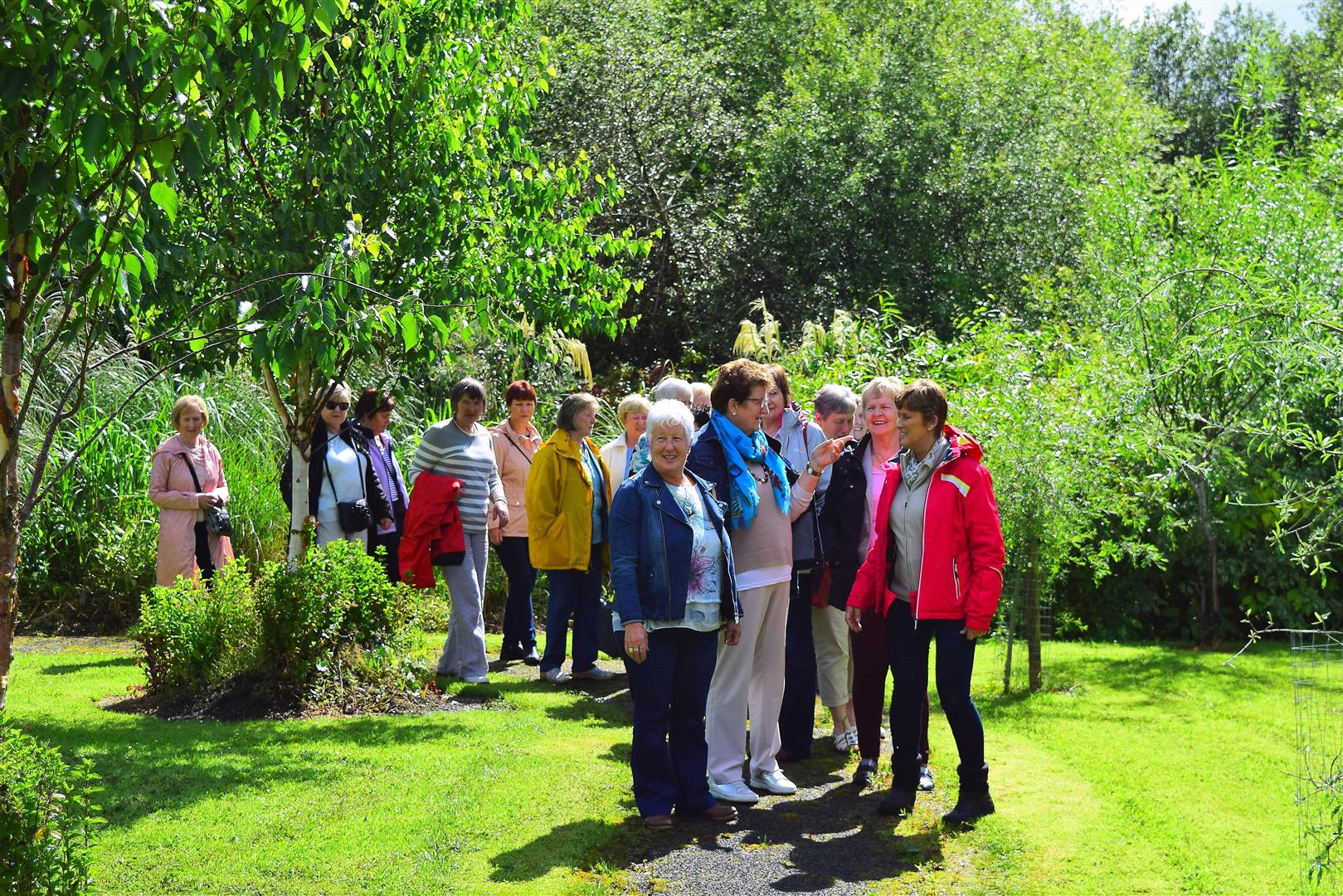
Kinsale Horticultural Society June 2017
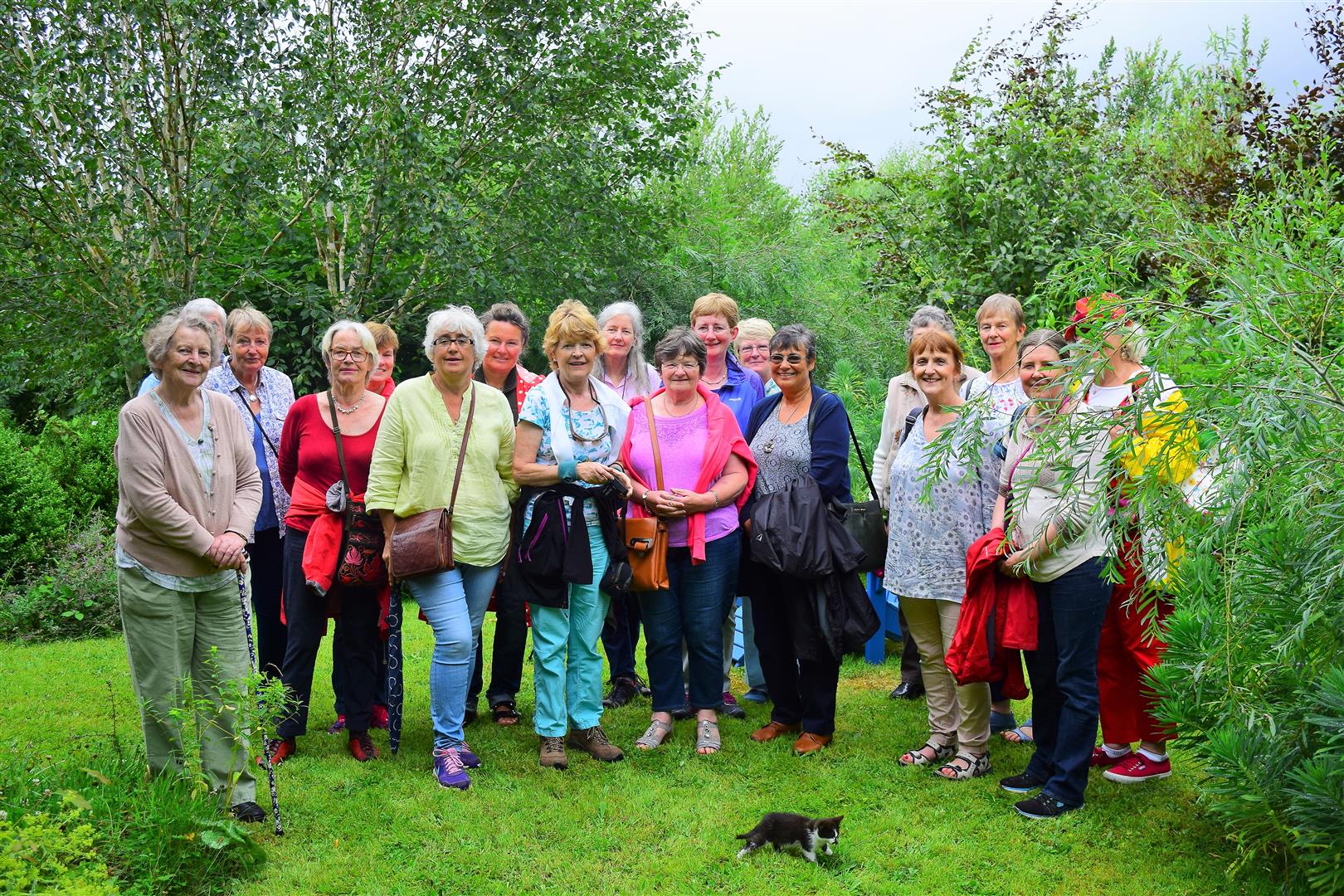
Union Hall Ladies Group July 2017
As part of the Facebook page for the garden I throughout the year occasionally post a feature called A Walk in the Garden where during the course of one day I photograph about twelve photos of various areas that appeal to me on that particular day and the latest is A Walk in the Garden August 15th 2017 .
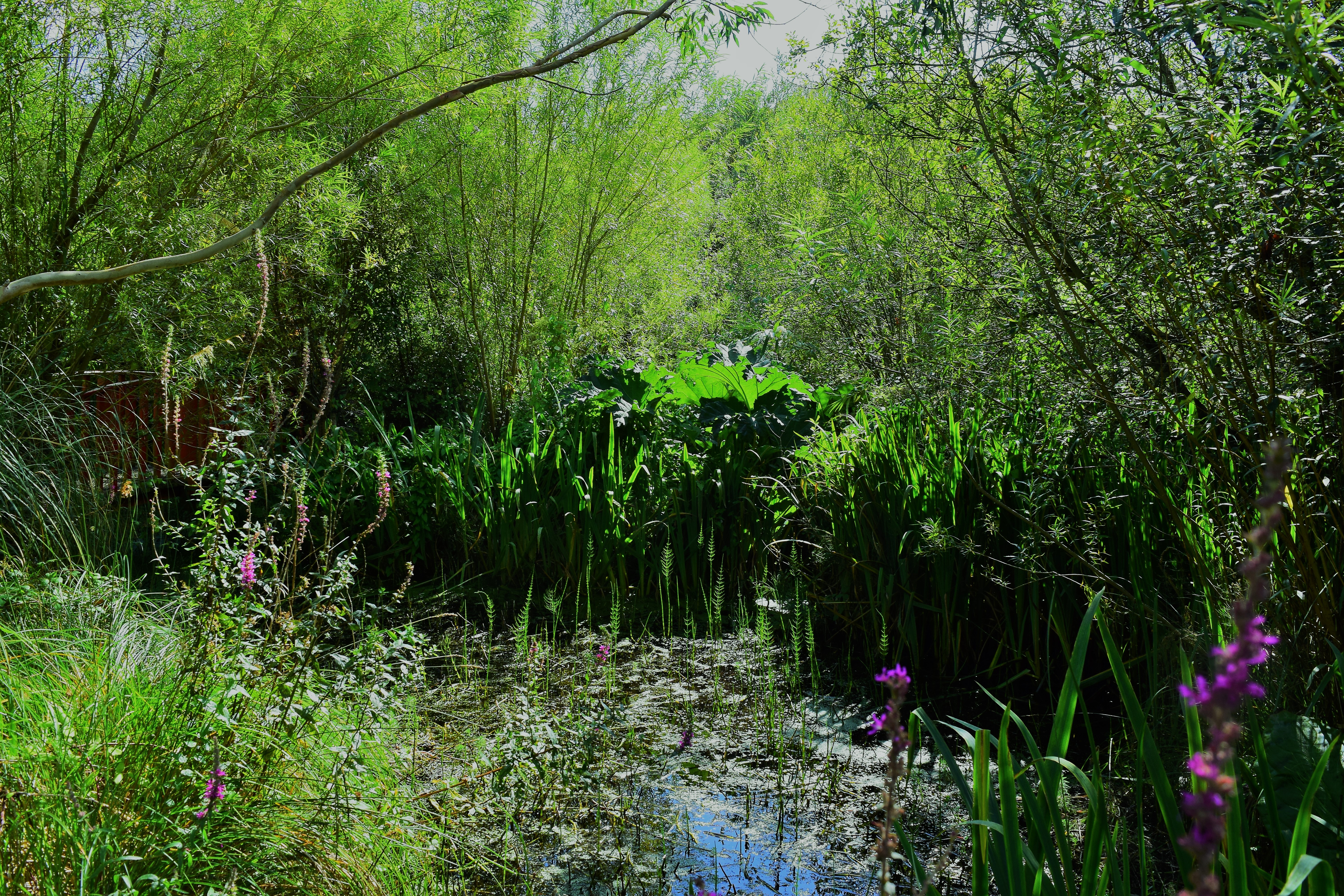
The Water Garden August 15th 2017
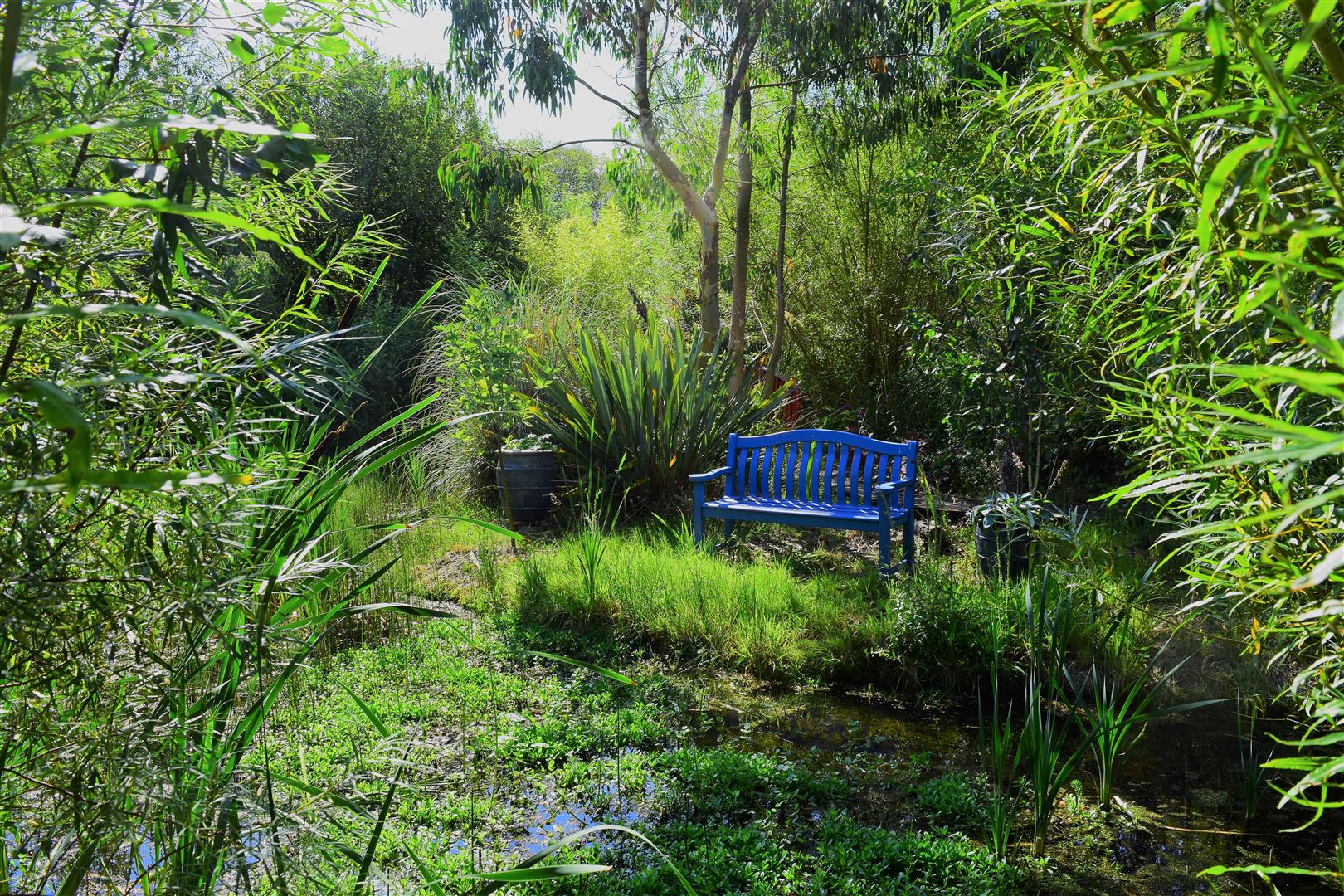
The Water Garden August 15th 2017
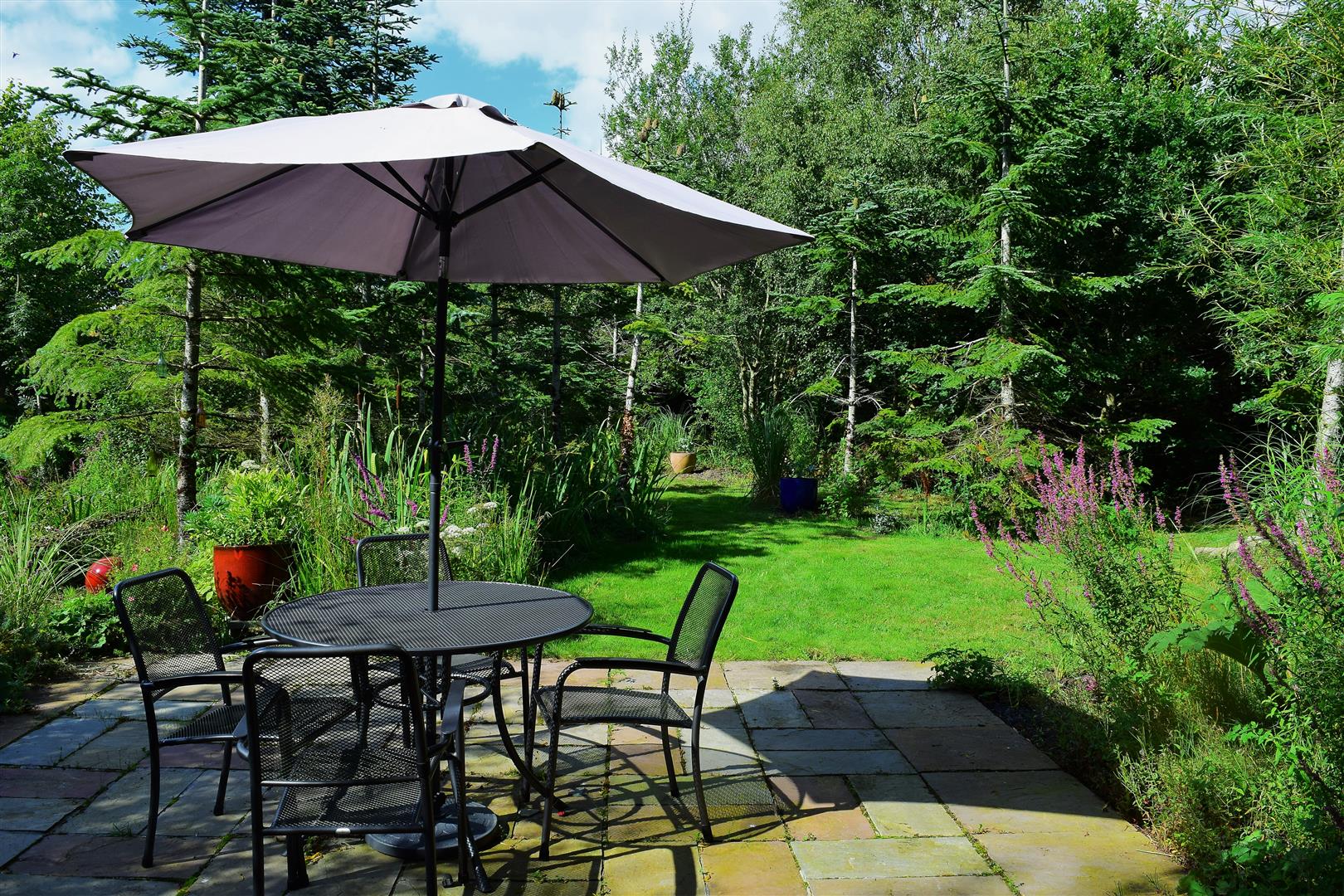
The new patio area which I cleared of three metre high brambles two years ago
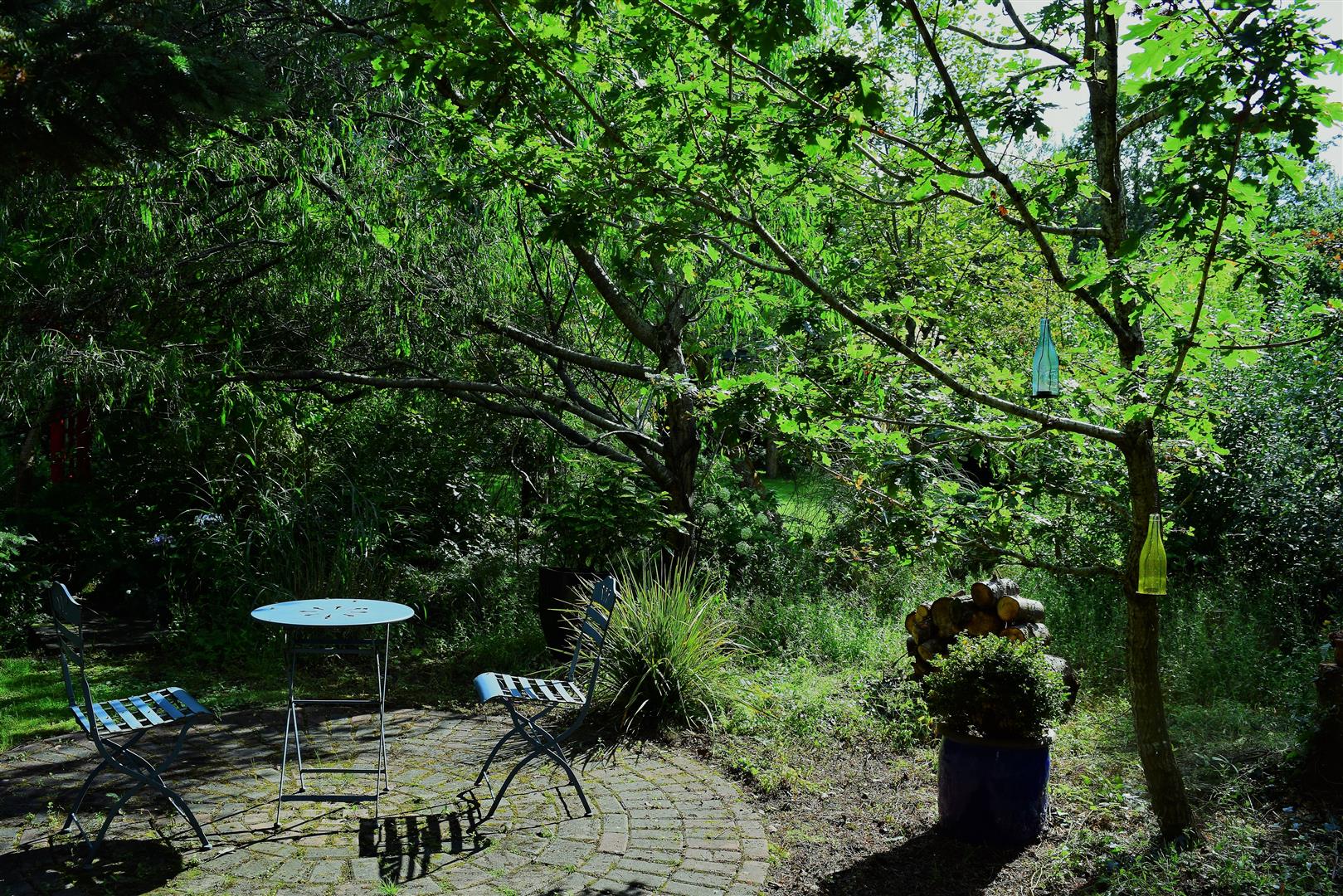
The secret garden , August 15th 2017
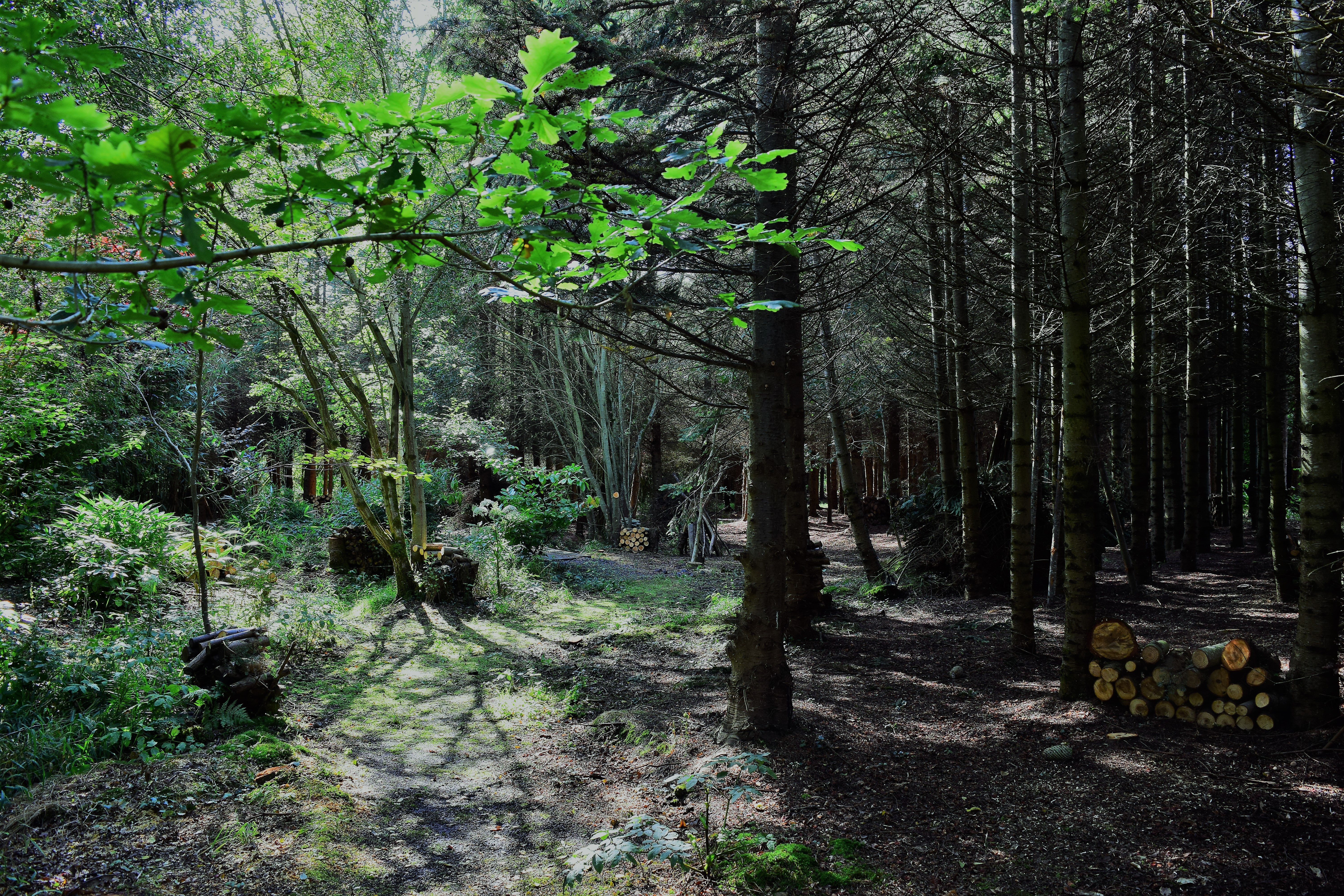
Entrance to the Woodland area August 15th 2017
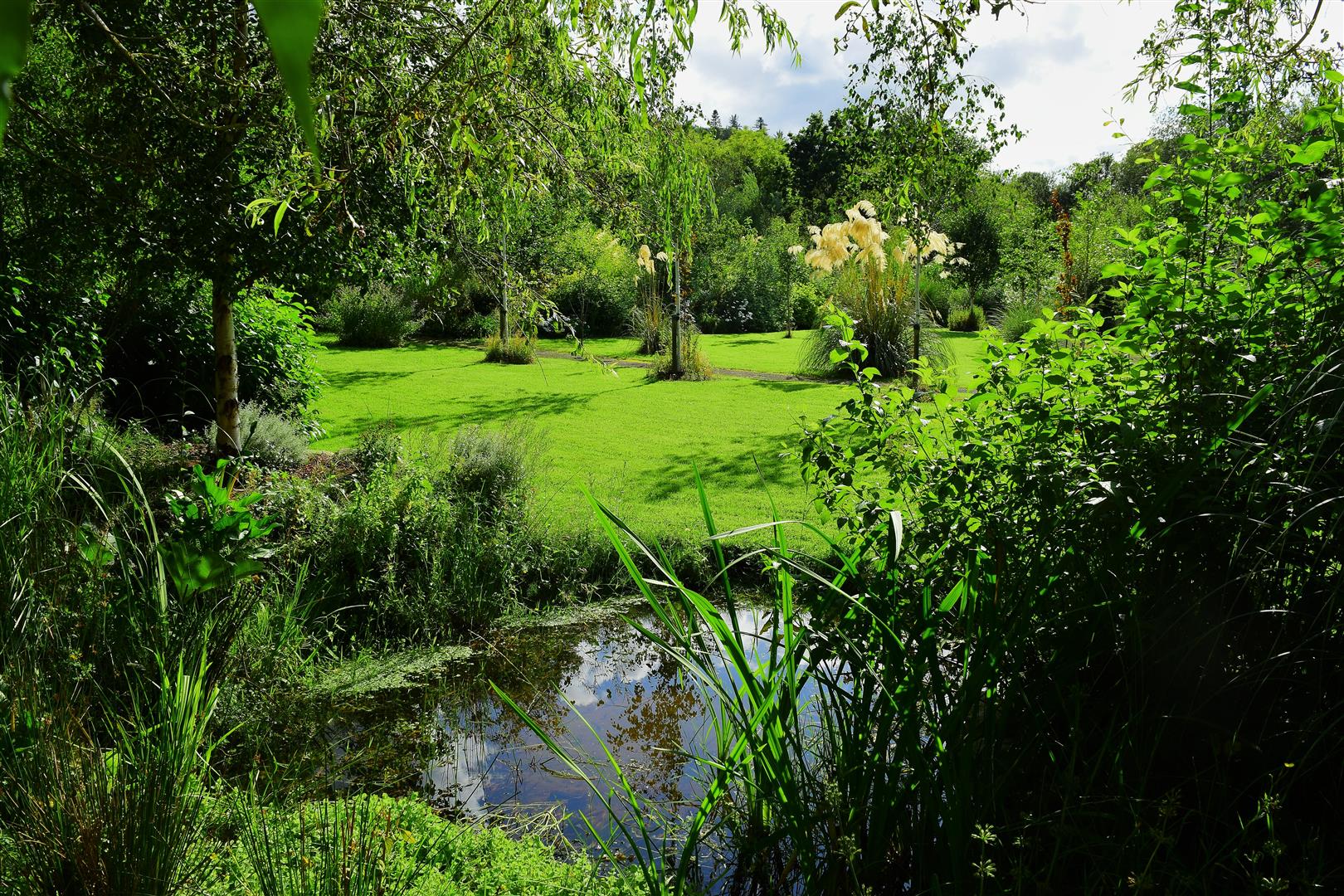
Pond in Top Field August 2017
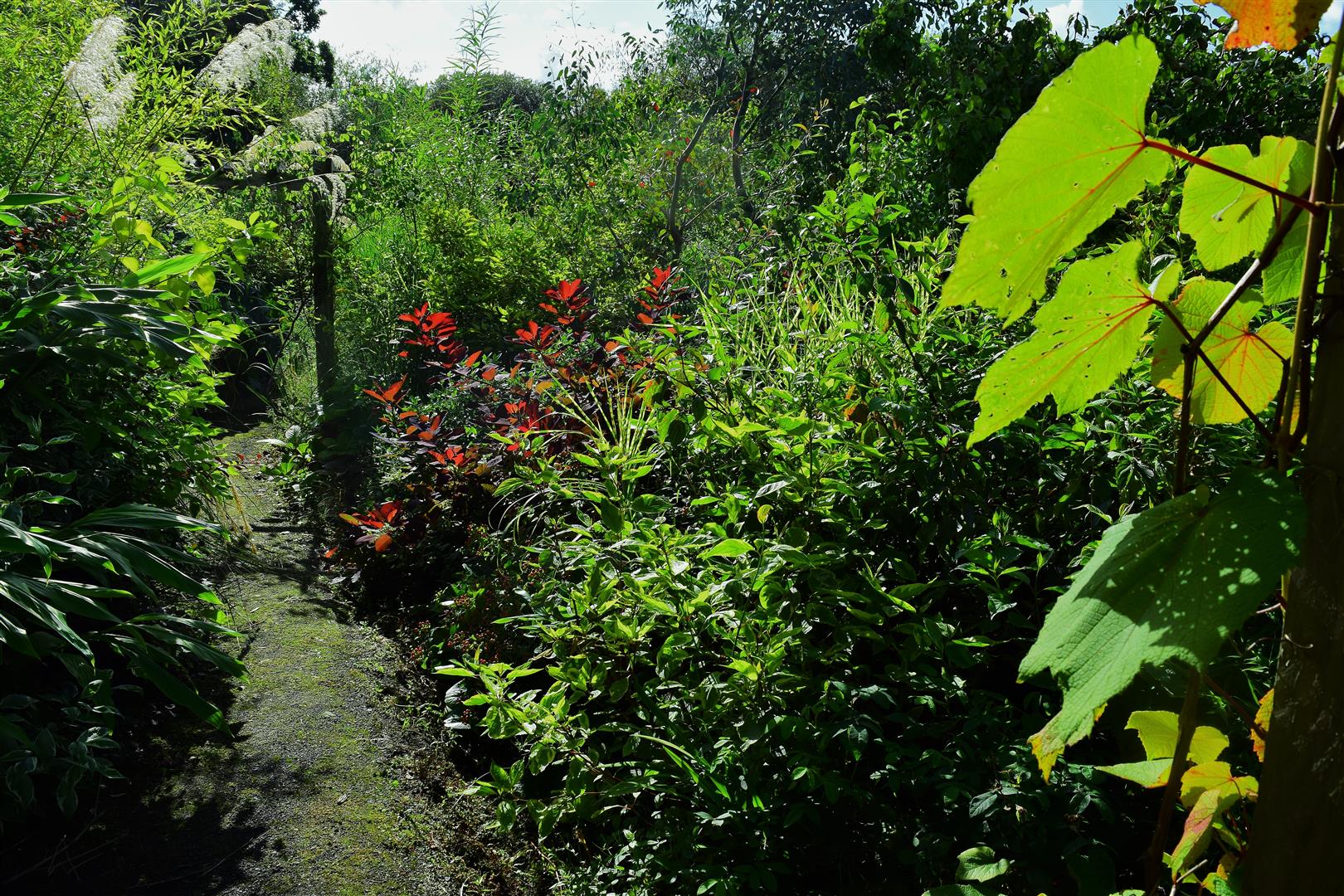
The Grass Border in Top Field August 2017
Hurricane Ophelia hits Ireland in October 2017
Hurricane Ophelia dominated the Irish garden world when we got smacked with it on October 16th when the eye of the storm came through the south and on up through the west over a period of twelve hours leaving a trail of destruction behind . I think the worst was waiting for the first hurricane to actually arrive in Ireland to hit land and there was an eerie calm before the storm and an unusual light for 24 hours before which I read afterwards was from a combination of smoke from the recent forest fires in Portugal mixed with sand from the Sahara whipped up by the outside swirls of Ophelia . It was Ireland’s first experience of an actual hurricane and we had no clue what would happen or how much destruction it would cause , we had all seen on TV the results of hurricanes that regularly hit the US and Carribean with wide swathes of roofless house and knocked over palm trees and wondered was that our fate also but we got off relatively lucky in the end thankfully and Ireland North and South came through battered and bruised but still standing .
Gardening friends in the Clonmel area lost huge trees but here in our garden we were lucky to get away with the loss of about five conifers and various branches off the eucalyptus , the pergolas of course were stripped of climbing roses but none were lost and it was an easy job to tie them back .
I also lost a native oak which was a self seeded tree of ten years old and the force of the wind peeled it like a banana splitting the tree into three parts and of course the fact that it was in full leaf helped the destruction … gone forever but one has to be philosophical as a gardener and the loss of a big tree like this creates an interesting vacuum in the surrounding area with far more light coming in and changing the ambience of the area .
And now as they say for something completely different !

a Saidu holy man at the Amber Fort in Jaipur, India , November 2017
We were in India in November 2017 and of course visited the Taj Mahal and several gardens during our trip around Rajasthan including the famous Moghul water Garden of the Maidens in Udaipur , all Muslim design as in the Alhambra Garden in Granada where water was an important part of the design .

Taj Mahal , India , November 2017
Later that evening at the Kohinoor Museum in Agra , Snezana got a chance to wear the jewellery of Mumtaz Mahal for whom the Taj was built .
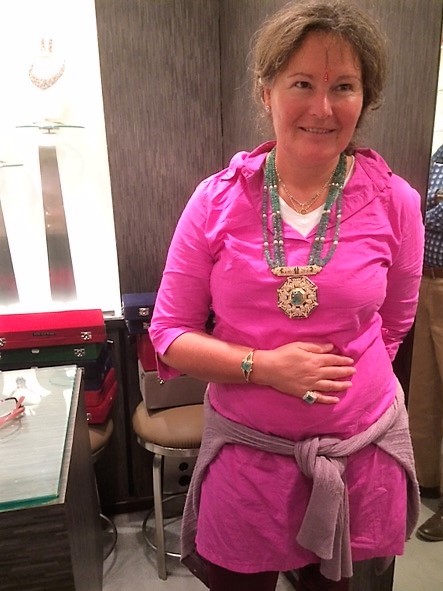
Snezana was asked to model the 17th century jewels of Mumtaz Mahal , November 2017

Garden of the Maidens , Udaipur , India , November 2017

Chatting to two of the gardeners at the Garden of the Maidens , Udaipur, November 2017
India was an exotic experience , none more so than the elephants

The Amber Fort , Jaipur , India , November 2017
Before I leave India and the elephants this is a story I told in my blog in January 2018

At the Amber Fort , Jaipur , India , November 2017
“Apologies for yet another elephant photo from our India trip in November however for some reason today in the garden I remembered an incident back in the early 1980’s when my daughter Claire was six years old and I took her on her own without her brothers to see Duffy’s Circus in Wexford Town and there we sat in the crowd mesmerised by an acrobat riding standing up on the back of a horse as it charged around the ring directed by the ring master with a whip , now Claire was of the age when little girls first fall in love with horse riding and she had taken her first lessons so was obviously entranced by this show of amazing stunt riding when the ring master stopped and asked the audience would anyone like to try this ?!! Claire shot up on her feet and before I could stop her shouted at the top of her voice I WILL … naturally everybody laughed at the sight of such a little girl but the ring master , bless him , took her seriously and called her down where they strapped a safety harness on her and up she was put standing up on this huge horse who promptly took off at a gallop around the ring … naturally Claire took off in the harness flying high above the crowd like tinkerbell … they tried again and she was game each time … all great fun and the crowd loved it and she came back up to our seat thrilled with herself and I was really proud that she had the guts to try it … the elephant came out next and I thought well at least there won’t be any bare back riding around on him but the ring master had another routine where he lay down on the floor of the circus tent , cracked his whip and the elephant lumbered across and stood over him with his huge foot raised over the ring master’s chest , another crack of the whip and he lowered his foot down on the ring master’s chest to a huge Aaaaah from the crowd then stopped and held his foot just inches above the ring master’s chest … huge cheers of course but then the ring master got to his feet and asked did anyone in the audience want to try it when before I could grab her six year old Claire shot up and roared MY DADDY WILL !!!!!!
It was a WTF moment but what could I do when your little girl thinks Daddy can do anything ? And yes I lay down on the circus floor and yes the elephant stood over me and gently brought his foot down on my petrified chest and in India when I looked into the eyes of the elephant at the Amber Fort in Jaipur my mind went back to a moment over thirty years ago at an Irish Circus !!”
Claire with Daddy in September 1977

With Claire in September 1977
A chain saw moment November 2017 !
November 2017 was the month I finally gave in and bought Snezana the birthday present she has wanted for the past fifteen years … her very first chain saw ! I am pathologically afraid of chain saws having in my early gardening years had a close call with one when it sliced right through my boot and ever since have refused to use one but she has been banging on about a chain saw for years so eventually last month we got one of the new battery powered ones which are a step down from the lethal weapons of the petrol driven varieties and I have to admit the amounts of small cutting you can get through is impressive and she has quickly become a real meister with it … although when she comes in from the garden I make her hold up both hands and count ten fingers !
Her first week of cutting back the willows was amazing to the extent that I wonder now what we ever did without one for the past ten years as we have been able to cut back the willow stems as thick as your wrist all across the wet areas of the garden and apart from providing a lot of wood for saving it rejuvenates the trees and next season will allow the young whippy growth to come through with brighter bark colour … I have been doing this hard pollarding as much as I could each winter with a hand saw but this chain saw is as they say the bees knees .
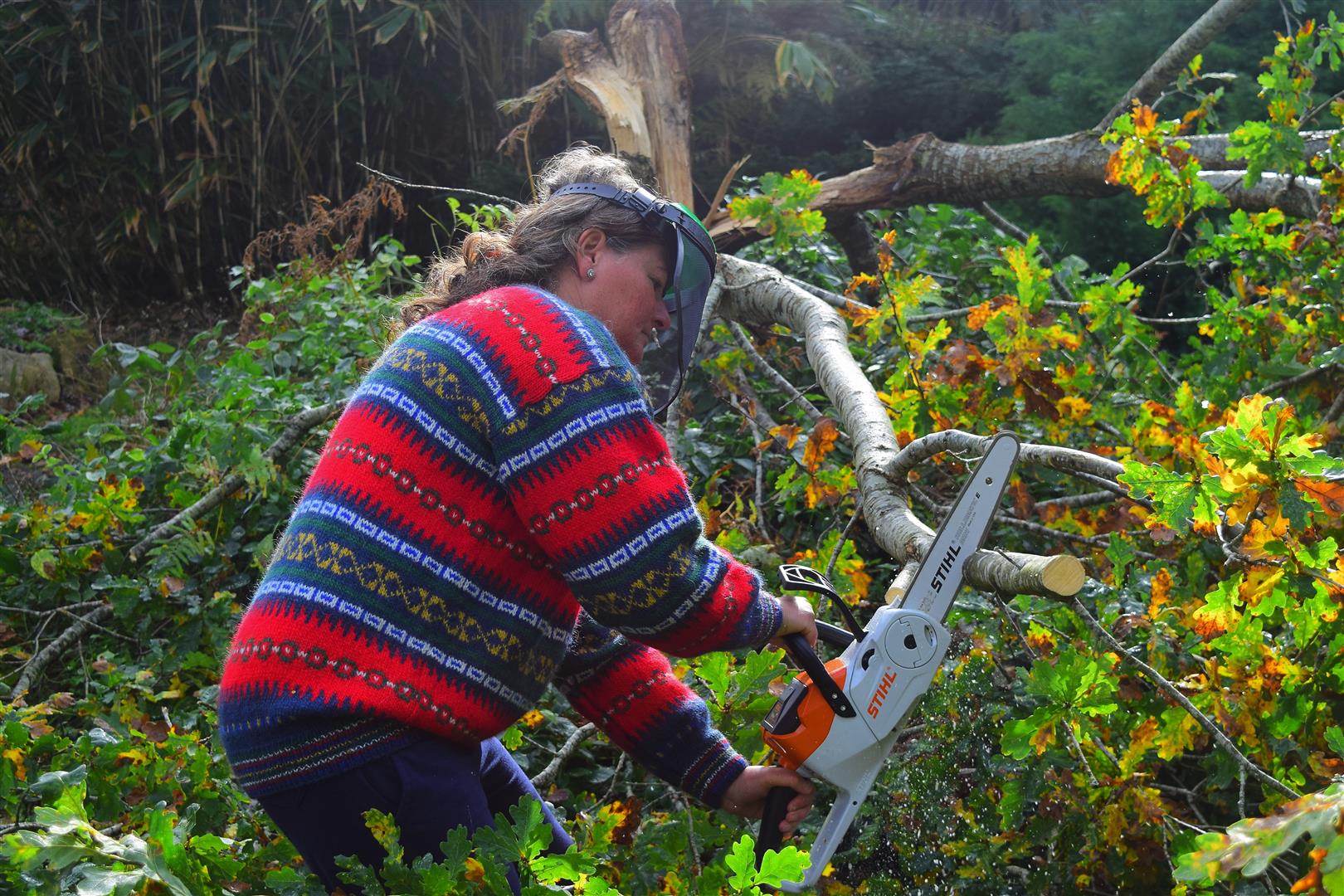
Clearing up an oak tree felled by Hurricane Ophelia , November 2017
Throughout the winter of 2017 and into February 2018 the garden was hard pruned to within an inch of it’s life !
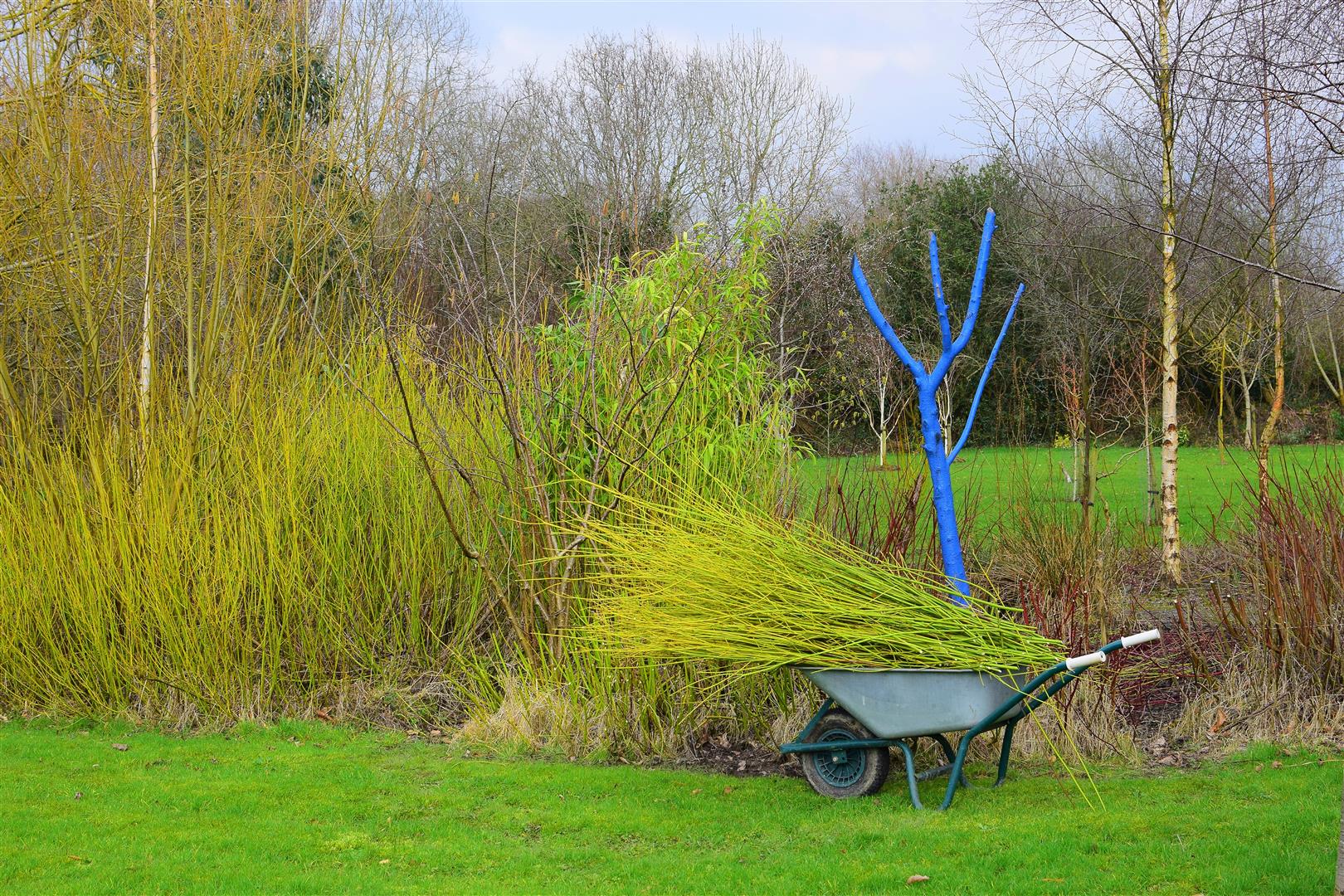
Cutting back the dogwoods February 2018
Bonfires of cuttings ready to be lit when the weather dried out
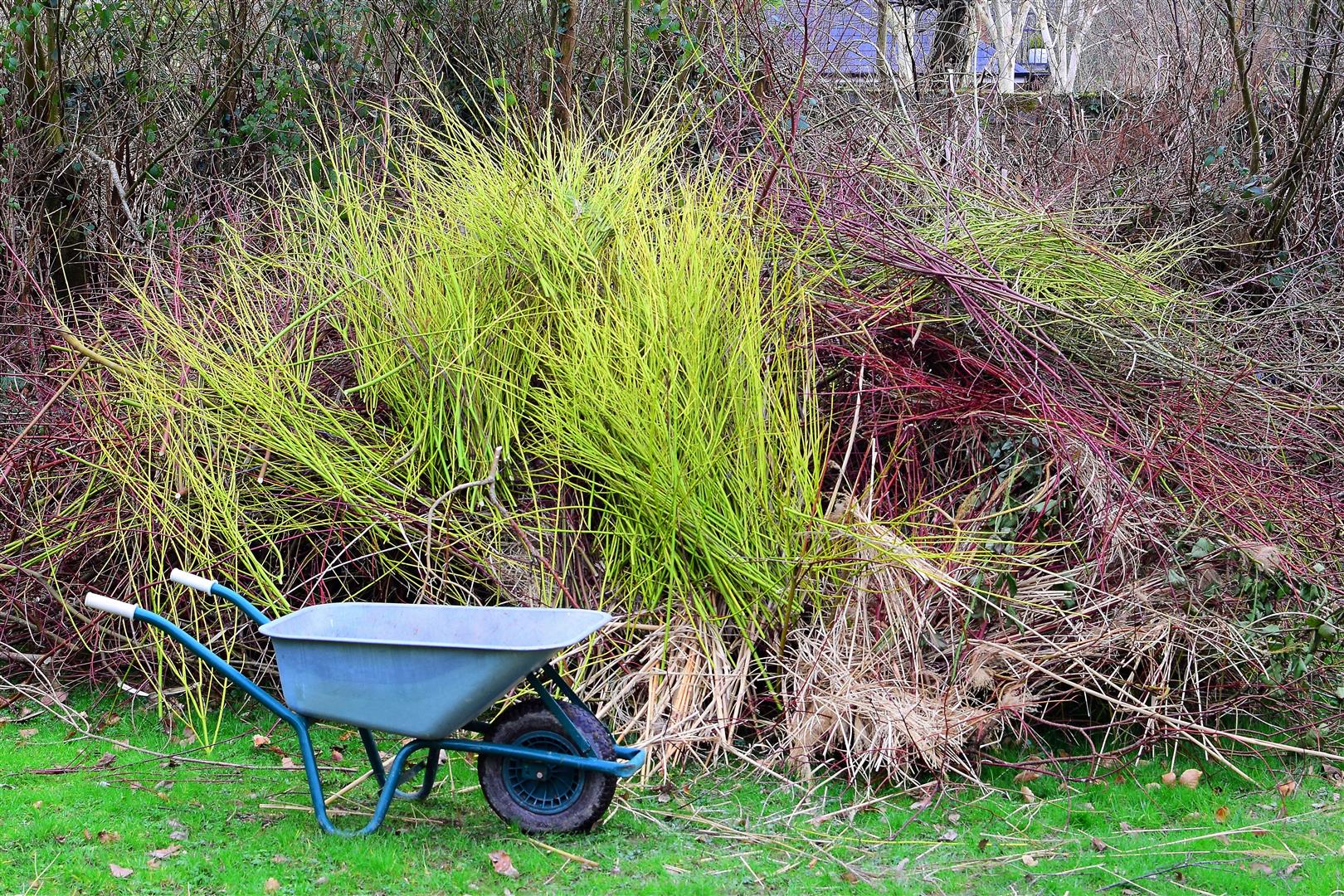
February 2018
The usual question about the outdoor shower … is it heated … no it is NOT !!
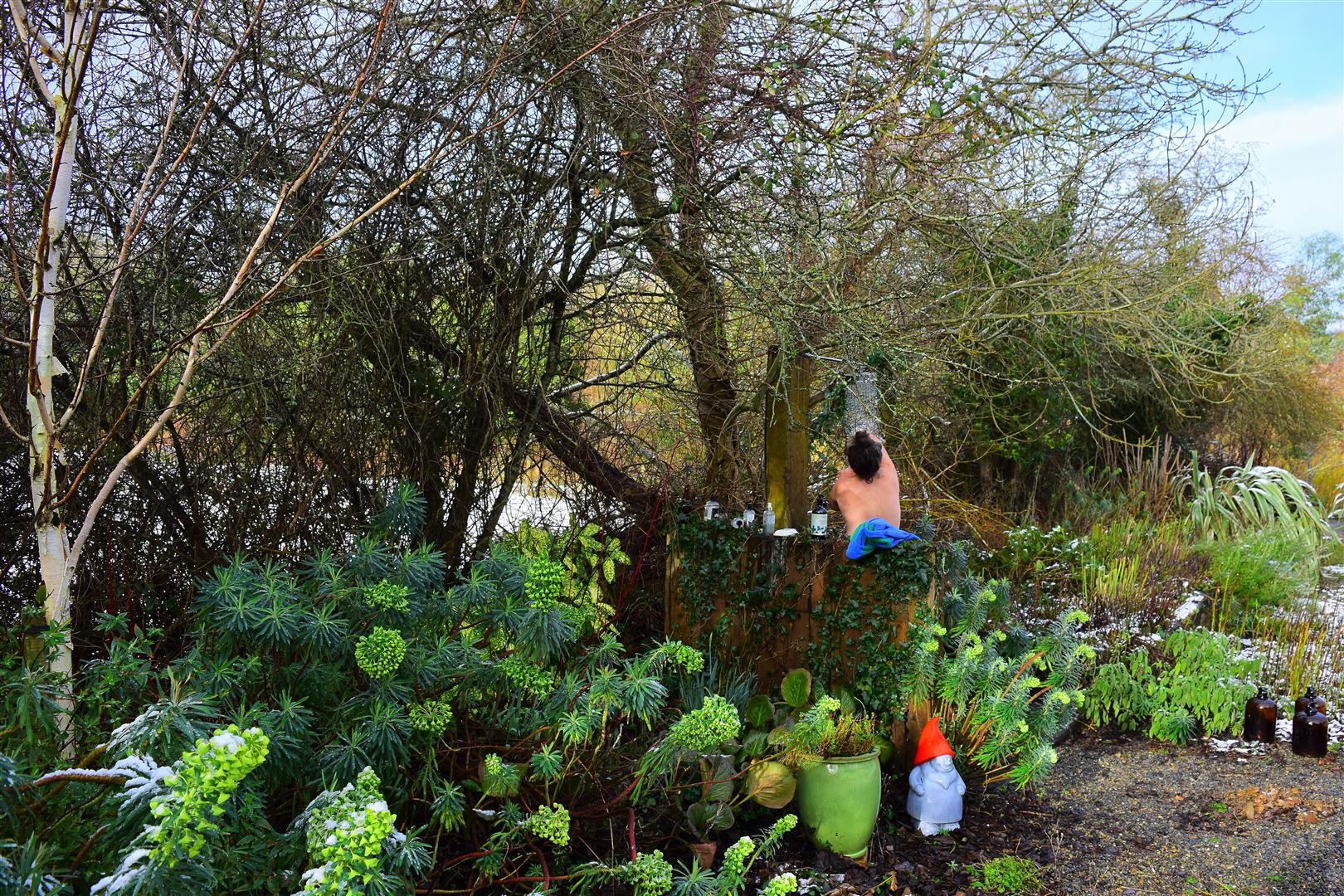
Snezana takes her daily outdoor COLD shower , February 2018

February 2018
The Beast from the East hits Ireland at the end of February 2018 , the first real snow in over thirty years which luckily enough lasted only two days and blanketed the garden in over a foot of snow .
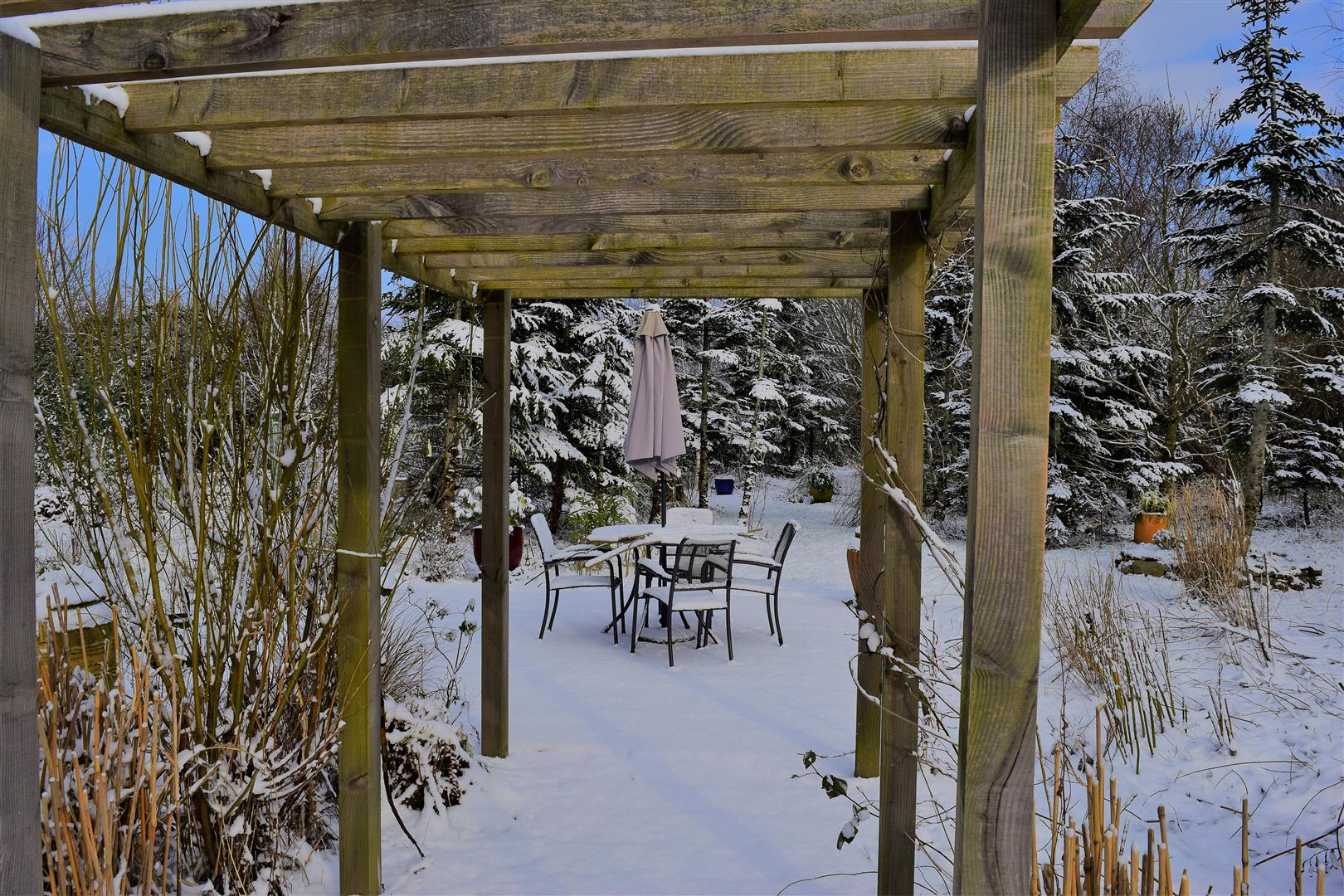
March 1st 2018 , Lower Garden
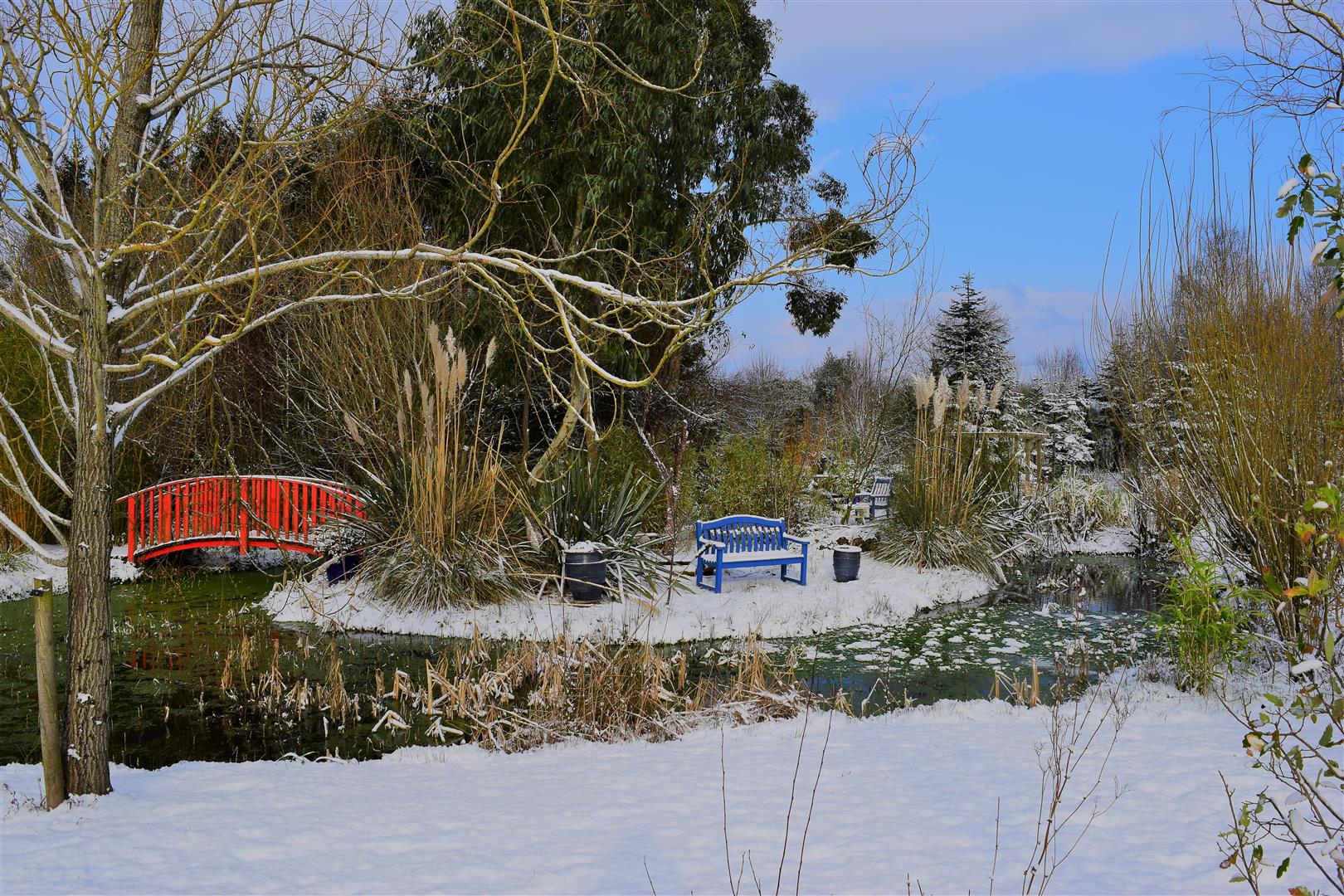
The Water Garden , March 1st 2014, 2018

The Top Field , March 1st 2018
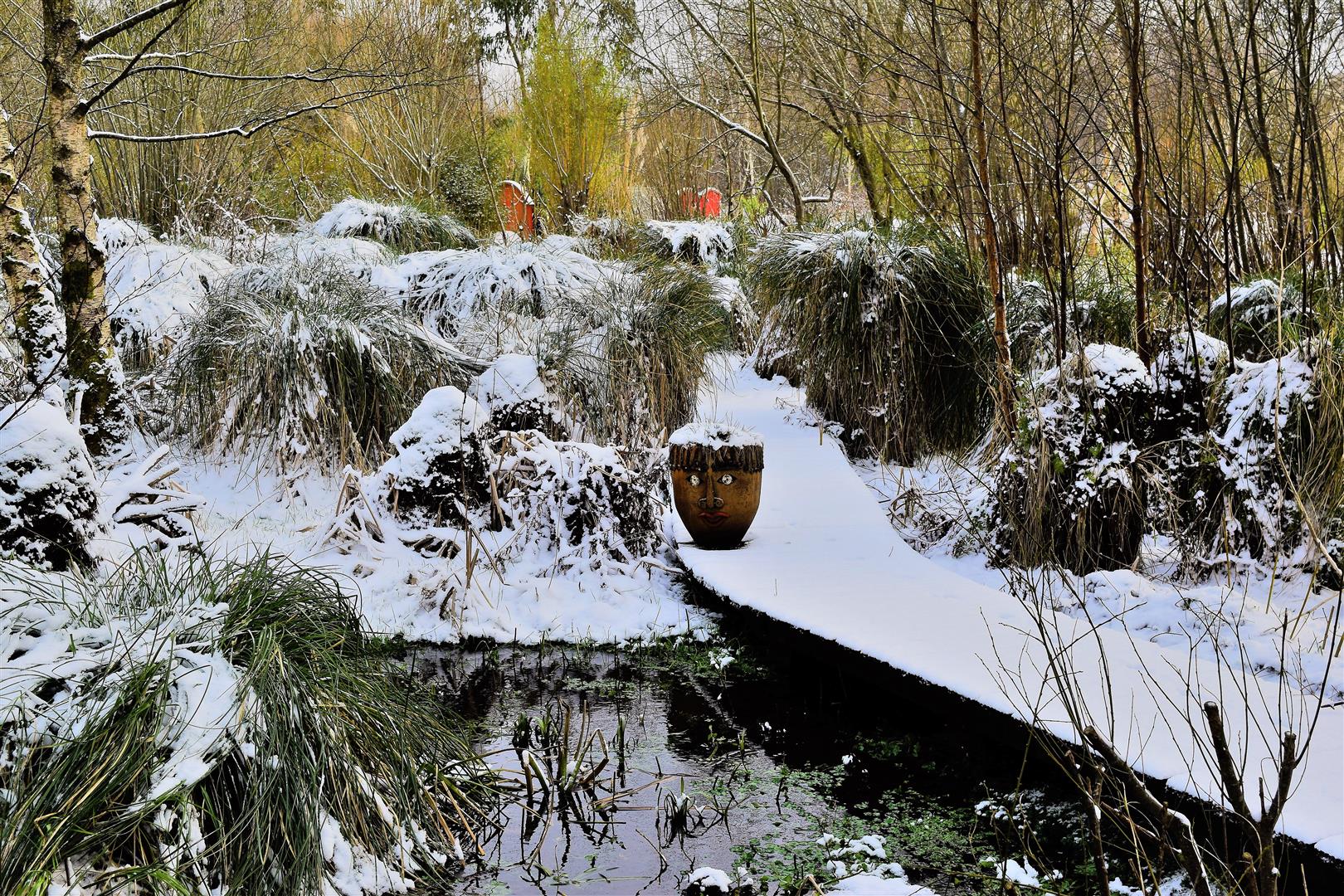
The Water Garden, March 1st 2018
After the Beast from the East in February 2018 and gardeners are an optomistic bunch and a new season begins in early April 2018 with the construction of a new pond in the Lower Garden !
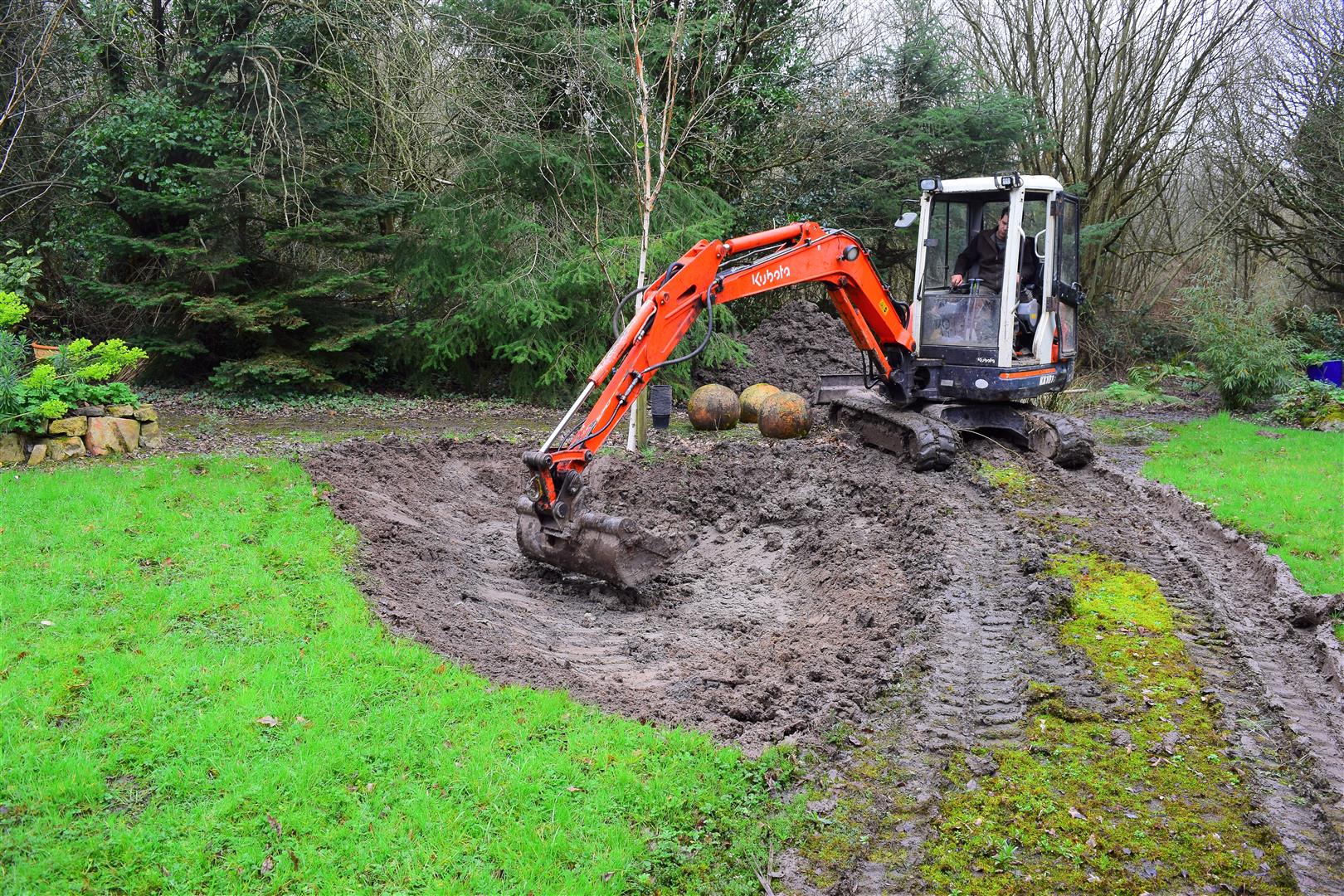
Peter Cullen excavates the outline design for the new garden pond , April 2018
This is an area at the bottom of the lawn near the tree house in the Lower Garden which is always wet and where I nearly lose the ride on mower even in August so I decided to embrace the wetness and with Peter Cullen driving the digger we dug out the area in early April , installed a butyl rubber liner and installed a pond with a bog garden around the edges . This pond I designed as a wild life area with sloping sides from the lawn where the planting will “walk” into the water with marginals planted from a bog garden edging right into the water with the taller plants such as hostas at the water’s edge where they will not cut off the view of the water as bog plants can get leggy and rampant and you end up with fighting your way through to the water which is then lost from view .
We started out with one shape but the design changed as we went along and ended up with a larger area of water as the liner was laid out … digging out with a digger even for and expert like Peter is not an exact science but there is none better with a feel for a natural lie of the land than Peter Cullen who has done all our hard landscaping since the beginning of the garden in 2006 .

The butyl rubber liner is laid out , April 2018
Ending up with more water led to another problem … filling the pond as the nearest source of water was the stream which is two metres lower and twenty metres away … as in try sucking water through a hosepipe and we had no pump … at this point I am tempted to mention Stormy Daniels but that would be rude and not suitable for my more genteel garden readers … the solution was to lift water in buckets into the wheel barrow and then transfer to the newly lined pond … an operation that Snezana stuck doggedly through over eight hours and over a 1000 litres of water later we had our new pool ready for planting .
As I said earlier this was going to be a wild life pool with planting that needed to be low growing at the grass level and taller plants down the sloping sides to the water’s edge so the choice of plants had to be carefully planned and as it was early in the growing season I was able to divide a lot of our less rampant existing water plants and plant directly into the edges and down into the water . My edging plants at lawn level were slips of geranium biokovo which although not best pleased with damp conditions should clump up nicely , I added variegated iris’s just below the water level with hostas just above the water and I alternated divisions of marsh marigold , caltha , both the wild and the cultivated variety, weaving them into the edge and a few inches under the water and to this I added lots of houtania which if they take off will blur the edges of the water and give a natural look to the overall pond and added submerged plants such as a few water soldiers , statoides and a few buckets of oxygenating plants from other water areas in the garden plus a few water snails . As the slopes are deliberately designed to walk in i.e. no ledges I won’t be able to put fish in as the herons who live here will also walk in and eat them but next spring the plan is to carry a bucket of frog spawn from the front pond and this will ensure a wild life presence which hopefully will attract dragon flies and other natural visitors … already I see deer hoof prints at the edge .

Planting up the new pond , May 2018
At the moment the pond looks a bit manufactured but in a year’s time it will blend in better and the water colour will clear from the current muddy colour which is caused by the fact that we covered the butyl rubber liner with over six inches of earth for a more natural look and to allow marginal planting .
The new pond was settling in nicely by the end of May 2018 and becoming part of the landscape between the two lawn and it helped that there is no hard landscaping involved here with no paving as my plan is to have the lawn merging into the bog garden planting around the water . The planting will not include any tall plants so as not to interrupt the sight line so iris’s and bull rush types are out and Clonmel Garden Centre by coincidence have this year increased their water plant section tremendously and each month are displaying new plants although I must admit I am a total novice when it comes to knowledge of water marginals and apart from water lilies and marsh marigold and am out of my depth in deep water plants … literally as I have already fallen in twice when planting !
Plantago aquaticum , lysichton camtschatcensis , hydrocotyle, potentilla palustris, orontium aquaticum, persicaria amphibia mean anything to you … me either but their common names alisma , white skunk cabbage , pennywort , marsh cinquefoil , golden club , amphibious give a better clue that they all like damp conditions and these have all gone in this past week bought at a sale in Clonmel Garden Centre … they are not much to look at right now but give them a few months in the shallow water at the pond’s edge and they should romp away . I have often written here about the American skunk cabbage but this is the white flower version which I have not seen before and like the more usual yellow flowered version this will take several years to look anyway decent but then it is magnificent as a water’s edge architectural plant and the huge paddle like leaves stay standing most of the summer .
The new pond two months later 30th June 2018

New Pond taking shape June 30th 2018
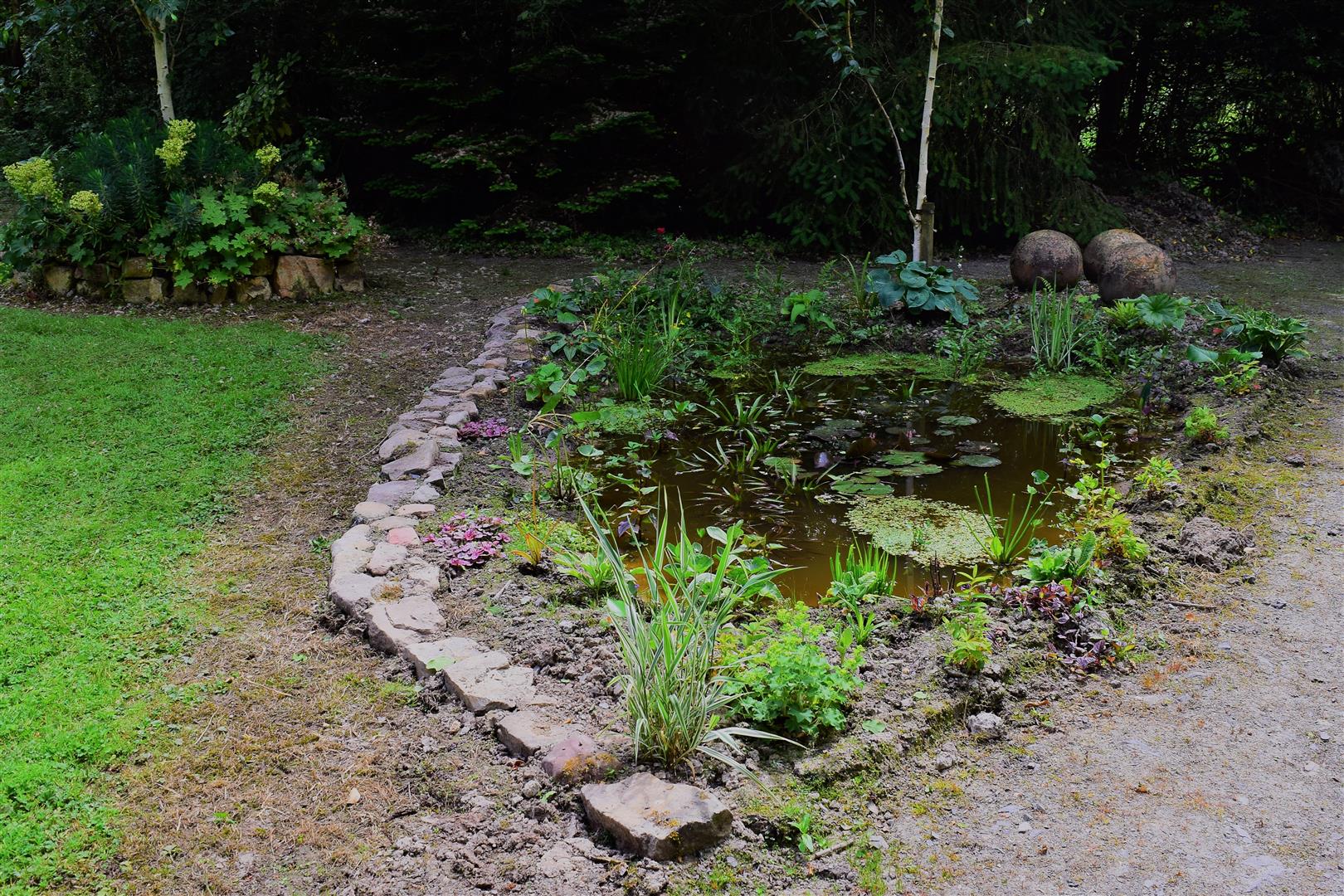
Planting starting to fill out , new pond , June 30th 2018
New additions to the Garden and an old friend departs in June 2018
A few new additions to the garden infrastructure in the past few days and a sad goodbye to a wooden bench which was one of the first purchases back in April 2006 when I saw it at Manor Stone in Littleton when buying some large rocks and even though I maintained it with coats of paint every year or so , this year when we began to paint it some pieces fell apart and from now on I won’t be buying anymore wooden garden furniture as metal furniture needs minimum looking after .
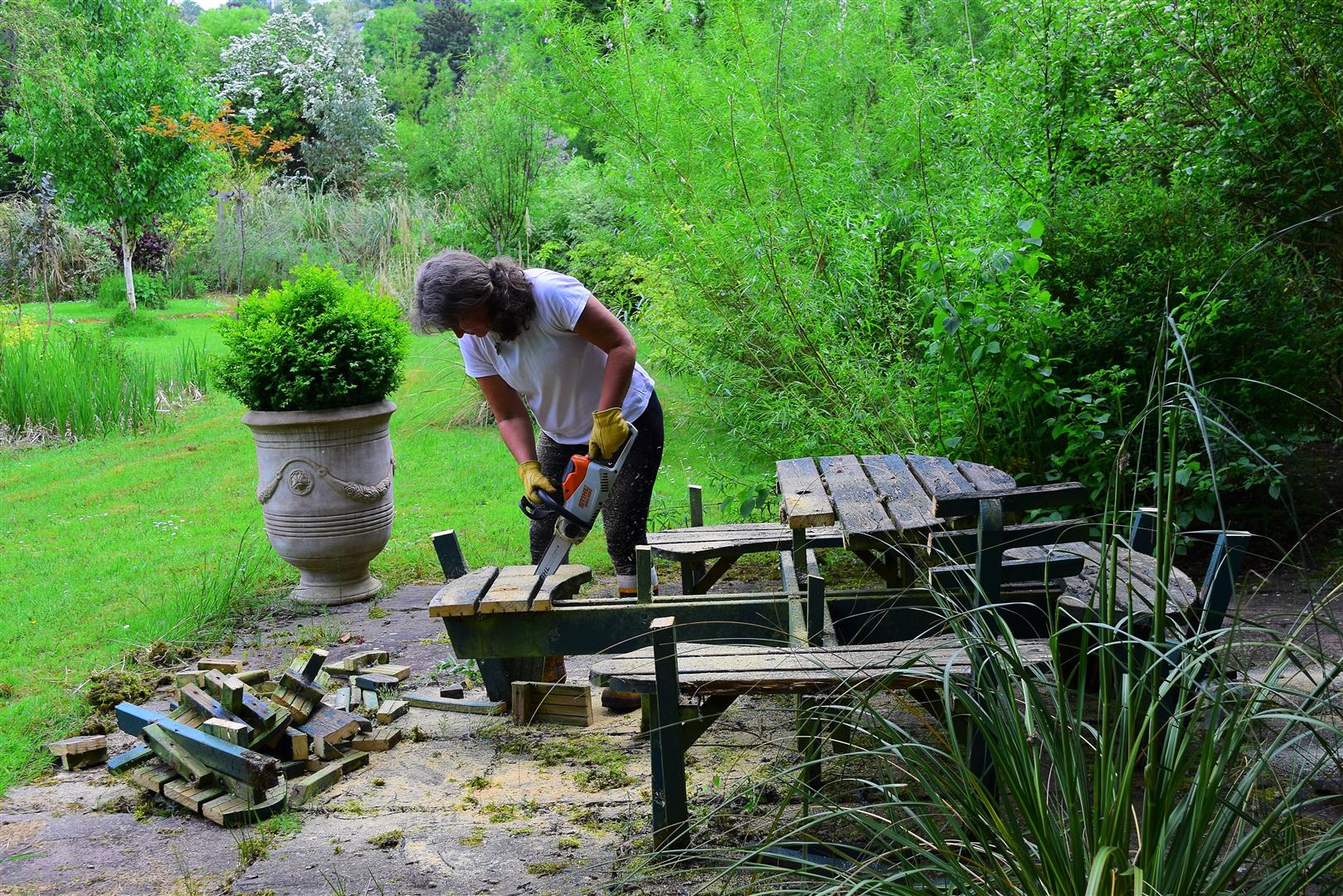
Our much loved garden bench goes , June 2018
But will keep us warm next winter !
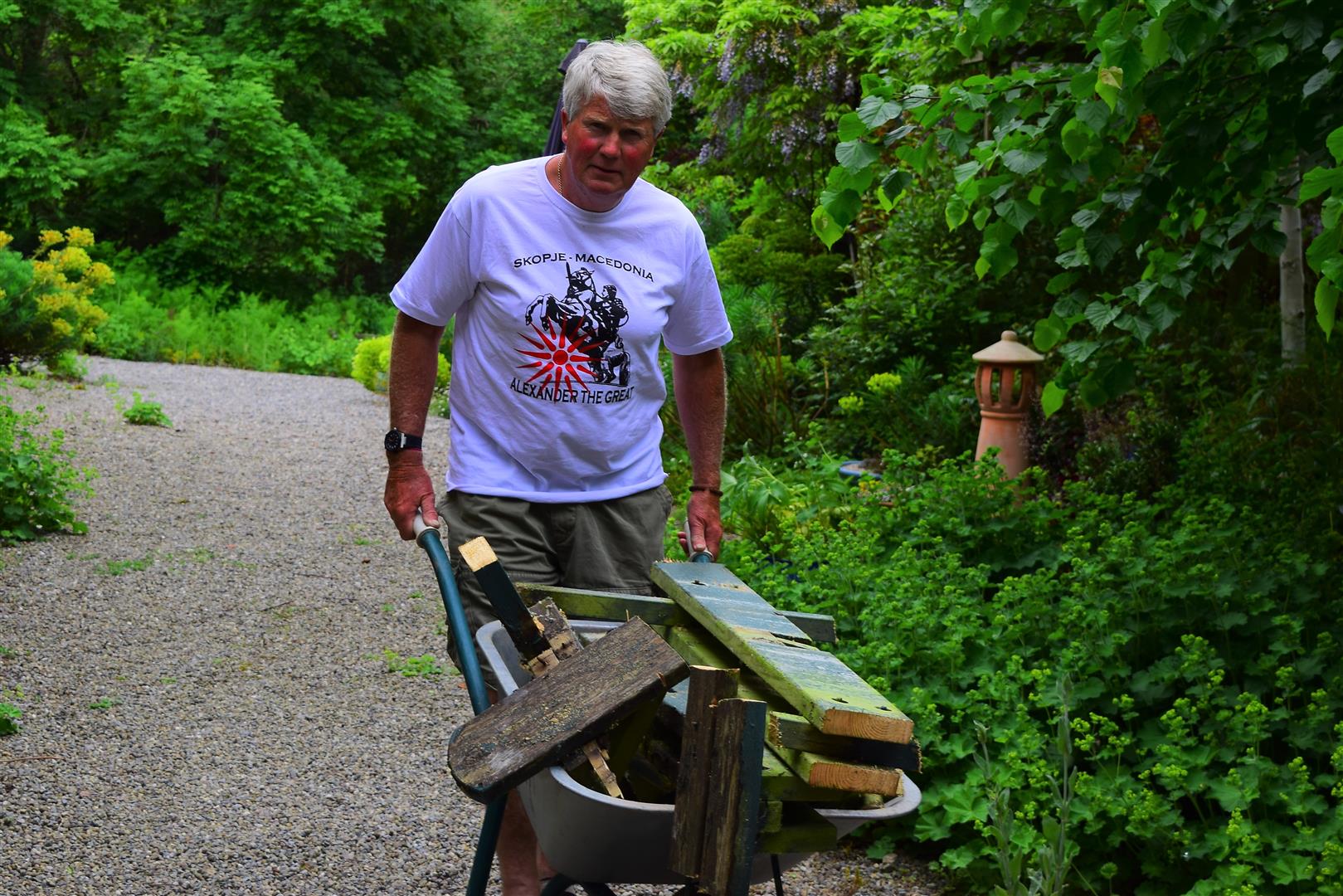
My Macedonia t shirt from Skopje will piss off the Greeks !
This new stone head has been standing in Glenconnor Garden Centre for a few years where it became part of the furniture to such a degree that they were reluctant to let it go but Snezana fell in love with it a year or so ago and finally Chris gave in and it now guards the front garden … originally I thought it was a North American Indian totem pole replica but on closer living with it I think it is more likely to be a Mexican Aztec god … either way he looks great here !
New faces added in May 2018

Giant stone Aztec head , Front Garden , June 2018
My Gardening Blog of June 30th 2018 tells it’s own sad story
Finally a legend of the Old Spa Road neighbourhood passed away this week . Toby was owned by Margaret our next door neighbour but in reality he belonged to the entire road as he visited us all regularly . Both Snezana and I will miss him terribly as he took up residence at our front door every morning , accompanied each visitor through the garden and could give a guided tour on his own . Toby was a wonderful dog , gentle and loving , there will never be another one like him and as I said to Margaret the entire neighbourhood loved him but more importantly , Toby KNEW he was loved by the entire neighbourhood .
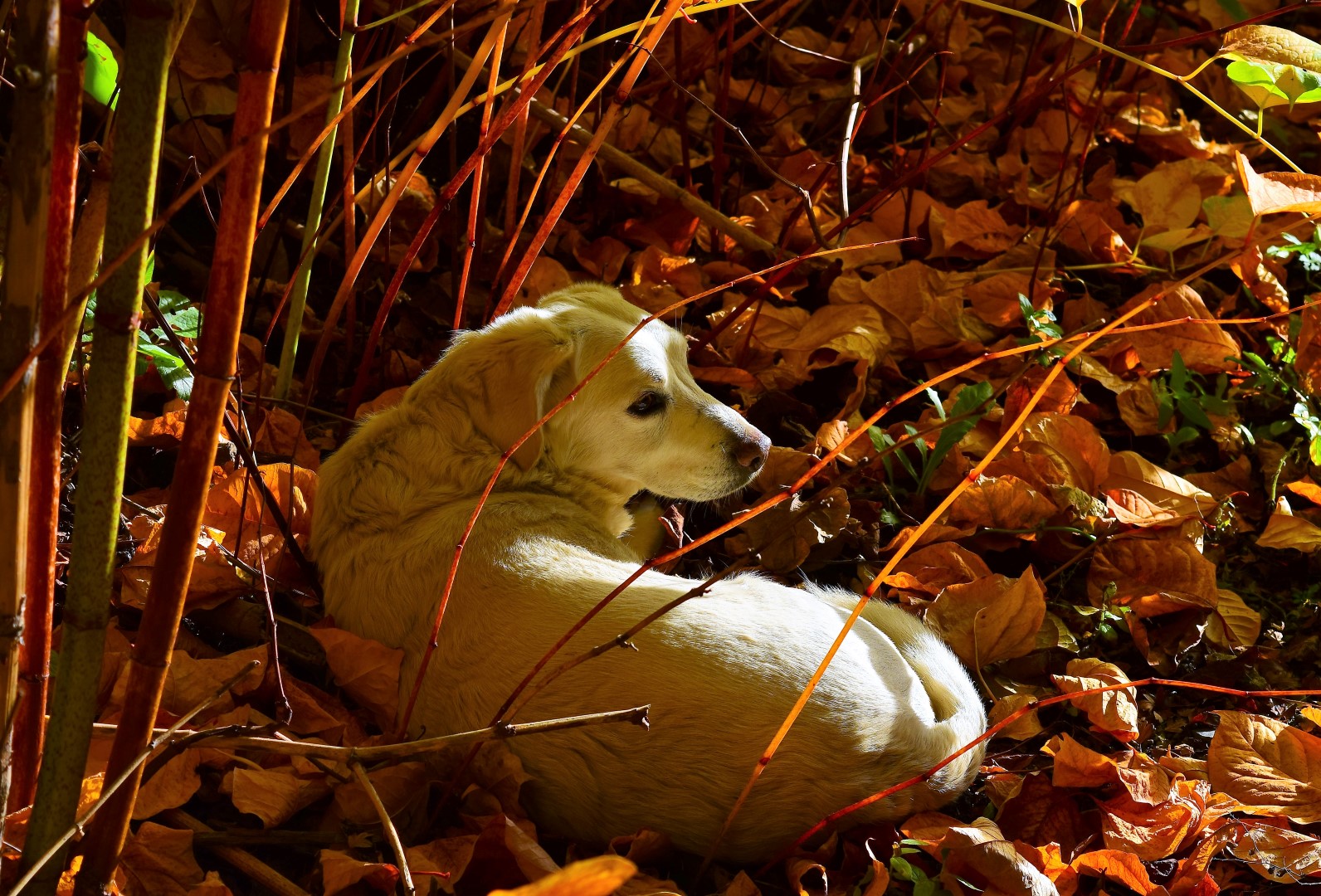
Toby always found the ray of sunshine in the garden
The Garden Open for the Lion’s Club August 12th 2108
The Garden Open day for the Lion’s Club kept up the tradition of the rain staying away and a great turn out of support for two very deserving local charities with over 180 people paying in on August 12th and raising over a thousand euros . As always a nice blend of visitors who asked interesting questions about the garden with children and dogs running wild but always well behaved ! Again as always the Clonmel Lion’s Club led on the day by Michael , Pascal , Rikki and Conrad did a great job of organising road signs , erecting tents , manning the gate , arranging teas and coffees and gorgeous cakes which allowed Snezana and I to concentrate on making everyone feel welcome to the garden .
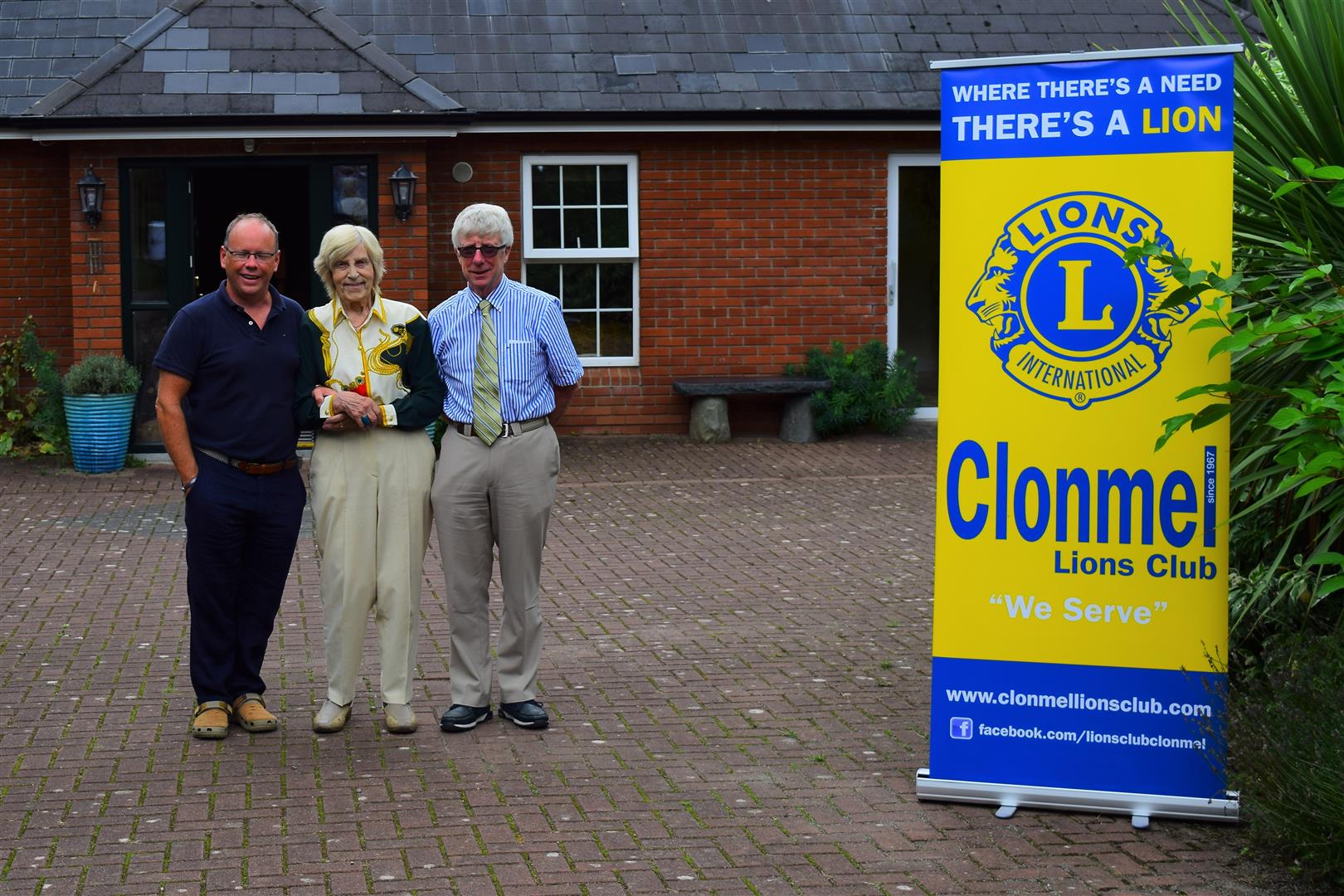
Conrad an d Peter , Clonmel Lion’s Club with Mary O’Donovan . doyenne of Clonmel Gardeners , August 12th 2018
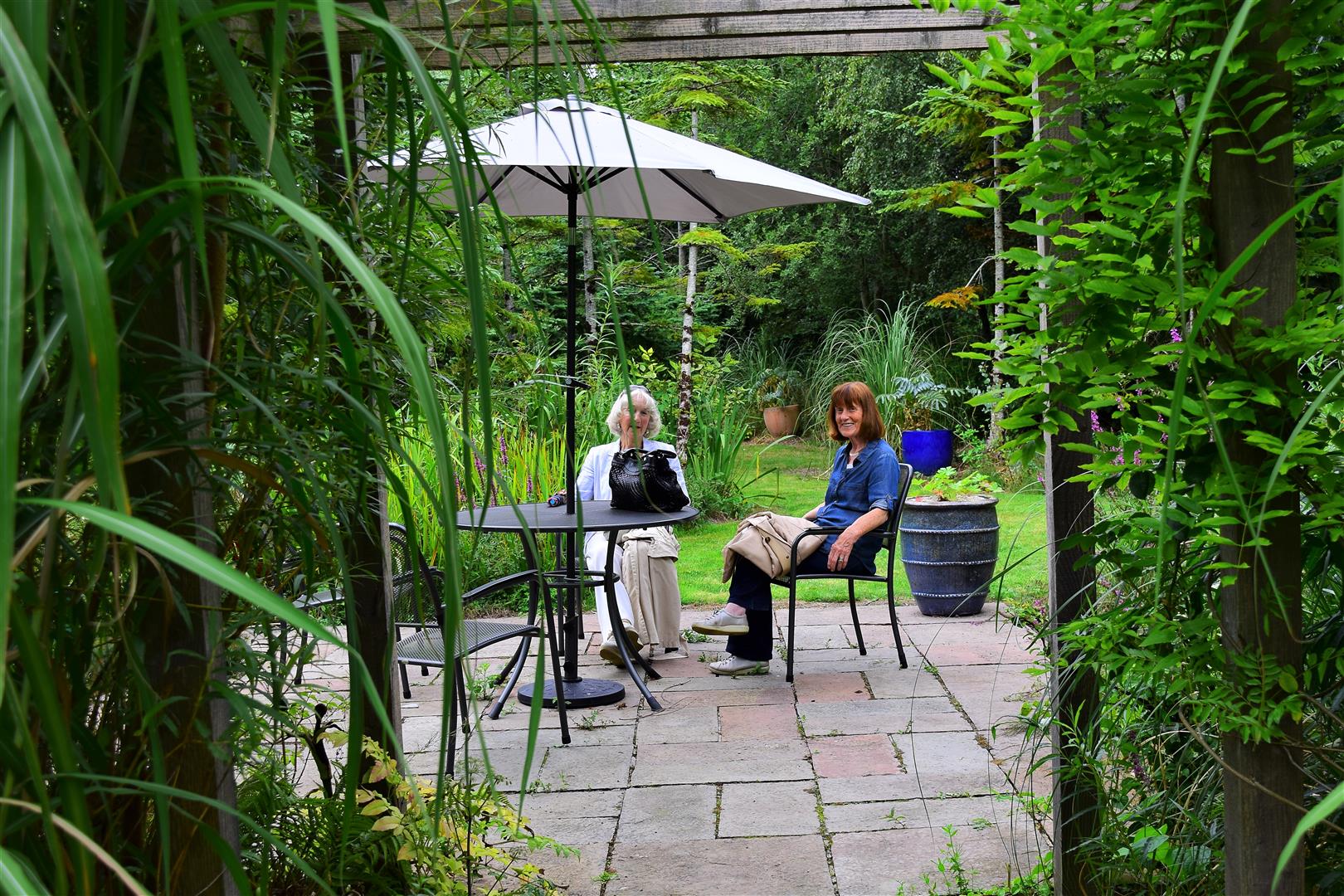
Raine and Margaret , Clonmel Garden Society , August 12th 2018
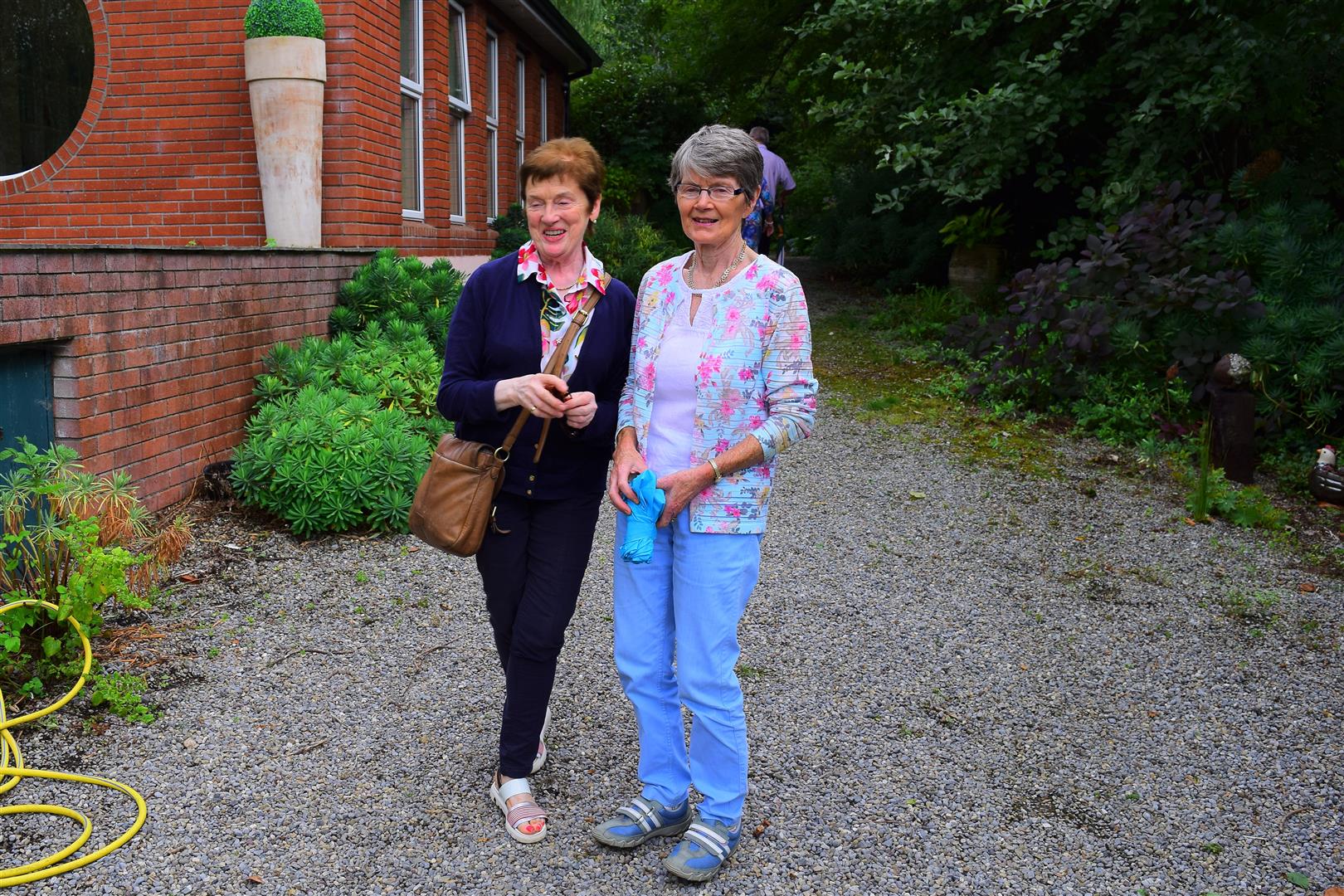
Mildred Stokes on right , Irish Gardener of the Year 2008 among the visitors , August 12th 2008
Among the groups visiting the garden in the summer of 2018

The Kilkenny Garden Society visit July 2018
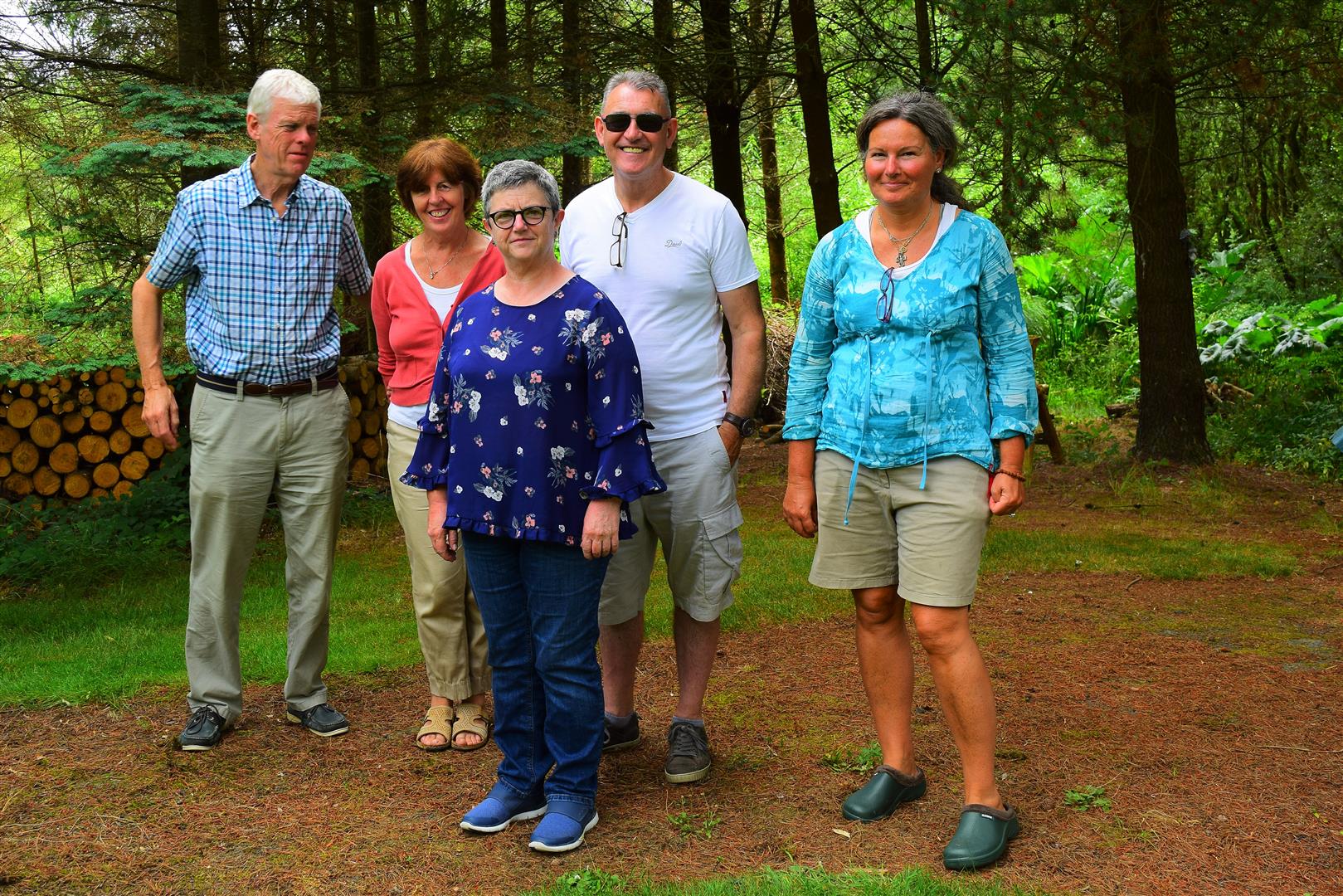
The Irish Garden Plant Society committee visit in July 2018
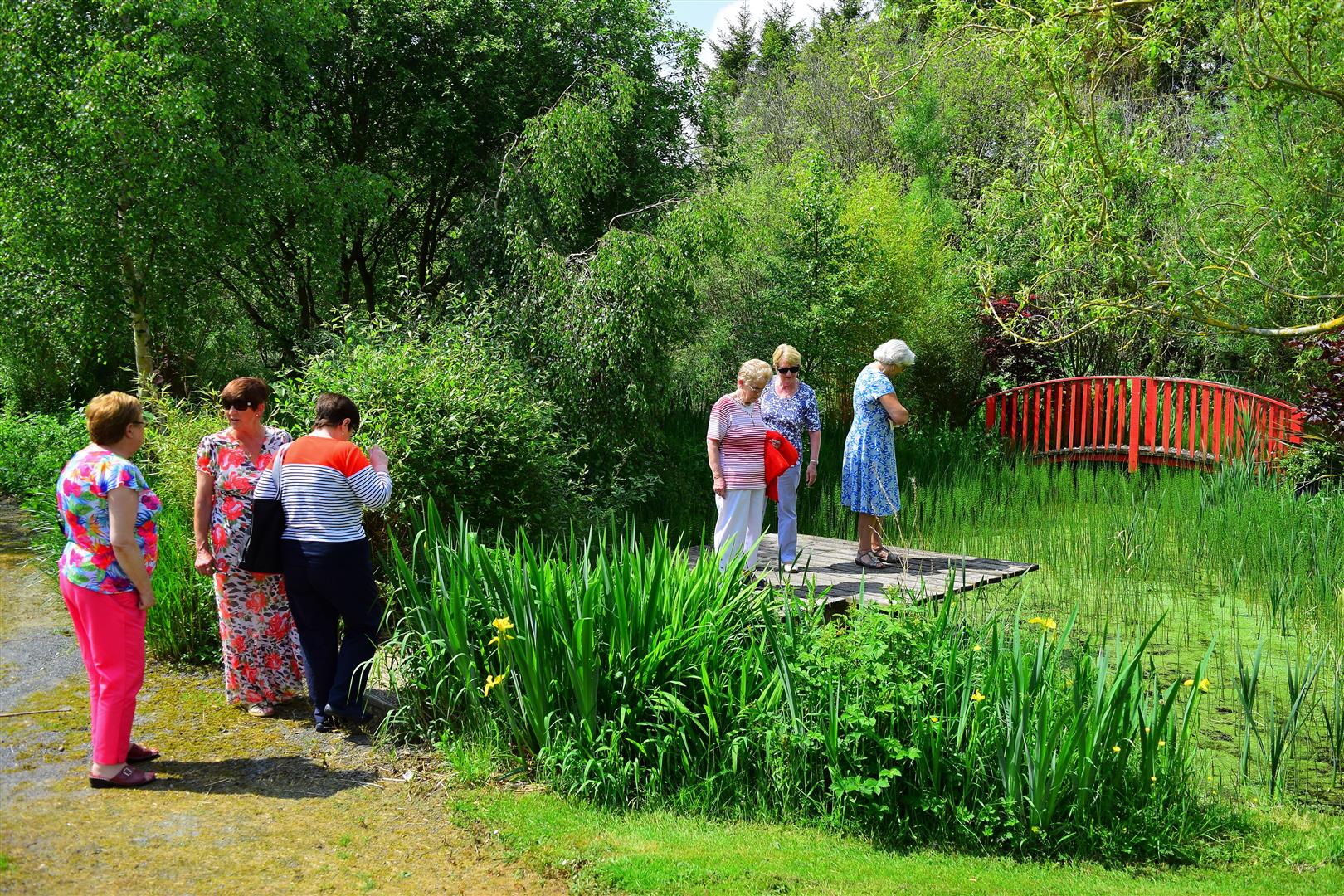
The Tipperary Retired Active Group visit in June 2018
As part of the occaisional Walk in the Garden Series I took these photos on May 19th 2018
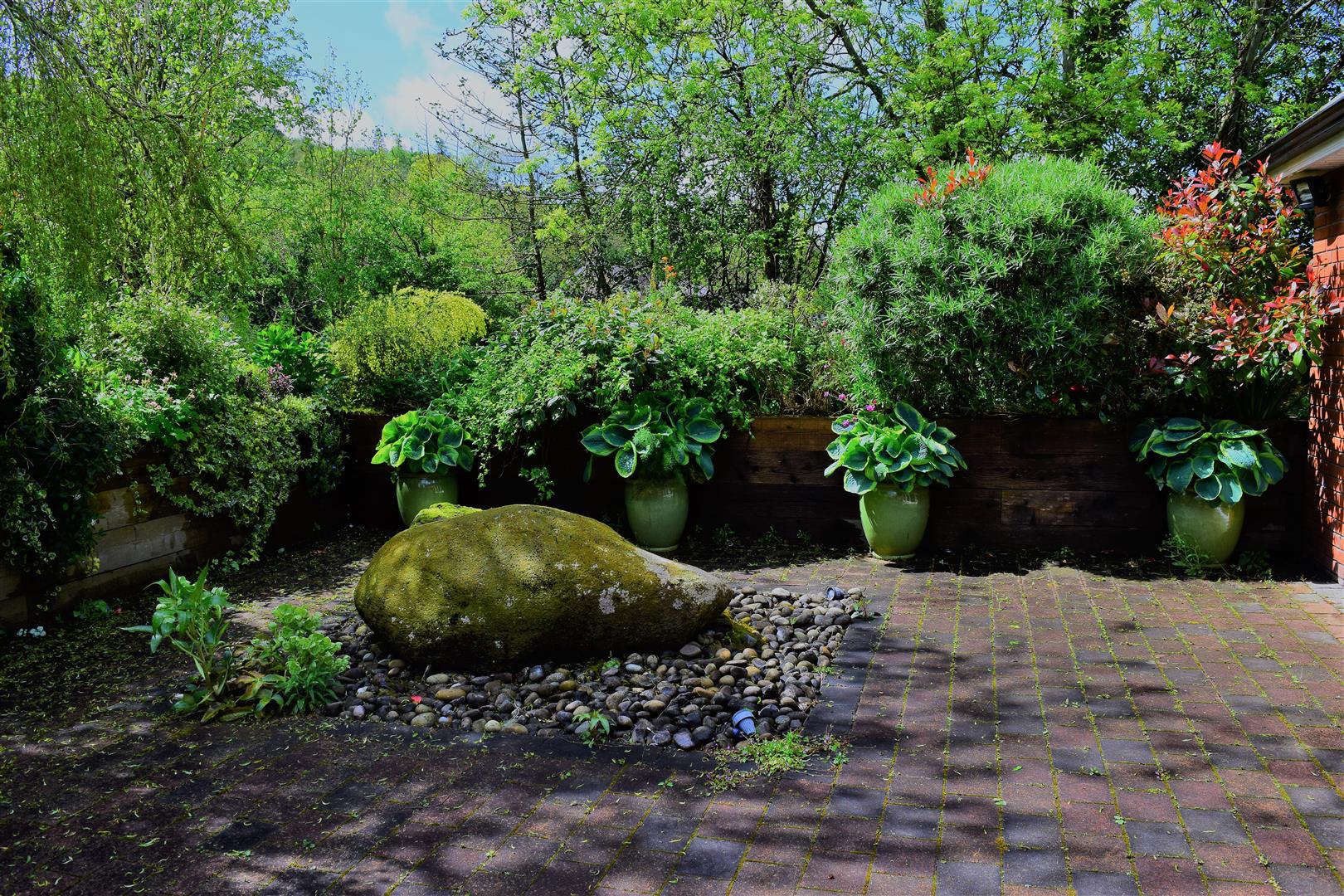
The Front Garden May 19th 2018
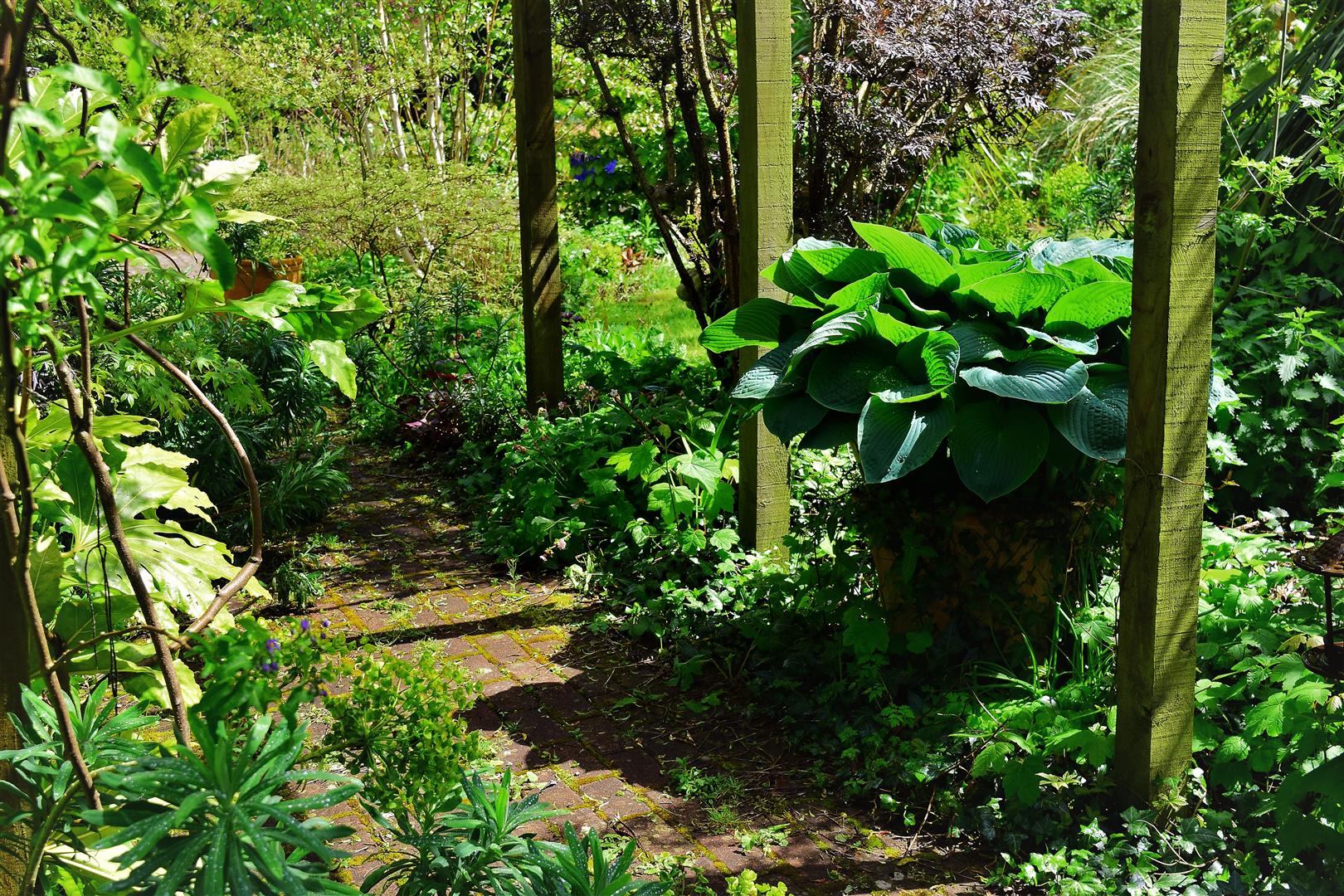
Hosta Elegans , Front Garden May 19th 2018
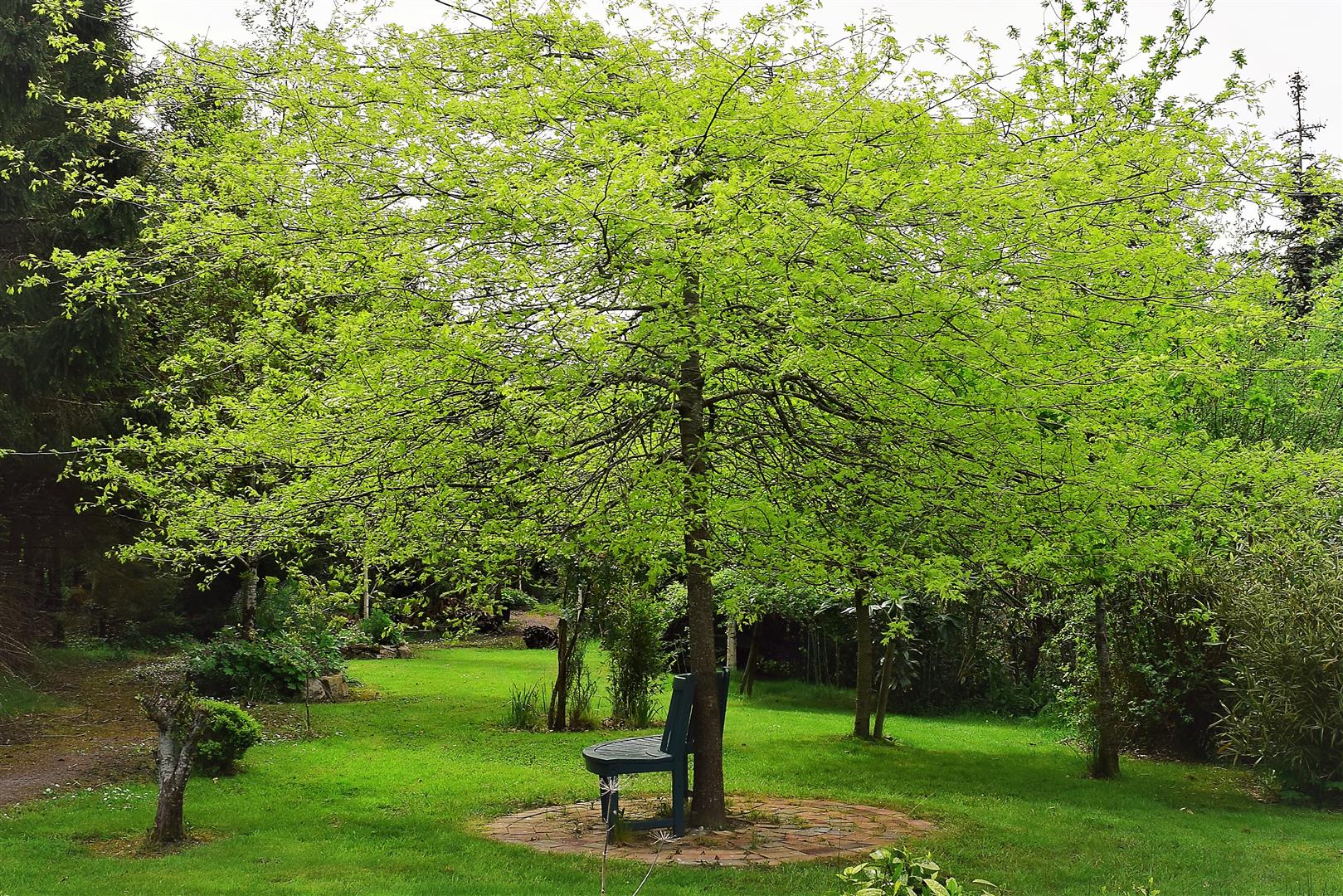
The Lower Garden , May 19th 2018
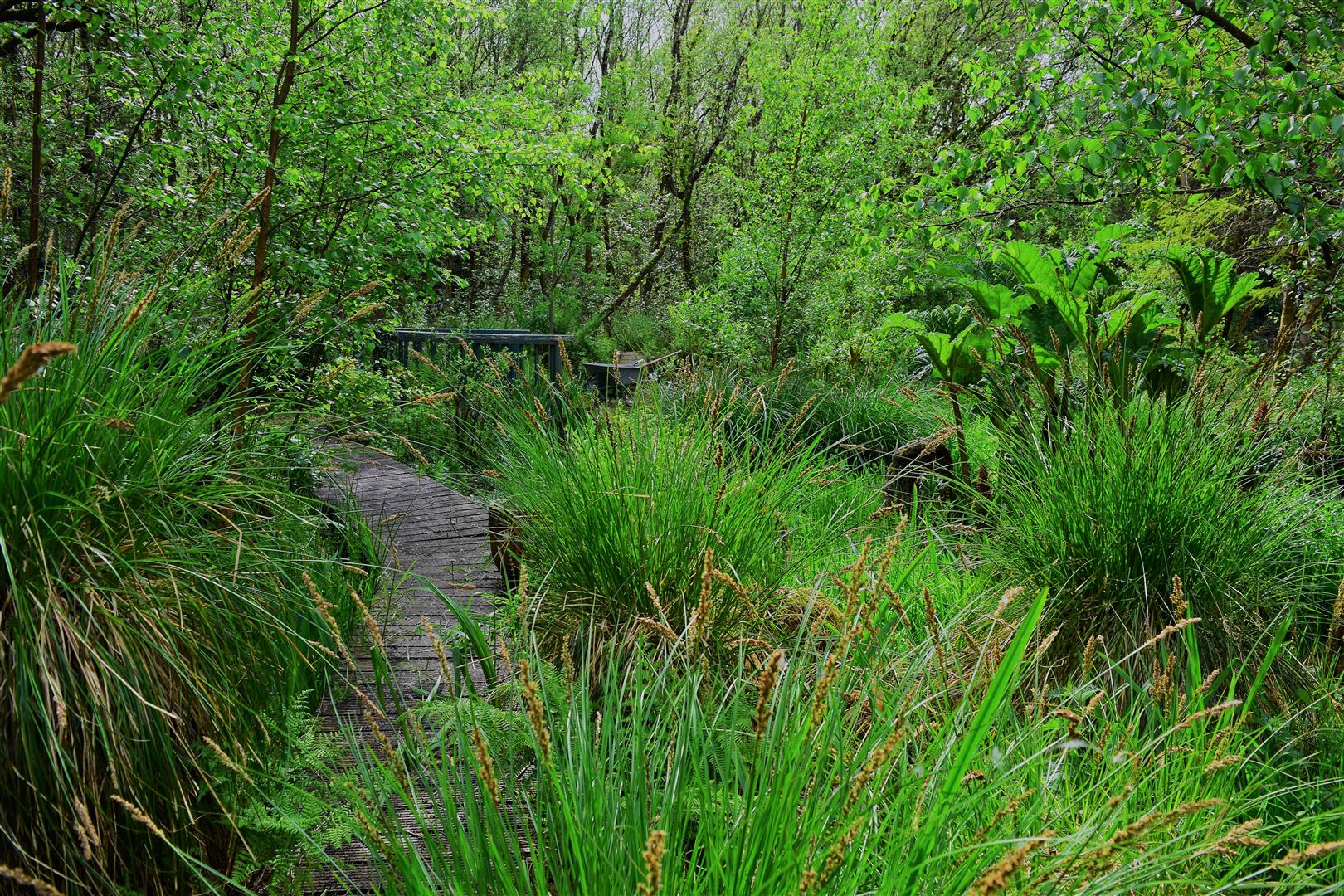
The Water Garden , May 19th 2018
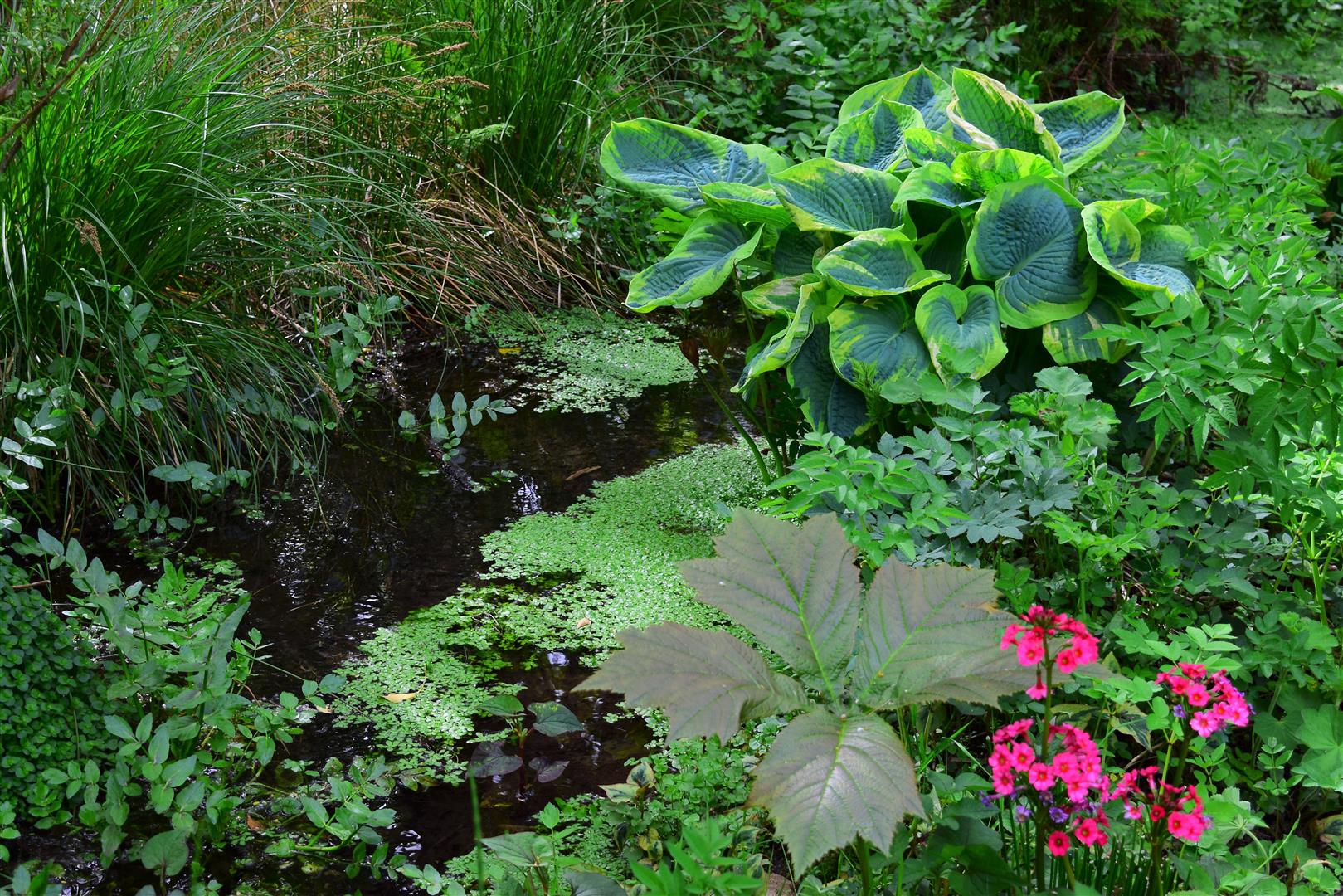
Hosta auriomarginata by the stream , May 19th 2018
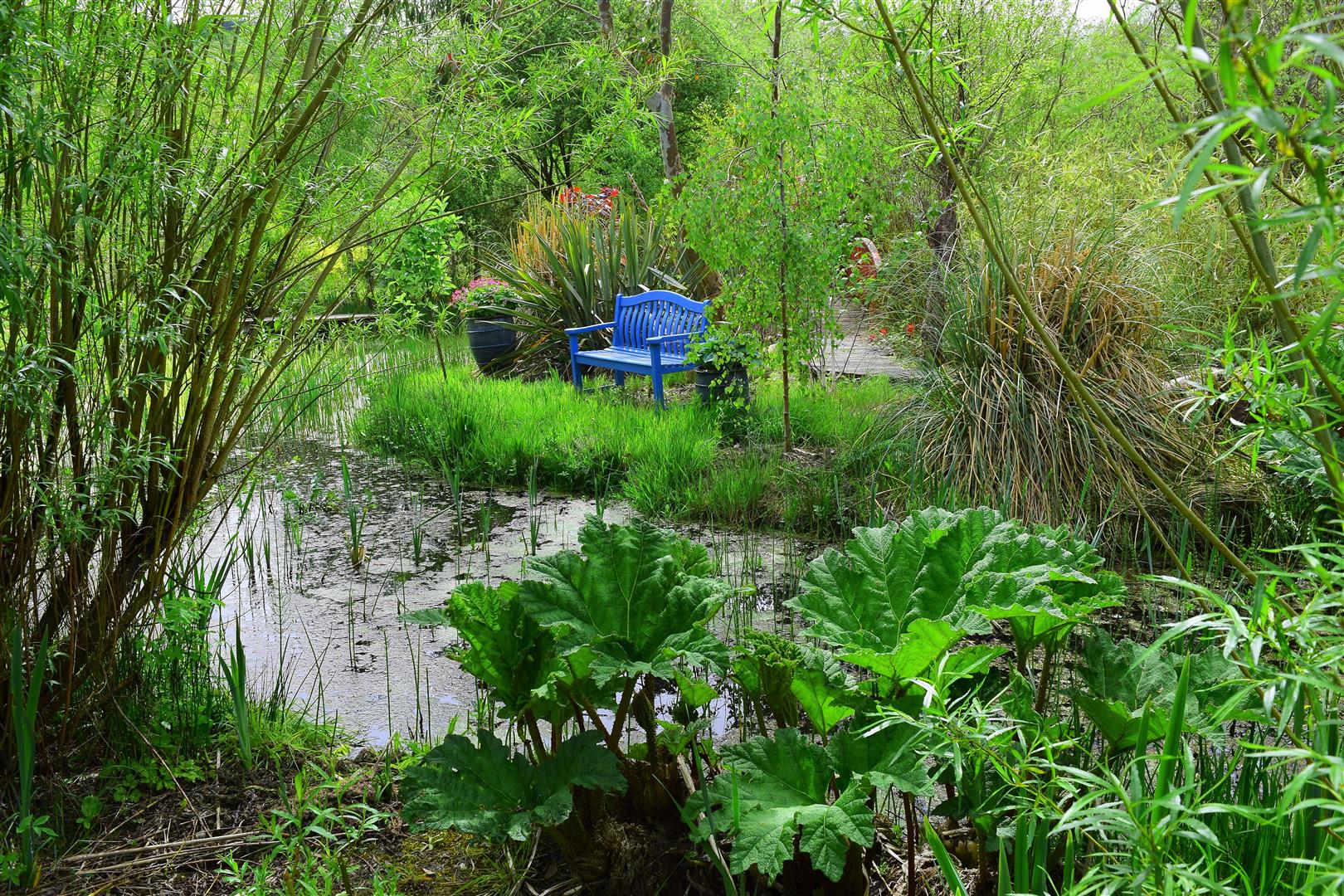
The island , May 19th 2018
There is no doubt that gardeners get great inspiration from visiting other gardens and we all borrow or steal ideas however in March 2018 I have to say that visiting Parc Guell in Barcelona , the garden created by the famous Spanish
architect Antonio Gaudi in the 1920’s , did nothing for me with it’s mass concrete construction and I found it a total disappointment .

The Gaudi garden in Barcelona , March 2018
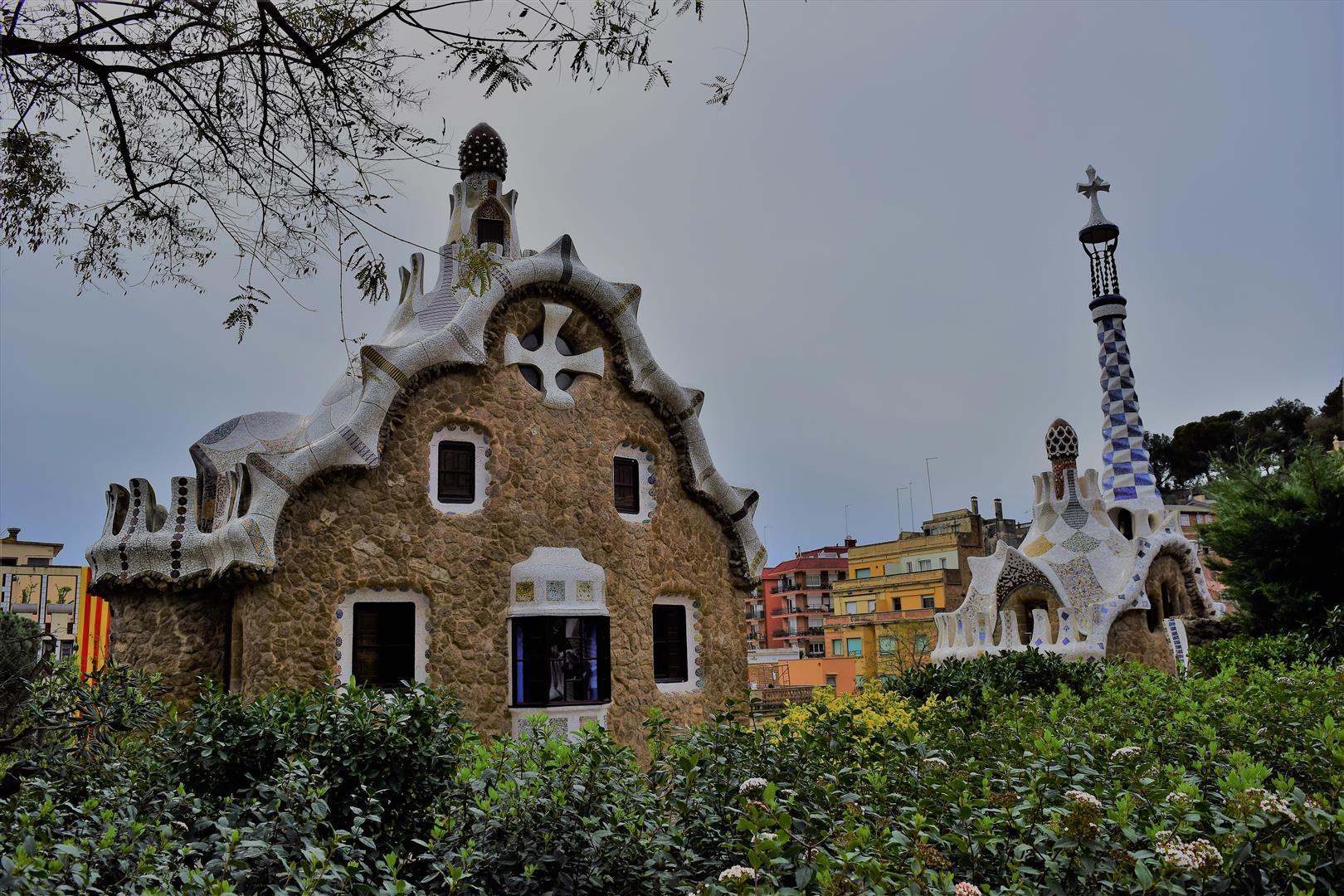
Gaudi Garden , Barcelona , March 2018
In my subsequent garden blog for March 2018 I contrasted the sheer awfulness of the Gaudi sculpture in a garden setting with that of my favourite , Henry Moore , whose monuemental works fit so well into any landscape … of course all this is my personal view of Gaudi and I am sure many who read this will be appalled that their hero has been maligned !
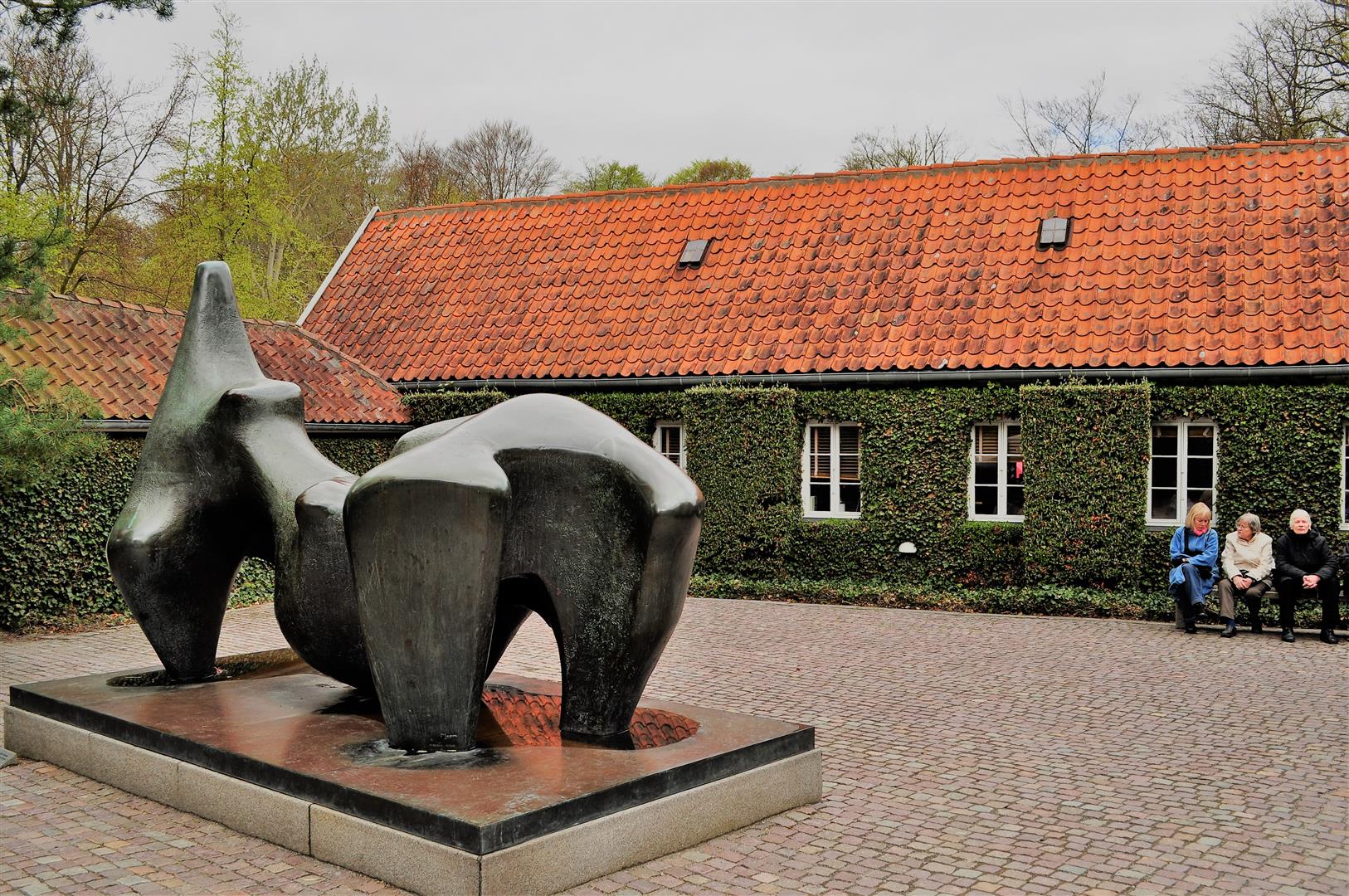
Henry Moore sculpture at the Louisiana Museum , Copenhagen , May 2010
On the same trip to Catalonia we visited a lovely tropical garden , Manimurta Garden , spread over a hillside with a site to die for tumbling down into the mediterannean which was also built in the 1920’s and the designer used the stunning natural scenery to frame various points of focus .
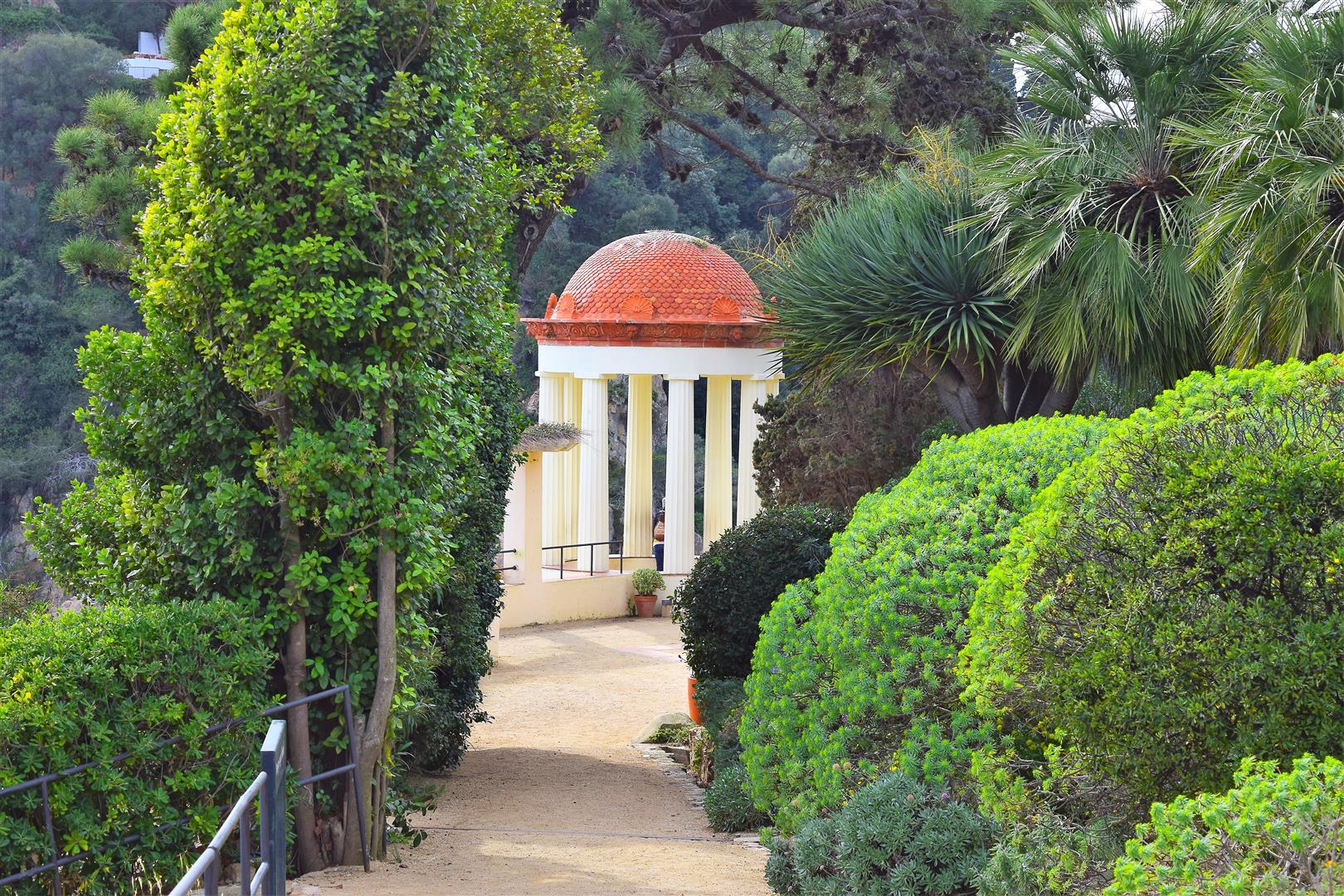
The Marimurta Botanical Garden , north of Barcelona , March 2018
We were in Sicily for a week in early October 2018 and saw some wonderful Islamic Moorish water features at the famous 12th century Monrealle Cathedral outside Palermo which was similar to the Alhambra in Granada along with a fabulous display of balcony ceramic pots to rival the famous patios of Cordoba in Andaluisa.
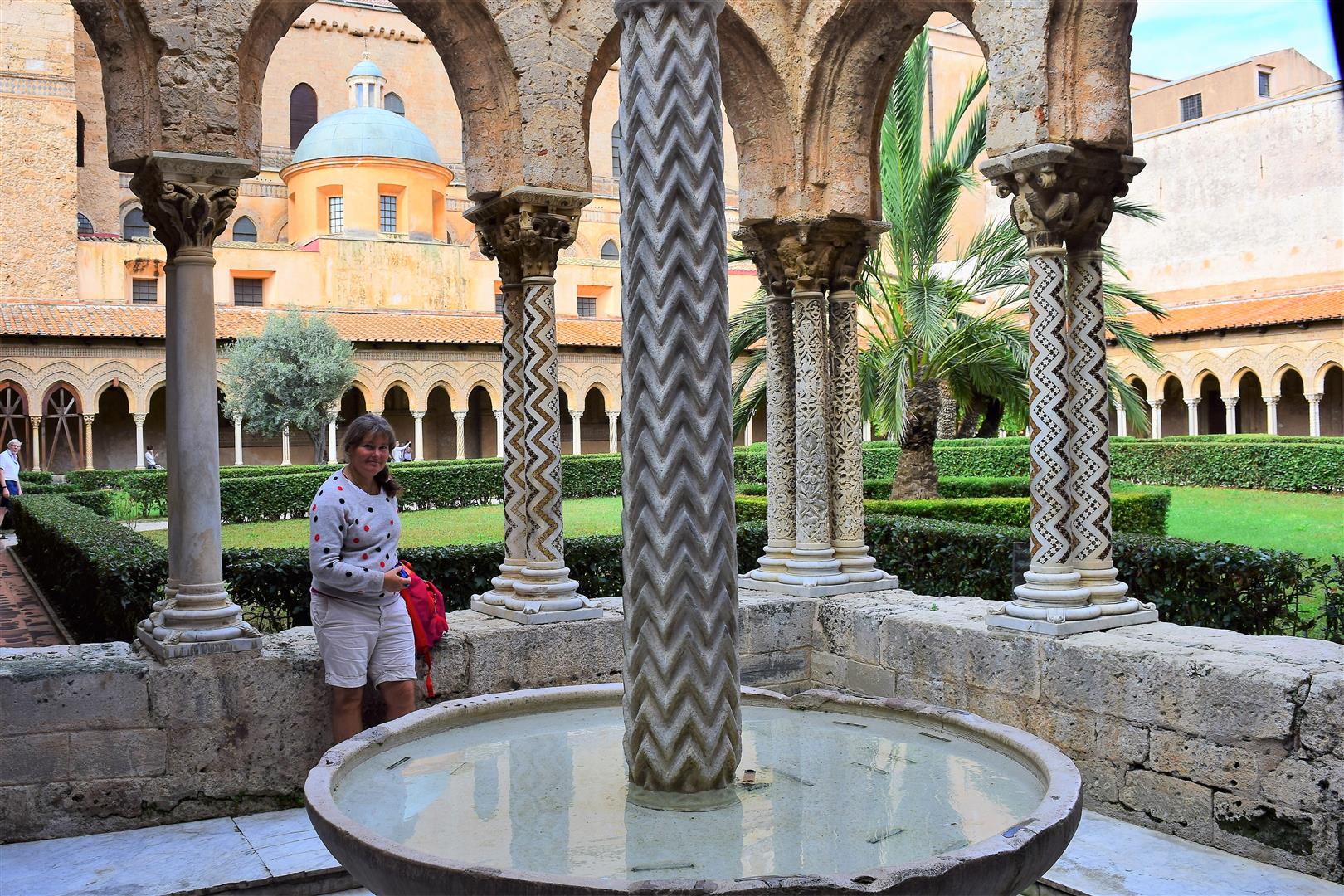
Snezana at the Cloisters of Monrealle Cathedral , Sicily ,October 2018
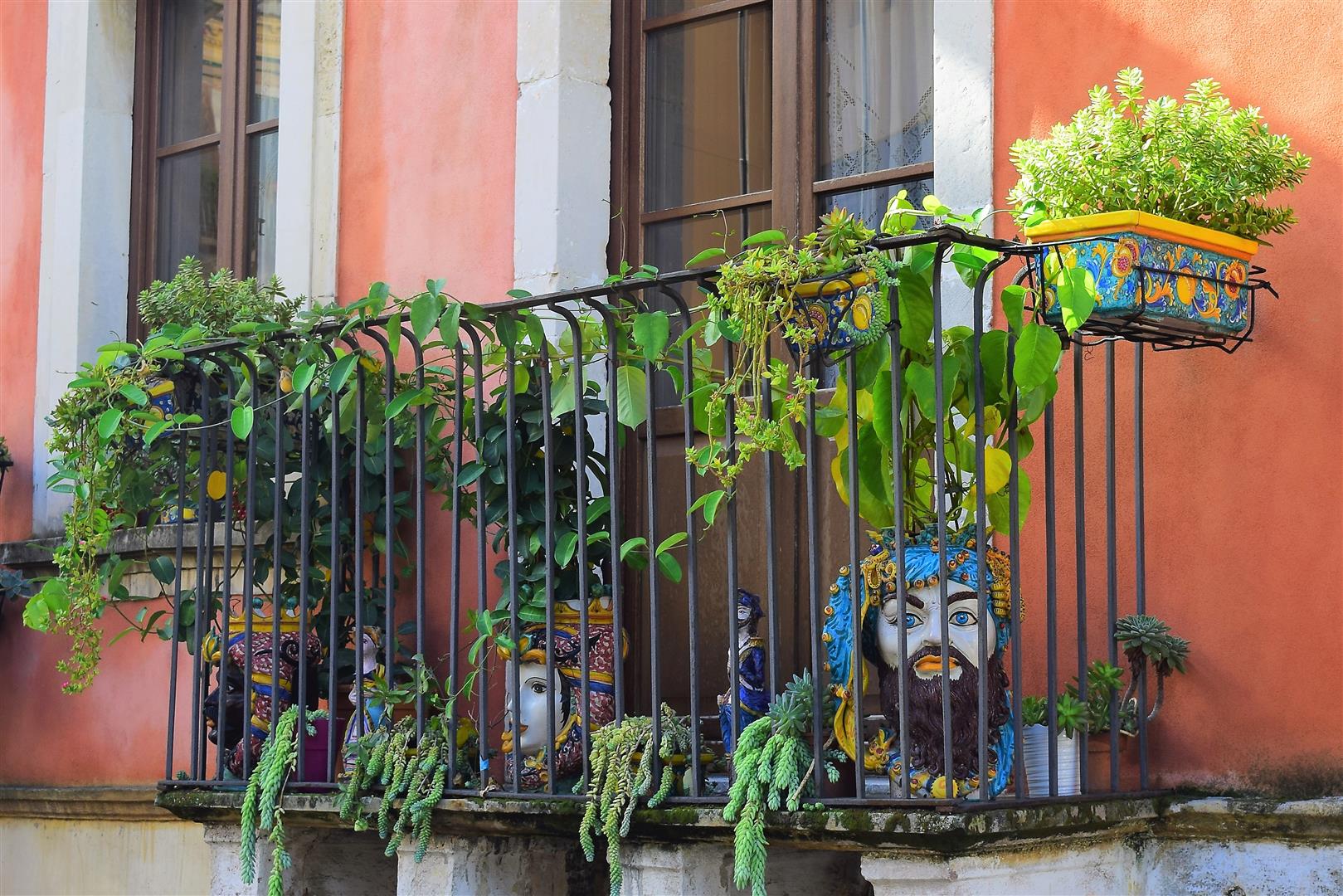
Typical of the beautiful balconies in Tauromina , Sicily , October 2018
A 4th century BC wine amphora from the Greek Theatre in Tauromina
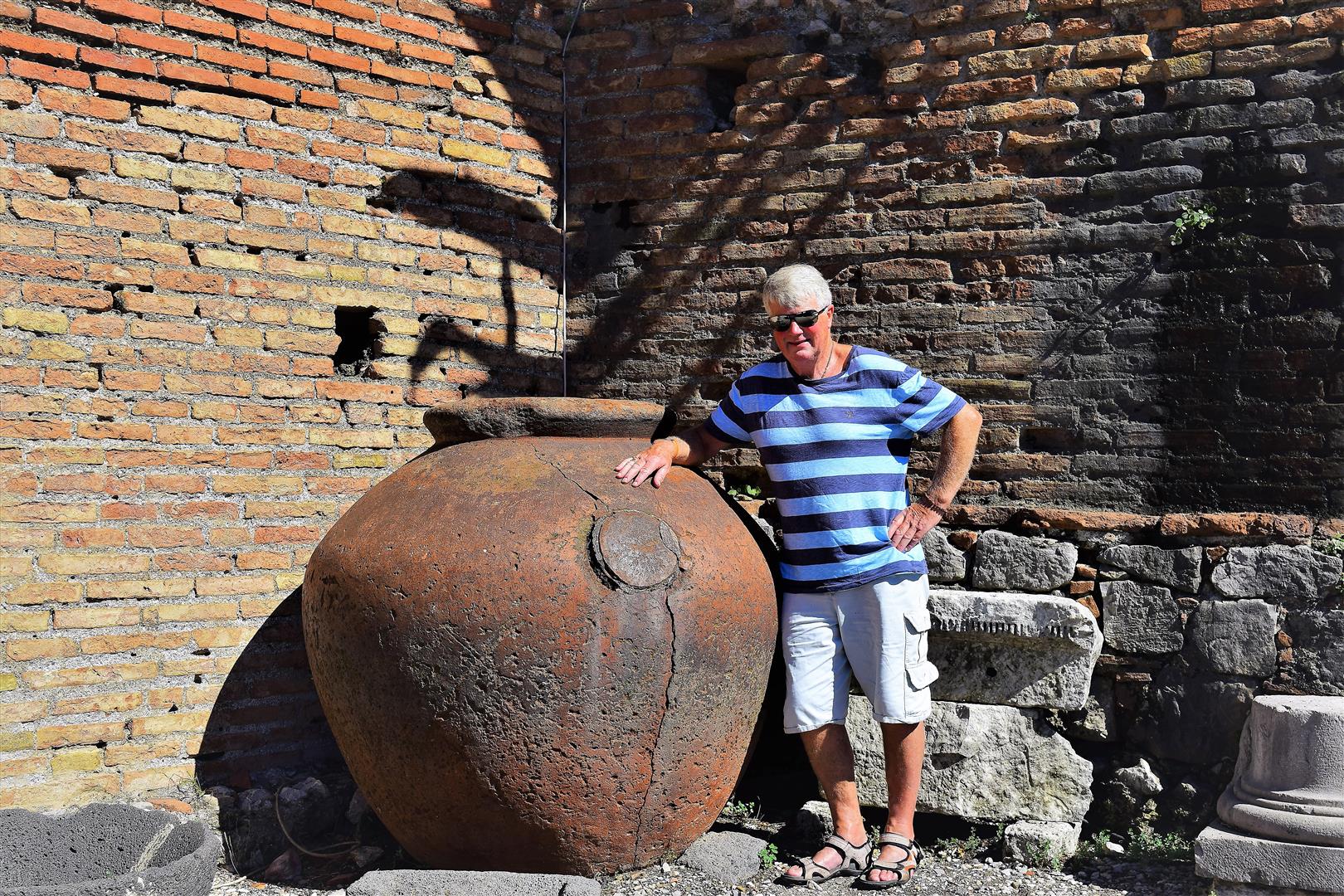
A 2500 year old wine amphora from the Greek Theatre in Tauromina , Sicily , October 2018
A Crocodile Dundee moment with a statue at the 4th century BC Valley of the Temples , at Agrigento , Sicily , October 2018

Temple of Concordia , Agrigento , Siocily , October 2018
Of course no visitor to Sicily should miss the Godfather film villages

Beside the statue to Francis Ford Coppola at Savoca , Sicily , October 2018
Or Cafe Vitelli in Savoca where Michael Corleone first saw Appolonia

Nothing has changed at Cafe Vitelli since the Godfather was filmed there in 1971
Mount Etna is also a must see when visiting Sicily
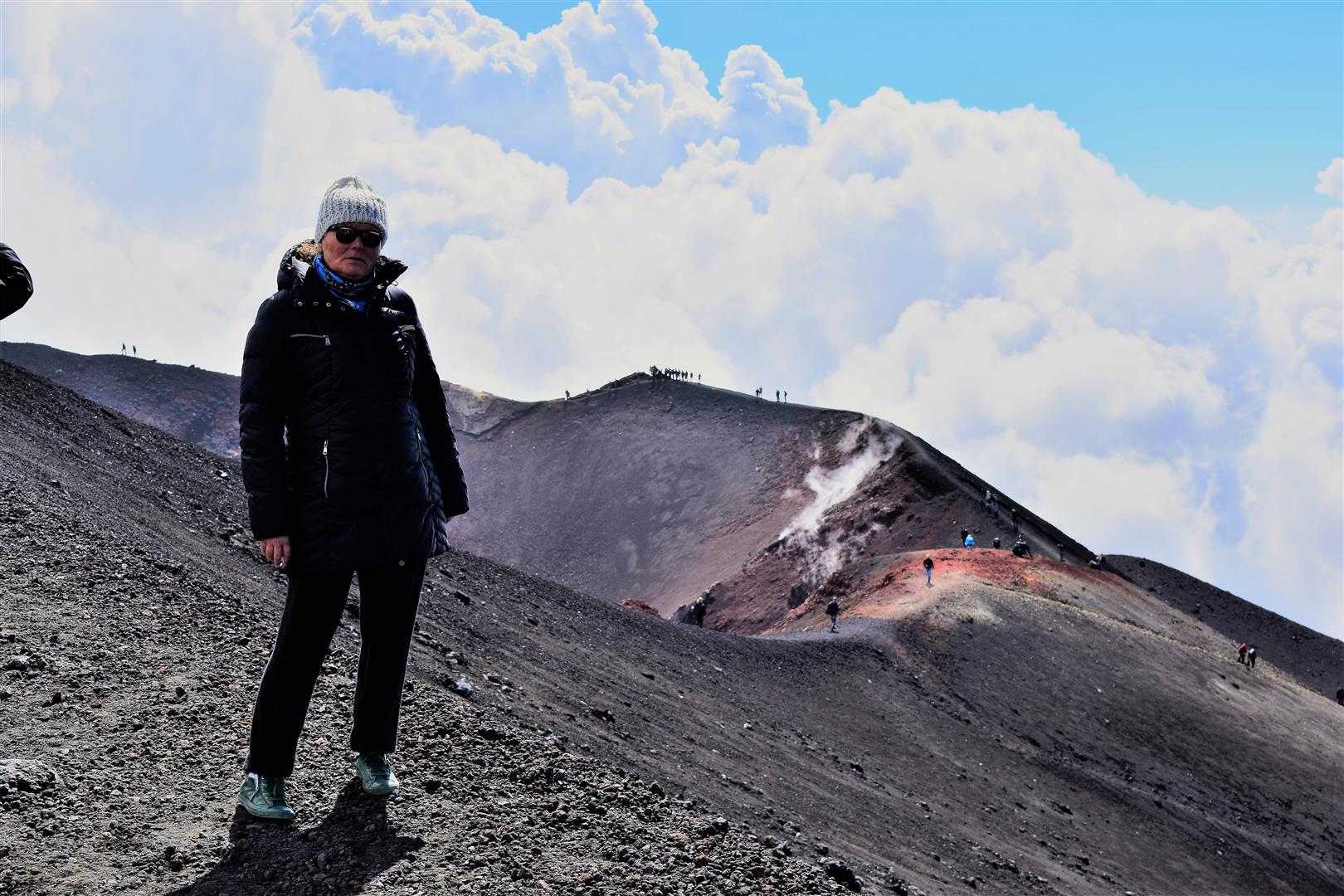
Snezana near the summit of Etna , October 2018
A visitor to the garden during the Open Day for the Lion’s Club , Eileen Acheson , asked if I would give a talk on the garden at the September 2018 Apple Fest
A Talk delivered at Clonmel Arts Club September 28th 2018
We built a garden … The Petrovska Garden Story
Eighteen years ago we bought our house at Old Spa Road here in Clonmel and this came with seven acres of wetland , land that was so bad that it was really a collection of water logged rushy fields that didn’t hold out any hope of ever being a garden and in fact it was known locally for generations of kids as THE SWAMP.
Against all the odds there is a garden there now and even some apple trees but no exceptional plants or exotic trees as the ground would not suit them but there is a wildness and a character and we believe we have tapped into the spirit of the land and walking through what we have created we feel in tune with this spirit and always come back from a walk down the garden feeling at peace and comfortable within ourselves .
This is airy fairy new age stuff that I never expected to hear myself speaking about what is essentially an inanimate and artificial thing , as gardens normally are , where plants and shrubs are grown shaped primped and pruned into rigid lines but we didn’t make this patch of land conform to any plan and went with the flow and where we found reasonable soil we planted , where we came to water we couldn’t drain we bridged it with wooden walkways , the land told us what to do and we followed that advice to end up with what is now a garden open to the public and which has been featured in several books and magazines and visited regularly by garden societies as far apart as Westport , Cork , Kilkenny , Waterford , Wexford and many from Dublin including the Royal Horticultural Society of Ireland .
As I said there are no exceptional plants in our garden but what I feel is interesting for visitors is the narrative of how the garden evolved from the original swamp to what is now a wild garden following Robinsonian lines with rooms opening into rooms and a surprise around every corner . Don’t be fooled however by the word “wild ” as to maintain a garden on the edge of wildness takes a lot of behind the scenes work or nature will take it back and as Dolly Parton once said about her hair , to keep it looking this wild takes a lot of time and money !
We both had worked overseas for the EU for over twenty years throughout the Balkans when we decided to buy a house in Clonmel and as I was born and brought up here I knew the town and surrounding countryside well and we had narrowed down the search for a house to three locations and as Snezana was the stranger to the area I decided she should choose which of the three prospective houses we should buy and with that in mind we walked the locations and left this house and land to the last … we battled our way down the swamp ground through waist high grass, crossed the stream to the pine woods and suddenly she said you can’t see another house or building from here lets go for this one !
We moved in over a weekend in late November 2000 and the following Monday travelled back to Bosnia and for the next eight years continued to work abroad visiting twice a year for 10 days at a time and on each visit planting trees and the odd shrub so that when we finally came to live here full time there would be the outline of a garden framework in place .
With hindsight and as they say “ if I knew then what I know now “ there is no way we would have attempted what proved to be a massive project to reclaim almost eight acres of swamp from the wilderness and most people would have shouted RUN !! It was madness but looking back now eighteen years later it was worth it and in retirement it gave both of us a second career .
That naievity on both our parts also helped mask the enormity of the task in that there never was an overall plan just a series of projects tackling various areas with one leading incrementally to the next so we never woke up in the morning thinking there was a mountain out there to be climbed …rather every few months there was another exciting project beckoning to get started on .
The first project when I came home full time ten years ago was to make access easier in all weather to the entire garden and we designed and laid out hard core gravelled paths around the perimeter of the eight acres and it seemed there was a digger parked permanently at the house in those early years … we used the opportunity to bulk up low lying areas with the excavated soil , created small dams along the natural stream which then allowed us to dredge out a small pond which in turn gave the idea to create a small island in the middle of the new water area by digging out a channel around a planted up area into which the water found its own level , which in turn led to a small japanese style bridge and of course a bridge needs to lead somewhere so that led to a wooden walkway through the wilderness area which allowed up close and personal contact with the most wonderful series of Scottish thussock grass hummocks growing wild in the deepest swamp area hidden amongst the wild iris’s and reeds and inaccessible normally unless in wellie boots on 5 foot stilts !
From the first excavation by the digger in those early days we thought it was lovely when in fact looking back now at photos of the mud , the water, it looked like the trenches in the First World War and was positively awful and visitors must have been looking at our enthusiasm and wondering when the men in white coats would be arriving to take us away !!
You need a sense of wonderment and total naievity to tackle such a project and you can see how it all happened now and that’s how we continued , one idea would lead into another – I had retired and was working full time in the garden while Snezana would come back on leave every six weeks from Kiev , Kosovo or the frontline in Eastern Ukarine and look at what was being done with fresh eyes which would lead to further tweaking of the project .
An ecological report commissioned in the early days stated that any native tree planted en masse “ will provide a hunting ground for local sparrow hawks and kestrels which are already residing in the area which also holds a healthy population of pheasants “ . The report recommended “ oak , larch as good strong trees for planting along with willow ” .
Gradually over the next two years having seen what could be accomplished with wooden walkways over water we laid paths through all the forgotten wetland corners of the garden so now all areas are accessible . We planted along these paths and every year nature further colonized with mayflower and the damp loving wild astilbe known as meadow sweet , purple loosestrife , water mint and wild iris which thrives in this garden . Within two to three years this natural growth was providing winter shelter and cover for an ever increasing population of resident water hens and the hundred’s of ducks which return every year with several herons that have taken up permanent residence at the bottom of the area while a pair of snowy egrets arrive from North Africa every December and stays until February … the old adage “ build it and they will come “ so true with the wild life and native plants that self seeded together with the native oak and silver birch and in a short ten years the lower areas of the garden have been transformed completely
In 2012 we were invited to become part of the Tipperary Garden Trail , a scheme that opens selected gardens for charity and we have opened the garden one weekend each year ever since for the Clonmel Lion’s Club charity while the garden is also open for general visitors from May to October each year.
Nature has a way of altering the garden especially this past year where we had Hurricane Ophelia last October followed in February this year by the Beast from the East which dumped a ton of snow over two days and of course the once in forty years drought this summer , we lost a lot of trees and shrubs , sad to see them go but every loss gives a new opportunity to plant something else and life continues in the garden .
To maintain a life long interest in gardening you need a philosophy , a theme if you like … ours is unashamedly naturalistic wild gardening and we let our plants fight it out for space as in nature and only prune back if there is serious overflowing onto the paths that make it difficult to push through .
And along the way you need to get used to being wet, muddy , tired and cold , fingers numb ……it is not all sunshine out there !
Our gardening style
We try to always use trees and shrubs that contribute a combination of good leaf colour and bark so you get a plant of year round interest not the instant hit of a three week flowering period and then you are stuck with this drab looking plant for the rest of the summer . For me a plant has to perform for nine months and for that flowering takes second place .. I have a gardening friend who rings and says come over quickly so and so is in bloom and by the time you get there the thing has either been knocked over by the wind or the rain and is disappointing .
Now having said that I don’t bother with flowering plants , I do admire them in other people’s garden and respect the hard work that goes in to their maintenance . We don’t have the type of nice crumbly soil to grow long borders of perennials , we have accepted this and got on with what we have on the principle of right plant right place and our natural preference has from the beginning been foliage plants planted in a naturalistic style combined with trees that have good bark in winter coupled with good foliage in summer.
Our gardening style here is also governed by the fact that the garden is visited regularly by deer from the mountain who eat away at trees particularly young trees and you never know what they will eat next as we have had trees and shrubs they have left alone for years and you think you have got away with it and then come out some morning and the tree is eaten down to a stump .
Mistakes in the garden yes we have had a few , mainly self inflicted such as introducing a harmless looking aquatic plant to the water areas , parrot feather which looks gorgeous but which in a natural environment romps away enthusiastically and took seven years to get under control and bull rushes which out of youthful nostalgia for cowboy camps lit by dipping them into petrol and lighting I innocently planted five in the main pond and I now rip them out by the hundreds each summer !
A question I am always asked is
How the garden got it’s name
Snezana and I could never agree on a name for the garden over the years as it took shape . At various times I suggested Willow Farm ..Olive Farm … Oakwood House … all equally pretentious … she never suggested a name of her own just kept vetoing my suggestions so we decided not to have a name . However I was contacted by Gerry Daly’s gardening website who asked to list the garden in their guide . Filling out the details online I entered the names of the owners as Michael O’Riordan and Snezana Petrovska – O’Riordan which is her Yugoslav family name but left the garden name section blank and heard no more until back comes the listing as .. you’ve guessed it .. Petrovska Garden !
I could have edited the entry but decided that the computer knew something I didn’t know and had to acknowledge that she always tolerated listening to me prattling on about gardening all these years , japonica this japonica that without complaint …. so Petrovska Garden it is !
Sometimes though when on my own in the quietest part of the lower wood I have been known to sob quietly …. like Marlon Brando in On the Waterfront … I coudda been a contender … it shoudda been me !!
Finally the work continues to this day , do come and visit us !
Autumn colours in the Garden , October 2018

Japanes maple , osakasuki , front garden , October 2018
Last group visitors to the garden in October 2018
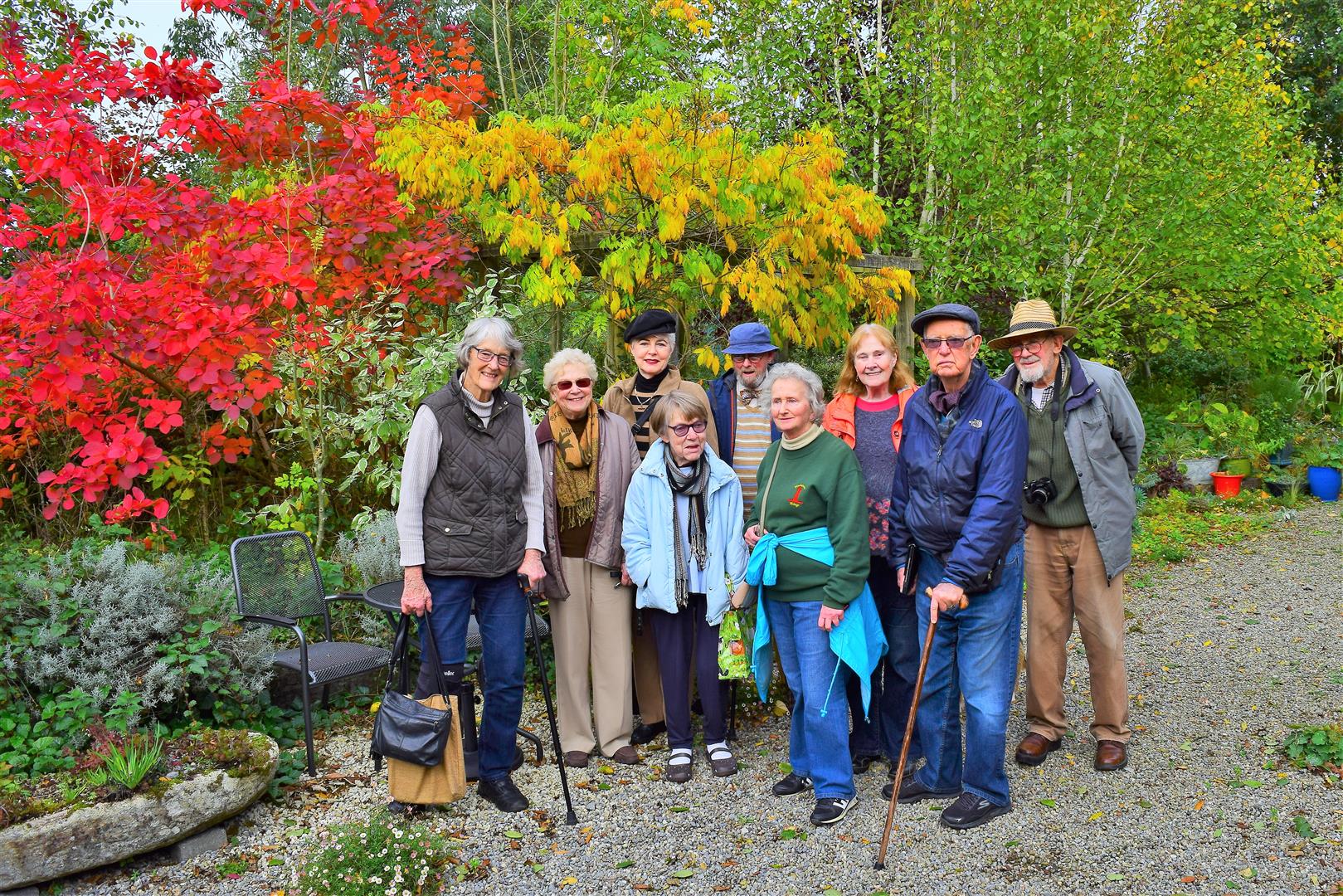
Kingston College Gardening Society , October 2018
Clean up jobs for Autumn , putting the gunerra to bed , October 28th 2018
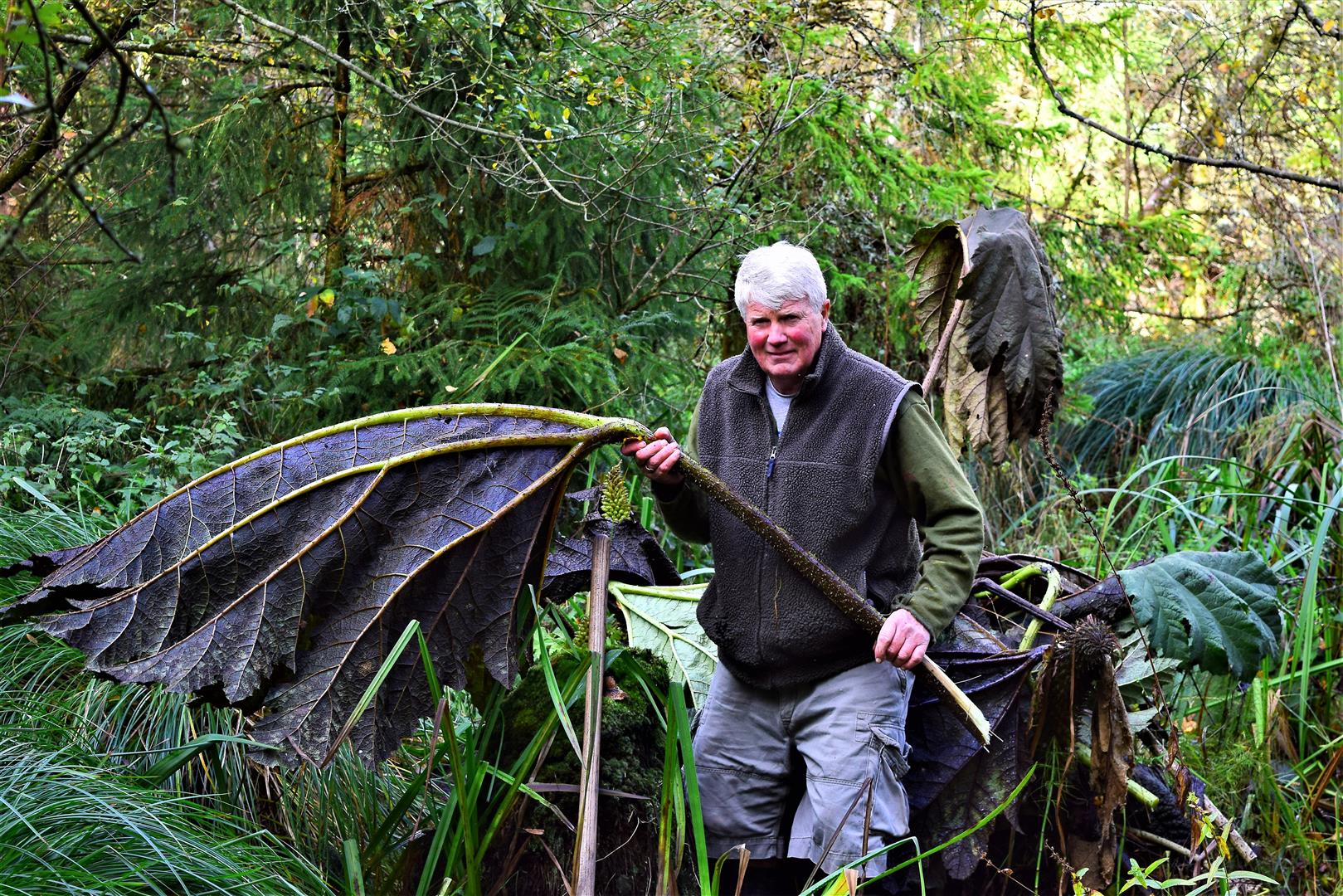
Folding the giant leaves of gunerra over the crown protects it from frost , October 28th 2018
Unusual planting cooperation between two gardeners who normally don’t work together as SHE reckons ” I get all the shit jobs ” however as the photos show who gets to dig the fifteen planting holes for the dwarf daffodils , tete a tete … and who has the ladylike delicate task of dropping in the bulbs ?!

Planting a row of dwarf daffodils in the back garden , October 2018
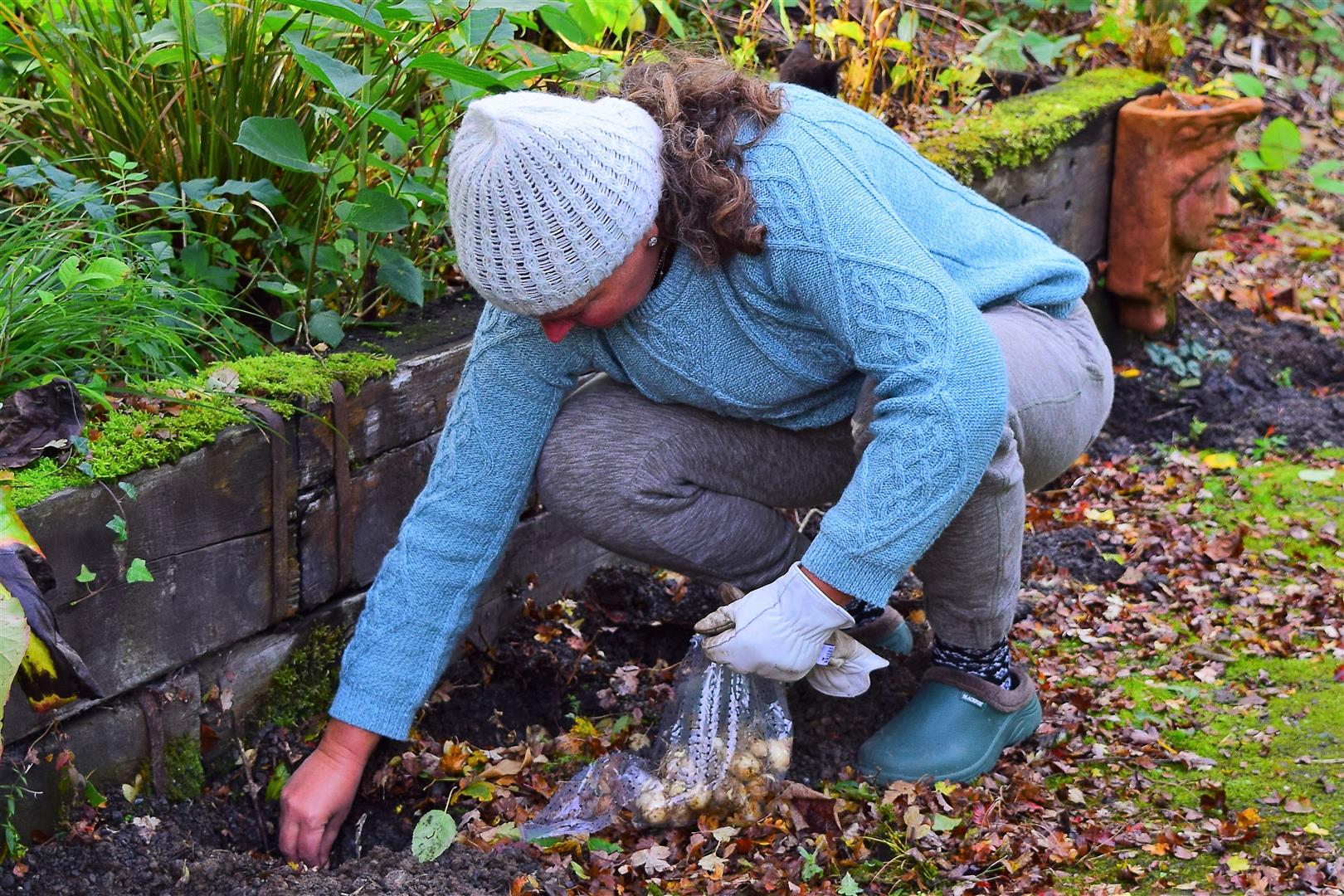
Snezana does the delicate stuff ! Back garden October , 2018
And how it looked four months later in February 2019
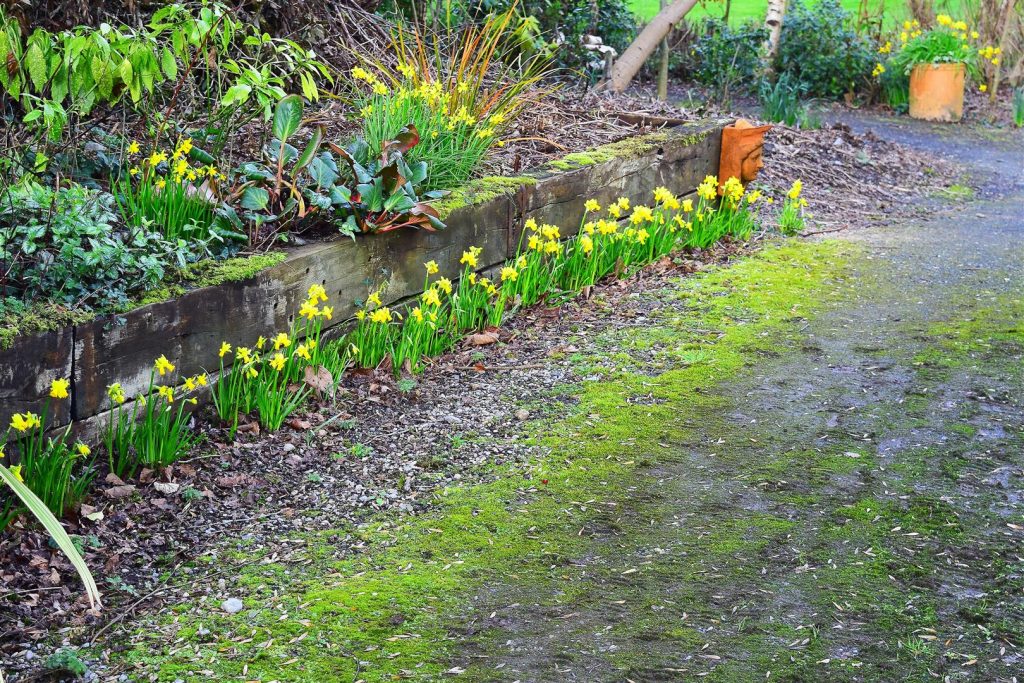
In February 2019 we decided to improve the view of the garden from inside the kitchen and after a week of hectic restructuring by Pascal Mansfield we got the sought after room outside look !
During the construction there was much discussion on what size lintel would be needed to support the new window
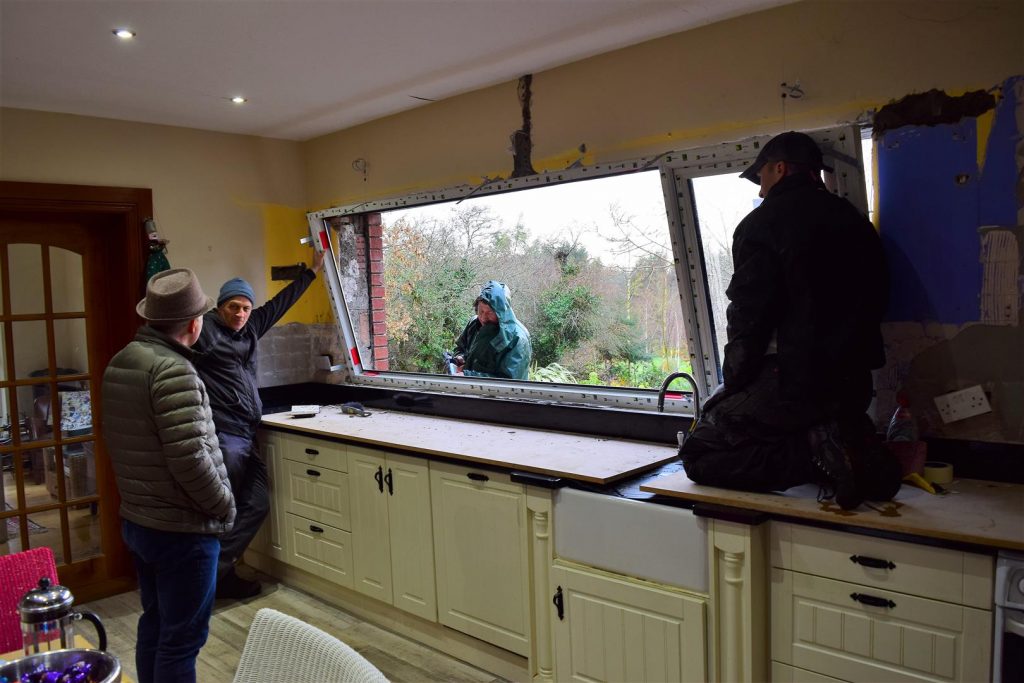
However our trip to Italy in March 2019 showed a Crocodile Dundee moment when we saw a stone lintel carved by the Romans in 100 BC to support the amphiteatre in Verona !


My garden blog for March 2019 was at the height of Brexit madness in the UK parliament
My Gardening Week March 31st 2019 … The Noes have it , the Noes have it !
Like me you have probably have had it up to here with Brexit for the past three years as the UK Parliament that up to now historically has been looked up to as the Mother of all Parliaments but which now has shown itself to be stuffed with pompous old farts loving the sound of their own voices unable to make a decision all the while been led by the nose by ten Northern Ireland DUP MP’S who are against anything that might tie them to the South even though the majority of people in NI both protestant and catholic voted to remain in the EU .
I am always suspicious about a political party that styles itself “ democratic ” me thinks they doth protest too much perhaps and so it is with the Democratic Unionist Party which loves the Union with Great Britain but loves it on their terms which means selectively as in the case of womens rights such as abortion or gay marriage which the DUP don’t allow extend across the Irish Sea … God Forbid they would allow that in the six counties . The Brits of course back in 2016 thought that the EU and ourselves would just roll over which is why the so called “irish back stop ” annoys them so much as it is an agreement they can’t get out of … the cheek of the EU and the Dublin Government to insist on a mechanism that when they signed an agreement that they would have to actually keep their word … can you believe it old boy , absolutely preposterous of Johnny Foreigner , why in the old days of the Empire we would just have sent the gun boat up the river to Paris or Dublin !! A hard Brexit would be disastrous for the Irish economies both north and south of the border which since the Peace Deal 20 years ago have become dependent on each other and the back stop is just to guarantee that all parts of Ireland would remain in the EU Customs area whatever is eventually agreed between London and Brussels but which the DUP see as a border down the Irish Sea and eventually a United Ireland … the DUP would prefer their children to be totally gay rather then be Irish , the lesser of two evils in their mindset .
During our trip to Italy in March 2019 we visited a city where like in our garden there is a lot of water and where a coffee in St. Mark’s Square cost 12 euros !
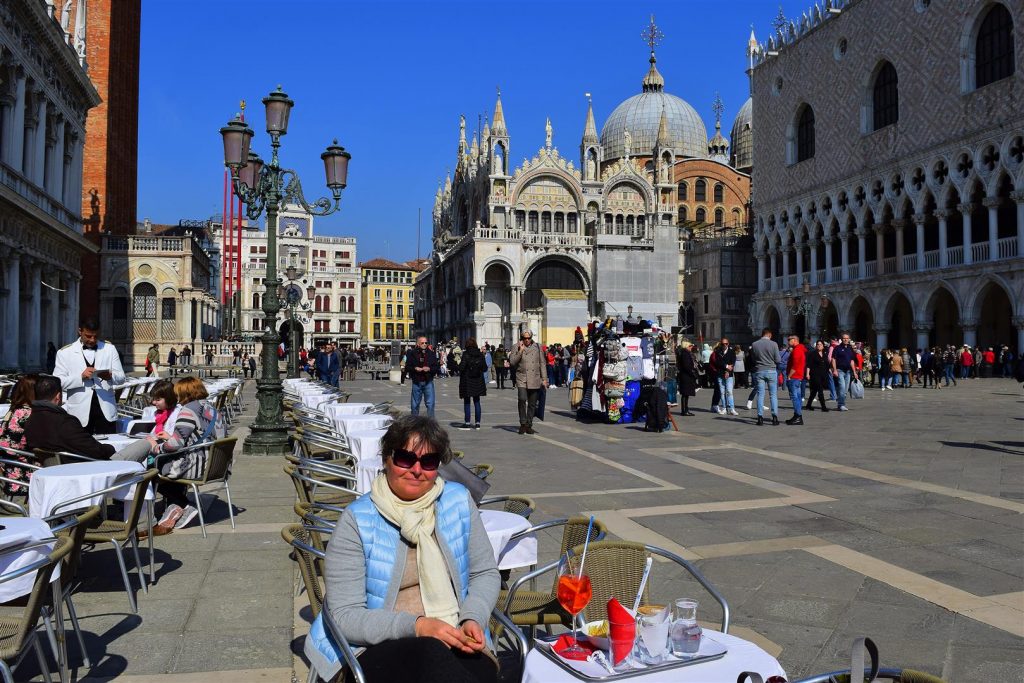

In May we visited the garden in Croatia and saw the difference in mediterranean plants grown in their natural environment and not the miserable looking specimens that sulk in our wet conditions here in Ireland .
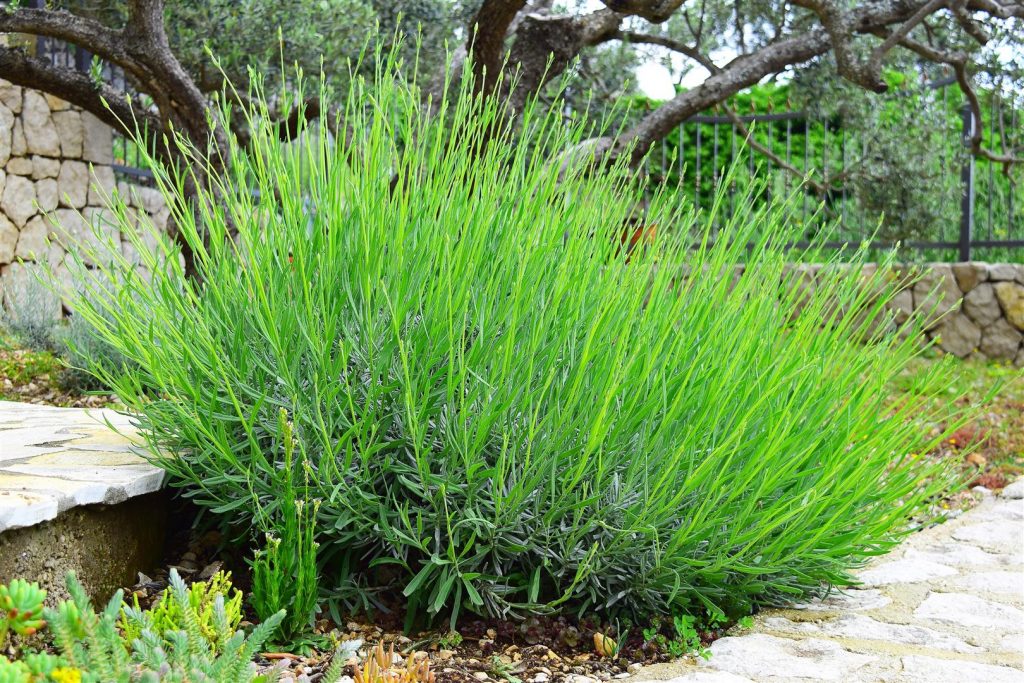
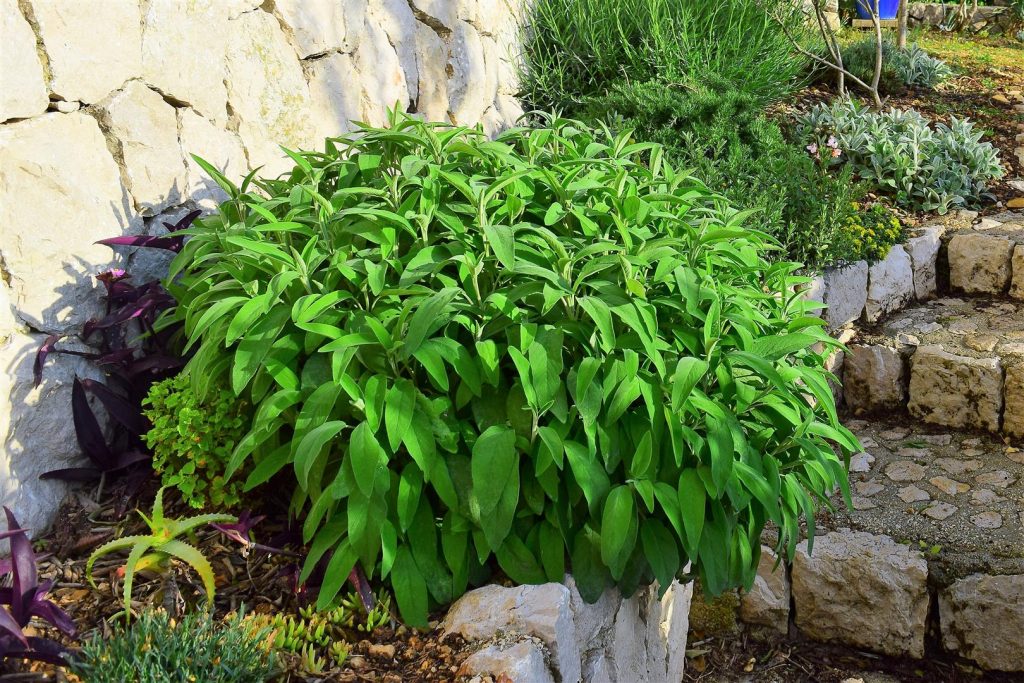
May saw the first of the Gardening Club visits when the Irish Garden Plants Society arrived with 76 members on May 20th 2019 .
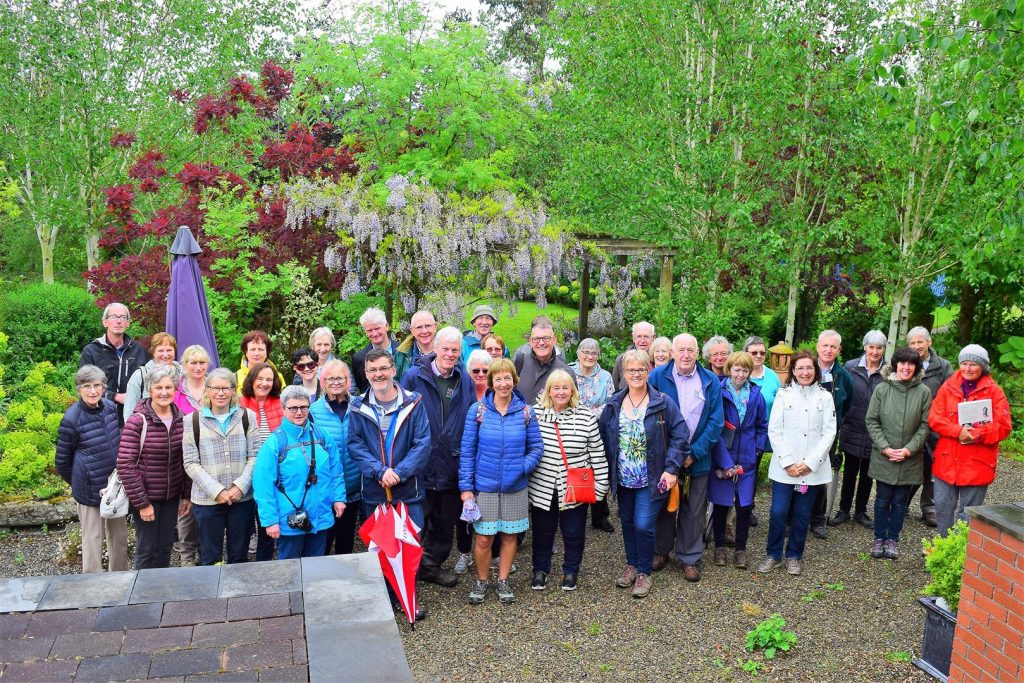
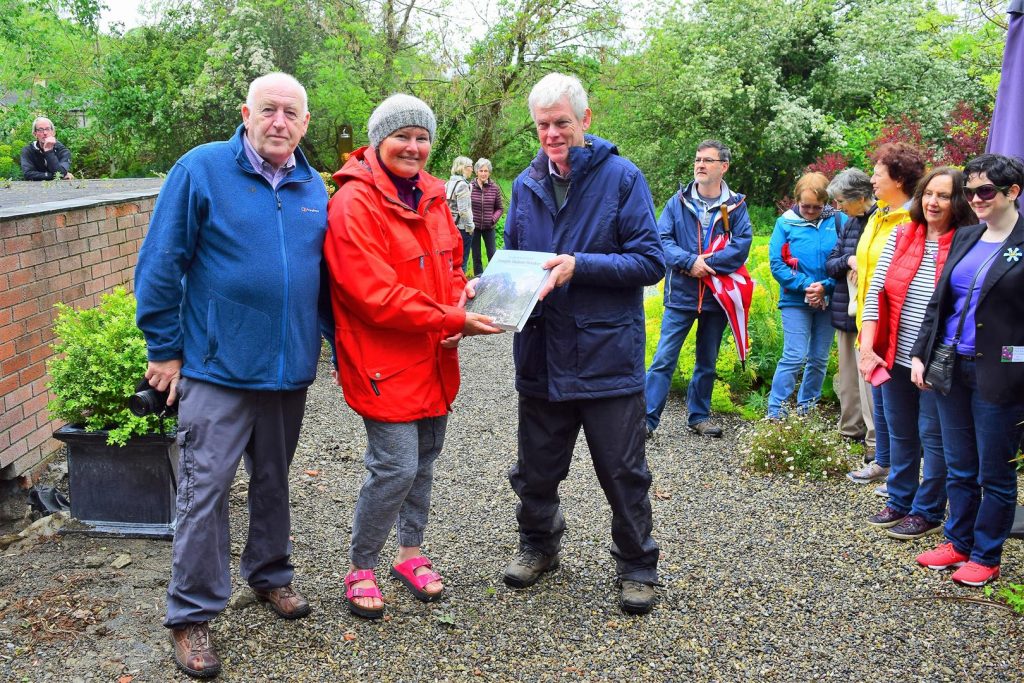
in May , Rachel de Thame , one of my favourite garden writers wrote movingly in the Sunday Times about her treatment for cancer and reminded her readers , if we had forgotten , how valuable life is .
“ I looked out over the backs of buildings during my chemotherapy sessions but was able to focus on a large tree rising above the rooftops following it’s progress from bare branches to stems laden with foliage as my treatment came to an end. That view connected me with a world beyond illness, the common place beauty of a single tree reminding me that life in all it’s forms is wondrous and worth fighting for .”
Sometimes things have to change in a garden and in March I moved a garden seat from the back of the house where it had stood for ten years , repainted it and moved it to a new home down in the Swamp Garden .
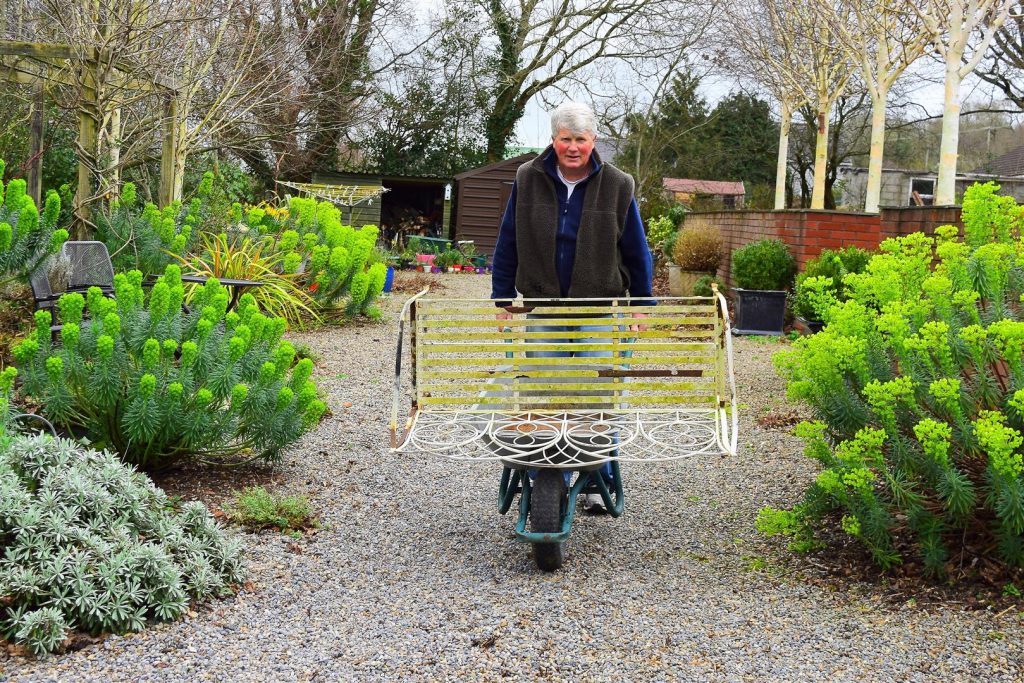
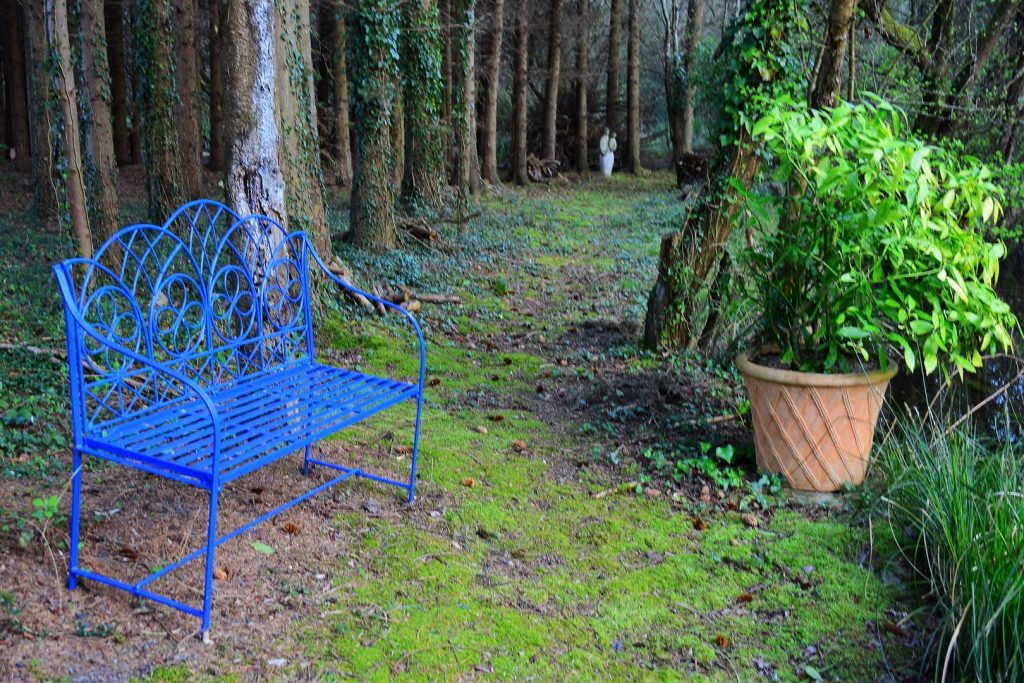
As part of a regular ” Walks in the Garden ” photo feature that I put up on Face Book , this is one from June 10th 2019
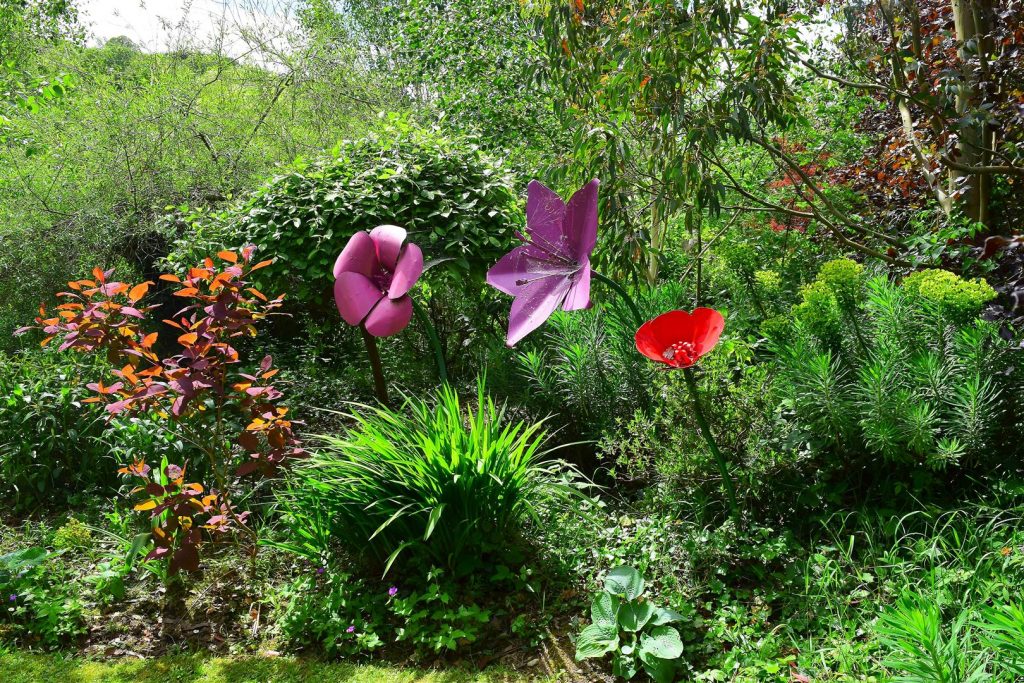
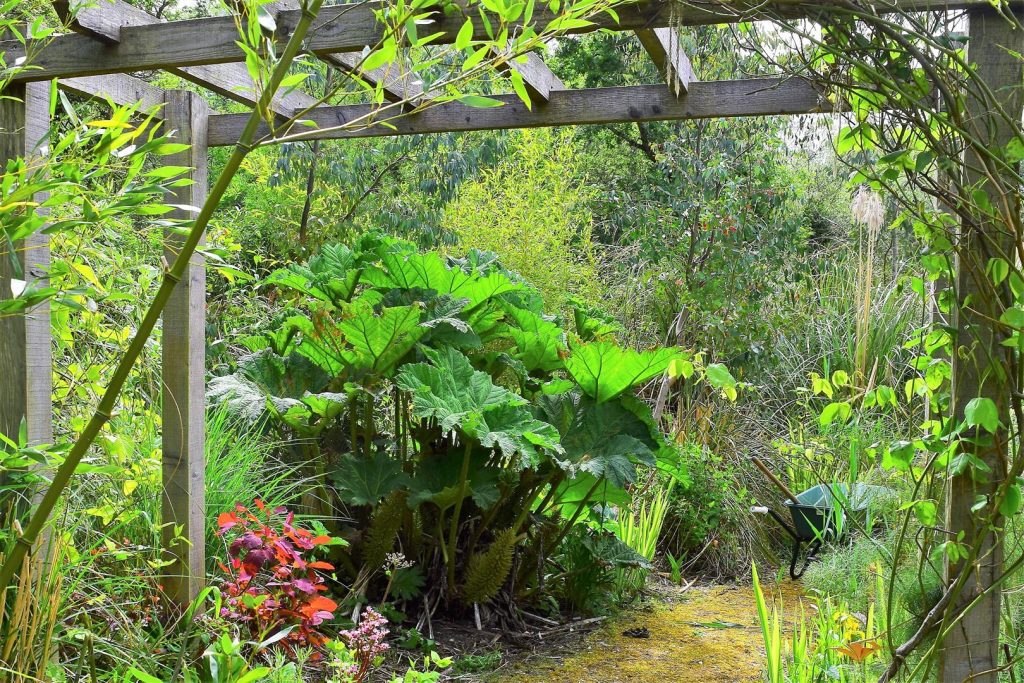
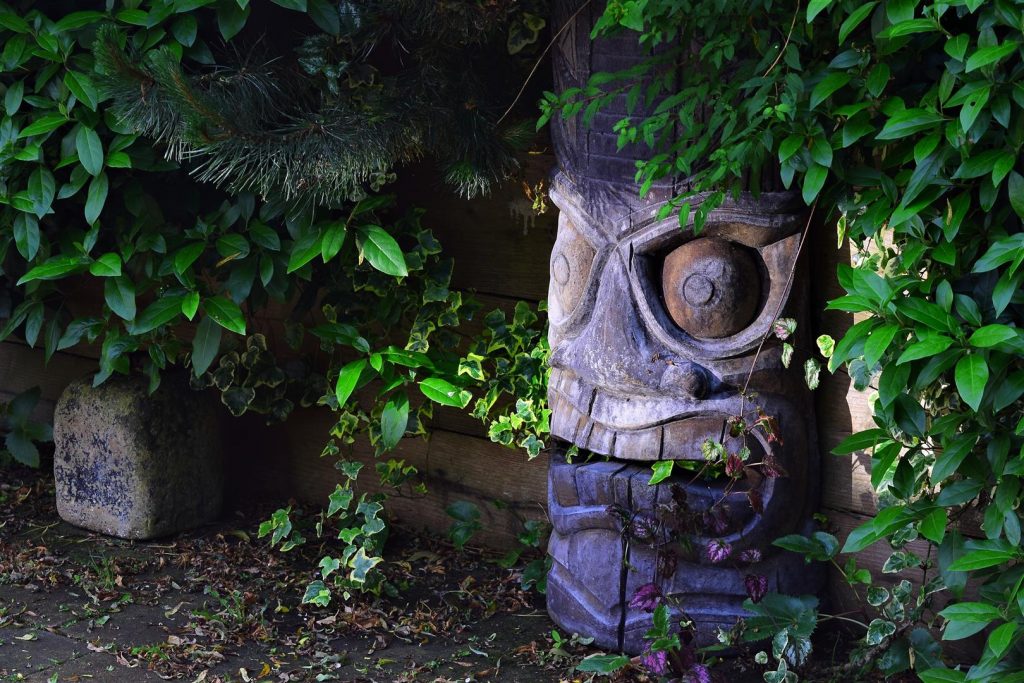
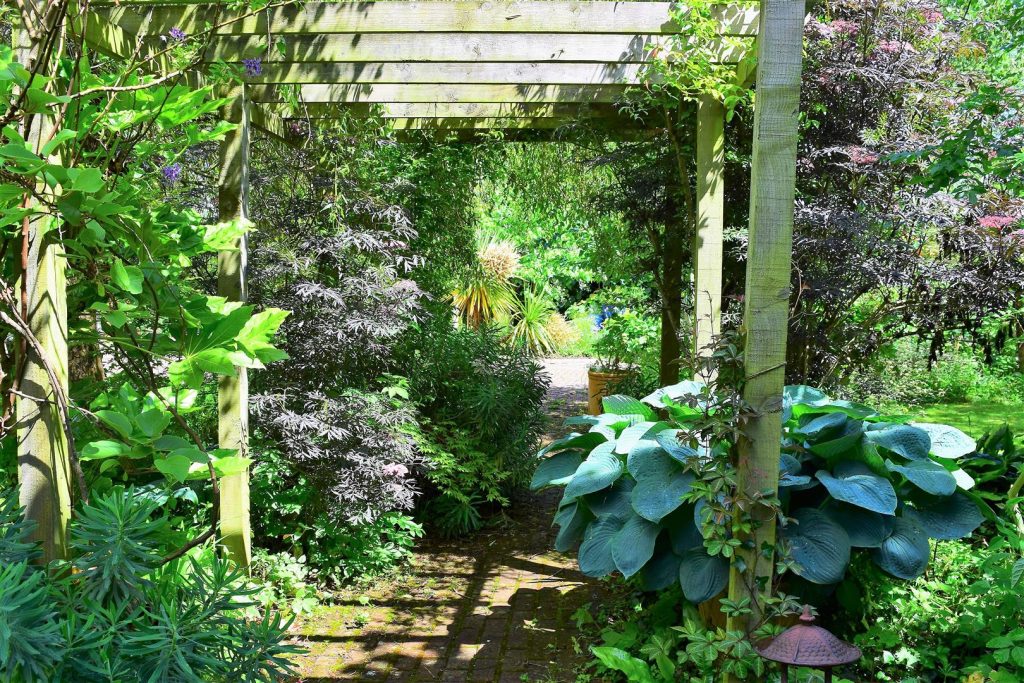


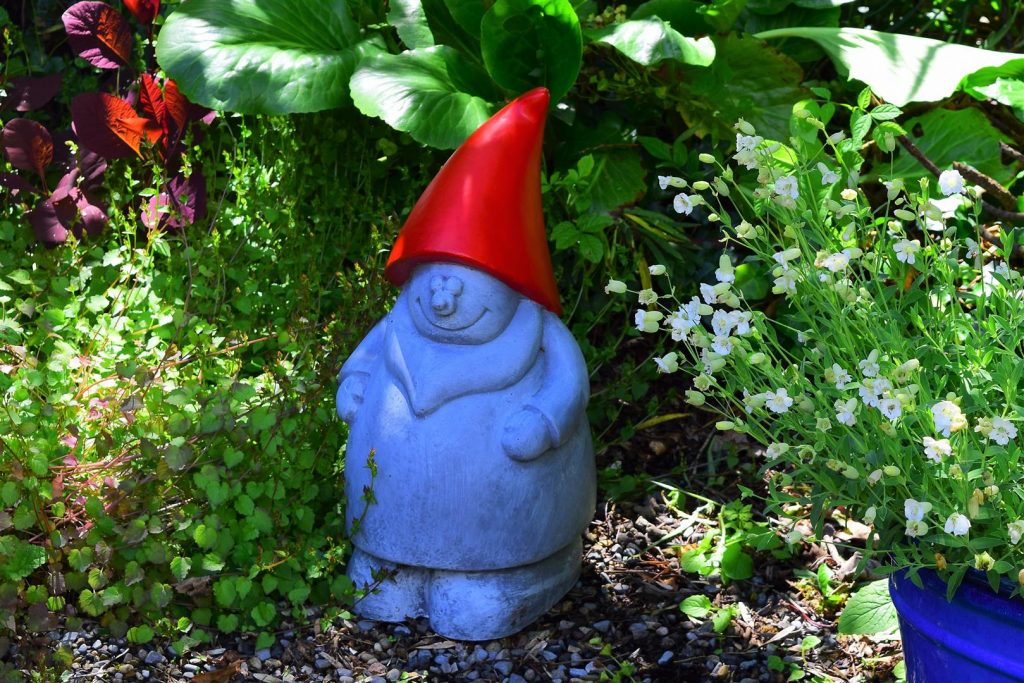
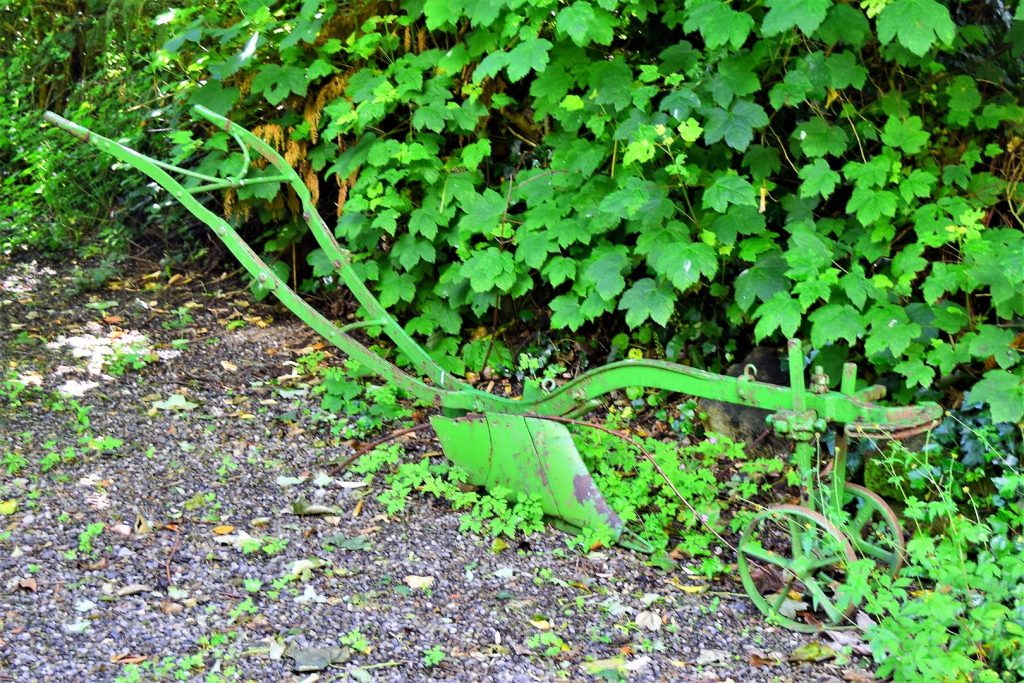
In February 2019 we had to change part of the front garden to get at the power supply for the garden lights , a messy job which saw holes dug at intervals in what was an unsuccessful search and led to a complete rewiring of the lights together with the removal of the ten or so cornus elegantissimus . I loved those dogwoods for their variegated leaf in the summer and the red bark in winter but even I would admit I had left them grow too big with the result that they reached to almost three metres high at the height of the summer and covered up that part of the Front Garden but still I loved those leaves ! However much as I loved the dogwoods , Snezana disliked them as she felt they cluttered up the area … higgedly piggedly in her words … and much as I try to accommodate her design wishes in the garden I over the years had dug my heels in … the dogwoods were staying !
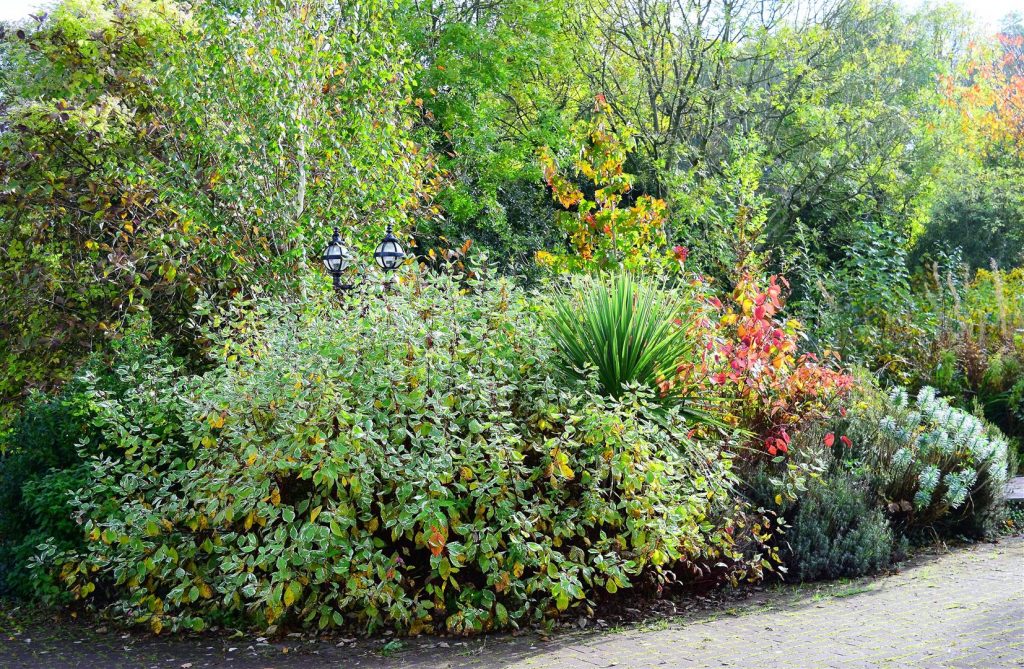
However … ahem … I liked the bare look of the area without the dogwoods and yes it did as she has been preaching ( nagging ?) for years open up the entire area and allowed the two mature trees there , a silver birch jacquemontii and a liquidamber , to stand out whereas before their lower growth had been smothered by the dogwoods … shouldda gone to Specsavers earlier !!
Gardens do and should evolve over time and a make over every few years can be a positive as shrubberies , plantings ( and gardeners !) can get stale and I do have to accept that I am a tad conservative in engaging in large scale change in the garden unless such as here where I had no choice ( if I wanted the garden lights to work ) so it made the decision easier … but the sound of crowing from the other gardener here was fierce annoying !
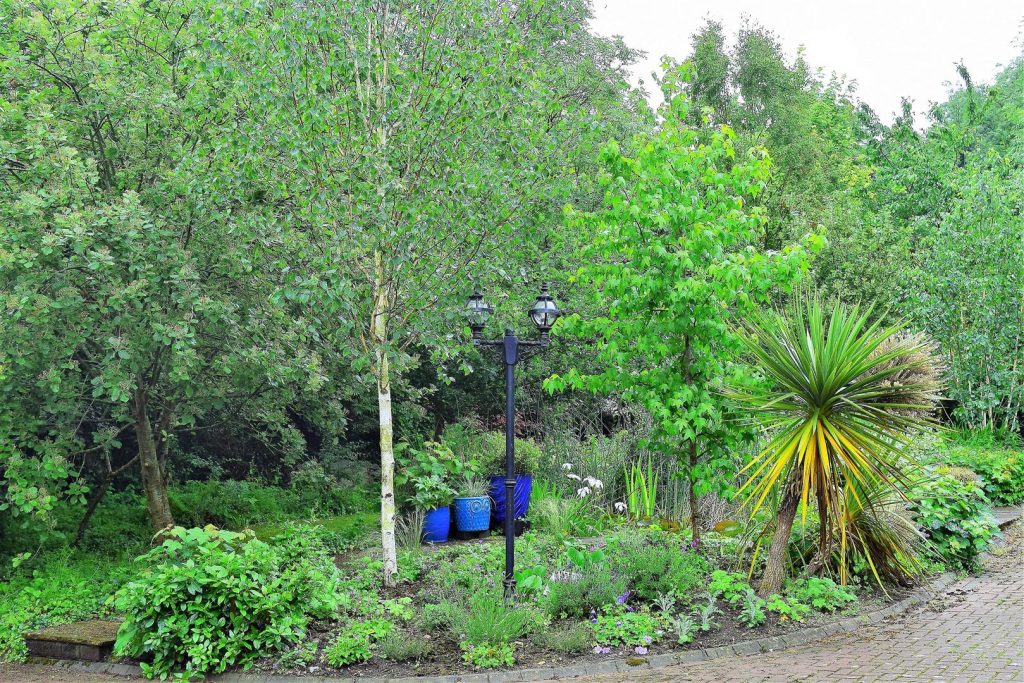
I have planted the new area up with a variety of ground cover plants , geranium biokovo and nudosum and some Bergenia and in the winter I will carpet the area with dwarf daffodils and crocus for early Spring colour next year .
In July 2019 I wrote that ever popular at the moment in the gardening world are wild flower meadows and especially since a back to nature theme was the focus of the Chelsea Flower Show this year with cow parsly and the like featuring in all the winning show gardens . I have never taken to this myself as I always feel the wild flower areas in private gardens look untidy and a bit messy and this is largely down to gardeners who tend to leave a patch uncut and then call it their wild flower area when in fact no planning or care has gone into it in a kind of lazy mans gardening . I use the words private gardens for this pet hate of mine but in public gardens run by local councils a designated wild flower area can look spectacular especially if a path or wide edge is cut carefully around the designated wild area then it can look designed and with this in mind I have set aside a small area in the lower field garden which I will try to maintain as our own wild flower area .
If you research wild flower gardening on Google you will find that rigorous preparation is needed to prepare the area beforehand and when I say rigorous I mean full blown war where the area is blasted with full on glyphosphate weed killer for at least a year so that not even a blade of grass is left alive … yes these paragons of virtue , the ruthless rainbow warriors mean business and have no scruples with the use of weed killers in making sure THEIR wild flower areas get off to the best possible start so that there is no competition such as couch grass or docks present when they sow the seed and assorted plugs of selected flowers , then you after the first season you cut it all down and the second and third year you sow special seed varieties that will kill of any stray seedlings not in the plan … so real wild flower gardening is a four year managed project and of course that is assuming you are beginning with dry soil and not too rich nourishment .
Our selected area is not the best as it is wettish with good grass growth so we can expect a lot of docks and yellow buttercup but hopefully a lot of ragged robin which has a beautiful pink flower and seems to grow there naturally and all I am doing this year is allowing the grass to grow uncut there but surrounded by mown areas so it looks a bit managed and next year I will throw in some wild seed suitable for heavy ground and perhaps some perennials and see how it goes and if it just looks like a dogs dinner well we can strim it down , nothing ventured nothing gained !
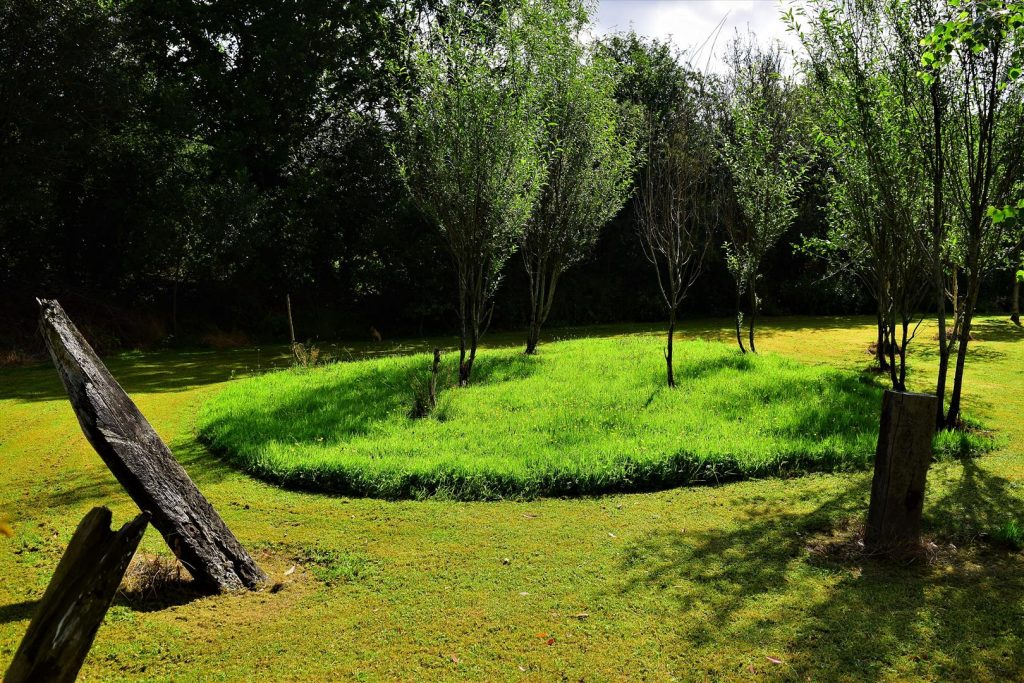
A good friend and a great Clonmel gardener passed away early in July 2019 , Mary O’Donovan and I will miss visiting her at Fairy Hill her woodland garden set over three acres along the Suir . Mary was a no nonsense type of person when I first met her years after she had retired as Matron of Kilcreene Hospital in Kilkenny where she took no prisoners according to her former colleagues , a style she continued with to the end of a long life . I first met her eight years ago when we opened the garden here at Old Spa Road for the first time and as a near neighbour she rang to check out the garden and more importantly the gardeners … we passed inspection , remained good friends and regular visitors to each other’s garden and we will miss her .
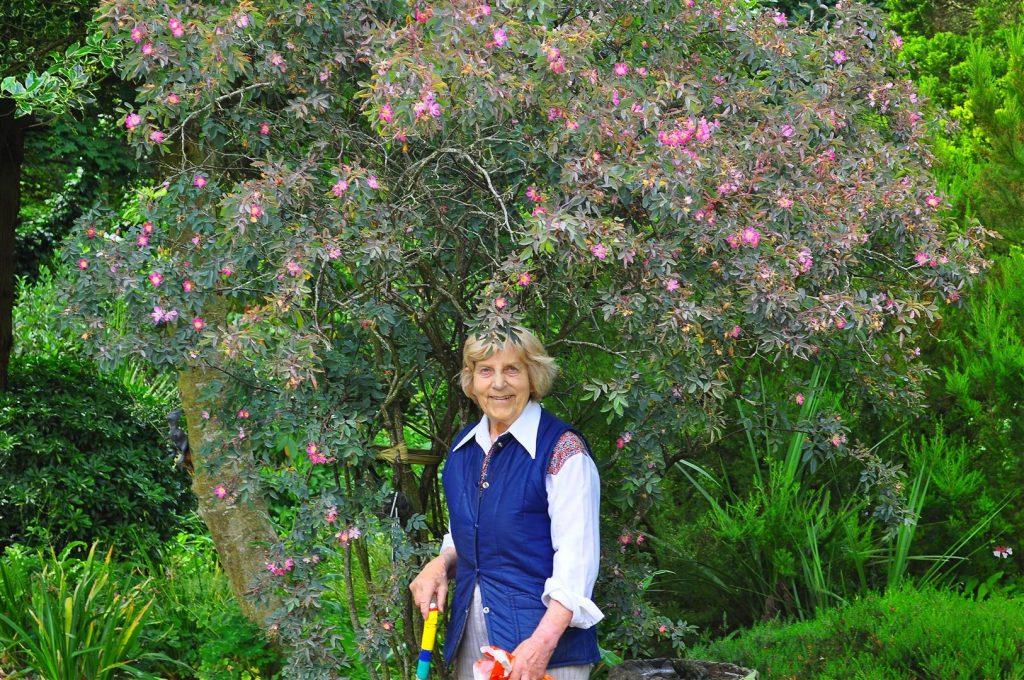
In August 2019 I got to meet Dan Pearson , and inspirational garden writer , at the Carlow Garden Festival and who has been one of my favourite writers over the past twenty years .
I have been gardening for over forty years starting at a time when there were little or no gardening programmes on TV and certainly no internet , a time when you learned about gardening mainly from gardening books and in the 1970’s and 80’s my two gardening writers to collect and read were Christopher Llyod and Robin Lane Fox . I never managed to visit and meet Christopher Llyod at his famous garden in Great Dixter in East Sussex but his books were a constant inspiration particularly the Well Tempered Garden and it is a constant regret that when on a cycling tour around Southern England , Kent and Sussex in 1981 I visited Sissinghurst but didn’t make it the extra 40 miles or so on to Great Dixter deciding instead to visit the garden of Winston Churchill at Chartwell and that of Rudyard Kipling at Batemans , I was heading to London and my thinking was that I would make it back to Sussex within a few years but EU duties in the Balkans took me away for the best part of the nex twenty years and Great Dixter is still on my to do list .
I met Robin Lane Fox in 2015 at the Carlow Garden Festival and again I have all his books , they say never meet your heroes but Lane Fox didn’t disappoint and last week I got to meet my last gardening writer legend when we attended a lecture by Dan Pearson at Altamount Gardens . I have been a fan of Dan Pearson’s style of writing from his first book back in 1997 and his style is laid back , non confrontational unlike Christopher Llyod , he comes across in his writing and TV programmes such as a Year at Home Farm as very gentle and was ahead of his time in that he has been advocating a wild gardening approach away from the structured lines of typical perennial lovers for the past twenty years long before it became fashionable .
Dan Pearson won a gold medal and Best Show Garden at the Chelsea Flower Show in 2015 and is now the most sought after garden designer in the world and is revered in Japan where he is working on a millennium project of over 1000 acres which will take the next twenty years to complete .
I had brought over some of his books for him to sign and got to sit down with him one on one before his talk which centred on his gardening philosophy which is a natural wild approach and which has veered away from the traditional manicured perennial beds so loved by UK and Irish gardeners and of course he is now so in demand that he can pick projects that only suit his personal tastes in garden structure and design .
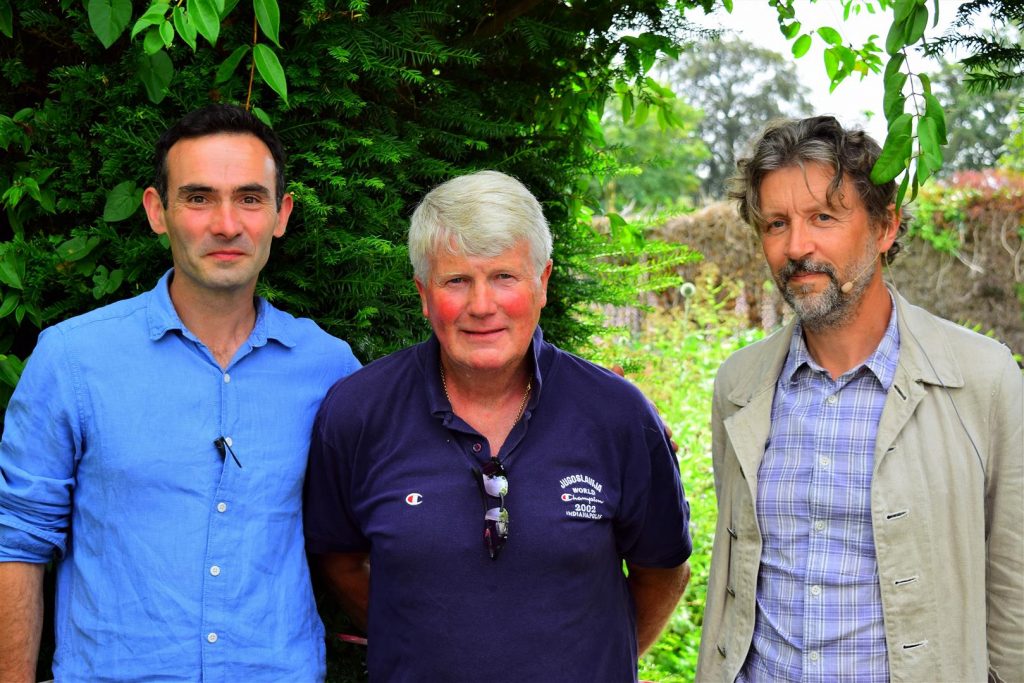
In my September 2019 blog I wrote about the japanese “bathing in woods ” where a recent Telegraph article detailed the effect woodland has on the amygdala … the wha I hear you say … yes me neither but it is the part of the brain which regulates the response to fear , anxiety and stress and the article was about a recently published German research , in the journal Scientific Reports , on 341 older mostly retired residents of Berlin . It is accepted wisdom that exposure to green space and the countryside has beneficial health effects however this research has shown that exposure specifically to woodland brings increased beneficial and calming effects to the brain and we are not talking here about a few trees in the garden … no the research found that independent of income or personal circumstances the effect was massive when actual woodland was involved … go often for a walk in the woods !
The Japanese as always are ahead of us in matters of nature and have a word for exposure to woodland , they call it shinrin yoku , “ wood bathing ” or taking in the atmosphere of the forest so that basically walking in the woods is relaxing and calming for us .
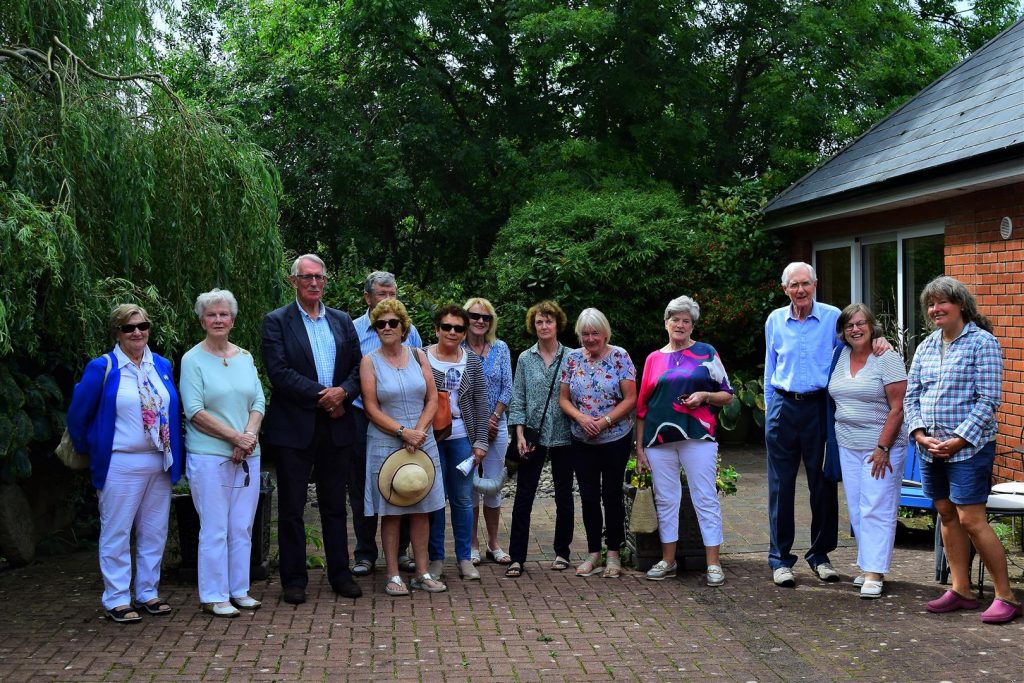
In September 2019 I wrote about using stone in gardening
Stone has always fascinated me especially dry stone walls and in another life I would have been a stone mason although I wouldn’t fancy working in the open in all the weather these guys do especially in the cold on the Irish and Scottish mountains and I have always admired their skill and dedication but Croatia has in my view the best tradition of building in stone and I was privileged last year to watch up close a group of masons from Immotski building a series of stone terraces in the garden in Gornija Podgora … these guys took their time both in selecting the individual stone and finally placing it and in several tricky cases took thirty minutes over one stone before being satisfied and I also saw them rejecting three lorry loads of stone as being unsuitable for this particular project , such dedication to their craft is rarely seen and certainly not here in Ireland .
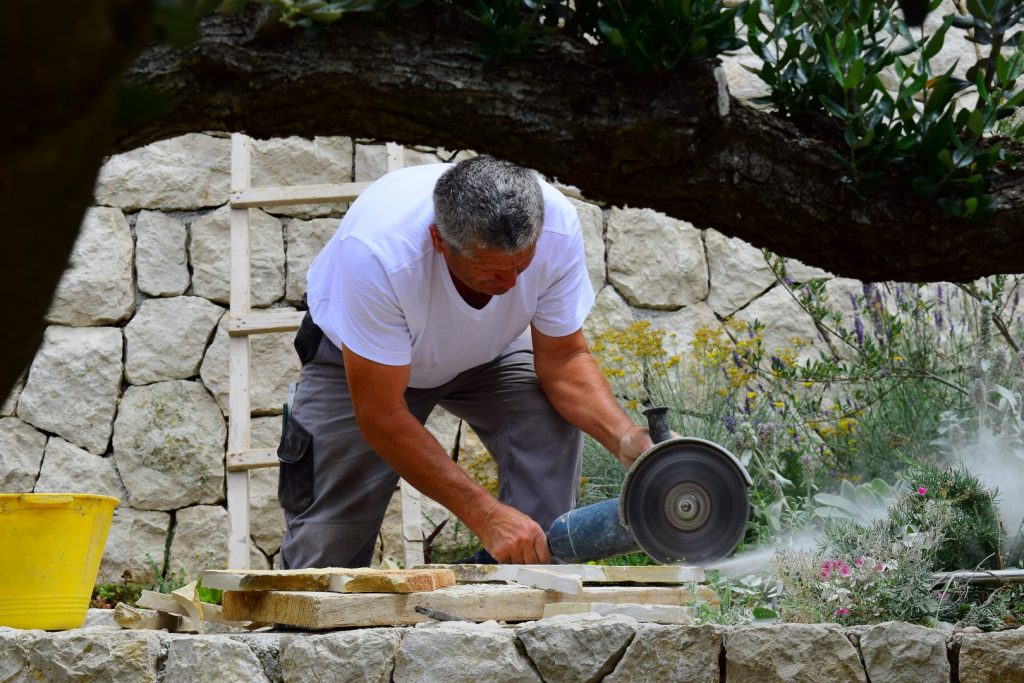
The Croatian Island of Brac is famous for it’s stone and legend has it that masons from Brac as well as marble from the island took part in the building of the White House in 1792 where that shy guy , Trump , currently resides and they also built parliament buildings in Budapest and Vienna when Croatia was part of the Austro – Hungarian Empire . Brac has quarries dating back to Roman times and it’s stone was used to build The Roman Emperor Diocletian’s palace in Split in 389 AD and today one of only two Stone Mason Academies in Europe based is in Pucisca on Brac with the other one in France , the school was founded in 1909 and the tradition is very much alive today with currently 95 students from all over Croatia including fifteen from Brac itself . In September we met Ante Kusmanic , a graduate of the Pucisca Academy , at his work shop in Brac where Snezana fell in love with one of Ante’s works , a beautiful stone table with the base alone weighing over a ton weight … the pictures tell the story of Ante’s work and the finished table is a work of art !
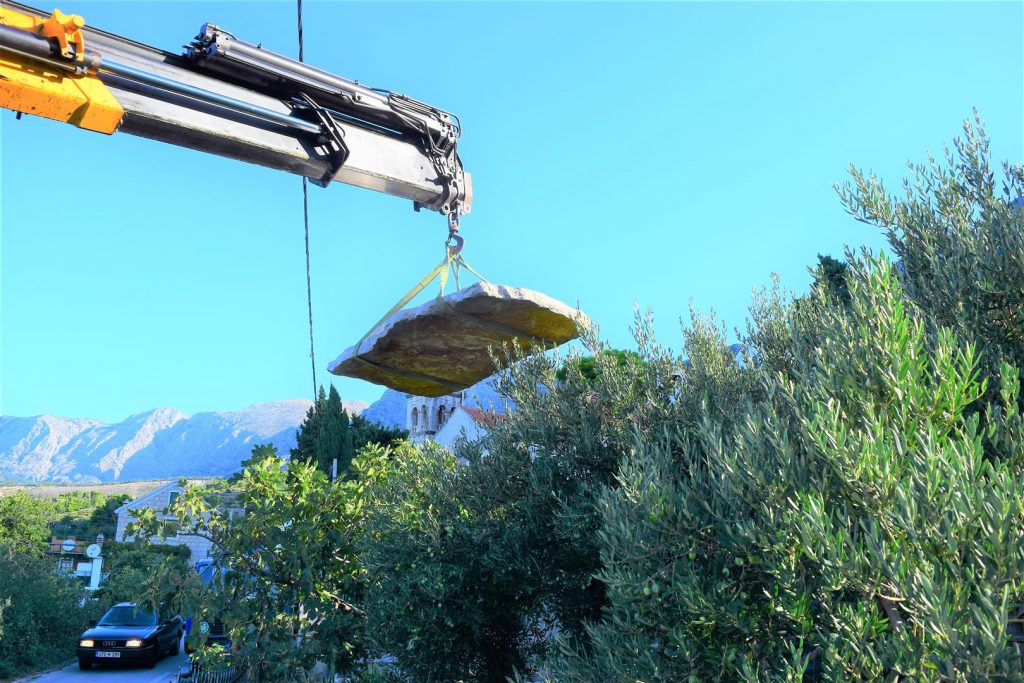
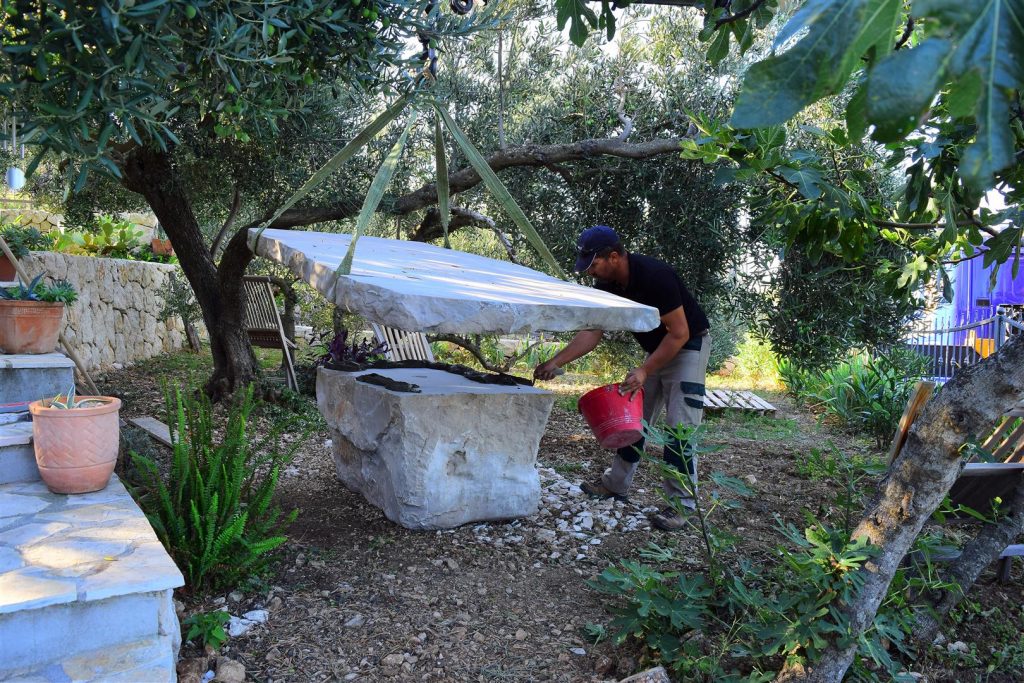
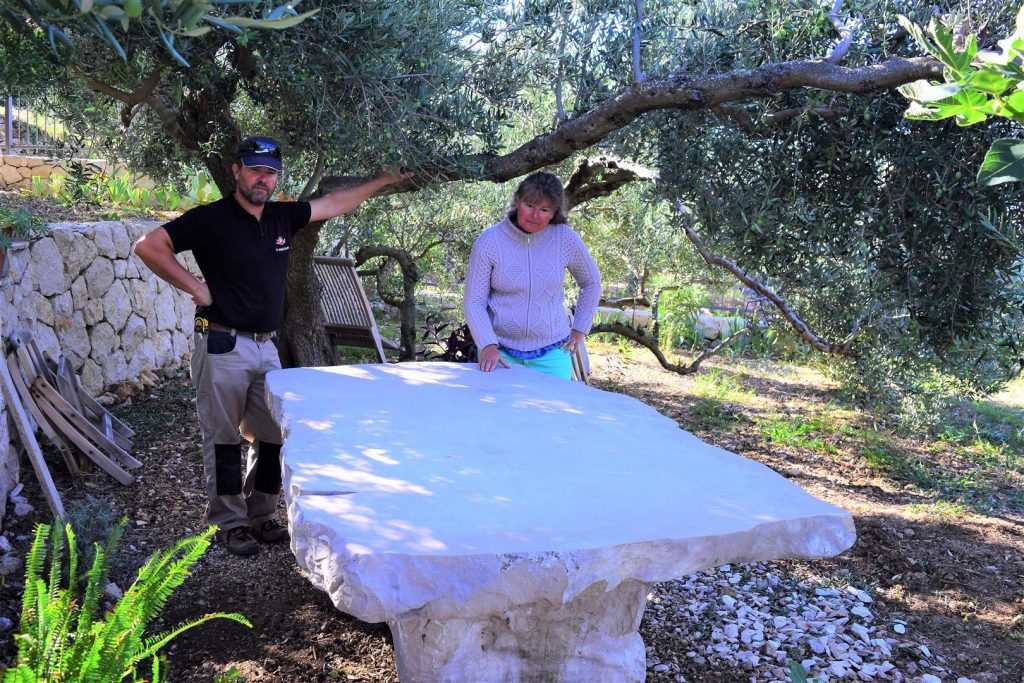
A plant dies in a pot in September 2019 and a new pot arrives
The garden changes constantly as trees and shrubs mature and then the need for a pot in that location is no longer there and you move it to somewhere else but the one constant is that you need to suit the plant to that location i.e. sun or shade and the other constant is that shrubs and small trees eventually die in pots after a few years generally it has to be said through neglect by lack of water or not boosting the soil with some nutrients and this was the case here with a small olive tree that stood in the front patio for the last ten years and which has been in decline for the past two years … I have been in denial about it’s unhappiness as I loved having an olive tree albeit a small one in an Irish garden but earlier this month I bit the bullet and removed the olive tree , gave it a hard pruning and placed in our recuperation ward over by the potting area in the hope it may recover .
I replaced it with a small Japanese maple , acer palmatum , a purple leaf variety called Bloodgood … odd name but called after the Long Island New York nursery that bred it and probably refers to it’s deep colour . One of the reasons the olive tree stuttered and failed was due to the pot eventually being too small so I used the opportunity to move the pot to a new location and planted the new maple into a larger pot which was in another area where it was not shown off at it’s best .
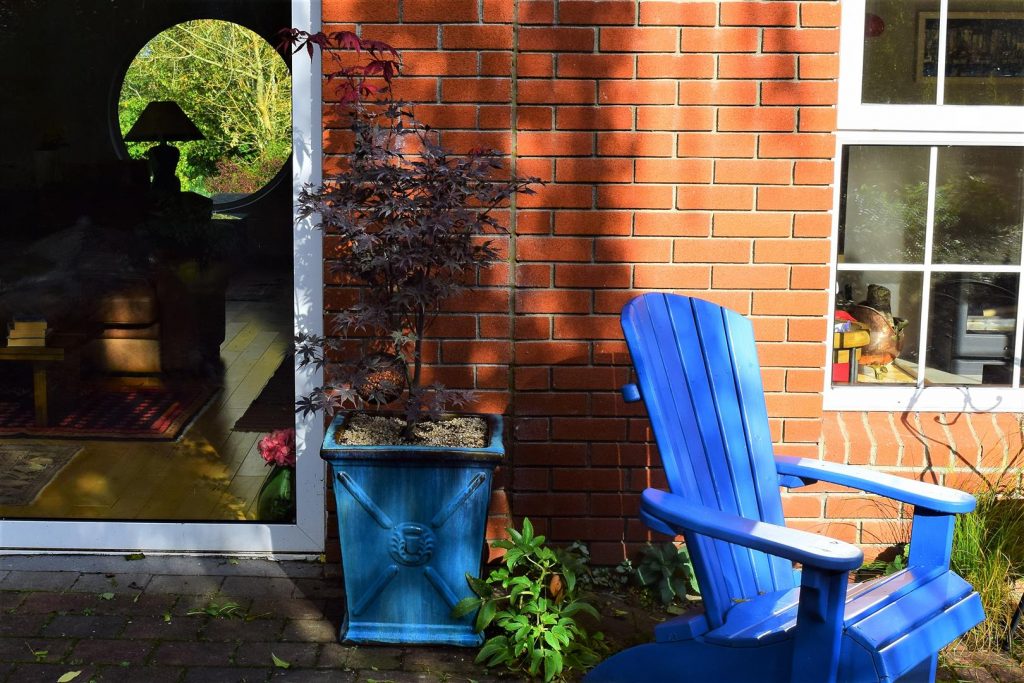
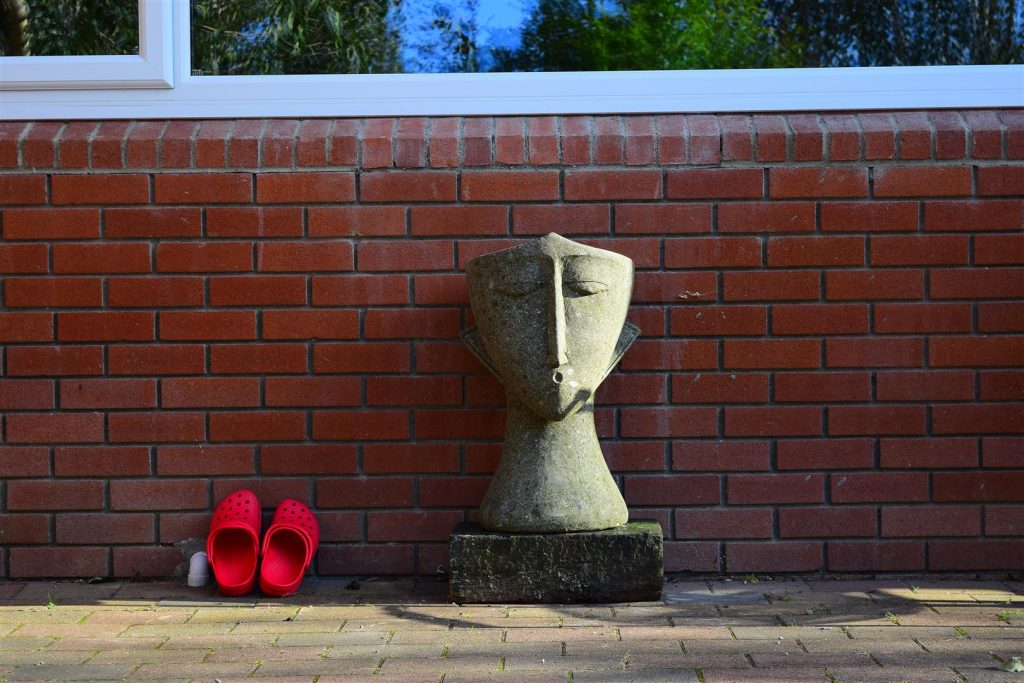
And a heart felt plea in October 2019 …. don’t bring me back to live under a tarpaulin Jaipur
Writing about gardening makes me realise just how we in the west are so lucky to actually have a garden and the figure of 4 euros for a pack of snowdrops would go a long way to feeding a family in India for a day where the majority of people have absolutely nothing , no house and sometimes a sheet of tarpaulin against a wall is all that shelters entire families and all the prattling from Greta at the UN about climate change and travelling to New York for a week on a f..king yacht to prove a point with all the other fat cat activists and politicians pontificating to the rest of us … these people would be better off to spend a week in a shelter in Calcutta or Jaipur to see how millions of poor people live in India .
I took this photo in Jaipur during a trip to India in November 2017 and this family of five kids live under a tarpaulin sheet on the side of a busy main road and their Mother’s job is to feed “underprivileged ” COWS at a cow sanctuary and the amazing thing was that as we piled out of our luxury air conditioned coach to look at the cow sanctuary the lady showed no rancour or envy towards us , just the polite smiling face of her acceptance of how things were for her and her six kids .
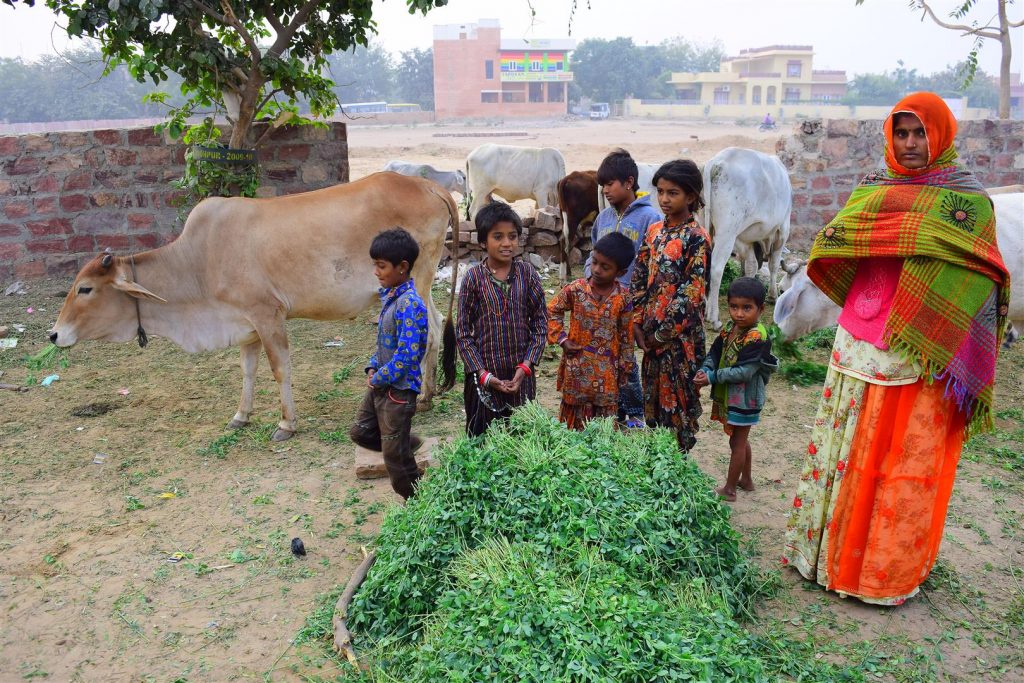
This photo I took in Agra when turning a corner I came upon this group of ladies all crouched down in the street waiting to be dealt with by some office official or other … I asked could I take a photo and they all instantly beamed agreement and these two images are the memories I have retained in my mind from all the Taj Mahal and grand castles I saw in India . These groups were all Hindu who believe in reincarnation and put up with what they get in this life as a progression towards a better existence in the next … I don’t have a belief in reincarnation but if it happens please God don’t have me living in Jaipur under a tarpaulin sheet .

In November 2019 I wrote about the olive harvest in Gornja Podgora in Croatia .
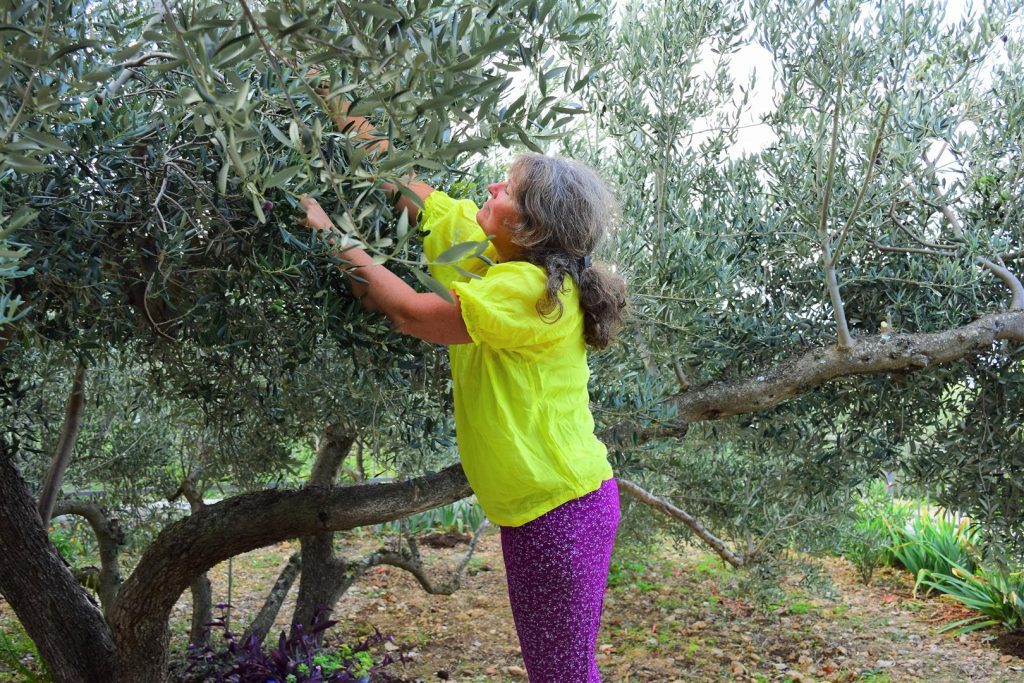
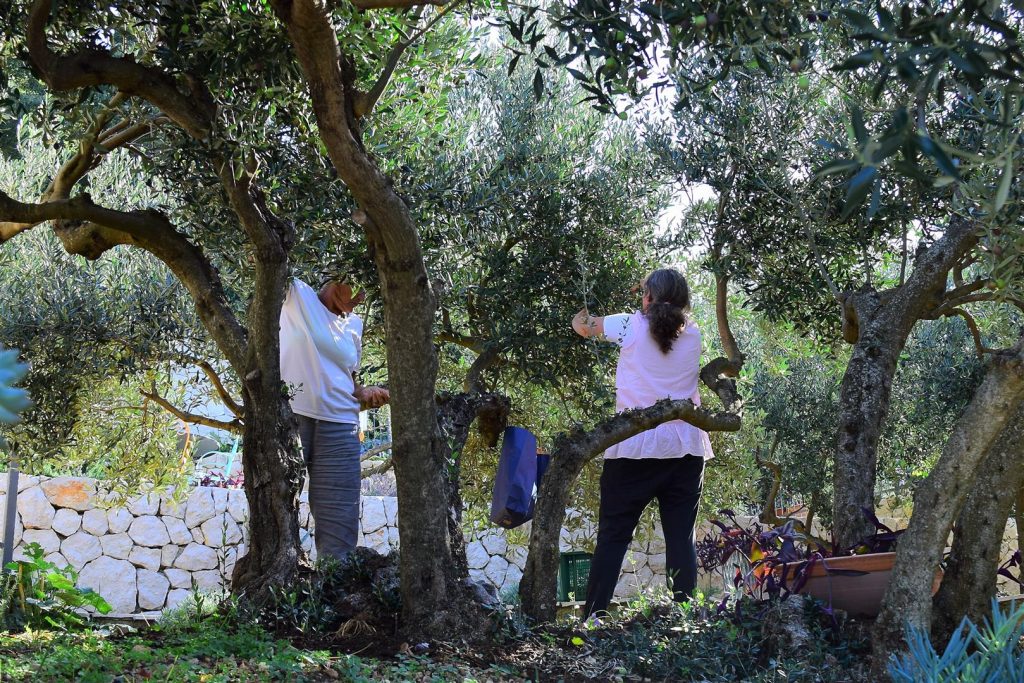
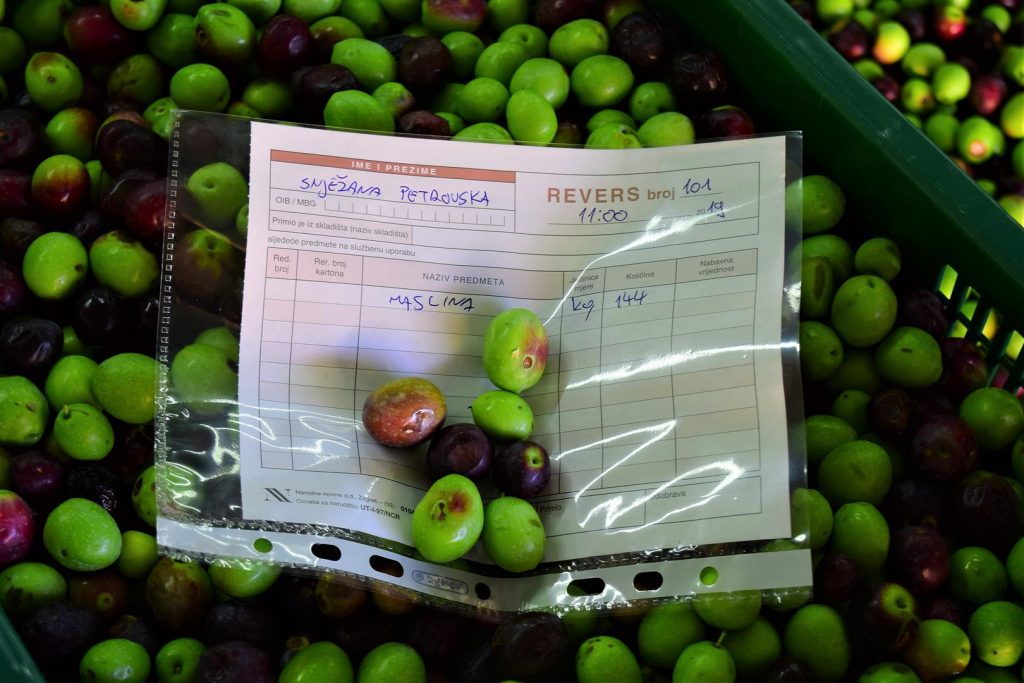
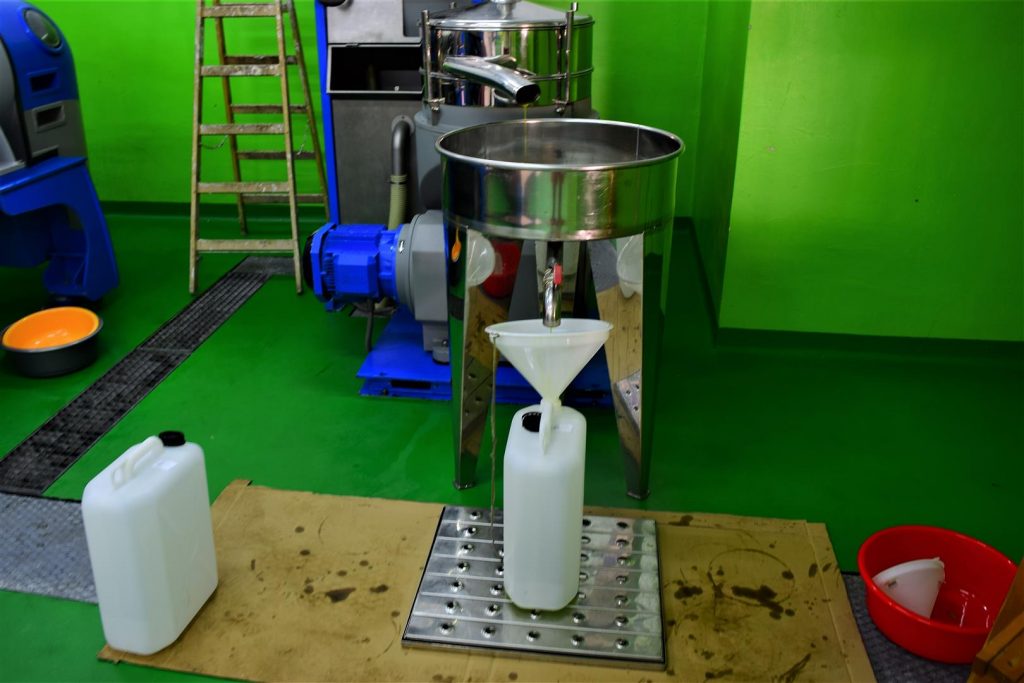
In November 2019 I posted a new page to the website listing the collection of vintage agricultural items , old tin baths , the odd cannonball etc. we have collected over the years and placed around the garden .
While also in November I updated the November 2015 page listing all the pots throughout the garden.
In December we visited South Africa and got to see among other bucket list destinations the famous Cape Town Kirstenbosch Botanical Gardens .
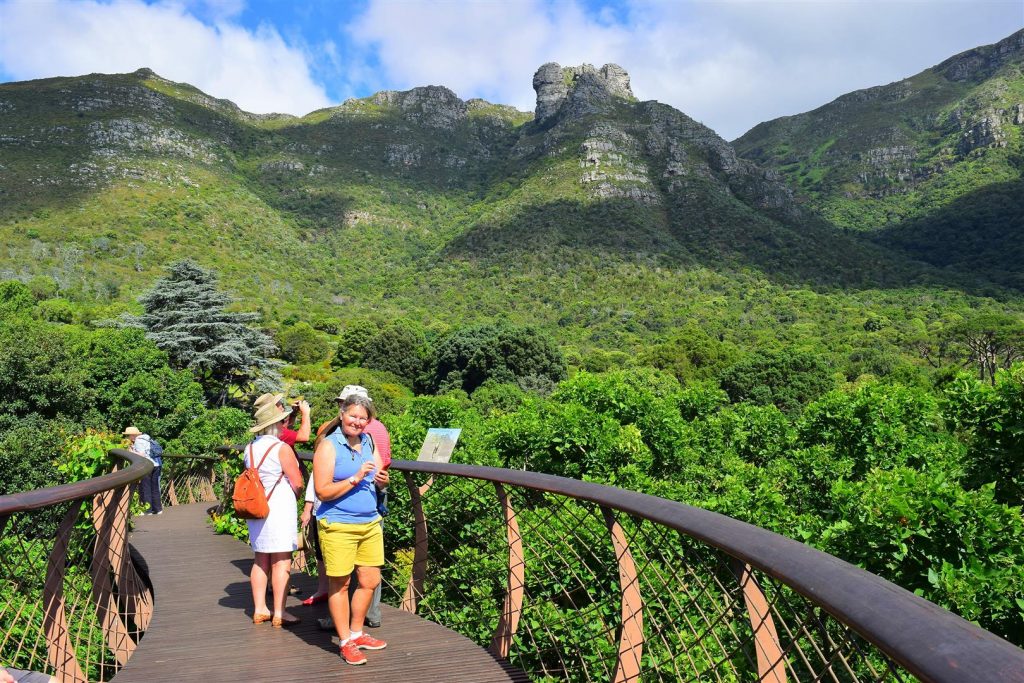

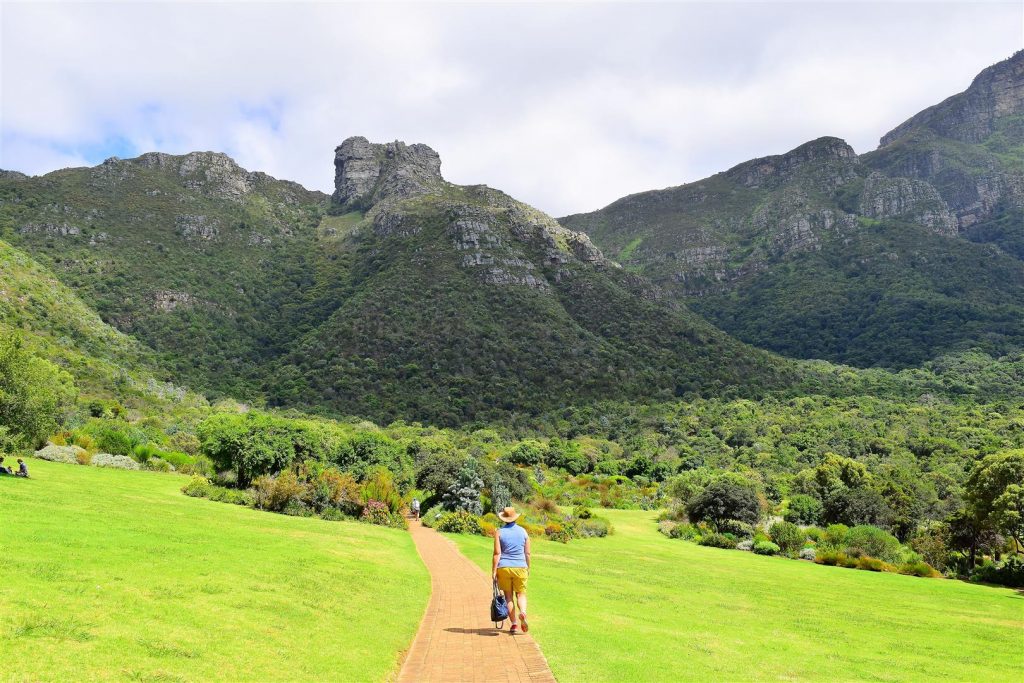

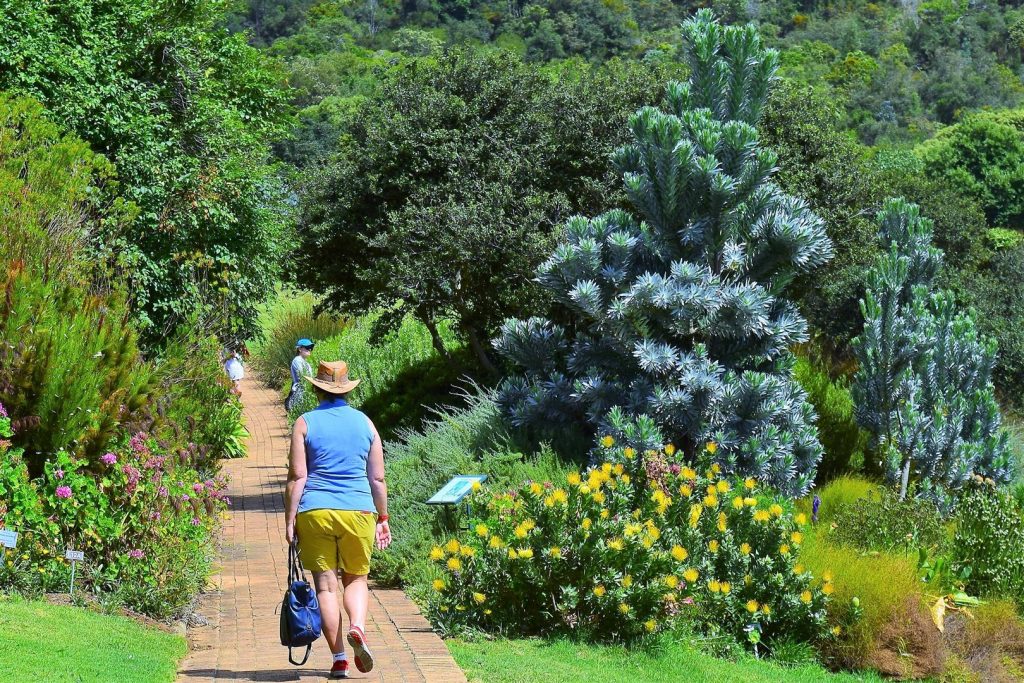
I have visited a lot of gardens and some of the world’s best such as Blenheim Palace , Versailles , Sissinghurst , Majorelle , but none beats Kirstenbosch , the Cape Town Botanical Garden both for the variety of plants , over 7000 , and it’s unique setting at the foot of Table Mountain . It is also unusual for it’s lack of formality and total lack of any prepared beds and at over 1300 acres you could spend a week there without seeing it all and there is even a path climbing directly to the top of Table Mountain which takes three hours to climb if you have the will … and the legs ! A half day visit was not close enough to relax and breathe in the atmosphere but we did get a flavour when we walked the tree top route , a wooden walkway suspended above the tree line and everywhere you look is dominated by Table Mountain , what an unforgettable setting and what a place for a garden . Favourite plants in Kirstenbosh … has to be the protea , the national symbol of SA , closely followed by the agapanthus which are grown in beds of up to 1000 here and I also loved the silver tree , Leucadendron argenteum , which is only found in the Table Mountain area and nowhere else in the world , a real stop em dead in the track moment when you see it .

The trip to South Africa was memorable and I would recommend it to anyone … would I go back … no … personal security is a huge issue and even in the white areas it is not safe at night and in fact no one ventures out for a walk anywhere after dark and at the seaside tourist areas you make sure you are not on a beach after sunset or before sunrise as the sad fact is that the night belongs to the black people who come out from the townships at night and along with that comes the violence and robbery but the main reason I would not go back is that most visitors and travel companies visit just the Cape area and the Cape for me is just too white , too privileged and although jaw droppingly beautiful with the wine and garden routes , I have no wish to see it again .
Some things we don’t have to worry about in our Irish Gardens !
Signs at our hotel garden in Kruger National Park , December 2019

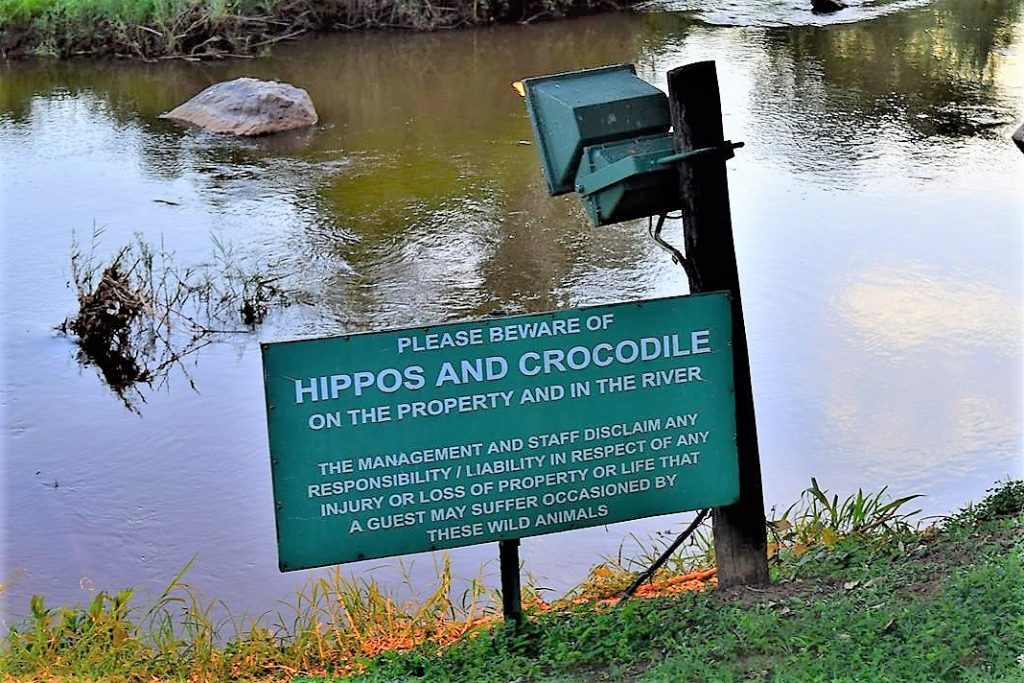
While in SA I , almost a vegetarian in normal life , ate ostrich , worms , fried in a light sauce but still looking like worms (!) , a huge source of protean I ‘m told and the local crocodile … well you have to don’t you ? … never again for ostrich meat which was horribly sweet , a first and a last also for the worms while surprisingly the crocodile was very juicy and nice but I still couldn’t get past the idea it was crocodile !!
From what I could see there are two very different South Africas , the area of Johannasburg north to Natal , rolling plains given over to cattle and very very poor black people living much as their ancestors did over a hundred years ago and then there is the Cape area which includes the wine lands and the garden route , white Afrikaner owned and dominated and very rich . I had always thought that the term “ garden route ” meant it was lined with beautiful gardens but not so although there are I am sure beautiful gardens as it is as beautiful and fertile a land as I have ever seen … the term dates back to the first white settlers , the Dutch who thought it was so beautiful that it must be the setting for the Garden of Eden .
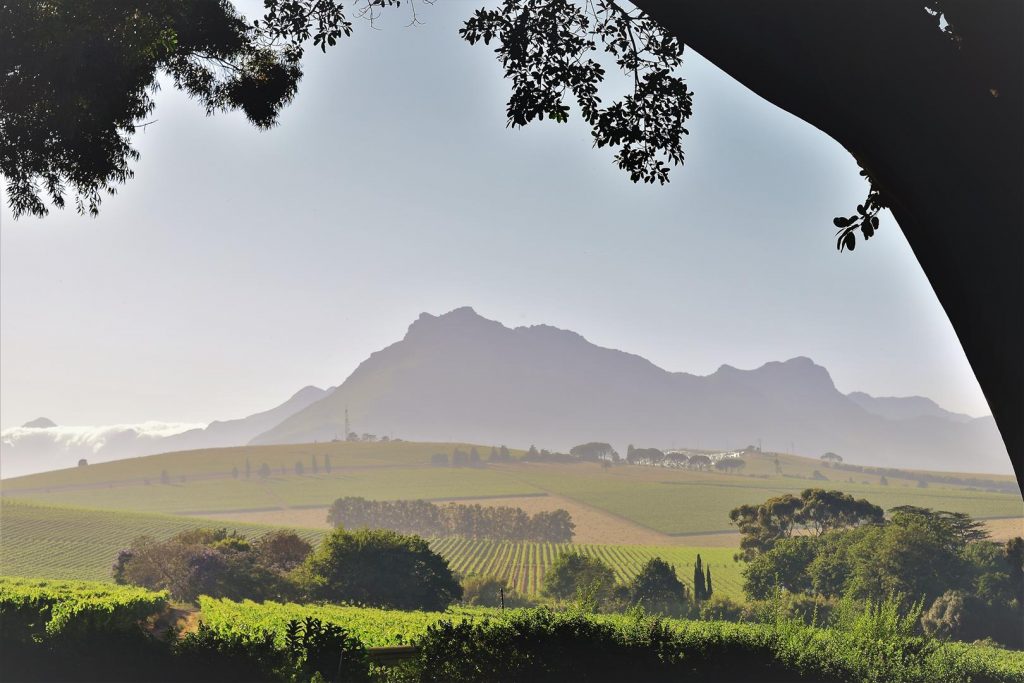
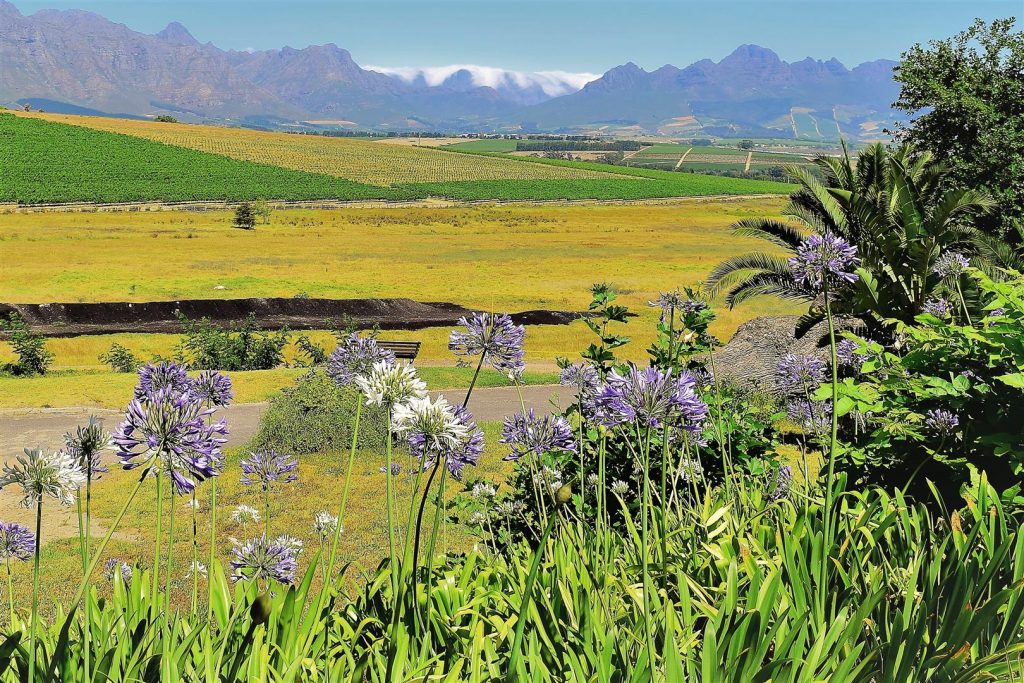
2020 A new year and a new decade in the garden , innocent words but the world had no clue what was spiralling out of control in China , in Wuhan to be precise and which would change our lives and our expectations forever .
My first writings of the new year 2020 featured winter colour and pruning and the fear of pruning every novice gardener feels .
Walking around a garden in winter especially in January you are delighted with any plant that gives a bit of a show either through the bark colour or like this morning when I saw the first new leaves on an acanthus , a perennial originally from the Mediterranean region but which grows well in the UK and Ireland … one of the earliest plants to be propagated and the name comes from ancient greek , acanthus , and from 500 BC onwards the acanthus leaves were carved as a decoration at the top of Roman and Greek columns . Easy to grow and propagate and in some areas it can be invasive , never for me unfortunately as I love the plant and it throws up great flower spikes if you are lucky which are great bee pollinators , two varieties spinosa and mollis which just have different leaves and a great plant for every garden shrubbery or bed , just give it some space , sun or dappled shade and it is not a difficult plant , dampish conditions suit acanthus but it doesen’t suffer too much in dry areas either and no garden should be without an acanthus .
Another shrub that comes into it’s own in winter is the variegated eleagnus which is golden edged but never garish and I grow three types here , ebbengii limelight and the varieties gilt edged and maculate . The variety limelight is quick growing but you need to watch it as it reverts to green and unless you are ruthless about cutting out those green shoots you can lose the variegation completely and the green takes over , it can be pruned quite easily when the shrub is young but it is a quick grower and when it is six or seven years old it is usually three metres high and wide and you can easily miss the green growth . Gild edged is slow growing as is maculata and they don’t try and revert and the leaves stay nicely coloured as the shrub matured , a great addition to any garden and do well in sun or shade but they take about ten years to grow about a metre and a half … worth the wait though .
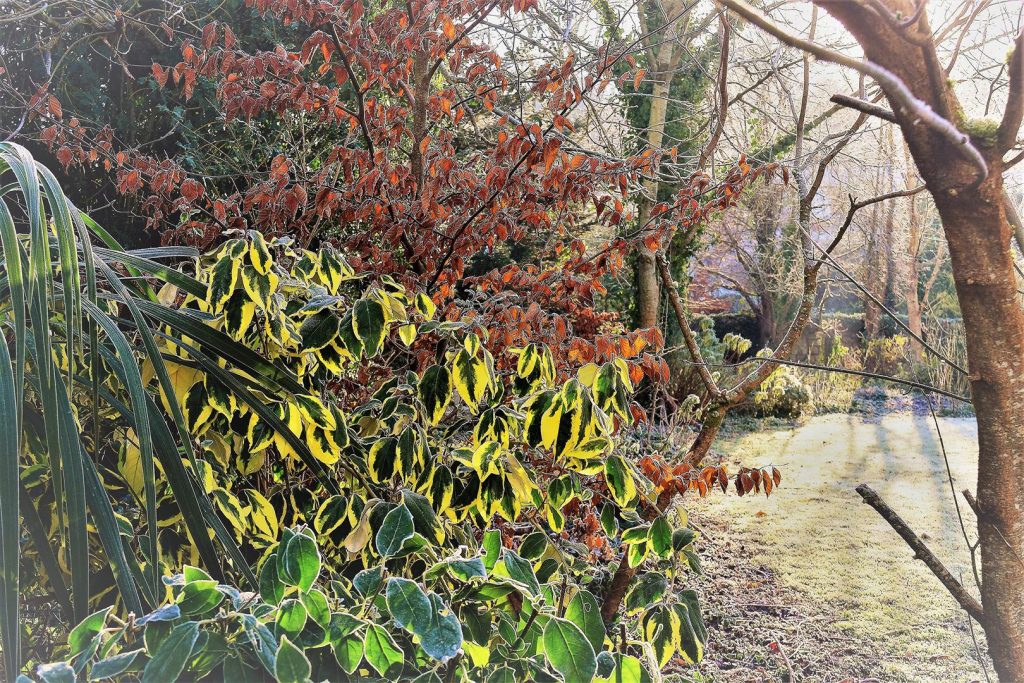
In March the full impact of how serious Covid 19 would be hit the world and new words like cocooning and lockdown became the vocabulary of the day .
But a gardening blog has to be written and for those of us lucky enough to have gardens , work in the garden continues and in the months that followed the garden became a life line for us all .
My Gardening Week 31st March 2020 … and we thought it was a beer
The country in lockdown , the older generation , myself included are cocooning , panic buying in the shops , toilet paper at a premium … the majority of people out of work and in lock down , keeping each other at two metres distant when venturing outside , normal life today is like looking at an apocalyptic movie and who could have predicted the effect the corona virus would have and will the world , our world ever be the same again and of course it will , patience is the thing and those of us with gardens will have them pampered like poodles with so much time to spend on them !

Last week I chanced on a heap of frog spawn in the Lower Field which was fresh and obviously dropped by a pregnant frog who couldn’t manage to get to water in time , I was able to scoop it up and carried it to our back garden pond where it should produce healthy tad poles who will then turn into tiny frogs and fan out into the garden … frogs live for up to 12 years, and every spring they emerge from hibernation to mate and lay eggs in the same pond. frogs generally return to their water of birth . In the old days gardeners myself included regularly scooped out frog spawn from it’s original water and transferred it around in buckets but it has been illegal for some years to collect frog spawn and this is a rule I always keep as nature has been interfered with too much and frog spawn has been declining for many years . It has only happened to me once before in over 40 years of gardening that I found spawn in open ground away from water and you have to feel sorry for the female frog caught out like this but at least we were able to give her babies a good home .
As March is the frog spawning season the Irish Wildlife Trust issued the following advice this month “ Please don’t touch it, it’s terribly vulnerable stuff. They produce masses and masses of eggs but that’s because many of them will die. This is something that depends on our help and depends on not interferring in any way and to leave them alone as much as possible.”
As gardeners we all like to preach right plant right place but do we always practice it or do we continue to cram something into an area we love on the principle it will be grand … guilty m’lord and this week it I had to deal with the problem twice where the wrong shrub / small tree was planted in the wrong place , the first being a supposedly low growing hebe which I planted in the wooden planters in the front patio garden six years ago and which was planned to fill a space about two foot square and the second was a standard Japanese maple . The hebe grew and grew and was heading to three metres which would normally be great if in a border or even as a stand alone shrub but in the wooden planter it looked totally out of proportion and Snezana has been on at me to prune it back for over two years which I resisted as I didn’t and still don’t know how the hebe will react to a severe cutting into bare wood but yesterday even I had to throw in the towel and admit the hebe looked out of proportion and all wrong towering over the small planter so I whacked into it with the saw and cut it down to two feet high . I have seen huge hebes grow back again from the base after being cut down with a hard frost and at least this is the best month to heavy prune so will wait and see … the hebe owes us nothing having self seeded prolifically into the gravel areas every year and we have loads of replacements potted up if the mother plant pops its clogs … mind you when I see the photo below from 2016 and how good it looks I am having second and third thoughts and am thinking I should have taken a bit off every year instead of this drastic car crash of a pruning .
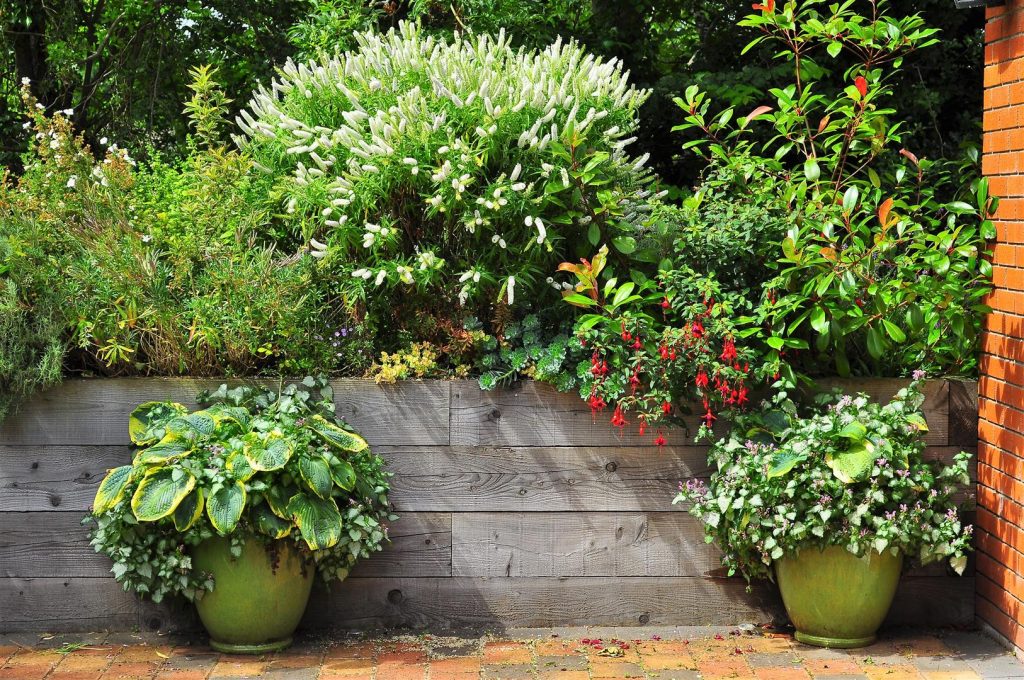
And after a severe pruning in March 2020 2020
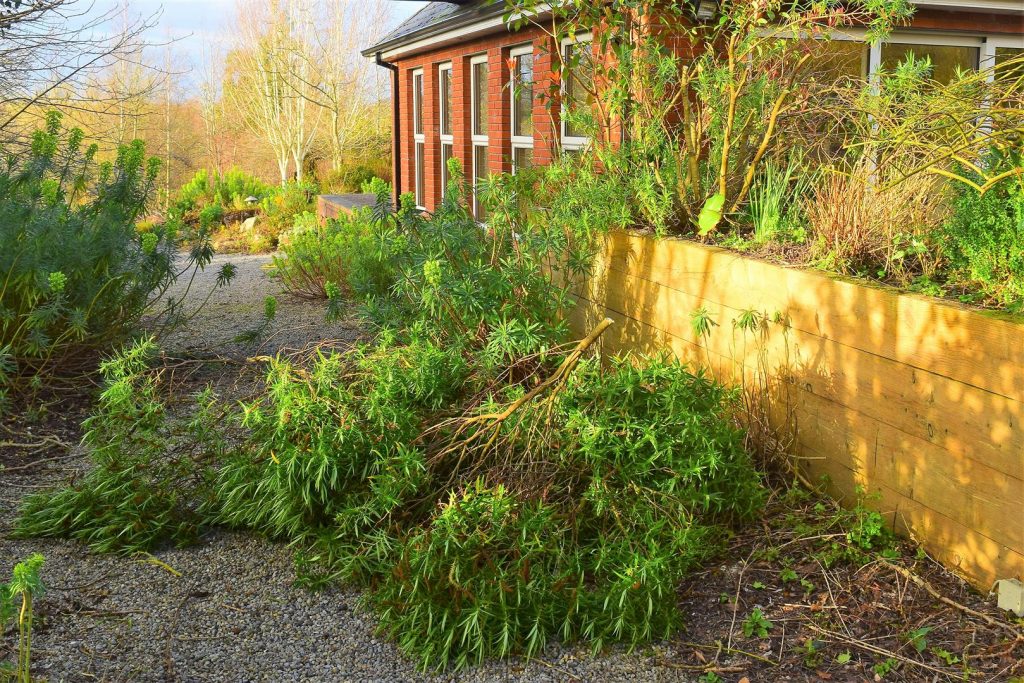
I wrote in March that Snezana and I realised a long time ago that we cannot work together in the garden but we have reached a stage where both styles and type of work we do can be accomodated .
Basically there is room in the garden for both of us and for our different approaches and while I get on with the everyday sometimes boring work of the kind of maintenance a garden of almost eight acres needs she can seek out the areas I don’t do and creates projects from forgotten or neglected areas of the garden . Her latest project is to tackle an area underneath a large oak tree which over the years I have strimmed on a once a year basis and left it at that with the result that the ground area is overgrown with ivy and a lot of brambles until its annual trim . When Snezana has decided on a project she works hard at it and this one is no exception as she has slowly cleared most of the area to reveal a lovely space but of course the ivy does not give up easily and it will take a while to thoroughly clean all the roots before we can decided on what to do with the new space … it is at this stage that we work as a team as I am called in to suggest planting possibilities and this site will be a challenge as apart from being north facing it is in deep shade from April to December with the oak leaf so not a lot of choice but lamium or dead nettle , lamium Chablis which has a pretty flower , vincas , geranium , hellebores or even the dwarf viburnum tinus variety Evelyn Price will grow in these conditions however I will only suggest possible plants and it will be Snezana’s choice of plants .
What I didn’t realise back in March that this cleaning under the oak tree was going to lead to a total revamp of our front garden where Snezana tackled an area long swamped in ground ivy and this in turn led to the cleaning and resoration of a fifty five metre dry stone wall .
This cooperation which we call our Covid Wall Project took advantage of the lockdown that lasted for twelve weeks through March to end of June where we cleaned and recovered an area that I had just ignored .
Here is what I wrote in April 2020 of the Covid Wall Project over the 12 weeks of lockdown .
Snezana has now reclaimed two patches of the garden with the latest being in the front garden under a large mountain ash , sorbus moonbeam variety , which over the past twelve years has been taken over by rampant ground ivy which through laziness I convinced myself looked nice and organic but now that she has hand cleaned off over sixty barrow loads of the ivy I love the reclaimed soil and we are planning a flower bed that will take into account the shade from the mountain ash and the dry soil … a mixture of our own home grown geranium , hellebores and bergenia will go in there in about four weeks and then in the Autumn I will underplant with spring flowering bulbs .
This is what she does best , won’t take direction of course and always wants to work on an area she can claim and call her own work … it is a policy that works for us and I am happy to then prepare the planting up .
When I wrote that last paragraph I was just referring to the ground she had reclaimed but then her horizons extended to the dry stone wall behind which most likely dates back to the 1930’s when our garden was divided by the Irish Land Commission after Irish independence in 1921 . I undertook to clean off seventy years of ivy from the low wall which runs along fifty five metres of the front garden , reset and build up the stone and this took a weeks work and another 150 barrow loads of ivy but it looks great , we now call it our Covid Wall , and now the issue is what to do with the new area with the brief being not to obstruct the lovely dry stone wall with shrubs or trees .

We used the Covid lockdown to tackle part of the front garden I had neglected from almost the beginning in 2006 when we got the pond installed and the basic design laid out . I knew that the boundary ditch contained a dry stone wall but even then it was covered in ground ivy as was most of the ground and I also knew this was a massive job to clear and just ignored it as there was so much to do in the rest of the garden however in March this year Snezana decided this was work she could tackle and even though I advised against it ever being up to much , she got stuck in and removed over 200 barrow fulls of the ivy before I was shamed into helping … over all of April we tackled the dry stone wall and I removed another 100 barrows of ivy during which a lot of the fifty five metre long wall collapsed but eventually I retrieved the stones and reset the wall as my contribution to her project while she dug over the new planting beds … not great soil and very dry but still quite a nice area to design suitable planting which had to be low growing as having gone to such trouble to reveal the lovely stone wall it would be a pity to hide it with metre high shrubs or perenials while also selecting plants that do well in shade as the new area only gets sun in the afternoon . We opted for a mixture of ferns , hostas , geraniums and some clump forming evergreen perennials together with a dwarf purple leafed japanese maple … all are doing well and like all newly established planting in summer months I have kept the area well watered during dry periods , the dryish soil may be a problem for the hostas to thrive but I am banking on the shaded position to get them through .
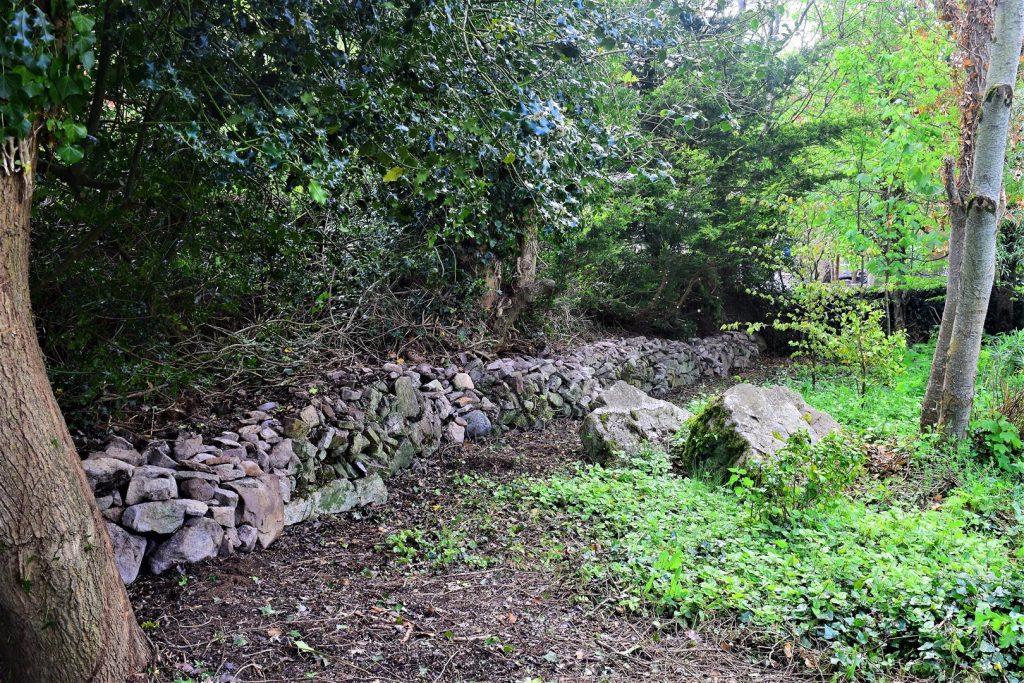
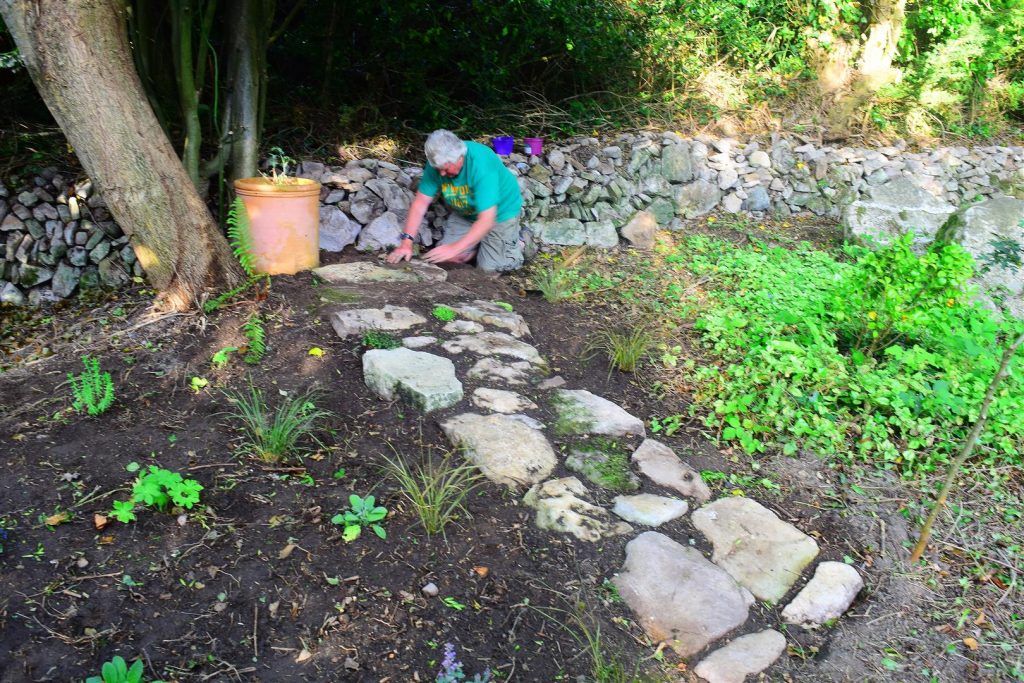
We are delighted with the result and it has brought an area neglected for so long back to the garden … thanks to Snezana’s initiative in the beginning in tackling the area as a project with which I very reluctantly became involved , a late convert one could say !
How the new area looks in June 2020

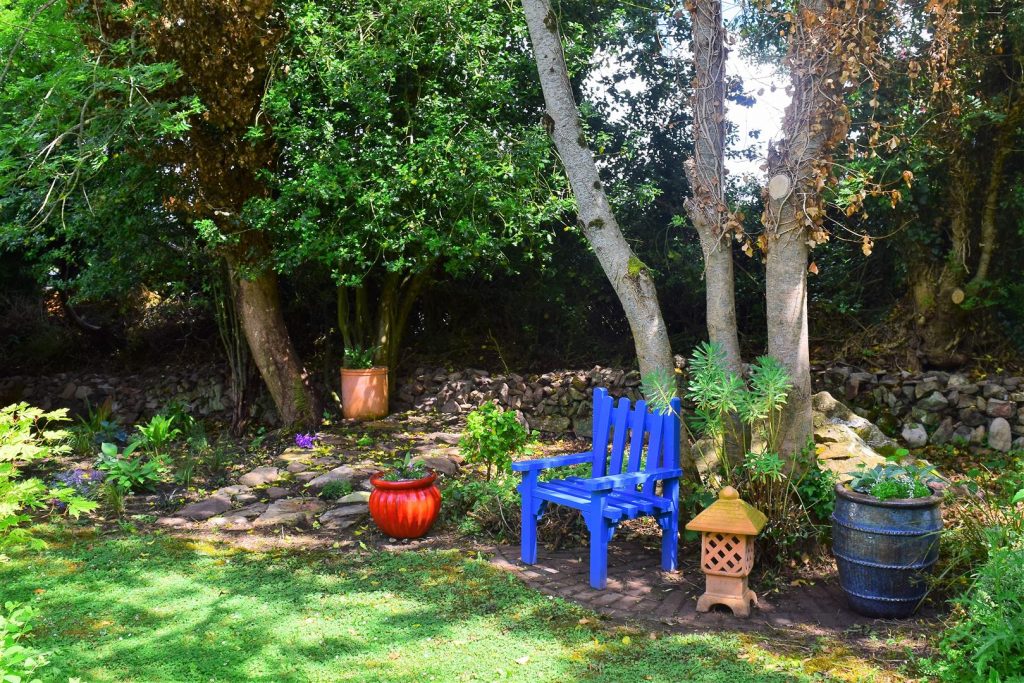
I am a great admirer of hostas and usually in May I write about them .
By May you need to have protected your hostas from the slugs or else you will only have tattered leaves to admire so if you are an eco warrior who refuses to use pesticides you will not have hosta leaves to admire … but at least you will have your eco credentials intact and that’s important .. right … not for me it isen’t as I will have blitzed the little buggers to hell and back with slugtox !
With 70 species and over 3000 varieties you have a lot of choice in hostas but really a lot of the varieties , most of which are bred in the US , have only slight differences if any and in the past few years probably in an attempt to have funky sexy titles the names have become ridiculous . I mainly grow just three hostas , Elegans , Francis Williams and Halcyon , all big leaved big statement hostas but in the past three years I have added June and Gold Standard to my three reliables , both bred in the US with award winning pedigrees from 1980 and while Francis Williams remains my long term favourite of over thirty years and my go to hosta for any new perennial bed , I have come to really appreciate Hosta June in the past two years which I grow in pots and which has a really subtle colour and it does particularly well in partial shade . This month I added two new varieties , new to me that is , Patriot , a green and white big leave and Purple Heart which has solid dark green leaves carried on a purple stem , unusual and I am looking forward to see it grow .
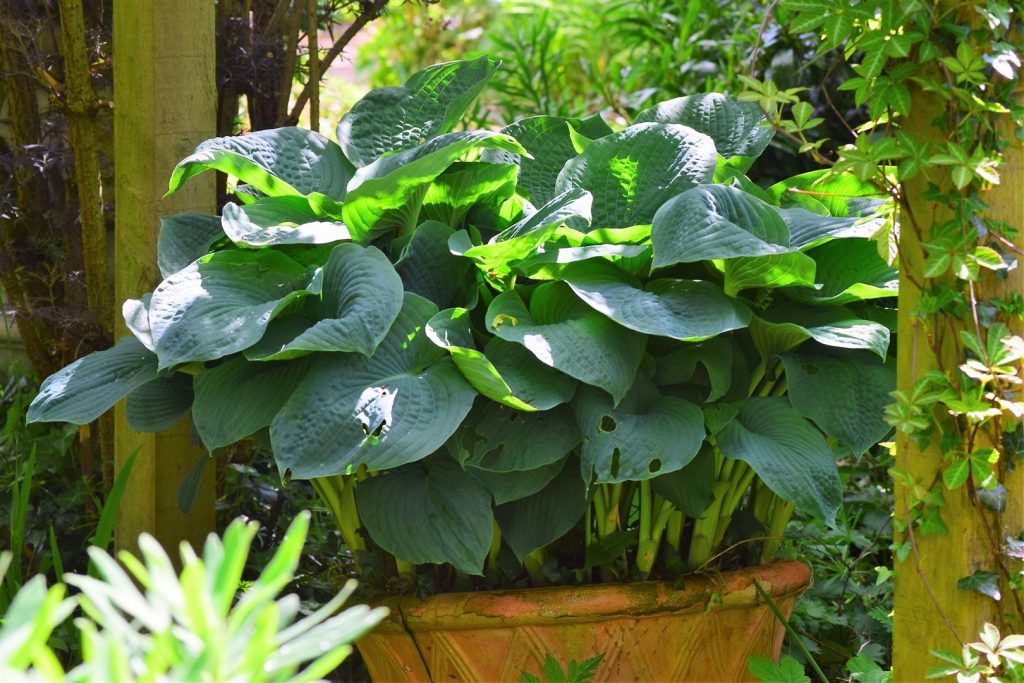
Size matters or so they tell me and in hostas the largest with leaves up to one metre is Empress Wu , green ribbed leaves , I have three of them which I grow in pots without great success but I am not a fan of Empress Wu and just grow it for it’s novelty value as the largest hosta and would not recommend it .
I find hostas grow best when in partial shade , they like damp conditions but will do OK in dryish conditions provided you are willing to throw the odd bucket of water their way in drought conditions . Christopher Llyod was a huge fan of hostas and it was his book in 1976 , the Well tempered Gardener , that first got me interested in hostas and once interested I became addicted and he describes accidently throwing a barrow full of pig manure over some hostas and they grew “ like thugs ” and anything Llyod described as a thug I grow !
Hostas can be fickle enough as too much wetness in the soil and they will sulk and today I moved three hosta elegans from what I considered a prime site when I planted them two years ago but the soil bordered on water logged and they were more prone to slug attacks and never grew to anything like their potential so following my usual mantra of moving a plant or shrub after two years if not doing well and today was their day to try pastures new and the three elegans went into the new bed in the front garden that Snezana has just cleaned .
Hostas are great in pots but they need large pots as they develop a huge root system which will quickly outgrow a small to medium pot … most of the small leafed hostas are fine in pots but I would advise particularly against planting the variety elegans in a pot no matter how big the pot as it’s roots will quickly crack a pot after three years growth as I have found out to my cost and this hosta elegans has broken a previous pot and has already put cracks into this pot … so why do you continue putting elegans in a pot I can hear you say but this is the only elegans I have in a pot and I love it for it’s big dramatic statement … and I get pleasure out of it every time I pass it so I reckon a broken pot every few years is worth it !
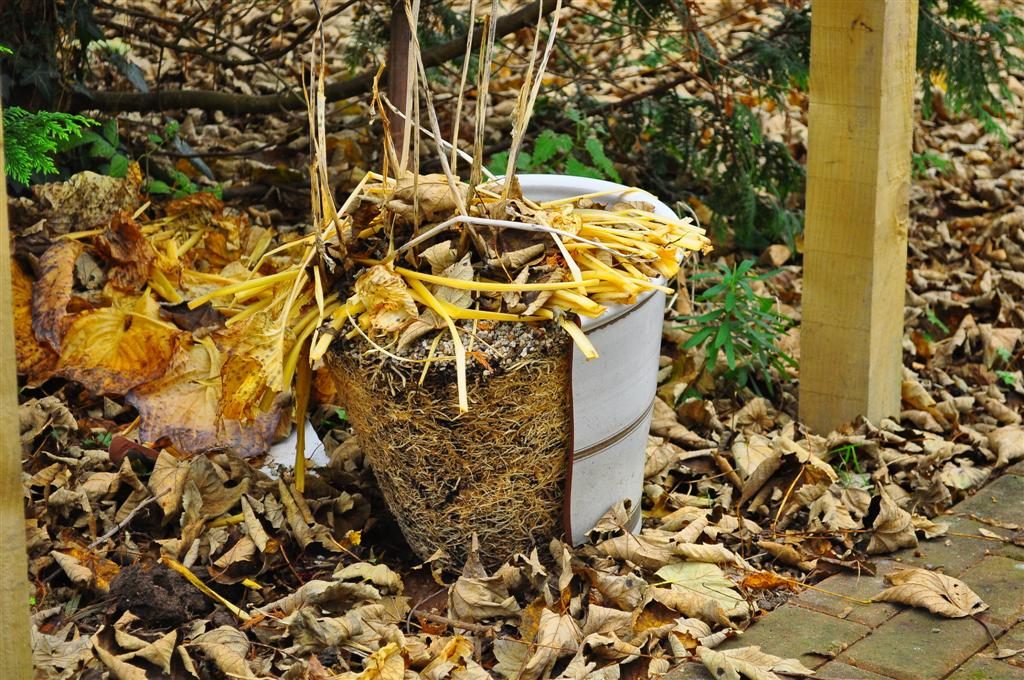
Hostas won’t tolerate other plants alongside them in pots or I should say will quickly smother other plants apart from a few bedding annuals only there for a few months in summer and my system here is to only use large statement pots for hostas and leave them idle for the winter months where the pots are big enough to be a design structure in themselves either through their colour or shape .
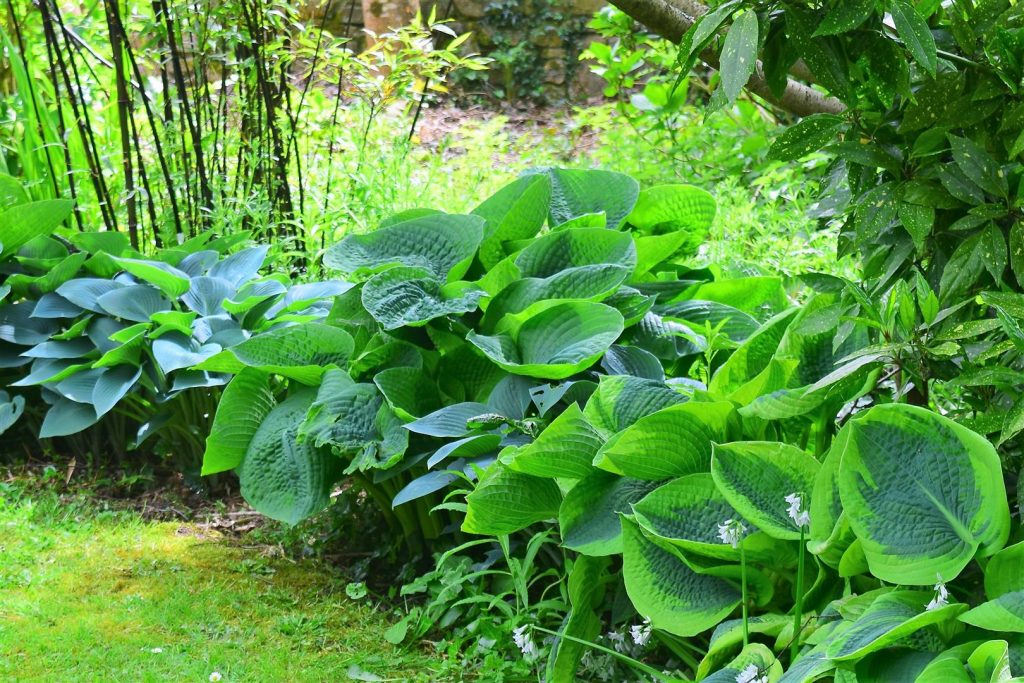
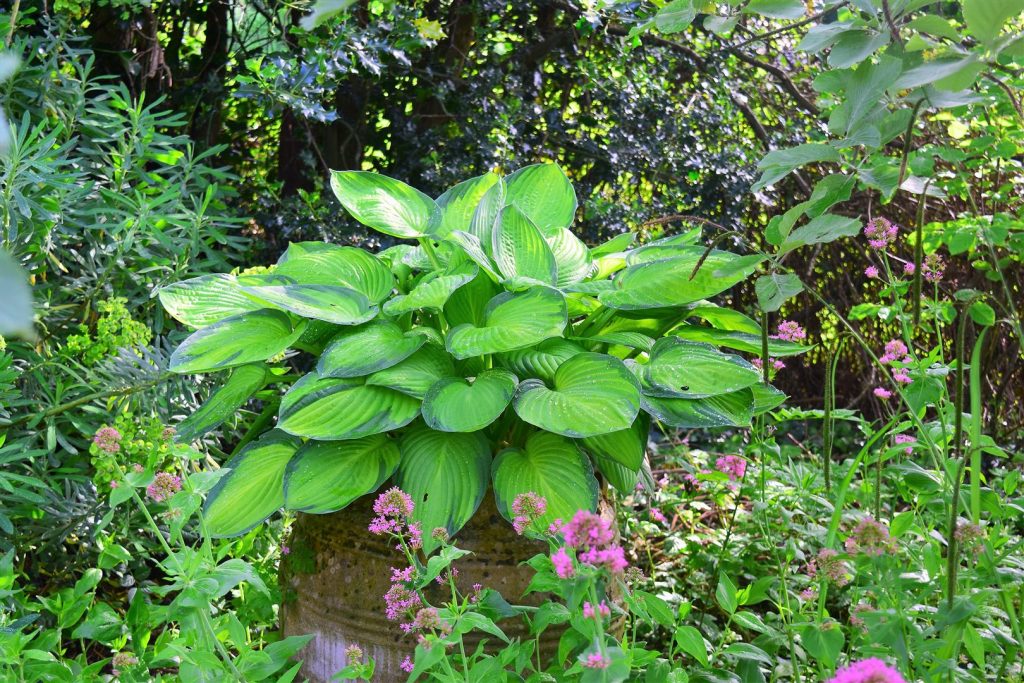
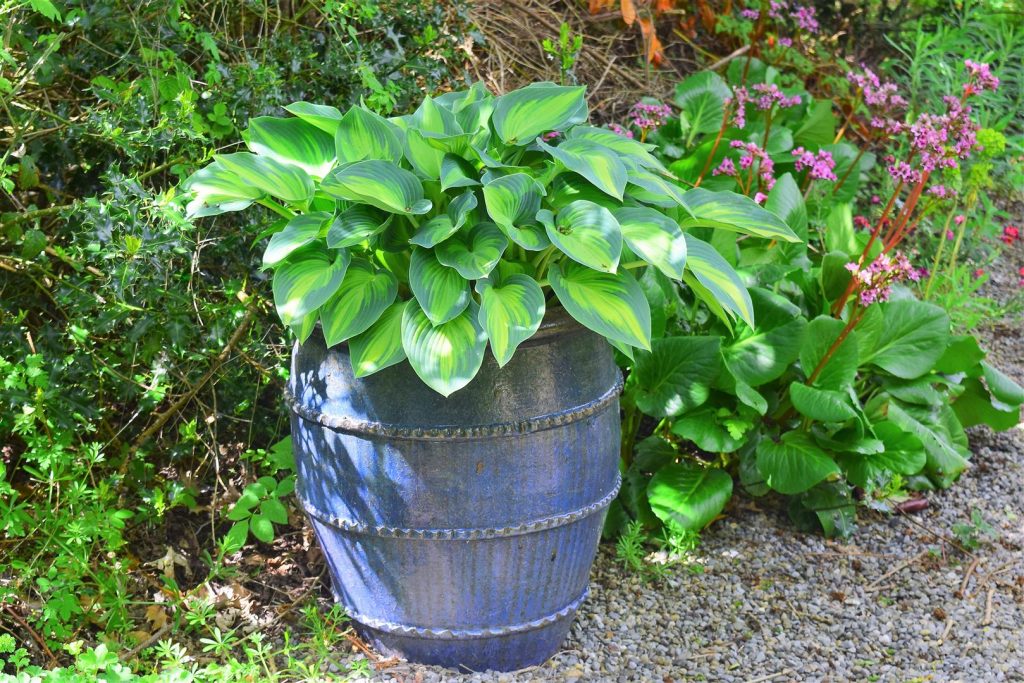
My Gardening Week 30th June 2020 … Freedom from Lockdown has begun !
After close to 12 weeks in lockdown since early March we can all begin to get back to normal life such as it can be before a vaccine is found for Covid and for us gardeners slowly but surely we can visit other gardens which we have all missed .
Most of us with gardens open to the public think that there will be no organised group visits this year as people will be slow to travel on coaches except for essential travel and as most of the garden visitors in organised groups are usually of cocooning age I feel this is only sensible . I must say gardening without the usual timetables of visiting groups has been a lot more relaxed as we have not had to rush to get maintenance done to a schedule or timetable but still you would miss the interaction you get with a coach load of dedicated gardeners !
In June I wrote about some unsung garden heroes
There are wow shrubs , showstopper stars of the garden but there are also some unsung heroes in garden plants that for some reason don’t get the attention they deserve and which are taken for granted in favour of the more show boaty types that feature on TV and in magazines and two examples are crocosmia and hypericum which I love and use extensively here .
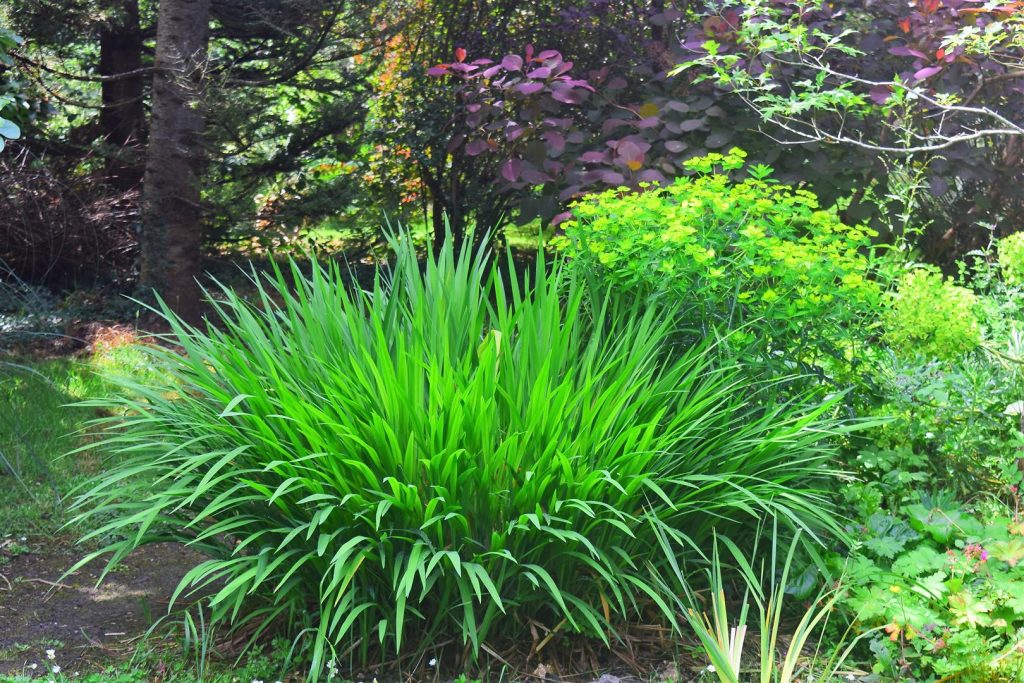
Crocosima is a plant I would not be without , often called montebretia , originally from South Africa , it is planted as a bulb , has sword like green leaves and is a terrific architectural type plant for the front of border . It is a plant that is taken for granted unfortunately nowadays but it is easy to grow , propogates itself almost to invasive proportions and does equally well in shade but does not suit a wet site . Most people myself included rarely have to buy crocosmia as it is so easy to divide a clump and even the smallest pot of seven bulbs will spread itself to a metre wide in a few years and in some areas such as South West Ireland it is considered very invasive . Crocosima flowers in sprays mostly red and a good variety is George Davison along with Emily McKenzie but probably it’s most famous variety is Lucifer for its vivid red flowers but which I avoid as it grows to over a metre high and flops over in late summer unless staked but if you are prepared to spend a bit of time staking it then perhaps Lucifer is for you whereas I prefer the normal height crocosmia and give it lots of room and then you can just enjoy it with no further maintenance from March to November … one of my favourite plants .

My second unsung hero of a plant is hypericum which is in full bloom now with yellow flowers and will bloom it’s ass off from June to October . Hypericum is happy in most locations , sun or shade , can be sheared to the ground each year or left to it’s own devices and the one I always pick is hypericum hidcote named for the famous Hidcote Manor garden in the Cotswold’s where it was bred . The Hidcote variety is supposed to be a smaller or dwarf version but if not pruned it will grow to over two metres . I mostly trim our hypericums back about eight inches every winter but you can hack it to the ground and it will bounce back , a terrific undemanding shrub that delivers a stunning show of yellow flowers throughout the summer followed by red , black or white berries in the autumn . Hypericum is a great back of border shrub and I wouldn’t be without it .

Gardeners are always trying to prolong the flowering periods of plants especially perennials and one of the tricks has become known as the Chelsea crop because it is done when the famous Chelsea Flower Show is on in late May where after the first flowering of geraniums , lupins , you cut the plant to the ground and it will grow back quickly and flower again later in the summer . However it seems bees have been doing this for millenia as researchers from Zurich University have proved that the common bumble bee , bombus terrestris ( great name !) were making small pinprick holes or cutting small triangles out of leaves apparently for no reason as they were not eating the leaves … trials and experiments as reported recently in the journal Science revealed that plants damaged by the bees flowered earlier than the undamaged leaves … in some cases like tomato a whole month earlier and this allows the bees to collect more pollen as protein in the years when pollen is in short supply for the bees … when pollen is plentiful the bees don’t cut any holes in the plants … the researchers next tried to mimic the procedure by cutting holes in the plants used in the experiments but could not produce anything near what the bees doing … we are learning all the time from nature and as the article concluded last week “ not only are the bees smarter than we realised , they seem to be smarter than us too ” .
Certainly not an unsung hero in our garden is the gunerra , one of my absolute favourite plants ,which comes into it’s own in June and the huge leaves of the established clumps we have here are always dramatic . As I have often written in previous pages , gunerra is not a plant to everyone’s taste as the sheer size of it puts people off and while most visitors to the garden are intrigued by the impact of the massive leaves I have seen others visibly recoil when they first come across the clumps of gunerra in the water areas however it does require space and will crowd out any plant or shrub within two metres of the base … embrace the gunerra is my message !
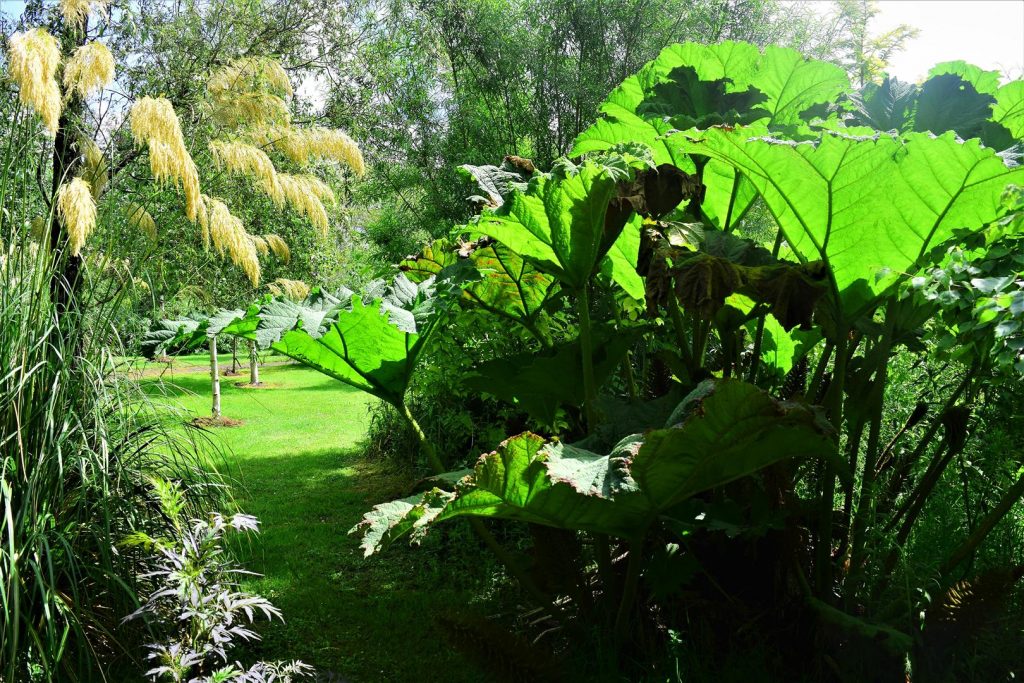
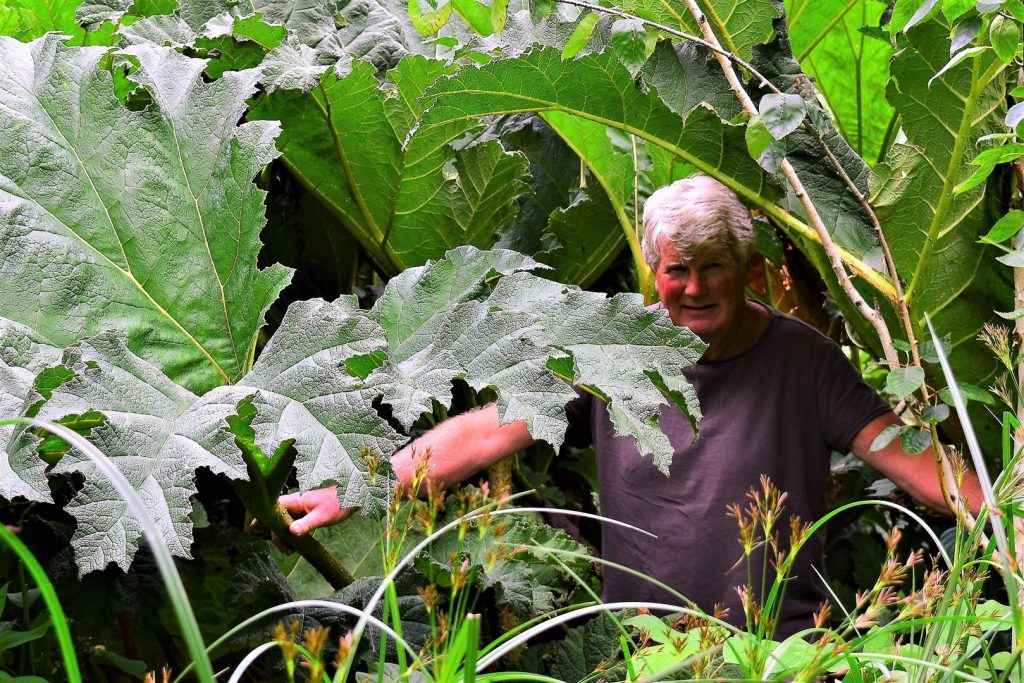
Colour in the Garden March to June 2020
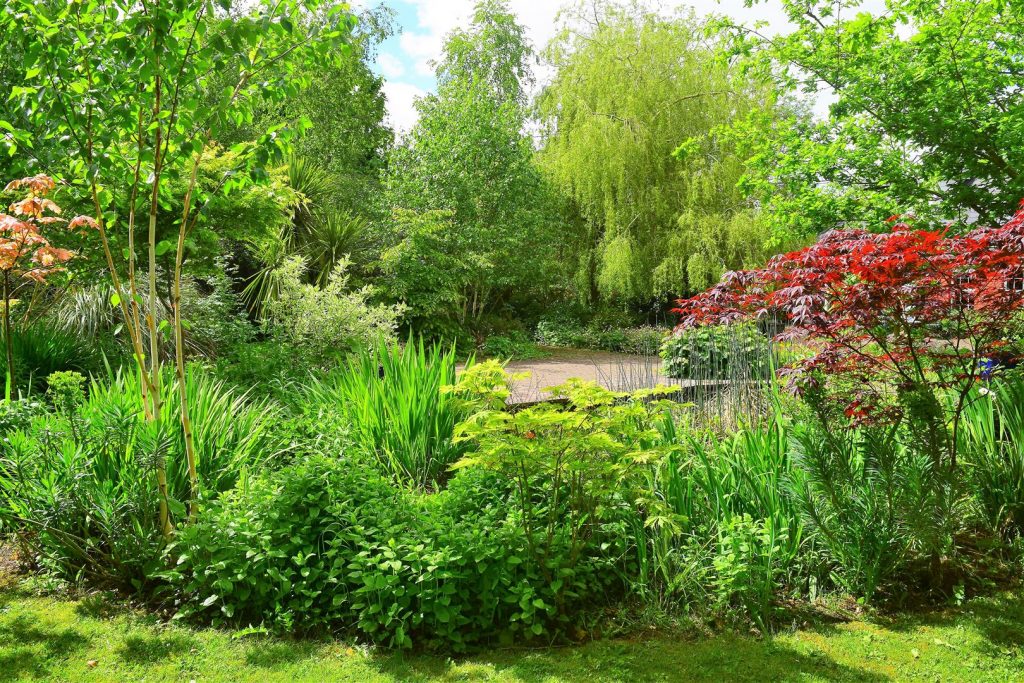
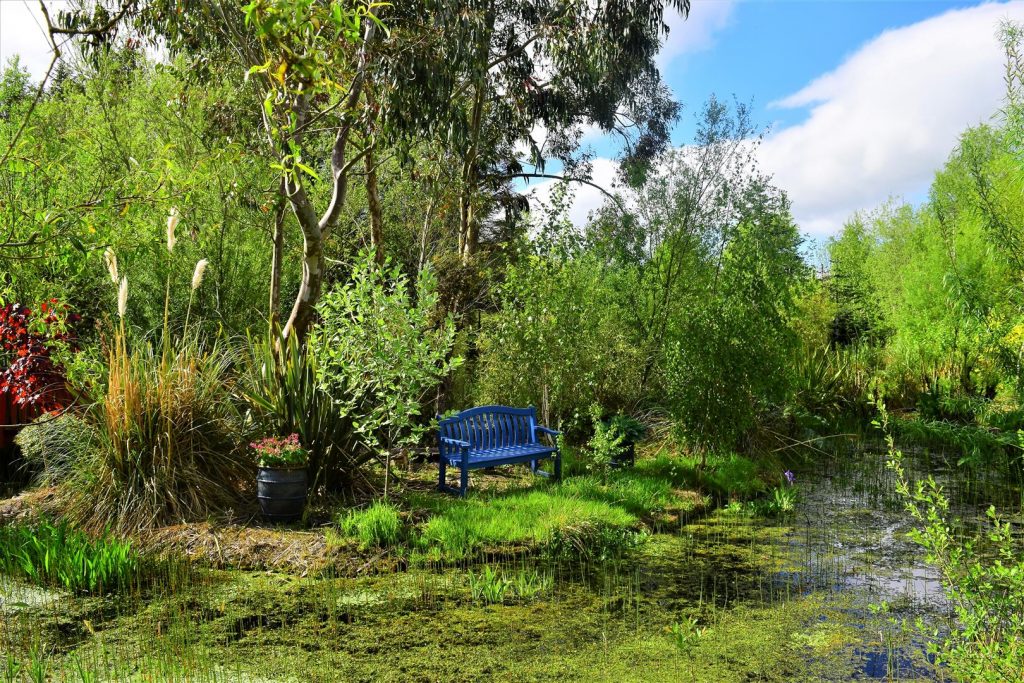
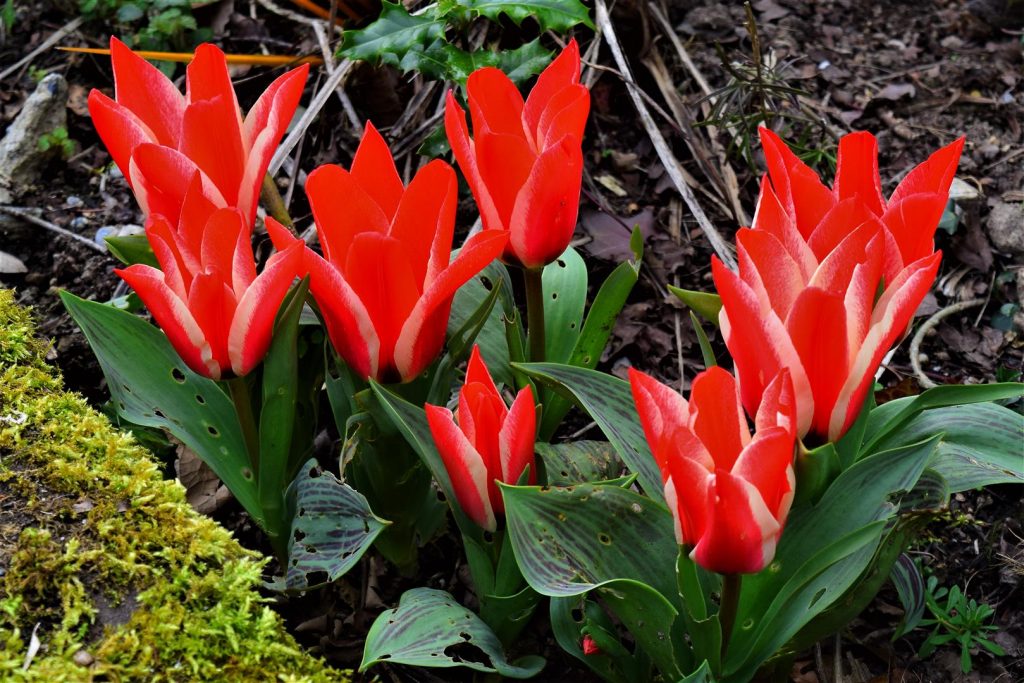
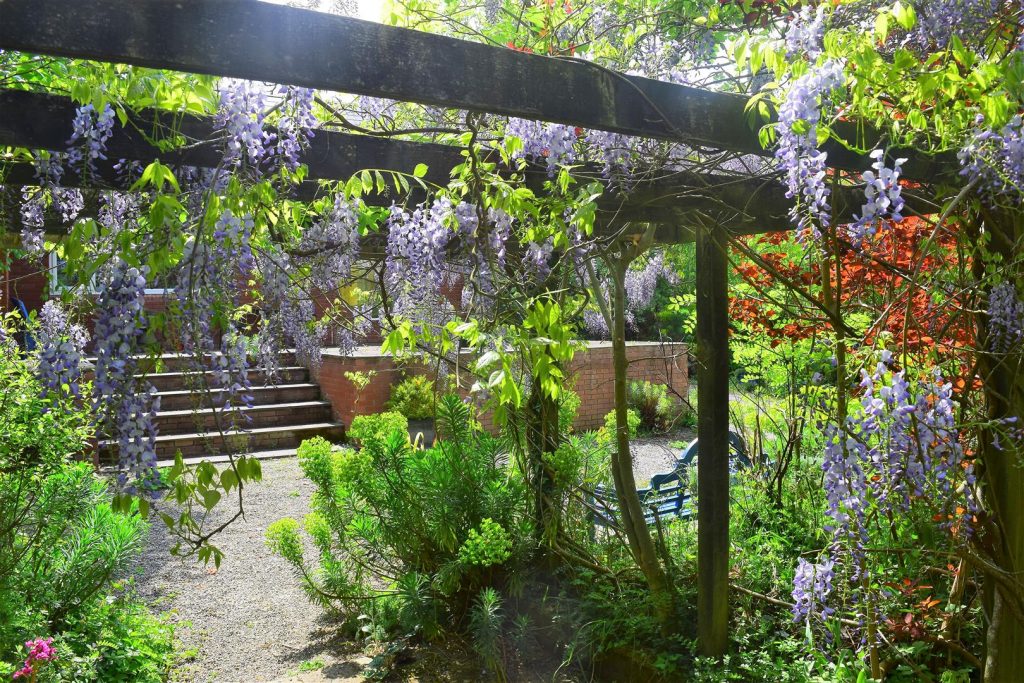
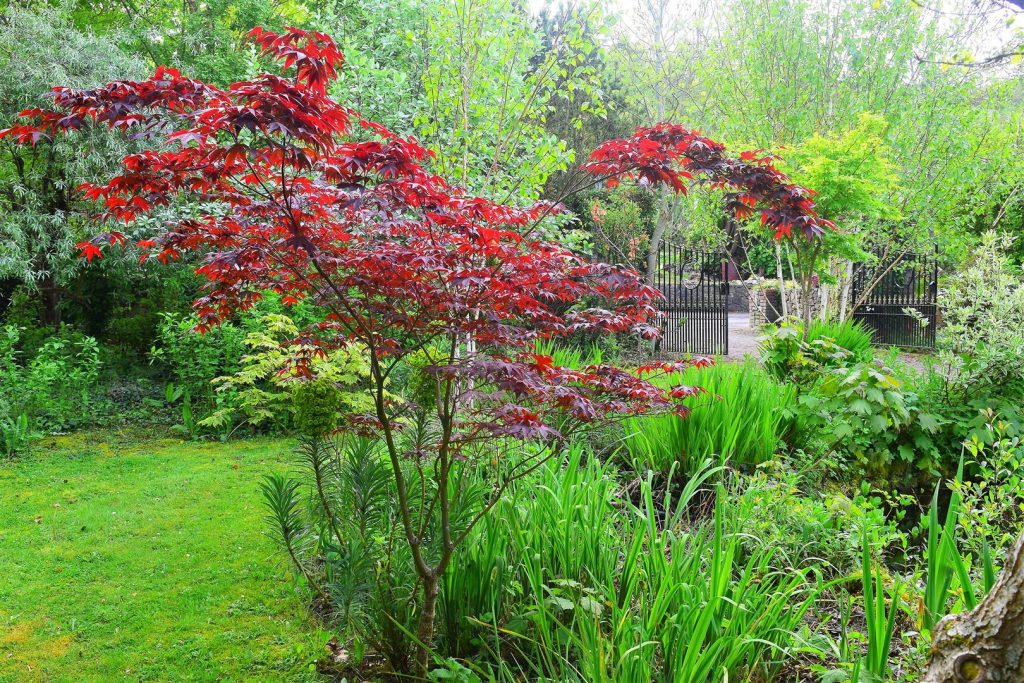
Covid 19 of course dominated the summer of 2020 and I wrote the following in my July Blog post .
Apart from a worry that Covid could spike again we are all approaching normality but at least as a result of the pandemic we have adopted better precautions at safeguarding ourselves such as hand washing and wearing face masks in shops etc. and I feel these will continue at least until a vaccine is found . I visited a friend’s garden last week within a group of five and even though we were outdoors only two did not wear a face mask … I was one not wearing a face mask as I still draw the line at outdoor use with lots of space among people I know who are not twenty five and attending rave or hip hop parties !
Now that we have time to evaluate the Covid and our national responses world wide to it there are radical views and opinions emerging such as the recent book by the important French philospher , Bernard – Henri Levy called The Virus in the Age of Madness … I have not read the book which has just been published but the Sunday Times of July 26th did an article on it . Basically Levy thinks ” there seems to be a collective desire to panic . It is not as big a disaster as we think ” . I must say I agree with what he says as for example “we did not have to destroy human contact , snitch on our neighbours , hand over political leadership to doctors and watching the spectacle of world leaders so terrified of the corona that they deemed to put the world on hold caring little for the outbreaks of hunger , violence against the poor and authoritarian takeovers that were sure to follow ” .
Levy does not argue that the lock down should not have happened just that in doing so we took away our enjoyment of life , the simple fact of a hand shake on greeting and most of all leaving people to die alone without a loved one by their side where he says ” your family being around – this belongs to the history of mankind . I believe we went too far , we should have authorised those who wanted to take the risk to escort the loved one to death .”
The July Post also featured the alchemis mollis as one of my plants that I consider to be taken for granted .
In recent posts I have featured shrubs and plants that are well known but for some reason taken for granted and not reckoned as stars of the garden and this month my spotlight falls on alchemis molis better known as ladie’s mantle . A gorgeous plant with evergreen leaves and beautiful sprays of yellow flowers in summer and you need only buy one plant of alchemis as it will self seed everywhere especially into gravel as it does here for us . I use it for front of border but it is also great for shady areas and I leave it self seed throughout our gravel areas as I love the informality of alchemis clumps and although a prolific self seeder it is never a problem as it is easily removed roots and all by sliding a spade under it and equally easy transplanting it to another part of the garden or for potting up as a gift as it takes without a problem in the new site just by adding some soil to it’s edges . Beads of water collect on the leaves of alchemis molis that look really beautiful and I can never understand why it is not considered one of the best perennial plants … it got it’s name apparently as alchemists in the Middle Ages considered the water beads on alchemis as the purest form of water that they would use in their experiments to turn base metal into gold , closer to witchcraft really but a good story for a lovely plant !
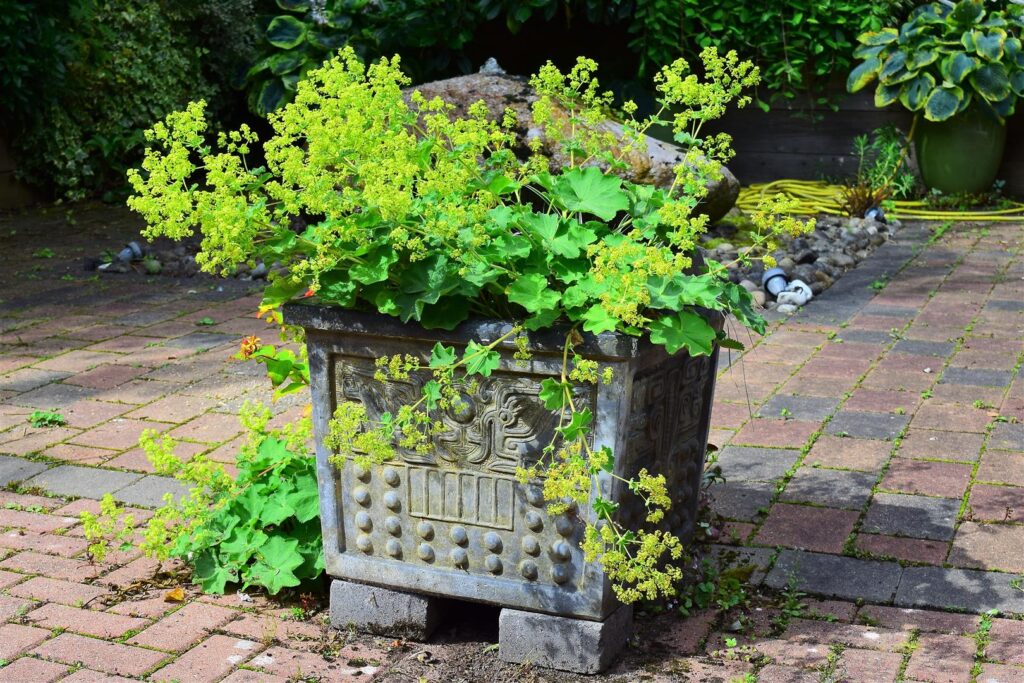
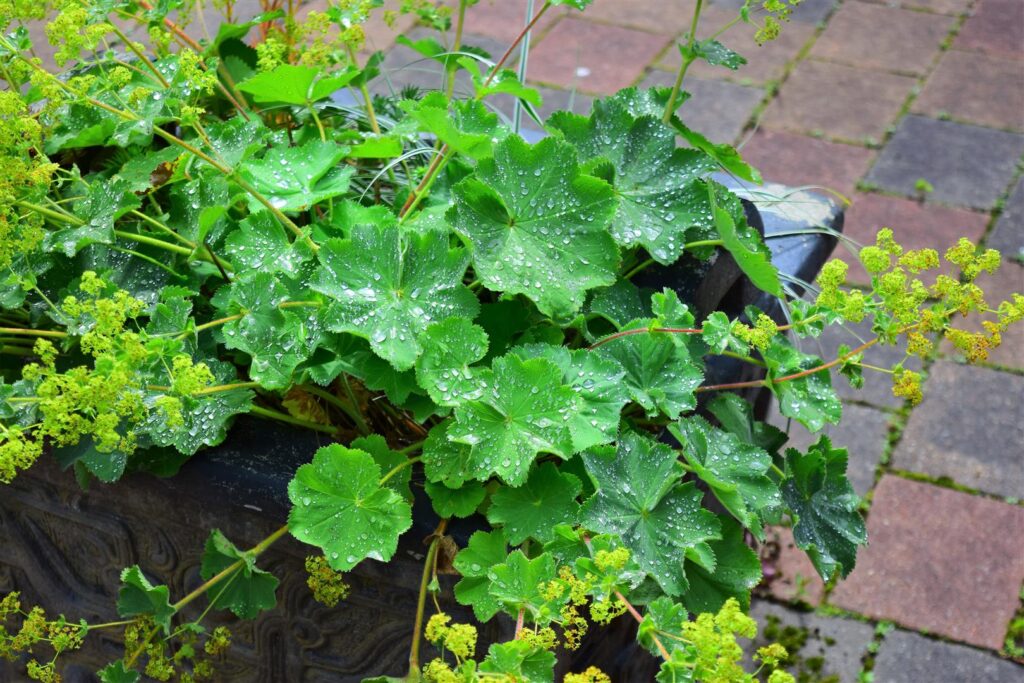
These two pots were bought in a sale and have been in the garden for the past fifteen years but over time they have been swallowed up by the vegetation to the point that they could no longer be seen and while I always knew they were there I just never got to reclaiming them from the rampant ground ivy and brambles that had taken them over plus I knew it would be a bugger of a job to clean off all the roque growth … and so it was but worth the effort and almost like getting a present of two lovely pots all cleaned up and gleaming ! Finding a new position for the pair was a challenge but I tried them here outside the back door at the top of the steps leading down to the garden , a kind of a cliched naff design look I know but they worked so I can live with the naff look and next up was what to plant , the pots are in full sun all day so perhaps annuals for summer colour or maybe even hostas but decided on the more formal look of box balls and again it worked .

Clonmel Garden Centre has a great selection of box balls in several sizes and I opted for a middle size as the planting should not dominate the mid size pots . I used my usual mix of filling … I maintain a few stock pots filled with a mixture of earth , leaf compost along , coffee grounds along with rain washed sand collected from the yard drainage channels and I use this as the standard base for all our pots and containers to which I add large pebbles and stones in the base of the pot to ensure good drainage then fill to about two thirds finished off to the top with John Innes potting compost and the final touch topped off with pea gravel after planting to suppress weeds but it also adds a nice finish .
Pots are great for patios , roof gardens , balconies and anywhere where space is limited for the normal planting beds and when I lived abroad , most of the time I only had a small balcony if I was lucky which I filled with all sorts of containers . Nowadays garden writers refer to planters rather than pots however I regard planters as long boxes suitable for a large group of flowers or plants and I still prefer to refer to pots as pots . Not letting pots dry out is the secret to growing plants in pots and regular watering is a must as even in our wet weather in Ireland pots can dry out so nothing beats a good long soak from the watering can . I find terracotta clay pots are best while ceramic pots have improved over the years to the effect that these are now just as good as the old fashioned clay pots and gone are the days when ceramic pots chipped and flaked in frost .
Plants in pots will tell you if they are suffering from drought as they will wilt to protect themselves but usually a good soak over two days will rescue them but you do need to keep an eye on them and it also helps in fact it is essential in my view that you position them where they will be in shade for part of the day .
In this garden we have lots of space and I use pots more for dramatic effect rather than as a place for plants and with big pots there is no need to keep them filled with plants all year round as they look good enough in themselves and I grow hostas in several pots but leave them empty throughout the winter .
In August 2020 Peter Cullen arrived for our first project together in a few years as I had an idea about cleaning up an area of the Lower Wood that had got completely out of control
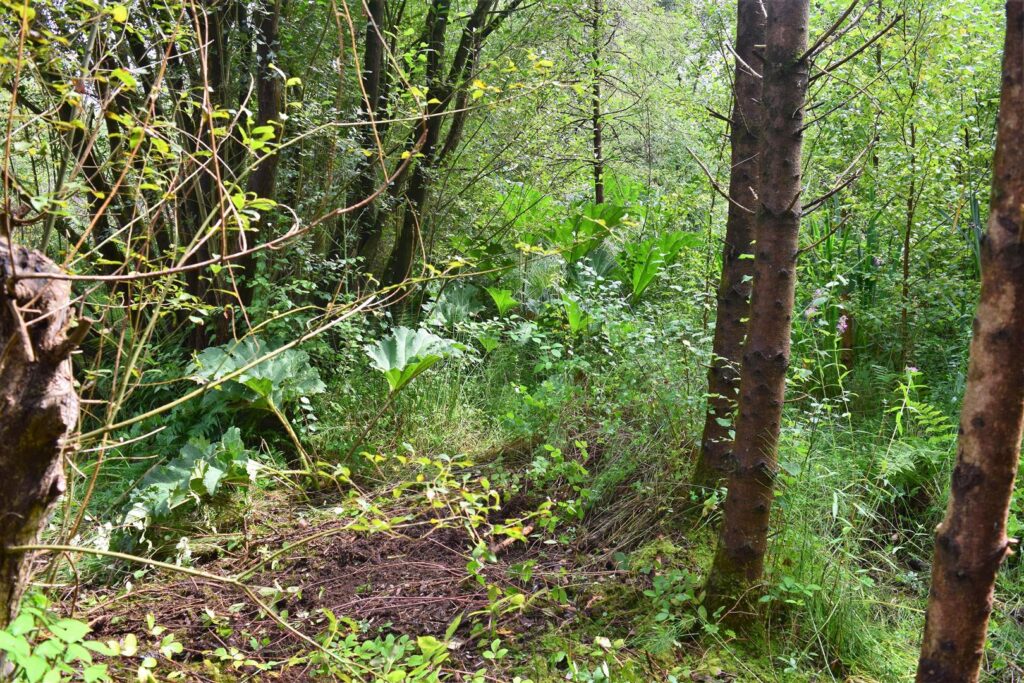
This was an area of the woodland bordering on to the stream which we never did anything with as it was boggy and water logged and which has been taken over and chocked with huge brambles , an area we never went into that I used for throwing all the willow prunings since Snezana got a chain saw a few years and kind of forgot about until this month when I took a closer look at it and fought my way right into the edge of the stream where I saw that there was a nice collection of self seeded silver birch trees and clumps of thussock grass all happily thriving in the damp conditions and in total anonymity away from view … possibilities possibilities as Capability Brown famously said in the mid 18th century !
Peter Cullen arrived with his excavator and was given the brief to clear all the brambles and woody materials and then he and I would decide how to proceed from a clean palette – my original idea had been to sow a rough lawn through the trees to the water’s edge however we both saw that as he excavated the soil it just as quickly filled up with water that was obviously just under the surface so forgetting any thoughts of a lawn we decided to enhance the water and keep digging backwards until we hit dry ground and in a few hours Peter had created a small pond about a metre deep .
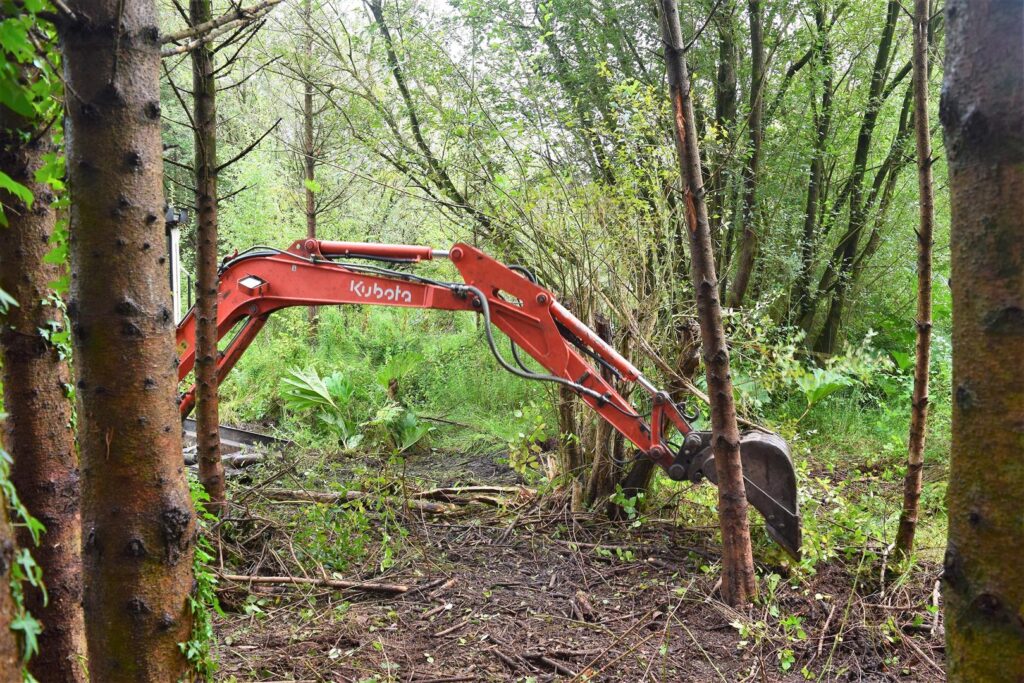
The excavated wet soil was laid along the banks of the new water area and will provide the ideal planting habitat next spring for hostas , darmeras , ligularia , primulas and other plants that like boggy conditions . I spent the next two weeks cleaning up the reclaimed ground between the trees , stripping the ivy off the trees and my next task will be to wade into the boggy ground between this new area and the stream and clean it up with a strimmer and then assess what planting it will allow between the self seeded silver birch that have colonised the area while naturally I will retain all the silver birch in situ and work around and through them .
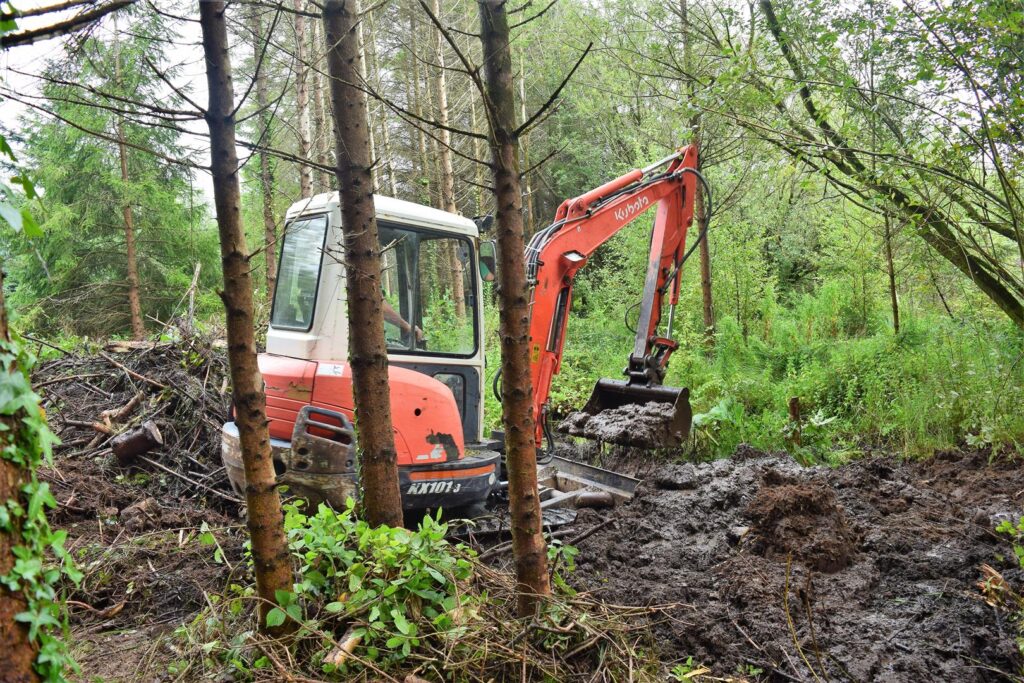
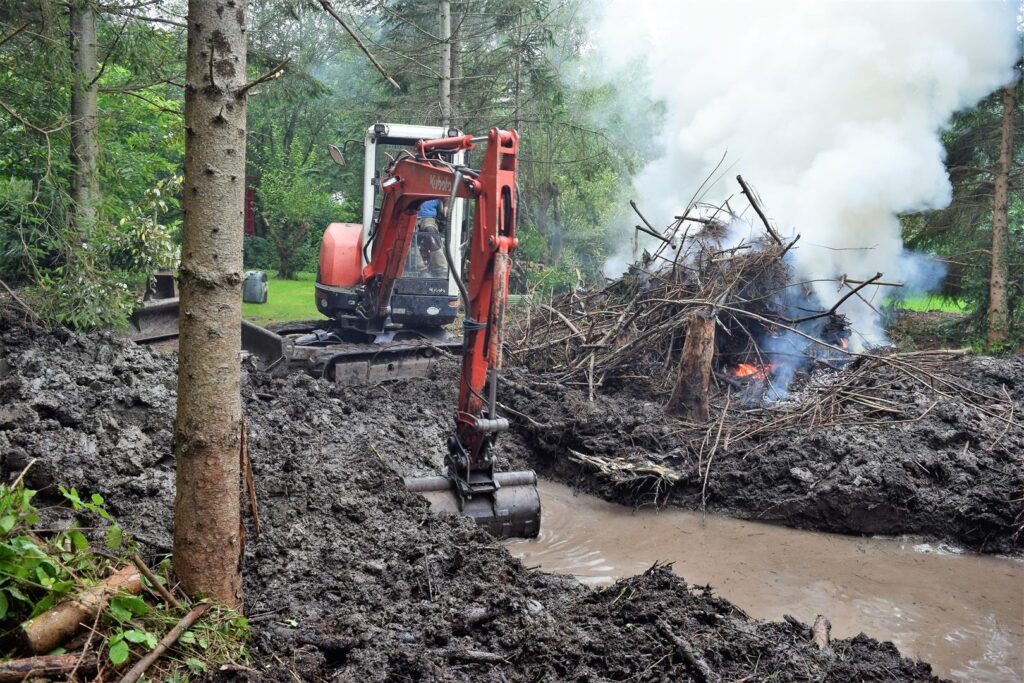
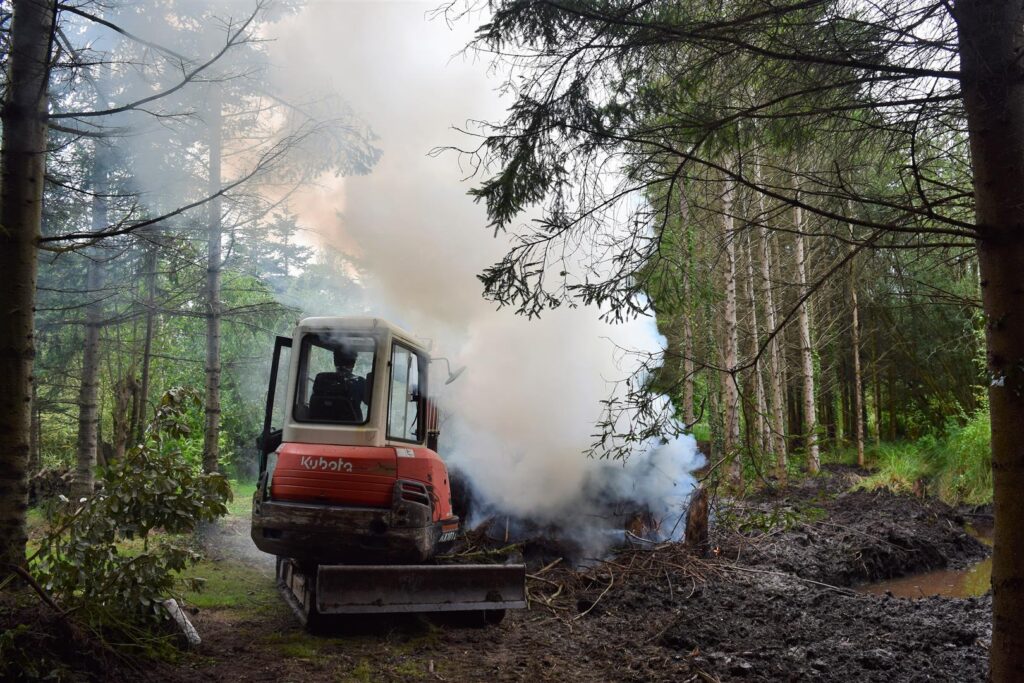
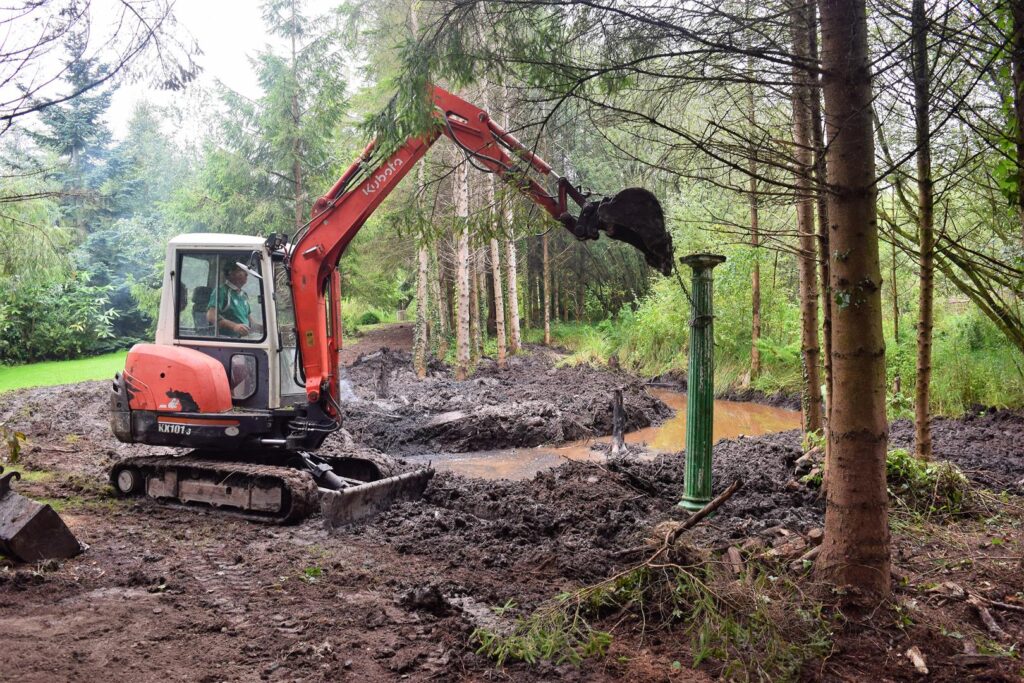
Two weeks later the clean up continues getting ready for planting in the winter months
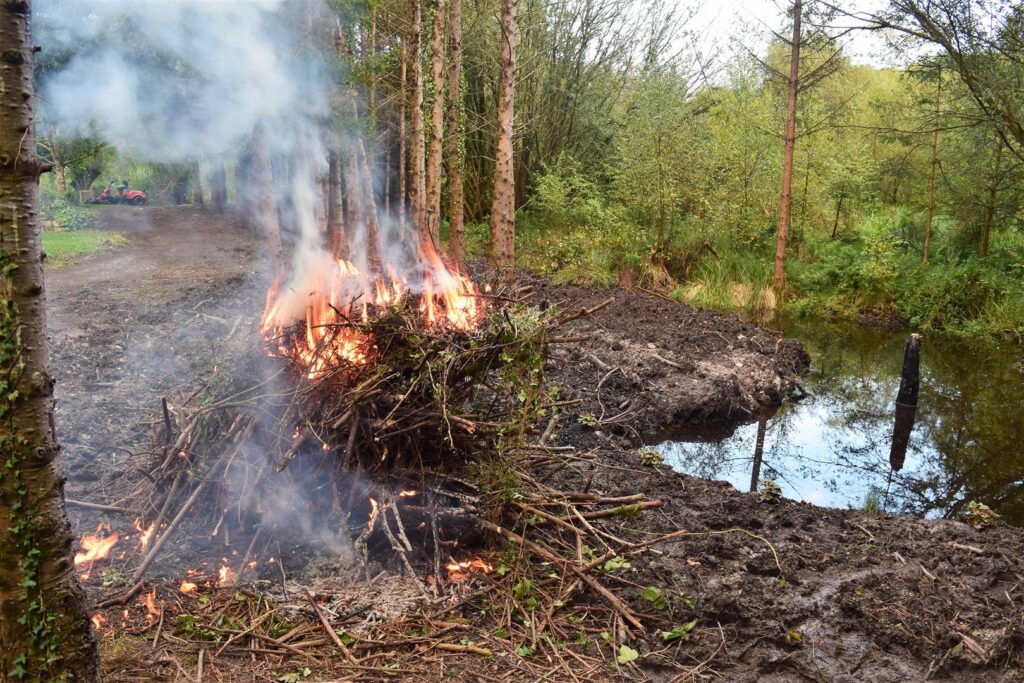
November 2020 and I have spent the past two months adding bog plants around the edges of the new water area .
Two gardening friends , Mildred Stokes and Margaret Rea , who both have fabulous gardens bursting at the seams with a great mixture of plants , donated two lots of bog plants that have outgrown their gardens . A collection of darmera and rodgersia which are favourites of mine , found a home in the new beds along the excavated water area which were created from the soil scooped out by the digger and layered along this area , good soil but of course wettish . I have slowly gone through our own collection of plants here and moved hostas and slips of bergenia along with ferns and lilies that I split up .
We had a break from gardening in October with a walk – slog – up Slievenamon
Slievenamon , six miles from Clonmel , is Ireland’s most iconic mountain which I saw every day on my way to school in the 1950’s and 60’s and which we see now from the house and the garden . The word slievenamon means mountain of the women in gaelic , Sliabh na Mban , and legend has it that Ireland’s most famous mythical hero is buried under the large cairn of rocks on the summit which is a bronze age burial mound from 1500 BC .
I grew up in Clonmel and to someone from Co. Tipperary , Slievenamon is “our ” mountain and over the past twenty years as we drove to Kilkenny or Waterford I have been pointing it out to Snezana and telling her of the legend of Fionn so this week I decided she should climb Slievnamon and see it up close and personal … but what I didn’t tell her was that it is one god awful unrelentless slog up and down !
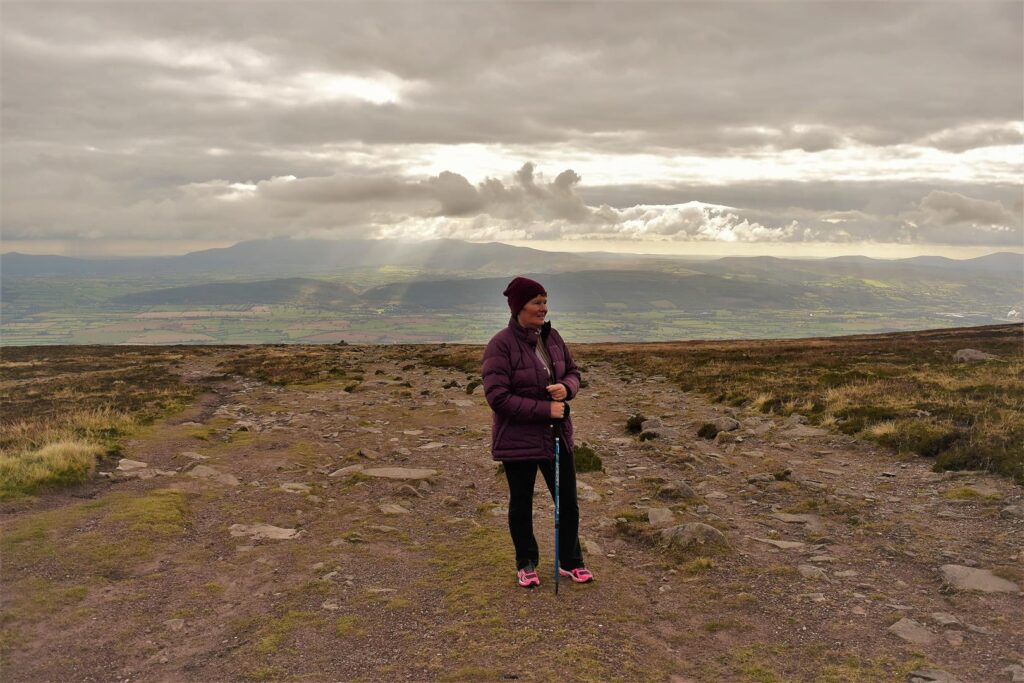

Beautiful views across to the Comeraghs and along the valley between the Knockmealdown and the Galtee mountain ranges and of course the feeling of being in such a historical place with Neolithic tombs and standing stones dating back to 1500 BC showing that our ancestors venerated Slievenamon also .
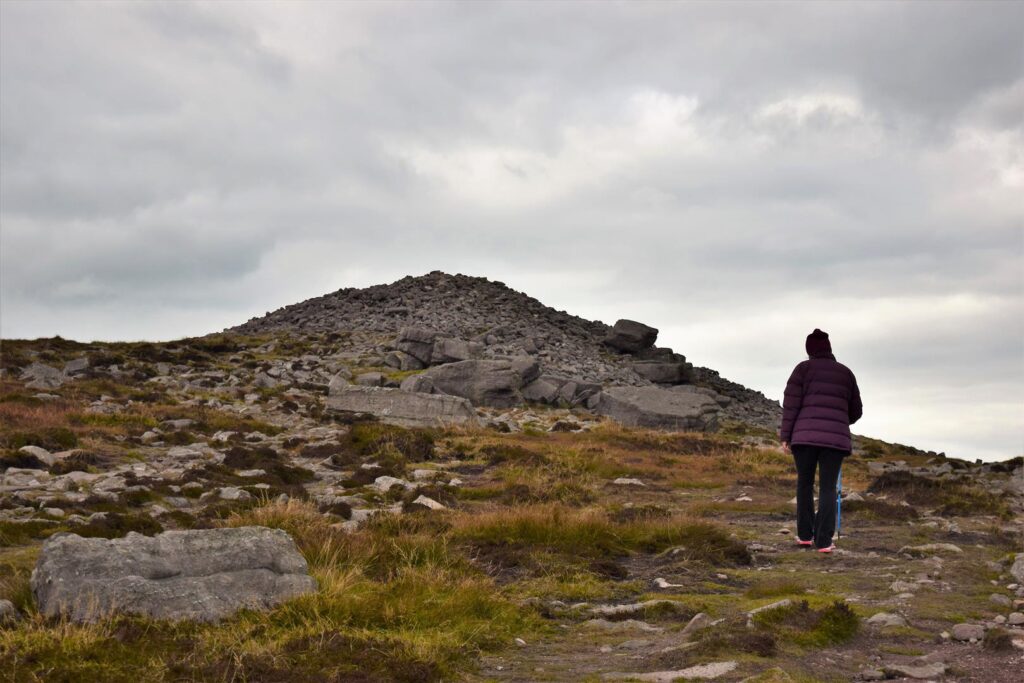

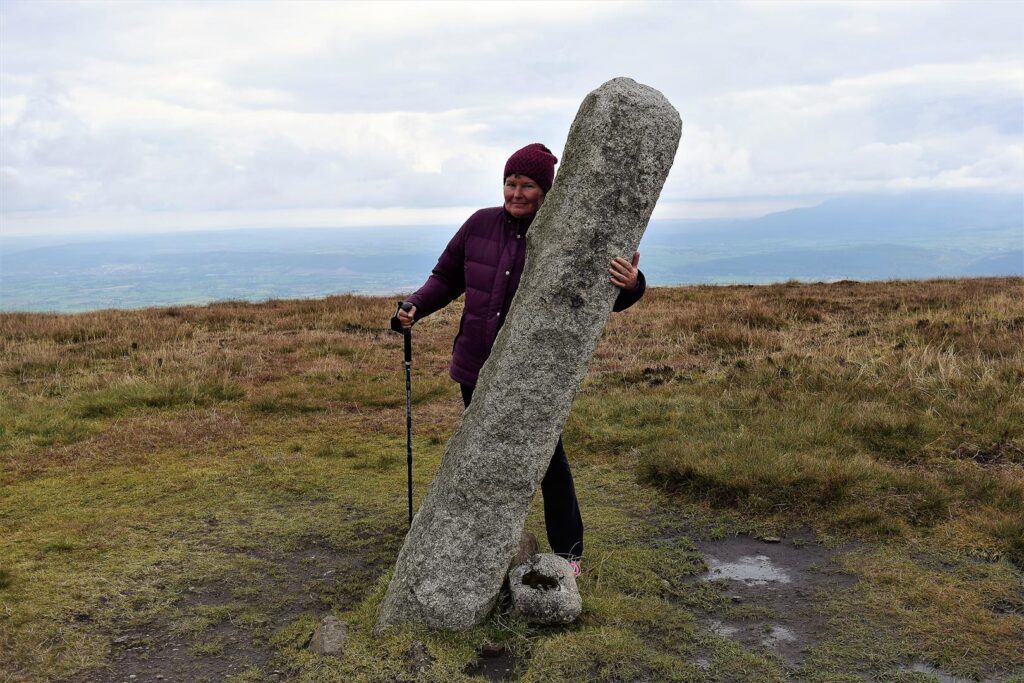
Peter came back with the digger and tractor in October to complete the new rock installation in the Lower Field .
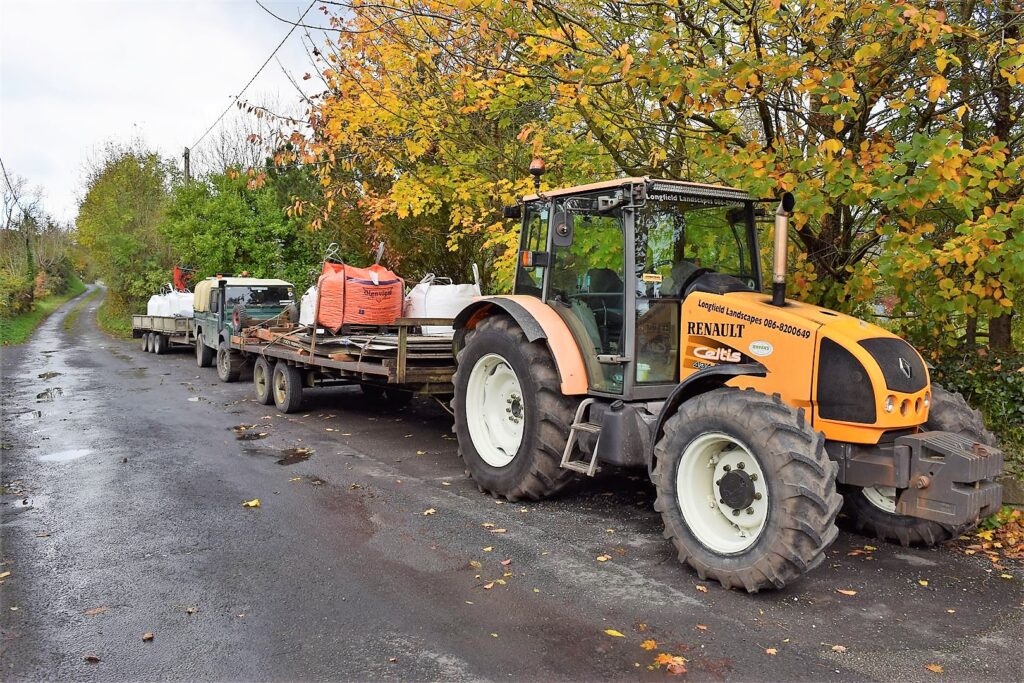
The crowded lane outside the house tells a story in mid October , another project was underway as Peter Cullen arrived with a digger , tractor and trailer to complete the island rock installation planned since I cut out the tear drop shaped design in the grass at the Lower Field in late August.
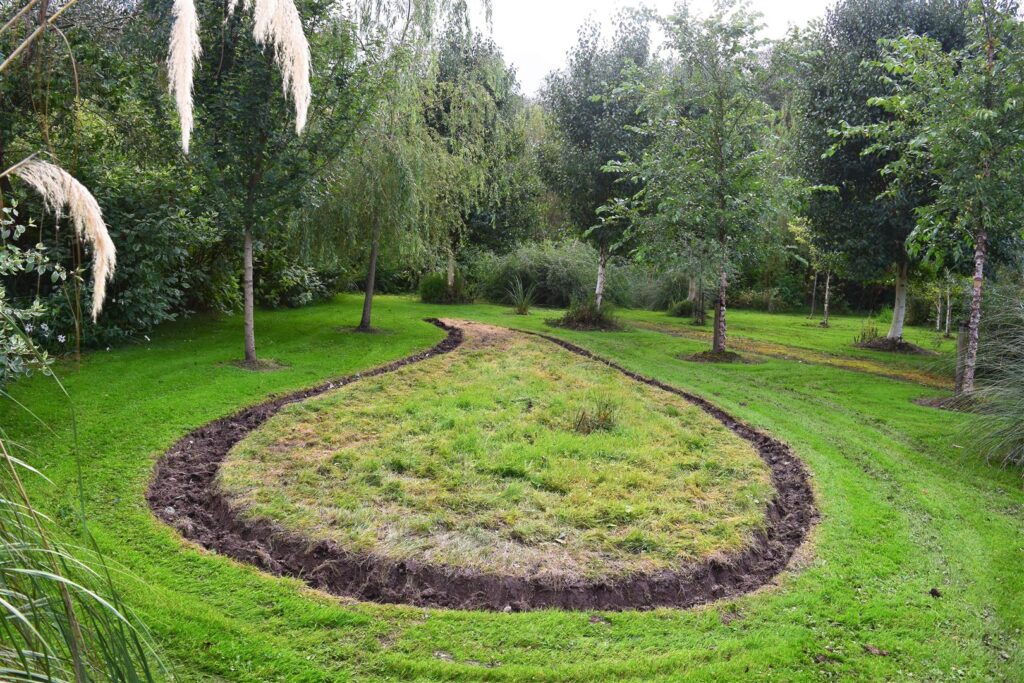
I always felt this space lacked something and after a visit to a friends garden in July I was really impressed with her separate perennial bed and decided this was what I would build however another gardening friend pointed out that while a perennial bed is lovely , it only flowers for two months and as this was to be both an island bed and a feature you would be looking at a collection of sticks for ten months of the year so it was back to the drawing board to come up with something that would give all year round enjoyment and so the idea of an island rock installation was born .
Although the space available for the proposed rock installation was quite large I didn’t want to over crowd it with rocks , five large pieces was my estimation of what it would take and I determined from the beginning that it would be just stark rock and gravel Japanese style , no plants . A neighbour of mine on the mountain , Pat , had a huge collection of rocks that he had unearthed while clearing the site for his house a few years ago and had generously offered me my choice to collect and take away .
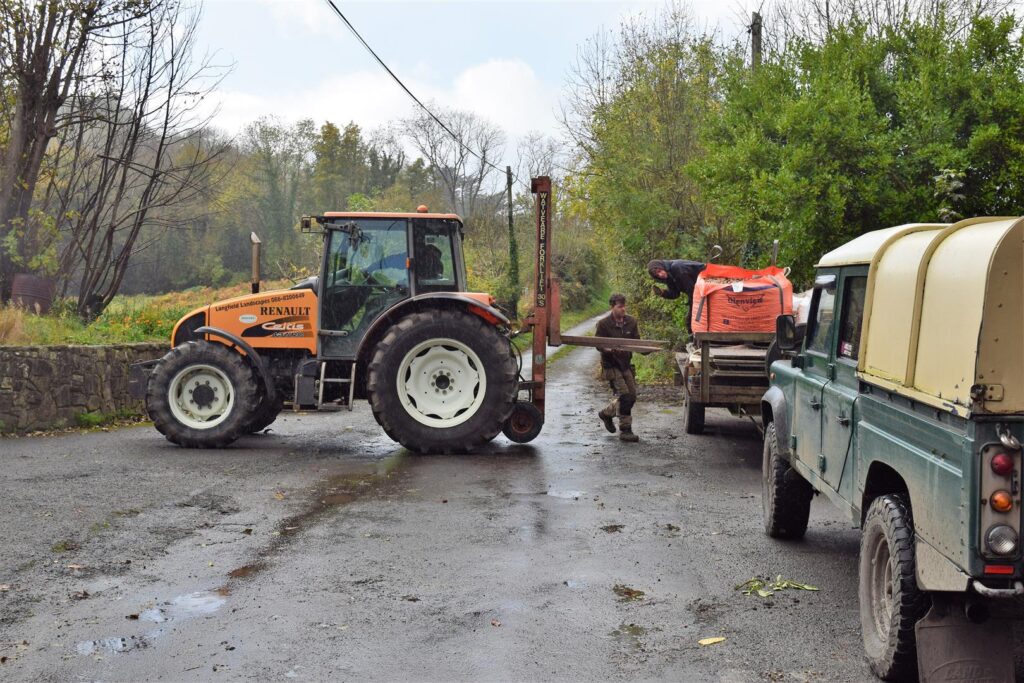
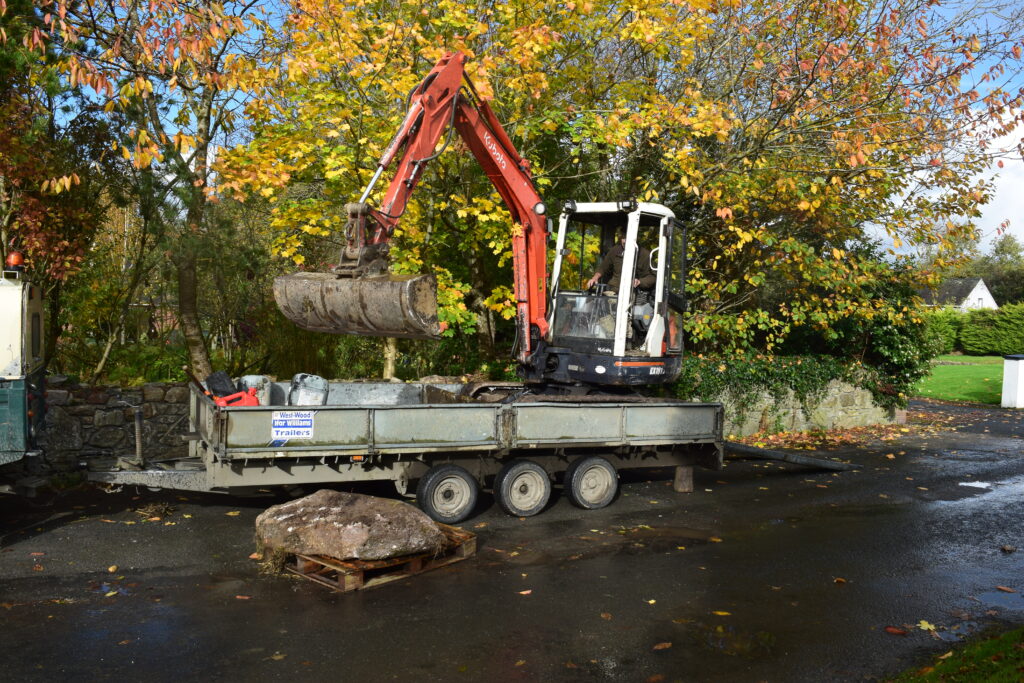
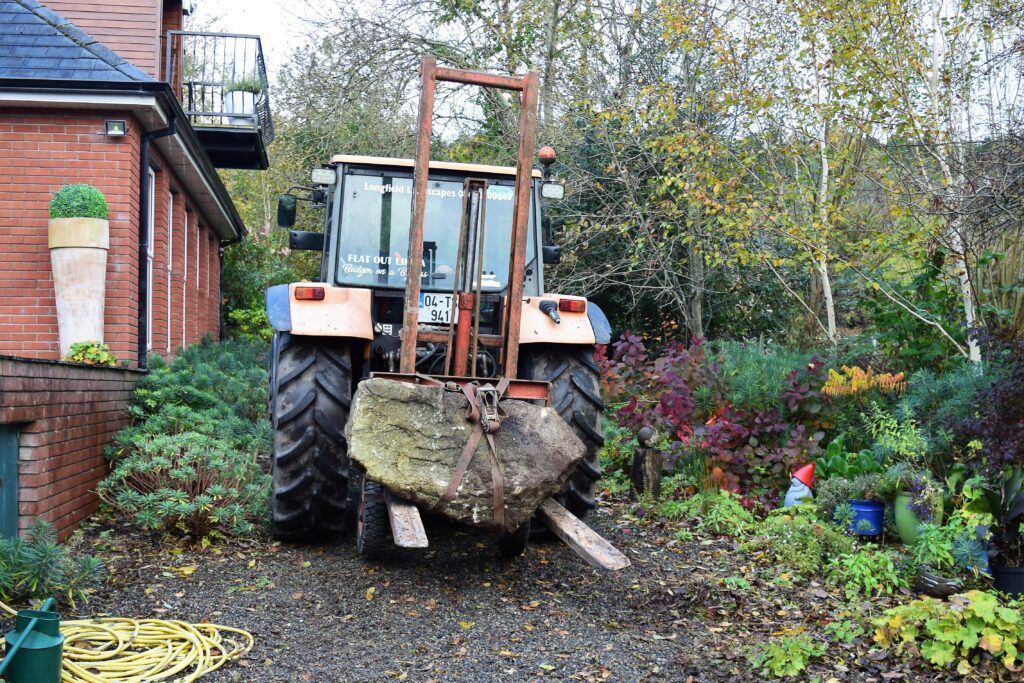
Peter and I selected five beautiful large flattish rocks , all of the same granite and we had already picked out the places on each stone in the new design .
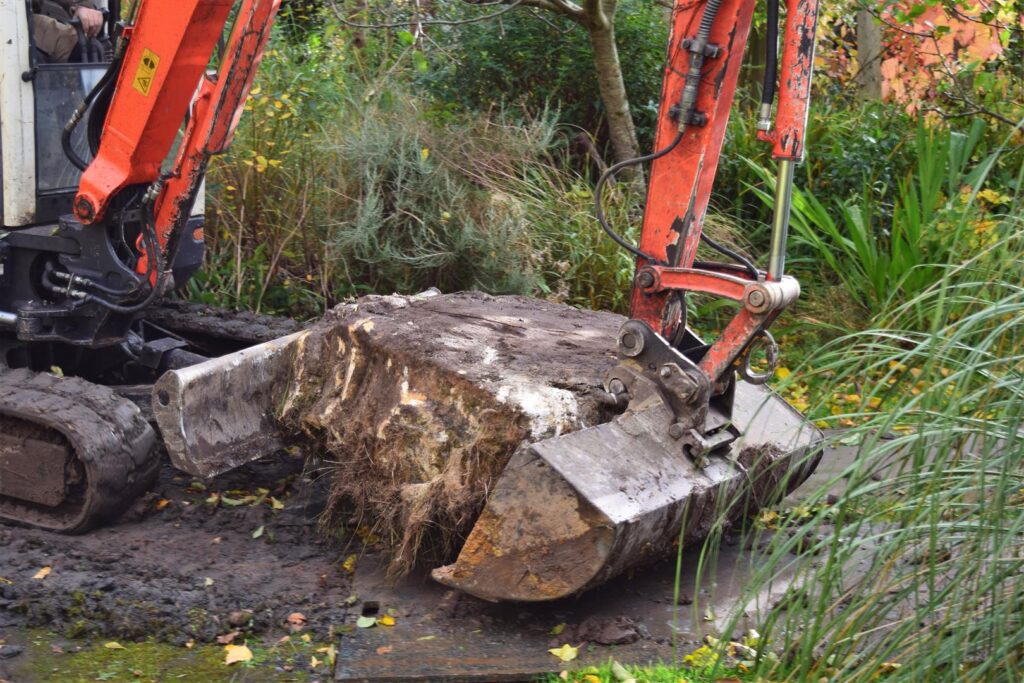
I had cut out the design and sprayed off the grass in late August and the next step was to cover the bare earth with rolls of mypex which will suppress any new growth through the gravel finish and then carry each rock from the mountain in the digger and line them up to make the final pTositioning … each rock had to be assessed and as the installation is in the middle of two paths the best “face ” had to be selected … this was the hardest part of the project and each rock was individually assessed and positioned and then walked around and positioned again until each rock clicked both in it’s relation to the overall shape of the design but also in relation to it’s four other companions … fussy to the point of nerdiness I know !
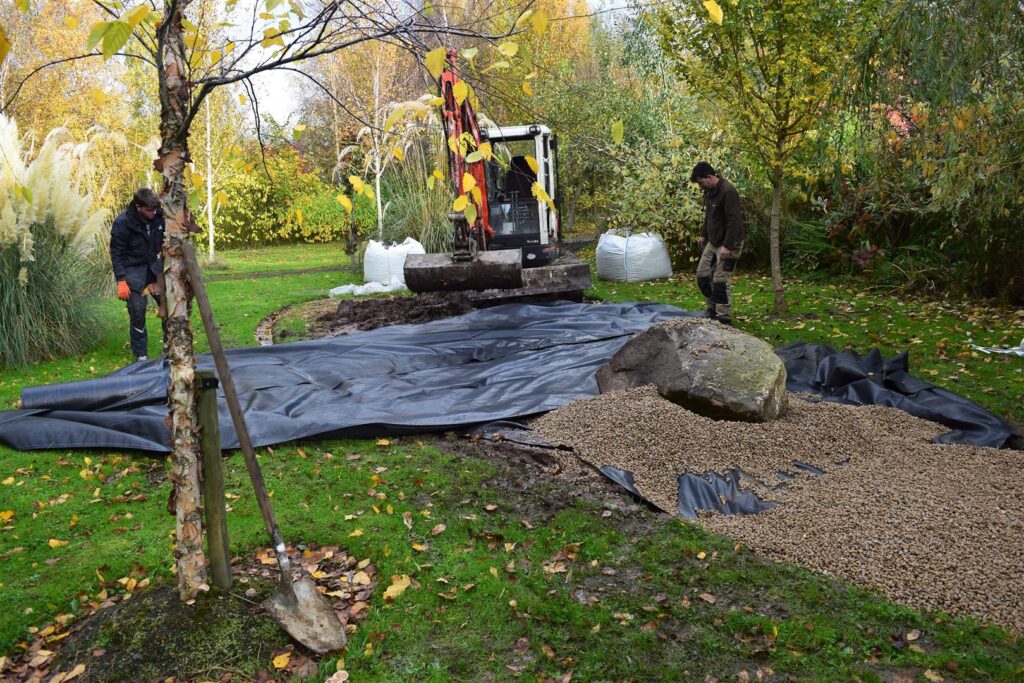
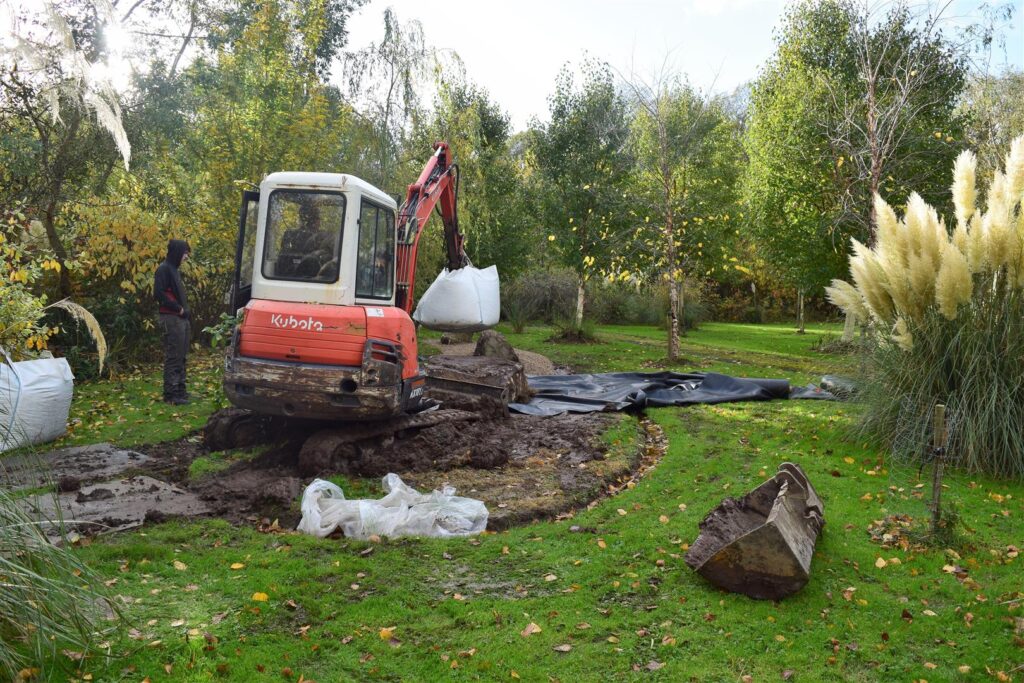
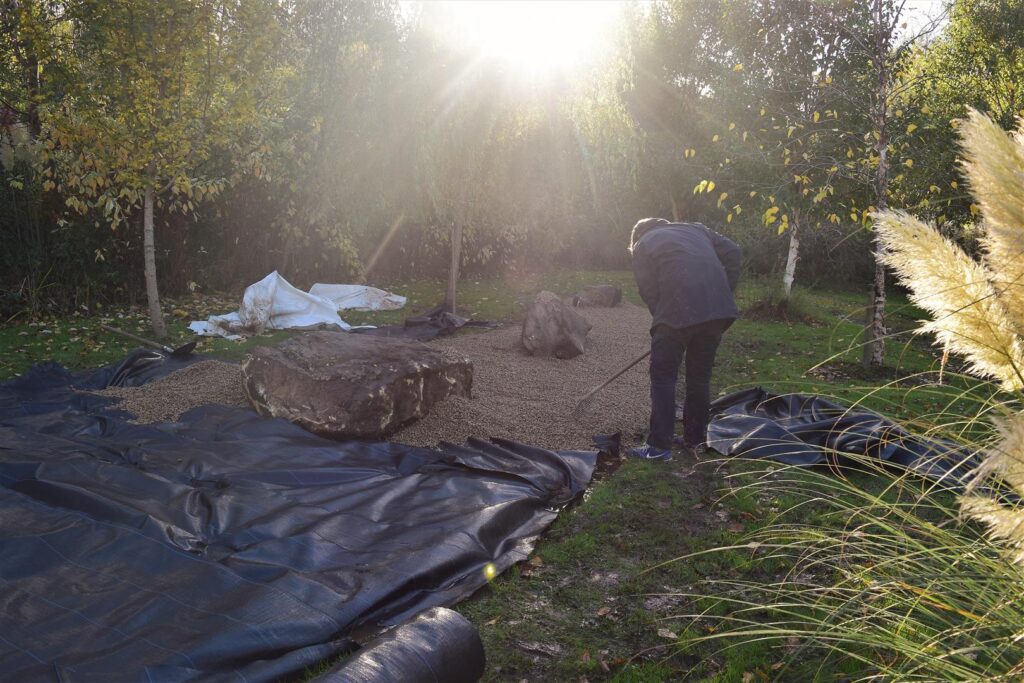
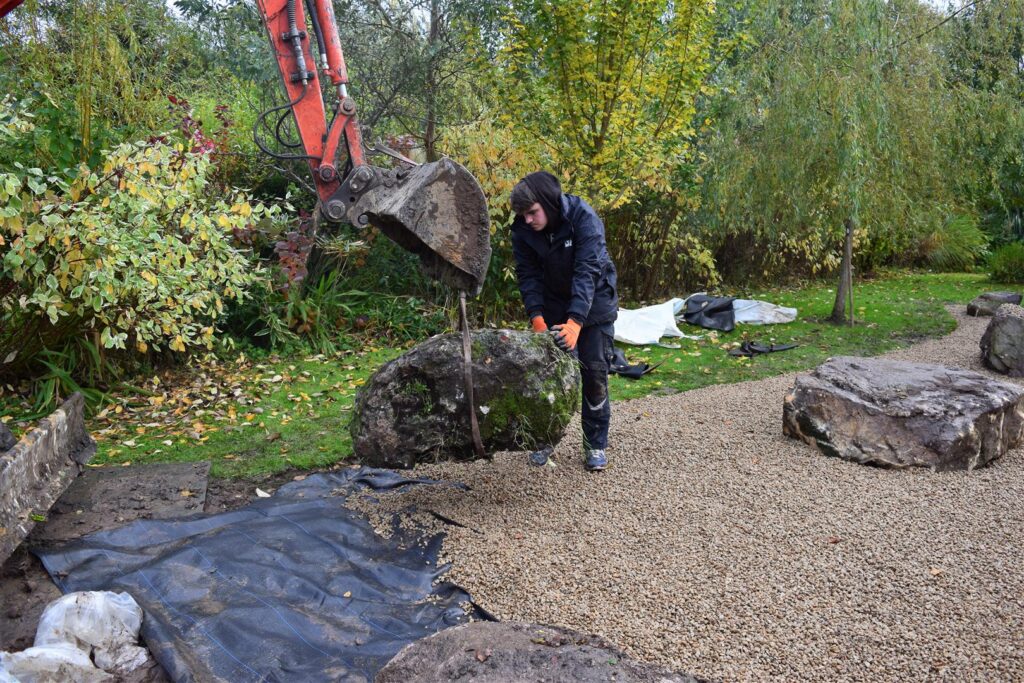
Getting the position of the rocks was tweaked several times and the last stage was layering with gravel to a depth of six inches , the gravel anchored the rocks and provided the perfect contrast for the island bed . I had thought originally that I would add perhaps two miniature Japanese weeping maples to the finished design and while that would work in some cases , here I am satisfied that it doesen’t need it and might even take away from the effect .
The finished rock intallation
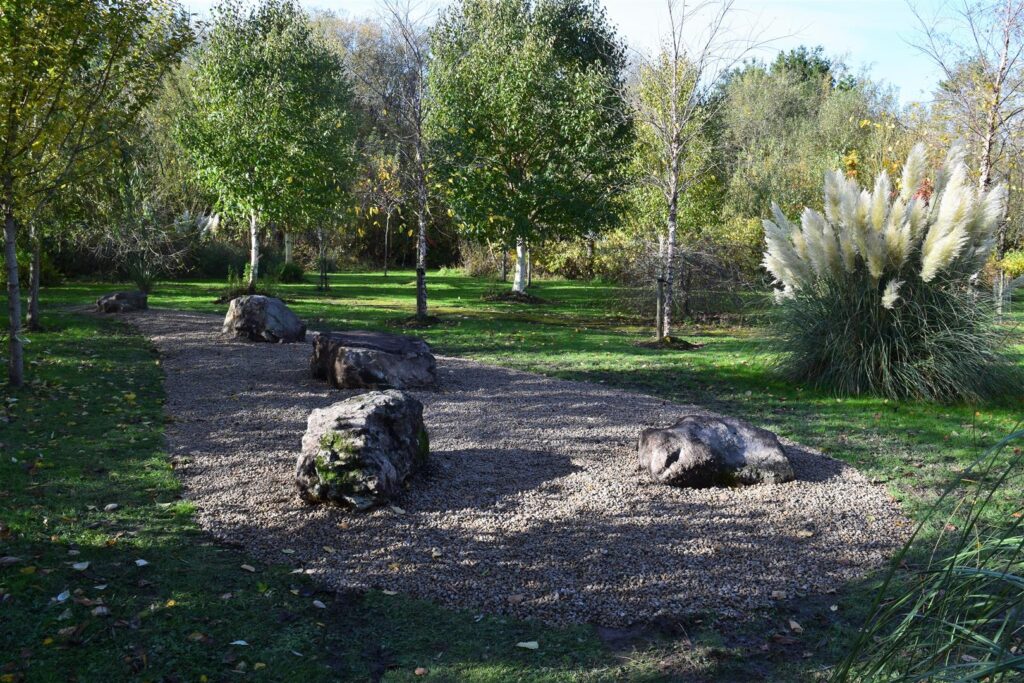

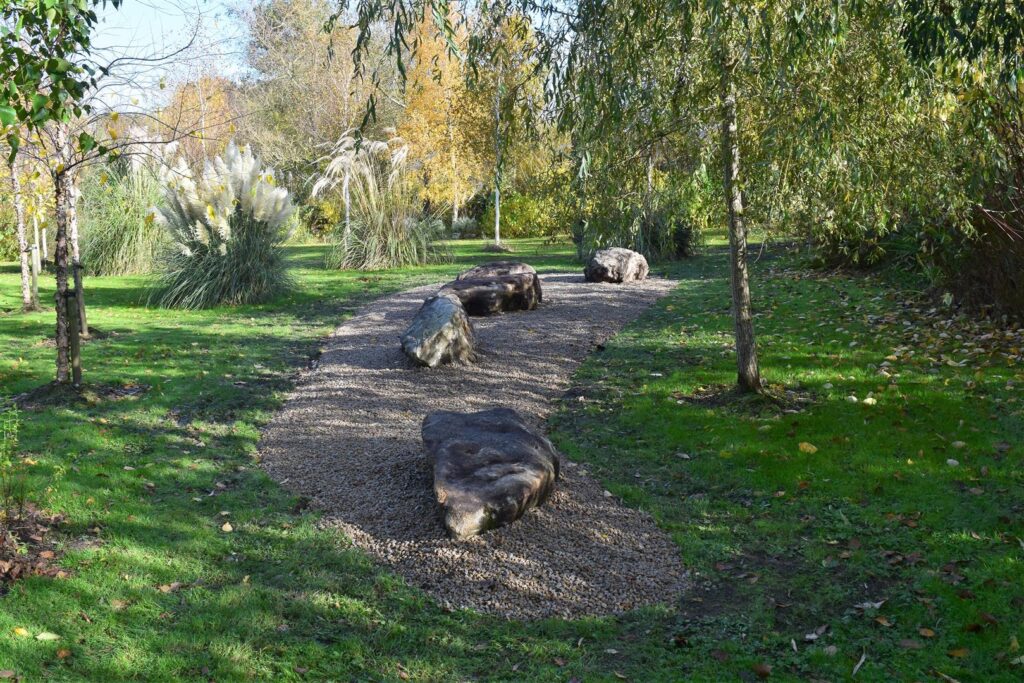
As part of my regular A Walk in the Garden series I posted the following photos on October 21st 2020
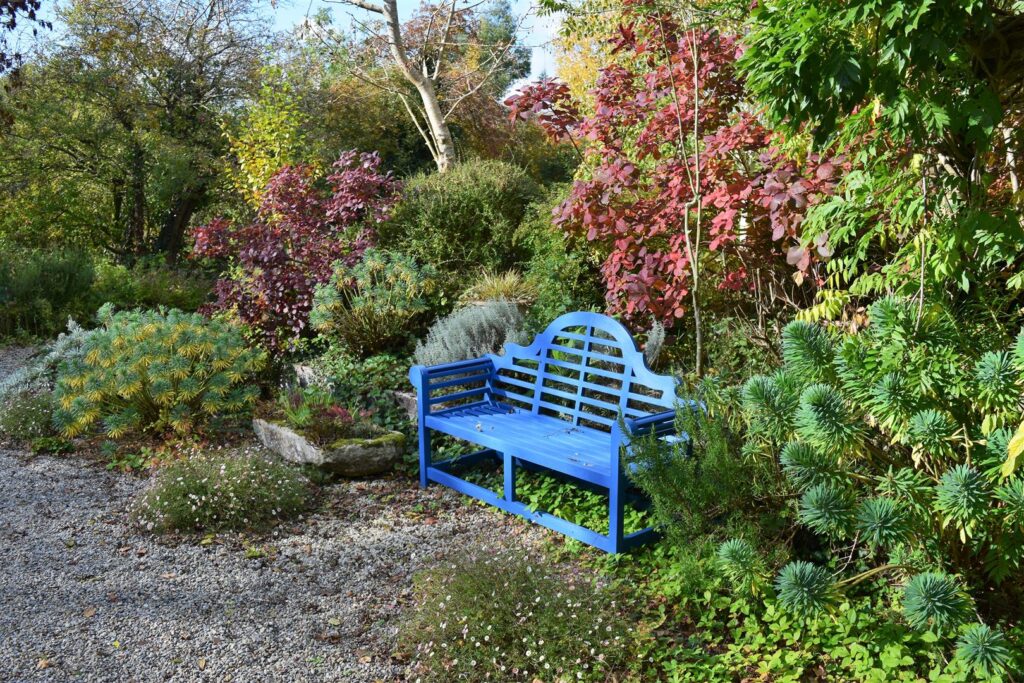

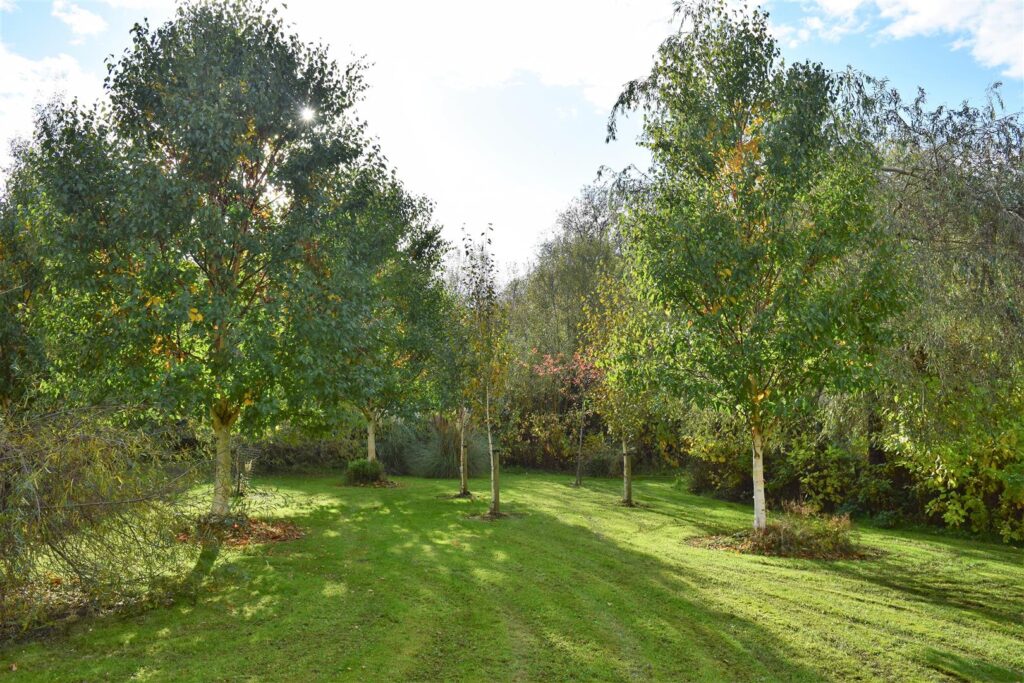
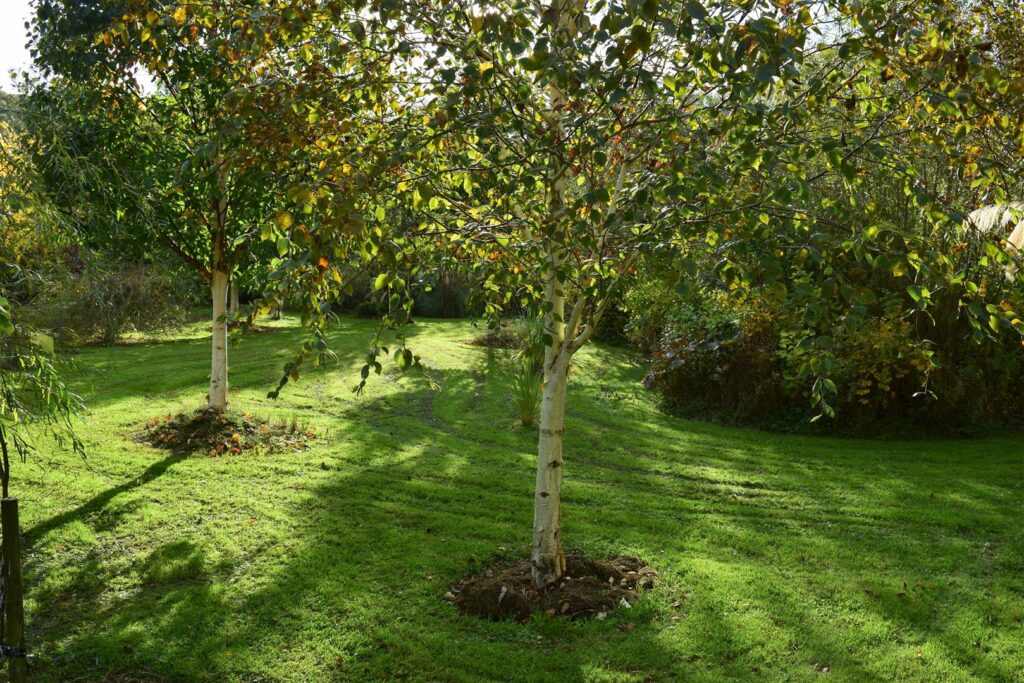
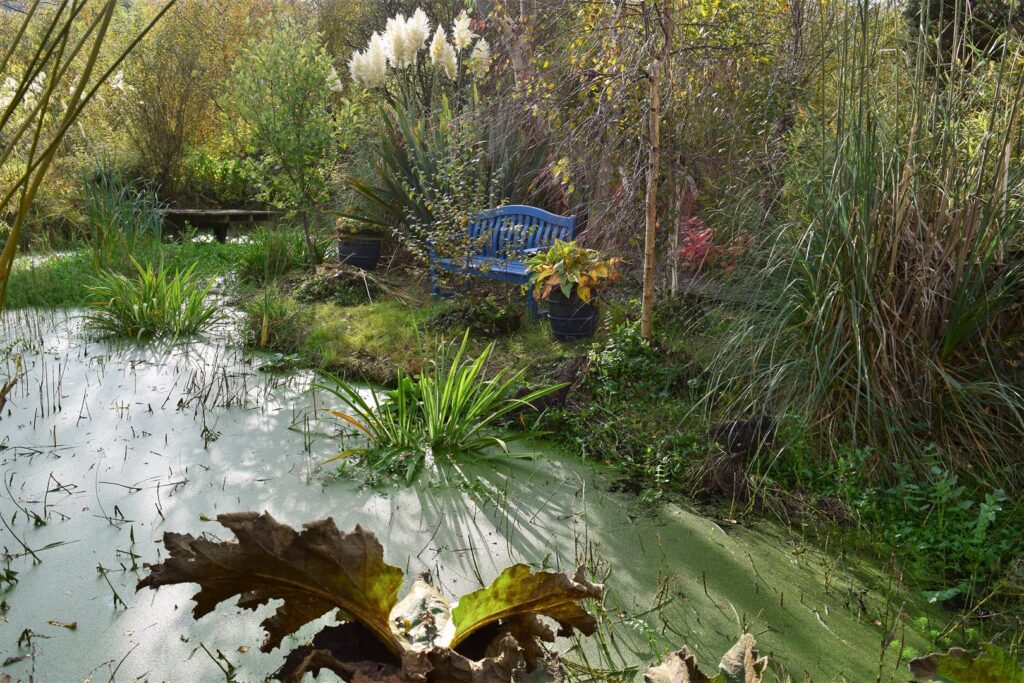
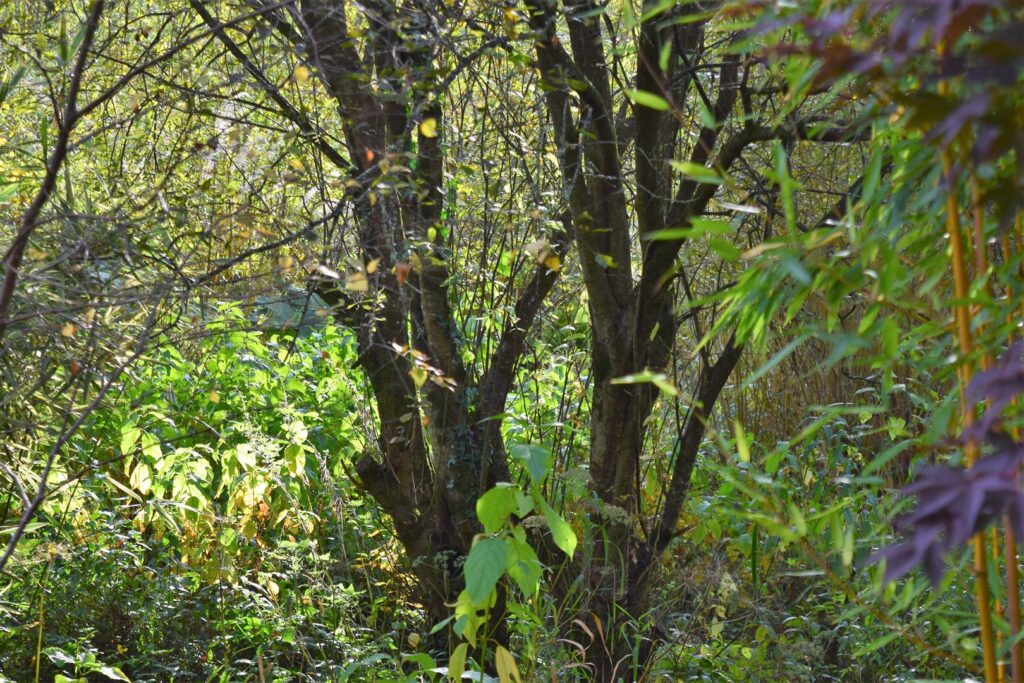
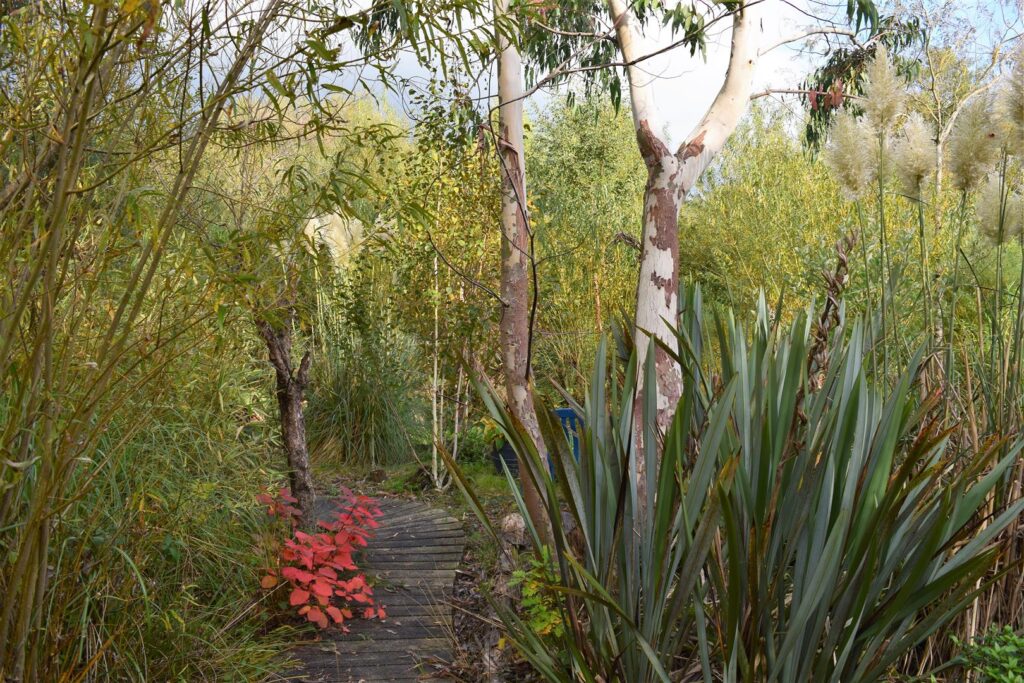
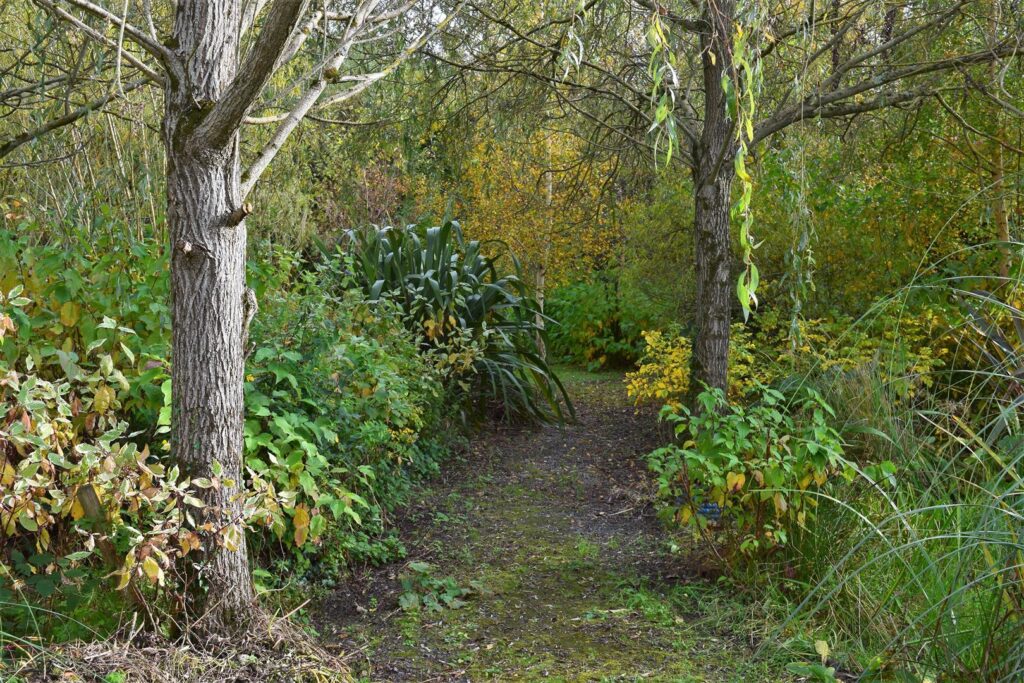
In November we decided to continue excavating the size of the new water area .
No slackening off in the new water area created in September by clearing out an overgrown section in the swampy area backing onto the stream … overgrown doesen’t quite describe just how infested it had become with brambles up to two metres high and so waterlogged that just scraping the surface with the excavator brought water to the top so it was a logical decision to dig deeper and excavate a huge chunk of ground to a metre deep and create a fairly large new pond . The scooped out soil we layered along the bank creating a nice wettish base for bog planting and I have already transplanted off cuts from our hostas , lilies and acanthus together with donations from a friend who was dividing up a perennial bed so we got buckets of rodegersia and darmera which are ideal bog plants and two of my favourite architectural perennials with huge leaves . On the dryer edges I have added ferns and ground cover lamium while at the water’s edge to a depth of 4 inches under water I have added primulas and wild marsh marigold I have divided up from other parts of the garden .

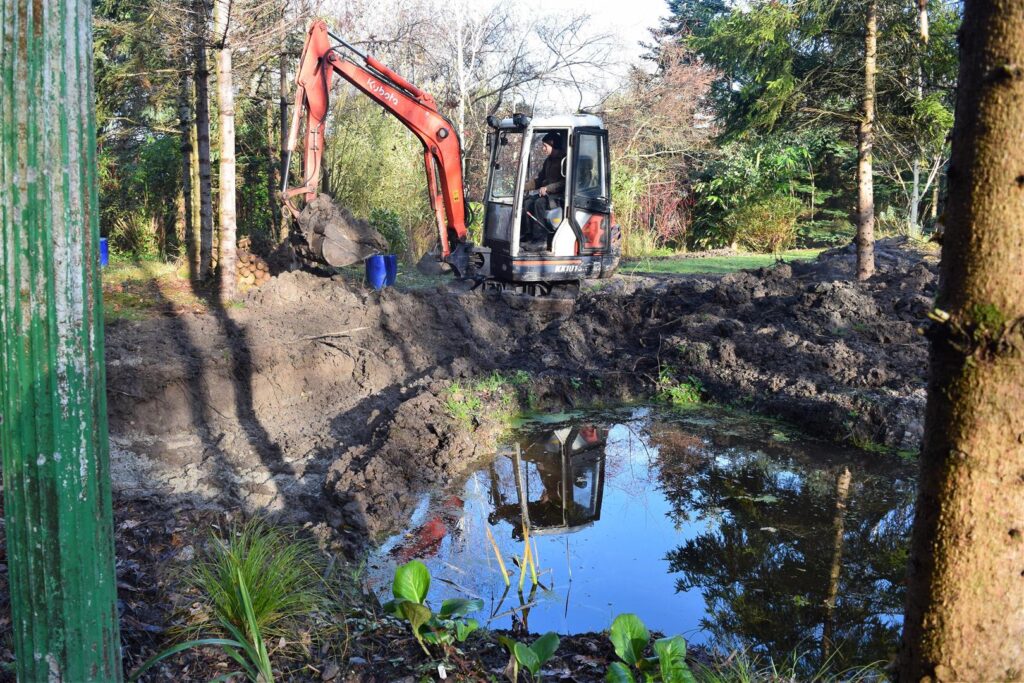
They say a garden is never finished and of course it evolves and changes as your taste in plants and indeed your ambition changes over the years and you learn to never say never on garden designs and this is the case in point here with the new water area . We found that in extending one area a drop in level was created just beside it which never cleared of surface water after rain and became too boggy to use as a path so we decided to continue with the extension to include this new water logged part into the new extended water garden .
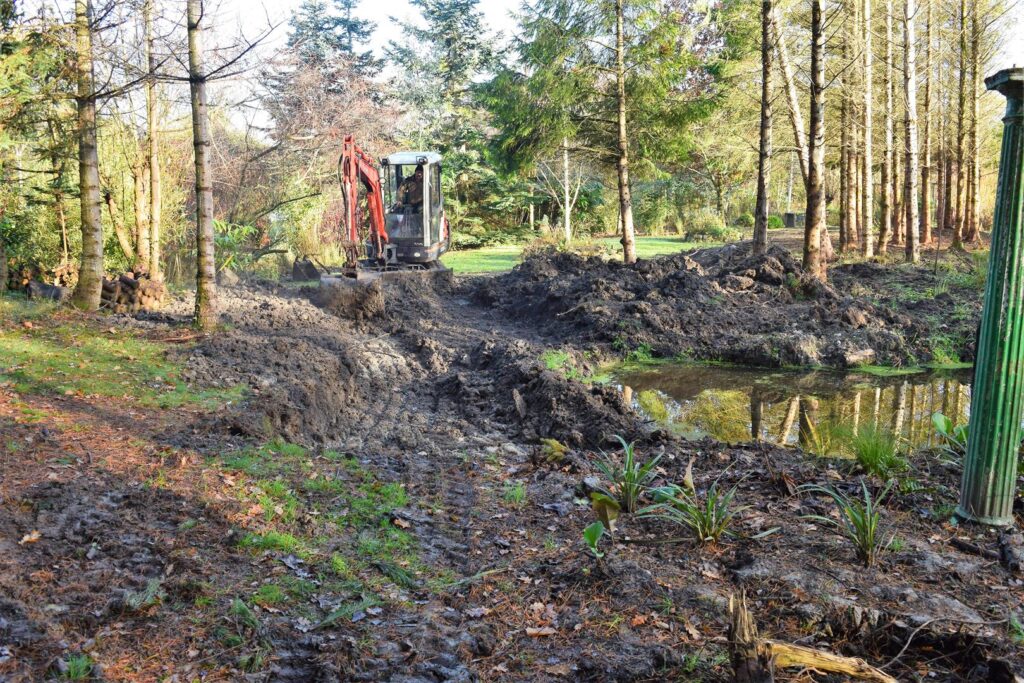
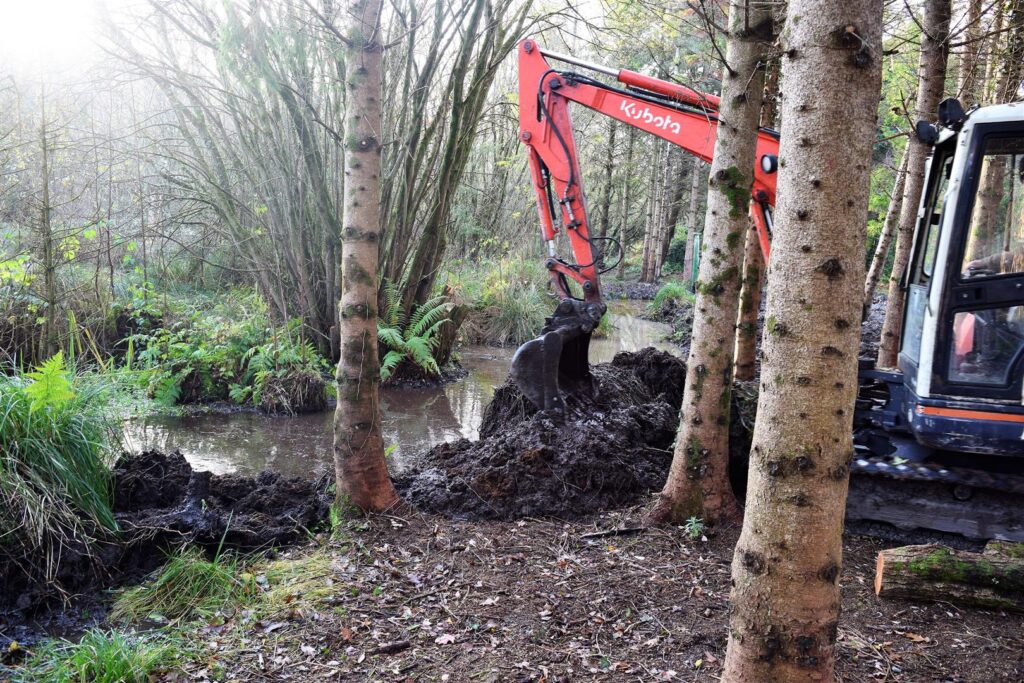
Peter Cullen arrived back again last week with his digger and quickly dug out the new area which as before immediately filled with water . Peter has been working on our garden project since April 2006 and has brought many ideas and tweaks to our plans and his expertise in landscape has been a major factor in the development of the garden as it is today , we work well together , no egos get in the way and we go with the best plan and sometimes as in this current work the plan is tweaked and made up as we go along . Peter is a maestro on the digger and can turn it through the tightest of areas , you want this tree removed , bang it is gone and twenty minutes with the digger can clear and dig out and area of thirty square metres and so it was last week and we ended up with twice the body of water in what was two months ago a no go wet area overgrown with brambles , now it is a small lake and ready for planting both with marginal aquatic pond plants and damp loving plants along the banks .
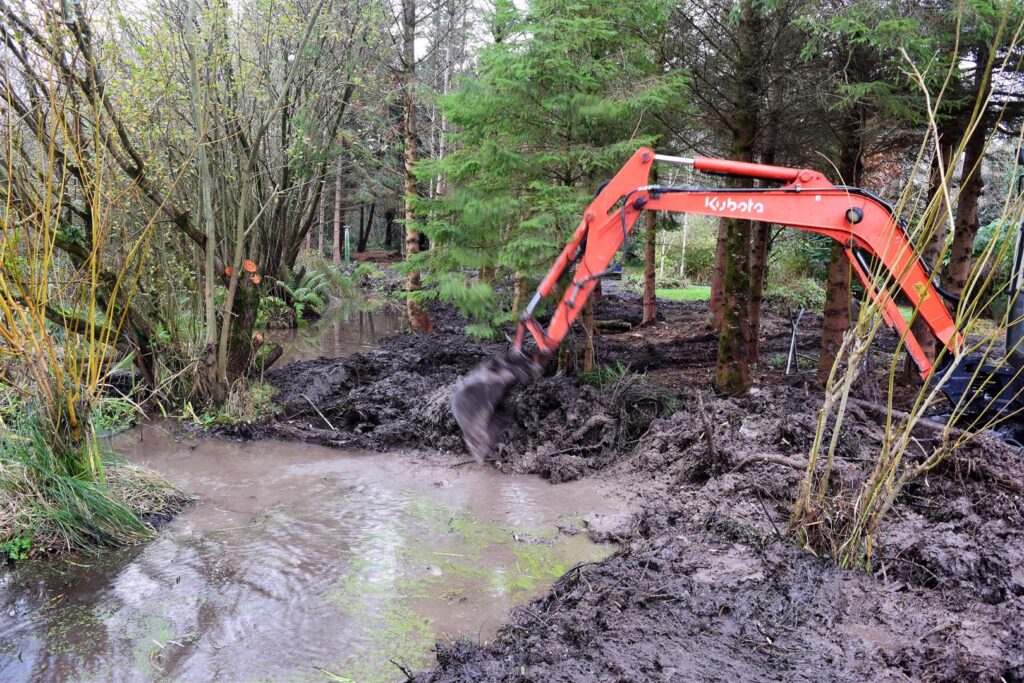
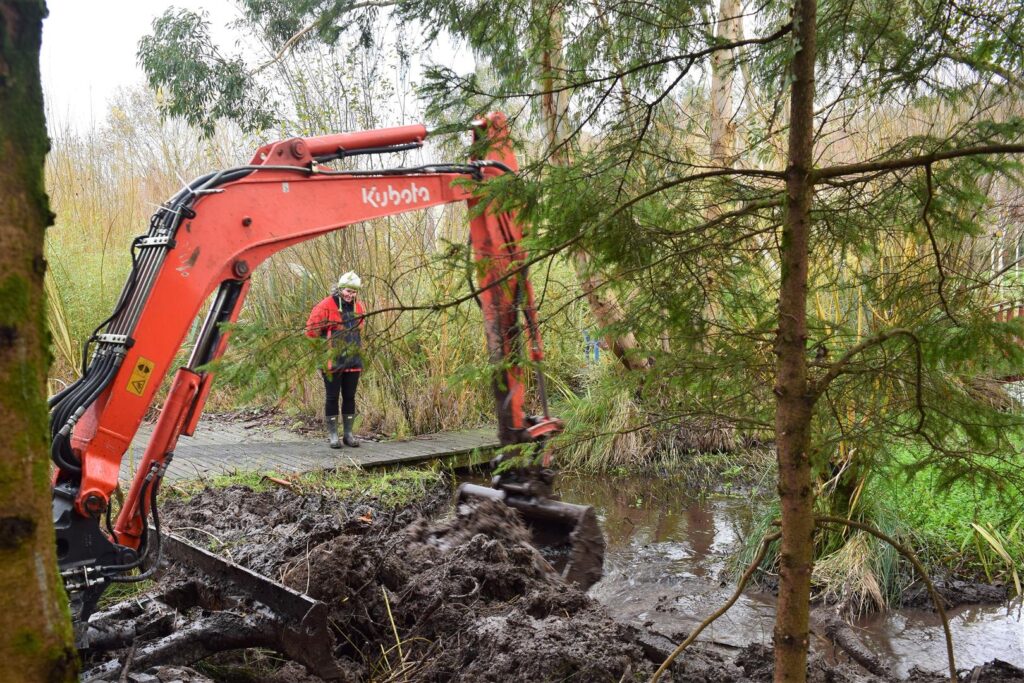
Finally while the digger was on site I decided to solve the problem of the large standing rock , our “ogham ” stone and move it from it’s original location at the edge of the wood where we first installed it in February 2010 as over the ten years the area around it has become overgrown and it no longer stood out or took the eye .
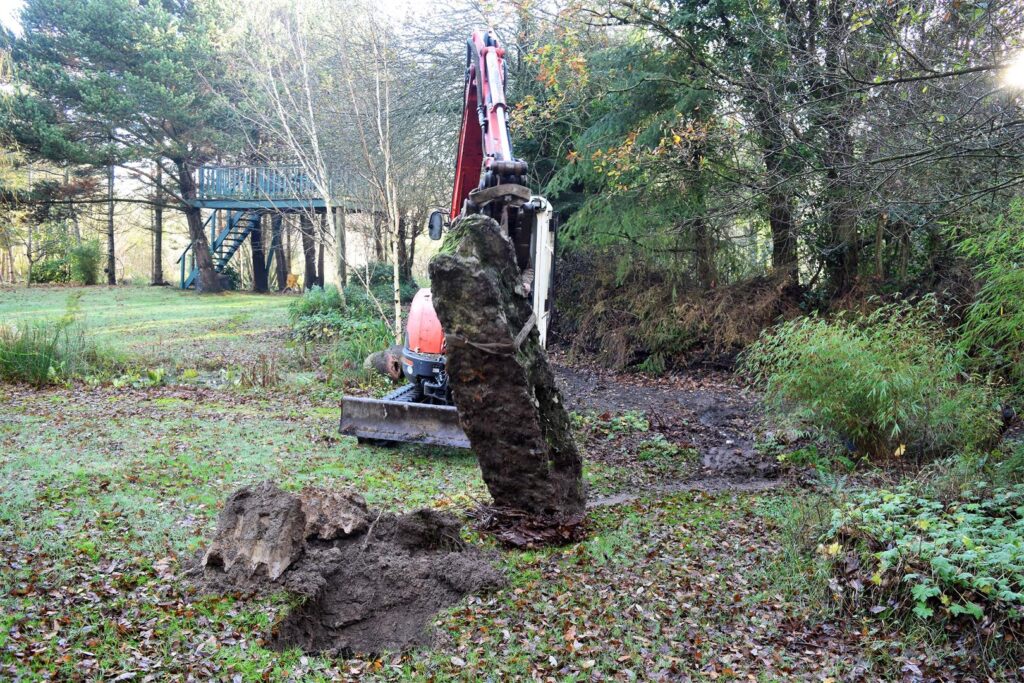
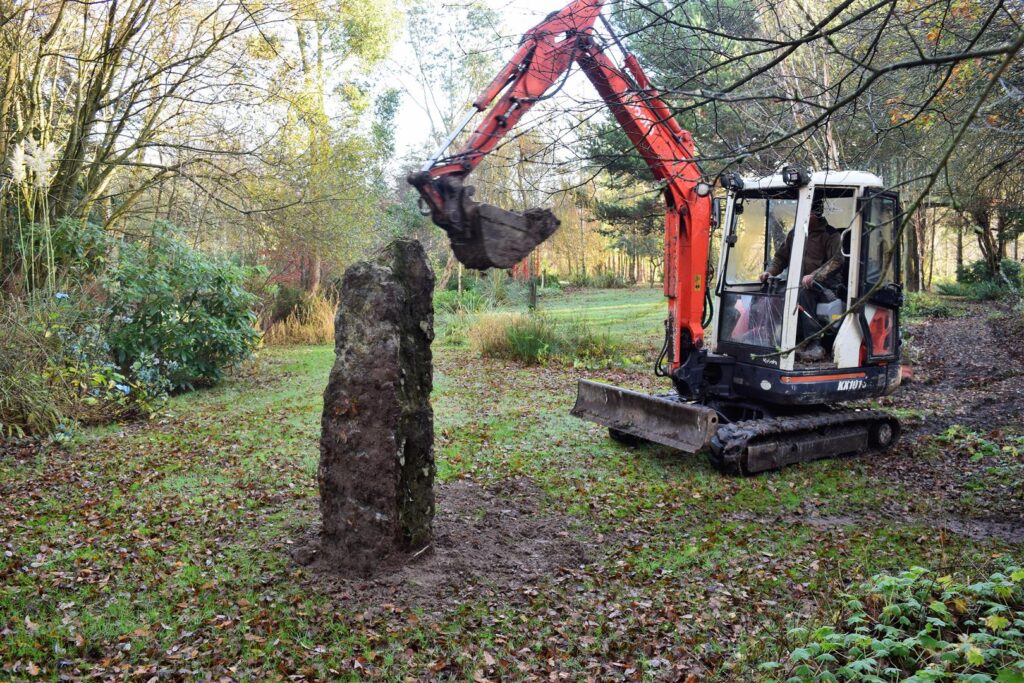
The new area is in the middle of the lawn in the woodland area and the stone now dominates again .
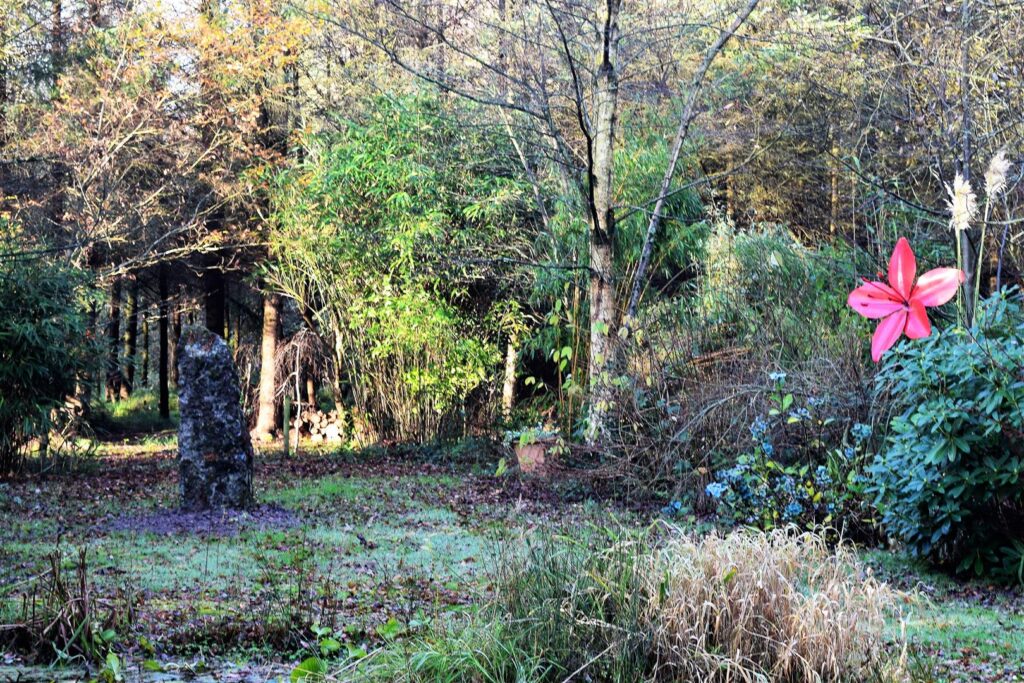
My Garden Blog for December 2020 summed up how Covid had impacted the year .
My Gardening Month December 2020 … A Bastard Year !
A phrase I read recently to describe this past year was that 2020 due to Covid has been a BASTARD YEAR , sums it up perfectly and God love anyone who has lost family or loved ones to the virus but good news for January 2021 with the roll out of the vaccine and hopefully we can all get our lives back on track again .
My Gardening Month 31st January 2021 … January is not my best loved month !
A new year , a new decade and hopefully the much promised vaccines will banish Covid and give us back our normal lives .
Moving trees in the garden in January 2021
We all have trees , shrubs and plants that are in the wrong place or that are not doing well and January is a great month to do something about that . Last month when we had the digger here we moved a multi stemmed silver that was not thriving in the front garden since planted five years ago and this month we tackled a parrotia tree also in the front garden . The parrotia is a small tree also known as the Persian ironwood originally from Iran and has a lovely sprawling habit with dark blue leaves like a purple copper beech . It has the most beautiful leaf colour in autumn , really gorgeous and you can never predict how it will branch out or what direction it will grow and certainly never straight up like a normal tree which is what I love about it .
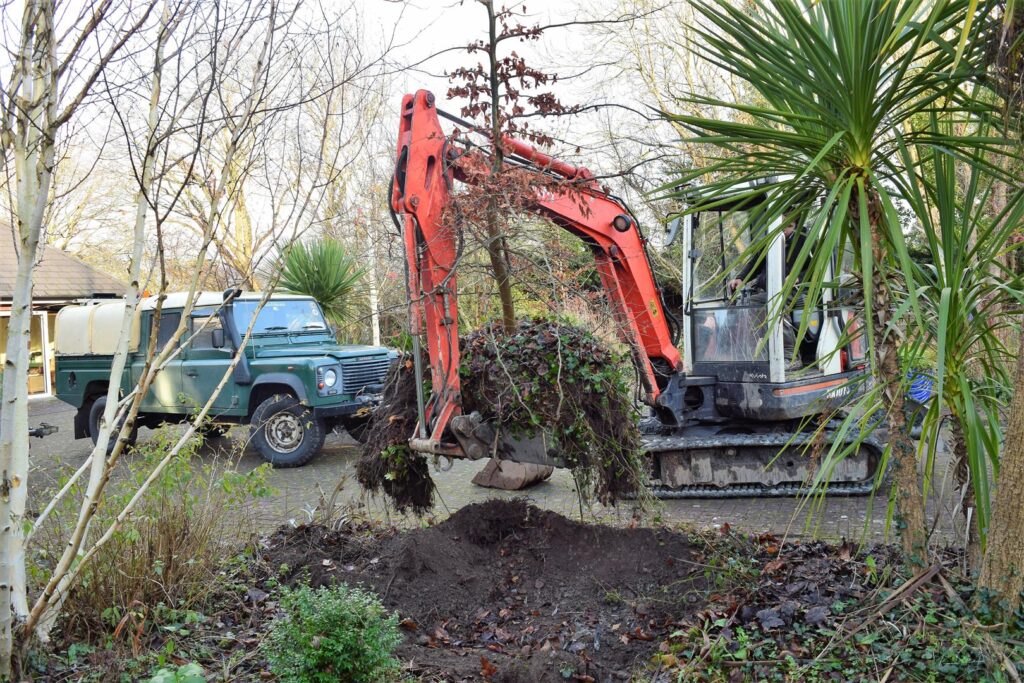
The parrotia was doing really well in it’s spot in the front garden but I always knew from planting that it would be too crowded eventually in that spot but I planted it there because it was the only space , small as it was , that was available … I knew it was better suited in the woodland garden but I also knew the deer love the parrotia and have eaten three previous specimens planted in the Lower Garden so if this one was to survive the deer it had to be in the Front Garden .
I would never have been able to dig it out by hand with enough roots intact but with the digger back in the garden to finish the regravelling of the paths , Peter Cullen was able to whip out a large root ball and replant the parrotia in an area where hopefully it will take and be able to realise it’s full potential … it will take a year or two to bed in and I will babysit it for water through the summer months although moving it as we did in the dormant season it should be fine .
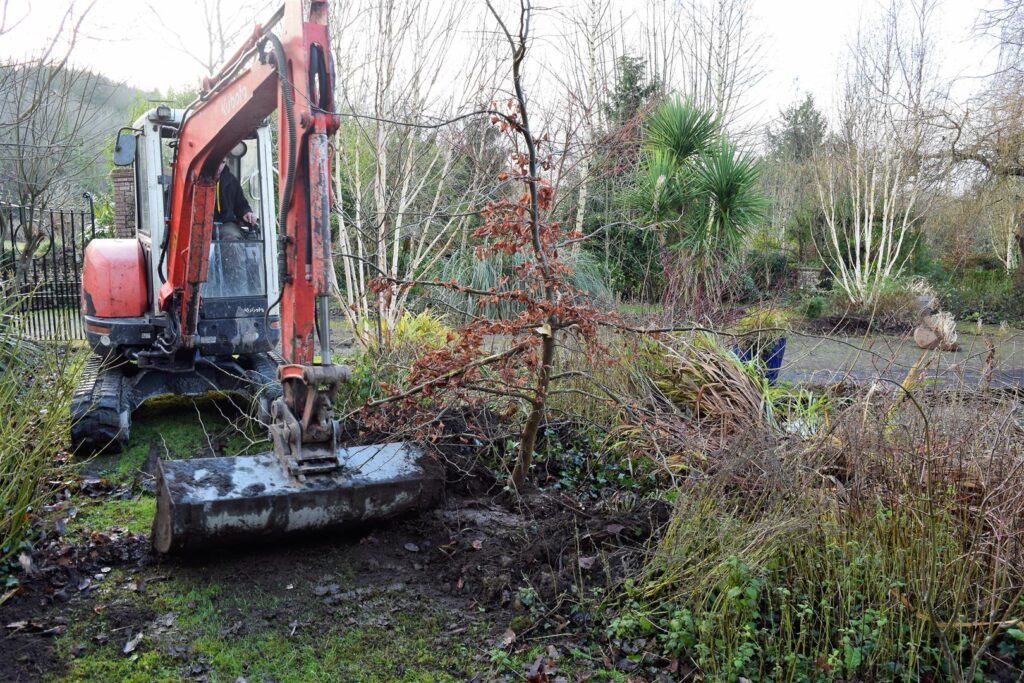
New project in the Lower Wood January 2021
I spent time in January putting some finishing touches to the edges of the water in the new pond we excavated in the woodland area , I had typed “the ” as in “ the finishing touches ” but realised I was being premature and this is just the beginning of a process that will run and run as I begin the planting up of the new area in the next few months .
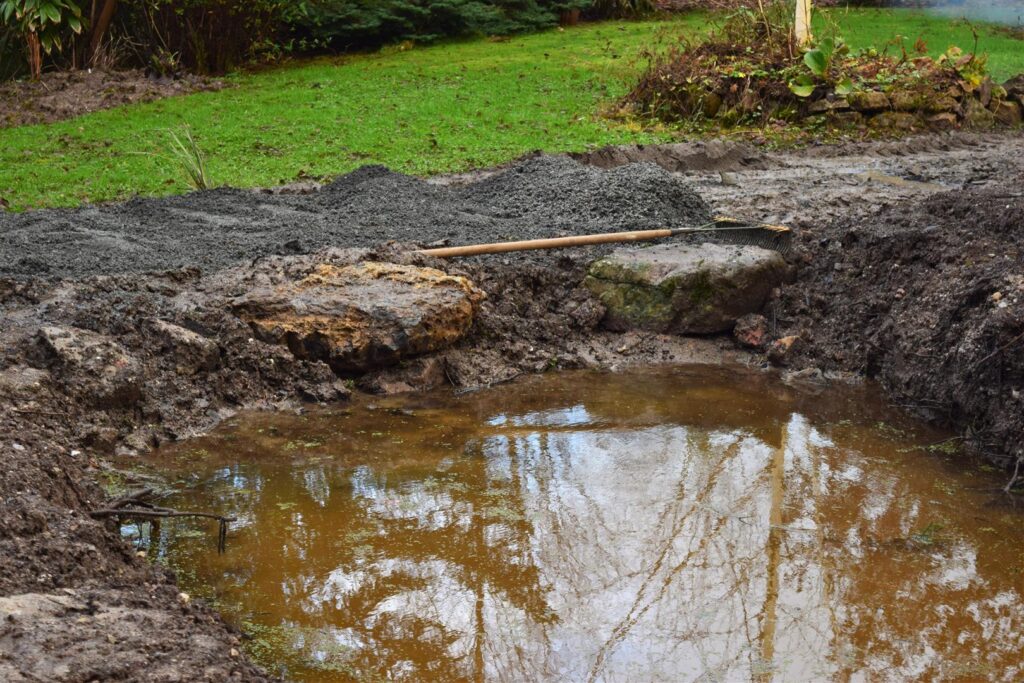
I was able to source some beautiful stone from my neighbour , Sebastian , who had saved it from the original old farm buildings on his land and I used this as the foundation build of a series of rock steps to the water ‘s edge in two areas where I have dug in some off cuts of big leaved hostas from the front garden but I won’t be adding rock plants as this style would not blend in well in a woodland setting … also rockeries are hard to keep clean from weeds and eventually smother the rocks whereas here I want these rocks to be seen .
I love working with stone and the hardest part is first assembling the amount of stone needed and laying it out … I had used the digger to lay three big rocks that were in storage here for a few months since we built the rock installation in October until I found a place for them as they were a bit rough and not good enough for that project but here they were perfect and Peter Cullen whacked two of them into place with the digger .
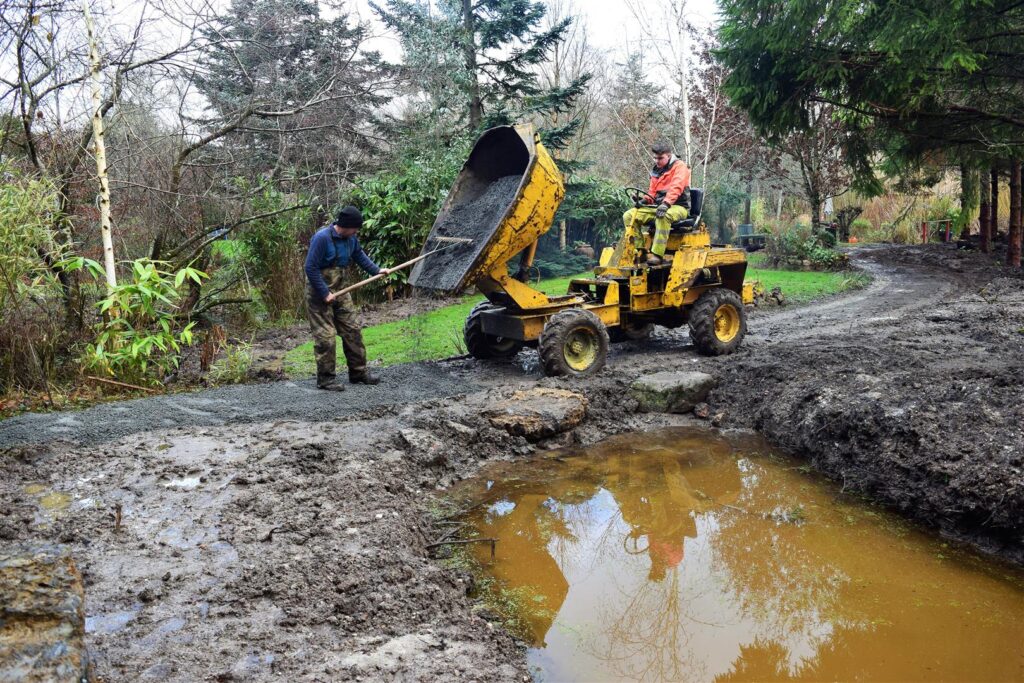
And the third one , the largest which had a nice flat surface we moved into position as a bench overlooking the new water surface . The site calls out for a seat and rather than go for the traditional wooden bench I thought the rock was pretty cool … and the cat thought so too !
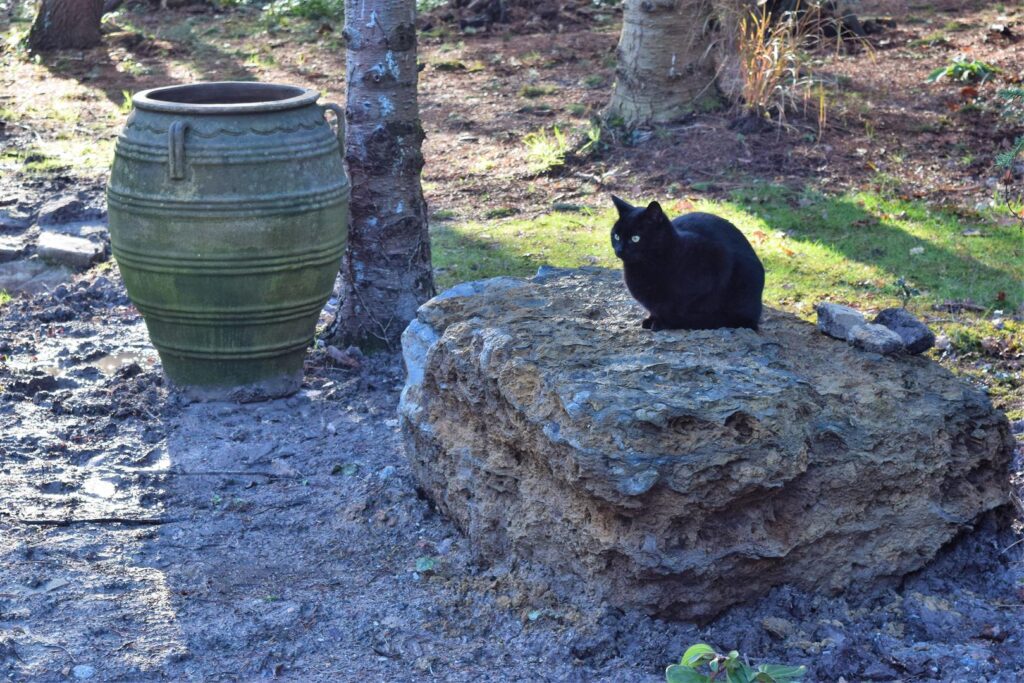
The rest of the stone was flat and normal size which I laid by hand and grouted them into place with a mix of gravel and earth .
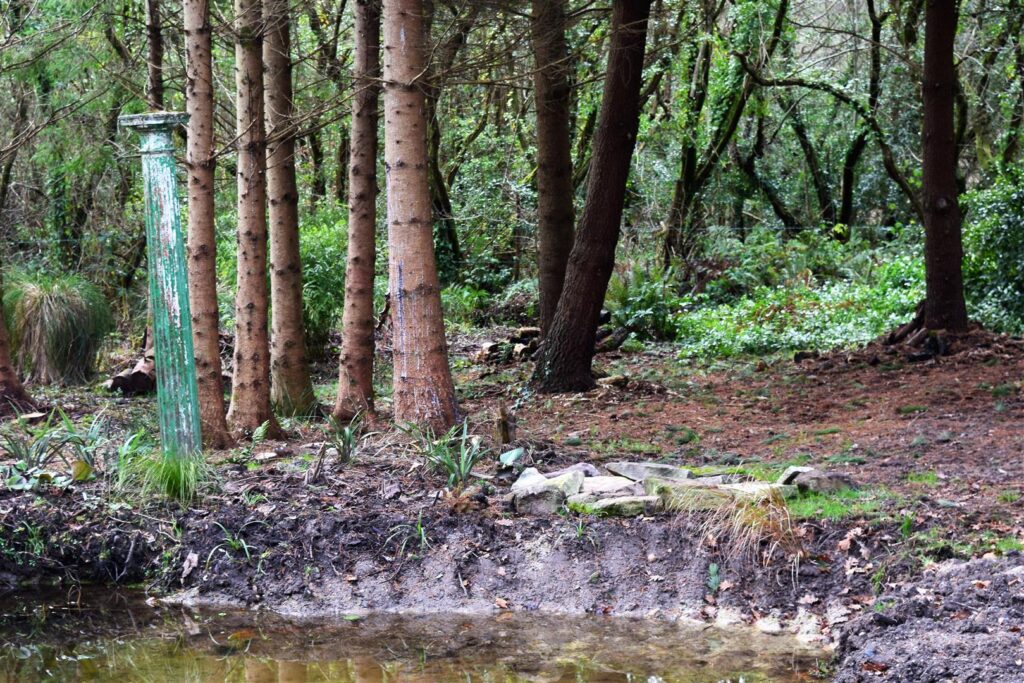
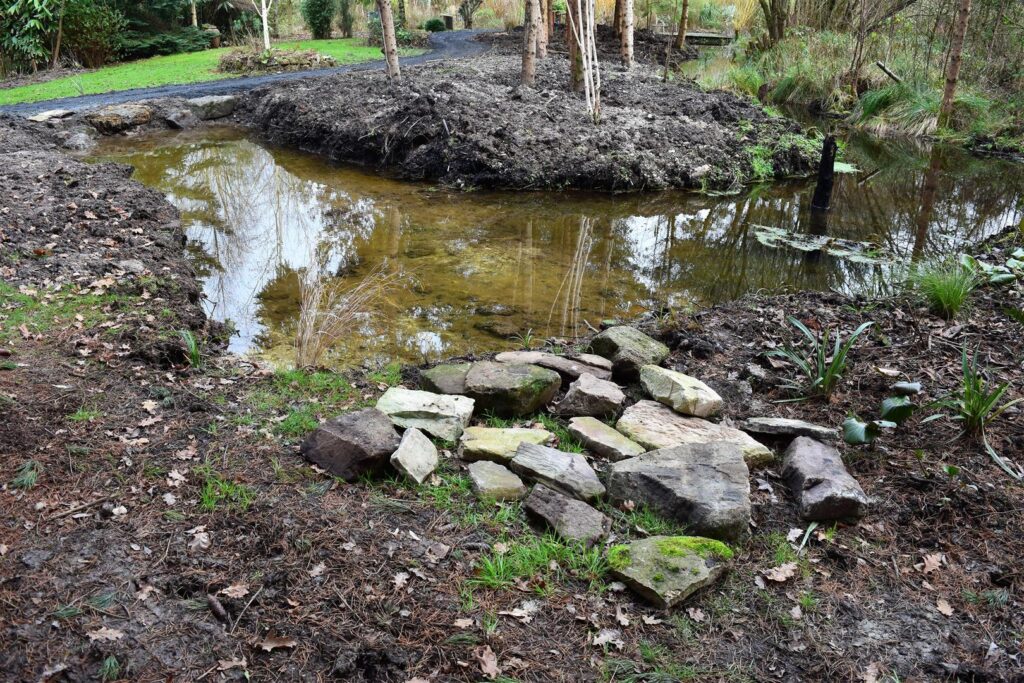
T
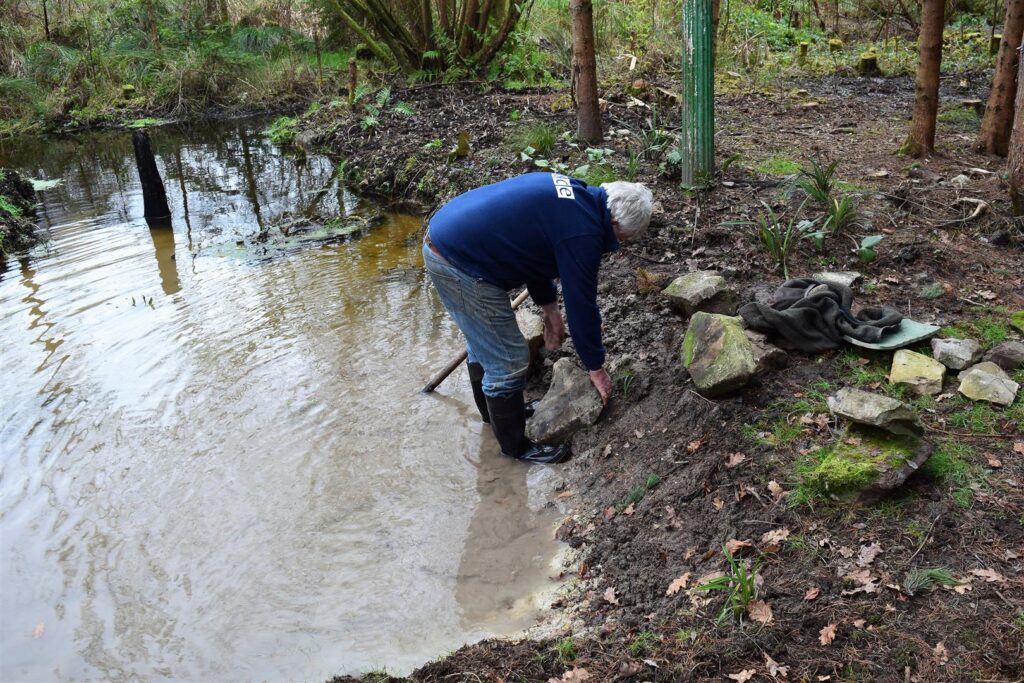
The remaining water area will be left with natural edges where nature will take over and I will add water loving plants such as hostas , iris , primulas , marsh marigold most of which will be off cuts from our own plants here . Apart from adding a nice feature I felt it was necessary to build up these two areas with stone as one area bordered the path and it was safer to outline the water’s edge as there is a drop of a metre at this point and the other area was left sloping by the digger exposing the marl clay surface which could not be planted directly into with marginal water plants so the stone was built into a straight edge which I then ramped up with normal soil for planting .
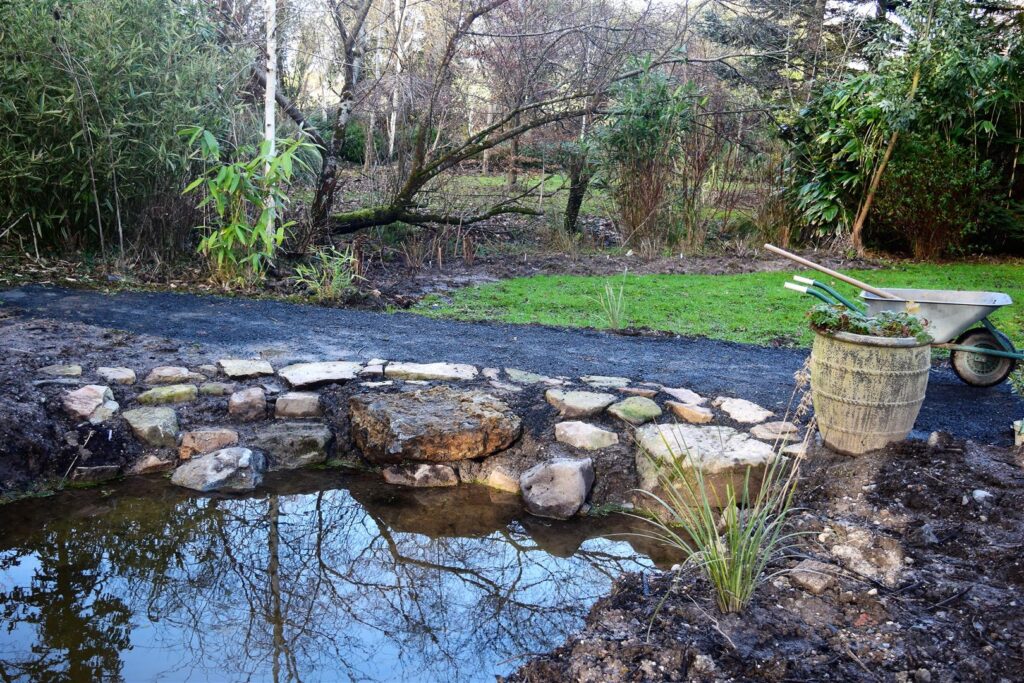
We have over the years built up a large collection of garden pots and containers and tend to go for the unusual , the larger and colourful the better and sometimes unloved eccentric pots that end up in the bargain basement in Clonmel Garden Centre find a home with us and you can check out our collection on the Petrovska Garden website at
Generally when building a new project I sometimes move pots from other parts of the garden to the new area but these are always pots that somehow haven’t clicked and these I will move but we have pieces in the garden that have never been moved from their original position as from the beginning they have made that spot their own and it would leave a gaping hole if moved . We also have pots that were bought because they were just great pots that might not be available again and while they find a nice position in the garden somehow we know that this is not their forever home and they are being parked until the right spot comes along and so far the new water area has taken three such pots !
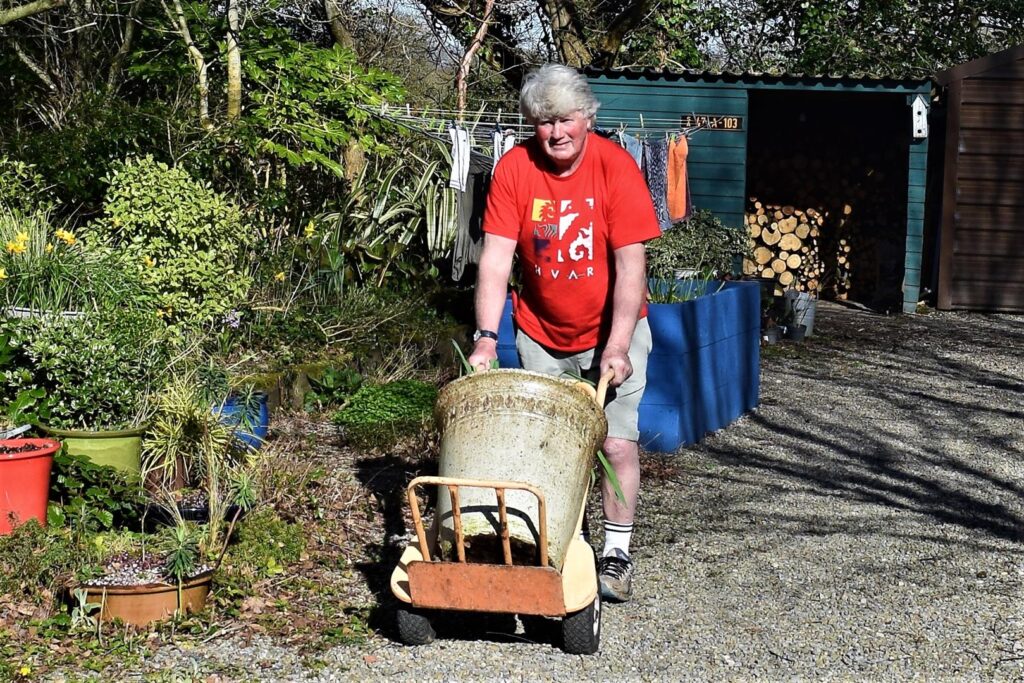
Moving large pots is tricky but apart from enhancing a new location it also serves another purpose and that is refreshing the soil in the moving process . I empty each pot before moving and then “ walk ” them to their new location , laborious true but safer that trying to lift them … I pack the bottom of each pot with rocks to help drainage and this makes them extra heavy but also means they won’t budge if given an accidental nudge … I then use the opportunity to refill each pot with a combination of new soil mixed with John Innes potting compost .

New pots are also acquired in March 2021

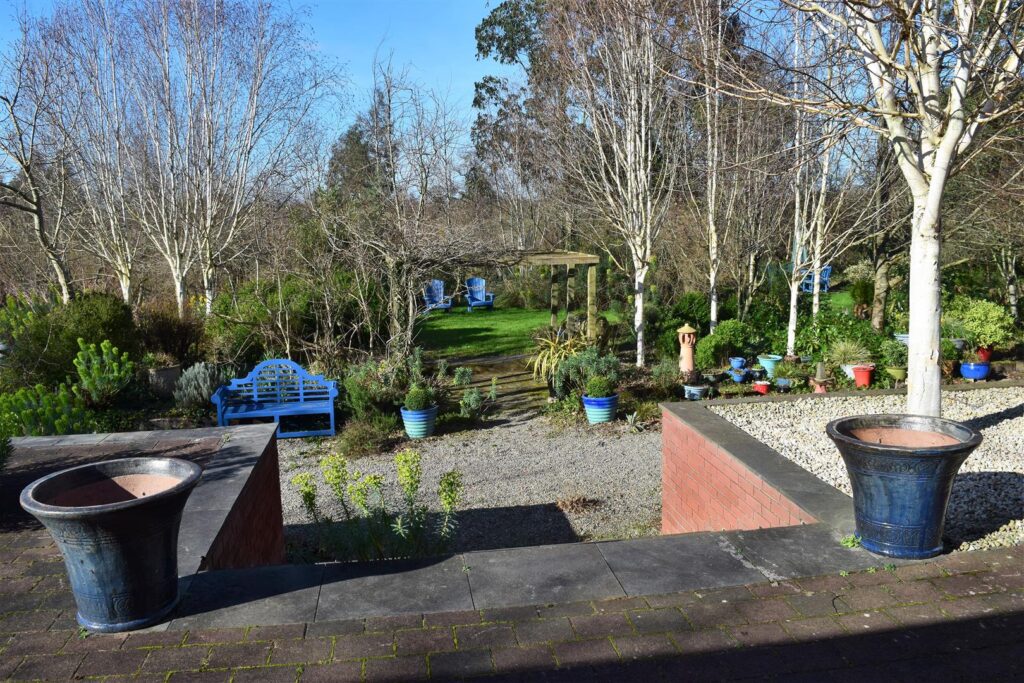
And old pots get broken ! A Hosta Elegans in the Front Garden does for it’s second pot in March having broken it first pot in December 2013 .
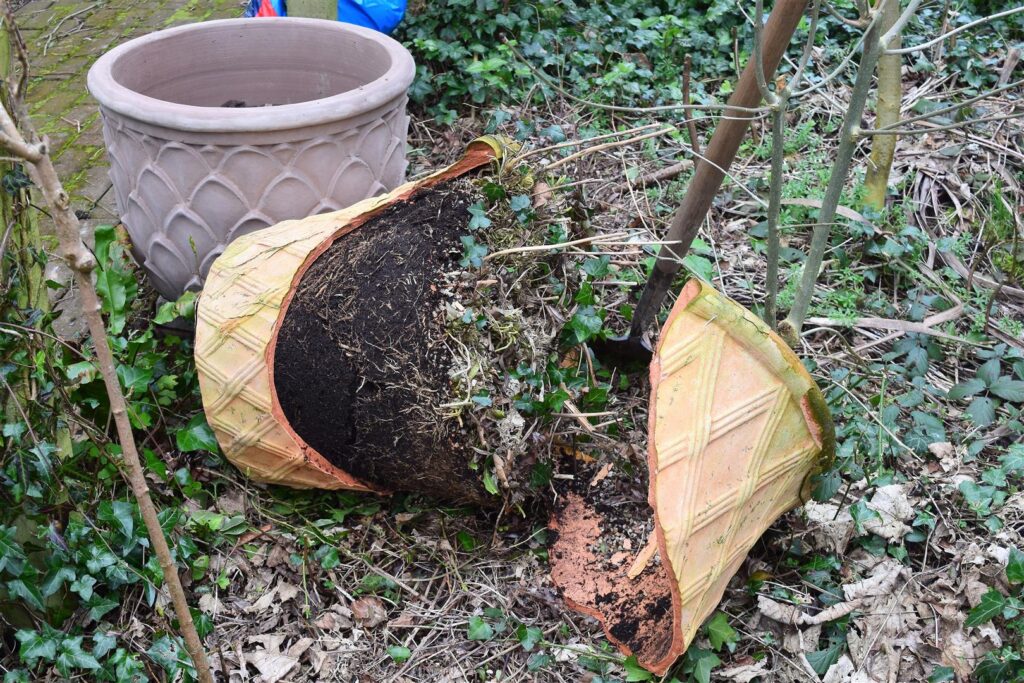
In March the design and planting of the new water area continued and I laid a path of concrete paving slabs .
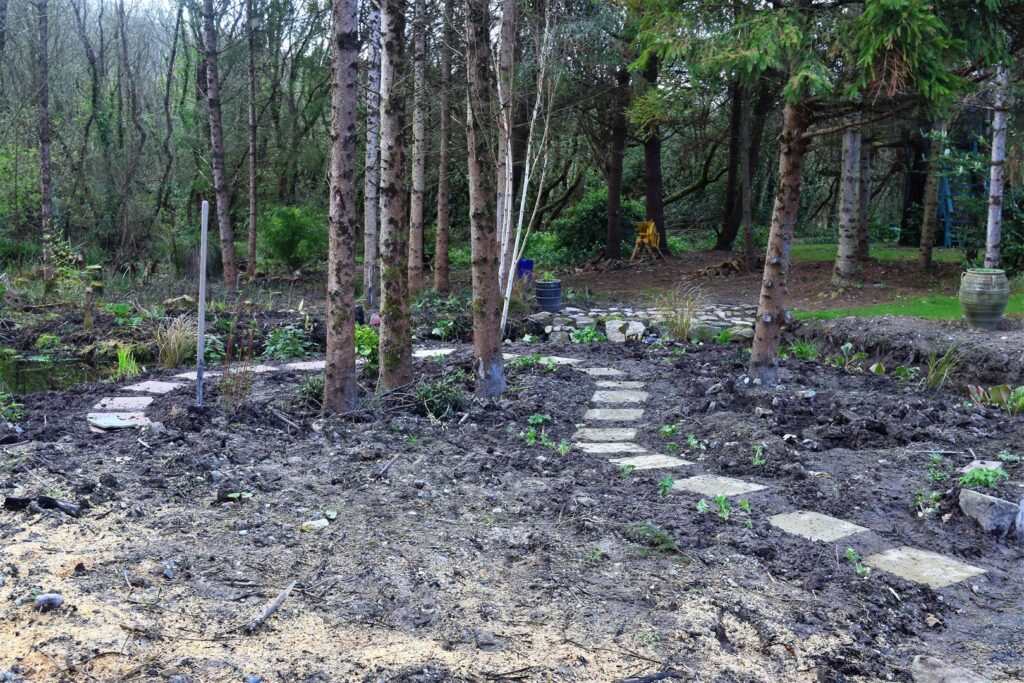
In April I spent the entire month finishising both the planting of the new water area but I also added a path the entire length of the new stream along it’s entire bank . I had never intended this path but the newly exposed bank had such a wealth of natural planting , wild grass ‘s etc. that I decided it would be a lovely walk along which I could sow marsh loving plants and ferns as the soil there is peaty and wettish . It took a week of hard slog and a lot of calusses to transport the paving slabs and lay them each by hand .
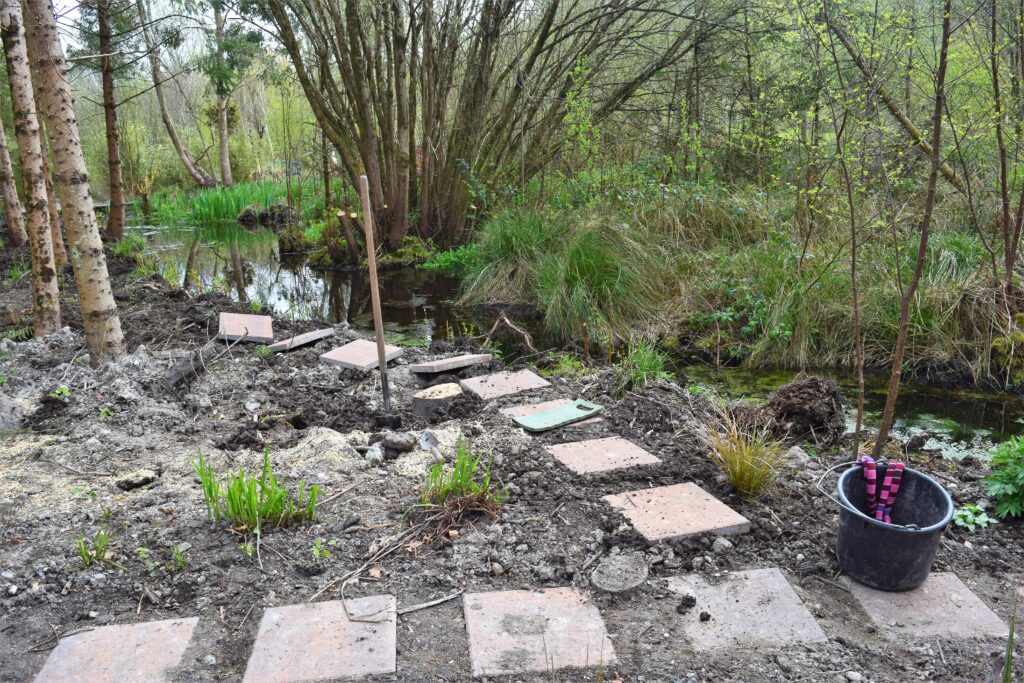

I bought in some plants mainly ferns and hostas but then took and planted from other areas of the garden literally hundreds of geraniums , lamium dead nettle and water marginals marsh marigold and houtunia and the plan is that this area should have total ground cover within a year . All the planting is low growing as I want to be able to see across it through the conifers to the water .
The new path is now part of the landscape in the Lower Wood area

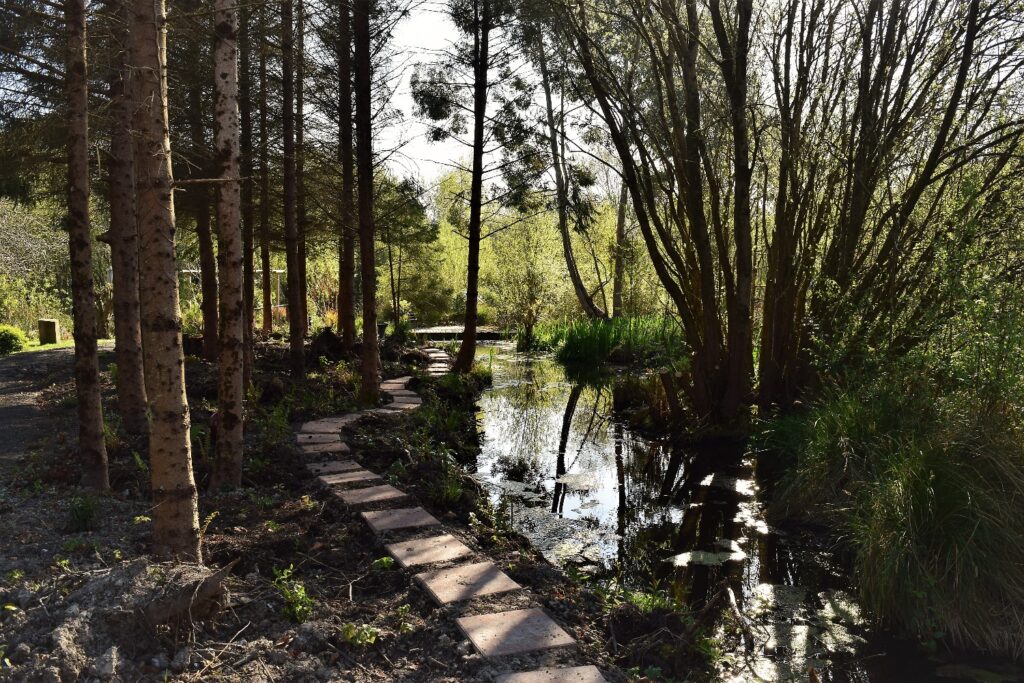
In the April blog I discussed the american skunk cabbage , americanus lysichtion .
Last month I featured the american skunk cabbage , americanus lysichiton , and as always readers commented on the dramatic colour of the flowers and while yes they are a knock out when you come on them in the garden the flowers are brittle and last only a week but the foliage following on is magnificent . They are water edge plants and in the right conditions can be invasive as for example throughout Louisiana they are considered a pest almost on the level of Japanese knotweed and have taken over huge areas of rivers and lakes . In Ireland and the UK they are a much prized perennial as when the flowers are over the American skunk cabbage grows magnificent architectural leaves almost a metre high .
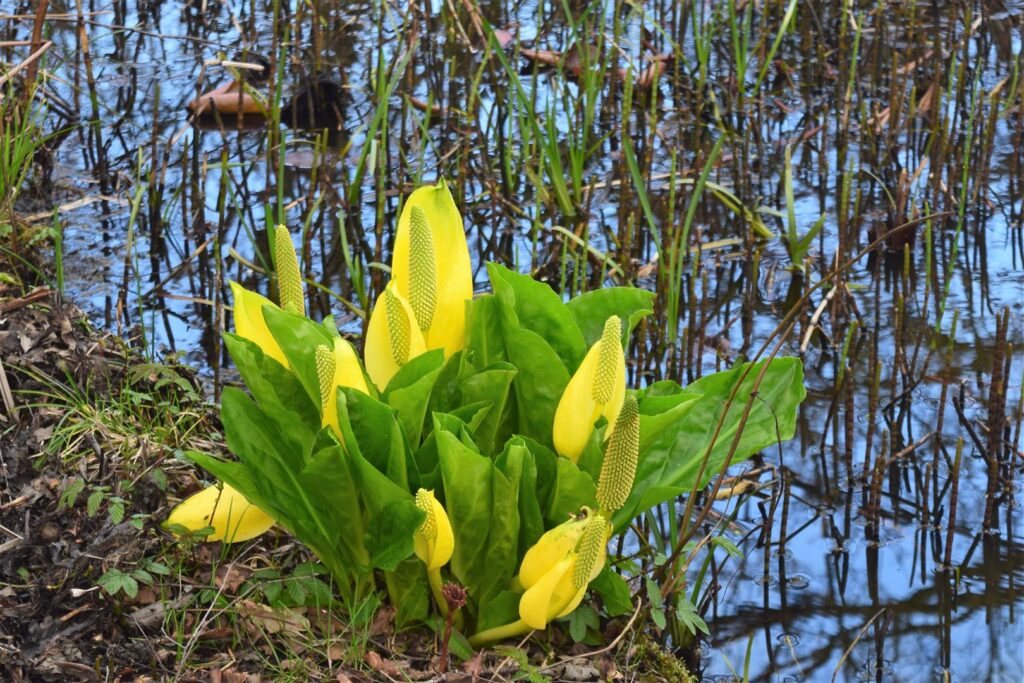
The first time I saw the skunk cabbage in a garden or even heard of them was when on a cycling trip around Southern England in 1981 I saw them in a sunken garden attached to an old manor house and as it was early in the morning around 7 am I nipped in uninvited to have a closer look … suddenly a woman’s voice from behind me said “ you like the American skunk cabbage I see ” and that dear reader was how I met Hayley Mills … in her dressing gown with a cup of coffee in her hand out for an early morning stroll around her garden ! For readers those too young to remember the early 1960’s , Hayley Mills was the biggest teenage movie star in the world at the time … she wasen’t at all fazed to meet a lycra clad male in her garden at 7 am !

It was to be another thirty years before I was able to source some American skunk cabbage for our garden here as they are as scarce as hens teeth in the garden centres … in fact the only garden centre I have seen ever stocking them is our local Clonmel Garden Centre who in recent years have about five or six for sale each spring … and you need to be quick to get them … ahead of me ! Like the gunnera the skunk cabbage likes to be close to water but not in the water and it thrives in wet moist soil but is slow to settle in after planting and takes four or five years to thrive and after that no stopping it
In April I continued on Facebook the regular photo feature of A Day in the Garden and all the photos were taken on April 28th 2921
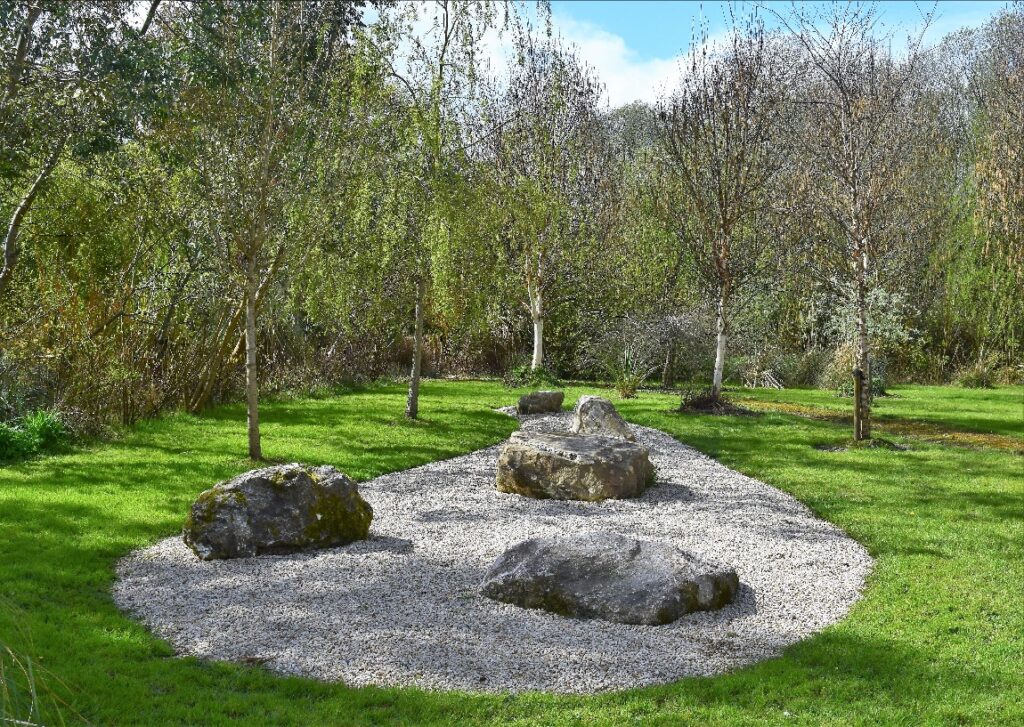
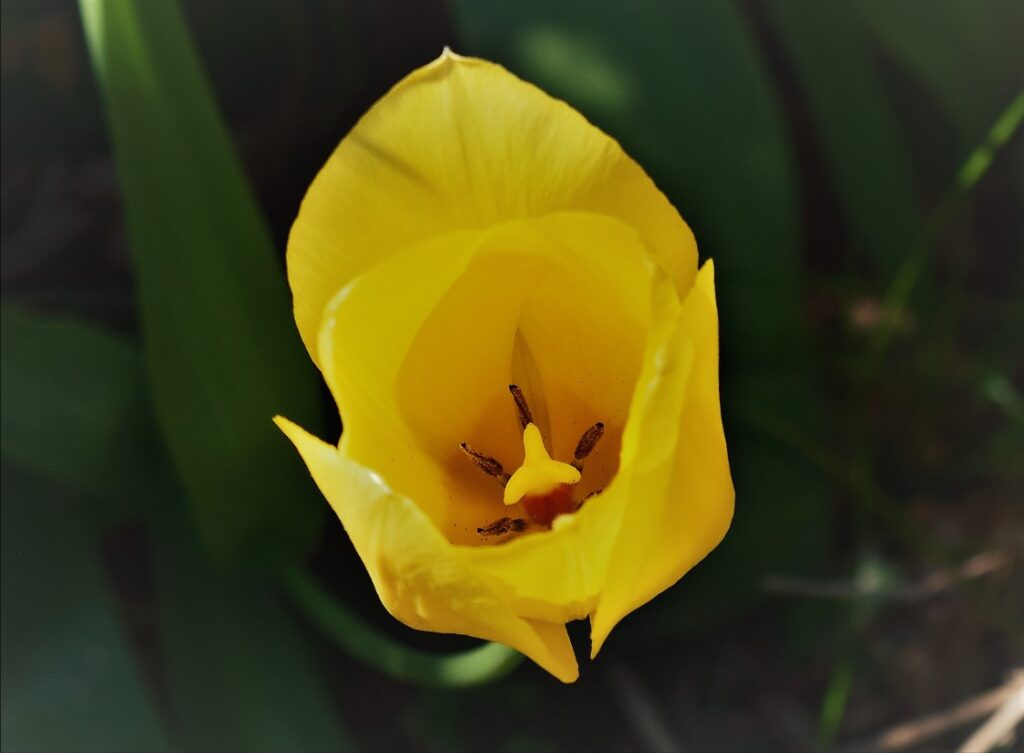
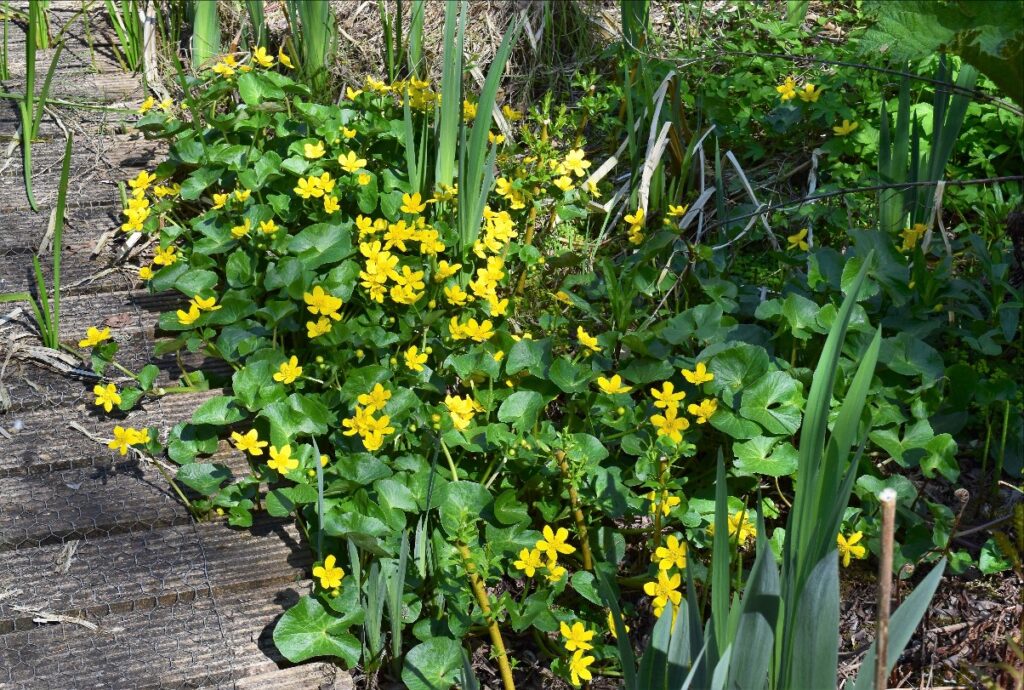
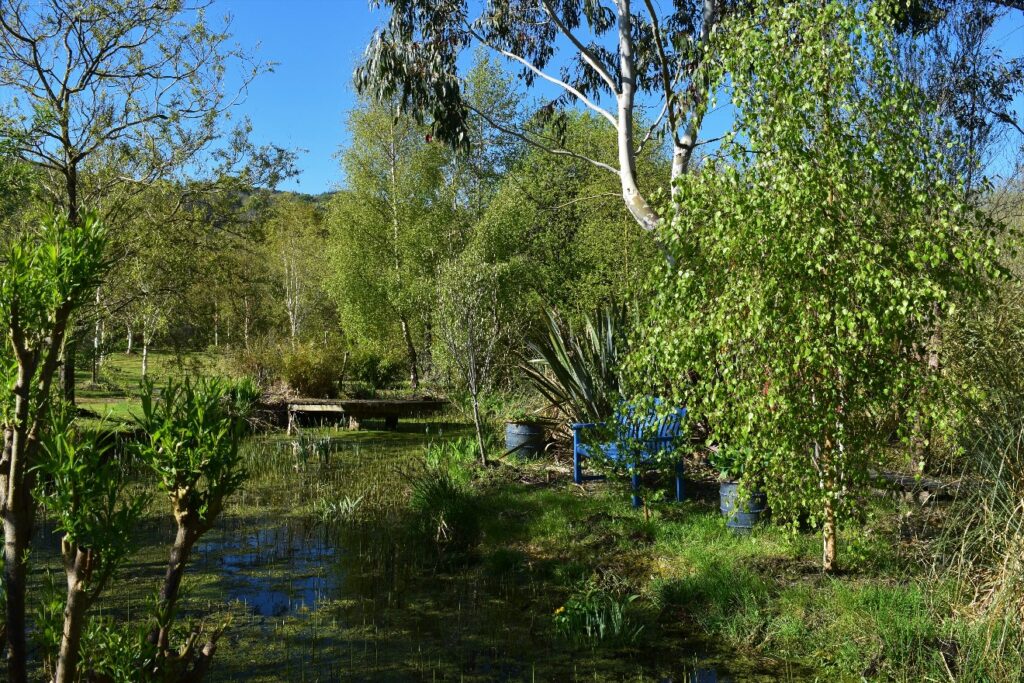
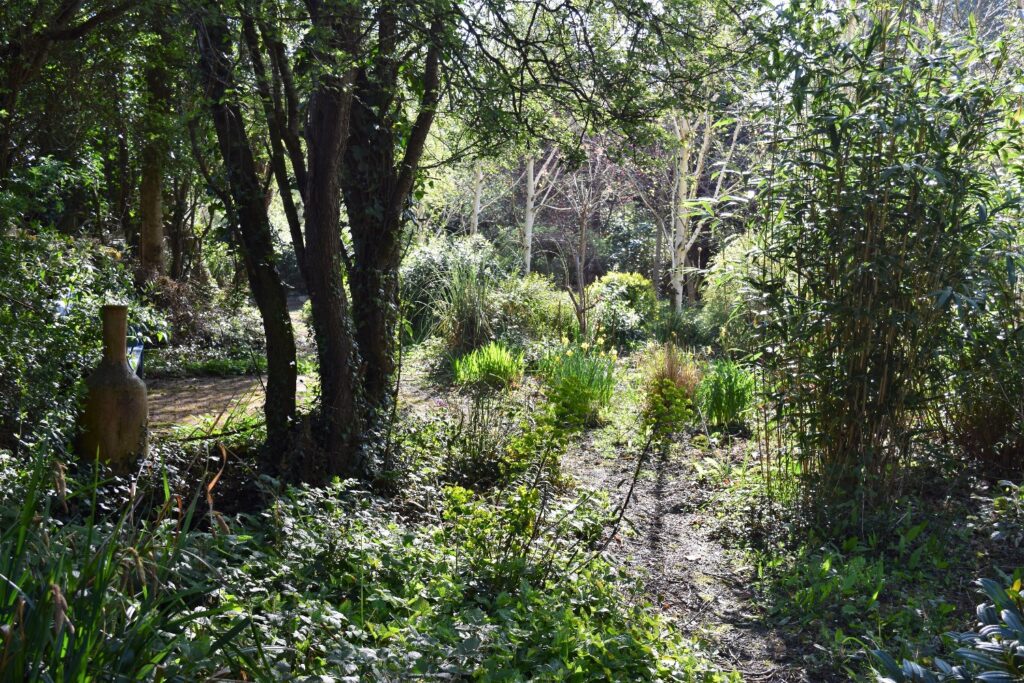
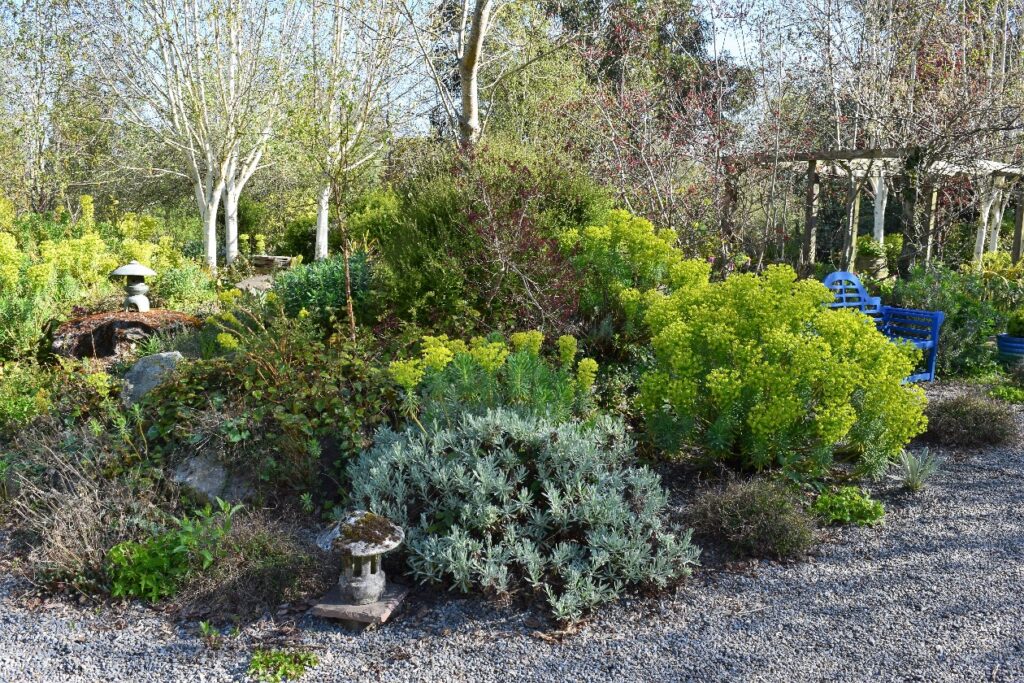
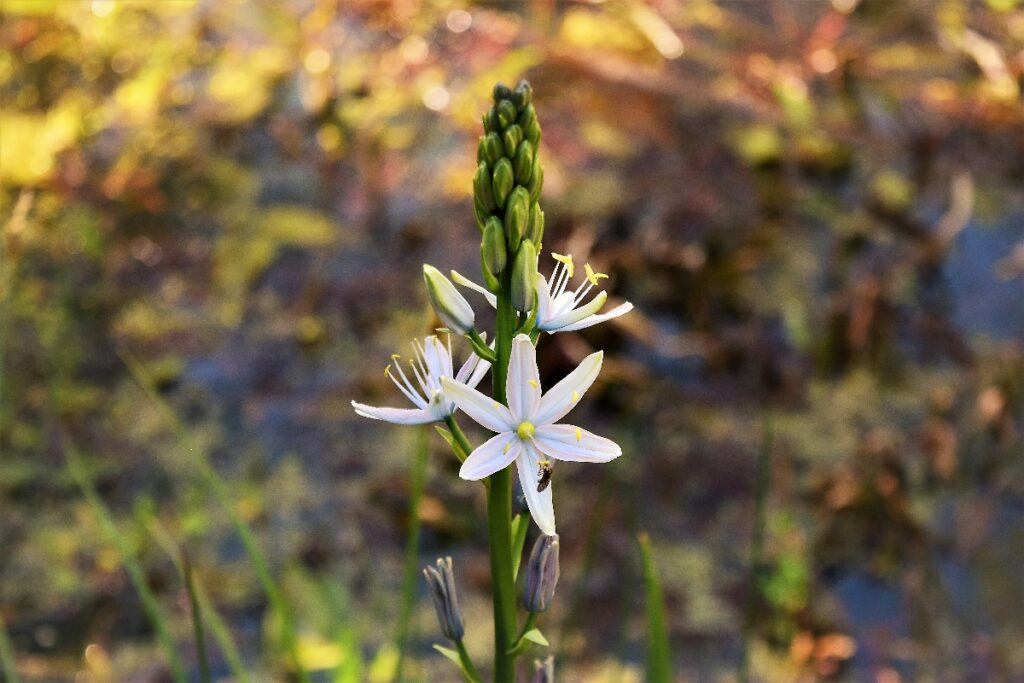
In May I wrote about the visit of my grand kids and titled the blog …. Go and Zen no More
Two of my grand kids visited last week and I brought Marko and Mile down to see my new Zen rock installation where I planned to fondly explain to the seven and ten year old the tranquility and appreciation that Zen teachings brought to that area of the garden … Zen my pretensious arse as with delighted shrieks all they saw was a bunch of old rocks to jump over !
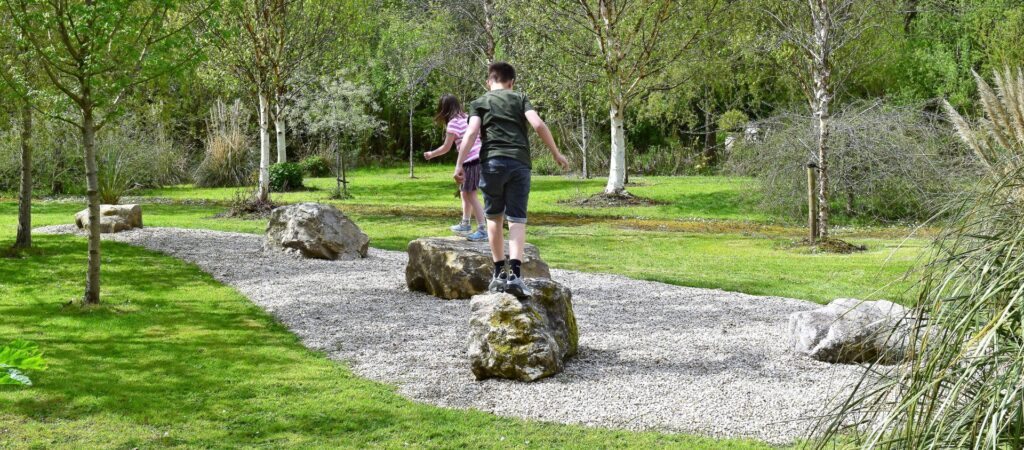

Most of our work here is maintenance be it weeding on a commercial scale , cutting back trees and shrubs or cutting grass , it is a never ending cycle all year round . In the early days here I thought I would cut the grass with a push mower as I could collect the grass clippings to use as a mulch among the shrubs and I was by now retired with lots of time available and the exercise would be good … good luck with that as with nearly eight acres and a lot of grass it took twelve hours a week to just cut the grass and apart from the exercise in walking behind the mower and emptying the grass box every 40 metres or so it was just so BORING and after five years I got a ride on mower and now ten years later it takes three to four hours to cut the grass all in one go .
However I still find grass cutting boring even from a ride on mower and I generally only cut grass for an hour at a time unless under weather pressure or garden visits when you need to have the garden looking well but there is a bonus in that sitting up on the ride on is a great way for noticing what garden jobs need doing be it weeding , pruning or cleaning out the growth along the water areas .
My take on grass is that if it is green it is grand , we are not talking pristine rolling swards of perfect wimbledon like greenery in this garden … we use a hard working grass seed mix when sowing with lawns spread in sections over almost eight acres of uneven ground . Our grass is pretty common with lots of moss , clover , daisies and buttercup and neither of us is too fussed about it but it needs to be cut every week during the growing season as with the moist soil and Irish rain , growth is luxurious … I use a mulching mower as collecting and dumping grass clippings is a pain with such a large area and adds to the cutting time but of course mulching imbeds the clippings in the ground which constantly fertilises the grass so that during June to July the growth is jumping out of the ground and the mower is in action every third day in one section or another just to keep up .
I do admire lovely lawns though whenever I come across them and I appreciate the work that goes into keeping them like that with regular feeding , scarifying and top dressing the grass with peat in Spring , sowing with the finest quality grass seed and declaring total war on every weed or daisy but we would need regular help here to do that and I have enough on my plate keeping an eye on the other gardener here and stopping her going feral with the chain saw !
The current trend in gardening these days is NOT to mow grass at all and to allow it to grow wild and the statistics are amazing in Ireland and the UK as to just how much wild flower meadows could be created annually by not cutting the lawns in front gardens as 97 % of wild flower meadows have been lost since the Second World War . I was never a fan of leaving lawns uncut however this past year of lock down I am shifting to the view that just cutting a two metre path and leaving the rest go wild can look really good … mind you I am not about to do it here apart from a small patch in the lower field but definitely not ruling it out in the future .

For the past few months I have been including diary excerpts from my fifteen year period as an EU customs advisor in the Balkans so for a change this month I am highlighting my time as a customs officer in Ireland .
Back in 1993 I wrote a series of articles for the Irish Custom Journal titled “ My early life in Customs ” where I looked back at incidents and the various characters met during an almost thirty year career with the Irish Revenue Commissioners and where when first published I learned that some people as they grow older and more dignified can lose their sense of humour ! One of the stories that didn’t make it into the articles was about the time I was being trained in mobile border enforcement … and there could not have been a more dangerous place to learn about anti smuggling than during the Troubles in Northern Ireland in the late 1960’s .
We were an eight man patrol team at 2 am one February waiting on the Monaghan / Fermanagh border near Crossmaglen for a pig smuggling gang to try and jump across the border into the South , the information was good and all we had to do was be in position with two patrol cars just down the hill on the unapproved road where the pig lorry would arrive .
As the junior member of the team nobody had told me that one officer in uniform armed with a torch and a walkie talkie would have to stand alone just at the border line a half a mile away from the rest of the teams as legally the smuggler had to be given an opportunity to declare the consignment and my instructions were when I saw a truck heading up the hill from the northern side of the border I was to step into the middle of the road and signal with the torch and of course that would be a signal for the smuggler to accelerate and drive at me … THEY NEVER STOP at which point all revenue legalities observed I would step back and let him pass and I would then immediately call the teams below on the radio and they would form a road block with the cars , stop the lorry , seize the consignment , job done , easy peasy or so as it was told to me .
I was up there on my own in total bandit country for almost an hour , freezing February conditions and of course no other soul on the unapproved road when the call came through on the radio to come down , nothing was moving that night when just then to my horror I saw truck lights racing towards me from the Crossmaglen side so I flick on my light and wave gently at the truck and stepped back waiting for him to race past .
To my horror the lorry stopped about ten metres down the road and then reversed back to me and as the drivers window wound down I saw four armed bearded desperados regarding me with great interest … where are you from says desperado No. 1 … Tipp – Tipp – Tipperary I managed to get out … and what the fuck are you doing out here at 3 in the morning … my stammer got worse but I managed to croak out you were not supposed to stop … so here is what you are going to do he says , you are going to throw that radio as far across the field as you can and then you are to make your way slowly back to the customs cars and if there is as much as a peep out of you we will be back … the lorry sped off down the hill and drove at 90 miles an hour past our guys who were sipping coffee inside the cars dumbfounded … nothing very much was said in the patrol car on the way back to the station and it was just my luck that I met the only inquisitive smuggler in Northern Ireland !
Thankfully as a career civil servant I spent most of my Irish Customs time away from the border area and desperados but then almost thirty years later far from the Femanagh border in 1993 I spent a period with the Dutch Customs Service on secondment from Irish Customs when I served on the Dutch Customs patrol boat , the Alexander Gogel . The Dutch officers were armed and after a weapons training course I was issued a weber hand gun and found myself at 2 am that September as part of a five man team legs astride on what looked like a banana boat as tail end charlie each holding on to the guy in front when we boarded a suspected drug smuggling ship in the North Sea off Harlingen . We climbed on deck with a rope ladder thrown on board by the Team Leader to be greeted by an eerie silence and weapons drawn the team prepared to go downstairs while I was detailed to guard the top of the stairs , gun drawn with instructions that if shooting broke out downstairs and if anyone not a member of our team came up the stairs ” shoot him ” .
Again when being seconded no one had told me (a) that I would be carrying a weapon and (b) I might have to shoot someone …. happilly the drug smugglers surrendered without any resistance and soon I was on my way with the team back to the customs mother ship !
An Irish Customs Officer in Holland September 1993

From a Walk in the Garden 21st May 2021
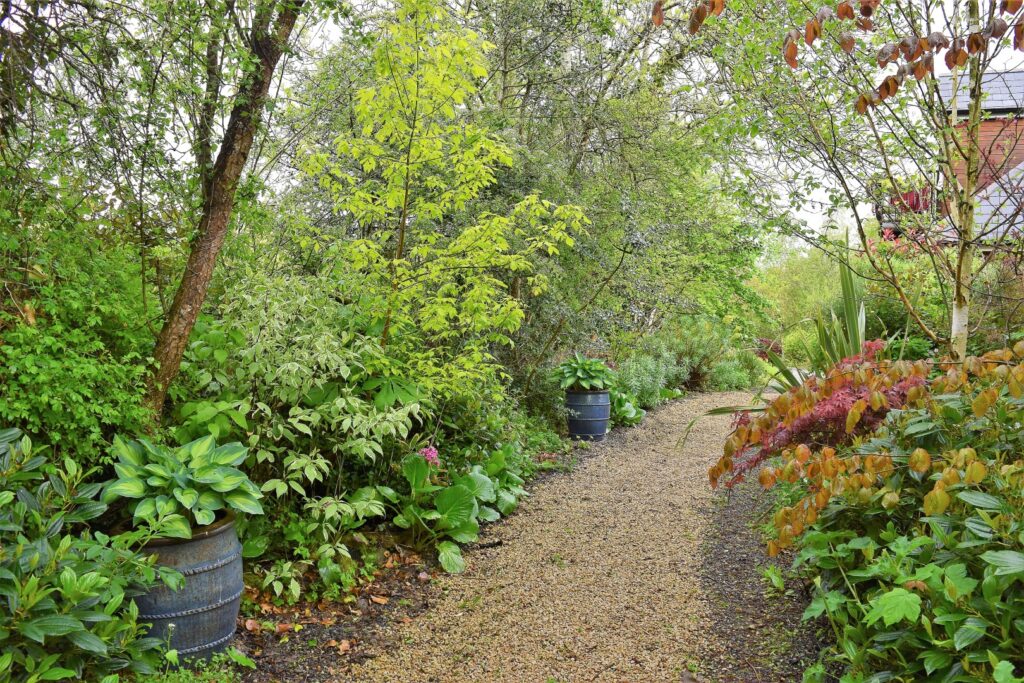
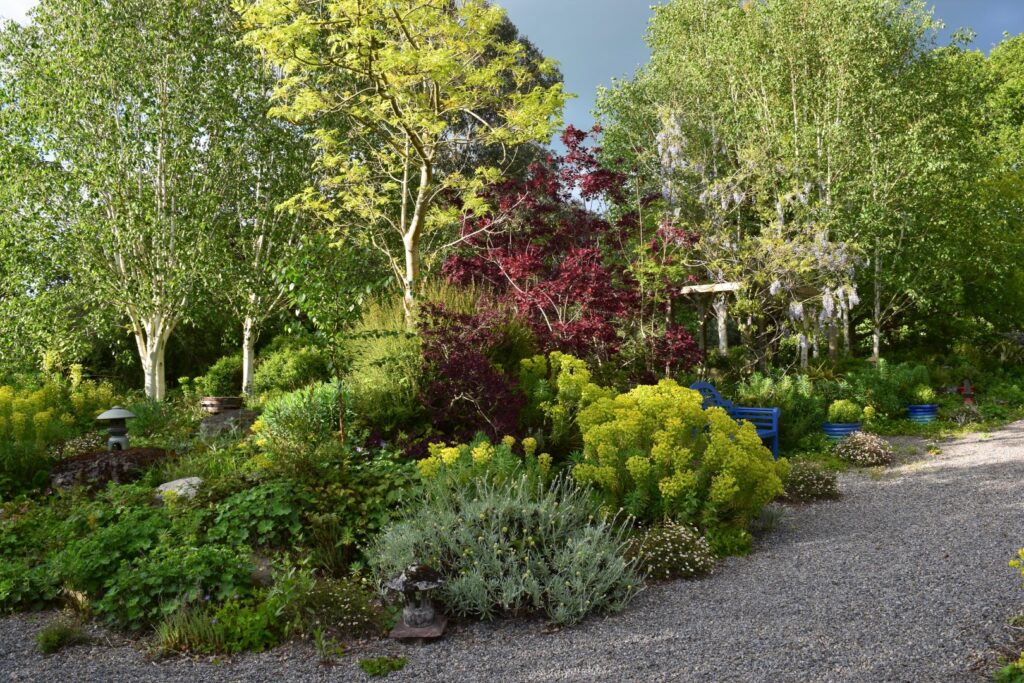
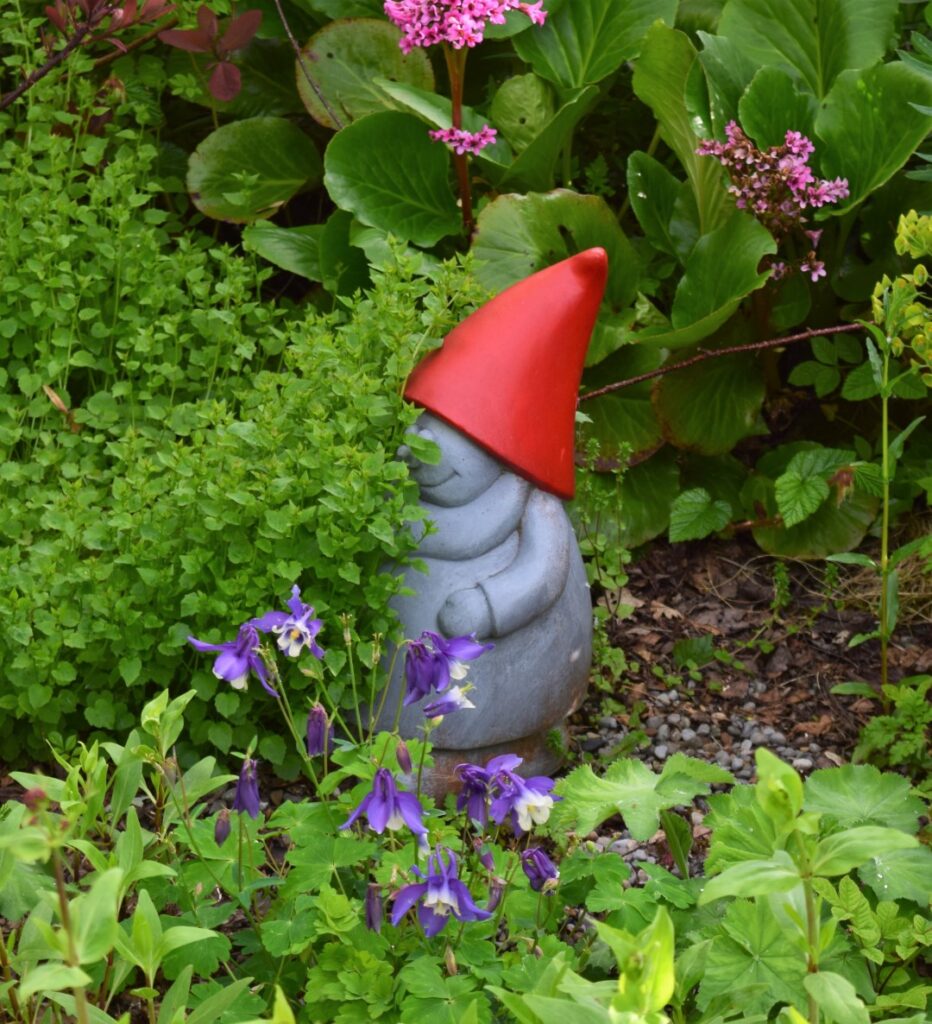
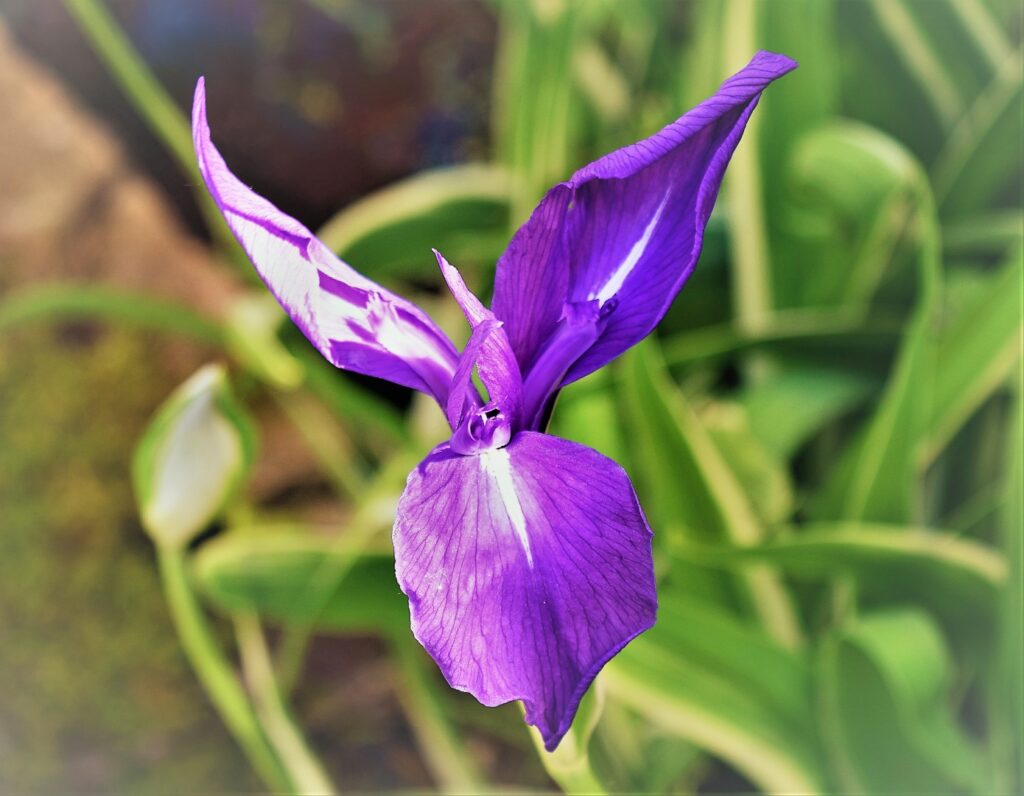
I grow several of what would be classed as weeds , well grow is the wrong word as I just leave them untouched where they grow such as hogsweed and the giant hogsweed , not a pretty name for sure and there is a problem with blisters on the skin if you cut it in bloom however they are spectacular architectural plants . The common hogsweed has great sprays of white flowers whereas the giant variety is rare but I got a seedling from a friend which has thrived in our wet conditions here . Easily controlled in early Spring and if you can get over the fact that you are encouraging a weed hated by some people , it is magnificent and jaw dropping when you come across it in the garden at two metres in height with metre wide leaves . I also let clumps of nettles grow in selected spots which also look great if you can get over the fact that most people hate them because of their sting but butterflies love them and they make a great soup … also a great foliar plant fertiliser which you make by filling a bucket with chopped up nettles covered with water that you leave for eight weeks and then drain off the liquid into bottles which you can then use diluted on your plants by adding a cap full to a litre of water , if dedicated to making foliar fertiliser comfrey is the best plant to use but nettles are easier to come by .

In gardening as in life don’t be ruled by convention and if you like the look of a so called weed then go for it and I often think that if people from a country that doesen’t have nettles or docks as a species saw both they would think that they are wonderful structural plants and they are … although I draw the line at allowing docks to flourish in our garden but still they are a great plant to look at if we could only get it out of our DNA that they are a spreading plague if uncontrolled with seeds that can remain dormant in the ground for up to eighty years .
We visited the Aran Islands in June for a three day walking trip around Inismore , a memorable visit with hand knitted aran jumpers and a visit to the 3000 year old Bronze Age Fort of Dun Aengus thrown in !

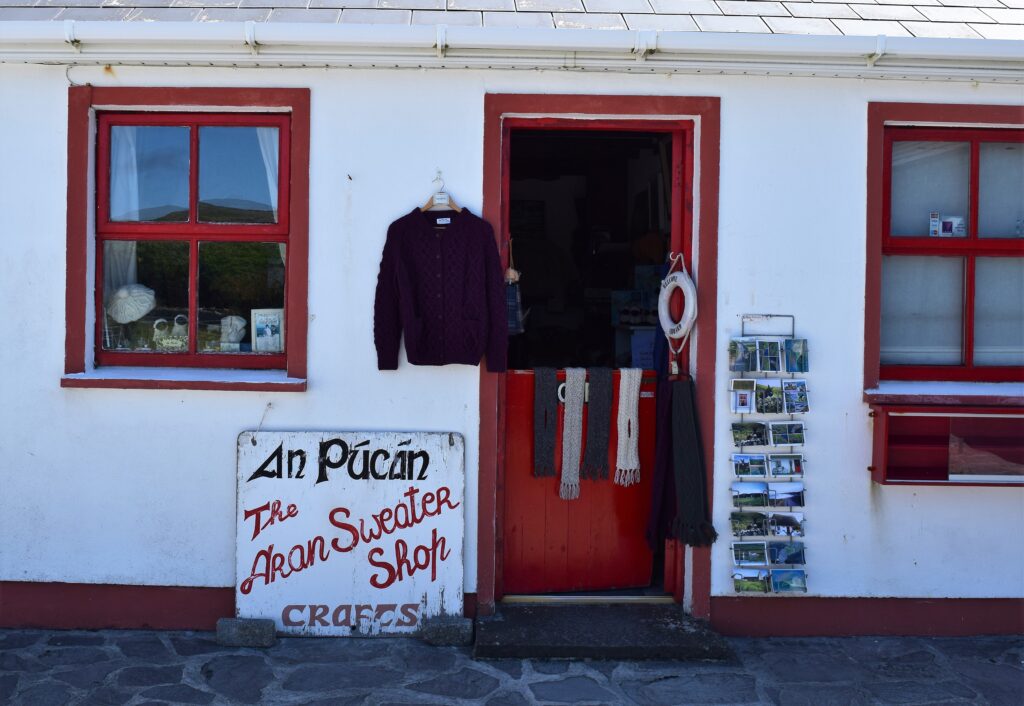
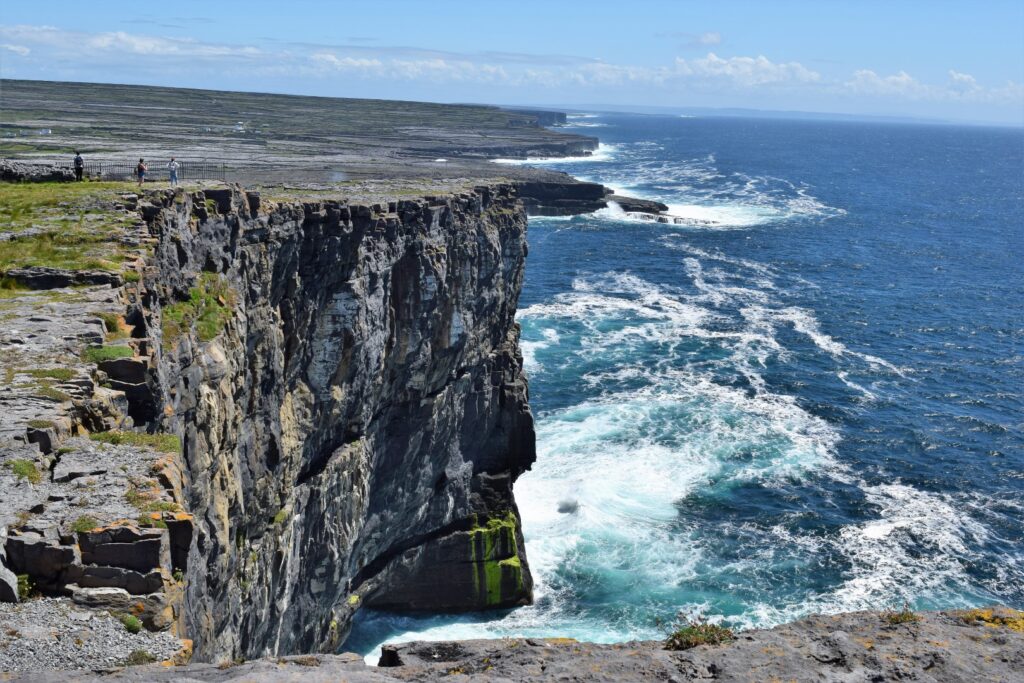
In June with a good weather forecast we took a three day walking trip to the Aran Islands … to Inismore , the largest and most interesting of the islands which is 22 miles off the Galway coast and a ninety minute ferry trip from Doolin in Co.Clare . There is no car ferry to the Islands so transport around is by foot or bicycle , it is a unique landscape of stone and next stop is America ! It goes without saying that you need good weather as the Atlantic winds and driving rain are pretty constant all year round and luckily we caught a break for our three days .
Hardly anybody farms on Inismore these days and the fields which were once cleared by hand in the old days with blood sweat and tears are now empty , the big industry is from tourism with the famous Aran sweater the best seller although hand knits are now scarce as machine knit has taken over as young “wans ” these days are too busy with their social media to learn or have the patience to knit … I was given the name of a little shop in Kilmurvey where one might source a hand knit and as we walked in the lady was knitting away and Snezana walked out happy with a beautiful aran sweater just finished a few days previously .
The Aran island experience is the best of Ireland and remains unchanged through the thirty years since my last trip in 1992 when I cycled around Inismore and then as now the main tourist site is Dun Aengus Fort which dates from 1100 BC . Dun Aengus takes your breath away sitting on the highest point on Inismore from where it dominates the whole area for miles around , without doubt a royal residence and built right out to the edge of 500 feet cliffs it is awesome .
No trees on Inismore as you can imagine with the Atlantic gales they get coupled with the complete lack of any depth of top soil over the fields of stone but plenty of stone walls and I only saw one garden which was half way decent , no beds of perennials or tender japanese maples on the Aran Islands and the only trees I saw were a few scraggy sycamores .
The Aran Islands are remote now but one hundred years ago in December 1920 they were even more remote however that did not spare them from the Black & Tan atrocities when a British naval boat put a platoon of them on the island to search for IRA volunteers … this poor man , Laurence McDonagh, was shot dead as he tried to escape on foot across the fields.
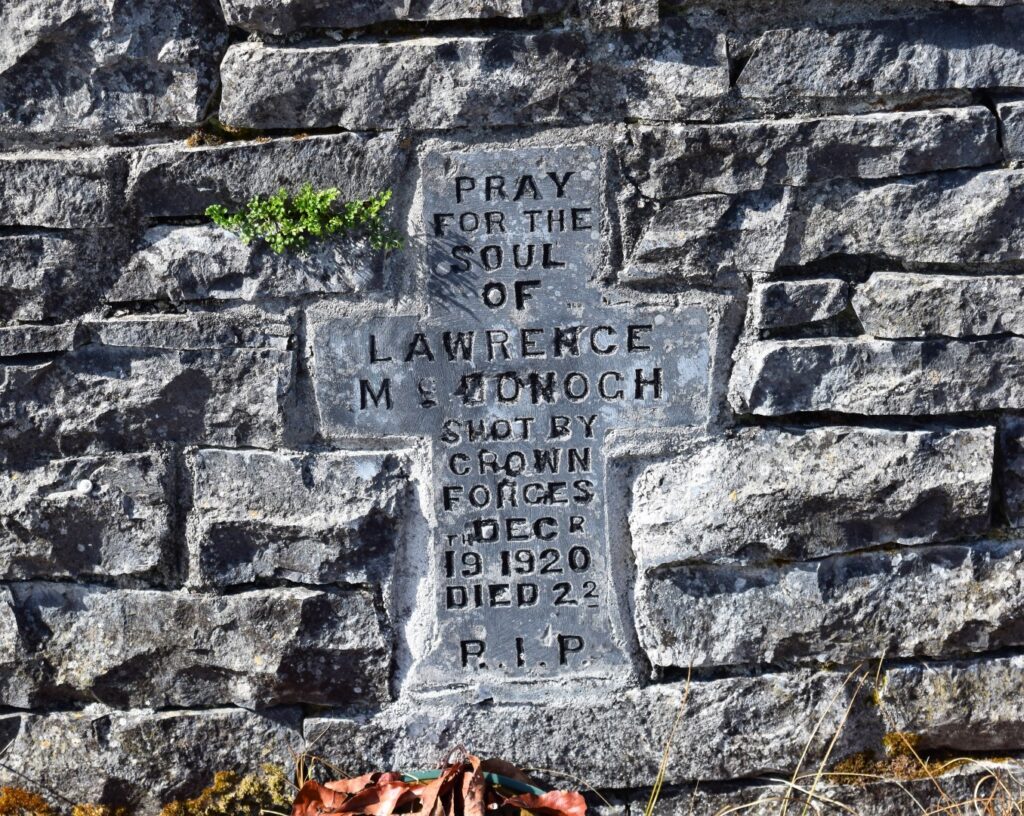
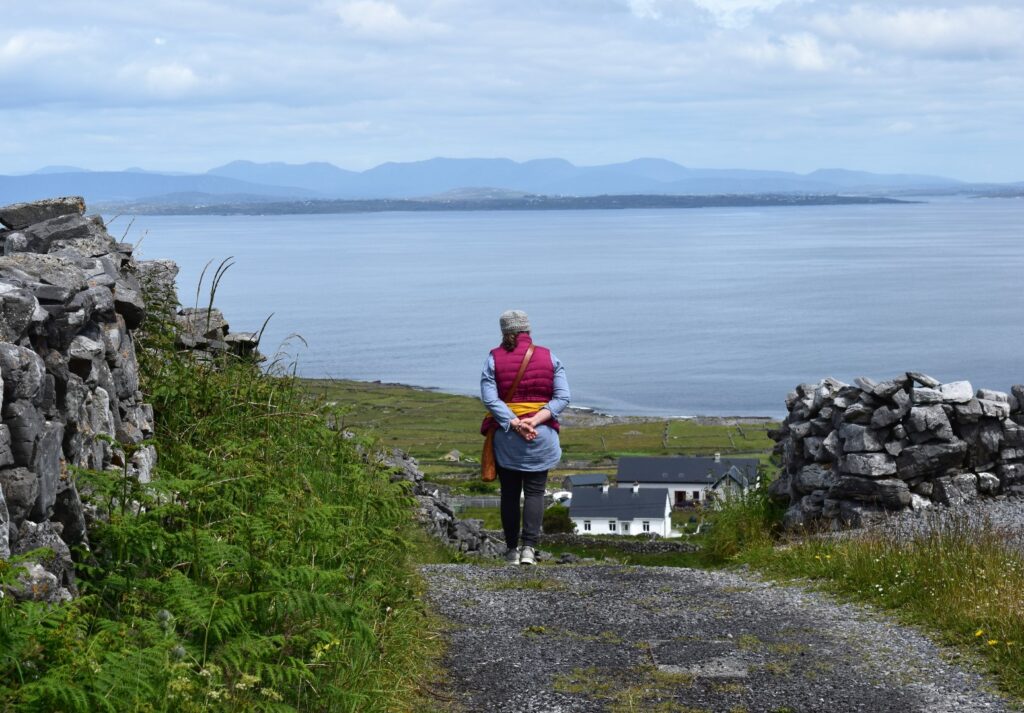
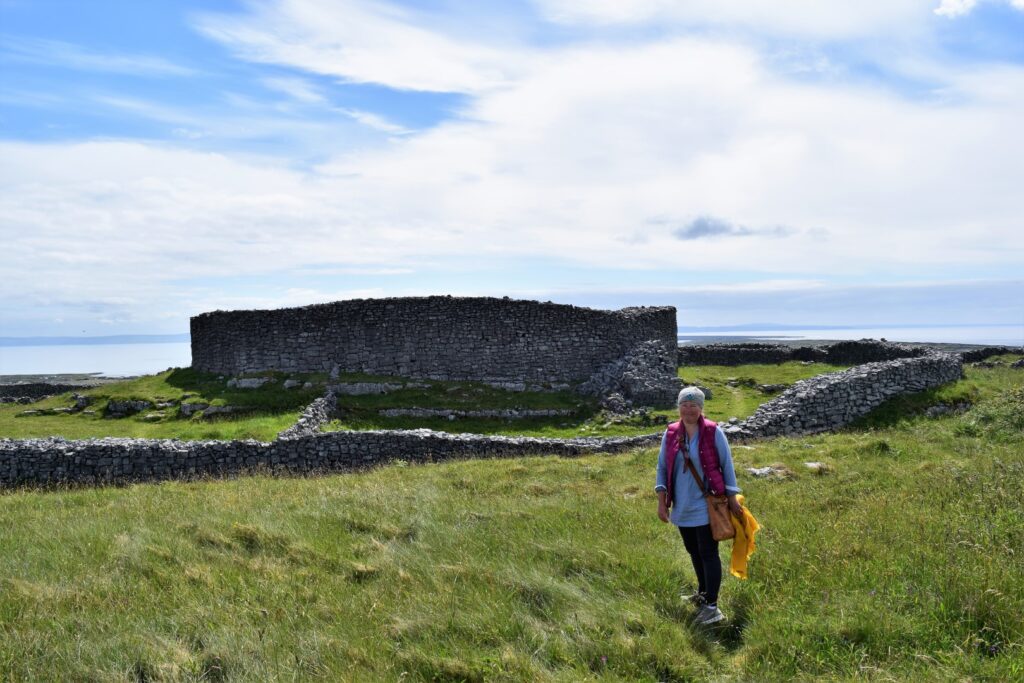
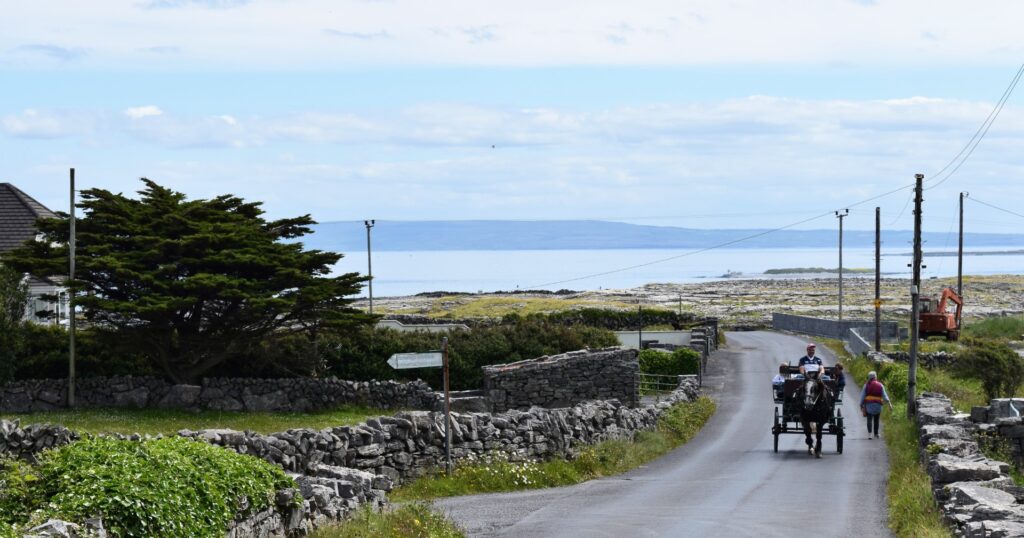
And yes some Aran Sweaters were purchased !
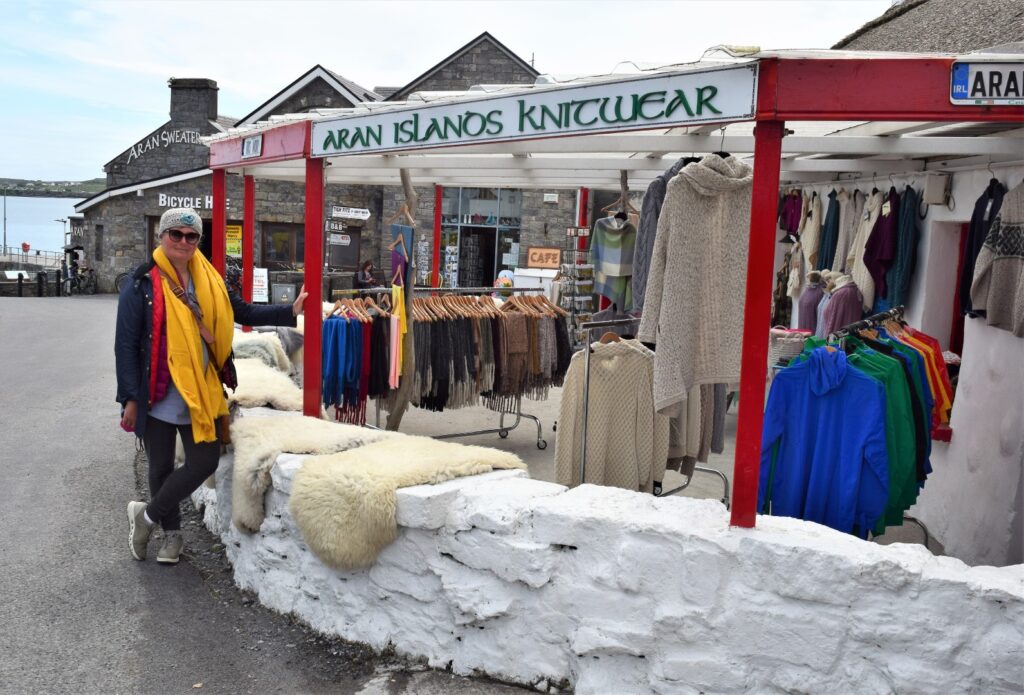
In the June Blog I had a rant about the deer and what they do to the garden
My Gardening Month June 2021… Deer Deer and more f..king deer !
They are everywhere , coming down from the hilly terrain where there is plenty of open fields with cover for them to sleep up in during the day . At first of course we thought it was quaint and absolutely lovely to look out the window and see lots of bambi looking in at us but as soon as we started planting trees and shrubs the deer quickly became a pest as they ate their way through a lot of what we planted . Over the years we have lost thousands of euros to the deer who rip out branches , break young trees in half and eat all soft plants such as hostas and it is heart breaking to come out as I did last month to see three pots of hostas eaten to the ground .
We have had hunters in several times who would stake out the land and shoot deer throughout the season but each time we couldn’t go through with it as we agreed this has been THEIR territory for thousands of years and we are the intruders so learn to live with it .
And learn to live with deer we have , locking the front gate each night , installing light sensors around the house and keeping hostas and any maple planting in the front garden and our presence and the lights at night generally keep them away from the immediate front and back gardens . Also we have learned painfully what trees and shrubs the deer go after and generally what they leave alone such as silver birch , oak , mountain ash but anything exotic like maple or parrotia trees are catnip to deer . I say “ generally ” but they sometimes break these rules and I have found newly planted silver birch ravaged and the odd chunk of oak or ash ripped out .
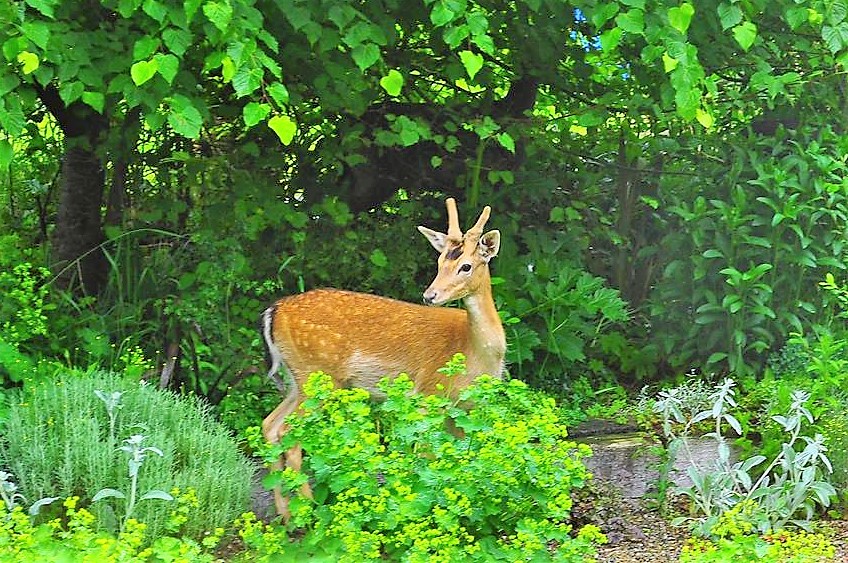
My pride and joy always in May are four large pots of hosta June on the walk way beside the house and last month Snezana looked out from the balcony where directly below there were four young deer up on their hind legs eating the hostas to the base … now it was personal and for a few days after I was determined to bring in the hunters but of course the gene telling me this is THEIR land kicked in and interestingly there have been no deer in the front garden since and let’s hope they have realised that these four rogue deer had crossed a line … some hope as they probably realised there were no hostas left in that area !
It made me realise though that this garden can never be the best it can be , can never be the garden it could be nor reach the potential I had in mind for it as it’s variety and palette of trees , shrubs , perennials , would be hugely different if we didn’t live in deer country . The Lower Field in particular would have lots of japanese maples , parrotia trees , snake bark maples , huge beds of hostas and we would be able to plant with confidence that the tree or shrub would be there the following morning .
Roses and why I don’t grow them July 2021
Visitors to the garden often ask why there are no roses and there are two reasons , one that I am not a big fan of flowering shrubs in general unless they have outstanding foliage or bark as usually flowers last only a short time and the plant has little to offer for the remaining 49 weeks of the year and secondly roses are full of diseases such as black spot and white fly which disfigure the plant and I forgot there is a third reason which is that I have enough work to be doing without the added chore of dead heading roses on a daily basis !
Of course there are exceptions to every rule and I do grow one specific rose and that is the common semi wild rosa rugosa which can have white or pink flowers and the beauty of rugosa is that it has beautiful lime green crinkly foliage which is lovely and it is a rose that never gets either black spot or white fly . Pruning of rosa rugosa could not be more simple as you hack it to ground level in the Spring with a chain saw and it will love you all the more for it !
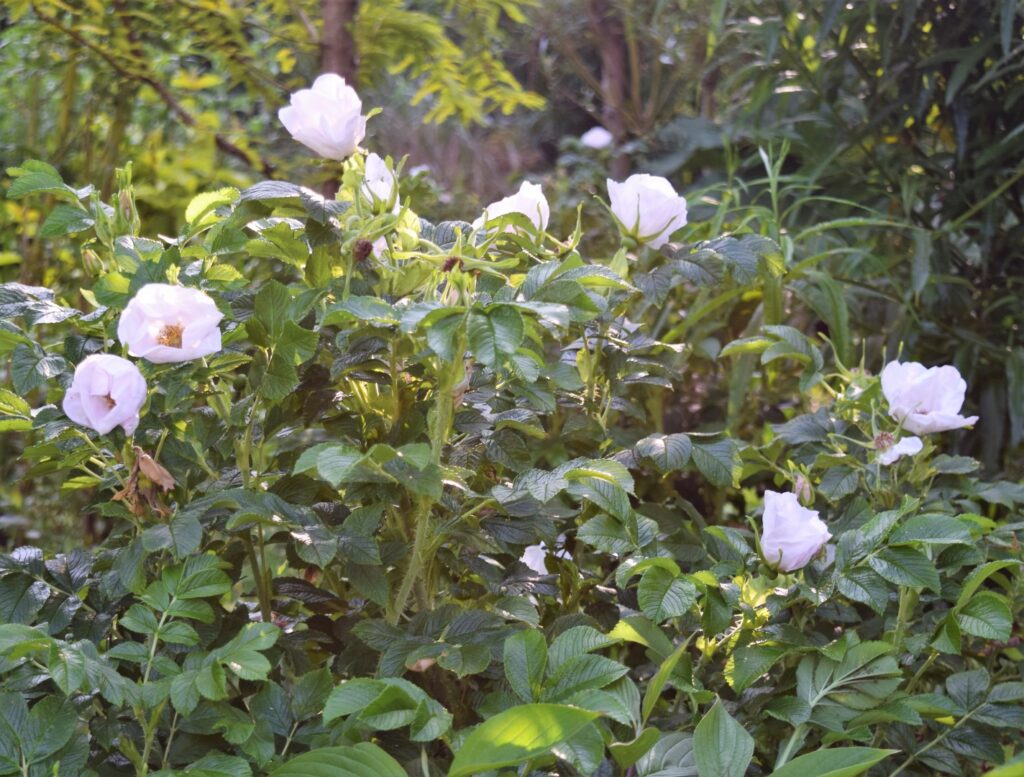
Gardeners love getting plants for free and all of us have a small circle of fellow garden enthusiasts that swap favourite plants or grow on cuttings as gifts when a particular plant is admired or lusted after . I have long admired the monster echiums a friend grows in her garden where once established they self seed like mad and this week she arrived in with three beautiful baby echiums that have been grown on for me .
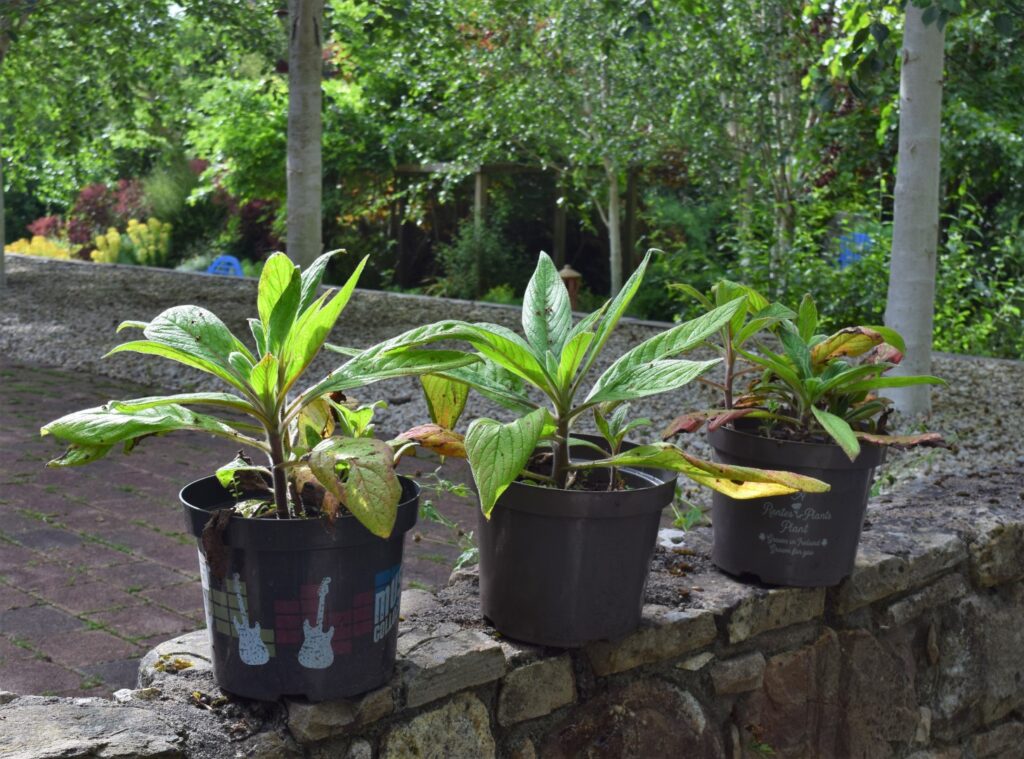
This is the third set of echiums she has supplied over the past few years as the deer ate the first lot after which I got disheartened and decided not to attempt to grow echiums again but I fell in love with them again after a visit to her garden last Summer … a second set of echiums were duly handed over last October which I placed near the house where the deer might not reach … they flourished and by January this year they were three feet tall when a really hard frost got them … third time lucky so I will replant these little beauties and wrap them in fleece from January during the really hard frosts .
As you can see in the photo I took from a visit to Margaret’s garden a few years ago these echiums grow into monsters and prehistoric monsters at that , like something out of Jurassic Park and I will deal with both their size and self seeding habit if they grow this time for me .
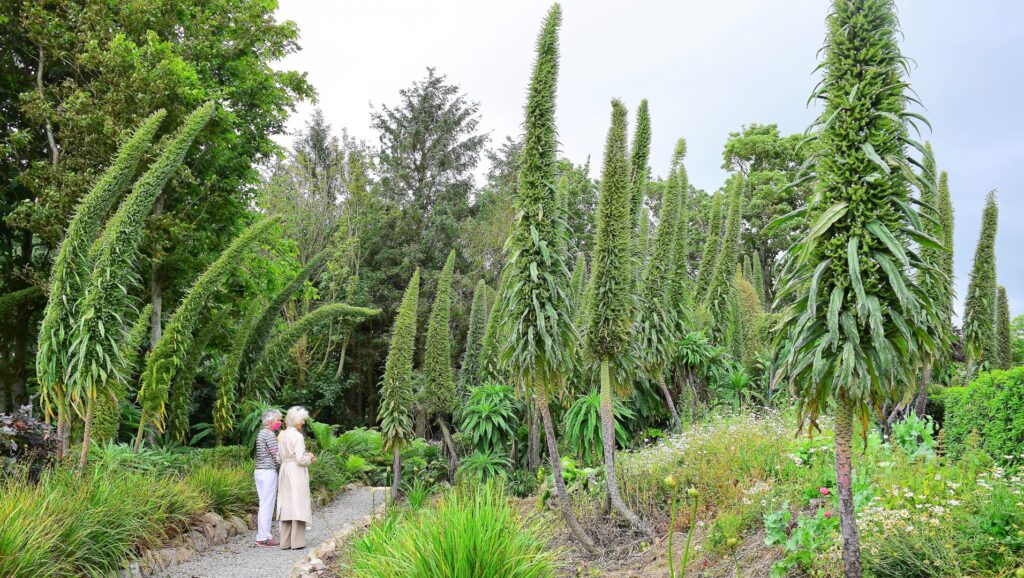
We spent three weeks in Croatia in July 2021
Croatia’s summer is hard on plants and we spent a few weeks in July on the Adriatic coast in Dalmatia trying to bring the garden back to life as everything had hunkered down in almost three months of 35 deg daily and even the lavender had died back . After many years I have come to the conclusion that it is a waste of time planting a garden in the Mediterranean if there is not someone there to regularly water and the only reliables I have found are olive trees , rosemary , aquaves … and rosemary in particular has been a revelation as it has thrived and doubled in size in the garden and OK it is not a pretty shrub but it does provide a nice structure and doesen’t mind been chopped back .
Olive trees are unique but my absolute favourite plant in Croatia is the aquave which is dramatic and over the years I have built up a collection as the plant throws out plantlets that I grow on in pots for a year or two and then plant in their permanent positions .
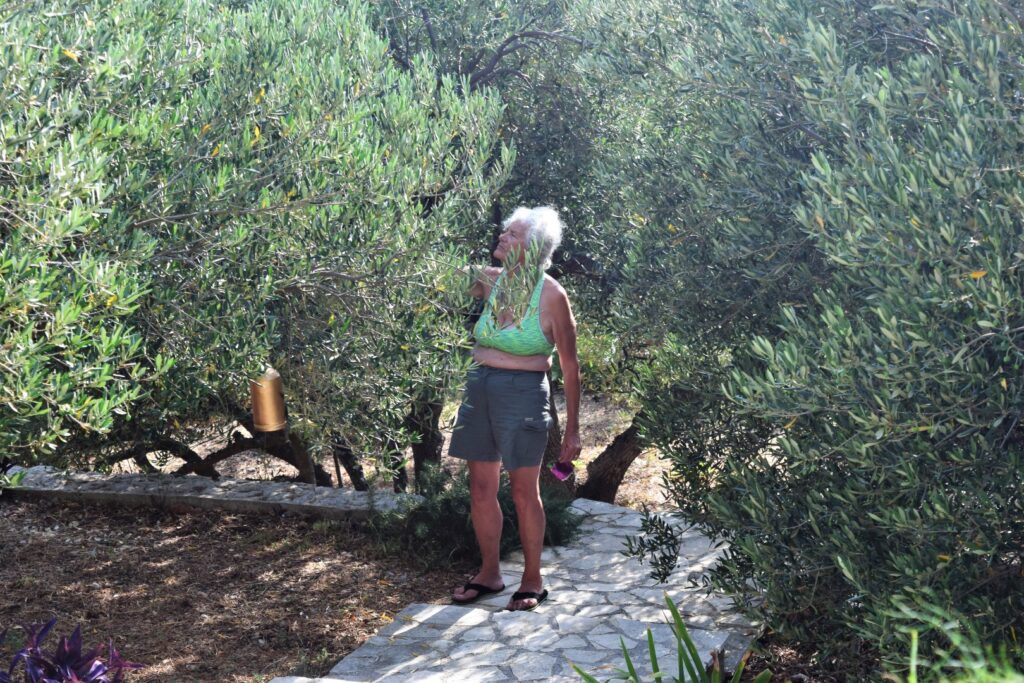
Gardening is a journey where you learn constantly from your particular patch what will do well and more importantly what will survive neglect and what will thrive no matter what is thrown at it .
We grow a beautiful creeping plant , trandescandia , in Croatia which I first saw and marvelled at twenty years ago in Ivo Andric’s house , now a museum to the Nobel Prize winning author , in Herceg Novi on the coast of Montenegro . It is not the dull grey coloured trandescatia we know in the UK and Ireland which is an indoor plant and has the non politically correct local name of wandering jew but this adriatic version is an outdoor vibrant blue perennial which in less exposed places can remain through the winter but which normally dies back a bit but comes back in spring . It is easy to slip and does particularly well in some shade , it flowers but you really grow it for the fabulous blue leaf and it is with the aquave my favourite Adriatic / Mediterranean plant .
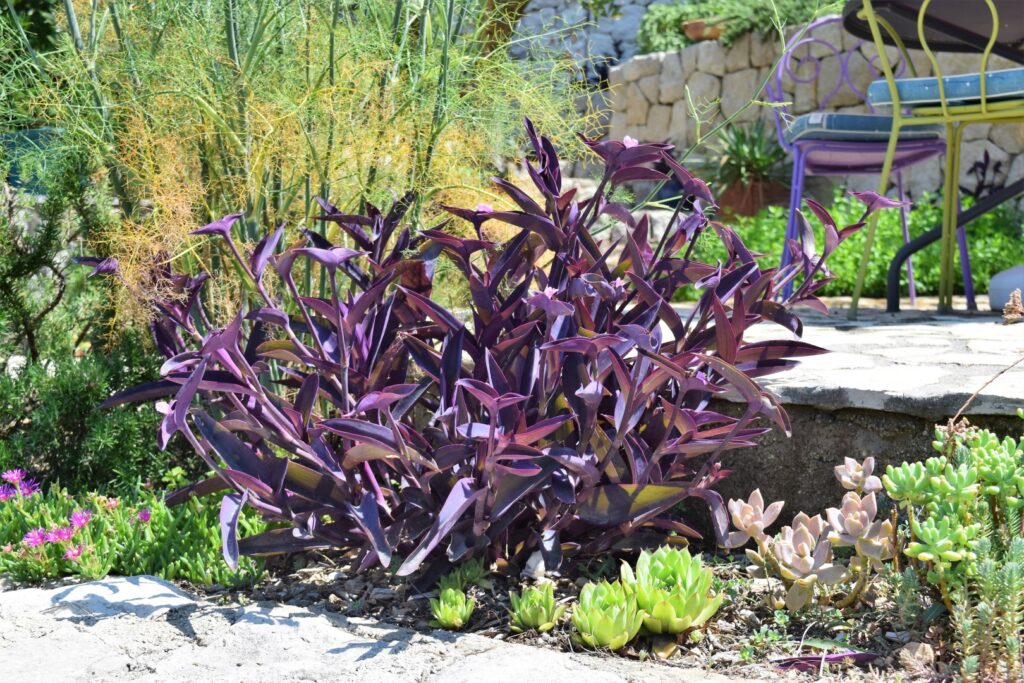
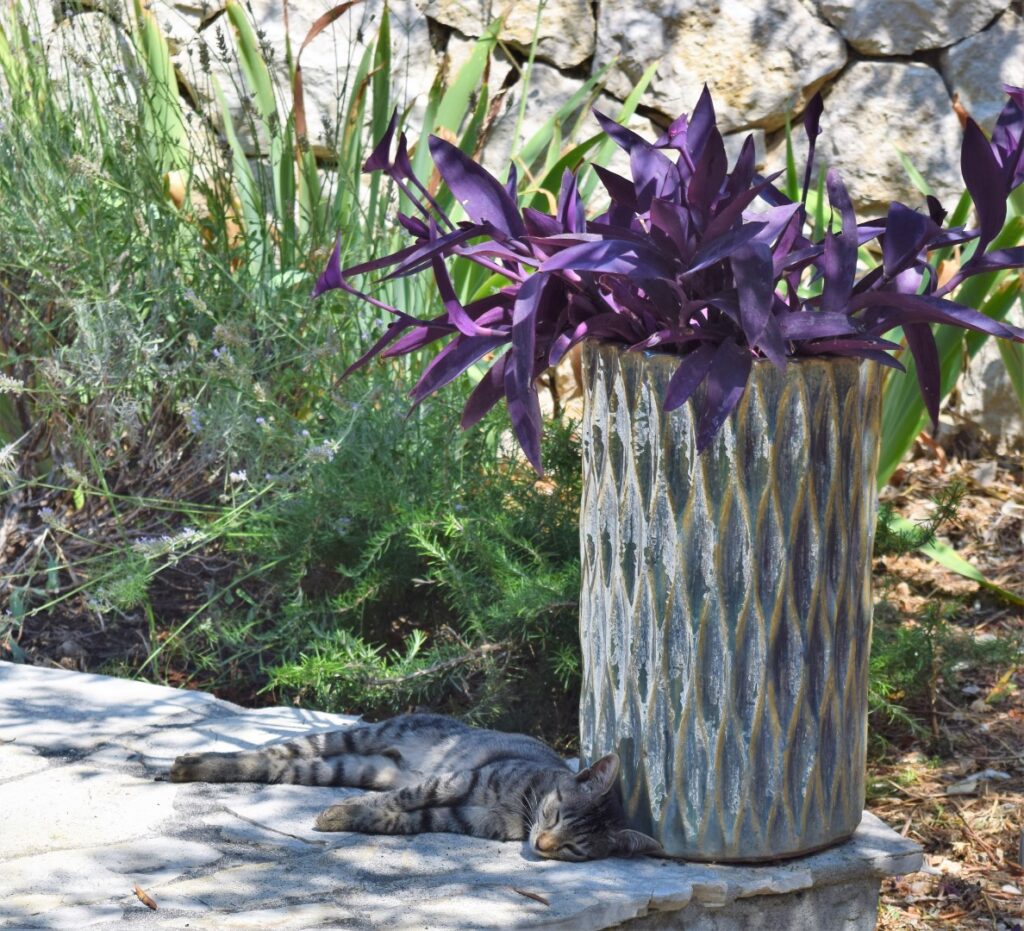
Braveheart in Petrovska Garden
I have had an unusual willow tree for years in the garden here that I have lost the name for , never saw it for sale since either , beautiful big strong paddle leaves which has grown five metres high but the effect of the leaves was rather lost but last year I saw it in a friends garden and they had kept it cut back as a large shrub and consequently the leaves were at eye level and really dramatic … this spring I took the brave step of pollarding our tree to four foot high , took cuttings and hoped that the tree would come back … it did and I am delighted with it and the cuttings also thrived and I have a further eight specimens coming along nicely !
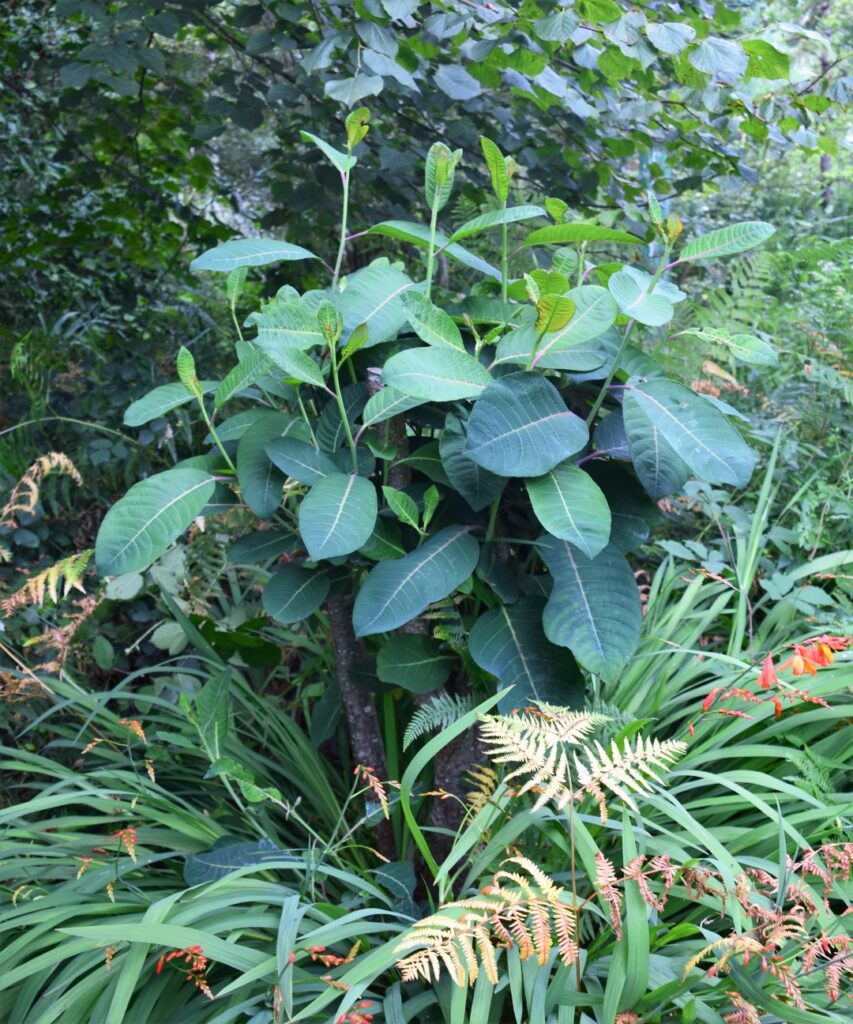
In July 2021 I wrote about a visit some years ago to Skellig Michael
Last month I wrote about our trip to the Aran Islands and mentioned it was one of two iconic sights in Ireland , the second being climbing to the top of Skellig Michael Island to see the 6th century beehive huts . First off this trip is dangerous and you need to have a head for heights as you climb up 1000 very steep uneven steps and there is no guard rail so coming down is especially dangerous as the steps are not uniform … I would recommend ski sticks or at the very least a good walking stick .

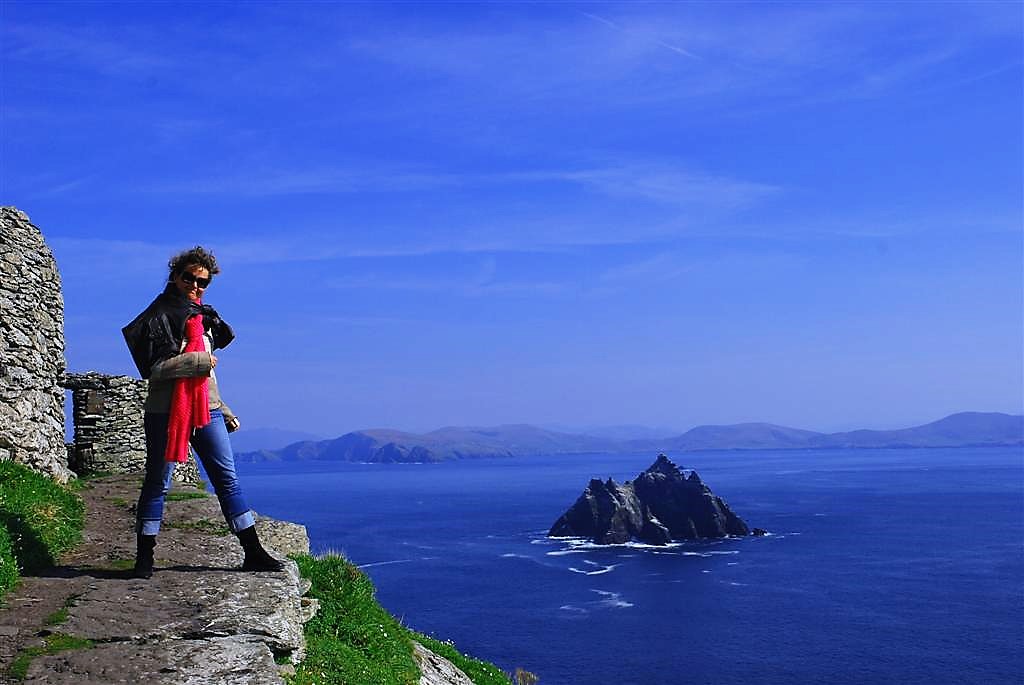
Second thing to mention is the sea trip of 90 minutes each way can be rough and a lot of the time conditions are so rough that the boat cannot land .
The Skelligs have become world famous since they featured in the Star War series in 2014 so visitors are pouring in from abroad . The Irish Board of Works look after the conservation of Skellig Michael and they do a fabulous job with a very light touch and have refused to put in hand rails or anything that might take away from the uniqueness of the location even though there have been several deaths after people fell from the path and I can imagine if it was anywhere else there might be a funicular rail or cable car to the top .

We were there a few years ago and it is an experience to remember and one that you never forget but the price of the boat trip plus admission has shot up to a mouth watering 110 euros per person in the past three years .
I added to our collection of garden pots with three beauties recently bought in by the Clonmel Garden Centre , in my book you can never have enough pots and these went into the walkway in the new water garden area . As they are sited quite far from the house watering is something they will have to look after for themselves so I planted all three with the same combination of plants that can tolerate dry conditions , a central fern with three geraniums then topped with gravel to preserve the moisture and they have settled in well .

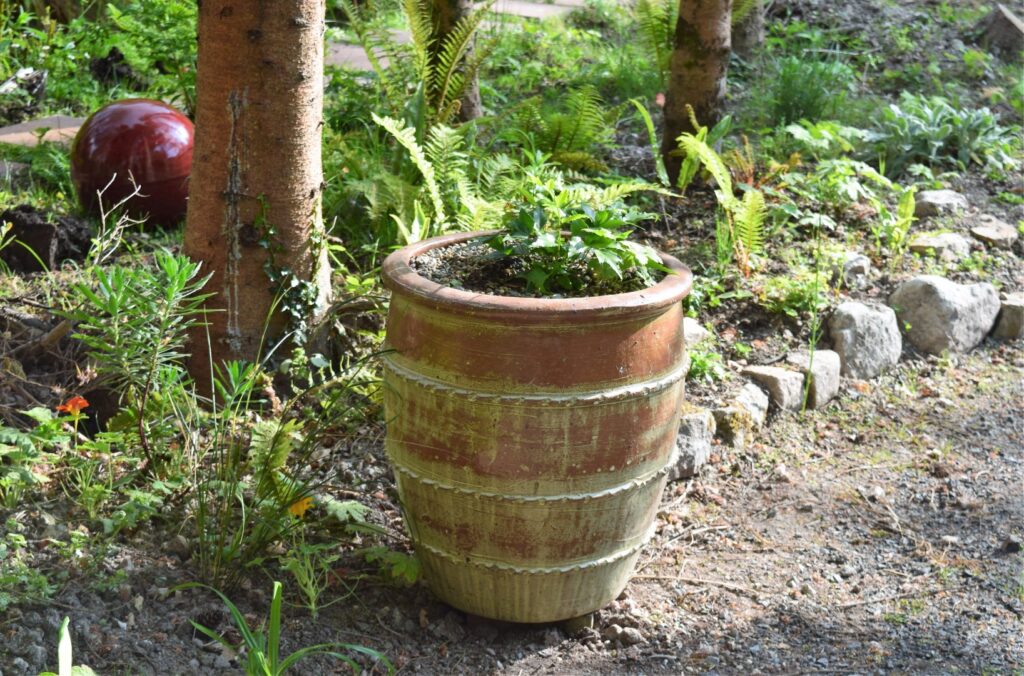
In August 2021 I wrote about weeding
Weeding is probably the one thing people hate about gardening but like the poor it is always with us as gardeners and short of laying concrete or a patio it is absolutely necessary if you have any size of a garden . You can of course try and control with weedkiller spraying but this apart from being decidedly non PC these days can also affect maybe even kill any plants it hits and it is difficult to be selective . Although I use round up every month on our paths I never use it among planting beds where I hand weed always and getting down hands and knees style I find is an excellent way of getting to know your soil and what plants are thriving . I spent three weeks in August catch up hand weeding in the new water garden area after being away in July … I actually like weeding and take my time with a trowel taking out all the roots especially of couch grass and butter cup and I find the secret is to relax into it , get into a rhythm and set aside say an hour at a time and don’t get fixated on how much you can clear in that hour but concentrate on getting all the roots so that at the end of the hour even if you have only cleaned a few metres square at least you have done a comprehensive clean after which you can do a regular comb over with a hoe or spade … I use a long handled spade for this job as I find the hoe just isen’t strong enough to slice through the weeds .
A slow leisuredly weeding session on hands and knees where you can lose yourself in thought is better than any meditation or wellness spa !
Everybody it seems nowadays is letting their lawns grow long , County Councils are letting borders along the roads grow wild and are sowing roundabout beds with wild flowers and you would think this would be a positive thing but apparently not as according to a report this week in the Irish Times as seed packages are being prepared with wild flowers not indigenous to the local areas and some of the resulting plants will take over to the detriment of the local wild flowers and in some caes will kill off the local varieties . Personally I am not a fan of so called “wild flower ” meadows which to quote a famous botanical report of 100 years ago is “ forging nature’s signature ” and my efforts here at a strip of land set aside without mowing for a wildflower patch has not been a success as while in the beginning of the growth in May the long grass is shiny and erect but come August it just looks sad and neglected and all I seem to grow in my managed and set aside wild flower area are thistles and docks , not a good look .
October 2021 and the Olive Harvest in Gornja Podgora
Growing up in the Ireland and UK of the 1950’e and 60’s olive oil was unknown in cooking or eating terms and my first introduction to it would have been with an ear ache where my Mam would have a little bottle bought in the local chemist’s shop and heated oil would be tipped with a spoon into your ear which was then topped off with cotton wool to keep it from running down your neck … olive oil for salads was unheard of in Ireland when I was growing up and we used Heinz Salad Cream for salads which we considered very posh and on my first trip to Greece in 1974 I was horrified by the amount of olive oil that came on all our Greek salads and I remember once in Delphi going into a restaurant kitchen to say go easy on the olive oil only to see a black dressed Granny upending a bottle of oil into my salad and hearing the bottle go glug glug … she gave me a look that stopped me in my tracks and that said don’t mess with the Nana … I have embraced olive oil ever since !
Late October in Dalmatia ( the coastal strip that runs the length of Croatia from Slovenia to Montenegro ) is the beginning of the olive harvest and entire families gather from home and abroad to help with the picking . It is a tradition that goes back two thousand years to Roman and Phoenician times to when olive oil production was first started in what is now Croatia . Traditionally the olive oil produced was for each family’s private consumption and a small amount was sold to tourists at local markets but in the past twenty years Croatian olive oil , still mainly picked with traditional methods , has become a thriving commercial industry regularly winning gold medals in international competitions around the world .
It is hard work picking olives by hand which is mostly the case in Dalmatia as the trees are grown up along hill sides where it is not possible to use machines and it is in most cases a family event with everyone from Grandma down lending a hand . Family members living abroad wherever they are in the world … the Croats like the Irish have always gone abroad as emigrants … they often arrange their holidays to be home in late October to help with the harvesting and this connects them with their homeland , it’s traditions and a share in the lovely olive oil as like with every produce your own home made tastes much better !
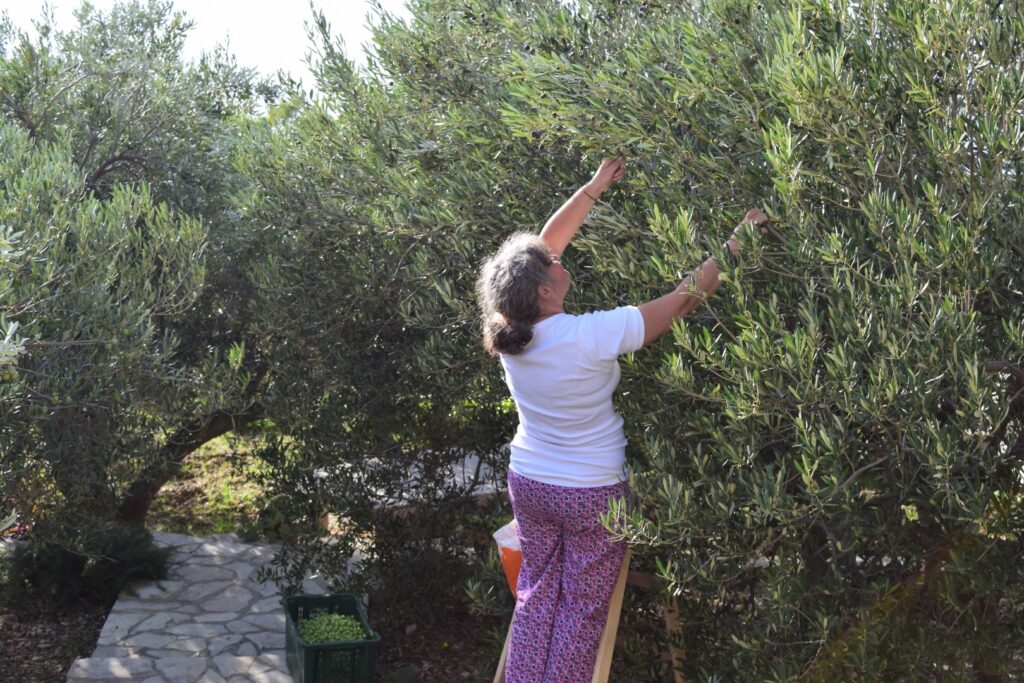
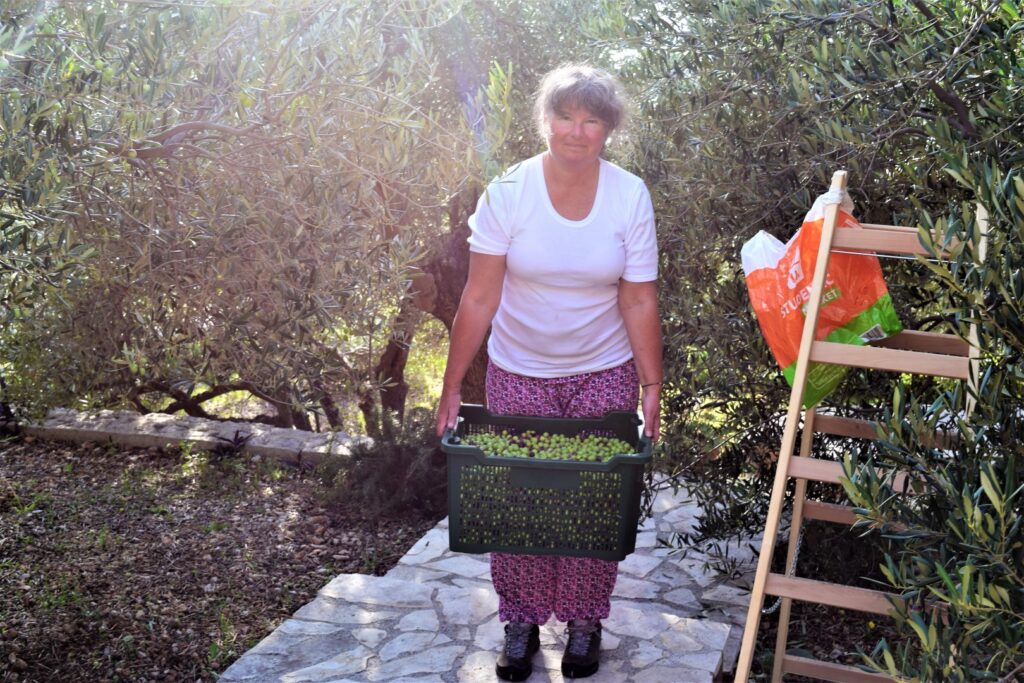
We grow our olives in a small grove of fourteen ancient trees and learn from the locals in Gornja Podgora every year on how to keep the trees healthy by pruning and fertilizing with natural products such as sacks of goat poo from the Biokovo mountains and absolutely NO pesticides are allowed among the olive trees in case the chemicals leeches into the olives . Standing around at the local olive mill when your olive processing slot is allocated is a great source of information and even with such a small production as ours you are still given the same attention as your neighbour with 300 trees … although I have noticed that almost everyone you ask has at least 300 trees but as Snezana says there are probably 25 people sharing those trees ! This year we met people home from Germany, Austria and Holland for the harvest and learnt that even though you might have 300 trees it depends on how young and fit you are to properly look after the trees throughout the year as this will determine the amount of olives you collect as trees that are not looked after quickly become feral with a thicket of branches and will be difficult to pick from and the yield will be much much lower .
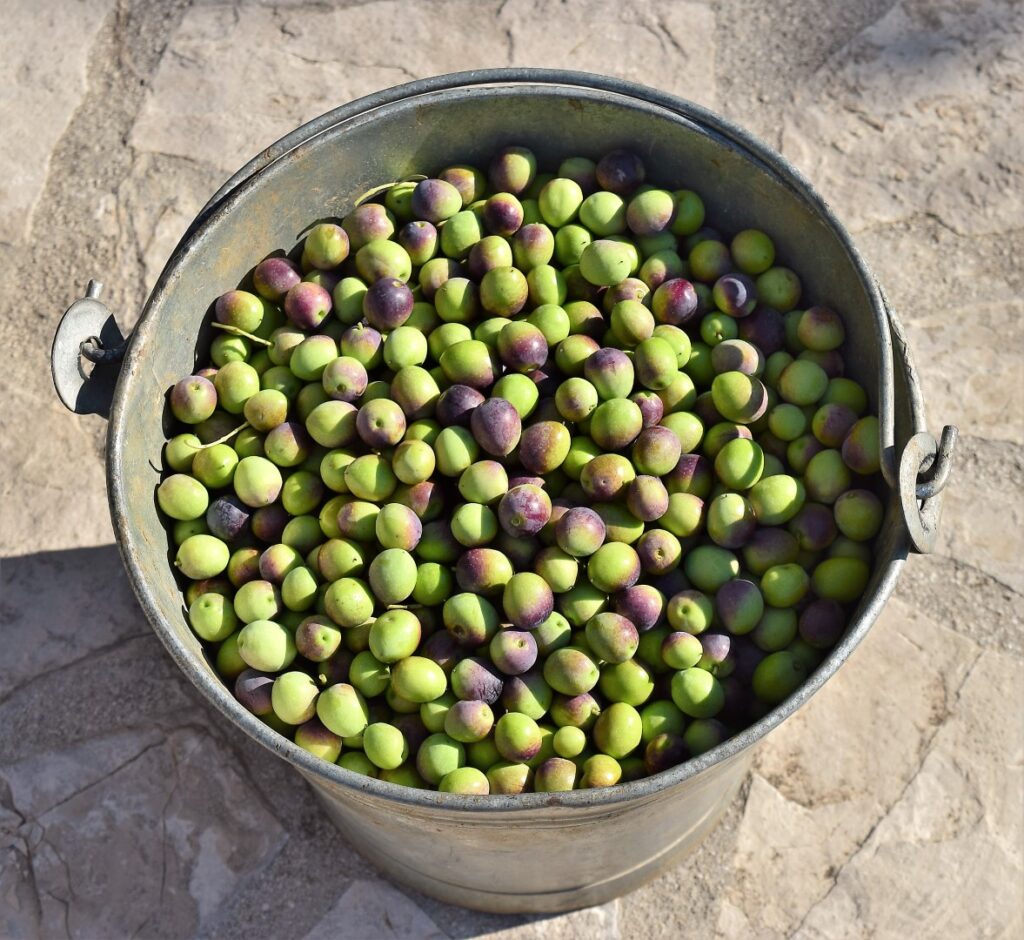
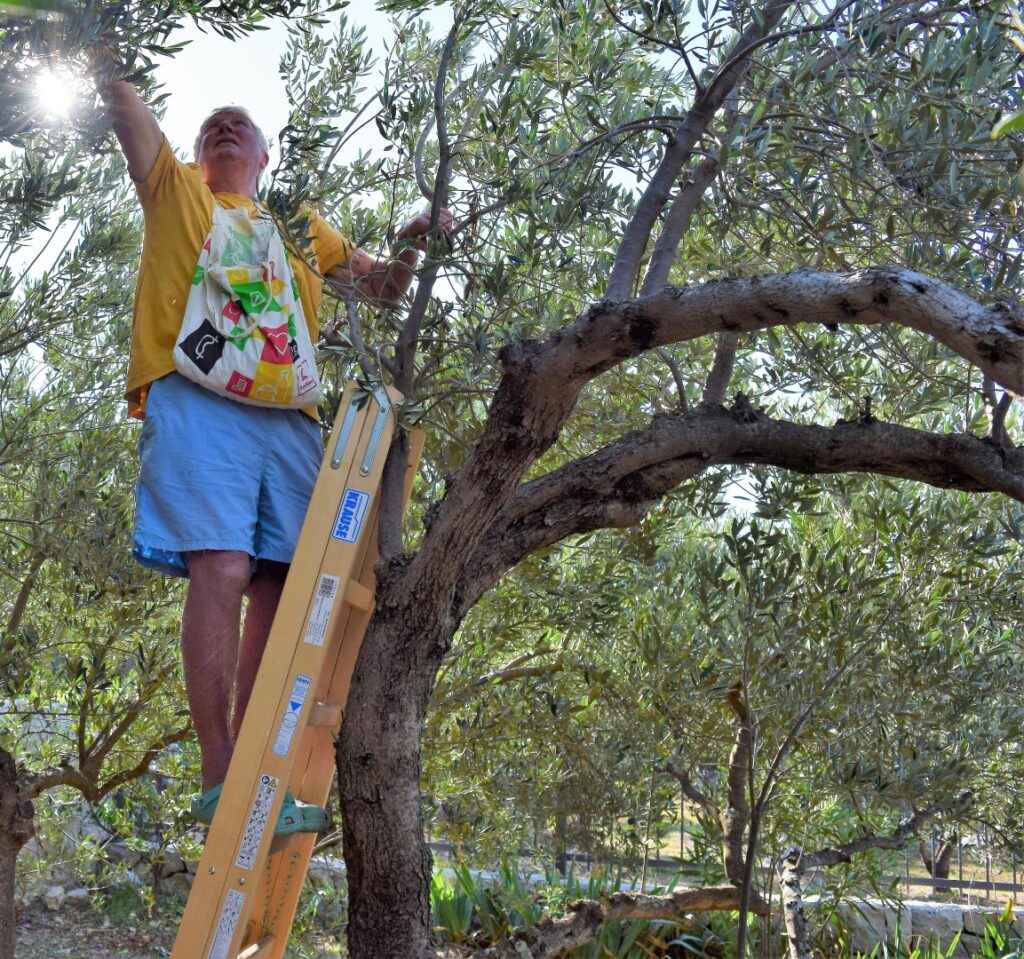
We picked the olives over a two day period on 17th /19th October , which is an early harvest just when the olives are at the green stage about to turn blue/black when the olives are blushing as they say locally, as this provides the healthiest and the most flavoursome olive oil , we store them in crates as this prevents the olives from crushing and ideally the olives go to the mill at the most 48 hours after picking …any later and the olives need to be stored in water . It is intensive back breaking work as we hand pick all the fruit , no whacking or raking of branches or spreading sheets under the tree to catch the olives that fall in the picking process and up and down ladders like yo yo’s … we have only fourteen trees so I can only imagine the effort that goes into hand picking 300 trees … after a few hours the novelty of picking your own olives goes out of it and it becomes pure slog and one’s thoughts drift towards a chain saw for next year but when it is all over and you see YOUR olives being washed and crushed at the mill and that magic moment when the first golden liquid pours out … well it is magical … roll on next year again !
At the Olive Mill in Gornja Podgora October 2021
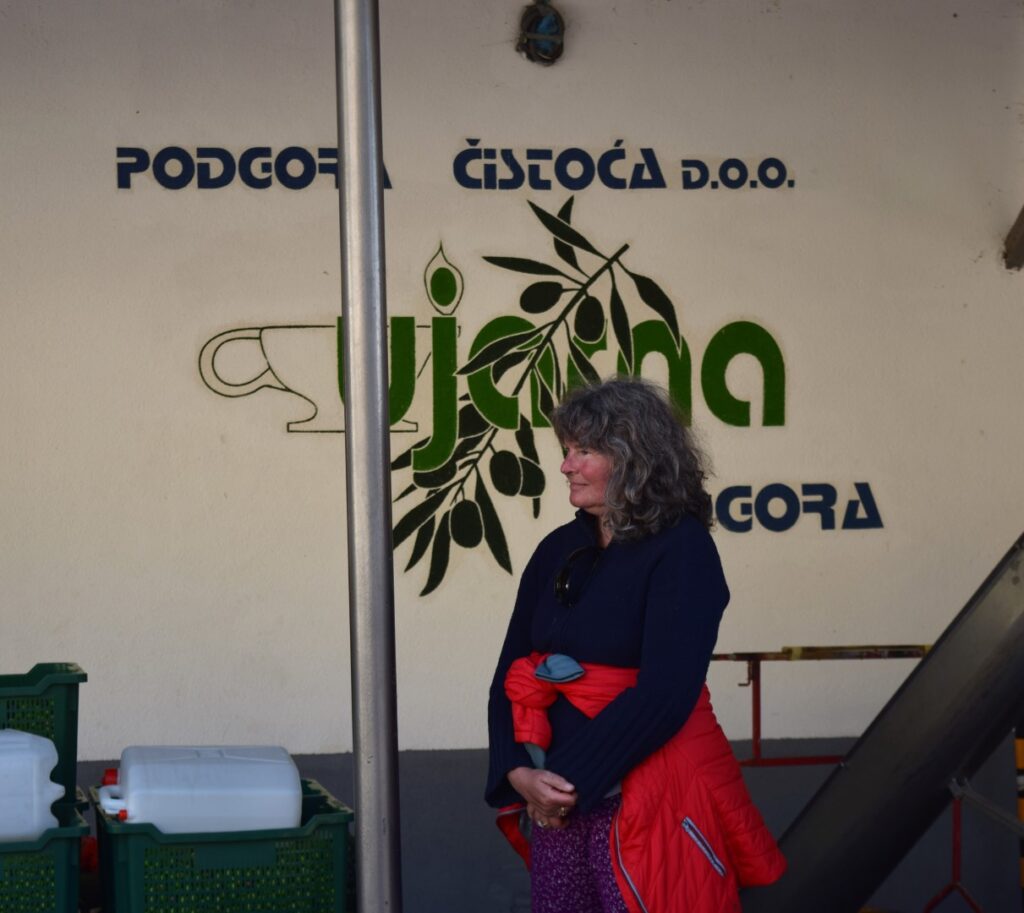
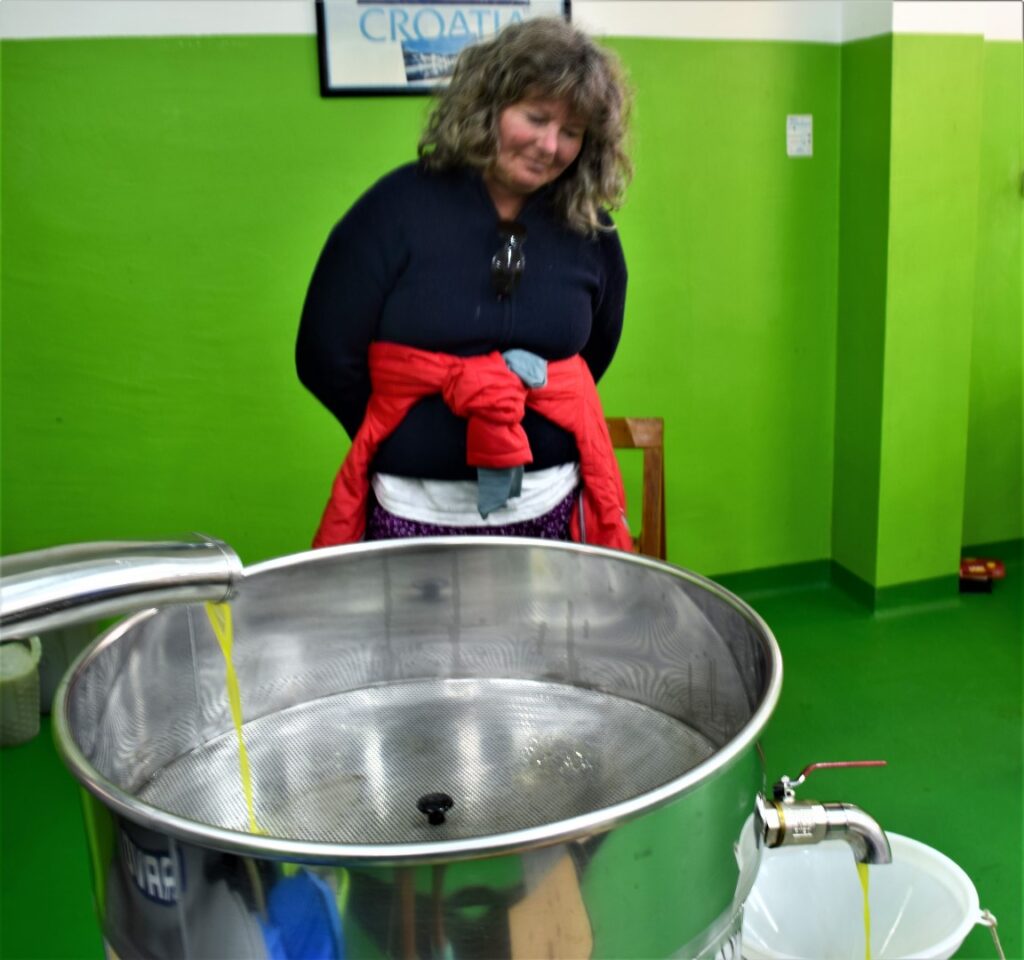
Let bottling commence !
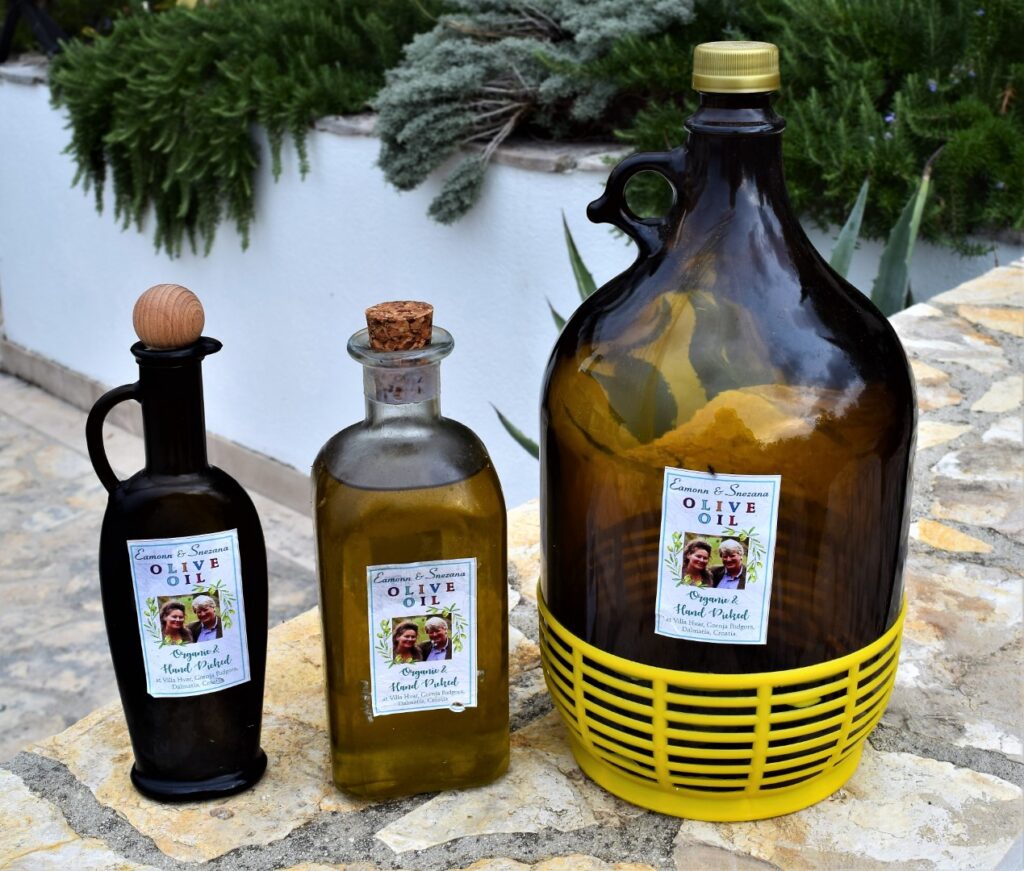
This year we collected almost as much olives as our best season two years ago , 135 kgs of olives which after processing gave us back 18 litres of Eamonn & Snezana ’s Extra Virgin !
In November 2021 I wrote
This November after ten years in the ground the various parrotia trees also known as persian ironwoods are showing a gorgeous leaf colour and together with a solitary acer griseum , they have been growing well every year but this is the first time they have shown the lovely autumn colours they are famous for . Gorgeous leaf colour or not I would not grow any tree or shrub for a three week show , not worth it lovely and all as they are and I insist on every tree / shrub or perennial providing interest for at least eight months if not the full year as do silver birch . All the Japanese maples are worth growing also as they have a nice structure when not in flower and really nice bark as in the case of the snake bark maple or the acer griseum .
I always maintain that designing a garden for Spring / Summer is easy… the phrase I actually use is “ any idiot can design for summer ” … as the choice between bedding annuals , flowering shrubs and perennials is huge but designing for winter is trickier and hardest but if you get it right … and “ right ” for me involves lots of silver birch as their stark white trunks give almost an electric shock when you come across them in groups .
On November 14th as part of my occaisional series of photos titled A Walk in the Garden
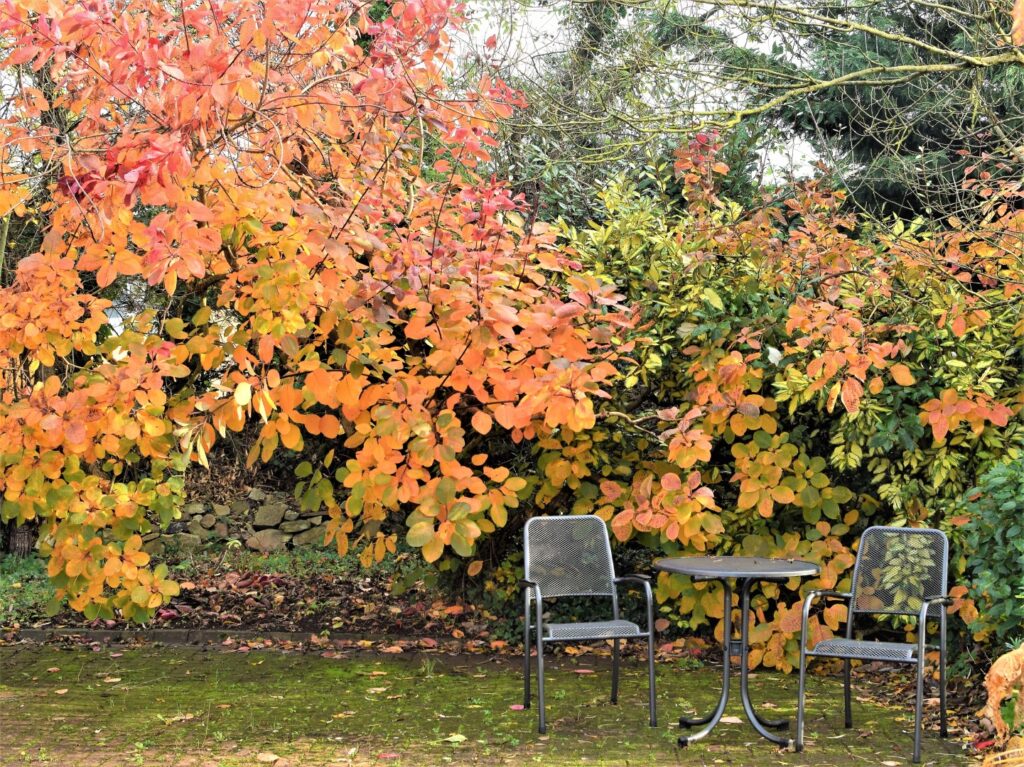
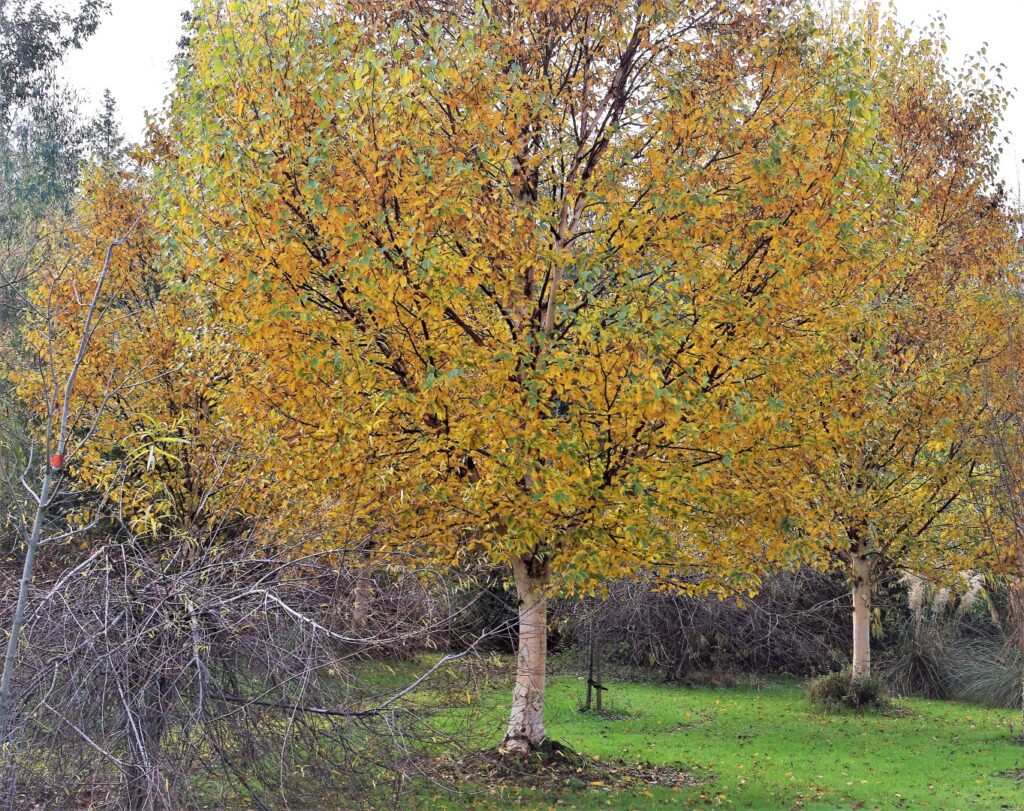
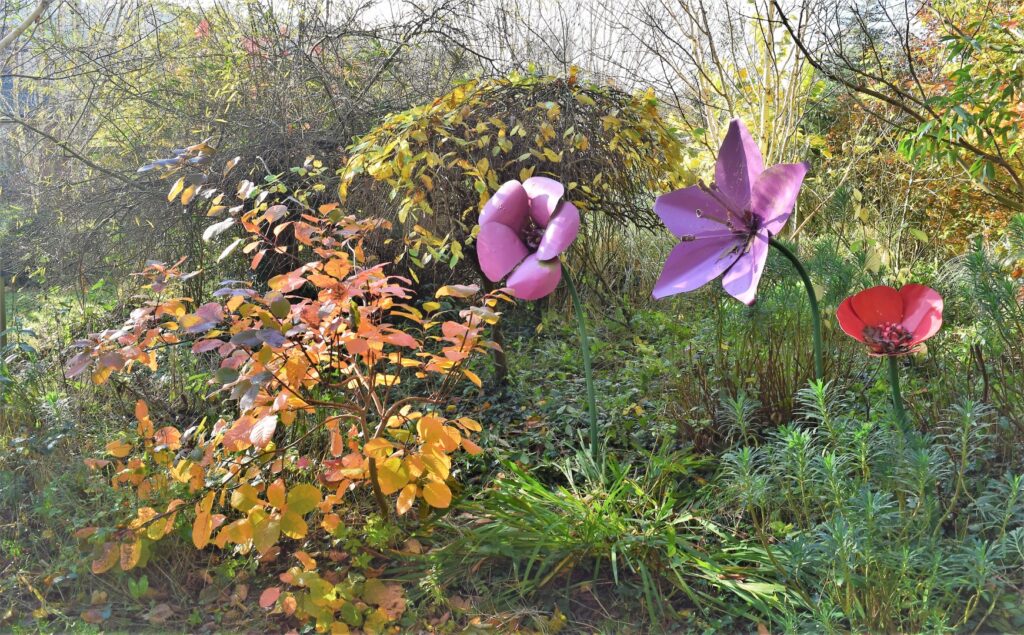
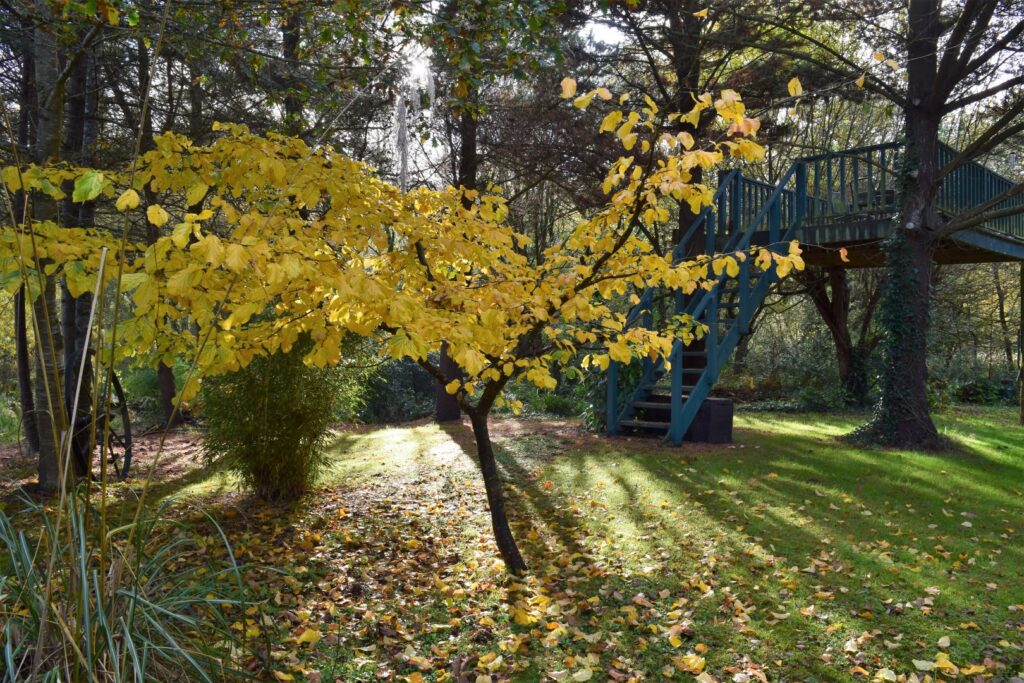
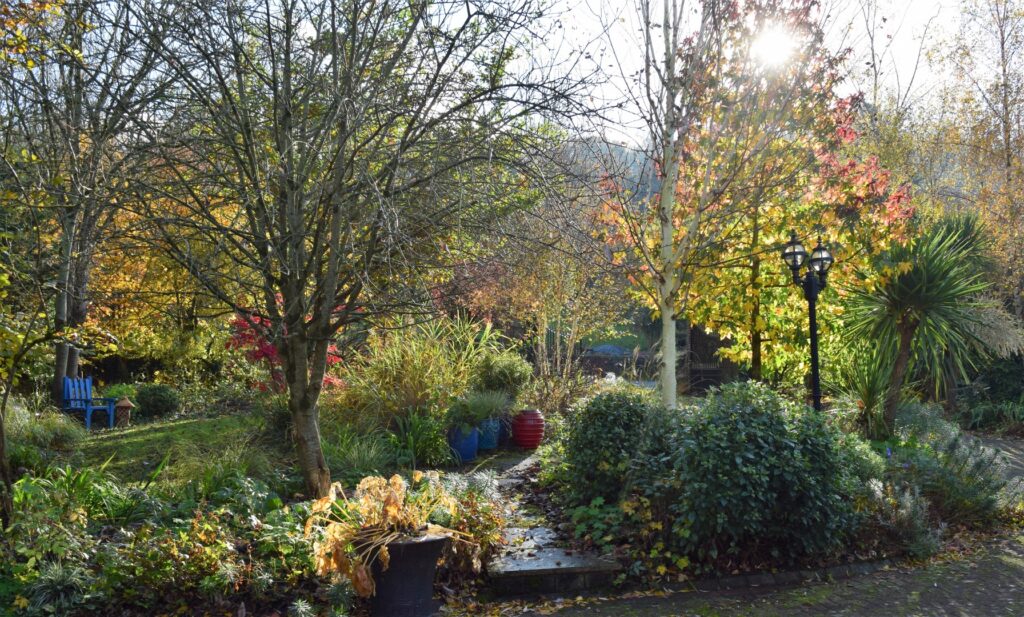
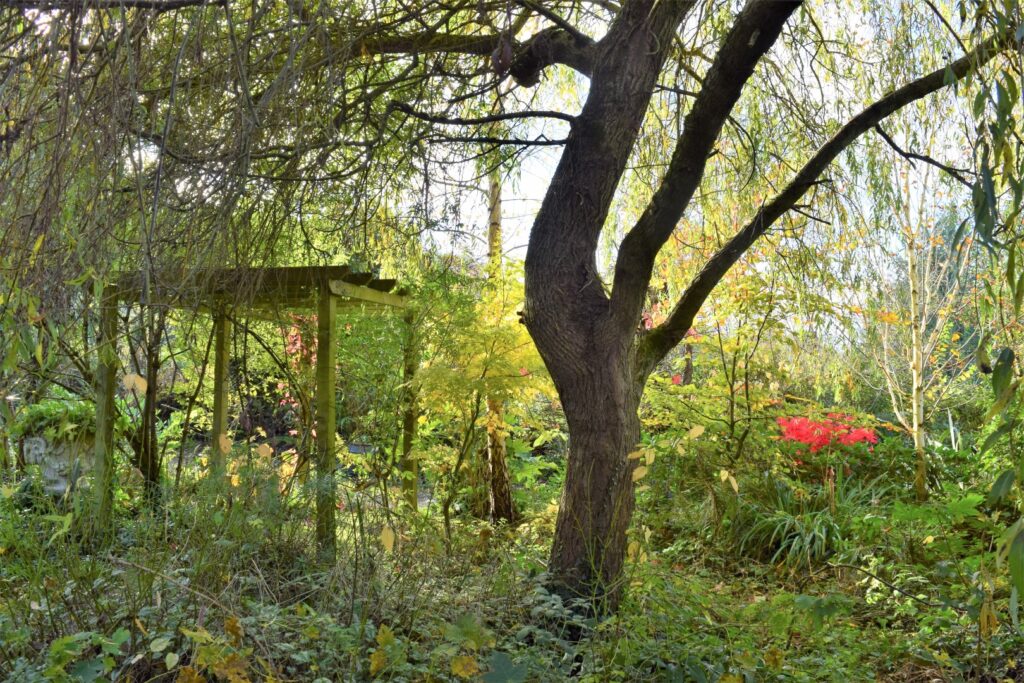
Regular readers will know that I love big clumps of gunerra and they grow super well here , they have a real wow factor when you come around a corner and are in your face but they do die messily with the huge leaves turning black at the first sign of frost and flopping all over the grass but over the years I have patented a trick where I cut back the gunerra leaves , fold them in on themselves and make a neat parcel which has a nice shape and adds structure to their areas while the folded leaves protect the crown of the clump and in Spring the new leaves push up through the decaying last year’s leaves and it is a real sign of Spring for me and all the optimism that a new growing season brings … the king is dead long live the king !
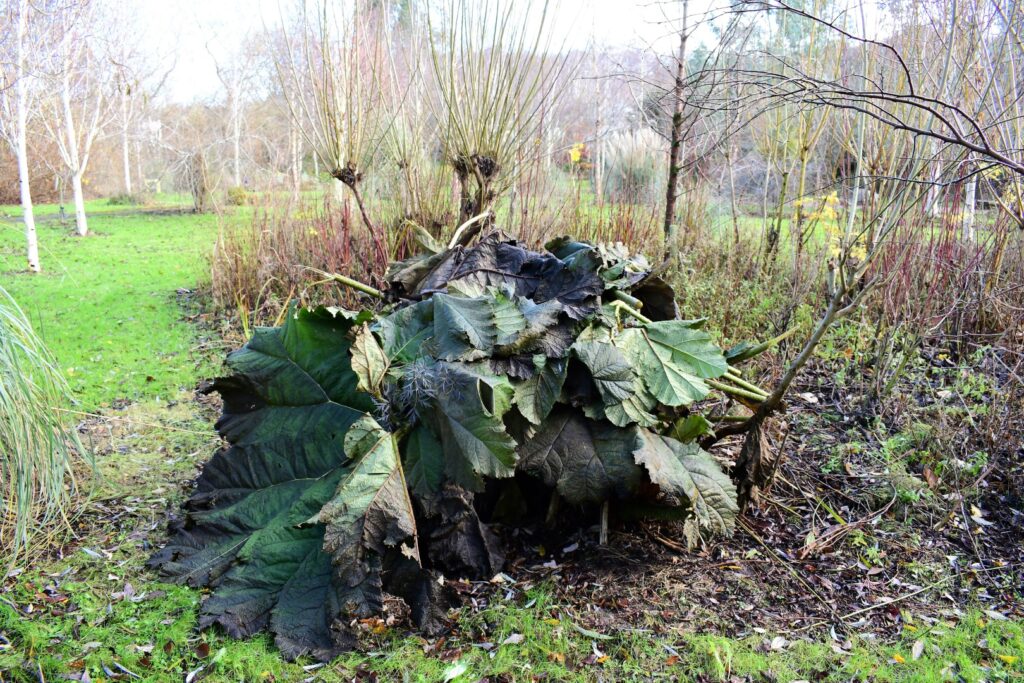
But people still persist in wanting a garden that is low maintenance and demand the impossible from the garden centres where unless a shrub or perennial is in full flower it won’t sell so the garden centres will only order supplies in full bloom from the producers and this in turn forces the producers to bring the plant into flower under glass and put it out for sale in impossibly early . Hydrangeas and hostas are a prime example where they suddenly explode out onto the garden centre shelves in full vibrant bloom in April and of course these plants are not properly hardened off and have been hot house bred and pampered and even if the May frosts don’t knock them back they have spent such superhuman energy that they won’t bloom for another two years .
Hydrangeas don’t die back well and can look like a collection of twigs when November comes around where they look really sorry for themselves in the ground until they bud up again in April and are a liability on garden centre shelves as it takes a leap of faith to buy something that looks dead … that’s when you get bargains on sale … I never buy hydrangeas in bloom with big flower heads on them but in late November I buy what comes on sale and am prepared to give them time to recover and this week I bought nine hydrangeas at half price which will go into the semi shaded woodland which has damp soil , the perfect growing medium for them and in two years time they will be beautiful .
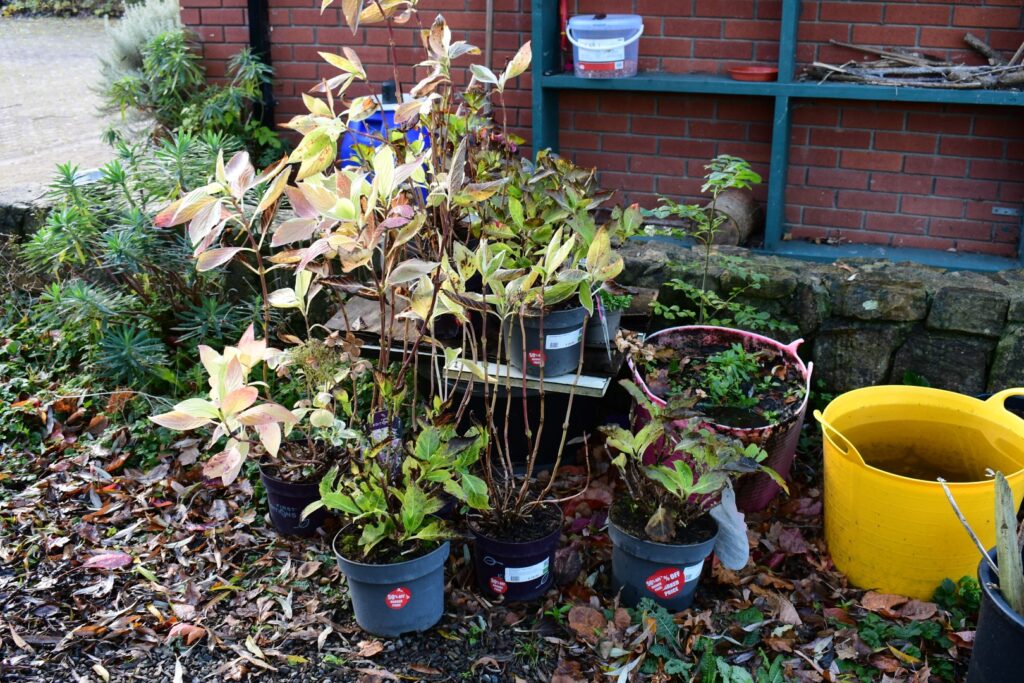
Sometimes we take time off from the Garden and visit Clonmel Garden Centre to view new arrivals in the large pot section !
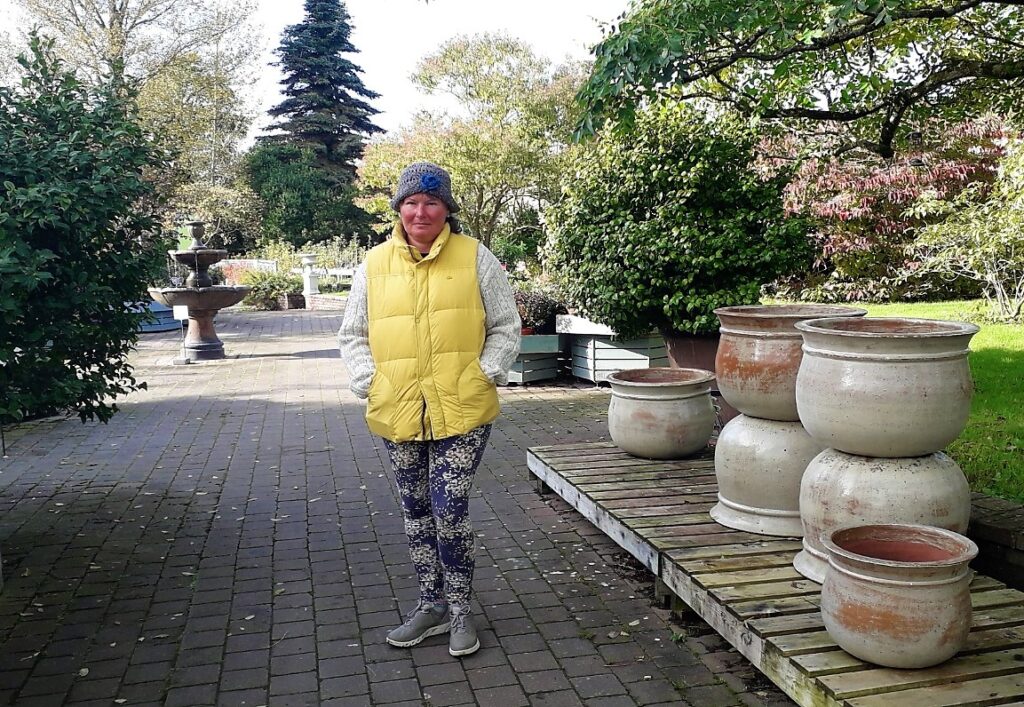
Storm Barra hit Ireland in early December 2021 and we lost two trees including a large fifteen year old eucalyptus tree and while getting it chopped up we used the opportunity to cut out nine conifers that had died over the summer and all this kept us busy and took ten days to clear up and store in the wood shed .
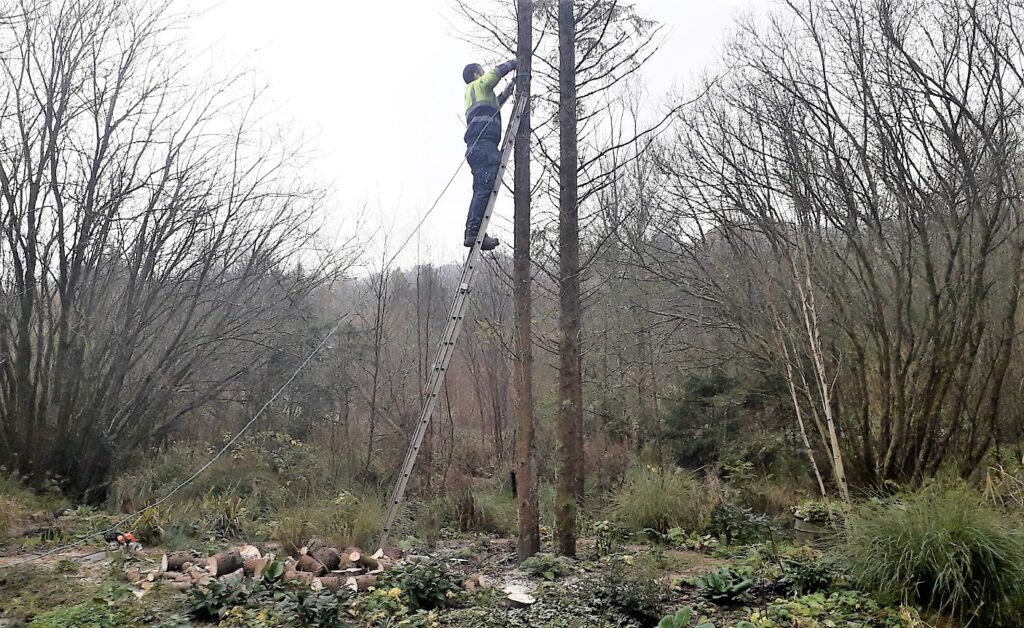
These tree losses are what gardeners live with throughout the life of a garden , nothing is guaranteed to last forever . The eucalyptus I had planted in wettish ground fifteen years ago and while their roots love damp ground it also means that the anchoring system the roots provide sometimes isen’t strong enough to support the adult tree and we have lost several over the past few years .
The conifers were part of a wood planted forty years ago by the previous owner of the land and are nearing the end of their natural life but unfortunately three of them were part of the design I used last January for the new water area and I had built a path specifically around them as a feature … still I knew they were not great looking trees so there is now an opportunity to plant alternatives and I found a new silver birch , new to me that is , a Himalayan birch called Doorenbos , which is smaller than the normal jacquemontii birch but with even whiter bark … silver birch would have been my first choice anyway for the area but I had left the conifers standing as they were still alive but their forced removal is no loss and has opened up more light while the silver birch will bring an airiness to the entire patch … the conifers are now chopped and stored in the wood shed and next winter will fuel the stove and their ash after burning used as fertiliser in the flower garden .
Gardens evolve all the time and should but I hadn’t expected that there would be a major change so early in the new water area after only nine months but the removal of those four large trees needed an urgent reset and apart from planting some extra silver birch I also ended up moving two large pots into the new area for a bit of extra impact as I felt the planting in their old positions had thickened out and their presence there was no longer necessary and they do add that extra oomph in their new location and now I see that a Japanese stone lantern could be the next addition to the area beside the water , watch this space !
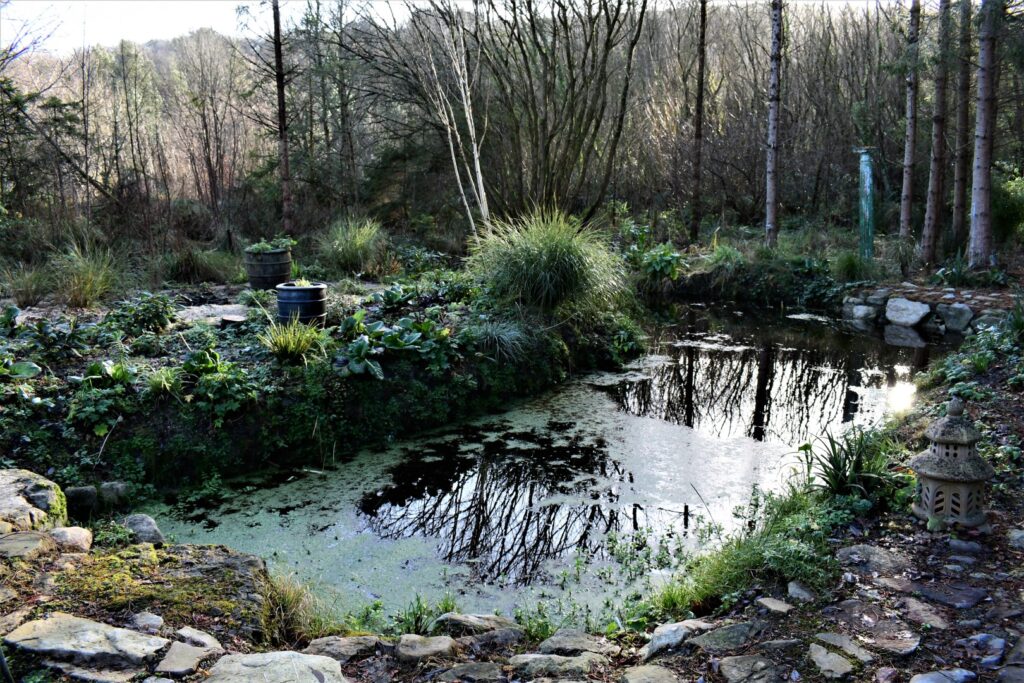
Feng O’Shui in the house and garden December 2021 !
We had our downstairs windows removed last week as they were 25 years old and replaced with a more modern design which opened up the rooms more to the garden outside and I was remined of a gardening friend who designed his entire house on feng shui principles . Feng shui literally means wind and water , the philosophy is 3000 years old from China and is the art of arranging buildings , furniture , space and your life to achieve harmony and balance and most of it is very much common sense for me as it sets out rules on colour , separating work and rest places in the house , keeping the house tidy … but it is at the next stage I get a bit wary of feng shui as it goes on to preach that the world is driven by unseen often negative forces and I back away from any further adherence to feng shui rules as I gather that real devotees let feng shui rule their every waking moment .

But I still find a lot to admire in feng shui and when walking around the friend’s house I loved some of the touches especially where windows had been placed for no other reason than to frame a particularly nice view of their garden .
Our house here like most houses was built on an undeveloped site with traditional windows in all the usual places and when we bought it back in 2000 I designed the garden around it with favourite trees , did I mention silver birch before (!) to be seen from within the house and without knowing it created feng shui in reverse , the garden as a room outside !
Our old windows had faux Georgian bars inserted within the double glazing and apart from now being wildly old fashioned these did block out a certain amount of light and definitely blocked out a clear view of the “ room outside ” … just how much I didn’t realise until they were replaced last week and now the white of the silver birch stand out really well and my gaelic version of feng o’shui is great !
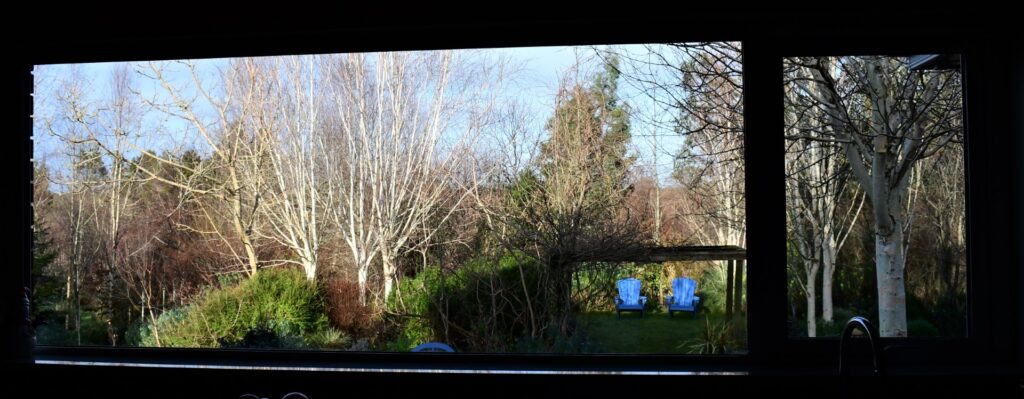
In the December Blog I wrote about the Kosovo Roma Girl and the Turkish Gypsy girl
It was February 2011 I was having a coffee in Kosovo in a Pecs café when this little Roma girl passed holding her hand out looking for money and even though Kosovo was and is a male dominated society , here she was on her own begging for money and I was struck by the air of independence and confidence she had .

I keep this photo on my computer home page and often look at it and wonder what became of her , I hope she has a good life .
In May 2015 we visited a Roman archaeological site called Zeugma on the Euphrates river close to the Turkish border with Syria where we walked through fields of pistachio trees which I had never seen before and then on to Gaziantep museum on the Turkish / Syrian border where the finds from Zeugma are housed .

The most famous mosaic from Zeugma dates from 100 AD and is of a young girl who has become known as the Turkish Mona Lisa and world famous as the Gaziantep Gypsy girl and looking at it now and while 2000 years separate them I am struck by the resemblance .

I wish her and all of you a very Happy New Year and Sretna Nova Godina for all my Balkan friends in 2022 .
January 2022 , a New Year in the Garden
The resident gardeners of Petrovska Garden in January 2022
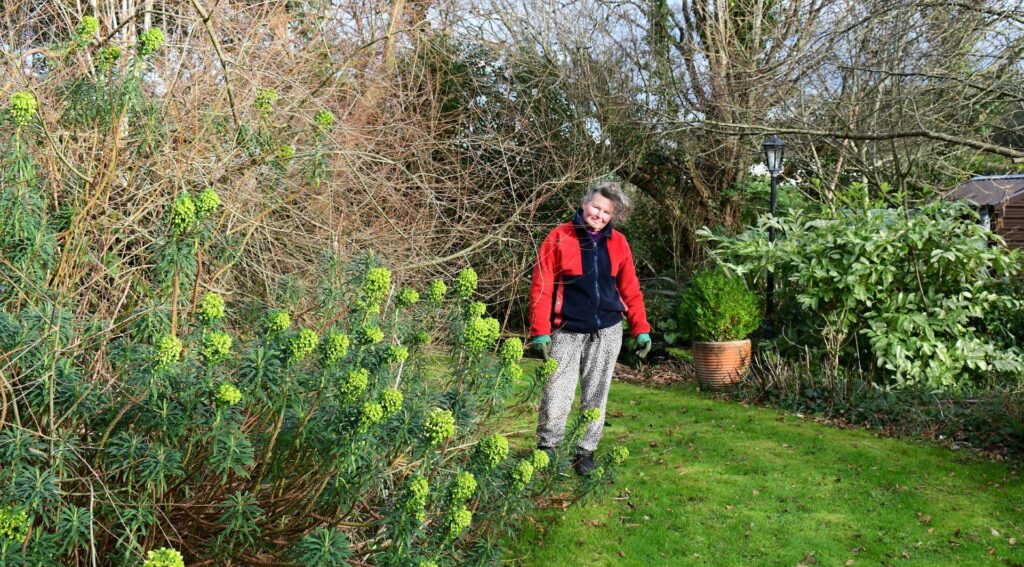
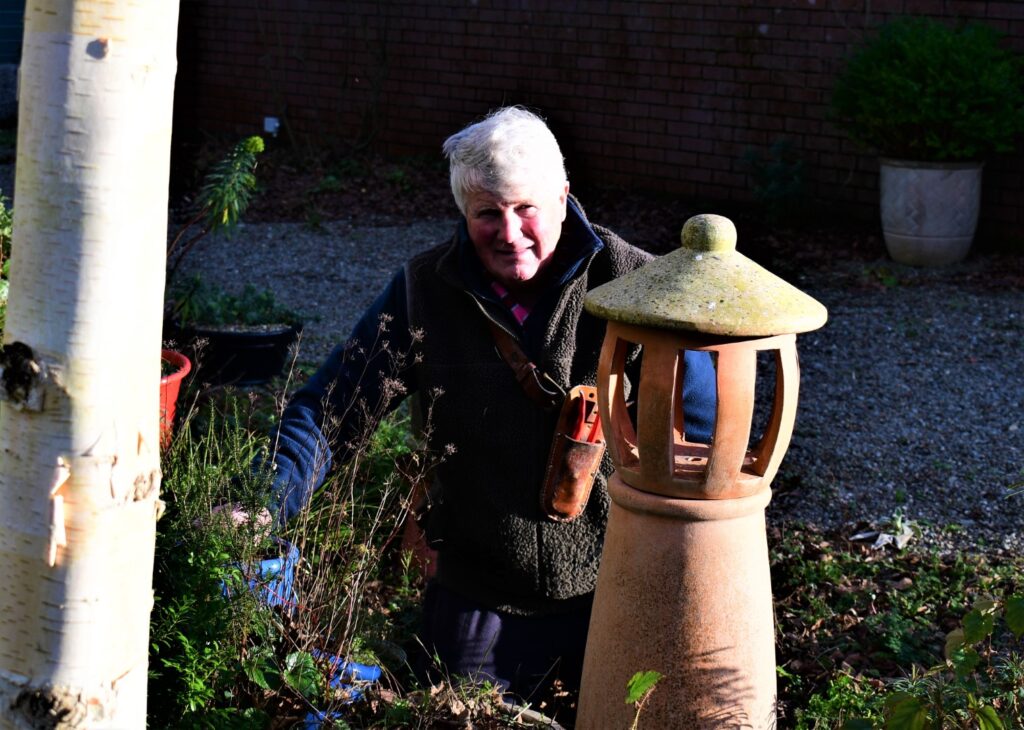
Proof reading the January Blog

Favourite tree in late January 2022
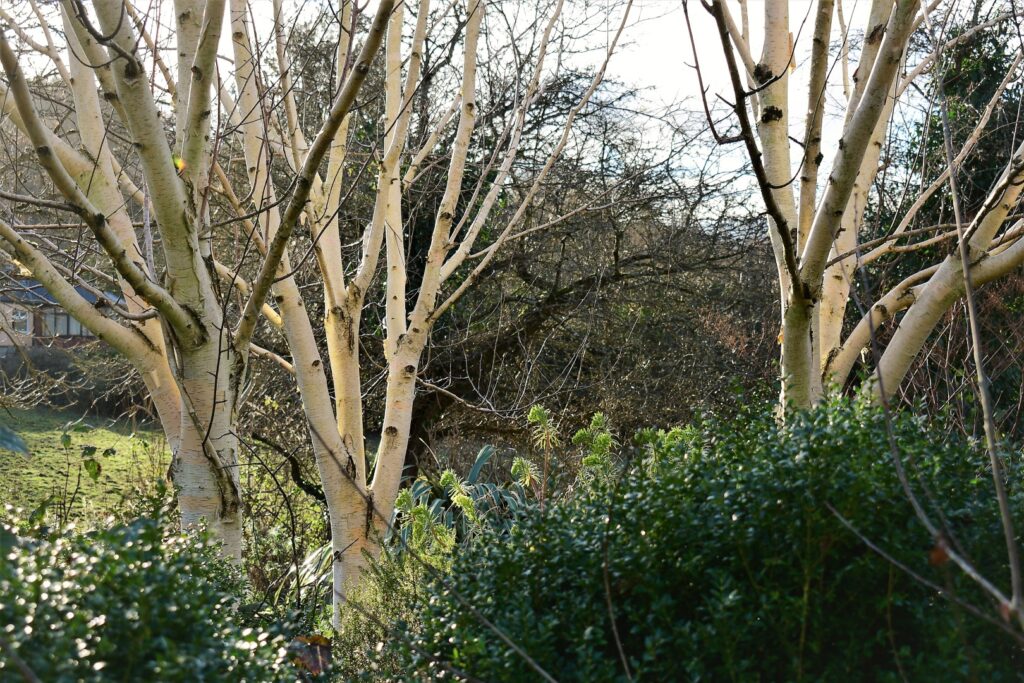
There is an excitement about the end of January always for me because for Irish people the 1st of February , St. Brigid’s Day , is the first day of Spring , the end of Winter and the light still there until 6 o’clock gives the feeling that the gardening year is beginning now !
January is the month in which garden writers queue up to give their advice to beginners and not so beginners along with their new year resolutions and I particularly like the advice Rachel de Thame , a gardener I really enjoy reading , gave in her Sunday Times column where she lists 22 “ Tips for budding gardeners ” and then at the end says ignore them all and go with your instincts , plant what YOU like , ignore advice as after a while of trial and error you will find your feet as a gardener .
After 40 years of gardening and having built and developed two large gardens I have found that there is only one rule and that is right plant right place .
Follow that and you will be find and as simple as this rule is , it is cunning because selecting the right plant means you have to read up and study what the right plant is for any particular place and you will learn soon enough after a few expensive blunders !
“Doing anything in the garden at the moment ” is a regular question throughout the year and as a rule both of us here would be in the garden every day doing something or other and unless I have a specific job such as planting a new tree or shrub , normally I base tomorrow’s work on what I have seen on my walk around today . Winter is where the hard pruning and planning for the summer months occurs and I always walk in the garden with the secateurs in my hand as there is always something that needs cutting back . A quick recap of the past month’s work would be collecting the cut wood in a trailer from ten trees from the Lower Wood area and storing it in the wood shed , planting eight new hydrangea shrubs bought in a garden centre sale , digging up a ten year old weeping silver birch and replanting it in the new water area , positioning and planting up a new large pot , digging out and planting five wild self seeded silver birch trees , pulling up and cutting out brambles across the entire garden , taking a hundred cuttings of golden willow and red dog wood and planting in the wild grass area … generally a few hours work every day .
This month I finished taking out brambles around the garden and a few months ago “ discovered ” gardening gloves and this has been a revolution for me and my relationship with brambles !
In forty years of gardening I have never used gloves , preferring to feel my fingers in the earth while weeding and as for pulling brambles with bare skin I have been lucky I never caught an infection as I ended up with my arms and hands lacerated by thorns . You need to spend money on good strong gardening gloves as the usual semi disposable type sold in supermarkets and indeed most garden centres are useless , pure cosmetic and usually given as gifts but after any serious use they will be ripped apart … think heavy leather gloves more biker in looks and a good pair will last years . I will only use gloves for brambles though as the politically incorrect part of me still thinks gardening gloves are for sissies and also I like my fingers to dig in and make contact with the soil !
In the January Blog I had a rant about Monty Don’s latest TV programme , The Adriatic Garden in three episodes .
Monty Don had a new three part garden series on BBC in January called Adriatic Gardens which although beautifully filmed as always , I was not impressed by . I like Monty Don’s TV work on Gardener’s World and love his writings but find his specialist TV programmes a bit off . The Adriatic series started with gardens around Venice , most of them private gardens owned by the super wealthy and I found them unexceptional apart from the fact that they existed on probably the most expensive real estate in the World but I found Monty too deferential to Count this and Contessa that for my liking .
The second episode was devoted to Croatia more especially to Dalmatia a place I know a lot about as I garden there myself throughout the year but again disappointing as Monty seemed so wide eyed incredulous that anything was growing there at all due to the Summer heat and the rocky soil and he came across as very condescending in his interviews with local people there. Then he featured Plitvice National Park and beautiful as Plitvice is , stunning in fact and I have both stayed and visited there many times but it is over 80 miles inland from the Adriatic
Coast and in no way can qualify as an Adriatic garden .
One thing he did pick up on which I had never really realised before was that Croatians don’t grow anything they can’t eat and this applies right through the Balkans where anything such as home grown vegetables that will augment the family economy is precious so aubergines , spinach , tomatoes , olives , potatoes , onions are far nicer to look at than roses or perennial plants !
Sadly the final third episode of Monty Don’s Adriatic Gardens was equally disappointing with a huge chunk of it devoted to Athens and Hydra both of which are in the Aegean Sea and nowhere near the Adriatic last time I checked . The segment on Athens features allotments in the city … allotments for f ..k sake… Adriatic gardens ? … and a new public park … again who wants to see a newly made public park and certainly not allotments . The Hydra segment was equally embarrassing , two gardens for wealthy expats on Hydra with more money than any authentic Aegean sea garden ethos .
Monty obviously has huge clout at the BBC and good luck to him as he is a fantastic down to earth gardener and presenter and obviously part of his deal to stay with the BBC is to indulge him in making this type of one off programmes and after all if he walks away from Gardeners World who will they replace him with … Toby Buckland or Adam Frost , both smug gardening gurus who the public can’t stand ?!
In February we spent a week in Tenerife
Irish people for the past fifty years have had a special relationship with the Canary Islands for a spot of winter sun however it is a relationship that I have managed to avoid as sitting around a pool is not my thing but earlier this month we both decided that a week in t shirts and shorts sounded good and headed off to Tenerife .
Tenerife delivers 25 deg of heat in February which is the main reason for visiting as basically there are no famous historical sights or towns and the names of Playa de las Americanos and Los Christianos tell you all you need to know i.e.manufacured tourist traps with imported sand and a mile long strip named “ The Golden Mile ” which has all the discrete charms of Trump Towers .
That said after the initial shock of Porto de la Cruz where we were staying , all lava rock , black and gloomy with wind prone dangerous rock strewn beaches , we enjoyed ourselves and would go back again . We went without any expectations but we enjoyed it , the people were really nice , food was great and the balmy 24 deg. In early February will be the reason we will go back .
The Canary Islands were conquered and taken over by the Spanish in the 1480’s as a staging post for their ships to the Americas and they slaughtered the local population , the Quanche , as they did in Peru with the Incas and in Mexico with the Aztecs . It was genocide actually to the degree that there is no trace of the Quache people today with not even the minutest DNA surviving in the present day population of the Canary Islands . The Quanche people were aboriginal and primitive without a written language whose origins back in 6000 BC were from Africa with modern day Morocco only sixty miles away with similarities to the nomadic Berbers of today . I get the feeling that the present day population of Tenerife are awkward about the “ disappearance ” of the Quanche people and would like to make amends and the impressive statues you see in Candalaria are a gesture towards the clearances perpetrated 600 years ago on the original people of Tenerife .

Tenerife is just off the coast of West Africa and gets a lot of sand blown over from the Sahara and of course the island is one series of ancient extinct volcanoes , nothing and I mean nothing grows on the south side facing Africa where it is all black lava . The north side gets some moisture from the Trade Winds but again there are no native plants growing there and everything you see has been brought in by Spain from it’s former colonies in South America . Very fertile soil on the north side of Mount Taide allows huge agriculture especially potatoes and plantains which look like bananas but which are used mainly in cooking . The common tree is a species called Canary pine and they grow the imported Monterey pine alongside it .
We spent a morning in the Botanical Gardens of Port de la Cruz which are magnificently tropical but again fabulous as they are and magical as the garden is , none of the plants are native to the islands . No disrespect to the creators of the various botanical gardens I have visited all over Europe but I find them artificial and a little contrived as in a Greatest Hits CD with all the world’s best shrubs and trees assembled together and there is no soul .
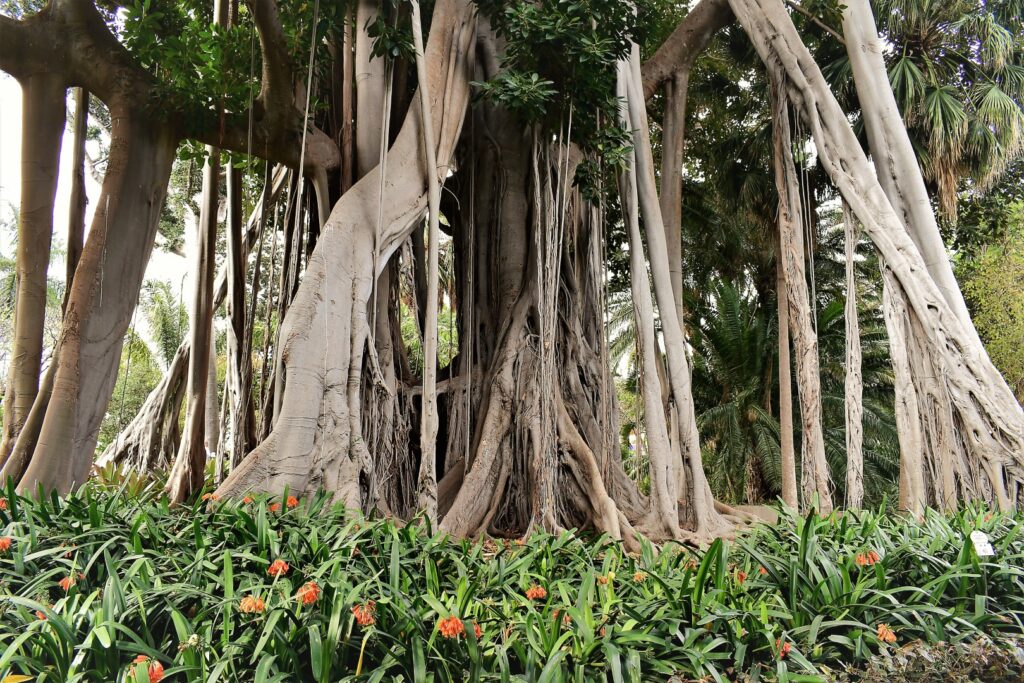
This was an interesting tree from South America as when the tree canopy spreads out individual branches will drop down new trunks to support it and it ” walks ” outwards .

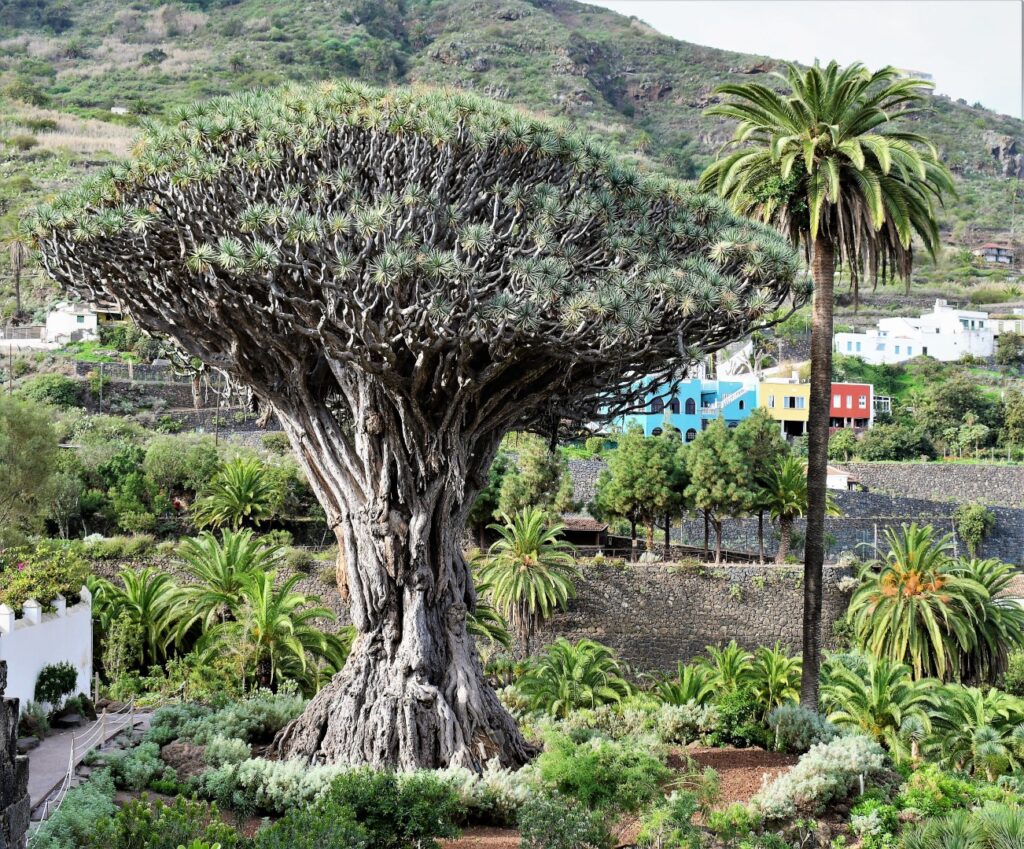
Now this is a fern !
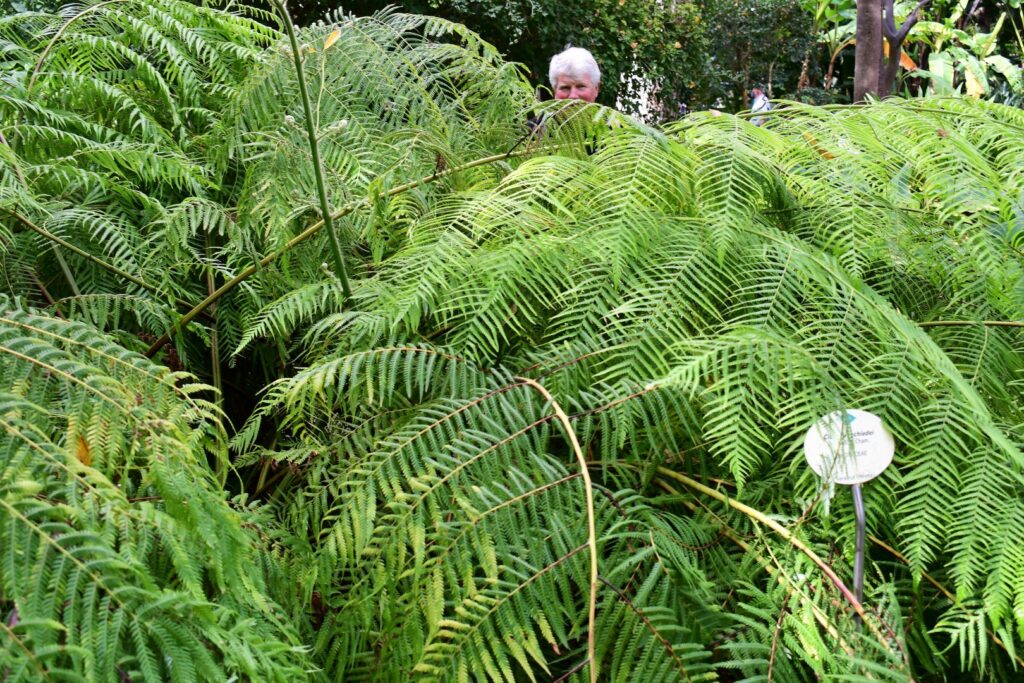
Tenerife above all has Mount Taide , the highest mountain in Spain and when it last erupted in 1909 the lava flow obliterated the entire town of Garachico … magnificent scenery in the Mount Taide National Park and the only place on the entire island that felt real to me and not Las Vegas’s honky tonk cousin .
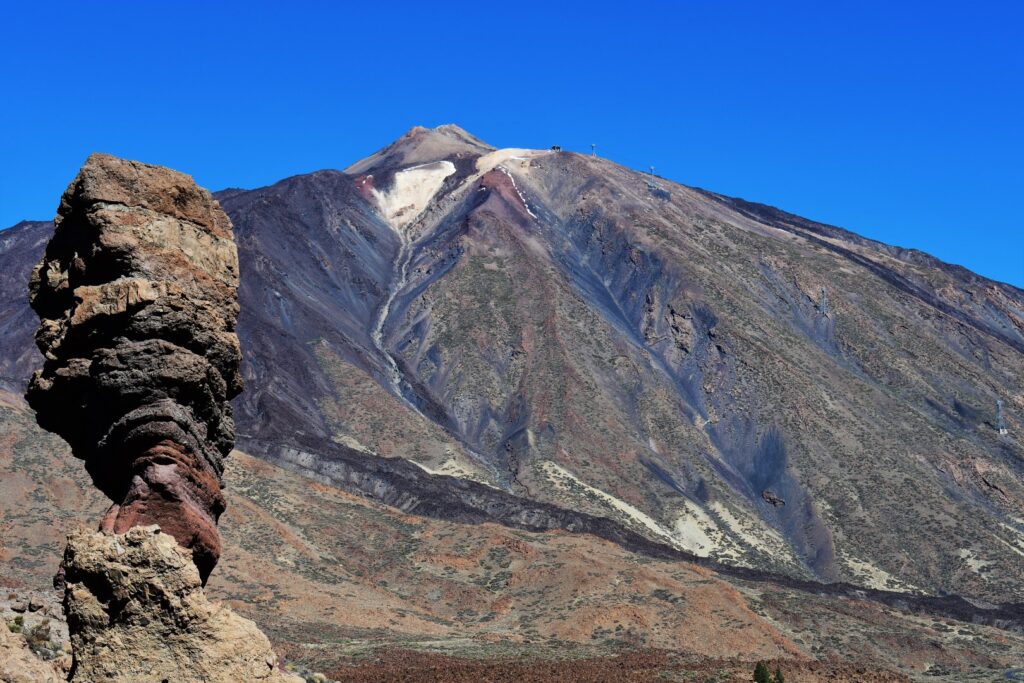
War in Ukraine February 2022
Snezana and I worked for twelve years in Bosnia and saw at first hand the horror that war brings , the loss of life and the refugees on the road either fleeing from the fighting or expelled as a result of ethnic cleansing and who thought that after Srebrenica and the siege of Sarajevo in the 1990’s that we would see another war in Europe ?
Just as not all Serbs were responsible for the policies of Milosovic equally not all Russians are responsible or support what Putin is doing now but what he has done is unforgiveable .
Snezana spent four years in Kiev with the EU and and another four years in Eastern Ukraine with OSCE on the front line in Mariupol and it is unbelievable that Putin has put women and children cowering in bomb shelters in this day and age and you would like to have thought that the world has moved on from one Leader’s megalomania .
March 2002 Spring is coming beware & prepare for slugs !
The poor old RHS , Royal Horticulture Society, got it in the neck recently when it made headlines about how gardeners should no longer class slugs as pests … they might just have got away with that comment but then they added we should treat slugs as GARDEN VISITORS !
A collective howl went up from gardeners everywhere along the lines of garden visitors my arse !
To cap it all the UK Daily Telegraph wrote an editorial titled “ Gardeners slugging it out ” and said the RHS statement was like saying “burglars should not be called criminals but evening visitors and went on to say that biological warfare against slugs is the only method as although slugs “ may be lovely BUT NOT ON OUR PRIZE PLANTS ”!!
The debate on slugs as univited guests then spread to the letters page of the Daily Telegraph and I particularly liked this letter from a reader in Middlesex !
“ To protect our hostas we bought four Aylesbury ducks to eat the slugs and for the first time the hostas reached their full leaf unscathed – until the ducks realised that hostas were also a great delicacyand shredded every plant ”.
It is hosta time early next month and the first shoots will be popping up the first week in April with an army of hungry slugs waiting for them and if you don’t get them before they get to your hostas it will be bye bye until April 2022 … High Noon so get the slug pellets out !
New Shed in the Garden March 2022

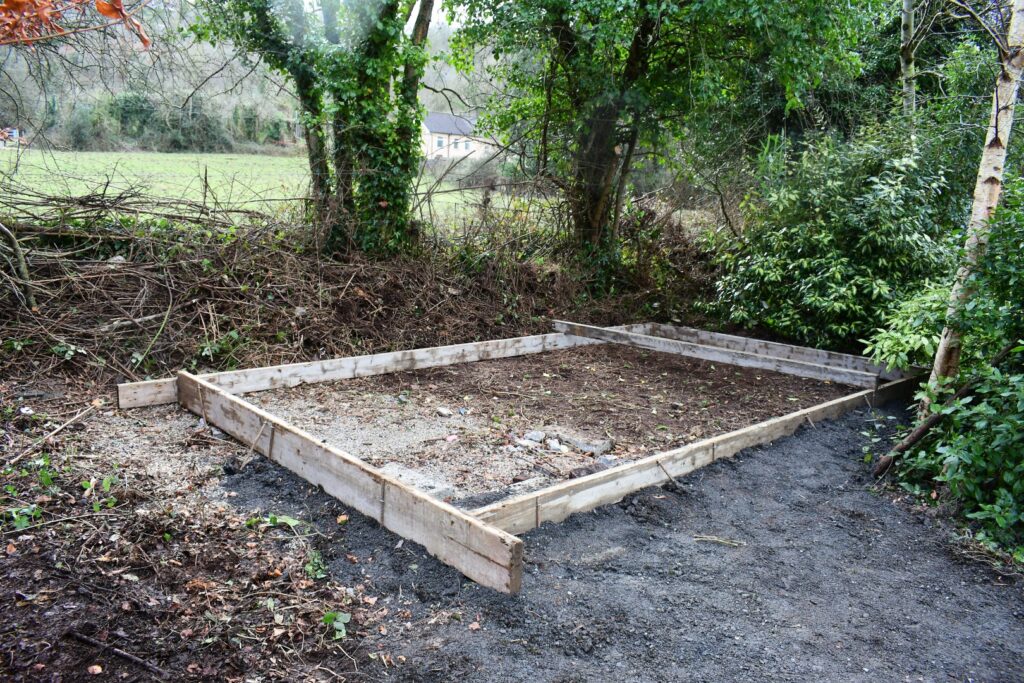
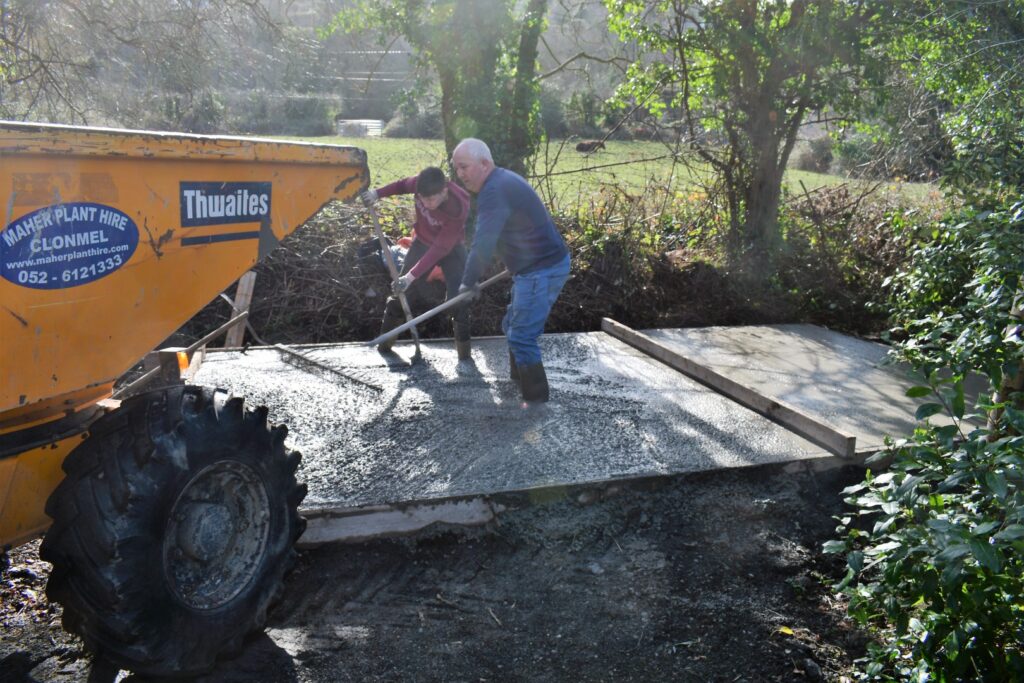
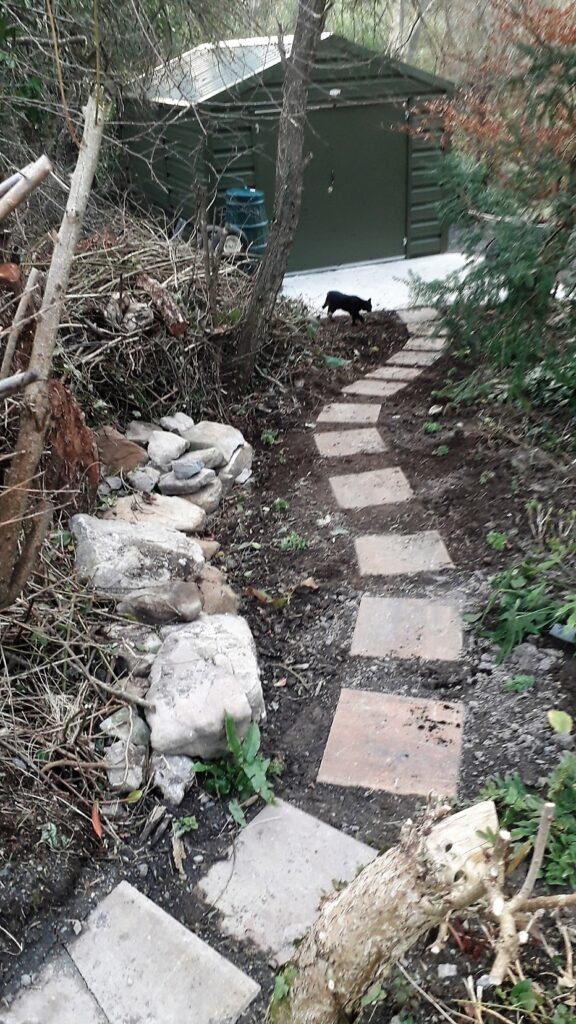
Snezana decided to clear and tidy up a small area behind where the new steel shed has earlier this month replaced the old wooden one , an area we had neglected previously but in preparing the site for the new shed it presented an opportunity . It is a small sloping piece of ground , good soil and a nice amount of sun throughout the day and the first thing was to put in some steps and then lay some paving slabs . I planted an apple tree and four shrubs , a fuschia , a physocarpus , a hydrangea , a caster oil plant plus a hypericum … all shrubs that will grow to a medium height and are fuss free yet have interesting foliage plus a flowering period throughout the summer for the hydrangea and the hypericum finishing off by adding ground cover vina minor , lamium and geraniums .
These are all ordinary shrubs , nothing exceptional or fussy , which are often neglected and overlooked but there was a method to my madness in going for these as it is an area not in your face in the garden behind a shed and an opportunity to select shrubs that will grow away without the need for great attention but yet will actually meld together very well . The caster oil plant , fatsia japonica , is the more tender as I picked a less well known variety “ green fingers ” which will be an exotic all year round shrub that should eventually grow to over five feet and beside it the physocarpus tops out at four feet and has great blue leafed foliage , the perfect foil for the glossy green of the fatsia while the hydrangea , hypericum and fuschia should be in flower for most of the summer and all can be hacked back to the ground each spring .
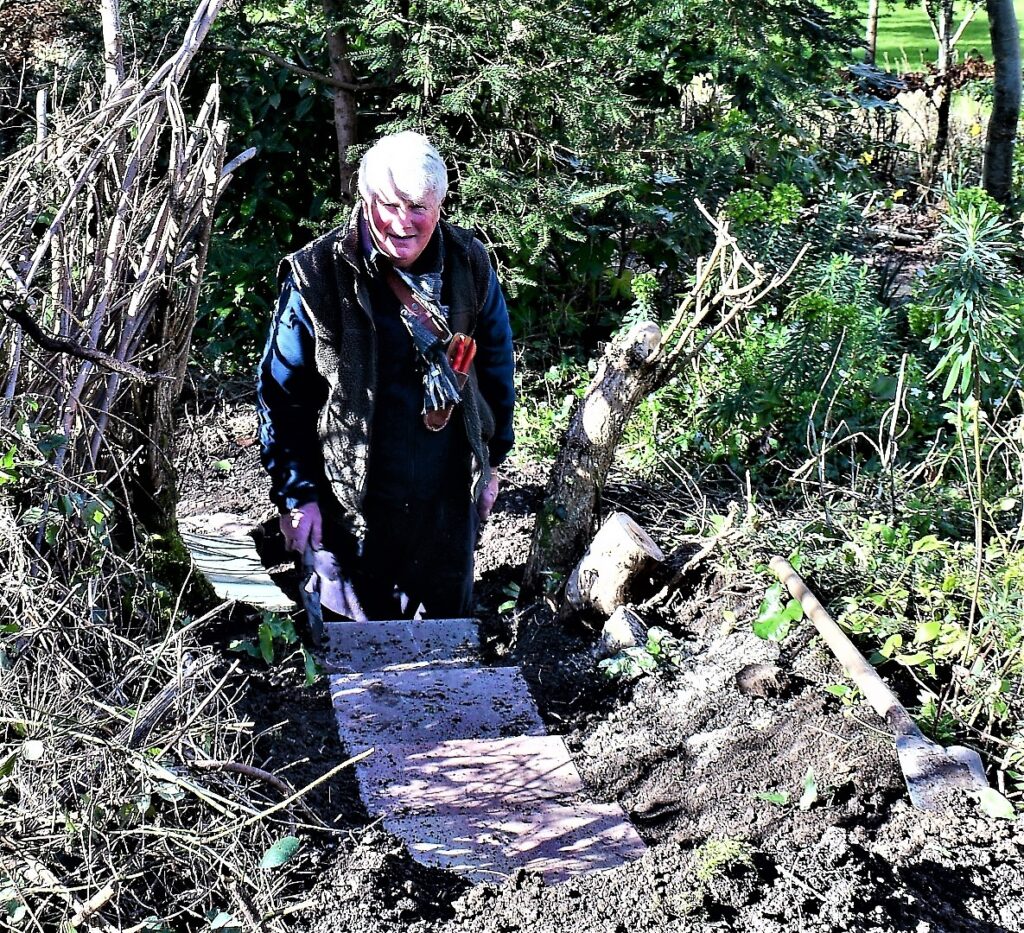
In April 2022 I added details of an article I wrote on Olive Oil
After my post in October about olive growing in Croatia and our experiences in picking the olives and having them processed at the local Mill in Podgora I was asked to write about the project by the Editor of , a quarterly magazine devoted to Mills in Ireland and the UK . The article was published in the March 2022 edition and the following extracts give a flavour .
The olive trees had not been given much individual attention for over twenty years and had gone quite feral so we embarked on a two year programme of pruning and feeding during which we didn’t get much of a crop .
We have added five extra trees since then , an olive tree takes up to six years in the ground to produce a first crop of olives but trees can live almost forever and I have seen olive trees in Israel which are over five thousand years old. We pruned the olive trees hard that first year , kept them weed free and spread organic waste under them and each year we now layer the ground with bags of sheep and goat manure sourced locally from the farmers on Biokovo mountain , smells to high heaven but pure luxury for the olive trees with the result that production has increased from eighty kilos two years ago to almost double that this year .
All Dalmatian people have olives in their DNA and anyone you speak to has an opinion and is extremely knowledgeable and helpful . One thing we have changed is the pruning of the olive trees as there is a different tradition in Croatia due to the mountainous terrain where the trees need to be hand picked and over the generations pruning has been designed to keep the trees bent low and easier to pick from a standing position but we prefer the classic Tuscany look with the olive tree growing into a nice wine glass shape and so we are pruning and training our trees to grow upwards … all the better also to drape fairy lights over the branches around an outdoor dining table !
I have always thought that dining al fresco under olive trees was the ultimate in cool and I remember back in the 1970’s sumptuous photographs in a book by Terence Conran about his house in Provence , all natural stone floors and olive trees and while my life style and wherewithal differs from Terence’s quite a bit still we have olive trees in common !
Growing up in the Ireland and UK of the late 1950’s and early 1960’s olive oil was mostly unknown in cooking or eating terms and my first introduction to it would have been with an ear ache where my Mam would have a little bottle bought in the local chemist’s shop and heated oil would be tipped with a spoon into your ear which was then topped off with cotton wool to keep it from running down your neck … olive oil for salads was unheard of in Ireland when I was growing up and we used Chef Salad Cream for salads which we considered very posh and on my first trip to Greece in 1974 I was horrified by the amount of olive oil that came on all our Greek salads and I remember once in Delphi going into a restaurant kitchen to say go easy on the olive oil only to see a black dressed Granny upending a bottle of oil onto my salad and hearing the bottle go glug glug … she gave me a look that stopped me in my tracks that said don’t mess with the Nana … I have embraced olive oil ever since !
Beautiful as sitting under olive trees is I didn’t expect the experience that harvesting your own olives brings , how involved you become , how lovely your own olive oil tastes and more to the point how little yield there is from olives as from 150 kilos of olives you get only 20 litres of oil . However we are delighted with our current yield but this will increase when the five extra young olives trees we planted come on stream .
Our local olive mill is in the lower village , a modern mill with a very efficient procedure which over an eight week period from mid October onwards works on a 24 hour basis and the entire village area is humming with both the collection of olives and the olive oil processing . As I said today’s Podgora Olive Mill is modern with gleaming state of the art machinery but attached to the modern premises is a museum with all the old fashioned equipment and mill stones , old sepia toned photographs from the early 1930’s showing the olive oil harvest in those days .
The old photographs show all weather beaten happy faces but don’t be fooled by the happy faces as olive harvesting then as now is back breaking work and a failed harvest could be disastrous for the economy of local families .Traditionally the olive oil produced was for each family’s private consumption and a small amount was sold to tourists at local markets but in the past twenty years Croatian olive oil , still mainly picked with traditional methods , has become a thriving commercial industry regularly winning gold medals in international competitions around the world .
It took us two full days to collect the olives , we hand picked every one and if an olive dropped on the ground it was discarded but having seen the quality of what neighbouring pickers included in their baskets and which they have been doing for generations we won’t be so picky next year .
Mentioning next year illustrates one of the perils of growing olive trees is that there can be an attack across entire regions of olive fly , a little black fly that burrows into the olive that can destroy an entire crop and last year for example there was no olive oil harvest throughout Dalmatia … commercial growers can spray against the olive fly but rarely in Dalmatia as olive trees are largely family owned and people there are very organically minded , don’t like using commercial sprays and it is not unusual for families to own up to 300 olive trees spread in small pockets across several locations … they are also very proprietorial about who owns what and you daren’t touch an olive that isen’t yours , very Sicilian !
Picking olives like picking grapes may sound romantic and artisan but make no mistake it is hard work with aching arms and fingers at the end of the day .
Standing around at the local olive mill when your olive processing slot is allocated is a great source of information and even with such a small production as ours you are still given the same individual attention as your neighbour with 300 trees … our first olive picking experience was magical and as olive growing virgins we were bowled over by the comraderie and helpfulness as we were welcomed into the olive growing community of Podgora and we happily stood around the mill shooting the breeze like seasoned veterans !
Family members living abroad wherever they are in the world … the Croats like the Irish have always gone abroad as emigrants … often arrange their holidays to be home in late October to help with the harvesting and this connects them with their homeland , it’s traditions and a share in the lovely olive oil as like with every produce your own home made tastes much better .
This year at the Olive Mill we met local people home on holidays from work in Germany , Austria and Holland , back to help out for the harvest and learnt that even though you might have 300 trees it depends on how young and fit you are to properly look after the trees throughout the year as this will determine the amount of olives you collect as trees that are not looked after quickly become feral with a thicket of branches and will be difficult to pick from and the yield will be much much lower .
Arriving at the the Mill , the olives are weighed and then when your time slot arrives they will have cleared through and cleaned the machinery after the previous customer so there is no mixing of olives and your crop is tipped into a holding cage where it is sieved and power washed for any leaves or bits of branches attached , next the cargo moves through a centerfuge type washing system and after that the olives including the stones are ready for crushing with the entire procedure taking about an hour . Finally the oil starts to flow , a great moment when the first oil comes out into the pan and from there fills into your 20 litre plastic containers …none of your fancy Provence type containers in Dalmatia as olive oil production is a no nonsense event , one they have been doing without fuss or dressing up these past thousand years and one on which most families harvest perhaps 300 litres of oil for their normal consumption . We with our expected 20 litre harvest had turned up with suitably designer type five litre dark glass bottles only to be advised by the locals to ditch these and opt for the more practical plastic 20 litre containers they all use .
We picked the olives this year over a two day period on 17th /19th October just two days after the Olive Mill opened for the season , which is considered an early harvest just when the olives are at the green stage about to turn blue/black , when the olives are blushing as they say locally, as this provides the healthiest and the most flavoursome olive oil , we store them in crates after picking as this prevents the olives from crushing and ideally the olives go to the mill at the most 48 hours after harvesting …any later and the olives need to be stored in water .
It is intensive back breaking work as we hand pick all the fruit , no whacking or raking of branches and up and down ladders like yo yo’s … we have only twelve trees so I can only imagine the effort that goes into hand picking 300 trees … after a few hours the novelty of picking your own olives goes out of it and it becomes pure slog and one’s thoughts drift towards a chain saw for next year but when it is all over and you see YOUR olives being washed and crushed at the mill and that magic moment when the first golden liquid pours out and when you get home that first taste the same day with crusty bread dipped in a saucer of the new olive oil … well it is magical … roll on next year again !
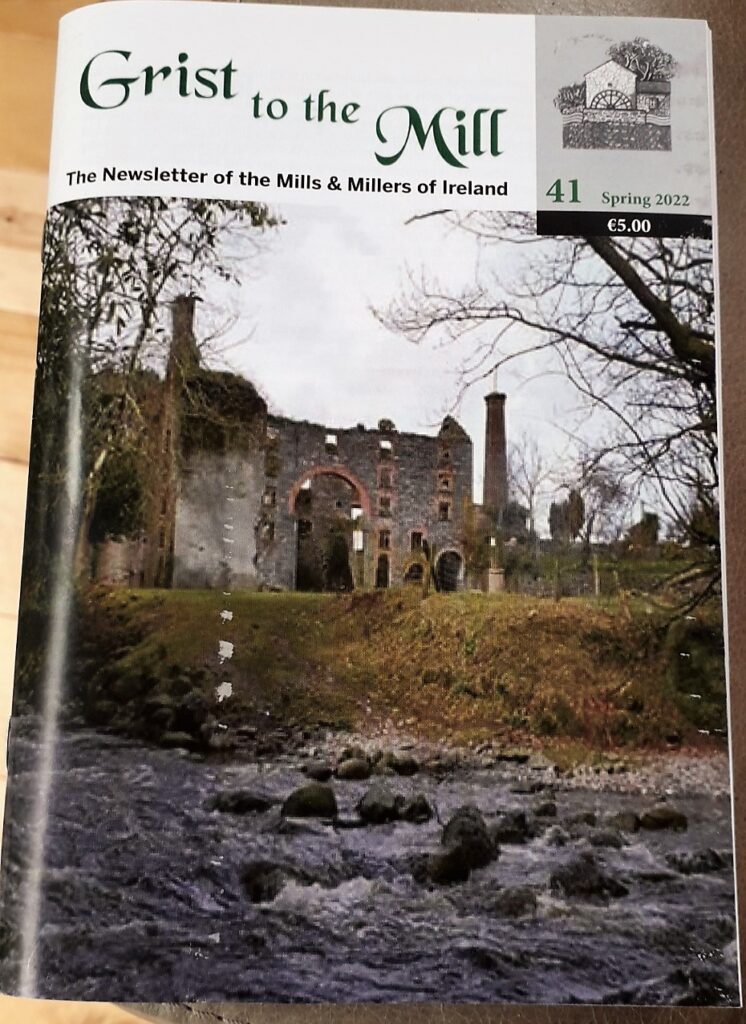
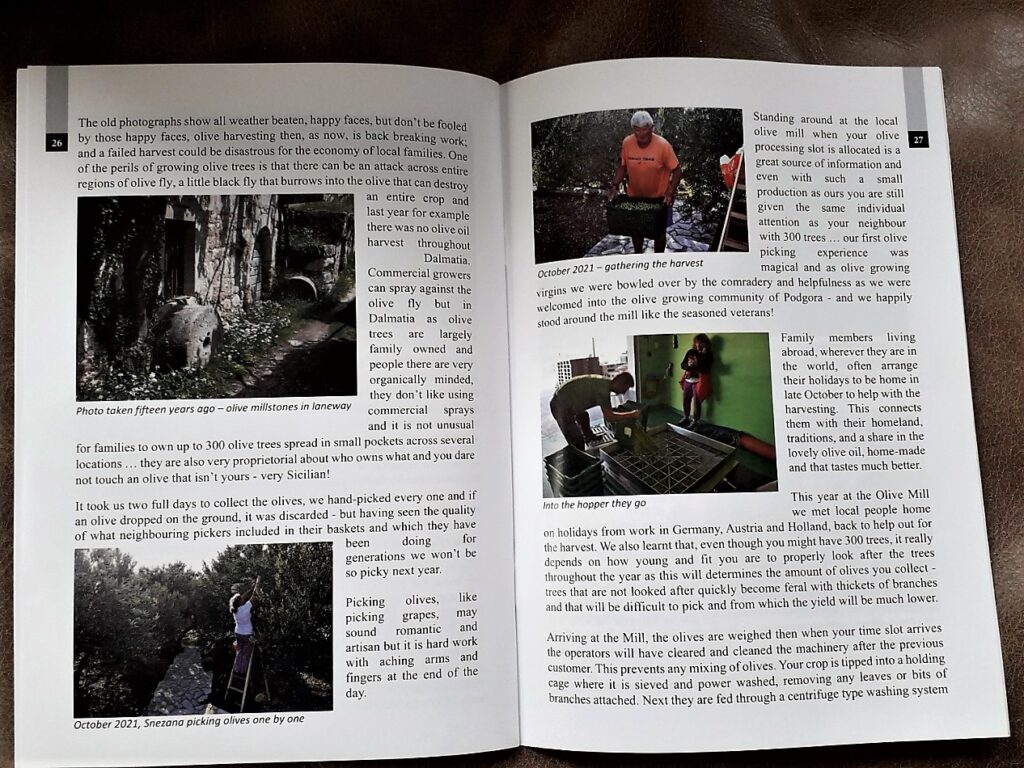
In May 2022 I wrote about a favourite tree , the purple hazel , corylus and the large shrub / small tree , Viburnum opulus or snowball tree
Another tree beloved of gardeners especially in the UK is the hazelnut or Corylus both for the nuts but more often because it can be coppiced every five years and the long branches which grow straight and narrow and are used for staking in the garden which is a big British gardening tradition for their long borders . We grow the blue leafed hazelnut here as the leaves are more blue than copper beech and bigger but for some reason perhaps because of it’s dual use for nuts and coppiced branches it is a very undervalued tree for garden impact and it hardly ever features on garden writers “ Ten best trees ” . All great British gardens have a “ nuttery ” tucked away somewhere , the most famous being at Sissinghurst and these are coppiced to the ground every few years but although we have the space and crucially the deer don’t eat hazelnut trees , I enjoy and use them as single specimens in various areas throughout the garden .
A lot of gardeners regard May as a waiting period , a limbo in the garden’s growth before that huge infusion of colour in June and July … not for me as flowers are not a priority , my gardening philosophy is more leaf and structure but don’t think I am against perennial flowers , I like flowers but they are not my first objective in a plant or a shrub and I never buy a tree or a shrub just for the sake of it’s flowers .
There are always exceptions of course and while I would never buy a cherry blossom tree for example gorgeous and all as they are in flower , blink and you’ve missed it as the flowers are there for two weeks … and then a nondescript tree for the remaining fifty weeks of the year but a tree I would always include is the Viburnum opulus better known as the snowball tree which is a show stopper in the garden when in flower but also has a nice structure and leaf for the rest of the year … but the snowball shape flowers alone are worth having even for those three weeks of flowering .
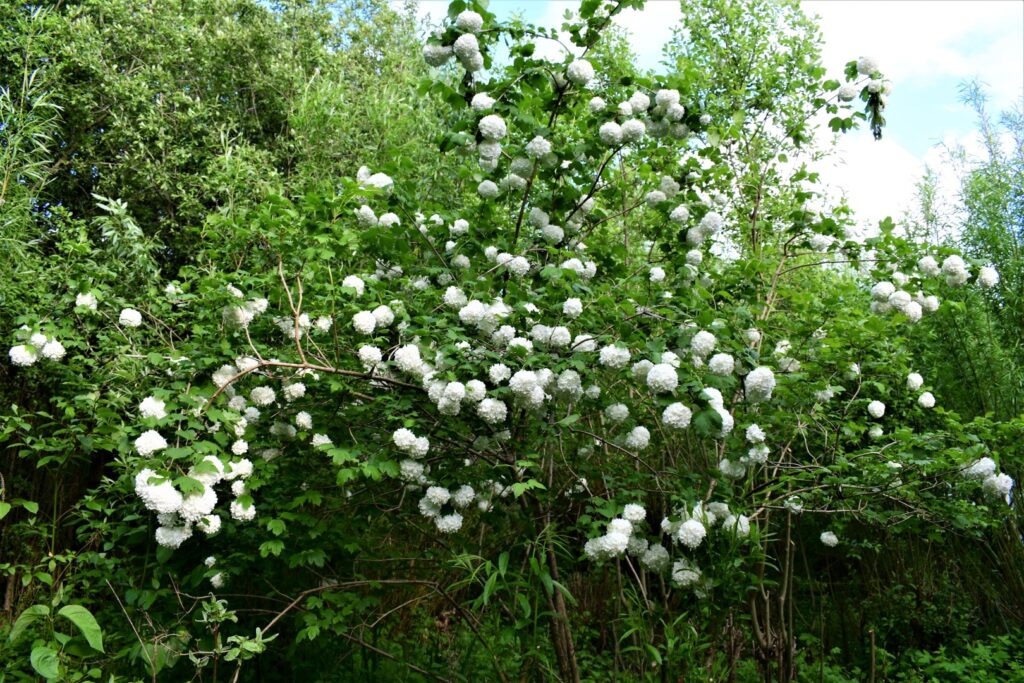
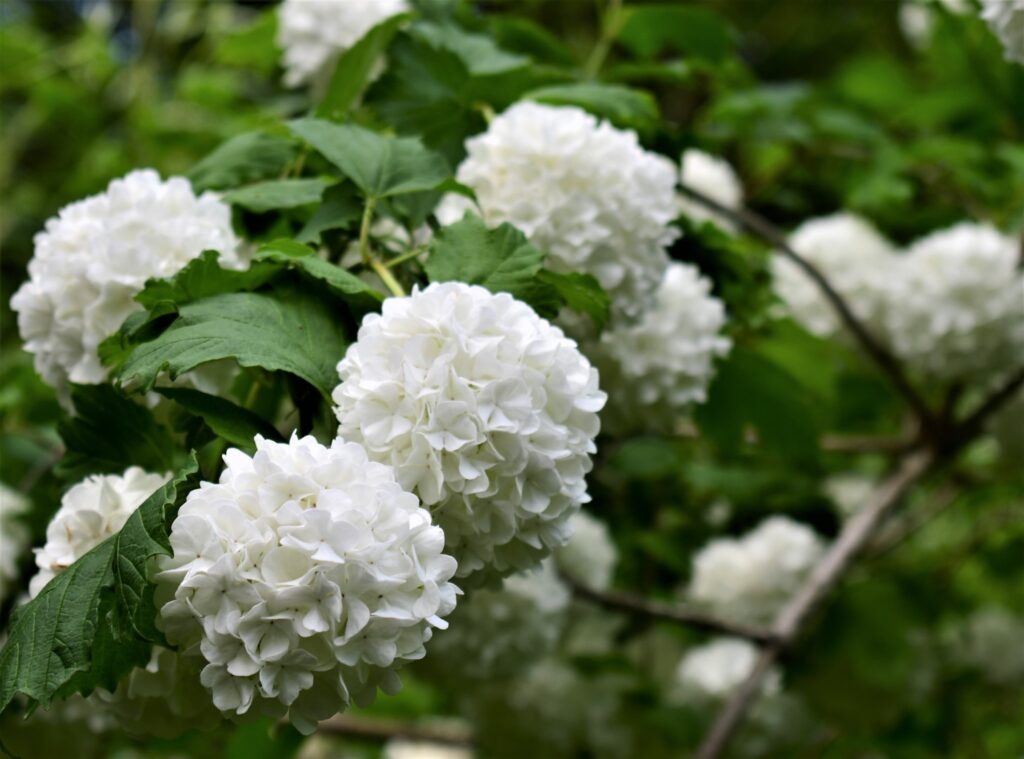
And the Chelsea Flower Show May 2022
Now that Covid has become manageable the month of May means the Chelsea Flower Show which the BBC gives terrific coverage to with Monty Don and Joe Swift presenting highlights every night for it’s five days . Monty is of course marvellous totally without ego in his presentation style and while I can tolerate Joe Swift , just about , it is still all about Joe Swift and not the Chelsea Flower Show and apart from Monty Don all the other BBC presenters are the same … Rachel de Thame is great and down to earth and again no ego but Carol Klein is a real pain and while no doubt a real plants expert , tries too hard to be full of bonhomie which to me is totally false .
I am not saying the medal awards at Chelsea are predetermined but it is easier for the experienced gardeners to win rather than an outsider or someone with their first garden at Chelsea . The famous medal winners such as Chris Beardshaw ,Sarah Eberle and Andy Sturgeon who between them over the past fifteen or so years have won over 33 gold medals and over eleven best in show garden awards and these designers not only attract the wealthiest sponsors … a show garden can cost from 500,000 euros to a million to stage … so they can have better trees , hard landscaping etc. but also they are so experienced at Chelsea they know what the judges want in a gold medal winning garden and they deliver just that and for example both Beardshaw and Sturgeon got full marks for their garden this year at Chelsea .
All the designers say that they design for themselves but I am sure they are influenced in their design by what they know the judges will award points for .
The judges set out four categories with a total of 36 points up for grabs and they are looking for absolute perfection especially in the award of a gold medal .The criteria they are looking for starts with the garden’s initial selection for Chelsea then covers design . concept , originality , layout , construction and planting and you have 19 days to build the garden in the Chelsea grounds and then the garden is allocated either excellent ( four points ) , very good ( three points ) , good ( two points ) , poor ( one point ) across the categories so to get maximum points of 36 you really need to have the experience to give the judges what they are looking for and everything has to go right for you on the day , the plants have to be in bloom with absolutely no room for the slightest chip of a rock or a paving stone .
Is it a fix for the gold medals , no definitely not , British upper class sense of honour would not allow that but it is pretty incestuous at that top level !
The BIG theme this year at Chelsea was rewilding and the Best in Show was won by Lulu Urquhart and Adam Hunt with their garden called “ A Rewilding Britain Landscape ” complete with upmarket Cotswold type casual and fake untidiness and a large dam with beavers … naturally the beavers didn’t make it to Chelsea , next year there will probably be robot beavers at Chelsea … to be honest you wouldn’t give it a tin medal at the Clonmel Flower Show and in fairness Monty Don asked the question “ can it be classed as a garden ” … enough said !
In case you missed it , Abba new avatar show opened in London on May 22nd so you can forget your Led Zepplin and Beatles records I am sticking with my 1982 copy of Abba Gold !
Abba said it best … Rewilding That’s the name of the Game !
Croatia in May 2022
Croatia again for a few weeks in early June where the garden was suffering under 35 deg of heat every day leaving the soil parched . Luckily I have now got the weeds under control in the gravel garden which used to be a back breaking job to clean but now a quick run through it with a hoe does the trick . Last October I laid two paths with a six inch layer of pebbles taken from the beach and every trip now I top it up with fresh stones and I feel the depth of stone together with the sea salt leaching down through to the top soil has killed off a lot of the perennial weeds .

I planted up these terracota pots in October 2021 on the balcony in Croatia with a selection of drought resistant cacti and between them I added the blue trandiscantia for colour , they have thickened up and come through the winter well . The pots I bought in a local Makarska hardware supermarket and while they fit in and look well they are the usual Vietnam mass produced and nothing out of the ordinary .
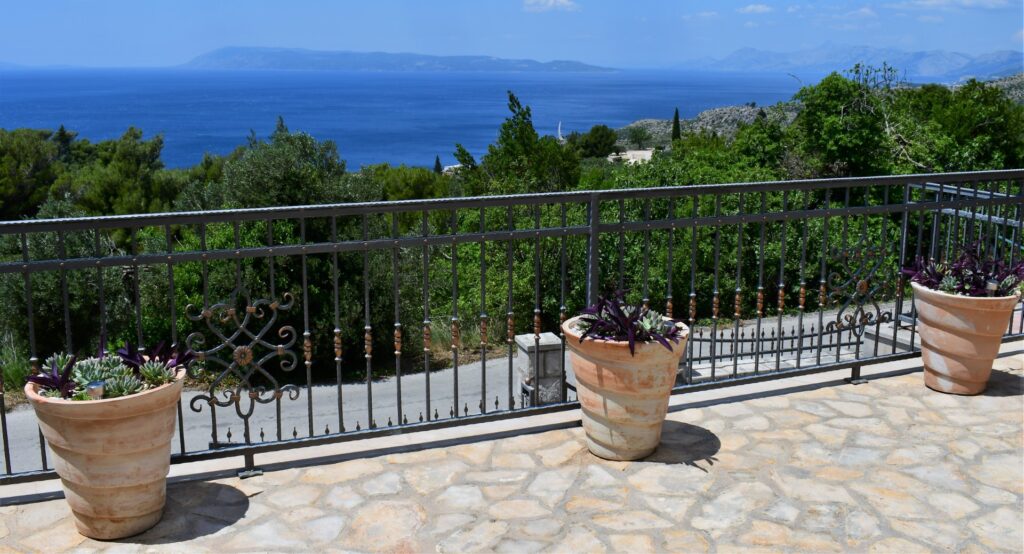
However these pots are something special !
A local friend , Mate , made these pots for me out of old terracotta roof tiles , great recycling and gorgeous to look at , I placed them in the gravel area and planted with aloe which don’t need regular water … now I have to think of a way of getting some more of these pots back to Ireland !
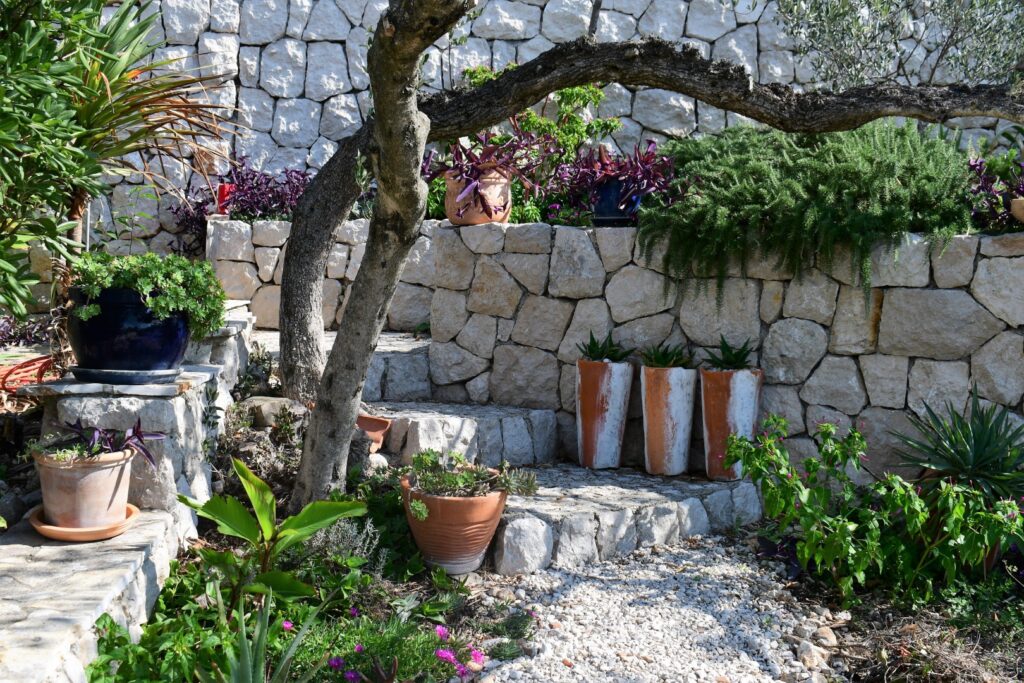
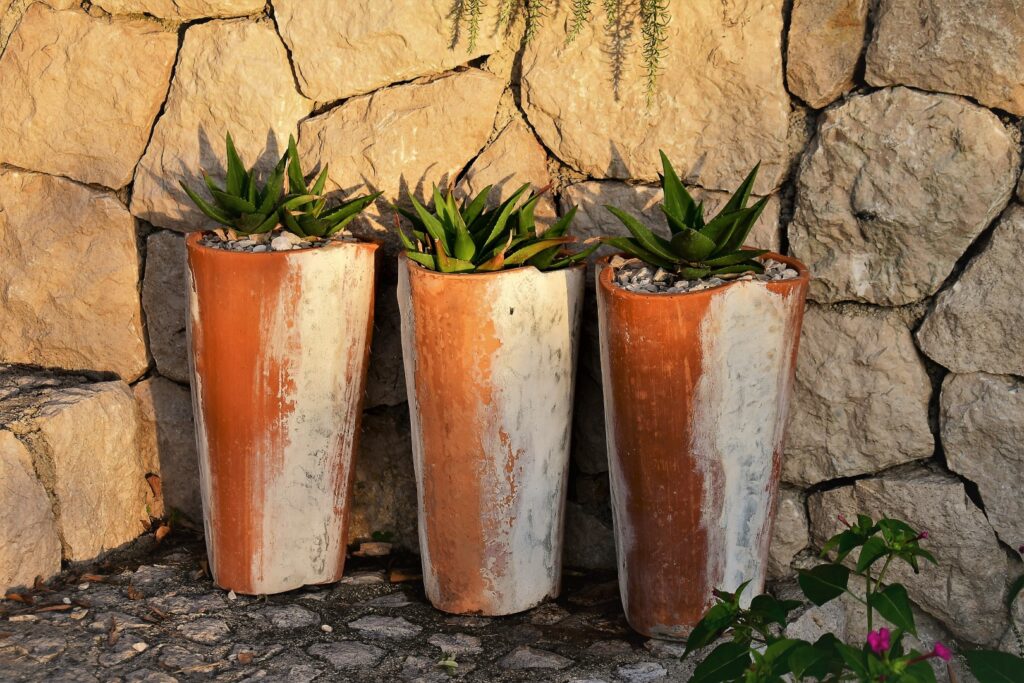
And believe it or not this replica life size Easter Island Statue was for sale at a Wexford Garden Centre in March 2022
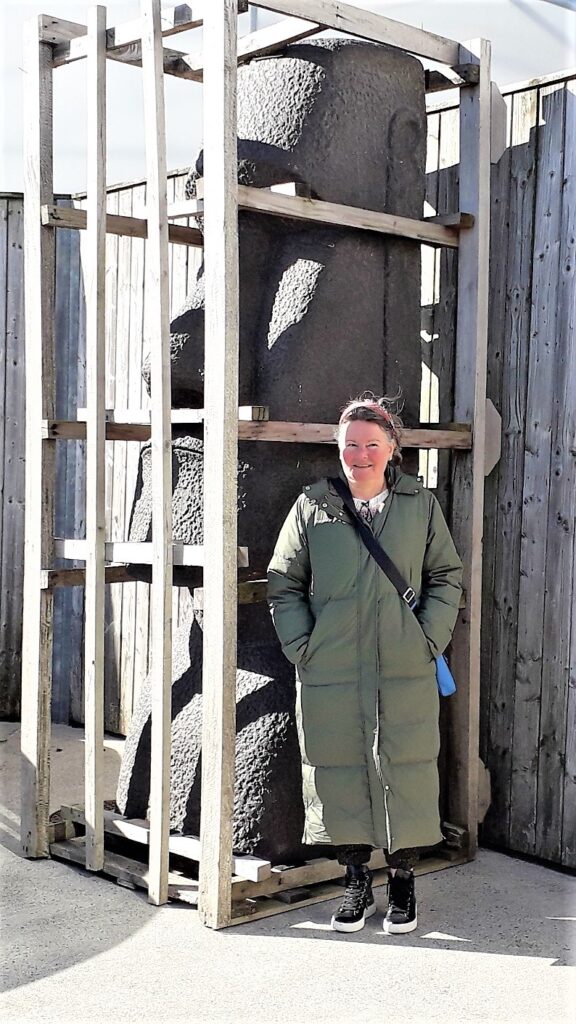
I wrote about the passing of Dervla Murphy , the great Irish travel writer in May 2022
Dervla Murphy , the great Irish travel writer and eccentric passed away last Month at the age of ninety . Dervla for Irish people was a national treasure who travelled all over the world on her 3 speed bicycle in journeys of up to nine months and wrote over 25 books about her experiences .
Can you imagine walking across the mountains of Peru over a period of nine months for 1200 miles … with a mule to carry a tent , essential supplies AND a daughter of eight years … Dervla did it in 1983 , an amazing experience and wrote a book about it “ Eight feet high in the Andes ” .
The New York Times in their obituary described Dervla as “ A curious, intrepid loner from Ireland, she famously went from Dunkirk through Europe and then to Iran, Afghanistan, Pakistan and India — mostly on two wheels.”
In 1992 I was on my way back to Rosslare after a six day cycling trip in Cork / Kerry and had stopped to take a photo outside Lismore in Co. Waterford when a woman out for a walk stopped and asked me some detailed questions about my touring bike , my panniers , how many gears etc. and how far I had come that morning and as I was airly saying that I had set out from Cork City a few hours ago and was now pushing on over the Knockmealdowns to Clonmel and then on to Rosslare and that yesterday it was Killarney to Bantry with an overnight in Cork and and and and … when the lady says I used to do a bit of cycling myself … it slowly dawned on me “I have just been showing off to Dervla Murphy haven’t I ” and she grinned and that was how I first met Dervla Murphy !
Dervla wrote one of the best books about travel through the Balkans called Through the Embers of Chaos , Balkan Journeys which she wrote in 2001 about a trip she took on a bike from Zagreb to Albania and I knew the route she took as my job for fifteen years with the EU was to travel all across the Balkans and I take my hat off to her as driving on some of these roads let alone cycling was heavy going not to mention dangerous with all sorts of characters floating around just after the Yugoslav wars … one tough lady .
A few years ago after Dervla published her two last books in 2015, Between River & Sea and A Month by the Sea , based on her experiences in the West Bank and Gaza I wrote to her and later met her when she gave a talk about Palestine in Clonmel .
A few years ago after Dervla published her two last books in 2015, Between River & Sea and A Month by the Sea , based on her experiences in the West Bank and Gaza I wrote to her and later met her when she gave a talk about Palestine in Clonmel .


Dervla fell passionately in love with the Palestinian cause and while her beliefs would not be mine she was as always fully committed and Between River and Sea, her last major work , is a great informative read .
All the major newspapers around the world , The New York Times , Daily Telegraph , The Sunday Times , The Guardian carried her death and printed obituaries , a fitting tribute to an unassuming woman from Lismore who left formal education at fifteen .
In praise of hydrangeas in July 2022
I have ONE hydrangea that is the envy of my gardening friends , one which thrives every year and from which I have to supply lots of cuttings to friends who want to replicate it in their gardens and ironically I only grew it in the beginning for it’s purple / black stems which almost glow in winter . I don’t know it’s name but it has stunning flat head blue flowers which is what all our visitors rave about but for all the cuttings I give away , none reproduces the blue flowers and obviously the colour of the flowers are influenced by the soil in that area of the Lower Wood which has a lot of copper in the wettish conditions and my friends gardens are usually on good soil where the cuttings sulk and produce ordinary colours … actually I feel quite smug about that as while you want the cutting to thrive for others but you secretly want the plant to perform only for YOU !
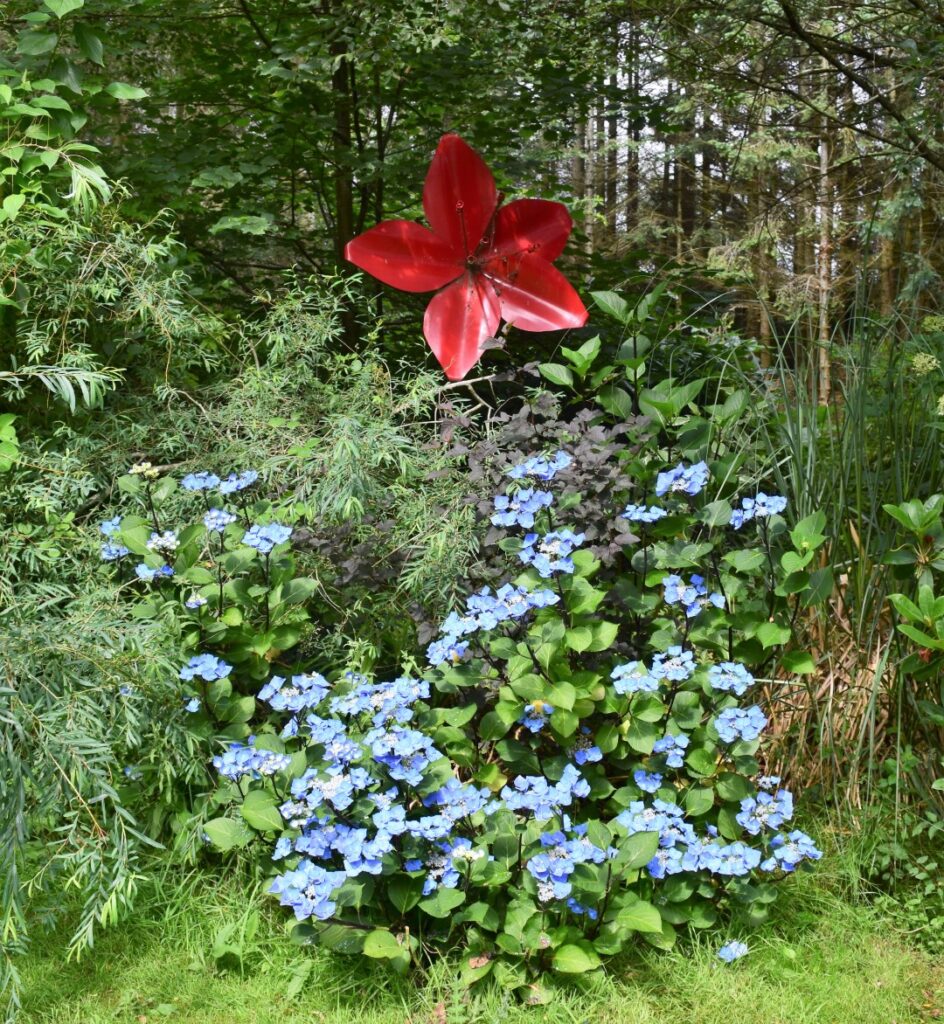
Which reminds me of one of my favourite writers , Gore Vidal , who was famously bitchy and the title of a recent biography about him by Jay Parini summed him up perfectly “ Every time one of my friends succeeds something inside of me dies ” !
It is a unique hydrangea and a few years ago a Dublin based photographer visited the garden here to take some general garden photos for a magazine article and I gave him the guided tour where he took all the stock photos you would expect with polite murmurs of appreciations of the wildness , the colours , but when he came across this hydrangea he lost all the cool and became hugely engrossed , setting up tripods , light umbrellas , various lenses … and spent an entire four hours photographing this one hydrangea with me ferrying cups of coffee down to him at intervals as he was totally engrossed in getting that one shot and again it was the colour of the flower that fascinated him … he got a nice result but for me it is still the purple stem in winter that fascinates !
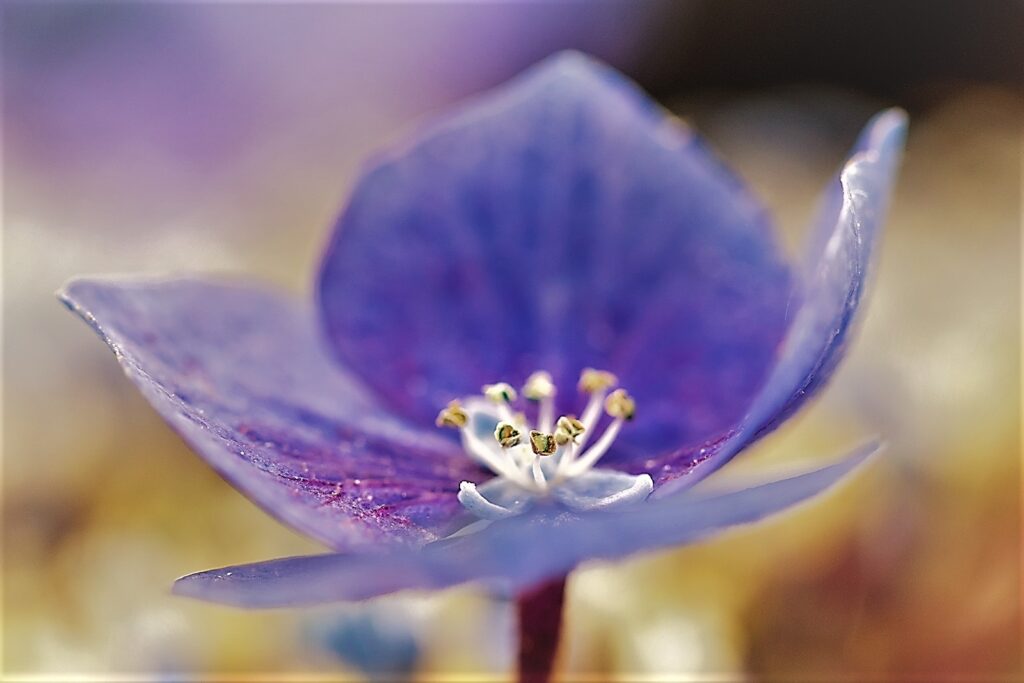
Ukraine memories for Snezana
The obscene war that Putin has caused in Ukraine shows no sign of letting up and I don’t know how the average Russian can sleep easy at night knowing the suffering and loss that is being caused on a daily basis in their name .
Snezana worked for one year in Kherson and three years in Mariopol travelling daily across the front lines as a Team Leader with the OSCE Mission to Eastern Ukraine monitoring the cease fire and at that time no one had heard about those cities but now they are as famous as Stalingrad and Leningrad were in in the Second World War .
She never discussed with me the danger she was in Eastern Ukraine as she knew I would have insisted that the job was not worth life and limb and although I knew she was on a UN danger money daily rate I did not realise the risk however over dinner last week with my son , Kevin , a military man , she told us about an incident that showed how lucky she was to come home in one piece .
Her team of five in full body armour , with an American and Russian military officer and an army medic on board their armoured vehicle near Mariopol in a No Mans Land area … a tense situation inside the vehicle as they were gathering information on shell craters and the various militia in a no man’s land area between Russian and Ukrainian lines and it was about to get even more tense .
Their vehicle was prevented crossing back into Ukrainian territory at a crossing point where they were confronted by a Donetsk separatist militia guy , nineteen years old in shorts and flip flops who was shouting and out of control on drugs or drink … worse he was standing on the back of a home made pick up trailer with his finger trembling on a huge calibre mounted anti aircraft type cannon which was aimed directly at their car from a distance of five metres … Snezana in the front seat asked her driver , an Austrian military officer “ will we be protected in this vehicle ” to be told very quietly that the rounds would cut them in two and that “ we are dead if he shoots ” .
She decided that if they were to die she would prefer to be outside the car and got out and approached the separatist who by now was incoherently shouting at them and aiming the gun on the front driver’s seat … she explained that they were there at this crossing point by permission and nothing would be solved by shooting them when suddenly he shouted to get back in the car and drive before he changed his mind .
What changed his mind about shooting up the OSCE patrol ? Snezana who is an Orthodox christian was wearing outside her uniform a Byzantine Orthodox Cross and most likely that the Orthodox Russian separatist recognised a fellow religionist and let them go .
A week after she left Mariopol for good in 2017 Snezana’s team drove over a land mine in the buffer zone between Russian and Ukrainian forces , the armoured vehicle was destroyed , all the team were badly injured and their medic was killed .


August 2022
We had drought conditions in Ireland for two weeks in August with once in fifty years temperatures of 30 degrees daily and while everybody flocked to the beaches to cool down , our poor gardens suffered especially new plants and those in pots . It made me realise that those plants we stick in pots which when you think about it is artificial and not something nature does and those poor plants are really our prisoners , totally dependant on us … we had an emergency system during the drought where we watered the plants both in pots and in the ground around the immediate front and back garden every morning for over an hour especially those shrubs planted in the Spring as for their first year these plants only have the root ball they are grown in for sustenance as their roots haven’t had a chance to spread out and anchor into the soil … however a bucket of water over a young drooping and wilting hydrangea will have a dramatic effect and help bring the shrub back from the dead .
The Purple Loosestrife have had a dramatic growth throughout all our water areas this year and the plant has been grown in wetland areas for thousands of years and was a favourite plant of the Celts who used it for medicinal purposes as ground down it relieves headaches hence the name LOOSE STRIFE however if you were a woman in Western Europe during the Middle Ages and knew and used plants like loosestrife for healing purposes you could be accused of witch craft and burnt at the stake by vengeful church authorities .

Nature has brought it in to our garden and over the years it has colonised the stream and throughout the Water Garden by self seeding . The plant after flowering retains a stiff architectural structure and I only cut it down in areas if it is impacting on it’s neighbours , we love it and I would class it along with wild astilbe as one of the best wild self seeds … I have bought loosestrife , lysemachia vulgaris , as a commercial plant but it has never flowered like the wild version .
Why are you buying that was Snezana’s query at the Clonmel Garden Centre recently as she saw I had added three stachy’s byzantium to our trolley … stachys comes from Armenia and Iran and is commonly known as Lamb’s Ears is a loved and old favourite cottage garden perennial which given the right conditions will spread out as a terrific ground cover plant which keeps it’s leaves all year round . I understand why some would question stachys because most people leave it flower and it has a nice yellow flower bract but the problem is that after flowering the stachys becomes straggly and awful whereas if you grow it purely for ground cover and keep the flowers clipped then there is none nicer than stachys . These three specimens are for the water garden area where I have unexpectantly found that stachys does really well in the heavy clayey soil although I do back fill each planting hole with a bucket of compost to get it established .
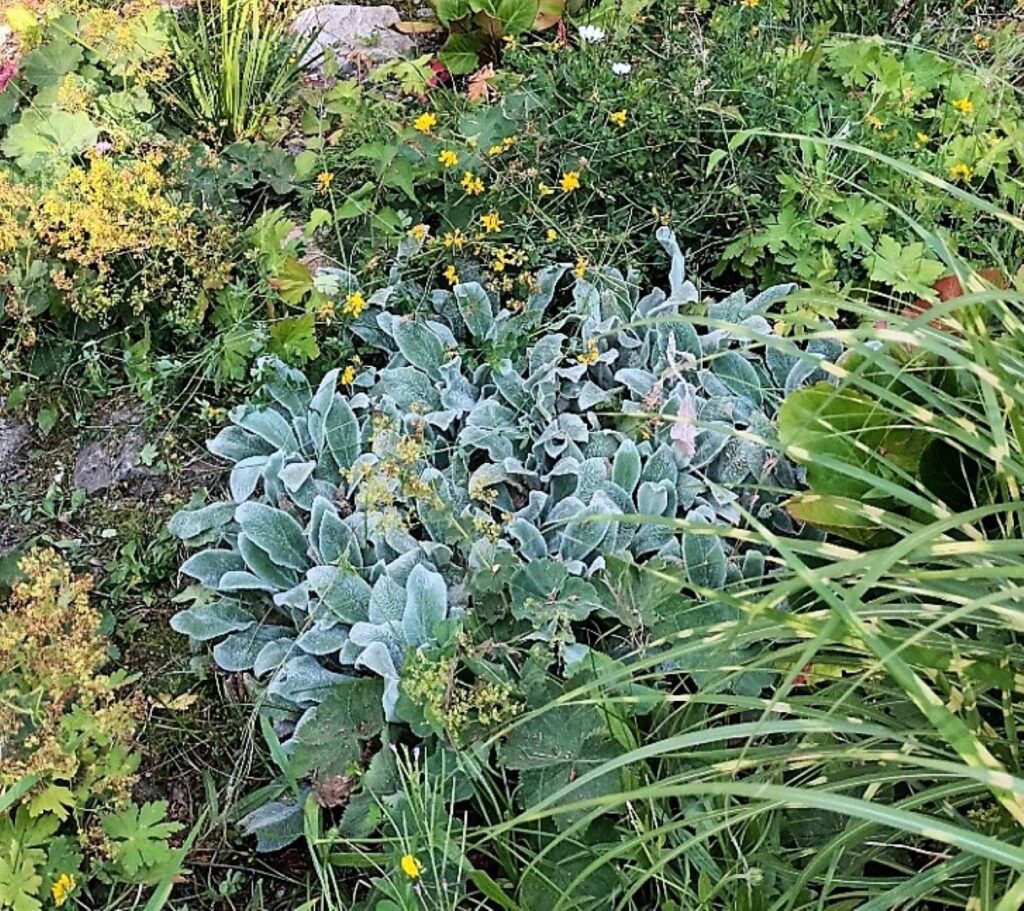
Visit to Cashel Palace Hotel .
Originally built in 1732 as the Bishop of Cashel’s Palace on the slopes leading up to the Rock of Cashel which was the seat of the Kings of Munster since the 10th century , donated to the church in 1101 AD and the famous Cathedral and St. Cormac’s Chapel were built in 1230 AD . There was and still is a gate leading from the Bishop’s Palace garden directly to the Rock and at all times in the garden the Rock of Cashel is visible .
From the entrance with it’s beautiful terrazzo type paving ,which goes on paths all around the garden ,to the fabulous interior no expense has been spared and the overall effect is amazing , a house fit for a King not just a Bishop !
The former Cashel Palace Hotel was bought by the Magnier Family in 2015 who gutted and restored it to it’s current glory , no money was spared on the fabulous restoration down to the last detail . I had heard that the gardens had been given a total makeover by a leading UK garden design firm so we headed over for afternoon tea in early August and a wander around both the hotel and the gardens .
The restored Palace only opened as the Cashel Palace Hotel in March this year after a five year make over from top to bottom and we were given a guided tour of the interior by Sally , the Hotel Concierge , who filled us in on all the details… we had been there once before about twenty years ago when it was dark and quite run down and the contrast now is like night and day .
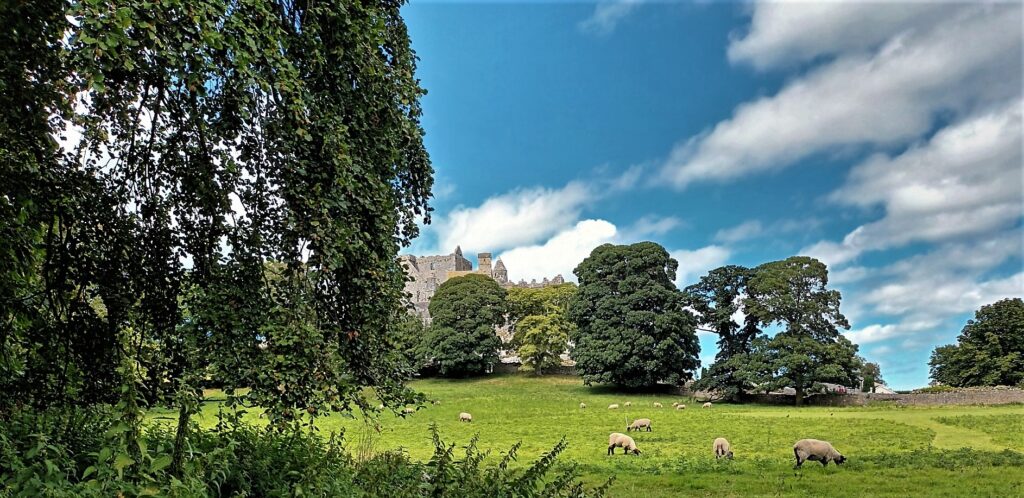
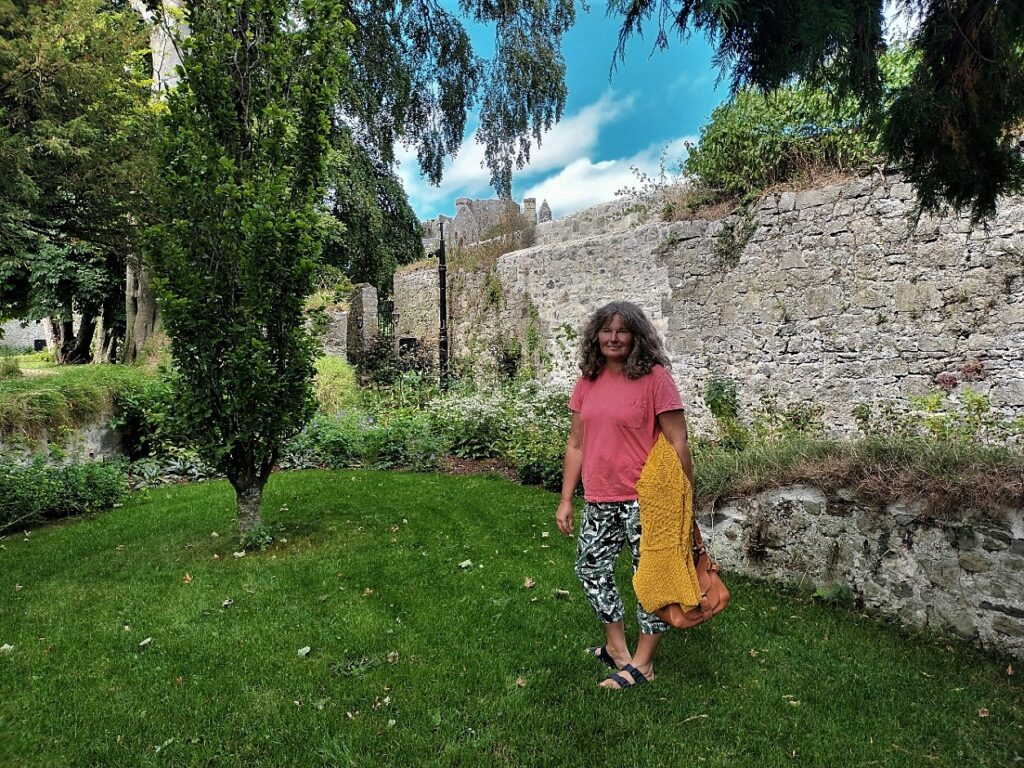
Sad to say for me the garden was disappointing and it appears like the planting in the borders was just thrown together in a rush for instant impact with far too many hydrangeas of the in vogue Annabelle and limelight varieties and the rest is just filler type alchemis mollis and geraniums for ground cover … nothing special . However this is just the first year and both Brexit and Covid have meant that a lot of specialist plants are just not available in the required quantities as a garden this size would require and I am sure that seeing the quality the owners have demanded for the interior of the hotel that over the next few years the garden will match that high standard also but for now the verdict for the grounds of the Cashel Palace has to be a “ could do better ”.
Olive Oil in Croatia September 2022
I love the olive trees for their look and while I also love the oil they produce , the crop for me is secondary to the overall effect of having olive trees in the garden at Gornja Podgora but for the practical local people ( and for Snezana ) this is heresy as the olive trees are there purely for economic reasons . I mention this as I know that to maximise the crop we need to cut back the trees hard and reduce the branches drastically which means that not only will there be hardly any fruit for two to three years but the olive trees will look like stick insects during that time … Snezana of course is itching to be let loose with a chain saw so a compromise is agreed where we will make a small cut back every year and even that hurts me and while discussing this with a local friend he said “What you need is a man with a cold heart ” !
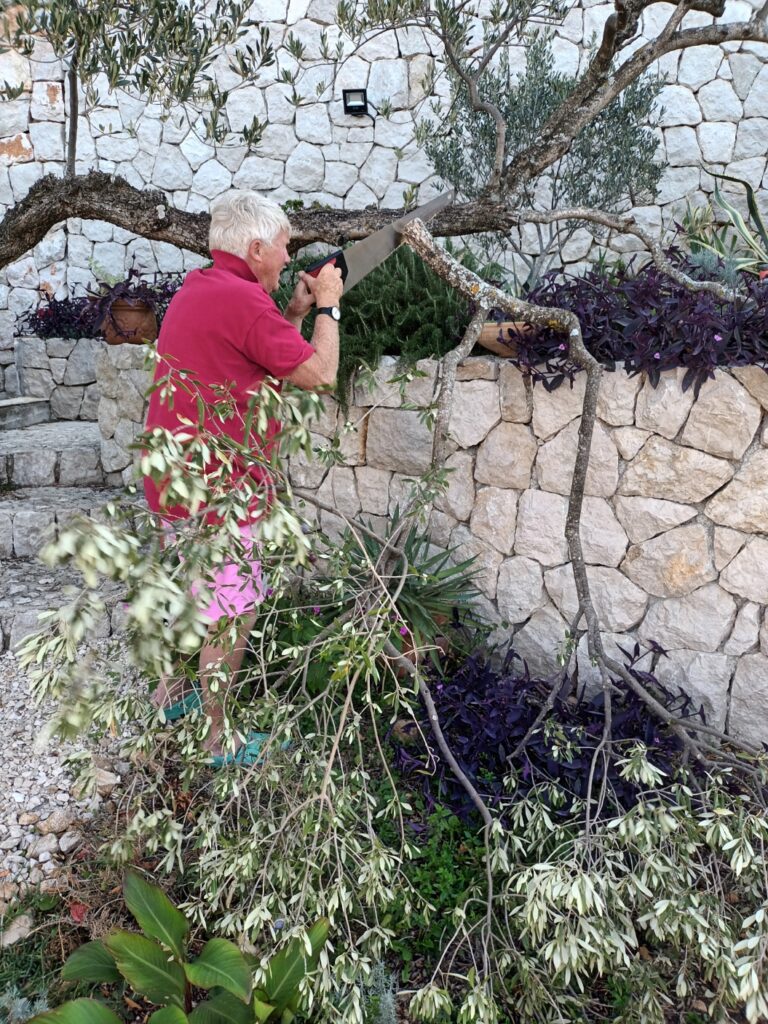
Last year I wrote about our own small olive harvest where we pick 150 kilos of olives and that this produces 20 litres of oil of which we are very proud and truth be told it costs more to harvest the oil then if we went out and bought twenty litres ! But it is our olive oil where the trees and all the picking is treated with love so we consider it a bargain and I did touch on in that article but not fully explore the dark side of olive oil production even in our local village .
Olive oil is the second largest natural product in the world after honey that is faked with additives where cheap oil and even oil substitutes are added to bulk up the product and local people tell me that the faked /bad olive oil is sold on market stalls or beside the road for the tourists while they themselves will only use their own oil or olive oil that has been bought from a person they know does not mess with the process . Italian olive oil is notorious for fake oil that they import cheaply from the likes of Algeria , Tunisia and other low cost countries in the Mediterranean basin where standards are not so high and which they use to bulk up Italian branded olive oil … it is estimated that up to 70% of Italian olive oil being sold is fake .

Sad news I agree but big business and human greed has corrupted the most beautiful and healthy product you can eat which is why when I look at our little production I can say hand on heart that Eamonn & Snezana Extra Virgin Olive Oil is exactly what it says on the label !
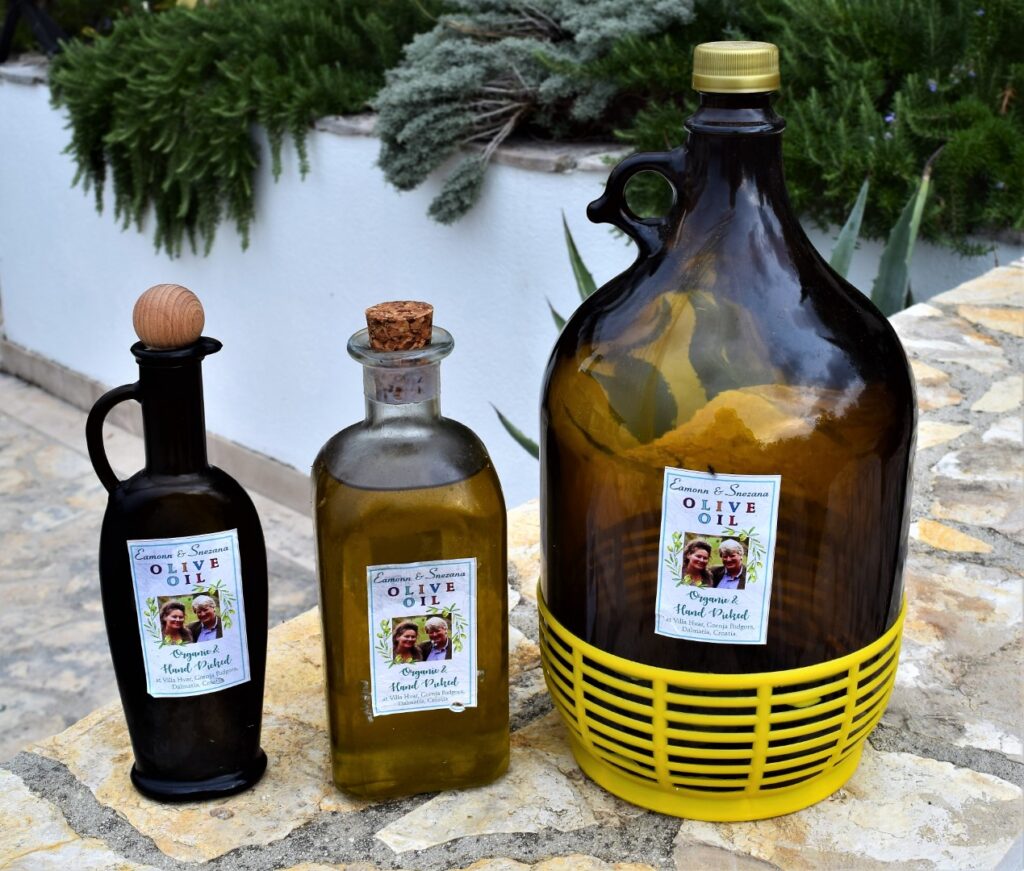
I worked for two years from 1994 in Macedonia after the break up of the Former Yugoslavia and it has always remained my favourite country in the Balkans even after spending over twenty years living and working in Bosnia and Croatia which are also beautiful especially along the Adriatic coast . Almost everyone you speak to from the Yugoslav days has a soft spot for Macedonia which unlike most of the other five states never threatened or fought against anyone and it remained strictly neutral throughout the Yugoslav wars of 1991 to 1995 . What makes Macedonia such a lovely place is the people and the culture not to mention their avjar and red peppers and as for their mountains and lakes … well the Sharplanina and Ohrid lakes are breath taking ! I use to walk in the Sharplanina mountains most weekends with the Skopje Treking Club and was amazed at how well versed the local walkers were with every herb and wild flower we would come across on our walks to stay in the chain of mountain huts that run the length of the mountains from Skopje all the way down to Pelister Mountain outside Bitola … each of them would come back from the weekend with ruck sacks stuffed with herbs , wild garlic and onions , mushrooms … if it was edible or could be used in their home made rakia it was collected .
Since that time I haven’t seen many local people out foraging but in Bosnia of course this was because large tracts are still heavily mined ( an estimated 4.5 million mines still in the ground ) and the modern Croatians are just too cool to be seen foraging which is why I was surprised and delighted to see last week that one woman from our village in Gornja Podgora still continues the tradition . I met Lovrinka , who is 87 , coming back from a four Km.walk across the mountain behind her house at Sv. Rokko with two bulging sacks of herbs and wild flowers and she explained that she will harvest the flower seeds such as wild lavender , fennel and helichrysum for planting in her own garden and flavour home made rakia with the herbs … great to see the foraging tradition is alive and well still !

Visit to Hvar Island , Croatia , October 2022
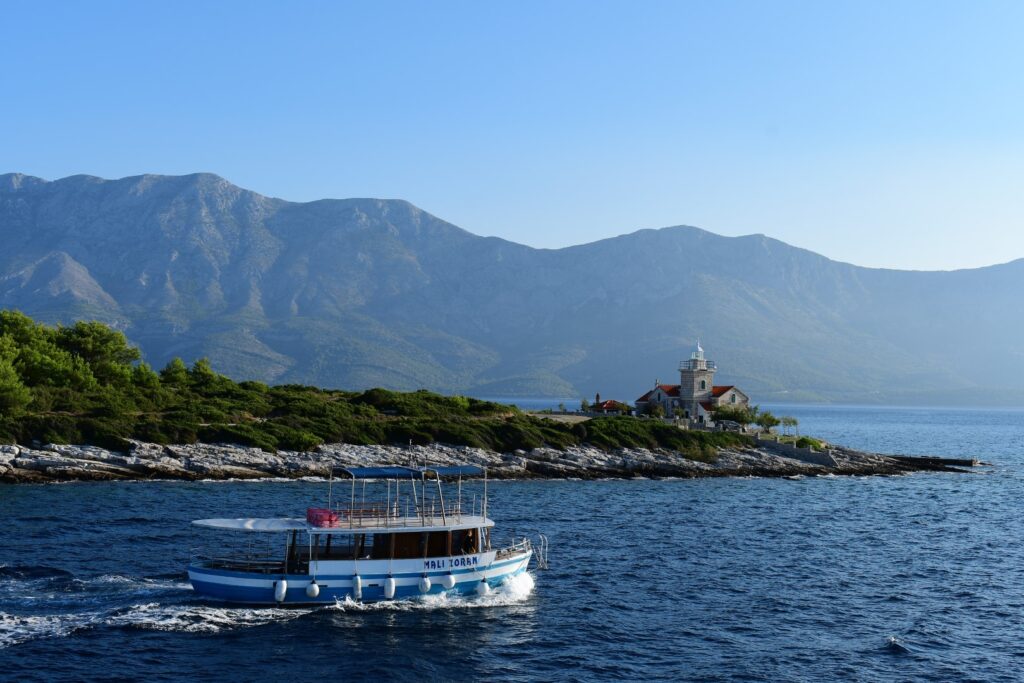
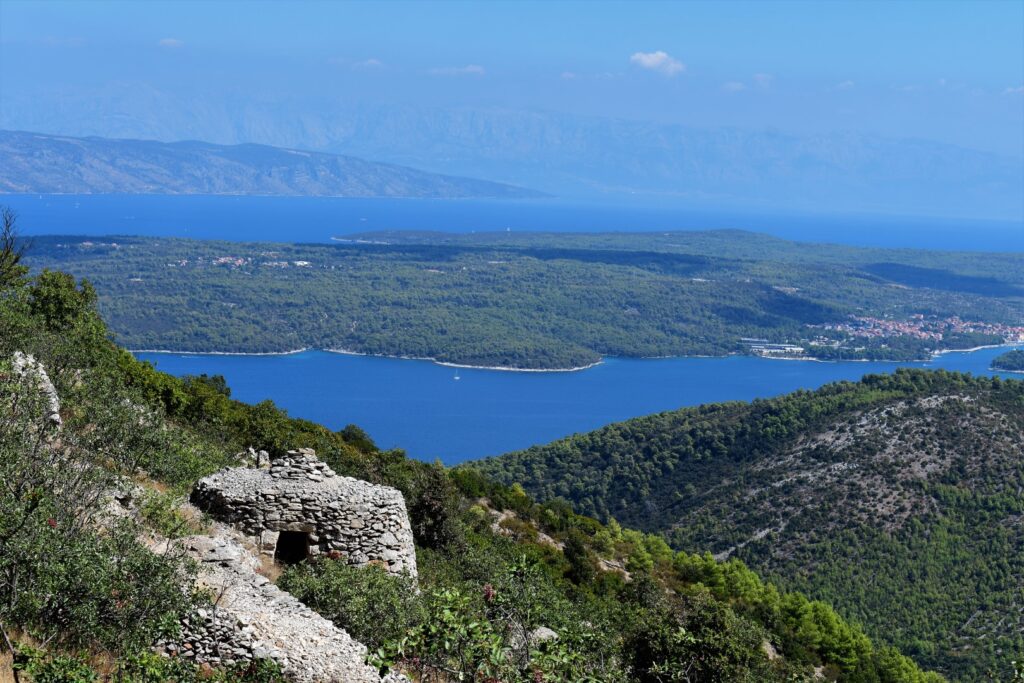

While in Croatia in September we visited the island of Hvar which has been a favourite of ours for over twenty five years and while there we always try to visit another small island St. Clement a few miles out in the bay from Hvar Town where the Menenghello family originally from Milan have since 1906 owned and developed a large 50 acre site of scrub land into a fabulous garden where they grow a range of exotic plants such as the Moroccan yucca together with local indigenous plants such as aguave and prickly pear cactus . The Menenghellos have always been a family of artists and over the years various family members have added unusual pieces of sculpture and iron works throughout the garden that greatly contribute to the feeling of eccentricity as you walk around and I find myself smiling every time I visit !
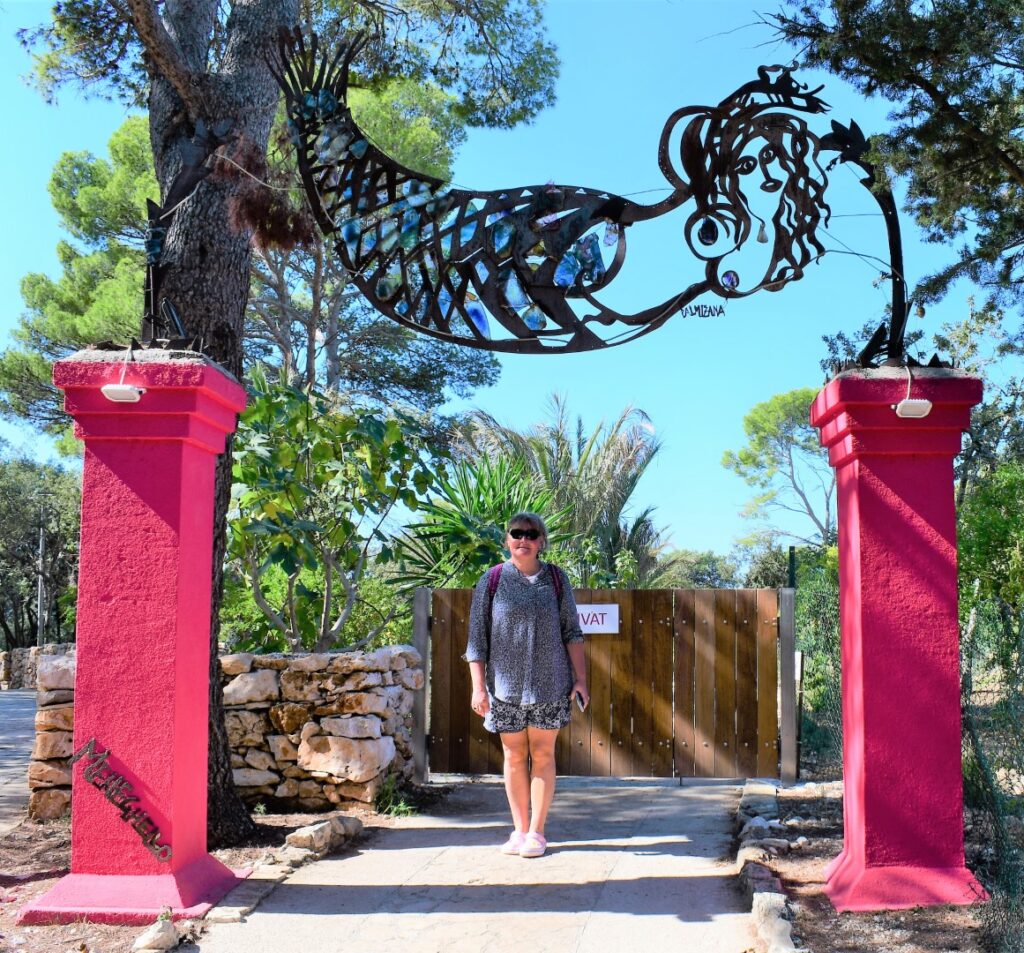
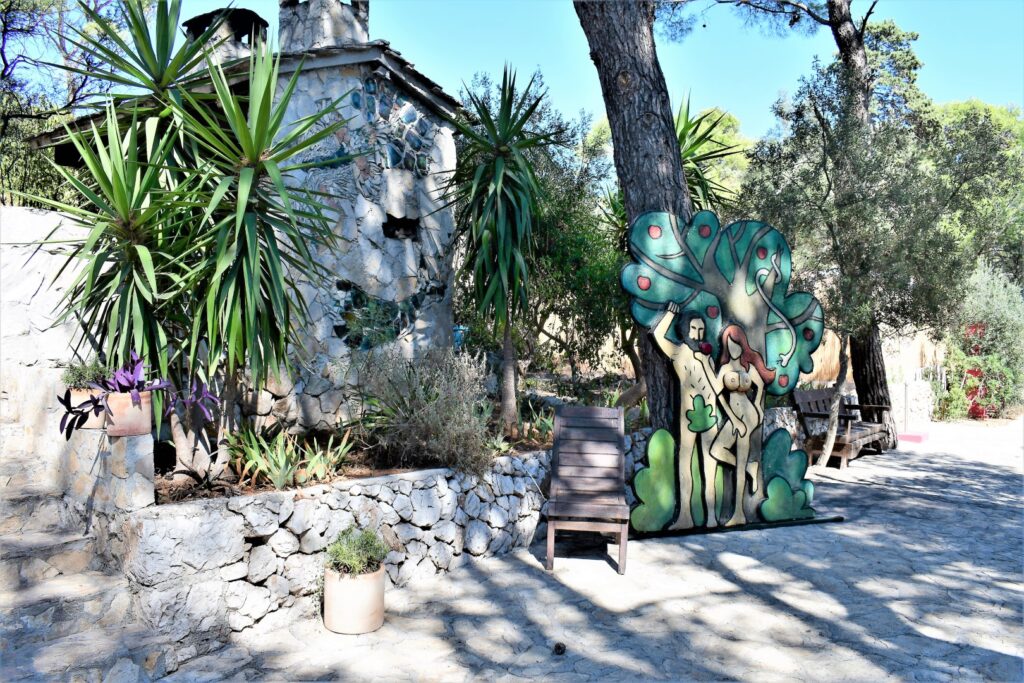
Hvar has been a favourite of ours since our first visit in 1996 and we have visited most years since then .
This has been my favourite spot for a photo during our visits .
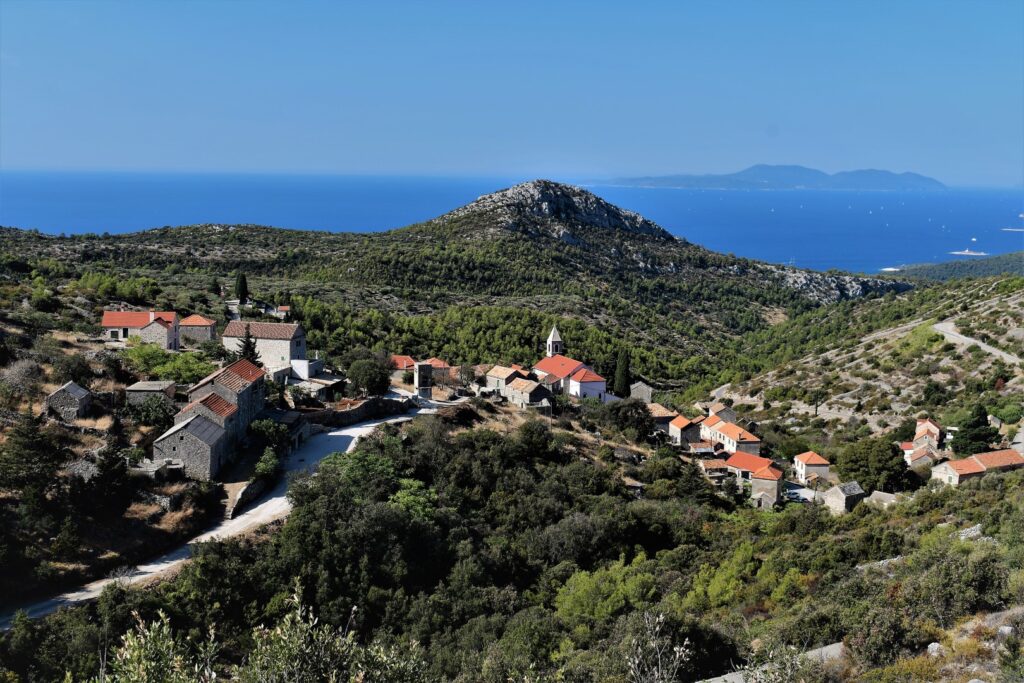
Thatching restoration in Croatia October 2022
The EU funds many worthy diverse projects which are generally dogged by criminality and corruption in Southern Italy and the Eastern European States but when they work and are not abused they quietly help to revive interest in activities that have fallen off the radar in modern times such as dry stone walling and thatching which was why I recently found myself in Croatia invited to a disused village long fallen into ruins on Biokovo mountain in October but which now with EU funds is being brought back to life . Local EU coordinators have been able to employ stone masons and thatchers , walls are being rebuilt , roofs are being thatched which for over sixty years have been open to the elements but more importantly eco activists and ethno enthusiasts are being supported financially to revive the lost traditions in this digital age and work shops and conferences are being organised across the EU where the rural life still continues such as dry stone walling in Croatia ,Romania, Ireland and Greece .
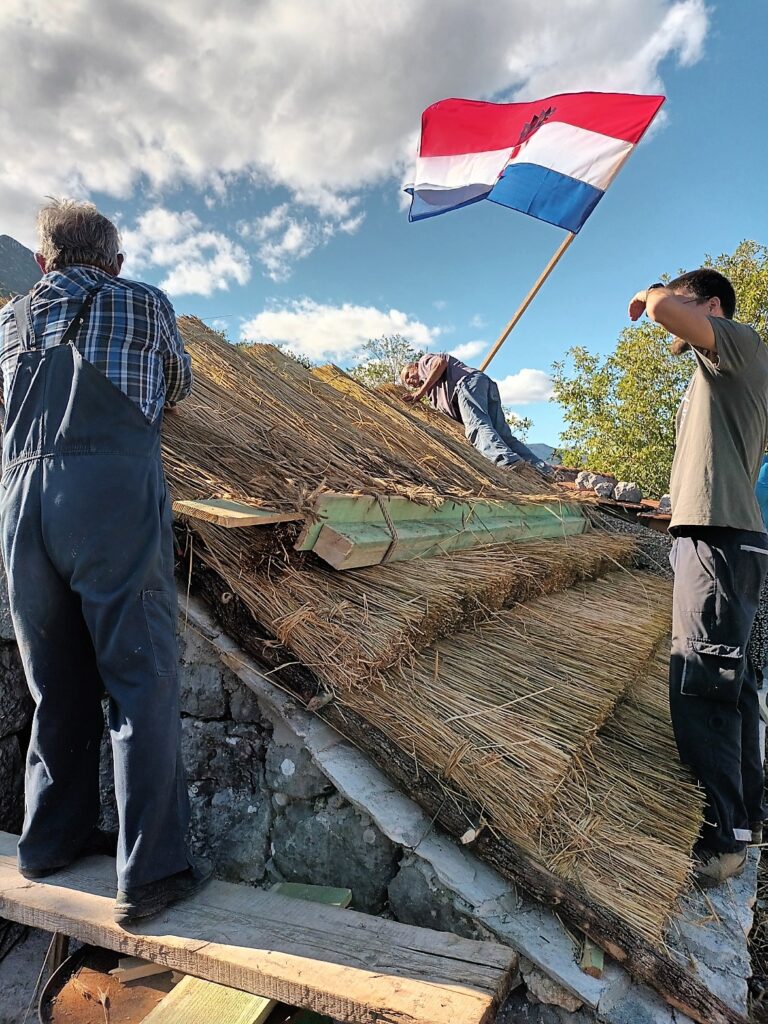

I lived for many years in Co. Wexford during my career with the Revenue Commissioners where a village near me , Kilmore Quay , has a huge tradition of thatched houses and my grand father on my Mother’s side , Jeremiah O’Keefe , was a thatcher … so it was a nice experience to see thatching being revived in Croatia . Back in the 1980’s while out cycling near Lady’s Island in Co. Wexford I stopped to watch an old man high up on a roof thatching and stopping to watch I remarked to him that all the old thatched cottages had tiny windows … he came down the ladder to talk to me and when I said that the people inside the house could barely see the lovely lake in front of the house he said “ the weather and the wind is horrible here and the rule is if you want to look at the view step outside ” !!
The Olive Oil Harvest in October 2022
The summer was harsh in Dalmatia and unless there are underground springs to tap in to which we don’t have the olive yield was always going to be low this year and we could see from early September that our olives were small … too small really and not economical to pick , more like small berries but for us the romance of your own olive oil is the thing so we went ahead and reserved our slot with the local Olive Mill in Podgora .
We started picking the olives at 8 am on the Sat morning 15th October and finished at 4 pm on Sunday when the olives went to the local Olive Oil Mill in Podgora for our booked processing time . As I have said the olives were small this year due to the ninety days continuous drought in the summer more like berries rather than the usual fat olives but we managed 112 kgs which produced 15 litres of olive oil .
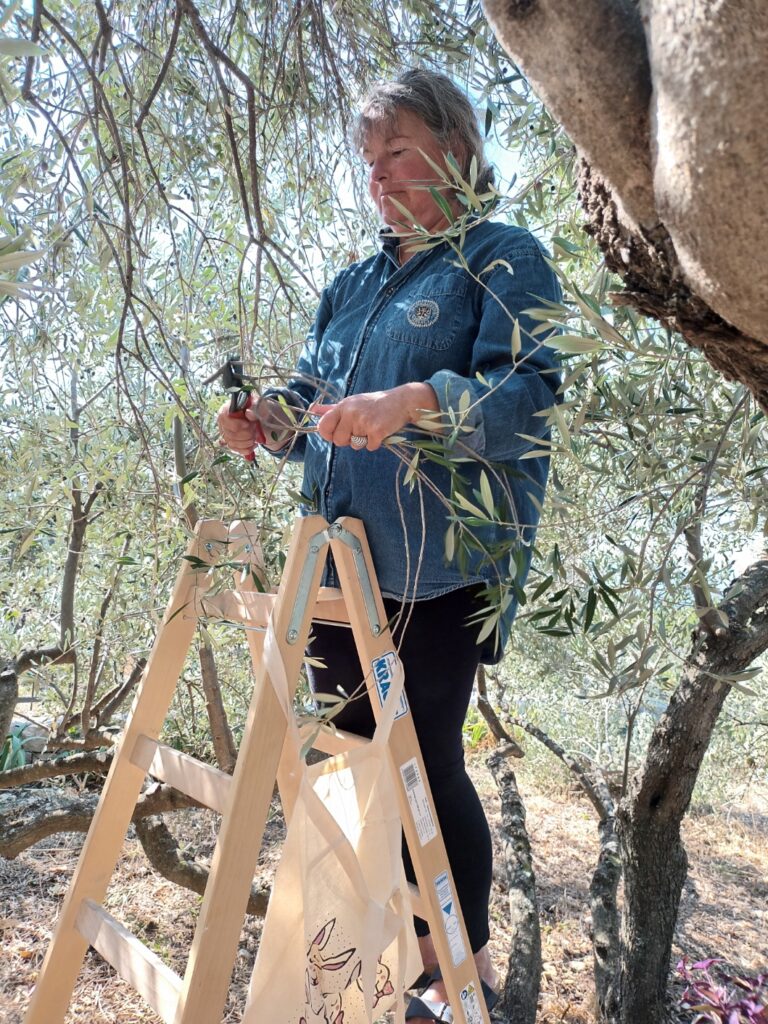
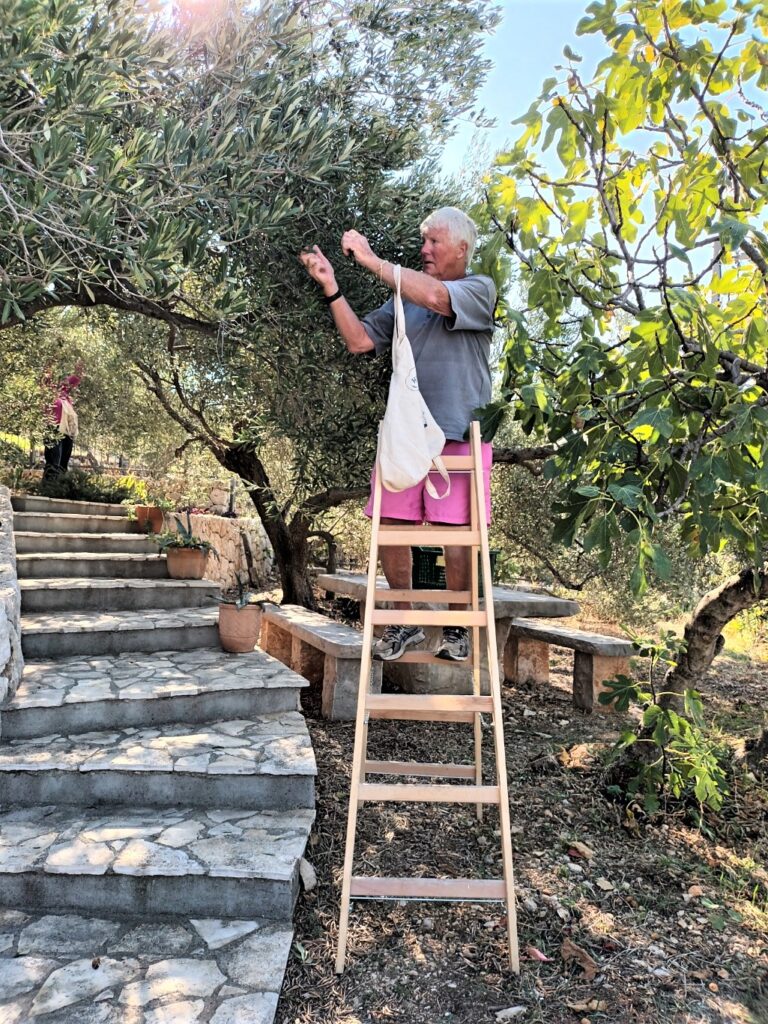
Looking back on our little harvest it was worth it but there is no doubt olive picking is a slog , real back breaking stuff and this year we were lucky to have Vera , Snezana’s Mum , adding a third pair of hands to the collection … seeing her at 82 years of age climbing fifteen feet up into an olive tree without a ladder is an experience !
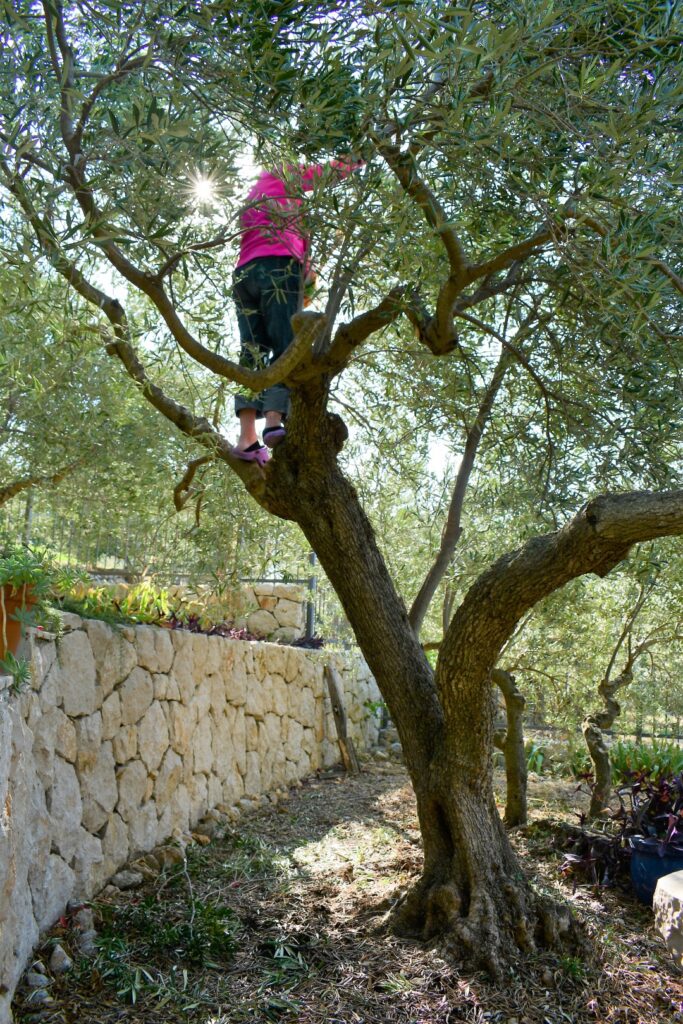
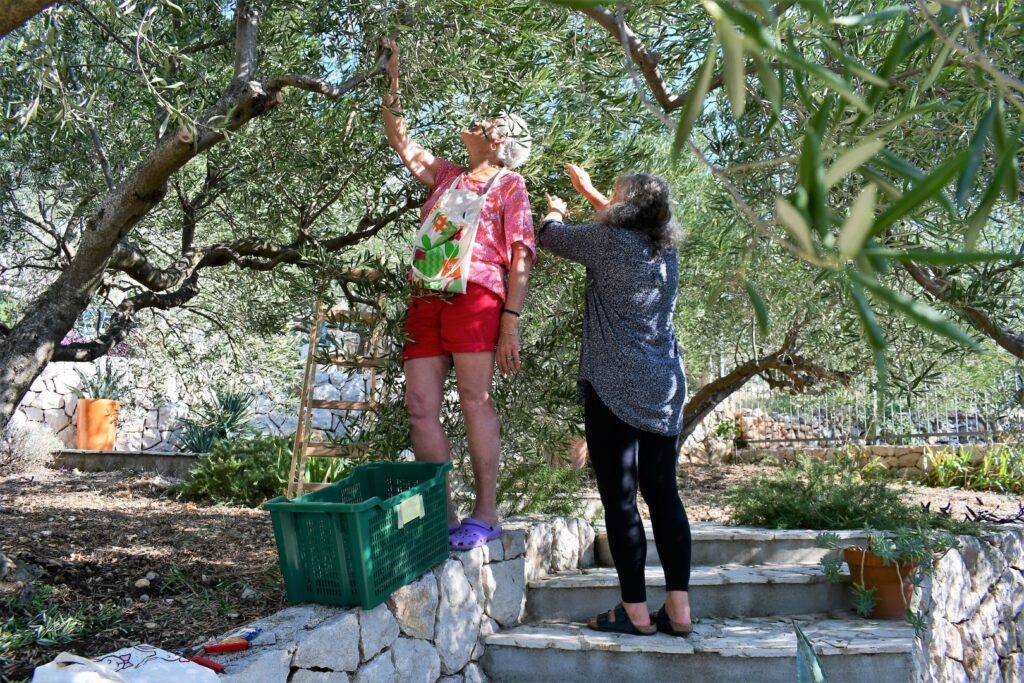
The Olive Mill in Podgora opened for the first day of the 2022 season on October 16th this year and we were booked in for late afternoon with our precious little consignment , took our place in line and as usual were treated with the same respect as the big local producers who had collected olives from over 300 trees .

Podgora Olive Oil Mill 16th October 2022
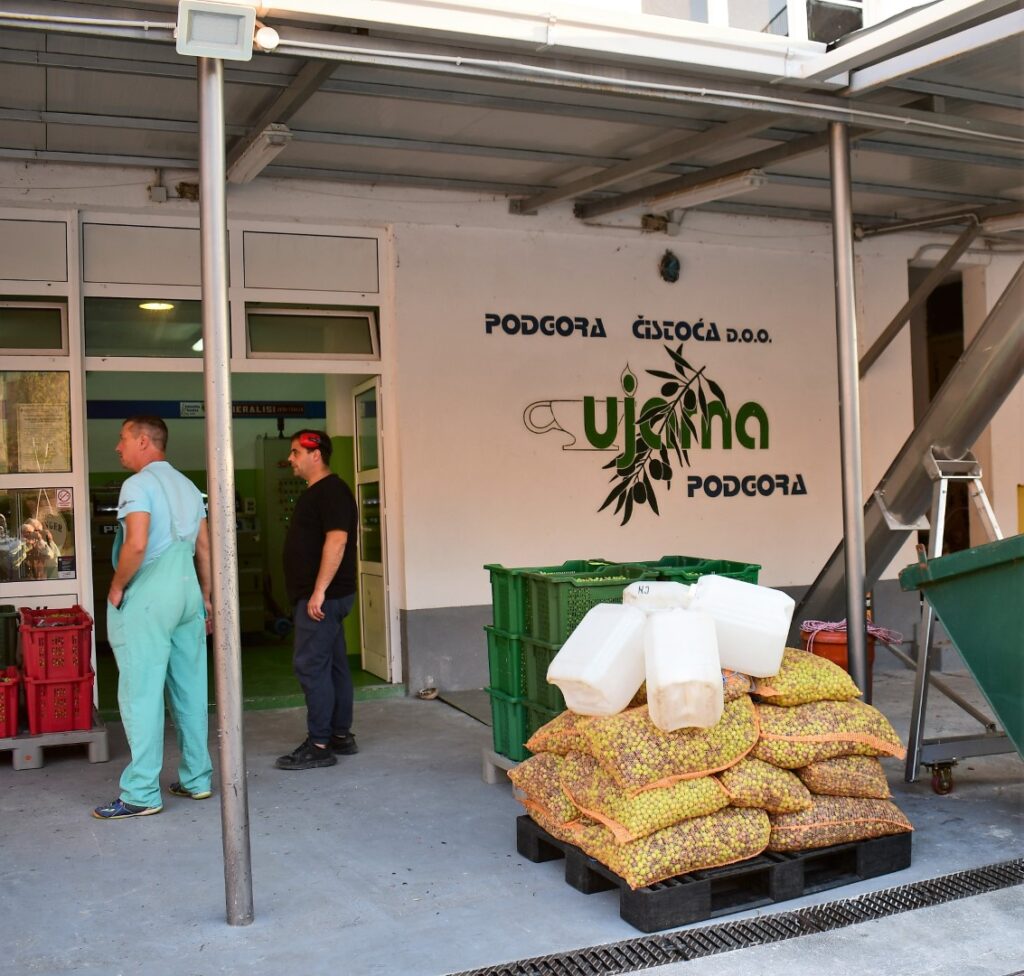
The first oil from our 2022 olives appears !
After the olives are processed when the first olive oil pours out into your container it makes it all worth while and so we will forget the pain of it until next year again !
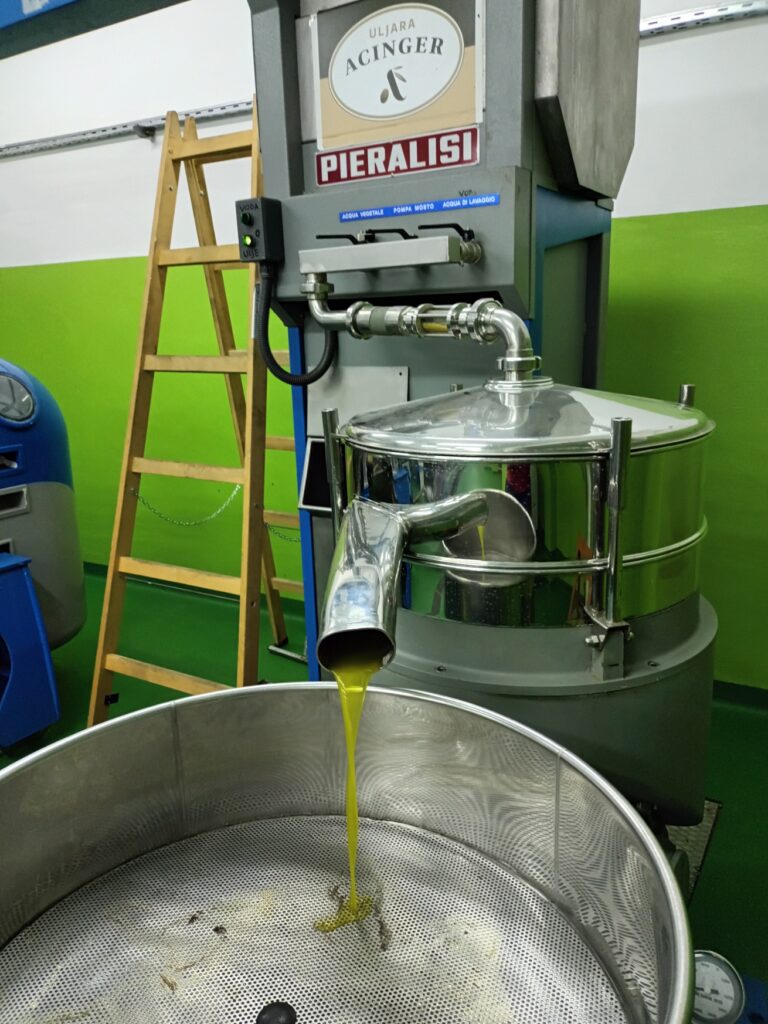
We sampled a bowl the next morning , delicious with a real kick at the back of the throat and it is as if we knew each individual olive !
We had a lot of fruit in fact twice as much as normal years but much smaller olives and with only half the volume of oil so it was back breaking stuff collecting it but the Olive Mill tested it and said it was of the highest quality.
My Gardening Month November 2022 … Good Morning Vietnam !
Gunnera would be my favourite architectural plant and it makes a huge statement in the garden but it needs space and water and when I say water I mean that it needs water close by but gunnera will not thrive if it’s roots are in water logged or permanently wet soil. A lot of people don’t like gunnera and find it’s sheer size intimidating and while it will eventually grow to perhaps ten feet high in the right site ,it has two major disadvantages in that it dies back badly and messily and it leaves a large hole in your planting scheme for the winter .

I cut the gunnera leaves down completely in early November before the first frosts and then I fold the leaves in on themselves to form a nice box over the crowns and this serves two purposes in that it looks good ( well a bit better than the heap of blackened leaves !) and it protects the crown of the plant until next season in April .
I love when the first new shoots of gunnera peep through the blackened leaves in late March and it is for me the first real signs of spring and the new season .
When I first started gardening in 1976 my bible was Christopher Llyod’s book The Well Tempered Garden and so it remains to this day along with Robin Lane – Fox’s book Better Gardening which came out in 1986 … two oldies I know but neither has been surpassed to this day by the TV gardening brigade who bring out a book a year in time for the Xmas market and which are forgotten by Easter .
Robin Lane Fox described Mahonia as an all rounder first introduced to the UK in the late 18th century from the Far East when it cost 21 guineas a plant , a years wages at that time for a working man .
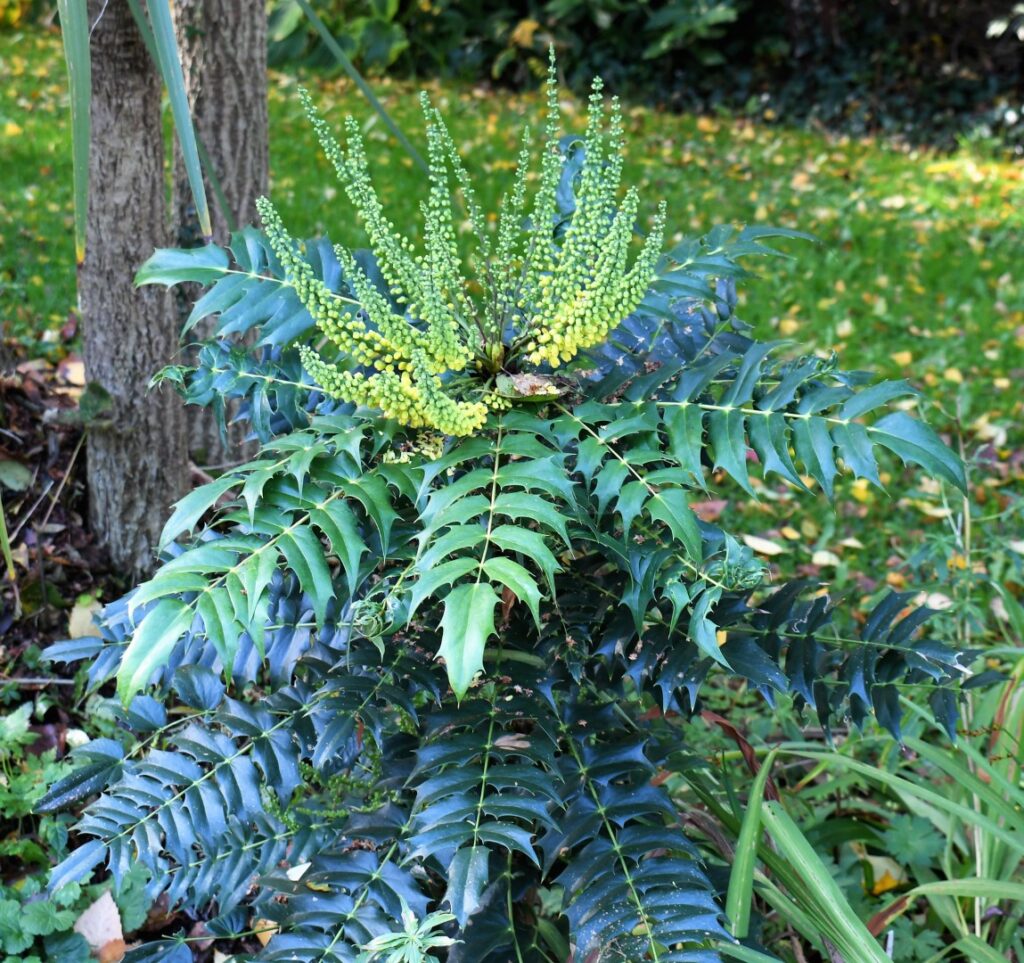
Mahonia is a quiet favourite of mine , not a shouty front of border shrub nor would it feature in the top ten of shrubs for the garden but it is a sly charmer that does best in a shady spot in woodland conditions where it adds great structure and leaf all year round and when it blooms from late October on it lights up the area .
November 2022 Trip to Vietnam & Cambodia
I grew up in the 1960’s with Vietnam part of the sound track of my teenage years from the outbreak of the Vietnam War in 1964 and it is only in the last twenty years that the country has opened up for tourism . Until now I had never travelled there nor indeed felt the need to but all this changed in early November when we spent almost three weeks in Vietnam and Cambodia , a fabulous trip where we travelled south from Hanoi to Saigon and the Mekong Delta visiting and staying also in Halong Bay , Hoi An and the Imperial City of Hue along the South China Sea .



Until now India was considered our trip of a lifetime and while it was marvellous there were elements of India that were a bit intimidating such as the in your face multiplicity of Hindu deities and temples , the overwhelming numbers of people in every public place , the predatory attitude of large groups of men towards young women and above all the sheer jaw dropping level of poverty among the poorer people who often lived on the side of the street… none of that is evident in Vietnam or Cambodia and while the people are definitely poor I feel as Buddhist countries there is a huge difference in attitude and outlook and they have a friendliness that is very welcoming …we loved it unashamedly .
Hanoi in the north to my surprise I liked better than Saigon as with it’s narrow streets it is more intimate whereas Saigon designed by the French has huge Champs Elysee style boulevards … getting across the street on foot in Hanoi through the horde of scooters none of whom regard any zebra crossings as mandatory is bad enough and you should try getting across the boulevard size streets in Saigon almost 150 metres wide … there is a trick to getting through the scooters without being knocked down but you have to adopt a zen like approach where you stroll across , important not to rush or dash across, and let the scooters swarm around you like water… takes confidence though but by the end we had mastered it !

The scooter is the vehicle of choice in Vietnam and they are such tiny people that it was nothing to see an entire family of four and in one case five including a baby sitting on one and the scooter is routinely used for transporting everything from sacks of cement to live animals and bales of clothing piled up high behind the driver .

As the Vietnamese appear tiny to us we westerners must look huge to them as one day I was buying some T shirts in a market , the iconic one with Good Morning Vietnam written across the front , the lady trying to convince me that it would fit assured me without a hint of irony , quite serious she was , the witch … “ it is hippo size so it will fit you ” !

Vietnamese food is rightly famous and it is everywhere on the streets , along the side of the road where the cook sets up her woks and burners and cooks with ingredients that were picked that morning with wall to wall noodles and pork seems to be the meat most used . It is impossible to have a bad meal in Vietnam as unlike other destinations this is not laid on for the tourists , this is for themselves and they sit out at meal times and throughout the day on these tiny plastic chairs and tables or as Anthony Bourdain says in his TV programme on street food in South East Asia “ Got the small plastic table .. check … got the small plastic chairs … check .. got the scooters .. check … this is Hanoi !

The Vietnamese and strangely enough the tourists also are all into their own food and I didn’t see a MacDonalds or Burger King in either Hanoi or Saigon , I am sure they exist but down some side street and not in your face like in most cities world wide which is a tribute in itself to the lure of their own street food which is also served fast but cooked on the go on a wok and not some indeterminate meat pattie cooked and deep frozen probably in Minnesota .
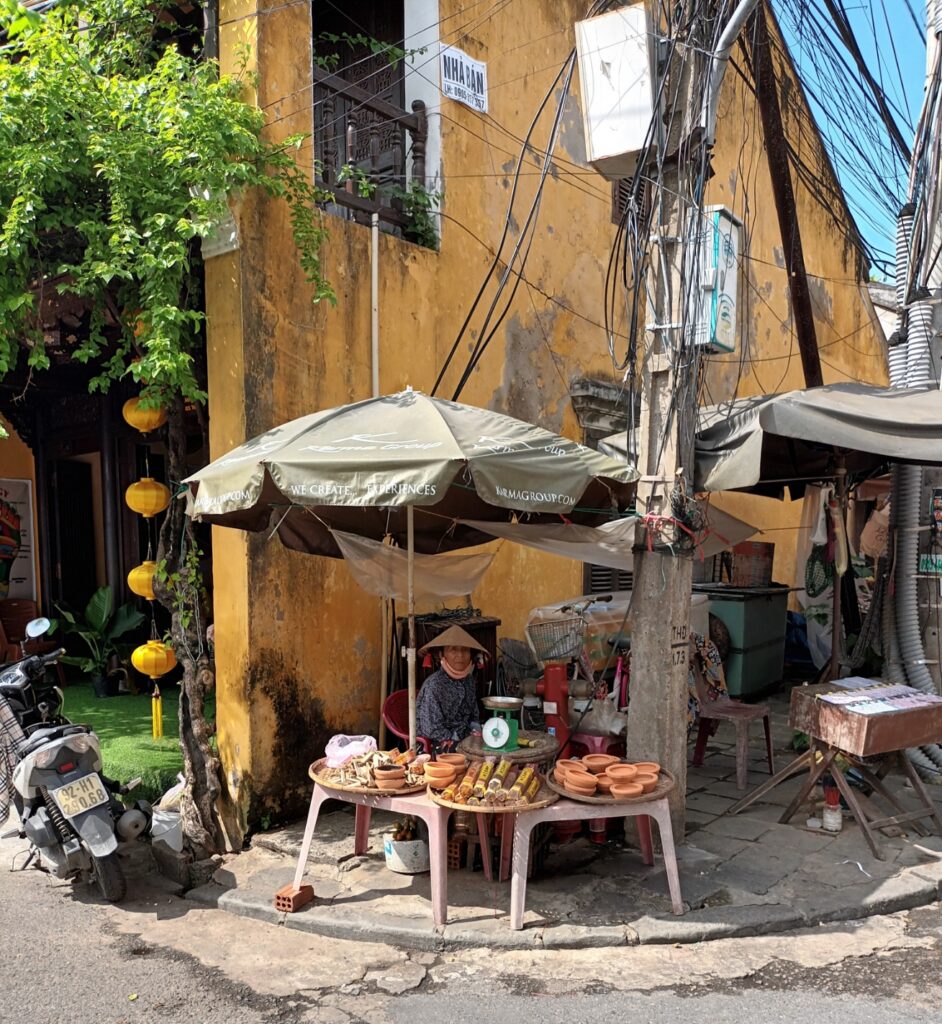
My favourite food is a sandwich so naturally I felt right at home with the Vietnamese sandwich , their famous Ba Minh which is a combination of the french influence of a toasted baquette but one which is lighter and made with rice flour to be crispier then layered with pate of your choice , pork strips , coriander and whatever pickled vegetables you like … delicious !
Anthony Bourdain, the writer and chef , claimed on his famous Vietnamese food segment that you got the BEST Ba Mhin sandwich in a small Vietnamese town , Hoi An , in a restaurant called Banh Mi Phuong and by luck we find ourselves in Hoi An outside the very same ! Apparently they are so jealous of their now world famous Ba Mihn recipe that they only employ family members in the restaurant which is round the clock busy … without doubt my BEST SANDWICH EVER !!

I leave the last word on the sandwich to the late great Anthony who described the famous Ba Minh as “a symphony in a sandwich ” .

Poor Vietnam got hammered by the US with the carpet bombing and Agent Orange being sprayed indiscriminately on millions of acres of trees and it really was an unjust war , all in the Cold War cause of stemming the flow of communism . In reality the Vietnam War was a war for independence , the unification of a country which after a hundred years struggle against the French should have been an unstoppable force but such is the hypocrisy of the West that the UN under US pressure was prevailed upon to divide Vietnam into North and South in 1954 .
For all their suffering at the hands of both France and the US the people of Vietnam are remarkably forgiving and an article about Vietnam in the UK Telegraph last week stated “ the Vietnamese don’t want to be weighed down by history , they are optimistic they want to look to the future not the past ” … we could learn from that attitude here , one hundred years ago our Irish Civil War started in December 1922 , lasted eight months and we are still reliving it .
A friend of mine from High School days , Joe Toner , a US citizen , was a medic in the US Army and died in a military plane crash in Da Nang in 1967 so as we landed in Da Nang Joe was in my thoughts as he had been a few years ago in June 2010 when Catherine Ryan , another school friend of Joe’s , contacted me out of the blue after 40 years to send our own little personal tribute to Joe , a small flower arrangement , floating down the Suir in Clonmel where we all three had often walked . RIP Joe and sadly RIP Catherine , who passed away just three weeks later .
We travelled all the way down Vietnam from Halong Bay in the North to the Mekong Delta in the south , visited silk worm farms , completed cookery programmes on a farm surrounded by paddy fields , visited pearl farms , got up close and personal with water buffalos in the South China Sea and pythons in the Mekong Delta , fulfilled a personal ambition to crawl along one of the Vietcong tunnels of Cu Chi and got to see the iconic temples of Angkor Wat in Cambodia .
Don’t try this at home !

Cookery class in Vietnamese cooking , Hoi An
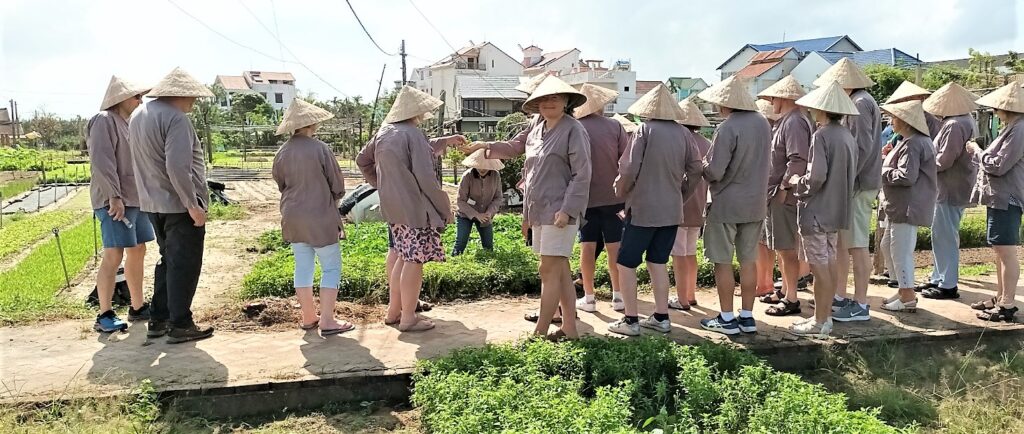

South China Sea , Hoi An
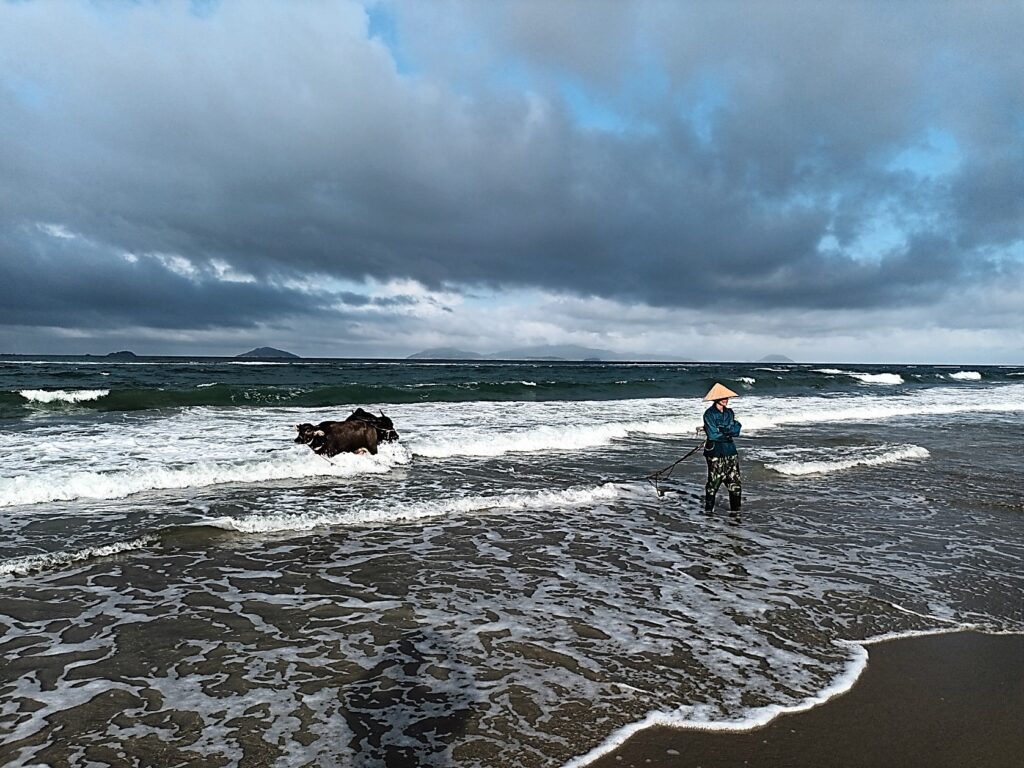

I remember the first time in 1975 just as the war ended the US Army revealed details of the secret war that the Vietcong had waged underground where ten years before the US invaded in anticipation of the war coming they had built an elaborate system of tunnels underground near Saigon and where an entire army could hide safe from bombing and army patrols . This huge underground system even housed hospitals , canteens , administration offices and sleeping quarters right under the feet of the US Army and from where the Vietcong could pop up and ambush patrols and then vanish just as quick .
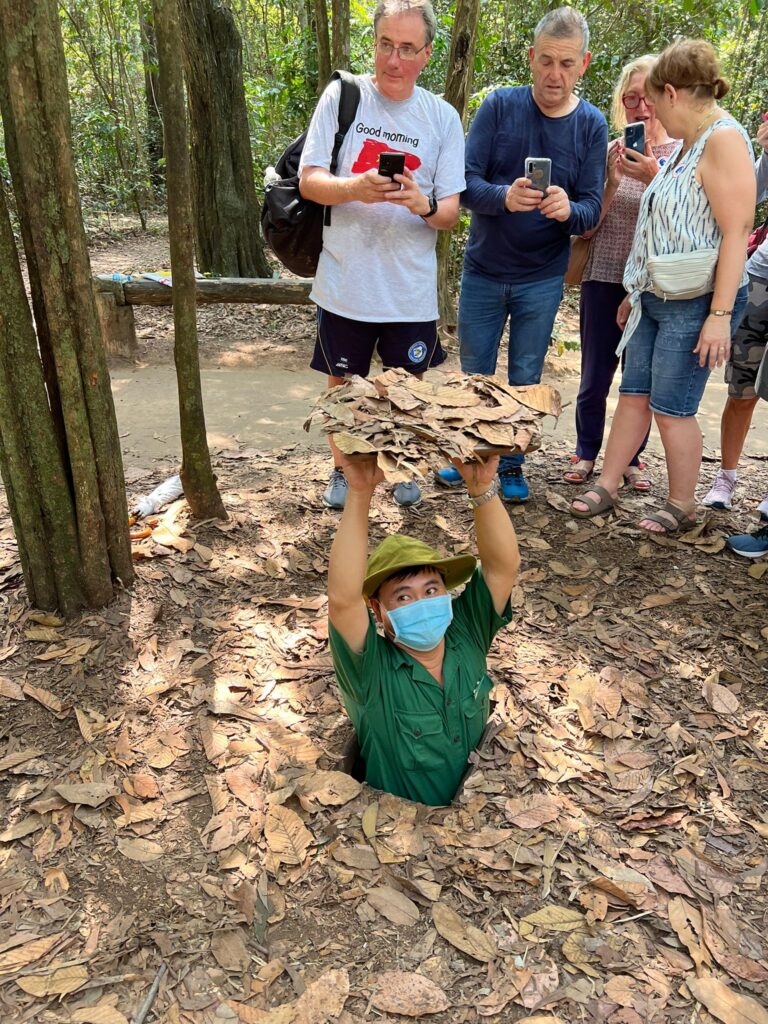
These tunnels were constructed with traps , hidden sharp stakes in pits that an intruder who didn’t know the way could fall into along with nests of snakes … it would take a brave man to go down these tunnels and bring the fight to the enemy but the US recruited a special unit of small sized men who actually went down after the Vietcong and they called themselves tunnel rats … brave men .
The tourist nowadays can go down some of these tunnels to experience what these soldiers went through and even though I was older than the permitted age the guide let me down at my own risk … I was too tall to walk upright and too stiff to wriggle along on my haunches so I crawled along a section about forty metres long , thirty feet down in a tunnel a metre high and in total darkness , hoping I was going in the right direction , I took of course a wrong turn , couldn’t turn around and then a few metres further along I heard a voice shouting over here … great relief when I saw daylight again !
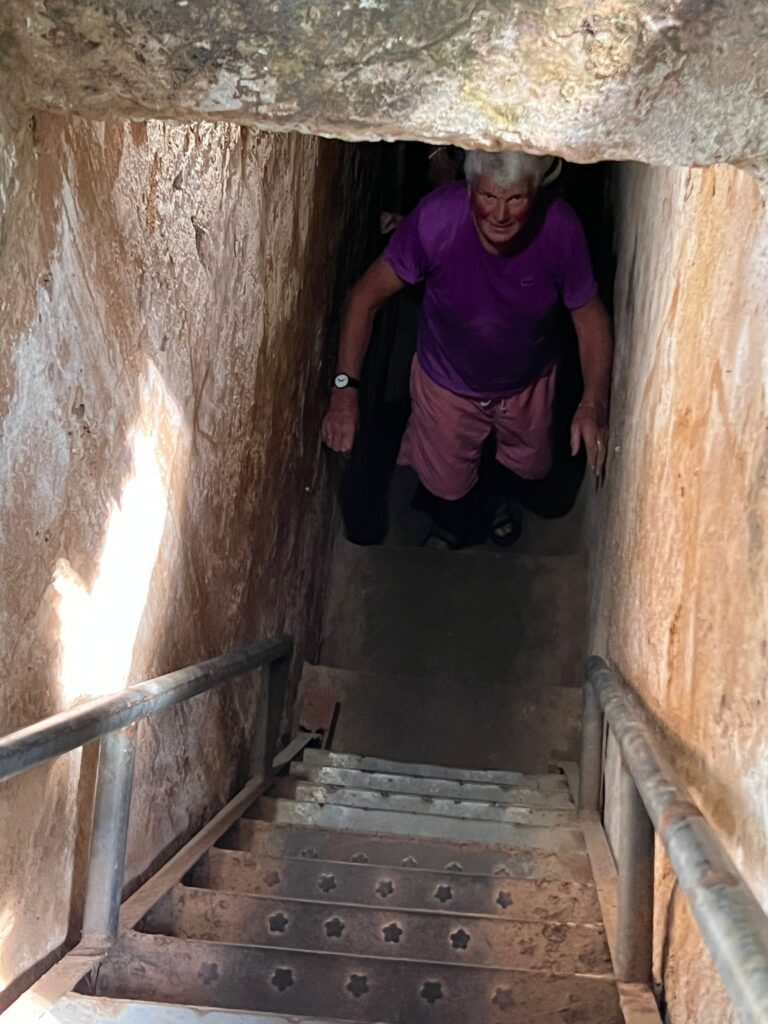
You or at least I go to Vietnam for the history , the unique landscape but you go back for the people who are just wonderful .
The smiling people of Vietnam

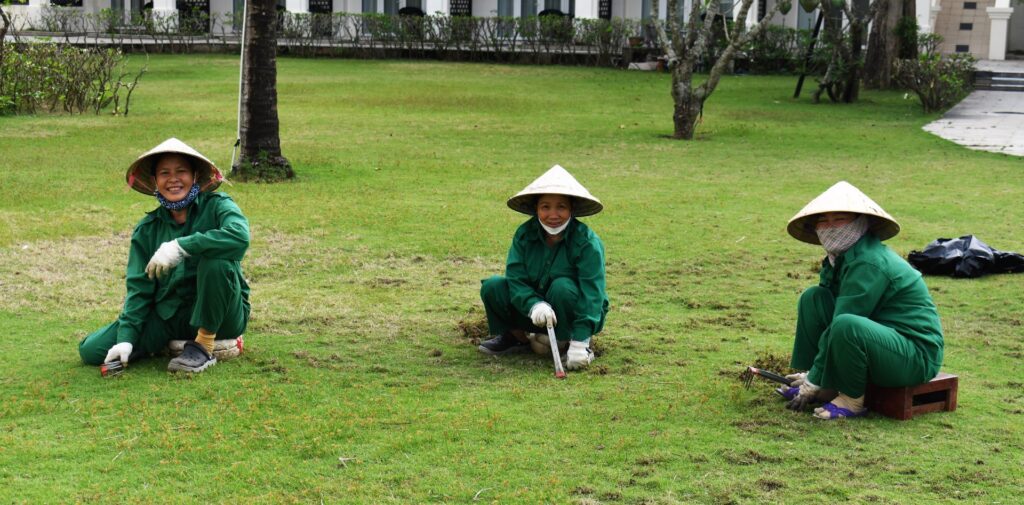


Cambodia
I must confess that although interested in history and antiquity I have never had a feel for the Kymer civilisation of Angkor Wat … still haven’t … which in a way was a blessing as I walked through the ruins of Angkor Wat as it allowed me to just enjoy the beautiful stone work and the awesome carved wall panels and not get bogged down in detail of which king built which as it would have in Greece or Egypt .

The views at sunrise and sunset at Angkor Wat are a tik tok favourite and a must see if in South East Asia and on our last day I made it up before closing time to the top of the main temple , about 30 metres of almost perpendicular stone steps … and down again … dangerous dangerous but it felt great afterwards .





I asked an Indian , a Hindu , who was visiting with his Mother and who had just also made it back down the steps and who was equally slumped on a bench heart in the mouth recovering like me why it was designed and built to be so difficult and he said “ in our tradition and belief the tower at the top is the home of the gods and represents heaven and it IS difficult to reach heaven ” … his Mother who was about 80 said that she had wanted to climb to the top but that her son would only allow her to climb the first four steps and I said there was no need for to risk life and limb as she was his mother and that all mothers in my view were guaranteed heaven anyway … she smiled and said tell that to him …loudly !
December 2022 I wrote about Hellebores and colour in the Winter Garden
Another favourite winter plant is the hellebore , a perennial that comes into flower in early December and blooms away until April … highly sought after with Hellebore Societies throughout the world for enthusiasts and the plant has been hybridised to death with the huge public clamour for flowers which are available in all the colours of the rainbow such is the demand and popularity and some gardeners even strip off all the leaves just to show off the flowers better .
Hundreds of varieties but personally I grow just one Hellebore , the common variety corsicus which I grow purely for it’s cream leaf colour and architectural shape and the flower is not in your face but a lovely soft understated cream … don’t bother with the exotic flowered hellebores as although the flowers are pretty the leaf colour is drab.

An easy to please plant , hellebore likes shade but no wet ground please , self seeds into gravel easily and is great in pots and while it can get leggy you can deal with this after flowering by just cutting it to the ground and it grows back as good as new .
Colour in the garden in Winter … yes it is possible !
Silver Birch is THE best single tree or shrub to import some colour into the winter garden , multi stemmed or single stemmed specimens will light up the garden and it is the first tree I go for in any planting schemes as it looks good all year round but of course with it’s white bark it comes into it’s own at this time of year . Generally I am not a fan of variegated shrubs but make an exception for eleagnus and the varieties gilt edged , limelight and gold star are superb , a bit slow to grow but worth the wait . Another good tree for winter colour is the copper beech which although really brilliant for colour in Spring through to Autumn but they retain their faded leaves through the winter and look great then also .
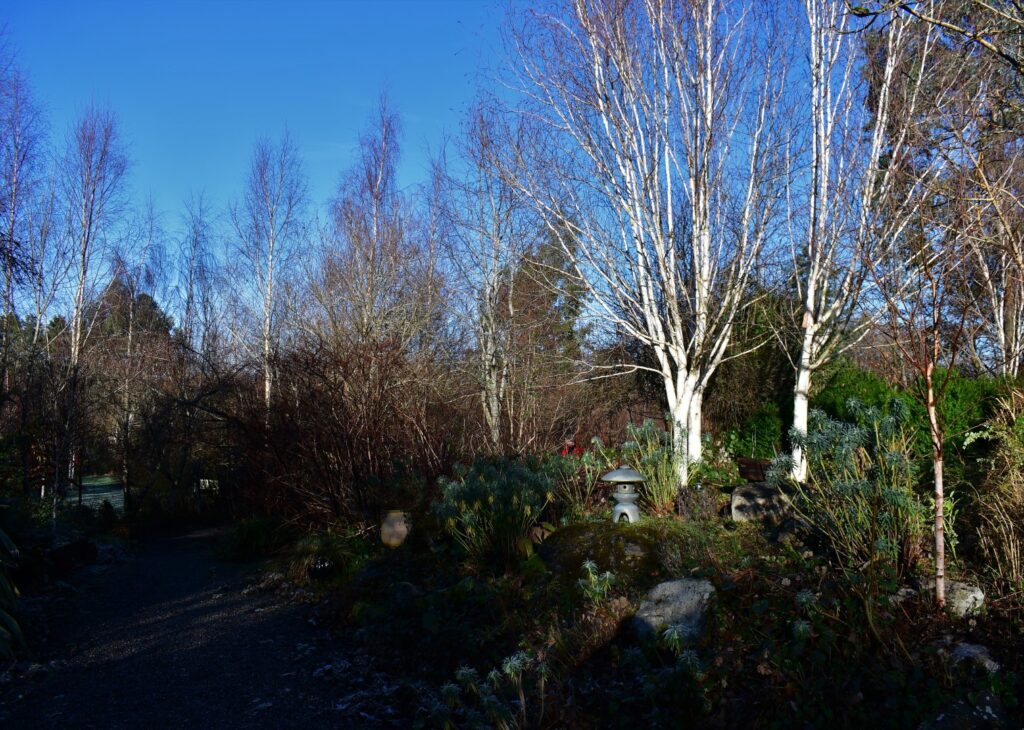
Golden willow and the red dogwoods are also beautiful in winter and grow well in damp locations .
You can import winter colour with pots , the bigger the better and I tend towards blue which stands out well throughout the garden and red and green pots also provide focal points of colour when you need it most .
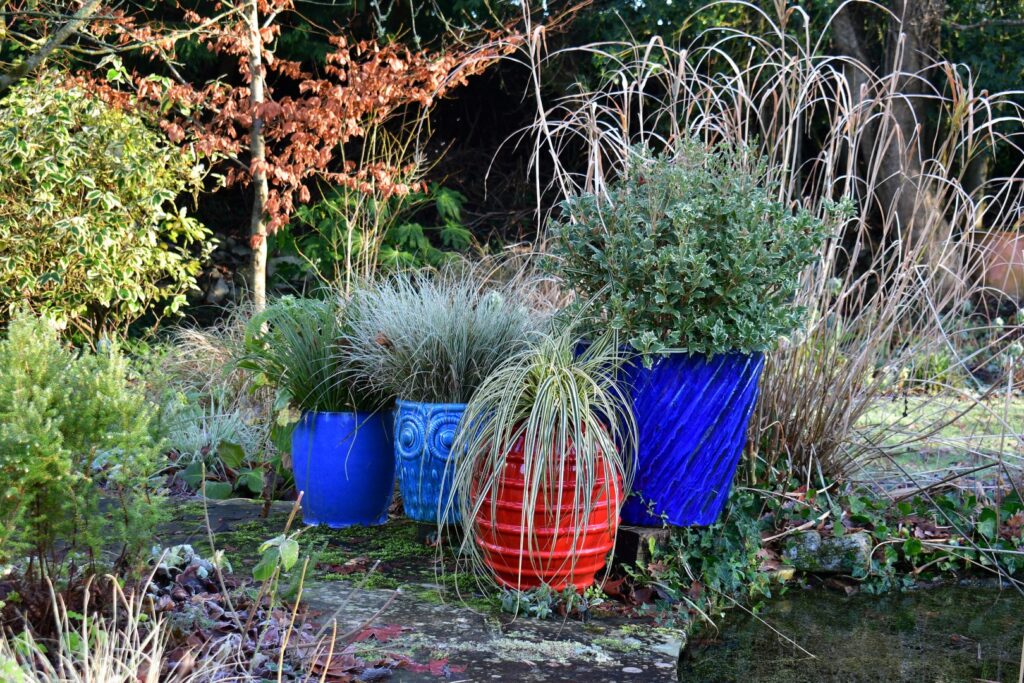
Gardeners in Ireland and the UK tend to be very traditional when it comes to wooden garden furniture which is always brown however here at Old Spa Road Snezana has introduced blue , Majorelle blue to be precise from the famous 1920’s Majorelle Garden in Marakech , so ALL our wooden furniture has been painted blue for the past ten years and of course this also is a great way to introduce colour to the winter garden .
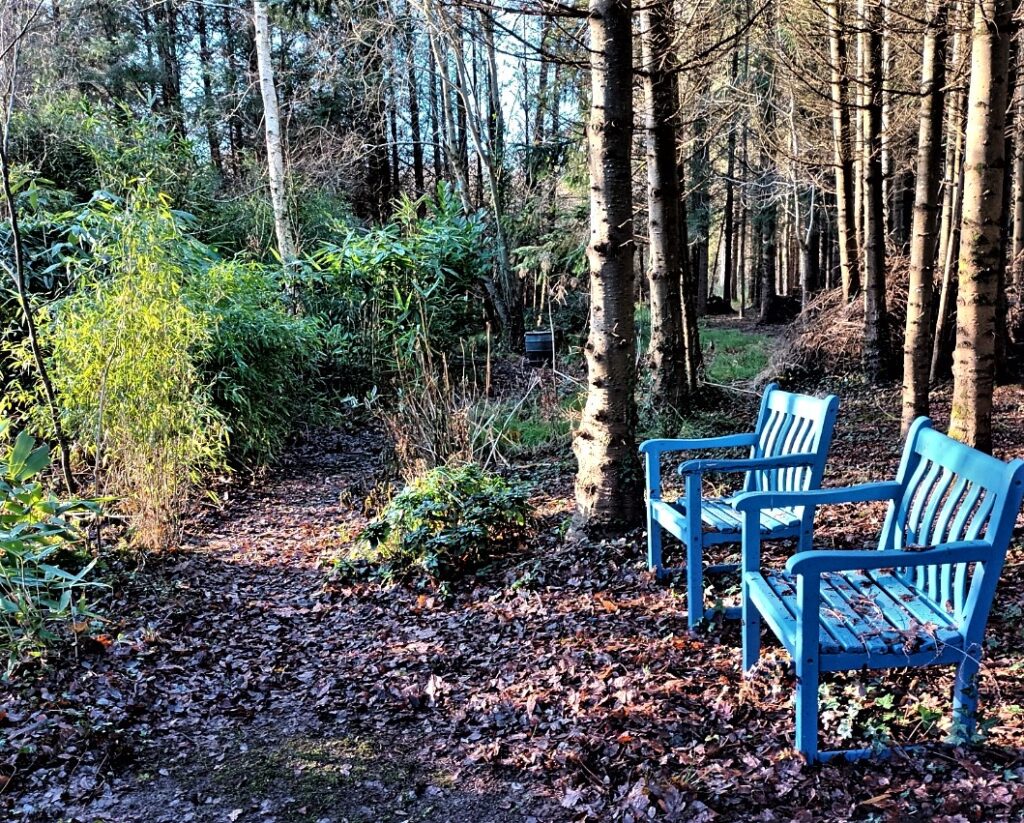
Murder in the Garden , December 2022
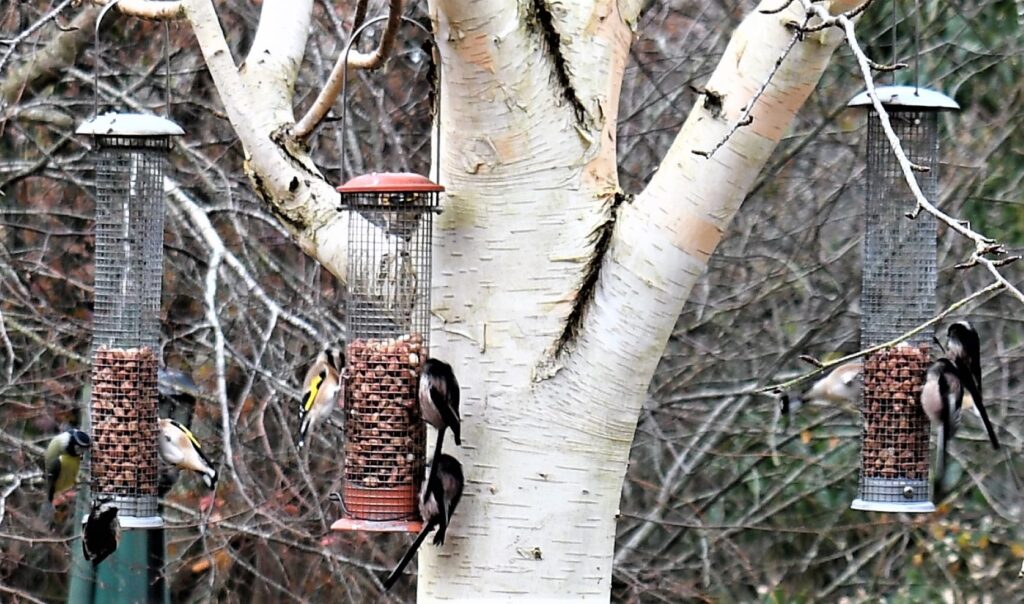
I start loading the bird feeders in late November after the leaves have fallen and it takes the local birds a few days to realise and from then until end of March there is frantic activity throughout daylight hours .
The feeders are only a few metres from my office desk so I get to view them on a regular basis while the blue tits and sparrows have their little tiffs over who gets to eat at which feeder however last week for the first time in my life I saw a small hawk swoop in and take a blue tit in flight … brutal and so quick , blink fast and I’d have missed it as the hawk swung into the feeder and took a small blue tit in mid flight , one smooth movement , no fuss no squawks and it was gone with the blue tit in it’s mouth, not even a few feathers left fluttering ….. the other birds scattered of course but in a minute or two were back feeding as if nothing had happened , the beauty and cruelty of nature revealed in a nano second .
Vietnam
It took a few weeks to recover from our November trip to Vietnam both the hectic daily schedule and the flights back via Dubai with long 12 hour delays in Bankok but it was a great trip and the memories will outlive the tiredness !
Personal highlights for me and ones I had been looking forward to for years were the visit to the Imperial City of Hue built over the Perfumed River , the palace of the former Emperor’s of Vietnam and to get to see the Tomb of the last Emperor was a real thrill , a curiously muted simple low key structure in the inner palace in total contrast to the flamboyancy of the rest of the buildings in the outer court.


I was fascinated with Hue since watching on TV the Tet Offensive of 1969 against the Citadel at Hue during the Vietnam War , that almost overwhelmed the US Army when thousands of Vietcong soldiers died in almost suicidal attacks during the Chinese New Year .
I hadn’t expected the wealth that is obvious in Saigon , a complete contrast to the new capital city of Hanoi which is pretty decrepit and poor looking in keeping with what is officially a communist socialist country … less street cooking if any also in Saigon and you wonder who won the war , Hanoi or Saigon ?!
By the end of our trip to Cambodia Snezana was all templed out and in need of a break which is why I hit out on my own to reach the highest temple , the House of the Gods , at Angkor Wat before it closed at sunset and just made it thanks to a nice guard who had closed the gate but took pity on me as I ran up and allowed me in as the last visitor of the day !

How the other half lives in a fishing village on the South China Sea
We stopped at this fishing village a few miles from Da Nang which is famous for it’s oysters and these guys earn their money , working in wet damp and humid conditions out in the open cleaning the oysters before bagging them up for sale at the markets where they get only the equivalent of five dollars for a full sack of oysters .
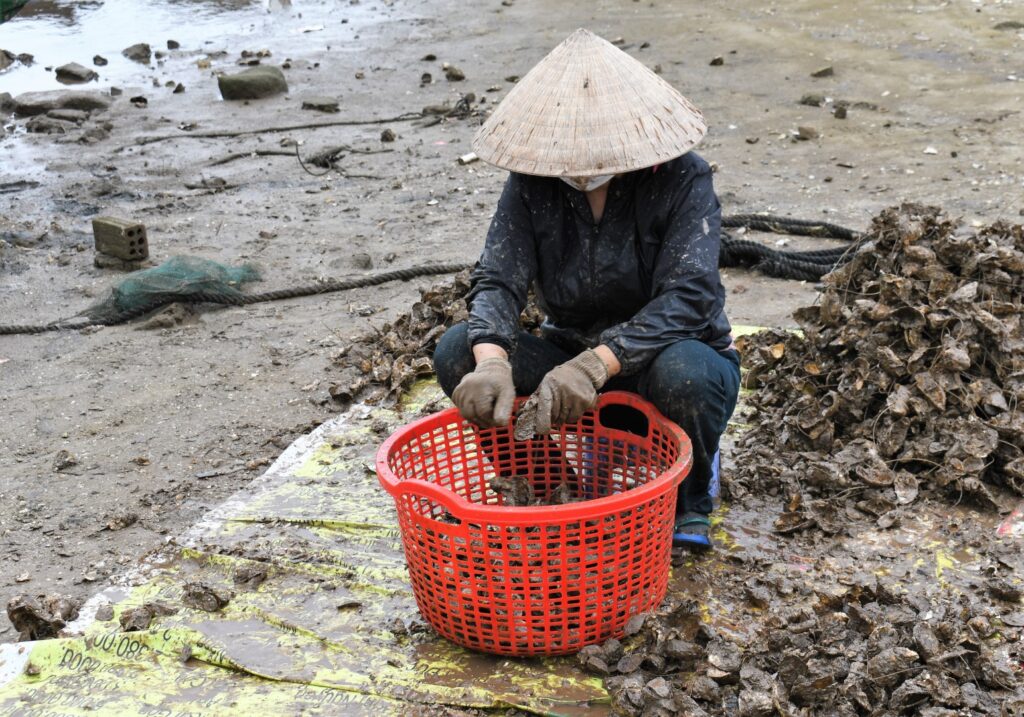
The Golden Bridge in Da Nang
The Golden Bridge in Da Nang is a curious place to visit and I added it on a spur of the moment decision while in Da Nang as Lonely Planet said it was a must see . I had never heard of it but I trust Lonely Planet and so off we went on an afternoon visit from Hoi An and my advice never trust Lonely Planet again ! A huge part of pre Covid tourism for Vietnam has been from China with a lot also arriving from South Korea ,Malaysia and India and the Golden Bridge and the architecture around it is pure Disneyland meets Versailles which is exactly what the Chinese want as in lets have Versailles in Vietnam and skip going to Europe to see the real thing .

The Golden Bridge in itself is interesting as you can see from the photographs with giant stone hands holding up a golden pedestrian bridge and built in 2018 it has won several major international architectural awards already however the Versailles thing built further up the mountain is awful makey uppy fake chateau land , in fact there was a sign advertising a copy of the Chateau of Amboise which is currently being replicated … toe curdlingly awful s..t but the Asian tourists love it .
New Year’s resolutions … Don’t be too hard on yourself if you are not the best , most interested gardener in the world as even the professional gardeners have their off days as Fionnula Fallon wrote recently in her gardening column in The Irish Times .
“As an experienced, professional gardener, you’re not supposed to make mistakes. But of course I still do.
All the horticultural booby traps, temptations and enticements that once snared me in their crosshairs as a rookie gardener, are the very same ones that can still catch me out to this day.
So, like most other gardeners, I still occasionally buy beautiful plants that I really have no room for, which then sit forlornly in their pots waiting to be given a permanent berth.
Or, I occasionally buy plants that I know in my heart of hearts need a different kind of soil, or a warmer, more sheltered garden than I can provide, condemning them to struggle. I’m also, despite knowing better, still guilty of occasionally planting things too closely together, or of wilfully choosing to ignore the fact that the rampant growth of one species might very quickly overcome another one less vigorous.”
The Garden in the last days of 2022
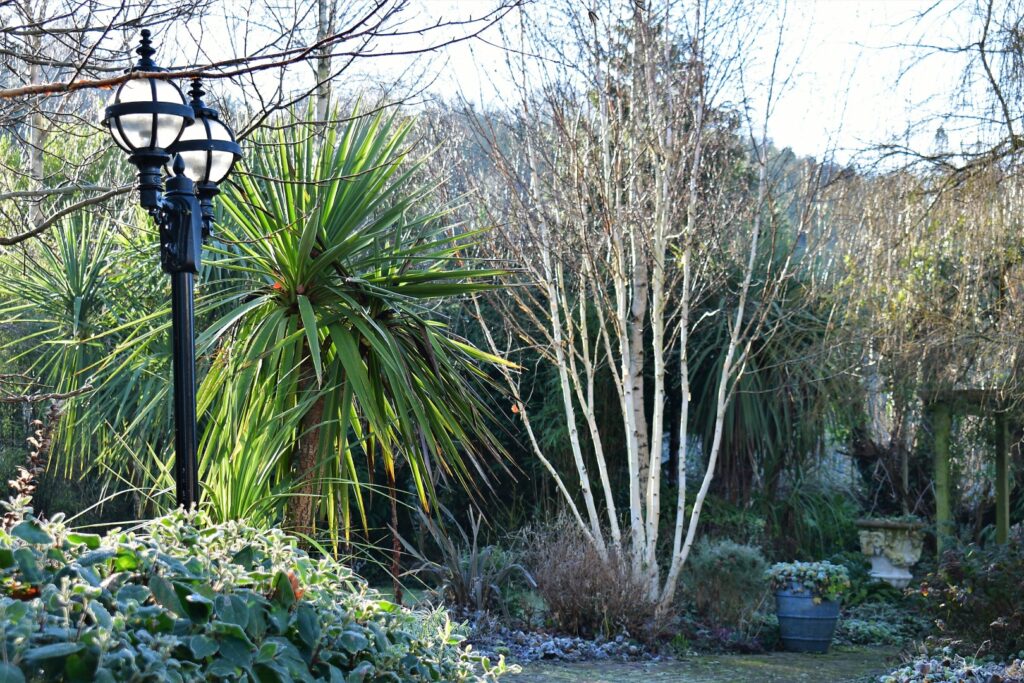
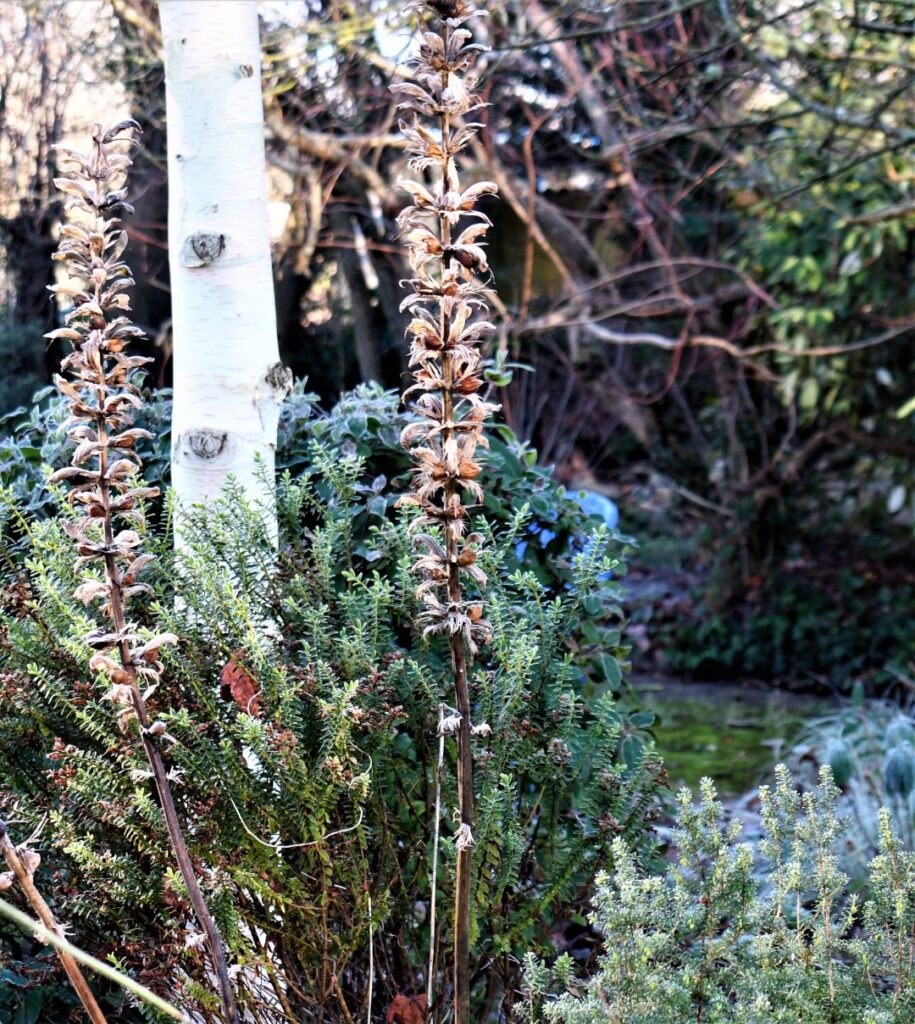

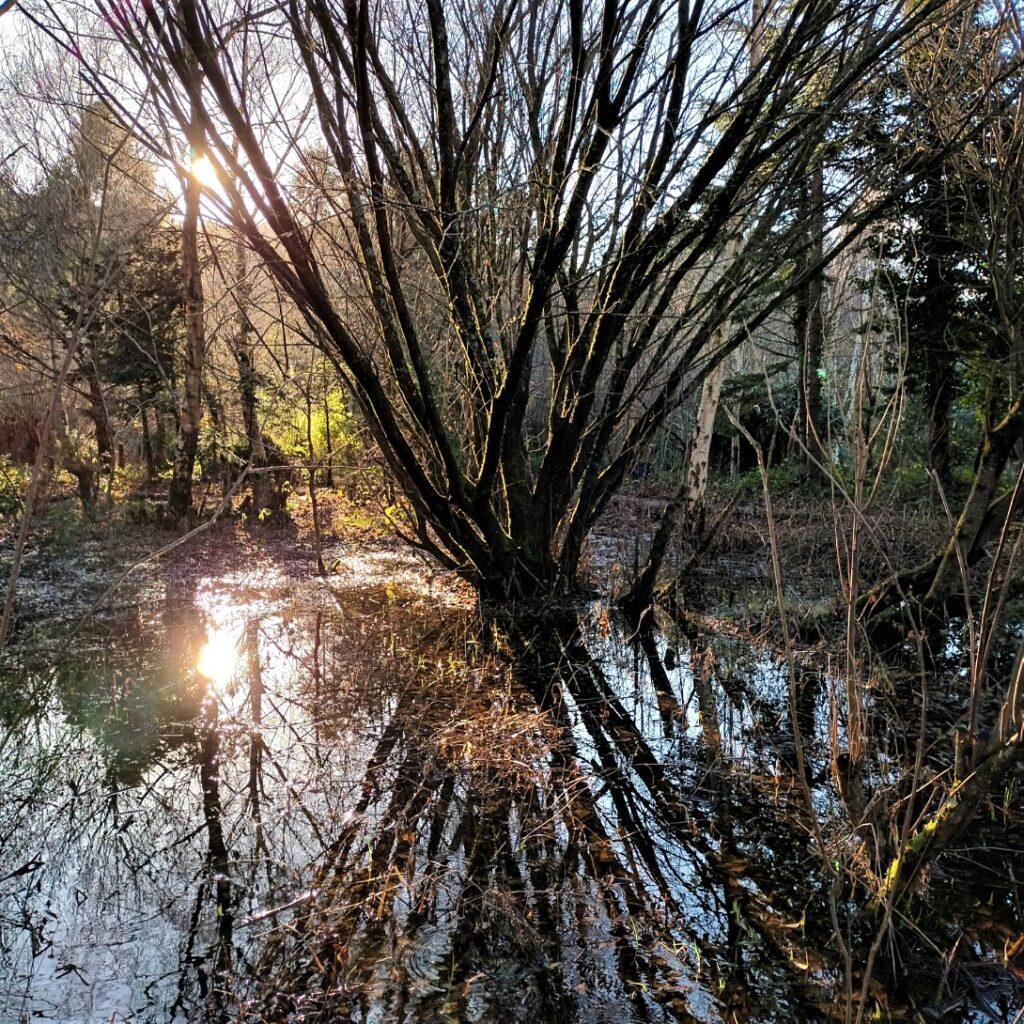
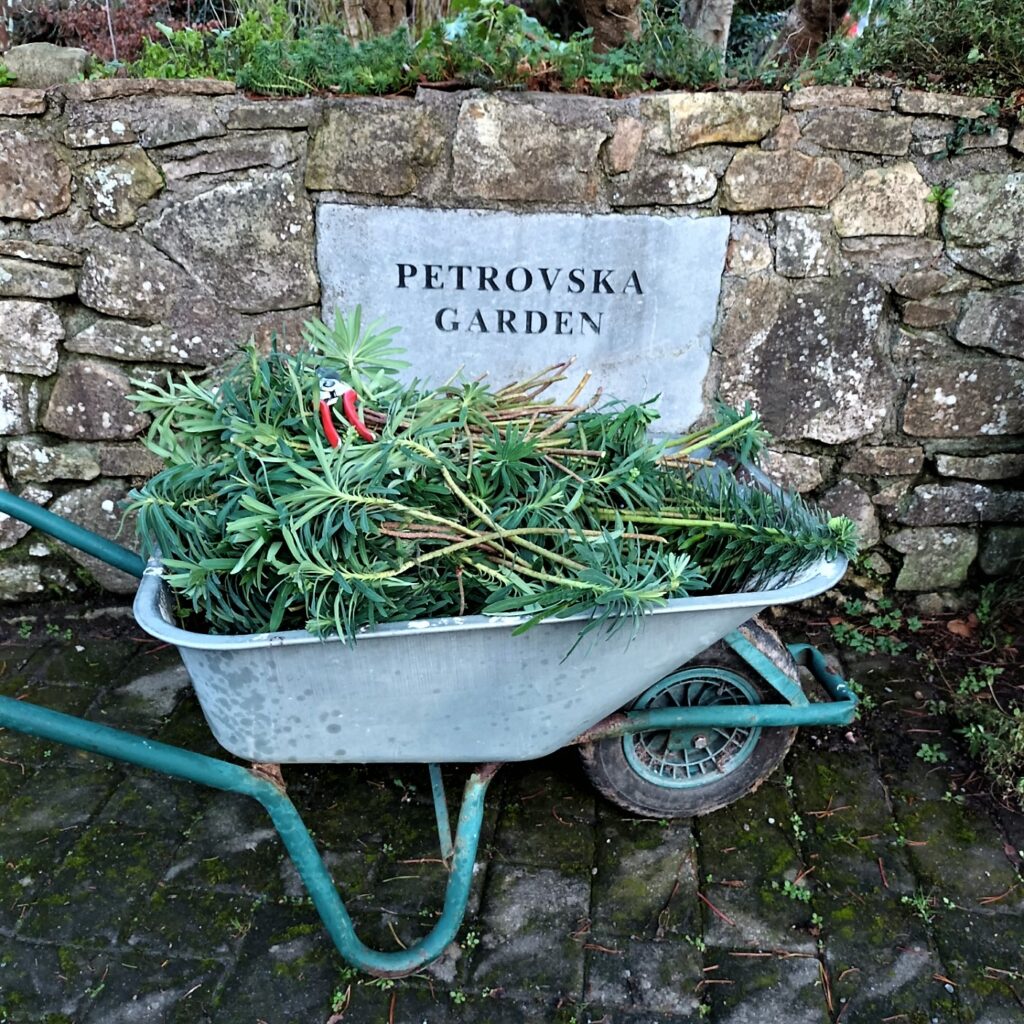
My Gardening Month January 2023 …The start of a new Gardening Year
I am often asked at Gardening Q &A’s do you give your honest opinion when asked about a garden … and my answer is I do , sometimes brutally and often I give my opinion even when I haven’t been asked !
Of course if you think the person is a beginner or somehow unsure about their gardening skills or wouldn’t be able to take criticism on board then I certainly would not be directly honest but I always try to be constructive . I have one gardening friend who always offers her view on a visit to our garden here and I value that opinion as it has a lifetime of gardening experience behind it and from my first garden in Rosslare forty years ago I have always asked advice from experts .
Gardeners have all been beginners and they always remember how it felt not knowing a hydrangea from a eucalyptus and the best advice any gardener can give or receive is Right Plant Right Place .
Like all gardeners however we sometimes , most times , don’t take our own advice and we plant the wrong things in the wrong place , convincing ourselves that SOMEHOW this one will buck the system and survive like Gloria Gaynor !
This week I had such a moment when the recent hard spell cut down a beautiful New Zealand purple cordyline I had planted into a pot in the front of the house three years ago… any of these variegated or coloured cordylines are tricky and prone to prolonged frost but I thought the south facing position against a brick wall and my superior knowledge would protect it … not to be and Jack Frost left it in the sorry state you see in the photo … will I try again definitely not , lesson learned … AGAIN !
But you know I got three years of enjoyment looking at that cordyline and it cost originally probably twenty euros … three years of beauty, I ‘ll take that .
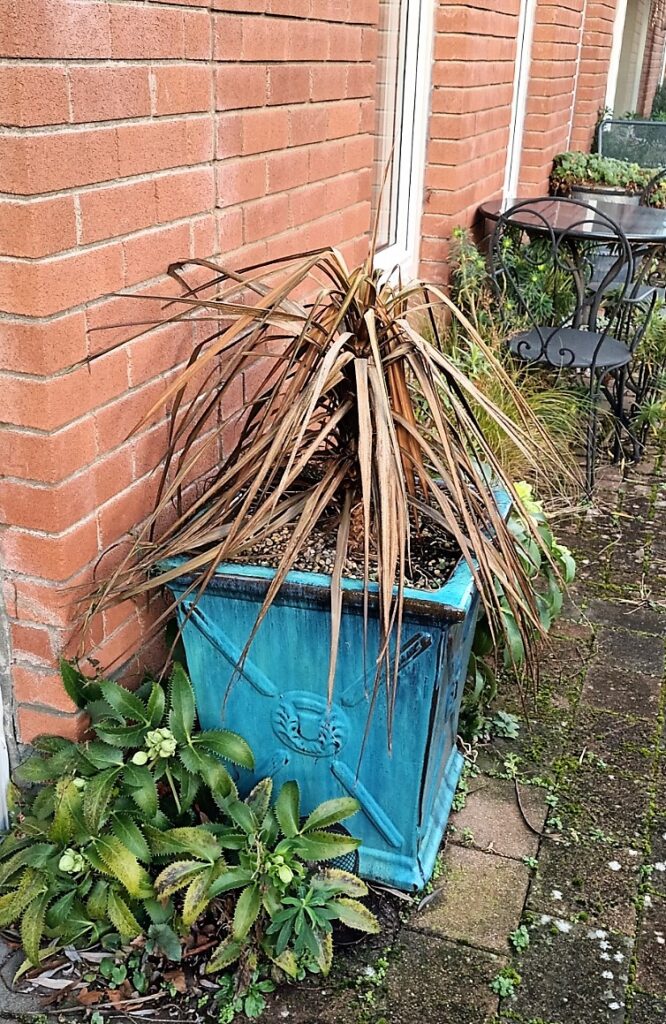
Our January frost spell lasted just a week but in that week it was as damaging as the last heavy frost of 2010 in Ireland which went on for almost six weeks and gardens all over the country including ourselves lost a lot of normally hardy shrubs and trees .
Of course the stuff you would like to die in the frost doesen’t and I am thinking specifically of parrot feather , myriophyclum aquaticum , which has got a grip on various parts of our water garden areas and is very difficult to get rid of . A beautiful looking lime green plant that grows on the water’s surface and which if not controlled quickly spreads and takes over large areas . I have tried spraying it with round up , no use and the only solution is to rip it out every few months and I have been doing that for the past ten years since first planting it . It is sold in garden centres from time to time with no notice about it’s invasivness and is fine for concrete or rubber lined man made pools where it can be easily fished out but here it is a huge problem for us as the water areas are natural and in some parts wide and deep so you can’t stand in the water and reach with an extendable rake the areas not close to the sides .
Last week we attacked the lower water area and pulled a huge mass of parrot feather out on to the bank where it will be left for a few days to allow any little water creatures caught up in the weed time to escape back into the water .
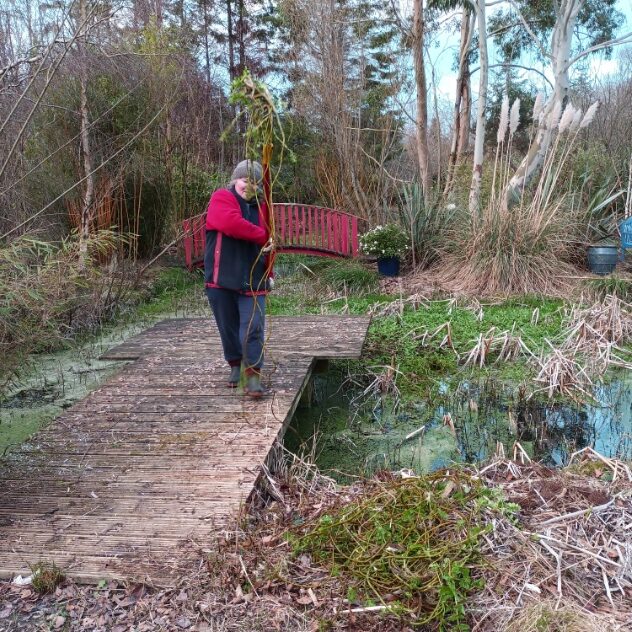
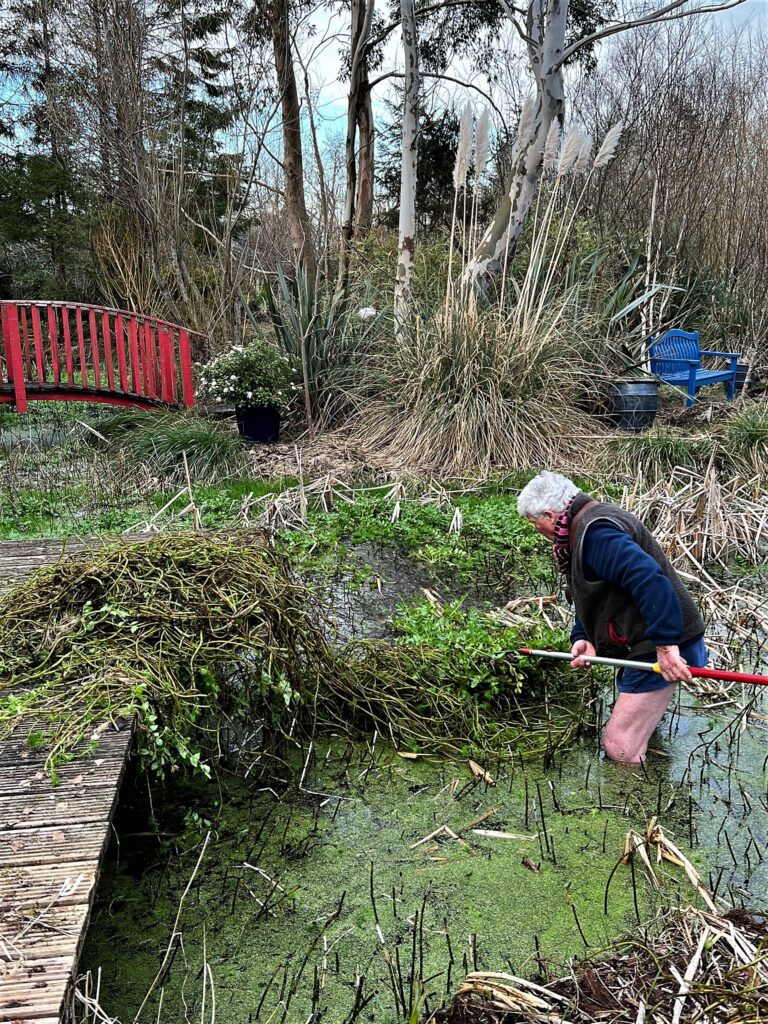
A lot of my gardening work in January and February is brambles as I wrote last month and I love getting a good grip and yanking them out by the roots cave man style but occasionally the odd one resists and I get yanked into them by my momentum but warm and enjoyable work !
Brambles are hugely invasive and if left to themselves will colonise large areas very quickly with rooting systems that when they get a hold need to be physically dug out individually … brambles arch outwards and down towards the ground and about a metre before touching the ground again the bramble grows a clump of roots at the end of each tip and as soon as the tip touches the ground the roots are immediately ready to anchor themselves into the earth and the regrowth cycle continues like that until they either run out of ground or are cut down … brambles are conditioned to survive and multiply and the gardener really needs to pay attention to them or be overrun .
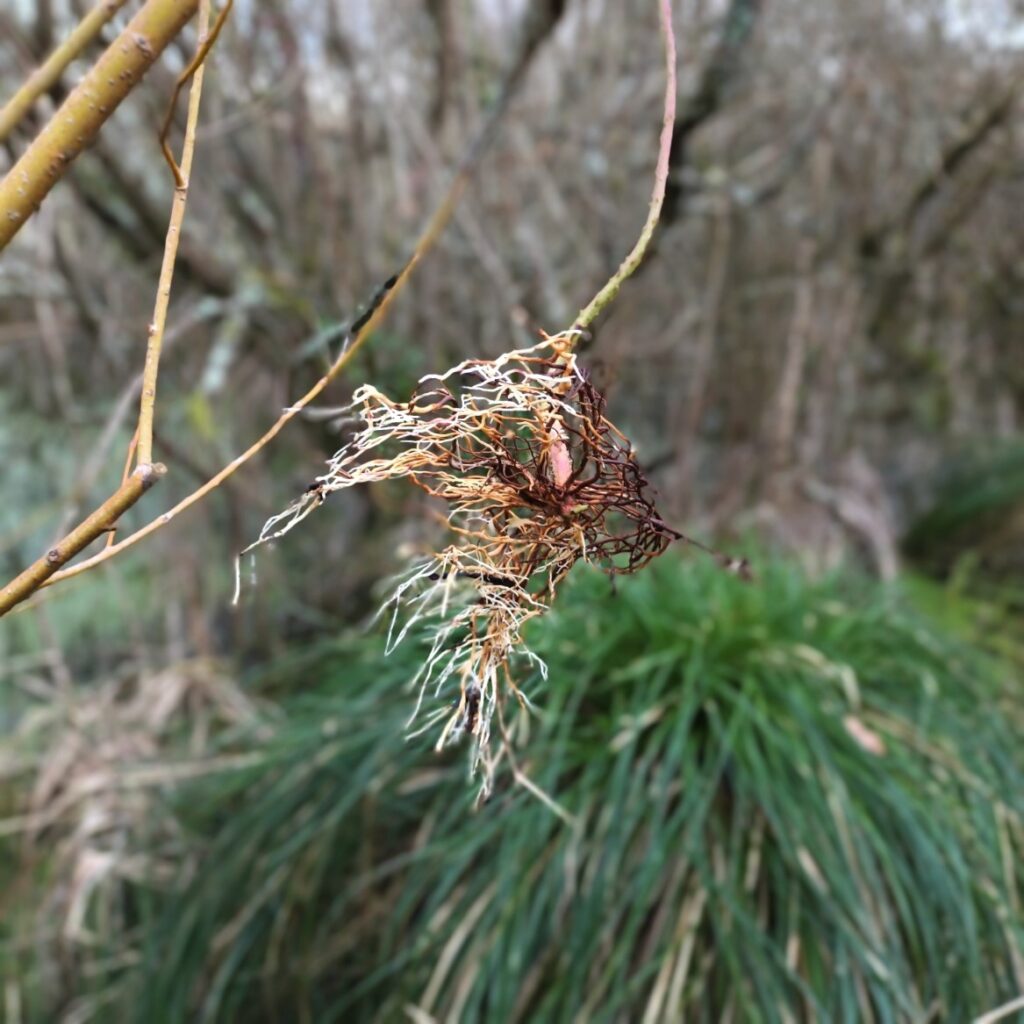
We both love being out in the garden here although I always feel Snezana gets more of the wellness and mindfulness out of it than I do as she takes the time to stop and commune with the trees ( she does she does ) whereas I have a more blue arsed fly approach trying to fit all the jobs in and I am always a bit suspicious of all this mindfulness you see in newspaper articles at this time of the year when people spout off about the pleasures of working in the garden however one article popped up in the UK Telegraph Gardening Section of January 21st by Bunny Guinness which seemed to say it best .
“ Gardening sucks you in . From the moment you start a garden you create the opportunity to make the perfect space to live with .Unlike creating a home you will never totally finish it . As your garden grows you can remould it and see endless new plants and possibilities that pique your interest. There is nothing else in life that grabs hold of you like a garden . Watch over it carefully and ponder its possibilities . A long term engagement with this is the best tonic for both mind and body ”
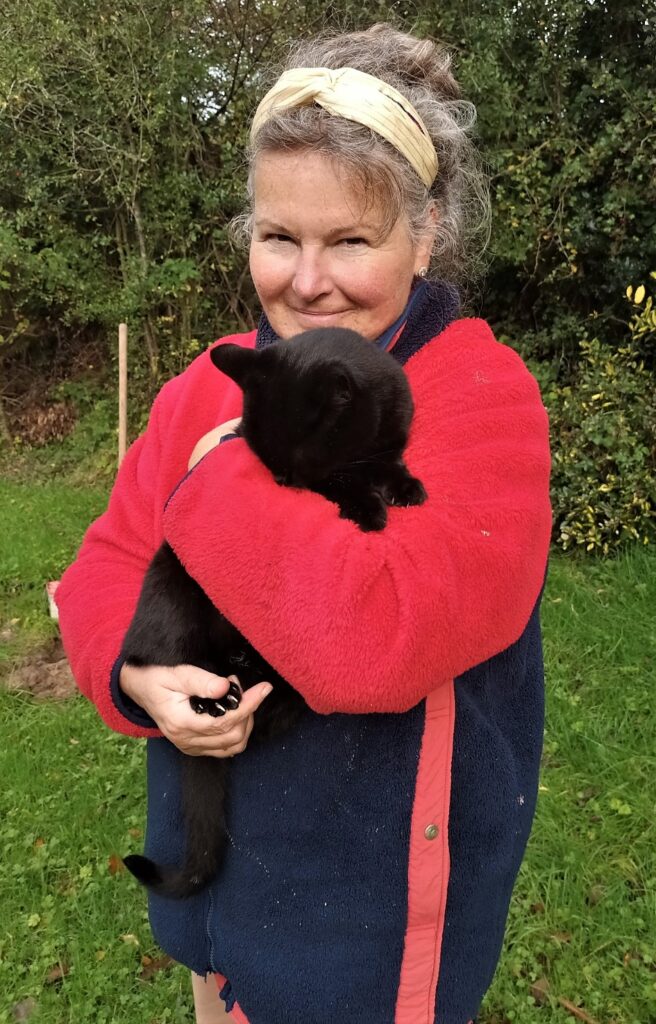
And a memory of my childhood growing up in Barron Park in the early 1960’s
I often share memories of my time working abroad particularly in the Former Yugoslavia during and after the Bosnian War but my overseas career also involved a two year stint in the Seychelles Islands 2006 / 2008 where I met and worked with some marvellous people .
But the following piece is from my time growing up in Barron Park in the late 1950’s … all the families , over sixty of them and all young , had moved in together to the new housing estate in the mid 1950’s so there was lots of kids my own age to play with and on non school days we played outside from early morning to tea time then off out again until bed … no TV in those days so we made our own entertainment , off exploring the countryside which in those days came up to the edge of the estate but for the boys soccer was our main sport and the boy who actually owned a football always had to picked on a team … in my time if we were lucky maybe two boys owned a football which was a precious thing ! for me an idyllic place from where I have the fondest of memories .
Every fine evening after school we selected teams and played soccer in the Park , everyone got a game , no such things as goal posts back then , a few coats on the ground was grand .We all had favourite footballers we liked to imagine ourselves as usually Di Stefano and Puskas of Real Madrid and quite a few liked Garrincha of Brazil while my own favourite was Jimmy Greaves . The game usually ended when we were called in for our tea and come 6 pm it was like the Muslim call to prayer with all the mothers calling us in , nobody compared notes on what their tea was and it never occurred to us that anybody got anything different and we certainly never experienced hunger although I am sure quite a few mothers went without to make sure we had sausages the odd time .
Mrs. Keane opposite our house had two sons, Johnny and Liamie , lovely lads but if you touched either of them during a game and they got hurt and ran home crying then the game ended and we all scattered as Mrs. Keane was a lioness where her lads were concerned and she would charge out of the house looking for the culprit who hit her Johnny or Liamie but cross Mrs. Keane at your peril and one day she chased myself and Alec Logue out of the Park and up into Ard Fatima , we kept running until we reached the railway gates about a mile away and she was still after us swearing vengeance and as we kept running we would ask each other “ is she still there ” … she gave up as we ran up Ard Gaoithe past where the rugby pitch was later built and decided to take a round about detour of over two miles before chancing going back to the Park by the main Cashel road after two hours … just passing the railway gates at 2nd Barron Park Jesus she was waiting for us and jumped out and off we went again , Alec and I with Mrs Keane in hot pursuit swearing what she would do to us when she caught us and it was long after midnight before we felt it was safe to run the gauntlet again and get in home safely !!
Mind you Mrs. Keane never held a grudge and next day all would be forgotten … as long as you didn’t kick Johnny or Liamie !
Years later when I saw Butch Cassidy & the Sundance kid where the sheriff’s posse is chasing the outlaws and stayed behind for hours , the chase seemed to go on forever and finally Paul Newman turns to Robert Redford and says “ WHO ARE THEY ”… it brought me back instantly to the night Mrs. Keane chased Alec and myself !
February 2023
Brigid is Ireland’s pre Christian Goddess !
Here in Ireland and the UK we regard February 1st as the first official day of Spring and I brought that thinking with me when I started to work in the Balkans which amused my local colleagues in Macedonia and Bosnia no end as generally there would still be two feet of snow outside the office window especially in Sarajevo where the snow and ice could continue until at least the middle of March .
The 1st of February in Ireland was and is marked as Saint Brigid’s Day , a shadowy figure in Ireland’s early Christian history that in my schoolboy days nothing much was known about but back in the day Saint Brigid was a woman so nothing much of value to know about in those macho all male Catholic dominated Irish times !

But boy has all that changed and this year for the first time Saint Brigid’s Day was named as an official Bank Holiday , a day off for everyone with parades and festivals in every town across Ireland in honour of Brigid and the Lady herself has been reincarnated as a roaring strong warrior standing up for women’s rights and the LGBT community and not only that … Brigid’s existence as a pre Christian Goddess has been highlighted and the evening parade I watched in Clonmel had ecstatic dancing mature ladies all face painted in runic colours with a definite pagan feminist air !!
Great to see and I can only imagine what the Bishop’s of Ireland thought … cute enough though to keep their heads down and not criticise as well they might considering how they kept quiet through all those years of clerical abuse of the children of Ireland .
For me the first sight of Spring is when our weeping willow in the front garden shows it’s first golden leaves .
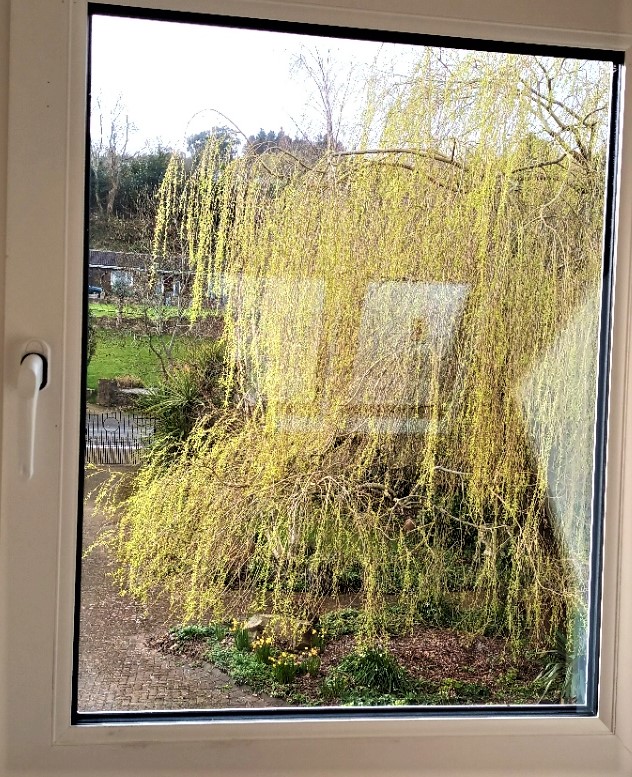
My first trolly load of 2023 was sourced in Clonmel Garden Centre , all bare rooted and great value and destined for the new wilded area in the Lower Field , two decent sized small trees , viburnum opulus , the snowball tree plus a hazelnut and three copper beech … they all should do well in the wet ground of the new area and while all are deciduous in the winter , come Spring they all have lovely leaf foliage .
Last month I wrote about the loss of a beautiful but weather tender three year old purple cordyline in a pot at the front of the house which was killed by the frost in January and said this was the last time I would buck the system of Right Plant Right Place … there really is truth in the old maxim of one born every minute or better still while in the cliché mood , no fool like an old fool … and a new purple cordyline found it’s way into the consignment of new plants !
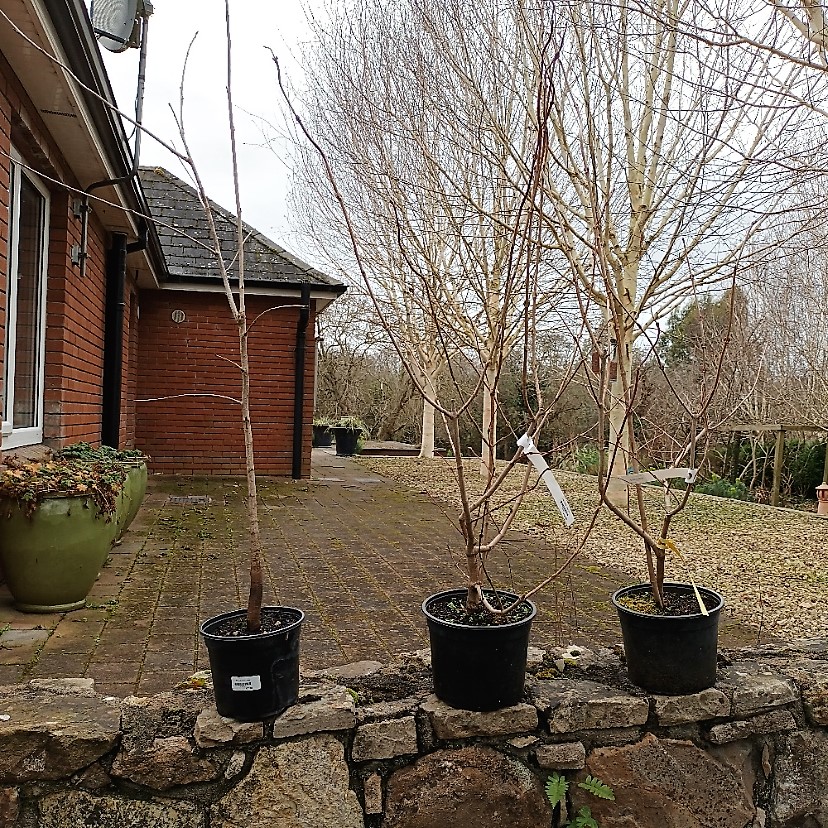
Last Month I wrote about visiting Carl Wright’s garden in Co. Clare which I described in my June 2015 post . Carl is a nationally well know garden writer and lecturer and we were delighted to welcome him here at our garden a few years ago .
Carl was kind enough to write about us later
“ I recently took a little trip to visit a few gardens in Co Tipperary. Including the incredible creation of Michael & Snezana O’Riordan, – Petrovska Garden. It is a wild, unique and interesting project covering around seven acres of very wet woodland/bogland. Michael has created a series of wooden walkways & paths, mostly raised above water, which wind their way around the natural wilderness bringing you into intimate contact with the natural surroundings here. It’s like an adventure through some primieval swamp and has an almost alien & mystical like feel to it. The journey is puntuaced by little ‘garden spaces’, glades, borders, stunning water features and architechtural features here and there to add to the interest. The garden is open by appointment and all the relevant details can be found on their FB page .”
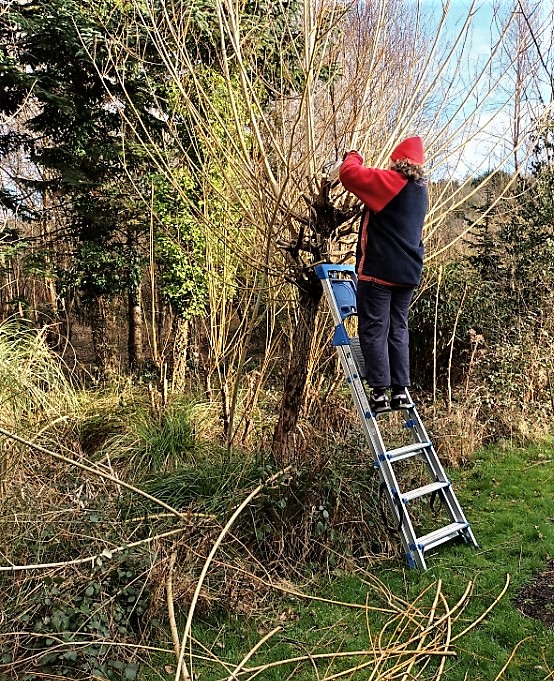
We have finished the pruning of the golden willows but it took two to three hours every day throughout February and we chopped and collected over fifty barrow full of wood kindling for the wood shed and these will be dried and ready for us next Winter . Stacking wood is a learned art and I learned from the best in Bosnia … Snezana has no patience for stacking wood and takes the view of just throw it in there and if they fall they fall however as the actual wood cutter here with a chain saw she reigns supreme in our garden !
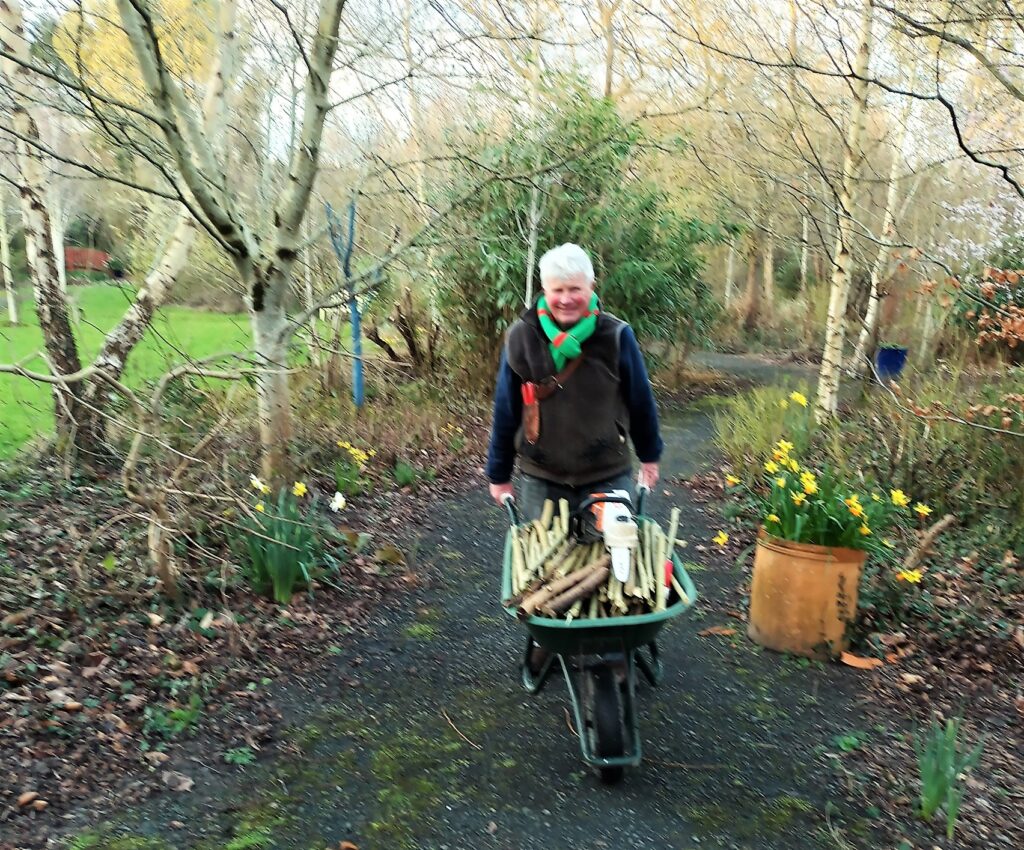
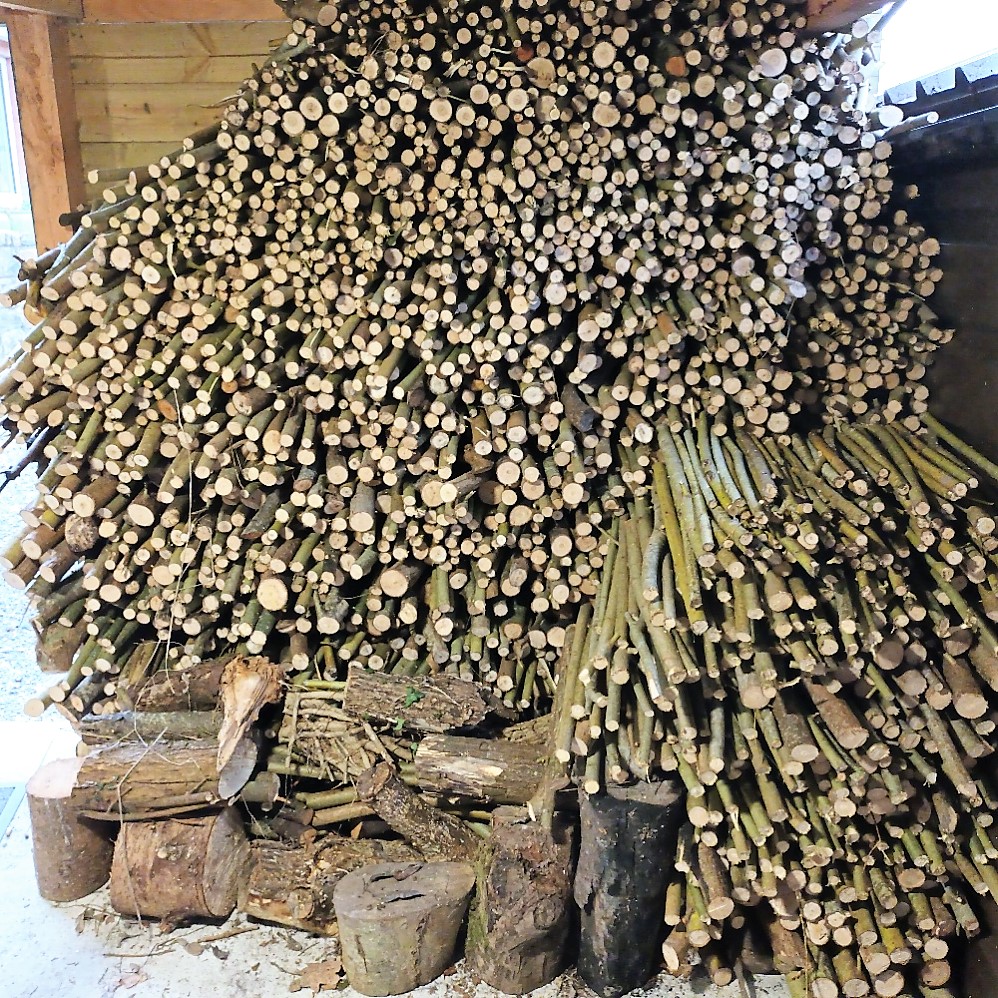
The new Water Garden area
The new Water Garden walkway in the Lower Wood area was discovered two years ago by chance when what started out as a simple bramble clearance operation with a digger discovered water just beneath the ground and we kept excavating down to the marly sub soil about a metre deep and eventually shaped out a small stream and pool and since have I been trying to establish planting that will survive both the deer and the clayey soil with the deer proving to be the worst obstacle as immediately they overnight ate the first silver birch , a beautiful snow white jacquemontii and they next moved on to the hostas and ate every one of them plus unusually for deer they then ate all the emerging shoots of the summer flowering bulbs … raises a laugh when you read this I am sure but apocalypse now is heading for those f..kers !
Now will the deer eat what you might like them to eat … not a chance as for example they won’t touch rushy reeds which would be useful as those rushs have now turned out to be a real problem . The new area proved a haven and natural home for clumps of rushes which at first I allowed grow along the new paths as there was nothing else there and they looked good with a nice architectural shape . I cut them back for the past two years and learned to live with them however they just grew and grew everywhere among the new planting so last week decided apart from one or two clumps the rushes had to go . We all like to talk about natural gardening and letting our patches grow wild but there is a limit to wildness and I am drawing it now on rushy reeds !
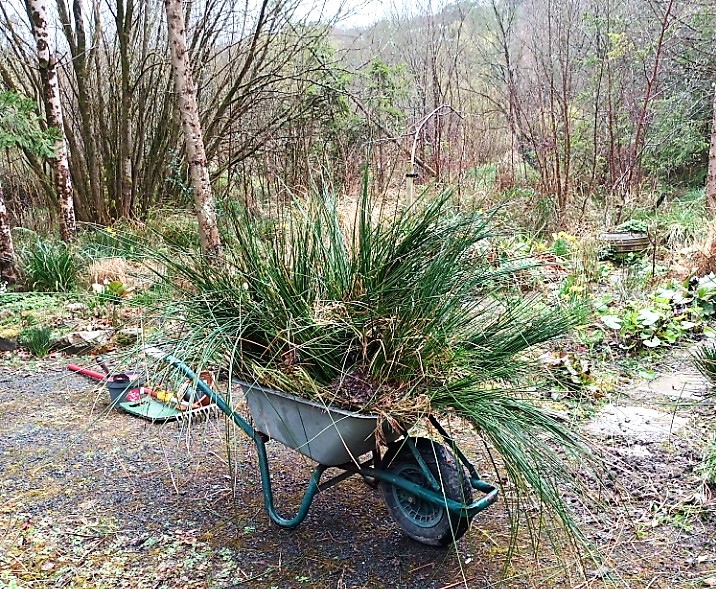
RIP Rebecca Hunt
Over the years of visiting Kilcoran Garden Centre there was always a smiling welcome from Rebecca Hunt and all in the gardening community were very fond of her . Sadly Rebecca passed away in mid February , we all knew she wasen’t well these past few years but she was a fighter right up till the last and will be sadly missed by all of us .
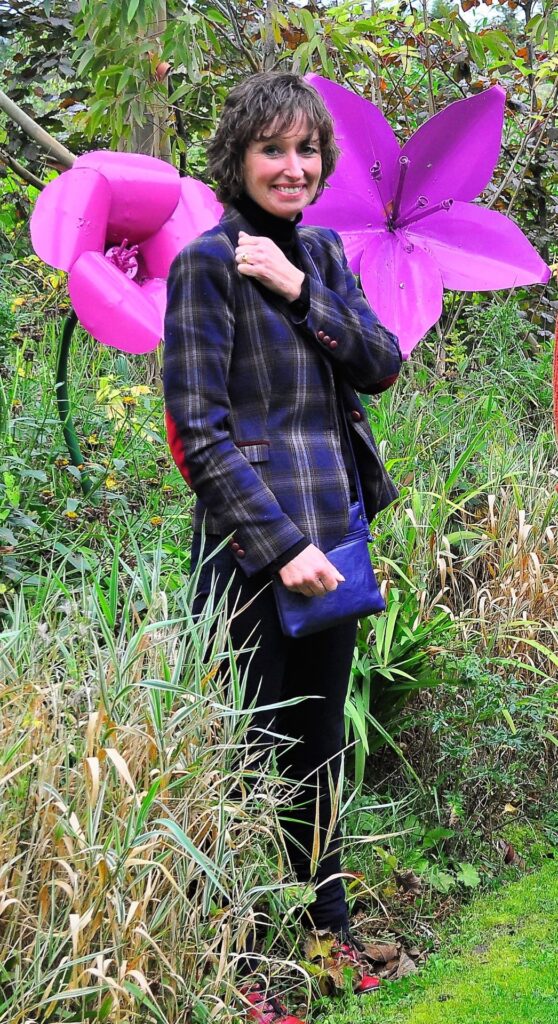
I have often praised the euphorbia wulfeni perennial and this year probably as a result of the hard pruning I gave them last Summer they showed flower from mid February and will continue to get more dramatic right up until the end of June .
There is another euphorbia however which although an unsung hero of the garden is not widely grown or even sold in the garden centres as it is not cute or sexy like it’s fellow euphorbia wulfeni which gets all the attention and this is euphorbia robbiae . I have a few plants which I picked up from a friend’s garden and it grows really well in poor dry soil in shade . I find it slow growing and rather than self seed like it’s cousin , wulfeni , this variety spreads by underground runners but it is a worthwhile plant and the Royal Horticultural Society certainly thinks so and have given euphorbia robbiae it’s prestigious Award of Garden Merit .
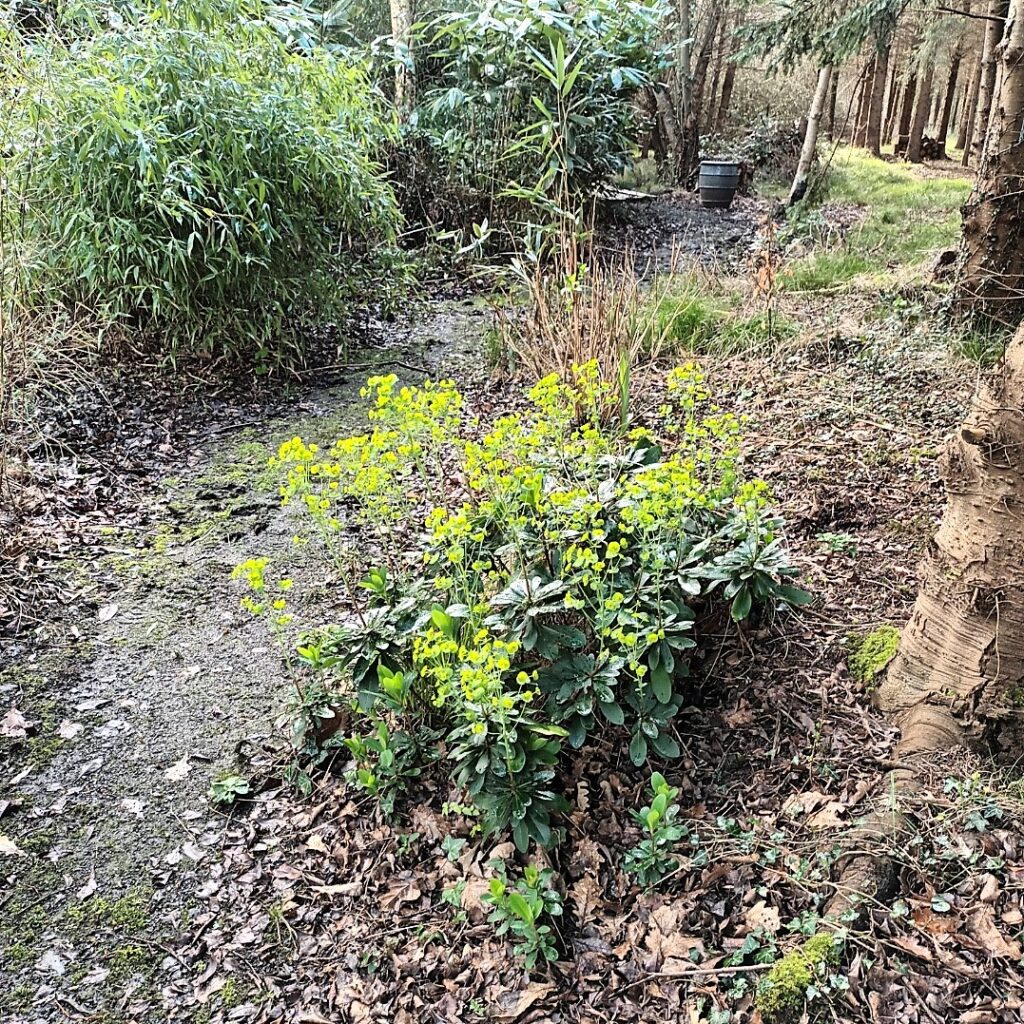
Last month I wrote about pruning and mentioned in passing that I had to take drastic action with a viburnum tinus in the front garden which had blocked out a view from inside the house of a beautiful multi stemmed silver birch . Like in life a gardener should never have to take “ drastic action ” as it means something major has gone wrong but in this case it meant just hacking into the viburnum until the required shape was achieved which in this case left the poor viburnum looking like a plucked chicken but it will recover but because of the severity of the pruning , and I SHOULD NEVER HAVE LET IT GO THIS FAR , it will take two years before the viburnum looks anything like normal again .

What I should have done was regular pruning for the right size and shape shrub and this I have now done to a viburnum a few metres away in the same raised bed where I cut back about a third of the height and cut carefully above a leaf node on each branch and the overall effect is that you really can’t see any pruning .
But this is the view the viburnum blocked so it had to be cut back
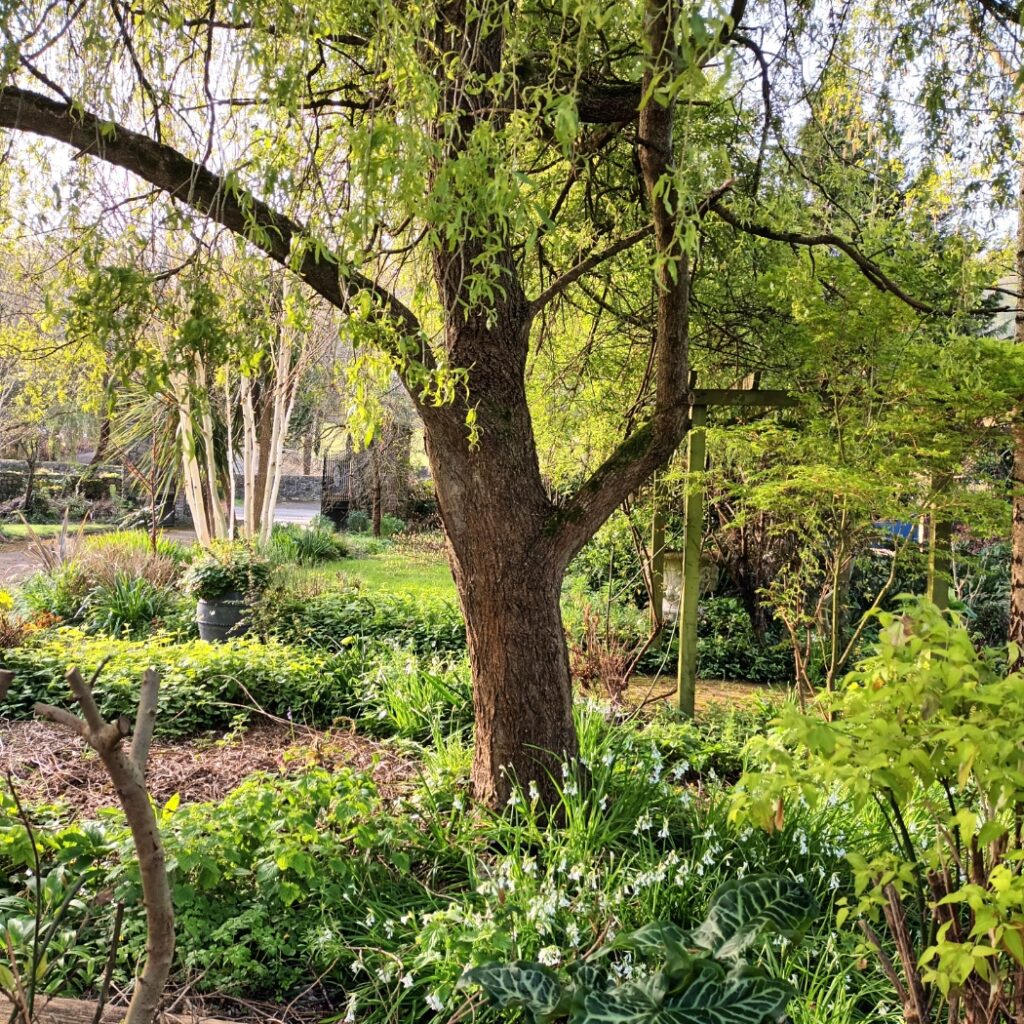
Rhododendrons and camellias don’t do well in our soil but there is always an exception to the rules and we have a rhododendron which I planted into wet rich soil dredged up onto a bank while cleaning out the stream … a really eccentric rhodo this one which blooms several times in the year and can actually be flowering sometimes at Christmas … a weird one but lovely and it always brings a smile to my face when I see it flowering at unlikely times of the year .
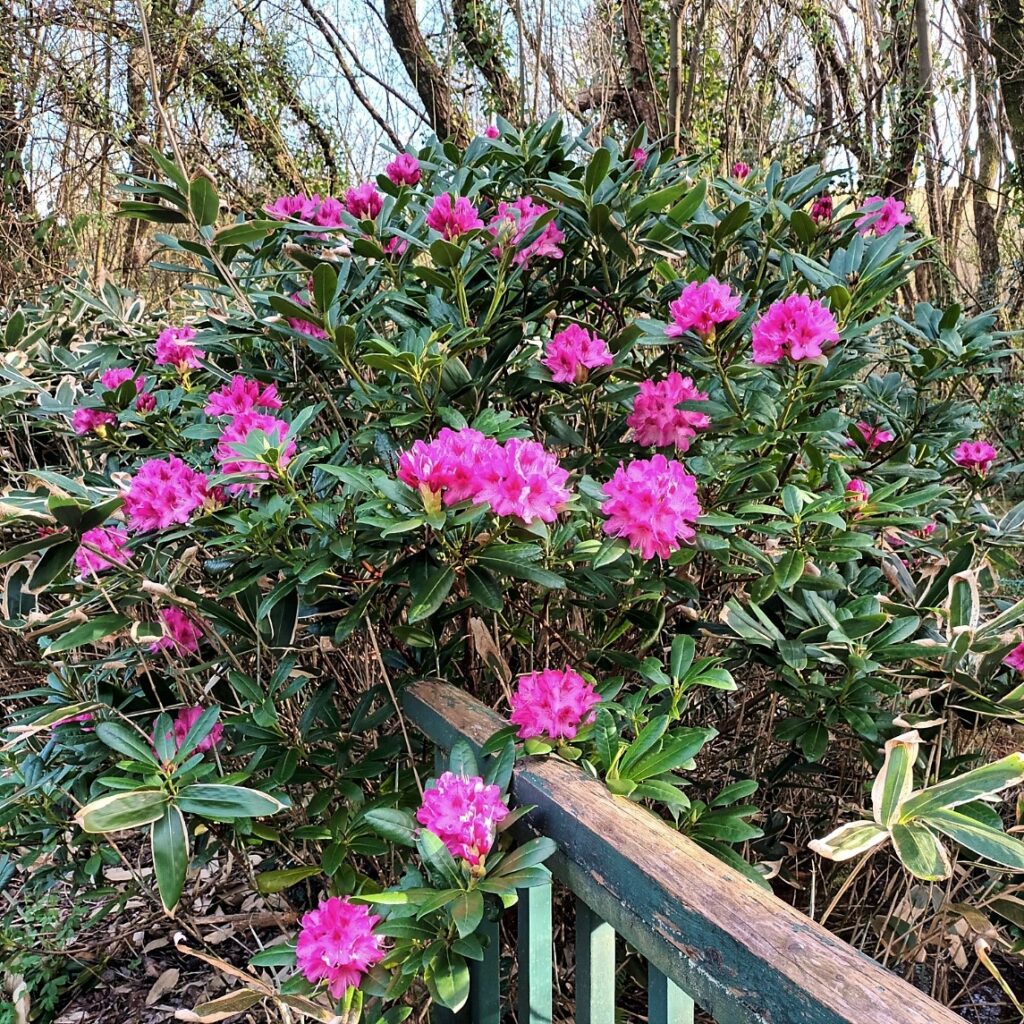
Pots are absolutely necessary in every garden no matter how small the plot is and the bigger the pot the better statement and impact it will have . Summer planting is easy as you can pack the pot with annuals but you need to water regularly from May on as pots are not low maintenance . Blue, yellow or red coloured pots are something special and give the WOW factor and I prefer ceramic for colour rather than a painted terracotta pot such as this one from a 2013 visit to the Majorelle Garden in Marrakech.
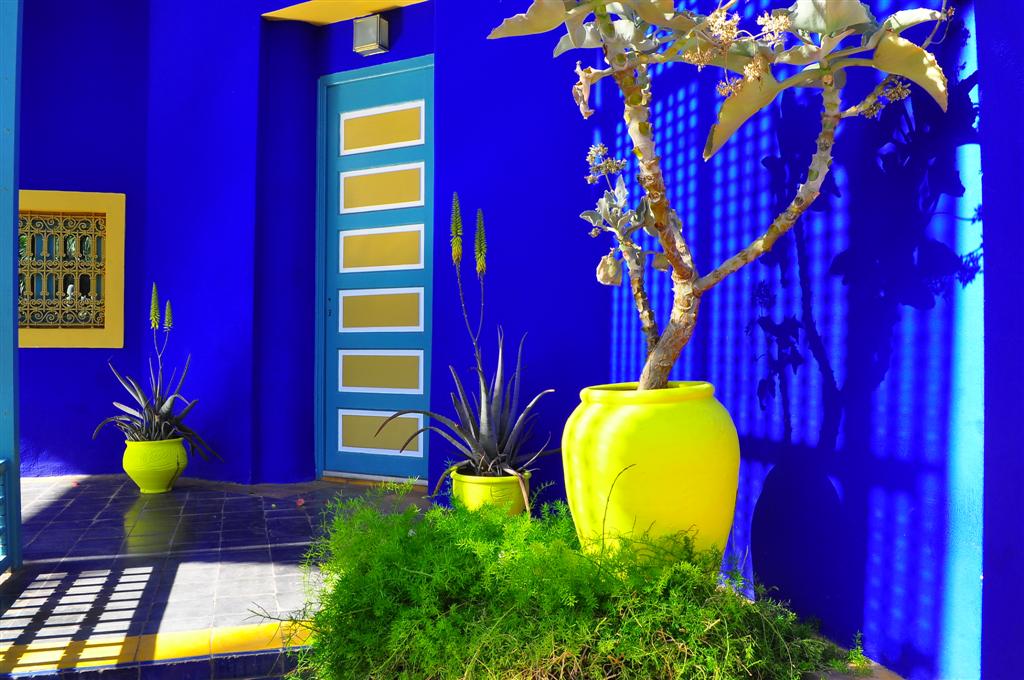
When planting up a pot for the first time I always plant some daffodils deep down at the base and these will come up every year and have died down by mid April when the real feature plant comes into it’s own . The TV gardeners love talking about the lassagna planting method where you plant a succession of spring flowering bulbs layering them at different levels from the bottom up with the latest flowering bulbs such as tulips and daffodils near the top with snow drops and crocus for example as the earliest flowering at the bottom … I am not a fan and find it a bit fussy as I prefer to a have a pot in full display throughout the late spring and summer months but I do have the odd pot stuffed with spring flowering bulbs such as these in the Lower Field area .
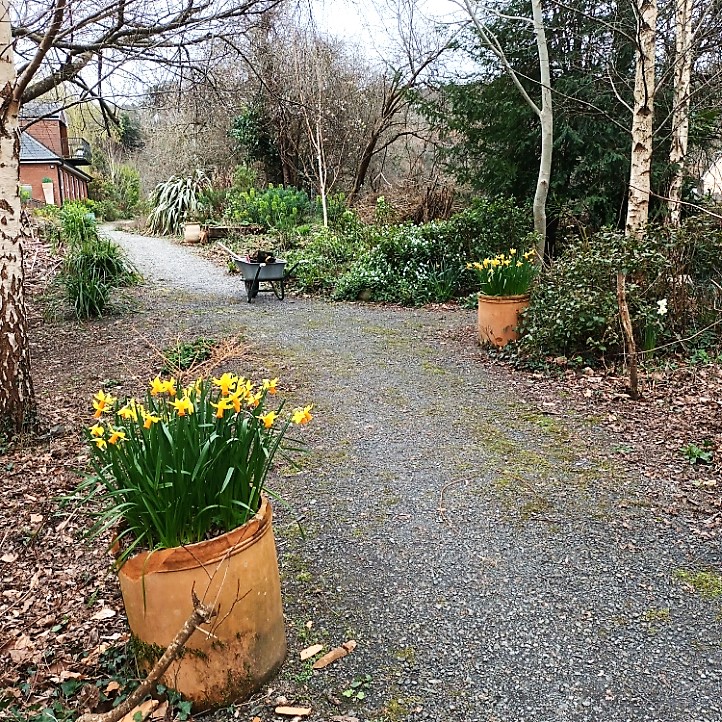
Long before the word ” queer ” took on it’s anti gay meaning older Irish people especially in Wexford used and continue to use the word “ quare ” as in Brenda Beehan’s famous play the Quare Fellow and when I look at the photo of Marakech in March and compare it with the dull sad colour from Ireland in the same period all I can think of is THERE IS A QUARE DIFFERENCE BETWEEN MOROCCO AND IRELAND IN MARCH !
I have always loved history since I was a child and especially the history of Greece and have been reading and collecting books on the subject for over fifty years and going there for the first time in 1974 was a special highlight when I drove from Ireland and spent a month touring Athens, Delphi and the Peloponnese . I also back packed around Crete on my own in 1976 and later on in the two years I worked in Macedonia 1994 to 1996 I travelled regularly across the border and explored Northern Greece down as far as Meteora and as far east as Dodona .
I was lucky enough to get to climb to Olympia’s highest peak , Mytakis , on three occasions , once with Snezana and once with my three boys , Kev, David and Diarm … the daughter , Claire , took one look and said no way just plonk me in Hotel Anais and off ye go although she did later come with me to Athens , Delphi and Mycenae with it’s famous Lion Gate dating from Trojan War times !


Looking at the next photo you will be forgiven in thinking it is just a collection of small stones ready to go into the bottom of a new pot for the garden … not so these are stones I collected in 1974 from the famous sites I visited on that trip … Athens, Olympia , Delphi , Mycenae, Marathon , Sparta , Argos , Corinth … over time the labels have been lost so I no longer know which stone is from which site but no matter they sit there together now in the garden fifty years later , my memories of Ancient Greece !
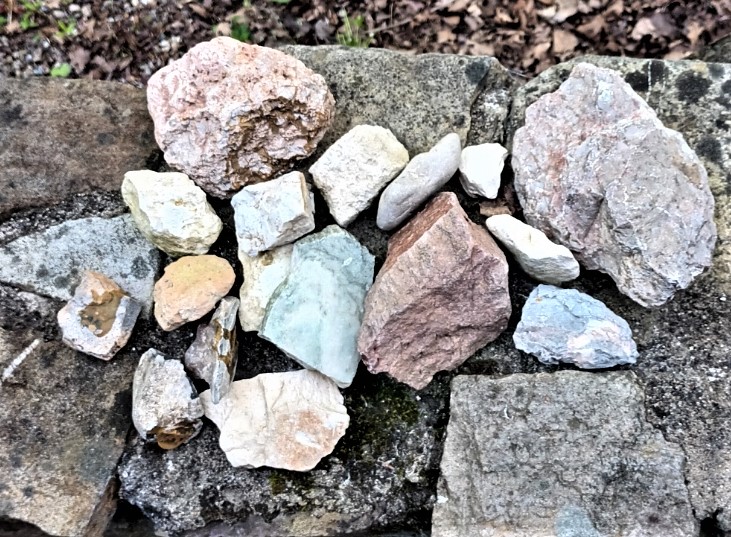
The reason I mention Greece is that we got to go there at the end of March /beginning of April for the first time in twenty years and I will be writing about the trip next month but in the meantime this is a photo from that trip .

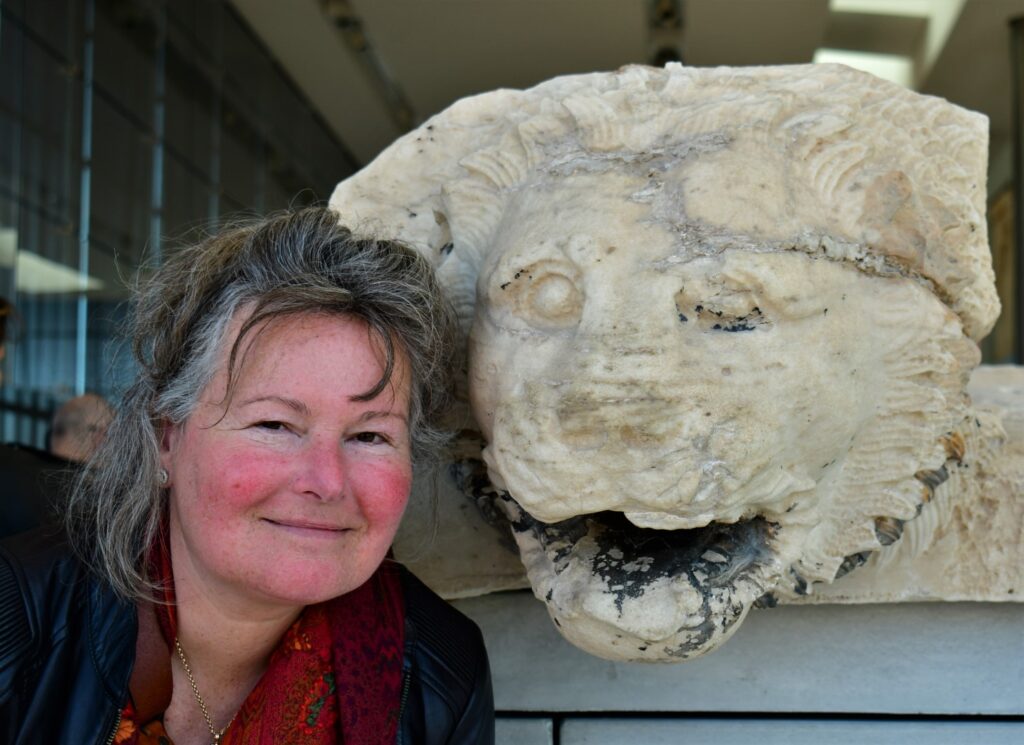
A rare collaboration !
As I have mentioned before we never work together except on the pruning of the willow trees but this week a new collaboration occurred when we tackled the Water Garden spaghetti like wild water cress which if in small quantities around the edges of the area is fine but here in a natural water setting the damm thing just takes off like a rocket and within weeks has taken over the entire surface .
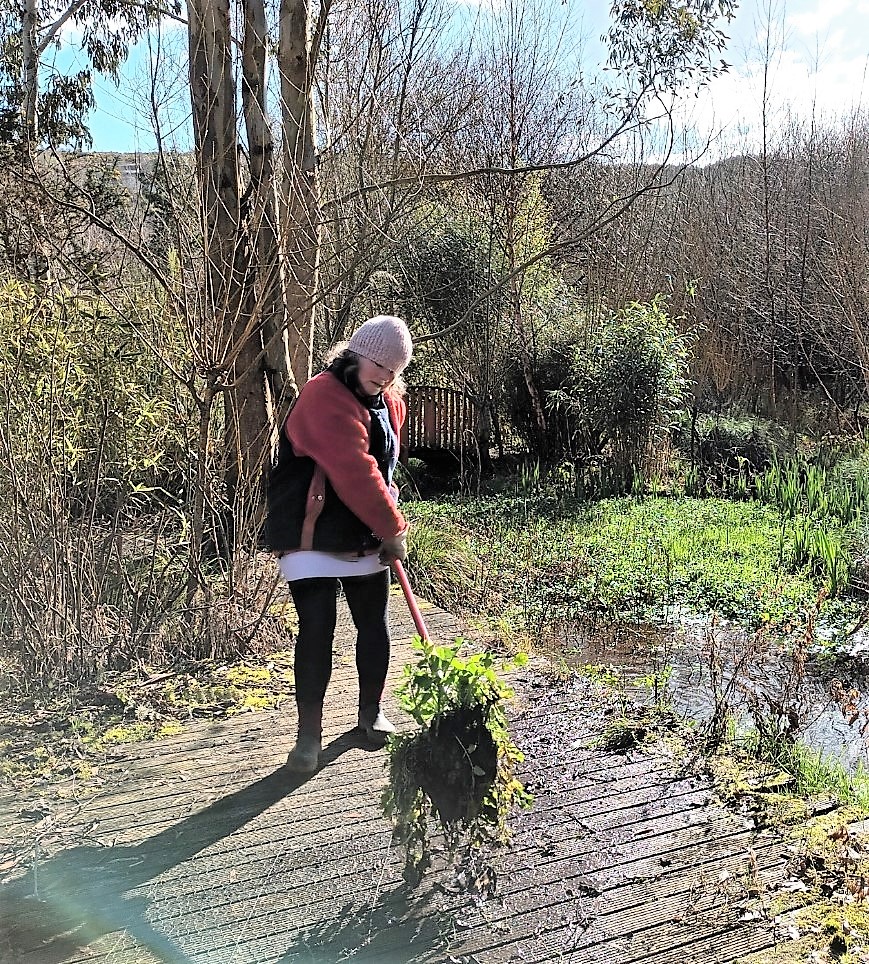
The water cress has to be cleaned on a regular basis every month and it seems to grow thicker in the winter and this can be tricky enough in the island water area where you need to get into the water with a long rake as you can’t get at it from the bank . I know the areas that are too deep for rubber wellington boots and these I leave until the summer when the temperature is warm enough to wade in barefooted and in shorts … but then the rake comes off doesen’t it in deep water so in March weather there is nothing for it but to strip down to the boxers and try and fish it out !
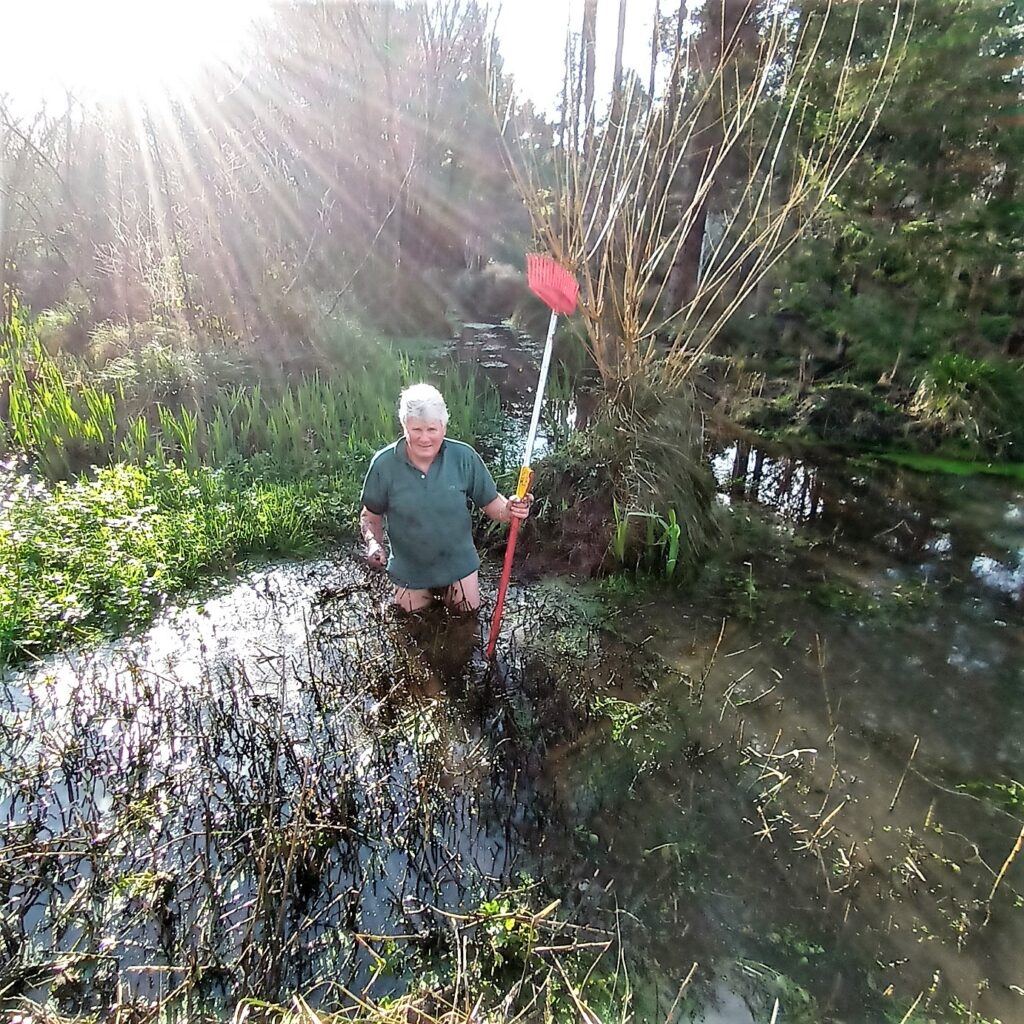
We have finished the pruning and cutting back of the trees and have stacked so much wood since January that we are already almost self sufficient for next winter on what we chopped up these past two months alone.
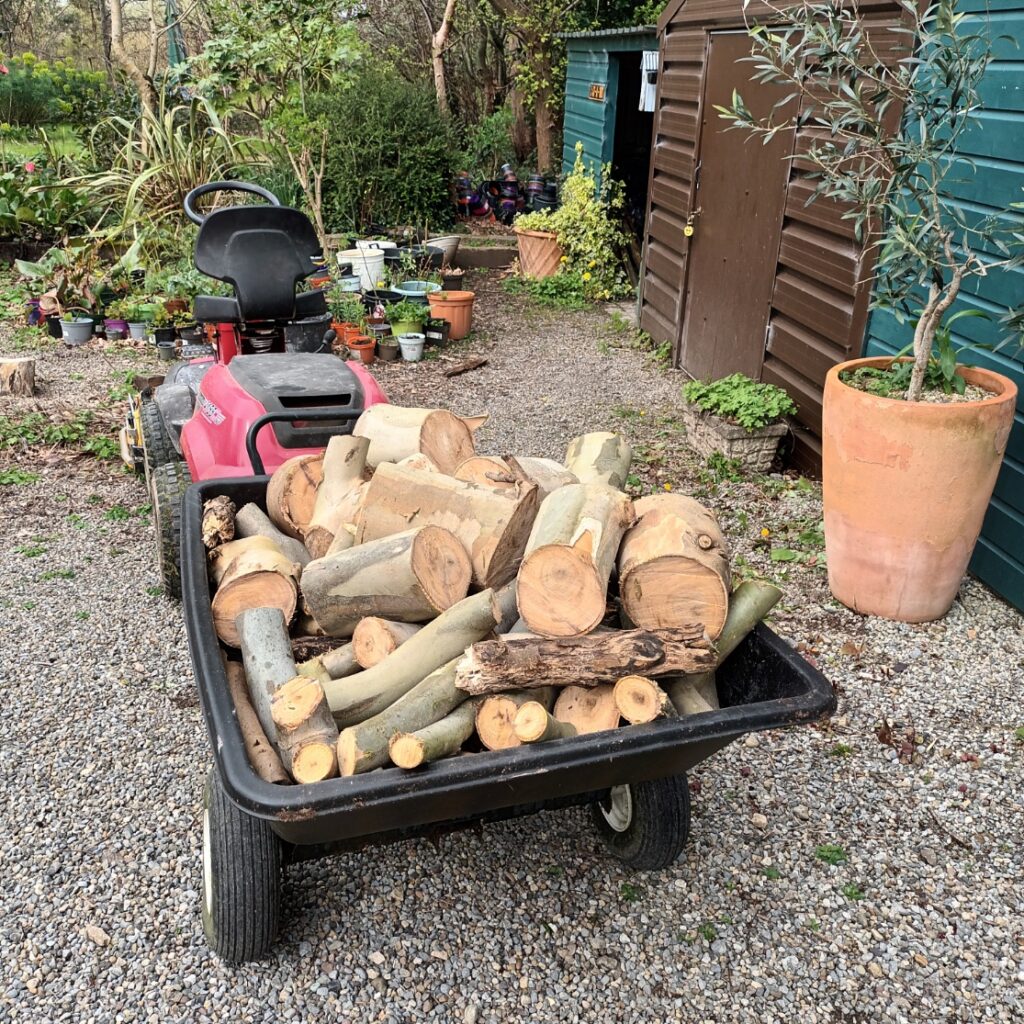
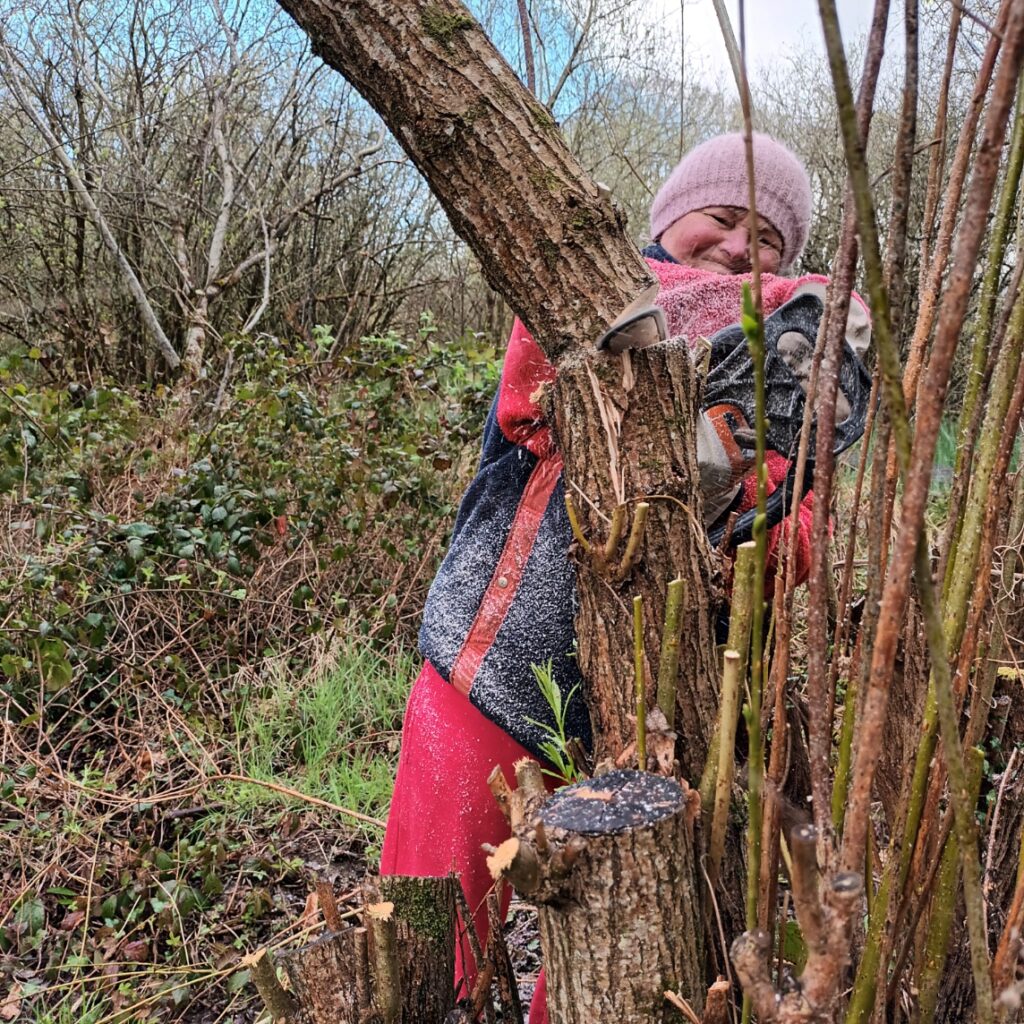
Hosta time again in April 2023
If we didn’t have deer coming into the garden I would have a huge collection of hostas , my favourite plant but unfortunately we have a lot of deer who over the years visiting the garden have developed a sweet tooth for hostas . I try and find nooks and crannies that I think might elude the deer and with this in mind I bought three hostas a week ago , one each of June and Gold Standard and one , Bressingham Blue , new to me but comes with a good reputation for growing into good sized clumps with large leaves … my kind of hosta and these I planted in pots close to the house where they have some hope of escaping the deer .
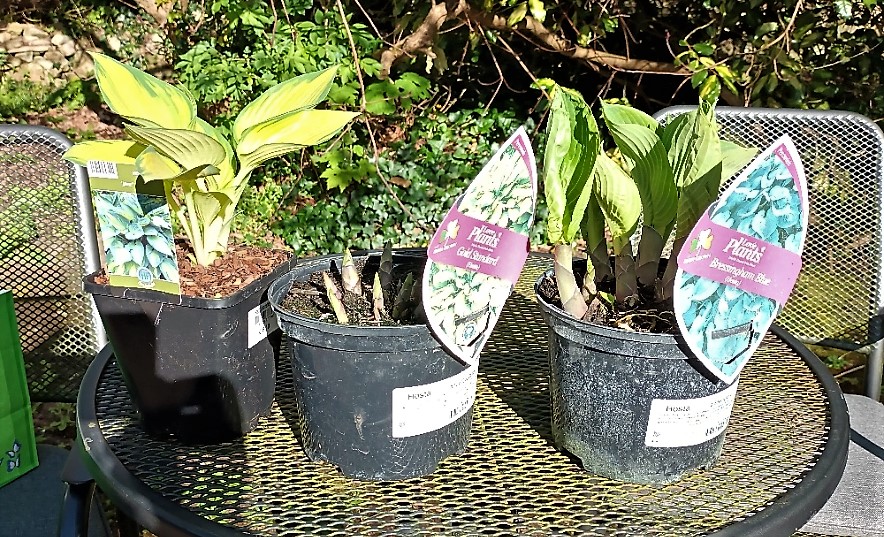
This month I gave the new water garden area , well two years old area , it’s annual hard weeding where I spent two weeks on my knees individually digging out deep rooted perennial weeds such as thistles , couch grass , creeping buttercup , the usual culprits … they will come back but less vigorously and gradually as the ground cover planting increases in density it should eliminate these in time .
It is worth it to put the work into intensively cleaning a planting area in the first few years after the initial planting and the work gets less and less after the first two years .
It also allows me to see what plants grow well in the new area and more importantly to count the remains of all the plants that just couldn’t adjust to the hard clayey soil and that popped their clogs … you learn these lessons the hard way and try not to repeat those mistakes . I learned some hard lessons about pot plants in last Summer’s really hot period when I was away for a few weeks at a critical time where I missed the warning signs that plants were suffering and lost some nice dwarf maples to the drought … again lesson learned and maples in pots no matter how large the pot really need regular watering .
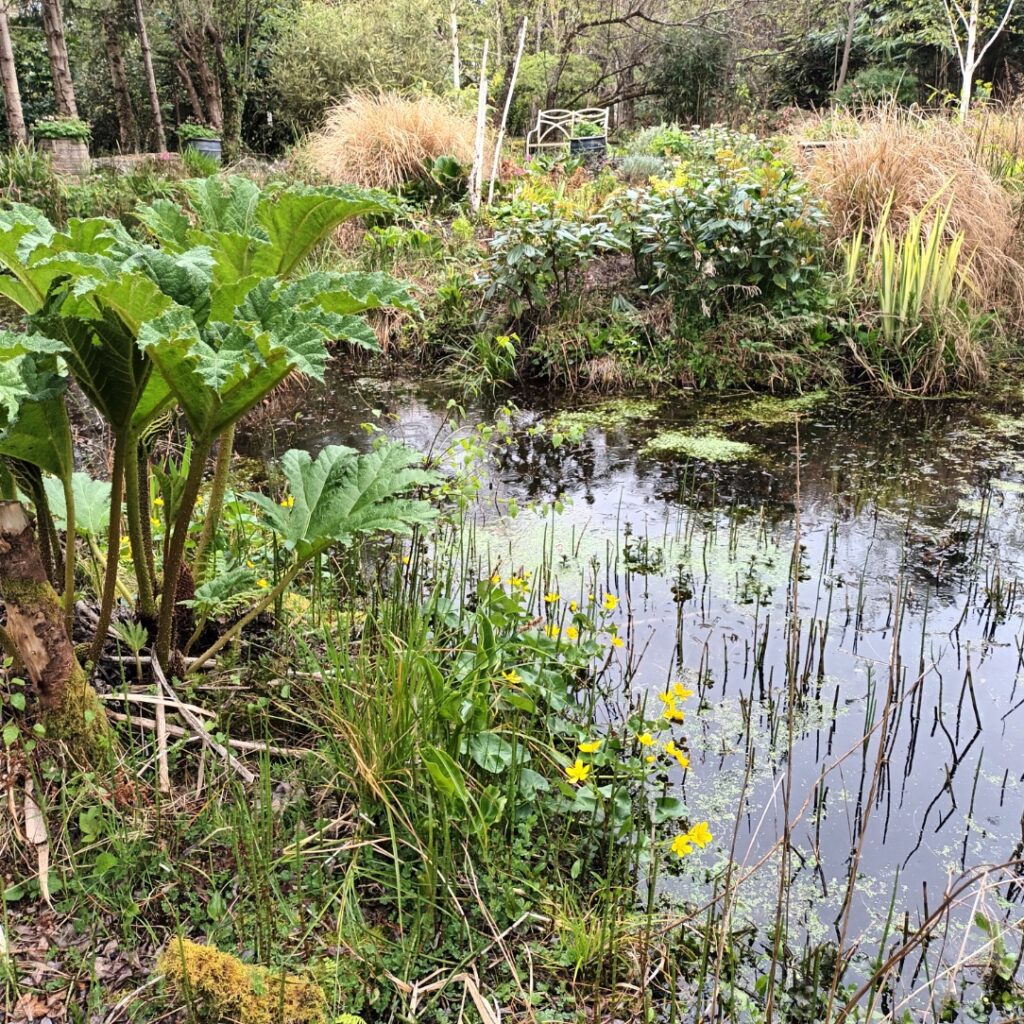
Trip to Greece April 2023

We were in Greece for a week in early April , I have been going there for forty years although this was my first visit in almost twenty years and a lot has changed in Greece since my first visit in the 1970’s and not all for the good either . I know that mass tourism changes a country and people get greedy for more and more lucre from the visitors but Greece has taken greed to a new level with mass concrete hotels , bars and restaurants spring up like mushrooms . Even though in the EU and supposed to abide by building regulations and town planning , Greece is renowned for corruption and by the evidence I saw in the total lack of compliance with planning restrictions , brown envelopes must have been thrown around like confetti to local administrations and the result is they have ruined Greece by building higgledy piggledy on every spare inch of available land along beaches and small tourist towns .
On the one hand you have these wonderful historical sites , the Acropolis , Delphi , Mycenae , which are marvellously preserved and restored while the modern buildings and houses that surround them are mass concrete built , not even painted in most cases and just plain ugly … none more so than central Athens itself .
I saw no beauty in today’s Greece just a monuement to human greed .
I was very much aware that in the intervening years my way of appreciating things not to mention my capacity to clamber all over hilly historical sites has also changed and where years ago I found the climb up to the Parthenon and Delphi easy peasy … less so today and time waits for no man !


I see also that in the intervening years there has been no let up to the national Greek sense of paranoia and hatred towards the Turkish people and now they have added North Macedonian people to their hate list … a horrible feature of Greek life is this perpetual paranoia that some one is trying to steal something from them as a nation and our Travel Department tour guide in Athens was quite offensive in her comments before I advised her that I had enjoyed my two years working and living in Skopje and still had many friends including a wife from Macedonia .
Since my last visit in 1996 , Athens has built the magnificent Museum of the Acropolis on a site at the foot of the Acropolis with ceiling to floor panoramic windows that look up and perfectly frame the Parthenon and it must rank as one of the best sited museums in the world .

In all my previous visits to Athens since the mid 1970’s I had never visited Keramicus which was the ancient graveyard of Athens for over a thousand years until 100 AD … always more important sites to visit around the Acropolis which got in the way of a visit but I was determined to make up for that this time and we spent a morning there and it did not disappoint .
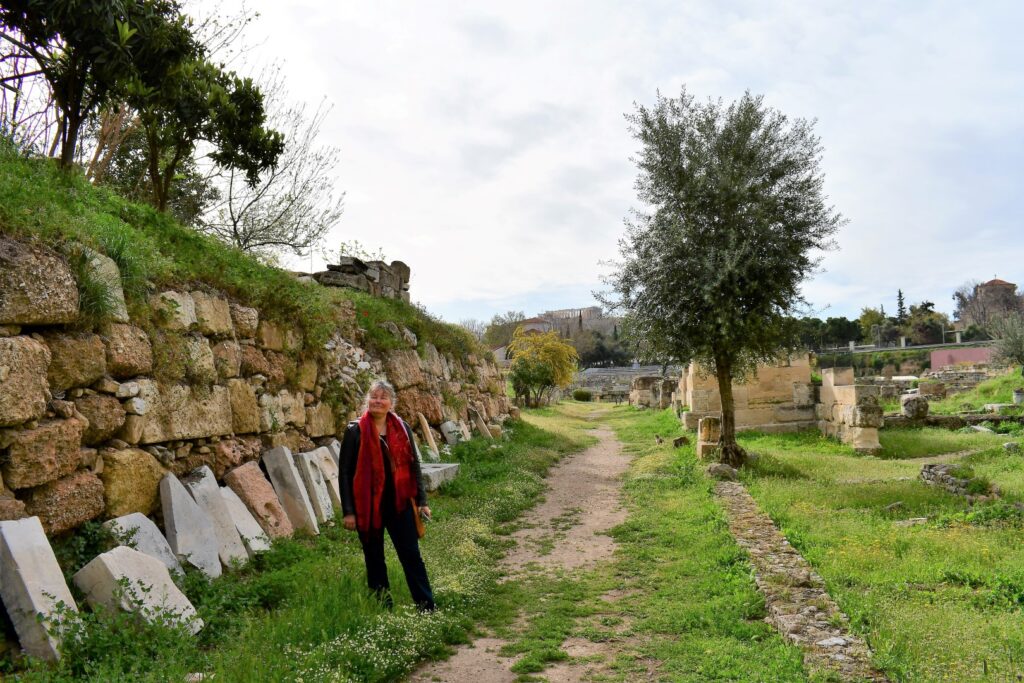
Situated about a mile from the Acropolis which is in view all the time , it contains tombs and ancient walls from 800 BC , hardly visited even today with the Tik Tok generation anxious to Instagram everything in sight and I never thought walking among tombs could be so therapeutic and photogenic … worth the wait !

And the Greek Salad was delicious
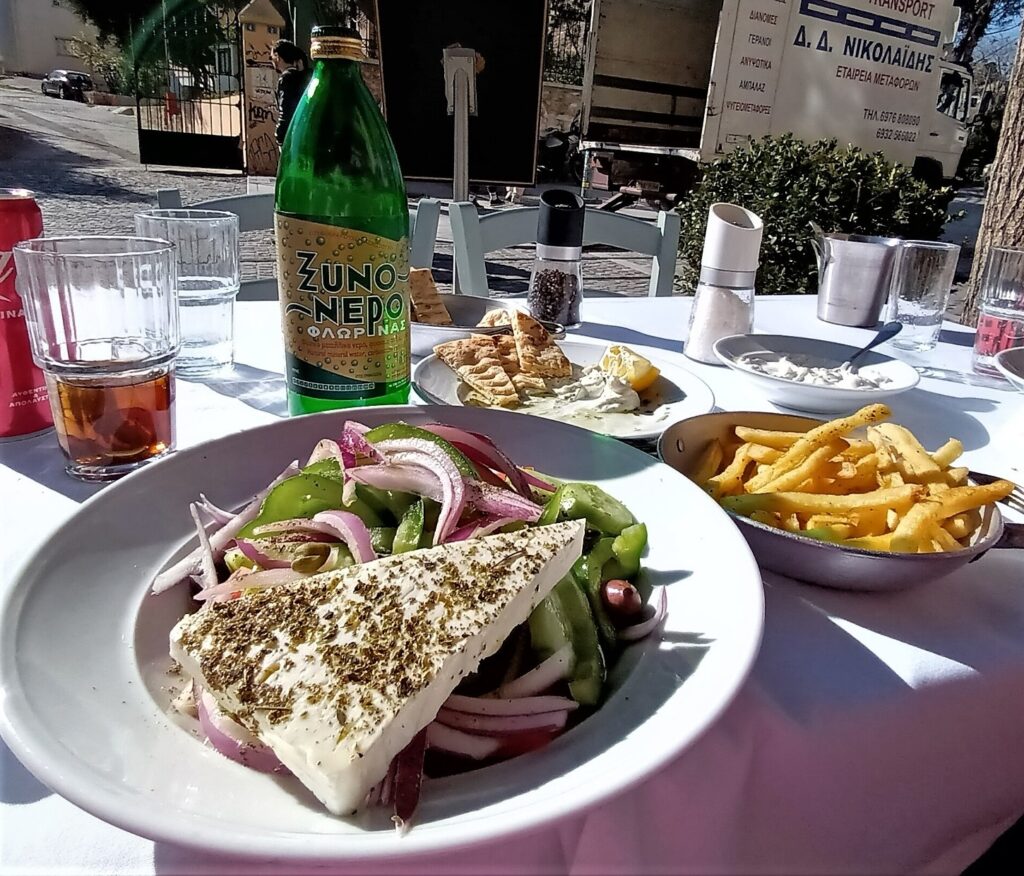
May is the best month in the Garden !
May is my favourite month in the garden , everything is fresh , green , the growth is spectacular, the hedges are full of whitethorn in full bloom and the whole summer is ahead !
The Euphorbia wulfeni along with hostas are the stars of the May Garden and as striking architectural plants are hard to beat in UK and Irish gardens as our damp changeable climate suits them .
Unlike hostas that are plagued by snails the euphorbia has no pets or animals that eat probably because if you cut or bite a euphorbia it exudes an acid that stings … the gardener that breeds a hosta that stings will make a fortune !
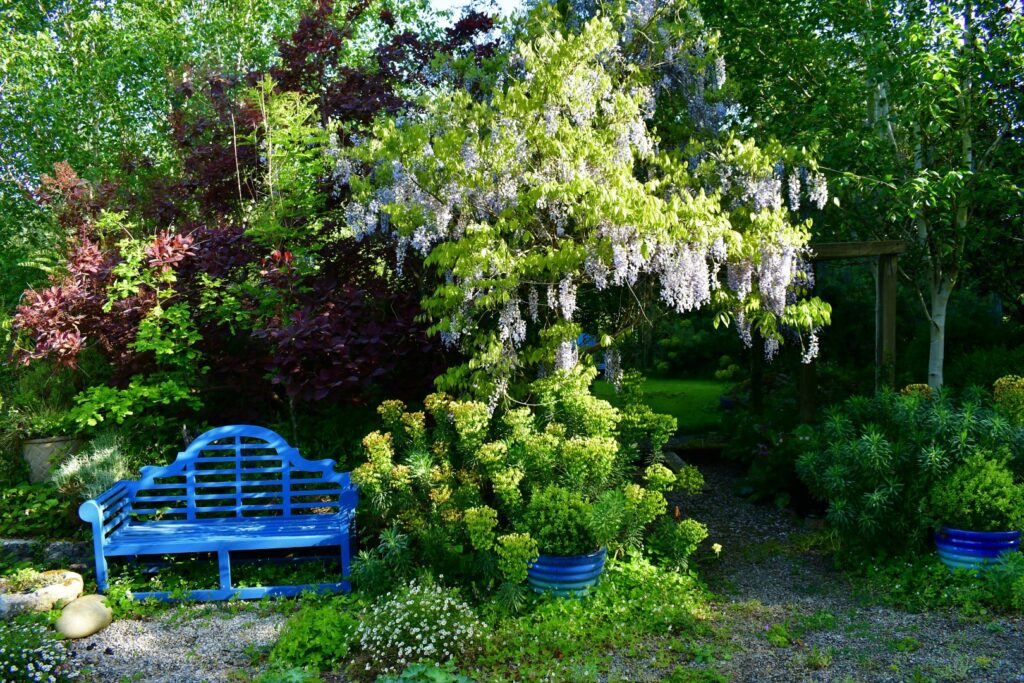
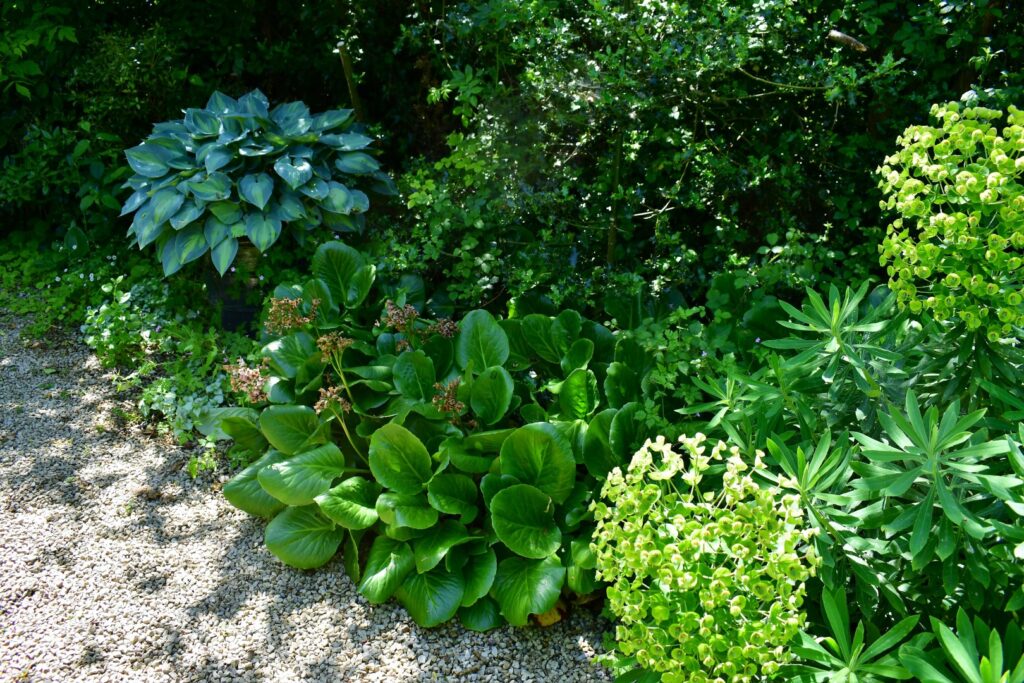
May is a good month for repainting the garden furniture
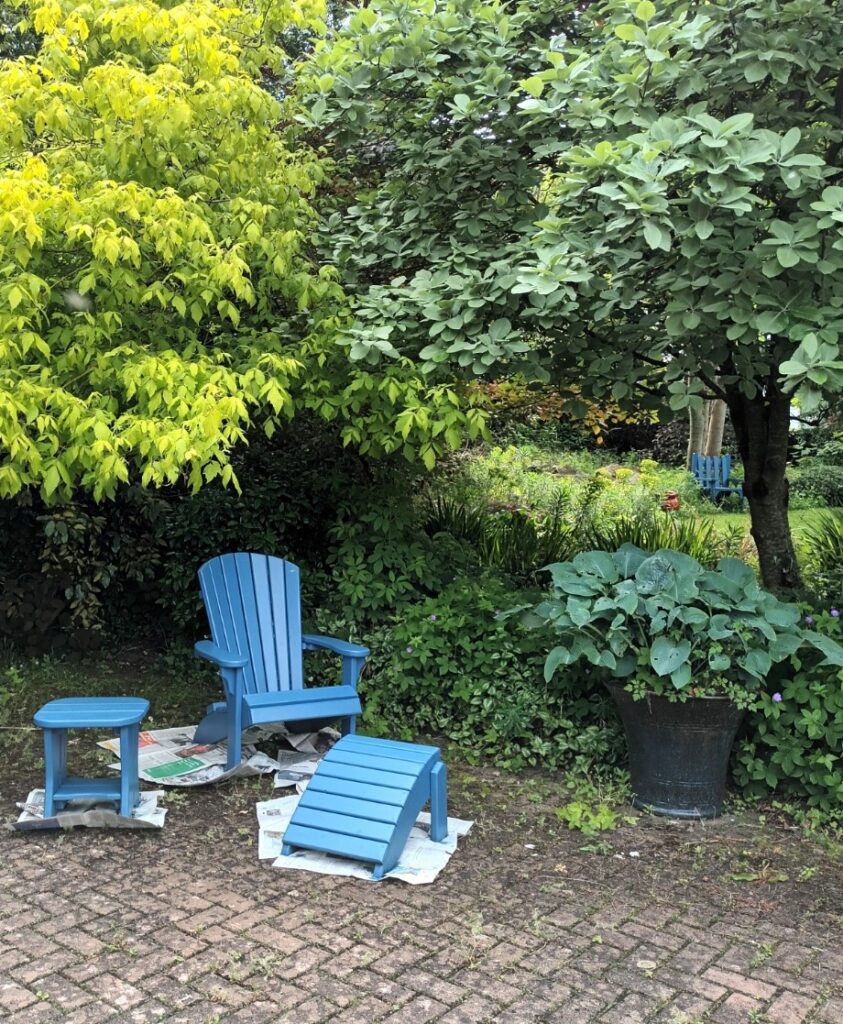
In May 2023 I wrote about Rhus Cotinus , variety Grace .
My demand from shrubs and trees is that they look good for at least six months of the spring / summer and then have nice bark to display in the winter months … a shrub that ticks that box is Rhus Cotinus , known as the Smoke Tree and the variety you need is “ Grace ” , a real Top Five shrub .
Grace is like a bad girl that doesen’t know her place , who does not allow any confines put on her and likes to sprawl and spread her branches across and through her neighbours so if you are a tidy gardener with a small space then Grace is not for you and you should go for the more compact variety called coggygria which is better behaved .

Actually Grace is hard to find in the garden centres as when small the coggygria variety displays better and has more structure on it so it appeals more to garden buyers but Grace is your best girl for the sheer spectacular colour and size of leaf but be warned it takes a few years for Grace to take off . I never put any shape restrictions on Grace and rarely prune it the shrub romps away here although there is one specimen of Grace that through my own fault I planted too close to the three iron flower structures and I have to cut it back every few years because much as I love the shrub I love those iron structures also !
Grace before pruning

Grace after pruning

If you are a formal type of gardener that likes order in your shrubberies then Grace is not for you as the shrub is miserable looking if cut into shape and you should go for the coggyria variety as this grows in a restrained neater fashion and won’t threaten to take over it’s neighbours . I knew Rhus cotinus as difficult to grow in my Rosslare garden but here at Old Spa Road it was the first shrub Snezana fell in love with and I bought it against my better judgement … that first Grace is now a medium sized tree for the past twenty years … turned out to be a real case of what do I know !
In May 2023 I wrote about the Chelsea Flower Show 2023
May of course is the RHS Chelsea Flower month , the most famous garden show in the world garden calender where all areas and talking points of gardening come together .
The “ Woke ” movement has finally infected the UK gardening world with a huge division occurring between traditional gardeners and the Royal Horticultural Society who are sponsoring rewilding and natural gardening and who have declared war on grass lawns and have even defended slugs in the garden calling them “ garden visitors ” and I love this statement that slugs are misunderstood and that “ only nine of the 44 known species of slugs in the UK are actually likely to be eating our plants .”
Well I must have all nine of those buggers in our garden and they are definitely not welcome visitors here !
The RHS Chelsea Flower Show was on the last week in May and featured daily on the BBC . The RHS is an ultra conservative body made up of grandees and luvvies who all seem to sound and look like Jacob Rees Mogg and whose standard uniform at Chelsea is blazer and white slacks with a boating hat … most have gardeners to do the dirty work in their perfect borders … is my prejudice showing?!
I am sure the RHS committee hate to have real gardeners like Monty Don and Joe Swift hosting the BBC coverage and would prefer one of their own 85 year old fuddy duddies with fruity accents but the clever BBC know they would have only one or two viewers probably in Patagonia or Outer Mongolia so Monty and Joe remain .
Over the years the Chelsea Flower Show in my opinion with it’s show gardens has become totally out of touch with normality with gardens that suspend belief and which over the past few years has featured gardens and plants from places like Korea , Malaysia and Japan … all beautiful but we in our gardens could never grow these plants so what’s the point ?
Once Chelsea was the place you first saw exciting new varieties of geraniums , alliums and hostas but now the growers have hybridised the sh.t out of plants with exotic new names almost on a monthly basis .
The point is I suppose that Chelsea has become like Paris Fashion Week with celebrities swanning around being seen and photographed … not the real world though and Chelsea has to see what it has become and change tack or it will become irrelevant to the average gardener .
The RHS is bending over backwards to stay on trend and have gone all out on rewilding however revolution is in the air in the gardening world and battle lines are already forming up with a leading two page article in the UK Telegraph on May 20th with the headline “ Spades at dawn , why the culture wars are thriving in your garden ” .
The garden writer , James Bartholomew summed it up best for me when he was quoted in the article “ Chelsea now has all these ridiculous worthy virtue – signalling themes – the deaf , the blind , the people with no sense of smell- you’ve got to find some desperate thing . Why can’t we just have fantastic gardens , people want to see spectable and drama and if the RHS keep going in that direction and choosing weedy gardens over polished ones it is going to make what is a sensational part of British public life into something much more ordinary ”.
Barthlomew of course is not a member of the SS and his comments about the incapacitated is not meant in a derogatory manner merely to say have a sense of proportion and have less of the virtue signalling themes … of course all our gardens are welcoming to those unfortunate people affected by less mobility or whose facilities are affected and we are delighted if the ambience helps but gardening is more than that .
The article states “ each week on Gardener’s World and Gardener’s Question Time presenters grapple to reconcile the interventionist nature of their pursuit with the pressures to let things be . Even the most mundane acts in the garden , watering , mowing , digging , fertilising , weeding , controlling pests – now comes with environmental , political and cultural baggage . The Royal Horticultural Society ( the RHS ) as the de facto adjudicator of gardening now finds itself in the unenviable position of how to balance environmental concerns with the more traditional demands of it’s members ”.
Ursula Buchan , a well respected UK garden writer , whose books I collect , is quoted as saying “ as important as sustainability and biodiversity are there is no point in making a garden unless you control some aspects of it ” and goes on to say “ gardens are not pieces of uncultivated landscape , they’re highly artificial and anybody who says we have to embrace weeds has to understand that garden soil is often enriched and there are eight to ten native plants that will take over if not kept under control, bindweed , dandelion , dock , hogweed ,ground elder … if you don’t mind that , that’s fine but most people don’t join the RHS to have brambles in their gardens ”.
The Telegraph Gardening Section described Chelsea this year as “ Recycling , Rewilding , Renewal , this is Chelsea 2023 ” .
The gardens on show at Chelsea this year were disappointing to say the least and apart from Sarah Price’s garden called Nurture Landscapes Garden that won a gold medal the rest were forgettable including one from South Korea that also got a gold medal …as far as most people could see this was just a small artificial hill covered in S. Korean weeds and wild flowers and I can imagine the Chelsea judges could not make head nor tail of it as neither could Monty Don in his TV commentary and the old luvvies judging probably decided well they have come all the way from South Korea and I don’t know WTF it is about but neither will the public and it could be genius so lets give it a gold !
Rewilding at Old Spa Road May 2023
Although I have turned an area here in our garden into a small meadow with paths mown through it this was purely as a last ditch effort to make something of an area which is very wet and where every other planting scheme had failed … I still hold to my theory that the new so called rewilding is just about lazy gardeners who can’t be arsed into cutting the lawn !
I am actually pleased with how this “rewilding ” has worked out here , it took two years and it will be another two /three years before all the tall miscanthus grass and various native trees that I planted begin to fill out … it is a real pleasure to walk into or by this area now whereas before it had no shape or direction and I knew it .
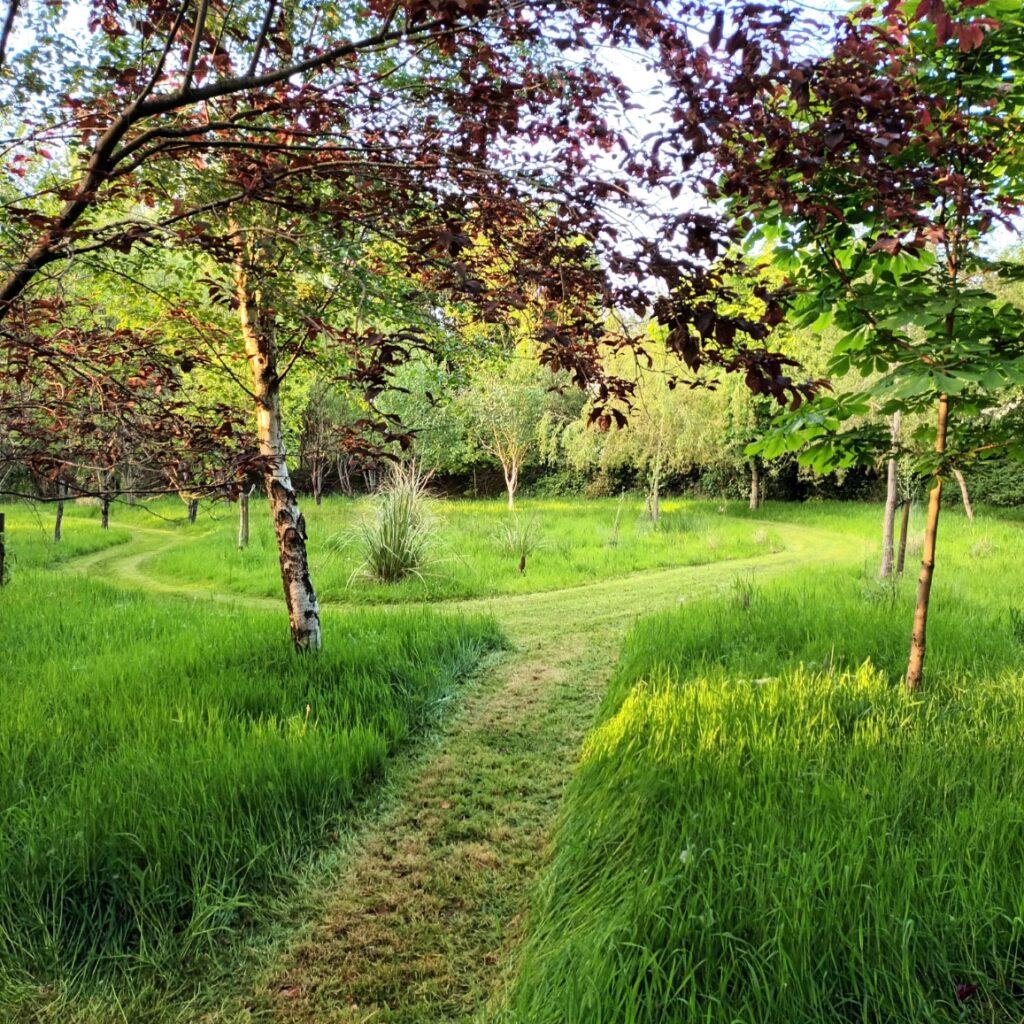

A new project throughout June 2023
We spent a few weeks in Croatia adjusting again to Mediterranean gardening but learning from past experience to not over water the rosemary and lavender but before we left I tackled what has been a problem now for a few years at the garden at Old Spa Road, a wooden decking patio in the Lower Field which we built out over the stream in 2006 and which was actually the first project in the garden .
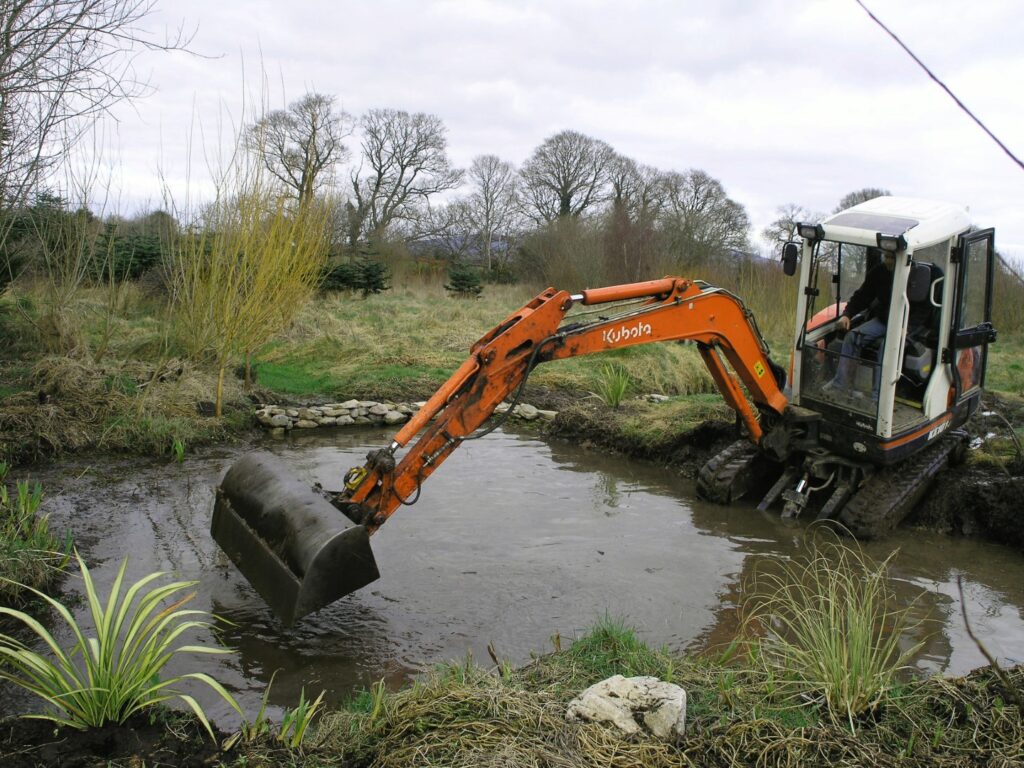
Over the years the decking had rotted away in places and had become quite unsafe as well as unsightly so it had to be replaced but with what … I had originally planned this south facing patio as a place to sit and eat but we never actually used it as such so the plan now was to replace it with a single span walkway across to the little island .
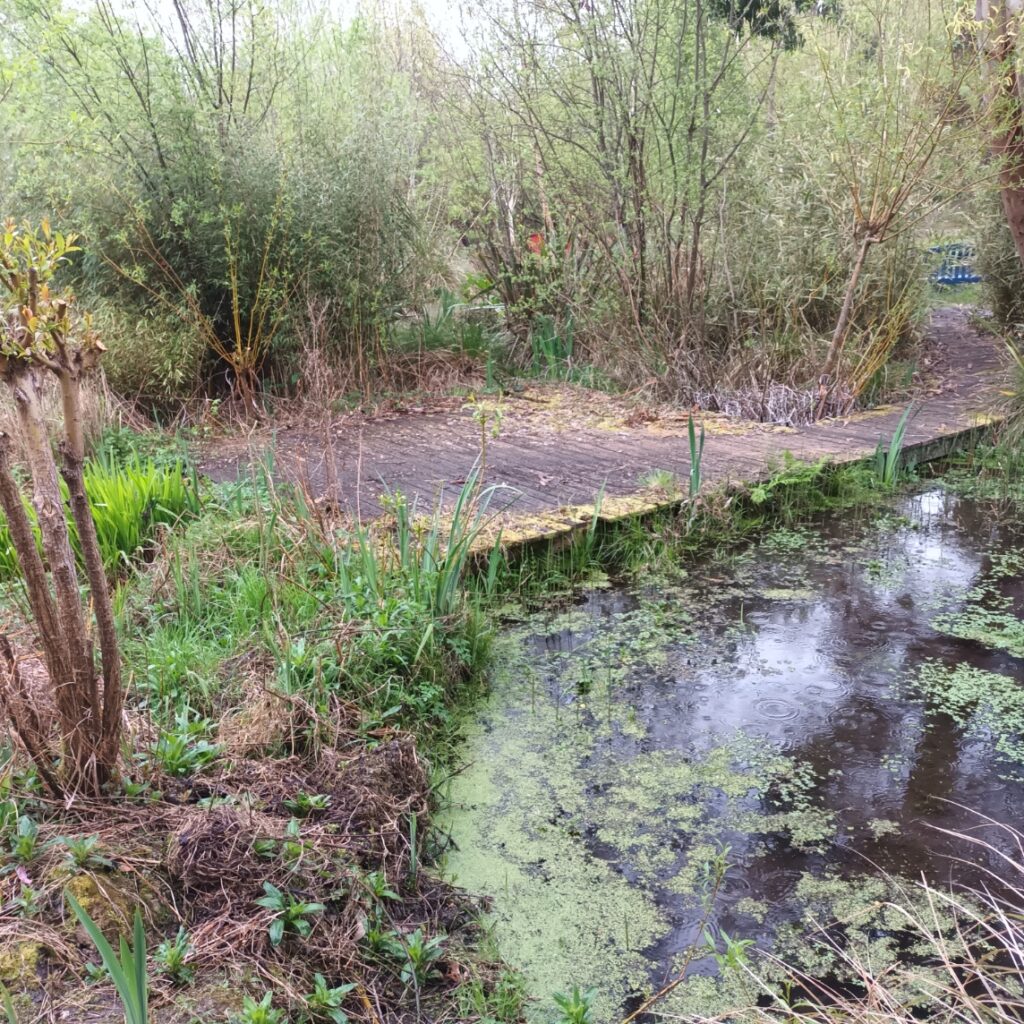
I was sad to see an original structure go and it brought me back to that original excitement of planning the garden and how the overall design of the garden has evolved in the past seventeen years and indeed how our own thoughts about the design of the garden had changed in the same period .
We used a small digger to dig out the ground under the wooden pathway and flooded it from the natural flow of the stream and this enlarged the existing water area .
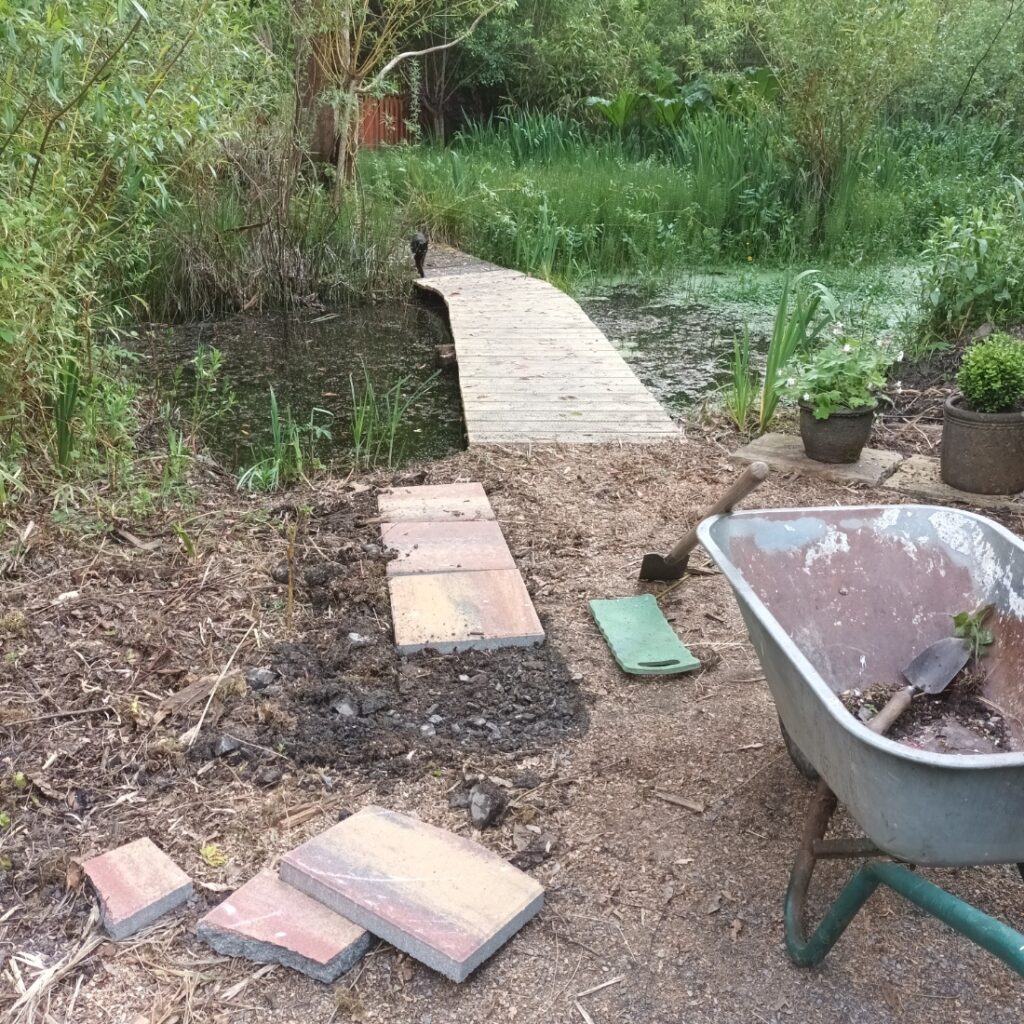

Next step was to do something with the bank where the patio had butted up to and I used concrete slabs to make a small patio with space for a chair or two , added some left over indian sandstone slabs from ten years ago to house three pots sourced from other areas of the garden and this is now a favourite place to end the day in the garden looking out over the water to the sunset and I am delighted with the end result .

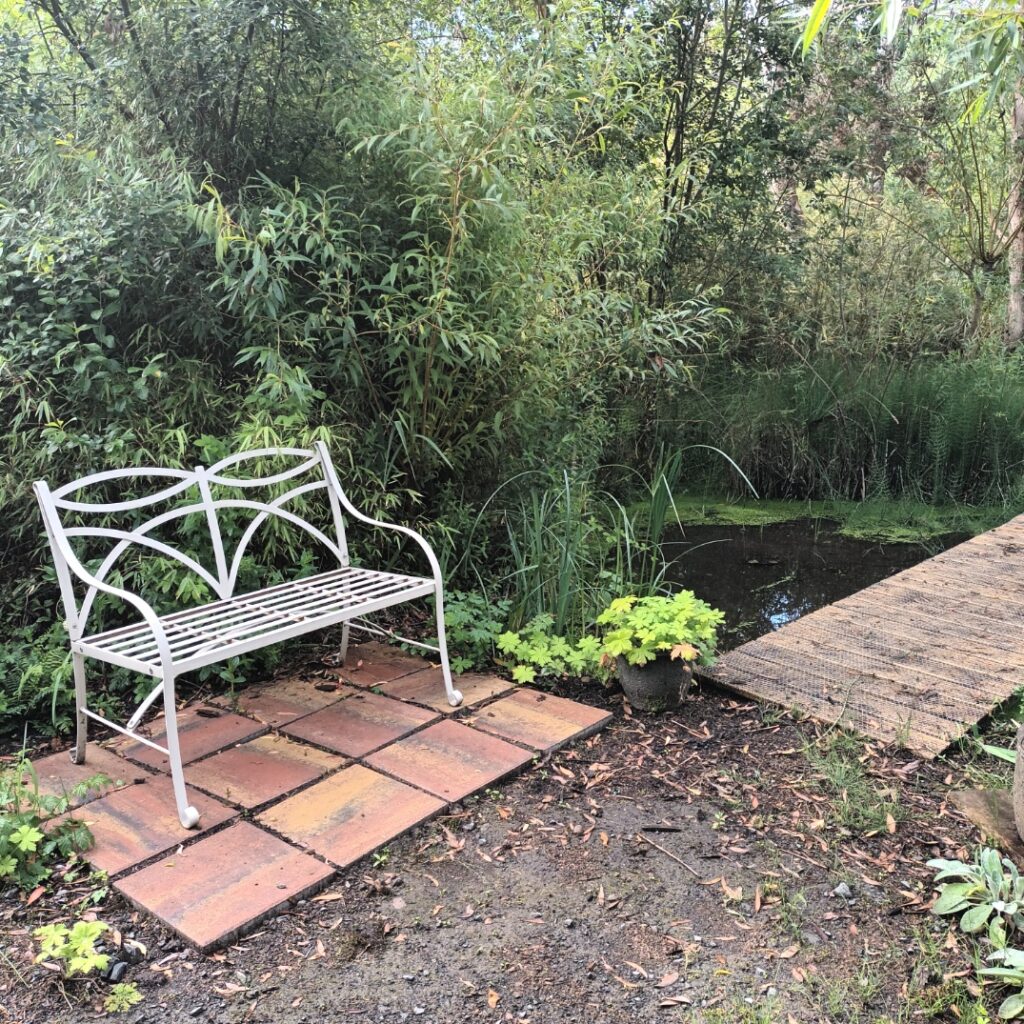
Towards the end of June the euphorbia bracts have just faded after flowering non stop since late March but need to be cut out now to ensure the new shoots come through from the base where they are tucked in beneath the bracts and these will grow twice their size by the end of September and will be ready to flower next March … the cut is necessary and although no one likes to reduce their euphorbia clumps in the middle of summer and it does leave a gap in the borders but by September it will have recovered … not doing it will mean your euphorbia will struggle on to next year with lesser flower bracts and the plant will actually die out in a year or two .
Be ruthless now and your euphorbia will be rejuvenated and come back bigger and stronger than ever and just to define ruthless , I cut out 72 shoots from the one euphorbia in the photos below … SEVENTY TWO … not all of these were shoots that had just flowered but were older woody shoots and this thinned out the clump and will give it a great start for next Spring .
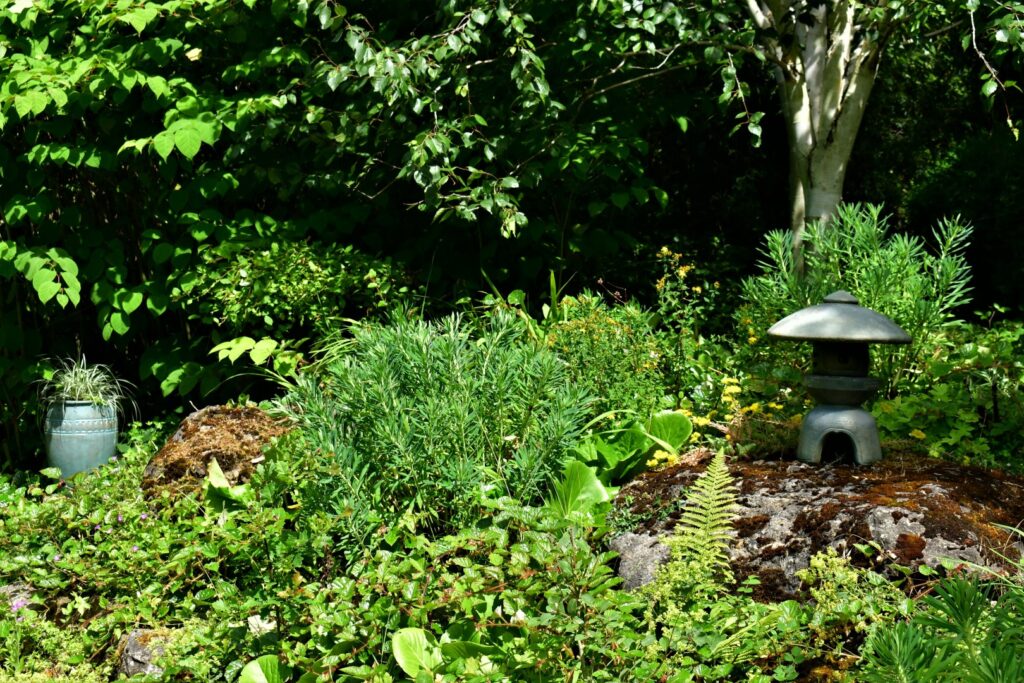
Visit to Blarney Castle and Gardens
In June I took Snezana to visit Blarney Castle for the first time thinking she might like to kiss the famous Blarney Stone or at least see where we Irish who have kissed it get their eloquence or the Gift of the Gab !
Blarney Castle was the stronghold of the MacCarthy Clan one of the most important Gaelic Chieftains and Kings of Munster , built in 1446 by Cormac MacCarthy when the famous stone was built into the wall . Various legends are attached to the Stone , that it was brought back from the Holy Land where Jacob had used it as his pillow when he dreamed of a staircase to heaven and another that it was a gift from Robert the Bruce and was part of the coronation Stone of Scotland and England … the stone itself is 330 million years old and whatever legend you believe they all state that whoever kisses it will have the gift of eloquence !
The castle itself is now just a ruin but you can climb to the top via a nasty little stone staircase , quite tight with no room to pass and the famous Blarney Stone is out on the roof of the tower with a fabulous view out over the countryside . I was blown away by the Blarney gardens as normally these Castle gardens are generally parkland and quite bland but Blarney gardens are spread out for 60 acres over hilly ground built around the River Martin with paths connecting rock , water and perennial gardens and what I really liked is they have achieved the perfect balance between the cultivated and wild areas all the while looking neat and well kept … the whole experience is magical and I really recommend a visit if in the Cork area … not cheap though at 20 Euros per person plus 10 Euros to visit the house .

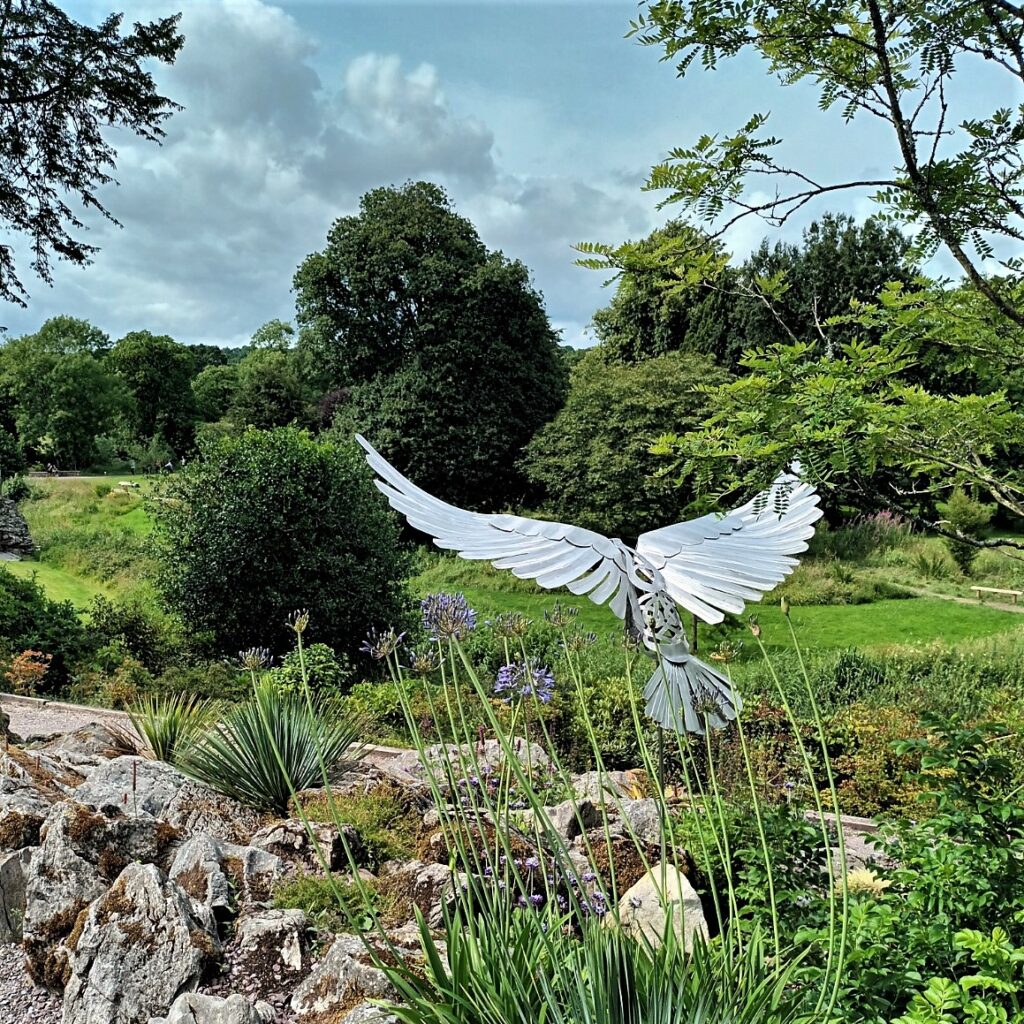
I had kissed the Blarney Stone back in 1974 but of course after almost fifty years the promised eloquence needed renewing and so we found ourselves shuffling along at the top of the parapet in a line of people all waiting for their chance to kiss the stone … not many go back as it is set out over an open chimney 100 feet up I have always remembered how awkward and downright dangerous it is , Google is blunt about it
“ So, if you’re wondering why people kiss the Blarney Stone upside down, the simple answer is that it’s the only way to reach it. Due to its placement in the castle wall below the battlements, visitors have to lie down, lean back while gripping the iron rails, and kiss it. Staff will also be there to hold and assist you.
This is much safer than how people used to kiss the stone. Visitors were formerly taken over to the stone and kissed it with their ankles tied together! Well, as they say, if it were easy, everyone would be doing it !”
I didn’t enlighten Snezana beforehand as to just how awkward it is to kiss the Blarney Stone and she probably thought it was just a matter of planting a kiss on an old stone at waist high level … easy peasy … but the closer she got up on the roof parapets of the caste to the actual thing itself in the queue the more she had made up her mind on it and as her turn came she looked down the 100 feet of the open chimney and the iron bars to hang on to UPSIDE DOWN and made a quick decision “ no f..king vey ” !

I had remembered from my last time almost fifty years ago NOT to look down as I swung out backwards and upsidedown while holding on to the bars my legs being held at the waist by an attendant but my neck muscles aren’t what they were in 1974 so I couldn’t manoeuvre myself to plant a kiss on the stone so ended up blowing a kiss to it … thought I had done my duty but of course Snezana who was watching said “ call that a kiss ?
Nothing for it but to try again and this time I said to the guy holding my legs you have to swing me in close but he whispered you won’t manage it if your neck is too stiff … encouraging guy all right , he must have been having an off day … anyway he and I both swung me in upside down close to the stone again and not only did I kiss the bugger this time I head butted it all the way back up and a week later I still have the scratches on my forehead !
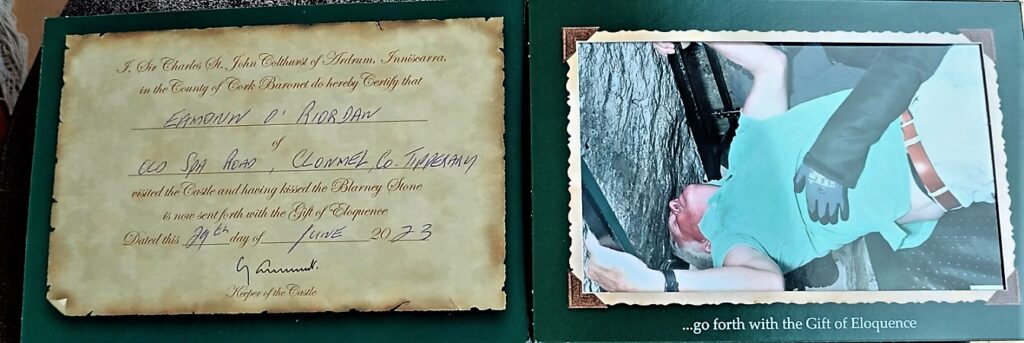
I often write about Rhus Cotinus especially it’s best variety Grace and this year it has been a great performer probably a combination of early summer rain and heat and visitors to the garden always ask about it when confronted with the purple colour .
The common name for rhus cotinus is the smoke bush tree and usually it is difficult see how it got it’s name especially when you explain that this is because after flowering it resembles a smokey mass hovering over the shrub … as generally the phenomenon is so small that it is insignificant … not this year as for some freak of the weather there is no mistaking as to why it is called the Smoke Bush Tree and a shrub that normally is a show stopper is a stand out performer in the garden .

Gardening in June
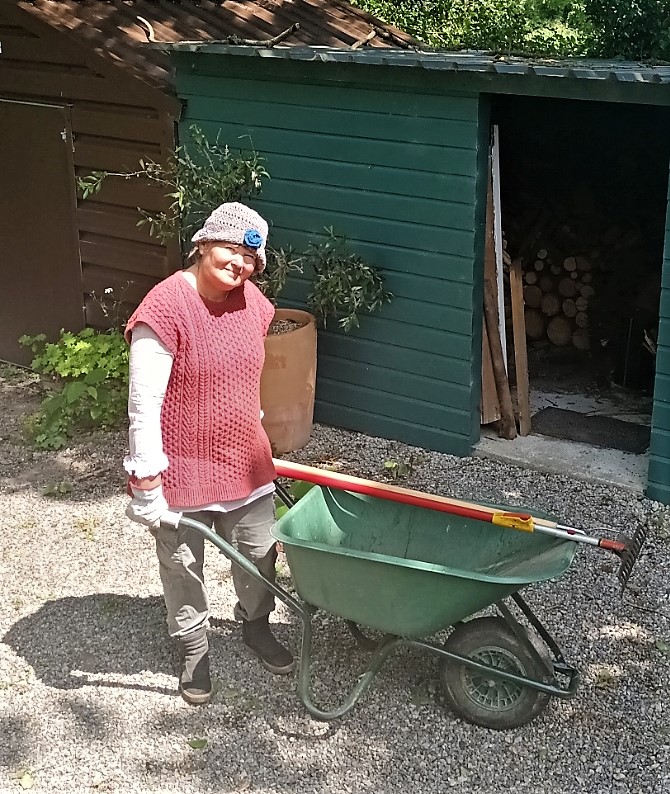
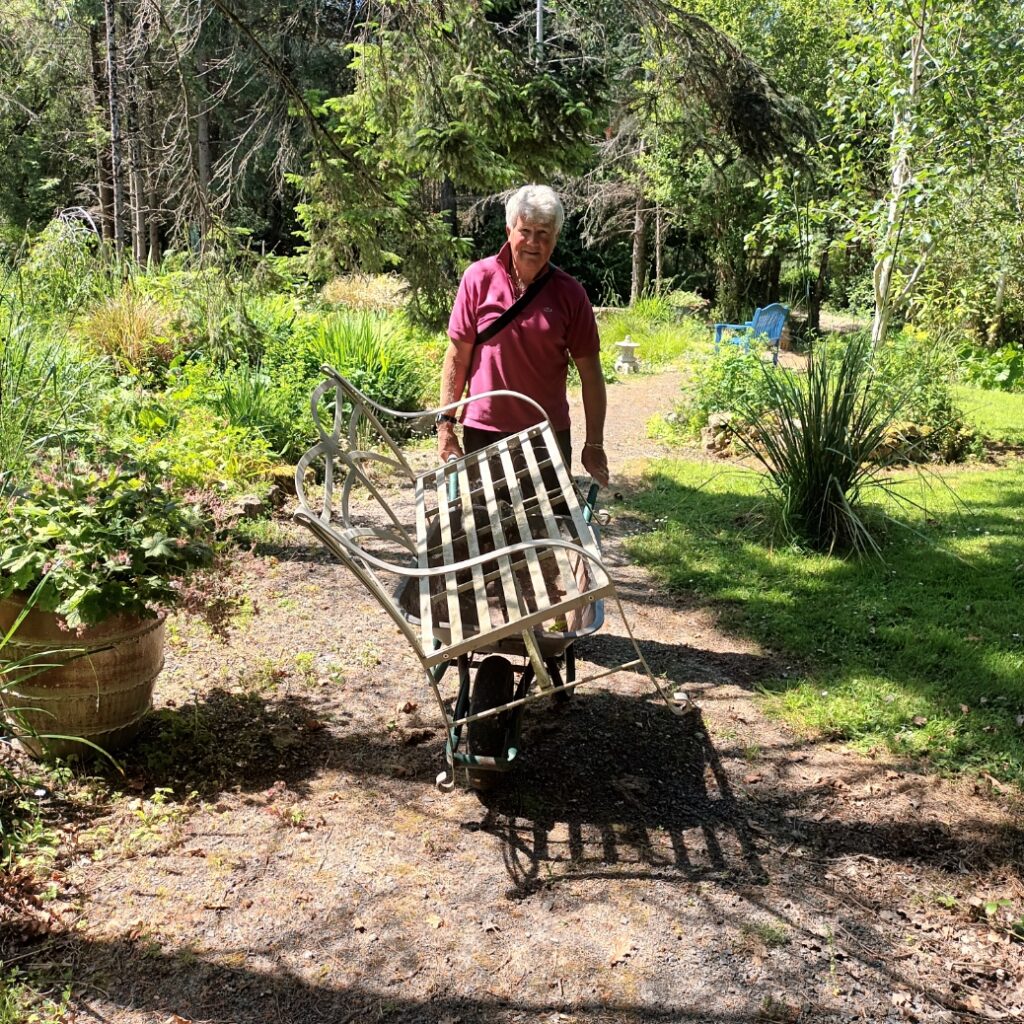
Colour in the Garden , June 2023
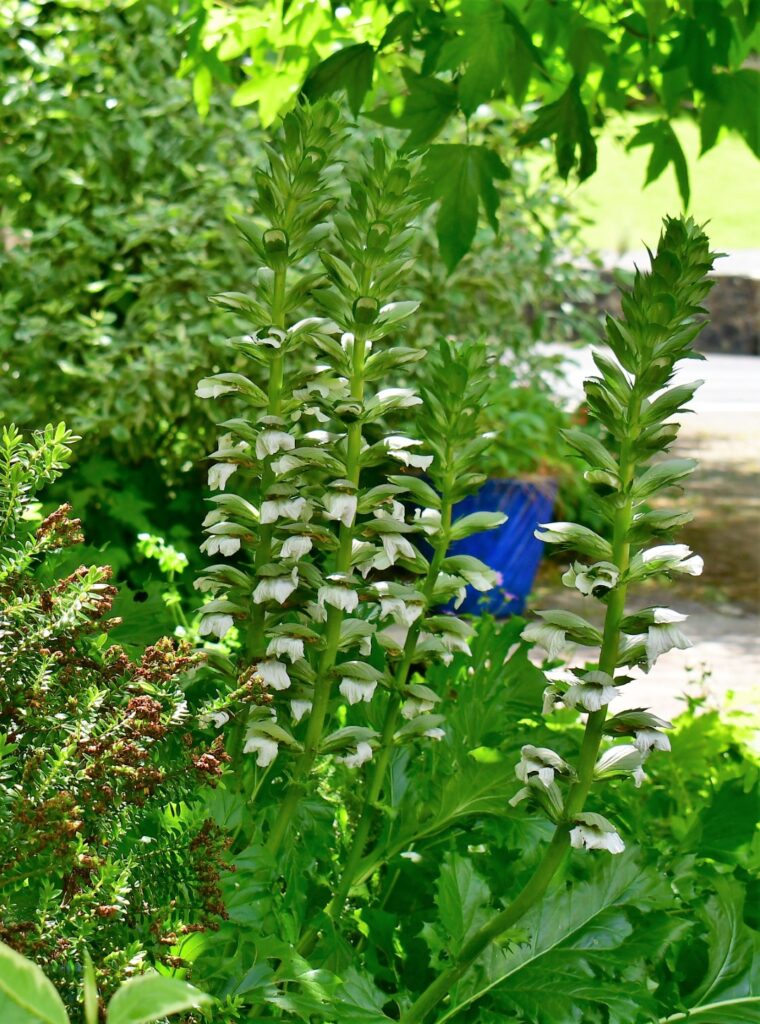

Gardening by it’s very nature and purpose is intervention and artificial as we are shaping nature to what we perceive is beautiful and practical . In Old Spa Road we took a naturally wet land , a bog really or what local people referred to as “ the swamp ” and repurposed it as an informal garden .
We drained the really wet areas or bridged them with walk ways and over the years due to the varying nature of the eight acres a series of rooms outside developed … but we are not under any illusions that this is permanent as left untended for a year our garden will rapidly be taken back by nature … sometimes I feel we resemble hamsters on a threadmill in our almost daily garden maintenance !

The stream being excavated October 2008

The stream fifteen years later in July 2023

Speaking of intervention I introduced several plants to the water areas ten years ago such as wild rushes and parrot feather which was a huge mistake as these proved highly invasive and threaten to take over huge areas and worse they need constant a constant war of attrition on our part to contain their growth .
We spent a week in early July pulling out rushes and raking off the parrot feather … a horrible job and one that needs to be repeated every few months as these species reproduce from just a single piece of root .
The garden at Old Spa road is on eight acres that because of the wetness was always rough fields never built on and was known locally as “ the Swamp ” , of course it didn’t say that on the estate agent’s brochure when we bought it but anyone could see there was nothing much could be done with it and over the centuries it became an area accessible only to whatever wild life was around .
In 1985 Caoilte , the Irish forestry service , planted a forest of sitka spruce in the lower field on a long narrow section which was the only half decent land available and fifteen years later in 2001 we inherited the remnants of these trees that the deer hadn’t done for … these planted forests are created for commercial reasons and the trees are planted close together unlike in nature and usually with a single variety of conifer and no mixture of shrubs or other plant diversity so consequently are pretty sterile to look at and crucially don’t attract wild life .
We have thinned this forest out over the past twenty years and introduced paths , walk ways and as much diverse planting as the leeched out soil from the conifers will allow but it is still not a natural or enticing habitat for wild life and we don’t see a huge amount of wild life in this area apart from the almost resident deer population but there are herons , sparrow hawks , water hens , wild ducks that we see on a daily basis along with the usual smaller birds like thrush , black birds and robins … and I have often wondered about this … not anymore as a study at the Institute of Copenhagen last month was startling .
“ On an early autumn morning, a group of researchers from the Globe Institute at the University of Copenhagen embarked on an intriguing expedition into a Danish forest. Armed with plastic boxes, these scientists sought to “vacuum” animal DNA from the air.
The boxes, rigged with DNA air samplers, were strapped onto tree trunks, air filters attached, and then powered on. As the boxes powered up, a faint hum indicated that they were collecting airborne particles.
Over the next three days, the researchers returned to the forest on numerous occasions to replace the air filters, each time marking a step further into their investigation.
“We saw relatively few animals in the short time we spent in the forest when we changed the air filters. A squirrel, the sound of a woodpecker, a pheasant squawking, and a white-tailed eagle flying above us one day,” said Christina Lynggaard. However, the richness of the biodiversity they discovered in the air starkly contrasted the lack of visible activity.
By sequencing the airborne DNA particles collected on the filters, the team discovered a surprising number of forest inhabitants. The “vacuuming” process, executed over three days in an area of the forest roughly equivalent to a football field, unveiled DNA traces from 64 animal species.
They detected the DNA of animals including domestic species like cows, pigs, sheep, chickens, and dogs, and even exotic pets like parakeets and peacocks. Yet, the real surprise was the detection of roughly 50 terrestrial wild animals.
The DNA revealed the presence of small to large wild animals with varied lifestyles – red deer, roe deer, Eurasian badger, white-tailed eagle, red fox, different vole species, robin, Eurasian red squirrel, common toad, smooth newt, great crested newt, crane, great spotted woodpecker, nuthatch, grey heron, marsh tit, woodcock, and several more.
In a stunningly short time, the researchers uncovered nearly a quarter of the land-living animals previously recorded in and around the area ” .
Basically it means that in such a small area the size of a football pitch a huge population of wild life moves through and you never see them … scary thought to think that while you are strolling the garden THEY are watching you !
Lavender growing in Ireland and the UK gardens is a very genteel affair when conditions are right with great plumes of blue spires and nice soft downey leaves over perfect domes of foliage but the downside is that the plants are short lived , four or five years at best before the wet rain we have gets them and they pop their clogs .
Lavender in the Mediterranean / Adriatic is a very different affair as basically the plants struggle for life from day one in the brutal heat of the summer months but they do last almost forever and even young plants develop a gnarled woody ancient mariner look which always remind me of japanese bonsai trees where the trunks have great character… neat and pretty they aren’t out of flower and you have to treat them mean by hacking them back after flowering and I find even old wood will grow leaves again .
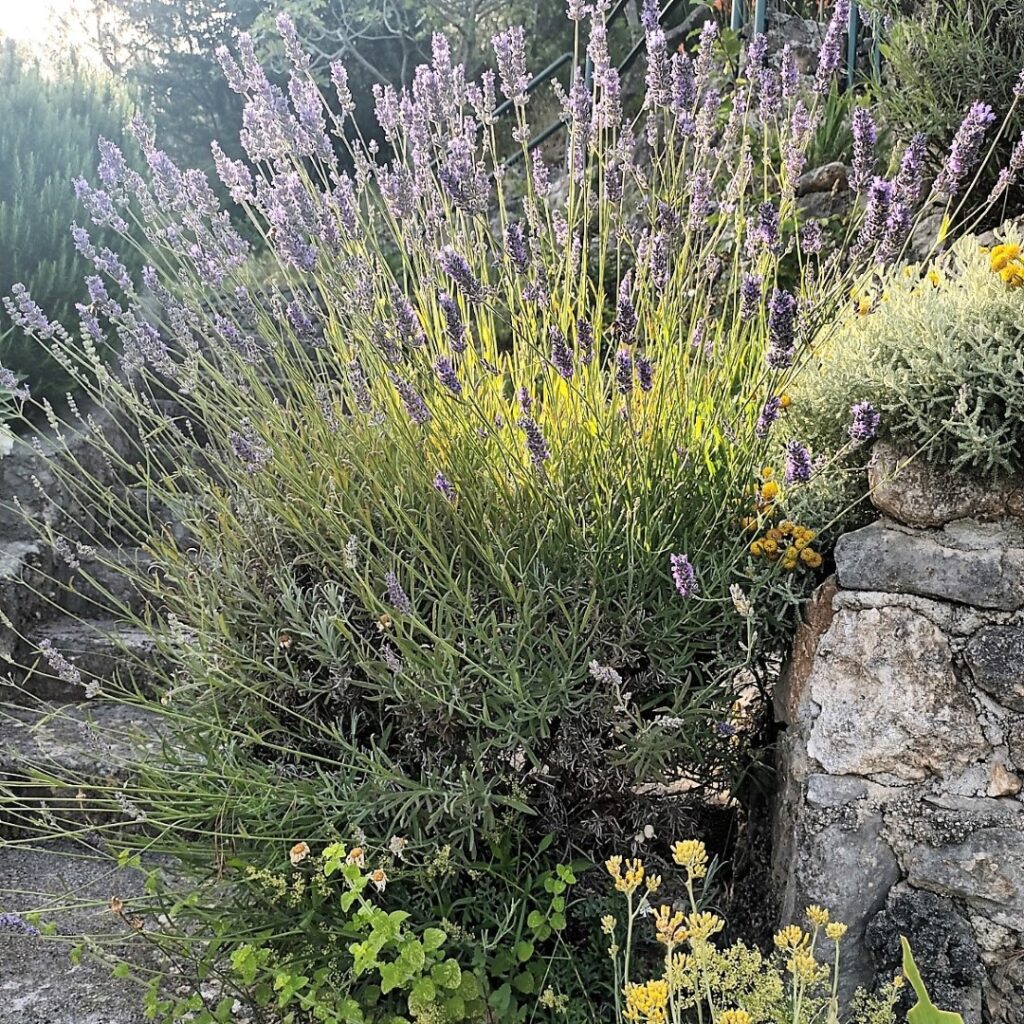
The best variety for Mediterranean conditions and the one most used is English lavender , variety augustofolio , which is tough . In Ireland and the UK French lavender , variety stoichas , is also popular as the flower spikes are thick but the plant itself is not long lasting and and here also augustofolio is the most popular .
I visited a lavender farm in Croatia in July on the slopes of Biokovo Mountain overlooking the islands of Brac and Hvar , an idyllic sloping location with perfect growing conditions . It is a young plantation , five or six years old but already the lavender bushes look ancient and had been planted in long rows for easy harvesting and as they had been just machine pruned commercially , not a pretty sight as the bushes looked hacked … by September when they have recovered and put on some top growth the bushes will look better .

Commercial growing of anything is a business and the aesthetics take second place to a crop … lavender farms are no different and there definitely is no room for pampering like we would do in our private gardens . These lavender bushs were tough and rough looking , exposed as they are on a hillside to merciless sun all day and harsh winds in the Winter months then whacked with a cropping machine in July , almost scalped but will come back in full growth in a month or two .

Compared to their Mediterranean cousins the Irish and UK lavender are primped and pampered like top models and are just as tempremental !
Right plant , right place and this definitely applies to lavender as the Irish climate is not a natural fit and the last thing it wants is wet feet and if you must grow it I always suggest growing it in massed planting in single beds with good drainage , adding a lot of gravel to the planting mix and mulch the entire planting area in gravel .
Olives are the number one tree I associate Croatia with and beautiful it is too , the quintessential Mediterranean / Adriatic iconic tree and my favourite but a tree that runs it a close second is the fig both for it’s beautiful leaf and of course it’s fruit .
Like the olive we can grow the fig in Ireland but it rarely if ever produces fruit … when I was growing up my experience of figs was confined to the famous Jacob’s Fig Roll biscuits and I remember carrying packets of them in my luggage to Bosnia and the Seychelles when I worked there and I treated myself to two fig rolls every morning for my morning coffee in the office … it was a link with home but also absolutely delicious !
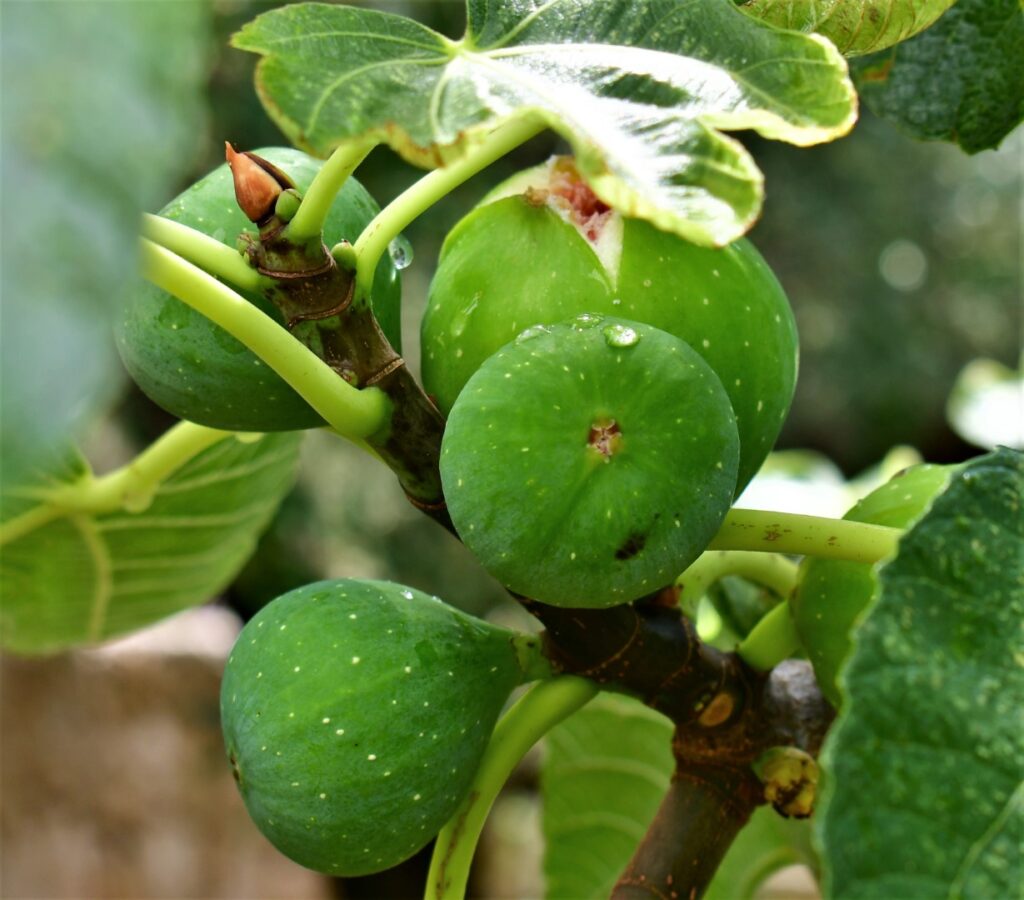
But the fig in fig rolls is nothing like the taste of a fresh fig picked directly from the tree , delicious plump and fleshy and ready for picking in the last week in July .
Unlike the olive tree which requires quite a bit of attention with specialised pruning and feeding the fig tree or smokva along the Dalmatian coast of Croatia almost thrives on neglect and are quite feral , self seeding along the road and are almost treated like a weed whereas in Ireland we cosset any fig tree such as Brown Turkey variety that will survive in the open ground .

However like olives the fig needs lots of sunlight and heat to thrive and like lavender what we grow in our climate is only a pale imitation of how they look in their natural habitat .
Sinead O’Connor passed away last week , the voice of an angel if she could have only stuck to singing but more often than not we got the angry flaky Sinead who changed religions on such a regular basis that I often felt she fell in love with the exotic outfits rather than the religion itself .
The Irish fell under a spell with Sinead after her first appearance as a twenty one year old in 1988 on Irish TV although we were all a bit shocked at the contrast between the shy girl as she chatted with Gay Byrne and the shouty aggressive person she became when she sang but two years later came her sublime Nothing compares 2 U and we relaxed knowing she really was that shy person at heart .
The internet has been full since the news of her death by the usual list of celebrities all recalling their “ friendships ” , most of course were self hyping climbing on the band wagon stuff but the creepiest has to be Bob Geldorf who stated on Sky News that his action on tearing up a photo of John Travolta on Top of the Pops inspired Sinead to tear up a photo of the Pope in 1992 … John Travolta , really Bob !
The ripping up of the photo of the Pope rebounded immediately against Sinead and ever afterwards she was associated with that monuementally stupid act . John Paul 11 was the most loved of modern Popes and was a saintly man but public opinion and the media is fickle and what no doubt seemed a good PR protest at the time to boost Sinead’s street cred made her a pariah in the eyes of a lot of people .
Her public life for the past twenty years had too much information out there and was an obvious cry for help with her demons but which too often came across as attention seeking .
But Sinead could sing and more importantly could interpret a song like no one else be it our own Raglan Road sung a cappella or the heart break slow phrasing of the opening words of Nothing compares 2 U … it’s been… seven hours and fifteen days… since you took your love away … yes Prince wrote it but Sinead nailed it and made it her own .
RIP Sinead .
August 2023

Rarely we work together in the garden as if I ask Snezana to help out with some weeding she grumbles “ I always get the shit jobs ” but occasionally we collaborate on a project that she has found and then I am called in to do the heavy lifting that like weeding , Petrovskas never do !
Such was the case this month where she identified an area in the back garden that could be cleaned up which in fairness has needed to be tackled and I have been putting it on the long finger for the past few years . The main feature or what should have been the main feature was a multi stemmed silver birch tree that has grown into a beautiful specimen but which has been obscured by a pampas grass I planted in front of it and my thinking at the time was that the pampas plumes in Winter would add to the stark whiteness of the silver birch however the pampas grew too well and ended up blocking the effect of the birch so it needed to come out and following it was a clump of euphorbia which had deteriorated over the years and which had become infested with brambles .
Easier said than done and it took a few hours with a crow bar and spade to remove both shrubs , the euphorbia was past it’s best but the pampas was in great condition so I cut it into six pieces which I potted up , not the right season of course but pampas is a tough old bird to kill and there is every chance these will all take and if they do they will go into the area under rewilding next Spring .


We took a huge amount of ivy and brambles out and exposed the bare earth and the plan is to plant this up with Spring bulbs and some ground cover such as erigeron and geraniums which will add to the vinca colony already there and thriving away for years in the background .
The area slowly took shape and I moved the Adirondack chairs into the shade of the Silver birch and the lime tree and the final touch called out for a tall pot which was answered by moving a large blue Greek style pot from it’s position on the passage way to the back garden where I had never really been totally happy with but it looked at home as soon as it went into the new position .
I often do this with pots that we fall in love with but haven’t an immediate position for and park them up for a period that can extend to years but eventually their time comes and so it was with the big blue pot bought in Clonmel Garden Centre two years ago .
I knew this area had become overgrown , I wasen’t happy with it for the past few years , a nasty little job which as I said I have been avoiding on the basis it’s grand so I was delighted that she took it over and took it in hand … mind you the frequent references now that it is finished to “ zen gardening ” , zen this and zen that is beginning to grate !

In August the wild flowers are in full bloom , all self seeded over the years none more so than the purple loosestrife , lythrum salicaria , which loves and follows damp areas such as boggy or wetlands so our garden here is perfect for it . A single plant of loosestrife can carry two and a half million seeds so be careful what you wish for with the purple loosestrife although we love it and it is not a problem or invasive overly much here .
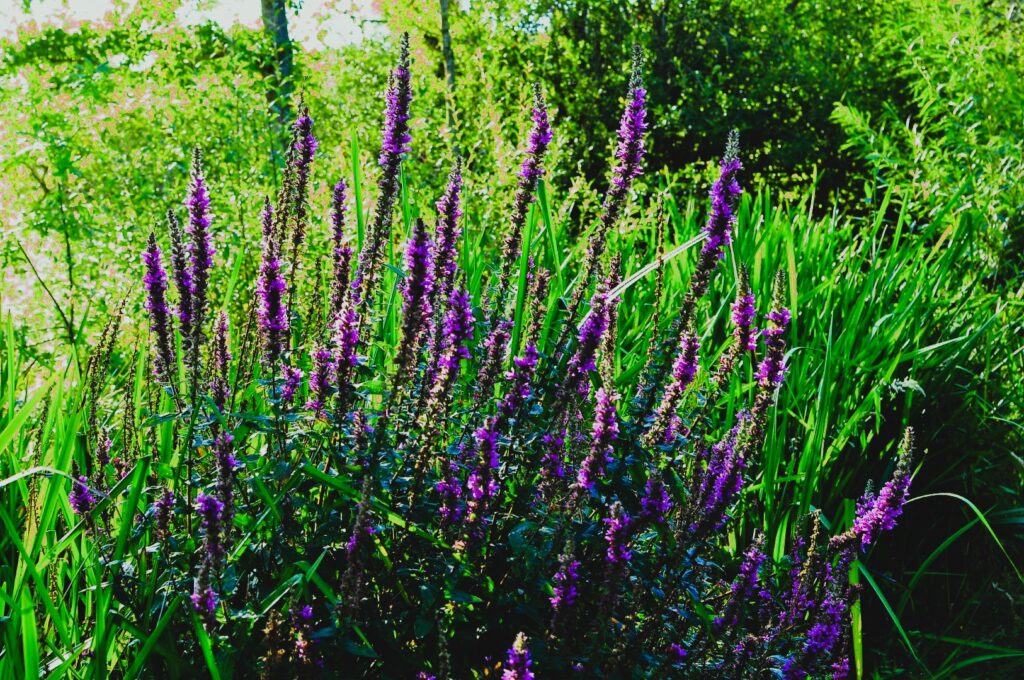
Loosestrife was used in medieval times as a treatment for dysentery but also for tension hence the common name lose strife and by chance this week I met Liam Burke out shopping in Clonmel and as we usually do chatted about herbs and wild flowers . Liam is a botanist and garden enthusiast who at 84 years of age is still young at heart with a hive of stories about the origins of plant names and he had a story about loosestrife that I hadn’t heard before … in rural Ireland where a small farmer might have a cow and a horse and a few acres to plough so naturally he would like to yoke up both animals but of course horses and cows have different gaits and walking speeds and wouldn’t pull well together however someone realised that if you tied a bunch of loosestrife between them on the harness that it had a calming effect and they worked together in harmony !
I always feel that the most important thing in gardening is that you have a style or theme that you like and while I inherited a lot of things from my parents , garden design was not one of them … my Mother , a practical woman, just grew rhubarb and grew it well while my Father never progressed beyond the stage of planting annual flowers in May in a rigid straight line of blue lobelia / white alyssum and his comment on seeing my first garden was a puzzled “ it’s a bit wild isen’t it ” ! .
Early on with my first garden in Rosslare I fell in love with the natural look where plants and shrubs thronged together and overlapped each other , rarely if ever cutting back and with little emphasis on flowering trees or shrubs but relying on leaf and bark colour for contrast and to this day that natural look is my mantra .

When I started gardening in the 1970’s I was heavily influenced by two great garden writers , Christopher Lyod and Robin Lane Fox , whose style I loved and to this day I read and re read Llyod’s The Well Tempered Gardener from 1970 and Lane Foxe’s Better Gardening from 1982 … both books are still available and have never gone out of print .
I know that these days people get everything be it gardening or cooking on the internet which can be accessed in an instant on today’s androids or I phones and I do it myself and love it however I would recommend that any serious gardener should have books by four authors on their book shelves ,Christopher Llyod , Robin Lane Fox , Beth Chatto and Helen Dillon and not only are these authors exceptional gardeners themselves but they are excellent writers also .
I could recommend Monty Don and Dan Gleeson to that list but won’t as Monty really is a book a year man on a mass produced scale which I find a bit samey and soulless while Dan Gleeson , whose work I really love , is a bit away with the fairies lyrically most of the time and his books are a bit more literature really than pure gardening .

Is August a good time to prune oak … I had been looking at this oak mature in the lower garden for the last ten years and each year it put growth on very slowly but these past two years it has shot up which led me then to ask myself should I “ raise the skirt ” as the gardening term goes for exposing the bark of tree to about a five feet central stem … I ask myself the same question each year about this oak and part of me says leave well enough alone it’s grand as it is and you might ruin it ?
This week I went for it and decided the oak would stand out more if I cut away the lower branches and I think it looks great … how do you decide when enough is enough ? … by standing back and looking at the emerging shape as you go along rather than hacking away aimlessly … which is normally the case with Snezana , the secateurs terminator , who when challenged standing over the remains of her latest “pruning” has a stock answer of “ I didn’t do it with purpose ” !
Snezana would love to let these Lads lose in the Garden !


September 2023
Back in 1985 I first read Robin Lane Fox’s famous gardening book , Better Gardening , where he advised planting a quince tree and he specifically recommended a variety from Yugoslavia called vranja but it wasen’t until twenty five years later here at Old Spa Road that I actually bought and planted one … gorgeous it was when in May it unfurled it’s young leaves , a real knock out of a small tree however by July the leaves had gone all mottled and sick looking and so it continued for the next ten years that I gave up and cut it down .
The quince was sacred to Aphrodite in Greek antiquity and was often referred to as “ golden apples ” in Pliny and other writers although far from being like an apple it is almost uneatable raw and is mainly used in marmalades.
I researched the problem and most sources said it was some sort of canker virus however I met Robin Lane Fox at the Carlow Garden Festival and as he was signing my copy of his book I mentioned my experience with his recommended vranja … he commiserated and suggested maybe it was just a bad specimen of tree I had and encouraged me to have another go at growing a quince so I planted another in the Lower Field where the deer promptly had a go at the lower branches but obviously didn’t like the taste and the tree recovered and grew really well with no canker or virus and then lo and behold this year it produced it’s first crop .


An Elder of my home town
Back in April this year I was asked if I would allow my name to go forward for nomination for selection in a book project to be titled called Elders of Clonmel where thirteen older people who were born and reared in Clonmel would be selected to be profiled for their experiences of growing up in my home town .
I was flattered to be considered but pointed out that though loving Clonmel as I do I had spent most of my life and career away from the town and might even be considered a “ blow in ” compared to more deserving candidates however the organising committee decided to include my story and I was assigned a writer and a mentor to edit a series of interviews I gave in June and the finished book was published in late September .

Brian Clancy , a teacher and published playright was assigned to write my section and him being from Clooneen and me from Newcastle , two local villages , we had something in common straight away … added to the fact that we were both interested in history and the fact that our two fathers knew each other albeit they were from different sides of the Civil War .
The interviews took over six hours of taped conversations and from that Brian selected what he wanted to write about … amazing the way a trained writer will extract the material from all we discussed and looking back on the sessions I can see that he skilfully led and amplified the conversations he wanted for his as yet to be written profile .
The Elder’s Project committee were conscious that the nominated people might not be happy with sections of the end project , not that their words were not true but that they might not want to give offence so we were all given sight of our own proposed article and right of approval before publication … only fair as recollections can vary , your truth / my truth and old people forget !
The finished project has been a great success , the book has sold out within it’s first week and a second edition is in preparation .
Two of the participants have passed their 100th birthday and one is approaching it and all the stories are different depending on their recollections and the directions their writers choose to take but one thing is common to all thirteen and that is their love for their home town of Clonmel .
I enjoyed the process immensely and felt honoured to be included .

These days of course with the Woke brigade one has to be careful what goes into the public domain , a lesson I learned back in 1995 in Macedonia when the national newspaper in Skopje asked me to write an article about my impressions of Macedonia after a year living there and the article was published on the front page and titled “ Macedonia , an Irishman’s impression .”

Macedonia An Irishmans impression.
Before I came to work in Macedonia with the EU Mission I had been an avid reader of Greek history, especially Alexander the Great, so the news that I was to get an opportunity to live and work in modern Macedonia was for me the chance of a lifetime. I have now been in your country for over a year , I have a different view of the Macedonian way of life than when I first arrived. You may ask what changed my perspective, it was the kindness and generosity shown to me by Macedonian friends and countless others who have welcomed me into their hearts and homes, fed me delicious meals, and walked with me over nearly all of this countrys beautiful mountains.
My first impression was of the heat ( and this was in May!) which I found so different from my home in Ireland where a temp. of 20 deg. is considered a hot summers day!!.
I found the almost total lack of old buildings due to the earthquake of 1963 bewildering, and I must admit that their modern replacements have not always aged well. The lack of the variety found in western shops which I have always taken for granted before was also hard to get used to.
During my first three months here I was stationed at the border crossings, I always found it difficult to accept the almost casual rudeness and occasional violence handed out Often I would be talking to a border official while a Muslim family waited patiently in the hot sun to be beckoned forward . Usually they would be shouted at, I was always embarrased to be considered part of the beauracracy at the border, my natural inclination was to help but my job here is not to be judgemental, I have to be a silent witness.
I found it difficult to remain silent in such situations but had no choice and my silence made me feel as an accomplice. I have lived here long enough now to realize that the Albanian question is a complex one, but the majority of EU observers only stay three months, so the impression they will take home can be a misleading one.
Now a year later I realize that my first impression of this problem was facile and arrogant. I had made a judgment on something which has been going on for over 500 years, a period in which the Macedonian people were ruthlessly oppressed. As an Irishman I have always resented American writers who on the basis of a short time in Ireland can feel that they have solved the IRISH PROBLEM. Yet here was I now making the same assumptions in Macedonia, this is a complicated issue ,with rights and wrongs on both sides. The Albanian demand of a separate university is one I as an Irishman can especially sympathize with, as in our history we were denied all access to education and even forbidden to follow our own religious beliefs. However I can also see the problem for Macedonia when a sizable part of the population wants to be part of another country. I have traveled extensively in western Macedonia and stayed in the homes of friends who have a very real fear of the bad times of the last war returning. These fears are real, I will be returning home but the problems for Macedonia will remain.
I have given you my honest impressions and I hope you take from my article ( apart from the odd criticism) that I love Macedonia and its people, it is special to me. I have put off my return to Ireland many times and I know that when I do eventually leave at the end of 1995 that I will be returning many times as a tourist.
Macedonia has captured my heart forever.
In hindsight I now realise that what the newspaper editor wanted was a puff piece of what a great place Macedonia was and how lucky I must feel to get the opportunity to live there whereas I took it as an invitation to give an honest impression of my experience … which is what I did ?
I had been appalled at how the Macedonian customs and police officers treated the muslim population crossing the border and the harassment that they handed out on a daily basis be it keeping them waiting or just their rudeness but that is the Balkan mentality at almost all of the border crossing points be it in Croatia, Serbia , Montenegro, Bosnia and it is a power thing that they use to extract bribes .
It is fair to say that my article created a merde storm , really upset people in Skopje with most of the readers ignoring the positive comments and zoning in on my description “ the almost casual rudeness and occasional violence handed out . Often I would be talking to a border official while a Muslim family waited patiently in the hot sun to be beckoned forward . Usually they would be shouted at ” and the immediate reaction was that the Director of the Macedonia Customs Service requested the EU Mission that I be withdrawn from Macedonia as I was now to be considered persona no grata .
The EU was quite calm about it and told me to sort it out locally either by an apology or whatever it took but make it go away !
I contacted the Macedonian Customs HQ and advised that the article was a personal view not any official EU stance and offered to hire a venue and debate in public the article’s veracity about the events I witnessed at the border … but to be advised that I kept daily written records of my visits to the border stations and had recorded the name , rank and serial numbers of all officers involved in every incident and which I would use fully in any queries they might have … and the matter was dropped .
However the matter was not dropped among my local friends in Skopje and the article was produced many times over coffee and debated … not denied mind you just they felt I should see the Albanian / Muslim problem in context that the minority Albanians didn’t subscribe to a united Macedonia and wanted to separate eastern Macedonia for union with a Greater Albania .
Lesson learned , don’t interfere in another country’s problem with politics or religion as it is far too complex for an outsider to understand all the complexities .
We had Indian visitors to the garden in early September who on seeing an upright water lily in the Water Garden immediately said “ lotus ” and that the sight of it brought them back to their own native Kerala in Southern India … I said I wish it was as it is just a common water lily which through a fluke behaves like a small lotus … I saw the lotus last year in Cambodia and what a leaf , what a plant !

Since Covid hit in early 2020 , large scale garden visits and bus tours have not recovered and this is the first time in three years that we have had normal tours and in late September we hosted a Garden Open Day for the local Clonmel Apple Festival .
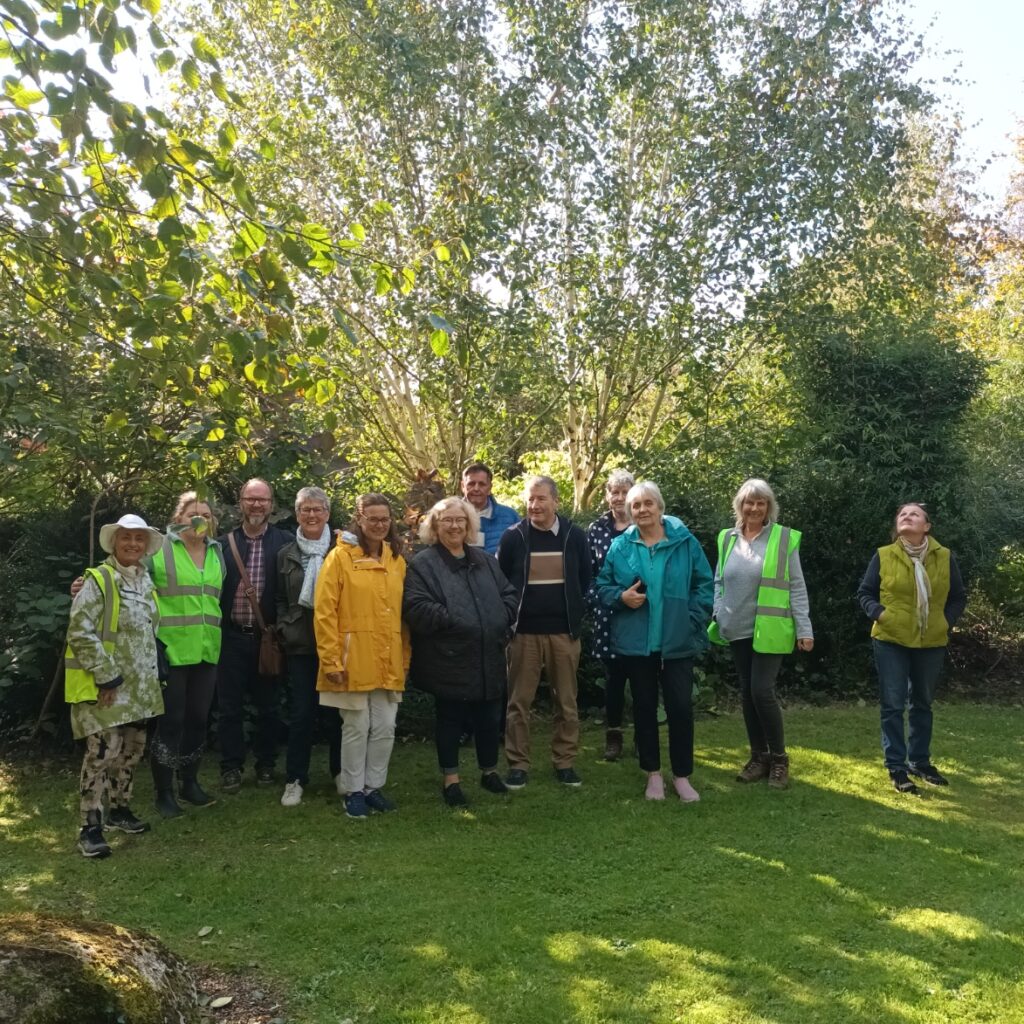

October 2023
Late October is a great time to plant anything , the ground is still warm and growth will get a good start on the cold weather to come and I planted up the new area in the back garden with spring flowering bulbs , a selection of miniature daffodils tete a tete variety , crocus and snow drops … all in clumps of uneven numbers with a minimum of seven bulbs in each planting hole .
I use the words “planted up” quite casually but far from causal the process was as the earth in that area was packed with underground roots of trees and ground cover ivy and I had to battle with a pick axe to even make an impression on the ground and it took a back breaking effort to dig holes deep enough … then I come in and watch Monty Don on Gardeners World and he casually sticks a spade in the ground and it goes down a foot of perfect humus and peat moss with minimum effort… of course his garden is an outdoor TV studio and he has minions to do the heavy lifting … we heard him describe that his entire box hedging has box blight and needs to be dug out over a large area and Snezana watched until the end of the programme to see how Monty dug out the hedging … not a hope as no way Monty was going to go at that with a shovel like us normal gardeners and I am sure as soon as filming stopped the BBC had the diggers in and followed by a few truck loads of perfect top soil !
In all a total of fourteen clumps with the smaller bulbs crocus and snow drops in the front and these will kick off in late January into early February when you really need a splash of colour … the snow drops when planted as bulbs are slow to get started and for a year or two will be just a wispy collection of leaves with few flowers but the crocus hit the ground running and will be a riot of colour in their first year .
Far better to plant snowdrops “ in the green ” which is when you divide existing clumps after flowering in Februaryand plant out and I do this each year from our existing colony but also I cannot resist buying snowdrop bulbs when they are on the shelves .
I was planting up this area from scratch as we had cleared it last May but nature will and has flooded it with weeds which I dug out and sprayed last month and I will add ground cover geraniums and some bergenia that I have grown on from slips taken earlier in an effort to keep future weeding to a minimum .
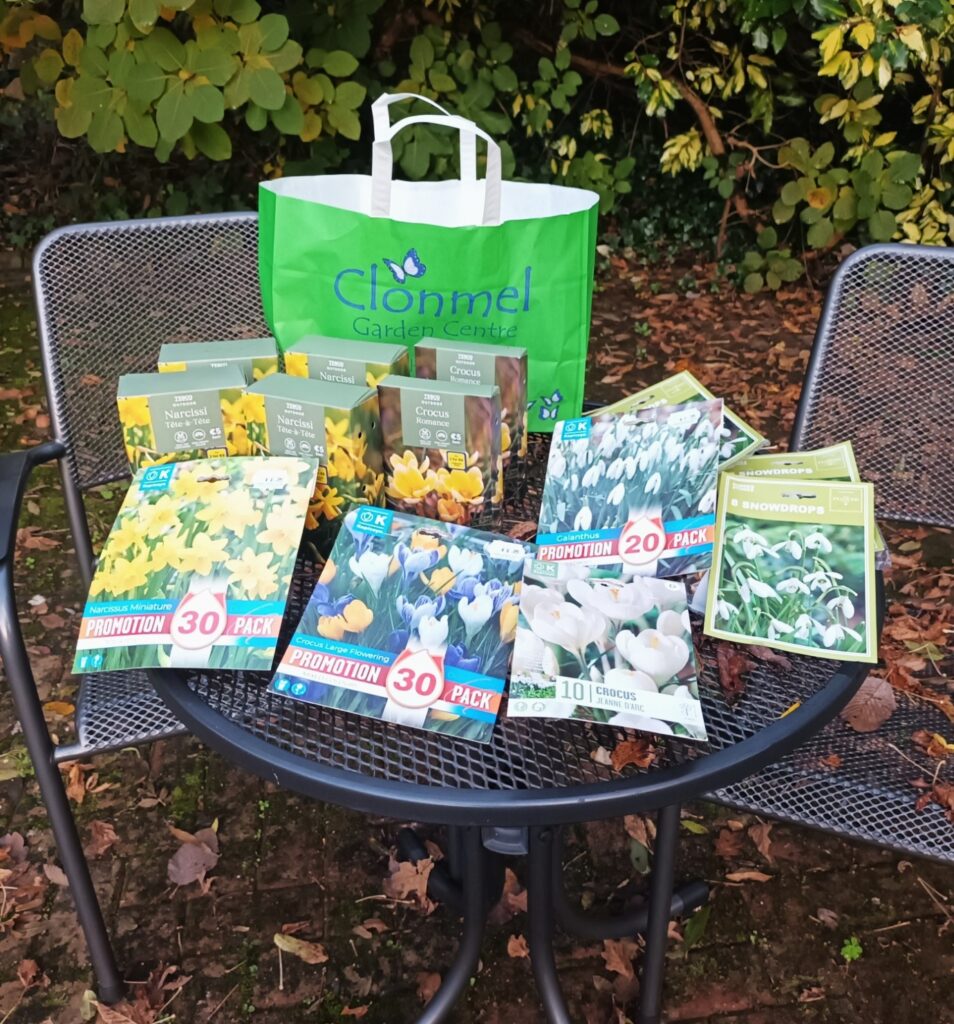
Snezana hates the aguaves I plant in Croatia purely because of their spike tips which admittedly are dangerous and you need to be careful when bending around them which is why I plant them well back from paths … but I absolutely love them , no finer architectural plant exists for me … so a compromise had to be reached where twice a year I regularly cut back the bigger leaves .
Not an easy job as the leaves are over a metre long and not only have spikey tips but have spikes running down the edges and while I hate cutting back big healthy aguave leaves they do need to be tidied up especially when the bottom leaves lie flat on the ground and smother their neighbours but they do fight back and I end up with scratches on arms and legs , no matter I wear gardening gloves and take extreme care .

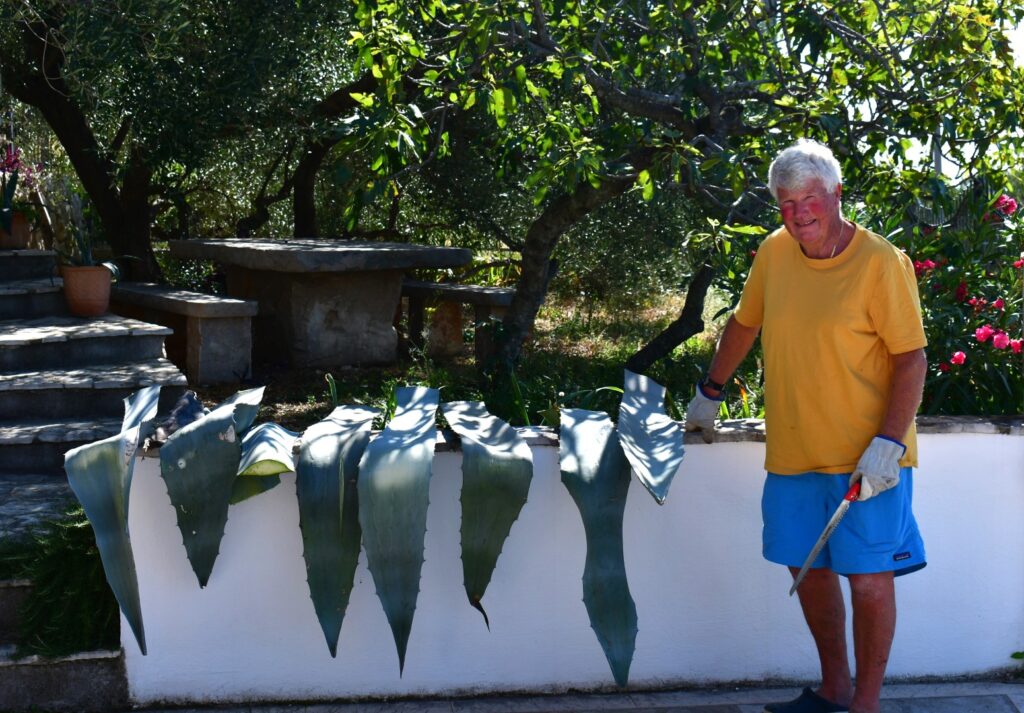
While in Croatia we got to visit Sarajevo , my first time back in eighteen years since I left my role with EU CAFAO in late December 2005 .
A lot has changed since my first time driving into Sarajevo on March 6th 1996 , twenty seven years ago , where did the time go and my diary entry for that day reflects the condition of Sarajevo and it’s people after four years of being under siege from Serb forces and daily shelling .
Driving down the motorway into Sarajevo on what used to be known as Sniper’s Alley past the Holiday Inn where I stayed for my first two weeks that turned into a Balkan Odyssey of twelve years brought a lot of memories back .

I drove into Bosnia for the first time on March 5th 1996 from Belgrade just weeks after the war had ended , crossing the Drina river border between Serbia and Bosnia at Zvornik . The next fifty miles took me through the front lines with burnt out tanks and devastated villages and towns all along the road , it was seven o’clock on a winter’s night and there was no other traffic or people out , snow on the ground and a general feeling of complete desolation .
About a half hour out of Zvornik I saw a sign for Srebrenica six miles off to the left , it was barely seven months after the mass killings and even though the full extent was not known of what was later termed by the UN as genocide , enough had filtered through to us in Belgrade that the name added to the nervousness .
My instructions were to drive without stopping to Sarajevo about 70 miles and when I got to the outskirts where I should pick up and follow the tram lines into the centre and be aware that there was a total curfew on lights so no street lights or any lights in shops or houses to act as a guide … keep on the tram lines to the other side of Sarajevo until I saw a big yellow building , the Holiday Inn , on the right hand side … and don’t mind the sporadic mortar and sniper fire , the Bosnian Serbs still have three weeks to leave Sarajevo and they are still exchanging fire with the Bosnian Muslims … a colleague will be waiting for you at the Holiday Inn … no lights on at the hotel of course only candles but I found my colleague … welcome to Bosnia and Sarajevo !
Visiting Sarajevo as a tourist I much different than my experience of living there as I did for over three years and much more enjoyable as I now had the time to just wander and enjoy the people and the ambience of what is a great Balkan city .Of course Sarajevo will always be associated with the assassination of Arch Duke Ferdinand and his wife Sophie on 28th June 1914 , an event that led to the First World War and you can stand in the foot steps of Gavrillo Princips , a Bosnian Serb nationalist , on the spot on the pavement from where he fired the fatal shots from a revolver at close range into their stationary open backed car .

Sarajevo today has moved on from the dark days of the Bosnian War 1902 to 1995 when the city was under siege and almost daily bombardment from the surrounding hills and the tourists have flocked back especially to the Old City known as Bacarsja where Bosnian coffee ,cevapi and burek reign supreme !

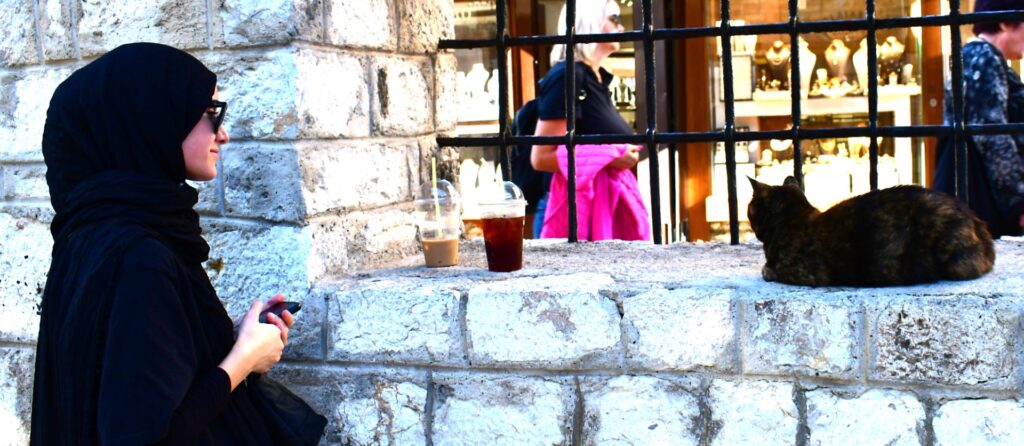
Different Faiths , Same friends

I took this photograph as for me it shows the acceptance of the different religions which was always a feature of Sarajevo all the way back to the 1500’s and these are two teenagers , one in the traditional hijab and her friend in modern style .
Visit to Stolac and the Bogomil stone stecak monuements
The stones are found all over Eastern and Southern Bosnia and I have even seen them as far south as Macedonia where I photographed some of them in Skopje last year but the biggest surviving collection of these enigmatic carvings which were all done by pacifist artists around 1100 AD is in Stolac in Southern Bosnia which is ironic as Stolac in the last war of 1992 became a byword for religious hatred and persecution when the local Catholic Bosnian Croats burnt out and expelled the town’s Bosnian Muslim majority population .

I remember in 1999 being present in Stolac when NATO soldiers in tanks had to stay in the town for almost a year to protect Bosnian Muslims trying to return to their destroyed and looted houses and I remember also being ashamed of being a catholic in Stolac that day and it remains a town I hurry through even today .
Most Croat people either have never heard of the stecak or have no interest but this is probably down to Catholic church bias and teaching as the Bogomil (the word means beloved of God ) were considered heretical to church beliefs .
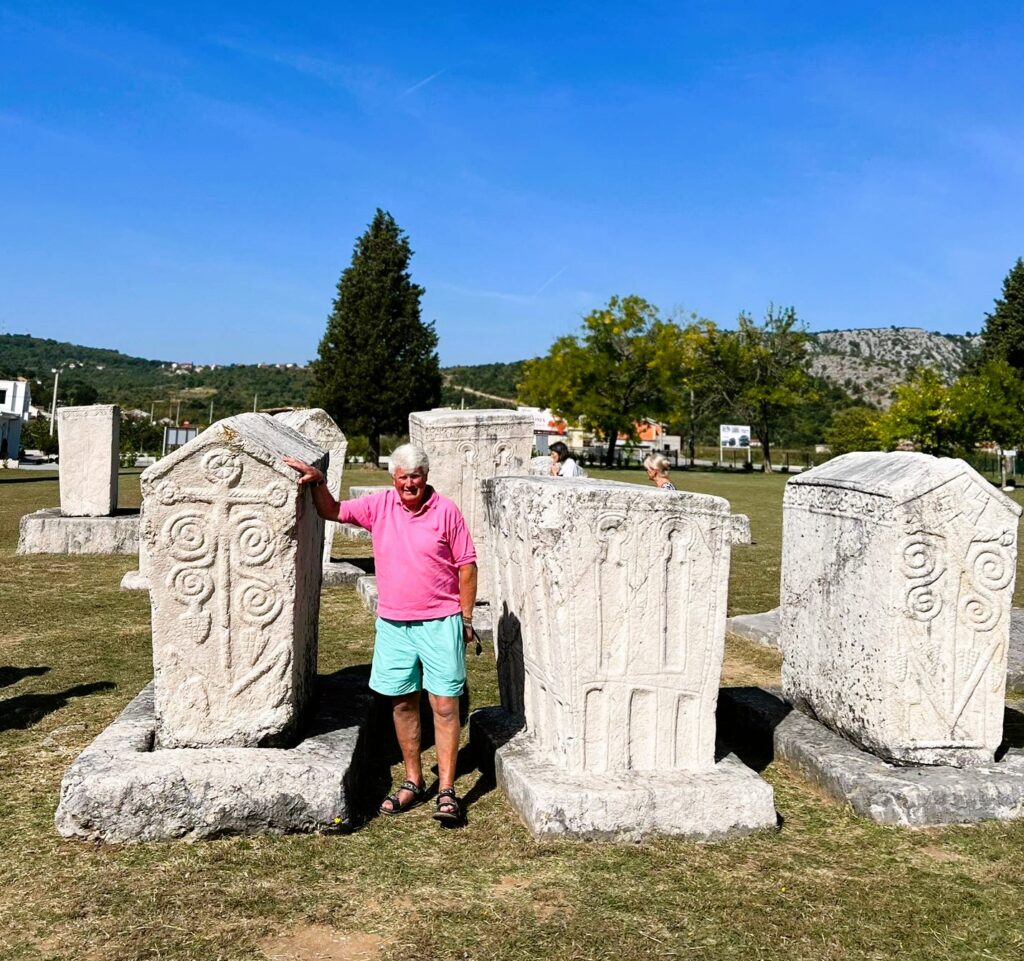
What is surprising is that the local Stolac Municipality do not make a big deal out of what is a UNESCO listed site and beyond putting up an ugly fence and an ordinary looking nondescript flat roofed few rooms selling tickets have done little to enhance or show case an extraordinary outdoor museum .
November 2023
An in between month November , not quite hard winter and still some hardy perennials poking their heads up but counting down the time before the first frosts blackens everything and none more so then my favourite plant , the gunnera .
Not everone’s favourite , the gunnera and not suitable for all gardens as it is huge after a few years in the ground , a monster really which needs space and to be close to water and I have seen garden visitors shudder at the sight of a fully grown gunerra .
I have always loved the plant since I first saw it in the 1970’s in the garden of Jack O’Donnell in Rosslare Strand and Jack kindly let me cut some chunks off the mother plant , it thrived for me then and since but you need to understand it’s needs in that while it soaks up lots of water it’s crown has to be planted on dry ground but near water where the roots can reach out and drink .
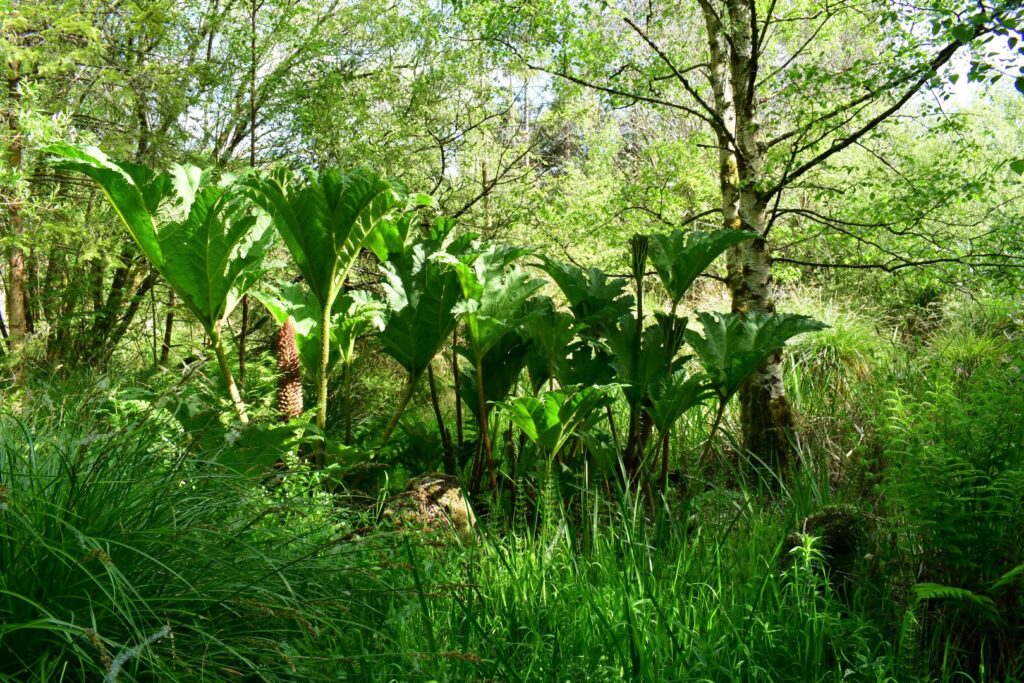
We have over twenty clumps of gunnera throughout the garden and each year I add to that number by taking chunks off the established plants and generally it takes up to four years to get established .
Gunnerra dies back messily in late November with the first frosts but there is still beauty in the remains because I cut the huge leaves down and fold them back over the crown of the clumps to protect them , not that they need the protection to come through next April but it tidies the messiness of the huge dead leaves into neat little parcels which in themselves have a nice architectural shape throughout the garden … well I think so anyway and I can almost hear my daughter saying “ if it makes you happy Dad ” !
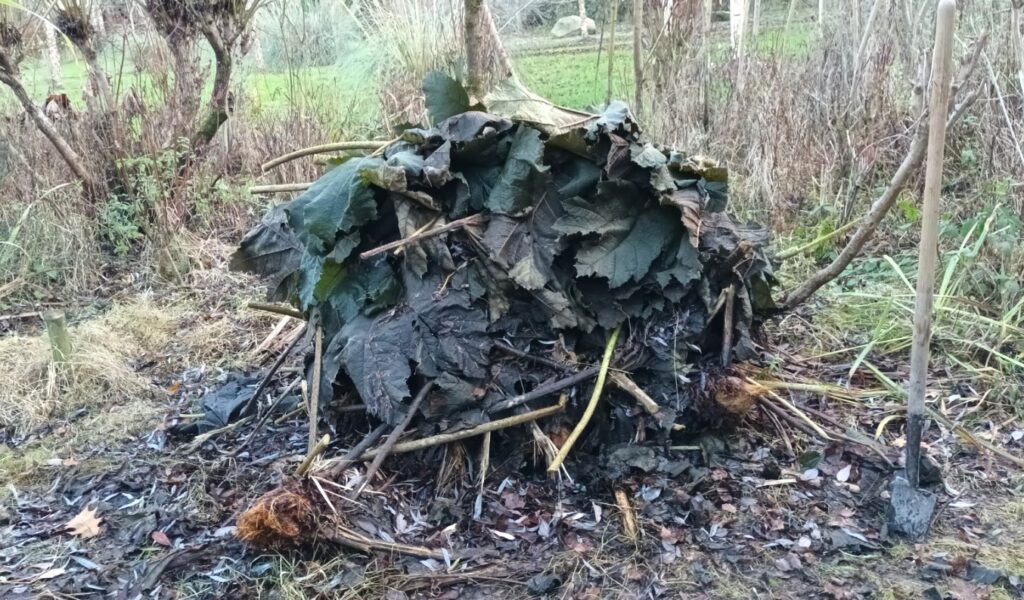
When I first heard of the daffodil Winston Churchill back in the 1980’s with my first garden in Rosslare I was attracted to it because of the name as I have always admired Churchill and loved his writing however having planted it the daffodil became my favourite large daff as it flowers late , in April , is double flowered white with pinkish tints and unusually for a daffodil has a scent .
It was bred in Holland in 1946 just after the Second World War and named after the former UK PM … I have found it difficult to source but for the last few years my local hardware shop in Clonmel , Bob Fitzgerald’s , has a large basket for sale … odd as they don’t normally sell bulbs and I must ask why of all daffodils they choose Winston Churchill as this name would not be universally popular in Ireland !
Anyway I stock up most winters with this variety from Fitzgerald’s and it is along with Dutch Gold the only large size daffodil I plant and this week I planted up several clumps in the new area in the back garden just behind a series of clumps of the miniature daffodil tete a tete … tete a tete flowers in February and the Winston Churchill will kick in two months later to prolong the flowering in the new bed in the back garden .
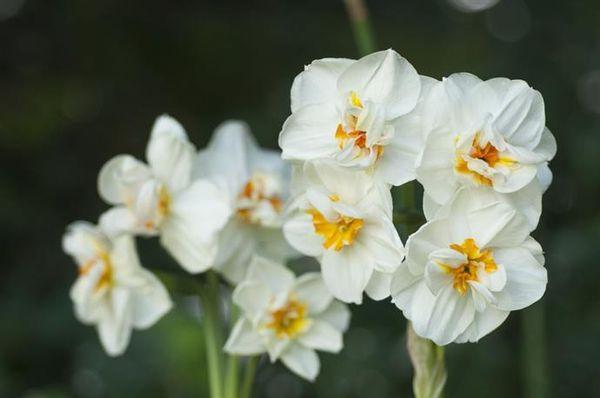
Normally bulbs are the last thing I plant in a new area as the clumps take over the best places and it is difficult then to plant your hard landscaping perrenials and shrubs without crunching through the bulbs … better to wait until all your planting is complete then plant the bulbs under or close to the permanent canopy of the shrubs . However for this planting scheme our idea is to have a seating area surrounded by a soft canopy of low growing cottage garden plants and to this end I have carpeted the floor space with the downy evergreen ground cover geraniums , my favourite Biokovo geranium I originally brought back from Croatia and which grows easily from the cuttings I take on a monthly basis all year round .
About fifteen years ago slow release fertilisers , osmocote , came on the market for private growers and I haven’t been without a container of it since … I pop a cap full or two depending on the size of the plant or shrub into each planting hole at the base of the new plant and the theory is that it releases it’s nutrients to the roots on a slow controlled basis spread over six months and I use it for both perennials , trees and shrubs both in the ground or in containers … does it work … all the literature says it does but it would say that wouldn’t it … I honestly don’t know as I never plant anything without it but it makes me feel good that I am giving the best possible start to a new arrival in the garden .
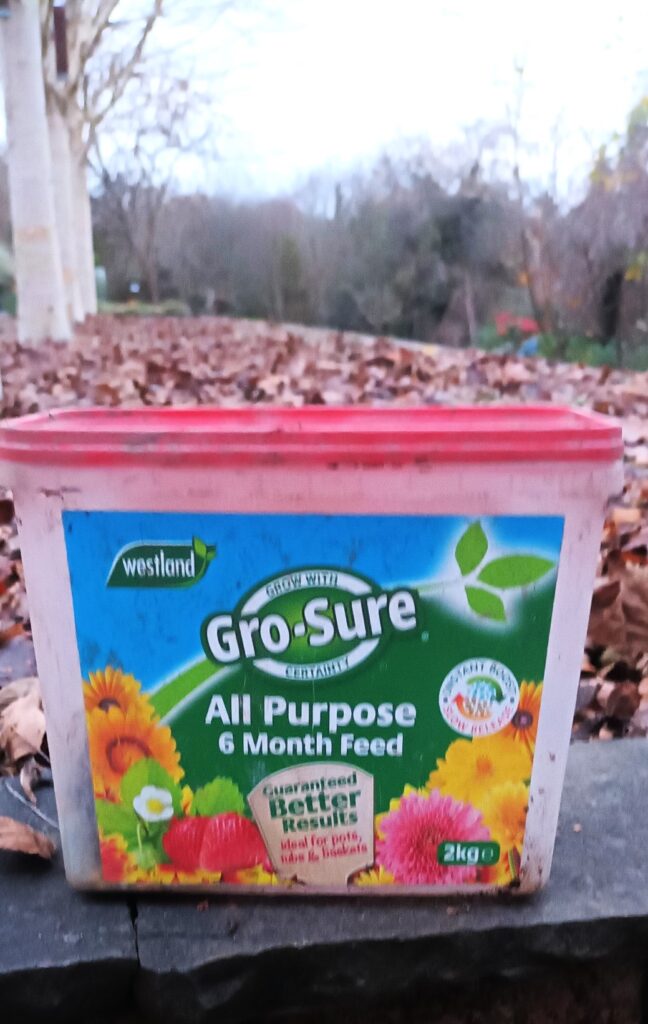
I wrote last month about my first visit back to Bosnia in eighteen years and I am often asked if it was dangerous during my time there immediately after the Bosnian War … I never felt in danger but there were some scary uncomfortable moments .
Most in fact all of these scary times were while travelling and working in Republika Serpska , the Serb controlled entity in Bosnia as the Serbs felt they had got a bad press from the International Community during the siege of Sarajevo and they were suspicious of those of us visiting there in the first months after the war … Serbs are naturally suspicious anyway but back then they were positively paranoid about us and just didn’t like us being there figuring that all our sympathies were with the Muslims .
I spent twelve years in Bosnia after the war and although in my book the Serbs were responsible for the break up of Bosnia and the civil war that followed I was never blind to the fact that all sides committed war crimes and atrocities and that all sides had psychopaths in their armies and police .
In those early days of March 1996 the Serb cities along the Drina were the worst places for us to go especially Zvornik and Visegrad where the hatred directed in our direction was palpable and it was to Zvornik I went on my first operational visit accompanied by a local team of Aldin, Amira and Mehmed , all Muslim colleagues .

We were staying the night at Hotel Zvornik , a kip of a place which seemed to be the hang out of the local mafia , all gold medallions and moustaches who certainly were not at all interested in a Trip Advisor rating from what they saw as an EU official accompanied by a “ Muslim ” invasion from Sarajevo .
In hindsight of course we should have hot footed it back to Sarajevo but it was a three to four hour trip in darkness over snow and icy terrain on a road that would take us through Srebrenica and none of us fancied being stopped in the darkness by Serb paramilitaries that were operating at night in that area .
We arrived down together to the dining room for dinner having agreed beforehand there was safety in numbers and we would move as a group , all the while being eyed up by the resident Zvronik macho bad guys … a horrible atmosphere in the entire hotel Zvornik but especially in the dining room built out over the Drina river and looking directly across to Serbia … the décor was heavily pre war Yugoslavia with the addition of a neat row of bullet holes stitched into the top of the floor to ceiling window that nobody had bothered to patch up and the Serb waiter didn’t look so great either … he had an attitude that said I know you are from that Muslim loving UN and more or less hissed at us what do you want to order .. I rather timidly asked what was on the menu for that night and looking at my Muslim colleagues said in a loud voice MUSKALICA (which is a pork dish ) … Aldin , a real cool guy who is a friend to this day , didn’t miss a beat and said we will all have MUSKALICA … silence all round in the full dining room all watching us … mafia , war criminals you name it they were probably all there that night … when the bowls of muskalica were slapped down in front of us Aldin took up a spoon full and as it reached his lips Ahmed whispered ALDIN IT’S PORK and not missing a beat Aldin stage whispered back EAT IT … saved our lives that night Aldin did and the muskalica tasted great !
Peru Peru Peru , two weeks in November !
For over fifty years since I first read the history of Peru and the Incas I have wanted to visit the country and see first hand the great stone blocks the Incas used to build their fabulous palaces and of course to climb to the iconic Machu Picchu .
I had always heard that Peru was one of the last countries where the local people dressed normally in their traditional dress .. normal as in not for the tourist like a lot of countries now … on all counts Peru did not disappoint and totally lived up to expectations .

And Peru is the land of the Llamas , their great go to animal for wool , transport and sometimes food but to see where they live in their natural habitat of the altiplano , the high plains of the Andes at over 14000 feet , is an eye opener … and talk about eye openers the Alpacas a smaller version of the llama are so petite , loveable and huggable that you want to take one home with you !
We also got to see the vicuna in their natural terrain on the high plains where they are rounded up once a year purely for their wool , from the same camelid species as the llama and alpaca and which are never tame , prized for their wool but elusive shy gentle looking animals .

The alpacas are also gentle but nobody ever makes the mistake of thinking the llama is gentle … these guys are big and muscular with an attitude , they eye you up and can deliver kick or spit in an instant if you annoy them … my son Kevin once ran up to one at eight years old in an open zoo with me running behind him saying they spit , they spit Kev … and this one did right in the middle of his forehead and poor Kev’s head vanished in a shower of spit !
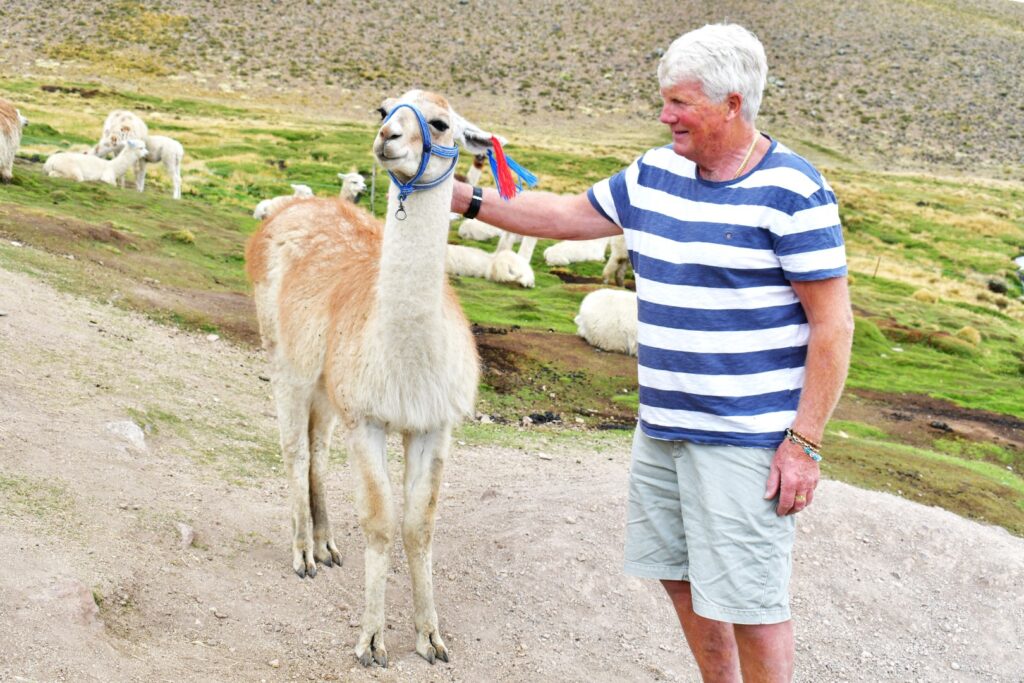
A visit to the floating islands of Lake Titicaka was a highlight where the Uros people for hundreds of years have lived on the lake on man made reed squares out on the water , all fastened together and tied to stakes while another stand out was when we drove through the Colcha Canyon over the El Condor Pass at 16,000 feet made famous by Simon & Garfunkel and saw the huge Andean Condors below us fly with their 11 foot wing span .
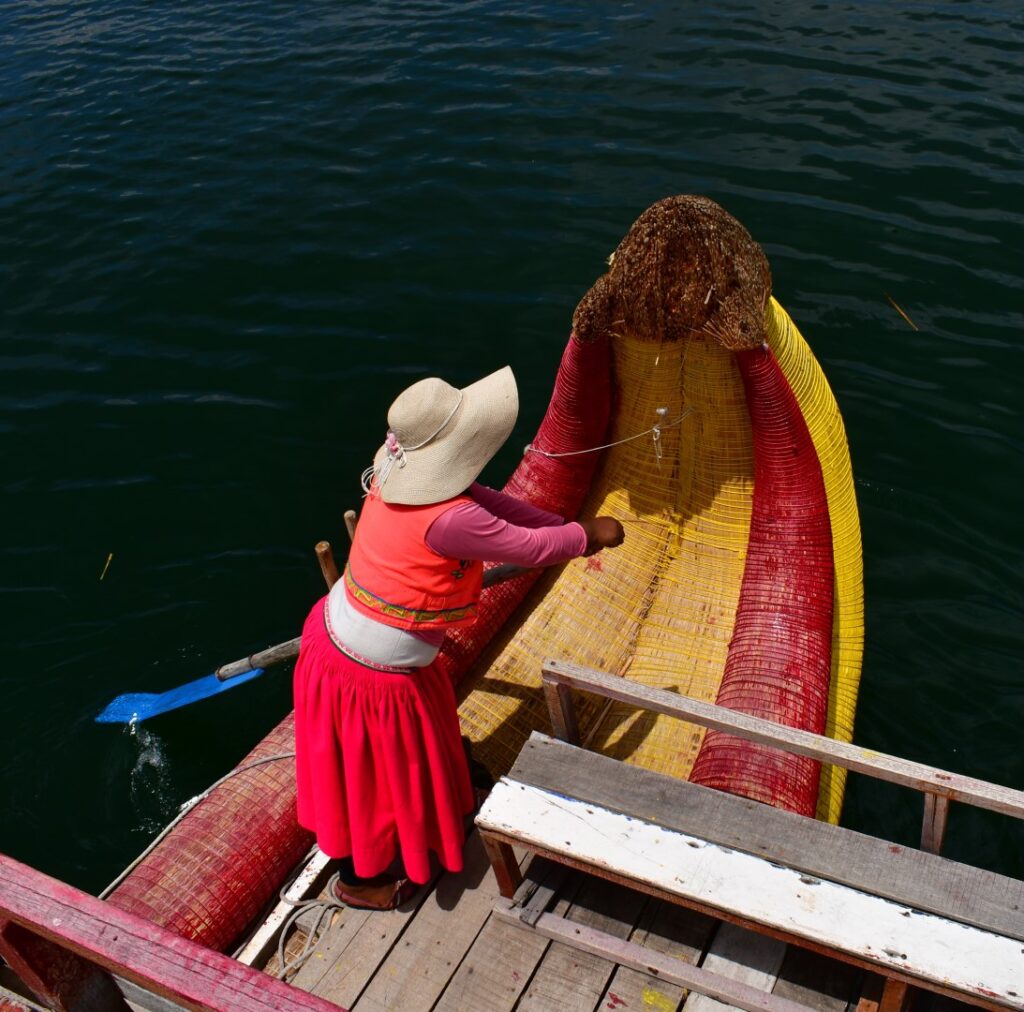
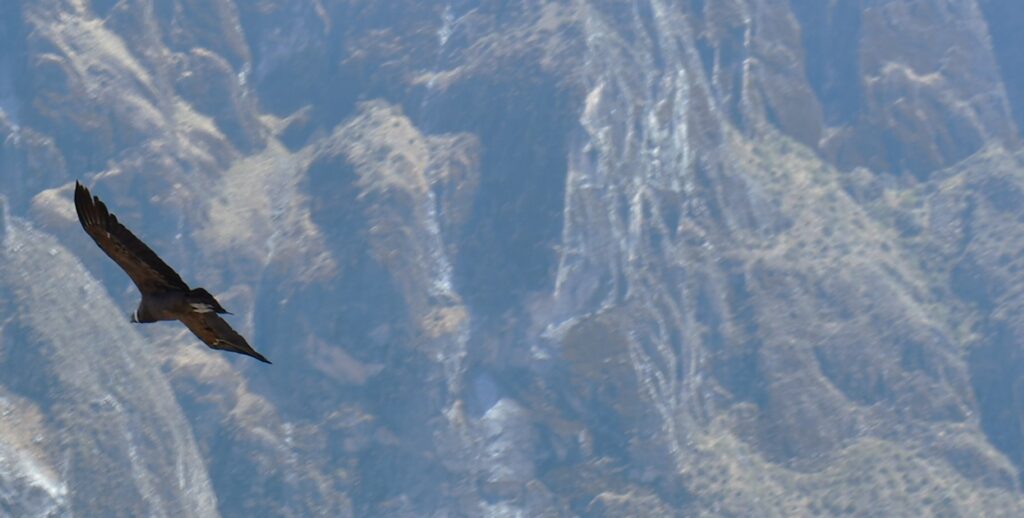
But when we left Peru it was not primarily the memory for the glorious mountain scenery , the Inca sites , Machu Picchu , that I took away with me but the memory of the extraordinary niceness of the Peruvian people that will remain forever .
I passed these ladies late in the evening when they were just finishing work for the day in the fields .
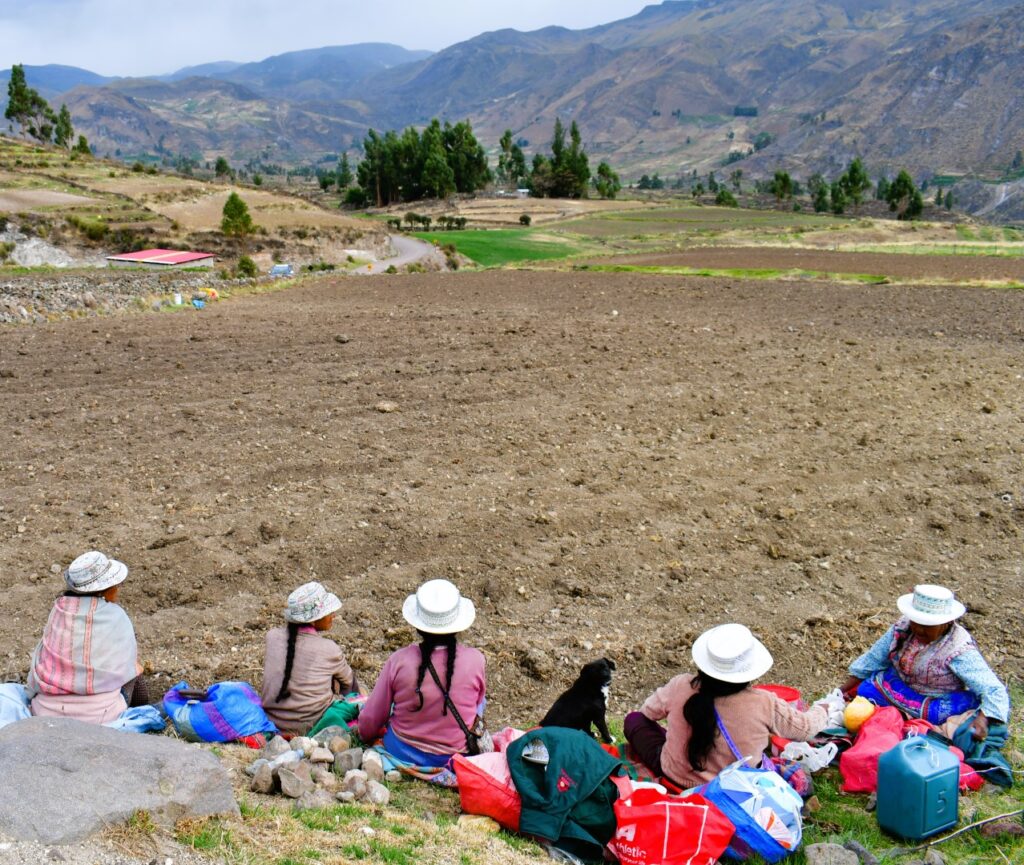
That and the fabulous hats the Peruvian ladies wear which are a work of art and social significance in their own right … not forgetting the single plaits they wear and here is a curious thing the ladies of the high Andes never go grey their hair remaining a natural black all their lives .


I had been warned about altitude sickness in Peru but everyone including my doctor said take a few paracetamol for the invariable headache the first day and you will be grand while others said coca leaves are sold on every corner , suck on these and all will be well … not so and despite ingesting coca leaves in industrial quantities and hoping the drug sniffer dogs weren’t on duty when we arrived back to Dublin Airport , we had a huge problem with the altitude from Day 1 but the tour was designed to give us twelve days in Peru before tackling the 10,000 feet climb to Machu Picchu and we made it !

Going to Peru I had really equated the Incas as the major and most important part of the history of Peru but in reality the Incas only lasted 120 years from 1300 to 1450 when the Spanish conquistadores under Pizarro conquered and subjugated the entire country and the reality was that there were great civilisations in Peru , at least six major ones before the Incas dating back to 1500 BC … but everyone is fixated by the Incas ?
The great Devla Murphy wrote about this in her book “ Eight foot in the Andes ” when she said “ The Incas wished however to seem the sole creators of all worthwhile culture so their propangists manipulate oral history to obliterate all traces of the regional cultures which they had used as their “ foundation stones ”.
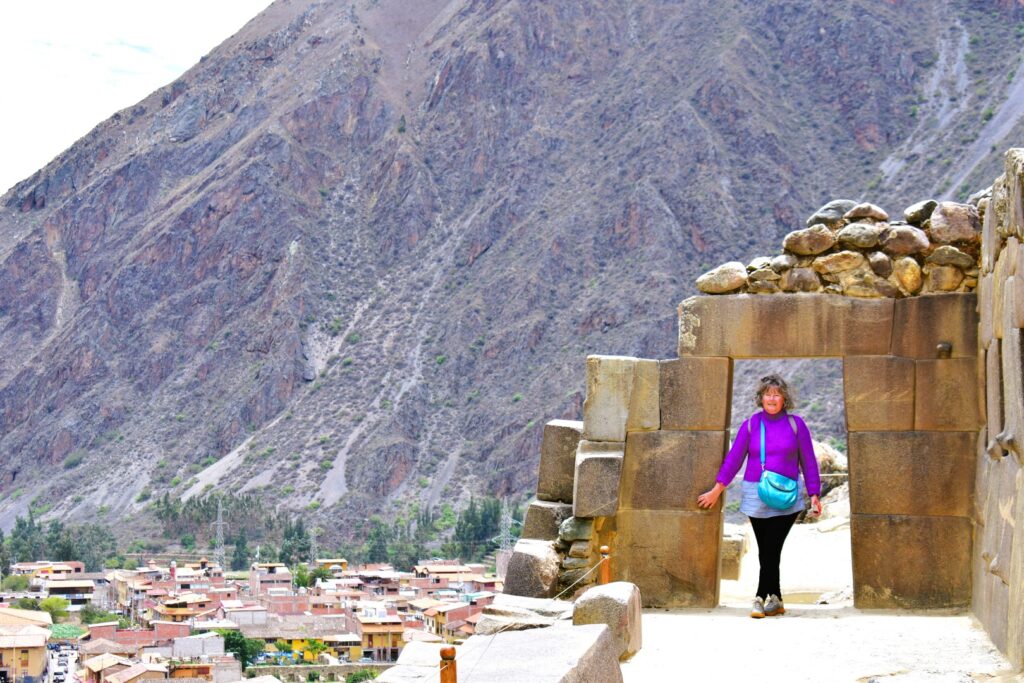

Christianity was introduced by the Spaniards and catholicism has been the official religion of Peru for five hundred years but for Peruvians there is a huge attachment to the land and in fact the Incas valued land much more than gold however I sense that just below the surface that belief in Pachamama , the Earth Mother , is still strong and the Church in Peru has been clever about allowing the old beliefs to continue or at least are not banning it and in some valleys the local priest is also a shamen of the old religion .


This is a Wikipedia description of the Quechua people of Peru … could you find people like this anywhere in the world ?
The indigenous Indians of Peru are unique in the modern world. They are uniformly spiritual, uninterested in politics, and loyal to their families; they are not greedy or materialistic; they express themselves in shy smiles and rarely complain.
Machu Picchu of course is one extraordinary highlight for us and we were lucky we got a great day weatherwise so we saw the fabulous lost city of the Incas at it’s best light … almost vertical stone steps of uneven size to 10,000 feet … horrendous effort but worth it when we finally tottered out on the top platform looking out over the royal palace and a view never to be forgotten .


Made it !

Been there Done that Got the stamp in the Passport !

December 2023
December of course is so busy for most people with family , visitors , food preparation enough for three sieges , effing and blinding because the Christmas Tree lights won’t work and the generally bad weather that hardly any work gets done in the garden and of course it is a good month to take off out there as basically everything is dormant and even gardens need a rest !
I often tell visitors to the garden that our garden would have a different design if we didn’t have deer traipsing through it every day and taking a bite out of anything that takes their fancy be it trees , shrubs or hostas and certainly in the Lower Field woodland we would have a lot more acers and silver birch but time has shown us that any new tree planted there is fair game .
A Jeremy Clarkson article in the Sunday Times last week stated “ You have the problems caused by Bambi it is reckoned we now have over two million deer in Britain and they do more damage to our woodland than ash dieback , canker , the horse chestnut leaf miner and Dutch Elm desease combined “. Figures from Scotland suggest that deer could be damaging 150 million young trees every year ” .
The nicest plants are sometimes the ones that have been around from our grand parents time and none better in my view than the plain cowslip or primula and I always buy in a tray from Clonmel Garden Centre each October and plant into pots near the front door and around the front garden , somewhere you will pass on a regular basis … the breeders have hybridised the hell out of the variety and they are available in all sorts of garish colour if that does it for you but for me you can’t beat the original humble yellow flowered cowslip and this one at the front door has been flowering non stop since October and will continue to do so until late March and when the cowslip has finished flowering in the pots I transfer them to open soil in shady spots around the garden and some you lose but the odd one comes back next year but at one euro per single plant one can’t complain .

While trawling through the garden centre I always check the bargain basement section for unloved specimens where you can find perfectly good plants for knock down prices and this coupled with planting bare rooted trees and shrubs in Winter means you don’t have to fork out a fortune to stock the garden … this next photo shows where a few years ago I added a mixture of shrubs to a boundary fence with our neighbour where the soil is not great being heavy and dry but the bamboo and two types of laurel were all bare rooted bargain basement shrubs from the garden centre which although small and miserable looking when they were planted , have now thickened out into a fine screen .

No matter how nice Christmas is there is no denying Winter and late December in particular is a dismal time in the garden especially when we have only about six hours of real day light and I can see how people can get depression or light deprivation in December / January .
It can take a real kick to get me out in the garden at this time but I try and do it and aim for at least upwards of an hour each day where I take a secateurs and heavy duty gloves on my walk around just to feel it is not an aimless stroll and there is always a bramble or a branch of a shrub that needs attention .
There is a huge feel good factor at just making the effort and sometimes like today you come across something that gives a lift like the furze bush that bloomed a few strands or coming across a clump of flowering vinca or the little water hens that stopped clucking when I walked into them in the water area and then hunkered down real quiet thinking I hadn’t seen them but I had and I watched them for a few minutes before they realised I was watching and they floated gently away … it was worth forcing myself out just to see them .
The Elders of Clonmel book is on it’s fourth printing since the release date in late September and is I believe very popular as a Christmas gift for Clonmel people living away from their town and I was delighted to be a part of it .

The time of year that is in it
The end of December is not a happy period for either the people of Gaza or the Israeli people both of whom have and are suffering and all in the name of a common God from the Old Testament may it end soon in an acceptable manner for both sets of people.
The War in Ukraine is almost two years old now and little did we think we would ever see a full scale war in Europe again and it is time for both sides to start a negotiated peace … it will be a win win for Russia though as there is no way it will have to give up what it has seized in Crimea and Eastern Ukraine … with that result and all the useless rhetoric from the EU and the US you have to feel sorry for the ordinary people of Ukraine who have lost so much .
For fourteen years I worked in the Balkans , another area torn apart by the religious wars of the Serbs , Croats and Muslims .
We in Western Europe live a sheltered existence , it has never been like that in the Balkans where losing everything and being ethnically cleansed from their area is a fact of life where you are given 20 minutes to pack one suitcase per family member … what do you pack in such a situation I asked one young girl in our office in Sarajevo whose Bosnian Muslim family was expelled from Capjlina in Southern Bosnia by Bosnian Croats… passports , education and birth certificates that you need to start a life somewhere else , family photos , a few treasured CD’s and your best jacket and it is then downstairs into a waiting truck full of your neighbours from the apartment block and as you leave the area another truck is arriving bringing similarly expelled Bosnian Croat refugees each also with one suitcase who will then move into your apartment .
Peru in November
Looking back on my writing last Month on our November trip to Peru I realise that I was so carried away with the Llamas, Alpacas , the mountain passes and the niceness of the people that I neglected any description about the Inca palaces and fortresses that Peru is justly famous for .

Visitors to the sites or even those who only see photographs are amazed at the size of the building rocks used , some up to 200 tons weight and how they were raised into position not to mention how they were transported long distances from the original quarries .
To see them at last in situ like we did is just mind boggling and you are almost tempted to believe in conspiracy theorists that the Inca stone palaces were built by aliens or supreme beings from outer space and not by normal 15th century people living in Peru !
What we forget is the sheer amount of workers maybe up to twenty thousand people that would be called up by the Inca Emperor to work on the projects and who would spend perhaps twenty years working on each site .
The three greatest sites are Sacsayhuaman , Ollantaytambo and Machu Picchu , I have been looking at photographs of all three sites over the past forty years but seeing them in person and reaching out to touch them was just magical for me .
The first two sites above are defensive macho fortresses and when you see them each situated on low hills dominating the valley below you are in no doubt these were built for war … Machu Picchu however was a private place , a spa if you like , to be enjoyed as a retreat for the Inca Royal Family .
Machu Picchu is fluffy , a fairy tale looking site , a sort of modern day Balmoral and there is nothing defensive or military about it , it’s remote location on a plateau below a peak at 10,000 feet was it’s protection and it was isolated from the World for over four hundred years .
Nothing fluffy about Sacsayhuaman or Ollantaytambo and both are seriously aggressive and imposing battlements , a huge contrast with Machu Picchu and you know that with these sites the views are not important and that what was important was that they allowed you to kill large numbers of an attacking army .

You come away from both these sites seriously impressed knowing that battle hardened warriors lived here but you fall in love with Machu Picchu and know it must have been a great place to hang out with your family and friends … just you and other royals , paparazzi and common people kept firmly out !

Kay Burley the Sky News presnter was in Peru recently and wrote about it in the London Times with this story of how mispronunciations in a foreign language can confuse !
“ I learnt a number of life lessons on the four-day trek along the fabled Inca Trail to Machu Picchu, not least the importance of pronouncing the sacred site correctly. “Machu-Pick-Chew” means “old mountain”; “Machu-Pea-Shew” translates to “old penis”, which can be very entertaining for the trek porters when western tourists — and I confess I was among that number — haven’t done their homework.”
Not as uncommon as you might think and in my first six months in Bosnia I was happily mangling the local language by introducing myself at meetings as Medunarodne Czarina which means International Customs but sadly not the way I pronounced it until a wise soul took me aside and advised that my pronunciation of Czarina as Carina meant I was introducing myself as International Pussy ??
The title of the first entry for 2024 tells it all ” Thank God January is over ” !
Yes January can be a tough month to get through with gloomy daylight , post Christmas blues , shite weather … need I go on ?!
When I titled this Thank God etc. it reminded me of a time Snezana and I were in New York and really hungry this particular evening we passed a fast food chain called TGIF which neither of us had ever heard of before … we don’t get out much … in we go and order almost everything on the menu , chips, burgers , onion rings , you name it we loved it … our waitress , a small black lady had to work hard to keep up to us … afterwards I’m waiting for Snezana to come out of the loo and our little waitress stopped in front of me to chat to another waitress … never noticed me , we all look the same to them too … and she says MAN THOSE HONKIES WERE HUNGRY !!
A few months ago I cut back hard a so called dwarf viburnum ,variety Evelyn Price , in the front raised bed that had grown a bit bigger than planned and it was now blocking a nice view out to a multi stemmed silver birch in the front garden however as always with a hard pruning of any shrub there is a risk that cutting back hard into old wood can damage the shrub and the viburnum died … this week I dug it out and planted what I hope will be a better behaved replacement .

So with a replacement shrub in mind we paid our first visit in 2024 to Clonmel Garden Centre on January 3rd and made a selection for the replacement in the front garden raised bed , a combination of bulbs , perennials and shrubs . First up was the main centre piece , a dwarf hypericum , St. John’s Wort , which will grow to a maximum one metre square but which can be easily maintained by hard pruning each Spring … one of my favourite shrubs , ever green leaf and prolific yellow flowers from May to September . The main criteria here is not to obscure or take away from the multi stemmed silver birch in the background .
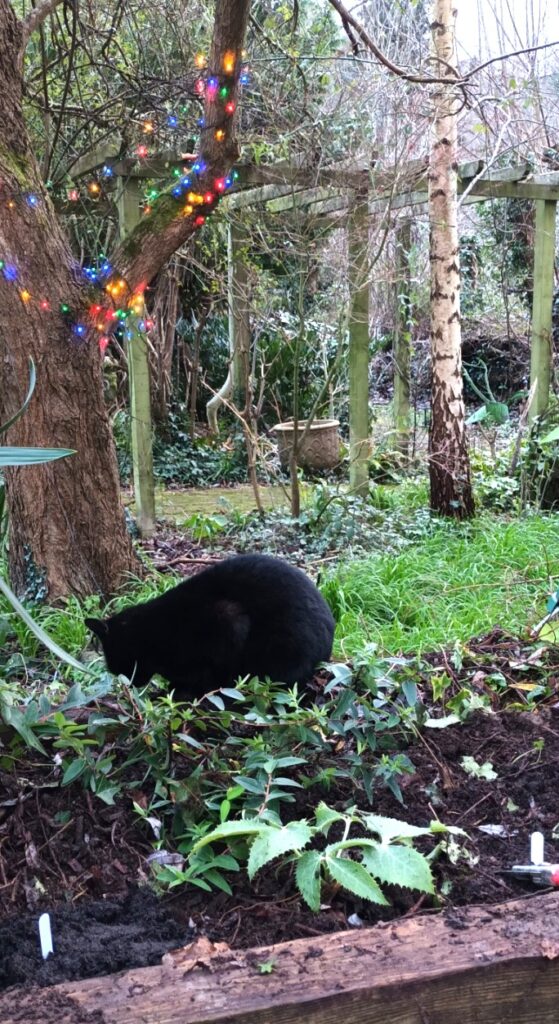
Also on the bargain bench I picked up four pots of another over wintering hosta , Golden Meadows , all at half price and again new to me but reading up on it I see it is related to me my favourite sieboldiana hosta Elegans and is big leaved with a mixture of green and gold . The reason these hostas are on sale is that they will be slow to come into flower unlike the forced ones and people are reluctant to buy them as they look pretty scrawny against the forced varieties which are huge in comparison .
I had one hosta growing in a pot in a shaded part of the front garden that I planted there last year after the deer ate it to the ground in early May however it grew back well by July which is unusual for hostas however but I decided enough was enough in that location so transferred it to a small pot that was idle but because the pot wasen’t very large it had little impact so I decided to match up a few spare pots solely for the extra hostas and make a group of five , raised some of them on bricks to vary the look and they look good already !
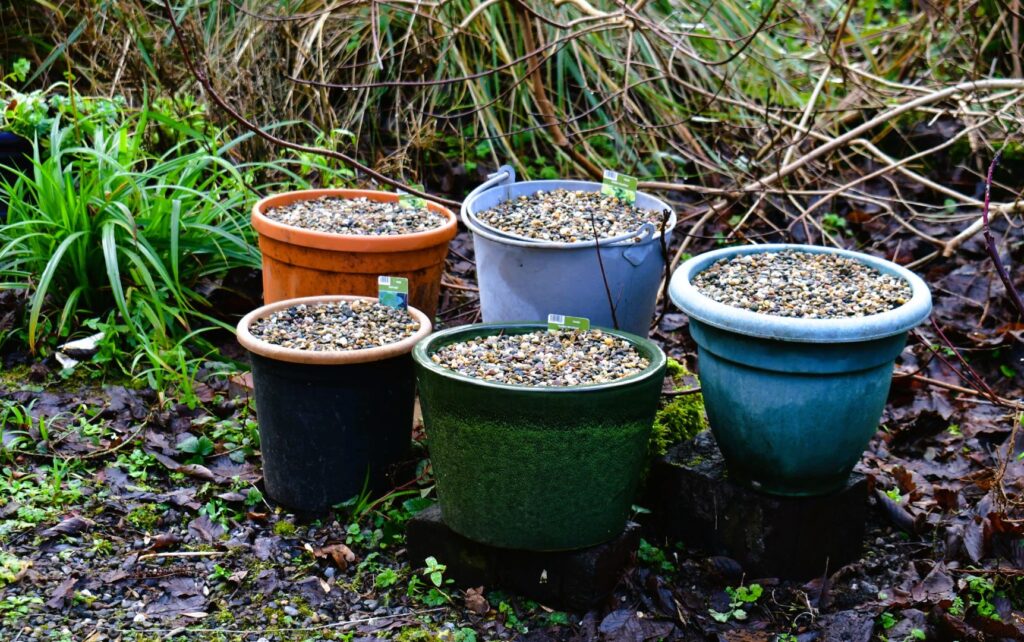
Job done , the first in the garden for 2024 and it got me out in miserable January weather !
Mary Skelly in Kilcoran Garden Centre is always a great source of bare rooted trees from December onwards and unusually she has a wide variety of native Irish trees available and this week I bought ten silver birch whips , three golden willow and two viburnum opulus whips , all bare rooted and four feet tall which is the perfect size and all are destined for the wild garden field where the plan is eventually to have a small woodland of native trees , no conifers just a mixture of oak , silver birch and various others which should be great for wild life … hopefully the deer will leave them grow otherwise venison steaks will be on the menu big time !
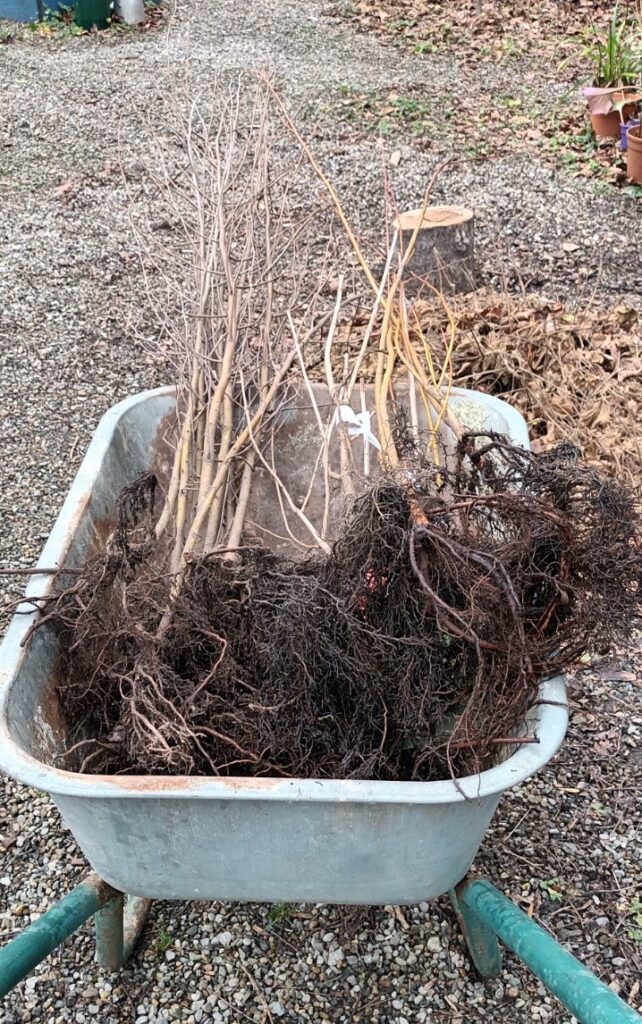
Colour in the Garden in January
Not a lot to be honest as there is very little in flower at this time of year but the silver birch jacquemontii really come in to their own with almost luminous white bark .
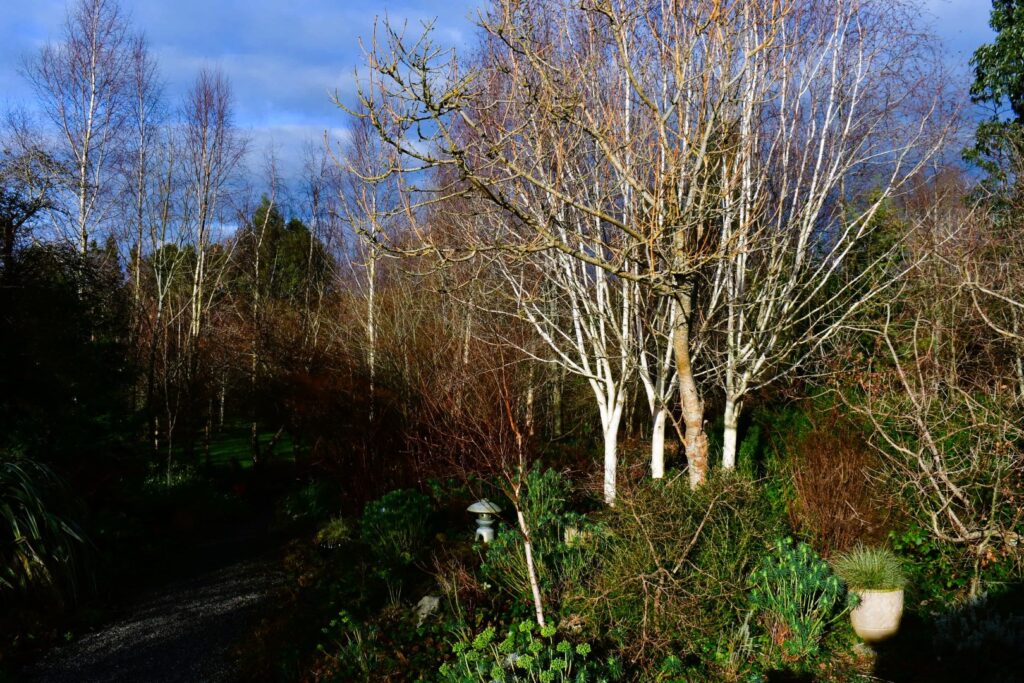
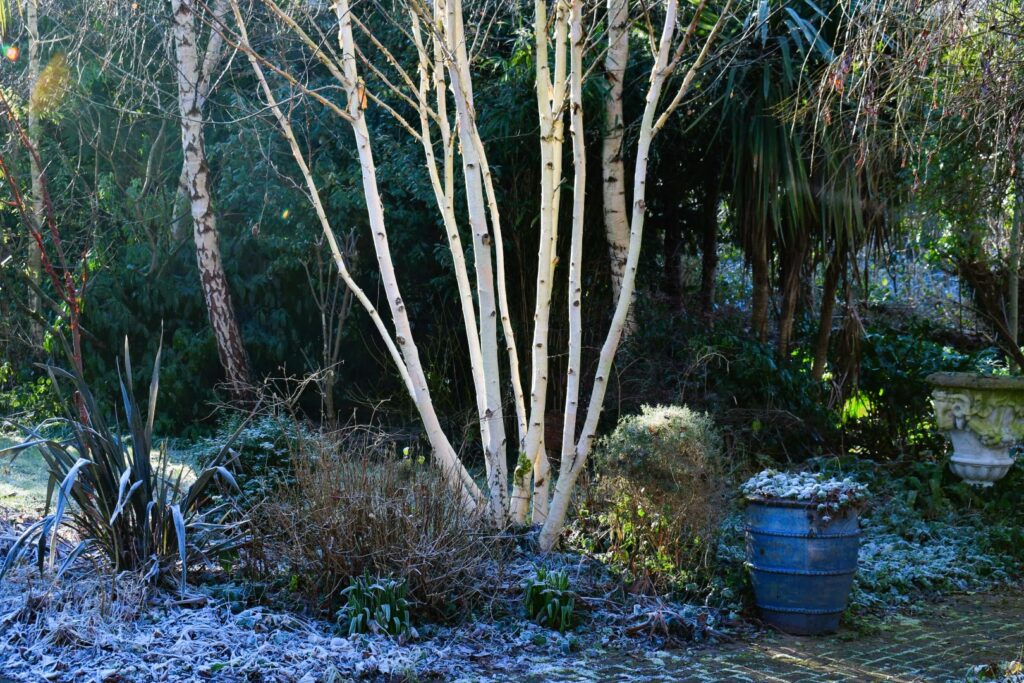
This is where primary colour pots and benches are useful and since Snezana introduced me to the joys of blues and reds in the garden twenty years ago I have embraced my inner Andy Warhol !
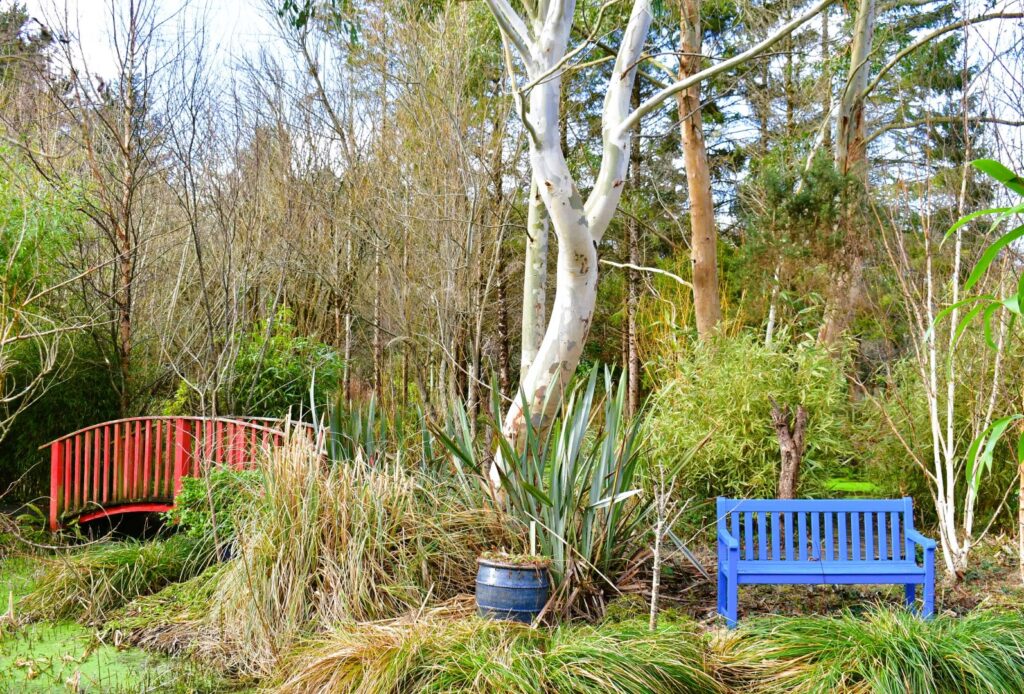
Enthusiasm in the Garden in January
At an all time low and there is little enthusiasm in gardening in January to be honest unless you are in out of the elements in a green house !
Typically I try and get out for at least for 90 minutes each day which then as I get warmed up and realise there is no Guardian Angel to bring me indoors , I lengthen to two hours and my favourite time and one that works for me is to get out of the house at 3 pm and work until it gets dark and apart from feeling virtuous I get quite a bit of work done .
I find the key is to dress up warmly and vary the tasks and keep moving such as like today when I dug up a self seeded young oak and transferred it to the wild area as well as a viburnum that was planted in a pot in a newly cleared area last year but hasen’t done well … then moved down to work on the new area in the Lower Wood where I had some tidy up grouting to do on the rock paths … then on the carrot and a stick basis I felt able to indulge in some reading and TV for the rest of the evening !
File this next paragraph under did you know ?!
A single mature tree can be home to as many as 326 different birds, mammals, insects, lichen, ferns and fungi and OK you may say as I generally do f..ked if I care about lichen and fungi but studies have found that those who see trees every day show reductions in stress levels by up to 30%. Even looking at leafless trees in the Winter has been shown to have positive psychological impacts and increased relaxation .
And now it is official you can wash your silver birch trees with soapy water to shine and bring out the white bark colour better in the winter months and over the years I knew one or two gardening friends who do this however I thought it was a bit fussy but this week the Royal Horticultural Society announced that it does this in it’s winter show gardens in London but even so I don’t see myself giving it a try for our silver birchs .
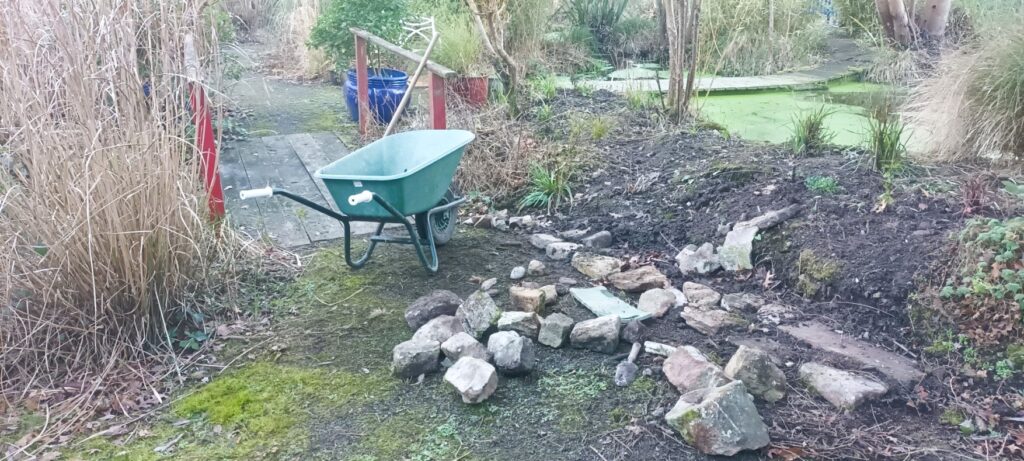
We have an area in the Lower Wood that I pass almost daily and which has been a bit of a weed ridden eye sore built up from silt dredged to create the new water garden two years ago and an area that we have got used to walking by but in January I finally did something about it .
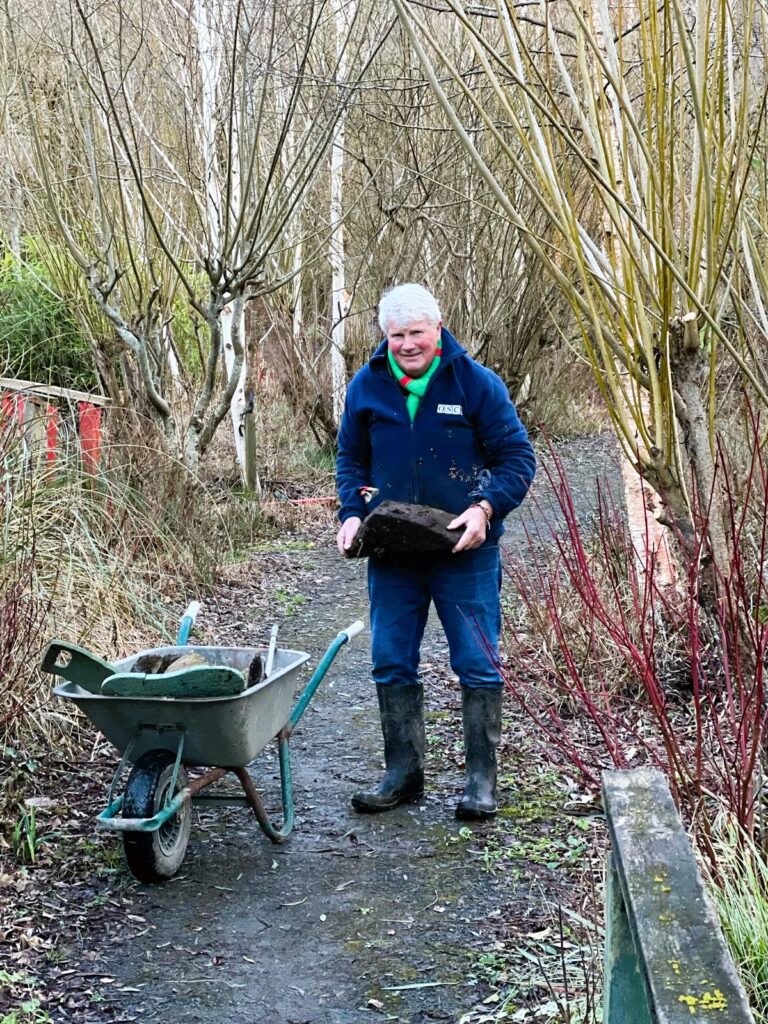
The area around our laneway used to contain several stone quarries that were in use up to a hundred years ago and as a result all the fields that make up the garden contain stones of various sizes that over the years I have used for dry stone walls and paths . I first built a small path in front of the mound then added a small wall around the mound with concrete paving slabs walk to allow entry to the water side and added a pot moved from another part of the garden … I will plant up with geranium ground cover and add bulbs next autumn .
The finished bed ready for planting January 31st 2024
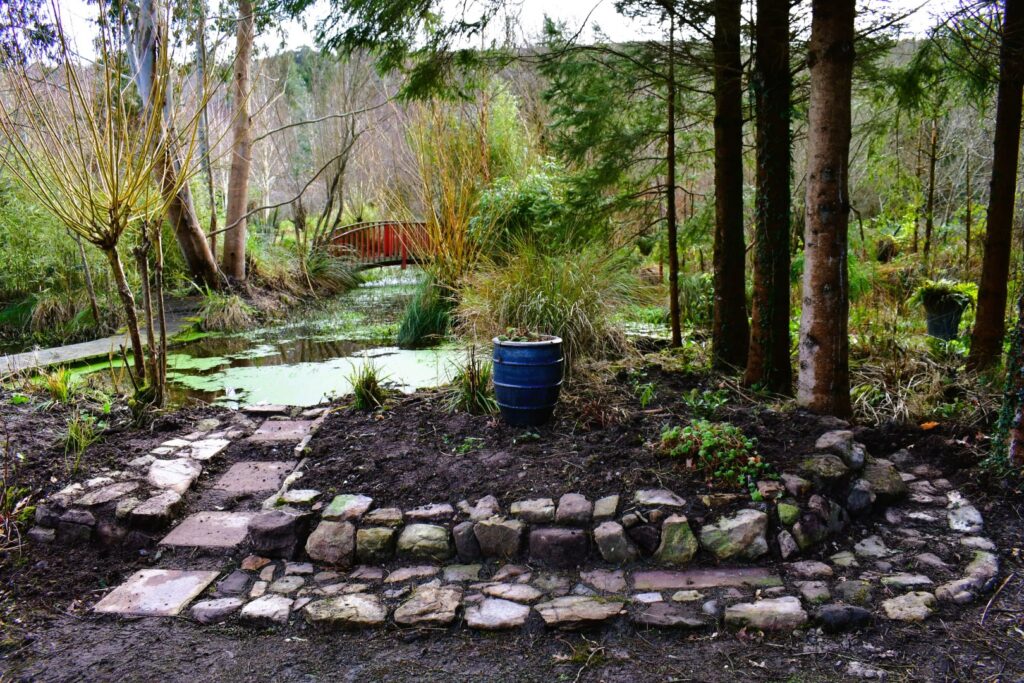
Enthusiasm in the Garden in January
At an all time low and there is little enthusiasm in gardening in January to be honest unless you are in out of the elements in a green house !
Typically I try and get out for at least for 90 minutes each day which then as I get warmed up and realise there is no Guardian Angel to bring me indoors , I lengthen to two hours and my favourite time and one that works for me is to get out of the house at 3 pm and work until it gets dark and apart from feeling virtuous I get quite a bit of work done .
I find the key is to dress up warmly and vary the tasks and keep moving such as like today when I dug up a self seeded young oak and transferred it to the wild area as well as a viburnum that was planted in a pot in a newly cleared area last year but hasen’t done well … then moved down to work on the new area in the Lower Wood where I had some tidy up grouting to do on the rock paths … then on the carrot and a stick basis I felt able to indulge in some reading and TV for the rest of the evening !
February 2024 and Snow Drop time
Early February is snow drop time and for about two weeks we get to enjoy them and I love the flowers as they are the first signs of Spring and each October I buy and plant about a hundred bulbs and while I used to buy the usual supermarket packets, these are tiny bulbs that struggle to survive and for the last few years I buy proper big bulbs in the garden centres that cost a bit more but flower the next year and get bigger every year .
Of course the real snow drop fanatics , galantophiles they are called after the latin name for the flower , will organise bus tours to stately houses where there are huge massed displays of snow drops … some spend huge money on specialist bulbs and these are snow drops that have a little streak of yellow in the petals and two years ago a UK breeder sold a single bulb for 2000 euros , a new variety of snow drop known as Galanthus plicatus or Golden Tears .
No golden tears for me as I prefer the simple white variety and the best way to increase stock is just after flowering to lift and divide an established clump and replant immediately in a process called “ in the green ” and I do this every February and both clumps will thrive and this method is much more reliable than dry bulbs in the Autumn .
There is a larger version of snow drop called snow flake , same flowers basically but a much larger leaf and not as graceful or as daintyas the snow drop but still useful to have and again easy to propagate by just driving a spade through a clump .
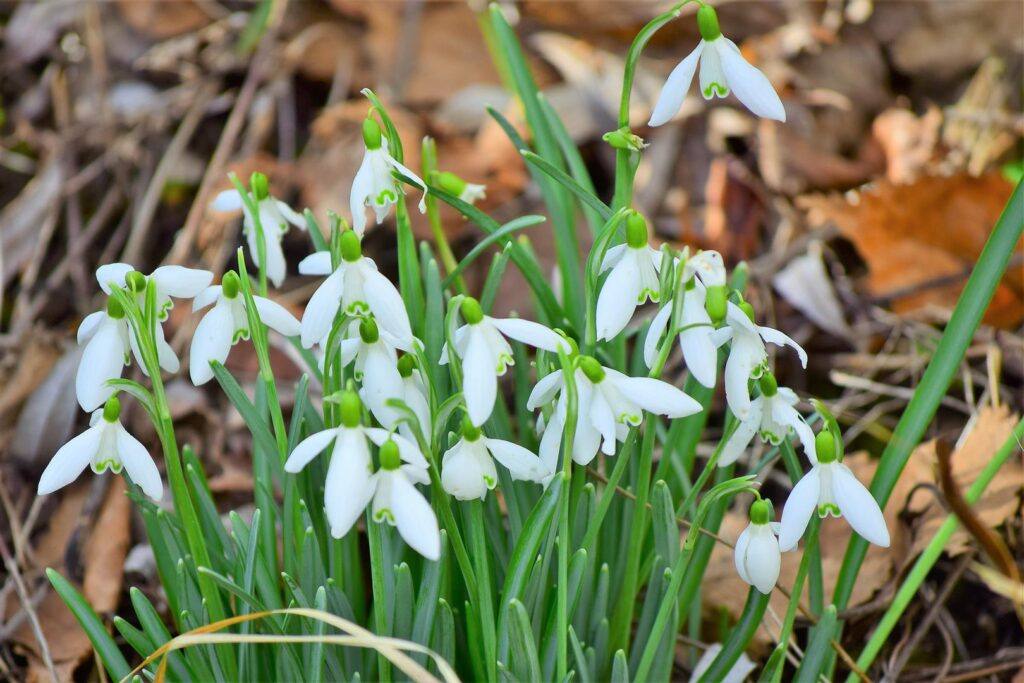
Regular readers will know that while using the common name of trees and shrubs I also add the latin name as what is cotton lavender in Ireland and the UK will be known as something else in other European countries so it makes sense to call it by it’s latin name santolina … using latin names drives Snezana mad as she regards it as the height of pretension and always threatens when asked the name of a plant in the garden to use Uxi Coxi Japonica , the first two letters of the Finnish language coupled with Japonica as she reckons nobody would notice ?!
What’s in a name you may ask but of course if you are from North Macedonia the very use of the word “ Macedonia ” will drive most Greeks mad as the feel they and only they have rights to the word Macedonia while in my own country nationalists always use the words “ the North of Ireland ” instead of the official Northern Ireland as nationalists , myself included , regard the North as part of a united Ireland stolen by slight of hand by the British in 1922 .
Sometimes of course the plant breeders can for market purposes change a name and this happened to me this week when Lynda in Clonmel Garden Centre showed me some bare rooted whips of a shrub not known to me , salix eleagnus it was labelled so I passed on it but later reading up on it at home I saw that it was previously known as salix rosemary , an american prairie willow which is not like other willows in that it likes dry conditions , a gorgeous shrub with beautiful silver grey leaves which has done very well for us here over the past ten years … today I planted ten of this very beautiful shrub .
I had no spot in particular in mind for the salix rosemary and just wandered around with them in the wheel barrow and stuck them in randomly in dry areas that I thought had the space for them to grow and where they would look good in a few years time … proper mindless gardening on a lovely early Spring day !
And recent political news from Northern Ireland
A unique political event occurred in Belfast this month where for the first time in the 100 year history of NI a catholic nationalist was elected First Minister and there is no doubt with this historic step we are heading for a United Ireland within the next twenty years .
The Brits have never allowed a former colony of the British Empire become independent without first either sowing the seeds of civil war or leaving a UK leaning party in place .
The crux of the problem is of course the Protestant Unionist population of Northern Ireland who are direct descendants of the original landlords and settlers who arrived from the UK in the 17th century to take over land illegally seized from the Catholic owners who were then expelled .
I am sure the British Government are sick to death with the situation and would love to exit NI and would welcome Irish Unity but how to do it without being accused by the Unionists , who always support the Conservative Party in British Elections , of abandoning them .
Macedonia 1994 with OSCE
When working in Macedonia in 1994 / 1995 our OSCE role was to monitor and report on breaches of the international sanctions regime imposed on Serbia during the war in Bosnia to stop fuel imports for the Milosovic Belgrade regime which was an impossible task as the entire frontier of Serbia is land based where smuggling was and still is a way of life for hundreds of years with thousands of small lanes and rough trails criss crossing … I am convinced to this day that when two Balkan countries agree a land frontier crossing they also arrange at the same time for unofficial ways to bypass controls .
This photo was taken in November 1994 by a colleague Torben Henriksen on the Kosovo border where the La Jone trail entered Macedonia and which was used daily by smugglers transporting millions of litres a month of fuel on mules .
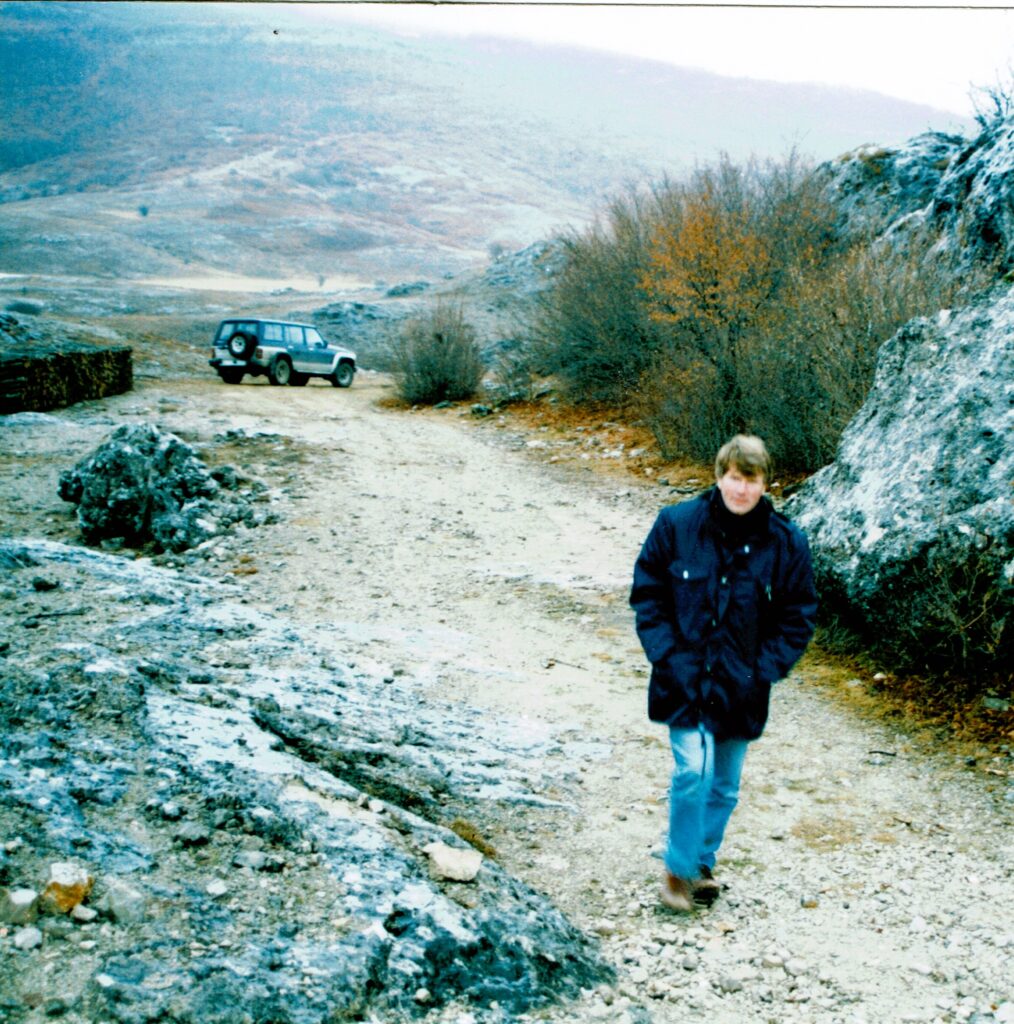
We had discovered and monitored this particular route on a regular basis and had to be careful as the Serbian mobile border control units were aggressive and would like nothing better than to grab a few of us for some in depth “ questioning ” .
I liked to leave the patrol jeep and walk in for about a mile when things were quiet and observe any movements on the Kosovo side … I would only ever take one observer with me on such walk abouts and that was Torben , a Danish Customs officer and tough as nails character … Mission HQ unofficially knew about my little walks across the border but reckoned that while I could talk my way out of any situation , Torben would be able to fight his way out of any dodgy situation … luckily we never had to call on either quality and all we ever met were very friendly Kosovar Muslim mountain village people eager to talk about the Bosnian war and the hard economic situation .
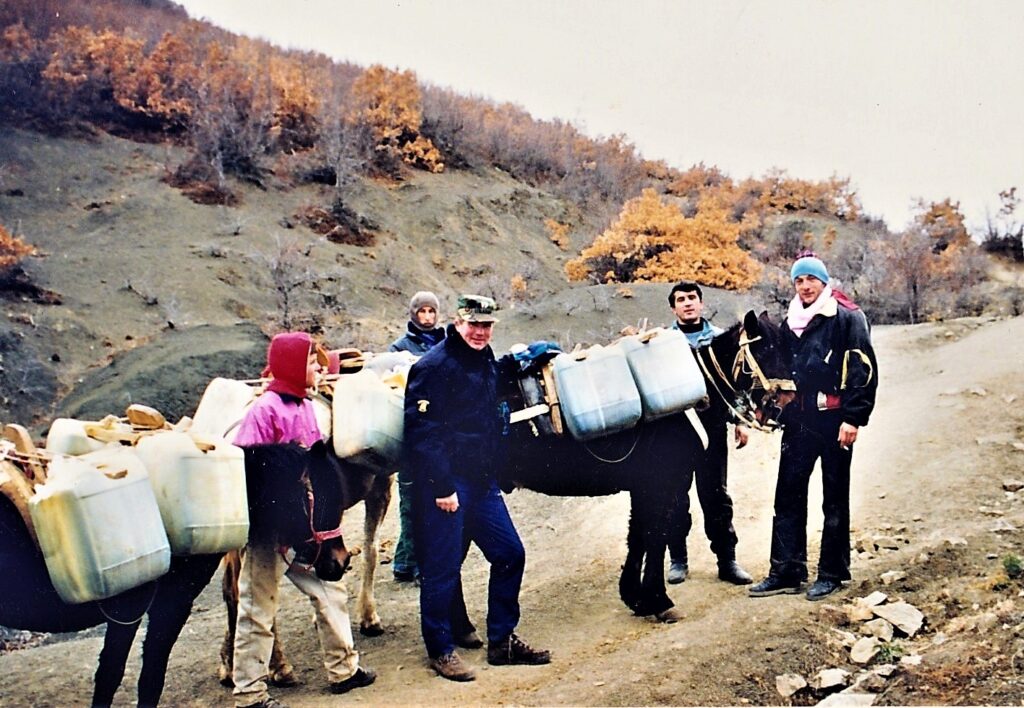
Sadly war was to come for these villages five years later when Serb forces swept through these valleys in April1999 and over a million people were expelled in three months of ethnic cleansing .
A Garden visitor in February 2024

Shay Healy “ What’s another Year ”
I watched a docuementary in February , a rerun actually of a programme RTE broadcast when Shay died earlier last year and I was reminded of a visit he and his Family made here to see the garden back in 2015 and sadly since then both Shay and his wife , Dymphna , have died .

It was early April 2015 and I wrote about it a few weeks later
“ Shay Healy visited the garden with his family a few Sundays ago and wrote about his visit in his weekly column in the Irish Daily Mail under the heading “ Garden shelter from the storms of life ”.

Shay is a legend of Irish show business over the past forty years and wrote the winning song in the Eurovision Song Contest in 1980 with “ What’s another Year ” and his interviews in Nashville with such country stars as Tammy Wynette are available on YouTube . I grew up with Shay Healy on Irish television and in 1990 his TV show , Night Hawks , broke a political story about phone tapping political journalists which brought down the government at the time and precipitated a General Election … so it is fair to say that Shay has been there , done that and it was a real treat to host him here . Shay now is a voice for parkinson’s disease from which he suffers but he is a fighter and does not let it interfere with his zest for life or his enthusiasm for wild gardening and I was delighted at the way he used his description of the garden in his subsequent column in the national press to weave a personal story … and as someone commented to me on reading the story he really caught the spirit of what we have set out to achieve here in the creation of the garden ”.
March 2024
My new hosta population has grown to eleven pots from five at the start of the month and I blame Lynda at Clonmel Garden Centre who has adopted a system that any of last year’s stock of perennials that has overwintered is sold off at a 50% sale price … nothing wrong with the plants but because they don’t have the forced nursery growth of the new stock while last year’s are barely peeping over the soil if at all , people won’t buy them but it is perfect for seasoned gardeners who can increase their stock at bargain prices and today I bought elevan hostas and five variegated iris .
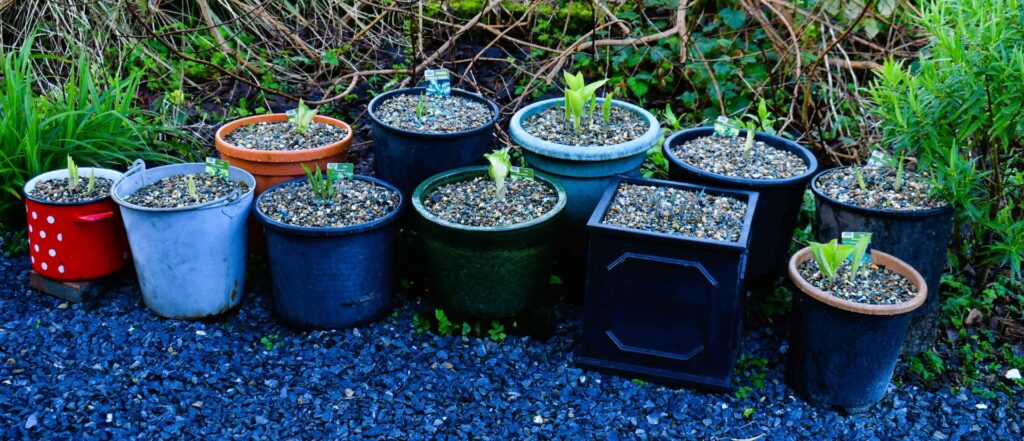
The hostas are all big leafed varieties while the variegated iris are perfect for the new wild garden where the variegated leaf will look great beside the mown grass path .
I have placed the eleven hostas in a semi shaded area of the side garden facing east where they will be in shade from midday on wards and close to the garden hose where I can keep them dampish throughout dry periods of the Summer … mainly in odd and ends pots , fed them with slow release fertiliser , dug in lots of John Innes potting compost and finished off by layering them in pea gravel … some gardeners , the tree hugger types , insist that slugs hate crawling over gravel and that the hostas won’t be eaten however I add the pea gravel because it gives a really nice look to the pot and just to be sure I also layer the base with slug pellets … just to be sure to be sure !!
Every March the gardening tree huggers flood the newspapers with their “ solutions ” to the snails and slugs problem and this is from the UK Daily Mirror this week
“I put vaseline around the rim of the pots (reapply every week) you must check the pot for slugs first otherwise you just trap them in with a great feast,” someone else said. “I also add coffee grounds around the base of the plant and I make a chilli and garlic spray to spray on the leaves…….. I also have beer traps scattered all round the garden. I personally wouldn’t plant hostas in the ground as it’s near impossible to control the slugs. Another added: “I swear by beer traps . They’ve seriously changed my life … no more slugs.””
I am here to tell you people NOTHING works against slugs except the blue pellets and even with those you cannot guarantee that your hostas won’t be eaten into and like most gardeners who has put a lot of effort into growing hostas I am not prepared to serve them up as tasty bites for the slug population !
Wooden furniture is the traditional material for gardens in Ireland and the UK however given our damp weather it is not the longest lasting and even though I paint all of our furniture with two coats every Spring the most you are going to get is twelve years but still nothing beats it for comfort and good looks .
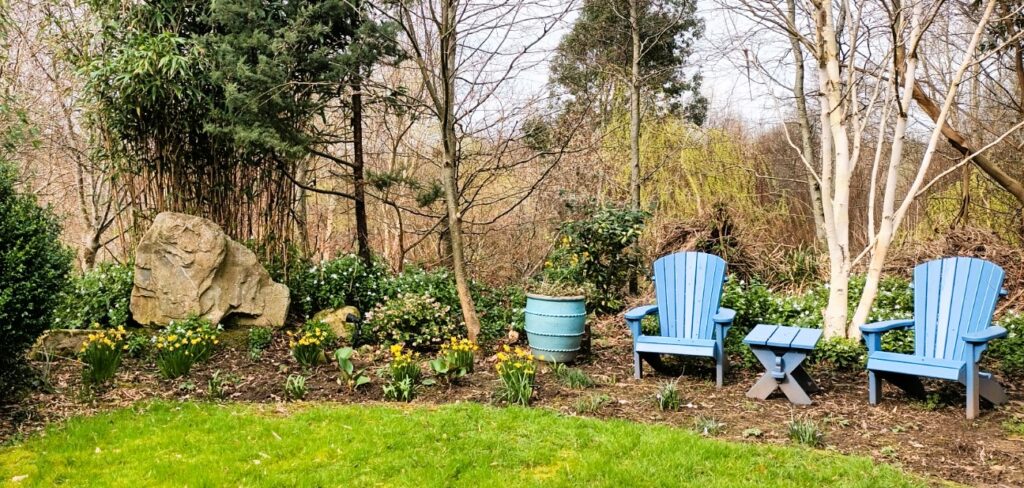
The same goes for wooden decking and we have to replace sections of walkway every year and while we don’t have as many pergolas as furniture they are also starting to decay and last week the very first pergola we built in April 2006 gave up the ghost … in actual fact had given up three years ago but I persisted in patching and propping it up until under constant nagging from the other gardener here it finally went .
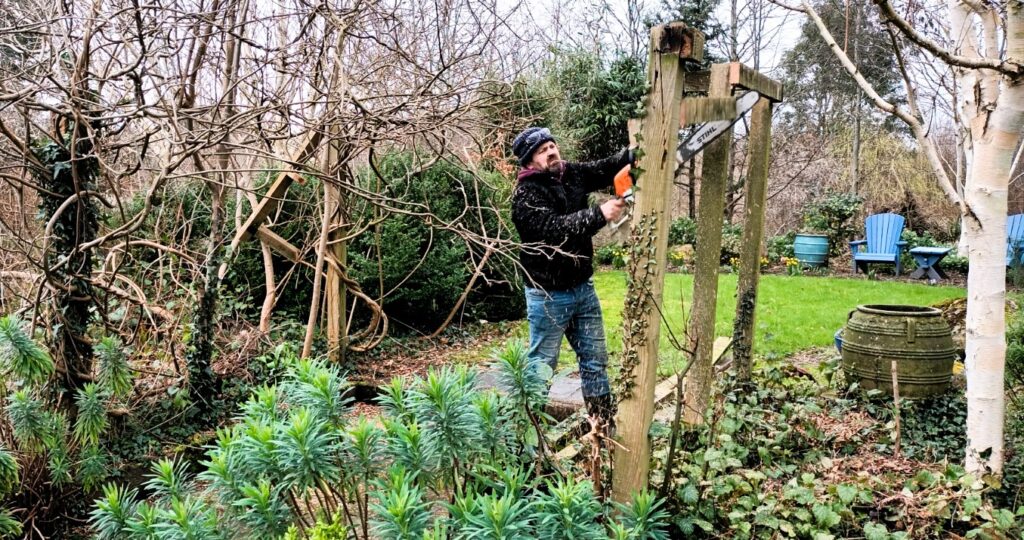
Truth be told this particular pergola was a design I felt was needed for the entry to the back garden in 2006 but that was before the garden grew and took on it’s mature look with it’s draping of wisteria and it really wasen’t needed as a feature and rather than holding up the climbing plants it was actually being held up by the plants… so down it went and after the wisteria has flowered this May I will use the opportunity to give it a huge long overdue cutting back .
The pergola was built in April 2006
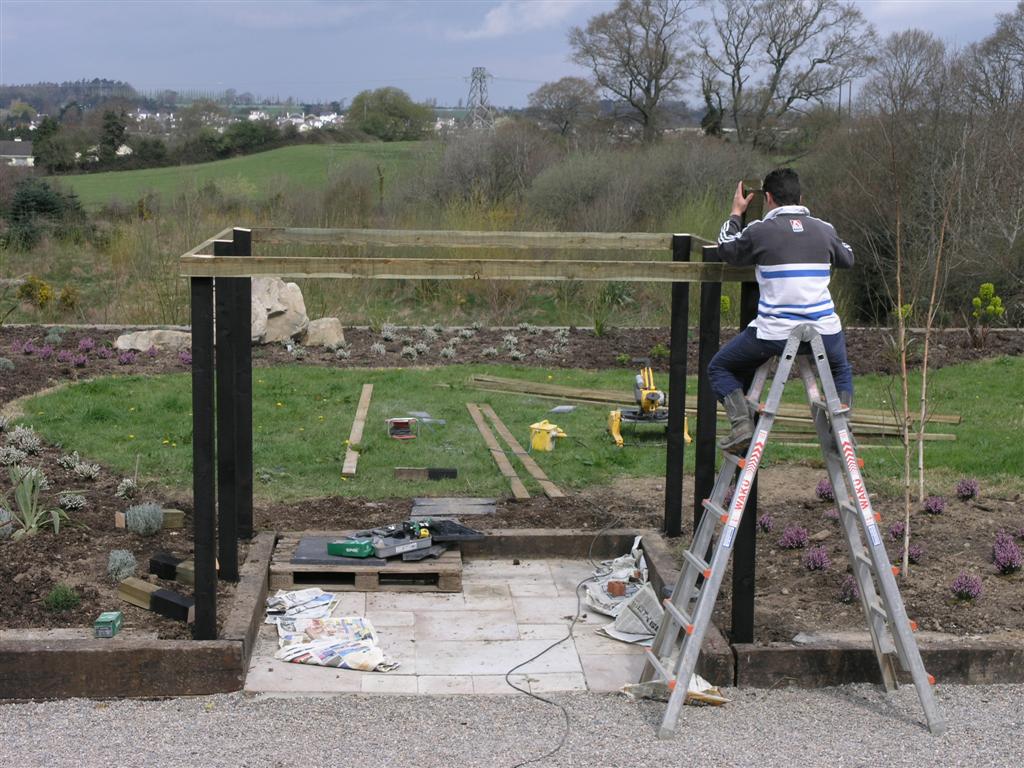
My cousin Pat Reeves took me gently to task for not mentioning crocus in my list of Spring flowers last month and of course being so small and so short in flower the crocus does tend to slip a bit under the radar behind daffodils and snow drops .
Crocus breeders have gone crazy with colours over the years and the flowers have become gaudier and more artificial looking and I had become just as guilty as everyone else in buying the most extreme varieties . However maybe as a sign of maturity I have gone back to simple primary colours with crocus and more and more I plant single blues and my favourite the pure white Jeanne D’Arc . Dead easy to grow , reliable and cheap as chips , there are a million varieties of crocus in the supermarkets every October however Jeanne D’Arc , a heritage crocus , is worth looking out for although a little fussy unlike all the other varieties as it needs the sun to coax it’s flowers to open otherwise in dull rainey weather it will remain stubbornly closed .

Balkan men are a macho bunch and Balkan women are tough cookies also and their DNA of warfare and social upheaval means they have adversary in their background , great people and I have loved living among them .
Macho as the men are they are not afraid to show heart break and I took this photo about twenty years ago in Cavtat on the Croatian coast , … the sign has since been painted over the last time I was in Cavtat and I have often over the years wondered about Nina and whether it worked out for them .
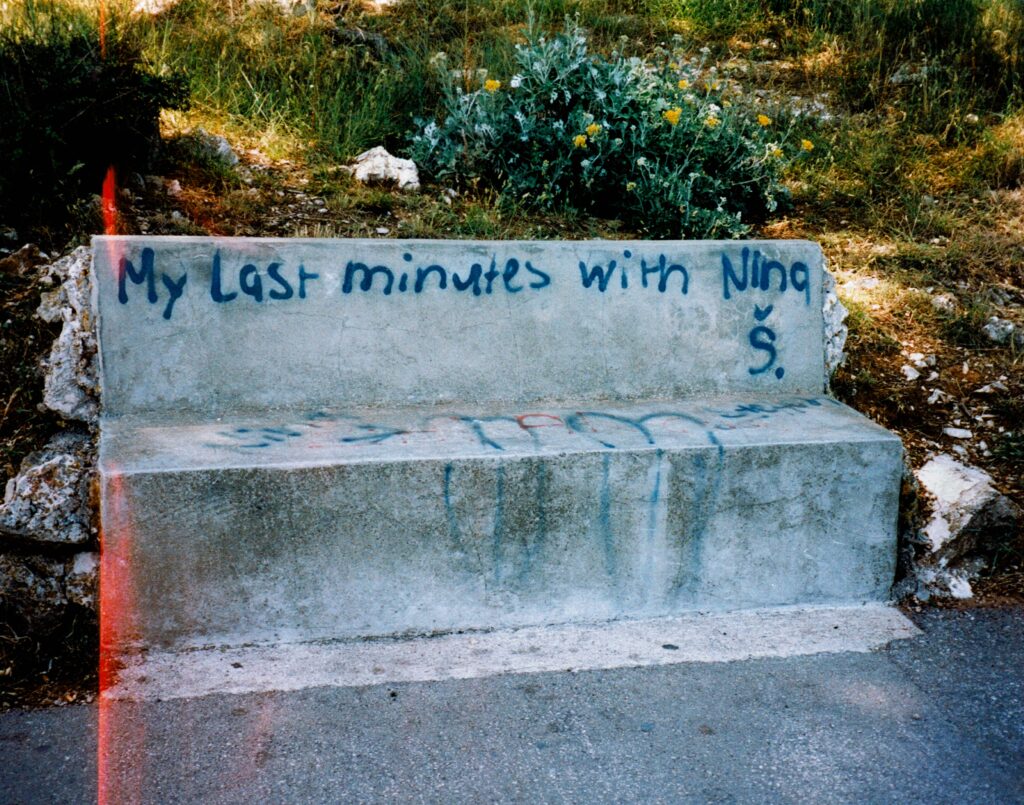
The best wild flowers are in fact the ones you can’t buy and that self seed into areas that suit them and my favourite would be the lesser celandine which has a low earth hugging shape with beautiful green leaves dotted with tiny yellow flowers , a real wild flower that will only thrive where it finds the ideal combination of damp and dappled shade .
In the middle ages it was called pilewort as it was used in the treatment of piles and while William Wordsworth is better known for his love of daffodils as in “I wandered lonely as a cloud ” he also wrote a poem about the humble lesser celendine called
The Small Celandine
There is a flower , the Lesser Celandine
That shrinks like many more from cold and rain
And at the first moment the sun may shine
Bright as the sun itself it is out again !
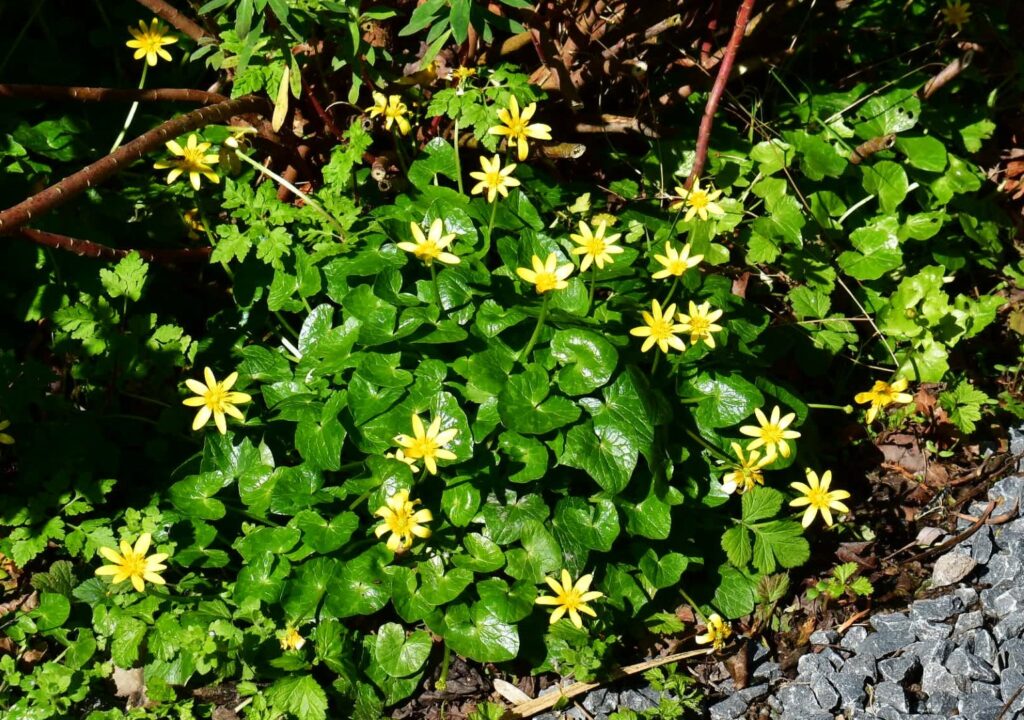
A really welcoming sight in March is when the American lyncestris better known as the American skunk cabbage , throws up it’s show stopping yellow flowers , gorgeous although short lived , a week each at best but followed by huge paddle like leaves that last all summer and which is the reason I grow it .
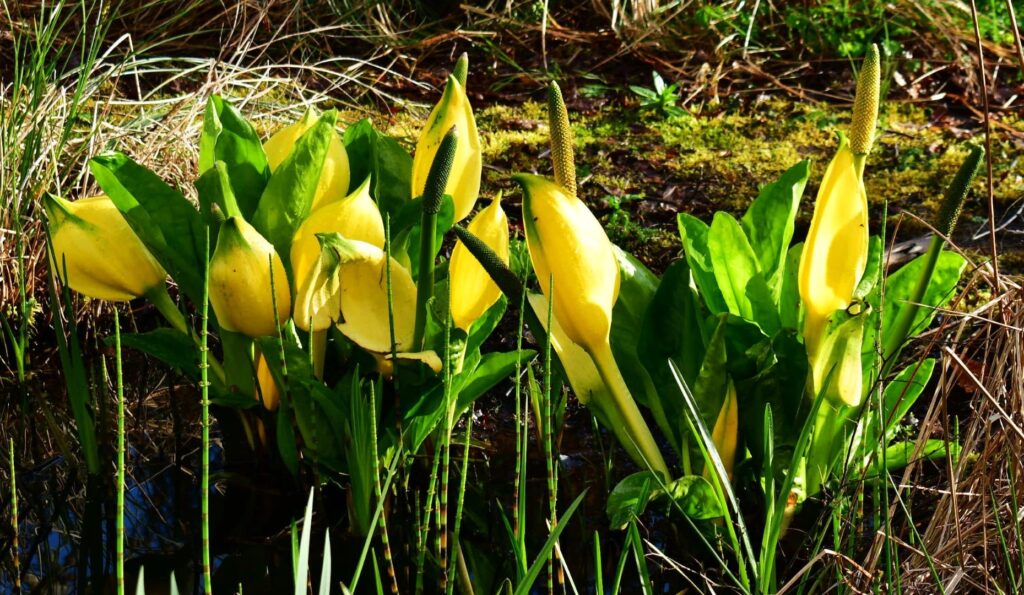
The american skunk cabbage is considered an invasive water plant in the Eastern US where it has colonised rivers and lakes but in Ireland and the UK it is not prolific or a problem . Rarely for sale in garden centres but if you see it grab it , it is a waterside perennial and needs boggy or waterlogged ground with some shade and if it is happy will self seed for you … there is a white flowered variety but the yellow one is a stronger plant with bigger leaves .
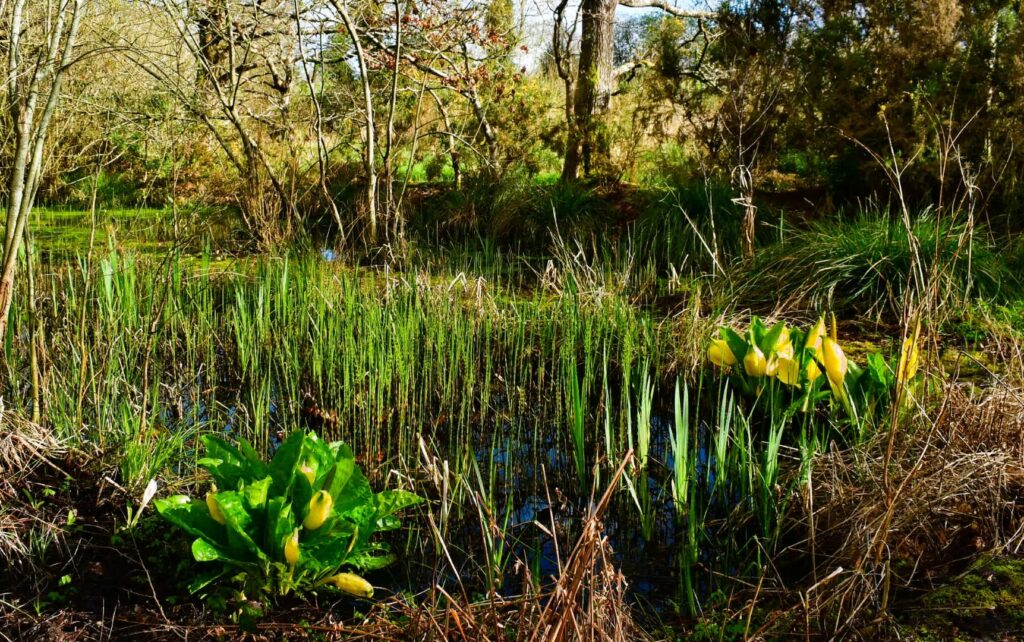
My final favourite wild flower for damp Spring conditions is the marsh marigold or Caltha and this is a real beauty with glossy erect leaves and masses of golden flowers in early March , grows in a tidy clump and never invasive and after flowering you can divide each clump into four or five pieces which you can plant immediately into their final positions where they will easily take and happily grow away until flowering time next March . There is a wild version of marsh marigold which we have in the swamp area but again not invasive or a problem plant .
The marsh marigold would be my favourite go to plant for any waterside area and most garden centres stock them in Spring .
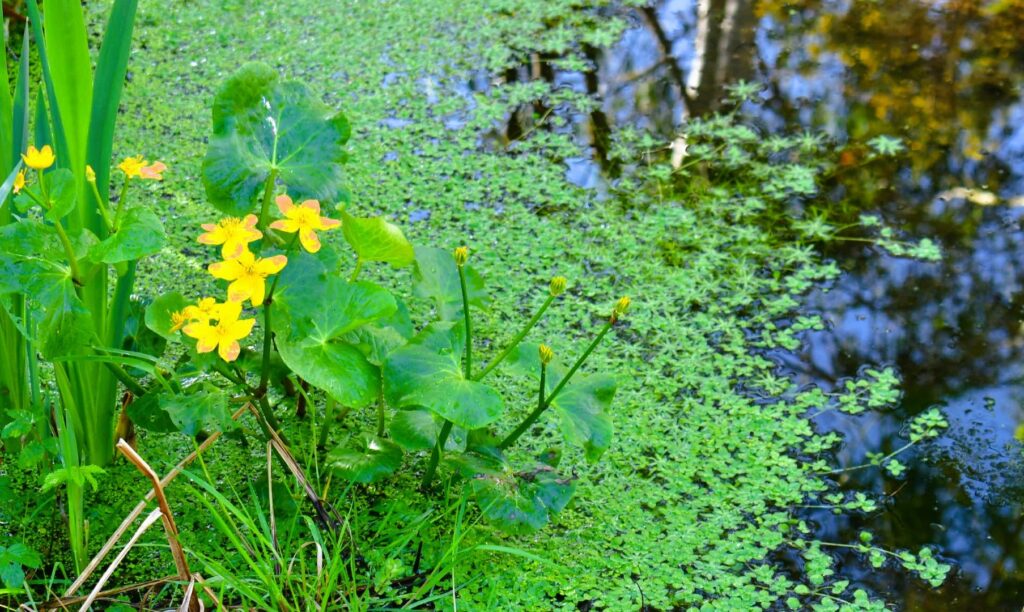
We spent March cutting back the willows in a race before they come into leaf as otherwise it can hurt the tree and we work well together on that project as the other gardener here uses the chain saw and listens to me on where and when to cut but she has a tendency to get carried away when I am not around to check her enthusiasm for cutting down things and this week I came upon a hebe she had gone full Brazilian on … the usual effing and blinding from me ensued and I didn’t do it on purpose from her … drastic measures were called for so I hid the battery on her chain saw for a few days until peace broke out !
We have a large forest area planted with common conifers which are mostly grown for commercial use and it was planted in 1985 before we bought the house in 2001 otherwise I would never plant this type of tree as they cut out the light and have very little plant life .
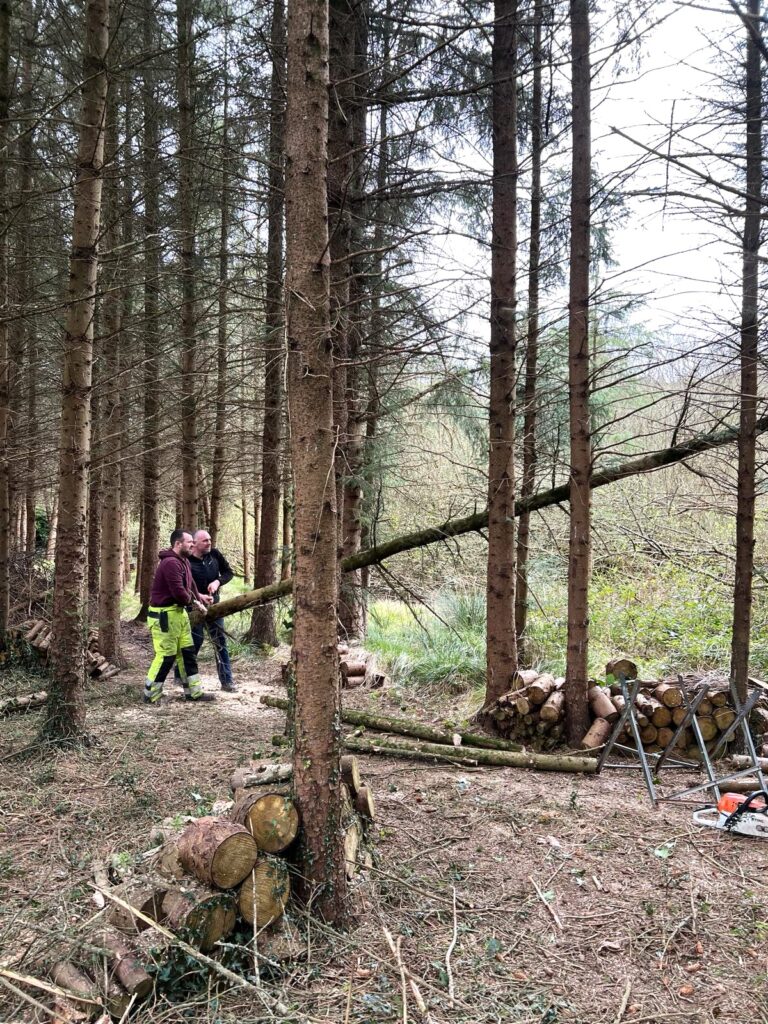
The forest area is managed Snezana who is quite proprietorial about it and every year we arrange to have dead trees cut down and we also thin out too closely planted trees on a regular basis and now the forest is quite open and easy to walk through and as more light comes in there are a lot of self seeding hollies and elder trees creeping in . In March we arranged for John Tierney our regular tree surgeon to cut down thirty five trees over two days which were cut into blocks and harvested into the wood store and as a result we are totally self sufficient with our house wood burning stove … it is exhausting work for a week , hauling and stacking the wood but worth it to have your firewood which is a very satisfying feeling .
I learnt the art of wood stacking in Macedonia and Bosnia and am almost up to their standard now !
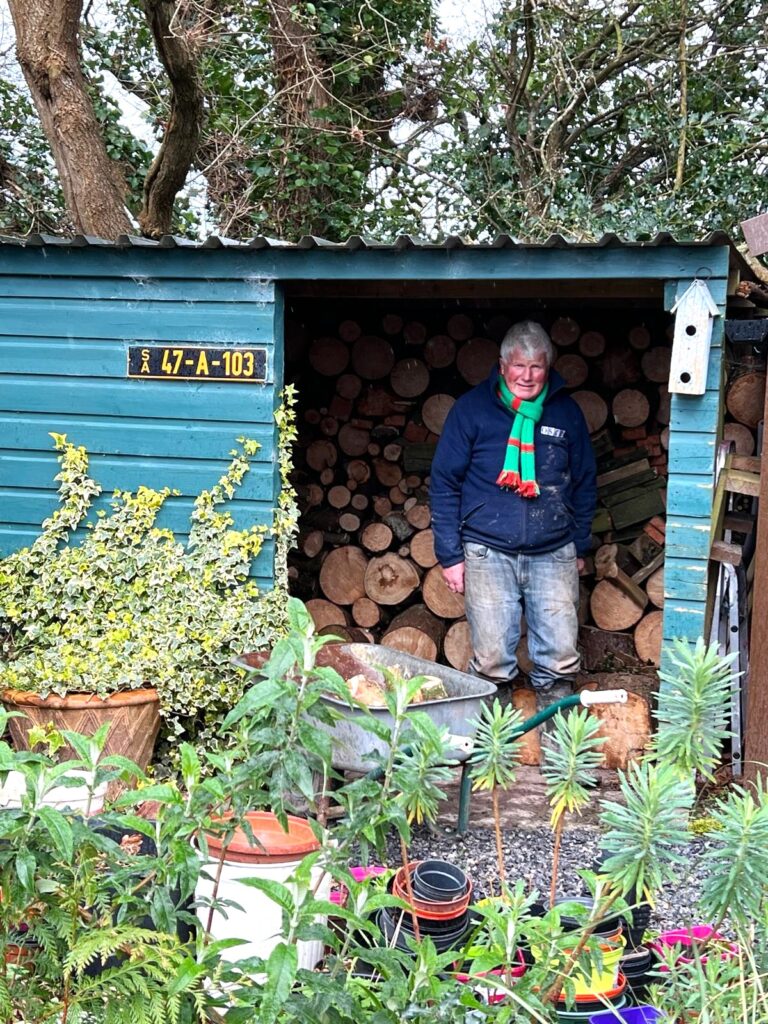
A few years ago I saw a beautiful white flowered plant at the foot of a tree close to our laneway , photographed it and discovered I had seen my first wood anemone . Garden centres don’t stock the wood anemone as it is a genuine wild flower across Ireland and Europe especially in woodlands where it spreads slowly by underground rhizomes but eventually I got a bulb of it and planted it in the front garden under the weeping willow a few years ago… never saw it again until this March when it suddenly appeared in several clumps and I was delighted .
Wood anemones love dappled shade in woodland or under trees that lose their leaves in the winter and this front garden area is perfect for them .
The presence of wood anemones is a sign of ancient woodlands and Google states “If you spot it while you’re out exploring, it could be a sign you’re standing in a rare and special habitat ”.
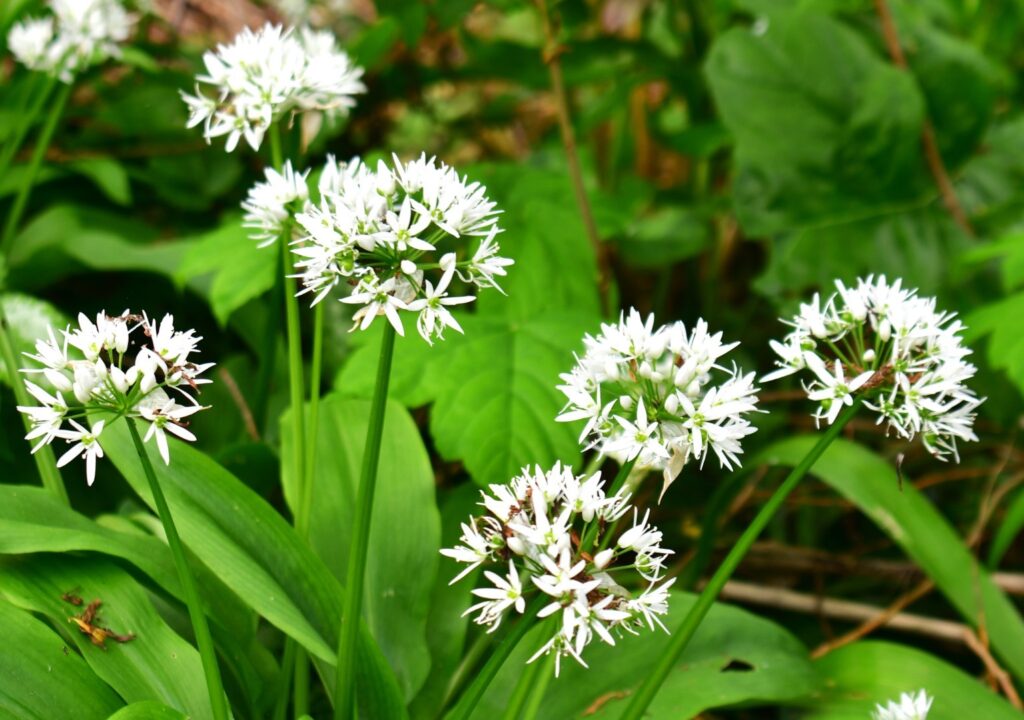
Talk to Clonmel Garden Club on Adriatic Gardening
I gave a talk to the Clonmel Garden Club in March on gardening in Croatia and this extract gives a flavour of my take on gardening in the Adriatic .
“When we as Irish gardeners think about mediterranean gardening we immediately think of lots of sun and no rain of the type we are regularly used to and we assume goody this is going to be great , roll on blue skies every day with loads of lavender , santolina and even the odd olive tree or two .
The reality of Mediterranean or Adriatic gardening is parched stoney soil and plants just managing to survive in the summer heat , lots of weeds and if you want to enjoy the outdoor life in the garden from June to October the three most important words are SHADE SHADE AND SHADE when the temperature is hitting 40 !
It takes experience to get to know the local Adriatic wild flower plants and weeds and while at first they all look fabulous you quickly realise that some are like our Irish docks and thistles with deep tap roots that will take over any empty space unless you get down hands and knees intensively for at least three years to get control of them .
What really thrived for us in Croatia and took the worst of the summer heat were aquaves, yuccas ,santolina , lavender , especially the prostrate ground cover variety, bearded iris’s that love dry heat , cannas and a blue leafed tradescantia pallida …. and these are the back bone of the garden to this day .
Personally I think it is actually easier to have a mediterranean style garden in Ireland that it is actually in the mediterranean !
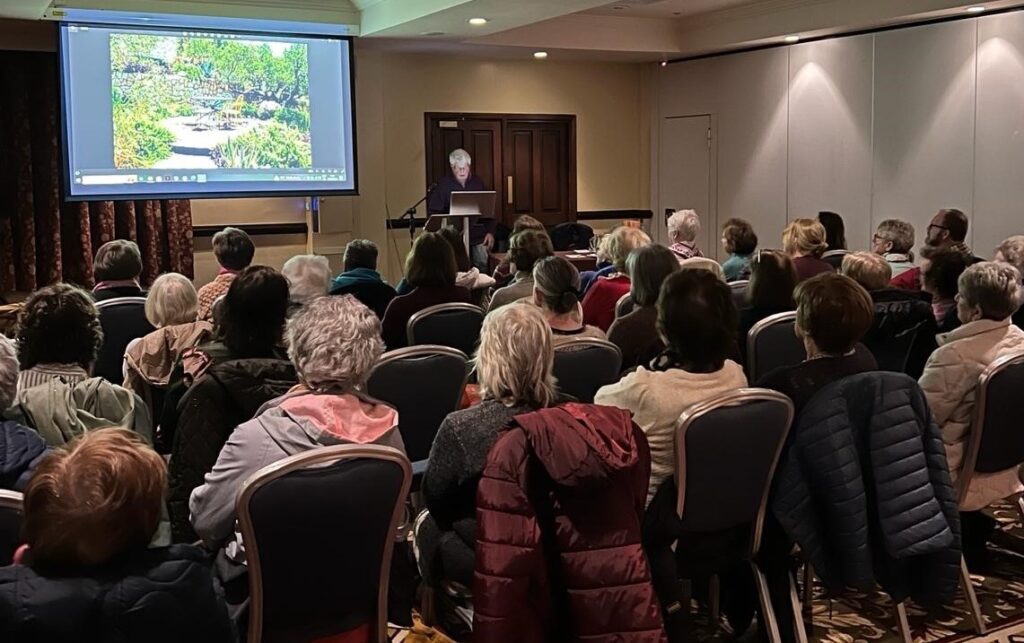
Ferry hopping trip to the Greek Islands
I have been a fan of Greek history from when I was twelve years old and saw Steve Reeves as Hercules in the Regal cinema in Clonmel and I have been a regular visitor since the 1970’s although it took me a while to get used to huge amounts of olive oil on the salads used as I was to only Irish and UK salad cream as a dressing … food in Ireland in the 1960’s and 70’s was quite bland and olive oil was only for sore ears !
My first visit in 1974 was when I drove from Ireland and camped for a month at various places on the mainland and I went back on a regular basis over the years but apart from a few weeks back packing around Crete I never went to the islands aside from day trips to Hydra and Spetsae and I always hankered after a proper ferry hopping trip through the Greek islands especially the Cyclades .
I put it off for so long that it became a bucket list dream but a few weeks ago in April I released the inner hippy and finally went Greek island hopping … a more stately progress than if I had done it in the 1970’s !
We travelled to the Cycladic islands of Santorini , Naxos ,Mykonos , Delos and ended up with a few days in Athens … Santorini , is a freak of nature standing on the edge of a volcano 18 Km. long while Naxos is the largest of the Cycladic islands with a terrific interior of mountains and deep valleys and very green and of course Mykonos has a reputation as the party island supreme .
Tourist boards everywhere exaggerate about their attractions but the Greek Tourist Board doesen’t lie in their description of Santorini “The crescent-shaped Caldera of Santorini is the biggest gem in the Aegean and one of the most impressive places to visit in the world !”
On Santorini we walked the classic 15 Km . caldera ridge walk from the villages of Thera to Oia , a thousand feet high with the sea in view the length of the entire walk , a hard slog and not just in a straight line but a series of ascents and descents with hundreds of steps up and down .
We saw the instagrammers famous sunset from Oia … this being April there were only a few hundred other people trying to get the classic photo whereas in Summer there can be up to ten thousand people queuing for it … for me what makes a Greek subset special is the Aegean sea , the blue domed churches and the white washed houses, spectacular of course but the sunsets over the islands of Hvar and Brac on the Dalmatian coast are equally nice .
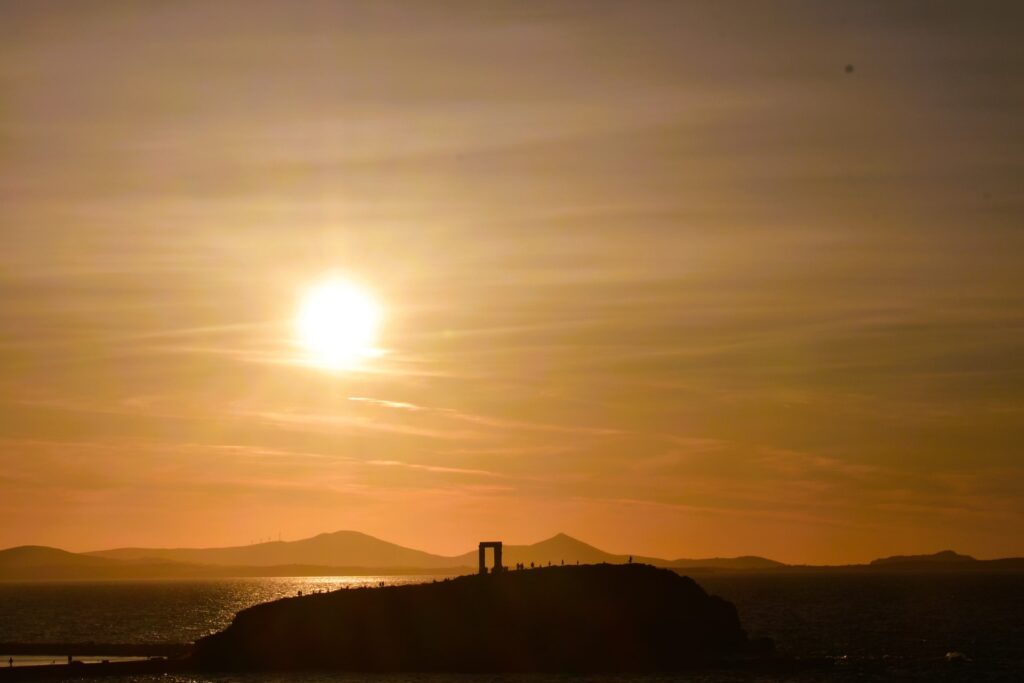
Mykonos was for me a revelation as I knew there had and are problems there with developers of beach resorts building illegally but the town itself is beautiful and not over built at all ( unlike Santorini ) and it was the prettiest of the three islands .
We ended up in Athens for four days at the end of the trip after a six hour ferry journey from Mykonos where we sat up on deck and watched a never ending line of Cycladic islands stream by .

Naturally being in Greece there were archaeological sites to visit almost every day and new one to me was the island of Delos , birth place of Apollo , the Minoan site of Akroteri on Santorini , the huge fallen statues known as Kouros on Naxos while in Athens we walked the entire circuit around the foot of the Acropolis and on another day walked through the ancient Athenian Agora and spent a morning in the Museum of Cycladic Art .
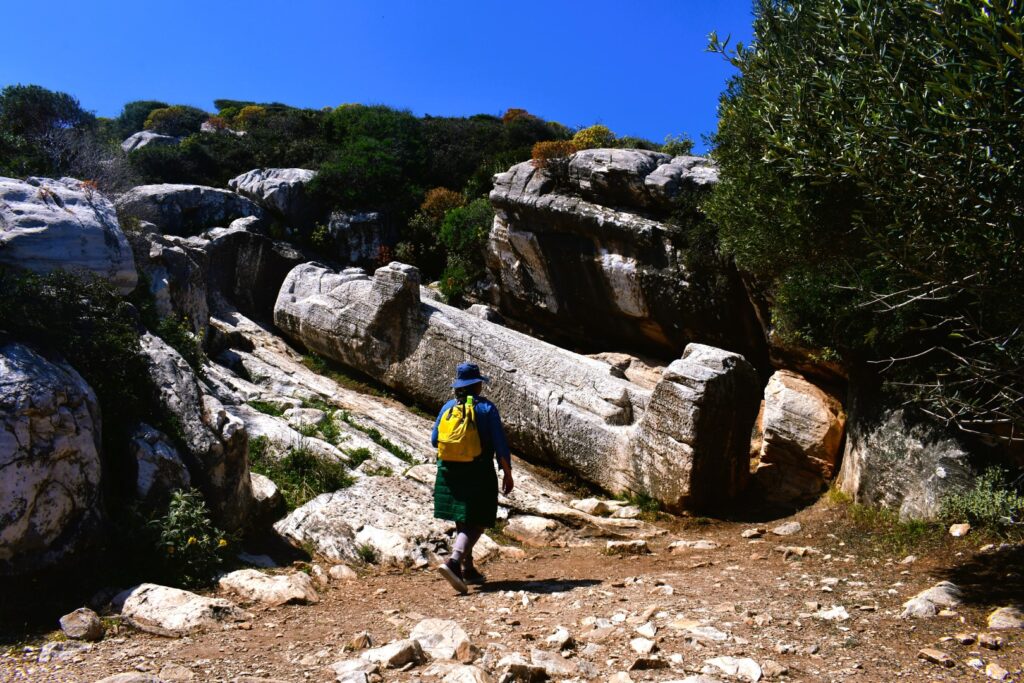
Normally when in Athens the Acropolis beckons and you forget everything in the rush to climb up and see the Parthenon and I fall into this trap every time even though this year I said no we will spend time walking around the Agora but still wandering along the base of the Acropolis when I saw the entrance to the Acropolis I couldn’t resist and up we went again .
But when I look back at my photographs it was the Agora where we spent an entire afternoon that I took the most photos of … every important religious event in Athens in ancient times was preceeded by a procession through the Agora and along the Sacred Way to the Acropolis and I really got to explore it all this trip for the first time in numerous visits over the years .

There was also fabulous Greek food and lots of feta consumed !



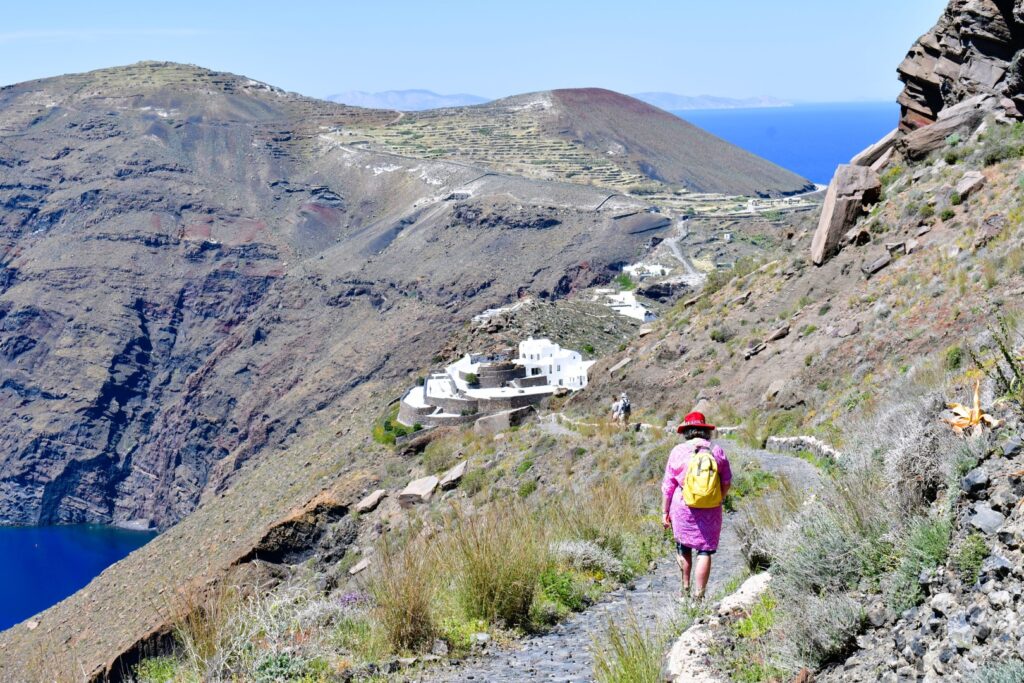
Late April planting
Such a pleasure to be in the garden these days rather than two months ago and this past week I have been planting out summer bedding annuals such as allysum , lobelia , nasturtium for ground cover clumps and antirrhinums , the old fashioned snap dragons , for some height .
You might think that as ours is a wildish garden and not at all formal that there would be no place for bedding annuals but I find them great as fillers and front of border plants that flower away for over four months with no attention and I particularly love the informality of the nasturtiums as they sprawl luxuriantly across the beds .
As gardeners we are creating an illusion of nature and if the planting area is suitable nature will move in an lend a hand . The woodland are in the back garden that Snezana set out to tame last year is coming along nicely and the spring bulbs have died back and now the ground cover geraniums are thickening up and blending in well with the clumps of vinca that were partially cleared last year and while I won’t allow the vinca to take over it is a handy filler until the newly planted ferns thicken up … it is a cottage garden / woodland look we are going for around the seating area and this week I potted up an extra ten geranium slips that will go in to their final position in about eight weeks time .
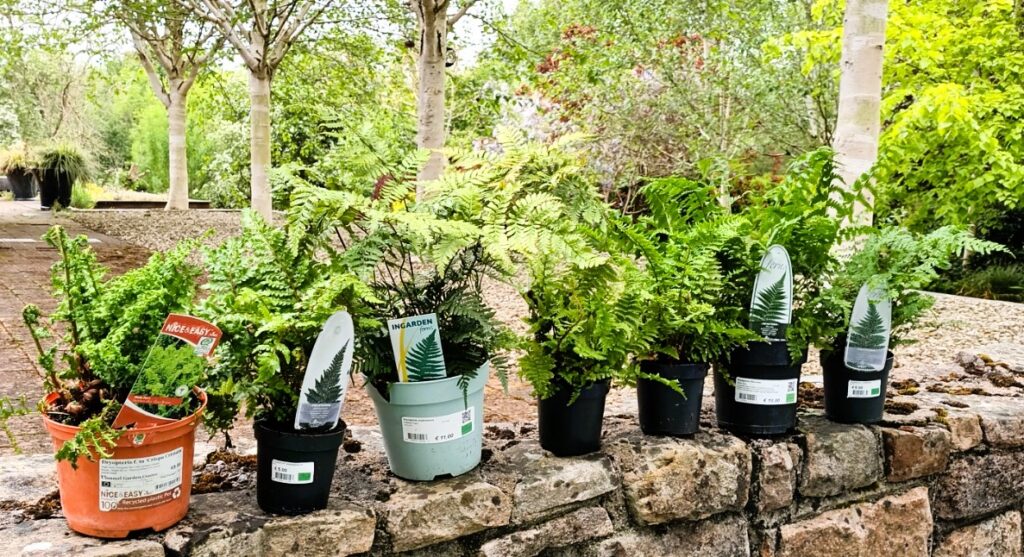
The deer of course are moving around sniffing out any delicacies but apart from a hosta in a pot have largely been disappointed as at this stage I know what plants are on their hit list !
Unsung heroes of the garden are the ferns which do their thing quietly in the background from year to year and there is a fern for all conditions be it sun , shade , dry or wet ground . Generally ferns like dryish soil and shade suits them which is why they are perfect for out of the way shady corners .
Lynda at Clonmel Garden Centre has built up a nice little shady corner for ferns and she has stocked it with various types and more importantly keeps it well stocked all year round and in the past week I have bought over fifteen ferns for Snezana’s new area … another plus is that the deer don’t go near ferns .
Here at Old Spa Road this past four months it was far from Spanish style more like aquatic style gardening but as we move into May we have better days to look forward to !
April in the Bog Garden
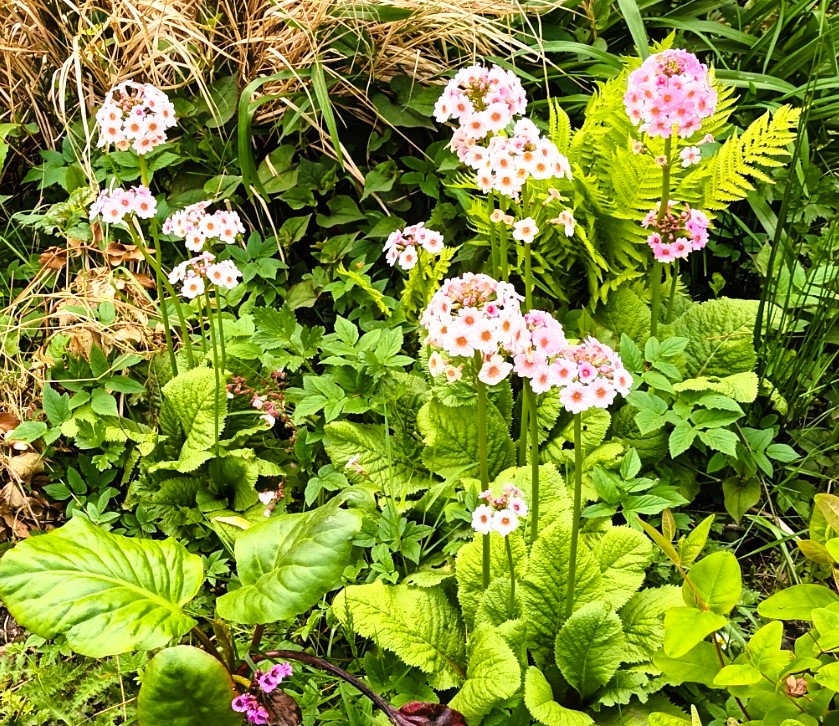
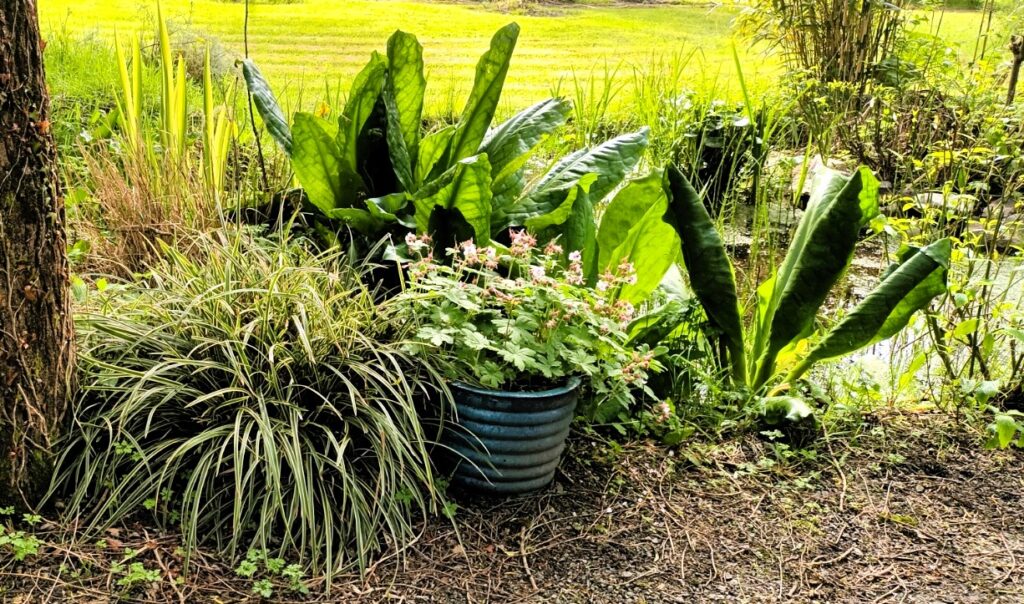
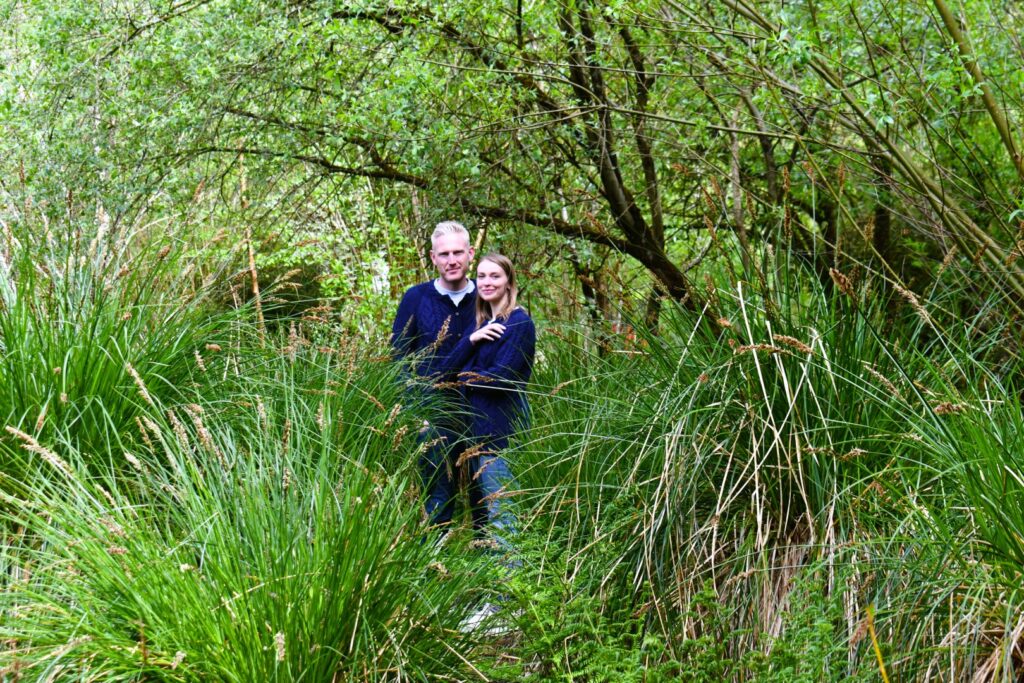
May in the Garden
I am always amazed with the sheer lushness of Irish gardens in May and no place else in the world can beat us for that and yes there is a price to pay with some rain every day and I was particularly struck a few days ago walking into the garden here after a few weeks in Croatia with the stony terrain and heat there … the greenness jumped at me and we are lucky to have this climate … ask me though in January ?!
Wildness or I should say “ controlled wildness ” is our mantra in the garden here at Old Spa Road but it can be a delicate balance to maintain and as Dolly Parton famously said “ to look this trashy takes a lot of work ” !
Sometimes self seeded plants can either enhance or can look like a demented jumble sale as this pot on the back patio shows where self seeded erigeron and the wild geranium Herb Robert , geranium robertianum , combine to almost blot out the box ball planted in the pot … this geranium is a prolific self seeder and is nowadays considered an invasive weed but it is hugely medicinal as it helps wounds to heal , is also good against insects if rubbed into the skin while the internet will tell you “Herb Robert boosts the immune system by making more oxygen available to the body. This also can help in cases of fatigue and chronic illness by boosting energy levels. It can be used externally as a poultice to staunch bleeding and aid the healing process ”.
I have mixed feelings about Herb Robert in the garden and while I love it when in flower with it’s beautiful delicate blue flowers I also tend to remove it generally as it does get a bit invasive .

I saw recently an advertisement for the sale of berginias which said that the popular perrenial could be an alternative to hostas , in effect the new hostas and while my initial rection was no , never and then I began to think about all the effort that goes into hostas , the battle with snails and slugs and in our case here with deer eating hostas like caviar … could there be something in this ?
I love hostas and they are my absolute favourite perennial in the garden , real show stoppers when in their best conditions which is fairly moist soil and in partial shade . You grow hostas for their leaf , the flowers are nothing special and they will display from April to October … but there is one huge drawback to growing hostas … SNAILS AND SLUGS … you can put down all sorts of preventive measures from garlic , broken glass , pebbles to dancing naked in the moonlight … or go full nuclear and use slug tox which kills them dead … but the slugs will always manage to get through and hostas are like caviar to the buggers .
I don’t grow hostas in the open ground anymore due to the deer that are regular visitors to the take away they regard our garden as and you do have to ask yourself are hostas worth the effort .

Bergenias are trouble free , tough as old boots tolerating all soil conditions . nothing eats them and they retain their leaves all year round , easy to propagate ( just snap off and pot up a leaf with a bit of root between November to May ) and they look good … not as good as hostas but I rate bergenias as one of the planting go to’s in the garden .
Hostas versus Bergenias … I wouldn’t choose even though I now limit hostas to pots and I wouldn’t be without either in the garden .

We have water hens in the water areas throughout garden where they have loads of water ways and lots of cover on the banks to hide as they are a shy little bird that stays away from people unlike the winter ducks here that strut their stuff like models … we hear the water hen rather than see them as they cluck cluck loudly when you are approaching .
Snezana was cleaning out some heavy cress and valerian from the island area this week and heard a water hen giving out like mad and luckily she just stopped short of taking out a nest in the middle of the water neatly woven into the tall cress … we will enjoy watching that water hen parading her chicks in a few weeks !

As I get older I constantly ask myself where does time go and when I was younger , ten , twenty years took an age and seemed so long but now the years fly and I was reminded of this earlier in the month when when youngest son , Diarm , ( young … he is now forty one ! ) captained a plane flying from Senegal to Medina with Muslim pilgrims on the Hadj and took a photo passing over the pyramids in Egypt … great photo but it reminded me when I took him to the pyramids in 2000 when he was seventeen … where indeed does the time go !

February 2000

June 2024
The area in the Lower Wood with the new water way has heavy soil and luckily the weeds are of the wild flower variety apart from some spectacular thistles and I generally leave it to it’s own devices but once a year every June or July I give it an intensive weeding and thinning out by hand and take my time with it .
It is a difficult area to garden as the soil is a mix of concrete like clay and what grows best here are rushes which in their place can be sculptural but here there are too many of them and I take them out in barrow fulls .

It takes me about four days weeding each year in June for this area and I leave it to it’s own devices for the rest of the year having removed the nettles and rushes … the deer are always around this area and over the past two years have eaten three newly planted silver birch jacquemontii but I notice after a year these specimen birches are now sprouting from the roots and the deer leave these “ second comings ” alone but the tree that grows back is the common irish birch from the original grafted rootstock not the expensive jacquemontii I planted but still a nice birch and I will take that .

A shrub that is in full bloom from now until the end of August is the Hypericum and again like the Bergenia a great performer in most locations although it flowers best in full sun . Hypericum is usually sold in it’s compact form known as Hypericum Hidcote but I find that in time all varieties will grow to five feet and it responds to a good hard pruning in spring in fact hypericum needs a hard cut back to keep it from getting leggy .

The shrub pops up all throughout the garden here with the seeds carried by the birds from it’s berries and it a prolific self seeder … I generally let it grow on in it’s chosen spot but I also regularly pot up seedlings and transplant them around the garden with the result that we now have mature bushes of hypericum throughout the garden … a must for every garden with evergreen olive green leaves topped with a huge amount of flowers in the summer .

The garden trend all over Ireland and the UK for the past few years is wild gardening and while I resisted it for a long while thinking it was just lazy gardening as in don’t mow the lawn , I am beginning to warm to it in wet areas and three years ago I allowed an area to go wild just cutting pathways through the long grass … the area is too wet to be a true wild garden as for this you need impoverished dry soil but over the three winters I have planted gunnera , iris’s and native silver birch whips and the overall effect is coming along nicely to a good look where nothing else really worked .

Snezana and I rarely work together in the garden as from experience it always ends badly … I know the essential jobs that need to be done and am accused of being a dictator if I insist that these be done to a schedule on a regular basis whereas she likes to be a free spirit about gardening chores … the result is that Snezana does her own thing in the garden and only works on stuff she enjoys however there are joint projects that work well and this week we combined to work on an overgrown parrotia tree area and clearance of patio of invasive pampas in the Lower Wood area .
A lot of work involved which to be honest would not have happened without Snezana’s vision as I tend to be taken up with the level of daily maintenance needed for a garden of eight acres whereas she saw that the lovely parrotia tree had been overwhelmed by the growth around it , didn’t have room to sprawl while the patio was almost taken over by huge self seeded pampas grass recardii .
The summer flowering pampas grass variety richardii is a favourite architectural plant of mine and difficult to source but it is hugely invasive in our garden something I was really pleased about until I realised it would grow in your ear as they say in the west of Ireland . It was introduced to the UK in the 1980’s and is a native of New Zeland’s South Island where it’s Maori name is Toe – Toe pronounced Toy Toy , it suckers like mad and has already become invasive here and it really lives up to the phrase be careful what you wish for because when I first got it we couldn’t get enough of it and potted it up enthusiastically and giving it away as gifts to other gardening friends … please forgive us !!

It was a horrible job digging out the richardii real crow bar stuff which amounted to elder abuse on my part but out it came and we will be careful in future where richardii self seeds and tackle it early on … that said I still love the plant , it is very graceful and elegant in the right place and where you choose the spot .

July 2024
Right plant right place is a famous gardening mantra and one we all try to follow but sometimes the plant likes the place so much that it outgrows and dominates the area and such was the case for me with a pittosporum I planted as one of the first choices in the original small garden in Gornja Podgora twenty years ago .
The pittosporum never stopped growing and topped out at over four metres high and three metres wide , a solid block of leaf from top to bottom totally dwarfing and out of proportion to the small garden .

I knew sooner or later it needed to be either hard pruned to two metres or removed entirely neither of which I could bring myself to do so it drifted along for the past five years but last week looking at the tree the solution came to me … cloud prune it to five or six strong branches and take out all the lower branches and it has now transformed the small area letting light in and giving a Japanese look to that area … delighted !!

The No – Mow lawn debate has been going on for the past few years and one of it’s biggest supporters was Monty Don , presenter of Gardener’s World on BBC 2 and now even Co. Councils are getting into the act and letting grass verges grow long to the degree that you don’t know is it just untidiness or deliberate policy to let grass go wild .
I have never been a fan and have always thought it was just for lazy gardeners who can’t be bothered to get the mower out on a regular basis and who then pretend they are letting the grass grow wild for the planet .
I do see a place for wild gardening in certain areas and with paths cut through it can look really good and we have done it here in a few areas in the garden at Old Spa Road but always under control … mind you we don’t get many wild flowers in the long grass as the soil is damp and too lush .

This week however in a lead article in the London Telegraph Monty Don has decided to cut his lawns again admitting that this highlights the planting and makes smaller areas look bigger … it will be interesting to see if this is the start of a new movement away from rewilding now that Monty has spoken !

Shirley Lannigan , the Irish Gardening writer , has reissued and in most part rewritten her book The Open Gardens of Ireland first published seven years ago and invited us to the Dublin and Kilkenny launch in early June . Shirley had asked if we would allow our garden to be included again in the new edition and visited us here last year and walked the garden to see what we had done in recent years and in her opening remarks in the new book on Petrovska Garden she wrote “ I always thought of it as a wild garden but when I visited recently Snezana Petrovska said “basically it’s become wilder ” .
I worked with Aleksandra Radjenovic in Bosnia twenty two years ago when I was stationed in Brcko with the EU until Aleks emigrated to Canada in 2002 … we kept in contact over the years and last month Aleks visited Ireland with her family and we gave them a tour of the garden during their visit here .

Aleks was a Serb from Vukovar and married her childhood sweetheart , Dejan , a Croat from Osijk . Barbaric things happened during the war in Croatia but their relationship thrived despite both being from opposite sides and it was not easy for either of them but Canada offered a safe haven to build a new life with their two daughters , Emilija and Nathalie and it was a pleasure to see them .
Twenty two years , where did the time go … friendship endures but as I wrote after their visit “ apart from the colour of my hair not a lot has changed Aleks … and the odd pain here and there … shortness of breath now and then … frequency to pee … otherwise we were back in old times in Brcko today !”.
A shrub I love is the castor oil plant , fatsia japonica , which is usually sold as an indoor plant but which does well outdoors in Ireland and we have several specimens that are almost two metres tall . Originally from Japan and Korea woodland areas it has a beautiful architectural shape , large evergreen leaves but you need to be careful where it is sited as it can be tender enough and I find that a sheltered shady dry location deep among mature trees and shrubs suits best … extreme frost can burn off a few top leaves but if you keep it out of wind the castor oil plant is a stunner throughout the year and brings a whiff of exoticism to the garden .

When buying a castor oil plant in the garden centres make sure to pick one that is displayed outdoors and not one from their indoor section as it will survive better in it’s first few months outdoors in the garden … there is a variegated version also sold with speckled white leaves which looks nice but is not hardy outdoors … there is a variegated version also sold with speckled white leaves which looks nice but is not hardy outdoors .
August 2024
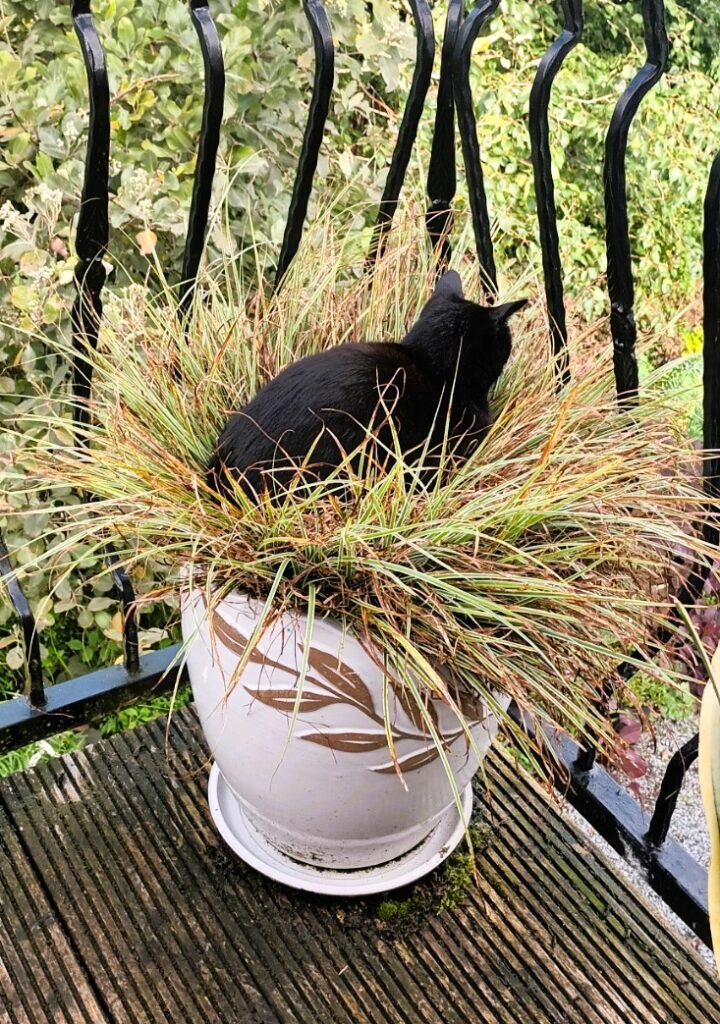
Our cat , Tutti Frutti , goes everywhere with us in the garden , she is Snezana’s cat and they have a special relationship but in the garden she stays always with me and probably thinks she is my protector out there against all those wild animals in the woods !
Of course like all cats she is a hunter and will take any bird or mouse that crosses her path and while we don’t begrudge her any amount of mice it is very upsetting to see her take a bird and normally by the time you can get to the bird it is too late … not today though as I was just in time to recue a small water hen duckling as she ran past me with it in her mouth … took three attempts to get her to let go but in the end the duckling ran free back to her mother who was clucking away furiously in the water … amazing to see how the duckling once caught went totally limp and then sprang into life as soon as she got free … to all intents dead in the cat’s mouth then once the grip was loosened as that cat was distracted by me the little duckling legged it into the water .
Visitors to the Garden in August
We had a visit to the garden in August from the Limerick branch of the University of the Third Age , a self help organisation that caters mainly for the retired age bracket and organises lectures , garden tours etc. for it’s members .
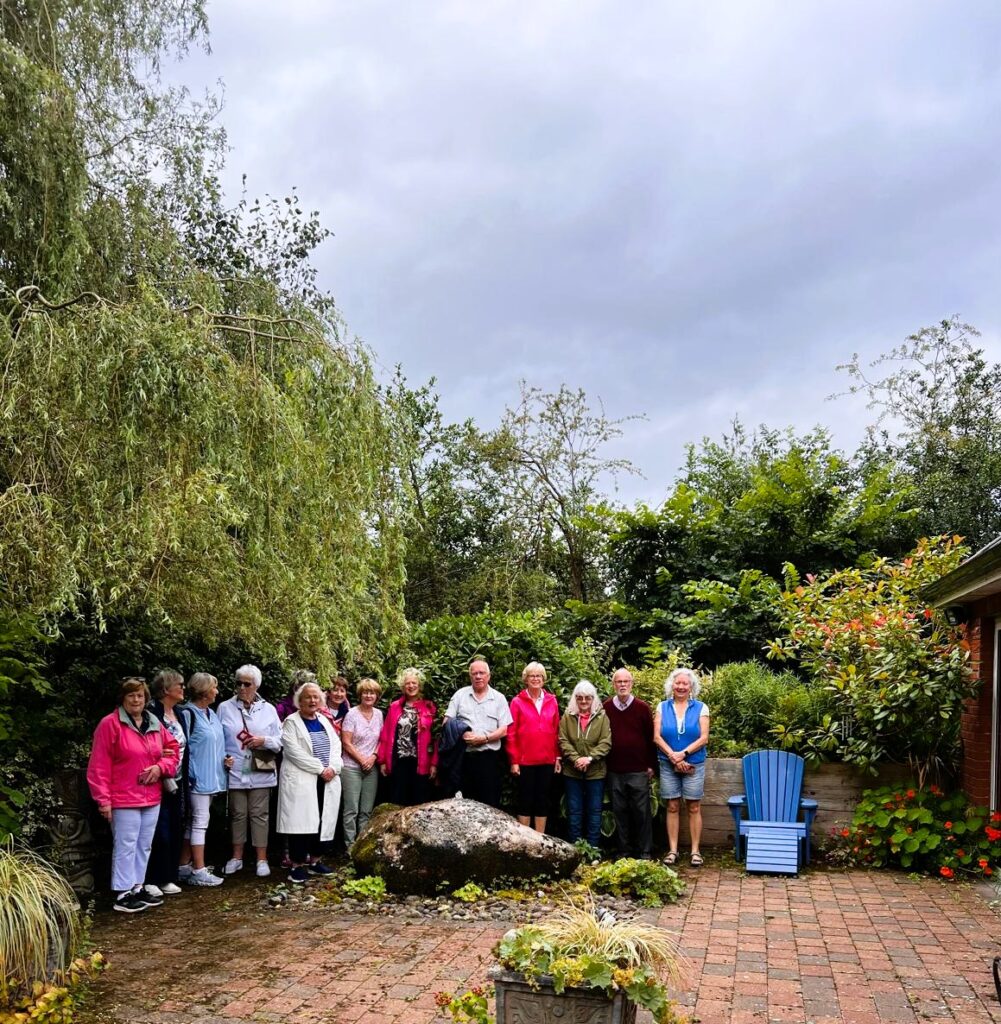
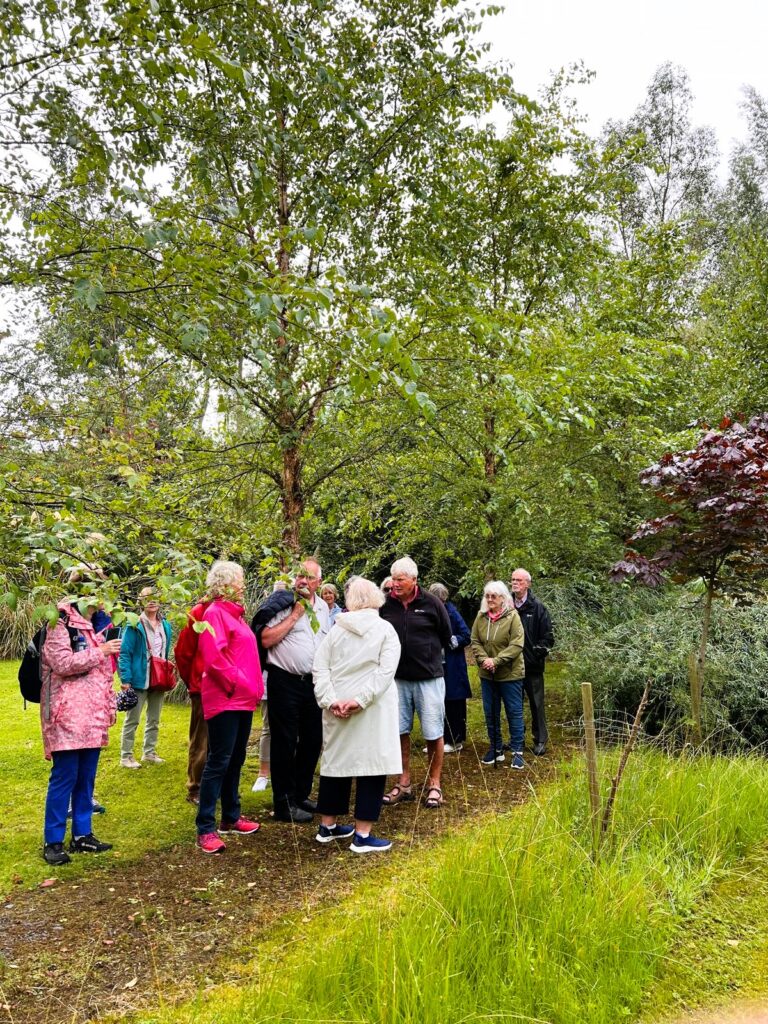
Sanna cutting the Lower Wood
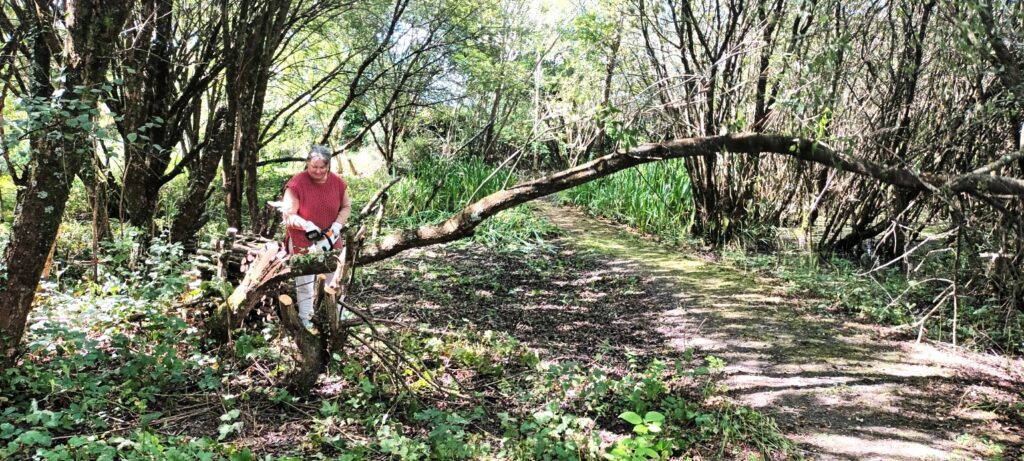
I planted the Lower Wood area twenty four years ago when we first bought the property and when it was just a bare water logged area … the first planting was of 300 rooted willow slips in December 2000 interspersed with common native silver birch and this has now matured into a shaded small wood and the wet conditions has meant that wild astilbe and iris have flooded in and carpeted the ground under the tree canopy … the soil is good but wet and perfect for willows and birch and much to our delight native oak is also flourishing and self seeding .
I have never been good at cutting back trees or shrubs and although the area was crying out for a good trim I have shied away from the task … Snezana of course has never been shy of cutting anything back and she tackled the area in August and I must say once she took the first step I have waded in to help and I really like the open spaces she has created and throughout the winter I will transfer some oak into the new gaps .
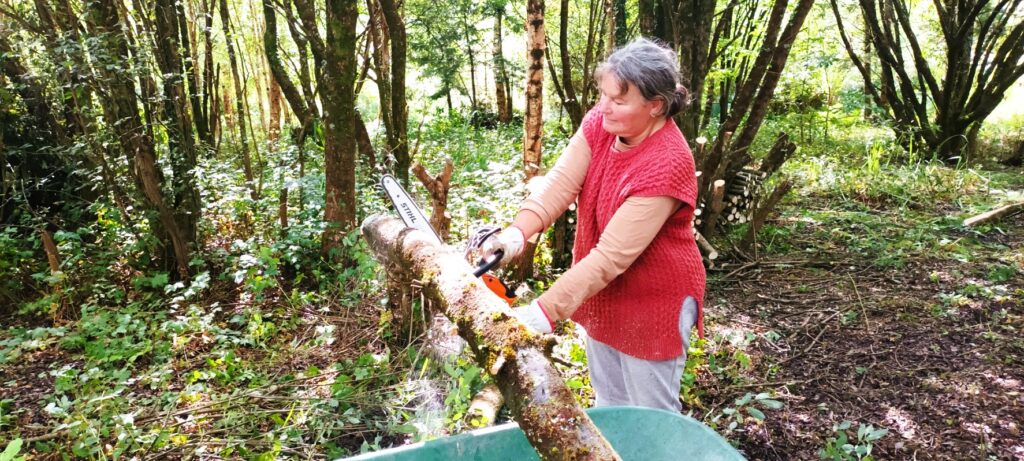
My job is the cleaning up afterwards
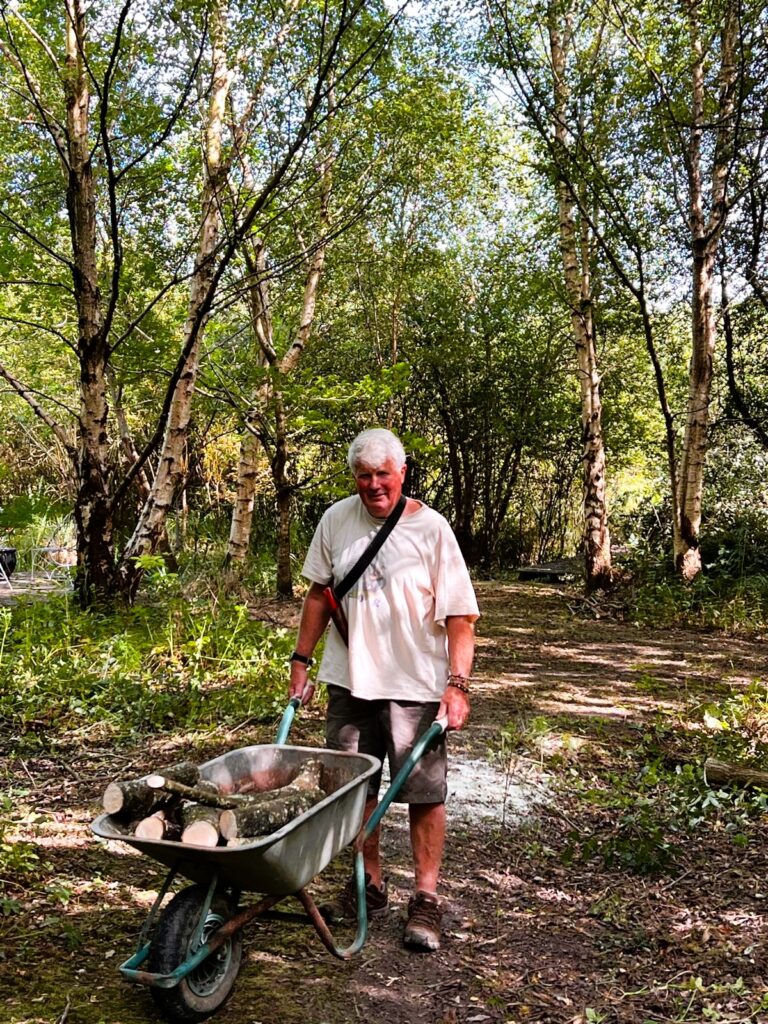
The newly cleared area in the Lower Wood 9th August 2024
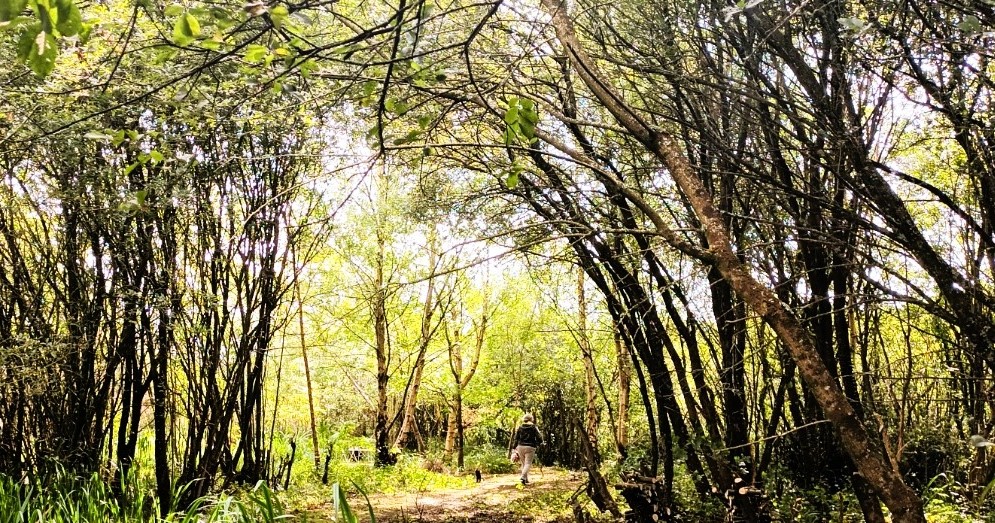
September 2924
Did I mention a radical redesign of the front garden pond ?
The front pond was one of the first garden projects we undertook back in April 2006 with Peter and it’s butyl rubber lining gave no trouble until May 2023 when I tried to have it cleaned and in the process the lining was punctured half way up the side and the height of the water dropped to less than a third … two decisions had to be made either replace the liner entirely , a messy job where the entire pond area had to be removed to fit the new liner or remove the entire pond and start with a new design .
To be honest I had never been entirely happy with the pond all these years , too concrety and it always looked artificial although the plant life was great with terrific water lilies but it never gelled with me … so renewing it was not an option and this left the way forward for a complete revamped new design .
Snezana and I tossed ideas back and forth and Peter arrived to build whatever design we went for which initially right up to the night before construction was to start was for a large patio area with a smallish formal rectangular pond in the middle … then came a Eureka moment where all the stars aligned and for the first time Snezana and I actually agreed on a garden design !
We decided we had more than enough water in the lower garden already and wouldn’t include a pond at all instead we would use the entire area for a large patio and then Peter’s expertise as a constructor and garden designer kicked in where he tweaked our in that instead of a large unbroken patio he would build a small entrance of paving slabs with a planting area on both sides … Snezana and I picked out an Indian limestone slab with Manor Stone in Abbeyleix but decided not to have a planting area instead we picked a medium size burgundy stone chippng to fill in the area on both sides of the entrance which we would then use to position garden pots .
Finally having agreed the plan Peter moved in with a small mini digger and filled in the pond which gave us an idea of the eventual size available and over a coffee looking at the cleared site the three of us agreed that a more radical approach was needed which would mean removal of several trees and all of the surrounding shrubbery and perennial plants … tough decision and heart breaking to see fifteen year old clumps of crocosima and rodgersia being dug up but a brutal approach was needed to get the new design and I was able to save a good amount of plants for transfer over the winter to other areas of the garden .



The beauty about working with Peter is that nothing is too much trouble for him and just whisper that maybe that tree should go and ten minutes with the digger and it is gone !


Little did we think back in 2006 when we were trying to get planting going in the front garden that it would grow so well and that eighteen years later we would go back to a basic minimalist look and we were lucky that five key trees did so well , a silver birch , an acer , a liquidamber , a persicaria parrotia ( Persian ironwood ) and a self seeded oak and they are now the back bone of that area of the front garden .


I recycled six pots from other parts of the garden and after a lot of huffing and puffings with various lay outs they also found their place in the new scheme . The new front garden now looks bigger with less clutter of plants and we are delighted with it .

Last word on the revamp of the Front Garden
Our neighbour , Michelle Boisson , took this photo through the front gate two days ago while we were away … beautiful composition and the fading colours of the parrotia tree sums up the coming autumnal season perfectly .

Return to Sarajevo and Mostar in September 2024
We travelled into Bosnia with good friends from Gornja Podgora , Julie and Ico Marinovic stopping in Jablanica for it’s famous dish of lamb barbequed on a spit … mainly for Ico who is Croatian and Snezana from Macedonia while Julie and I who are much more refined stuck primly to the salads !
Going back is different as a tourist than when I worked in both Sarajevo and Mostar as I always seemed to be either in meetings or travelling to meetings , always busy with no time to relax and enjoy the atmosphere of two unique and different cities . Sarajevo was always a multi ethnic international city from Ottoman times with an important cosmopolitan air about it whereas Mostar is more homely strung out along both banks of the Neretva river where the East side is Muslim and the West Bank is Croat and since the 1993 Bosnian War a deeply divided city and never the twain shall meet …so bad is the political will to cooperate in Mostar that after a national election it can take up to three years , almost to the next election , to elect a governing body .
The famous centre of Sarajevo is the Old City district of Bacarsja while Mostar is centred on the Stari Most or Old Bridge , the famous Ottoman bridge built in the mid 1400 ‘s .


Snezana and I were first in both cities three weeks after the Bosnian War ended in early 1996 , grim times with most buildings either destroyed or in a bad way while in Mostar with one of the last shots of the war Croatian military took down the old bridge into the river with a heavy artillery barrage… accepted now by all as a cultural crime if not cultural genocide but at the time misguided nationalism had made hearts grow cold .
My first visit to Mostar in March 1996 was in an effort to unify the two customs administrations that existed there , one on each side of the river and collecting customs duties separately from Muslim and Croat importers with most of the revenue ending up with both nationalist political parties. After visiting both Customs Directors my first role was to persuade both to meet at a neutral venue …not an easy task as the Muslim Director was just out of a year long imprisonment in the infamous Croatian Concentration Camp at Dretelli where his family didn’t know if he was alive or dead until a visiting Sky News team filmed a line of camp inmates and he held up a sign with his name on it … he was obviously reluctant to cross the river while the Croat Director on the West side of the river was adamantly definite no way was he going to cross the river to the Muslim side … as you can imagine this was not a scenario I had trained for in my previous life with the Irish Revenue Commissioners … we compromised on a meeting on the West Bank and I drove the Muslim Director across the river lying down on the back set of my Nissan Patrol covered in a blanket … not a good start but from their first meeting both officers got on really well and cooperated … and this was my experience throughout my ten years in Bosnia in that whatever side they were on and no matter what stance the nationalist politicians from all sides took , on a local level all were friendly to each other .
Mostar Memories from 1996 Bosnian Diary
Probably the most photographed and certainly the most famous of all is the bridge at Mostar over the Neretva river which now divides the Bosnian Muslim and Croat populations of the city who have bitter memories of each other from history and most recently the Bosnian War of 1993 and no intention anytime soon to start any reconciliation process .
The Mostar bridge , like all Ottoman bridges throughout the Balkans, is regarded by Croats and Serbs as a symbol of the hated “ Turkish ” occupation of the Balkans and even though it had protected UNESCO status this didn’t save it from being blown up by the Bosnian Croat army in 1993 who chillingly cheered as it fell into the river .
At the top of this photo of the Mostar Bridge you can see a giant Christian cross , 33 metres high , one for every year of Jesus’ life according to the architects but in reality designed not for piety but to be seen from the Muslim side of the Neretva river and coincidentally also marking the spot from where Bosnian Croat artillery destroyed the original bridge … religions what ?
Local Balkan people I worked with were always surprised that I knew quite a bit about their history but as I explained my father , a life long member of the Irish communist party , made it mandatory for me to read from age eight onwards the weekly international communist party newspaper , Soviet Weekly … so I grew up learning data such as the yearly tractor production in Ukraine , wheat production in Serbia , copper mining in Macedonia and as for Tito …well I knew everything about Tito which as you can imagine went down a treat with my catholic priests and teachers in the 1950’s Ireland !!
Irish catholicism in the 1950’s was not a happy place for jews , protestants , muslims but top of the hate list with their own special place in hell were communists !
I used to walk across this bridge to my office every day for three years in Sarajevo and this was the bridge where a 19 year old student from NW Bosnia, Gavrillo Princip , assassinated Archduke Ferdinand on June 28th June 1914 , an event that sparked off World War 1 .

As a measure of how names change according to the political times , this bridge was built by the Ottomans in the 16th century and was known locally as the Latin Bridge as it crossed the river to where the catholic area of Sarajevo was , next after the annexation of Bosnia by Austria in 1908 it became known as the Austrian Bridge , this was changed in communist times in the 1950’s to ” Princip Bridge ” which is what it was still called when I first arrived in Sarajevo in 1996 however in the last few years it is known as ” The Freedom Bridge ” .
Did I see any differences now in Sarajevo and Mostar after eighteen years ?
You certainly see or at least I did an islamization of Sarajevo and maybe it was always there but under the surface in my time just after the Bosnian War but now you are certainly aware you are in a Muslim city which I am fine with but it must be disconcerting for Croat or Serb people .

Shop owners we spoke to in Bacarsja say that most of the business ‘s in the Old City are now owned by Turkish business people from Istanbul … again no problem for me I like Turkish people but still it is a shame to see the Bosnian element and tradition being taken over .
But Sarajevo is Sarajevo , a magical place .

Mostar was always divided and especially after the war when I first visited and worked there you could see the bitterness and distrust between the Eastern Muslim side and the Western Croat side and that feeling is still there as the Old City is totally Muslim and proud of it while the Croats on the other bank of the Neretva ignore the Old Bridge area and go about their daily lives untouched by the rampant tourism and commercialism and West Mostar has the air of a ghost town .
The Muslim side is though is buzzing with tourists all trying to get the perfect Tik Tom video !

I love Mostar though for it’s history , it’s defiance during the Bosnian War and just how it has bounced back after its near destruction in the early 1990’s .
The Stari Most of course gets all the crowds but a few hundred metres away on a small stream leading into the Neretva is the bridge I love best in Mostar and one I always visit when in the city… the Kriva Cuorija Bridge known as the Crooked Bridge in Mostar just down from the more famous Old Bridge built in 1558 … not much visited but always my favourite .

October 2024
Good unusual pots are hard to source and we are lucky in Clonmel with the Clonmel Garden Centre where Chris is also a pot aficionado and basically if you see a good pot buy it even if for the moment you don’t have a spot for it and over the years I have bought several pots on that basis and put them in places I knew were always going to be temporary until the right space came about .
Over the years Chris has on a yearly basis ordered some real knock outs and my favourite has always been these Greek amphora style blue pots which are stunning .

Like books pots need to be collected and like books you never acquire a collection overnight or from the one source and a collection of pots is built up slowly where you can find them and we always check odd corners of garden centres for that unique pot which are quite often on sale as they are either one off or quirky and are unloved until we come across them and I remember once in Clonmel Garden Centre in their walled garden area not open to the public I saw a terracotta Chinese lantern with a few chips off it obviously parked in an out of the way corner … a few words with Chris and it was ours and here it is now ten years later pride of place in the new patio area .
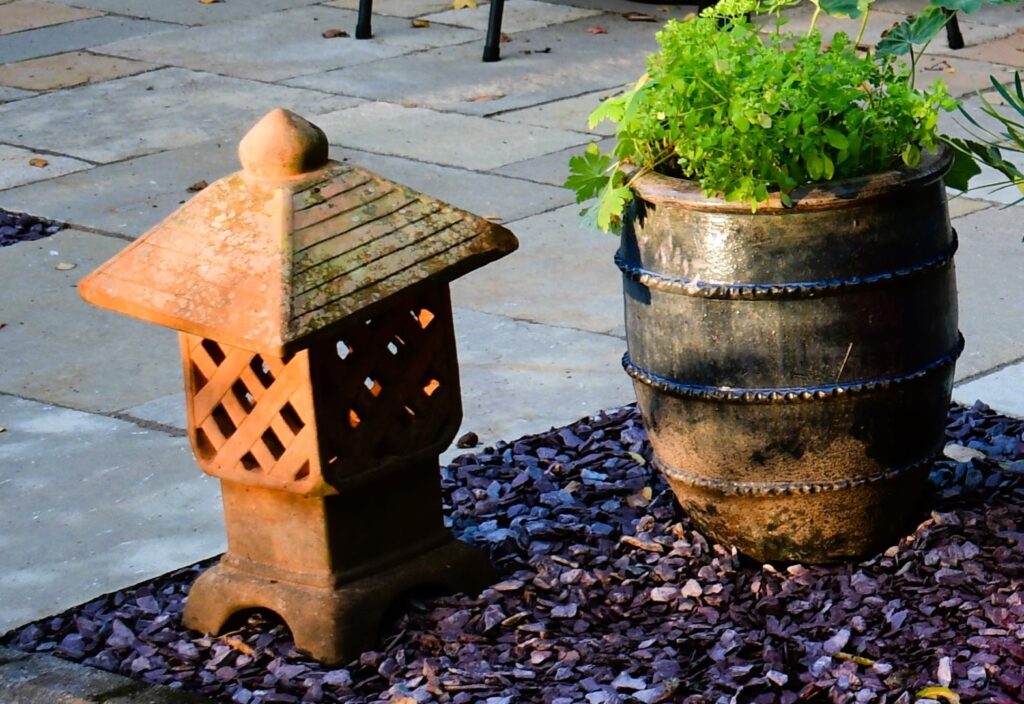
Pots are like life partners … when a good one comes along … grab it !!
Olive Oil Harvest in Gornja Podgora October 2024
Normally the local Olive Mill in our village , Gornja Podgora , opens around the 20th October and as we were returning to Ireland on the 15th I thought we would miss this year’s olive harvest and had arranged for Mate Srdic to collect the oil for himself but then the Mill opened on the 8th October , very early because of the anticipated bumper crop of olives this year along the Dalmatian coast so we booked a slot on Friday 10th October and started picking three days before .
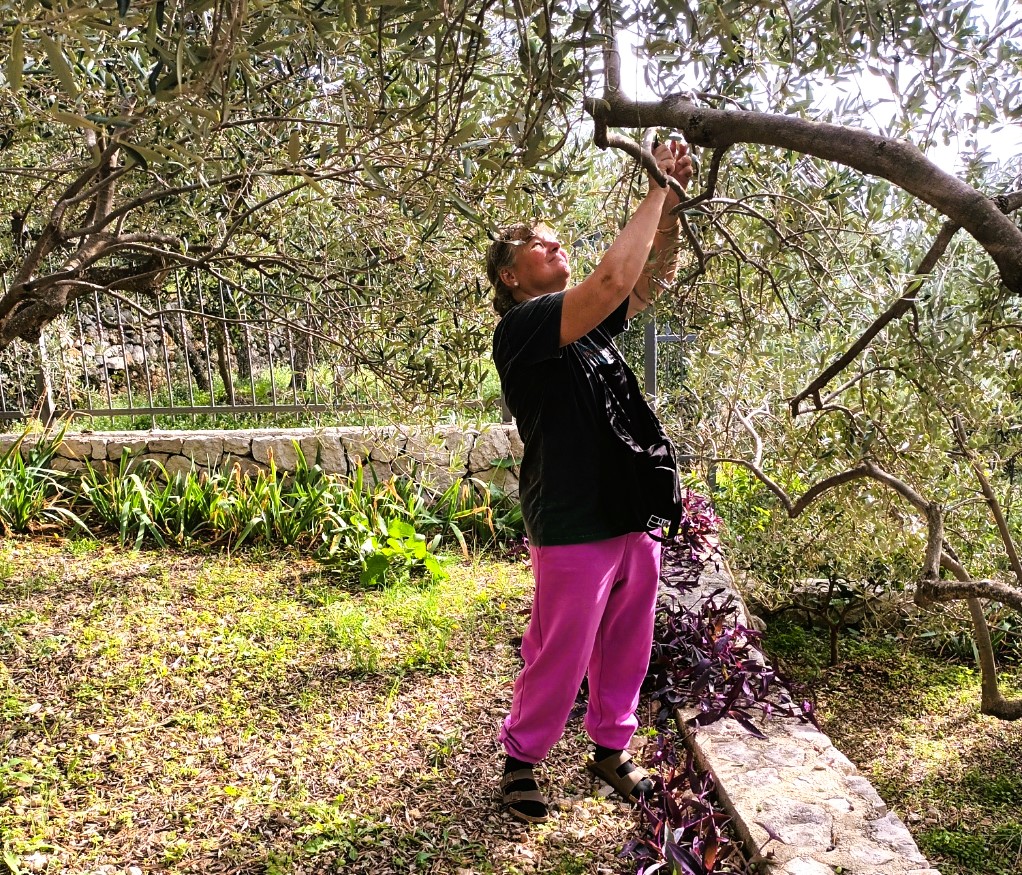
Olive production is a tricky thing and while we have had the Olive Garden for six years now we have only managed three harvests in that time , 2019, 2022 and this year as various events such as drought at vital times , too much rain at pollination , olive oil fly infestation , can mean either a low or even no crop at all some years and our last crop was two years ago … long enough to forget what a back breaking , finger cracking , mind numbingly boring job olive picking is and that is not counting up and down on high ladders throughout the process where you take your life and limbs in hands to the point where you throw caution to the wind and end up like Tarzan hopping from tree to tree !!
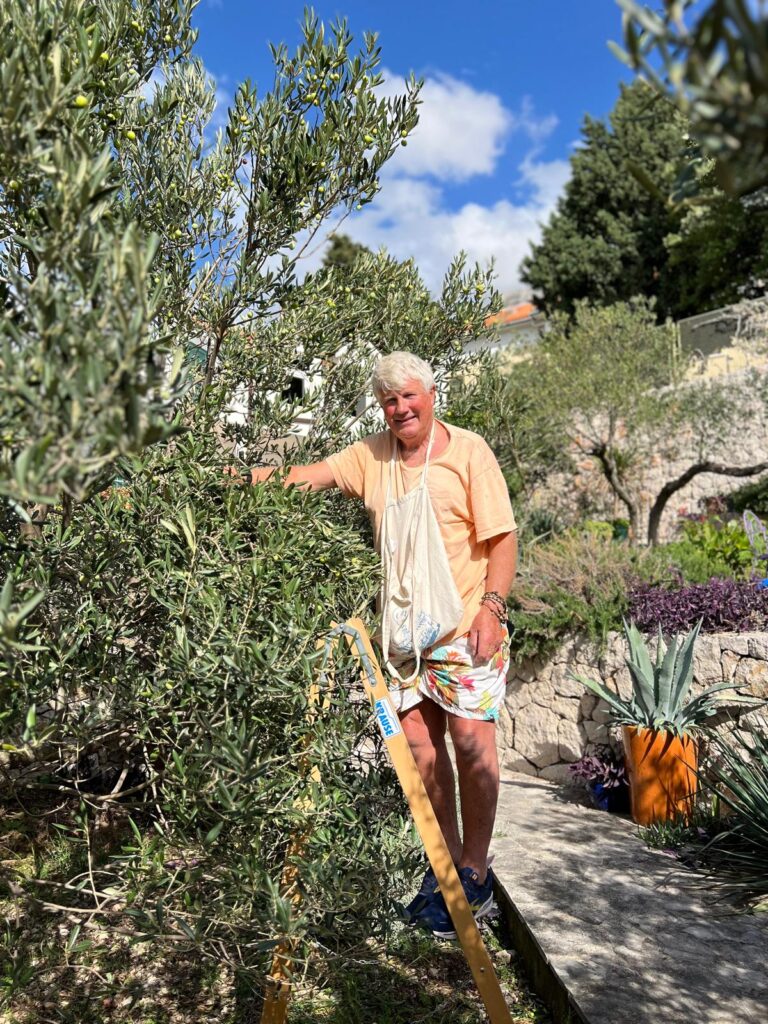
I have to admit that Snezana worked like a trooper at picking the olives and that I , in her words to my daughter Claire , “ whined like a bitch ” throughout the entire three days process … not my proudest moment !
What made the picking harder was that this was the first time we had to pick on our own as Snezana’s Mum , Vera , wasn’t able to travel from Copenhagen and Vera is a powerhouse when it comes to olive picking … in the genes of course as Snezana claims they are pure Macedonian straight from Alexander the Great .
I gave a talk on Adriatic Gardening to the Clonmel Garden Club in March and the one detail everyone remembers is that of Vera high up in an olive tree without a ladder at eighty four years of age !!
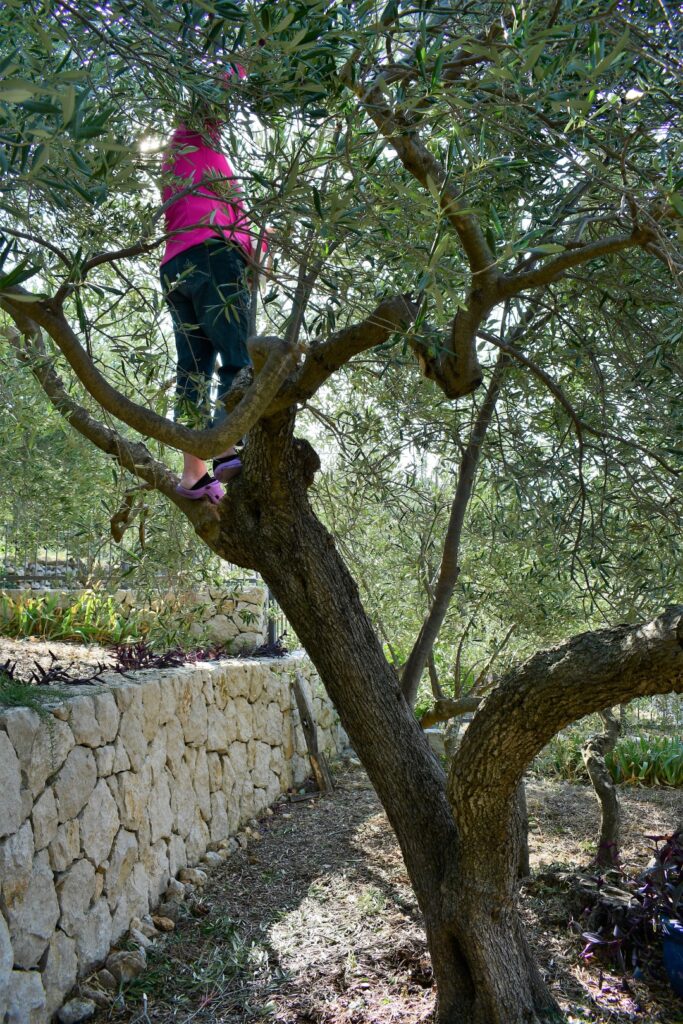
The weather was great throughout , not too hot and no rain and we managed to pick our best yield yet , a total of 170 Kgs.of olives .
There are different traditional starting times for picking olives in Croatia and the earlier you pick the better the extra virgin oil is but you get less a yield as in our case where our early date meant a yield of eight to ten percent whereas two weeks later the yield would be eighteen percent … this is obviously important for the olive producers for whom volume is important and of course we are talking about a product that is widely abused with a variety of olive oils of an inferior quality being mixed to jack up production and eventual sale … you hear stories even in our little village where palm oil, vegetable oil or cheap supermarket olive oil is routinely bulking up sales of olive oil to tourists and I know local people who will only buy from a completely trusted source … is anything touched by commercialism safe from fraud these days ?
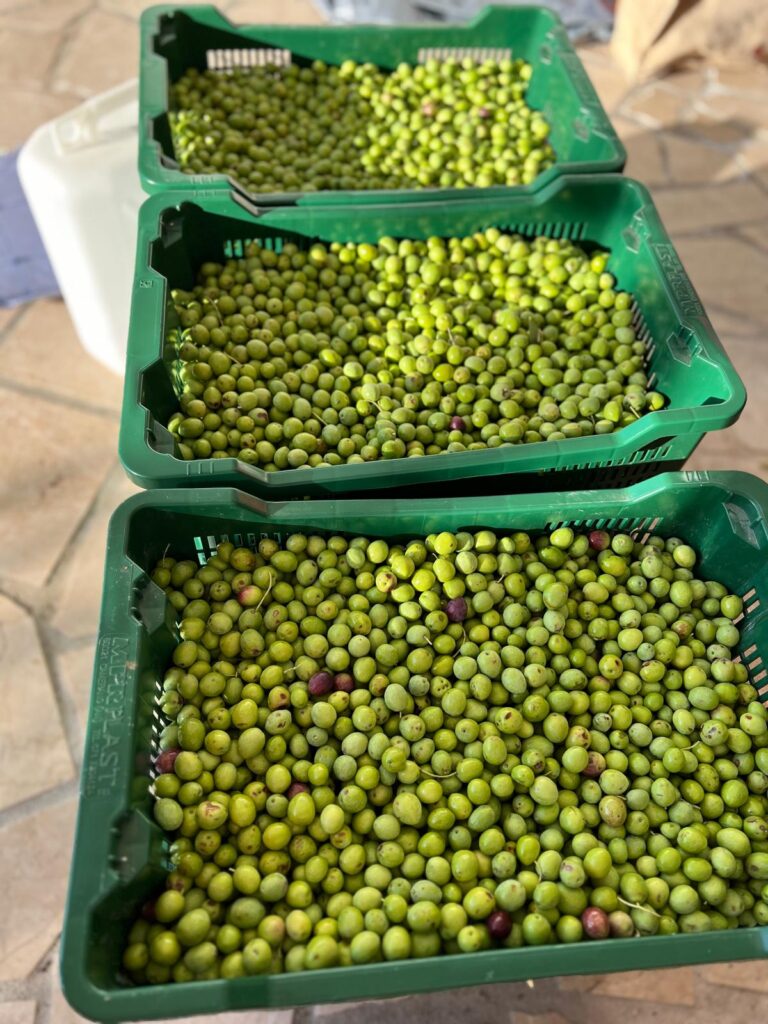
Rain is very important in the growing process and a drought will result in either olives like little bullets or not even worth harvesting which was the case last year but this year will break all records with olive oil production .
Because we picked so early our olives were all green not a hint of blue and a little blush as they call it is good for the taste but we had no choice in the picking date … you store the oil for a month or two after production to allow sediment to fall to the bottom and always in a dark place as sunlight is bad for the oil … we had a quick taste of this year’s production with some bread and it caught in the back of the throat … nothing subtle about the taste and a million miles from the taste of commercially produced olive oil !
During the picking season the hills are alive with whole families out picking each day and people living abroad often take their annual holidays to be home to help with the olive harvest and there is a real sense of family and friends out giving a hand .
When you arrive at the Olive Mill there is a sense of comraderie as everyone is interested how you got on as we would be the only foreigners growing olives in the village and while for us it is a cosmetic or vanity project but for local people this is deadly serious as whatever they have left aside from their annual consumption , generally fifty litres a year , they will sell at over twenty euros a litre … liquid gold !

We took our spot in the queue , our olives were weighed , washed , stripped of any leaves and into the crusher for an hour and then the magic moment arrives when you place your containers under the machine and your oil gushes out … our 170 kgs. gave eighteen litres .
No matter how many times I see that first rush of our own olive oil come out through the pipe it is still weirdly exciting and unique for us to have eighteen extra virgin oil going home with us !
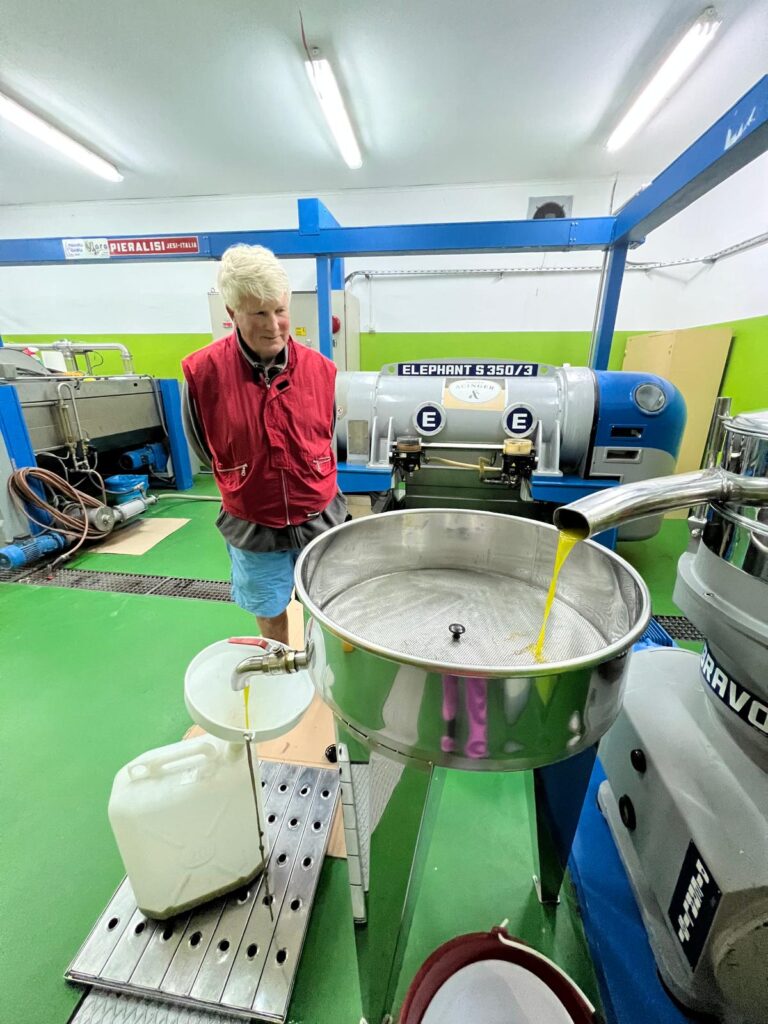
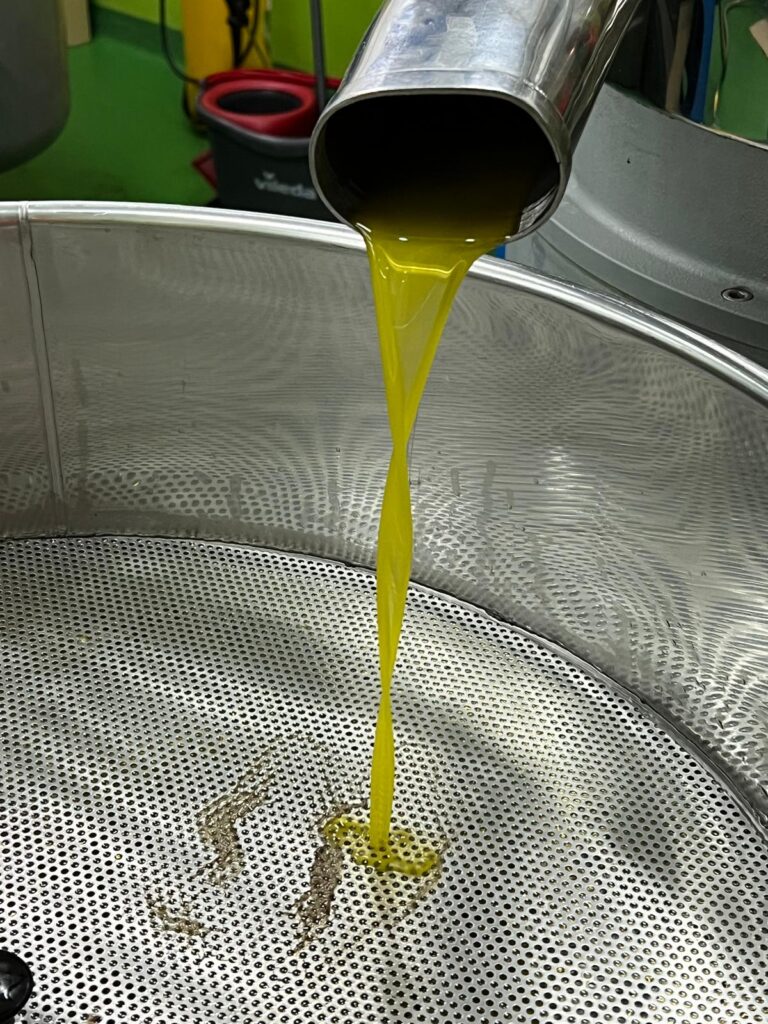
Helen Dillon
I saw a rather sad article this week where Helen Dillon’s house and garden in Dublin is for sale as she has not been well and has moved to a nursing home … this is the house she moved to in 2018 after she sold her most famous house and garden in Ranelagh and then at seventy eight started from scratch to build a brand new garden … not many people of that age would have the energy or interest to do that and not only that she opened it to the public after two years .
Probably our most famous Irish gardener and certainly our best garden writer is Helen Dillon . Helen had a fabulous garden in Dublin which was world famous and rightly so and back in 2004 she scrapped the centre piece and focal point , a lovely lawn flanked on both sides by herbaceous borders meticulously planted and looked after , not a hair out of place … but she decided rip it all out and replace it with a formal large pool … a brave decision typical of her personality that if she set her mind on something she went for it all guns blazing .
The garden world was appalled and delighted in equal terms and to this day twenty years later the gardening opinion both in Ireland and internationally is divided over it … Helen didn’t mind , she wanted a change and she did it .
We visited the garden ten years ago in July 2014 and it was magical , almost a pilgrimage for me to see the Dillon Garden as I have read all her books and collected articles … before I visited I asked what is she like from a friend who knew both the garden and Ms. Dillon well … odd as hell was the answer , mightn’t be in the mood to speak to you so don’t approach her !
We must have got her on a good day as we got on well and indeed she brought out a spade and invited me to dig out a few baby tetraplanax rex when she saw me admiring her specimen in her border … not growing as well for me here but ten years on still growing and a great personal memory of the Dillon Garden .
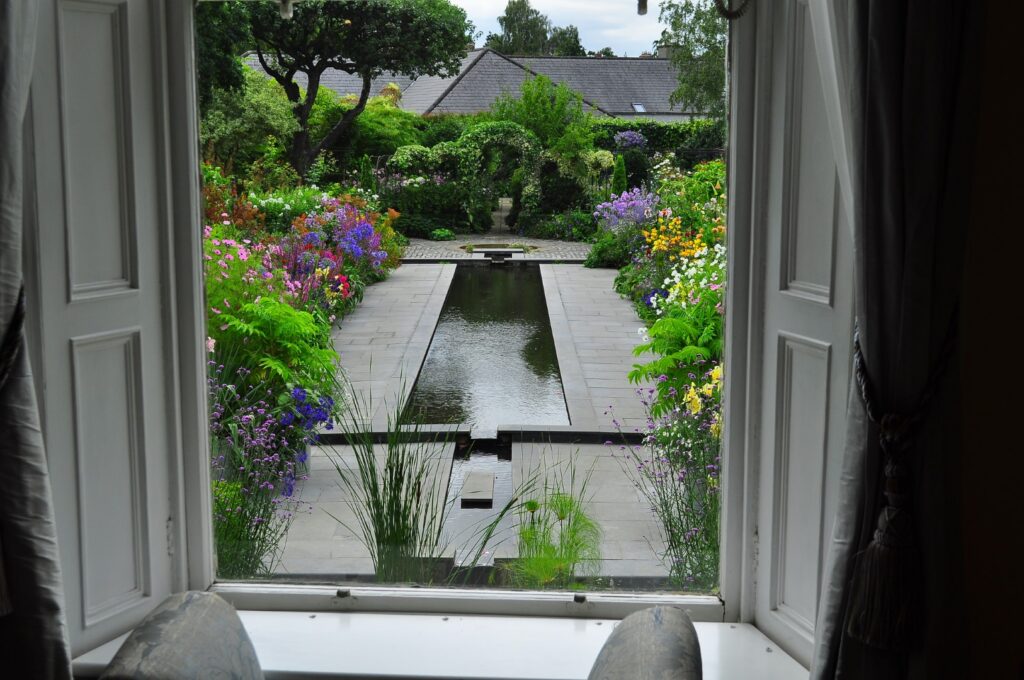
Over the years since we have attended a few of her lectures but in recent years her health has declined and her husband died last year which is why she is giving up her garden … a sad event for such a brilliant gardener and vibrant personality but age comes to us all and I wish her all the best in the latest episode of an interesting life .
Helen Dillon is a marvellous writer and her two books and numerous articles, Garden Notebook and On Gardening are ones I dip in and out of constantly and they should be on every gardeners bookshelf.
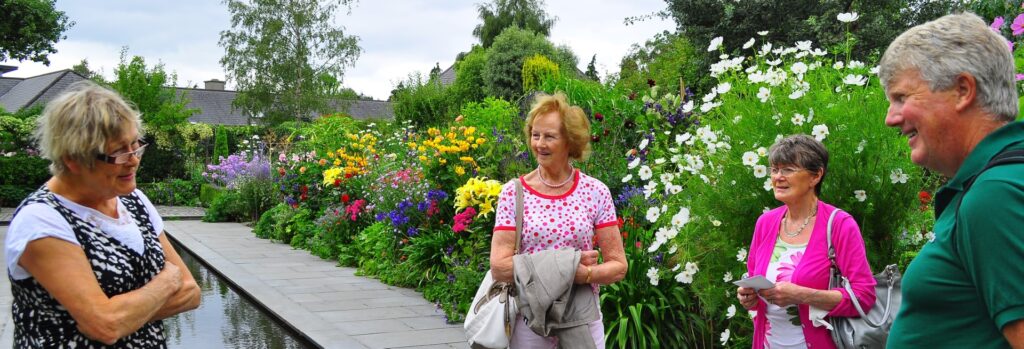
My Gardening Month November 2024 … Walking the Wall and all that !
Gardening in November is not for the faint hearted !
That said you have the entire winter ahead and there is no pressure to get things done as there is no growth and I enjoy wandering out with a spade , secateurs and a wheel barrow tidying up as I go along , cutting back , hacking into the brambles as the mood takes me … no pressure then !
But there is no getting away from it … Winter is dull and duller in the garden and I think this photo I took last week of a clump of lilies in the Lower Field sums it up perfectly … no joy and if you think that is dark and grey have a look at this clump of gunnerra I just cut down and tidied up for the winter … enticing what ?!!
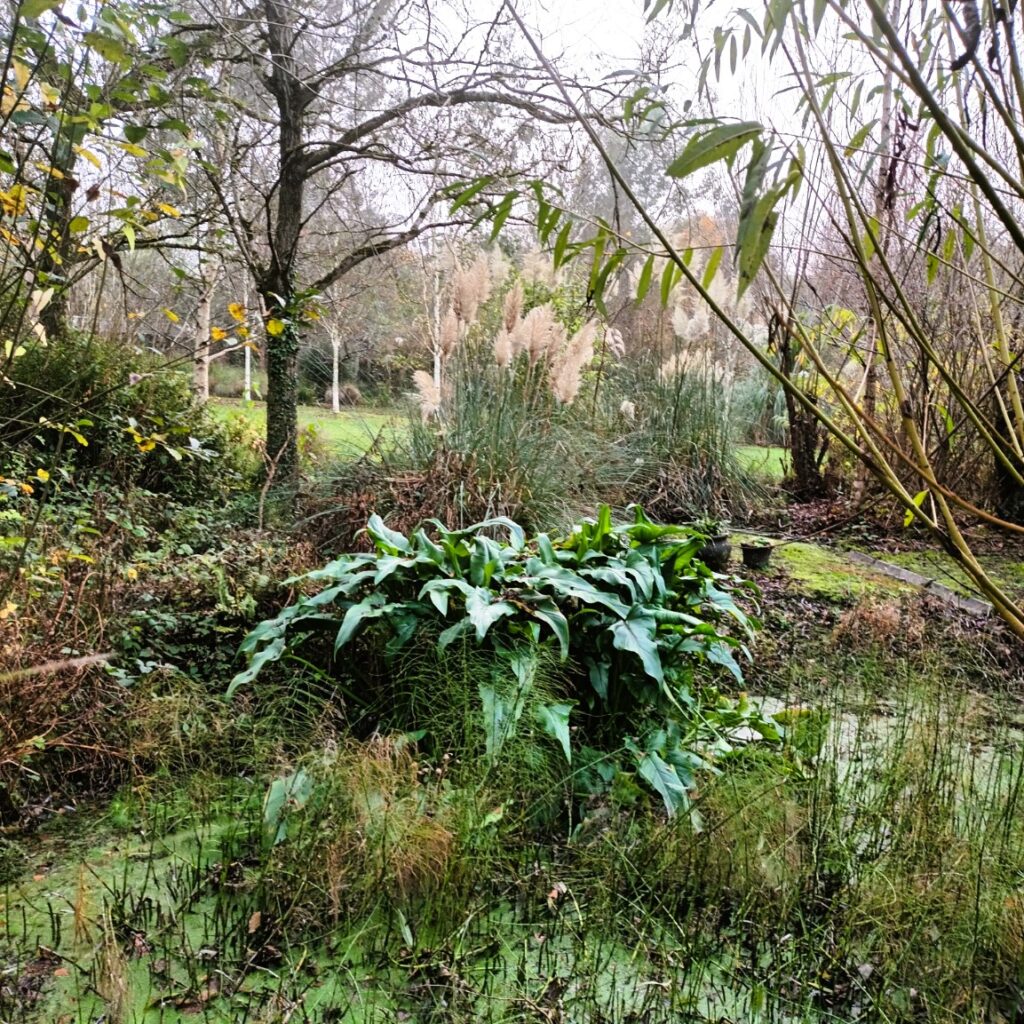

We grow a lot of willows here at Old Spa Road mainly because the wet conditions suited them in the beginning when we were trying to get the garden established but also because I love willows , from the common to the exotic varieties , so when Susan at Clonmel Garden Centre told me a few weeks ago that she was ordering a new golden variety willow for her own wild life garden and asked did I want to be included in the order … and yesterday I took delivery of two “ Golden Sunshine ” willows in pots .
They look like small shrubs as the Dutch grower had pruned them back quite hard but they should thrive in the wild area of the Lower Field . I like to research a new plant and saw on the label Japanische Drachenweide which Mr. Google told me was the Dragon Willow . Salix Sekka
“The dragon willow ‘Sekka’ is a large, easy-care shrub that immediately catches the eye of anyone who sees it. The growth of the branches constantly changes direction and is sometimes twisted, sometimes curved and sometimes straight. This creates an overall picture that seems a little bizarre. The young shoots of (bot.) Salix sachalinensis ‘Sekka’ are reddish in color, sometimes grow together and are reminiscent of dragon tails, which also explains the name of the plant ”
The dark red salix sekka has been a favourite of mine for forty years when I first planted it in Rosslare when I bought it from a Dutch grower who only sold willows and whose farm was at the end of a long laneway up on an exposed spot on the Wicklow mountains .
For some reason it is not a popular variety with Irish gardeners and consequently the garden centres rarely stock salix sekka or indeed any willows these days and this is probably because willows thrive in our conditions , get huge very fast and can be difficult to control .
But growers are nothing if not inventive when producing product for garden centre shelves and there are hundreds of willow hybrids being bred in all sorts of colours both in leaf and in the bark colour from deep red to golden and this variety Golden Sunshine is also known as Japanese Fantail Willow and I am looking forward to growing it and seeing if it can be propagated .
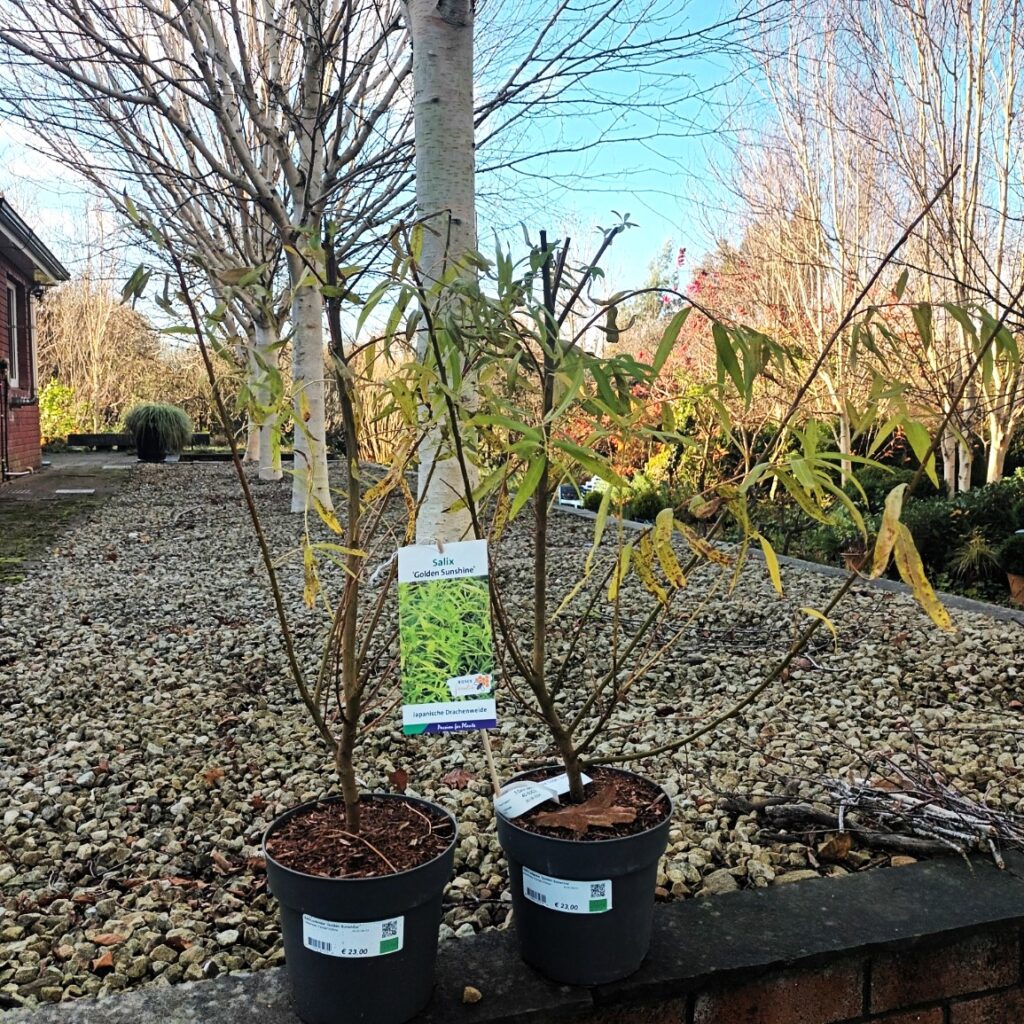
I literally plant hundreds of willow cuttings each year as we prune hard all our existing willows every January / February however my success rate is poor and I have come to the conclusion that willow doesen’t take in wet ground and prefers a dry position and also here the deer eat every willow slip I plant thinking I am laying out snacks for them … in the past two years I have been trying to get stuff to grow in the wet field we are trying to rewild with rows and rows of golden willow cuttings about eighteen inches high … the deer ate every single one .
A trip to China in November
We visited China in November and criss crossed the country from Beijing to Shanghai in what was a memorable trip .
Apart from Beijing , Xian and Shanghai I knew very little about China beforehand having always found China’s history a bit overwhelming apart from the Great Wall , Terracotta Warriors , Yangtze River , black and white pandas and couldn’t tell one Ming Dynasty from the Tang but of course knew something about the Cultural revolution and Mao’s Great Leap forward of the 1960’s having read about these events at the time .

But we left China after two weeks with a greater appreciation of the culture , the cuisine and it’s amazing river gorge scenery after two internal flights and three bullet train journeys across the country from North to South .
A highly unusual country and people who for two thousand years have always wanted to remain isolated and cut off from the rest of the world and so they remain today … quite indifferent to the usual politics and happenings of the outside world as for example we were there during the US Presidential election where the rest of the world was concerned about Trump and what would happen if he got back in … not a bother on the Chinese and it was never a topic , they simply didn’t care !
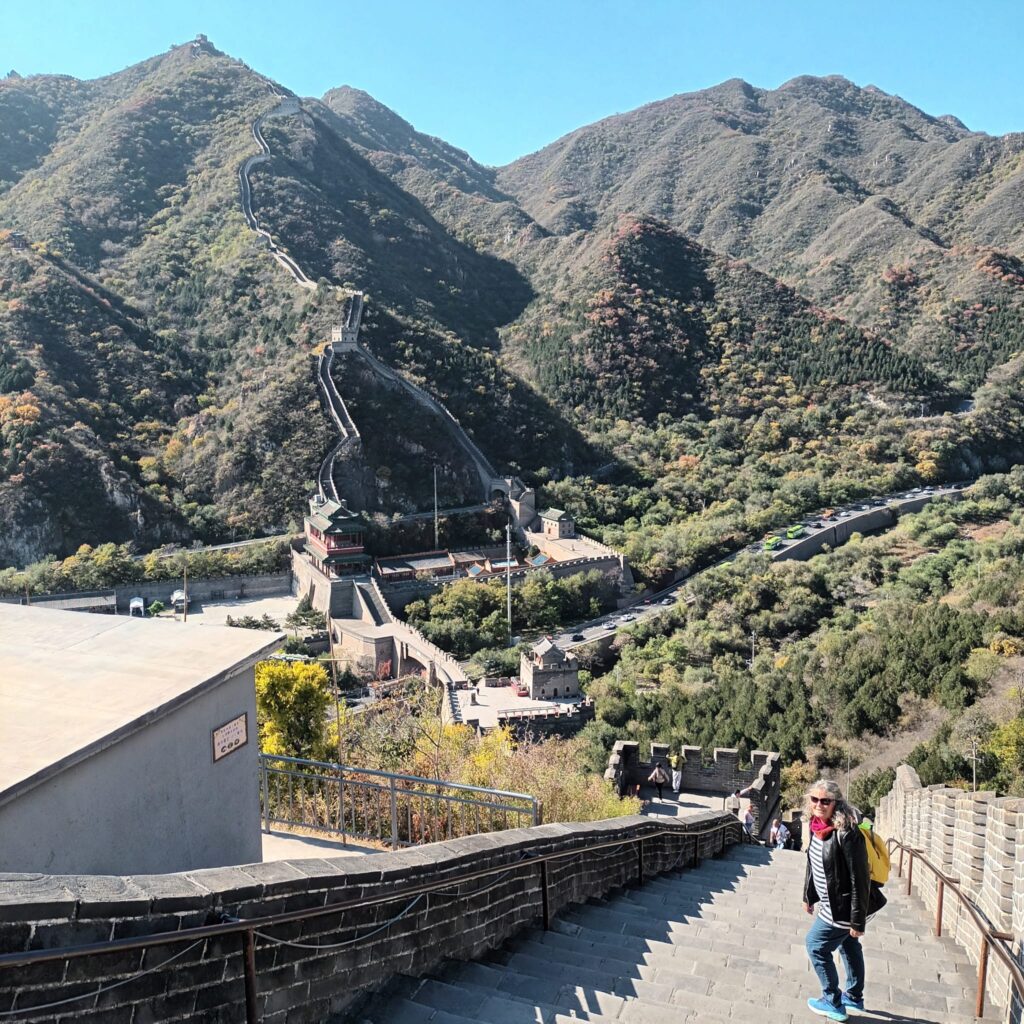
A very connected and up to date society on the latest digital innovations and China is more or less a cashless society where even to buy an apple as I saw our local guide doing in a market , not even a shop , he just flashed his phone app and the trader just flashed her phone and bing apple paid for … while before we left Ireland we were obsessing at what currency , US dollar or Euro , to bring … all our usual bank cards worked like a dream .
Again we were obsessing and yes obsessing is the word , about the Chinese Firewall that prevents access to Google , Facebook or WhatsApp but the Chinese have their own equivalents and are doing quite well thank you and don’t miss any of our western apps … and when you see the mental destruction and hatred these bring into people’s lives through trolls , scams and the rabid anonymous keyboard warriors , who can blame them for exercising a high degree of control over content .
Eating odd animals such as Fido or your favourite cat and how would we know they are not on our daily dinner buffets and while it still goes on in rural areas , your educated young Chinese do not eat cats , dogs , rats or snakes although they are partial to chicken feet which are available on every street corner along with rabbit’s heads but we Irish eat crubeens after a few pints so what ?!!
The food was fabulous but then we had a guide who explained all the dishes as they arrived at the table …a lot of beef, chicken and pork cooked in different ways with spices and sauces and each meal was generally served on a revolving table top , usually about twenty dishes in all … but eating out in Sichuan Province , the home of hot spicy food , was an experience with one spice known as “the tingling spice” especially to be avoided … the last time I felt such an effect was when a cathedrer was removed in Kilcreene Hospital !

Beijing as a city is obsessive about security and you can’t move around the centre , Tienamen Square and the Forbidden City without producing your passport at regular security check points to get into everything and definitely feels very repressive but the farther you move from Beijing the less oppressive and more normal everything is .

We went to see several gardens like The Emperor’s garden in the Forbidden City and the five hundred year old Yu garden in Shanghai which basically featured a lot of irregular shaped rock and bonsai trees but I am probably too shallow to appreciate the finer points and this style of garden never appealed to me … the place I really loved though and which made a huge impression on me was the walk through the Ming Tombs park outside Beijing where the peaceful air and beautiful landscaping with willow trees made me want to stay for hours .
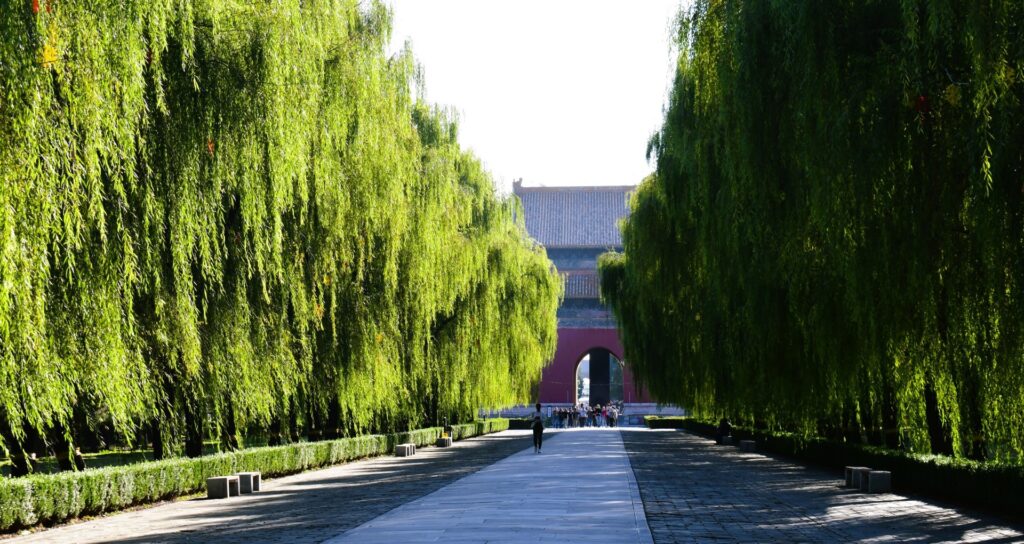
Some gorgeous garden statues and ornaments to die for that would do very well in the garden here and as for pots well we were in a winery outside Shanghai called Jinfeng Wine that is famous throughout Asia for rice wine and they ship it in hand made clay pots about a metre high which are then brought back to the factory and reused over and over again and we saw one vintage of 2003 … literally thousands of pots waiting in the warehouse to be reused and if these vintage pots were available in Europe they would sell out in hours .

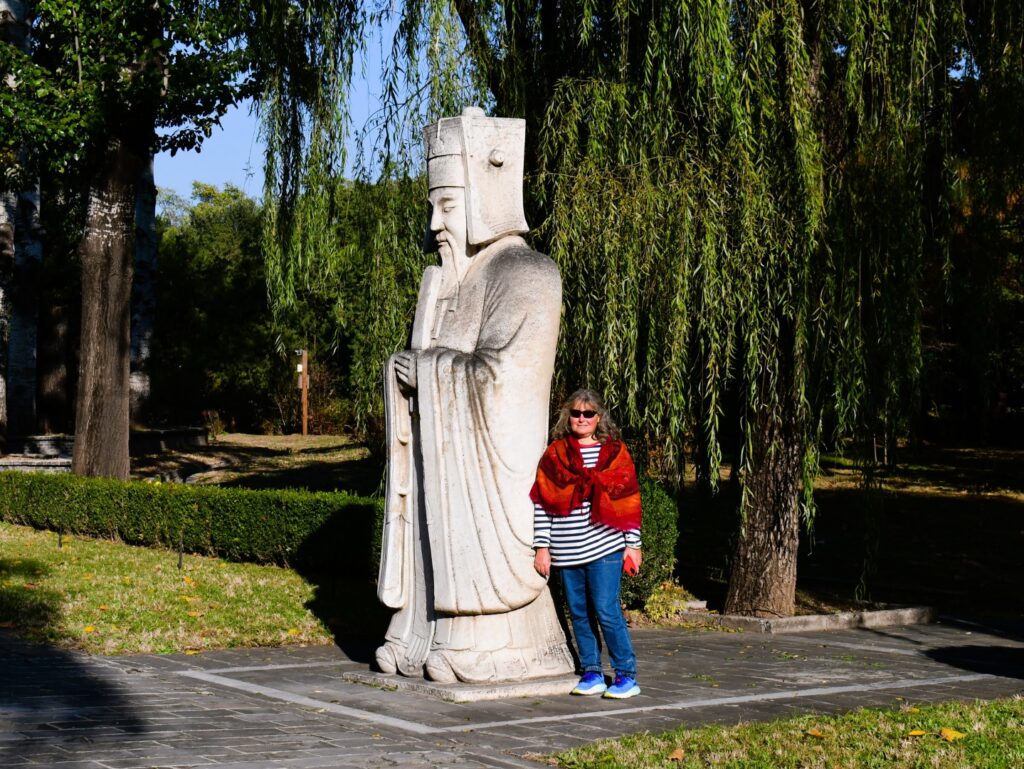
Everyone knows about the Great Wall of China , the Terracotta Warriors and the Giant Pandas and they don’t disappoint in reality although the pandas are shy creatures and you really have to scrabble to get a usable photo … lazy out and pandas just sit or roll around eating bamboos … apparently the female has a window of about a week every year where she might be interested in sex however the males are so lazy that the zoo keepers have to show them the equivalent of panda porn to get them in the mood … little known fact while you are eating your cornflakes ?!

The Great Wall of China is over twelve thousand miles built along it’s northern border with the first construction started in 200 BC as a defence against invasion and it follows a line on the map climbing over mountains and any geographical obstacle in it’s way .
What no one tells you is that because it basically goes up and down mountains that cross it’s route it is steep and very difficult to climb and some of the steps are the size of small benches and almost straight up in some sections … we spent about three hours on it and about three days recovering from the effort !
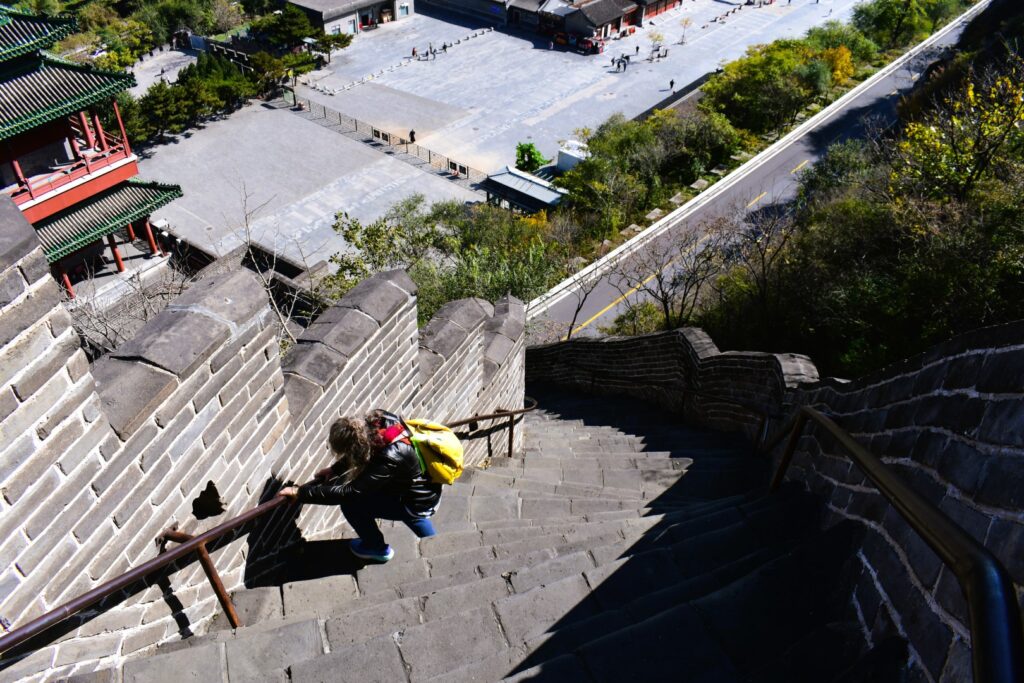
Xian is a flight of two hours south of Beijing and is famous since 1974 when the first tomb of the Terracotta Warriors was discovered by a farmer digging in his fields … immediate world wide fame followed as these were seven thousand life size hand carved statues two thousand years old all with individual features so no one face is the same buried alongside their emperor to guard him in the after life .

I saw an exhibition of about thirty of the statues in 1985 as part of a world tour when they came to Dublin and kept the poster on my office wall later and now forty years later I finally made it to the actual excavation .
Of course you don’t get to see the Terracotta Warriors on your own and have to jostle for space with a daily fifty thousand Chinese visitors … not an easy task as Chinese are not good to queue and have absolutely no manners when trying to get the best view …ordinarily very polite people but queuing brings out the worst in Chinese people and they think nothing of barging across you however I have history when it comes to queueing in museums and am no slouch myself with my elbows !
The Chinese river scenery is amazing and we did a half day cruise on the Li river and a three day cruise on the Yangtze river where the gorge and river scenery was just unbelievably gorgeous .


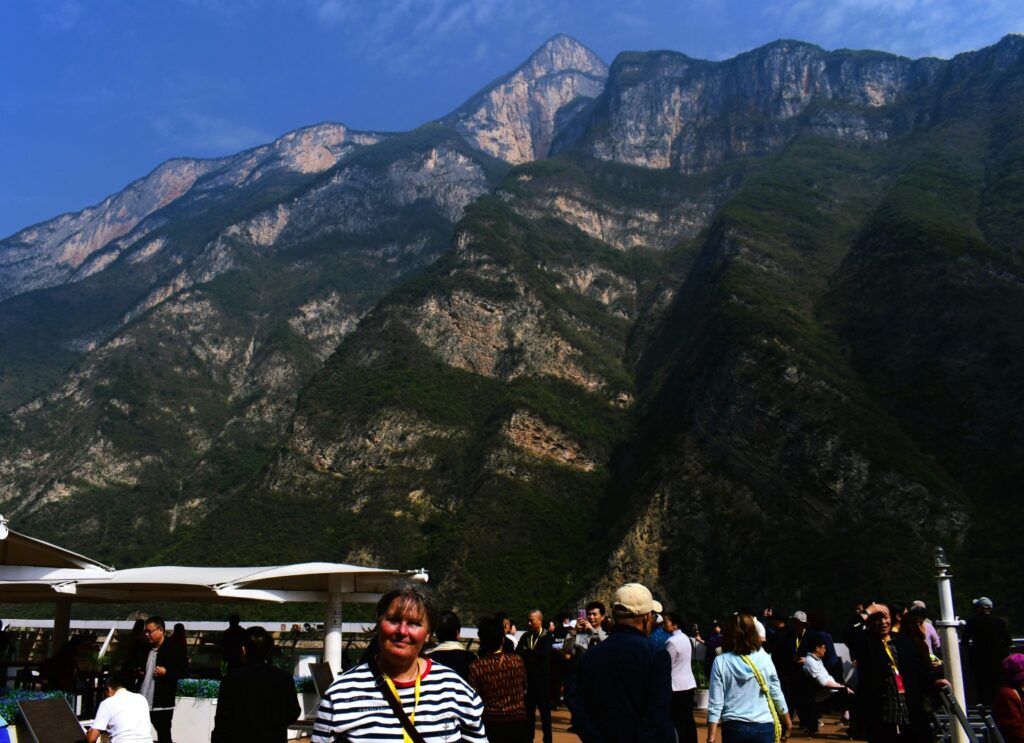
It amazed me was how little I knew about chinese cities apart from the obvious Beijing , Wuhan and Shanghai and here’s a statistic that may shock you as it did me
“ China has 10 cities with over 10 million people, 21 cities with over 5 million inhabitants, and an astonishing 145 cities with over a million people. The most populous cities by urban area population are: Shanghai: 24.5 million. Beijing: 22.5 million.”
Take Chengdu , no me either , it has been the capital city of Sichuan Province since the 4th century BC , has a population of 22 million and in the city centre you could mistake it for Fifth Avenue in New York , lined as it is with luxury stores of Chanel , Tiffaney’s , Prada , Louis Vutton and I reckon nobody there cares for the EU or the US and they are quite happy to ignore the world outside China .

Usually on holidays abroad especially around the mediterranean we are used to seeing fake and counterfeit goods especially clothing in street markets , all made in China … not in China itself though as this is strictly regulated and tourist goods are sold in official shops attached to the site , not expensive but not cheap either and the quality is excellent but the chinese are a small people and what is large or extra large at home will need to be 3 or four XL … or as a street trader lady in Saigon once assured me that her t shirt would fit me as it was “ hippo size ”!
Shanghai is of course famous for it’s Bund which is right on the river with it’s cutting edge modernity and high tech look and is a classy place , a river port at the mouth of the Yangtze leading out to the East China Sea and of course I knew all this from the famous photos but what I wasen’t anticipating is that south of Shanghai in the delta area there are some beautiful river towns dating from 600 AD to the present day full of canals and bridges predating Venice and it’s canals by more than a thousand years … Shanghai itself is about two hundred years old and when we visited Fenggang Town , a classic river town , it put Shanghai and all it’s modern skyscrapers in perspective … we loved our time walking the bridges and canals .

Of course what we saw was a very superficial view of a complex country and as part of a small group we were accompanied at all times by a government regulated chinese Guide which I am sure meant we were steered away from anything contentious or that might show China in a bad light .
And speaking of guides I cannot imagine how difficult it would be to navigate and travel around China on your own , NO ONE speaks a word of English even in major hotels where they use Google Translate App to talk to you and all signs are in Chinese … airports and train stations are a nightmare to find your way about so God bless Jack , our guide !
That said as you can gather we loved our entire trip to China , a fascinating place and a fascinating people .

Would I go back again … no been there saw what I was interested in seeing and perhaps because our trip being so tightly packed and on the go all the time , it was more of an expedition than a holiday !
But living in a country where communication and reading in a language other than Chinese is so limited and alien and of course streaming TV or the internet is controlled and having to do everything through a translation App is not easy and ultimately not for me .
In my opinion China is a major destination to visit just to get a feel of what the other great world superpower is about so overall a fabulous experience .
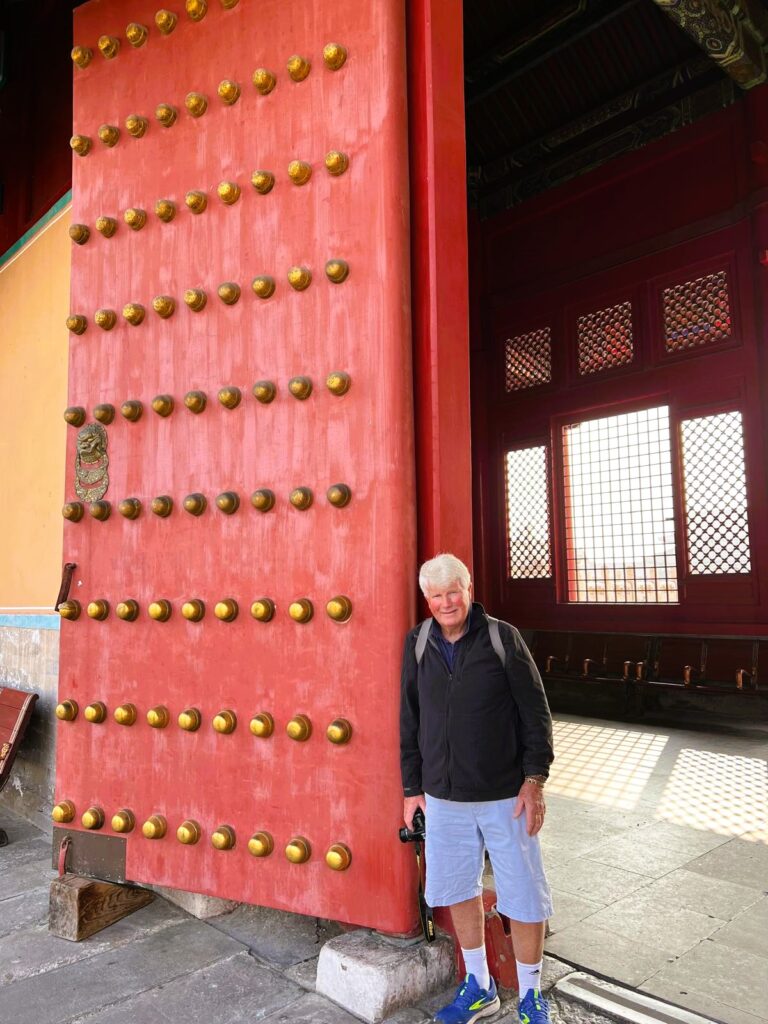

My Gardening Month December 2024… Welcome 2025 and a Happy New Year and Sretna Nova Godina !
December I always have mixed feelings about as I find it a month where there are so many distractions and so many things to do in the run up to Christmas that there is little time or even interest to so spend time in the garden .
We have had the shortest day of the year on 21st December and from there on you have a little bit more light every evening and you realise those ancient people had their heads screwed on the right way when they invented a great festival around the time of the solistice , the shortest day of the year , a lot of eating and drinking and whatever else you fancy to take your mind off the dark winter nights and something to look forward to be it , Yule , Saturnalia , Nollaig or Christmas !
I was asked in town today by a friend what do you do in the garden at this time of year and my reply that I just stroll around a bit didn’t explain fully so as it happened I had just been in the garden earlier today and could list exactly what I had done … planted six hyacinth bulbs in a shaded area of the garden and planted fifteen allium purple sensation and then three ferns , harts tongue , that were on the back window of the car since I bought them two weeks and then finished off with half an hour on the leaf blower … all added up to a handy two hours of bulb planting and tidying up leaves I had been putting off … and it got me out of the house and I felt a glow of satisfaction afterwards !
The most famous gardening piece of advice is “ right plant right place ” but even then something might not gel and I always advise if a tree or shrub is not doing well and thriving after two years then move it as sometimes even moving a plant a metre can help … but of course the other important thing I find is to walk around and view the plant from every direction … of course giving advice and taking it is another thing and last week Snezana mentioned that a silver birch I planted a few years ago is not doing so well and I had planted that tree in the front garden so that when I parked the car in winter the silver birch which was right in front of it would look great … it would but the tree had not put on any growth and I had broken my own rule and left it there for four years thinking it would grow into the position … luckily I dug it up today and the roots were in a bad way as the soil is dry and not very nourishing in that area but of course because I wanted the silver birch in that position I had persisted however in a testament to the survival instinct of silver birches the tree had kept it’s leaves and had no rotten branches but it hadn’t thrived so today I moved it and fingers crossed it will do well in the new more open site in the front garden helped by a bucket of compost and a few scoops of osmacote a slow release fertiliser pellet .
Now is a good time to check garden pots and my normal routine is to top up with compost any pots where the soil has slumped a bit and I keep a tray of primulas to pop into any available space … always yellow as this is the natural colour of the old fashioned cow slip and I find the exotic colours of the modern hybrid primulas a bit jarring .
Basically this is as much as I do with pots at this time of year but I do have a check under each pot for any overwintering snails … you don’t need to know but you can take it I don’t tuck them up for a winter snooze as unless dealt with they will be ravenous as soon as the new growth of the hostas start again in late March !
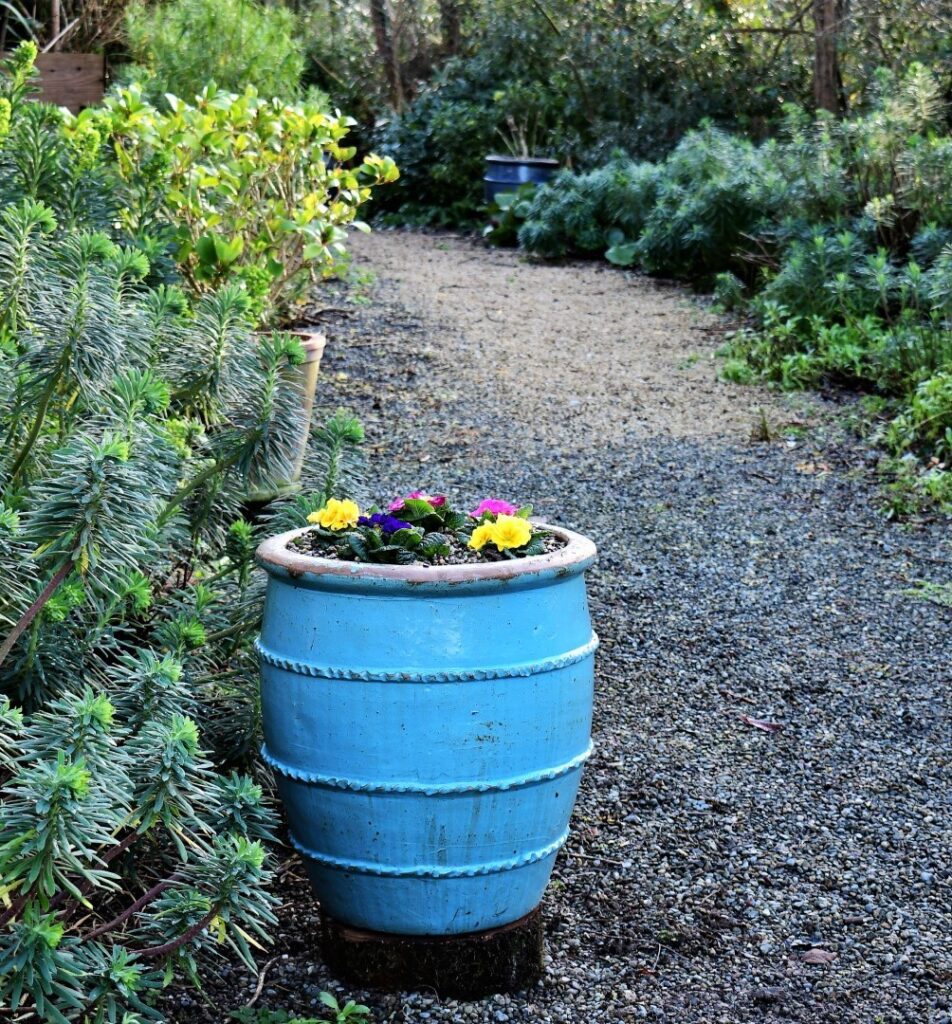
If you want the latest on pots Sarah Raven has a new book out “ A Year full of Pots ” which I haven’t read yet but I have several of her previous books and she is a superb writer .
I am often asked for gardening advice on FB Forums and this one from December 23rd deals with what to plant in a man made wood .
“My experience with a natural wood is to thin out as it grows first by creating walkways through it so you can at least push a wheel barrow through . As the canopy grows nature will bring in seedlings depending on the soil ie, wet or dry , some like astilbe and iris will be welcome but weeds like thistles and docks will need to be controlled before they get a hold also brambles so you need to be on top of this otherwise it will become overgrown . I introduced ground cover geraniums close to the paths also lamium ( dead nettle ) which are easy to propagate and then planted lots of bulbs , dwarf daffodils , wood anemone , which will spread slowly but is not invasive like some varieties of blue bells and has lovely white flowers in May and then the plant dies back completely , a real favourite woodlander of mine . Lamium chablis is a lovely evergreen almost white leave which comes into the garden centres when in flower in late April / May . Along the paths you could also introduce a few large pots as focal points .”
I envy someone who gets to plant and design a wood from scratch but of course you have to wait at least fifteen years before it takes shape but in our case here when we moved in twenty four years ago we inherited a conifer wood planted for harvesting so the trees were just plain conifers , a horrible tree when planted en masse and to make matter worse they were planted too close to each other and almost abandoned afterwards … when we took the wood over there were no diversity with native Irish trees like birch or oak and the ground was too full of tangled conifer roots to be able to dig out planting holes in order to plant other trees .

We made the best of what we had , Snezana took it over , cleaned out the brambles and we thinned and cut out on a yearly basis , made paths through it and gradually we now have an area with a design about it and there is bird and animal life coming in and out … still not what I would like a proper wood to be but you have to cut your cloth to what you have .
Christmas away from home
I love Christmas , always have , the lights , the present buying , the kids excitement and anticipation , the christmas playlist all around the house and the non stop blasting out of umpteen versions of Mary’s Boy Child , I love it all even the tacky elements and the plastic Santas !
While working abroad for fifteen years with the EU I missed spending Christmas at home because of work commitments for many years . The first was in Skopje , Macedonia in 1994 , a mainly Christian Orthodox country so their Christmas is on January 6th and our day of the 25th December went largely unnoticed and it was work as usual . I remember it as a miserable time , my first christmas away from home and family and not being there when they opened their presents that morning .
The EU mission I worked for , the MacSam Mission in Skopje was run by the Canadians , lovely people and they tried their best to cheer everybody up but those of us on duty especially those with kids like myself were walking around missing home . One Canadian officer , Claude Lussier , was passing by a large toy shop in downtown Skopje on Christmas Day where he saw a little 6 year old gypsy child with her nose against the window looking in at a life size china doll she would never have and thinking of his own kids at home went in to the store and bought the doll and brought it out and gave it to the little girl , Claude said the look on her face made his Christmas .
I spent my first Christmas in a Muslim country in Sarajevo in 1996 where there was no mention of Christmas and not a piece of tinsel paper in a shop window which somehow made it easier to forget that it was Christmas at home . These were the days before internet , mobile phones , Skype or WhatsApp and phone calls home were always breaking down as Bosnia’s telephone system was trying to recover after four years of war .

Looking back it was a bit crass and a bit up yourself to be complaining about the lack of Christmas in Sarajevo in 1996 as the people had just come out of four years under siege from Serb forces with 7000 dead in the city and where trying to find food and water and avoid being shot by snipers was the main worry .
I spent the following Christmas in Montenegro stationed in Niksic on the Bosnian border , a real bandit town , the centre of all war time smuggling with 20 gang related murders every WEEK .
The IGFY Mission insisted we all stay in a local hotel for security reasons where all the local hotel staff and in fact the entire town hated us as we were trying to stop the smuggling . The Hotel was called the Onogast but we all referred to it as the Holocaust and most of my international colleagues cooked in their rooms as quite a few had got sick from the hotel food and believed we were being slowly poisoned – I have to say I never got sick but if I tell you that half board cost 25 euros while full board cost an extra euro that says it all about the quality of the food and it was also noticeable that none of our local staff would eat with us and had their own special table where they ate together with presumably better food !
Another memorable Christmas abroad was in the Seychelles in 2006 where I spent two years with the Seychelles Customs Service and where Christmas day was spent on the beach in sweltering heat with almost 100 % humidity !
Now that I am retired I enjoy Christmas in Clonmel , my home town and while the street decorations are not up to 5th Avenue or Oxford Street standard they are wonderful !
When Snezana retired also from overseas work and had her first Christmas at home and after all the christmas’s we spent abroad I thought great she can share the enjoyment of decorating the Christmas Tree … here I have to explain that I have a doctorate in Christmas tree decorating and absolutely love the preparation which can take all day … so I assembled all the boxes and explained that the best decorations went on first then the second ones and after that the lights but each decoration had to be positioned just right then balanced with a similar type on the other side of the tree and then you build the tree until all the decorations were just right … and then dear reader … then the unsentimental Dane grabbed the box and said just throw them at the tree and if they fall they fall … almost no room at the inn for her that day !!
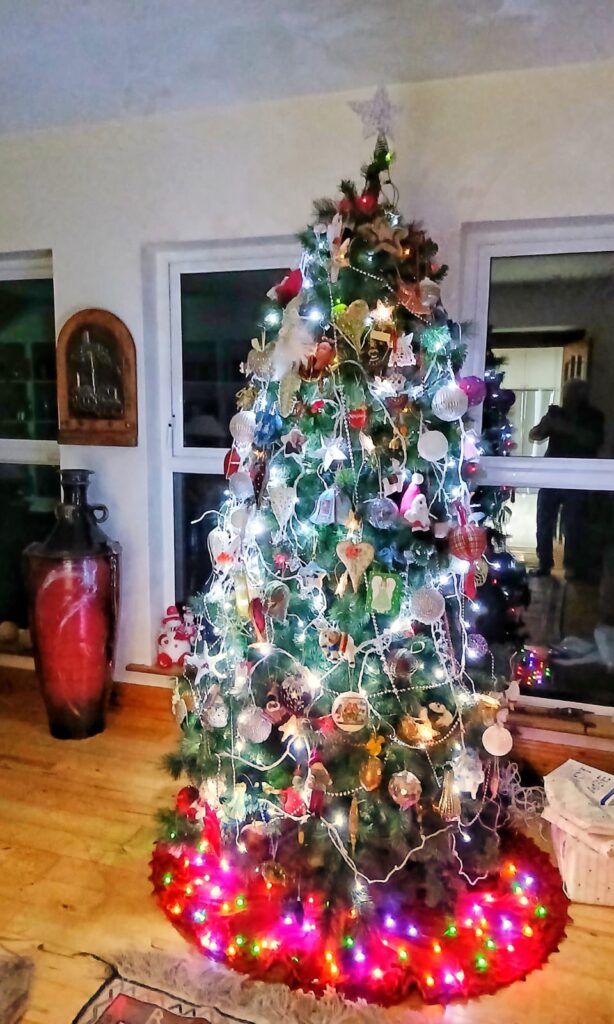
Diaries … how , where , why ?
My oldest son has given me a book for Christmas titled “Dad I want to HEAR YOUR STORY ”which is a blank journal which you work your way through and write down your life for reading afterwards by the family to chorus’s I presume of wasen’t he grand ?
But what goes into a diary , is it the unvarnished warts and all or is the mind numbingly boring bland version … I am going for the cover the children’s ears version !
Back in 1994 the Irish Customs Journal asked me to write a series of articles for their monthly magazine , nine in all to be called My Early Life in Customs .
My first article was published and all hell broke loose with lots of colleagues feeling a bit maligned and one former boss ,then retired , actually sued the magazine and myself jointly for 20,000 pounds in damages . The magazine flew me back from Macedonia for an interview with their lawyers to see how my anecdote / story would stand up in court to cross examination … they decided that there was no malice intended and in fact the piece was meant as an affectionate look back at a boss who was quite brutal to work under but who always had your back … so the case would be fought .
Needless to say after that bruising encounter the magazine decided that the remaining eight unpublished articles on my Early Life in Customs would remain just that … unpublished !!

Funnily enough one of my former colleagues who had now risen to be the Irish Revenue Commissioner rang me to say he loved the piece about himself where I described him as a swordsman supreme which he claimed had given him new status among the female clerk typists in Dublin Castle who no longer regarded him as a boringly safe auld fellow !
Colour in the Garden in December
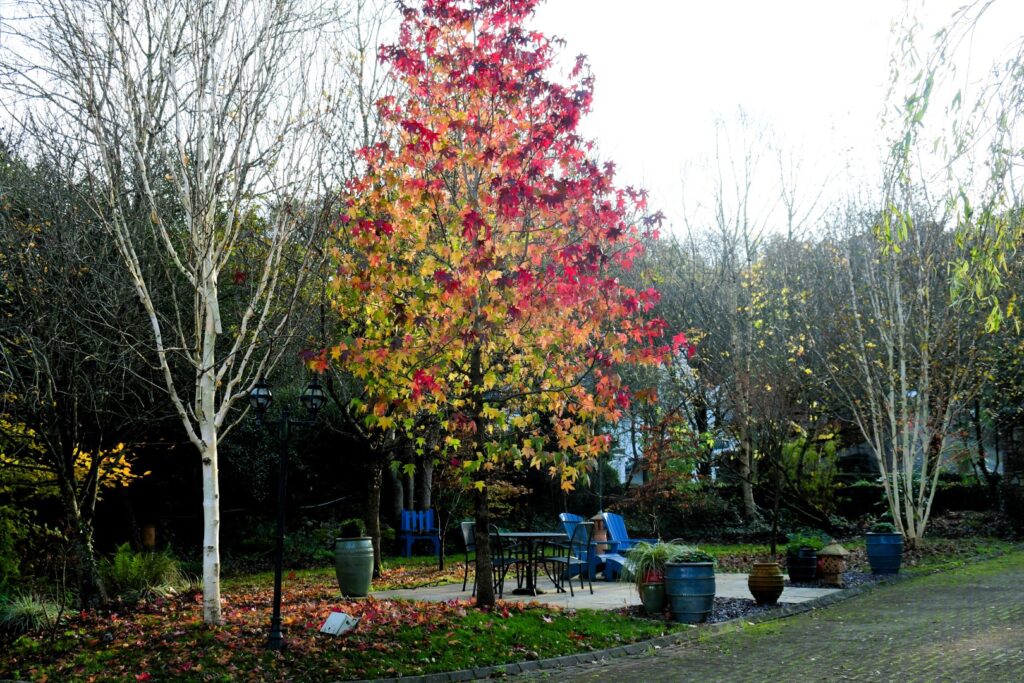
December though sees the shortest day of the year on the 21st and from now on it is onwards and upwards to longer evenings and new growth and from January , batteries recharged we are all ready to go again … Happy New Year to everyone or as they say in my favourite place , the Former Yugoslavia … Sretna Nova Godina !
January 2025 … awful month of snow and storms and the title of the January blog says it all !
My Gardening Month January 2025 … Dear God let January end please !
One of the worst January’s I remember here in the garden .
The first month of 2025 in the garden was dominated by a week of heavy snow which covered a layer of thick ice and made walking treacherous and for the first time ever we had to dig the car out of the driveway .
January started with a bang across Ireland with heavy snow that lodged and as usual as a Nation we get pretty pathetic about an event that happens only once every ten years or so and for which we always seem totally unprepared for and where the country grinds to a halt for the first day or so .
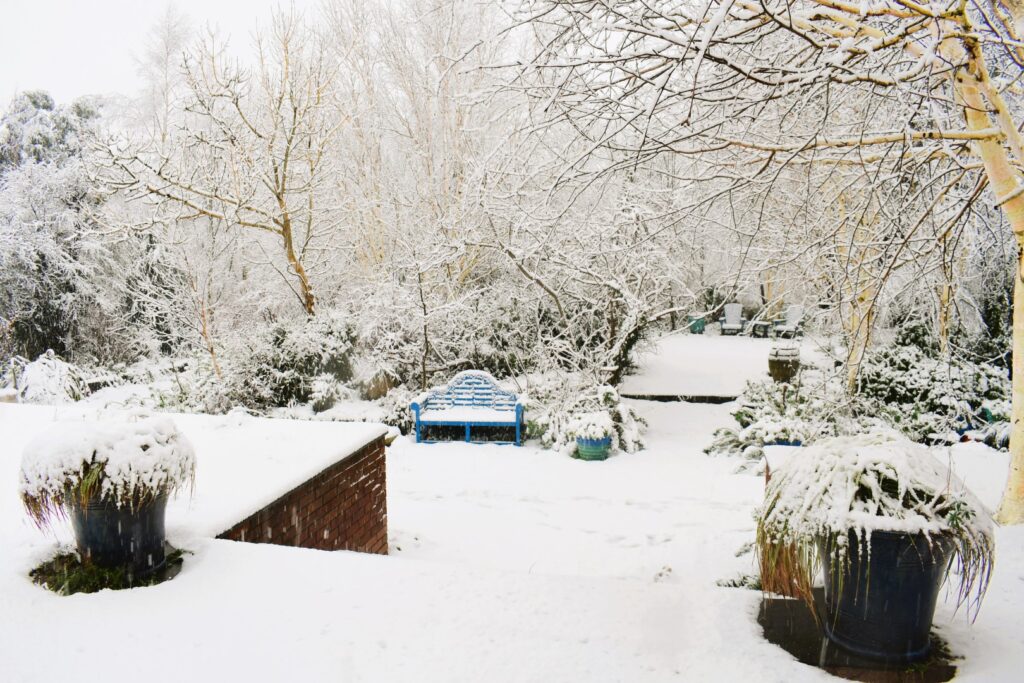
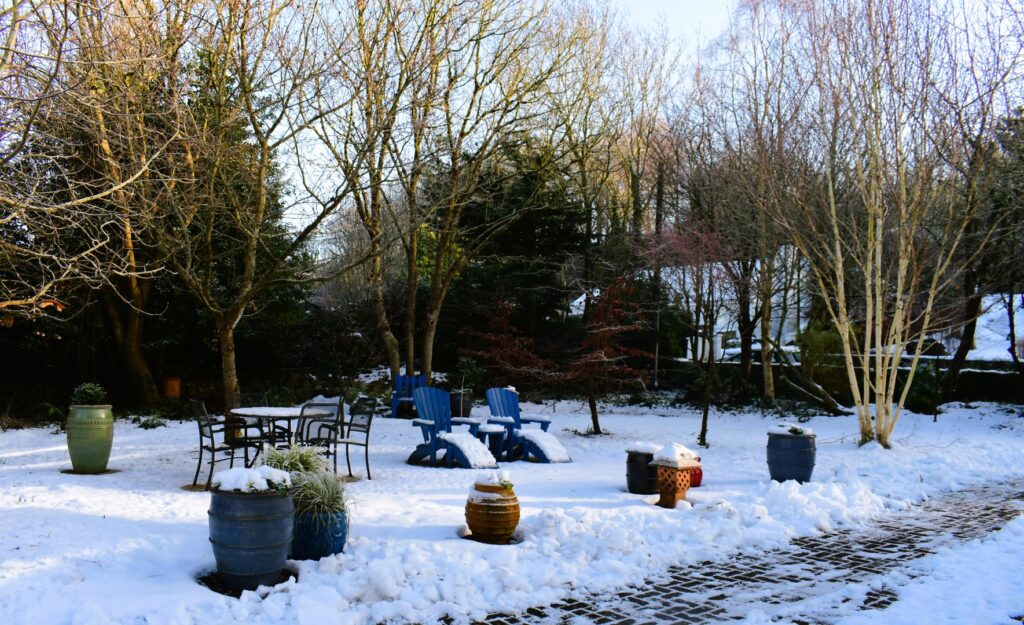

The early January snow was followed by Storm Eowyn , the worst storm to hit Ireland in over 100 years with hurricane winds , status red warning across the entire country which left 800, 000 without power and huge damage .
Luckily Clonmel avoided the worst of the winds and we came through relatively lightly in the garden , branches of trees down of course but no major damage … but glad to see the end of this January .
I spent twelve years in the Balkans 1994 to 2006 which meant twelve years of snow from December right through each year to March but the houses were super heated and the roads well gritted and well maintained with snow ploughs and never once was I stuck in snow or unable to complete a journey … all cars were fitted with winter tyres and accidents were rare and it also helped that I was driving Nissan Patrols .
My regular weekly drive in Bosnia for eight years was from Brcko to Sarajevo which would normally take three and a half hours and in snow this would sometimes take five hours especially in January but the journey I dreaded was once a month to Bihac from Sarajevo which normally took six hours but in winter this stretched to nine hours .
Sometimes snow was not the problem in Bosnia on my trips as this report from my Office Diary for January 2003 shows
“I was targeted by nationalistic hard line serbs unhappy with a multi ethnic recruitment policy I was pushing in a customs administration in Brcko , NE Bosnia where they thought I was bringing back too many muslims … in this instance they loosened the nuts on a back wheel of my Nissan Patrol as I was on my way to a meeting in Sarajevo , a three hour journey over the mountains in early January in snow and ice conditions … the wheel came off on the return journey and the vehicle only stopped two metres from the edge of a ravine at nine o clock at night ….”
Twenty two years ago this month and I can remember it clearly , 9 pm , heavy snow , no traffic and on my own , one moment driving down the mountain into Tuzla when suddenly a wheel came past my window on the left hand side bouncing high as a house and I remember distinctly thinking some poor guy has lost a wheel when suddenly the Nissan Patrol lurched heavily to the left and went down on my side and I have no steering and the vehicle is sliding across the road with me just hanging on tightly to the steering wheel , huge tearing noise and then it stopped … the strange thing is I kept an eye on the bouncing runaway wheel until it veered suddenly off the road to the left and vanished .
I got out of the vehicle saw that the front left wheel was gone then looked over the edge of the road about 500 feet straight down into a river then got out a fold up hazard sign and walked back up the road about fifty metres and planted it a metre out and as I was walking back to the vehicle a large US Army truck came tearing around the corner and took the sign out !

The garden in January
January is a totally dead month in the garden as the early spring growth hasen’t kicked in yet and this is the perfect time for cleaning brambles out of the shrubberies as with all the leaves gone and with brambles being evergreen they stand out and there is a great satisfaction in just ripping them out … then following up with a spray of round up to get at the perennial weeds like docks , couch grass and my absolute hated weed the creeping buttercup .
I love self seeding plants and shrubs in the garden as it is a seal of approval from nature that you have created the ideal scenario for that particular seed whether carried by birds or by the wind and of course it is a plant for free .
Primula and the common cowslips also self seed here and these are terrific plants often coming up year after year
Big self seeders with us is hypericum which pops up in woodland and on a regular basis each Spring I pot up the seedlings and grow them on until the following November when I plant them out .The summer flowering pampas grass rickardii or Christophe self seeds so prolifically that it has become a pest and these we just dig out and dump .
Primula and the common cowslips also self seed here and these are terrific plants often coming up year after year . This one is a hybrid and these normally don’t set seed but this escaped from a pot close by and seeded directly into the front drive way .
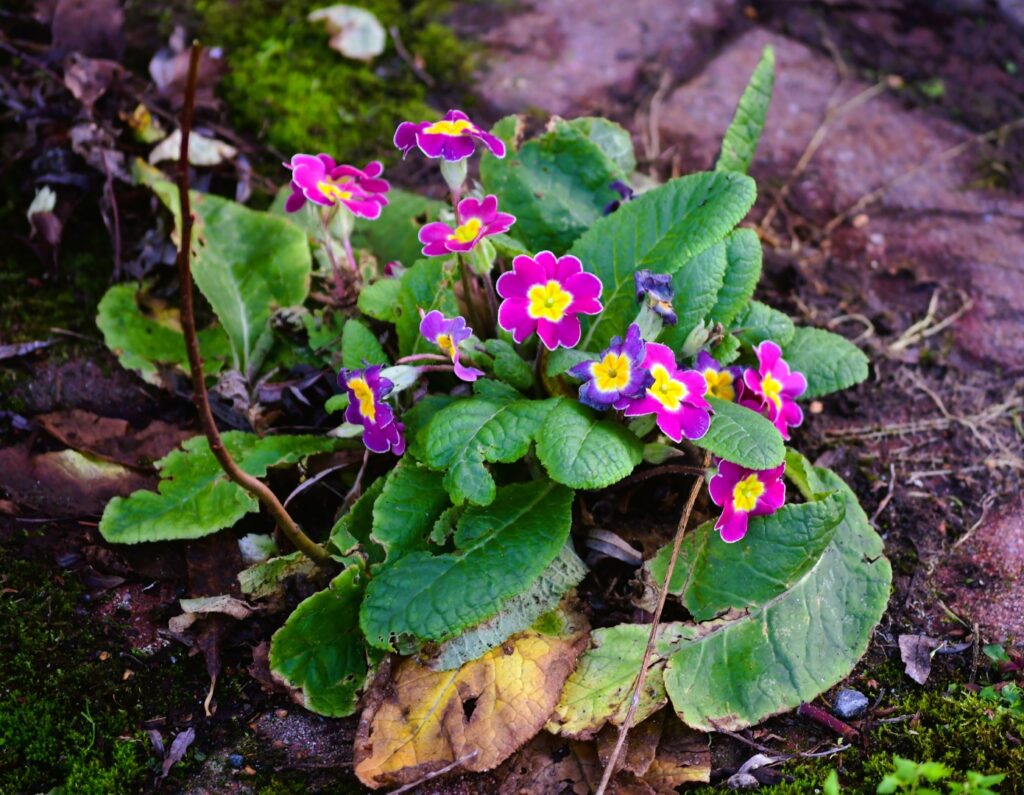
You have to be careful what you wish for though with self seeders as erigeron or flea bane will self seed in gravel ,in concrete cracks and between paving slabs and to day Snezana spent the morning taking wheel barrows of erigeron off the main patio at the back door … a fabulous plant that flowers for six months but when it likes a place it goes crazy .
January is the start of the clean up for the coming year and I give the garden pots a good topping up of compost as the soil always shrinks back and then those pots close to the house I also finish off with new gravel such as this group of eleven pots which are used only for hostas … always check under pots used for growing hostas as snails and slugs use these areas as hiding places waiting to pop out when the new growth begins … one particular dedicated hosta pot had over thirty snails clustered underneath …. A real WTF moment !
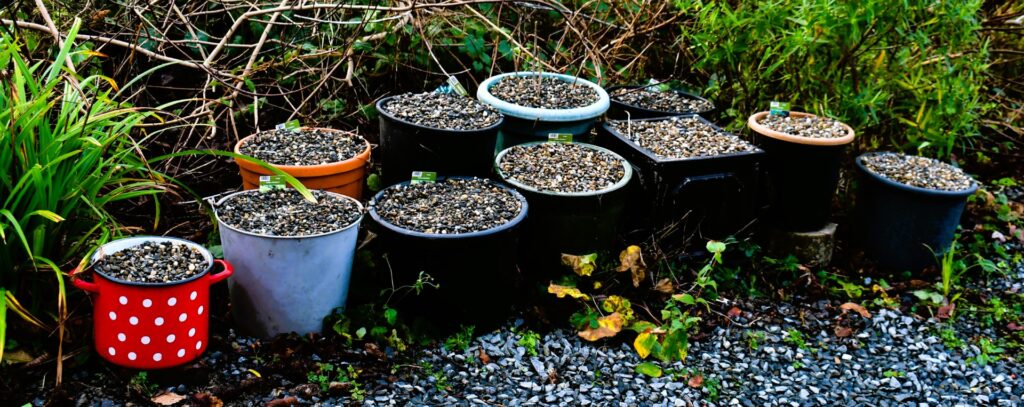
Snezana of course has her own ideas about when to cut back whereas I like to enjoy the sculptural look of the tall miscanthus style grasses until the end of February when their new growth starts and she hates this preferring to scalp everything to the ground as soon as November ends … today she wiped clean an area and thinks it looks great while for me it looks like a bald turkey’s ass !
My absolute favourite Café Bar is run by Karlo Vela in Podgora , right on the beach where we sit outside every morning after our daily swim during our regular visits to Croatia from April to late October enjoying the view out to the islands of Brac and Hvar having our bijela café .
Karlo’s coffee for the last few years is from Vienna , Meinl Coffee , who have been operating since their Vienna Café opened in 1862 and their web site states their long history with coffee dating back to when “ Julius Meinl opened a new coffee roasting plant on the site where the retreating Ottoman army left behind sacks of green coffee over 300 years before. Since then, 5 generations of the Meinl family have been supplying customers with the world’s leading coffees. For 160 years Julius Meinl has been a leading European coffee company ”.
Back in 1995 when working in Macedonia the EU sent me on a two week computer course in Vienna where I used to have a coffee every day in the Meinl coffee shop and I loved the coffee and their history so much I bought a commemorative tin which I use to this day to store our house coffee .
The Meinl distictive red logo shows an Ottoman hat which marks the defeat of the Ottoman armies outside Vienna on September 11th 1683 , a major defeat and the end of the Ottoman empire in Europe … this Muslim defeat was the reason Al Queda picked September 11th for their attack on the Twin Towers in 2001 .

Last summer Karlo was supplied along with his regular coffee supplies some promotional Meinl coffee cups which I loved …these are not on sale anywhere but he must have seen how longingly I looked at them because at the end of the summer he presented Snezana with two Meinl cups and saucers !
I was on Brac Island in September when I came across a café that served Meinl coffee and guess what they had a Meinl flower pot outside on the pier … guess what I want for next Christmas !

I love souvenirs that remind me of a favourite place and each morning with my coffee I am transported back to the summer on the Adriatic as I sip from my Meinl cup .
Talk about contrasts !
Sunrise on Bol Beach , Brac Island , September 2025
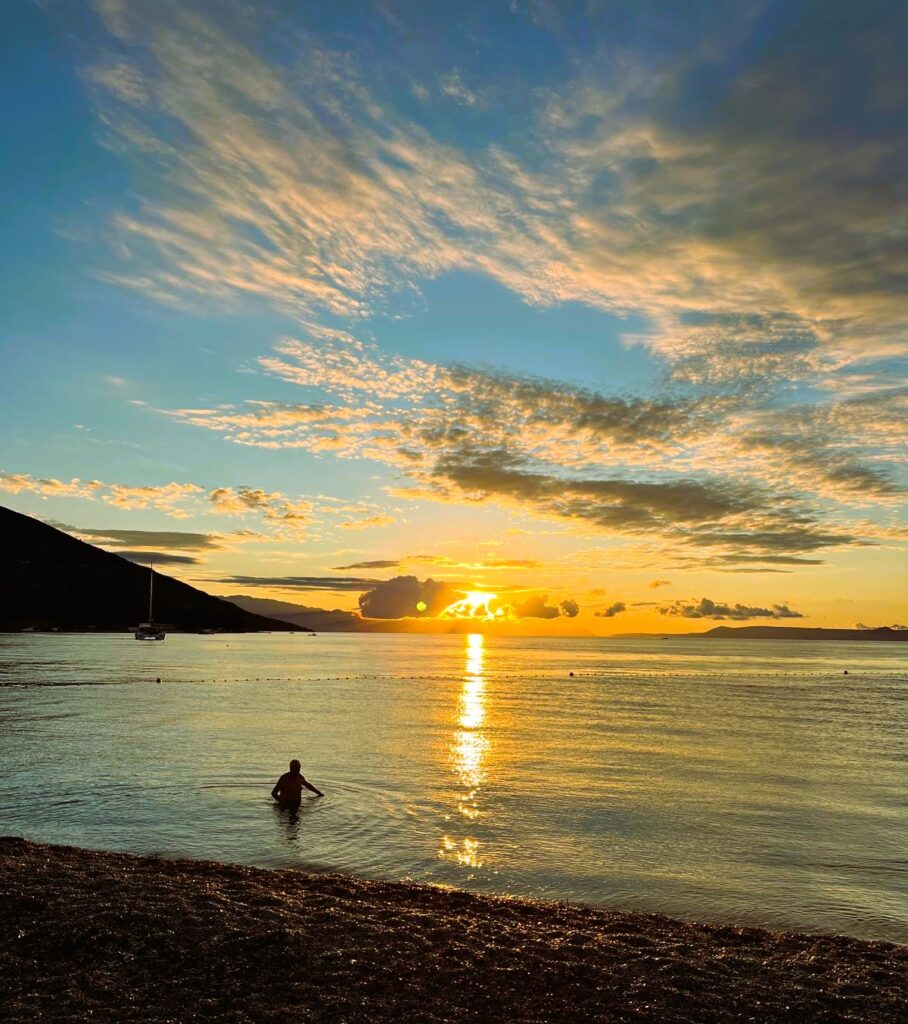
For the last few years we have spent a few days on Brac Island in October and each morning we swim at sunrise off Bol Beach just as the sun rises out of the Adriatic Sea … and yes I know how goody goody pretentious that last sentence reads !
Winter showers in the Garden
We take a shower every day throughout the year under an outside shower in the Garden … always cold but never colder than when there is snow ! The usual question when visitors to the garden see the outside shower has always been “ Is it heated ” … !

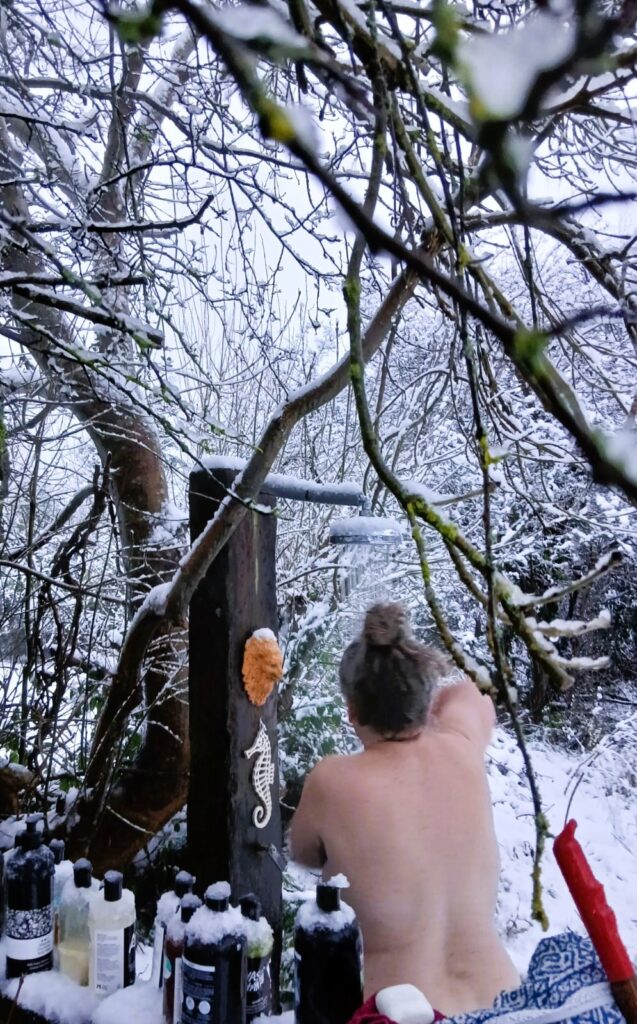
What lifts the garden , any garden , in winter is the white bark of the silver birch and these are the backbone of all our winter colour but here I must be specific and say that the multi stemmed silver birch jacquemontii are striking , almost luminous in the low light of January … multi stemmed costs a bit more but are worth it as the common silver birch gets too leggy over time unless you keep it under control almost from the time you plant one .

Bad and all as January was it ended with some good weather that managed to convince us that Spring was just around the corner and our first snow drops flowered on 15th January …. Galanthus Woronowii which comes from Turkey originally … I bought it as a packet of bulbs last year not as nice in my opinion as the common snowdrop nivalis although the flowers are similar as the leaves are short and stubby but it looks strong and I will divide it in a few weeks time after flowering .
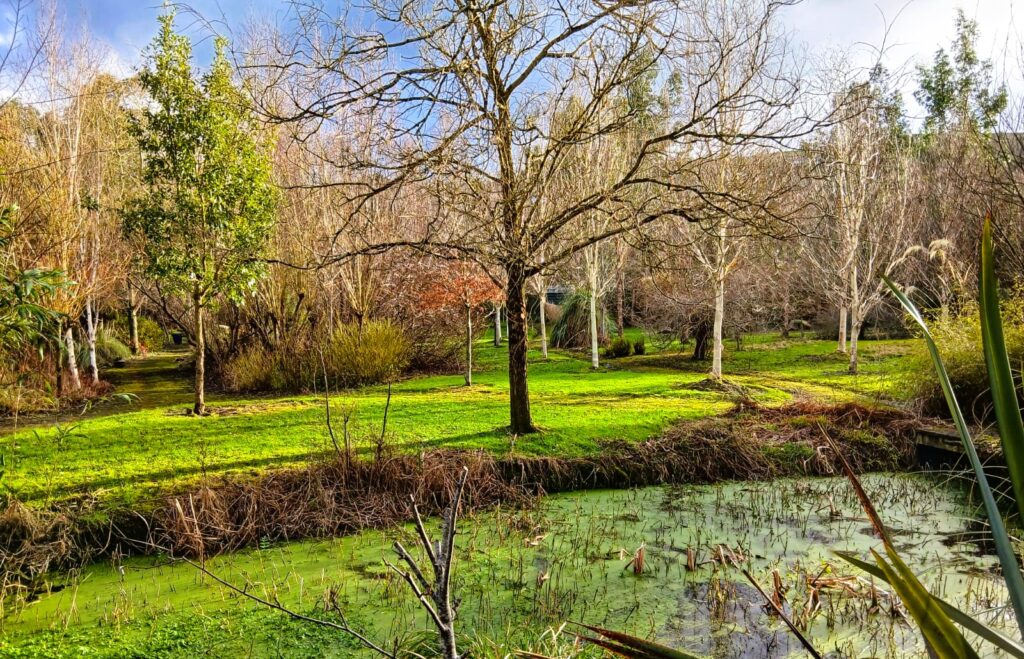

Mexico February 2025
Snezana was in Portugal with her parents for most of February so I thought I would do something different with my time alone and as my eldest son , Kevin , has been posted to Mexico for the past three years and is leaving this year so I thought February would be a good month to visit him when it would not be so hot .

Since childhood I have been reading about the Olmec , Maya and the Aztecs so it was a bucket list destination for over fifty years … it did not disappoint !

Mexico City where I was based for the first week is on a high plateau at 7000 feet surrounded by many extinct volcanoes which you can see quite plainly as you fly in and Kev who is a frequent flier throughout Central America for work is not a fan of either flying generally or this particular flight path said through gritted teeth as we landed from a trip down to Yucatan “ I hate flying in Central America it is full of f..king volcanos ” … I am not a fan of flying either so said remark did nothing for the nerves !

What did I expect or know about Mexico before my trip … well the obvious history from my previous reading about the Aztecs, the Maya and their conquest and destruction by the Spanish in 1521, the bandit Pancho Villa , the 1940’s painters Frida Kahlo and Diego Rivera but mainly of course the modern drug cartels and how dangerous Mexico was for the tourist and locals alike and how likely I was to be accosted on the buses or streets and robbed at gun point .

Well luckily none of that happened and I was met with nothing but kindness from the Mexican people I met be it looking for directions on the street or in shops and it was a lovely experience for me .
The food and music was terrific of course as was the Mexican love of dancing and I came home knowing how to fill a taco , mix the spices and sauce and a liking for a margarita made with mescal not your common tequila and mariachi music is firmly on my Spotify playlist !

During the trip we also flew down to the Yucatan area basing ourselves in Merida to take in the historical Mayan sites for which Yucatan is famous for … the landscape is as flat as a pancake hot and humid with wall to wall jungle and clearings made for large towns and villages .
Although I had been warned about Mexican tummy and that street food and salads were problematic but after a meal with a local family in the jungle in Yucatan with only local water and where the produce was cooked over an open stove with pet racoons and iguanas running around we stopped being so western and finnicky and ate everything they served up .

High points of the trip ?
Obviously the pyramids outside Mexico City and the Mayan sites of Chichen Izla and Uxmal in Yucatan then the marvellous Frida Kahlo House and Museum in Mexico City where the iconic artist lived all her life and which is so popular you have to book six weeks in advance … thanks Kev !

I first heard about Frida Kahlo when Madonna bought a painting of hers for a million dollars in 1990 and was hooked on her unique art and sense of style , her partnership with Diego Rivera and how though crippled by pain from a car accident she lived life to the full “ they cut off my leg but I have wings so I can fly ” and here I was thirty five years later walking through her house and garden … in the bedroom where she died I was admiring an original thousand year old Toltec vase on her dressing table to be told that this contained her ashes .



I loved the little details scattered throughout Frida Kahlo’s garden at Saint Angel , Mexico City such as the original little 9th century Mayan head and her use of colour especially mirrored the Jacques Majorelle in Marakesh , Morocco .

The Anthropology Museum in Mexico City , the best outdoor museum in the world, was so good that I visited it three times and I am sure even then there are things I missed .

What I made sure I didn’t miss at the museum were the Olmec Stone Heads from 1350 BC


The jade funeral Mask of Kamal Kin, Mayan King of Palenque , 650 AD

The 13th century AD Aztec Stone Calender

The Mayan Cities of Chichen Izla and Uxmal in Yutacan are world famous


Mexico is a catholic country however more than any country it is catholicism mixed with the native ancient religion where the people have retained the old traditions of the spirit world and wisely the Church has from the beginning accepted that these traditions are impossible to break and for example there are catholic priests who also are shamens and conduct the older rites … it is not unusual to see people on the street being cleansed by all over body smoke and young girls on their fifteenth birthday are given a small plaque of the earth mother usually made from a semi precious metal such as obsidian which they carry throughout their life


Yucatan is famous for it’s many cenotes which are huge underground deep fresh water wells caused by meteorites hitting the area millions of years ago and these were regarded as sacred doorways to the underworld by the Mayas where they threw in gold and human sacrifices to the gods … some of the most famous cenotes are open to the public and you can swim in them … years ago I had read about them and I remember photos of crocodiles lazing around the edges … crocodiles ? … we were assured there were no crocodiles in the one we visited … well we did swim …. nervously !!

I must admit I wasen’t exactly over the moon at the thought of getting in but having watched Kev brave it I went for it … while an experience definitely up there with the best it still was scary enough to be there !

The Day of the Dead “ Día de Muertos ” with it’s reverence for the departed is huge in Mexico with decorative skulls and special dolls called La Caterina on sale everywhere and while in most of the world it is celebrated at Halloween , in Mexico it is a year round thing and at first I was a bit taken aback with the skeletons and skulls but when it was explained that actually it is a special remembrance for your deceased loved ones I really liked it, to the degree that I bought a very nice Caterina in the Saint Angel district of Mexico City to bring home to Ireland in memory of my Mam .

In Merida I fell in love with a hand carved cedarwood life size head of the Palenque Mayan King , Kamal Kin … the original is in jade and dates from 650 AD and is on display in the Anthropological Museum in Mexico City … after some haggling in the shop my cedarwood version came back safe in hand luggage !

Anyone who knows anything even vaguely about the Mayas or the Aztecs has heard about the human sacrifices they were partial to where the heart is ripped out of a living body by a knife wielding blood stained priest at the top of their temples and the body is then rolled down the steps… sometimes as many as 20,000 male prisoners at a time were sacrificed and these were chosen from the losers of a ball game which was decided by whoever knocked a ball the size of a modern football through a stone hoop set at about ten feet above what was known as the Ball Court … only a strike of the ball using the hips or the shoulders counted … not easy and I think even a Ronaldo would struggle to have that accuracy !

Now for something less blood thirsty … while in Yutacan and as a diversion from Mayan sites … well OK there may have been some words exchanged along the lines of no more f..king archaeological sites Dad … we took a boat trip on the Gulf of Mexico to Celestun where we saw the famous pink flamingos of Celestun … a lovely unspoiled part of the Yucatan peninsula with few foreign tourists unlike it’s more famous cousins down the road at Cancun and Tullum which are over run with US visitors and is more like Florida than Mexico .

Mexico is a mix of extremely wealthy and god awful poverty especially in Yucatan where the bulk of the original Maya population live and driving through these areas I feel there really is no hope or escape for these people in this life … like all indigenous people shoved off their land by invading “ superior ” civilisations such as the North American Indians or the Aboriginal people of Australia, they end up marginalised and ignored .

We were in Izamal , a small town in Yucatan to visit and climb the Mayan Temple to the Sun God and everything about the place was dismal and mean looking and I remember thinking how awful it would be to be brought up in such a place when suddenly a man on horseback trotted down the street and it just about summed up the town for me .
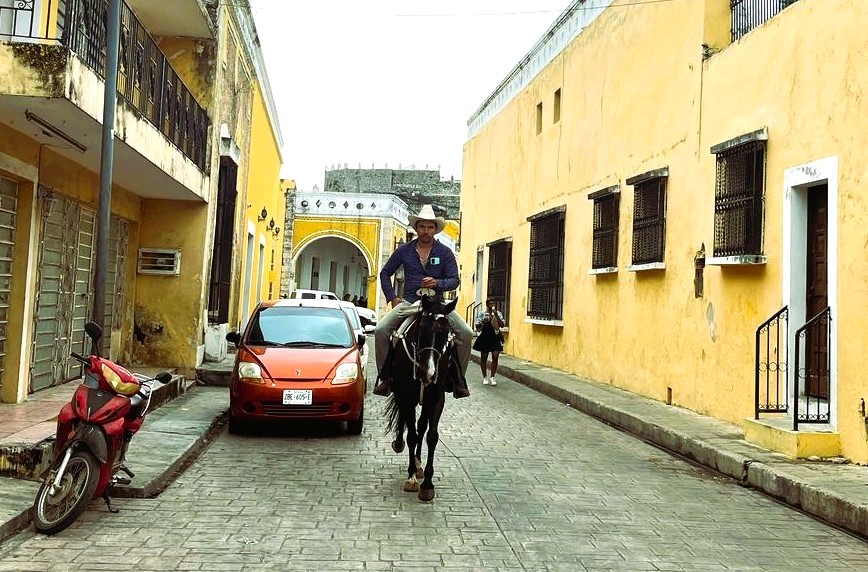
Two weeks is not enough to get more than a pen picture of a country but I came back from Mexico with only positive memories … now I need to read up more on the culture for my next visit !

March 2025
Last year in Croatia I saw a neighbour pruning his olive trees with a battery operated little hand saw … back in Clonmel Pat Cleere supplied me with a Stihl unit and I can honestly say it is the best piece of kit since the sliced pan and cuts effortlessly through those large thumb size branches that up to now I needed an old fashioned large hand saw for … usually I got Snezana to follow me around with the battery powered chainsaw when I was hard pruning the willows but it was a real pain for both of us as she hated being dictated to and I hated being dependant on her for the use of the chainsaw and this way I can plough away through the spring pruning at my own pace … it has transformed my pruning … and it would also be perfect for anyone with difficulty using normal secateurs where some force is required … a delicate way of saying that age diminishes our strength and arthritis is calling !
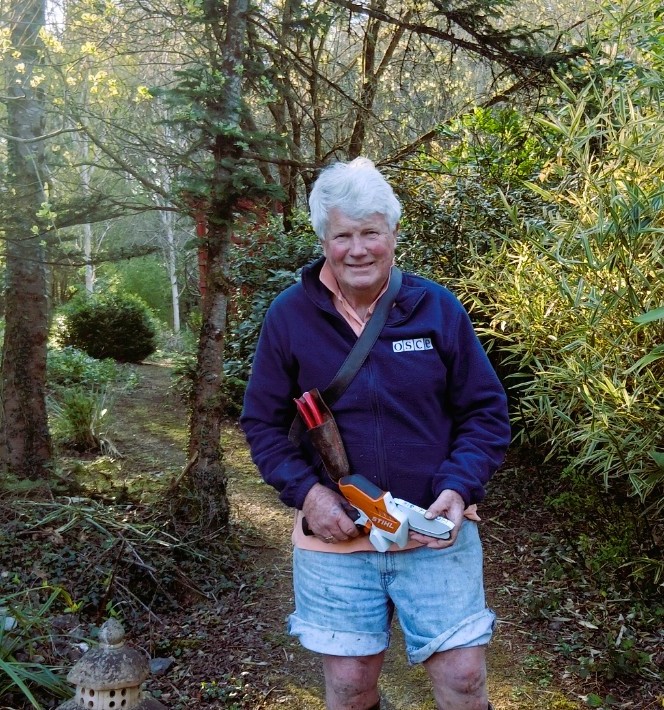
Rules sometimes are meant to be broken and the gardening rule is to replicate nature and plant in uneven numbers and of course five silver birch would have been better in the raised planting area outside the back door however the space just wasen’t there and while three trees would have fitted the rule but four looked great !
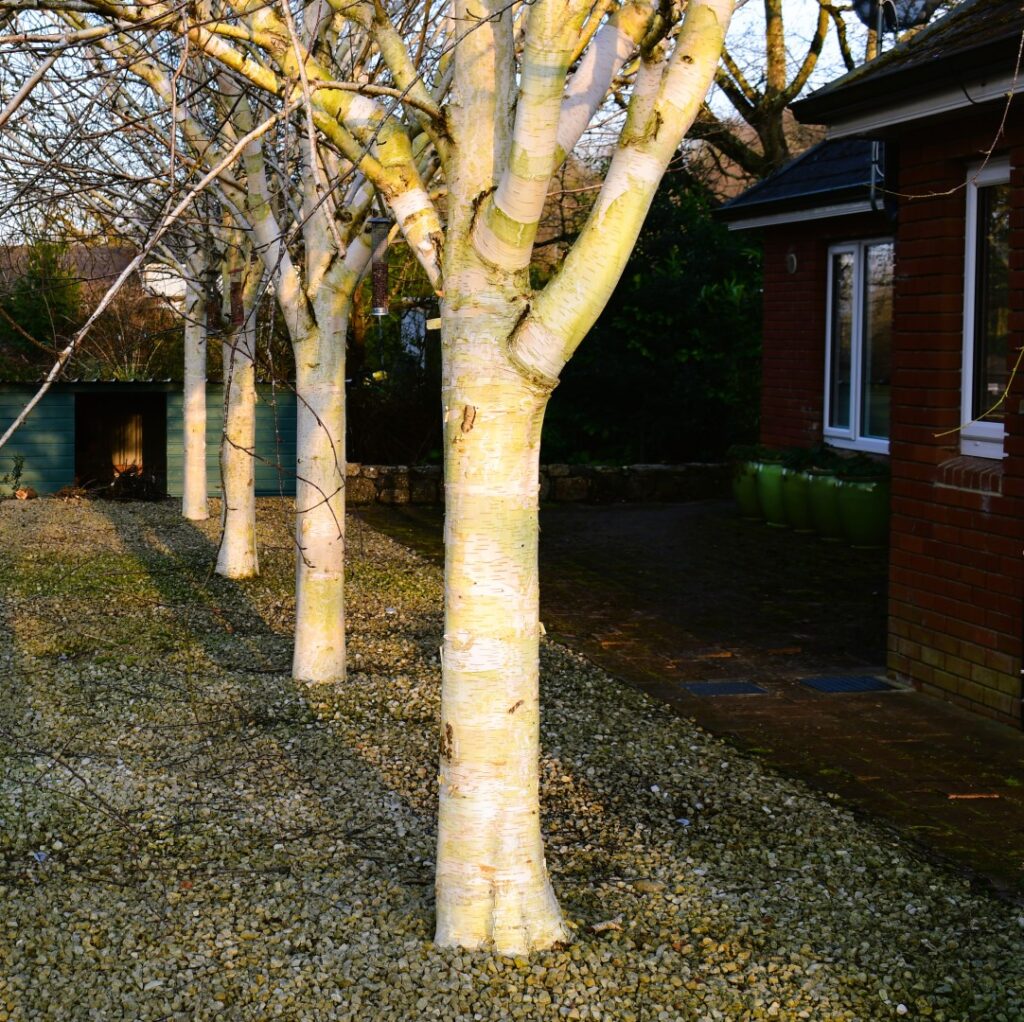
This winter here was dark and gloomy and the silver birch never looked better as they lift up the darkest space and while the variety jacquemontii is expensive , it does what it says on the tin and is a magnificent show stopper .
Mary Skelly who owned the Kilcoran Garden Centre retired and sold up last September and will be sadly missed for her selection of well maintained plants . Mary was a proper plants woman who always maintained a marvellous selection across the seasons and I know the local gardening community will wish her well in retirement .
A new company bought Mary’s garden centre , closed it for three months and reopened in February after extensive renovations in every area with new structures and additions over the entire site and we paid our first visit last week .
No doubt it is modern with proper heating and mostly all areas are covered in from the elements and you can shop and browse in comfort through a huge selection of neo antique furniture and accessories for the house and garden .
However modern whether one likes it or not garden centres are now lifestyle stores with the addition of plants and it is a sign of the times that people are less interested in plants and actual gardening .
I found my walk around depressing and for the first time in my life I came away from a garden centre without buying anything however as Snezana pointed out normally there would be six or seven people shopping there when Mary was the owner now there was over a hundred shopping yesterday and the expanded car park was full .
New pots
We have enough pots in the garden already but when some exceptional ones become available well we always have room although generally now any new pots have to be large statement types and in March Clonmel Garden Centre got in some really nice ones from Shanghai that looked very similar to the clay rice wine pots we saw last November during our visit to the Jinfeng Winery in Shanghai and both their size and colour looked great .
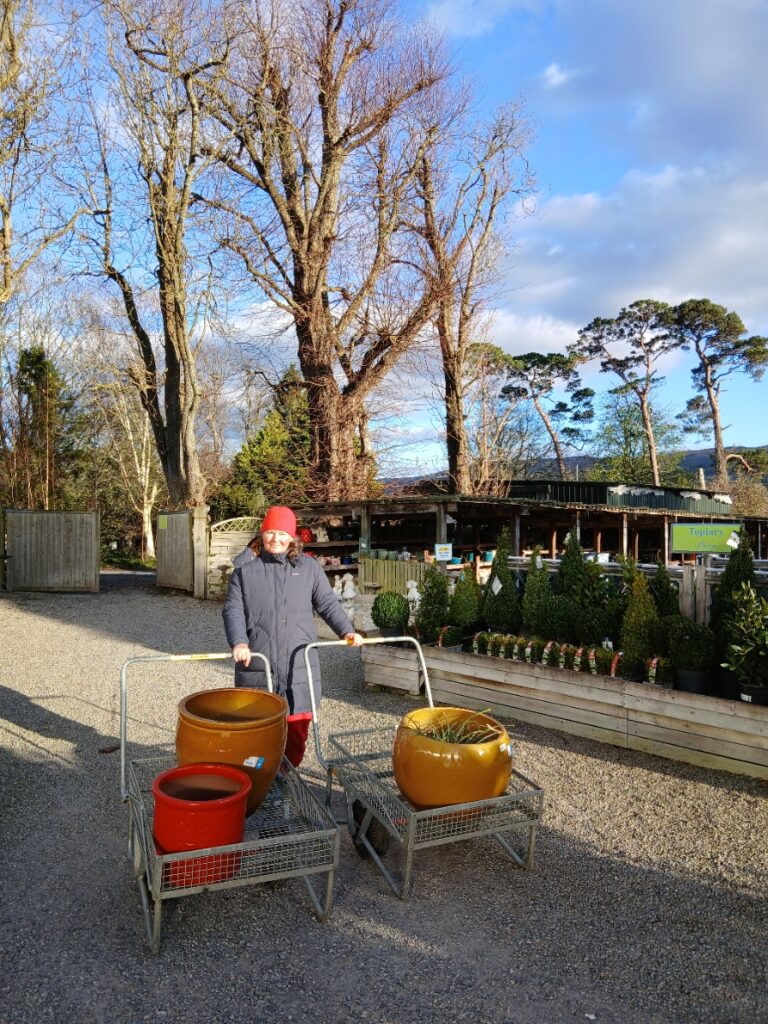
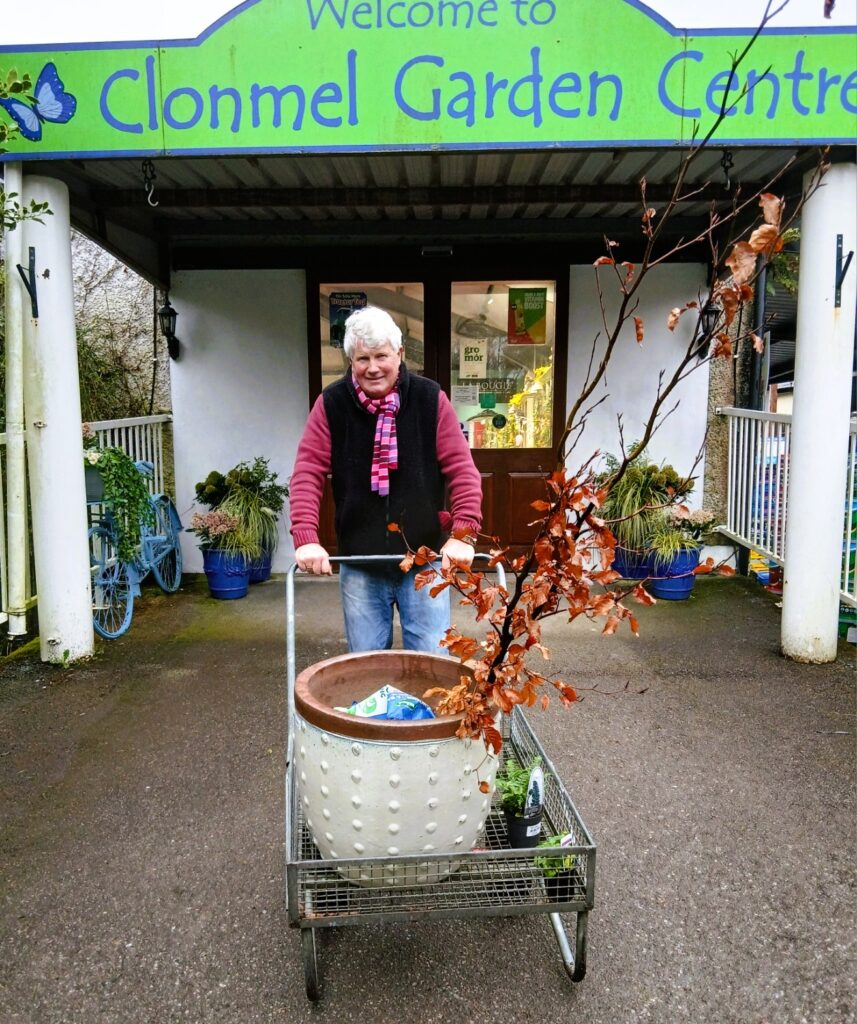
I wrote about these rice wine pots in November “Some gorgeous garden statues and ornaments to die for that would do very well in the garden here and as for pots well we were in a winery outside Shanghai called Jinfeng Wine that is famous throughout Asia for rice wine and they ship it in hand made clay pots about a metre high which are then brought back to the factory and reused over and over again and we saw one vintage of 2003 … literally thousands of pots waiting in the warehouse to be reused and if these vintage pots were available in Europe they would sell out in hours .”
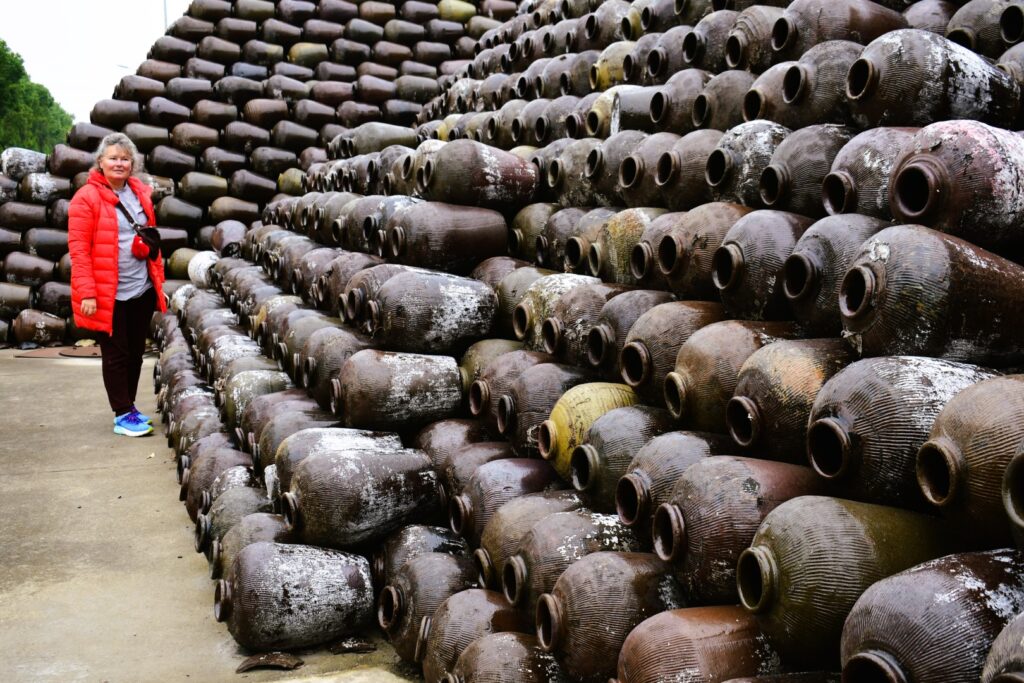
So new pots and first we needed to place the pots in the garden and two places immediately suggested themselves , one was added to a group of four in the new patio area of the front garden and the other two were added to a single large pot in the immediate back garden . Filling them took a lot of earth and as usual I dig out / renew the edges of the paths in the Lower Field and use this which is heavy clayed soil and perfect for filling before topping up with good compost … digging out the path edges also helps with the drainage as the surface water is channelled into this and runs off .
I planted the new pots up in full sun positions with what will be their main plants , all evergreen … bergenias , geranium biokovo and geranium nudosum all of which I had growing on here from cuttings last October and then added some ferns and sedums for growth around the base of the feature plants , topping each of the pots off with pea gravel for a nice finish which will also help with drainage and keep weeds down … later in May I will tuck in bedding annuals such as white allysum , blue lobelis and some nasturtiums which I love for their foliage and trailing habit … with big pots like these I no longer use large plants as centre pieces as I like the large pots to dominate and not be taken over by the planting .
Trip to Mexico revisited
I mentioned I had brought home a cedarwood hand carving of the Mayan King of Palenque however I have to be honest and say that I had no clue who the mask represented when I first saw it although I remember when Erich Von Daniken’s book the Chariot of the Gods first came out in 1969 it grabbed the headlines with his claims at what he claimed was a representation of a space ship alien carved on a 7th century sarcophagus of a Mayan King but I was looking through this fabulous four storey shop in Merida which dealt in quality Mayan carpets and hand carved items when I saw this one mask that grabbed my attention immediately , the only one of it’s kind in the shop and asked what it was … to be told that is Kamal Kin , the most famous Mayan King of all and that the original was made of jade in 658 AD and was now in the Anthropology Museum in Mexico City … it looked other worldly and a bit in your face ugly … but I liked it , went away for a day to think about it , knew I loved it , came back to the shop and did a deal … as a bonus when I got it back home Snezana loved it at first sight !

For years before my visit to Mexico last month I have been fascinated by the giant stone Olmec heads discovered in the 1930’s on the Gulf of Mexico near Vera Cruz … weighing about forty tons and fifteen feet tall there have been eighteen stone heads discovered and these date to about 1500 BC …three of these giant heads are in the Anthropology Museum of Mexico City so a great thrill for me to actually get to see these in reality .

Actually these were the first exhibits I went to see in the museum on my first visit , huge and much larger in reality and the more you stood and looked at them ,the more enigmatic and other worldly they appeared but there was a protective guard rail around each head which of course you could step over if you wanted however I have been down that route before in museums especially at the first Tutankhamun exhibition in London back in 1972 and it ends in arrest and ejection from the museum so no go there on that one thank you very much !
However there was one in the garden behind the museum which I thought was terrific in that you could walk right up to it and touch it (when the guards weren’t looking !) and I must have taken over thirty photos of it with me in various selfies until on my last visit I wrapped an arm around it … again when the guard wasen’t looking … and it f..king moved and only then did I realise it was made of heavy duty resin and what I was loving from 1000 BC was actually fake and made in 2024 !!

Chac Mool statues
I have a vague memory of seeing photos off these unusual reclining statues of the Mayan Rain God before I visited from years ago but seeing them close up made a huge impression on me and perhaps it is the uncompromising stare , almost defiant glare really and the fact that the head is turned so awkwardly from the main body … my son Diarm on the Family Whatsapp group immediately declared that’s David , his second older brother when I sent the first photo !


Chac Mool statues were present on most Mayan sites but are almost all now in museums across Mexico … sacrificial victims hearts were left in the little receptacle on the reclining statues so these are no benign deities .
Finally Frida Kahlo’s house where she was born and where she lived all her life made a huge impression on me as it was filled with her clothes , furniture , painting studio , bedroom and even her ashes resting forever on her dressing table in an original two thousand year old Toltec vase .
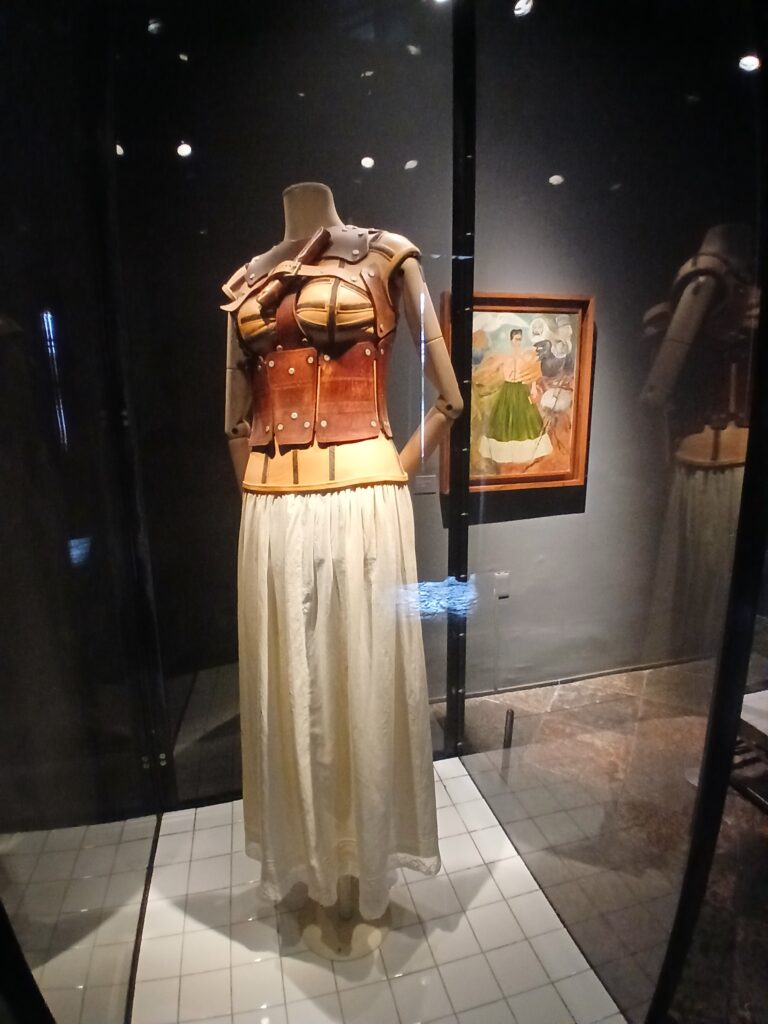
The garden was beautiful and overall the whole impression was so personal you felt you knew here and unlike her portraits which I always felt made her slightly fearsome , looking her house and garden made her seem gentler and vulnerable .
Swimming in a Cenote in the Yucatan
The huge deep fresh water pools are dotted all over Yucatan and were formed millions of years ago by meteorites hitting the earth and they were regarded as sacred by the Mayans who believed them to be gateways to the underworld . A lot of the cenotes are on the surface but the one Kevin and I visited near Chichen Izla was about thirty feet underground and reached by a narrow rickety old iron stairs and quite difficult to access , health and safety are not big deals in the Yucatan and because I still had the image in my memory of crocodiles lurkng around cenotes I was quite happy to take a photo and get back up the stairs however Kev although equally nervous went in for a swim around the stalactites and again I thought OK got the photo been there etc. but I said f..k it I will regret it later f I don’t go in as well … these photos are worth it … plus he would never let me live it down later !
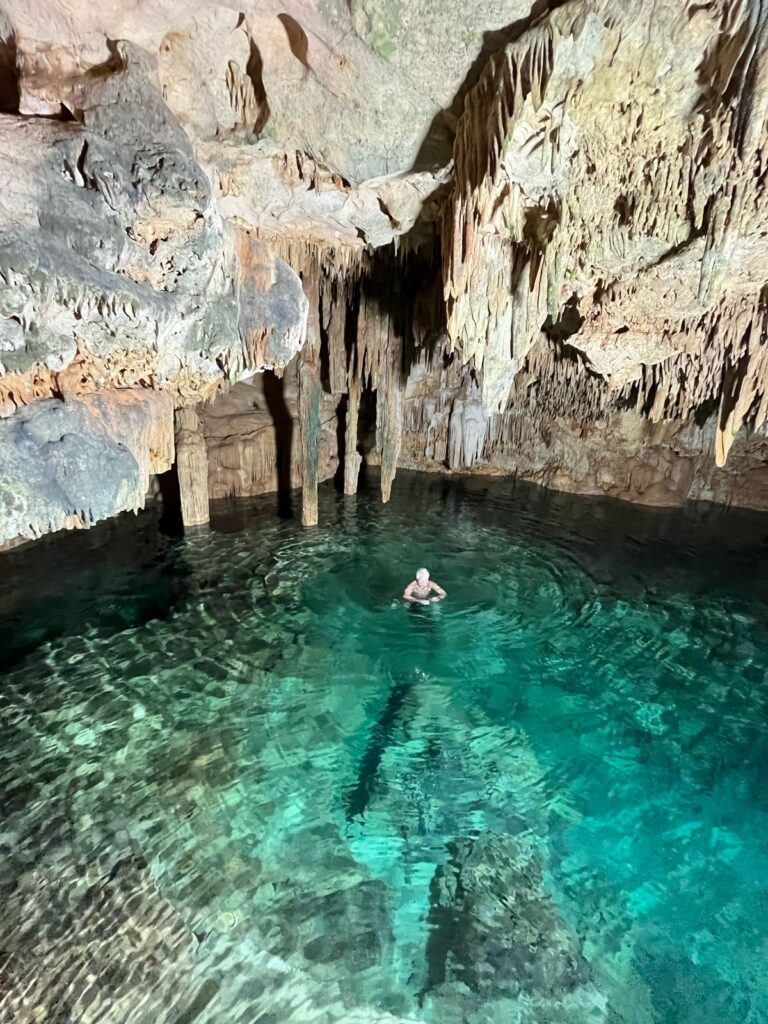
What no Pyramids for a special mention ?
Situated thirty miles outside modern Mexico City despite my huge expectations I found the Pyramids of the Moon and Sun strangely without atmosphere and to me they just sat there , big monolithic structures with no hint of mystery .
The Mayan temples in Yucatan on the other hand were totally different , enigmatic , beautiful and impressive … but visually striking as they are there is no getting away from the fact that these structures throughout their history like the later Aztec structures were also built for human sacrifice and this is the pervading gruesome feeling you get at these sites or so it was for me .
We decided that the front garden on the left hand side needed a makeover but despite various ideas none was a runner so a sharp pruning was decided on and for the past few years I was having second thoughts of the cordylines and thought they were no longer exotic looking … rather that they had got long and leggy so we reduced the height on two off shoots and then thinned out some mountain ash , rhus sumac , that had definitely got leggy … this left more westerly light into the area and maybe we don’t need to do anything else for this year .
Never in my wildest dreams did I think I would ever cut down healthy cordyline trees but gardens mature before you know it and drastic action is required and also taste changes and now the garden demands more light filtering through .
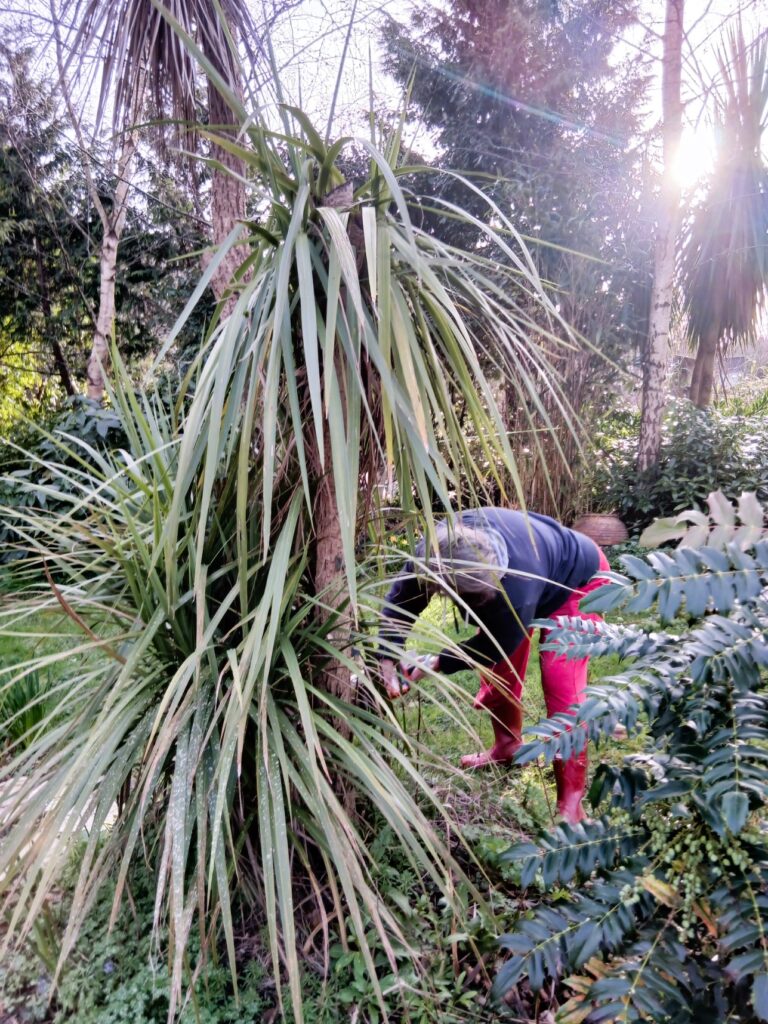
Next day Snezana cleared undergrowth in the immediate back garden and asked about cutting down a mature viburnum shrub … now for some reason she has generally issued a Petrovska fatwa on viburnum over the past few years , positively hates them … but when I looked at the area she had already cleared I could see it would work better if the viburnum went and it would also open up a lovely little grove facing south west which would allow lots of filtered light through the silver birch and be a really nice sheltered place to sit out in … in the meantime it also allowed a perfect site for a lovely acer palmatum atropurpereum we bought last week in Clonmel Garden Centre .
Acer palmatum purpereum is a fabulous Japanese maple tree that will grow slowly to a maximum of two metres high and wide and which has beautiful delicate bluey leaves , a real winner of a small tree that every garden no matter how small should have space for … pricy at 90 euros but worth every penny … needs a little shade and will not do well in full sun , normal soil and most importantly needs shelter from winds that ravage the leaves so is a tree for an established area and will not thrive as a stand alone specimen tree … known as an umbellifier tree which means it does well partially in the shelter of taller trees .
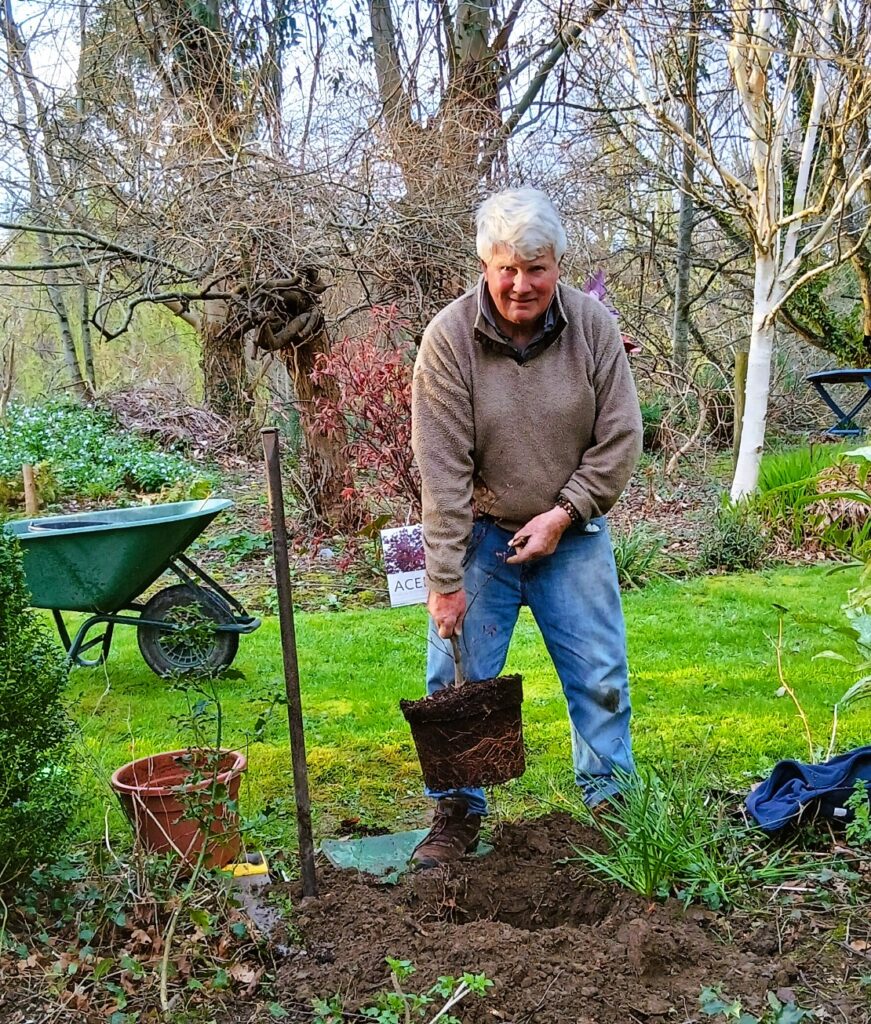
Always a bit of a rush at the end of March to get all bare rooted trees planted and I thought I was finished when Lynda from Clonmel Garden Centre rang to say that they were selling off some two metres high beeches and oak bare rooted at half price to save themselves potting them up and was I interested … I was there just after Lynda put the phone down and came away with ten beech and eight oak … never look a bargain or a gift horse in the mouth !
I hadn’t any particular planting places in mind so had a lovely day strolling around in the Lower Field and woodland area with a wheel barrow full of trees asking myself would this spot be enhanced with an oak or a beech tree and found homes and suitable soil areas for all eighteen trees .
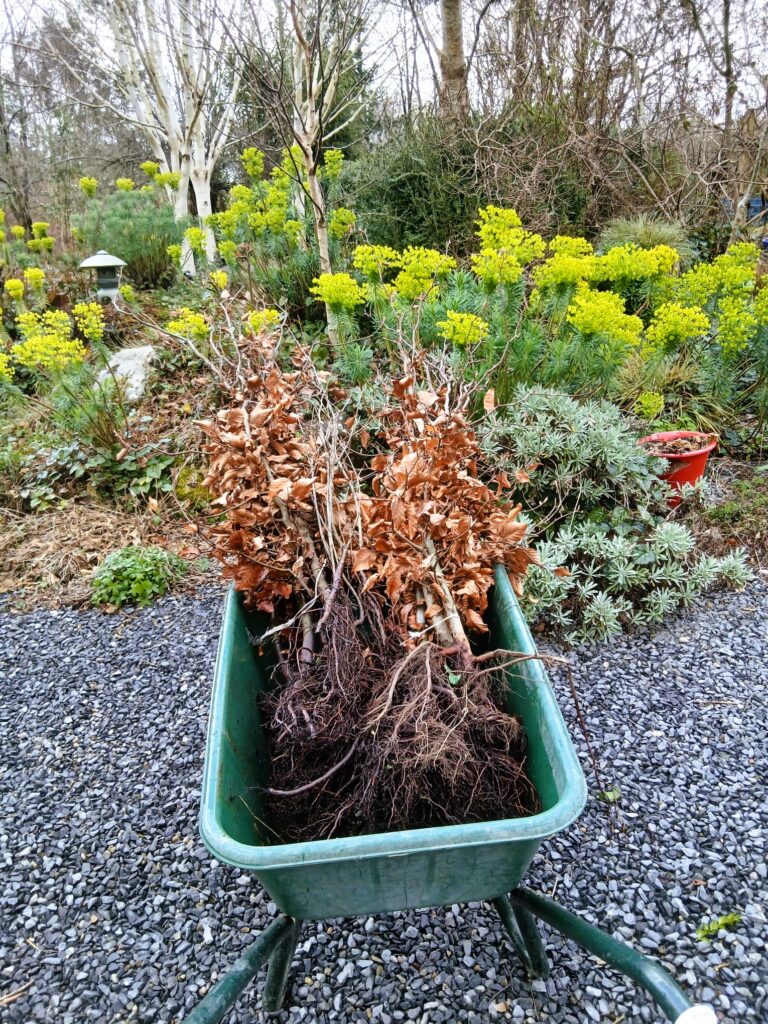
That is one of the rewards of gardening , a nice day strolling around , a few choice trees to plant and all day to do it !
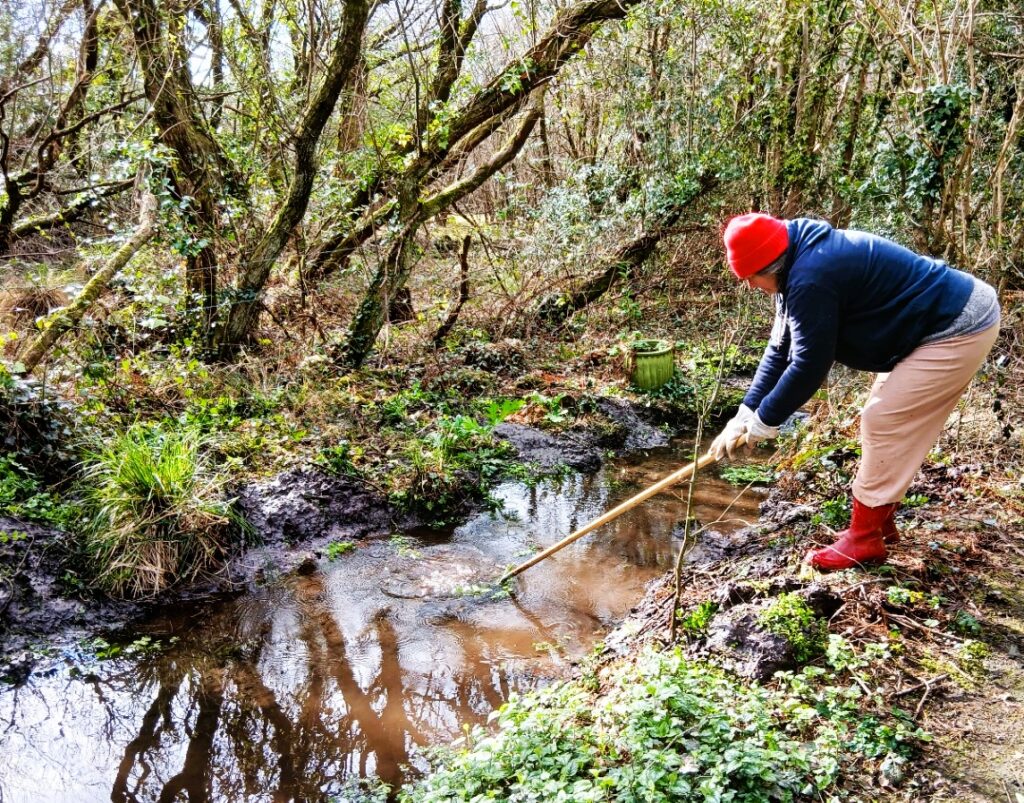
March sees some beautiful wild flowering plants in the garden here especially those that like water such as my three particular favourites , the marsh marigold or Caltha and the tiny lesser celandine .
The marsh marigold or Caltha palustris is an evergreen waterside plant widely available in garden centres but often overlooked and is easily split every year after flowering and I have spread it throughout the garden where it increases and flower every year … a really worthwhile plant that I love .
The Lesser Celandine is a totally wild plant that chooses damp places to self seed to a point that some people regard it as an invasive weed … not by me and I regard it as essential and love to see it popping up in new places and even in pots … it flowers in March with little dandelion like flowers over a creeping mass of delicate green leaves and then vanishes completely back into the ground for another year .
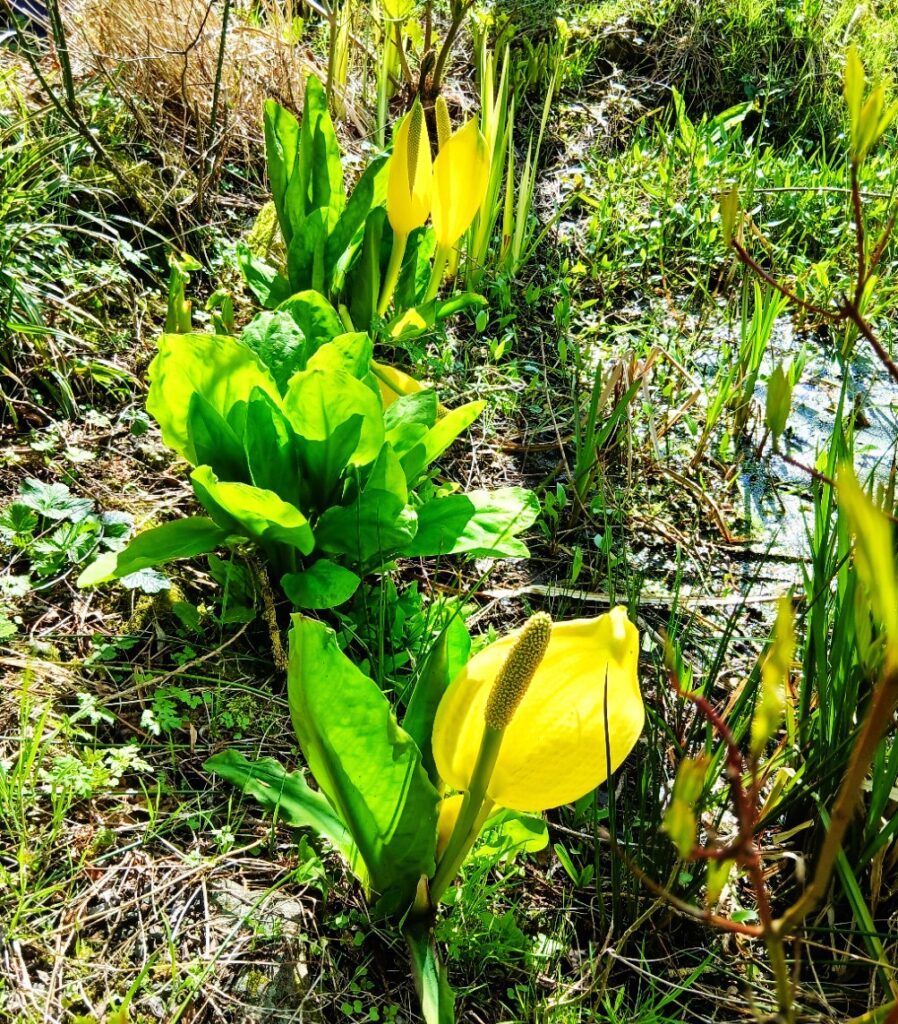
When you come across a clump of the American skunk cabbage, lysichiton americanus , in bloom in March it knocks you back such is the impact of it’s big yellow flowers … it is highly invasive in it’s native habitat among the rivers and swamps of the East Coast of America but here it rarely throws off self seedings which is a pity as the lovely flowers are followed by dramatic big paddle like leaves and I grow it for the leaves as the flowers are short lived lasting ten days at most but then the leaves kick in for a few months … a fabulous perennial .
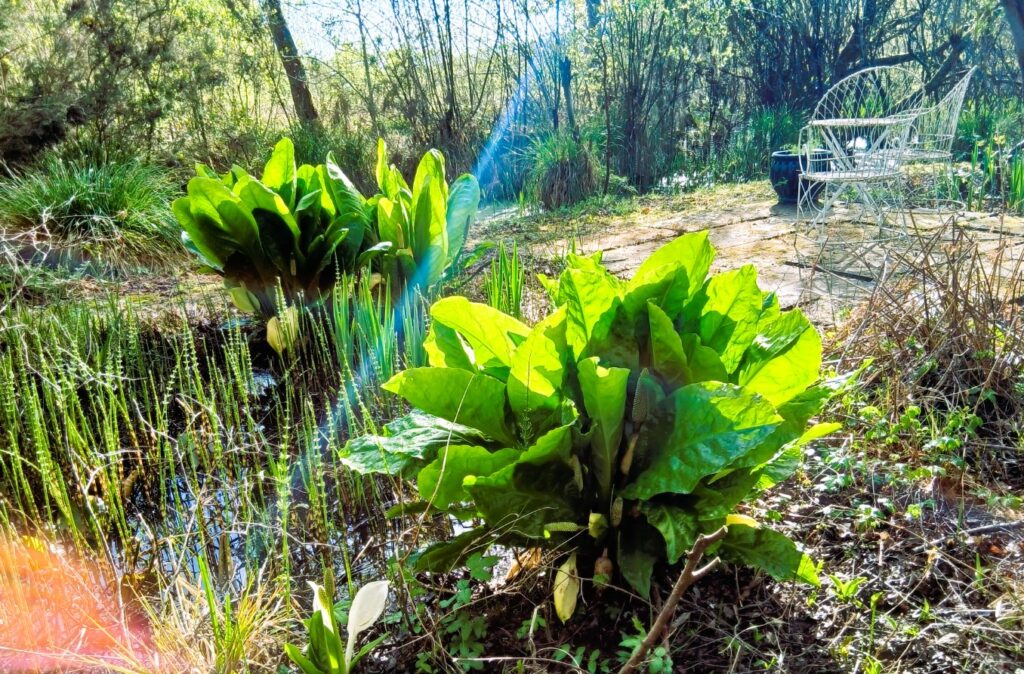
March contemplation !
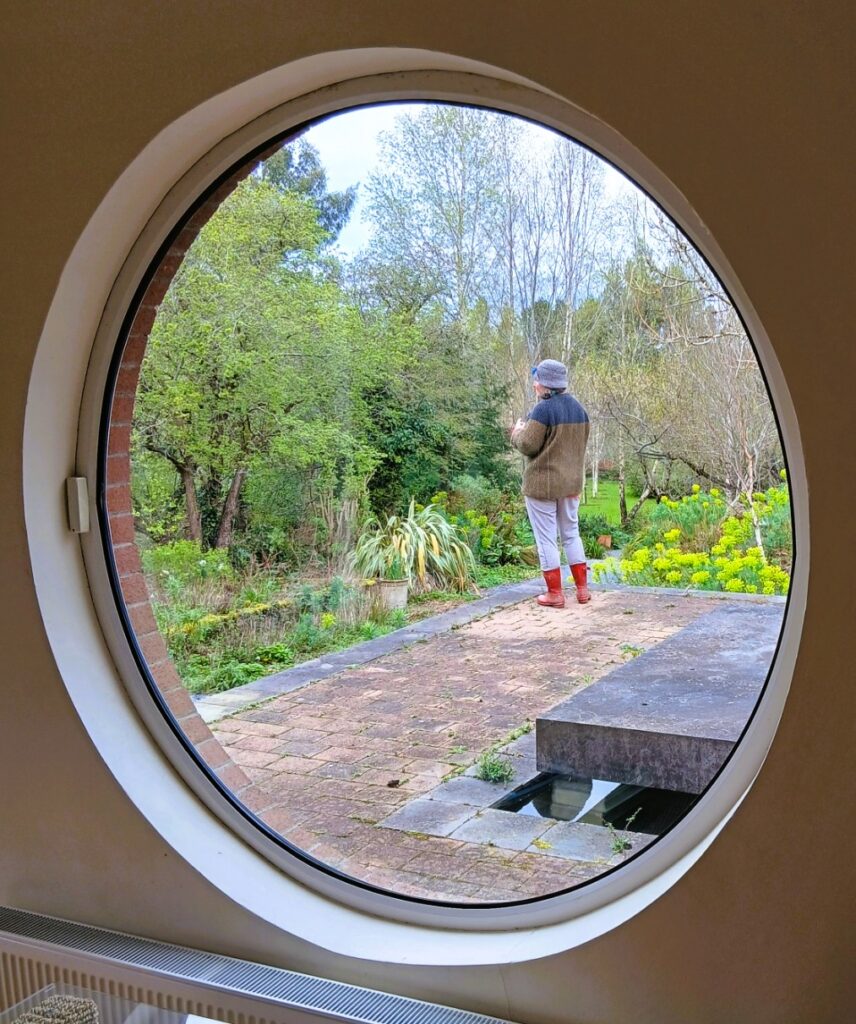
April 2025
April is the month everything starts to grow and the arrival of long daylight hours means more time available to spend in the garden .
Time was Japanese maples were pretty limited in the garden centres as you had the smaller ones like palmatutm purpurea and a golden version and a larger one called Crimson King and that was about it but now there are a lot more available and this month we added a variety called Koto no ito which if it does well will complement nicely with a purpureum planted beside it .
Koto no Ito has amazing foliage and the name is Japanese for harp strings and the RHS describe it as “ a very enchanting tree and will certainly add an exotic feel to your garden ” … couldn’t ask for more !
I have learned painfully from past experience that deer go crazy for the soft maple leaves so I have protected the two new maples with wire netting to give them a chance in their first season in the garden … a nice sheltered spot from winds but the soil is a bit dry so will keep watering them over the summer months to give them the best possible start to their new home at Old Spa Road .
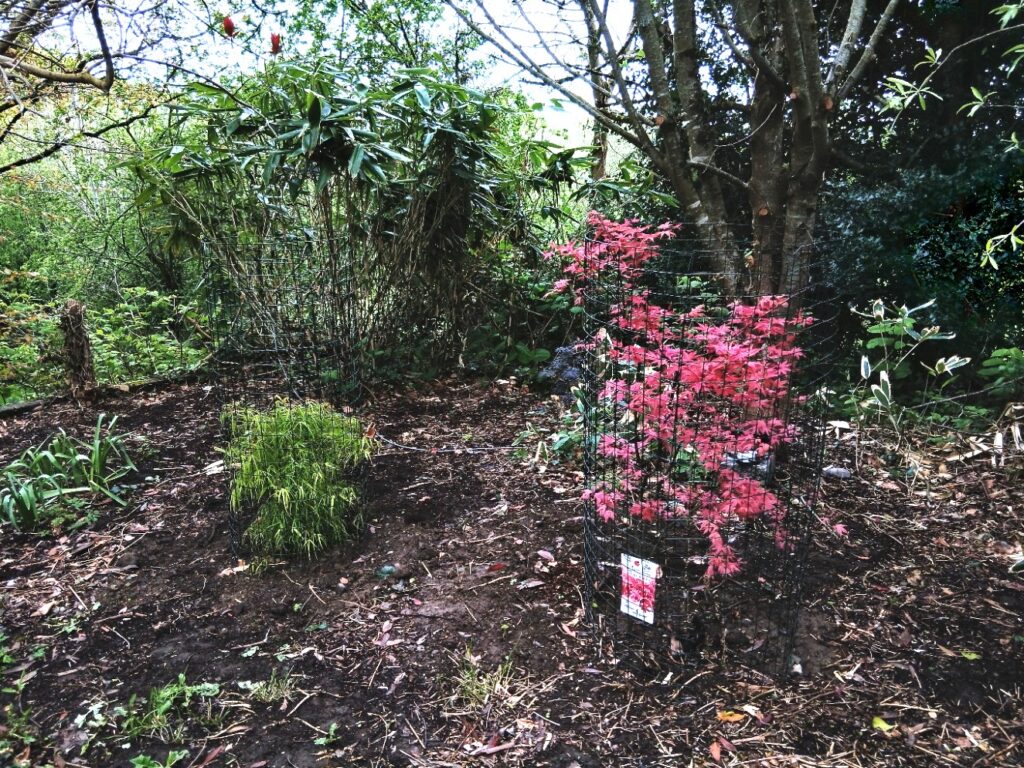
I had this large rock installed about eight years ago as a place to sit in the morning overlooking the new water area in the Lower Wood and this month finally added a wooden seat to complete the project … it faces east and is a favourite place to sit to greet the rising sun winter or summer .
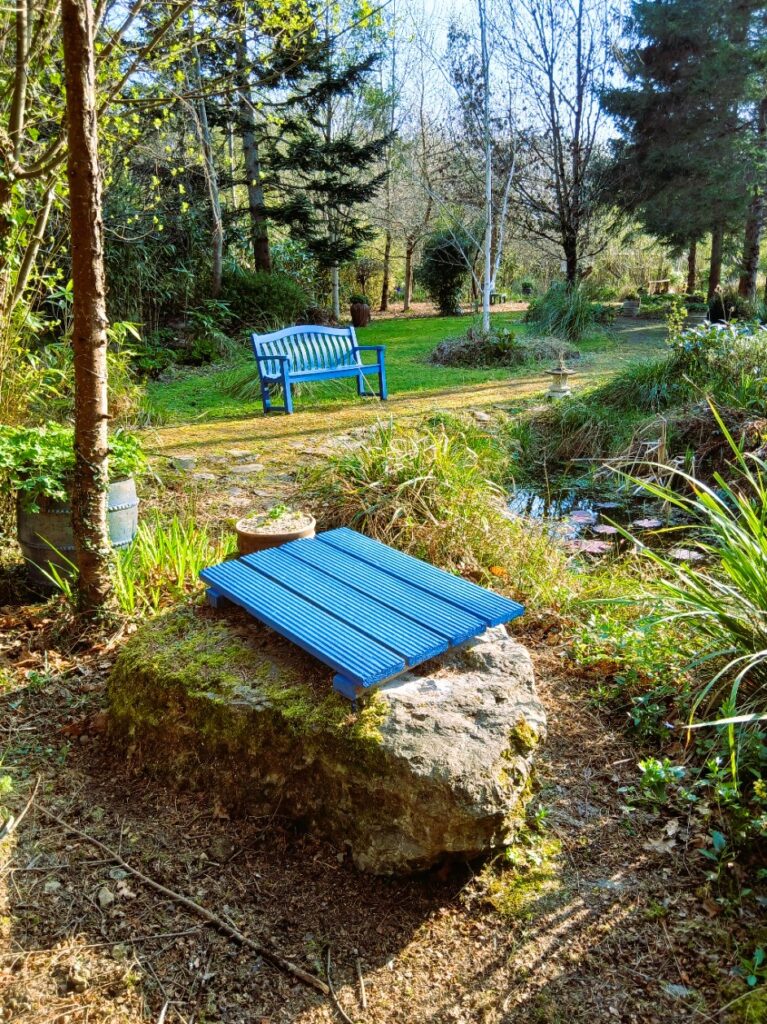
For the past fifteen years or so RTE runs a garden show where six “ gardeners” compete to create a garden design which will be exhibited at Blooms , a Dublin garden festival in June .
Each year I try to give it a chance by watching the first of six episodes but each year it has increasingly descended into a kind of game show but last night was the pits and I only managed ten minutes before hitting the off button where a Mexican wannabe garden designer based in Ireland helped by five “ friends ” couldn’t even operate a mini digger but they all managed to look like slick boyband members … yuck and more yuck … pure awful !
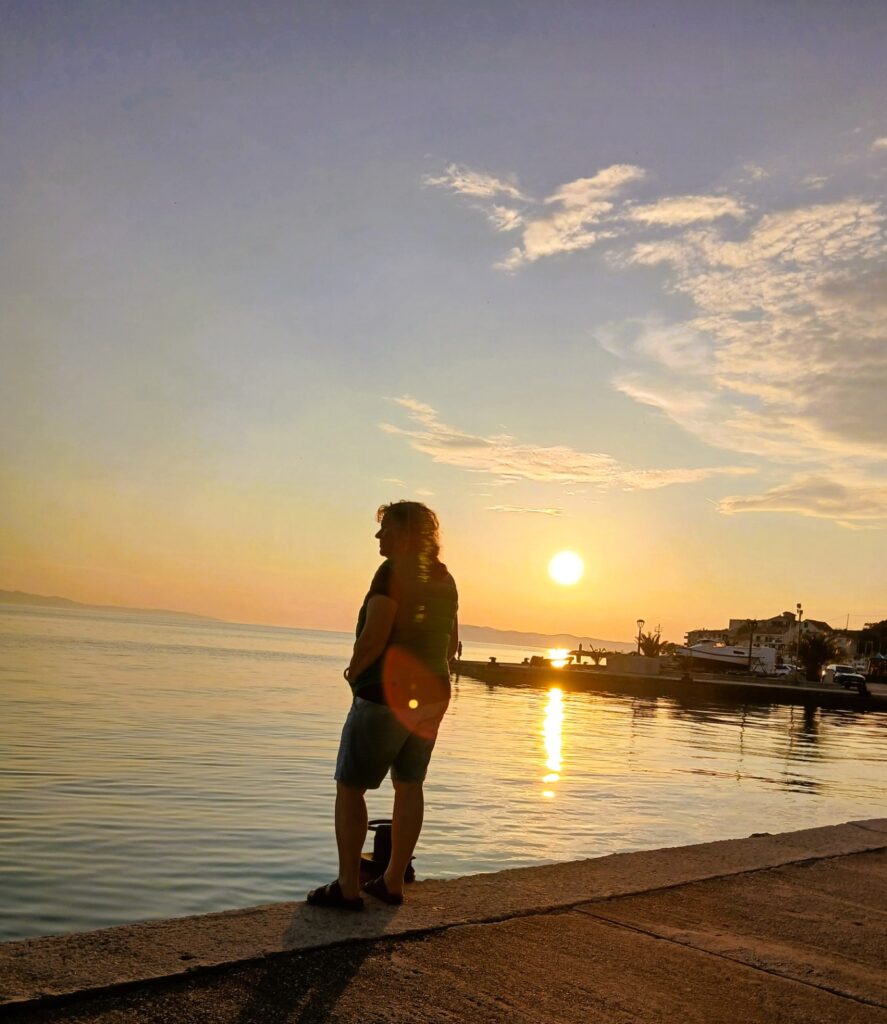
We spent a week in Croatia at the end of April and had quite a bit of catching up in the garden at Gornja Podgora after being away for six months since last October , mainly hard weeding and digging out any casualties over the winter months .
Different countries different weeds and it takes a few years to get to know the local weeds , what to tolerate , which weed is invasive and which needs to be ripped out … they all look beguiling in flower but some have deep roots and are a real problem if you let them settle … now it is clean but it took a few years to build my local knowledge of the weeds which are after all just a plant in the wrong place !
Red poppies are everywhere in the rocky soil of Dalmatia and I love them but while they grow everywhere outside the garden in Gornja Podgora frustratingly none have grown in the actual garden although flourishing just outside over the fence … same rocky soil but I think as this is a manufactured maintained garden with selective planting and weeding I feel it doesen’t suit the wild poppy as it prefers to grow in totally wild and untilled conditions .
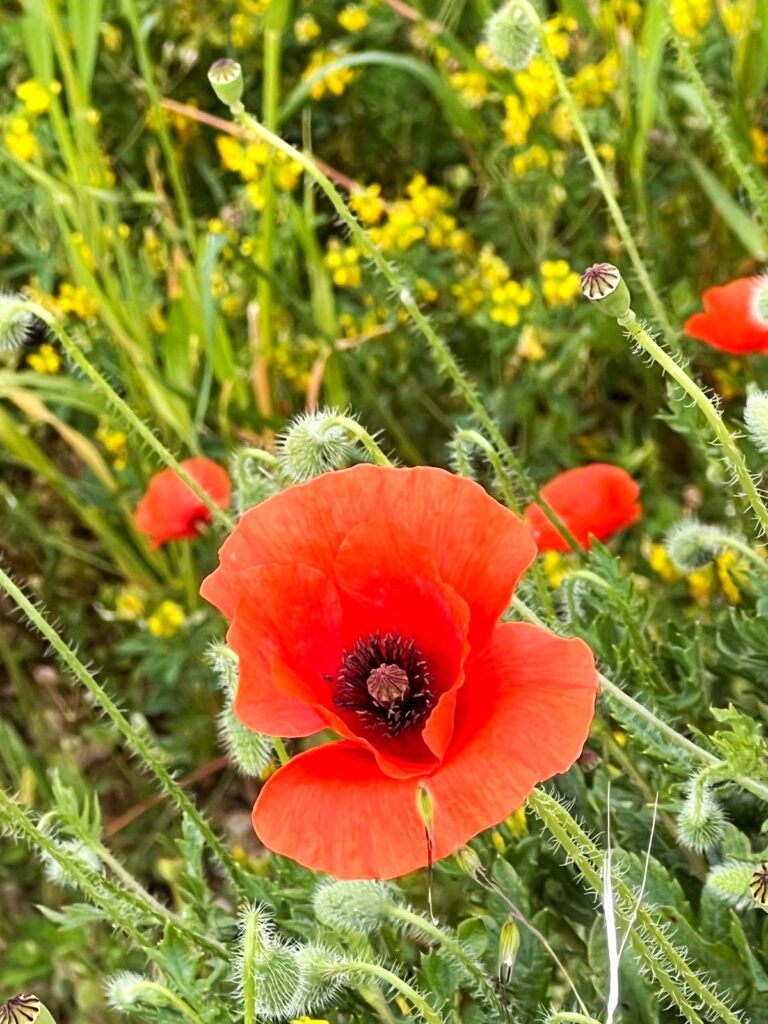
In 1976 I did a back packing trip around Crete staying in youth hostels , I teamed up with a US doctor from Indiana for two weeks as we had similar tastes in photography and Minoan ruins . Robert was a Nikon camera fan while I was a Pentax aficionado … a photo that Robert took with his nikkor lens , a close up of what I thought was a giant dandelion pissy bed seed head impressed me to such a degree that I left Pentax and have been a Nikon fan ever since .
I never saw that giant dandelion seed head again until I came across it in April in the Croatian garden from a plant I had thought was a garlic seed head … it shows how advanced camera phones have become as the quality of this shot with my cheapo Samsung android is just as good as Bob’s Nikon state of the art SLR lens from the 1970’s .
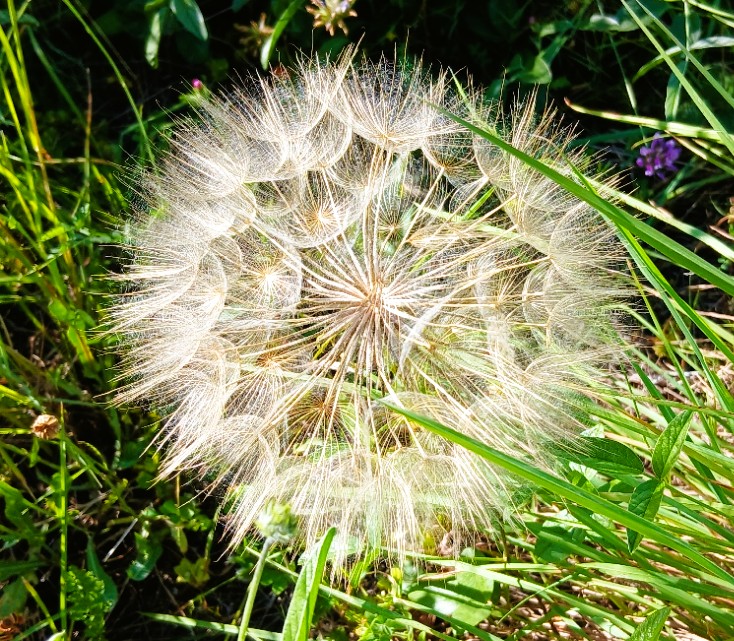
The main planting in Croatia is your typical Mediterranean mix of lavender , santolina and rosemary and this forms the back bone of the planting under and around the fifteen mature olive trees with aquaves added for structure .
I don’t have much luck with lavender even though the climate and the rocky terrain suits them and I put that down to too much watering in July over the past three years when I was trying to get them to grow … but location is the main key watering or not and lavender need full sun and will not tolerate shade and learned that lesson the hard way in Croatia when several bushes popped their clogs … but santolina does really well as does rosemary which is great for structure and for softening the edges of the planting .
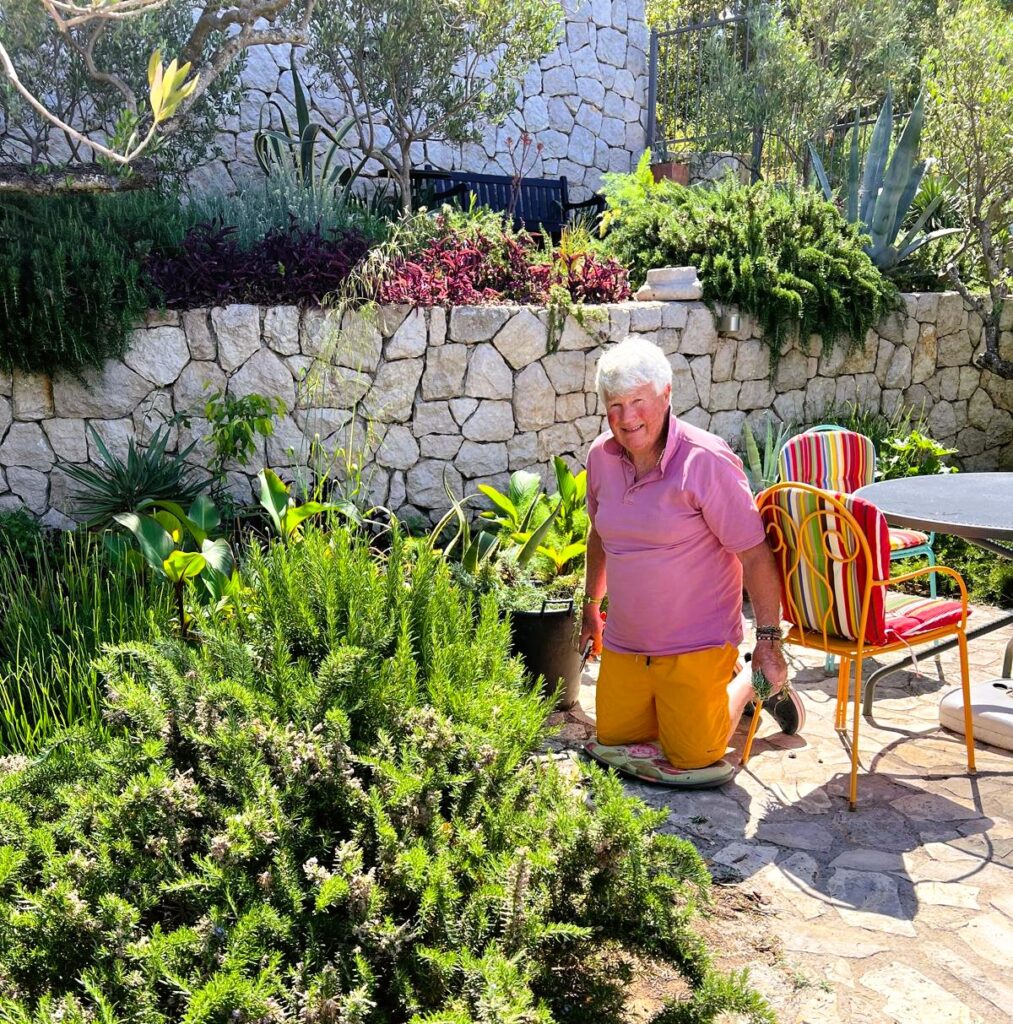
I use two types of rosemary mostly the ground cover prostrate version but also the upright bush type for some height although I give these single specimens a good prune every year to keep them in check while until now after six years in the ground I have had to cut back hard the prostrate varieties as over time they have swarmed over the stone walls and we had a choice to make … enjoy the beautiful Immotski stone mason’s work or cut back the rosemary and Snezana gave me grief until the stone work was cleared !
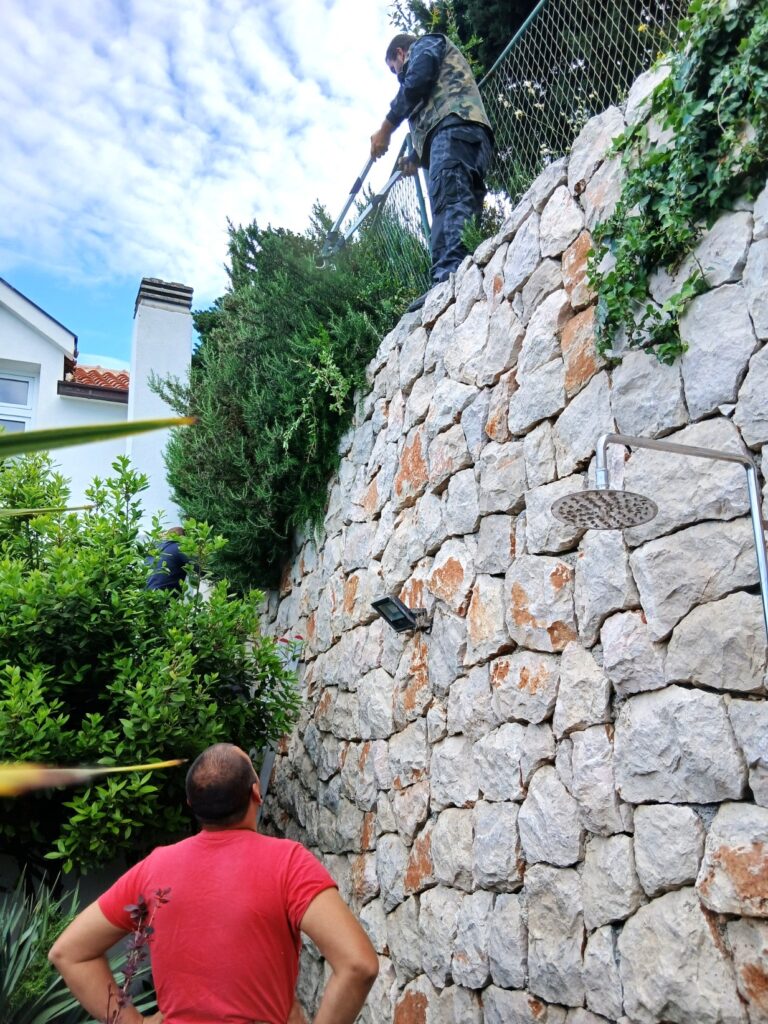
As usual in Gornja Podgora on each trip we visit Brac Island and the Biokovo mountains by scooter and the nature in both places is just fantastic … probably the most famous beach in Croatia is Bol Beach on Brac and we make a point of swimming at sunrise there on each trip … coldish but a great sense of occaision to see the sun rise up from the Biokovo Mountain range across the water on the mainland .
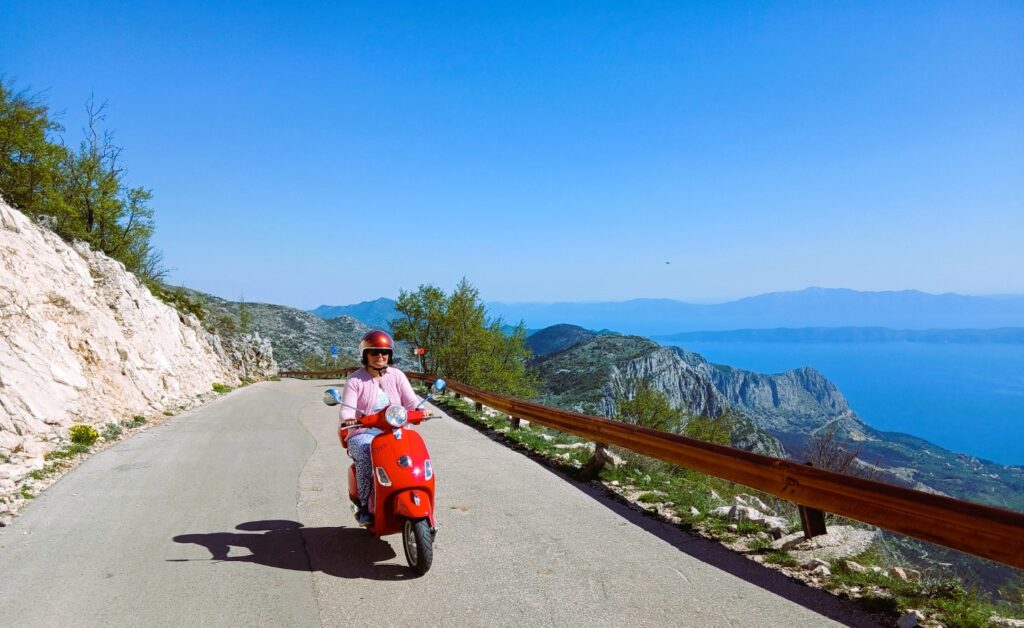
Sunrise swim on Bol Beach , Brac Island , Croatia , April 2025
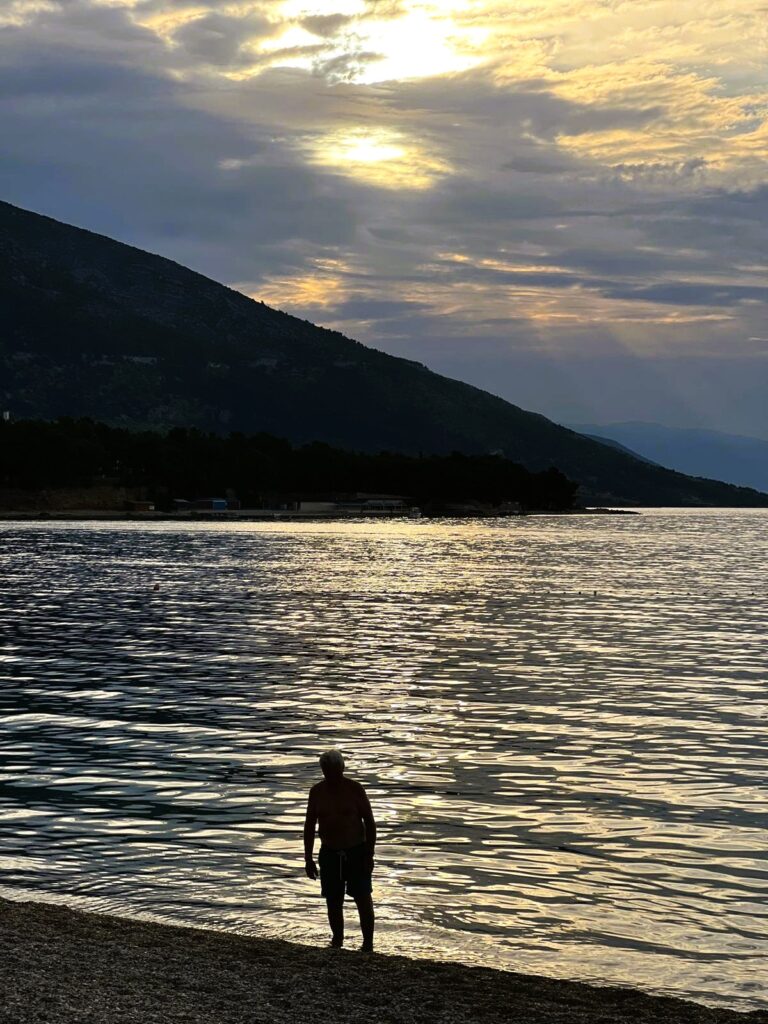


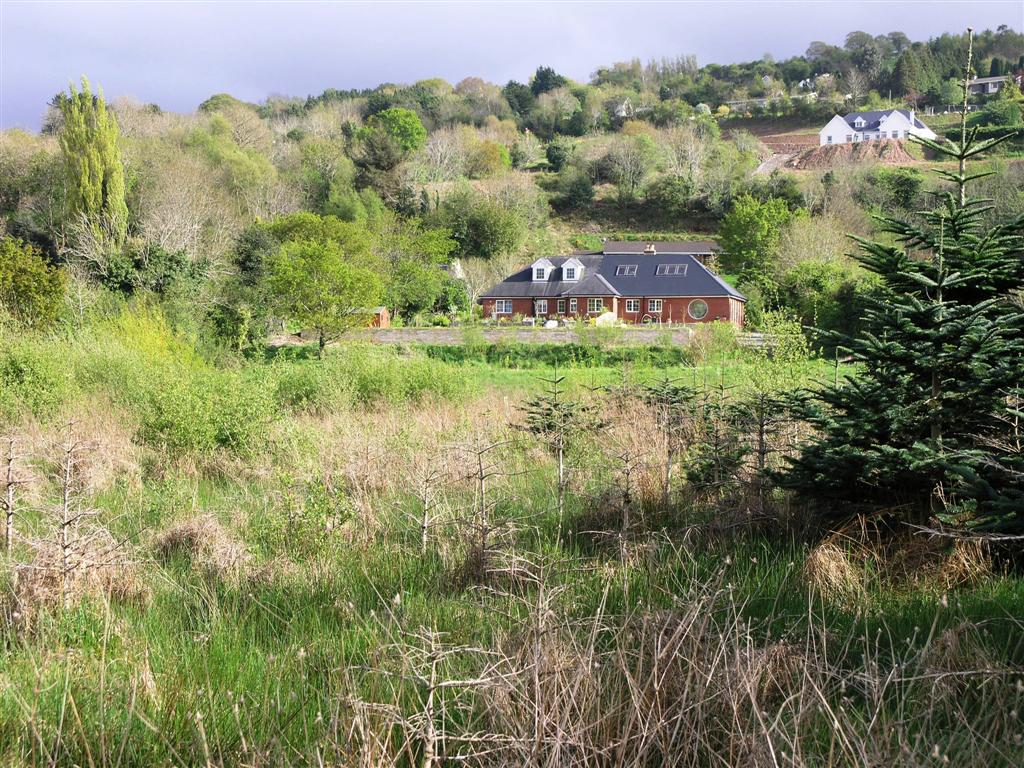
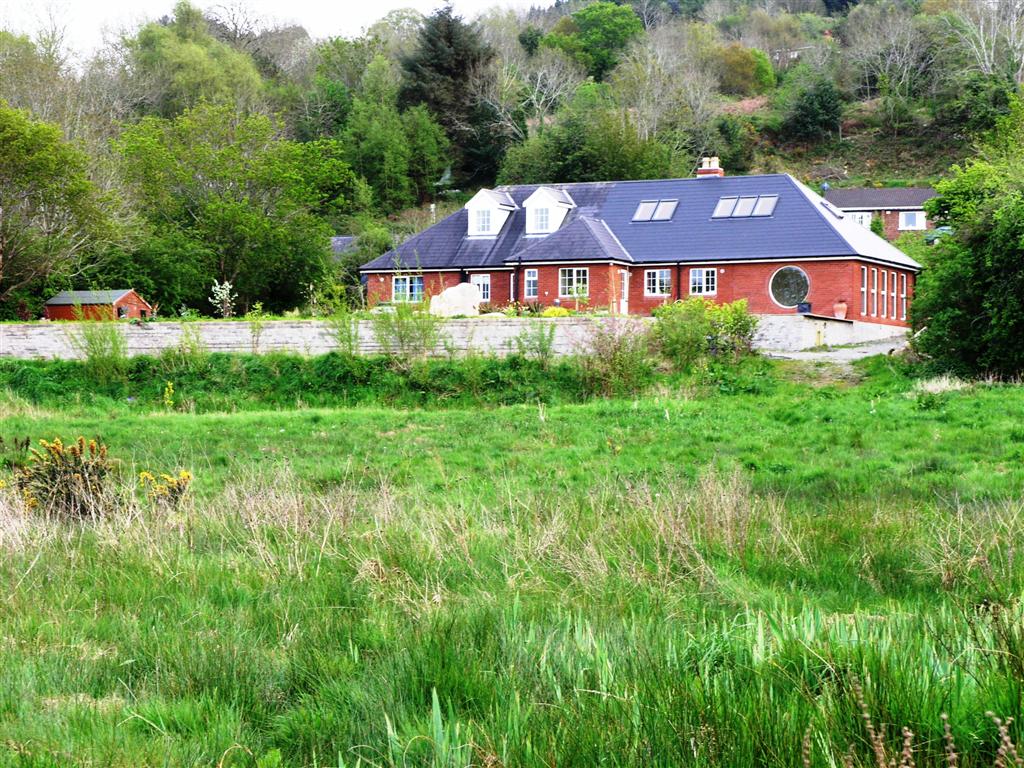
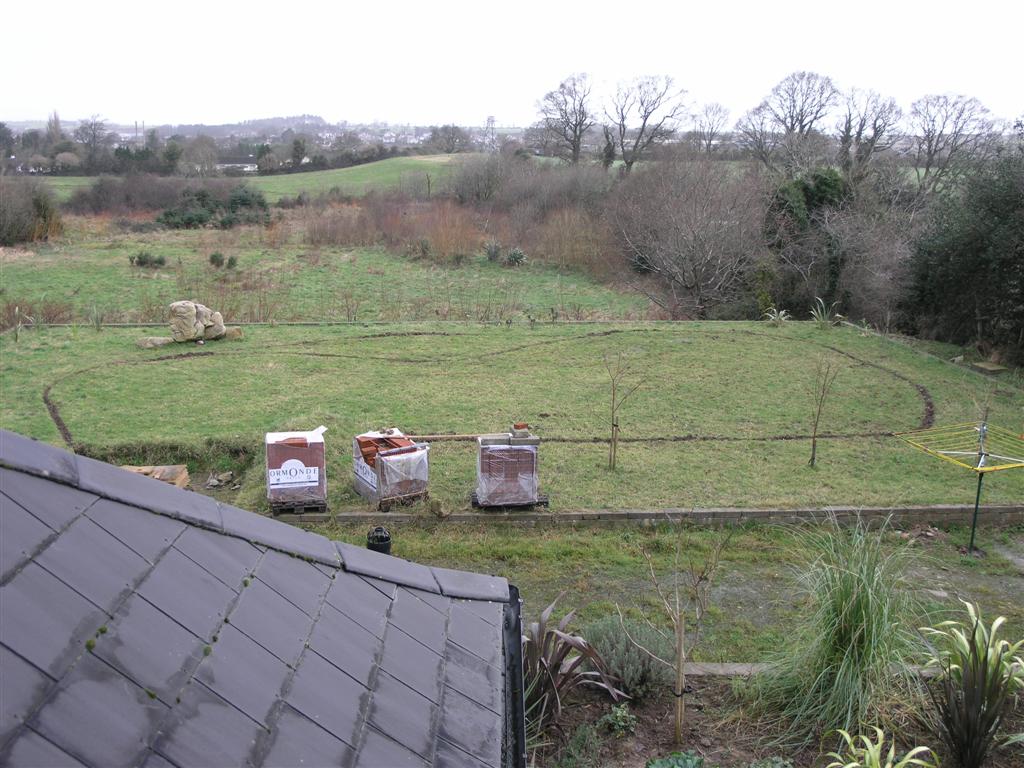
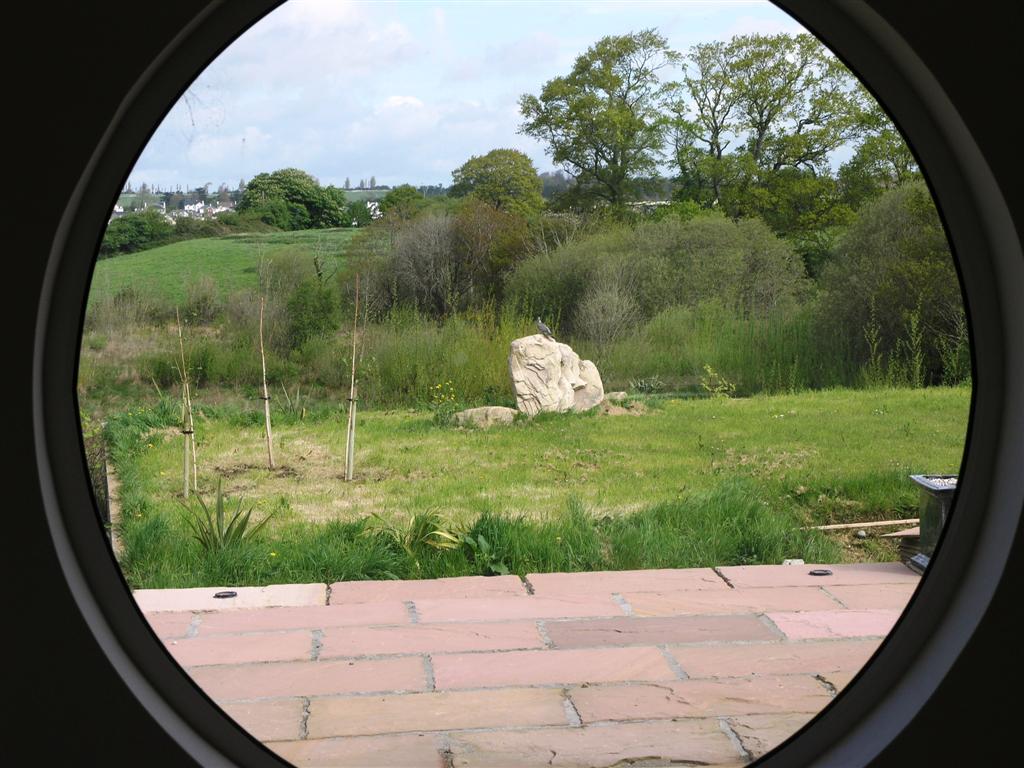
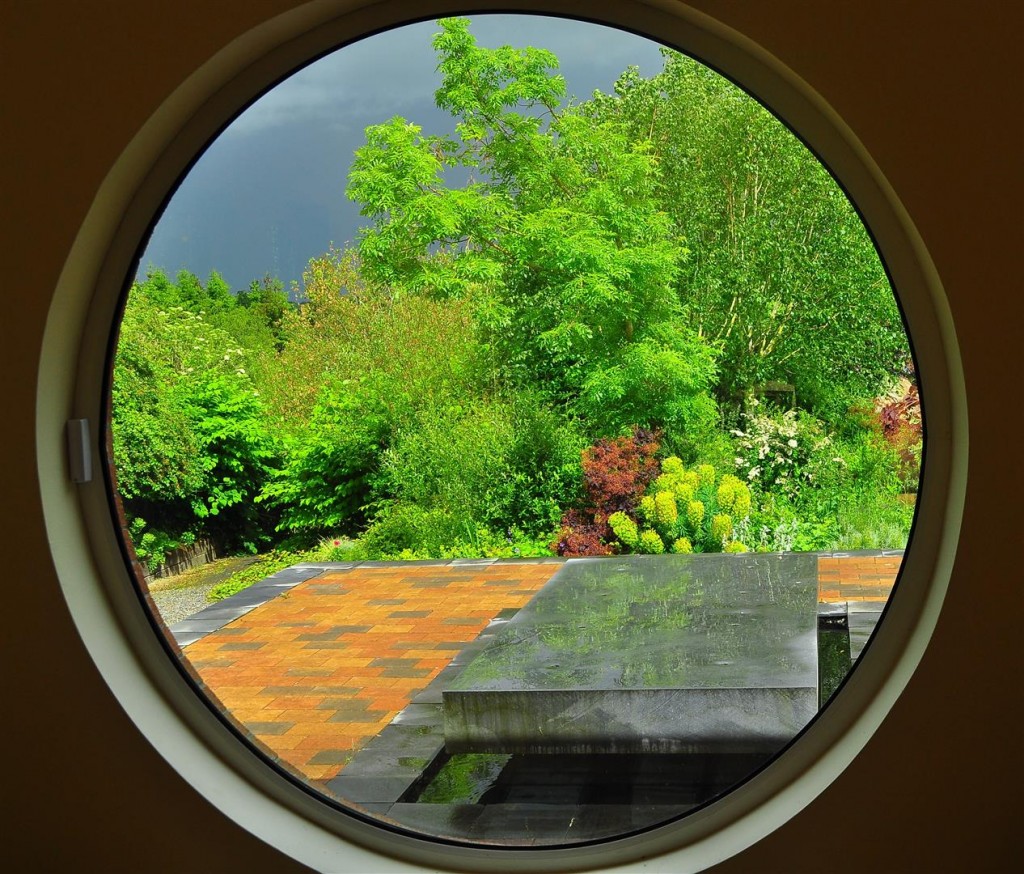

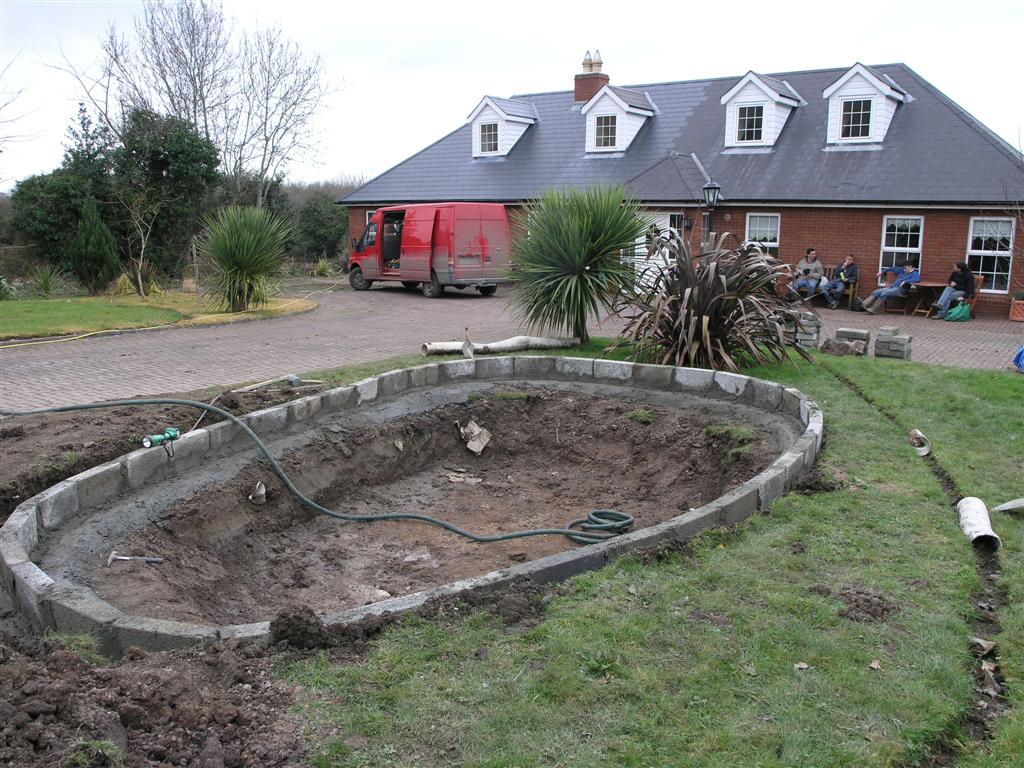
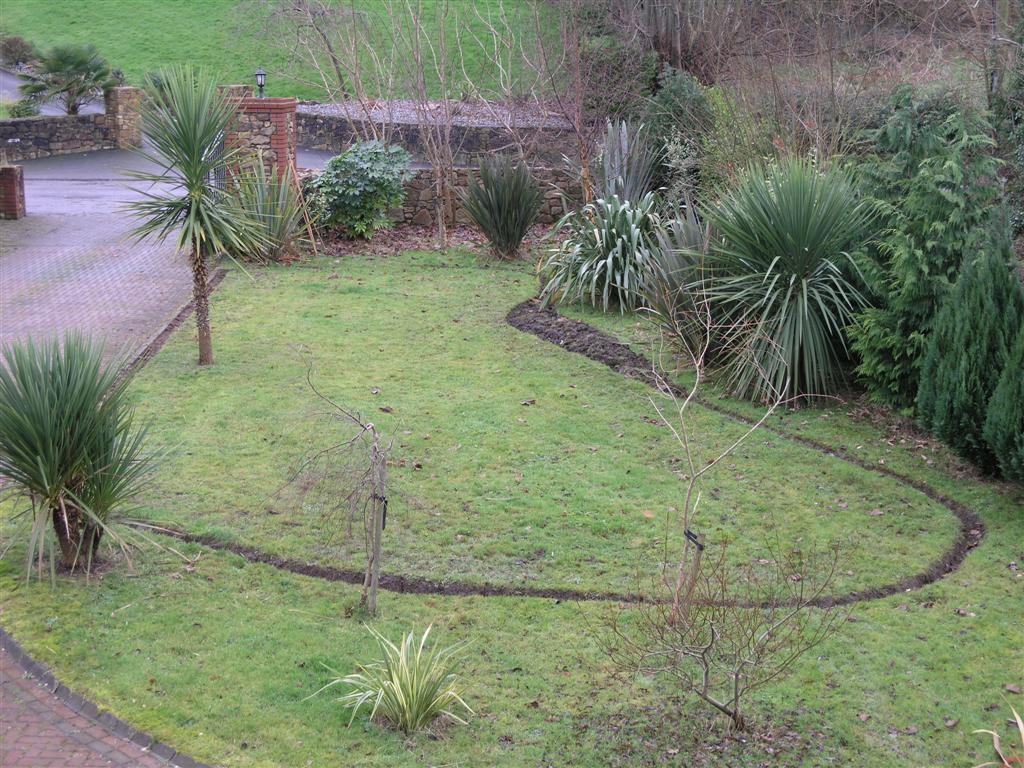
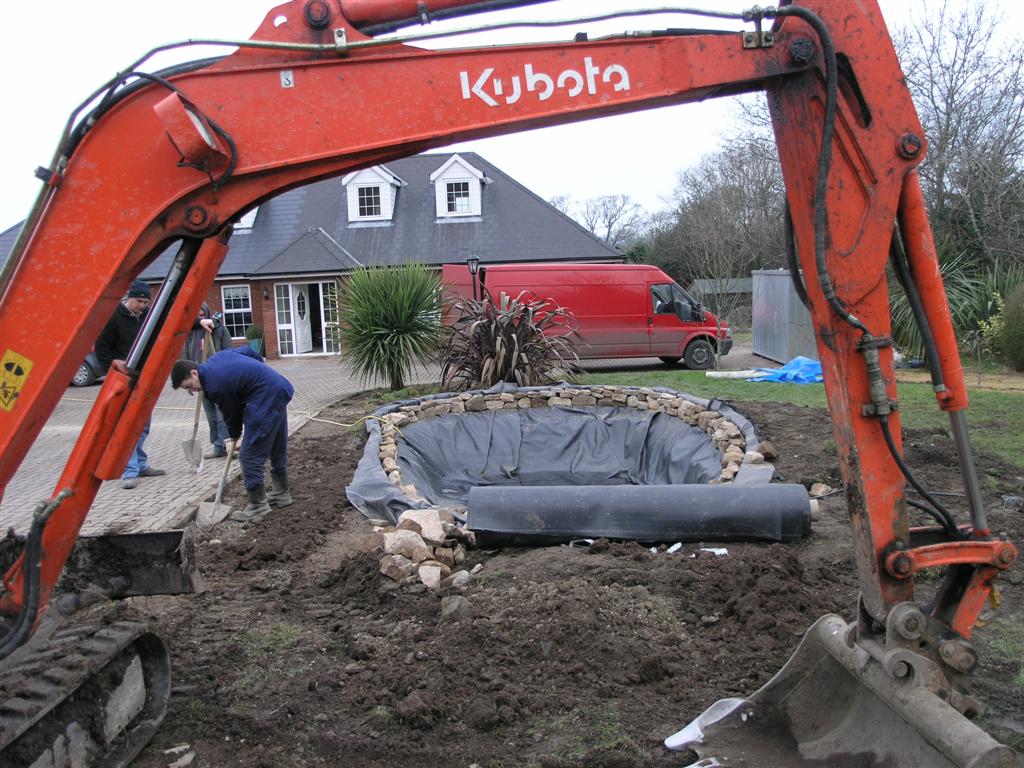
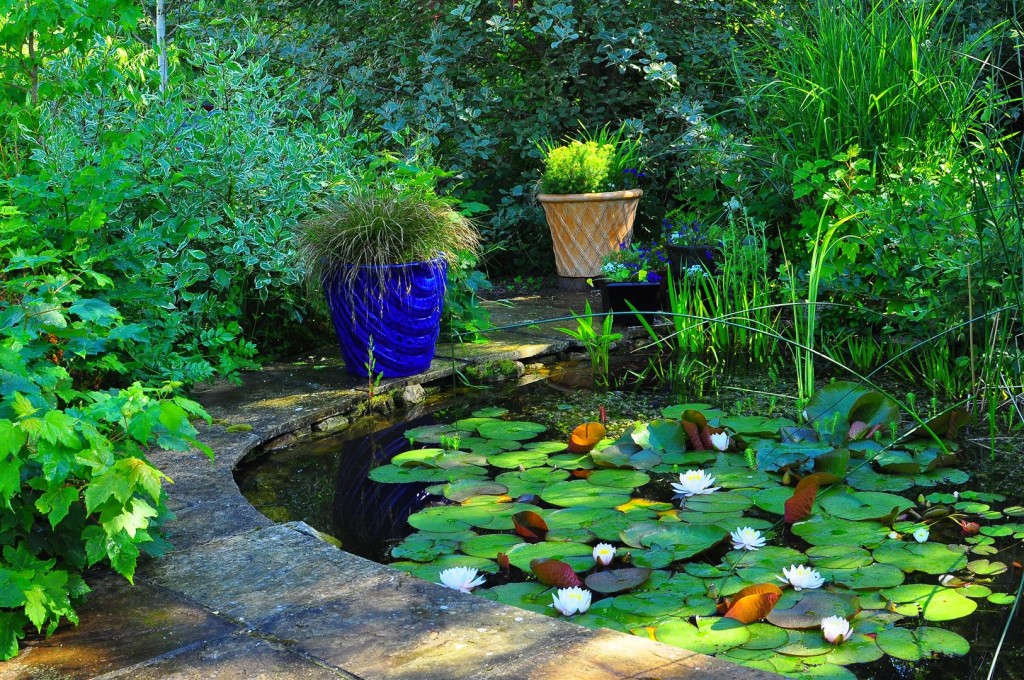
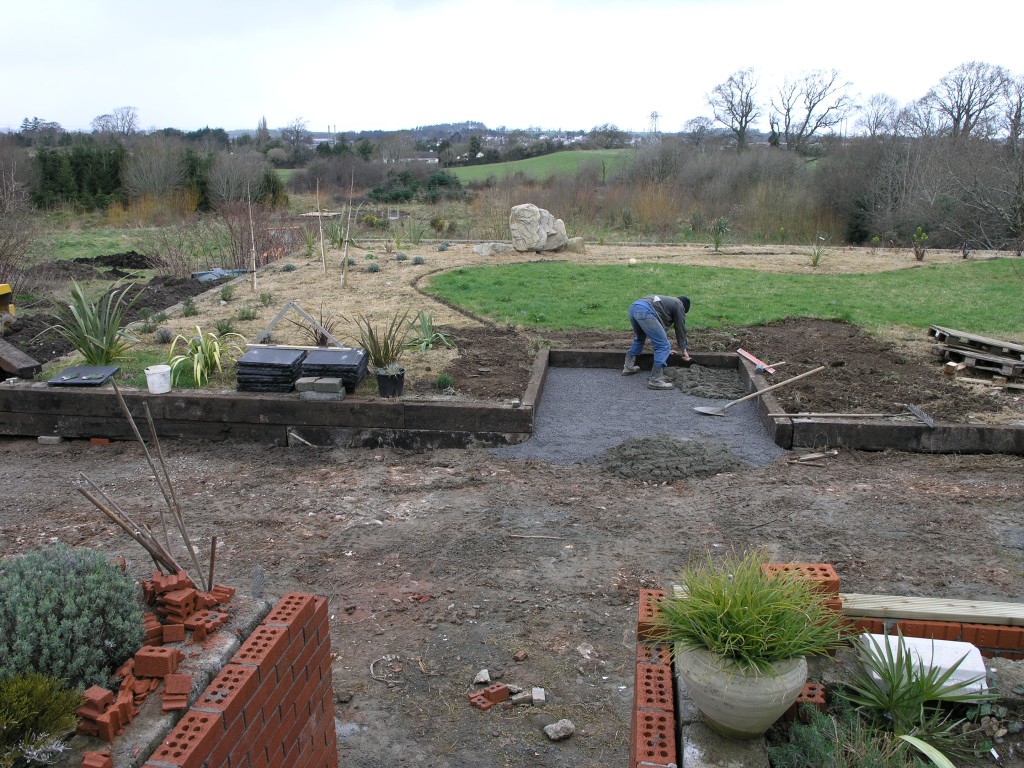
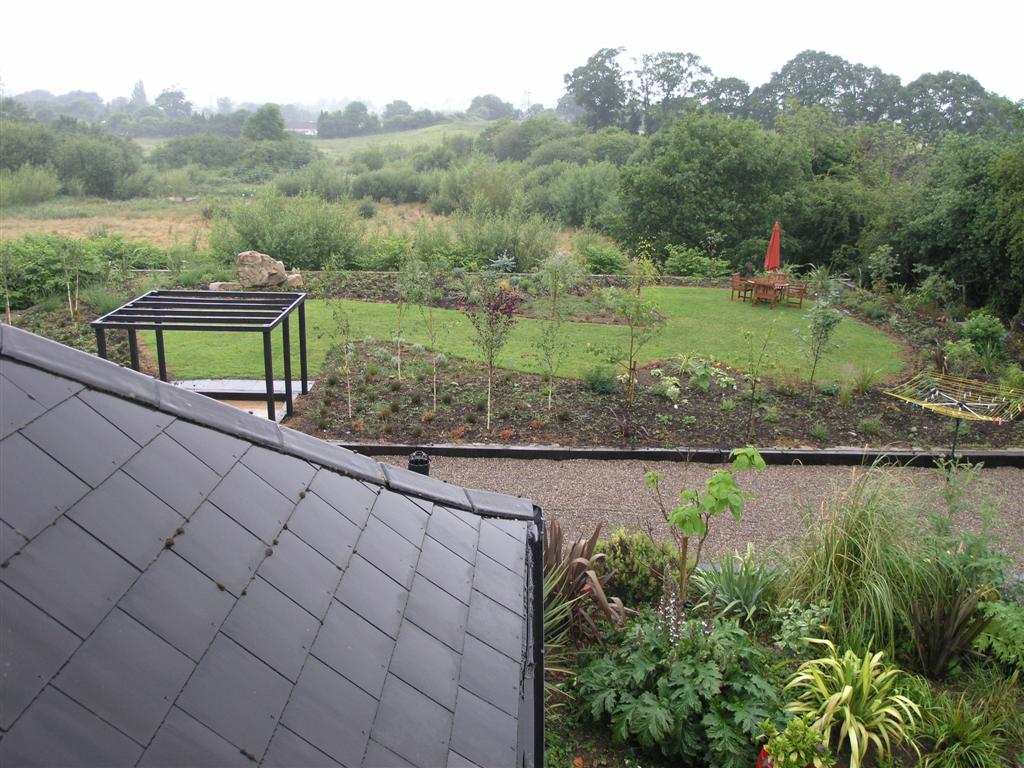
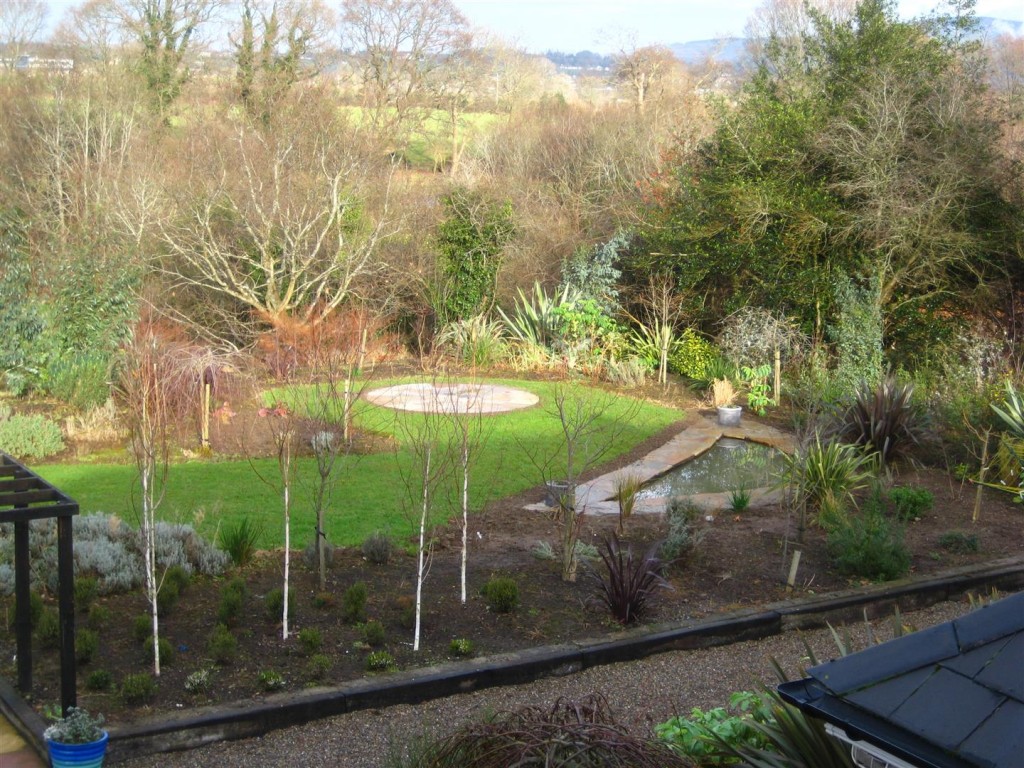
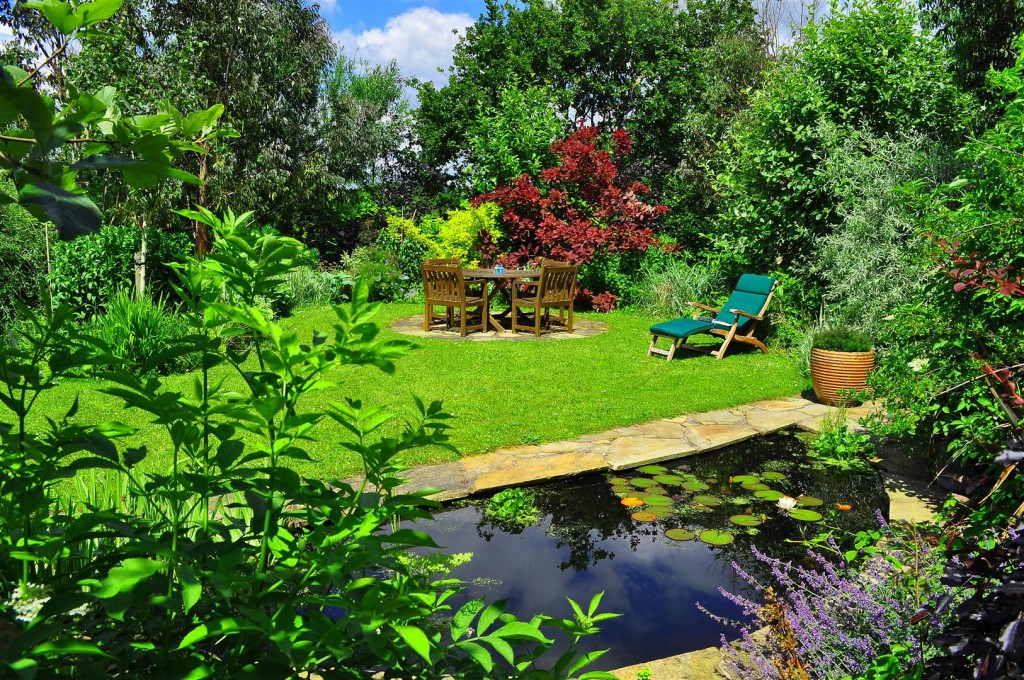
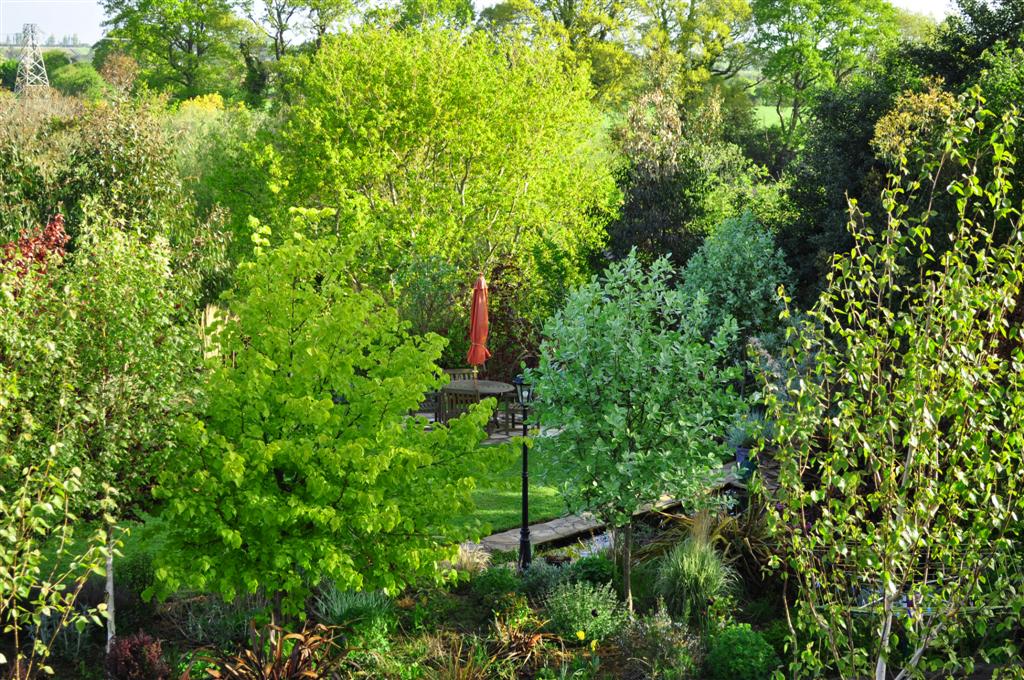
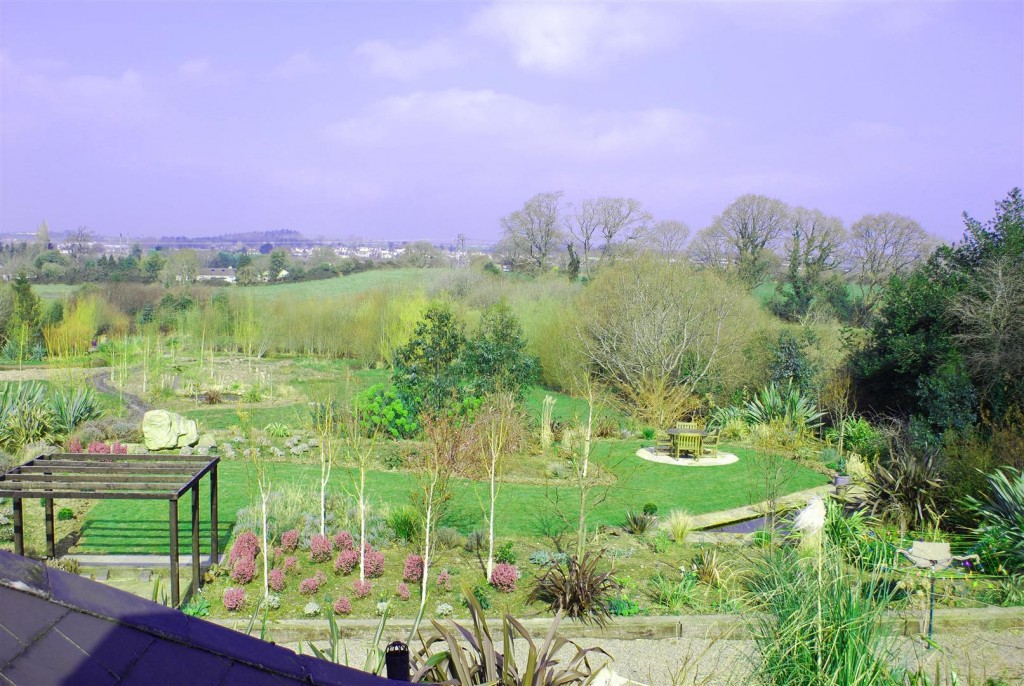

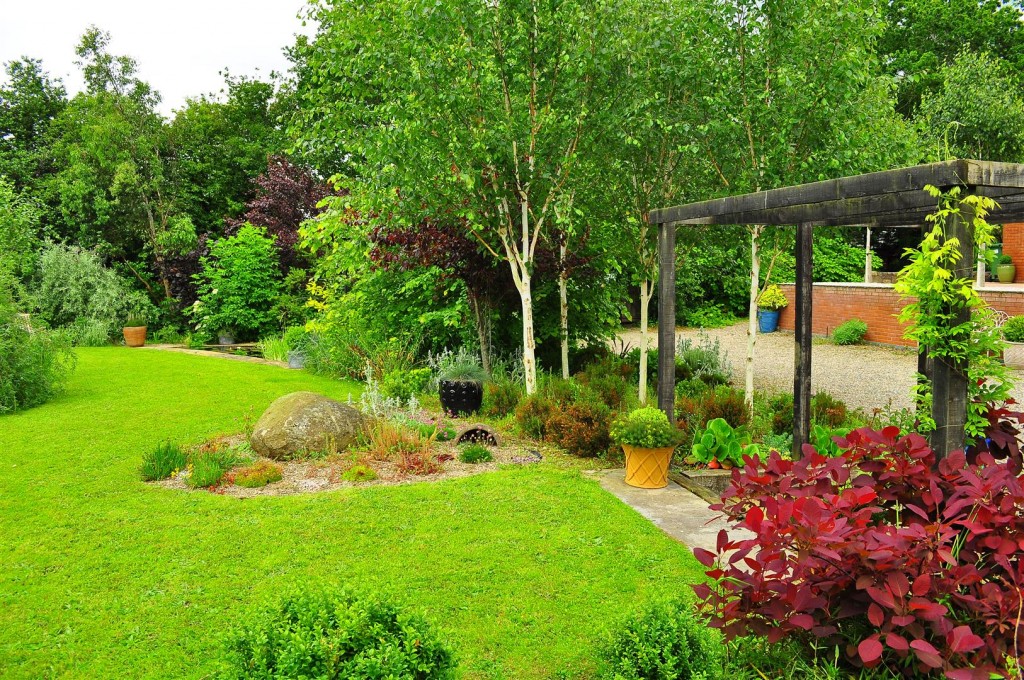
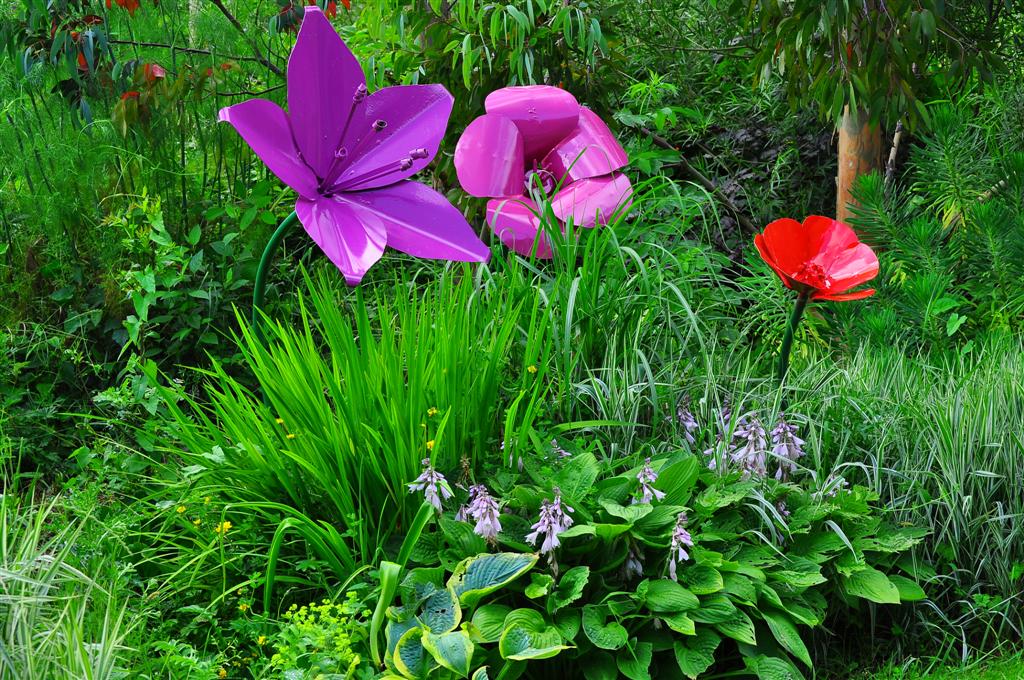
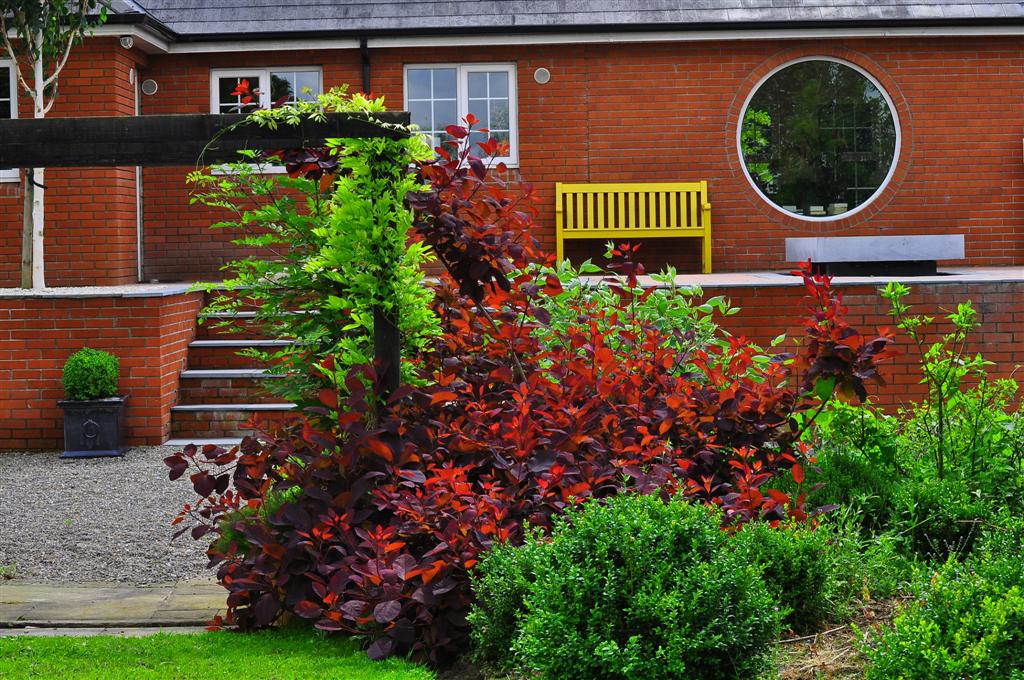
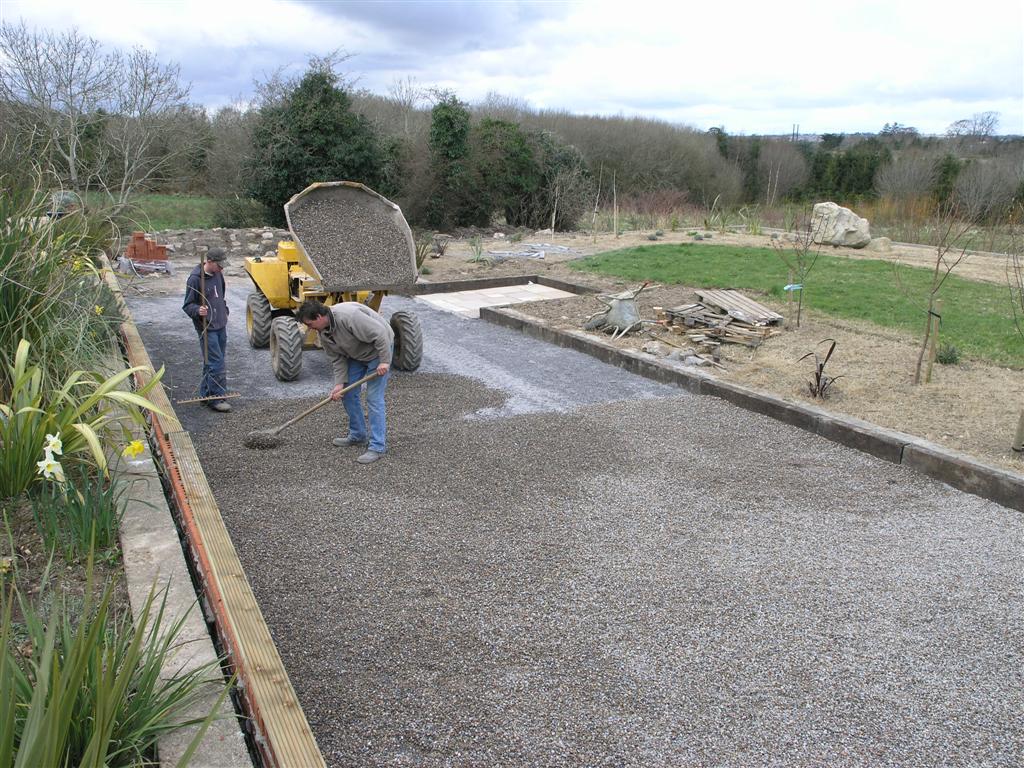
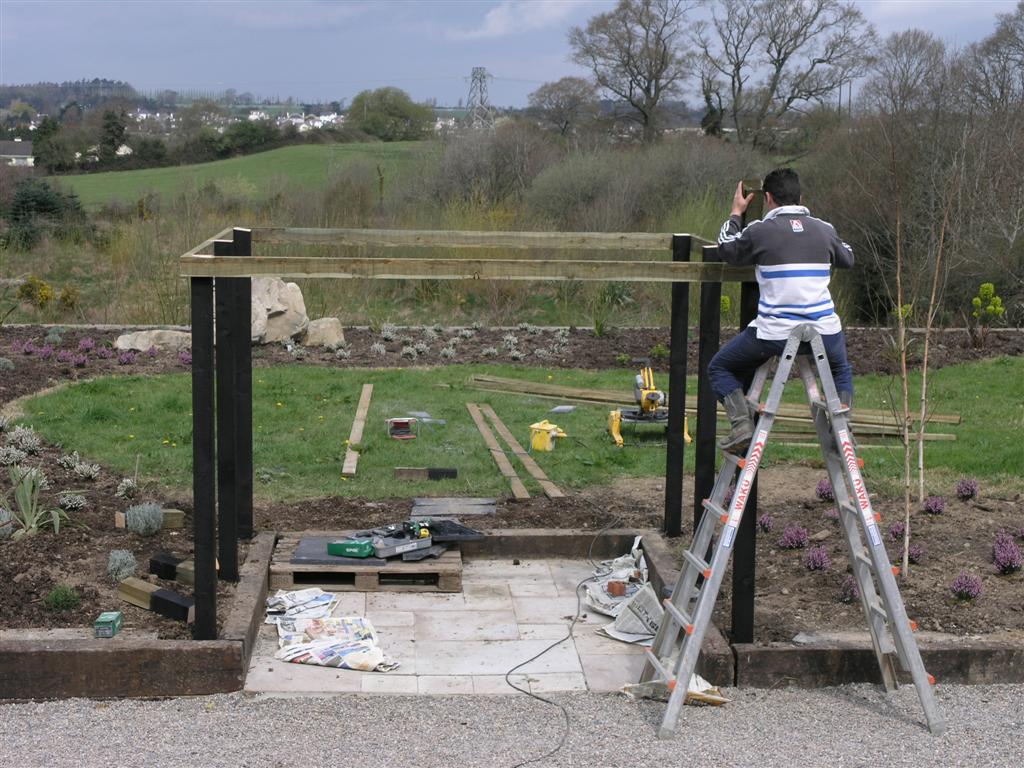

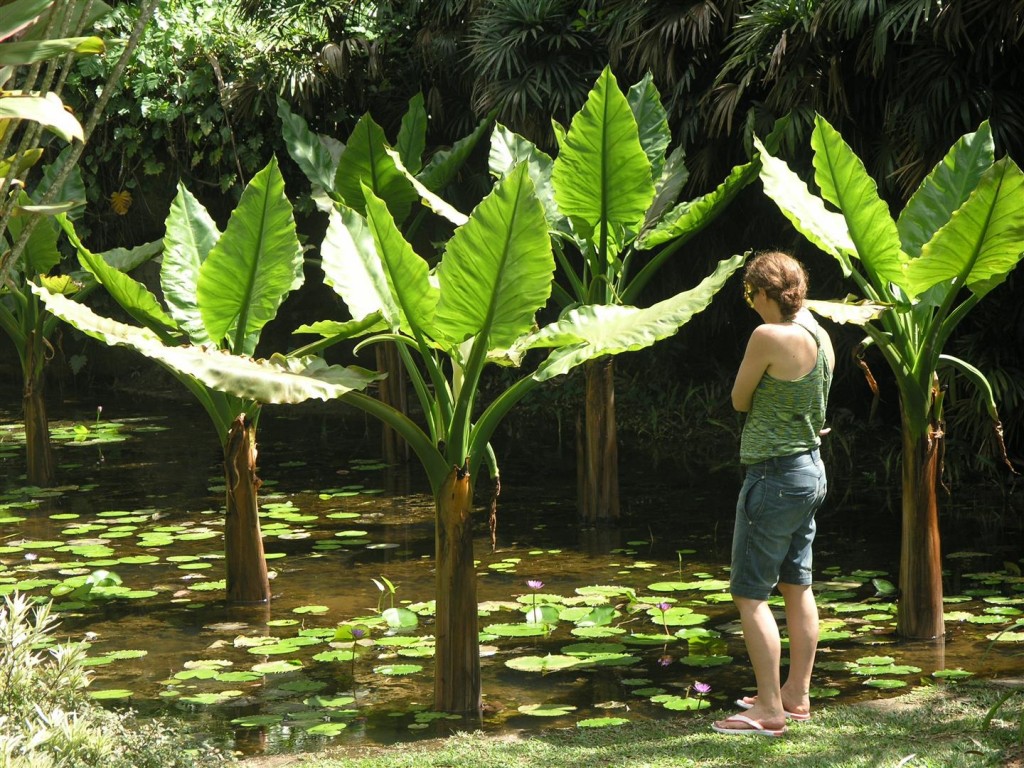
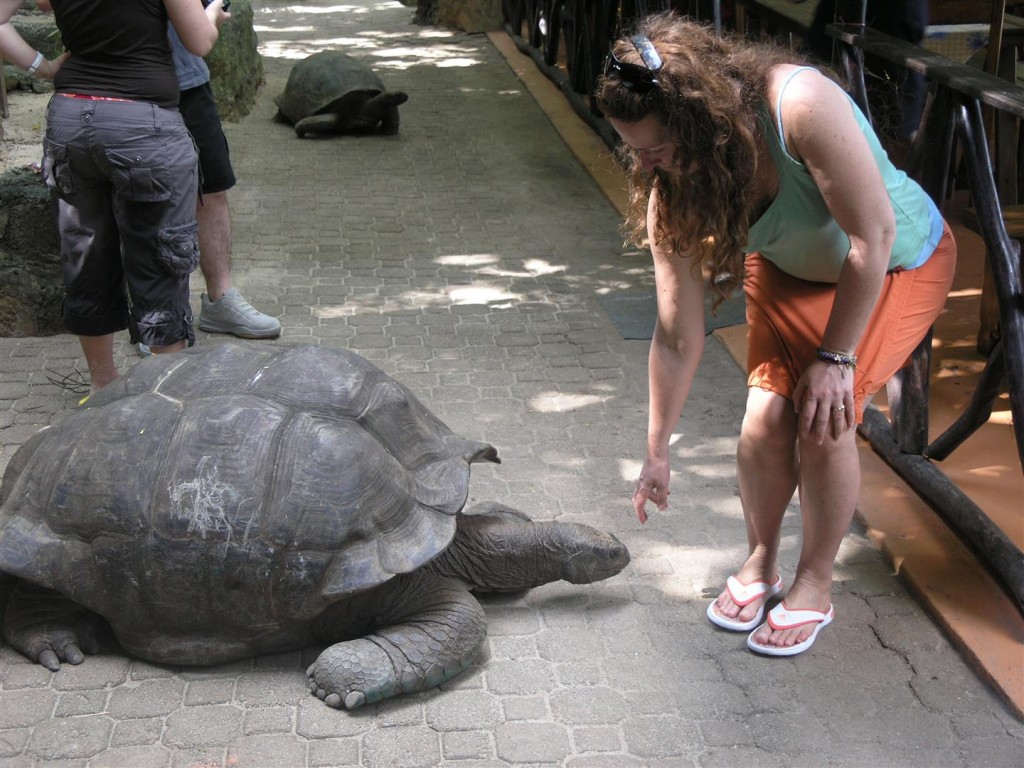
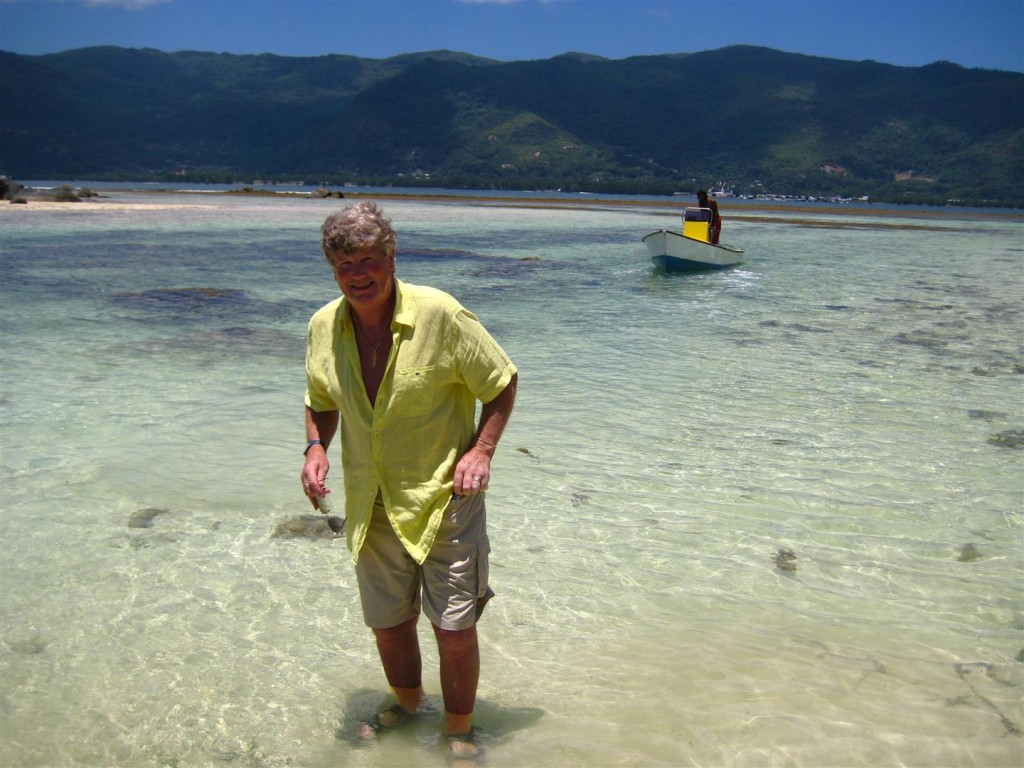
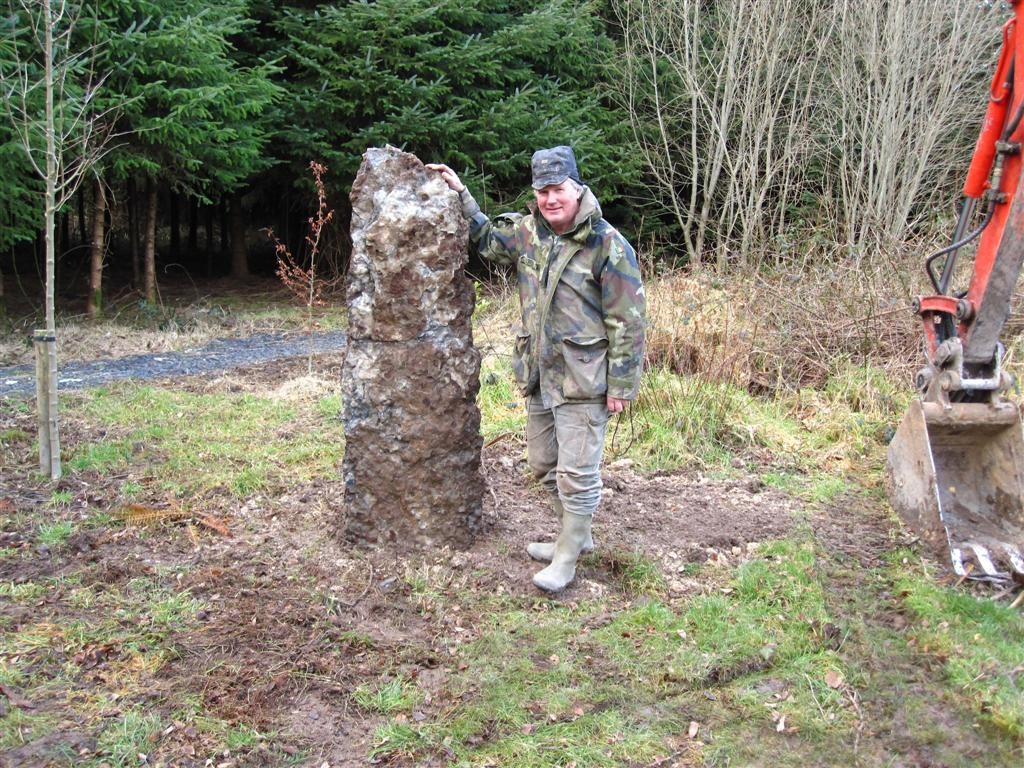
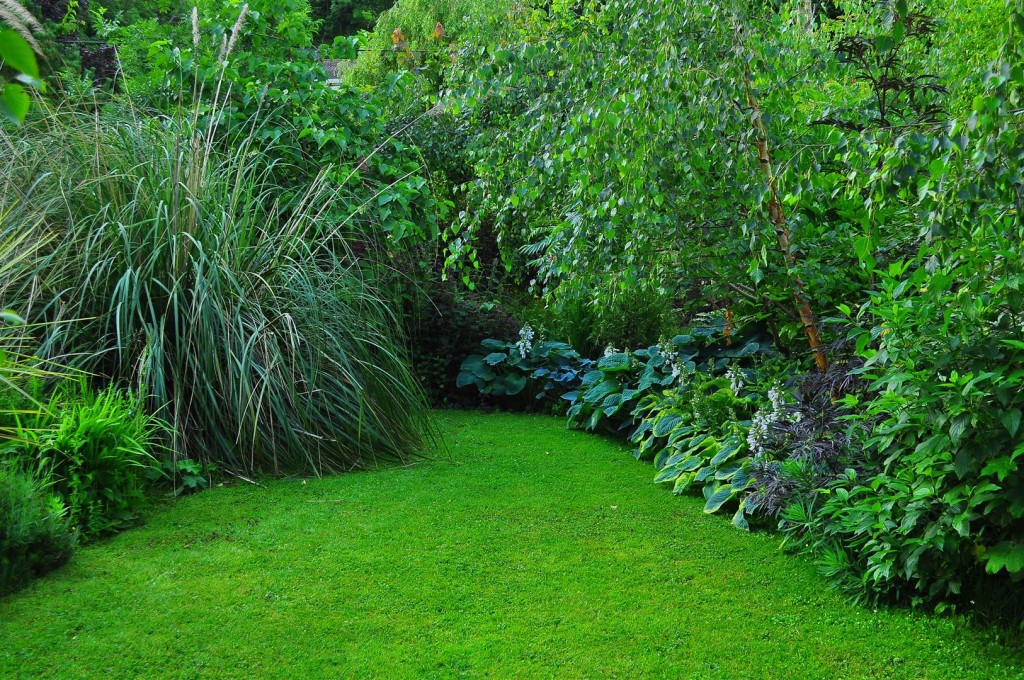


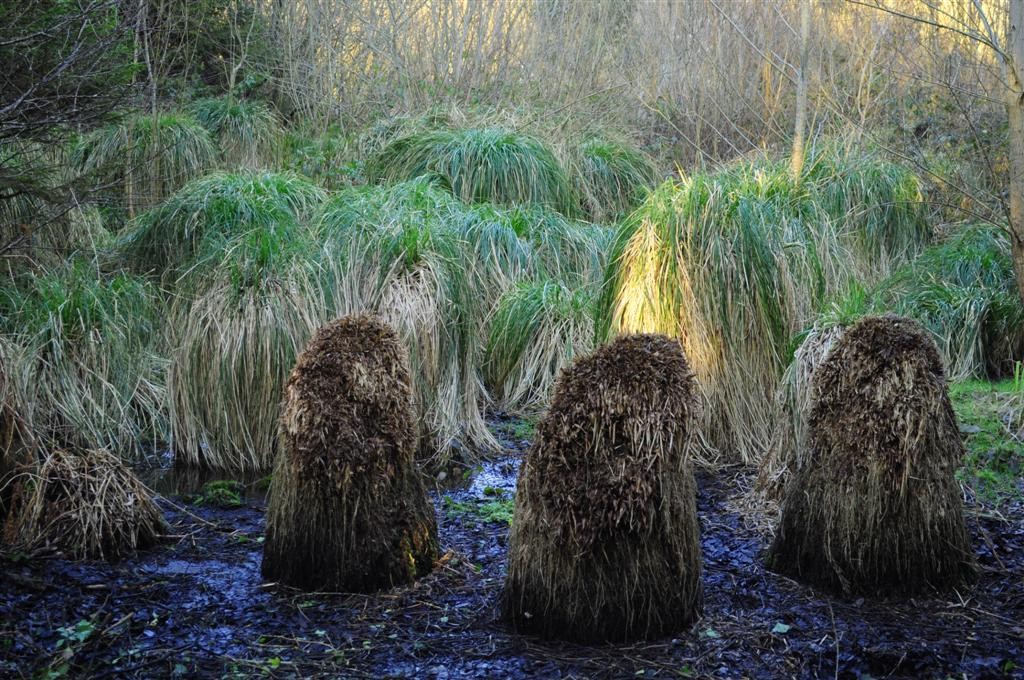

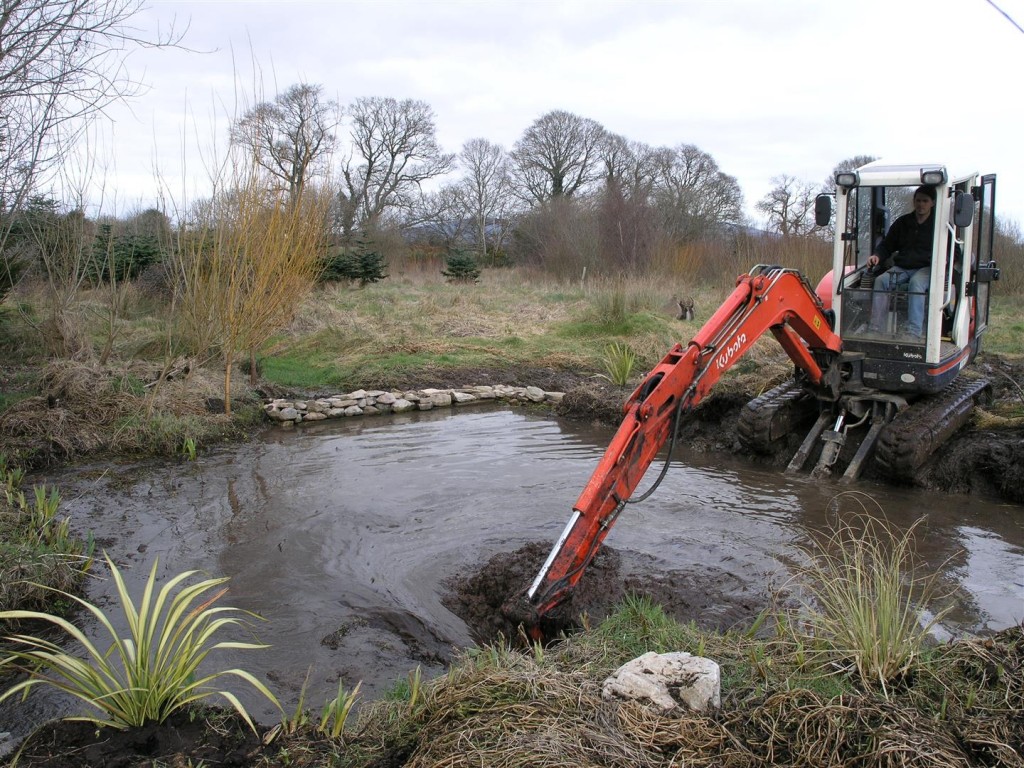
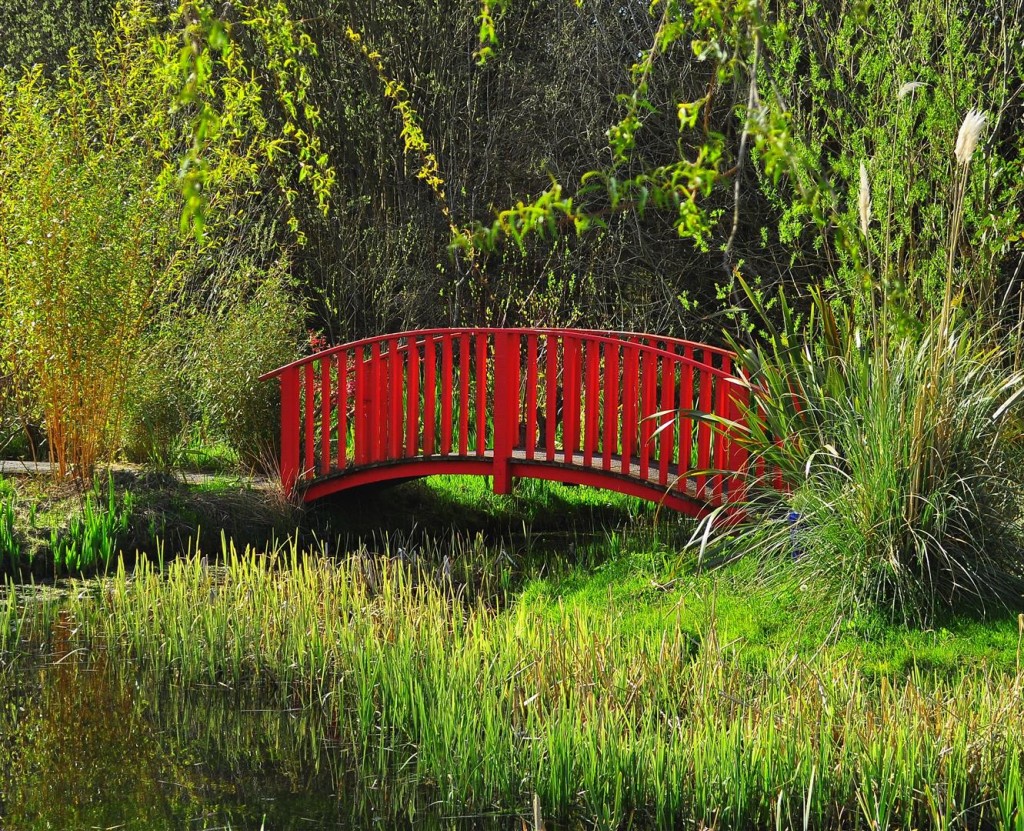
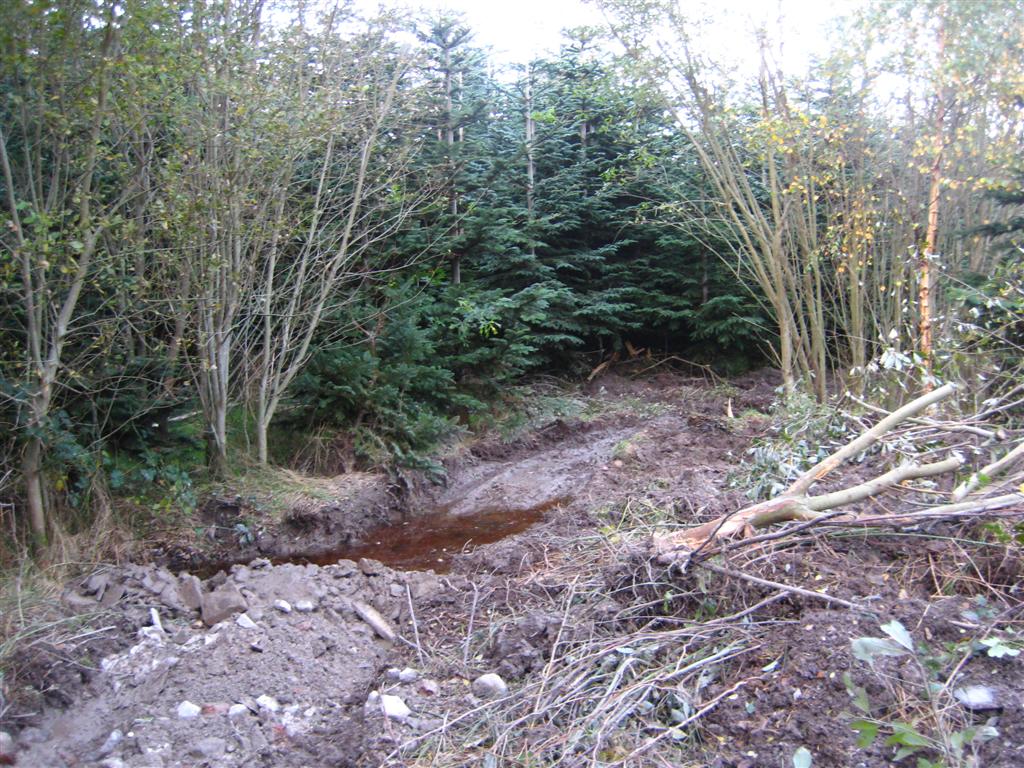
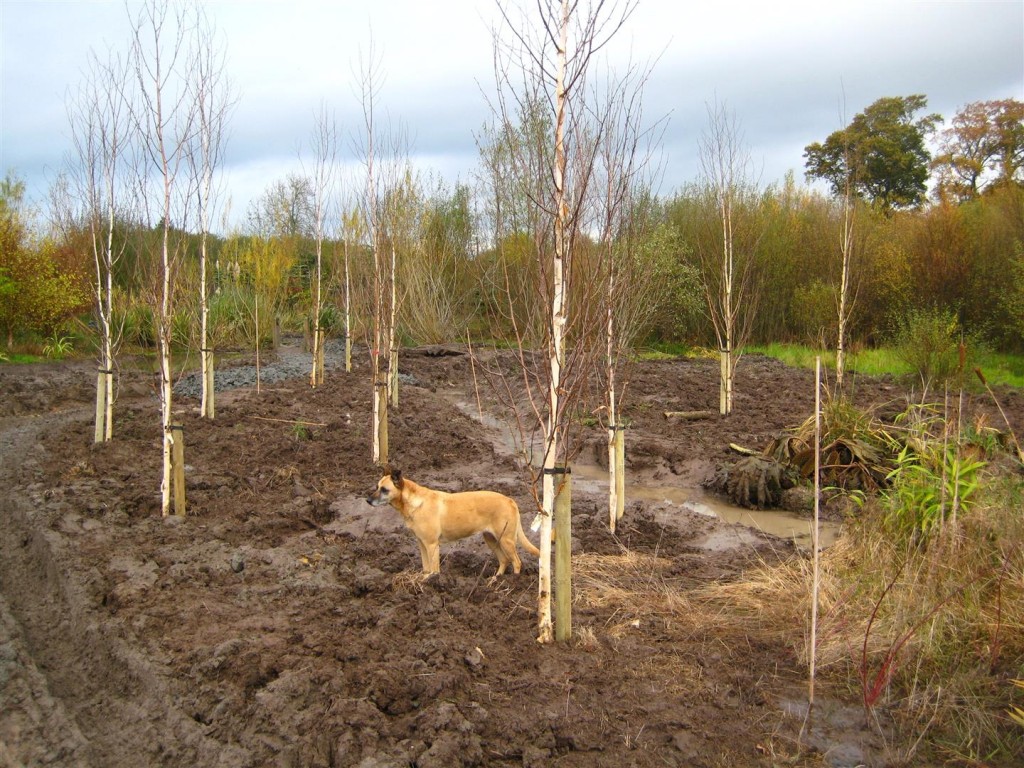
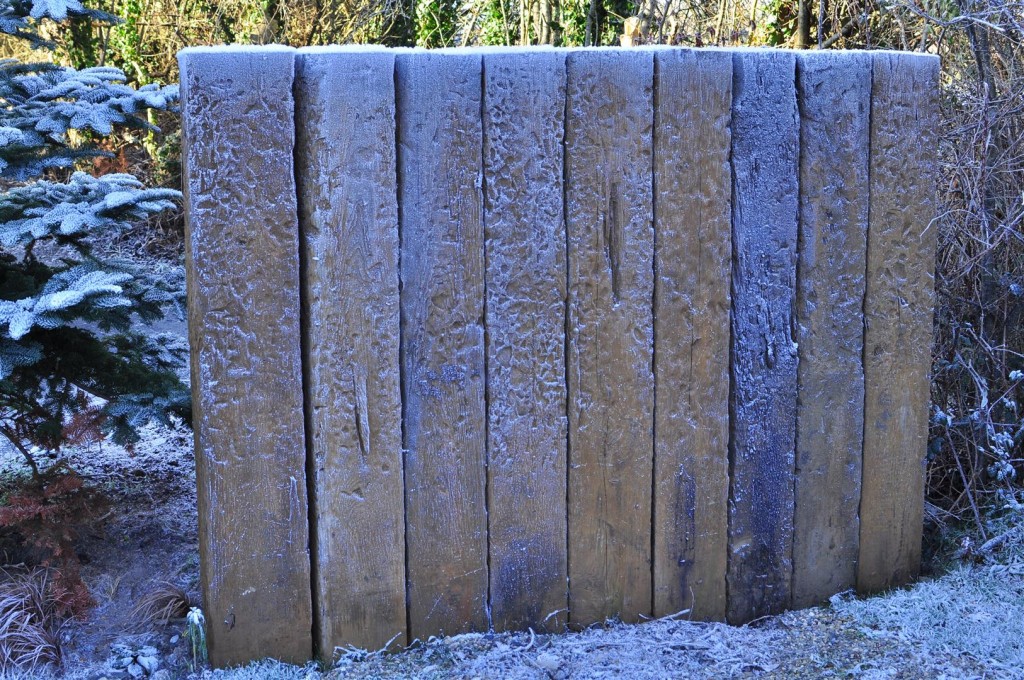
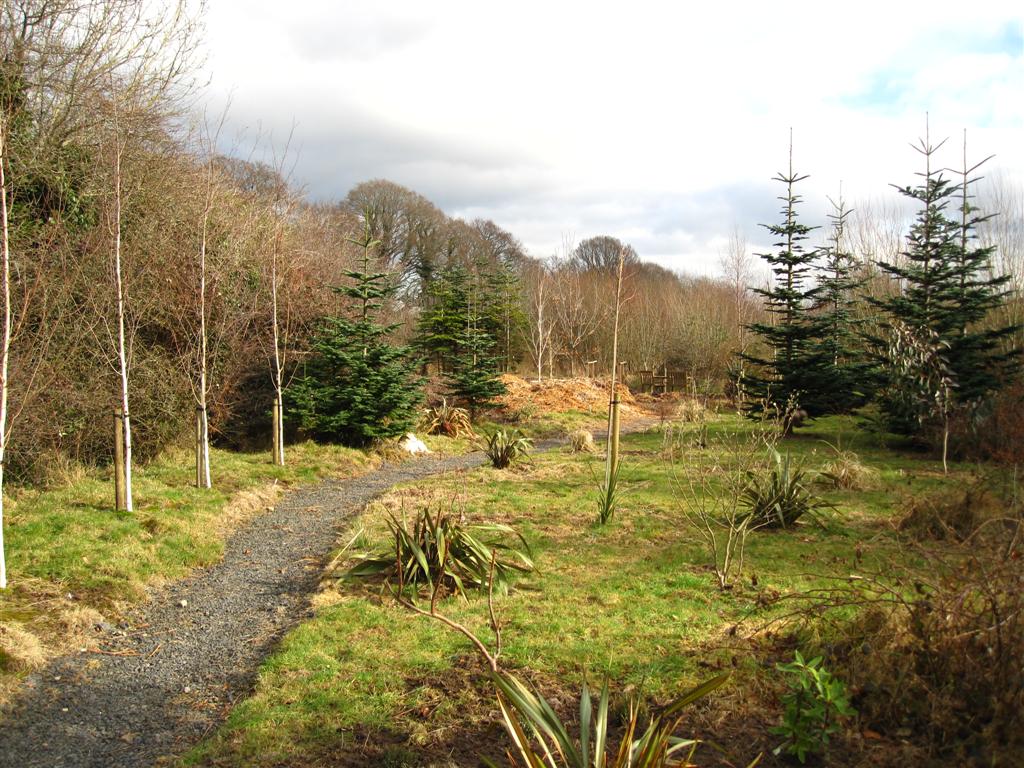
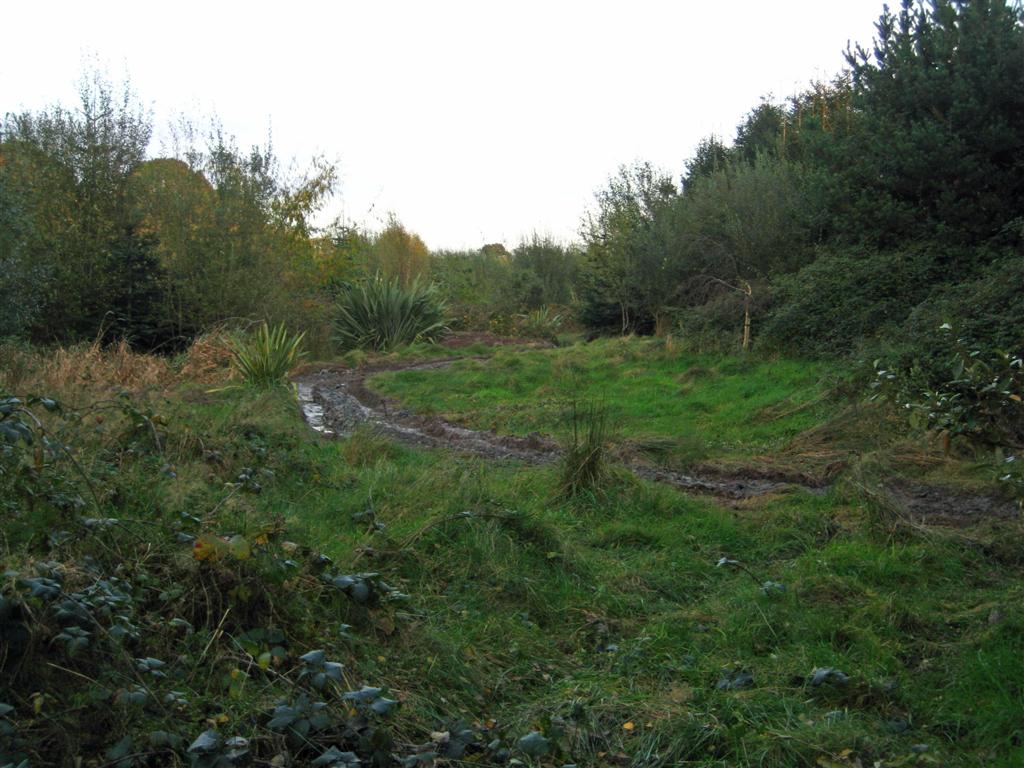

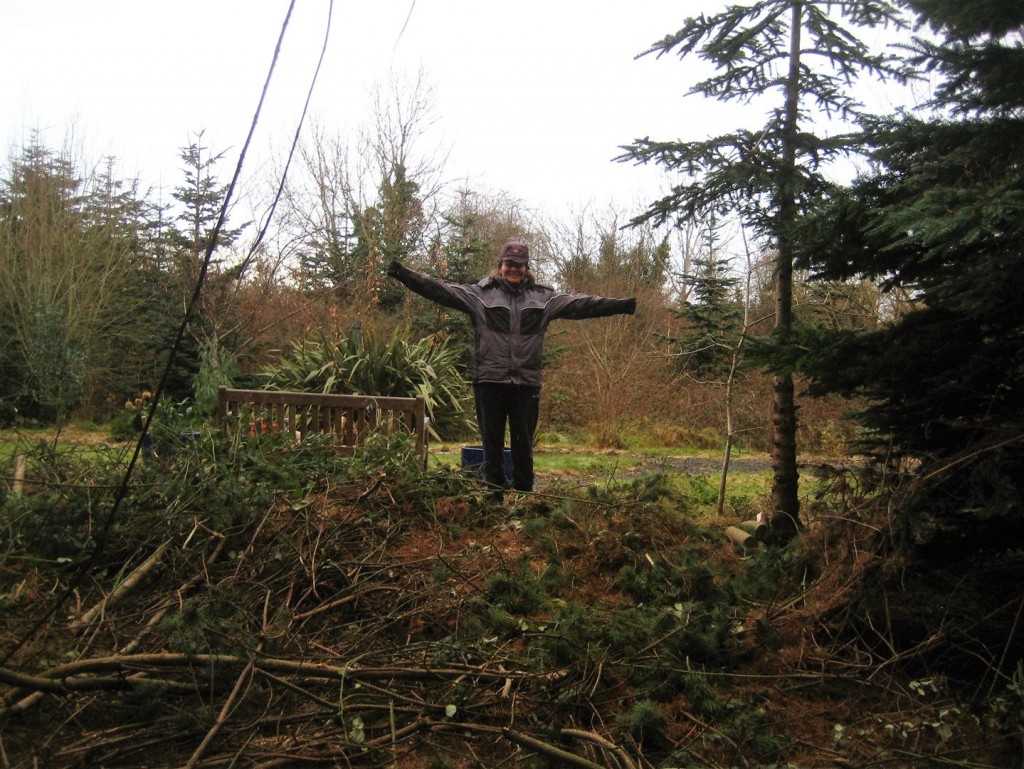
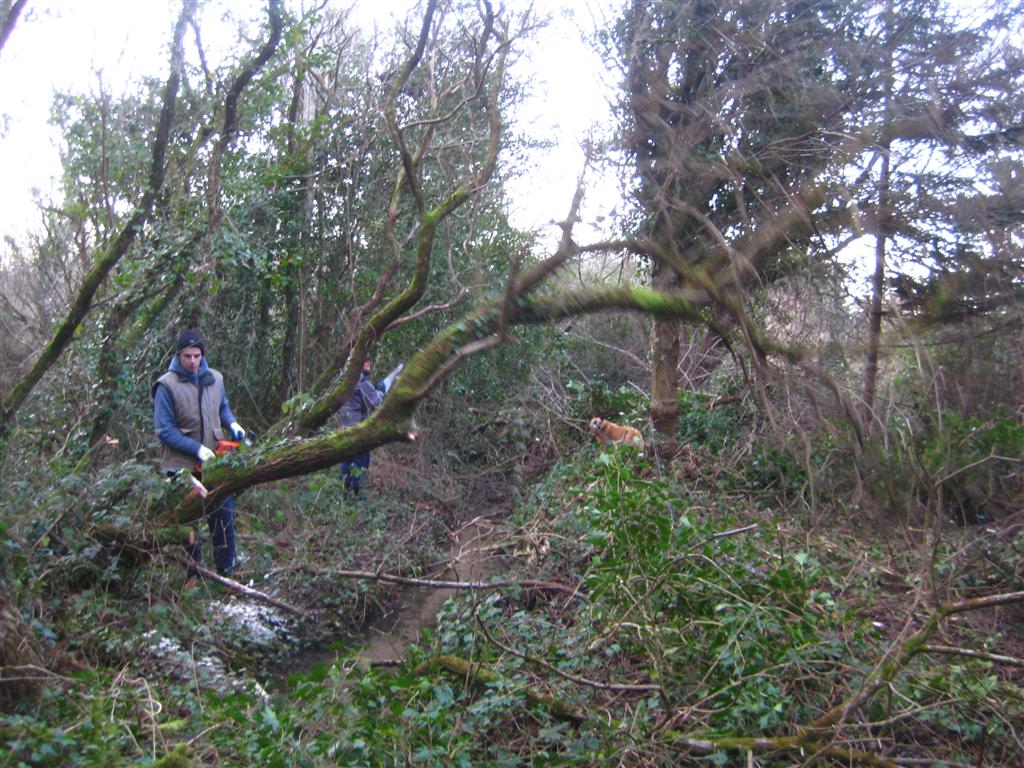
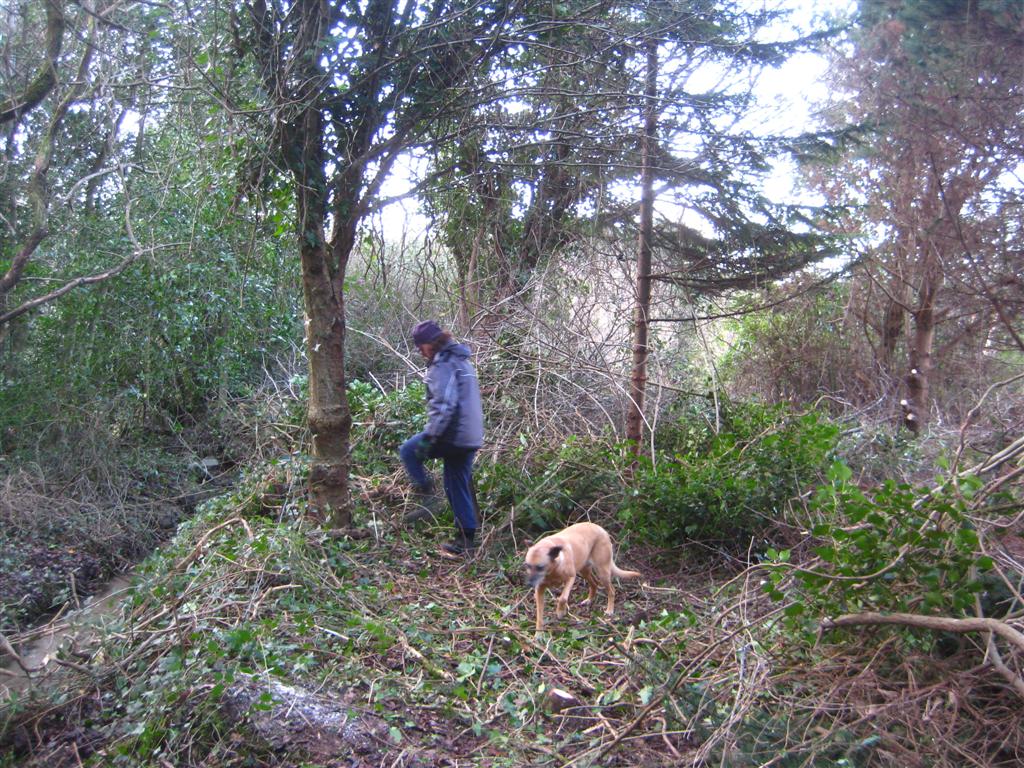
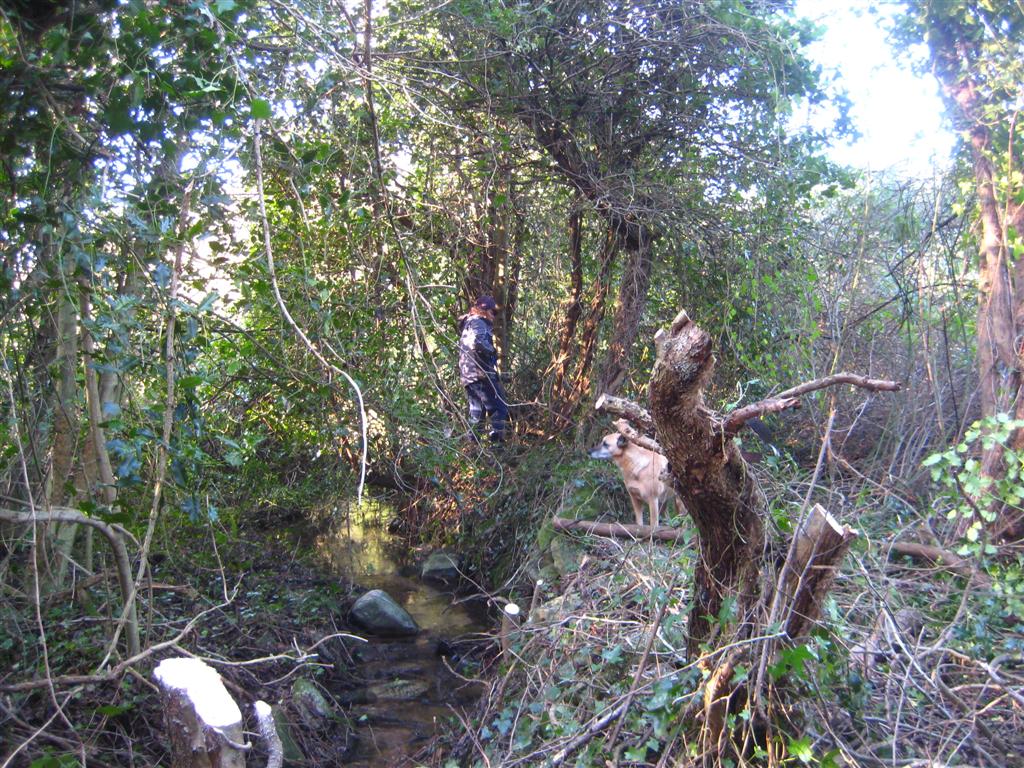
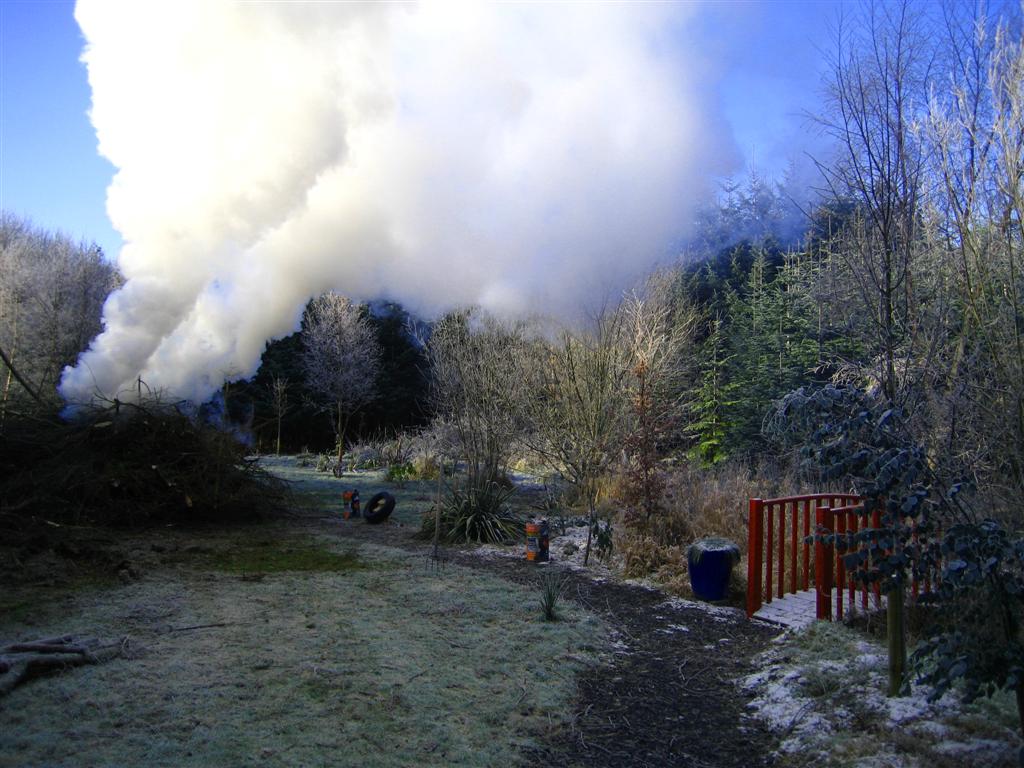
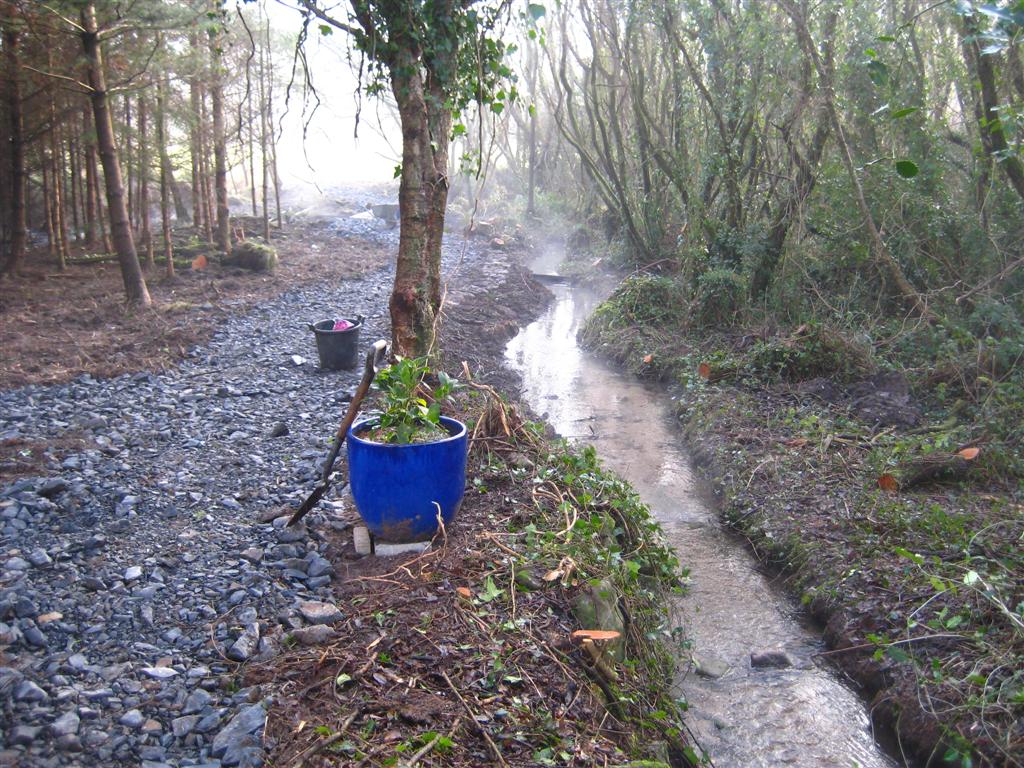
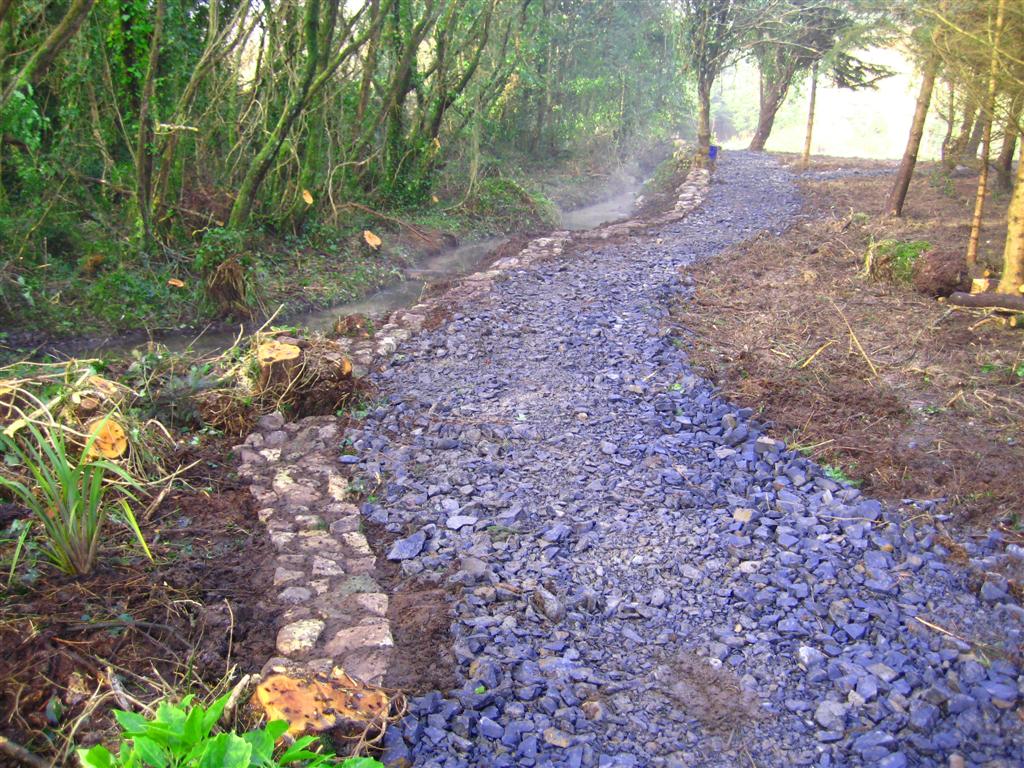
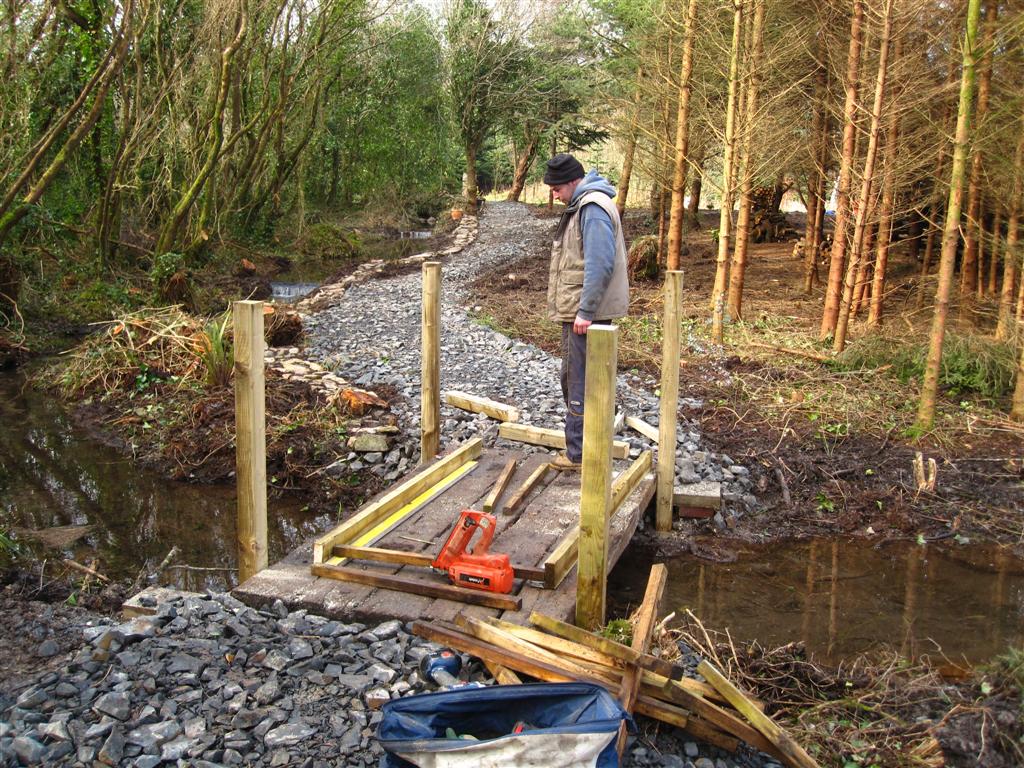
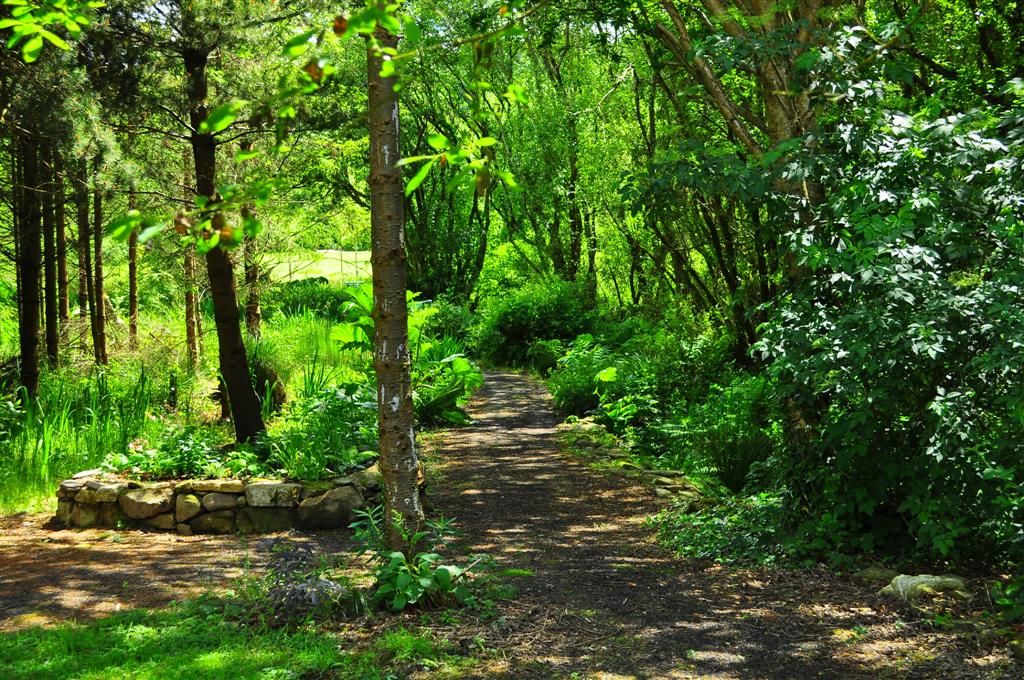
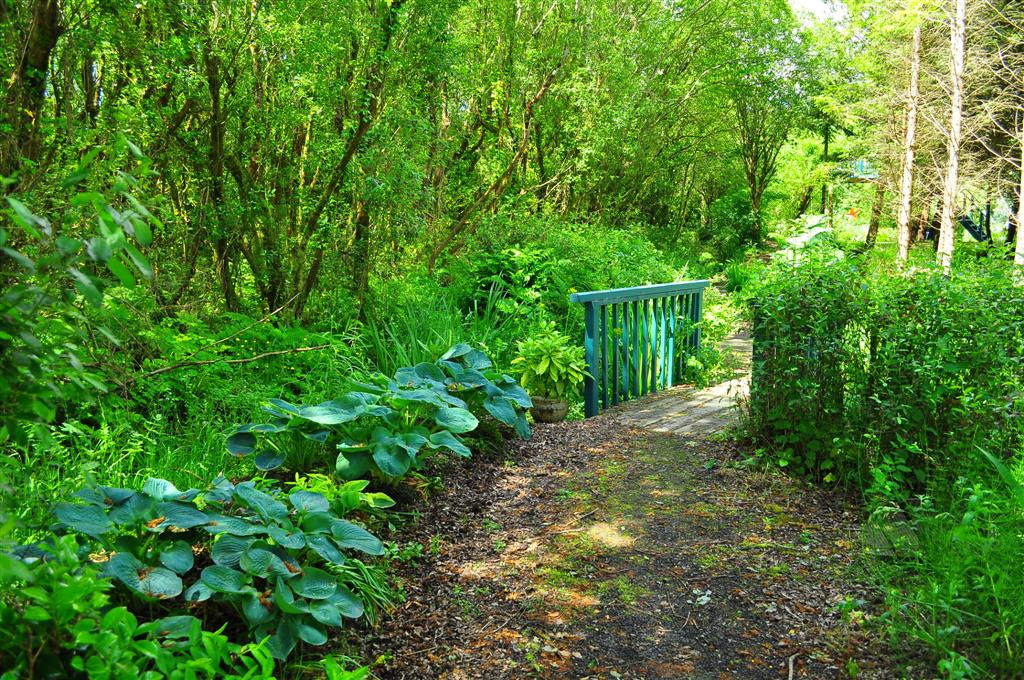
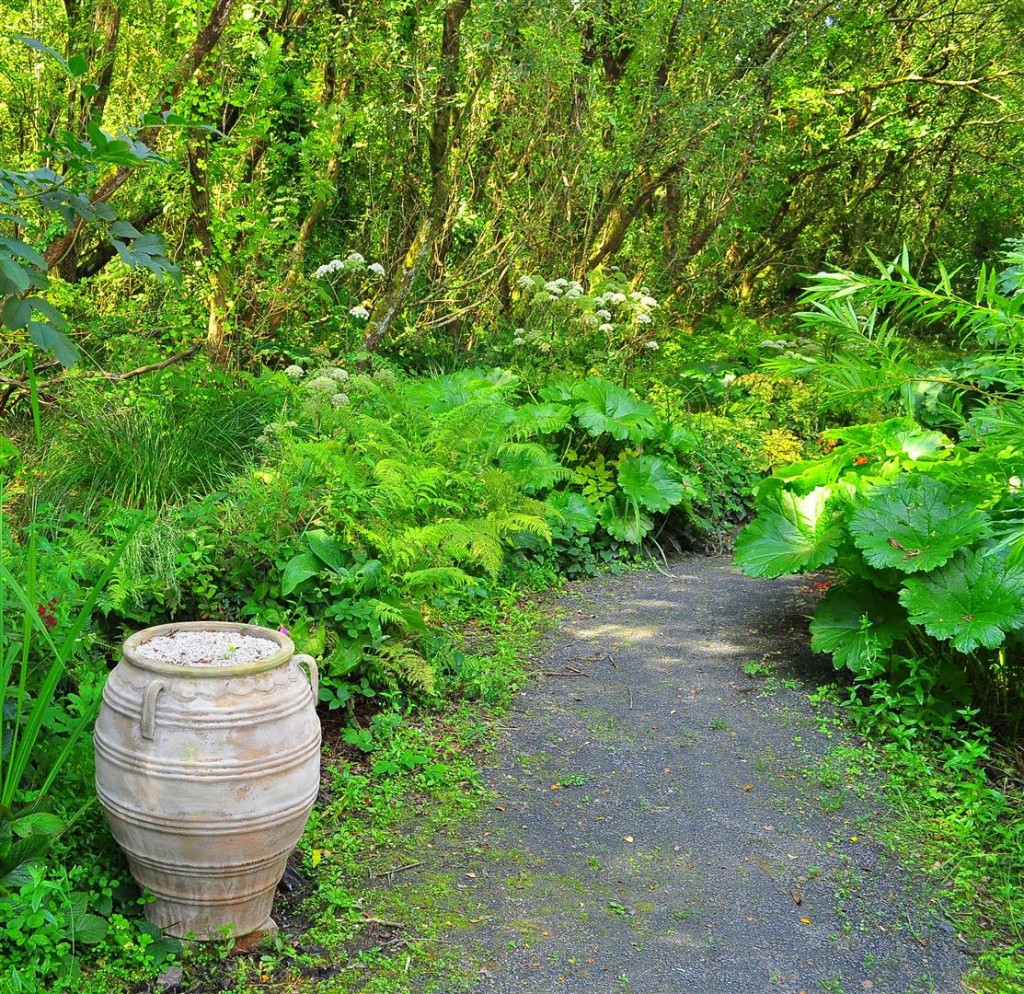
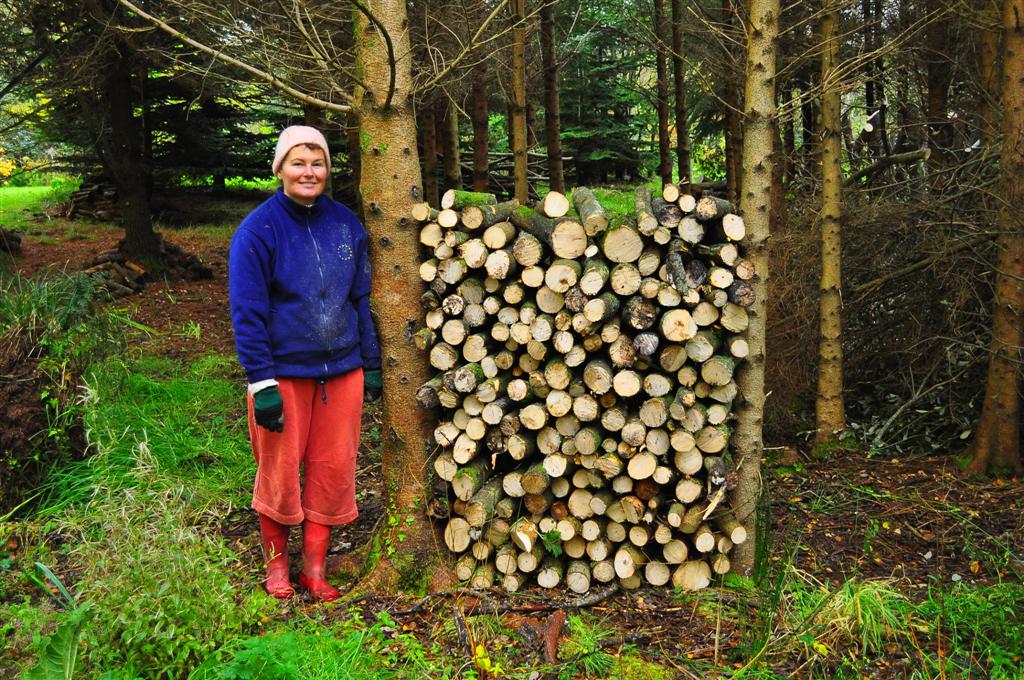
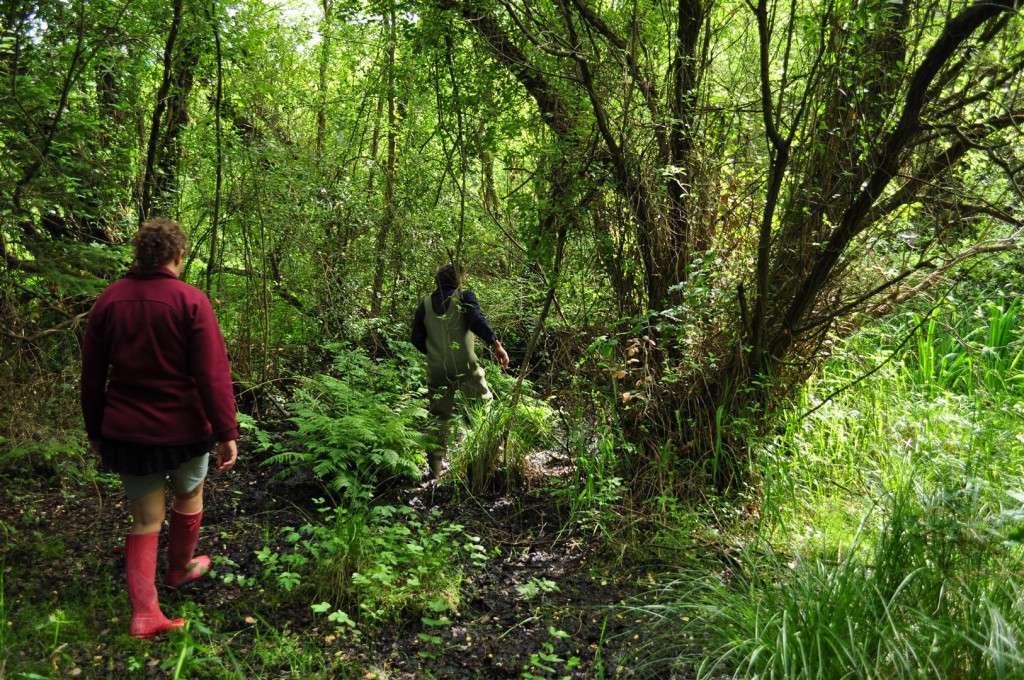
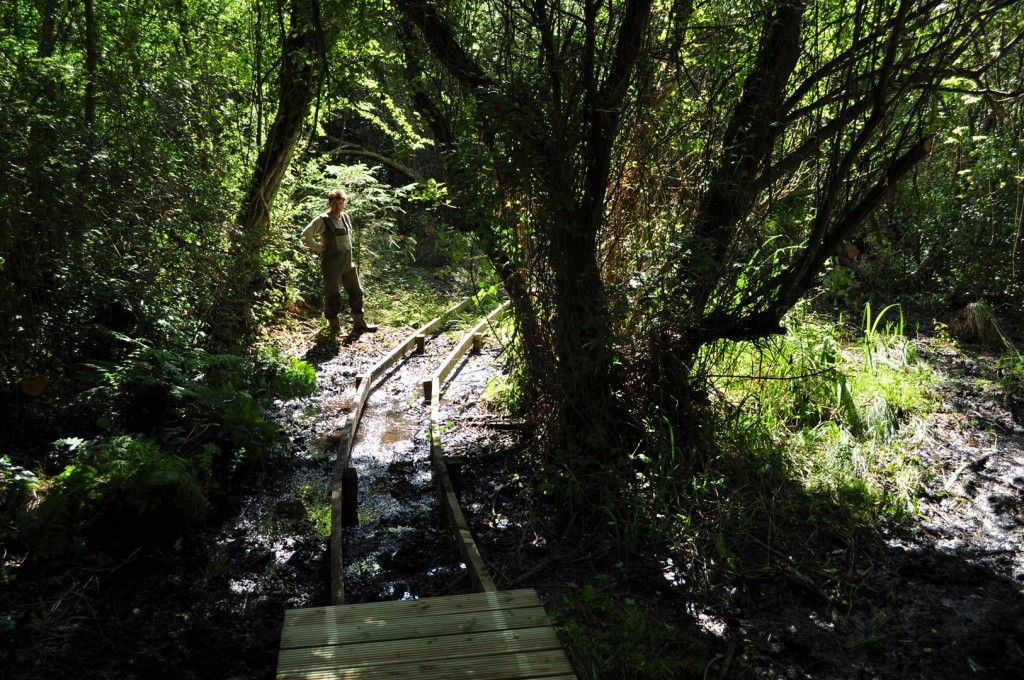
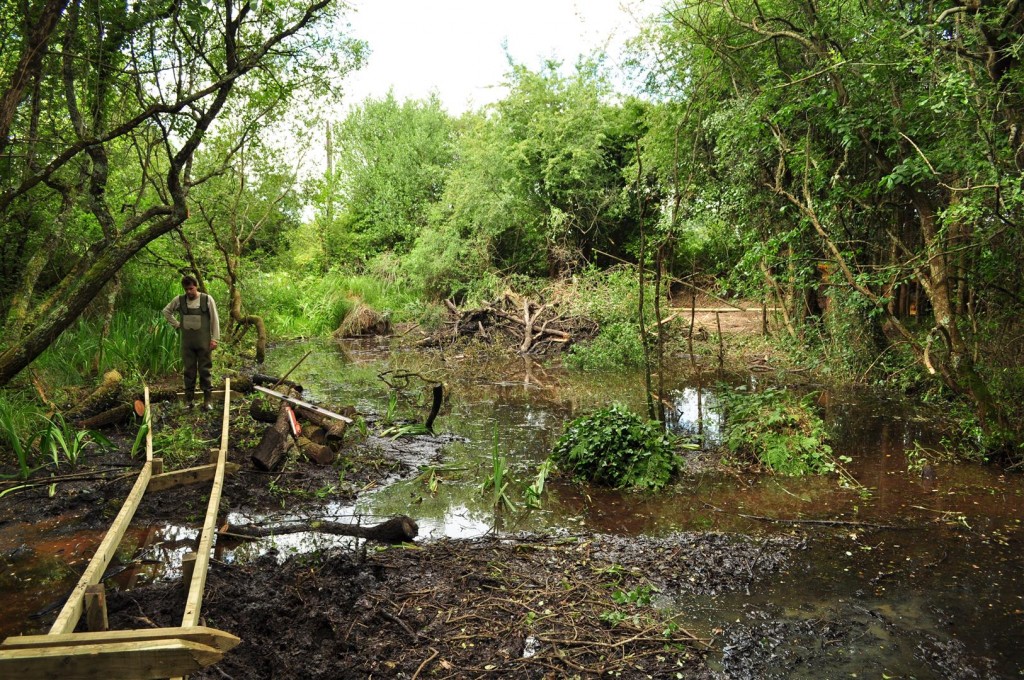
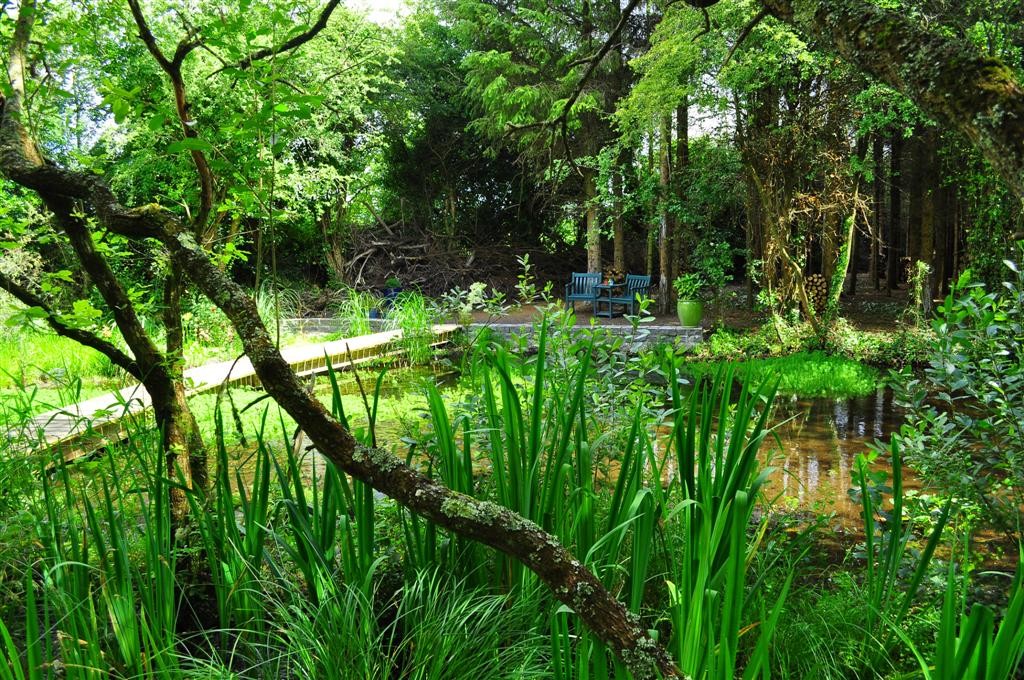
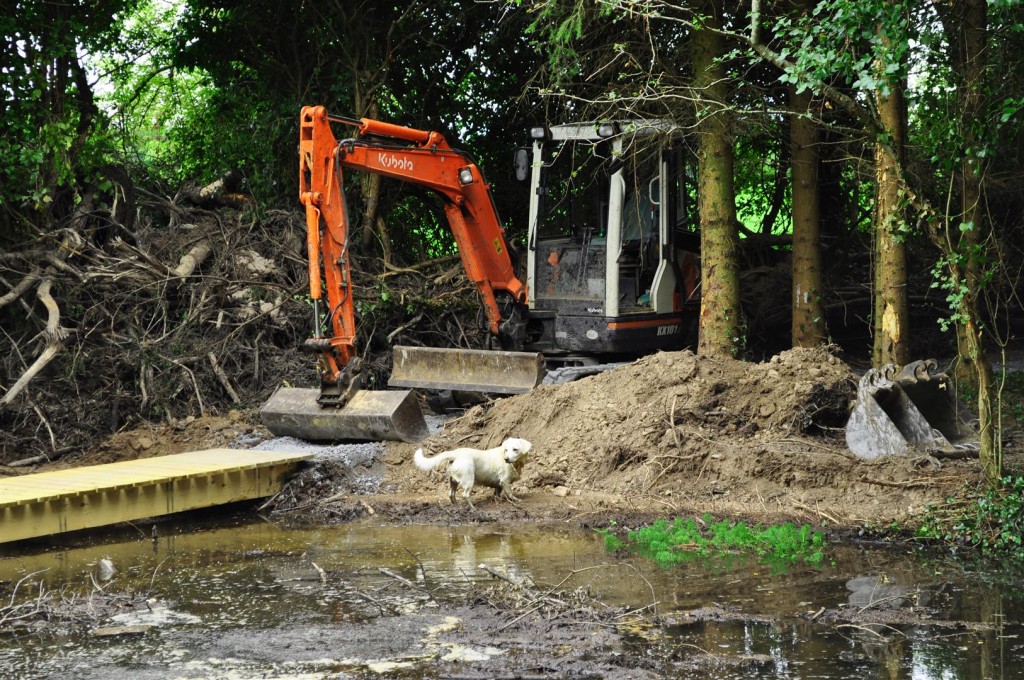
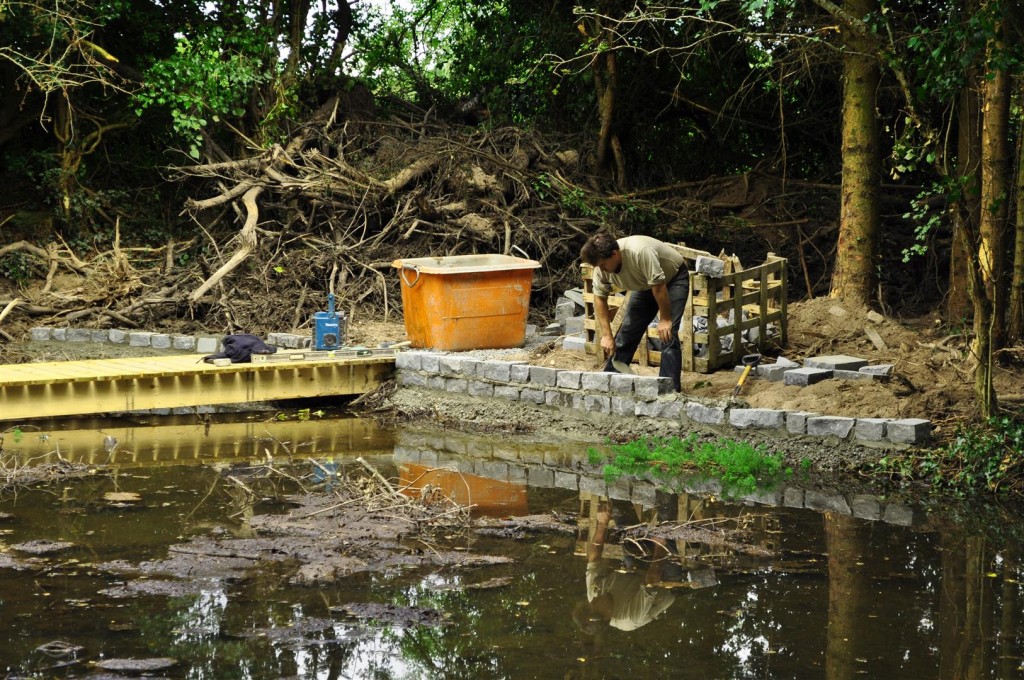
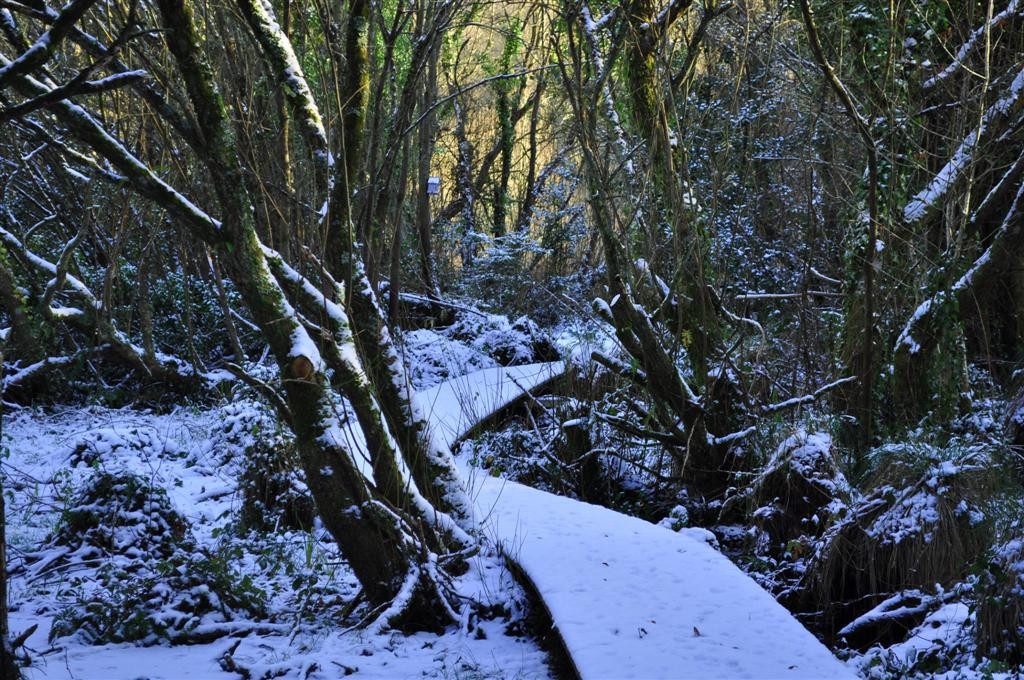
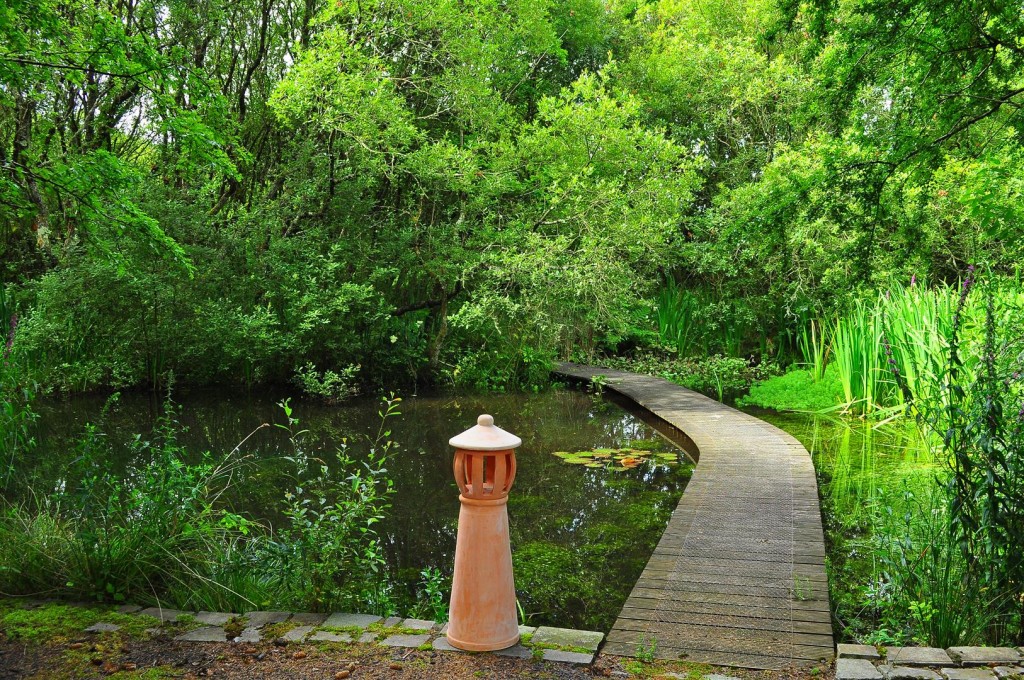
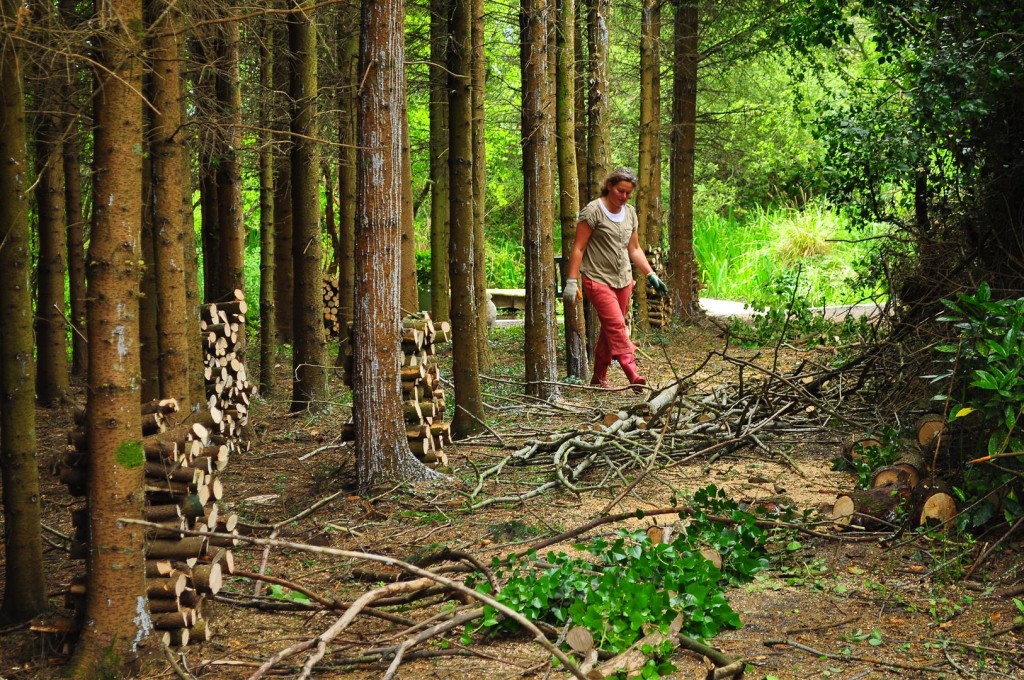
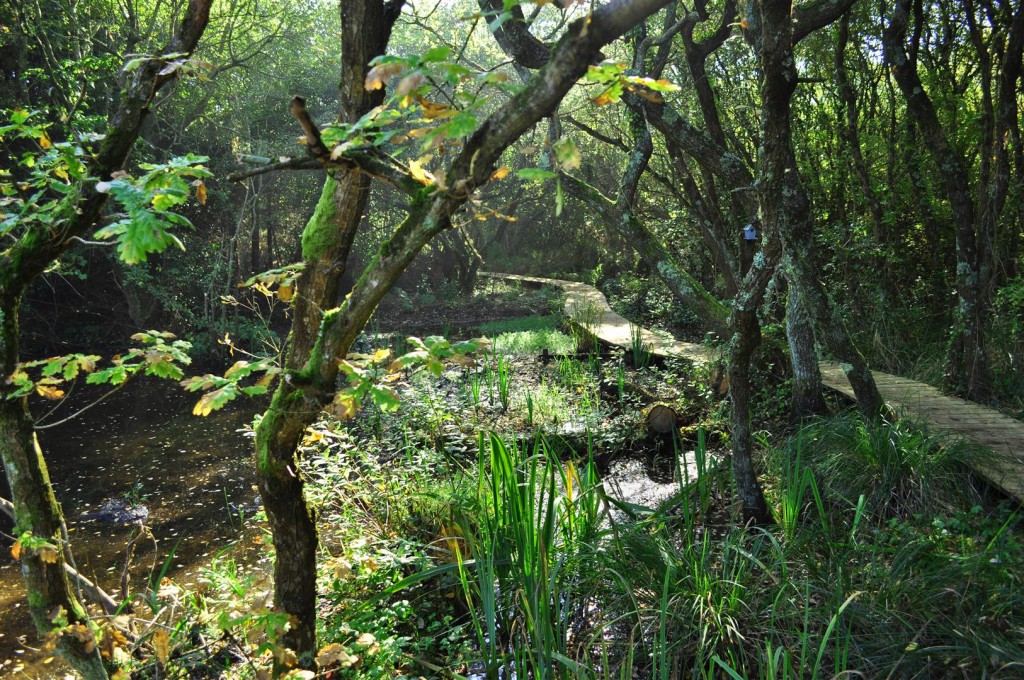
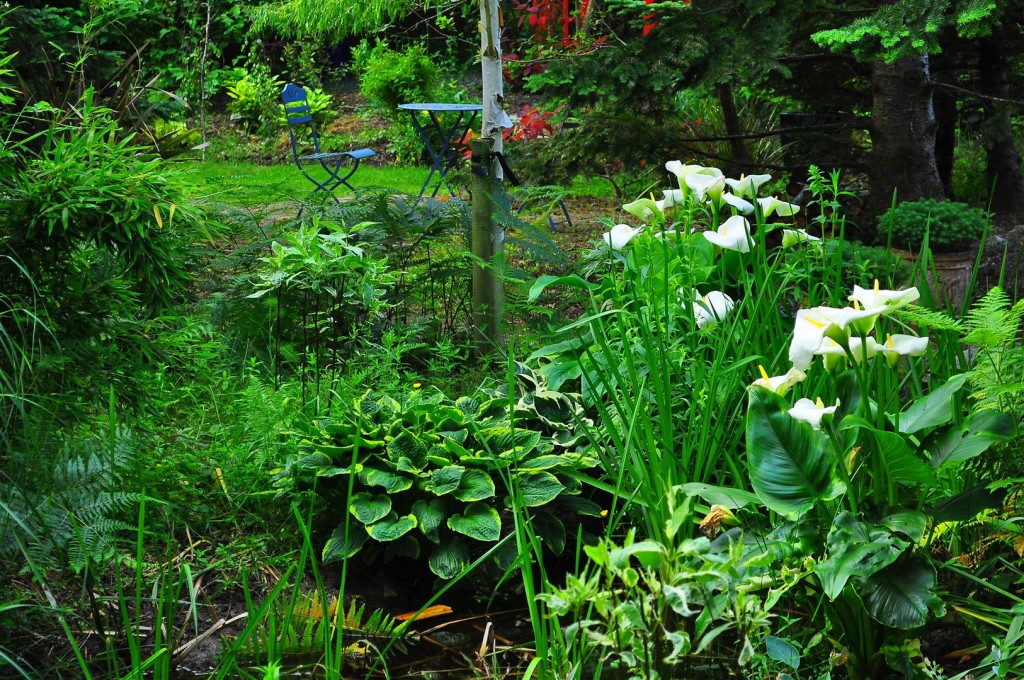
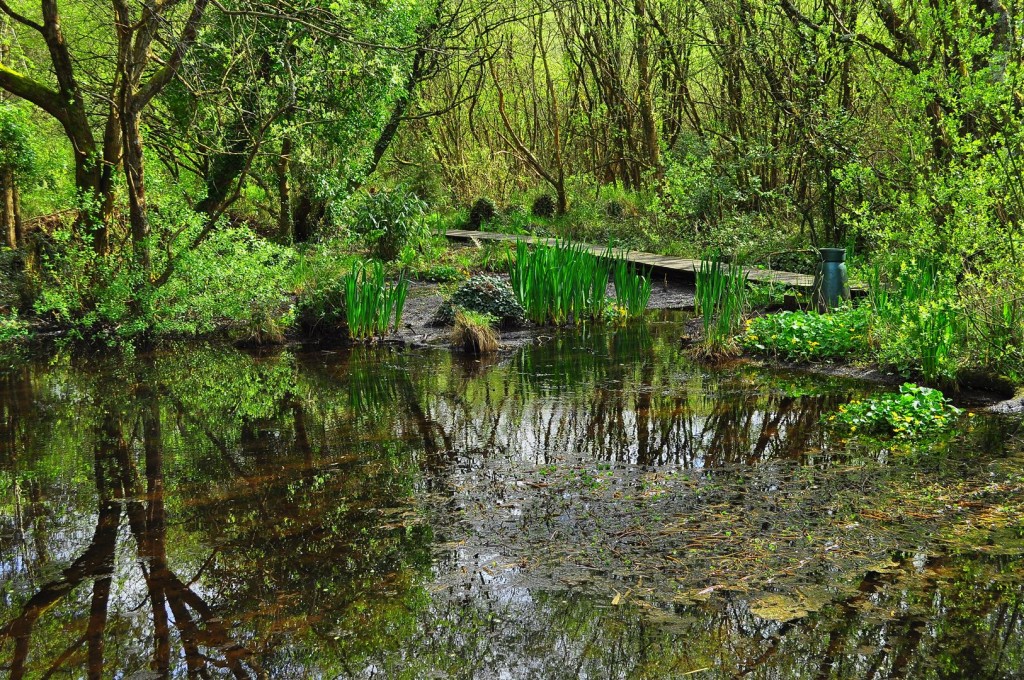
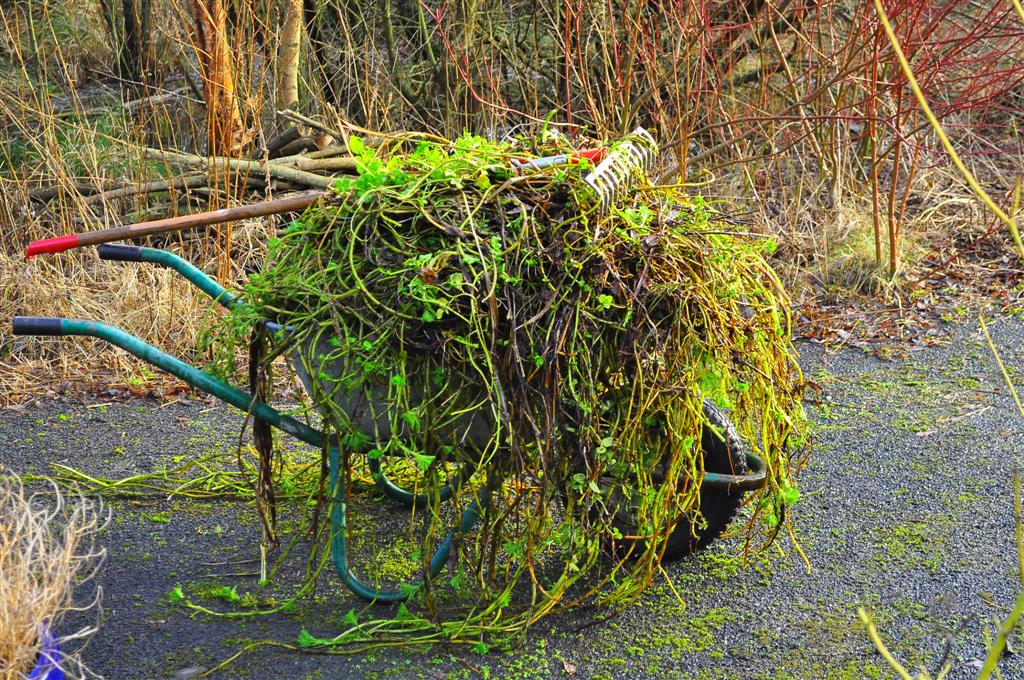
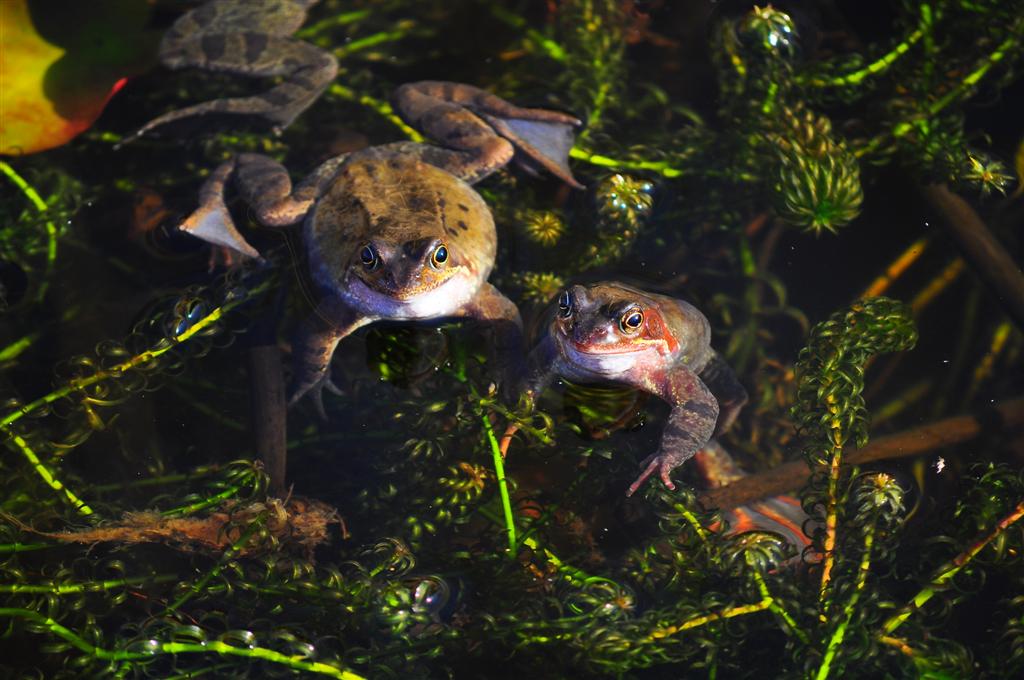
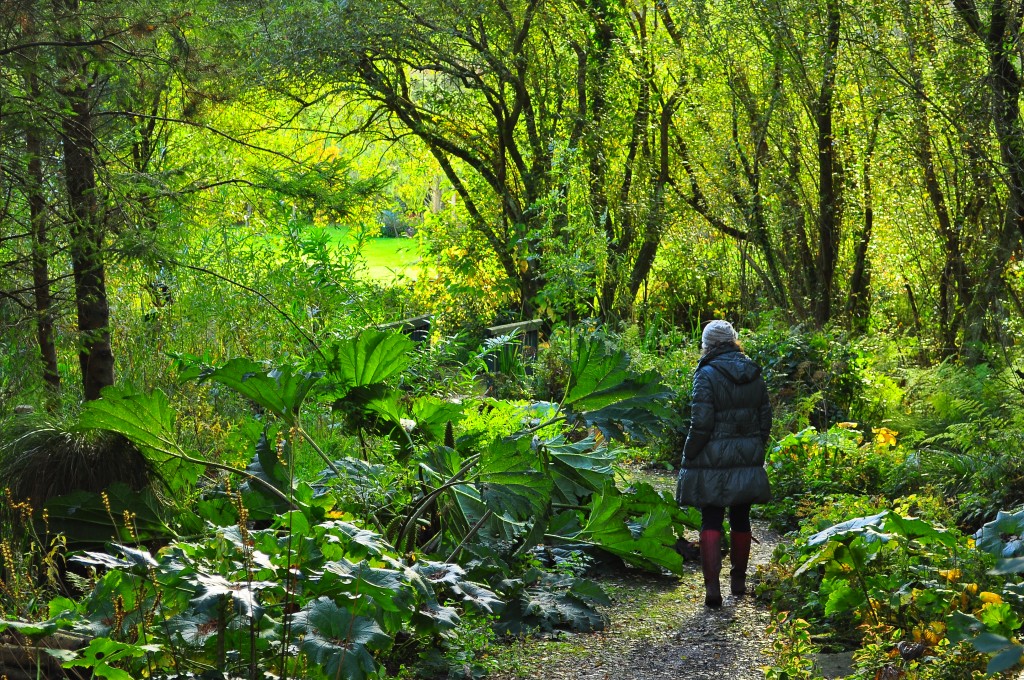
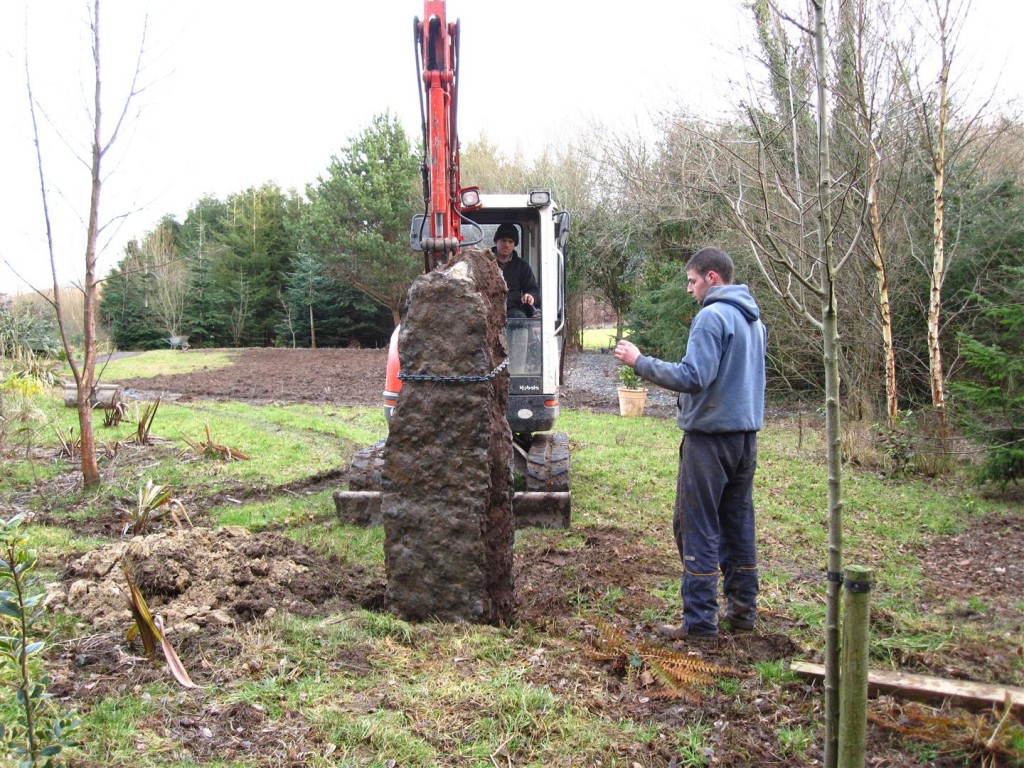
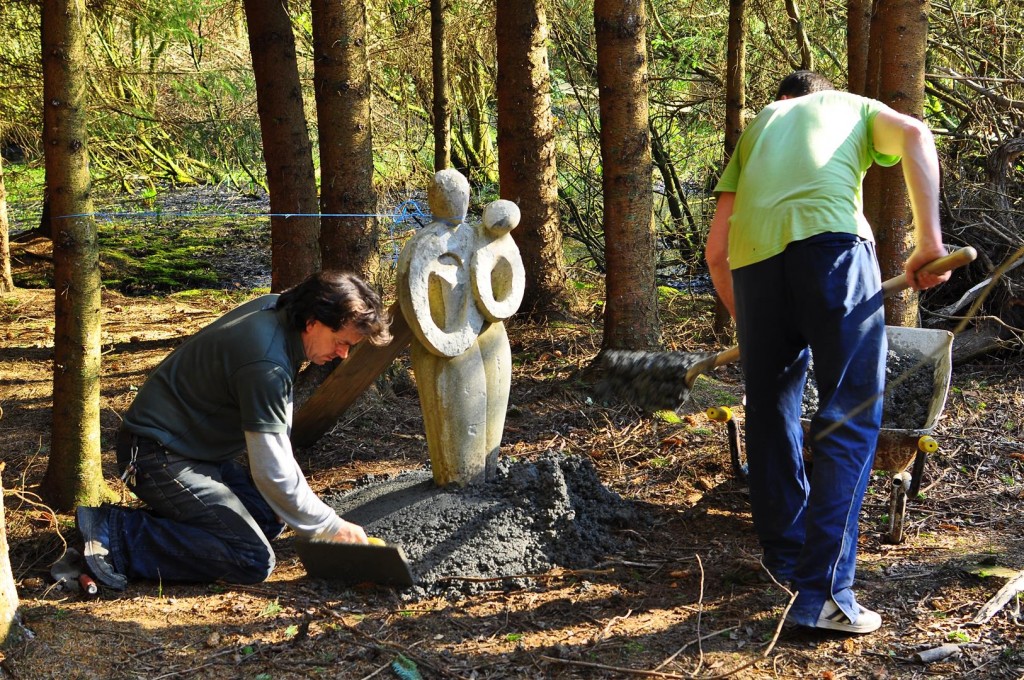
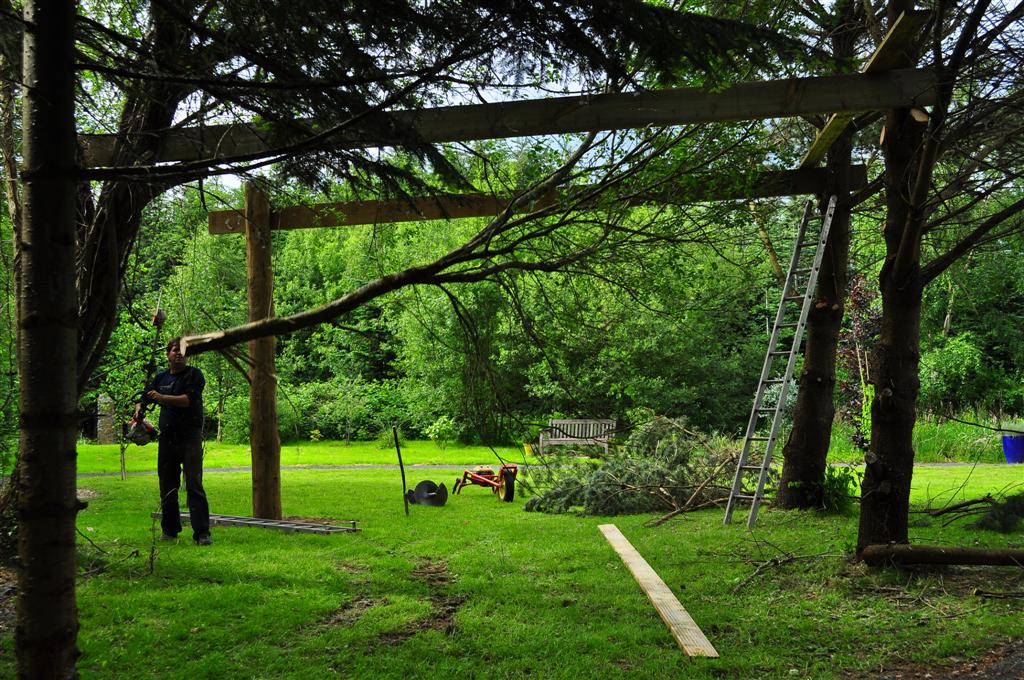
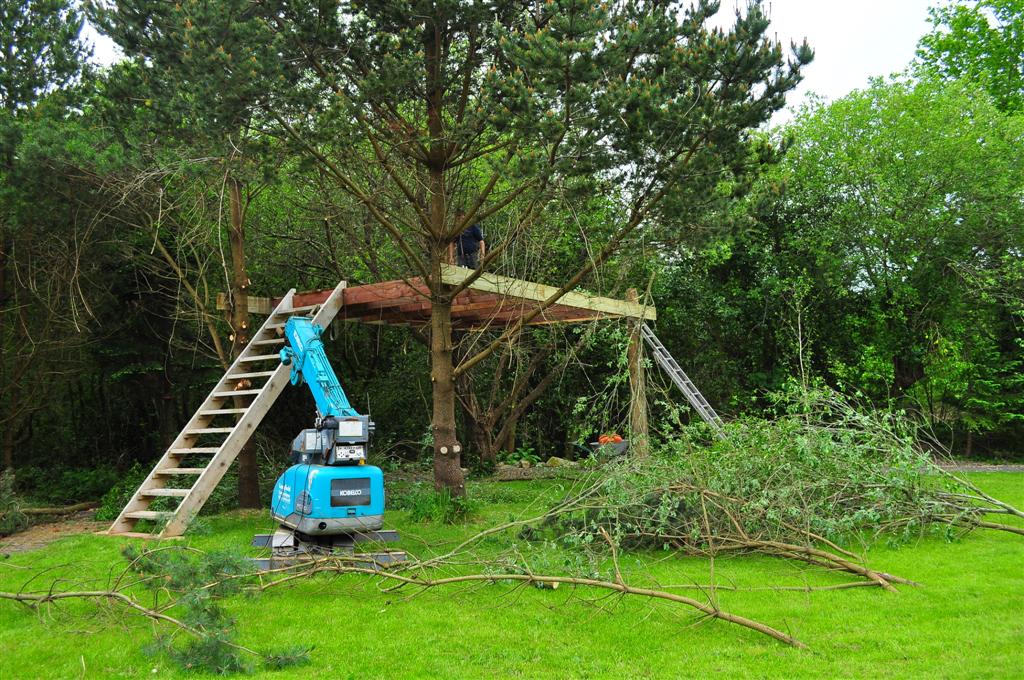
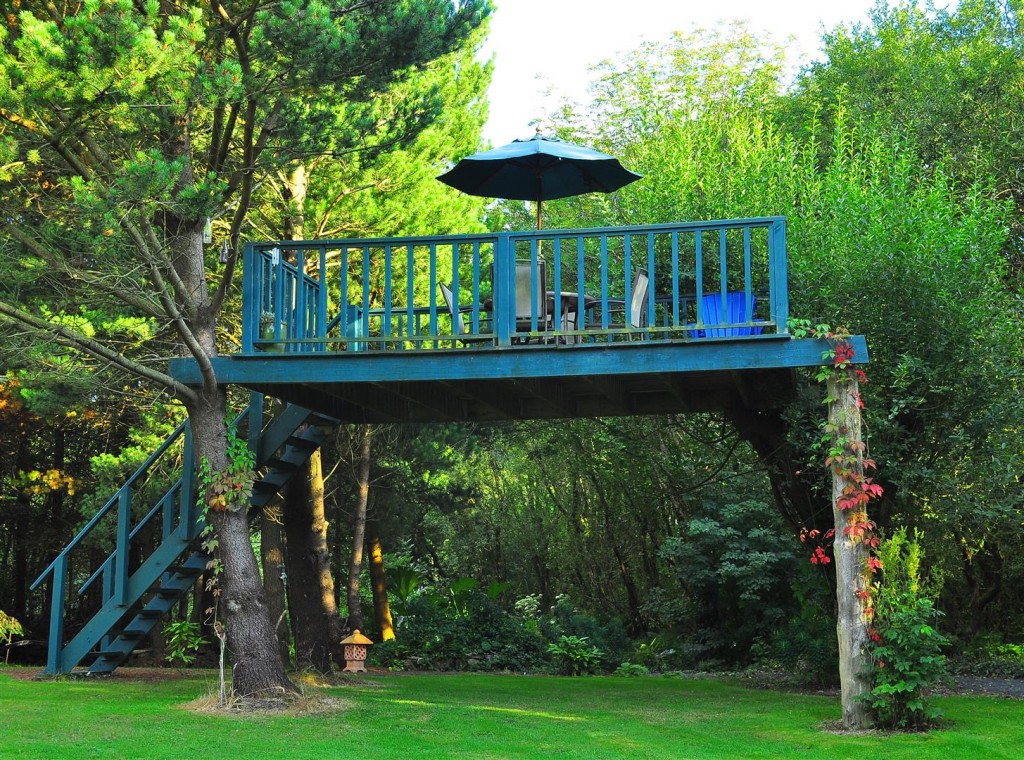
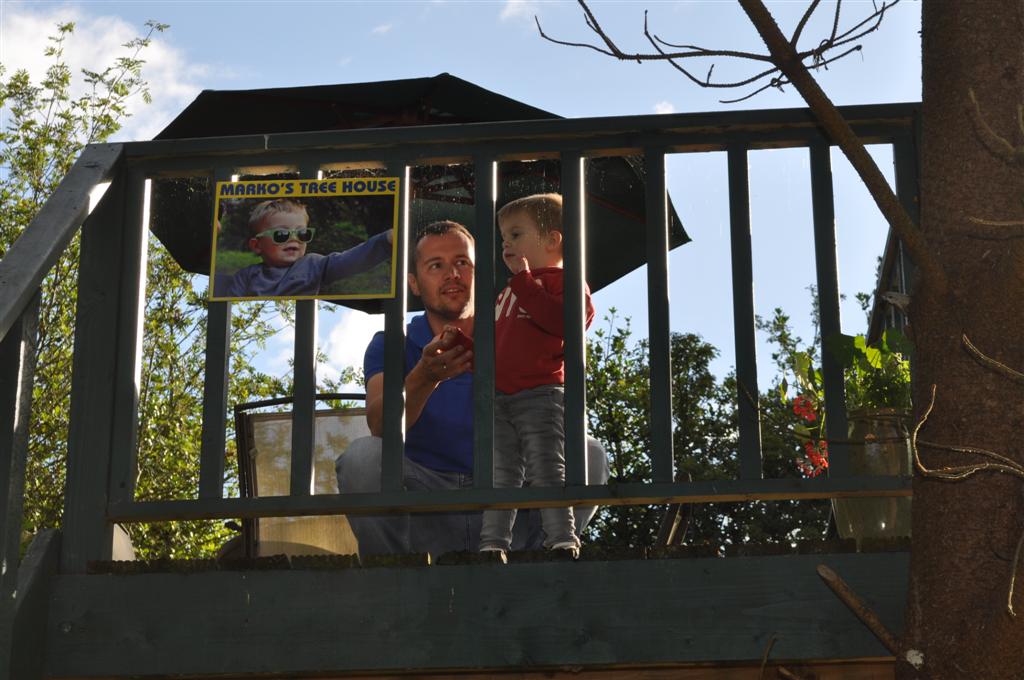

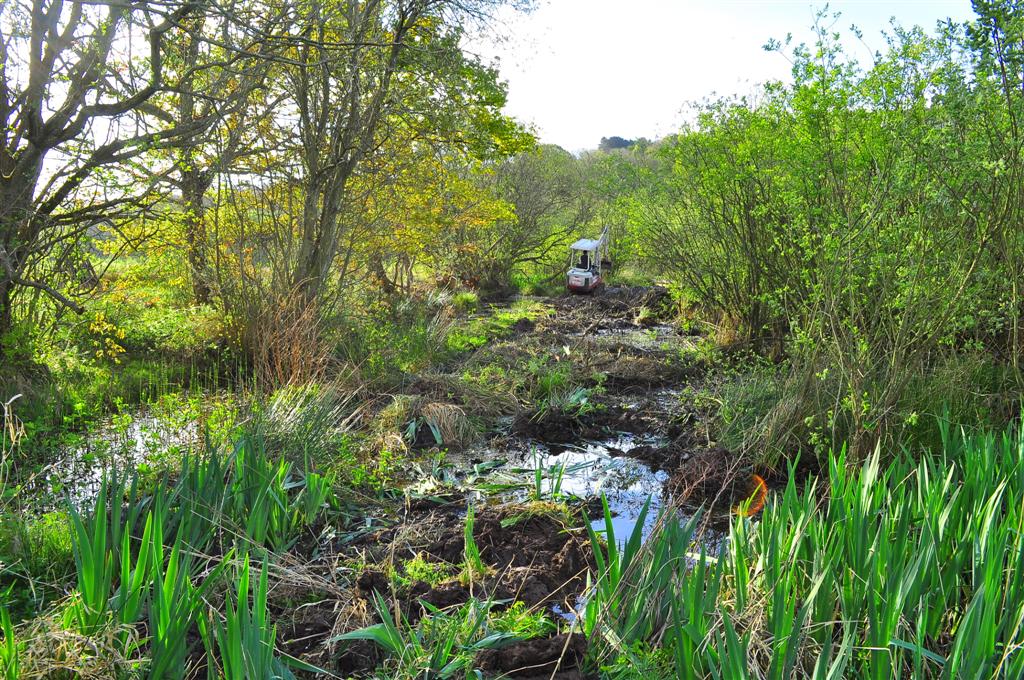
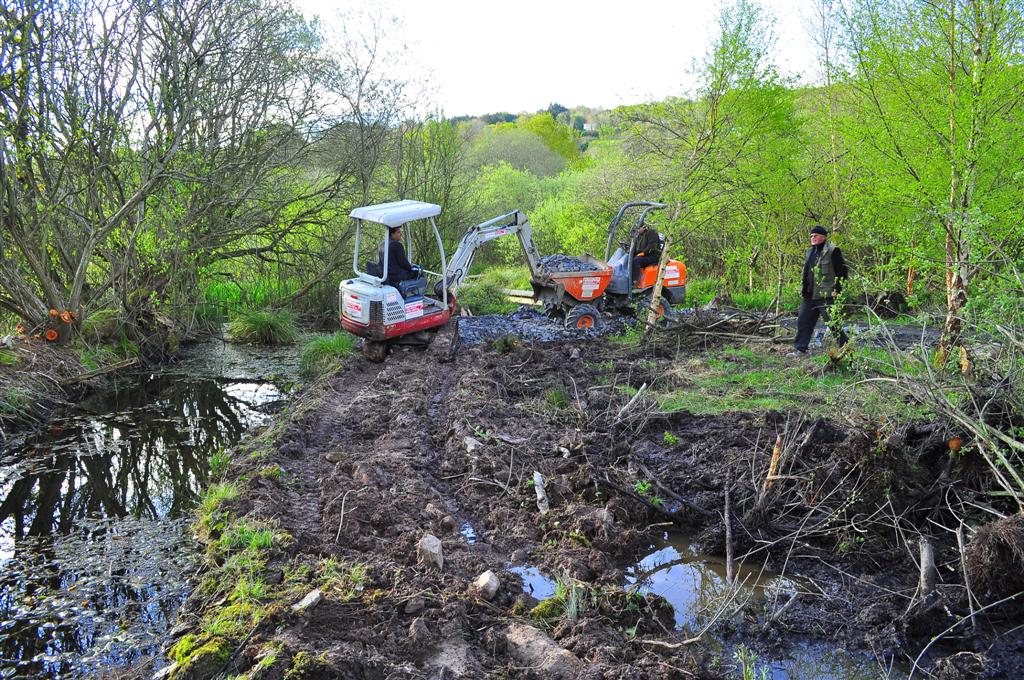
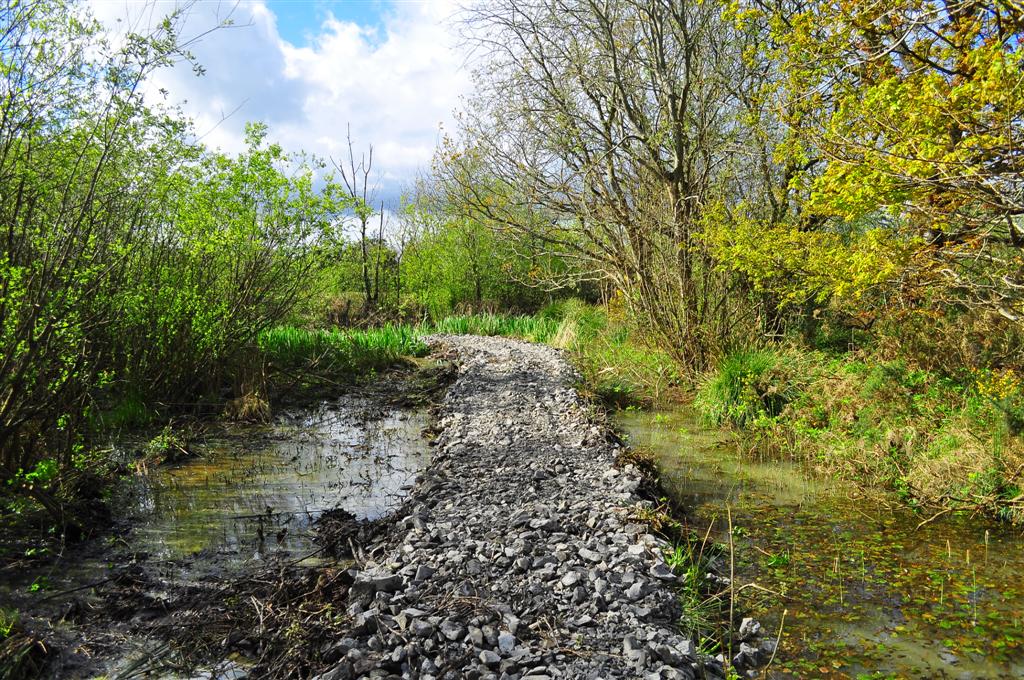
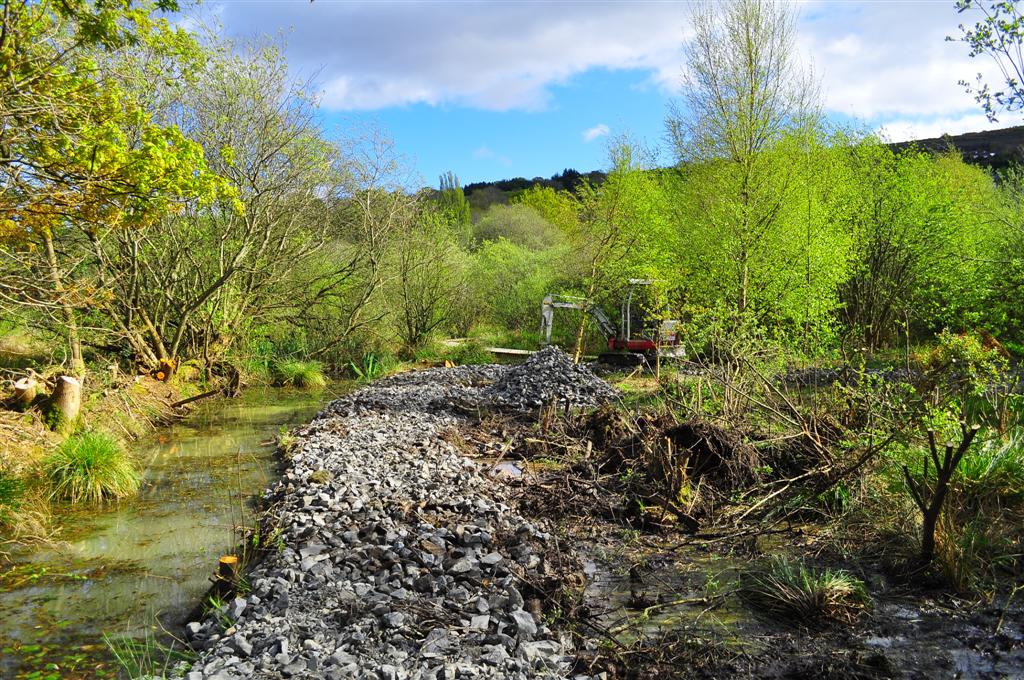
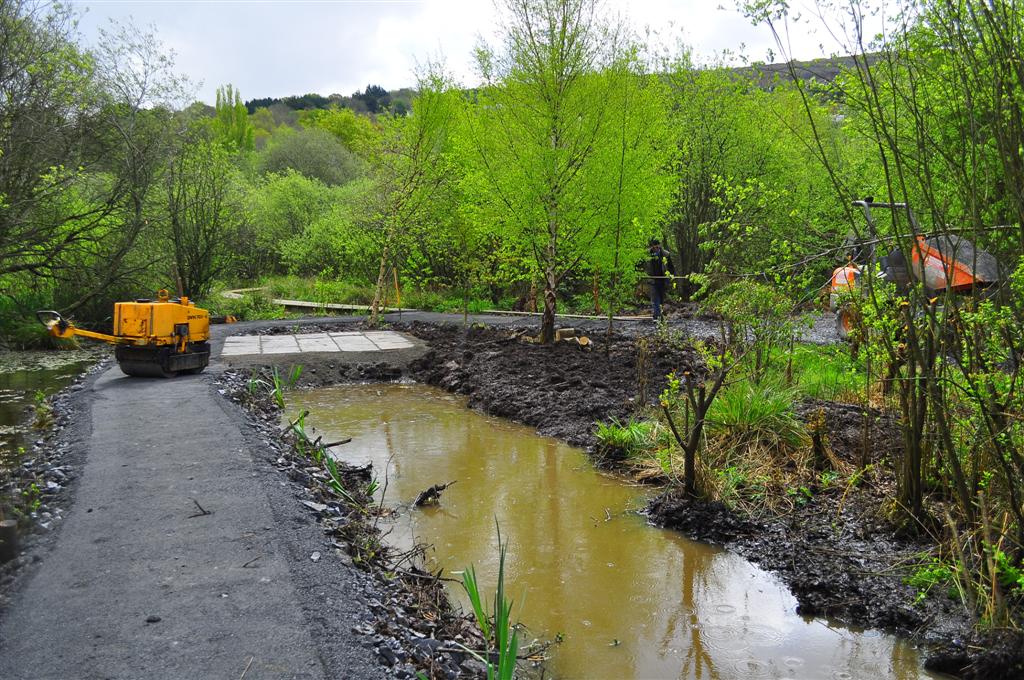
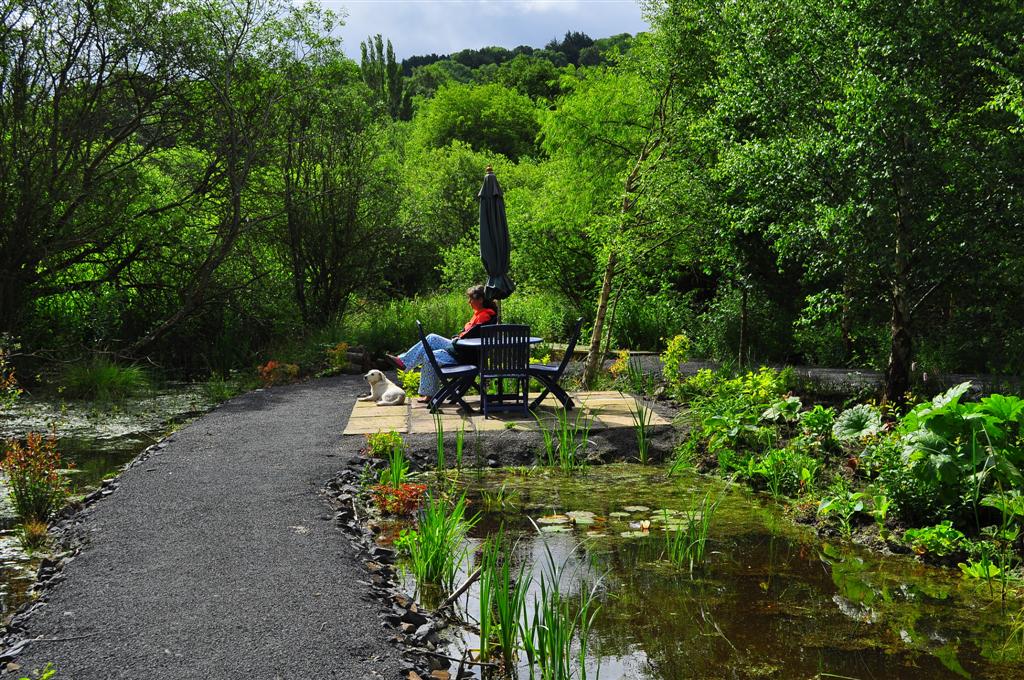
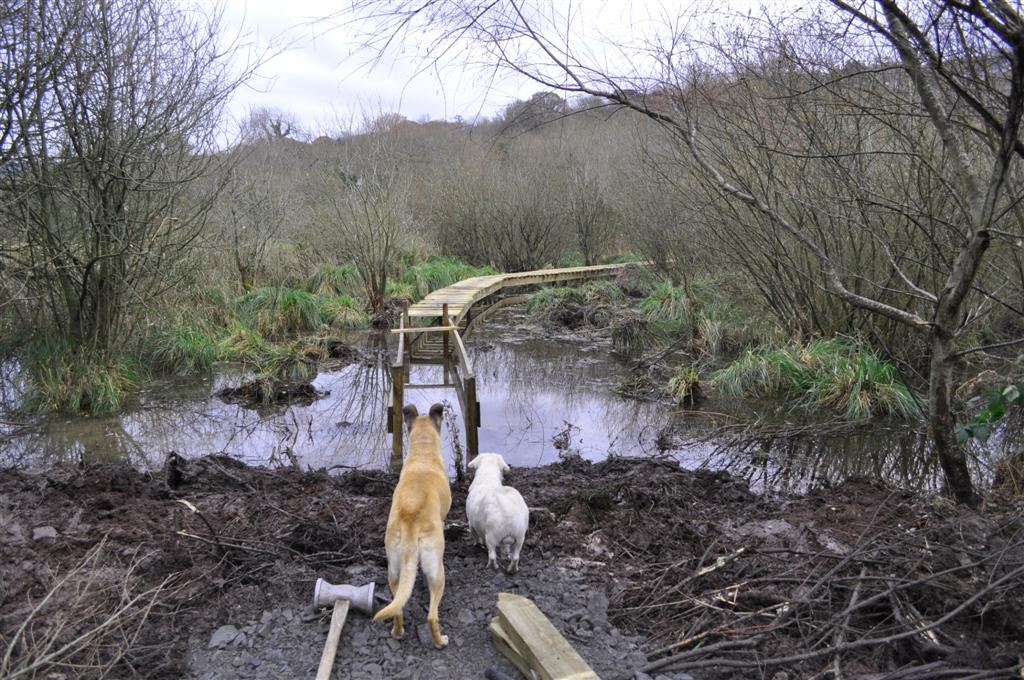
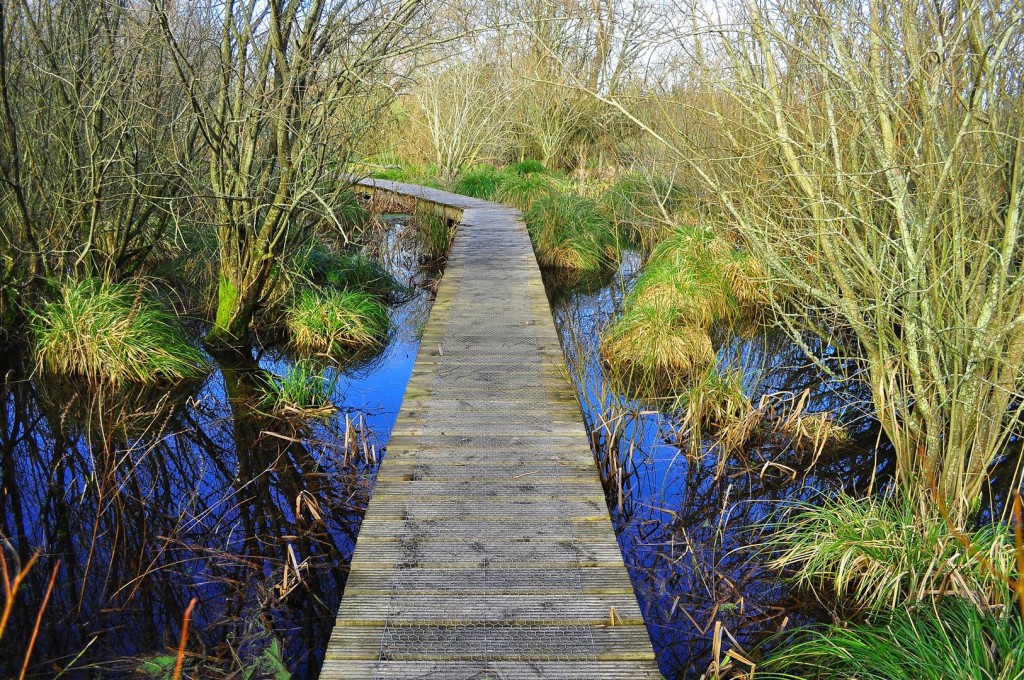

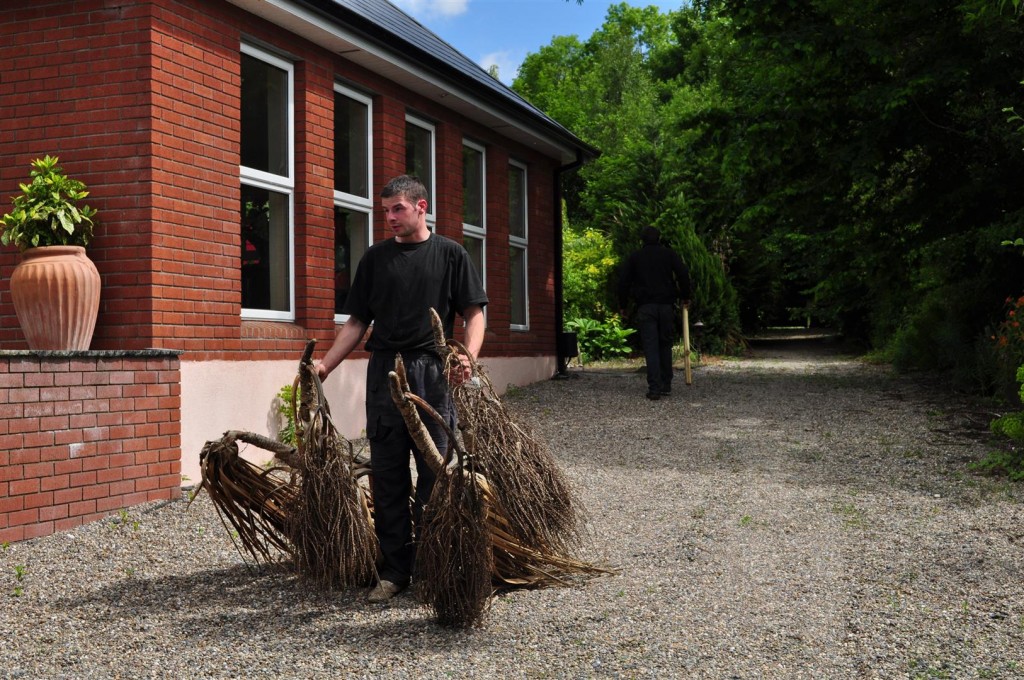
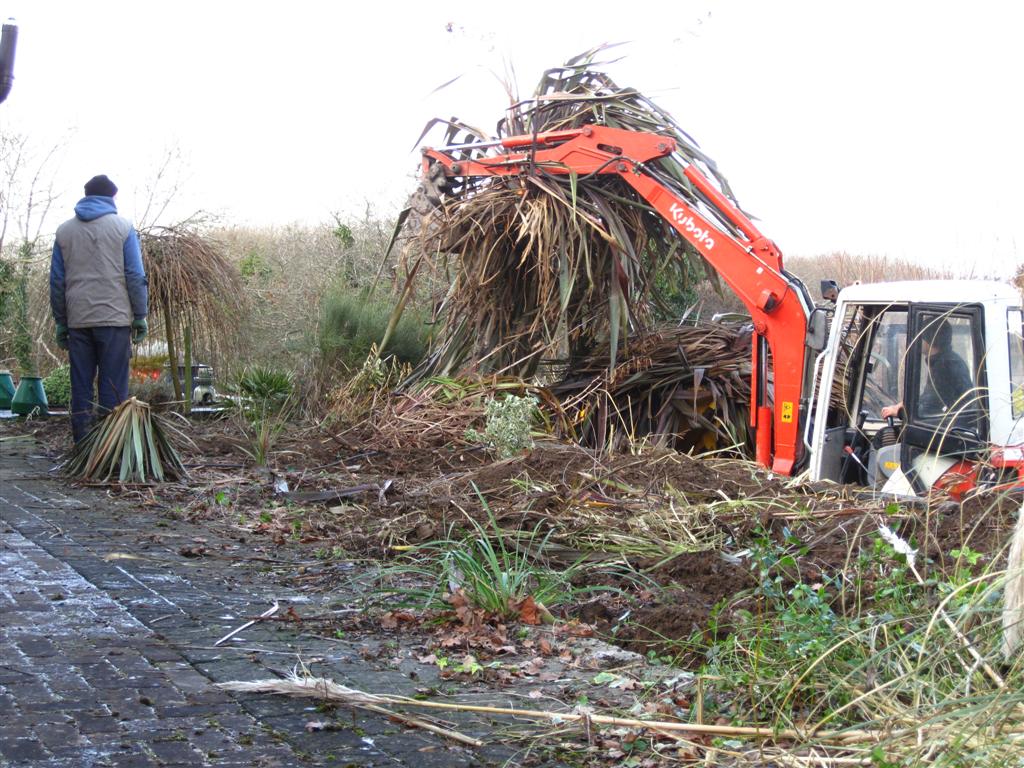
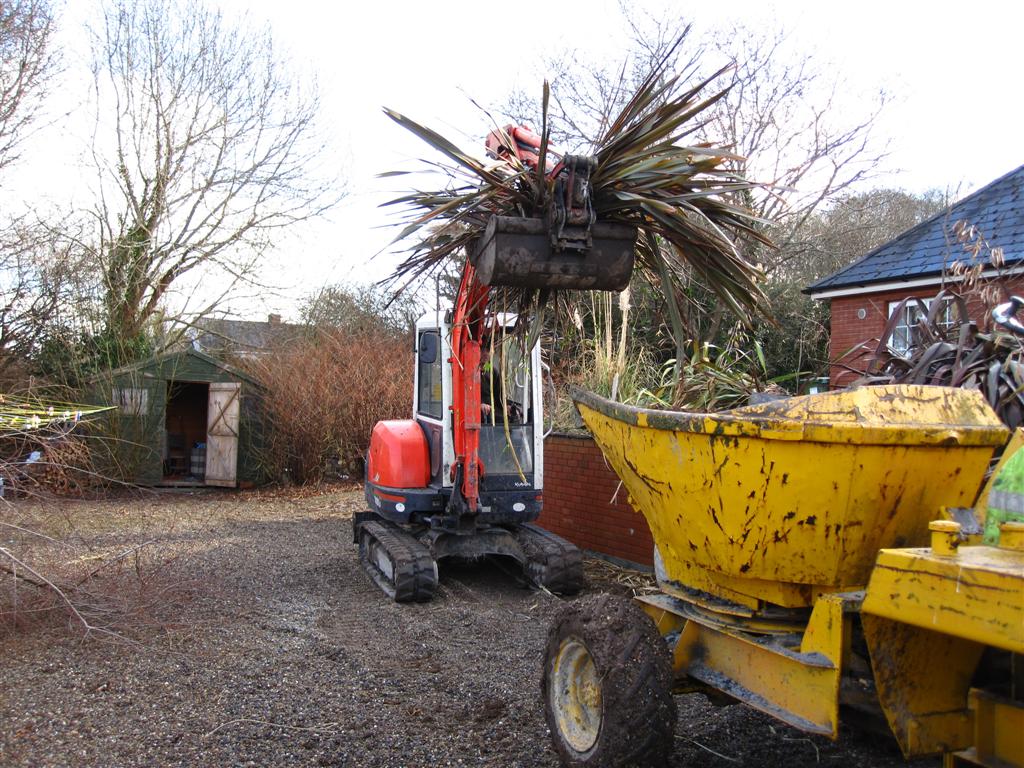
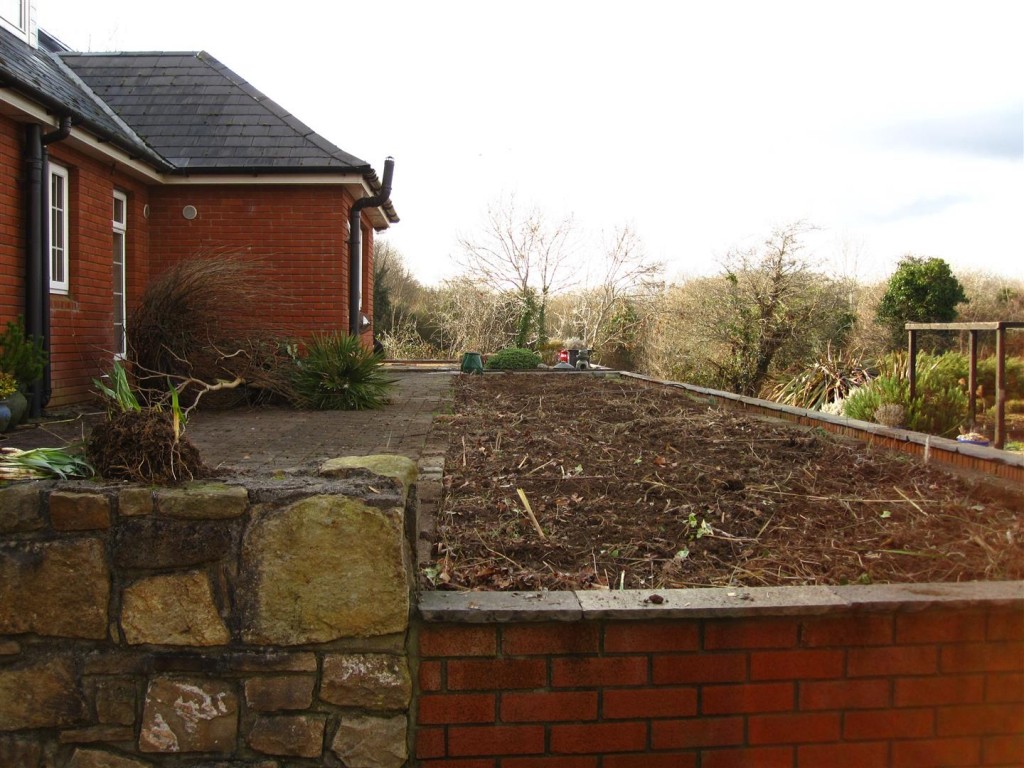
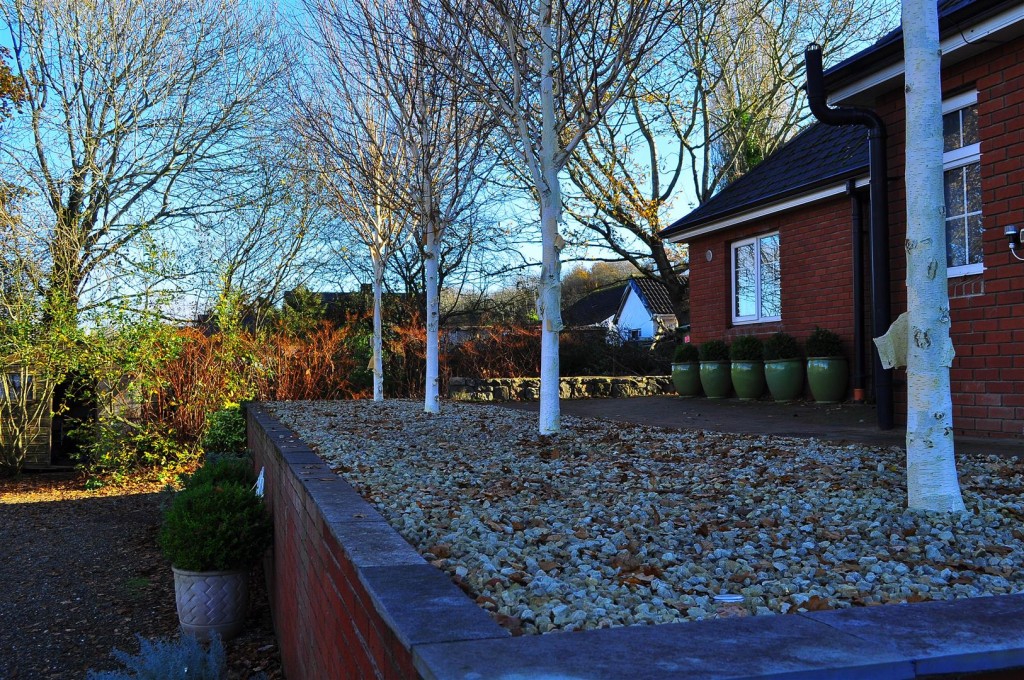
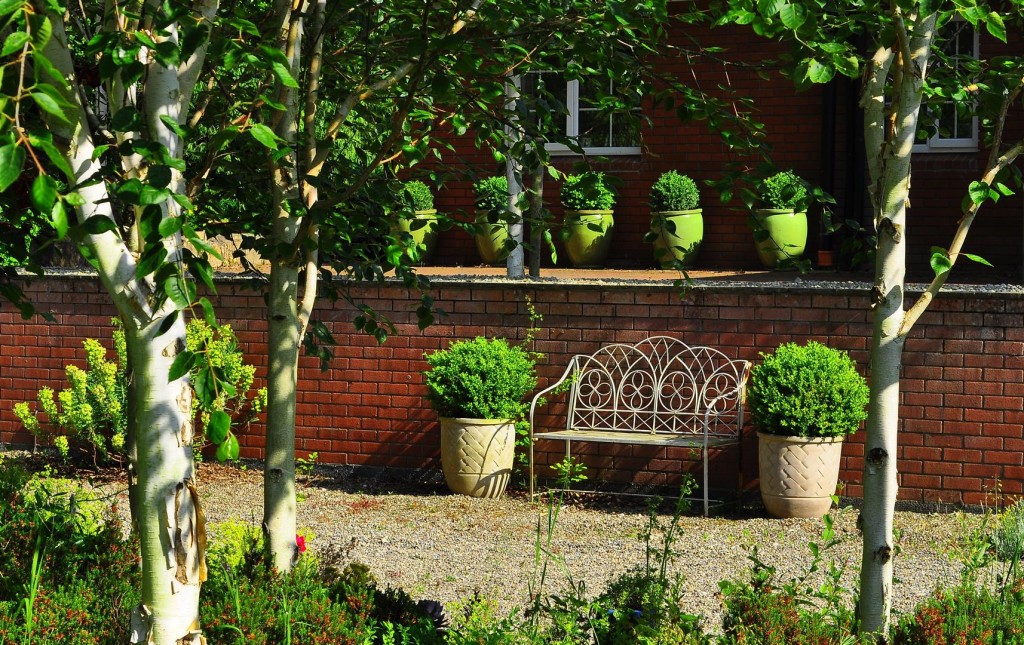

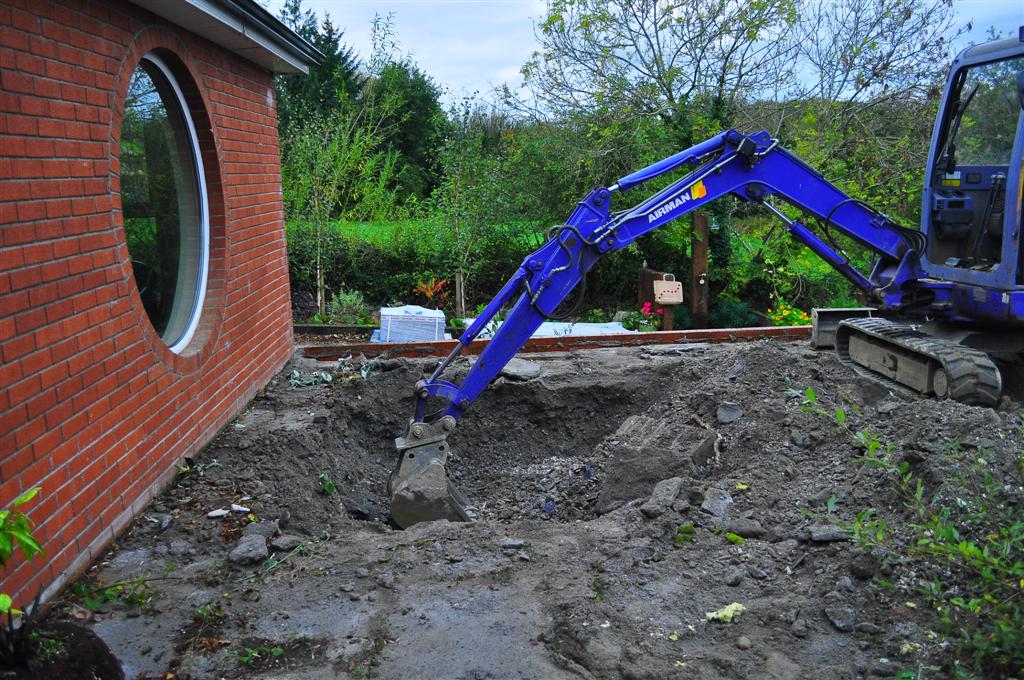

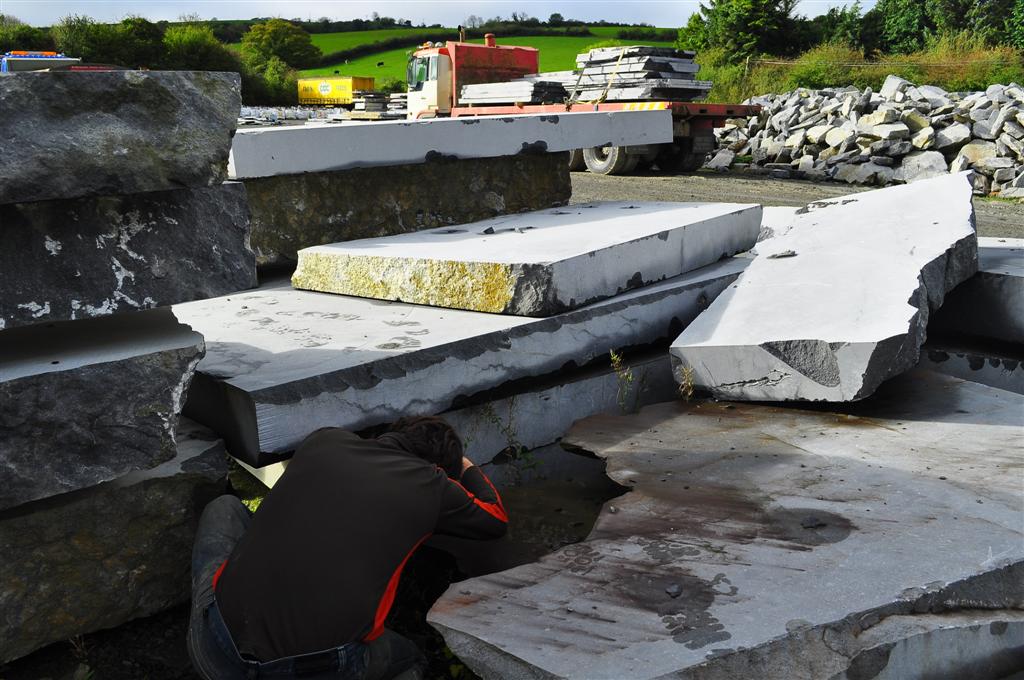
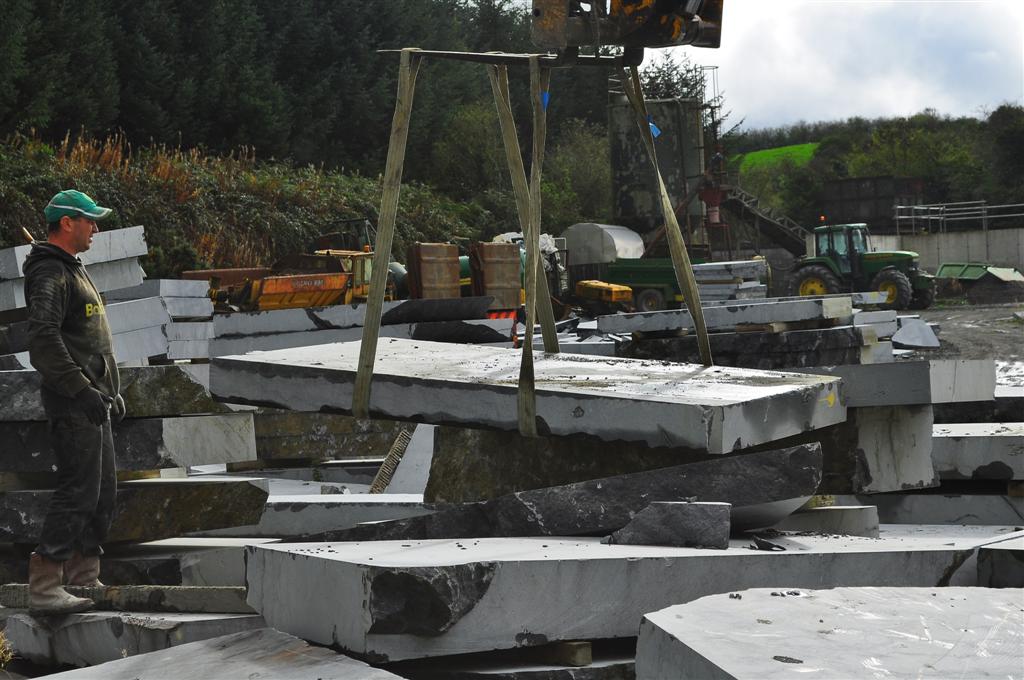
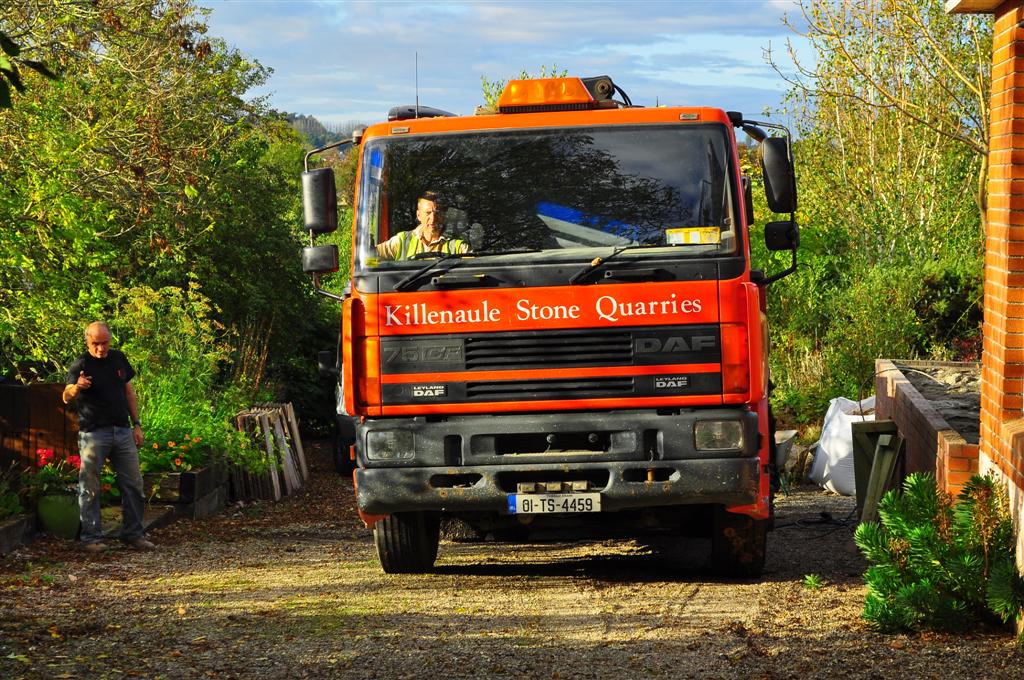
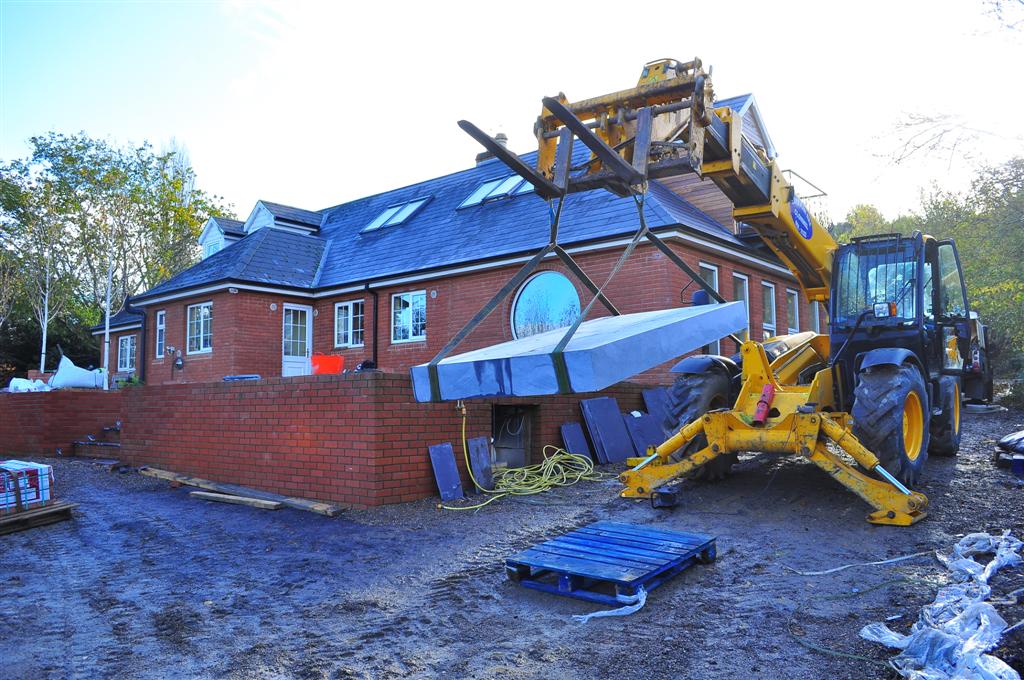
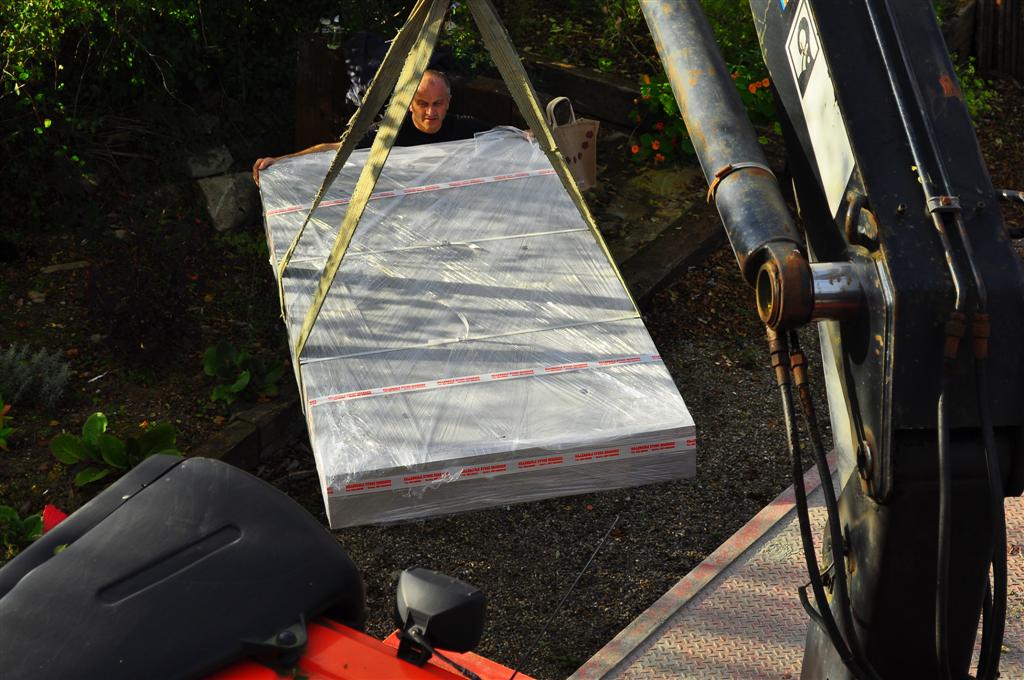
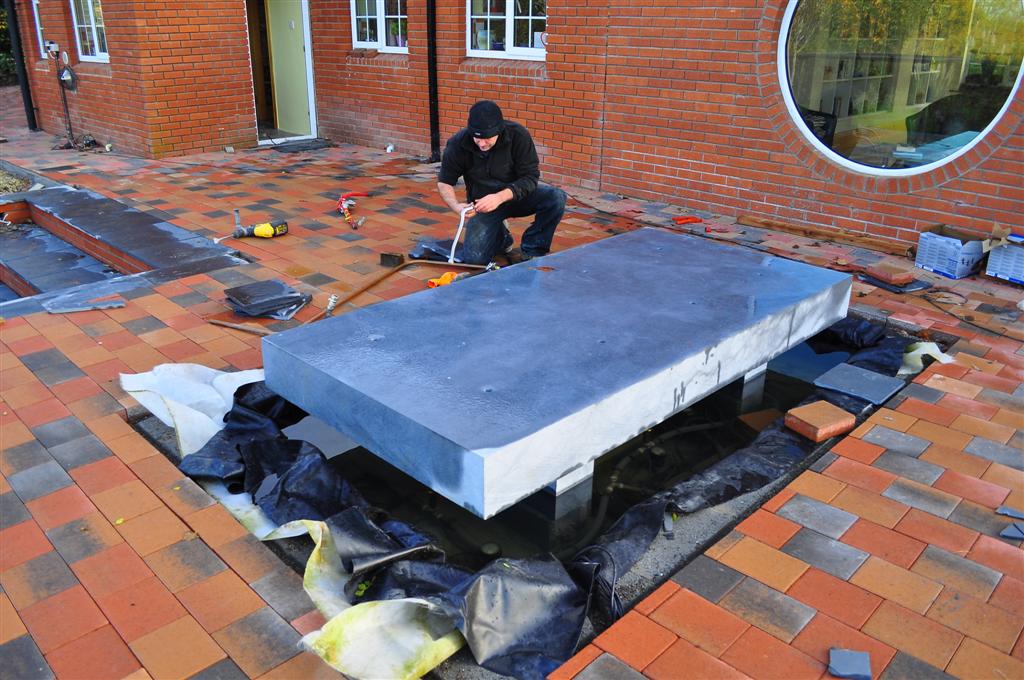
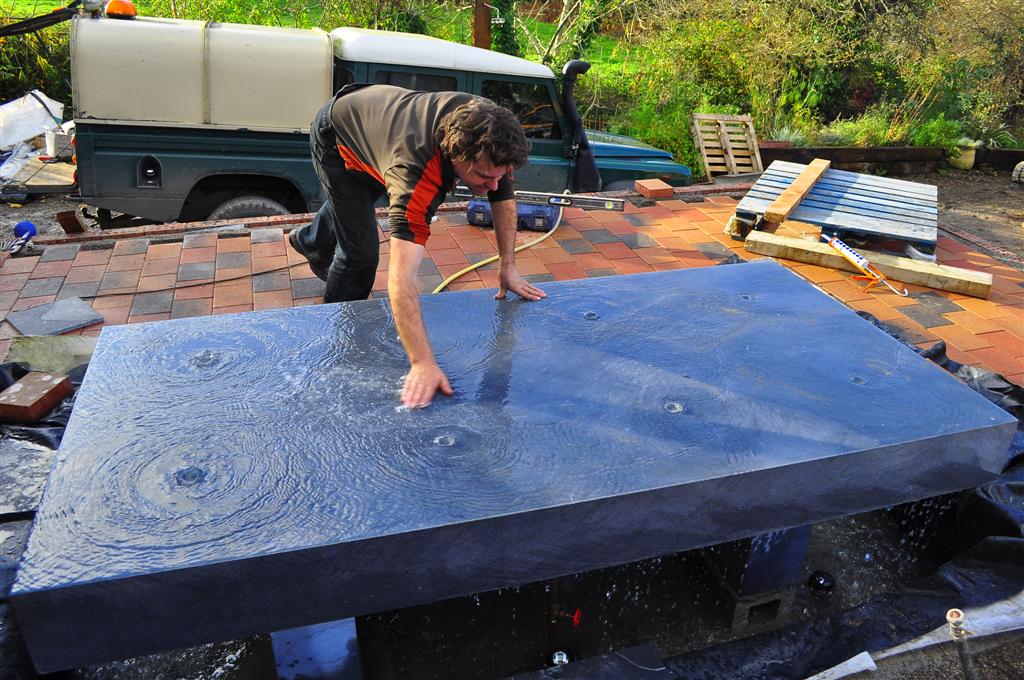

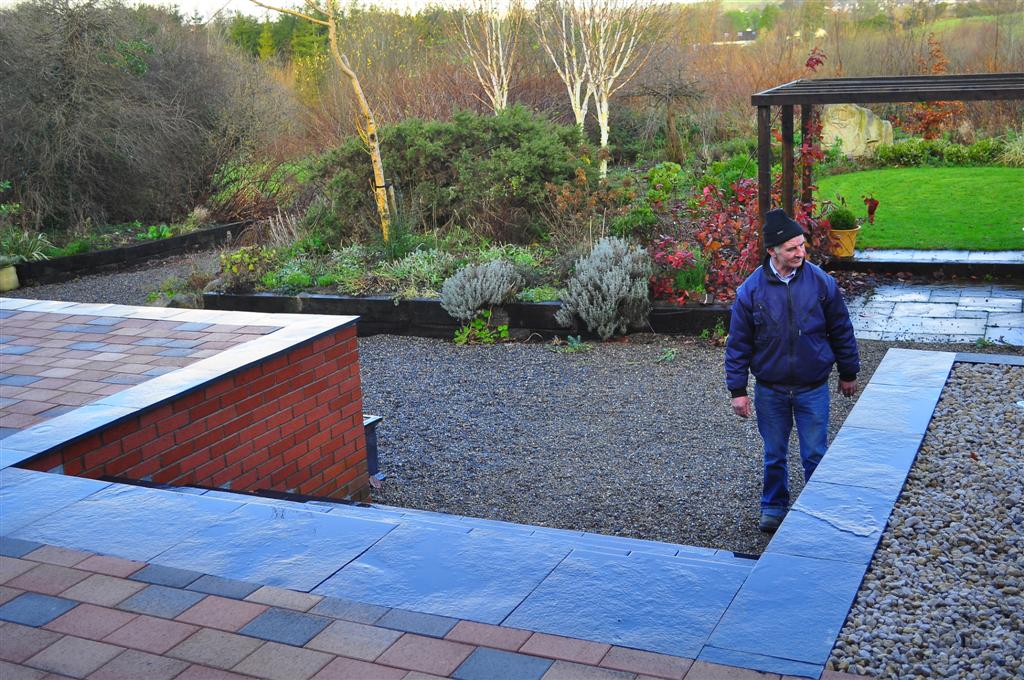
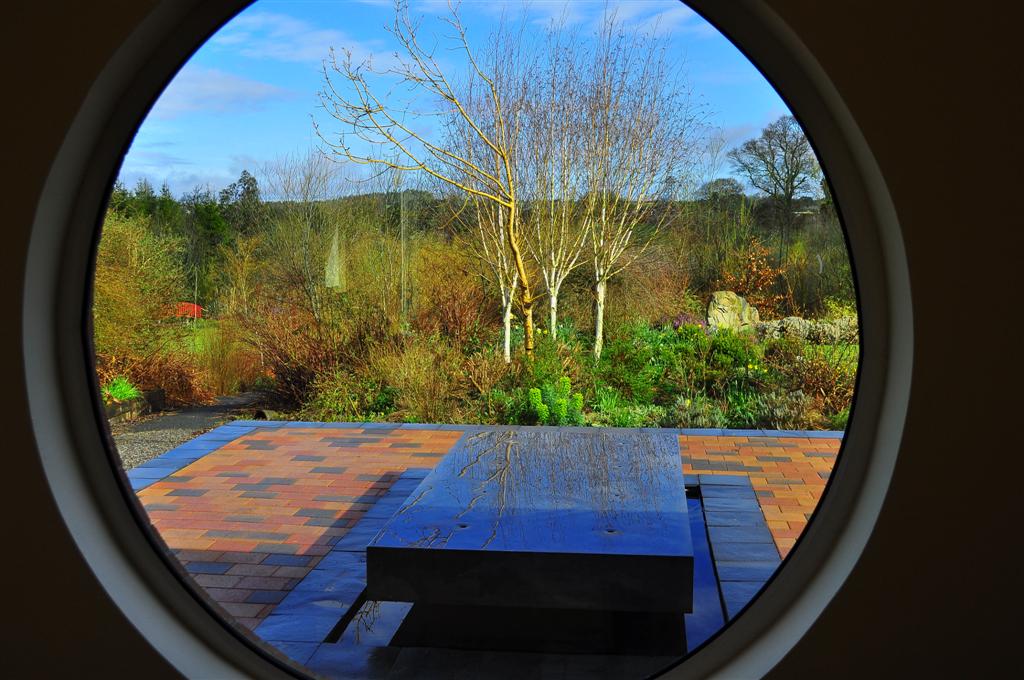
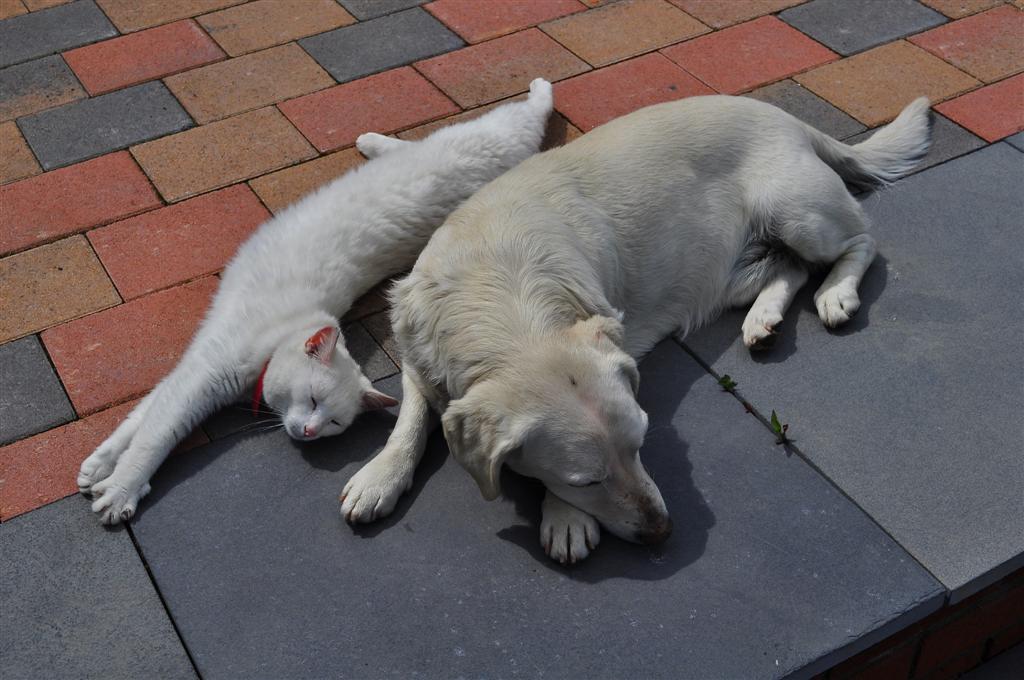
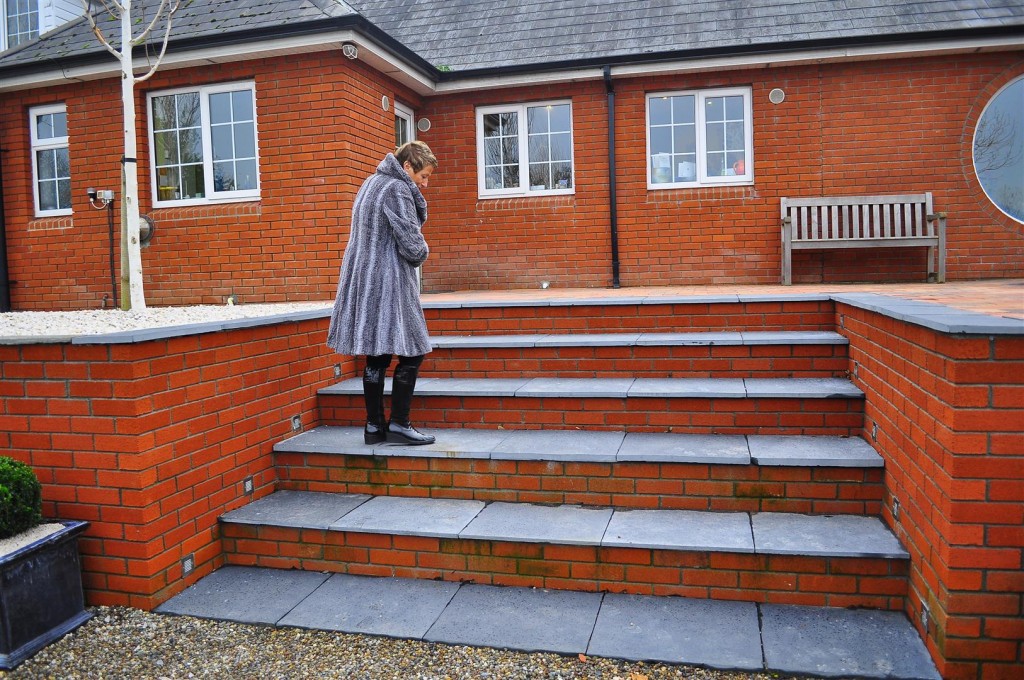
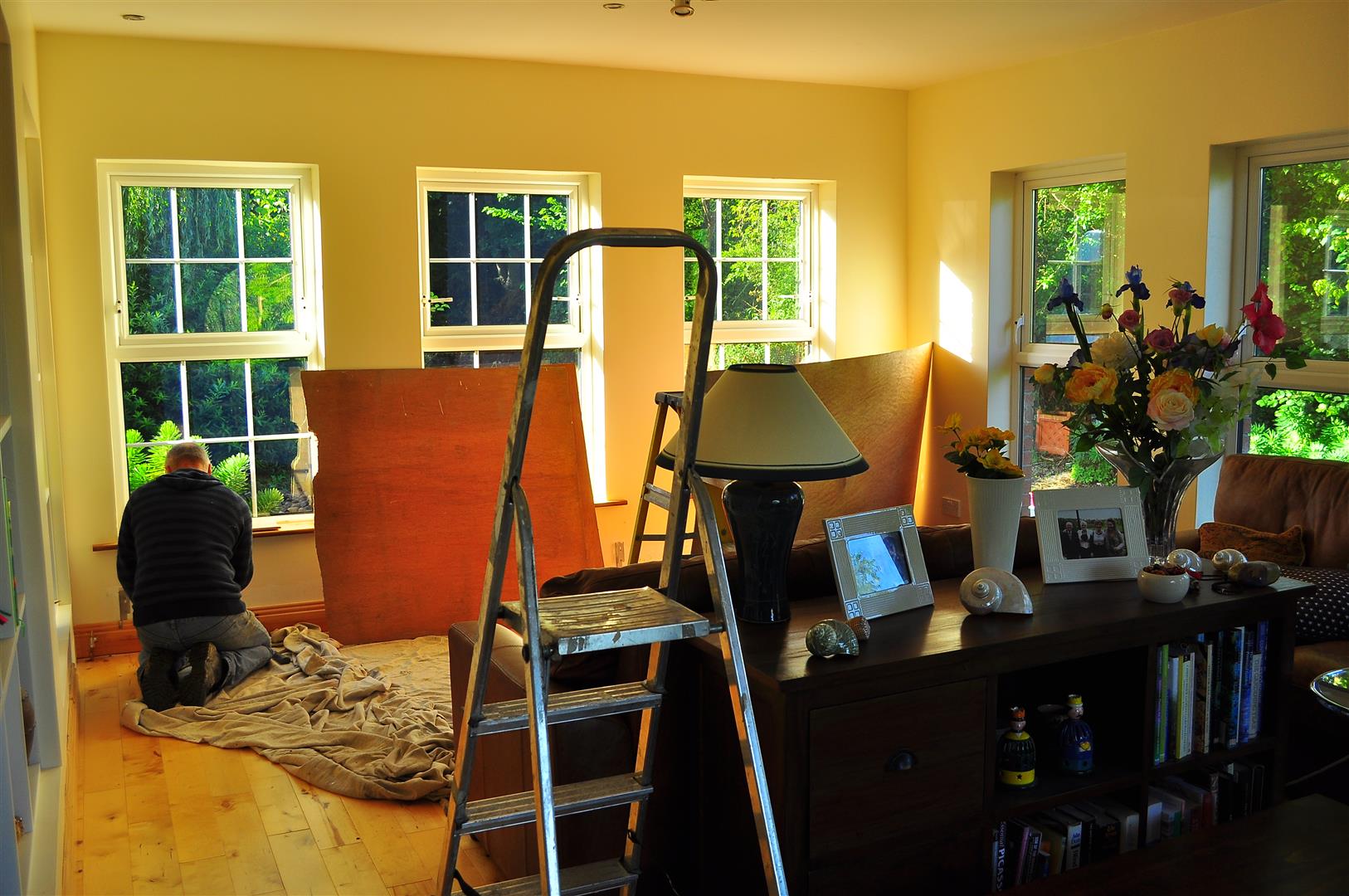
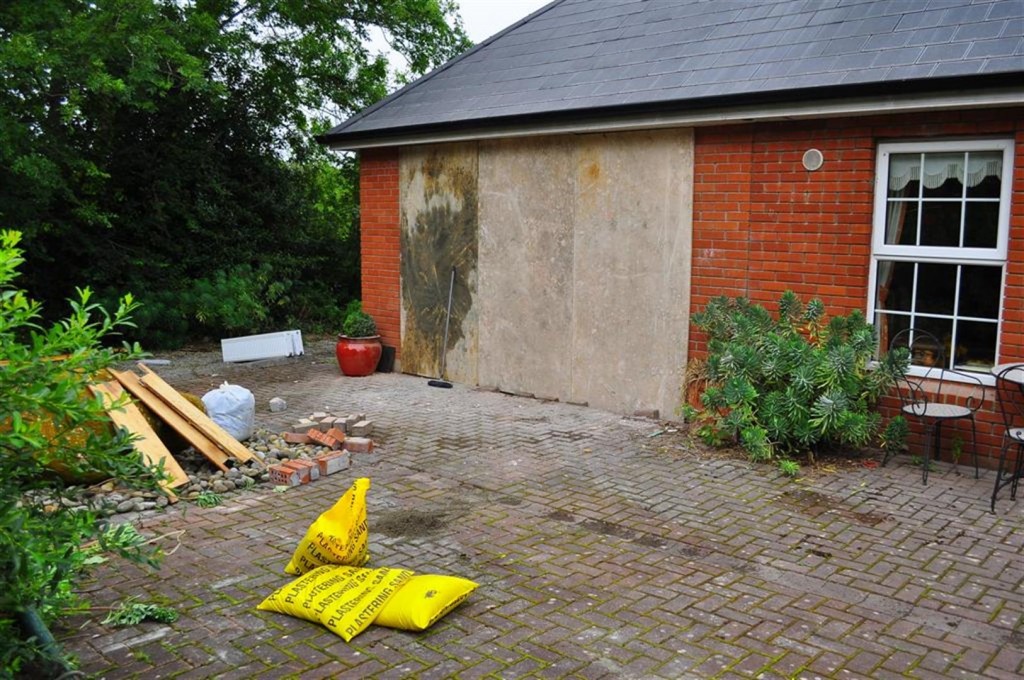
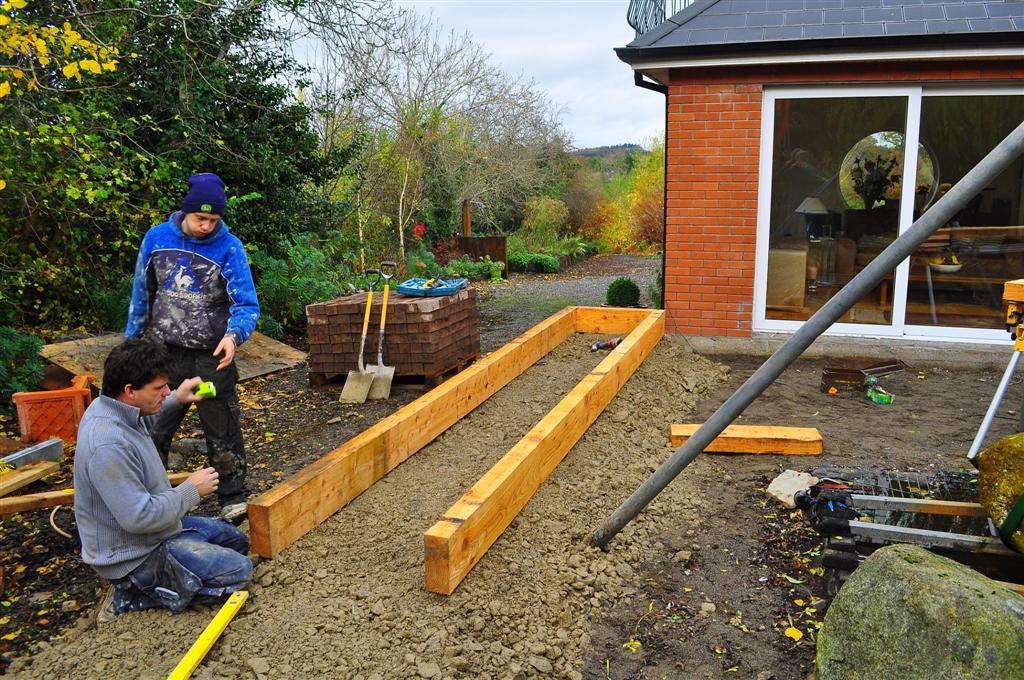
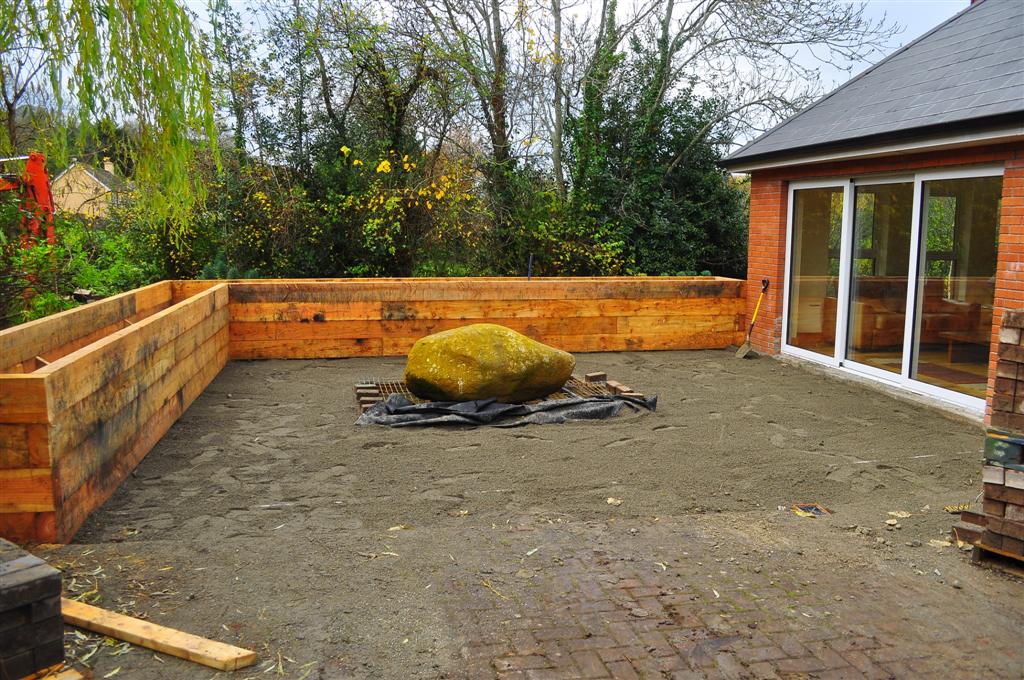
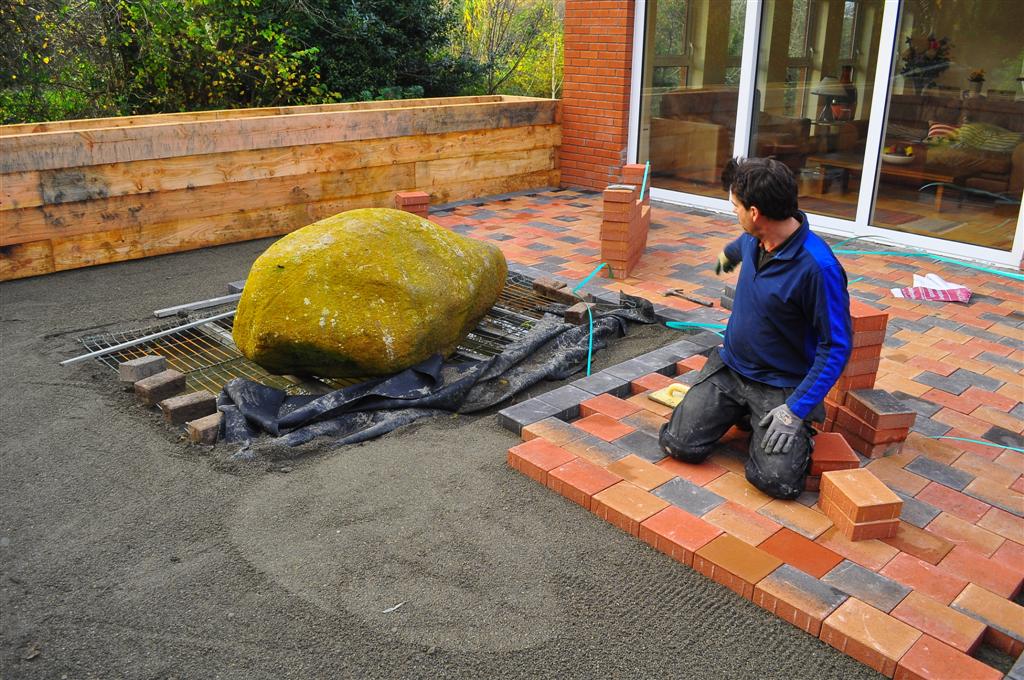
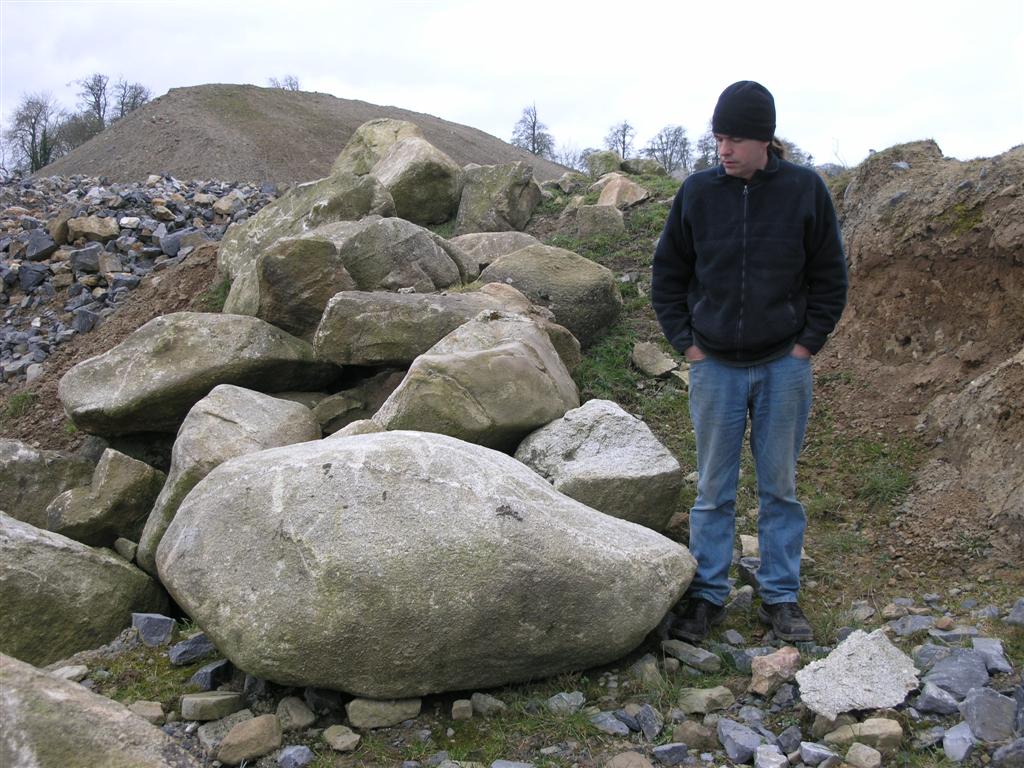
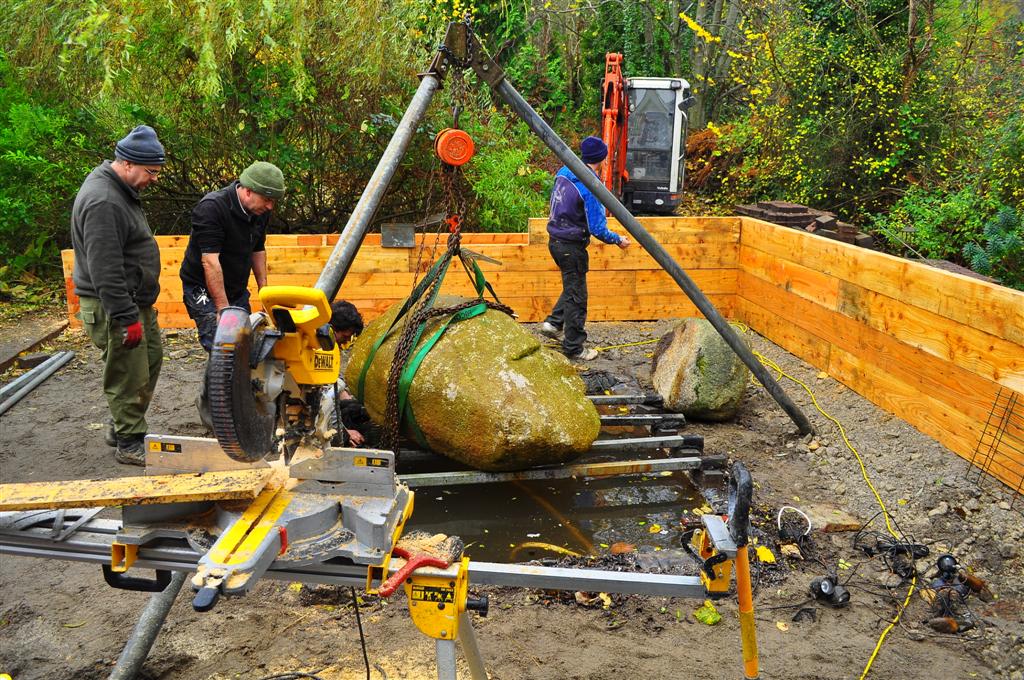

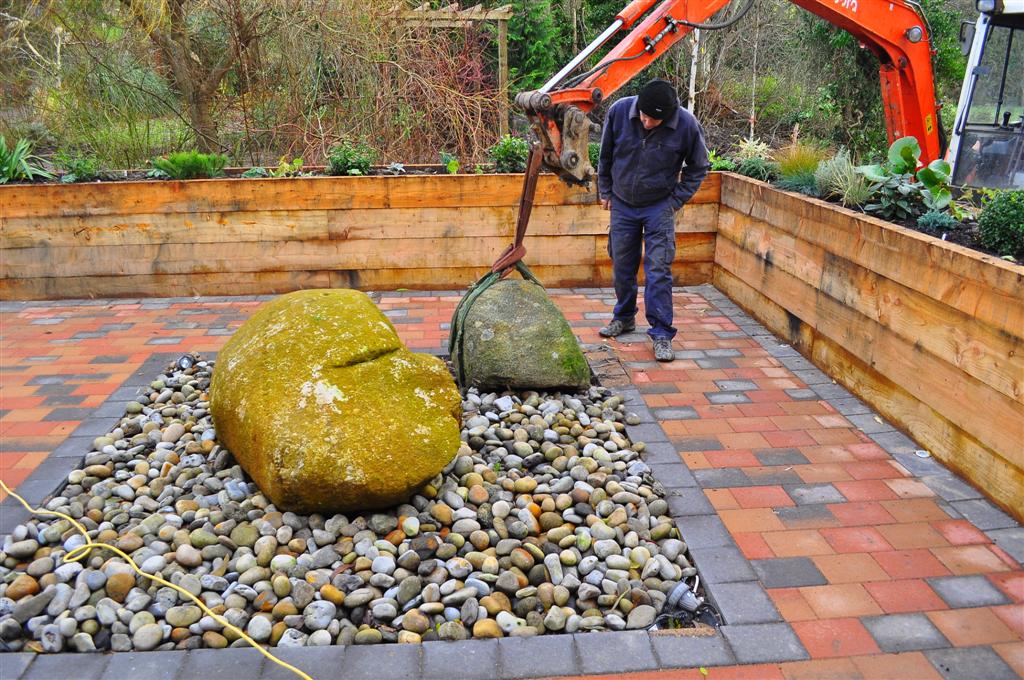
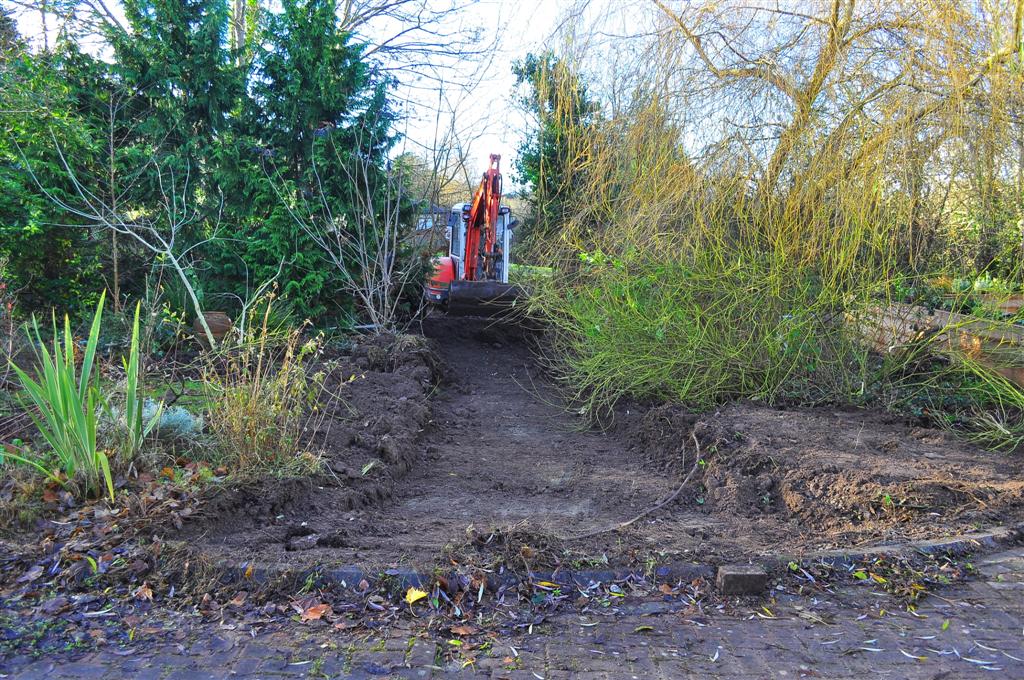

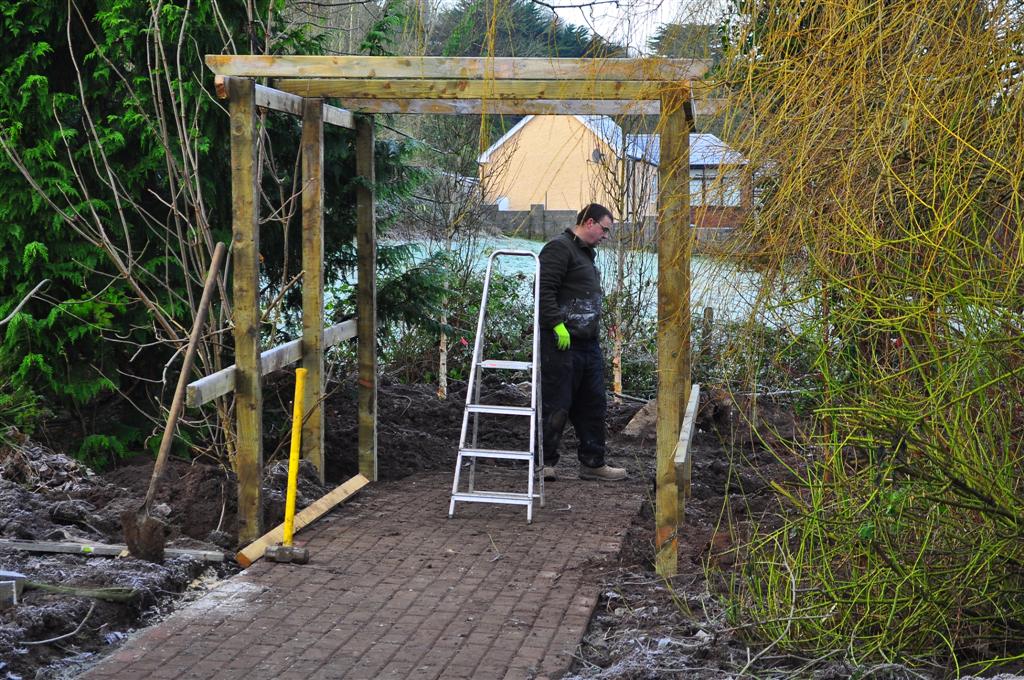
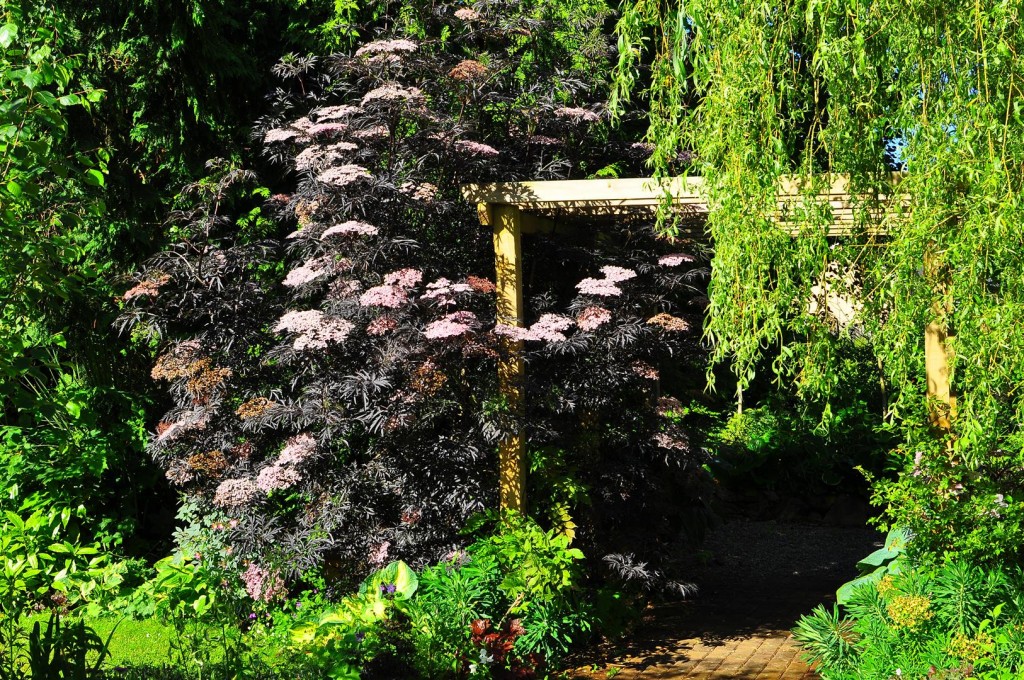
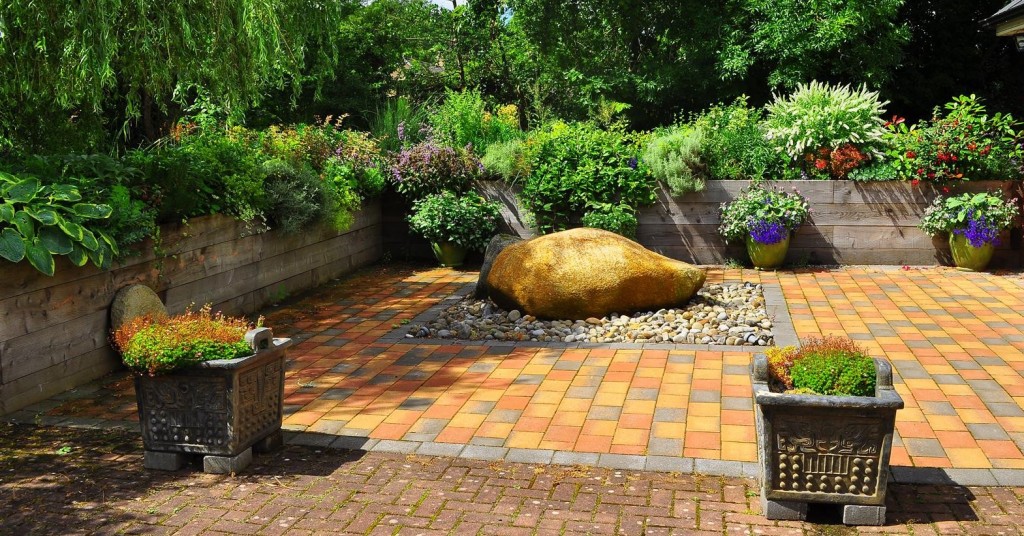
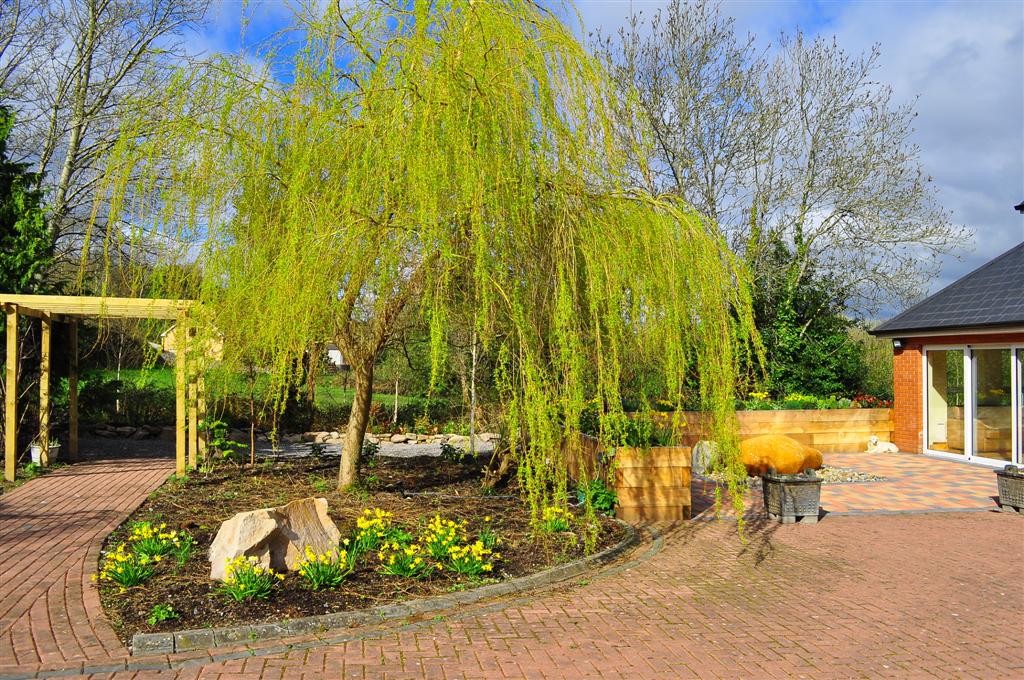
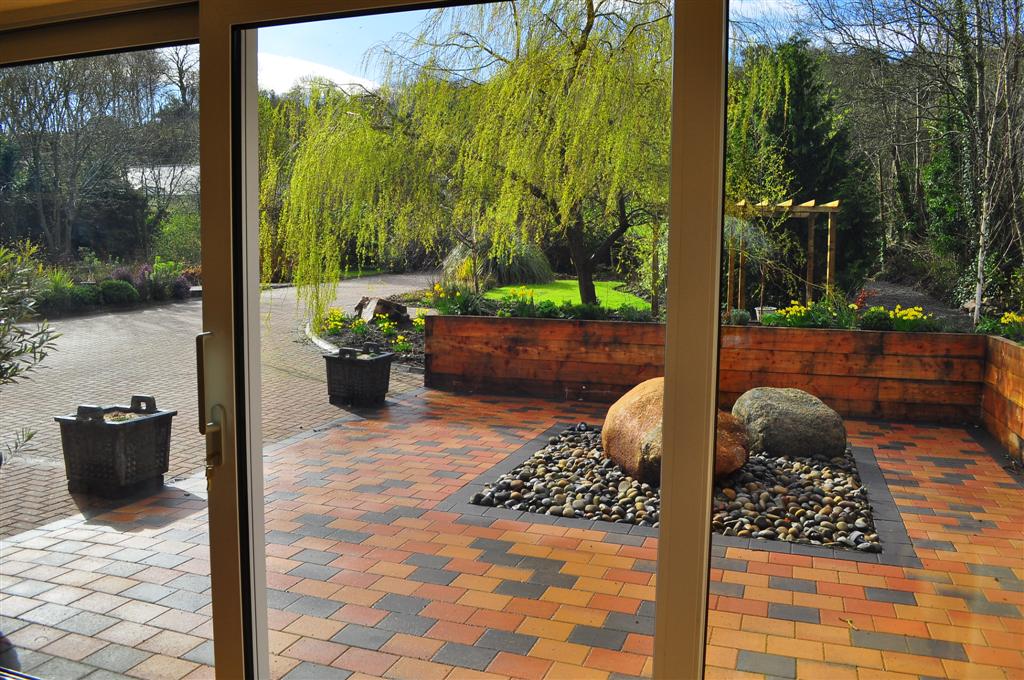

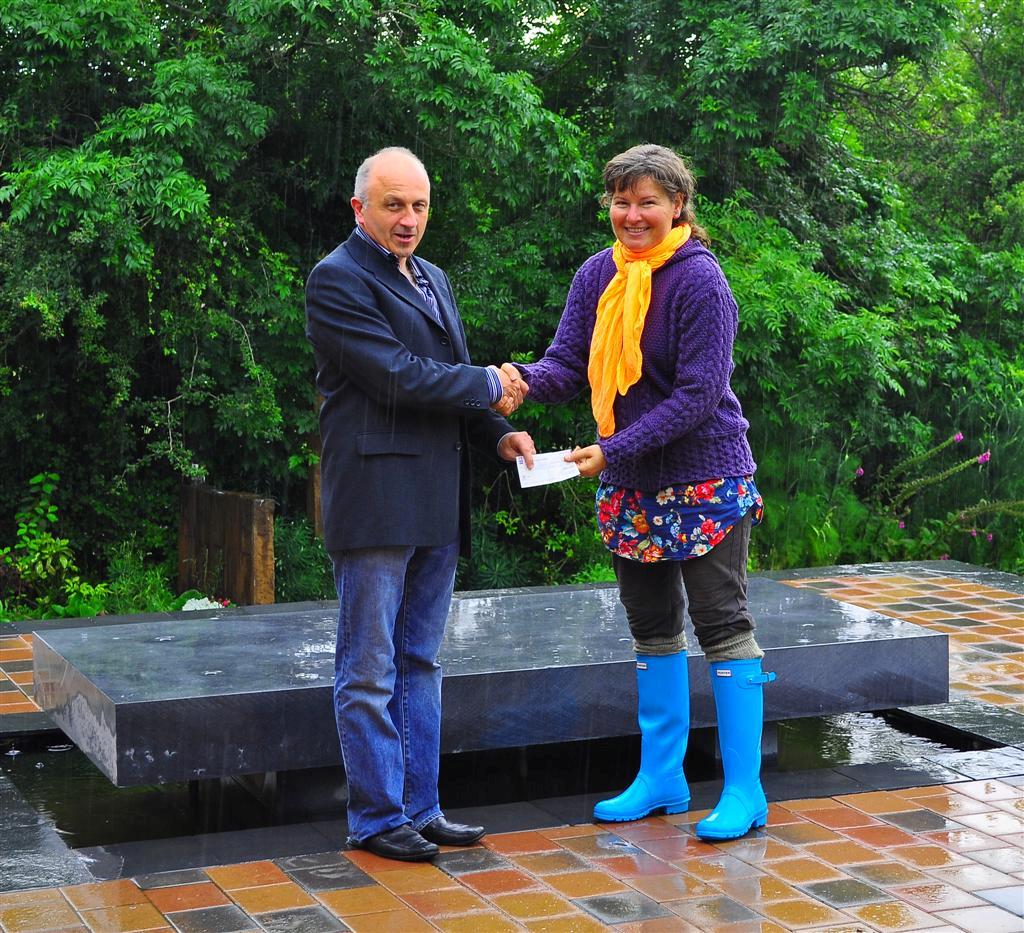
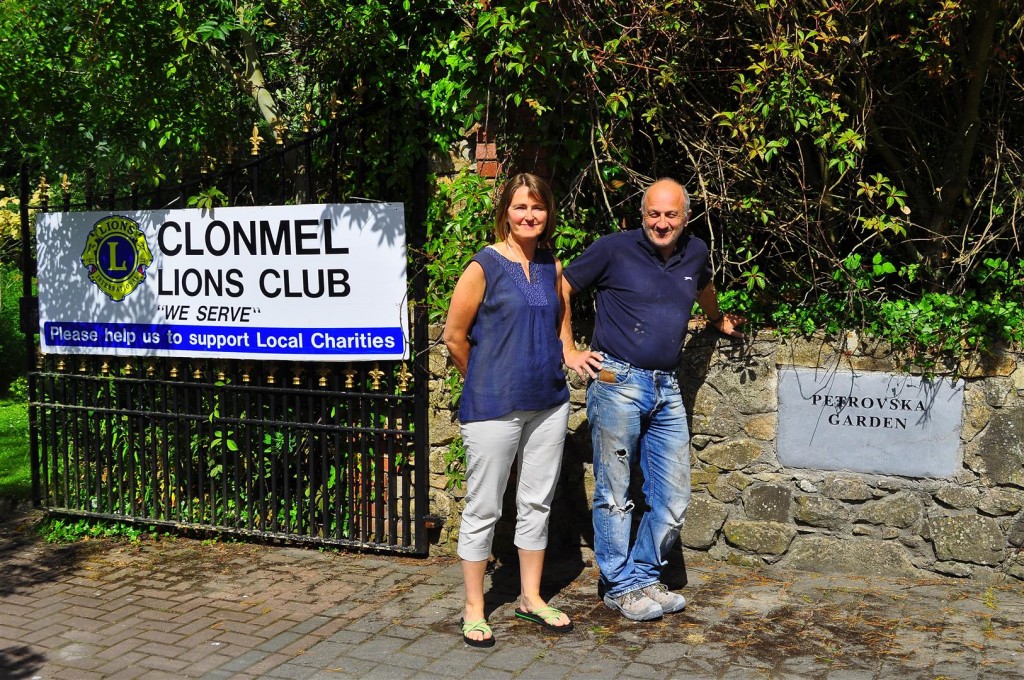
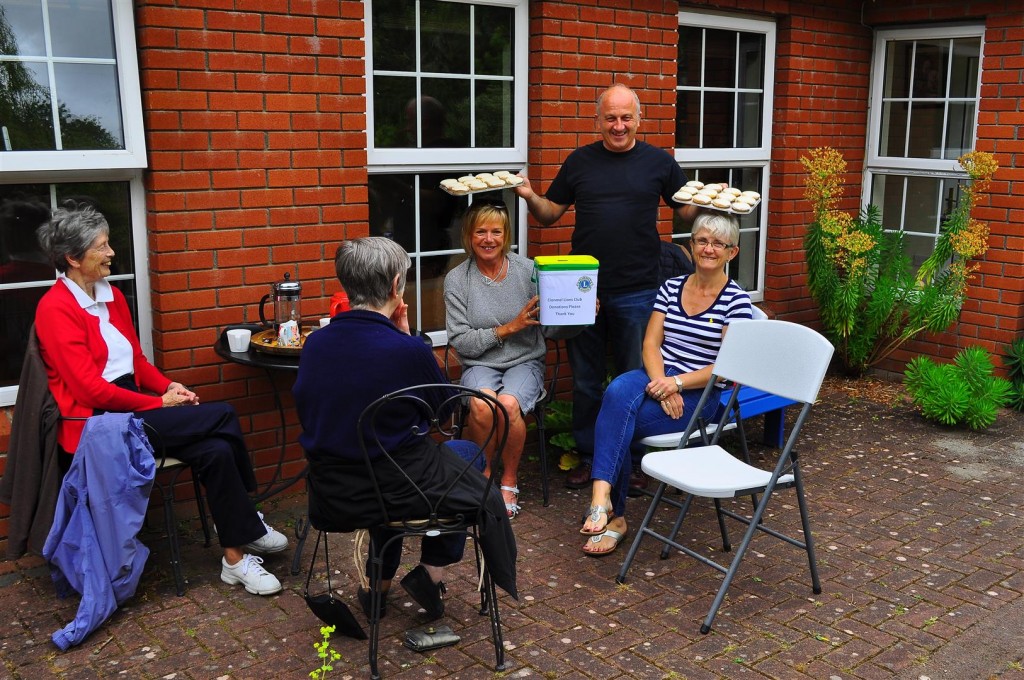
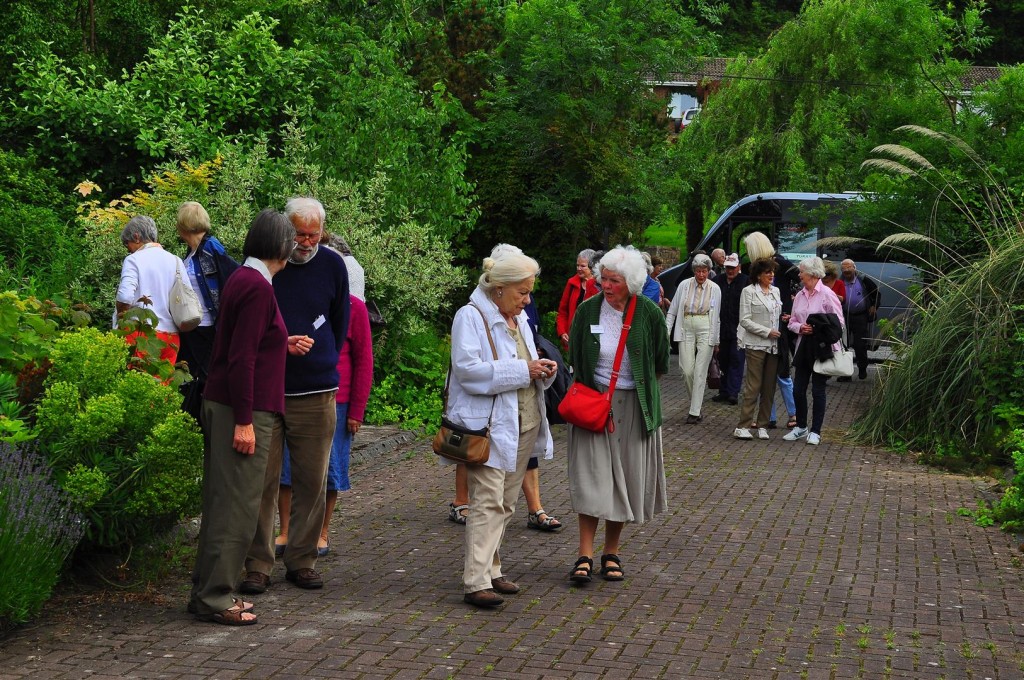
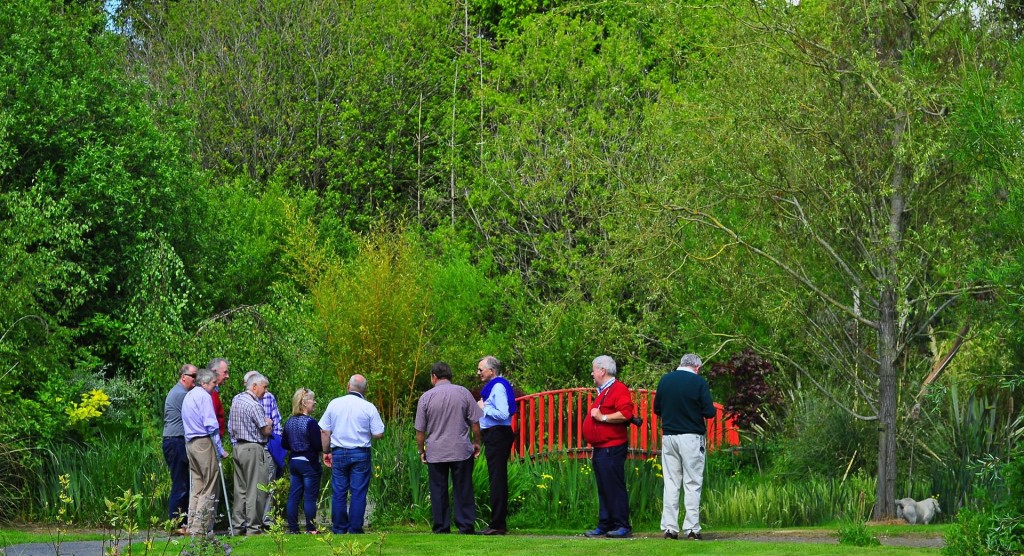
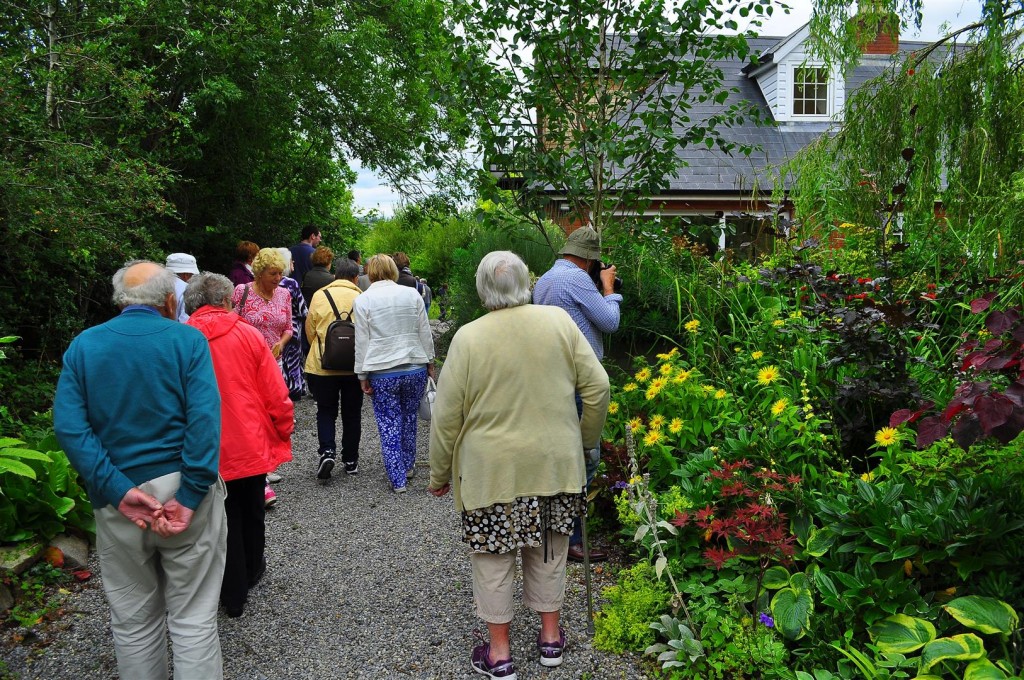
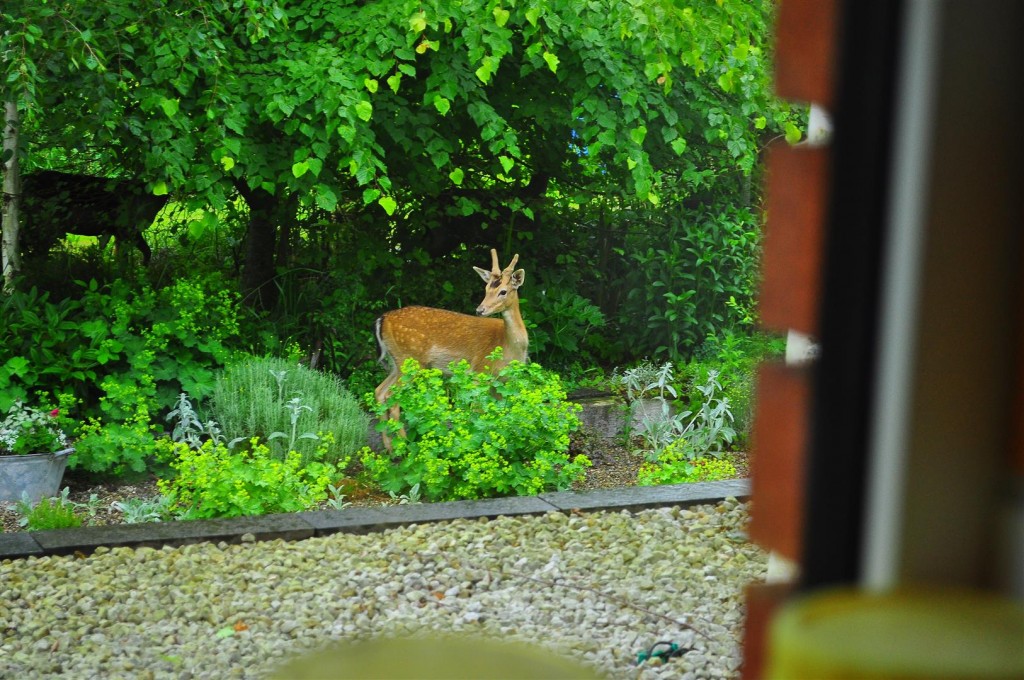
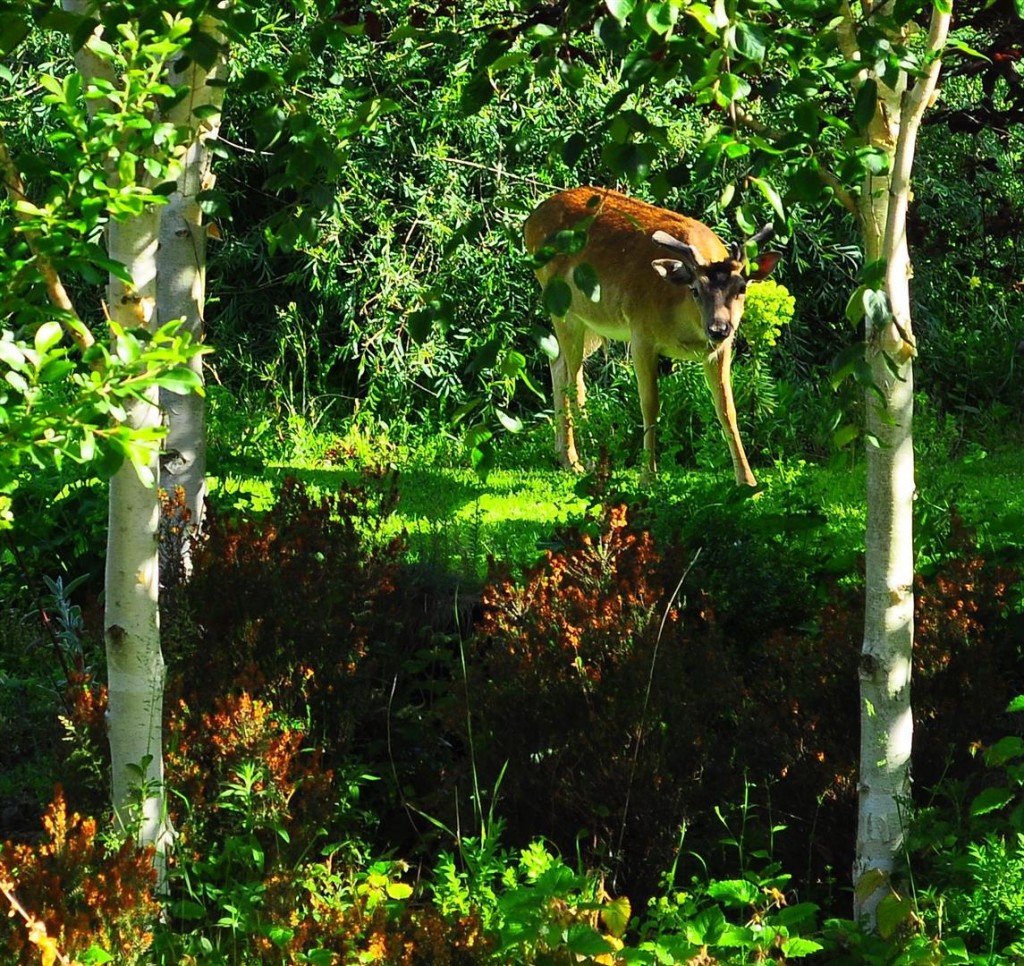
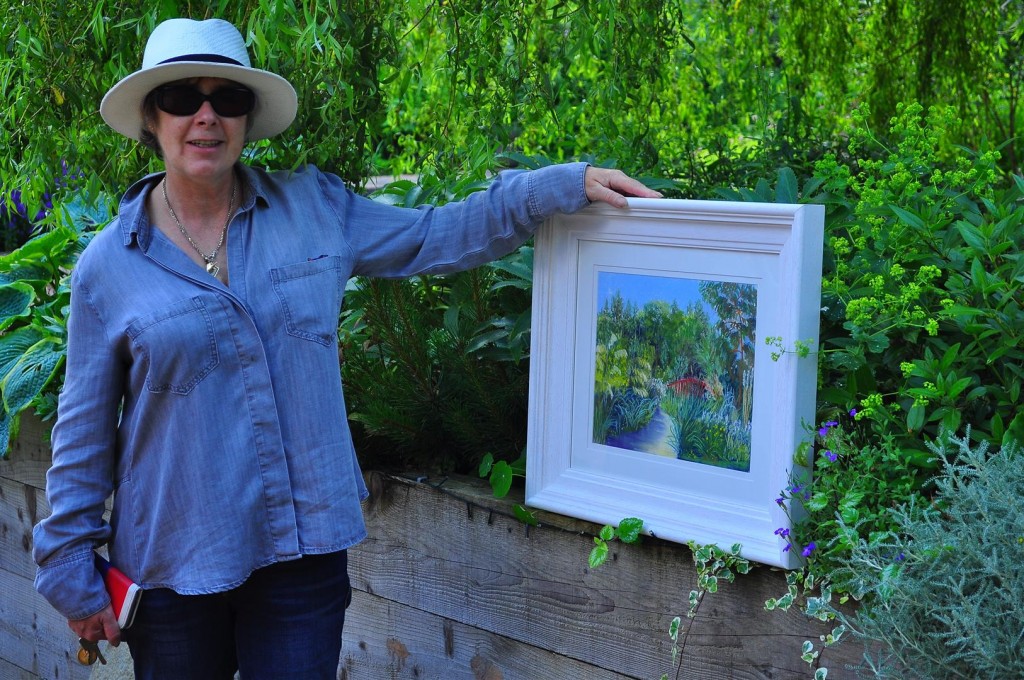
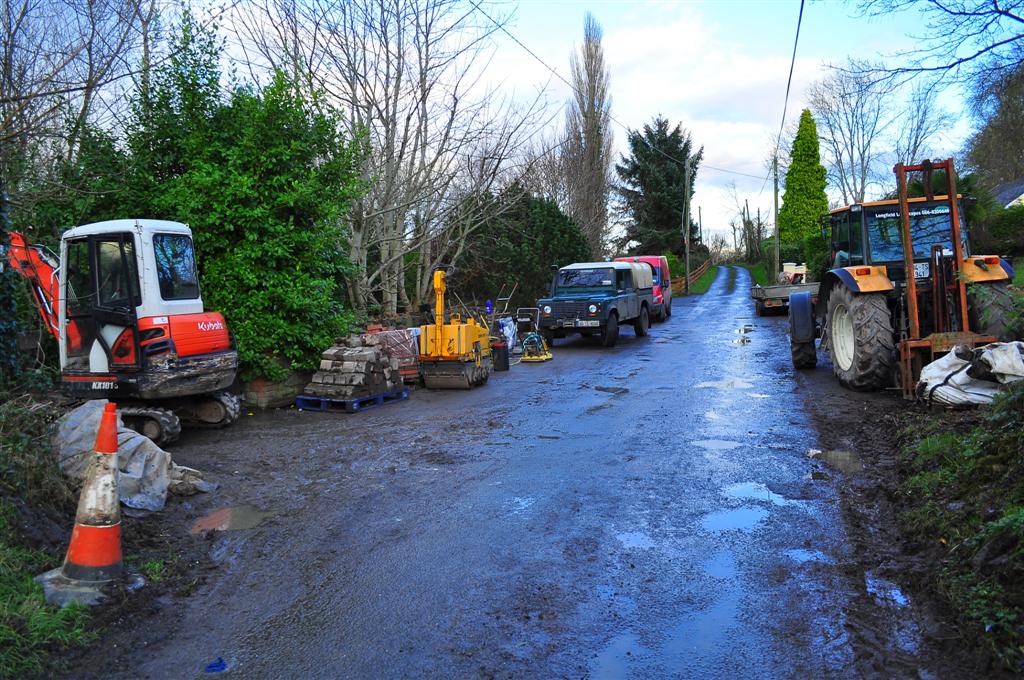
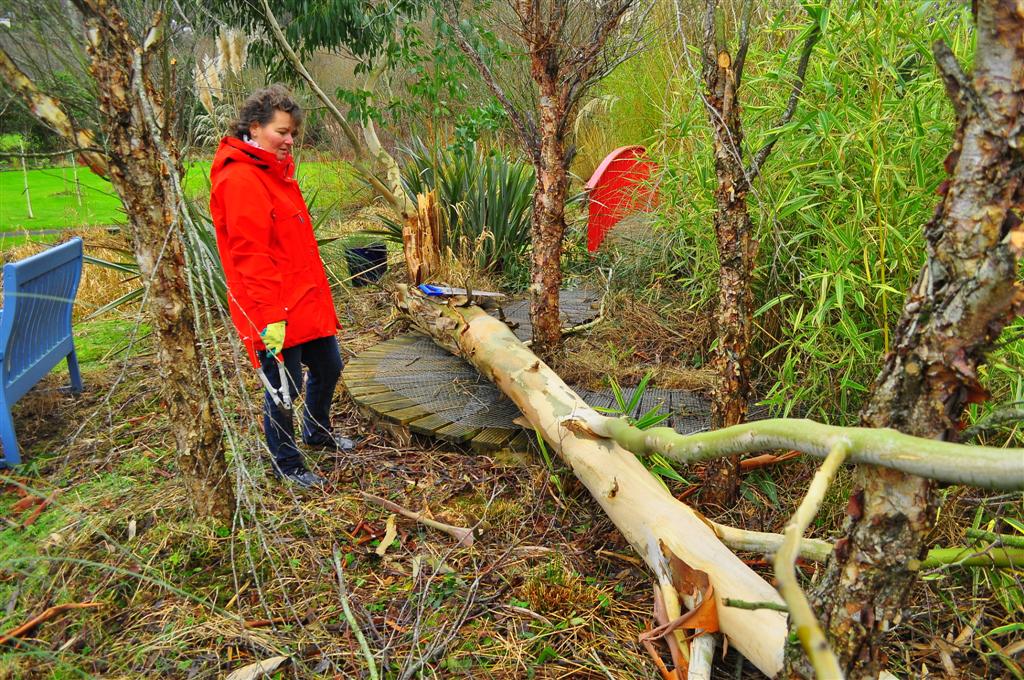


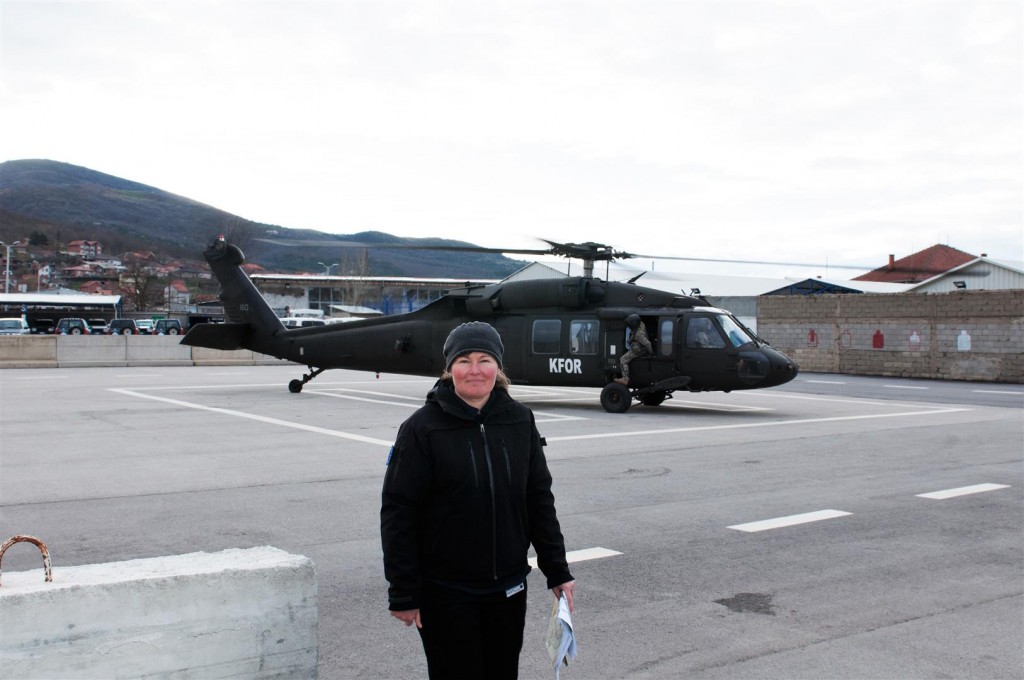
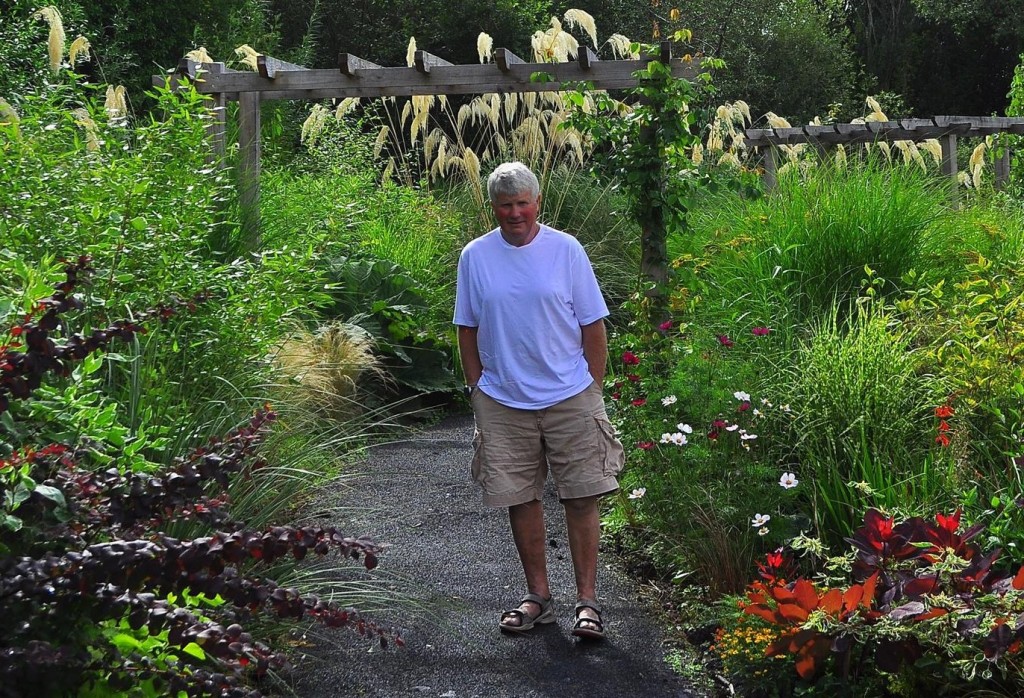


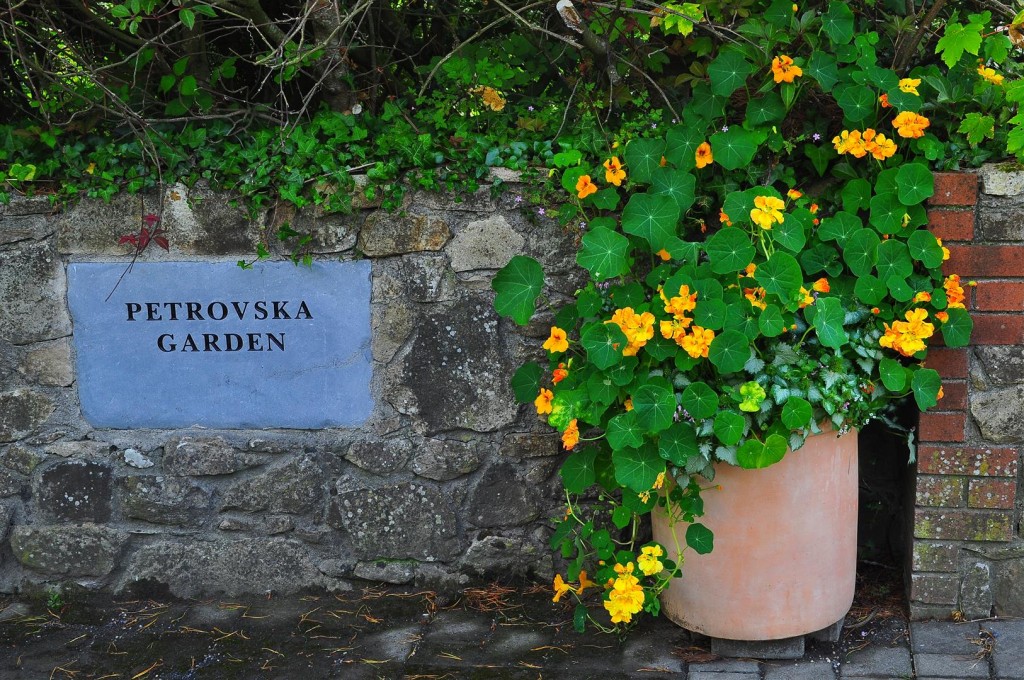
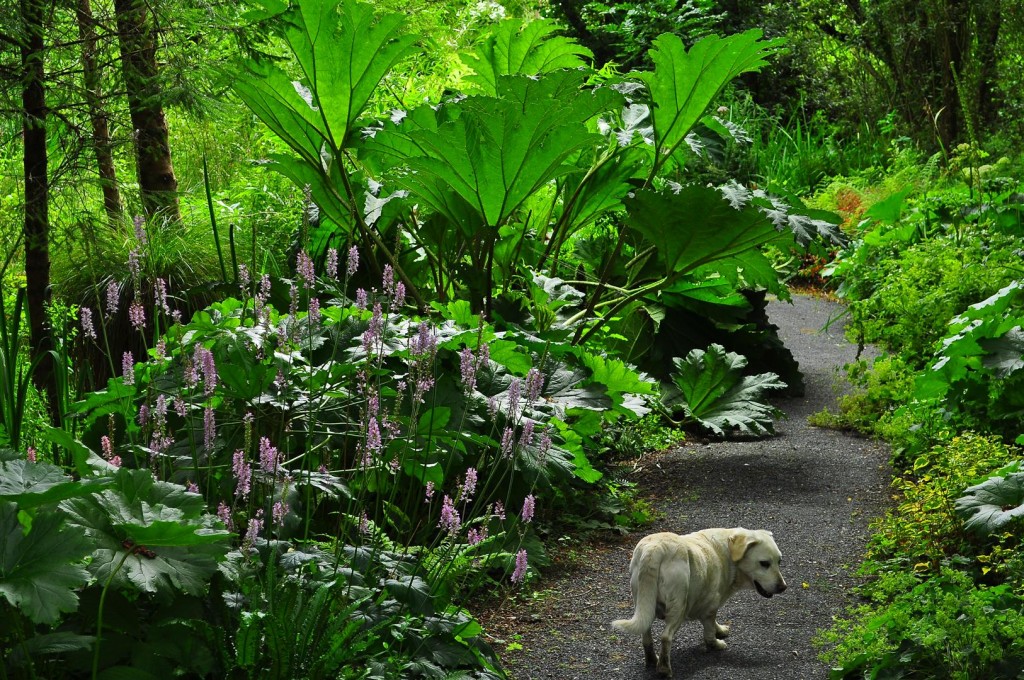
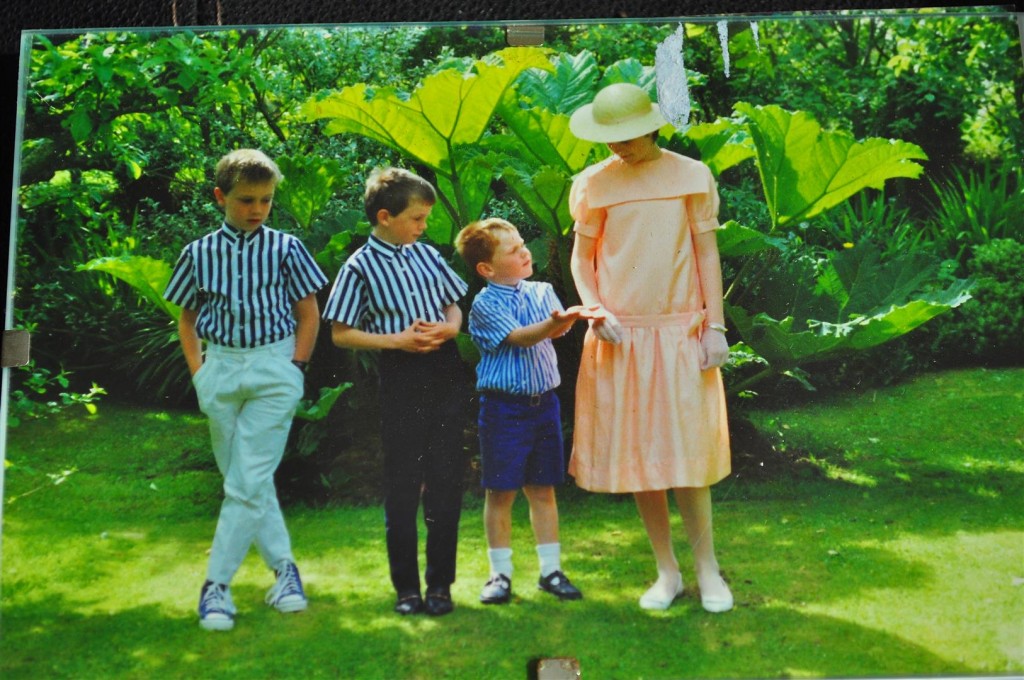
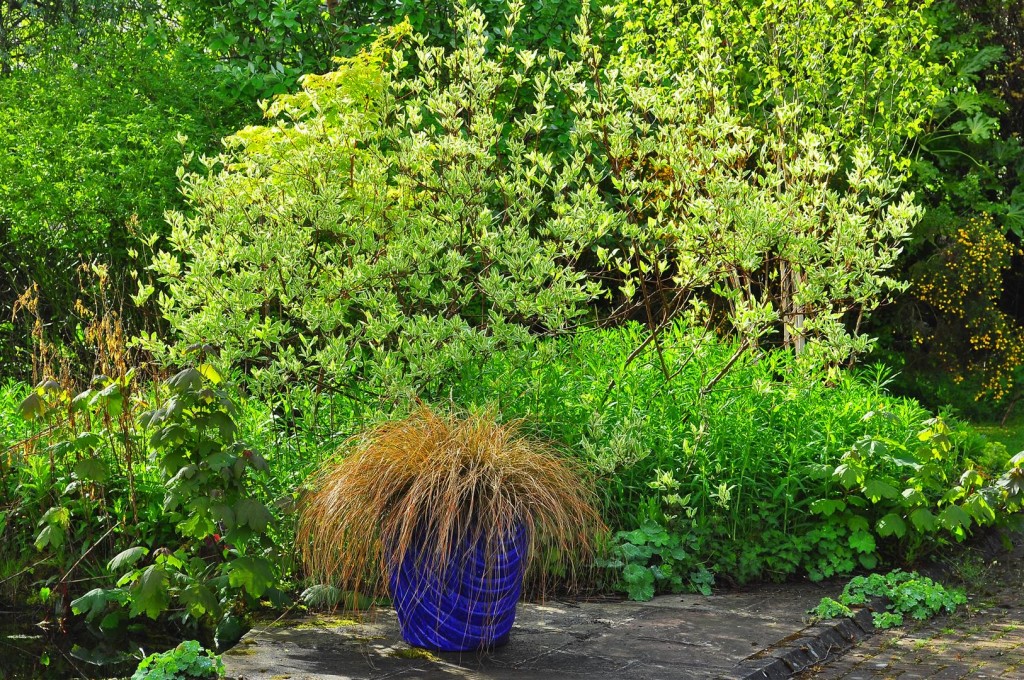
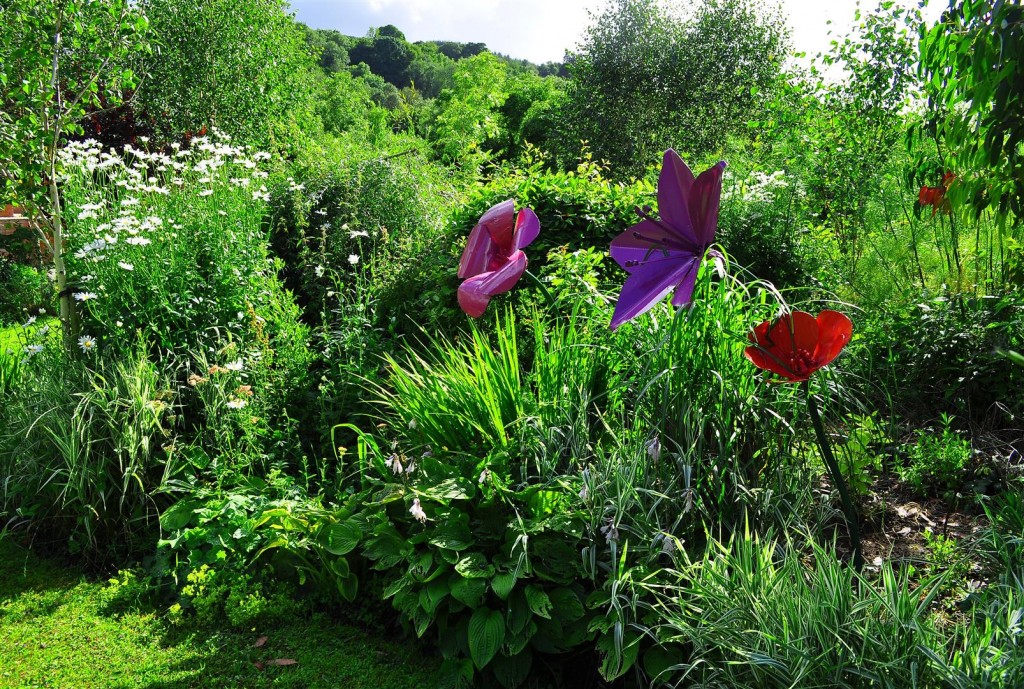
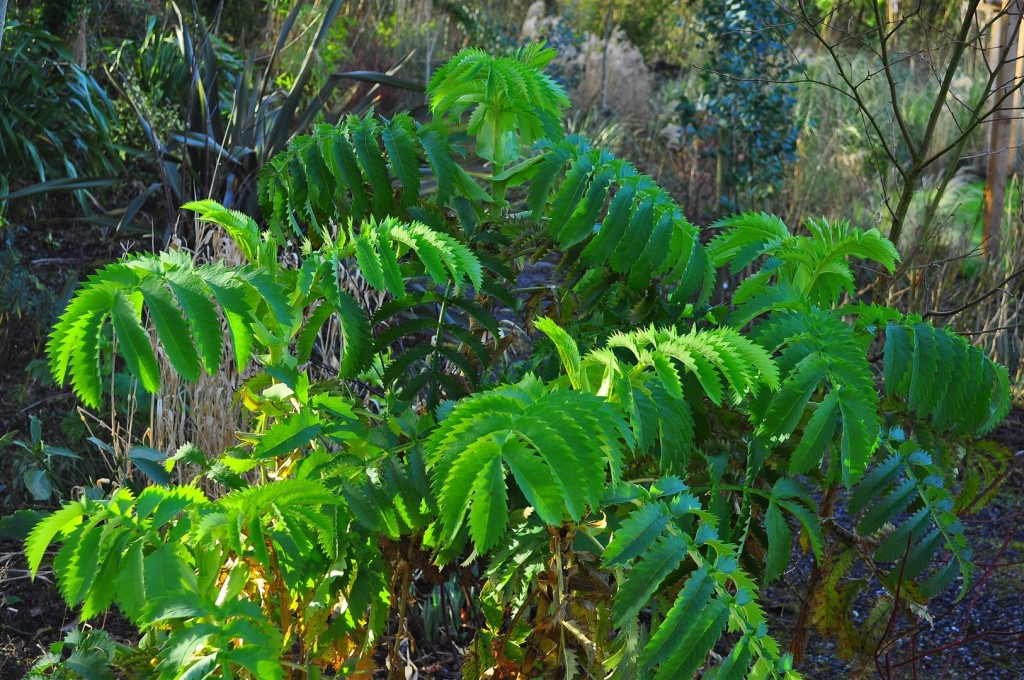

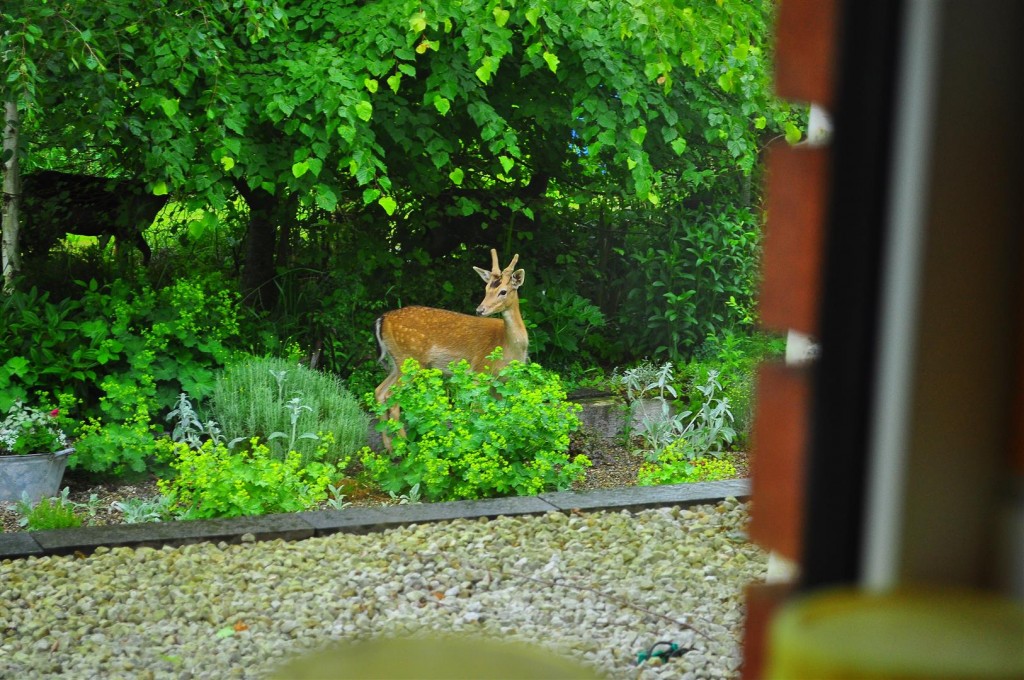
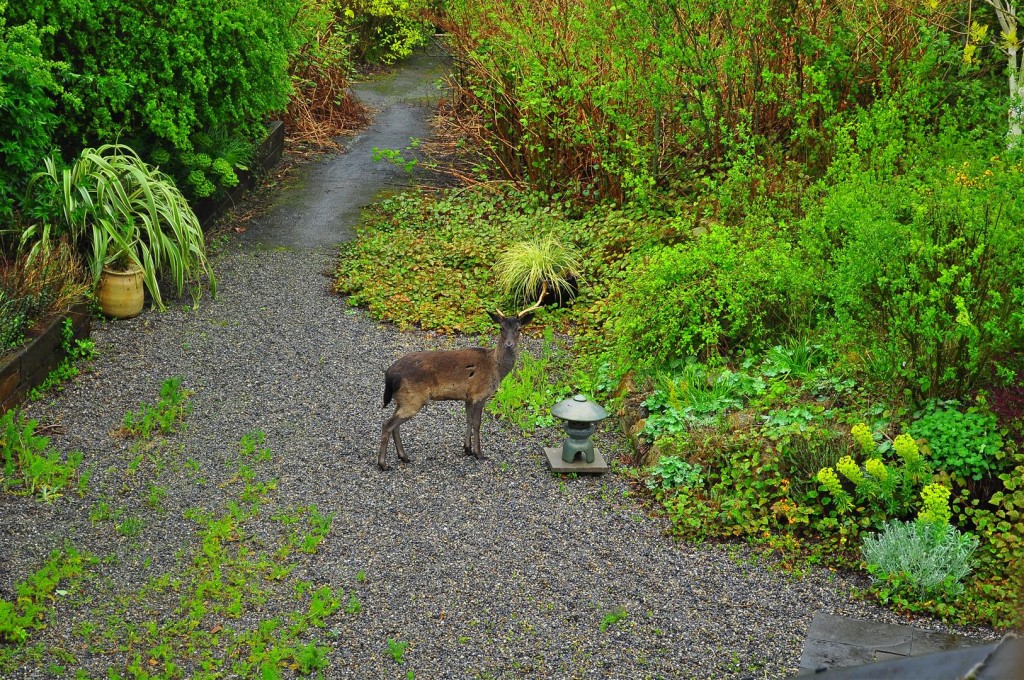
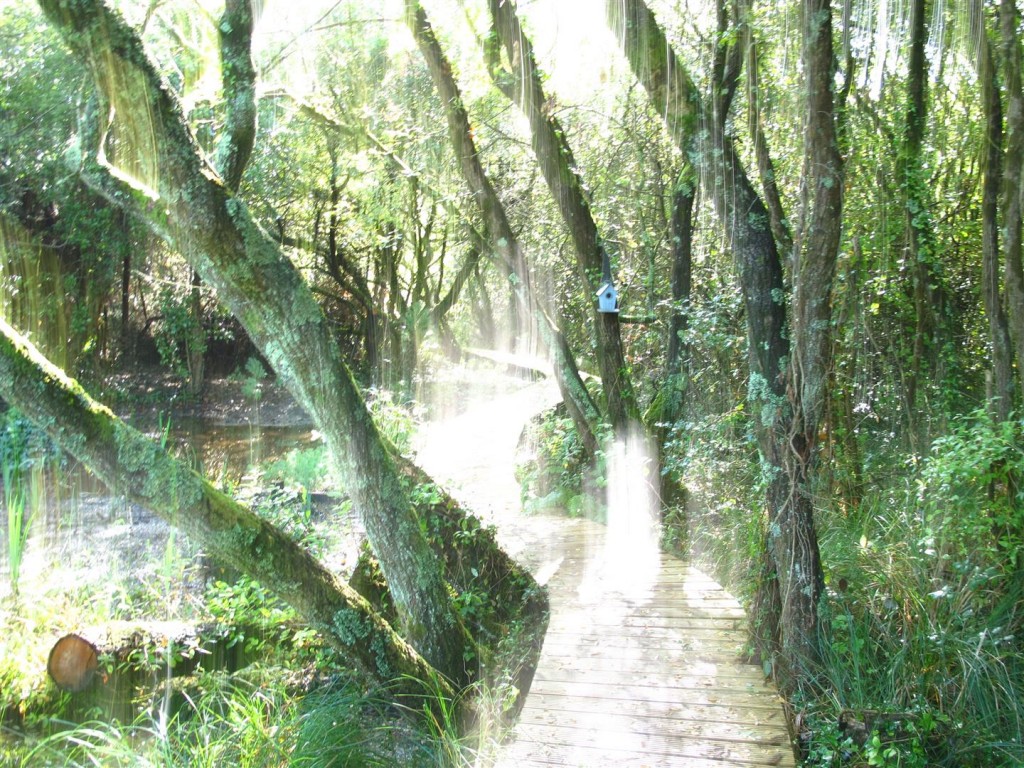
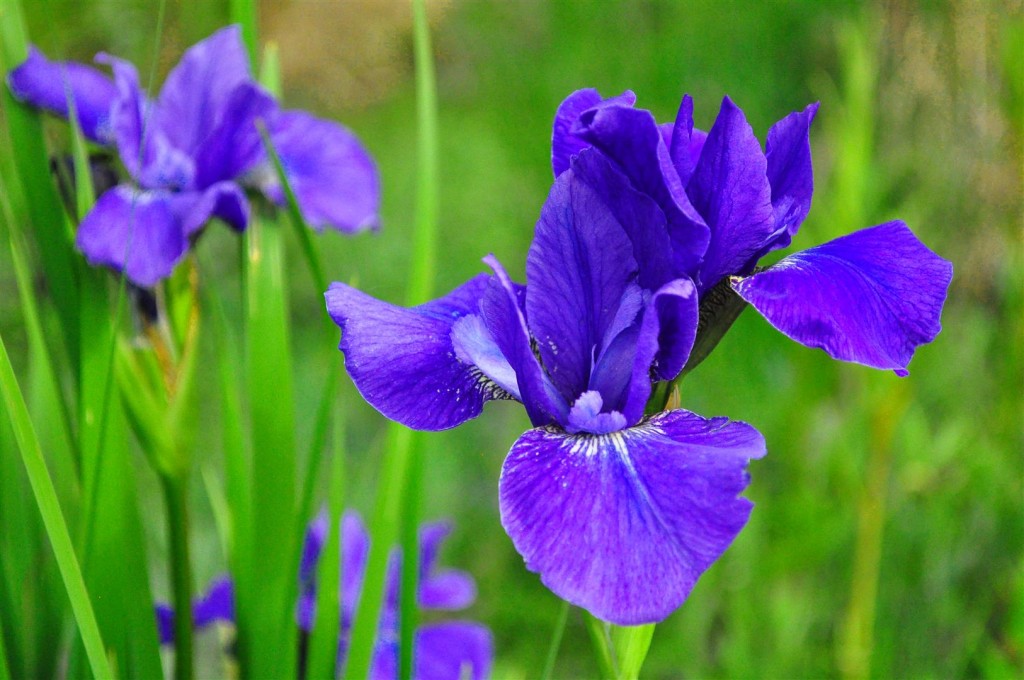
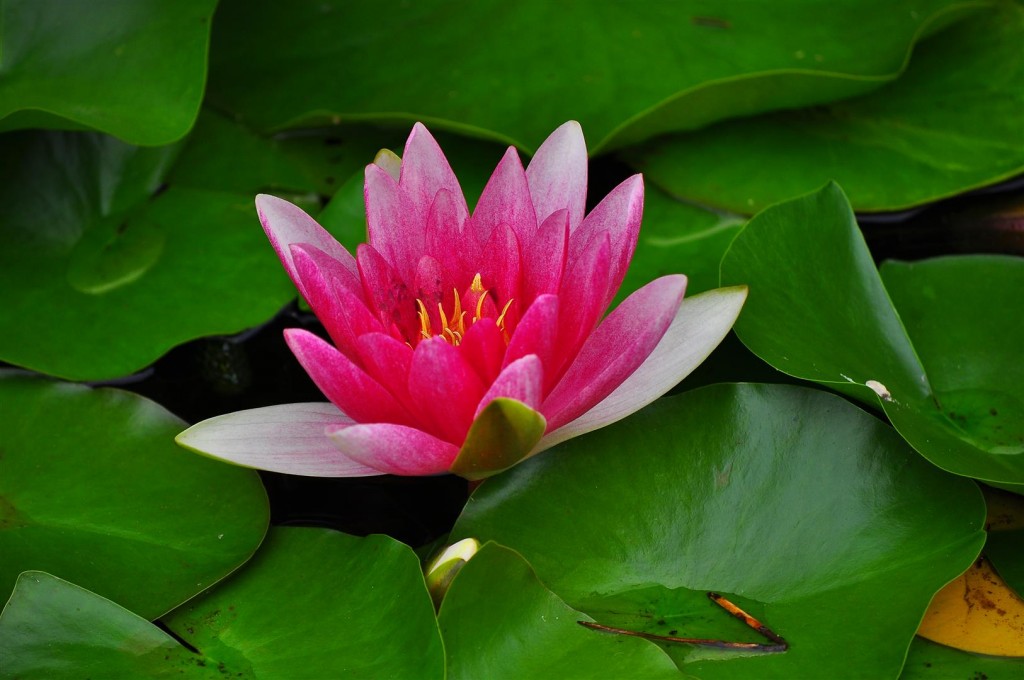
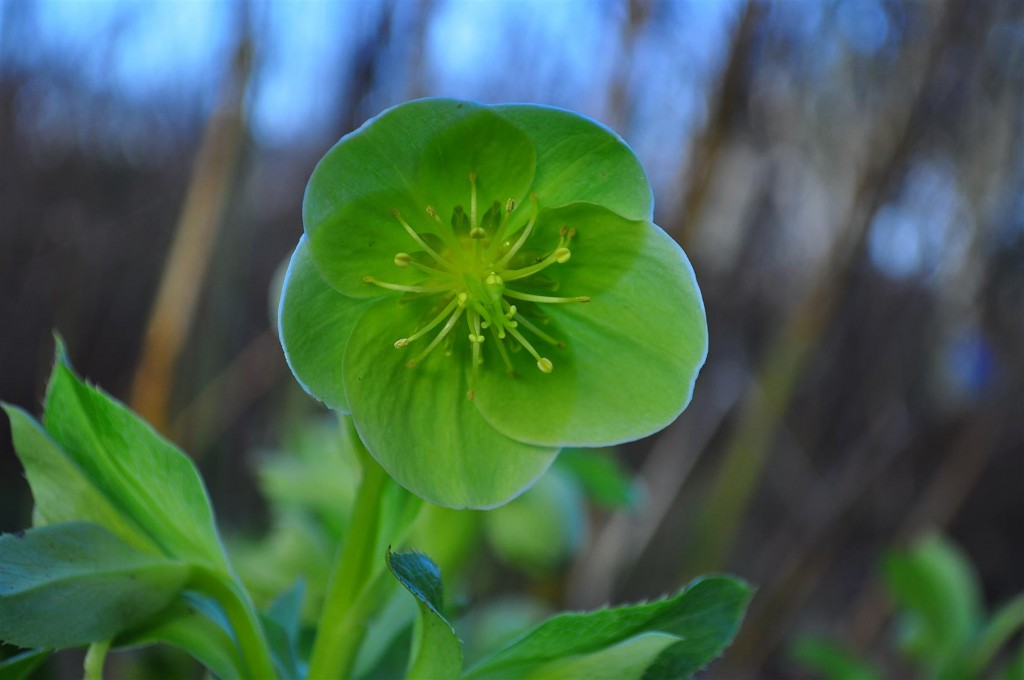
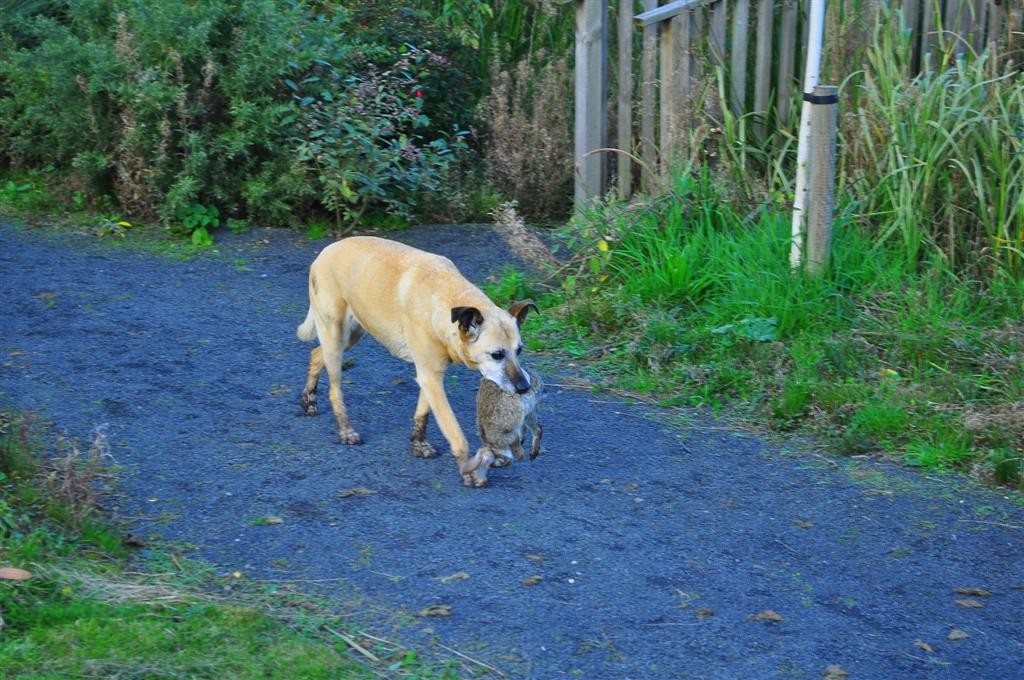
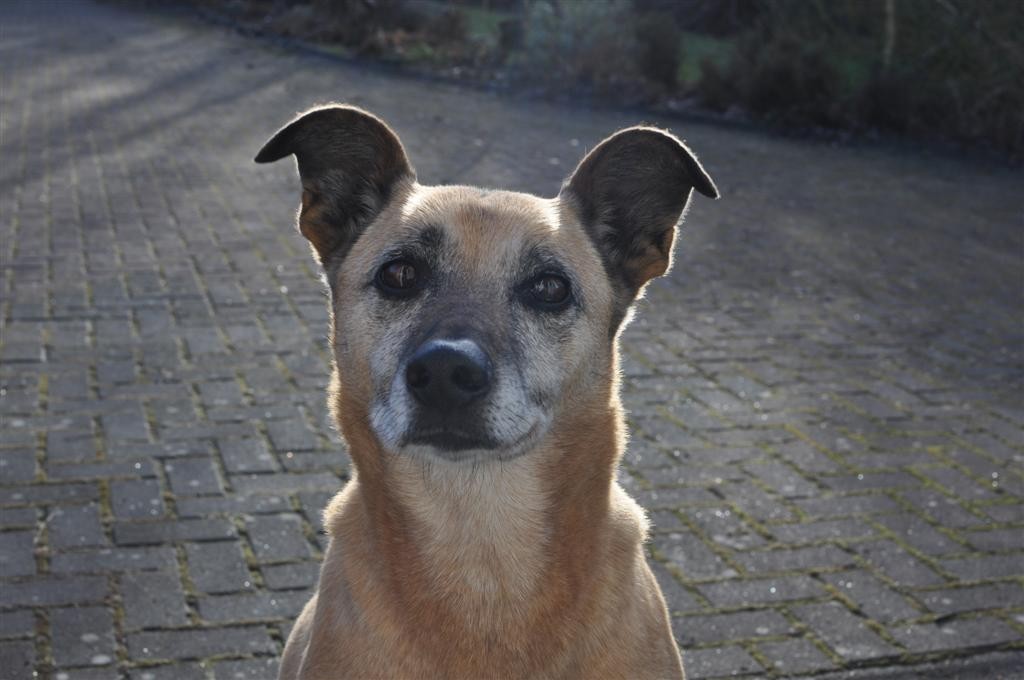


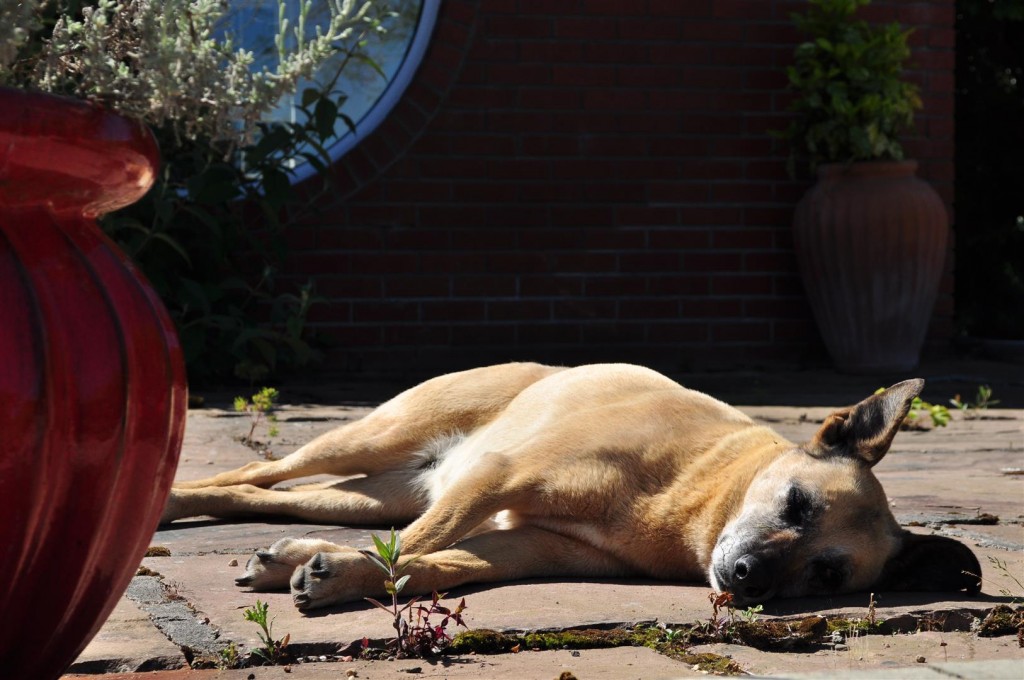
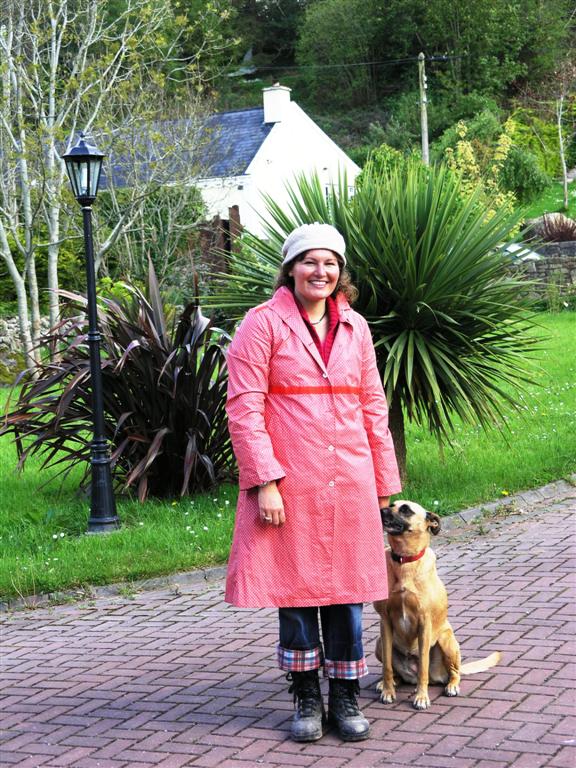
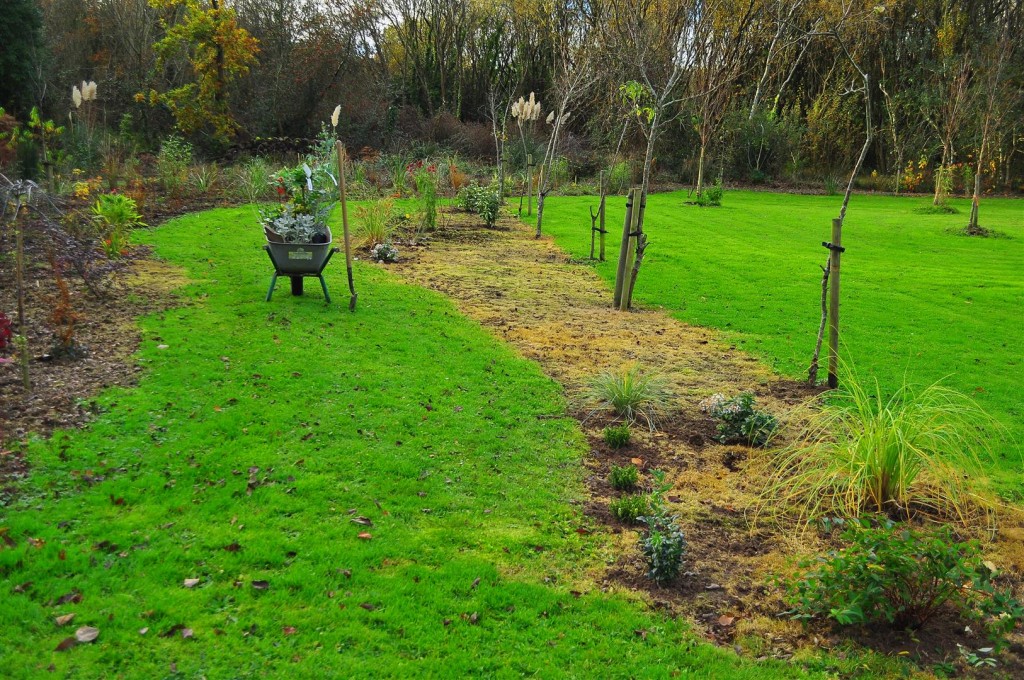

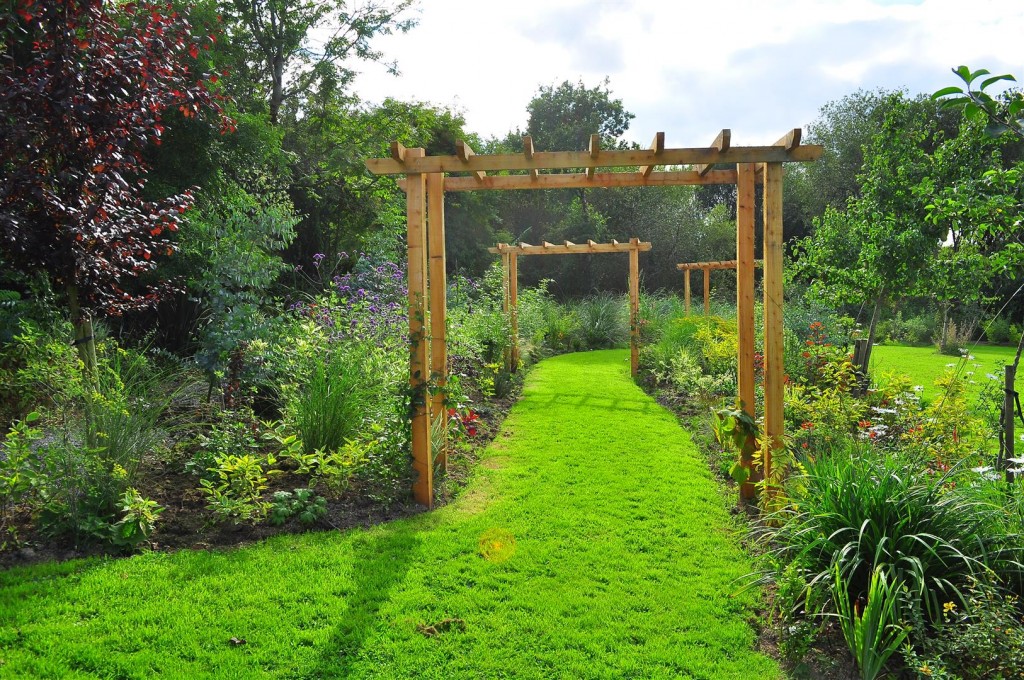

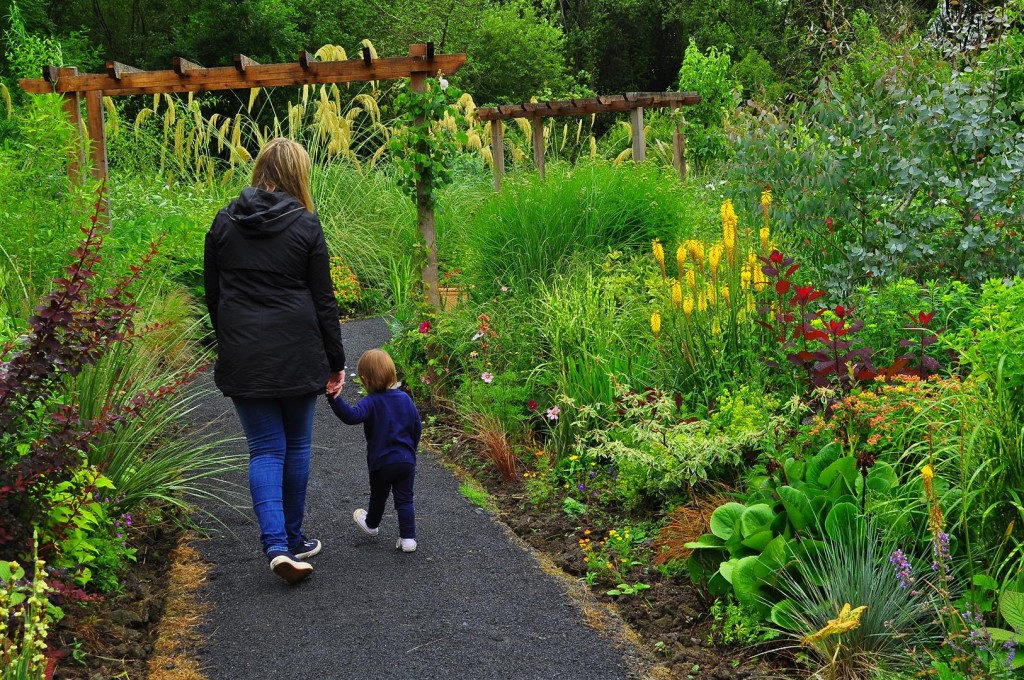
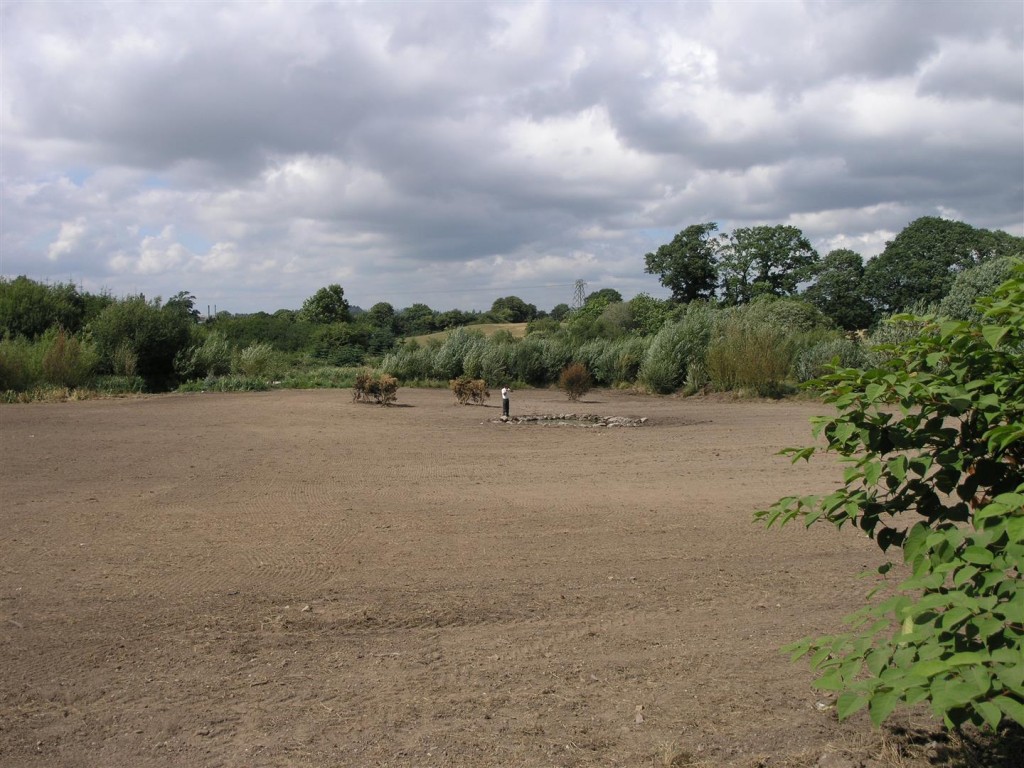
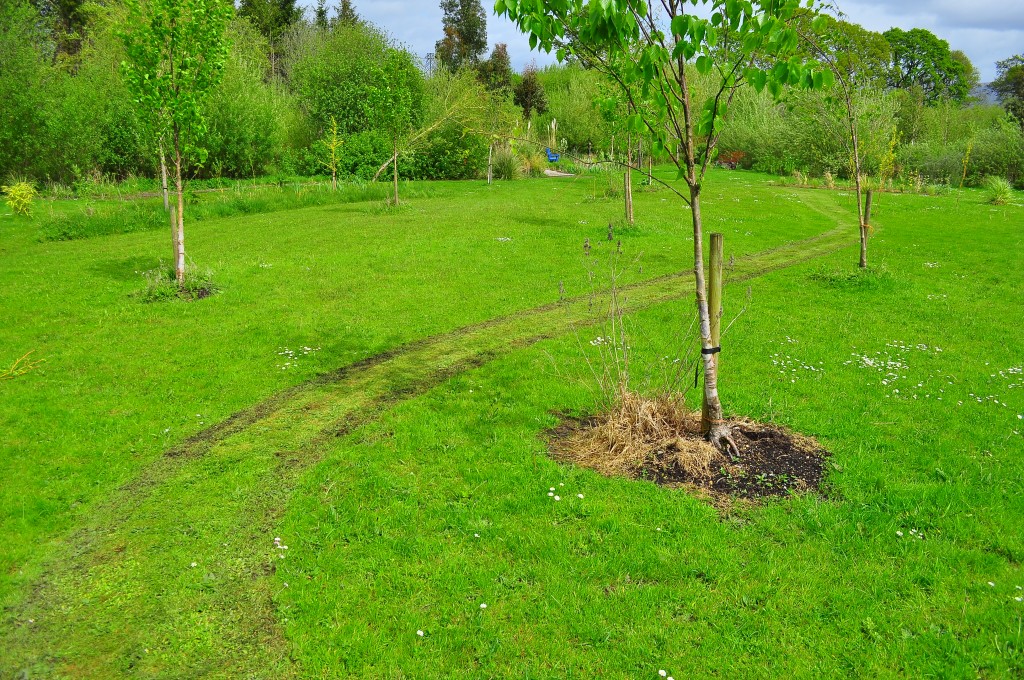

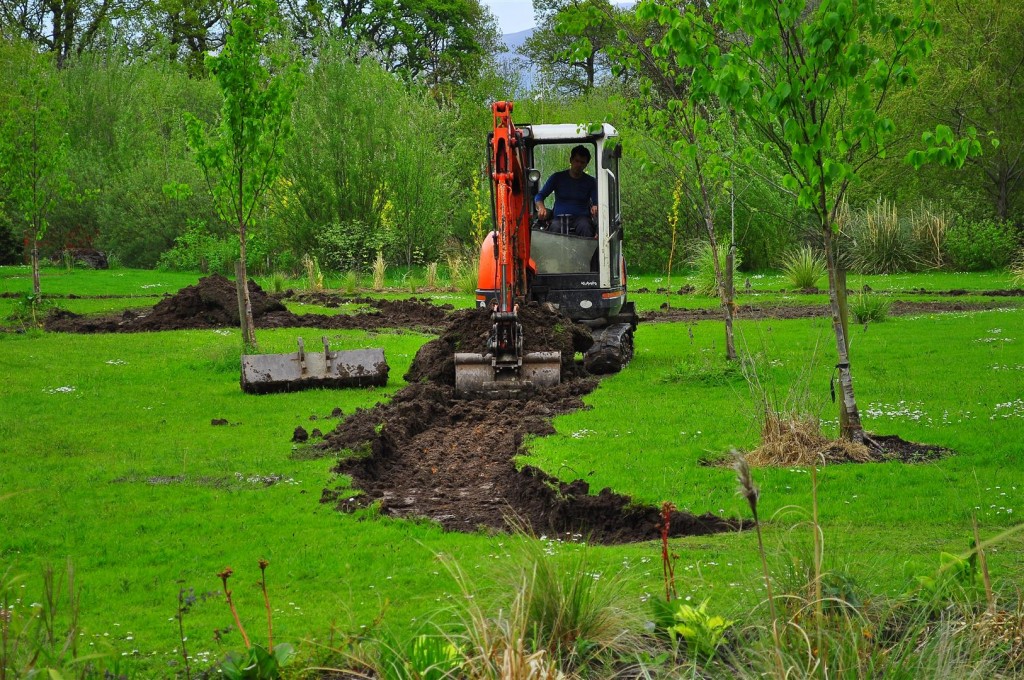



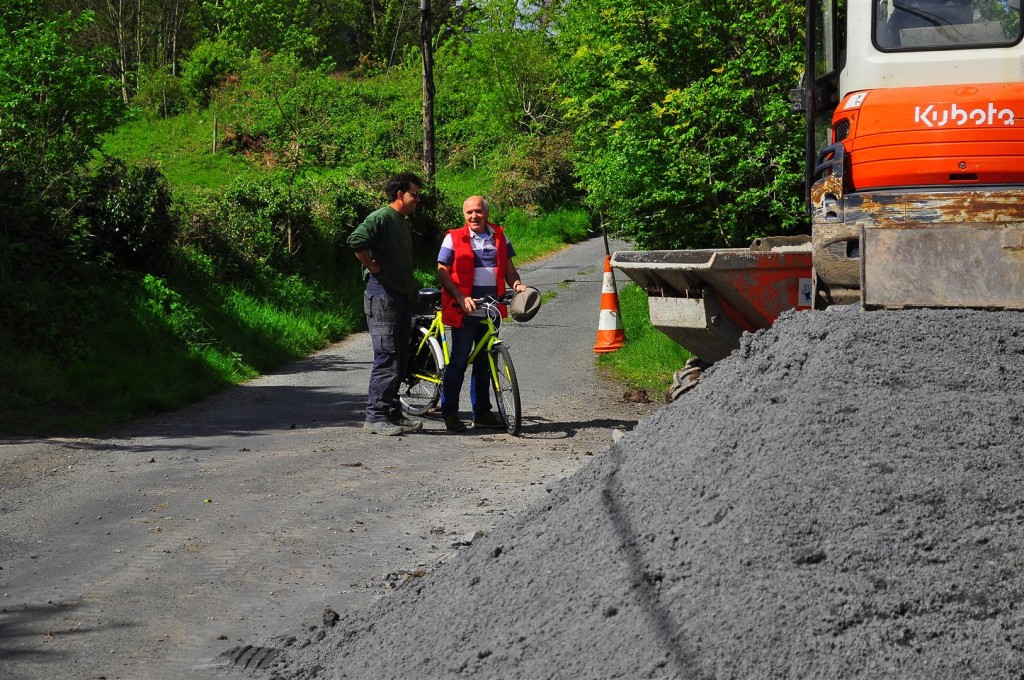
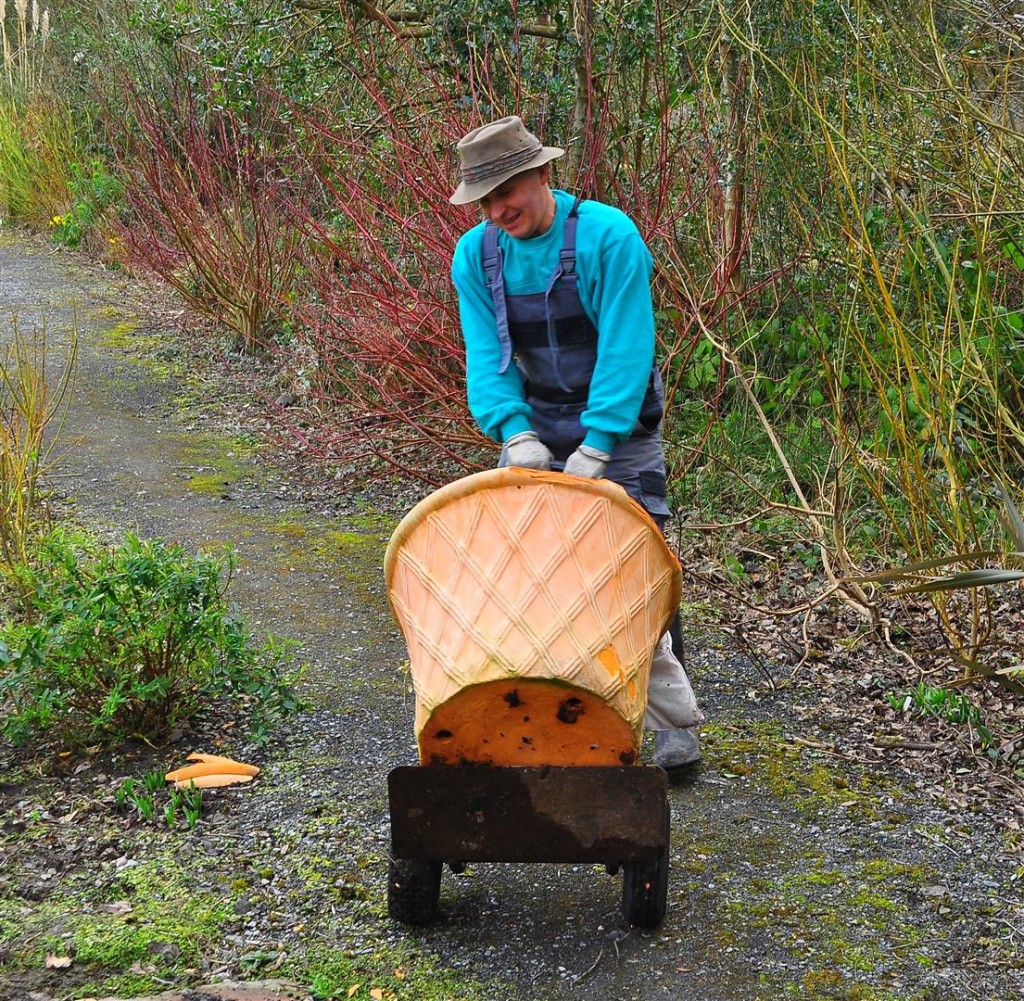
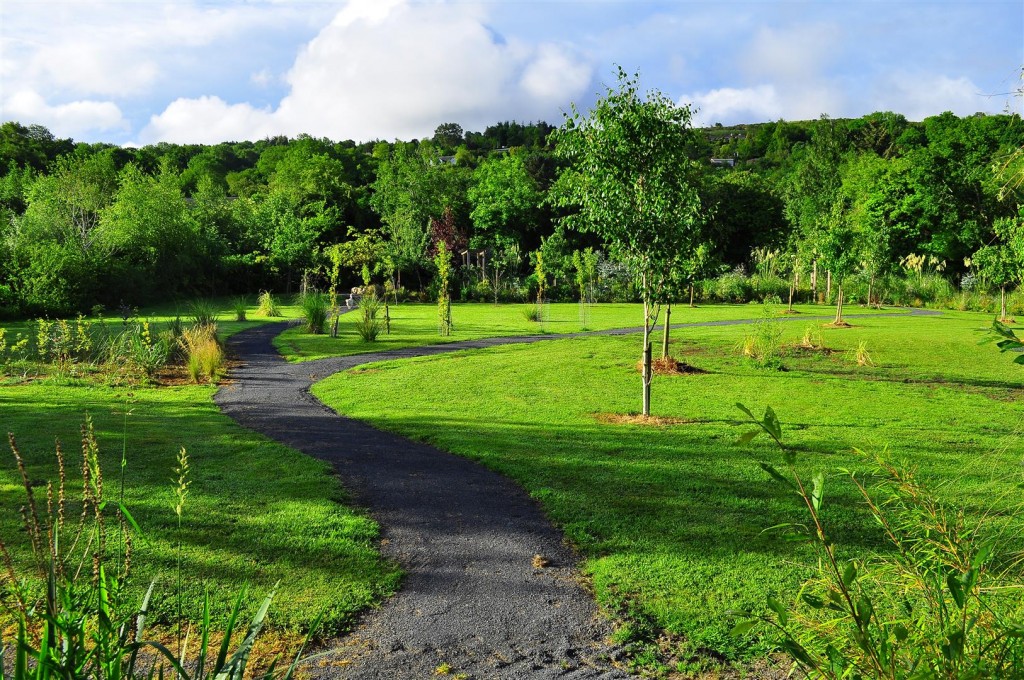

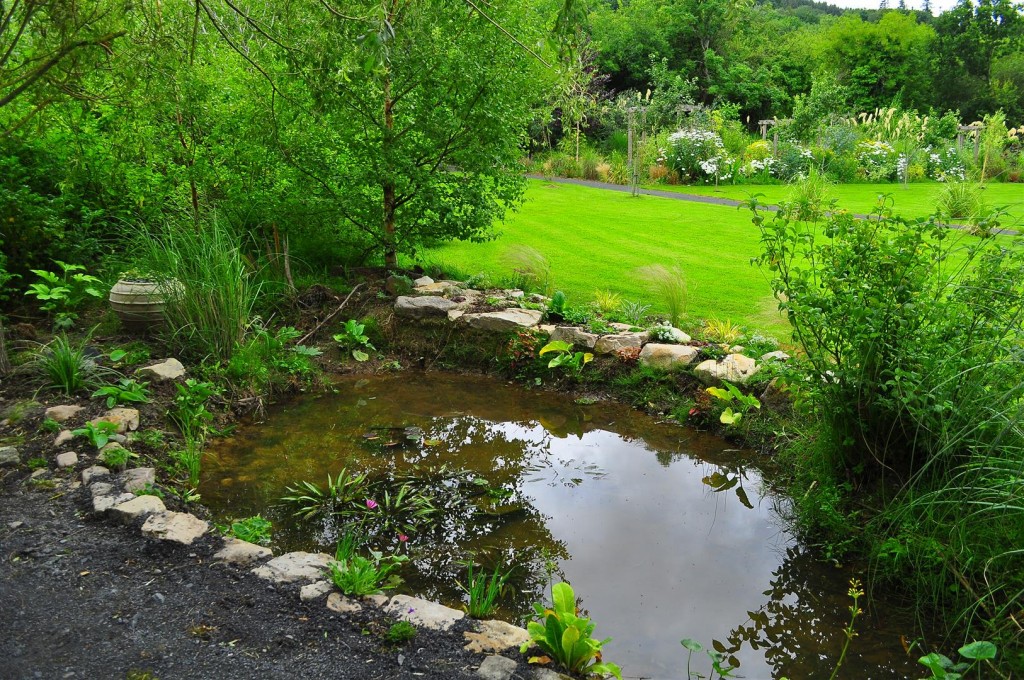


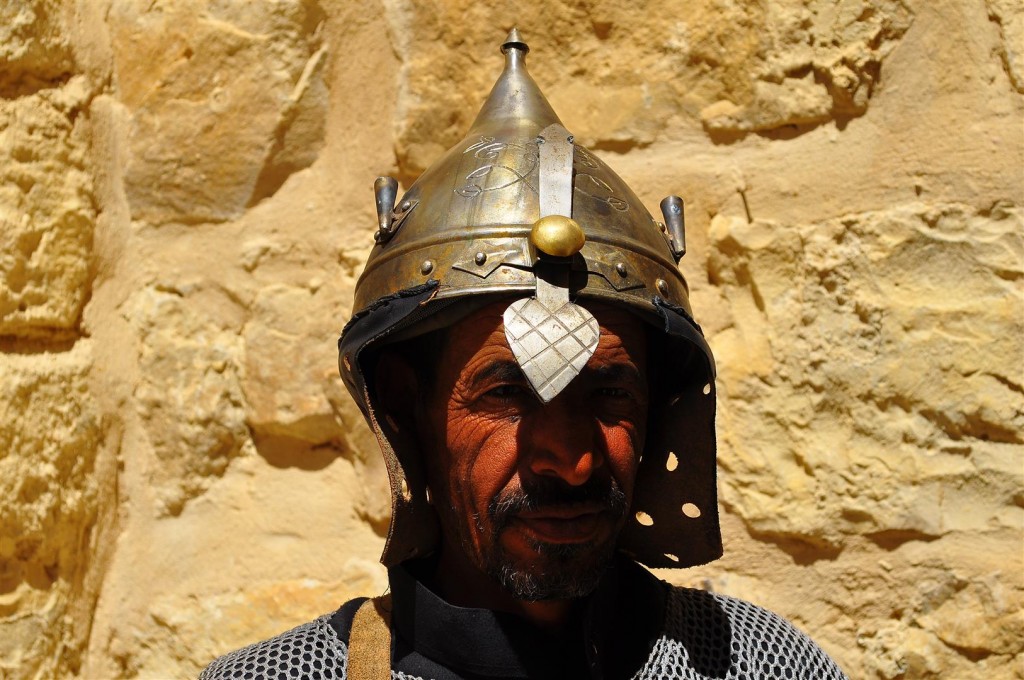
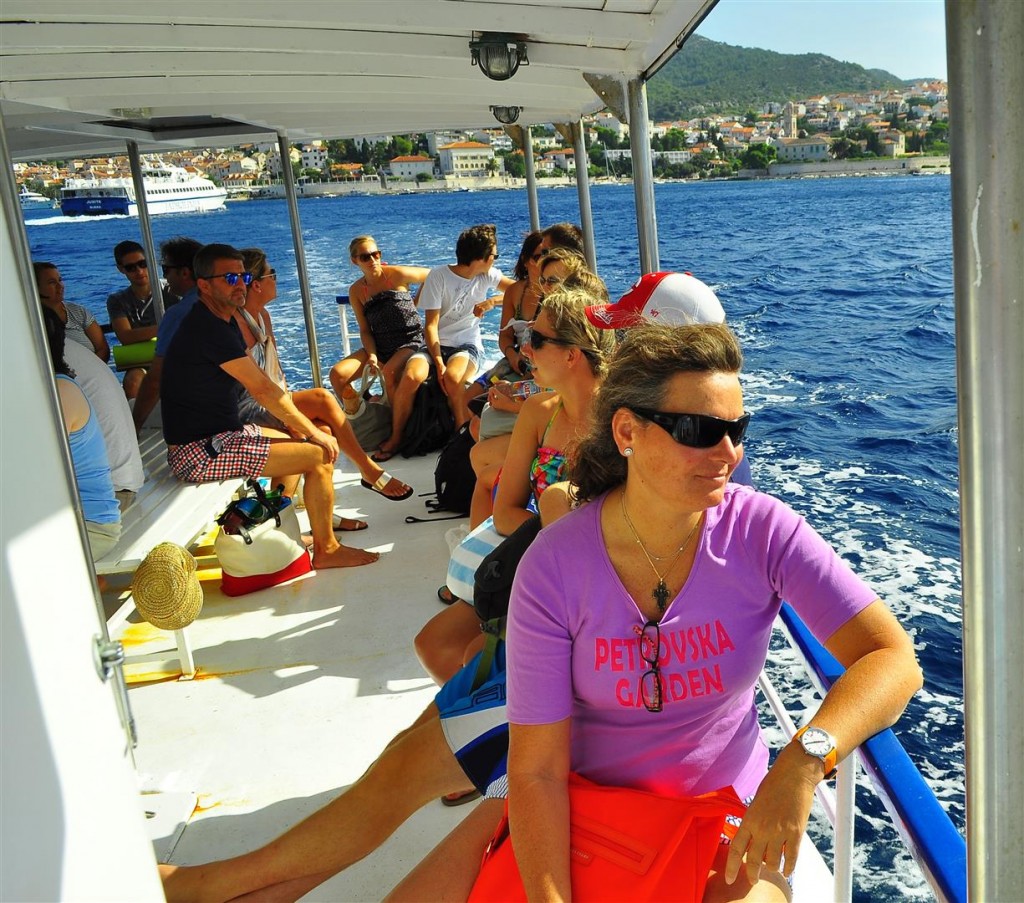
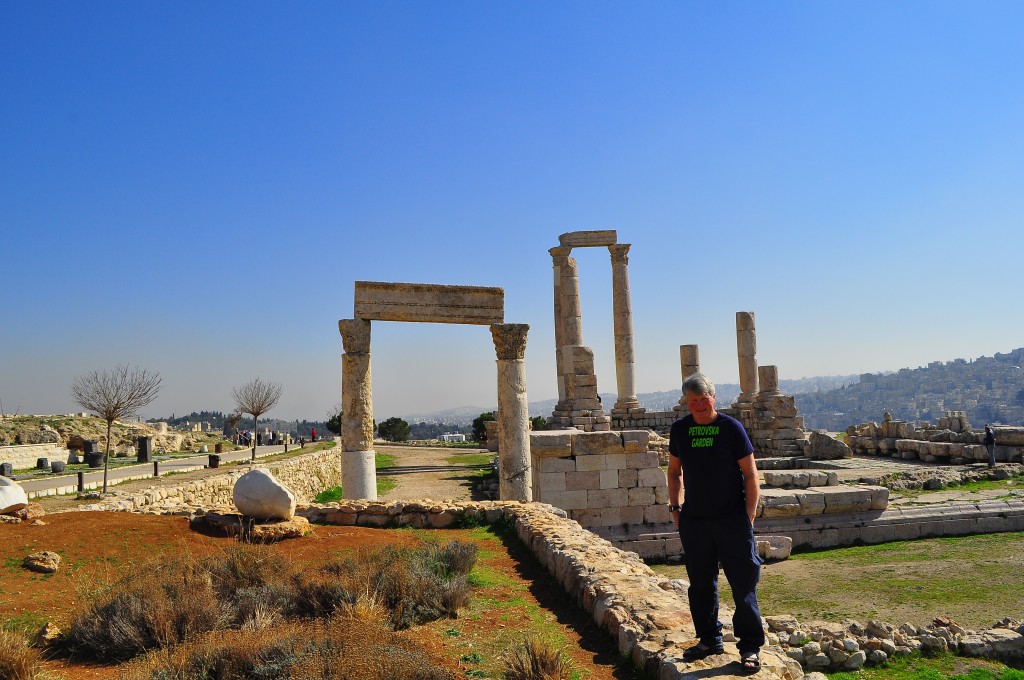
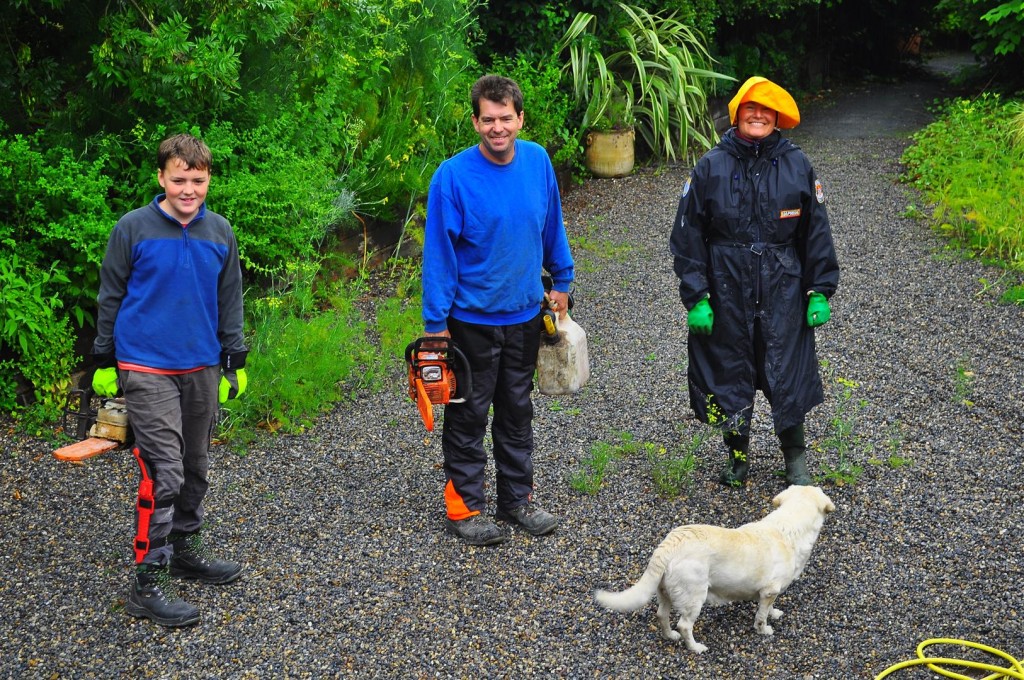

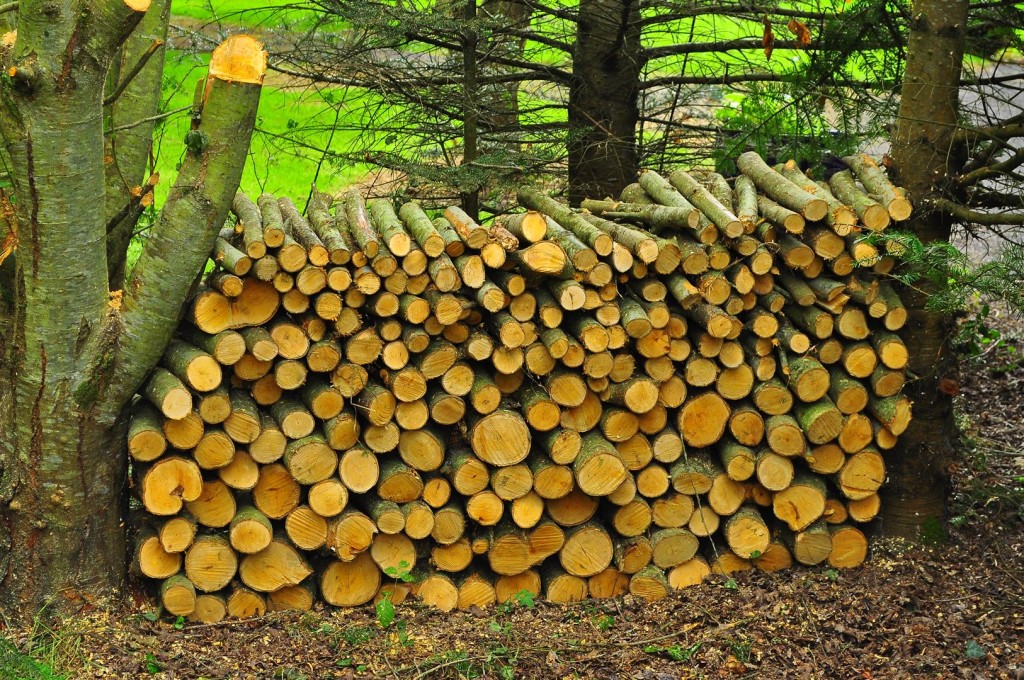
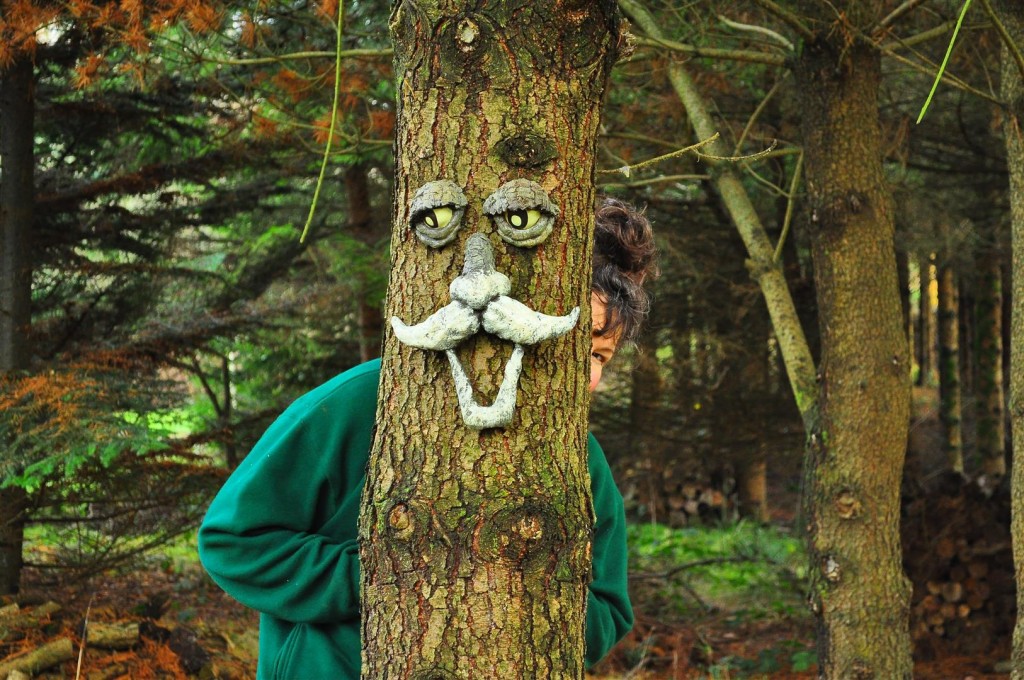
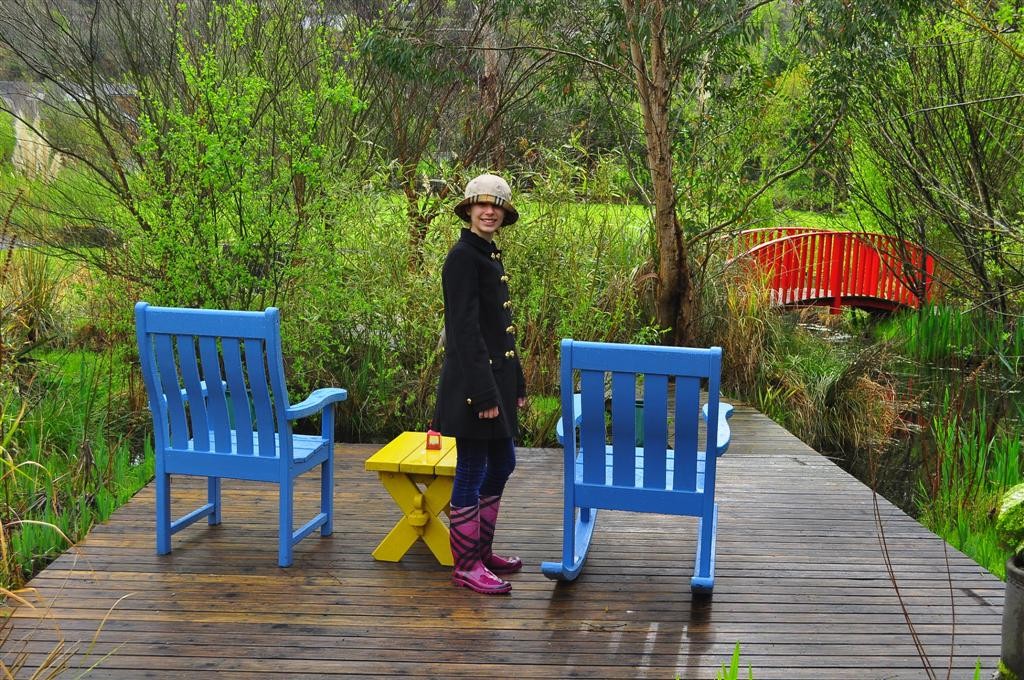
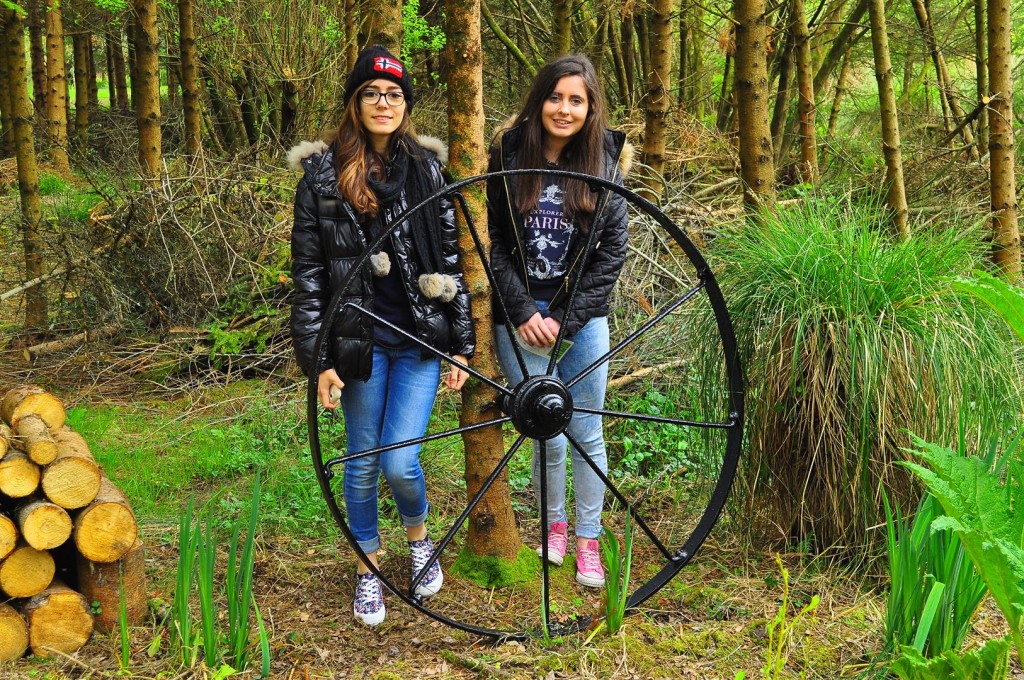

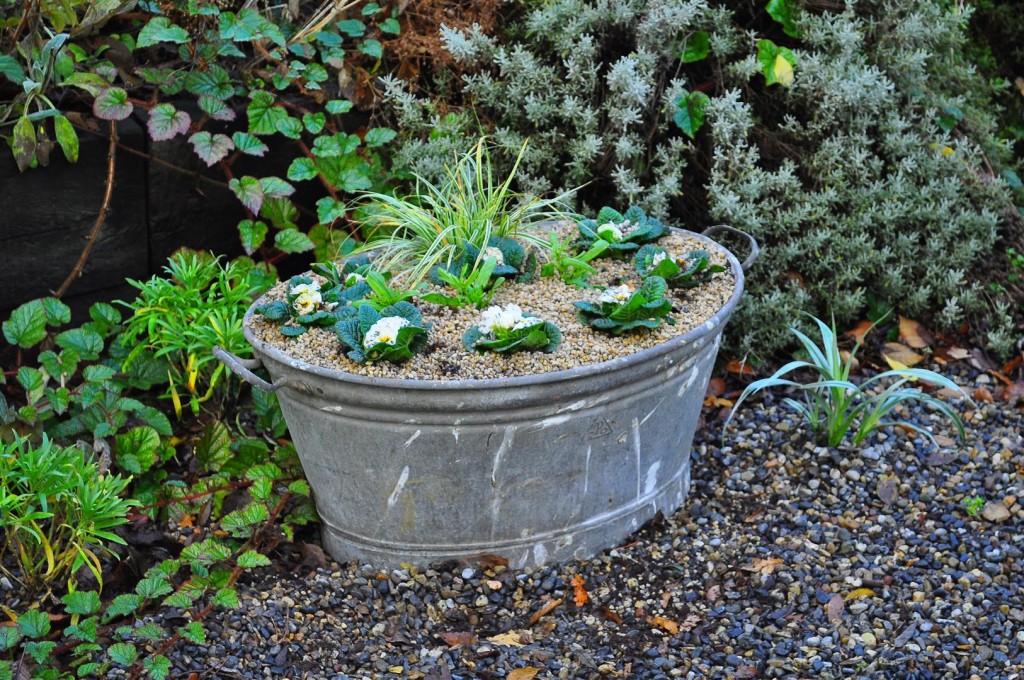
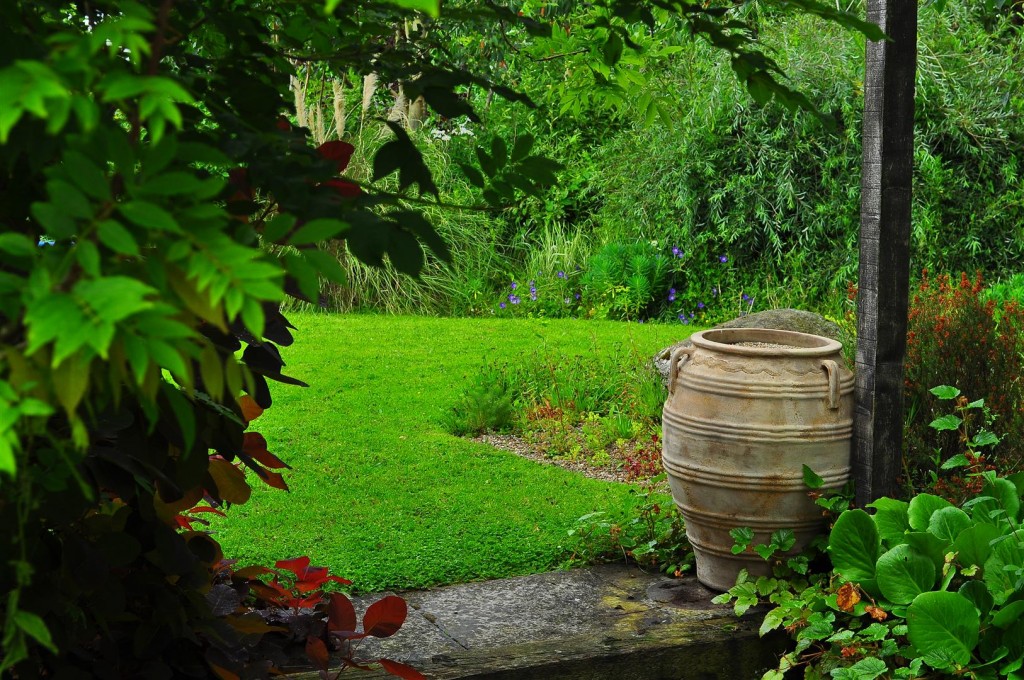
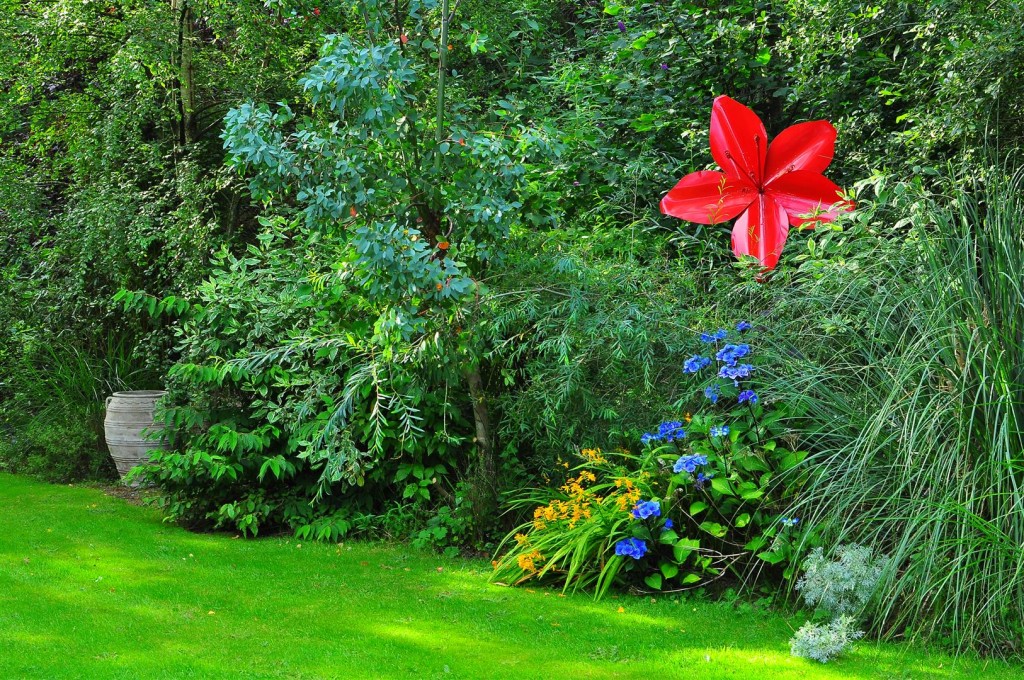

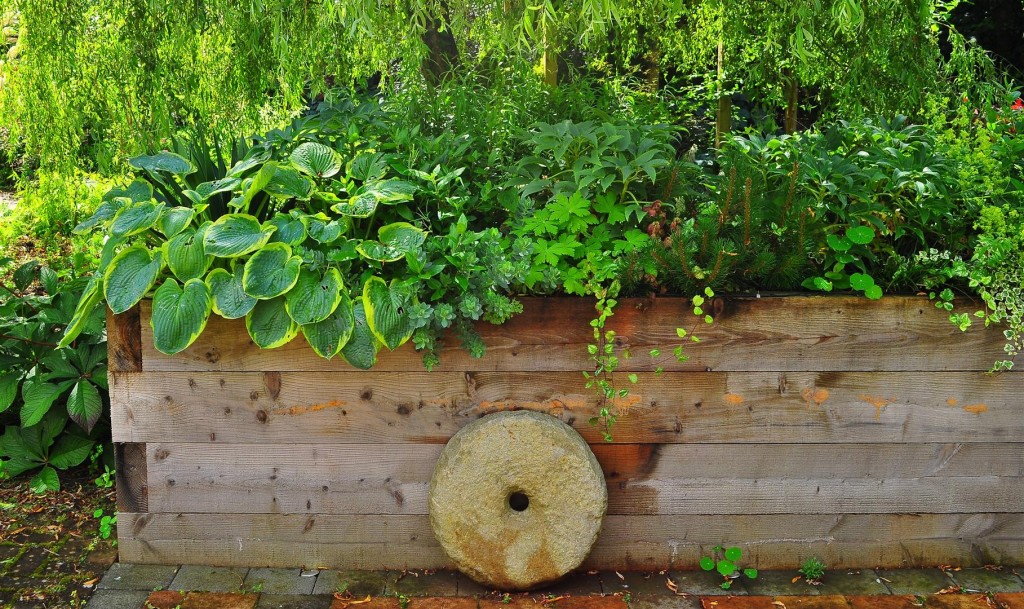

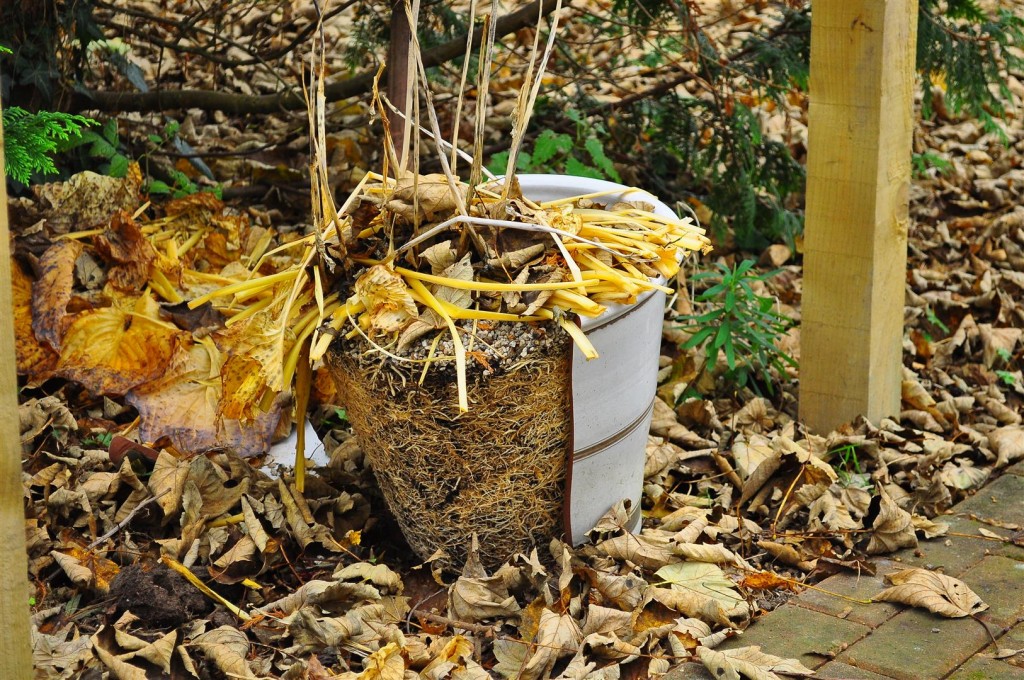

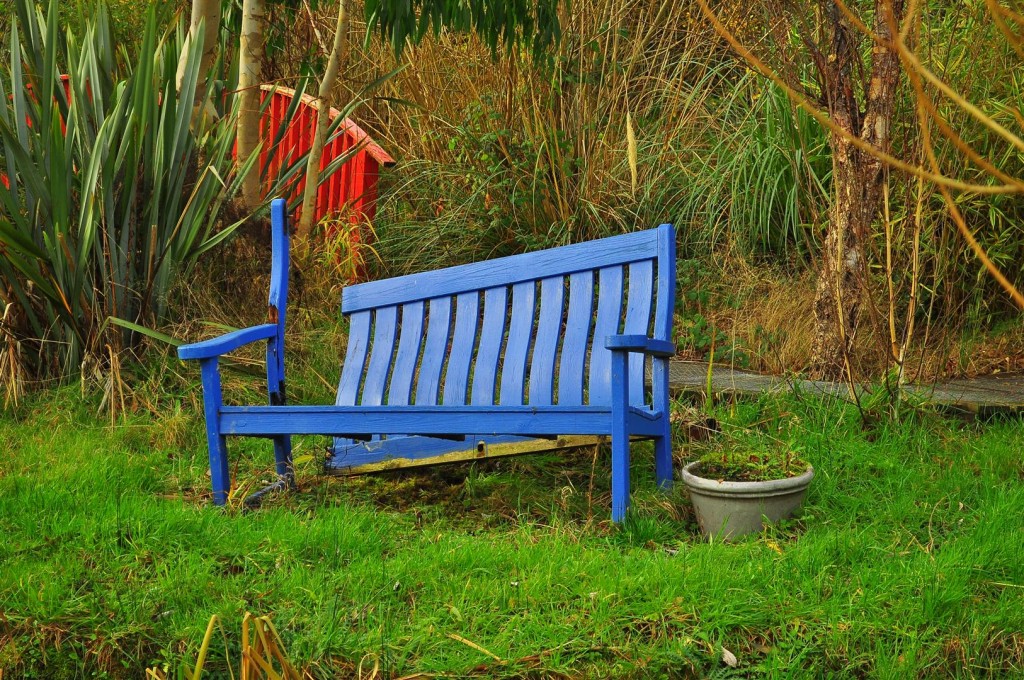
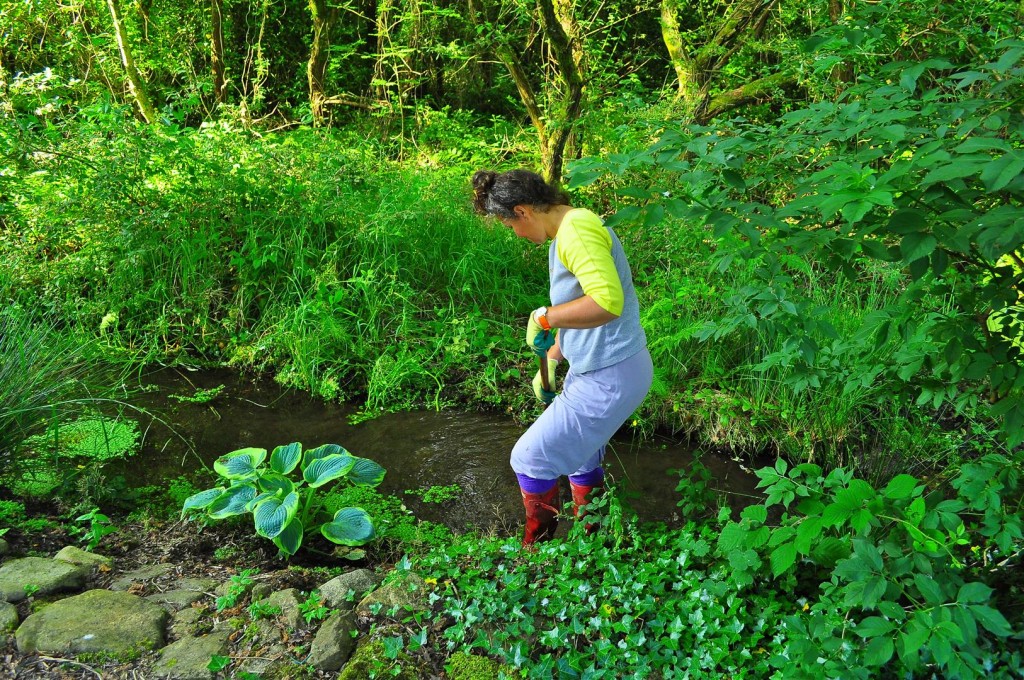
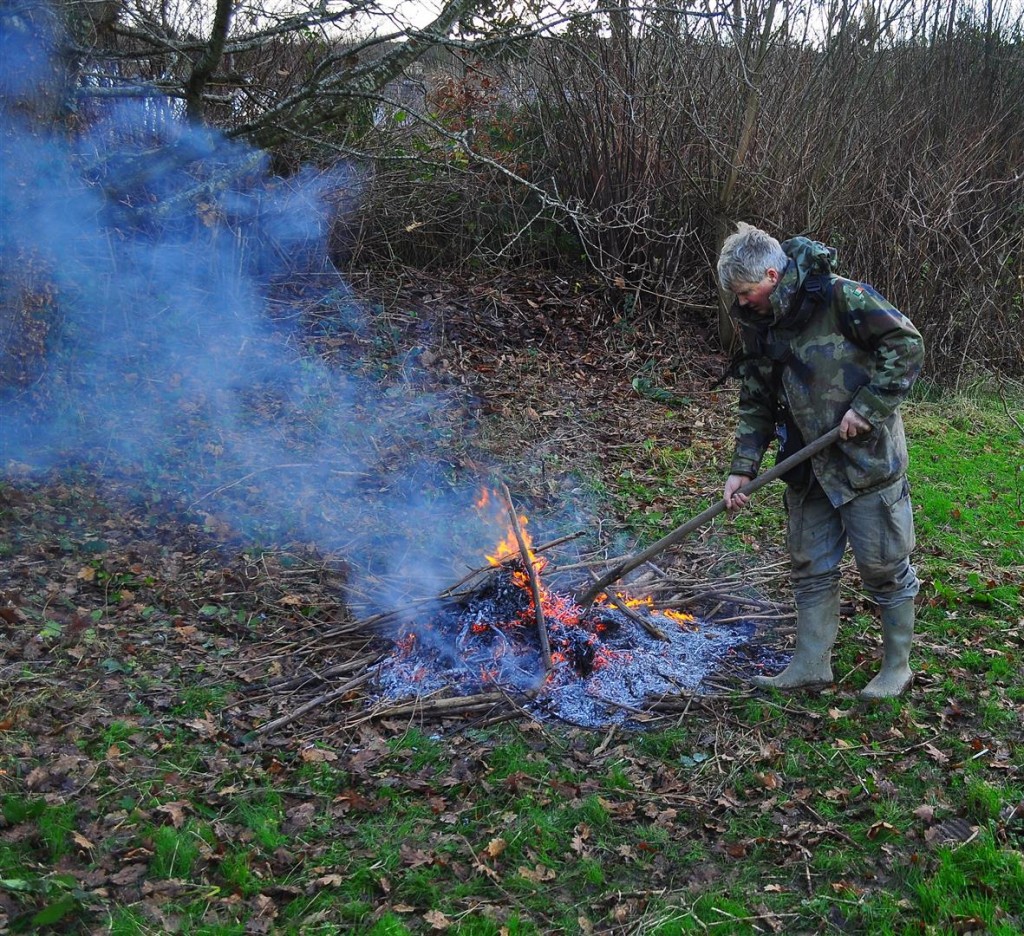

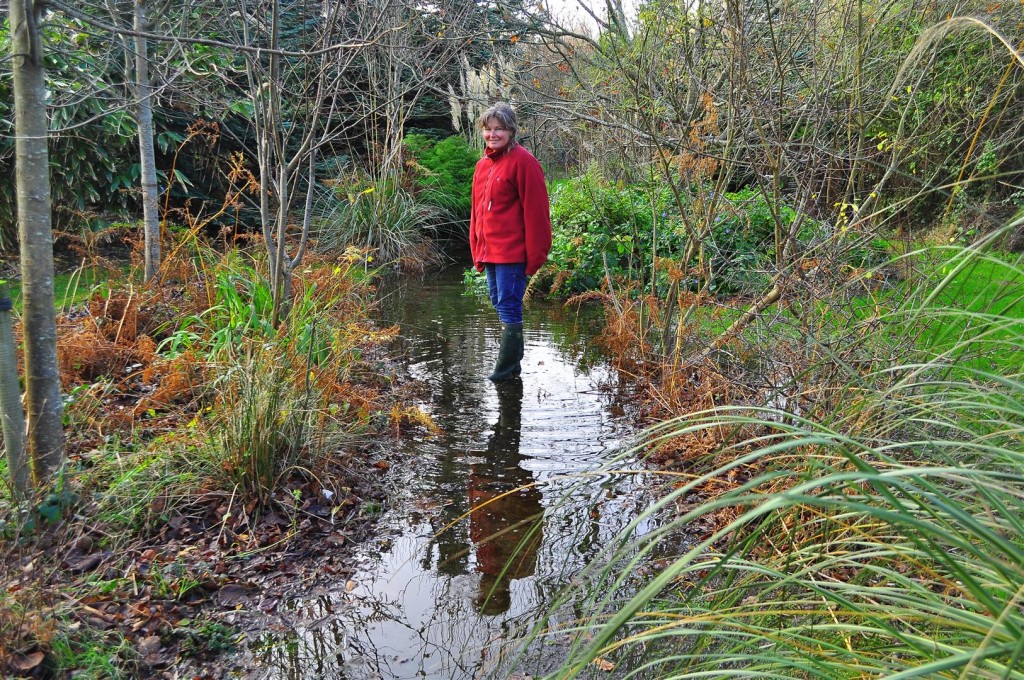
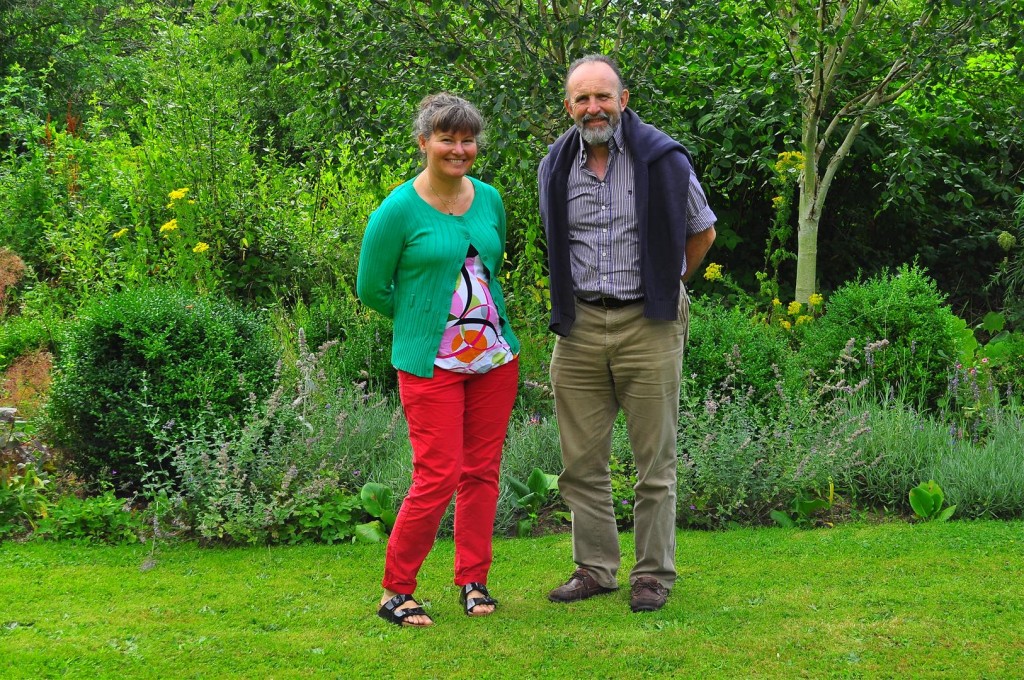

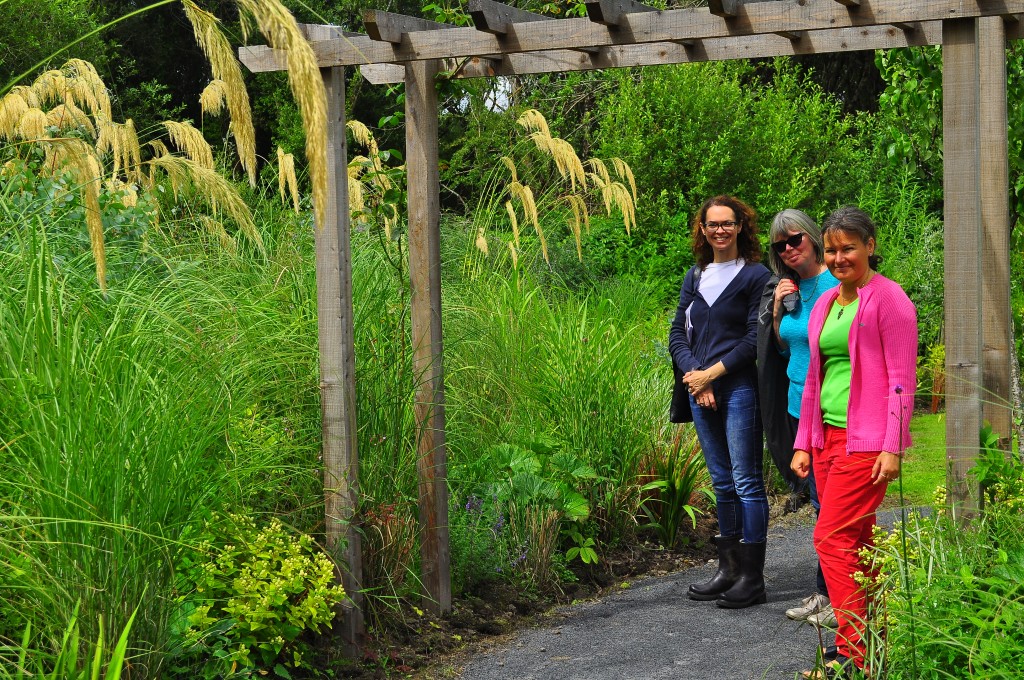

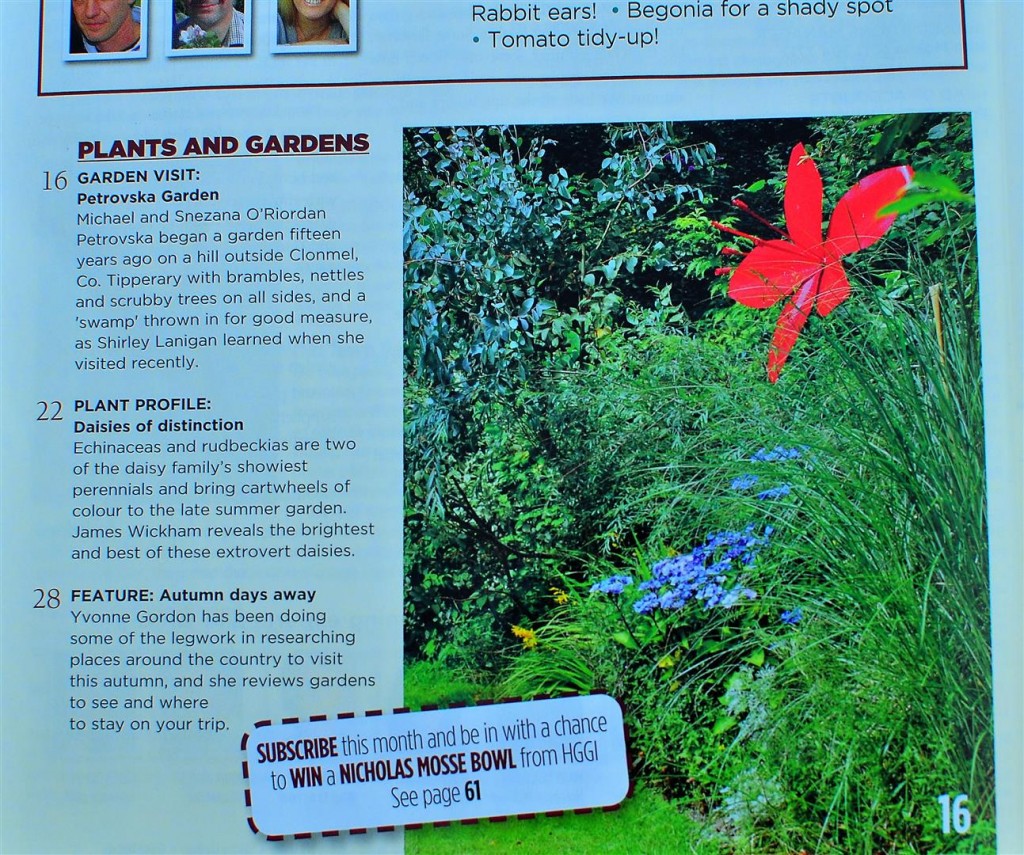
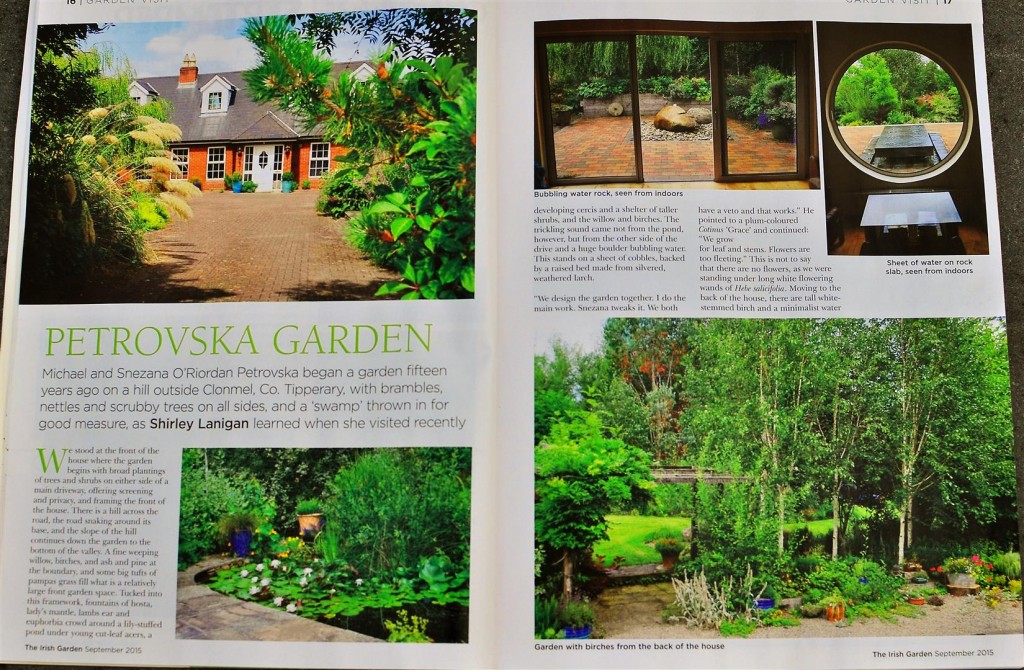
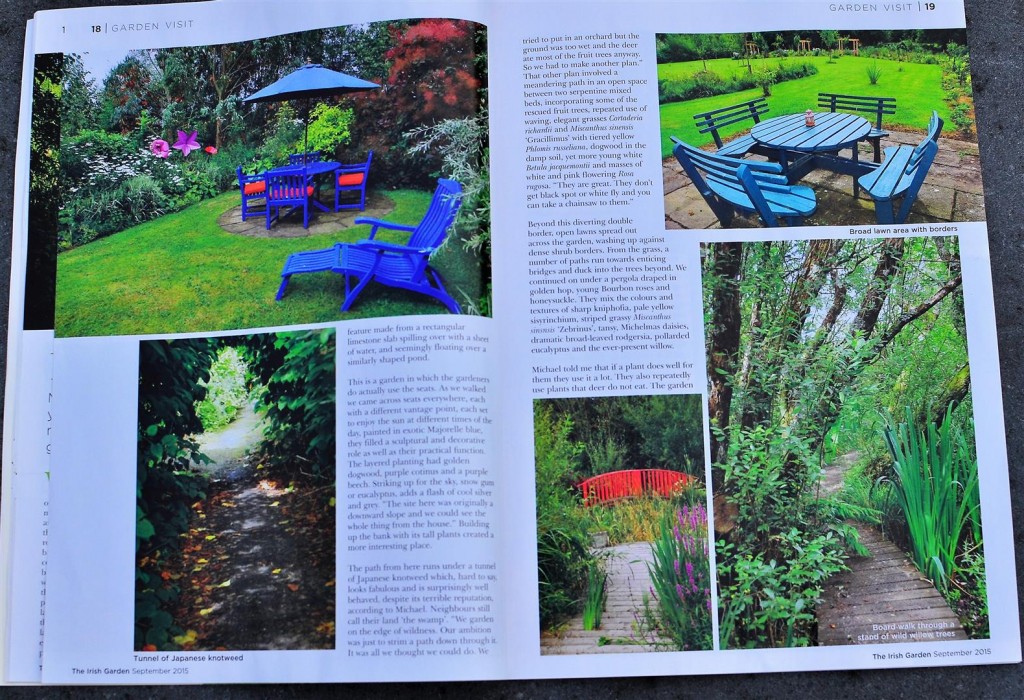
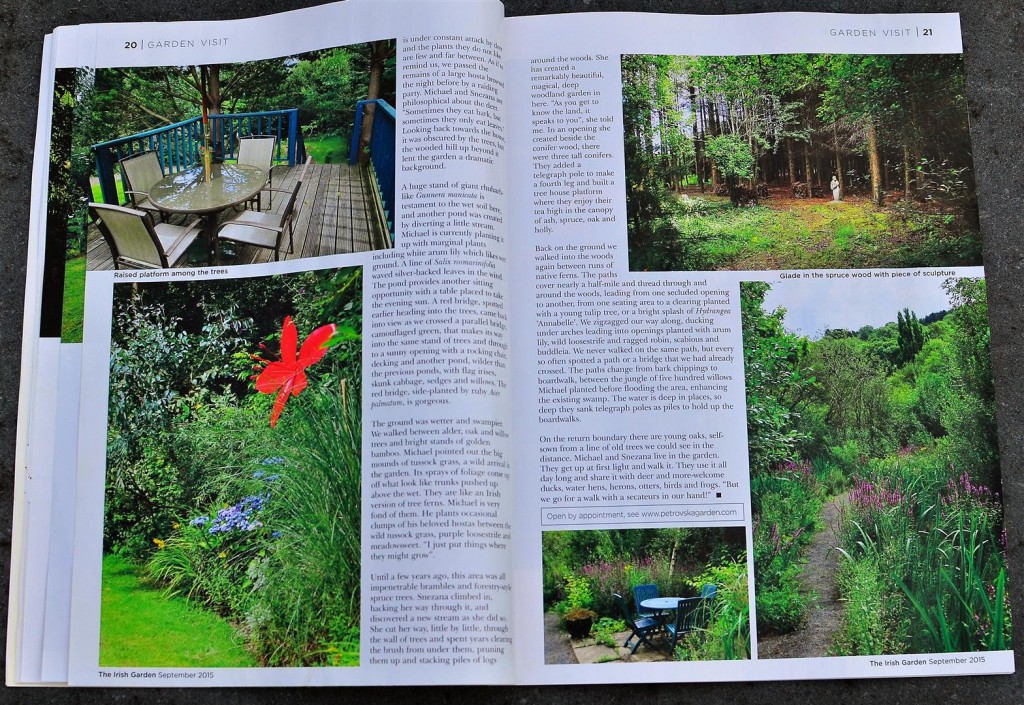
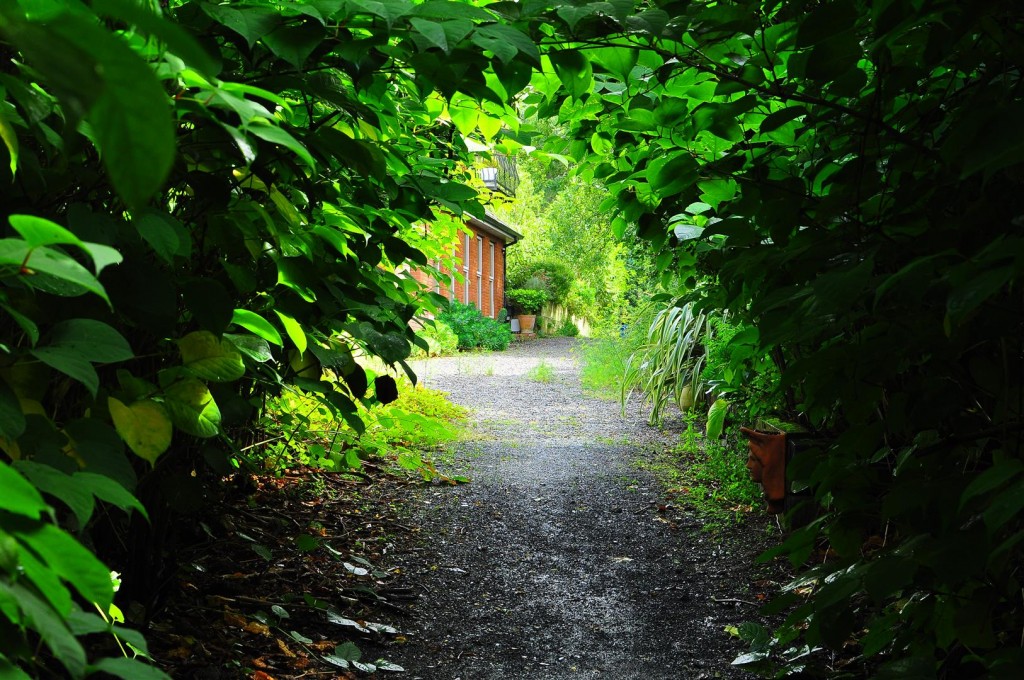



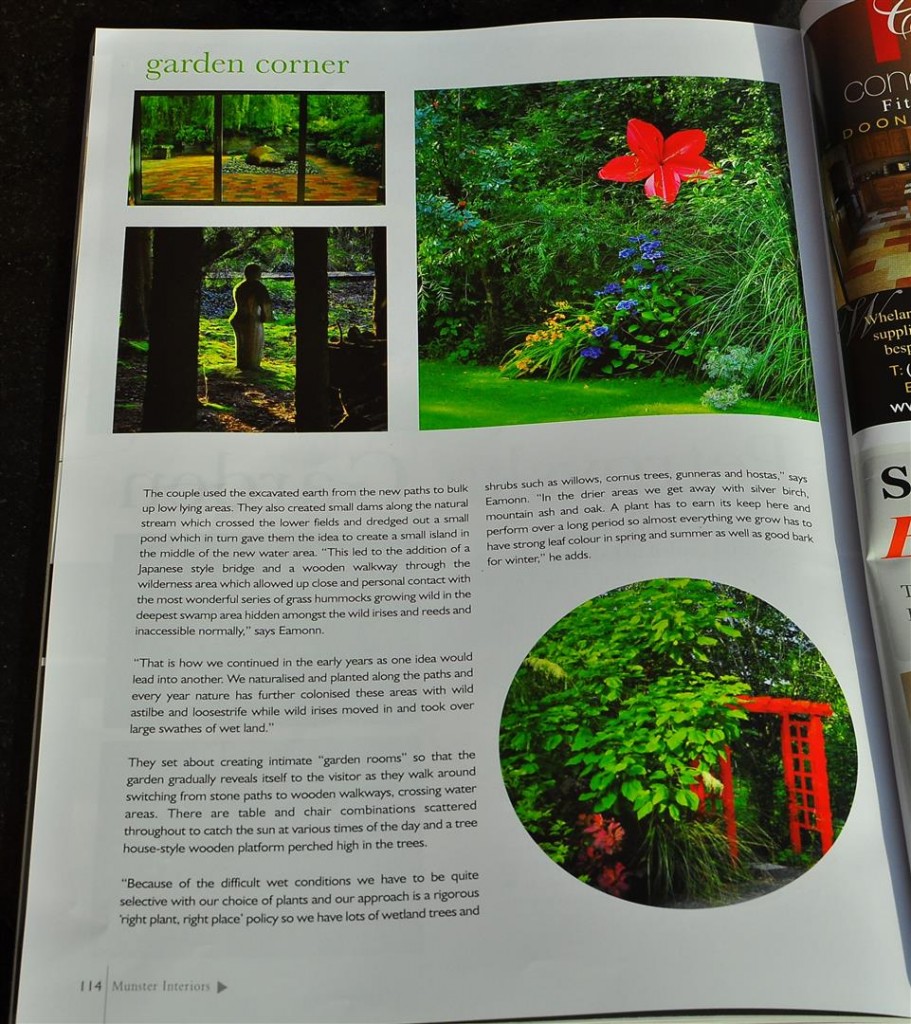
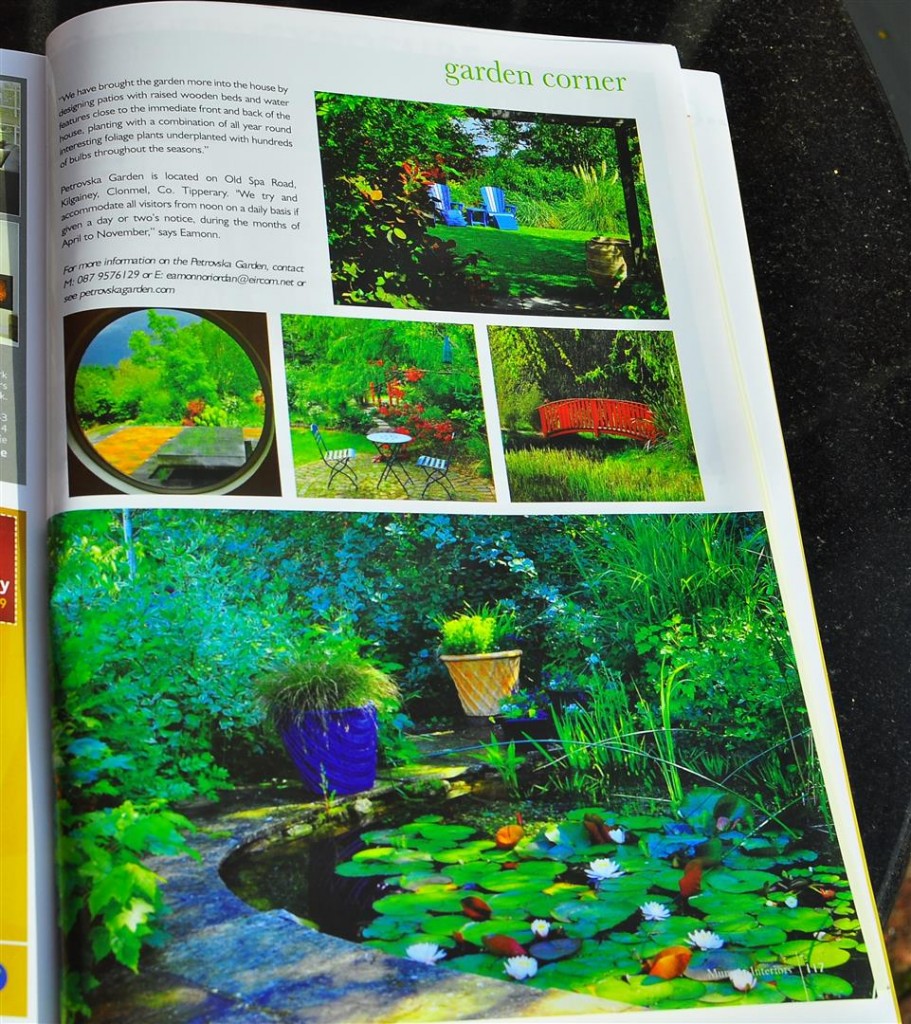
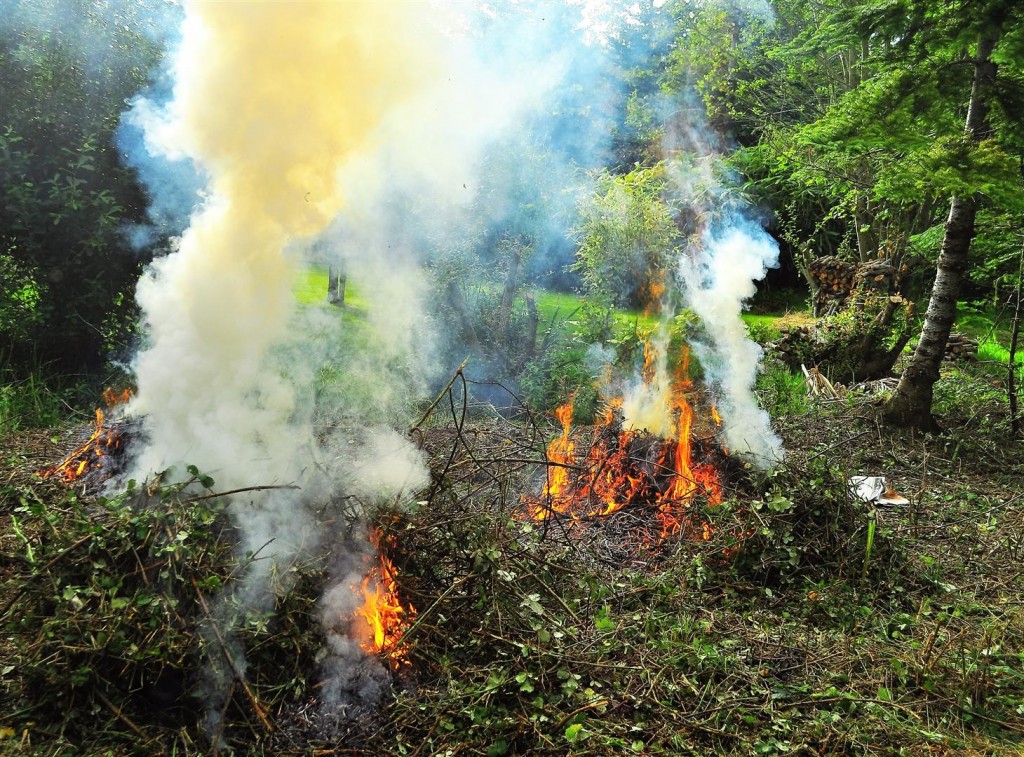
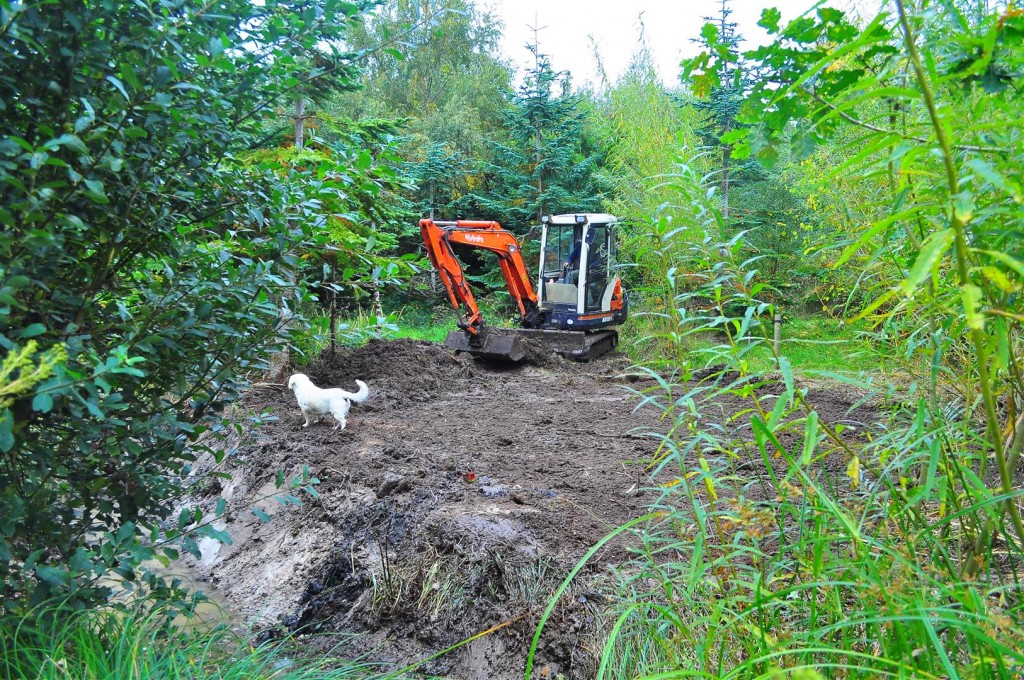
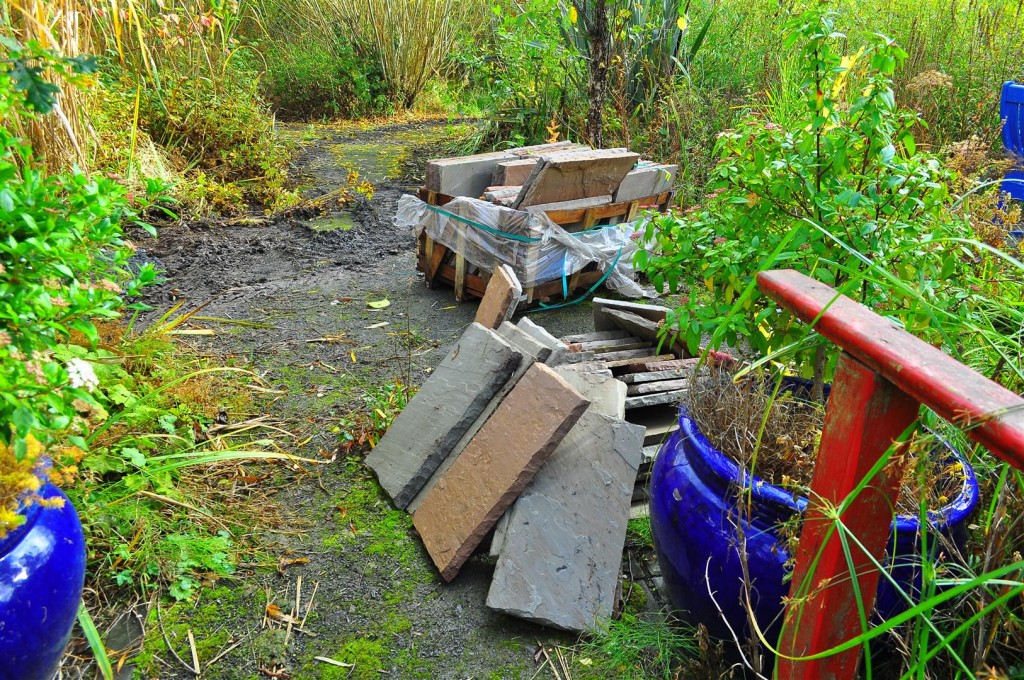
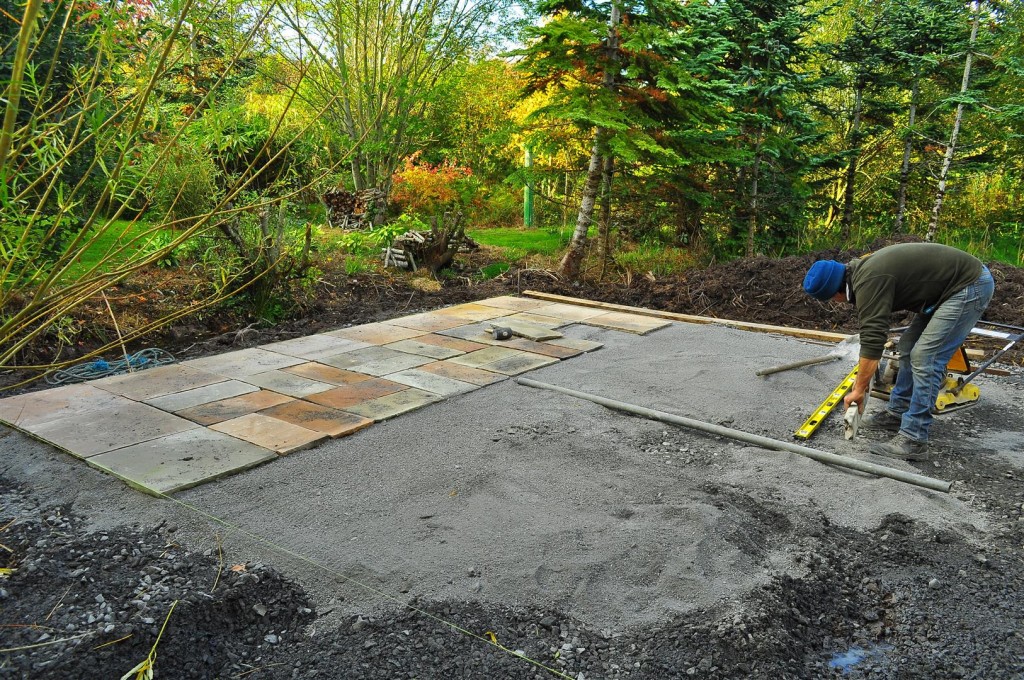
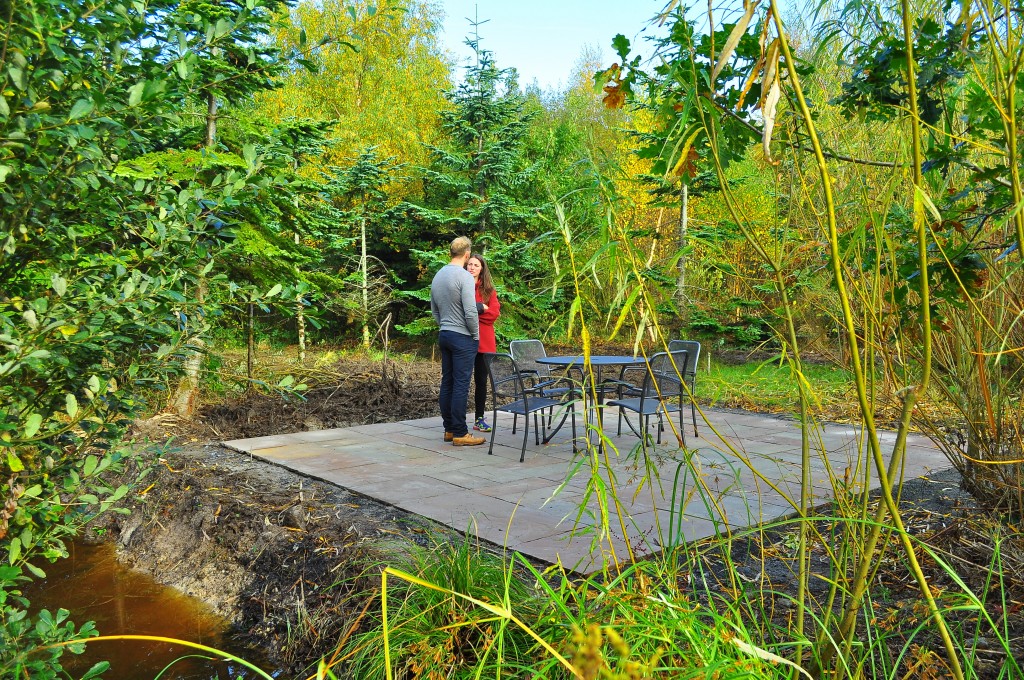
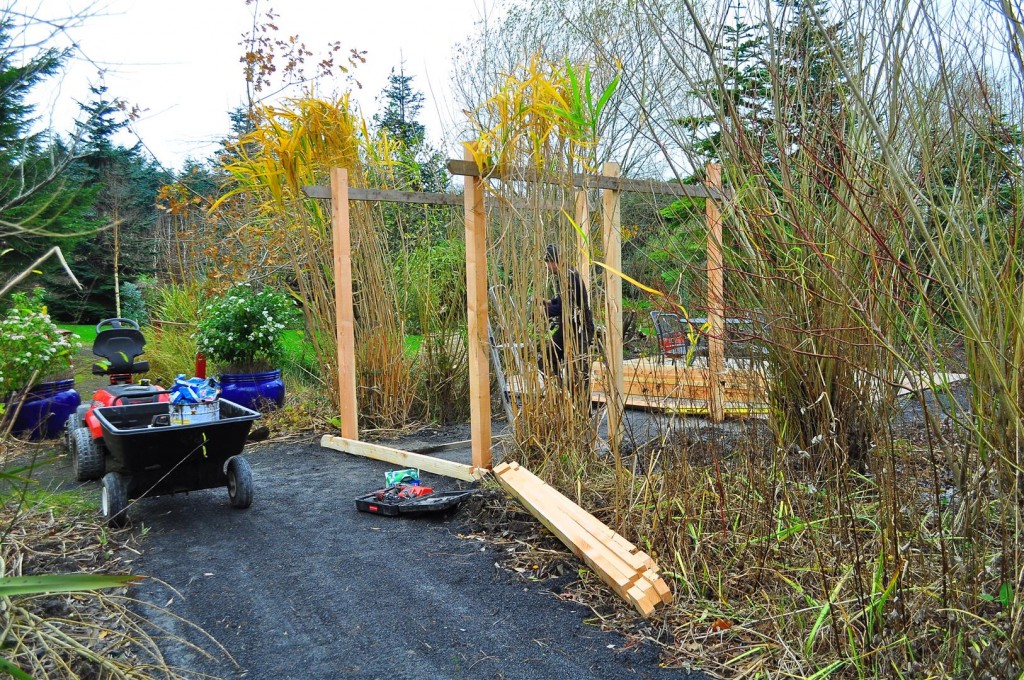
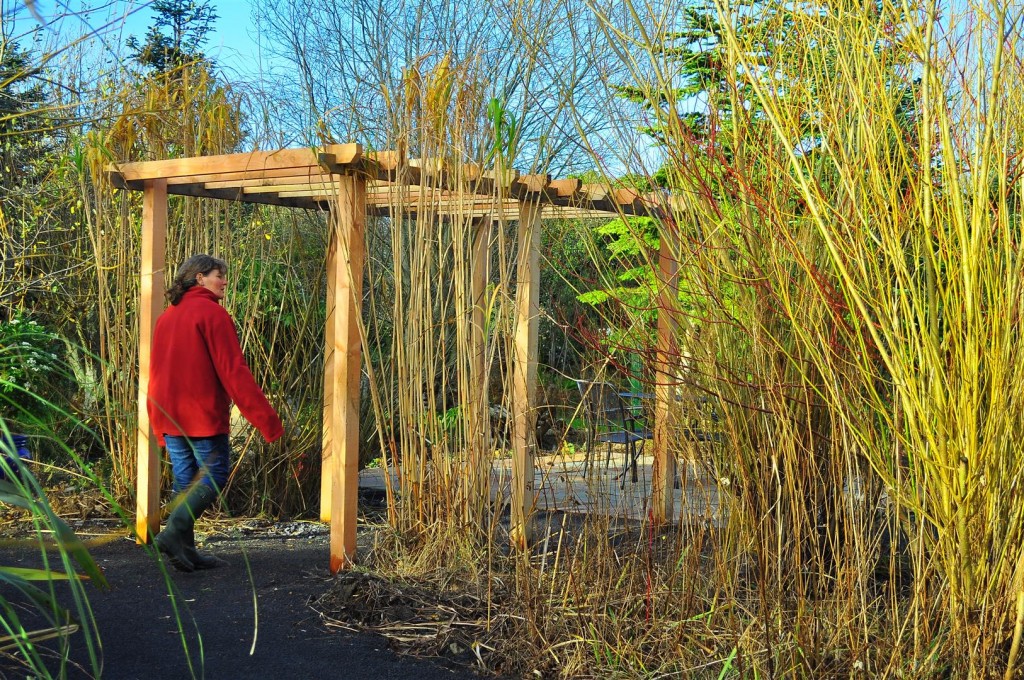
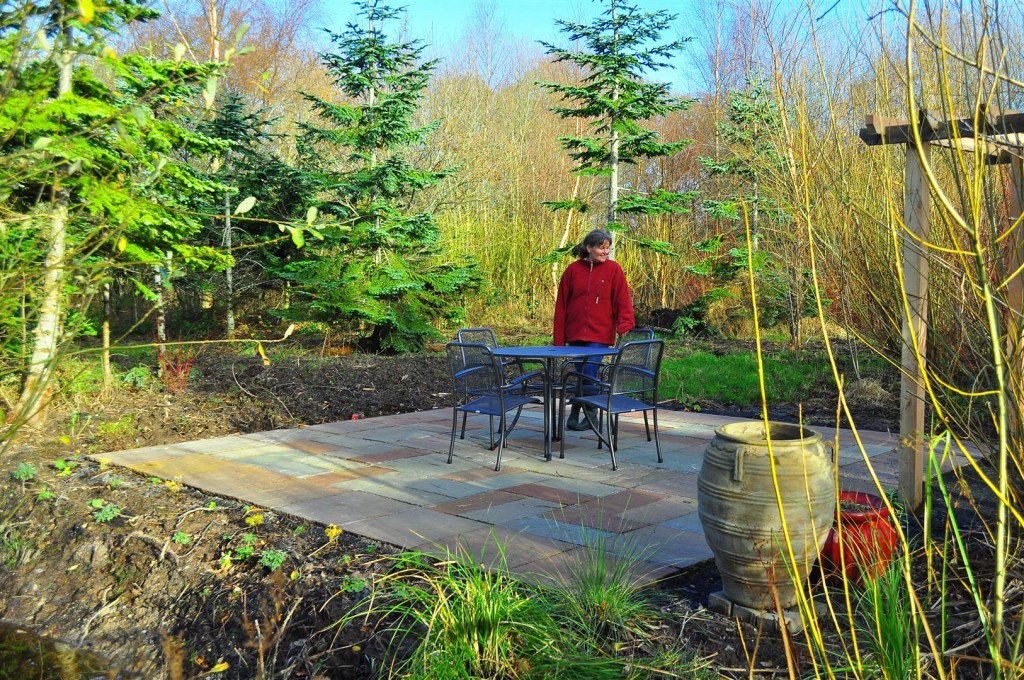
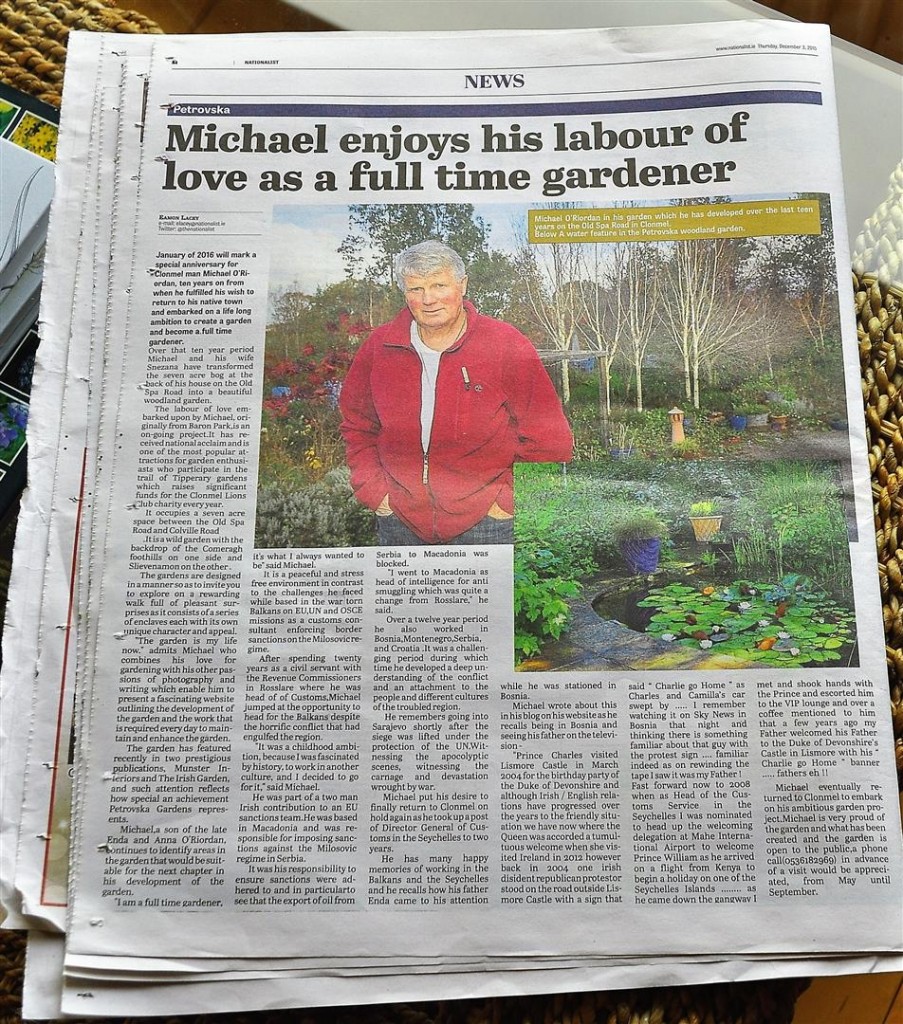
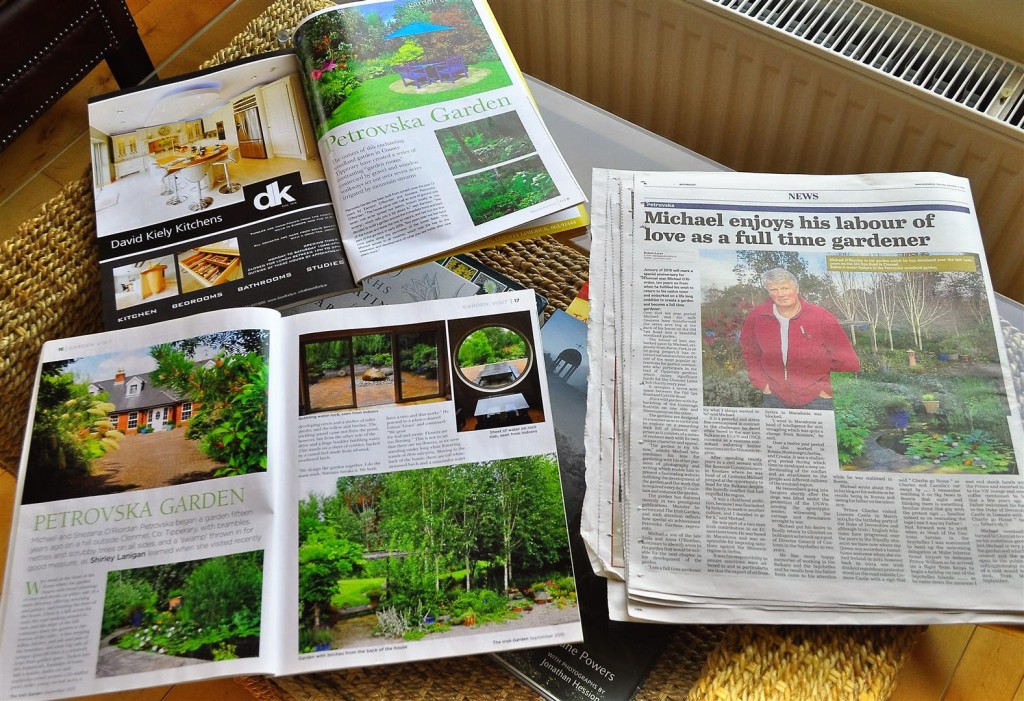
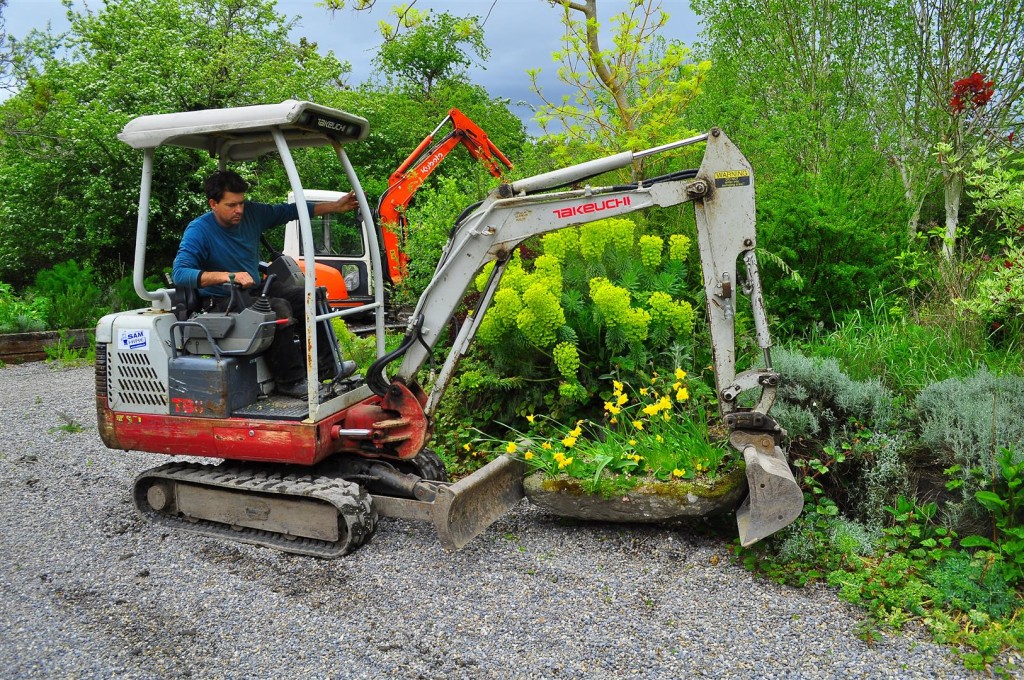
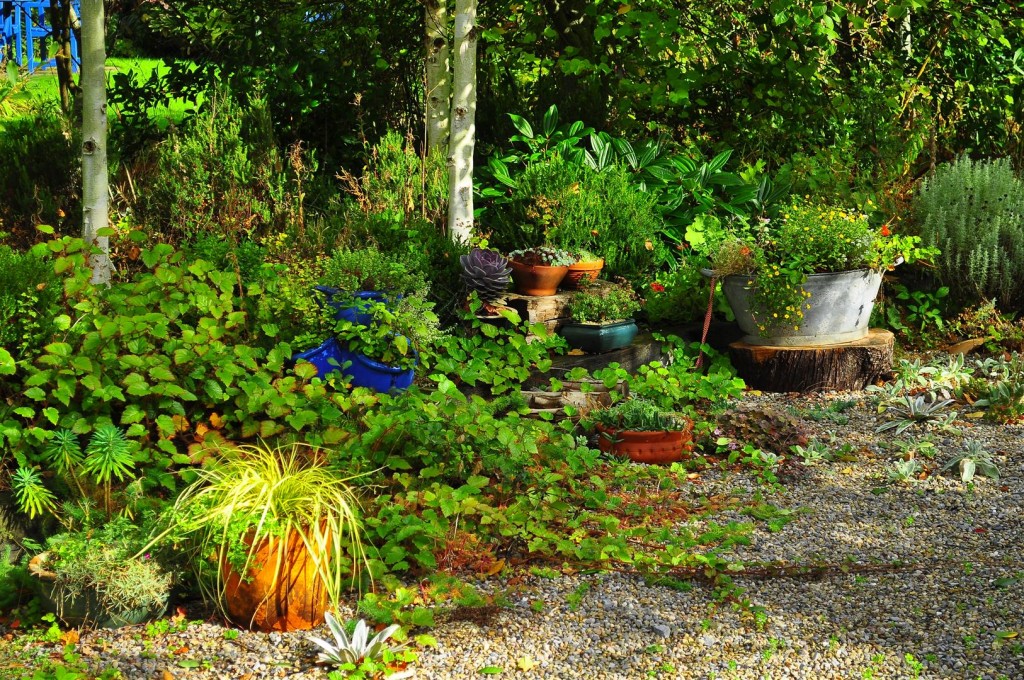
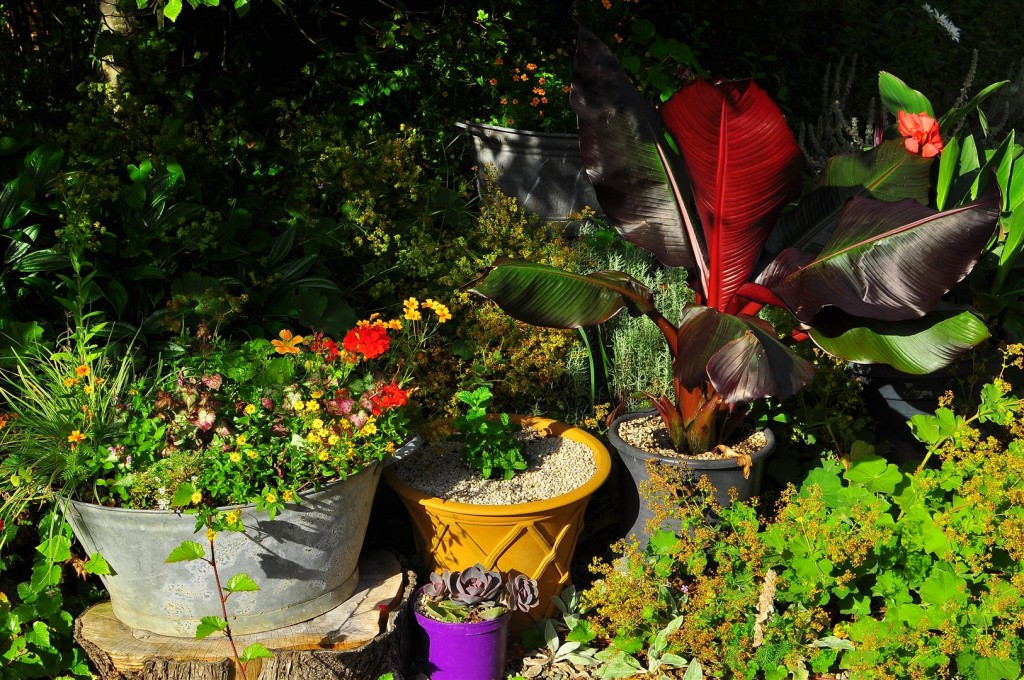
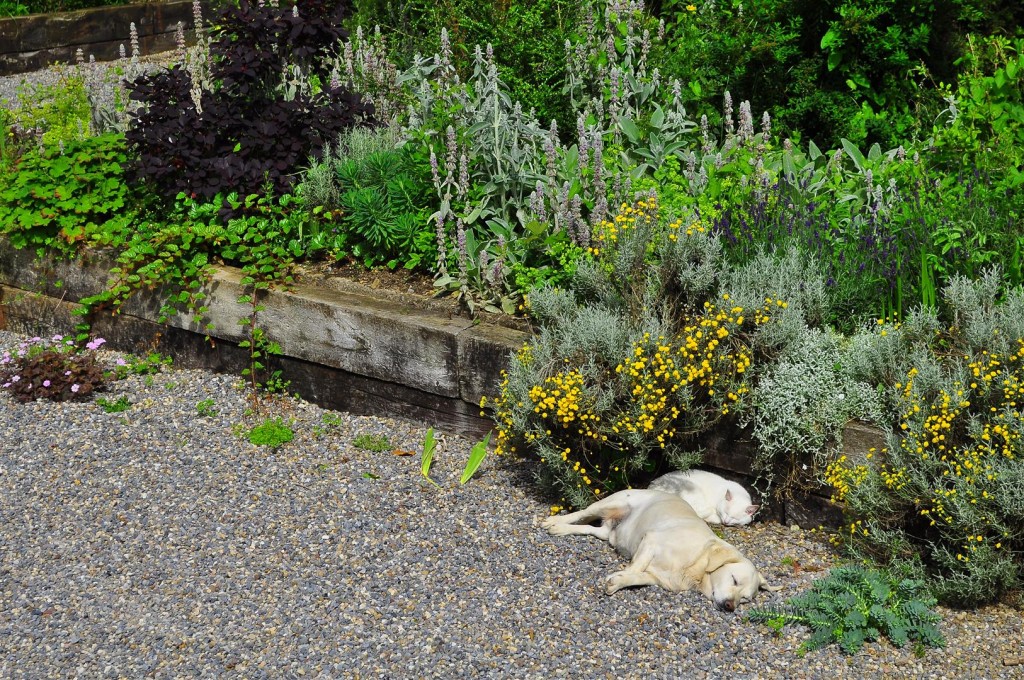
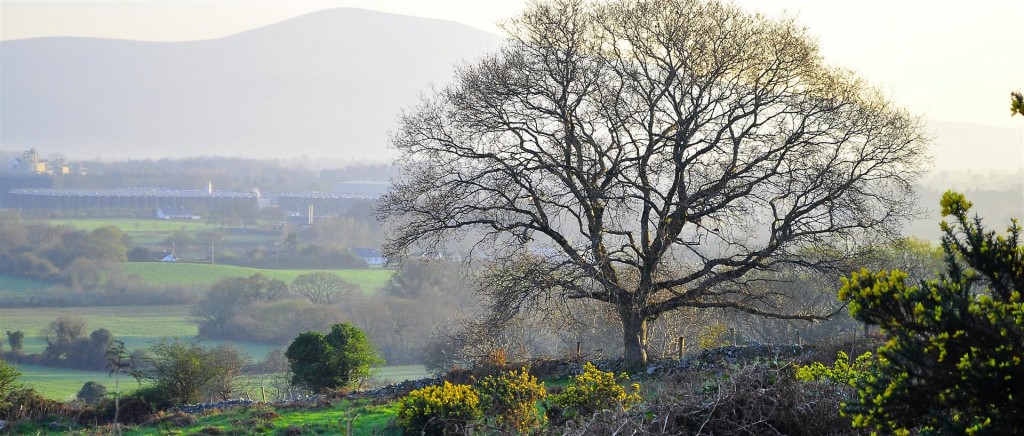
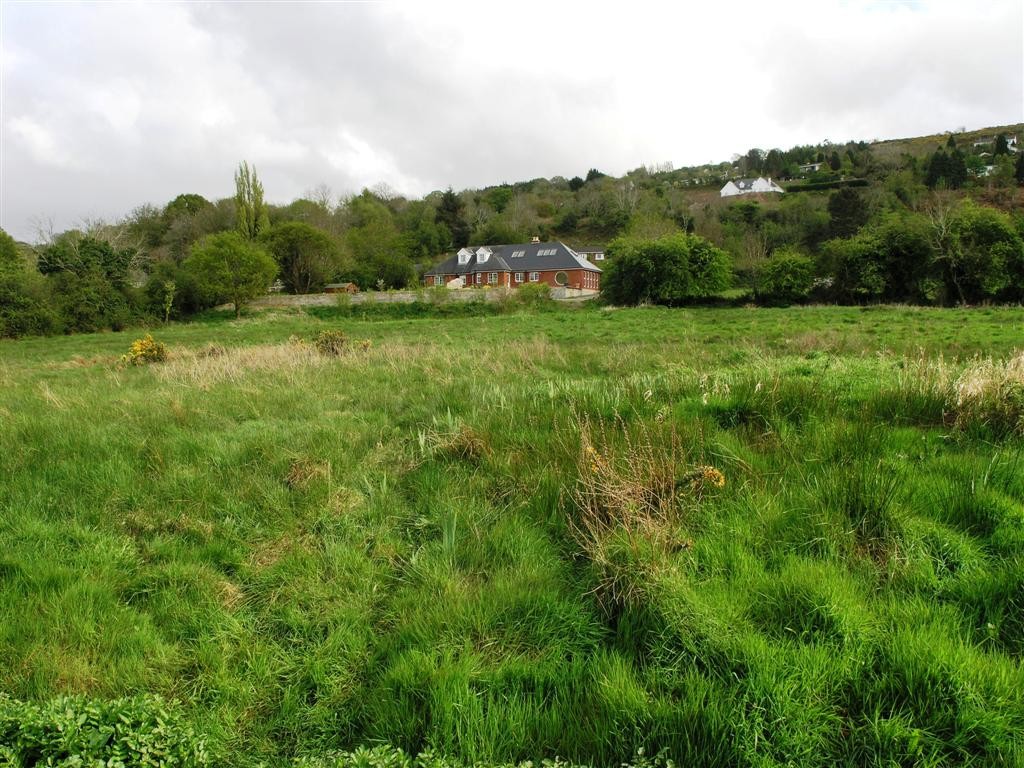
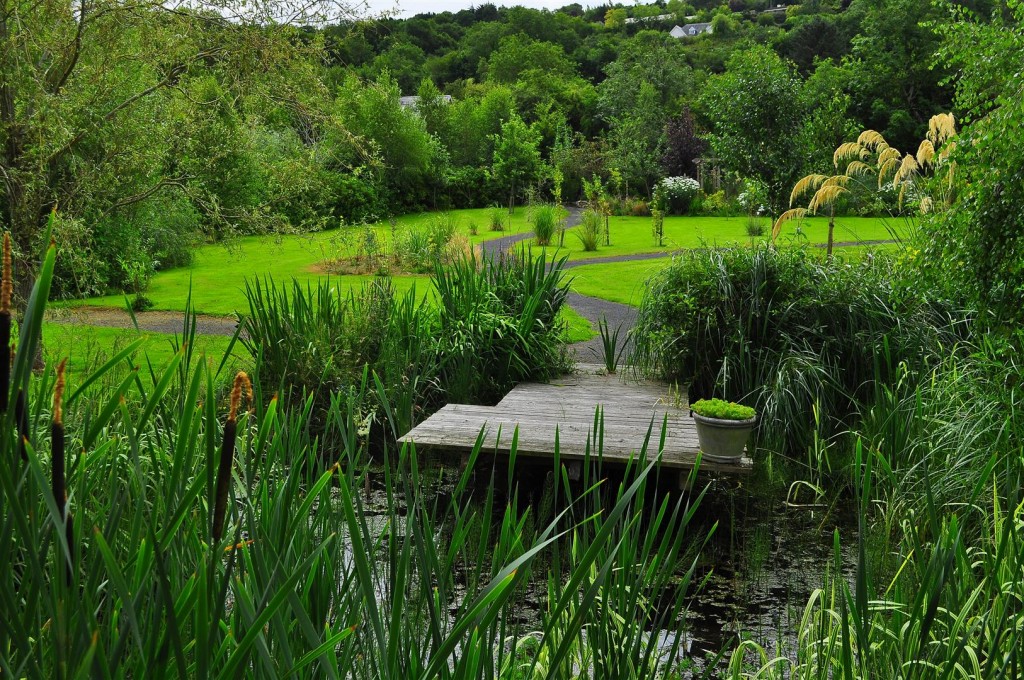
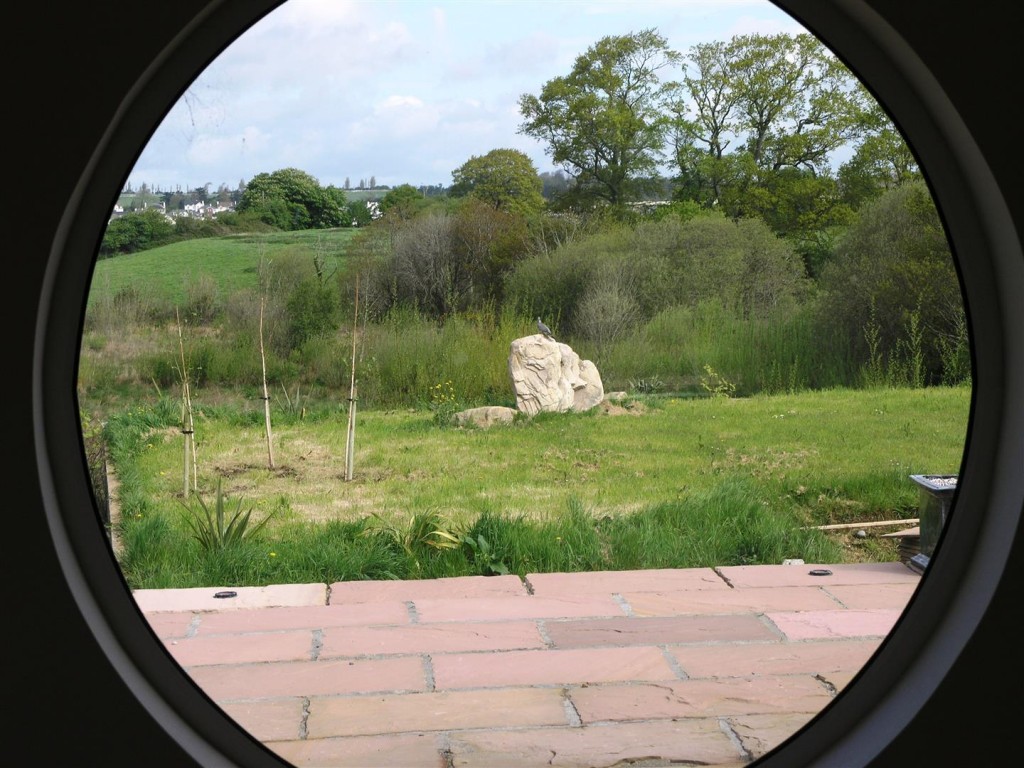
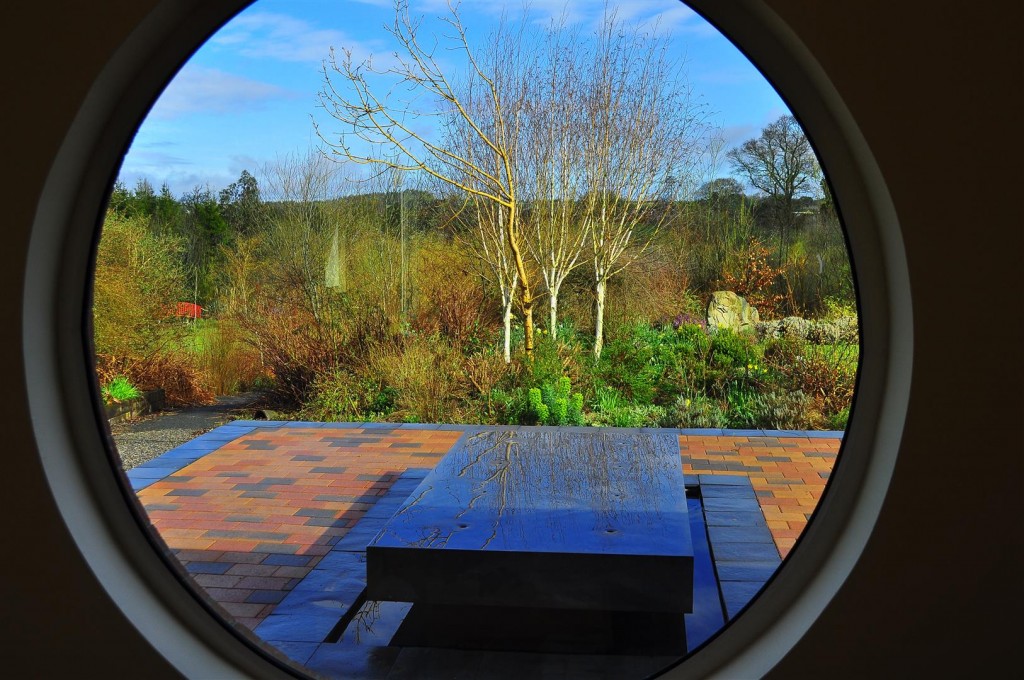
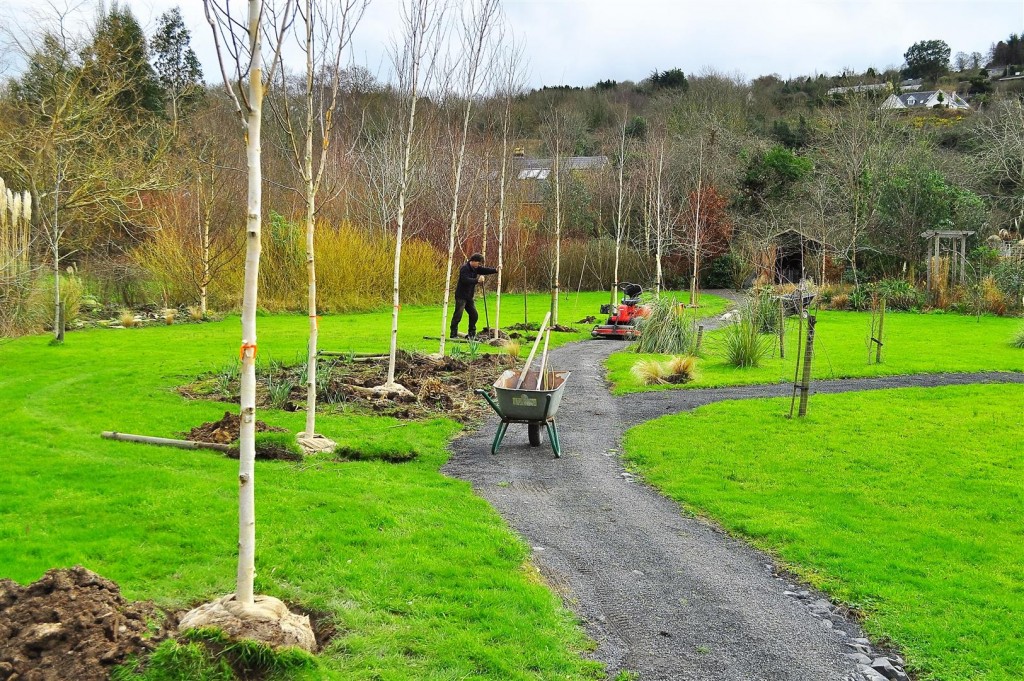
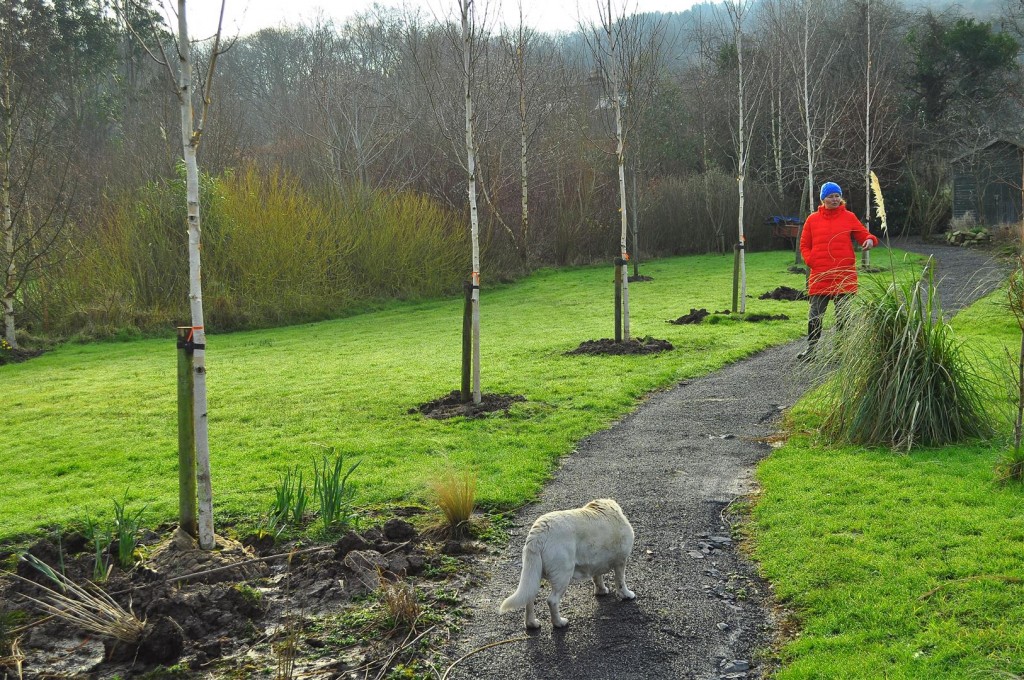
Leave a Reply